Table of Contents
- ZyWALL USG FLEX Series
- User’s Guide
- Introduction
- Initial Setup Wizard
- 2.1 Initial Setup Wizard Screens
- 2.1.1 Internet Access Setup - WAN Interface
- 2.1.2 Internet Access: Ethernet
- 2.1.3 Internet Access: PPPoE
- 2.1.4 Internet Access: PPTP
- 2.1.5 Internet Access: L2TP
- 2.1.6 Internet Access Setup - Second WAN Interface
- 2.1.7 Internet Access: Congratulations
- 2.1.8 Date and Time Settings
- 2.1.9 Register Device
- 2.1.10 Activate Service
- 2.1.11 Service Settings
- 2.1.12 Service Settings: SecuReporter
- 2.1.13 Wireless Settings: Management Mode
- 2.1.14 Wireless Settings: AP Controller
- 2.1.15 Wireless Settings: SSID & Security
- 2.1.16 Remote Management
- 2.1 Initial Setup Wizard Screens
- Hardware, Interfaces and Zones
- Quick Setup Wizards
- 4.1 Quick Setup Overview
- 4.2 WAN Interface Quick Setup
- 4.3 VPN Setup Wizard
- 4.3.1 Welcome
- 4.3.2 VPN Setup Wizard: Wizard Type
- 4.3.3 VPN Express Wizard - Scenario
- 4.3.4 VPN Express Wizard - Configuration
- 4.3.5 VPN Express Wizard - Summary
- 4.3.6 VPN Express Wizard - Finish
- 4.3.7 VPN Advanced Wizard - Scenario
- 4.3.8 VPN Advanced Wizard - Phase 1 Settings
- 4.3.9 VPN Advanced Wizard - Phase 2
- 4.3.10 VPN Advanced Wizard - Summary
- 4.3.11 VPN Advanced Wizard - Finish
- 4.4 VPN Settings for Configuration Provisioning Wizard: Wizard Type
- 4.4.1 Configuration Provisioning Express Wizard - VPN Settings
- 4.4.2 Configuration Provisioning VPN Express Wizard - Configuration
- 4.4.3 VPN Settings for Configuration Provisioning Express Wizard - Summary
- 4.4.4 VPN Settings for Configuration Provisioning Express Wizard - Finish
- 4.4.5 VPN Settings for Configuration Provisioning Advanced Wizard - Scenario
- 4.4.6 VPN Settings for Configuration Provisioning Advanced Wizard - Phase 1 Settings
- 4.4.7 VPN Settings for Configuration Provisioning Advanced Wizard - Phase 2
- 4.4.8 VPN Settings for Configuration Provisioning Advanced Wizard - Summary
- 4.4.9 VPN Settings for Configuration Provisioning Advanced Wizard - Finish
- 4.5 VPN Settings for L2TP VPN Settings Wizard
- Dashboard
- Technical Reference
- Monitor
- 6.1 Overview
- 6.2 The Port Statistics Screen
- 6.3 Interface Status Screen
- 6.4 The Traffic Statistics Screen
- 6.5 The Session Monitor Screen
- 6.6 The Login Users Screen
- 6.7 Dynamic Guest
- 6.8 IGMP Statistics
- 6.9 The DDNS Status Screen
- 6.10 IP/MAC Binding
- 6.11 Cellular Status Screen
- 6.12 The UPnP Port Status Screen
- 6.13 USB Storage Screen
- 6.14 Ethernet Neighbor Screen
- 6.15 FQDN Object Screen
- 6.16 Virtual Server Load Balancing
- 6.17 AP Information: AP List
- 6.18 AP Information: Radio List
- 6.19 AP Information: Top N APs
- 6.20 AP Information: Single AP
- 6.21 ZyMesh
- 6.22 SSID Info
- 6.23 Station Info: Station List
- 6.24 Station Info: Top N Stations
- 6.25 Station Info: Single Station
- 6.26 Detected Device
- 6.27 The Printer Status Screen
- 6.28 The IPSec Screen
- 6.29 The SSL Screen
- 6.30 The L2TP over IPSec Screen
- 6.31 The App Patrol Screen
- 6.32 The Content Filter Screen
- 6.33 The Anti-Malware Screen
- 6.34 The Reputation Filter Screen
- 6.35 The IDP Screen
- 6.36 The Email Security Screens
- 6.37 The SSL Inspection Screens
- 6.38 Log Screens
- Licensing
- Wireless
- Interfaces
- Routing
- DDNS
- NAT
- Redirect Service
- ALG
- UPnP
- IP/MAC Binding
- Layer 2 Isolation
- DNS Inbound LB
- IPSec VPN
- SSL VPN
- L2TP VPN
- BWM (Bandwidth Management)
- Web Authentication
- Hotspot
- Printer Manager
- Free Time
- IPnP
- Walled Garden
- Advertisement Screen
- Security Policy
- Application Patrol
- Content Filter
- Anti-Malware
- Reputation Filter
- IDP
- Email Security
- SSL Inspection
- IP Exception
- Object
- 39.1 Zones Overview
- 39.2 User/Group Overview
- 39.2.1 What You Need To Know
- 39.2.2 User/Group User Summary Screen
- 39.2.3 User Add/Edit General Screen
- 39.2.4 User Add/Edit Two-factor Authentication Screen
- 39.2.5 User/Group Group Summary Screen
- 39.2.6 User/Group Setting Screen
- 39.2.7 User/Group MAC Address Summary Screen
- 39.2.8 User /Group Technical Reference
- 39.3 AP Profile Overview
- 39.4 MON Profile
- 39.5 ZyMesh Overview
- 39.6 Address/Geo IP Overview
- 39.7 Service Overview
- 39.8 Schedule Overview
- 39.9 AAA Server Overview
- 39.10 Auth. Method Overview
- 39.11 Certificate Overview
- 39.12 ISP Account Overview
- 39.13 DHCPv6 Overview
- Device HA
- Cloud CNM
- System
- 42.1 Overview
- 42.2 Host Name
- 42.3 USB Storage
- 42.4 Date and Time
- 42.5 Console Port Speed
- 42.6 DNS Overview
- 42.6.1 DNS Server Address Assignment
- 42.6.2 Configuring the DNS Screen
- 42.6.3 (IPv6) Address Record
- 42.6.4 PTR Record
- 42.6.5 Adding an (IPv6) Address/PTR Record
- 42.6.6 CNAME Record
- 42.6.7 Adding a CNAME Record
- 42.6.8 Domain Zone Forwarder
- 42.6.9 Adding a Domain Zone Forwarder
- 42.6.10 MX Record
- 42.6.11 Adding a MX Record
- 42.6.12 Security Option Control
- 42.6.13 Editing a Security Option Control
- 42.6.14 Adding a DNS Service Control Rule
- 42.7 WWW Overview
- 42.8 SSH
- 42.9 Telnet
- 42.10 FTP
- 42.11 SNMP
- 42.12 Authentication Server
- 42.13 Notification > Mail Server
- 42.14 Notification > SMS
- 42.15 Notification > Response Message
- 42.16 Language Screen
- 42.17 IPv6 Screen
- 42.18 Zyxel One Network (ZON) Utility
- Log and Report
- File Manager
- Diagnostics
- Packet Flow Explore
- Shutdown
- Monitor
- Appendices and Troubleshooting
Zyxel USG FLEX 100W User Manual
Displayed below is the user manual for USG FLEX 100W by Zyxel which is a product in the Hardware Firewalls category. This manual has pages.
Related Manuals

Default Login Details
User’s Guide
ZyWALL USG FLEX
Series
Copyright © 2020 Zyxel Communications Corporation
LAN Port IP Address https://192.168.1.1
User Name admin
Password 1234
Version 4.60 Edition 1, 10/2020

ZyWALL USG FLEX Series User’s Guide
2
IMPORTANT!
READ CAREFULLY BEFORE USE.
KEEP THIS GUIDE FOR FUTURE REFERENCE.
This is a User’s Guide for a series of products. Not all products support all firmware features. Screenshots
and graphics in this book may differ slightly from your product due to differences in product features or
web configurator brand style. Every effort has been made to ensure that the information in this manual
is accurate.
Note: The version number on the cover page refers to the Zyxel Device’s latest firmware
version to which this User’s Guide applies.
Related Documentation
•Quick Start Guide
The Quick Start Guide shows how to connect the Zyxel Device and access the Web Configurator
wizards. (See the wizard real time help for information on configuring each screen.) It also contains a
connection diagram and package contents list.
•CLI Reference Guide
The CLI Reference Guide explains how to use the Command-Line Interface (CLI) to configure the
Zyxel Device.
Note: It is recommended you use the Web Configurator to configure the Zyxel Device.
• Web Configurator Online Help
Click the help icon in any screen for help in configuring that screen and supplementary information.
•More Information
Go to support.zyxel.com to find other information on Zyxel Device.

ZyWALL USG FLEX Series User’s Guide
3
Document Conventions
Warnings and Notes
These are how warnings and notes are shown in this guide.
Warnings tell you about things that could harm you or your device.
Note: Notes tell you other important information (for example, other things you may need to
configure or helpful tips) or recommendations.
Syntax Conventions
• All models in this series may be referred to as the “Zyxel Device” in this guide.
• Product labels, screen names, field labels and field choices are all in bold font.
• A right angle bracket ( > ) within a screen name denotes a mouse click. For example, Configuration >
Network > Interface > Ethernet means you first click Configuration in the navigation panel, then
Network, then the Interface sub menu and finally the Ethernet tab to get to that screen.
Icons Used in Figures
Figures in this user guide may use the following generic icons. The Zyxel Device icon is not an exact
representation of your device.
Zyxel Device Generic Router Wireless Router / Access Point
Switch Firewall Server
Internet Network Cloud Smartphone
USB Dongle

Contents Overview
ZyWALL USG FLEX Series User’s Guide
4
Contents Overview
Introduction ........................................................................................................................................... 27
Initial Setup Wizard ............................................................................................................................... 51
Hardware, Interfaces and Zones ........................................................................................................ 70
Quick Setup Wizards ............................................................................................................................. 79
Dashboard .......................................................................................................................................... 113
Monitor ................................................................................................................................................. 124
Licensing .............................................................................................................................................. 196
Wireless ................................................................................................................................................. 202
Interfaces ............................................................................................................................................. 228
Routing ................................................................................................................................................. 325
DDNS ................................................................................................................................................... 352
NAT ....................................................................................................................................................... 358
Redirect Service .................................................................................................................................. 375
ALG ....................................................................................................................................................... 381
UPnP ..................................................................................................................................................... 388
IP/MAC Binding ................................................................................................................................... 403
Layer 2 Isolation .................................................................................................................................. 408
DNS Inbound LB .................................................................................................................................. 412
IPSec VPN ............................................................................................................................................ 418
SSL VPN ................................................................................................................................................ 454
L2TP VPN .............................................................................................................................................. 460
BWM (Bandwidth Management) ..................................................................................................465
Web Authentication .......................................................................................................................... 481
Hotspot ................................................................................................................................................ 513
Printer Manager .................................................................................................................................. 531
Free Time ............................................................................................................................................. 543
IPnP ....................................................................................................................................................... 548
Walled Garden ................................................................................................................................... 551
Advertisement Screen ....................................................................................................................... 557
Security Policy ..................................................................................................................................... 560
Application Patrol ............................................................................................................................... 586
Content Filter ....................................................................................................................................... 595
Anti-Malware ....................................................................................................................................... 620
Reputation Filter .................................................................................................................................. 640
IDP ........................................................................................................................................................ 651
Email Security ...................................................................................................................................... 675
SSL Inspection ...................................................................................................................................... 693
IP Exception ......................................................................................................................................... 707
Object .................................................................................................................................................. 710

Contents Overview
ZyWALL USG FLEX Series User’s Guide
5
Device HA ........................................................................................................................................... 826
Cloud CNM ........................................................................................................................................ 833
System .................................................................................................................................................. 841
Log and Report ................................................................................................................................... 902
File Manager ....................................................................................................................................... 915
Diagnostics ......................................................................................................................................... 931
Packet Flow Explore ........................................................................................................................... 952
Shutdown ............................................................................................................................................. 959
Troubleshooting .................................................................................................................................. 963

Table of Contents
ZyWALL USG FLEX Series User’s Guide
6
Table of Contents
Document Conventions ... .... .................. .... .... ... .... .................. .... .... ... ................... .... ... .... .... ...............3
Contents Overview .............................................................................................................................4
Table of Contents.................................................................................................................................6
Part I: User’s Guide..........................................................................................26
Chapter 1
Introduction ........................................................................................................................................27
1.1 Overview ......................................................................................................................................... 27
1.1.1 Model Feature Differences .................................................................................................. 27
1.2 Registration at myZyxel .................................................................................................................. 28
1.2.1 Grace Period ......................................................................................................................... 29
1.2.2 Applications ........................................................................................................................... 29
1.3 Management Overview ................................................................................................................ 32
1.4 Web Configurator ........................................................................................................................... 33
1.4.1 Web Configurator Access .................................................................................................... 33
1.4.2 Web Configurator Screens Overview ................................................................................. 36
1.4.3 Navigation Panel .................................................................................................................. 40
1.4.4 Tables and Lists ...................................................................................................................... 48
Chapter 2
Initial Setup Wizard.............................................................................................................................51
2.1 Initial Setup Wizard Screens .......................................................................................................... 51
2.1.1 Internet Access Setup - WAN Interface ............................................................................. 51
2.1.2 Internet Access: Ethernet .................................................................................................... 52
2.1.3 Internet Access: PPPoE ......................................................................................................... 53
2.1.4 Internet Access: PPTP ........................................................................................................... 55
2.1.5 Internet Access: L2TP ............................................................................................................ 57
2.1.6 Internet Access Setup - Second WAN Interface ............................................................... 59
2.1.7 Internet Access: Congratulations ....................................................................................... 60
2.1.8 Date and Time Settings ........................................................................................................ 61
2.1.9 Register Device ..................................................................................................................... 61
2.1.10 Activate Service .................................................................................................................. 63
2.1.11 Service Settings .................................................................................................................... 64
2.1.12 Service Settings: SecuReporter ..........................................................................................65
2.1.13 Wireless Settings: Management Mode ............................................................................. 66

Table of Contents
ZyWALL USG FLEX Series User’s Guide
7
2.1.14 Wireless Settings: AP Controller ......................................................................................... 67
2.1.15 Wireless Settings: SSID & Security ...................................................................................... 67
2.1.16 Remote Management ......................................................................................................68
Chapter 3
Hardware, Interfaces and Zones......................................................................................................70
3.1 Hardware Overview ....................................................................................................................... 70
3.1.1 Front Panels ............................................................................................................................ 70
3.1.2 Rear Panels ............................................................................................................................ 72
3.2 Installation Scenarios ..................................................................................................................... 74
3.2.1 Desktop Installation Procedure ...........................................................................................74
3.2.2 Rack-mounting ...................................................................................................................... 75
3.2.3 Wall-mounting ....................................................................................................................... 76
3.3 Default Zones, Interfaces, and Ports ............................................................................................ 77
3.4 Stopping the Zyxel Device ............................................................................................................ 78
Chapter 4
Quick Setup Wizards............................................................................................................ ..............79
4.1 Quick Setup Overview ................................................................................................................... 79
4.2 WAN Interface Quick Setup .......................................................................................................... 80
4.2.1 Choose an Ethernet Interface .............................................................................................80
4.2.2 Select WAN Type ................................................................................................................... 81
4.2.3 Configure WAN IP Settings ................................................................................................... 81
4.2.4 ISP and WAN and ISP Connection Settings ........................................................................ 82
4.2.5 Quick Setup Interface Wizard: Summary ........................................................................... 85
4.3 VPN Setup Wizard ........................................................................................................................... 86
4.3.1 Welcome ................................................................................................................................ 86
4.3.2 VPN Setup Wizard: Wizard Type .......................................................................................... 87
4.3.3 VPN Express Wizard - Scenario ............................................................................................ 88
4.3.4 VPN Express Wizard - Configuration ................................................................................... 89
4.3.5 VPN Express Wizard - Summary ........................................................................................... 89
4.3.6 VPN Express Wizard - Finish .................................................................................................. 90
4.3.7 VPN Advanced Wizard - Scenario ..................................................................................... 91
4.3.8 VPN Advanced Wizard - Phase 1 Settings ........................................................................ 92
4.3.9 VPN Advanced Wizard - Phase 2 ....................................................................................... 94
4.3.10 VPN Advanced Wizard - Summary .................................................................................. 95
4.3.11 VPN Advanced Wizard - Finish ......................................................................................... 97
4.4 VPN Settings for Configuration Provisioning Wizard: Wizard Type ............................................. 98
4.4.1 Configuration Provisioning Express Wizard - VPN Settings ............................................... 98
4.4.2 Configuration Provisioning VPN Express Wizard - Configuration .................................... 99
4.4.3 VPN Settings for Configuration Provisioning Express Wizard - Summary ...................... 100
4.4.4 VPN Settings for Configuration Provisioning Express Wizard - Finish .............................. 101
4.4.5 VPN Settings for Configuration Provisioning Advanced Wizard - Scenario ................. 102

Table of Contents
ZyWALL USG FLEX Series User’s Guide
8
4.4.6 VPN Settings for Configuration Provisioning Advanced Wizard - Phase 1 Settings .... 103
4.4.7 VPN Settings for Configuration Provisioning Advanced Wizard - Phase 2 .................. 104
4.4.8 VPN Settings for Configuration Provisioning Advanced Wizard - Summary ................ 105
4.4.9 VPN Settings for Configuration Provisioning Advanced Wizard - Finish ....................... 108
4.5 VPN Settings for L2TP VPN Settings Wizard ................................................................................. 108
4.5.1 L2TP VPN Settings ................................................................................................................ 109
4.5.2 L2TP VPN Settings ................................................................................................................ 110
4.5.3 VPN Settings for L2TP VPN Setting Wizard - Summary .................................................... 110
4.5.4 VPN Settings for L2TP VPN Setting Wizard - Completed ................................................ 112
Chapter 5
Dashboard........................................................................................................................................113
5.1 Overview ....................................................................................................................................... 113
5.1.1 What You Can Do in this Chapter ..................................................................................... 113
5.2 The General Screen ..................................................................................................................... 113
5.2.1 Device Information Screen ................................................................................................115
5.2.2 System Status Screen .......................................................................................................... 116
5.2.3 Tx/Rx Statistics ...................................................................................................................... 116
5.2.4 The Latest Logs Screen ....................................................................................................... 117
5.2.5 System Resources Screen ................................................................................................... 117
5.2.6 DHCP Table Screen ............................................................................................................. 118
5.2.7 Number of Login Users Screen ........................................................................................... 119
5.2.8 Current Login User ............................................................................................................... 120
5.2.9 VPN Status ............................................................................................................................ 120
5.2.10 SSL VPN Status .................................................................................................................... 121
5.3 The Advanced Threat Protection Screen .................................................................................. 121
Part II: Technical Reference.........................................................................123
Chapter 6
Monitor..............................................................................................................................................124
6.1 Overview ....................................................................................................................................... 124
6.1.1 What You Can Do in this Chapter ..................................................................................... 124
6.2 The Port Statistics Screen ............................................................................................................ 126
6.2.1 The Port Statistics Graph Screen ....................................................................................... 127
6.3 Interface Status Screen ................................................................................................................ 128
6.4 The Traffic Statistics Screen .......................................................................................................... 132
6.5 The Session Monitor Screen ........................................................................................................ 135
6.6 The Login Users Screen ................................................................................................................ 137
6.7 Dynamic Guest ............................................................................................................................ 138
6.8 IGMP Statistics ............................................................................................................................... 139

Table of Contents
ZyWALL USG FLEX Series User’s Guide
9
6.9 The DDNS Status Screen ............................................................................................................... 140
6.10 IP/MAC Binding ........................................................................................................................... 141
6.11 Cellular Status Screen ................................................................................................................ 142
6.11.1 More Information .............................................................................................................. 144
6.12 The UPnP Port Status Screen ..................................................................................................... 145
6.13 USB Storage Screen .................................................................................................................... 146
6.14 Ethernet Neighbor Screen ........................................................................................................ 147
6.15 FQDN Object Screen ................................................................................................................ 148
6.16 Virtual Server Load Balancing .................................................................................................. 150
6.17 AP Information: AP List ............................................................................................................... 151
6.17.1 AP List: More Information ................................................................................................ 155
6.17.2 AP List: Edit AP ................................................................................................................... 158
6.18 AP Information: Radio List .......................................................................................................... 161
6.18.1 Radio List: More Information ............................................................................................163
6.19 AP Information: Top N APs ........................................................................................................ 165
6.20 AP Information: Single AP .......................................................................................................... 166
6.21 ZyMesh ......................................................................................................................................... 167
6.22 SSID Info ....................................................................................................................................... 168
6.23 Station Info: Station List .............................................................................................................. 169
6.24 Station Info: Top N Stations ........................................................................................................ 170
6.25 Station Info: Single Station ......................................................................................................... 171
6.26 Detected Device ....................................................................................................................... 172
6.27 The Printer Status Screen ........................................................................................................... 173
6.28 The IPSec Screen ........................................................................................................................ 174
6.29 The SSL Screen ............................................................................................................................. 175
6.30 The L2TP over IPSec Screen ....................................................................................................... 176
6.31 The App Patrol Screen ............................................................................................................... 177
6.32 The Content Filter Screen .......................................................................................................... 178
6.33 The Anti-Malware Screen .......................................................................................................... 179
6.34 The Reputation Filter Screen ...................................................................................................... 182
6.35 The IDP Screen ............................................................................................................................ 183
6.36 The Email Security Screens ......................................................................................................... 185
6.36.1 Email Security Summary ................................................................................................... 185
6.36.2 The Email Security Status Screen ..................................................................................... 187
6.37 The SSL Inspection Screens ........................................................................................................ 188
6.37.1 Certificate Cache List ....................................................................................................... 189
6.38 Log Screens ................................................................................................................................. 190
6.38.1 View Log ............................................................................................................................ 191
6.38.2 View AP Log ....................................................................................................................... 192
6.38.3 Dynamic Users Log ............................................................................................................ 194
Chapter 7
Licensing...........................................................................................................................................196

Table of Contents
ZyWALL USG FLEX Series User’s Guide
10
7.1 Registration Overview .................................................................................................................. 196
7.1.1 What you Need to Know ....................................................................................................196
7.1.2 Registration Screen ............................................................................................................. 197
7.1.3 Service Screen ..................................................................................................................... 197
7.2 Signature Update ......................................................................................................................... 199
7.2.1 What you Need to Know ....................................................................................................199
7.2.2 The Signature Screen .......................................................................................................... 200
7.2.3 Auto Update ........................................................................................................................ 200
Chapter 8
Wireless .............................................................................................................................................202
8.1 Overview ....................................................................................................................................... 202
8.1.1 What You Can Do in this Chapter ..................................................................................... 202
8.2 Controller Screen ........................................................................................................................ 202
8.2.1 Connecting an AP to the Zyxel Device ............................................................................ 203
8.2.2 Connecting an AP to the Zyxel Device Manually ........................................................... 203
8.2.3 Connecting an AP to the Zyxel Device Using DHCP Option 138 .................................. 203
8.3 AP Management Screens ........................................................................................................... 204
8.3.1 Mgnt. AP List ....................................................................................................................... 204
8.3.2 AP Policy .............................................................................................................................. 211
8.3.3 AP Group ............................................................................................................................. 212
8.3.4 Firmware ............................................................................................................................... 218
8.4 Rogue AP ....................................................................................................................................... 220
8.4.1 Add/Edit Rogue/Friendly List .............................................................................................. 222
8.5 Auto Healing ................................................................................................................................. 223
8.6 RTLS Overview ............................................................................................................................... 224
8.6.1 What You Can Do in this Chapter ..................................................................................... 224
8.6.2 Before You Begin ................................................................................................................. 224
8.6.3 Configuring RTLS .................................................................................................................. 225
8.7 Technical Reference .................................................................................................................... 226
8.7.1 Dynamic Channel Selection .............................................................................................. 226
8.7.2 Load Balancing ................................................................................................................... 227
Chapter 9
Interfaces..........................................................................................................................................228
9.1 Interface Overview ...................................................................................................................... 228
9.1.1 What You Can Do in this Chapter ..................................................................................... 228
9.1.2 What You Need to Know ................................................................................................... 228
9.1.3 What You Need to Do First ................................................................................................. 233
9.2 Port Role ......................................................................................................................................... 233
9.3 Port Configuration ........................................................................................................................ 234
9.4 Ethernet Summary Screen ........................................................................................................... 235
9.4.1 Ethernet Edit ........................................................................................................................ 237

Table of Contents
ZyWALL USG FLEX Series User’s Guide
11
9.4.2 Proxy ARP ............................................................................................................................. 253
9.4.3 Virtual Interfaces ................................................................................................................ 254
9.4.4 References ........................................................................................................................... 255
9.4.5 Add/Edit DHCPv6 Request/Release Options ................................................................... 256
9.4.6 Add/Edit DHCP Extended Options ................................................................................... 257
9.5 PPP Interfaces ............................................................................................................................... 258
9.5.1 PPP Interface Summary ...................................................................................................... 259
9.5.2 PPP Interface Add or Edit .................................................................................................. 260
9.6 Cellular Configuration Screen ..................................................................................................... 265
9.6.1 Cellular Choose Slot ........................................................................................................... 268
9.6.2 Add / Edit Cellular Configuration ...................................................................................... 268
9.7 Tunnel Interfaces .......................................................................................................................... 274
9.7.1 Configuring a Tunnel .......................................................................................................... 276
9.7.2 Tunnel Add or Edit Screen .................................................................................................. 277
9.8 VLAN Interfaces ........................................................................................................................... 281
9.8.1 VLAN Summary Screen ....................................................................................................... 282
9.8.2 VLAN Add/Edit ................................................................................................................... 283
9.9 Bridge Interfaces .......................................................................................................................... 294
9.9.1 Bridge Summary .................................................................................................................. 296
9.9.2 Bridge Add/Edit .................................................................................................................. 297
9.10 VTI ................................................................................................................................................. 308
9.10.1 Restrictions for IPSec Virtual Tunnel Interface ................................................................ 308
9.10.2 VTI Screen .......................................................................................................................... 309
9.10.3 VTI Add/Edit ....................................................................................................................... 309
9.11 Trunk Overview ........................................................................................................................... 313
9.11.1 What You Need to Know ................................................................................................. 313
9.12 The Trunk Summary Screen ........................................................................................................ 316
9.12.1 Configuring a User-Defined Trunk ................................................................................... 317
9.12.2 Configuring the System Default Trunk ............................................................................ 319
9.13 Interface Technical Reference ................................................................................................. 320
Chapter 10
Routing..............................................................................................................................................325
10.1 Policy and Static Routes Overview ........................................................................................... 325
10.1.1 What You Can Do in this Chapter ................................................................................... 325
10.1.2 What You Need to Know ................................................................................................ 326
10.2 Policy Route Screen ................................................................................................................... 327
10.2.1 Policy Route Edit Screen .................................................................................................. 329
10.3 IP Static Route Screen ................................................................................................................ 334
10.3.1 Static Route Add/Edit Screen .......................................................................................... 334
10.4 Policy Routing Technical Reference ........................................................................................336
10.5 Routing Protocols Overview ..................................................................................................... 336
10.5.1 What You Need to Know ................................................................................................. 337

Table of Contents
ZyWALL USG FLEX Series User’s Guide
12
10.6 The RIP Screen ............................................................................................................................. 337
10.7 The OSPF Screen ......................................................................................................................... 339
10.7.1 Configuring the OSPF Screen .......................................................................................... 342
10.7.2 OSPF Area Add/Edit Screen ........................................................................................... 343
10.7.3 Virtual Link Add/Edit Screen ...........................................................................................345
10.8 BGP (Border Gateway Protocol) .............................................................................................. 346
10.8.1 Allow BGP Packets to Enter the Zyxel Device ................................................................ 347
10.8.2 Configuring the BGP Screen ............................................................................................ 347
10.8.3 The BGP Neighbors Screen .............................................................................................. 349
10.8.4 Example Scenario ............................................................................................................. 350
Chapter 11
DDNS ................................................................................................................................................352
11.1 DDNS Overview ........................................................................................................................... 352
11.1.1 What You Can Do in this Chapter ................................................................................... 352
11.1.2 What You Need to Know ................................................................................................. 352
11.2 The DDNS Screen ........................................................................................................................ 353
11.2.1 The Dynamic DNS Add/Edit Screen ................................................................................ 354
Chapter 12
NAT ....................................................................................................................................................358
12.1 Overview ..................................................................................................................................... 358
12.2 NAT Overview ............................................................................................................................. 358
12.2.1 What You Can Do in this Chapter ................................................................................... 358
12.2.2 What You Need to Know ................................................................................................. 359
12.3 The NAT Screen ........................................................................................................................... 360
12.3.1 The NAT Add/Edit Screen .................................................................................................361
12.4 NAT Technical Reference .......................................................................................................... 364
12.5 Virtual Server Load Balancing ................................................................................................... 366
12.5.1 Load Balancing Example 1 .............................................................................................. 366
12.5.2 Load Balancing Example 2 .............................................................................................. 367
12.5.3 Virtual Server Load Balancing Process ........................................................................... 367
12.5.4 Load Balancing Rules ....................................................................................................... 368
12.5.5 Virtual Server Load Balancing Algorithms ...................................................................... 369
12.6 The Virtual Server Load Balancer Screen ................................................................................. 370
12.6.1 Adding/Editing a Virtual Server Load Balancing Rule .................................................. 371
Chapter 13
Redirect Service...............................................................................................................................375
13.1 Overview ..................................................................................................................................... 375
13.1.1 HTTP Redirect ..................................................................................................................... 375
13.1.2 SMTP Redirect .................................................................................................................... 375
13.1.3 What You Can Do in this Chapter ................................................................................... 376

Table of Contents
ZyWALL USG FLEX Series User’s Guide
13
13.1.4 What You Need to Know ................................................................................................. 376
13.2 The Redirect Service Screen ..................................................................................................... 378
13.2.1 The Redirect Service Edit Screen ..................................................................................... 379
Chapter 14
ALG....................................................................................................................................................381
14.1 ALG Overview ............................................................................................................................. 381
14.1.1 What You Need to Know ................................................................................................. 381
14.1.2 Before You Begin ............................................................................................................... 384
14.2 The ALG Screen .......................................................................................................................... 384
14.3 ALG Technical Reference ......................................................................................................... 386
Chapter 15
UPnP...................................................................................................................................................388
15.1 UPnP and NAT-PMP Overview ................................................................................................... 388
15.2 What You Need to Know ........................................................................................................... 388
15.2.1 NAT Traversal ..................................................................................................................... 388
15.2.2 Cautions with UPnP and NAT-PMP .................................................................................. 389
15.3 UPnP Screen ................................................................................................................................ 389
15.4 Technical Reference .................................................................................................................. 390
15.4.1 Turning on UPnP in Windows 7 Example ......................................................................... 390
15.4.2 Turn on UPnP in Windows 10 Example ............................................................................ 394
15.4.3 Auto-discover Your UPnP-enabled Network Device .................................................... 396
15.4.4 Web Configurator Easy Access in Windows 7 ............................................................... 399
15.4.5 Web Configurator Easy Access in Windows 10 ............................................................. 401
Chapter 16
IP/MAC Binding................................................................................................................................403
16.1 IP/MAC Binding Overview ......................................................................................................... 403
16.1.1 What You Can Do in this Chapter ................................................................................... 403
16.1.2 What You Need to Know ................................................................................................. 403
16.2 IP/MAC Binding Summary ......................................................................................................... 404
16.2.1 IP/MAC Binding Edit .......................................................................................................... 405
16.2.2 Static DHCP Edit ................................................................................................................ 406
16.3 IP/MAC Binding Exempt List ....................................................................................................... 407
Chapter 17
Layer 2 Isolation...............................................................................................................................408
17.1 Overview ..................................................................................................................................... 408
17.1.1 What You Can Do in this Chapter ................................................................................... 408
17.2 Layer-2 Isolation General Screen ............................................................................................. 408
17.3 White List Screen ......................................................................................................................... 409
17.3.1 Add/Edit White List Rule ................................................................................................... 410

Table of Contents
ZyWALL USG FLEX Series User’s Guide
14
Chapter 18
DNS Inbound LB................................................................................................................................412
18.1 DNS Inbound Load Balancing Overview ................................................................................. 412
18.1.1 What You Can Do in this Chapter ................................................................................... 412
18.2 The DNS Inbound LB Screen ...................................................................................................... 413
18.2.1 The DNS Inbound LB Add/Edit Screen ............................................................................ 414
18.2.2 The DNS Inbound LB Add/Edit Member Screen ............................................................ 416
Chapter 19
IPSec VPN .........................................................................................................................................418
19.1 Virtual Private Networks (VPN) Overview ................................................................................. 418
19.1.1 What You Can Do in this Chapter ................................................................................... 420
19.1.2 What You Need to Know ................................................................................................. 420
19.1.3 Before You Begin ............................................................................................................... 423
19.2 The VPN Connection Screen ..................................................................................................... 423
19.2.1 The VPN Connection Add/Edit Screen .......................................................................... 425
19.3 The VPN Gateway Screen ......................................................................................................... 432
19.3.1 The VPN Gateway Add/Edit Screen ............................................................................... 433
19.4 VPN Concentrator ..................................................................................................................... 440
19.4.1 VPN Concentrator Requirements and Suggestions ...................................................... 440
19.4.2 VPN Concentrator Screen ............................................................................................... 441
19.4.3 The VPN Concentrator Add/Edit Screen ........................................................................ 441
19.5 Zyxel Device IPSec VPN Client Configuration Provisioning .................................................... 442
19.6 IPSec VPN Background Information ......................................................................................... 444
Chapter 20
SSL VPN..............................................................................................................................................454
20.1 Overview ..................................................................................................................................... 454
20.1.1 What You Can Do in this Chapter ................................................................................... 454
20.1.2 What You Need to Know ................................................................................................. 454
20.2 The SSL Access Privilege Screen ................................................................................................ 455
20.2.1 The SSL Access Privilege Policy Add/Edit Screen ......................................................... 456
20.3 The SSL Global Setting Screen ................................................................................................... 458
Chapter 21
L2TP VPN.............. .... ................... ... .... .... .................. .... ... .... .................. .... .... ... ..................................460
21.1 Overview ..................................................................................................................................... 460
21.1.1 What You Can Do in this Chapter ................................................................................... 460
21.1.2 What You Need to Know ................................................................................................. 460
21.2 L2TP VPN Screen ......................................................................................................................... 461
21.2.1 Example: L2TP and Zyxel Device Behind a NAT Router ................................................ 463

Table of Contents
ZyWALL USG FLEX Series User’s Guide
15
Chapter 22
BWM (Bandwidth Management) .................................................................................................465
22.1 Overview ..................................................................................................................................... 465
22.1.1 What You Can Do in this Chapter ................................................................................... 465
22.1.2 What You Need to Know ................................................................................................ 465
22.2 The Bandwidth Management Configuration .......................................................................... 469
22.2.1 The Bandwidth Management Add/Edit Screen ............................................................ 472
Chapter 23
Web Authentication ........................................................................................................................481
23.1 Web Auth Overview ................................................................................................................... 481
23.1.1 What You Can Do in this Chapter ................................................................................... 481
23.1.2 What You Need to Know ................................................................................................. 482
23.2 Web Authentication General Screen ...................................................................................... 482
23.2.1 User-aware Access Control Example ............................................................................. 487
23.2.2 Authentication Type Screen ............................................................................................ 493
23.2.3 Custom Web Portal / User Agreement File Screen ....................................................... 497
23.2.4 Facebook Wi-Fi Screen ..................................................................................................... 498
23.3 SSO Overview .............................................................................................................................. 502
23.4 SSO - Zyxel Device Configuration ............................................................................................. 503
23.4.1 Configuration Overview ................................................................................................... 504
23.4.2 Configure the Zyxel Device to Communicate with SSO .............................................. 504
23.4.3 Enable Web Authentication ............................................................................................ 505
23.4.4 Create a Security Policy ................................................................................................... 506
23.4.5 Configure User Information ..............................................................................................507
23.4.6 Configure an Authentication Method ........................................................................... 508
23.4.7 Configure Active Directory ..............................................................................................509
23.5 SSO Agent Configuration .......................................................................................................... 510
Chapter 24
Hotspot..............................................................................................................................................513
24.1 Overview ..................................................................................................................................... 513
24.2 Billing Overview ........................................................................................................................... 513
24.2.1 What You Need to Know ................................................................................................. 513
24.3 The Billing > General Screen ...................................................................................................... 514
24.4 The Billing > Billing Profile Screen ............................................................................................... 516
24.4.1 The Account Generator Screen ...................................................................................... 517
24.4.2 The Account Redeem Screen ......................................................................................... 520
24.4.3 The Billing Profile Add/Edit Screen ................................................................................... 522
24.5 The Billing > Discount Screen ..................................................................................................... 523
24.5.1 The Discount Add/Edit Screen ......................................................................................... 525
24.6 The Billing > Payment Service Screen ....................................................................................... 525
24.6.1 The Payment Service > Desktop / Mobile View Screen ............................................... 527

Table of Contents
ZyWALL USG FLEX Series User’s Guide
16
Chapter 25
Printer Manager ...............................................................................................................................531
25.1 Printer Manager Overview ........................................................................................................ 531
25.1.1 What You Can Do in this Chapter ................................................................................... 531
25.2 The Printer Manager > General Screen ................................................................................... 531
25.2.1 Add Printer Rule ................................................................................................................. 534
25.2.2 Edit Printer Rule .................................................................................................................. 534
25.2.3 Discover Printer ................................................................................................................. 535
25.2.4 Edit Printer Manager (Discover Printer) .......................................................................... 537
25.3 The Printout Configuration Screen ............................................................................................ 538
25.4 Printer Reports Overview ........................................................................................................... 539
25.4.1 Key Combinations ............................................................................................................. 539
25.4.2 Daily Account Summary .................................................................................................. 539
25.4.3 Monthly Account Summary ............................................................................................. 540
25.4.4 Account Report Notes ..................................................................................................... 540
25.4.5 System Status ..................................................................................................................... 541
Chapter 26
Free Time...........................................................................................................................................543
26.1 Free Time Overview ................................................................................................................... 543
26.1.1 What You Can Do in this Chapter ................................................................................... 543
26.2 The Free Time Screen ................................................................................................................. 543
Chapter 27
IPnP....................................................................................................................................................548
27.1 IPnP Overview ............................................................................................................................ 548
27.1.1 What You Can Do in this Chapter ................................................................................... 549
27.1.2 IPnP Screen ........................................................................................................................ 549
Chapter 28
Walled Garden........... ... .... .... .................. .... .... ... ................... ... .... .... .................. .... .... ... ...................551
28.1 Walled Garden Overview ........................................................................................................ 551
28.2 Walled Garden > General Screen ........................................................................................... 551
28.3 Walled Garden > URL Base Screen .......................................................................................... 552
28.3.1 Adding/Editing a Walled Garden URL ........................................................................... 553
28.4 Walled Garden > Domain/IP Base Screen .............................................................................. 554
28.4.1 Adding/Editing a Walled Garden Domain or IP ........................................................... 555
28.4.2 Walled Garden Login Example ....................................................................................... 555
Chapter 29
Advertisement Screen.......... .... ... .... .... .................................... .... .... ... .... .........................................557
29.1 Advertisement Overview ........................................................................................................... 557
29.1.1 Adding/Editing an Advertisement URL .......................................................................... 558

Table of Contents
ZyWALL USG FLEX Series User’s Guide
17
Chapter 30
Security Policy..................................................................................................................................560
30.1 Overview ..................................................................................................................................... 560
30.2 One Security ................................................................................................................................ 561
30.3 What You Can Do in this Chapter ............................................................................................ 564
30.3.1 What You Need to Know ................................................................................................. 564
30.4 The Security Policy Screen ......................................................................................................... 566
30.4.1 Configuring the Security Policy Control Screen ............................................................ 567
30.4.2 The Security Policy Control Add/Edit Screen ................................................................. 571
30.5 Anomaly Detection and Prevention Overview ...................................................................... 572
30.5.1 The Anomaly Detection and Prevention General Screen ........................................... 573
30.5.2 Creating New ADP Profiles ..............................................................................................574
30.5.3 Traffic Anomaly Profiles ................................................................................................... 575
30.5.4 Protocol Anomaly Profiles ................................................................................................ 578
30.6 The Session Control Screen ........................................................................................................ 581
30.6.1 The Session Control Add/Edit Screen .............................................................................. 582
30.7 Security Policy Example Applications ......................................................................................583
Chapter 31
Application Patrol ............................................................................................................................586
31.1 Overview ..................................................................................................................................... 586
31.1.1 What You Can Do in this Chapter ................................................................................... 586
31.1.2 What You Need to Know ................................................................................................ 586
31.2 Application Patrol Profile ........................................................................................................... 587
31.2.1 Profile Action: Apply to a Security Policy ....................................................................... 588
31.2.2 Application Patrol Profile > Add/Edit - My Application ............................................... 591
31.2.3 Application Patrol Profile > Add/Edit - Query Result ..................................................... 592
Chapter 32
Content Filter ....................................................................................................................................595
32.1 Overview ..................................................................................................................................... 595
32.1.1 What You Can Do in this Chapter ................................................................................... 595
32.1.2 What You Need to Know ................................................................................................. 595
32.1.3 Before You Begin ............................................................................................................... 597
32.2 Content Filter Profile Screen ...................................................................................................... 597
32.2.1 Apply to a Security Policy ................................................................................................ 598
32.2.2 Content Filter Add Profile Category Service .................................................................. 601
32.2.3 Content Filter Add Filter Profile Custom Service ........................................................... 614
32.3 Content Filter Trusted Web Sites Screen ................................................................................. 616
32.4 Content Filter Forbidden Web Sites Screen ............................................................................ 617
32.5 Content Filter Technical Reference ......................................................................................... 618

Table of Contents
ZyWALL USG FLEX Series User’s Guide
18
Chapter 33
Anti-Malware....................................................................................................................................620
33.1 Overview ..................................................................................................................................... 620
33.1.1 What You Can Do in this Chapter ................................................................................... 624
33.2 Anti-Malware Screen ................................................................................................................. 625
33.3 The White List Screen .................................................................................................................. 628
33.4 The Black List Screen .................................................................................................................. 630
33.5 Anti-Malware Signature Searching ........................................................................................... 631
33.6 Anti-Malware Profile ................................................................................................................... 632
33.6.1 Add or Edit an Anti-Malware Profile ............................................................................... 633
33.6.2 Link a Profile ....................................................................................................................... 634
33.6.3 Anti-Malware Advance Screen ...................................................................................... 635
33.6.4 Remove Profiles ................................................................................................................. 637
33.7 Anti-Malware Technical Reference ......................................................................................... 638
Chapter 34
Reputation Filter ...............................................................................................................................640
34.1 Overview ..................................................................................................................................... 640
34.1.1 What You Need to Know ................................................................................................. 640
34.1.2 What You Can Do in this Chapter ................................................................................... 640
34.2 URL Threat Filter Screen .............................................................................................................. 640
34.2.1 URL Threat Filter White List Screen ................................................................................... 642
34.2.2 URL Threat Filter Black List Screen .................................................................................... 643
34.3 URL Threat Filter Profile ............................................................................................................... 644
34.3.1 Add or Edit a URL Threat Filter Profile .............................................................................. 645
34.3.2 Link a Profile ....................................................................................................................... 647
34.3.3 URL Threat Filter Advance Screen ................................................................................... 648
34.3.4 Remove Profiles ................................................................................................................. 650
Chapter 35
IDP .....................................................................................................................................................651
35.1 Overview ..................................................................................................................................... 651
35.1.1 What You Can Do in this Chapter ................................................................................... 651
35.1.2 What You Need To Know ................................................................................................. 651
35.1.3 Before You Begin ............................................................................................................... 651
35.2 The IDP Screen ............................................................................................................................ 652
35.2.1 Query Example .................................................................................................................. 656
35.3 IDP Custom Signatures .............................................................................................................. 657
35.3.1 Add / Edit Custom Signatures ......................................................................................... 658
35.3.2 Custom Signature Example ............................................................................................. 662
35.3.3 Applying Custom Signatures ............................................................................................ 664
35.3.4 Verifying Custom Signatures ............................................................................................ 665
35.4 The White List Screen ................................................................................................................. 665

Table of Contents
ZyWALL USG FLEX Series User’s Guide
19
35.5 IDP Profile ..................................................................................................................................... 666
35.5.1 Add or Edit an IDP Profile ................................................................................................. 667
35.5.2 Link a Profile ....................................................................................................................... 669
35.5.3 The IDP Advance Screen ................................................................................................. 670
35.5.4 Remove Profiles ................................................................................................................. 672
35.6 IDP Technical Reference ........................................................................................................... 673
Chapter 36
Email Security...................................................................................................................................675
36.1 Overview ..................................................................................................................................... 675
36.1.1 What You Can Do in this Chapter ................................................................................... 675
36.1.2 What You Need to Know ................................................................................................. 675
36.2 Before You Begin ........................................................................................................................ 676
36.3 The Email Security Screen ......................................................................................................... 677
36.4 The Black List / White List Screen ............................................................................................... 679
36.4.1 The Black or White List Add/Edit Screen ......................................................................... 680
36.4.2 Regular Expressions in Black or White List Entries ........................................................... 682
36.5 Email Security Profile ................................................................................................................... 682
36.5.1 Add or Edit Email Security Profile ..................................................................................... 683
36.5.2 Link a Profile ....................................................................................................................... 685
36.5.3 The Email Security Advance Screen .............................................................................. 686
36.5.4 Remove Profiles ................................................................................................................. 689
36.6 Email Security Technical Reference ......................................................................................... 689
Chapter 37
SSL Inspection...................................................................................................................................693
37.1 Overview ..................................................................................................................................... 693
37.1.1 What You Can Do in this Chapter ................................................................................... 693
37.1.2 What You Need To Know ................................................................................................. 694
37.1.3 What You Can Do in this Chapter ................................................................................... 694
37.1.4 Before You Begin ............................................................................................................... 694
37.2 The SSL Inspection Profile Screen .............................................................................................. 694
37.2.1 Apply to a Security Policy ................................................................................................ 697
37.2.2 Add / Edit SSL Inspection Profiles .................................................................................... 700
37.3 Exclude List Screen .................................................................................................................... 701
37.4 Certificate Update Screen ....................................................................................................... 703
37.5 Install a CA Certificate in a Browser ......................................................................................... 704
Chapter 38
IP Exception......................................................................................................................................707
38.1 Overview ..................................................................................................................................... 707
38.2 The IP Exception Screen ............................................................................................................. 707
38.2.1 The IP Exception Add/Edit Screen ................................................................................. 708

Table of Contents
ZyWALL USG FLEX Series User’s Guide
20
Chapter 39
Object...............................................................................................................................................710
39.1 Zones Overview .......................................................................................................................... 710
39.1.1 What You Need to Know ................................................................................................. 710
39.1.2 The Zone Screen ................................................................................................................ 711
39.2 User/Group Overview ................................................................................................................ 713
39.2.1 What You Need To Know ................................................................................................. 713
39.2.2 User/Group User Summary Screen .................................................................................. 715
39.2.3 User Add/Edit General Screen ....................................................................................... 716
39.2.4 User Add/Edit Two-factor Authentication Screen ........................................................ 720
39.2.5 User/Group Group Summary Screen .............................................................................. 722
39.2.6 User/Group Setting Screen ............................................................................................. 724
39.2.7 User/Group MAC Address Summary Screen ................................................................ 729
39.2.8 User /Group Technical Reference .................................................................................. 731
39.3 AP Profile Overview .................................................................................................................... 731
39.3.1 Radio Screen ..................................................................................................................... 733
39.3.2 SSID Screen ....................................................................................................................... 740
39.4 MON Profile ................................................................................................................................ 757
39.4.1 Overview ............................................................................................................................ 757
39.4.2 Configuring MON Profile ................................................................................................. 758
39.4.3 Add/Edit MON Profile ....................................................................................................... 759
39.4.4 Technical Reference ........................................................................................................ 760
39.5 ZyMesh Overview ....................................................................................................................... 761
39.5.1 ZyMesh Profile .................................................................................................................... 763
39.5.2 Add/Edit ZyMesh Profile ................................................................................................... 764
39.6 Address/Geo IP Overview ......................................................................................................... 764
39.6.1 What You Need To Know ................................................................................................. 765
39.6.2 Address Summary Screen ................................................................................................ 765
39.6.3 Address Group Summary Screen .................................................................................... 769
39.6.4 Geo IP Summary Screen .................................................................................................. 771
39.7 Service Overview ........................................................................................................................ 774
39.7.1 What You Need to Know ................................................................................................. 774
39.7.2 The Service Summary Screen .......................................................................................... 775
39.7.3 The Service Group Summary Screen ............................................................................. 777
39.8 Schedule Overview ................................................................................................................... 779
39.8.1 What You Need to Know ................................................................................................. 779
39.8.2 The Schedule Screen ........................................................................................................ 780
39.8.3 The Schedule Group Screen ............................................................................................ 783
39.9 AAA Server Overview ............................................................................................................... 784
39.9.1 Directory Service (AD/LDAP) ........................................................................................... 785
39.9.2 RADIUS Server .................................................................................................................... 785
39.9.3 ASAS .................................................................................................................................... 785
39.9.4 What You Need To Know ................................................................................................. 786

Table of Contents
ZyWALL USG FLEX Series User’s Guide
21
39.9.5 Active Directory or LDAP Server Summary ..................................................................... 787
39.9.6 RADIUS Server Summary ...................................................................................................791
39.10 Auth. Method Overview ......................................................................................................... 794
39.10.1 Before You Begin ............................................................................................................. 794
39.10.2 Example: Selecting a VPN Authentication Method ................................................... 794
39.10.3 Authentication Method Objects ................................................................................... 795
39.10.4 Two-Factor Authentication ............................................................................................ 797
39.10.5 Two-Factor Authentication VPN Access ...................................................................... 799
39.10.6 Two-Factor Authentication Admin Access .................................................................. 801
39.11 Certificate Overview ................................................................................................................ 802
39.11.1 What You Need to Know ............................................................................................... 803
39.11.2 Verifying a Certificate .................................................................................................... 804
39.11.3 The My Certificates Screen ............................................................................................ 805
39.11.4 The Trusted Certificates Screen .................................................................................... 814
39.11.5 Certificates Technical Reference ................................................................................. 819
39.12 ISP Account Overview ............................................................................................................ 819
39.12.1 ISP Account Summary ....................................................................................................819
39.13 DHCPv6 Overview .................................................................................................................... 822
39.13.1 The DHCPv6 Request Screen ......................................................................................... 822
39.13.2 The DHCPv6 Lease Screen ............................................................................................. 824
Chapter 40
Device HA.........................................................................................................................................826
40.1 Device HA Overview .................................................................................................................. 826
40.1.1 What You Can Do in These Screens ................................................................................ 826
40.2 Device HA Status ........................................................................................................................ 826
40.3 Device HA Pro ............................................................................................................................. 828
40.3.1 Deploying Device HA Pro ................................................................................................ 829
40.3.2 Configuring Device HA Pro .............................................................................................. 829
40.4 View Log ...................................................................................................................................... 831
Chapter 41
Cloud CNM......................................................................................................................................833
41.1 Cloud CNM Overview ................................................................................................................ 833
41.1.1 What You Can Do in this Chapter ................................................................................... 833
41.2 Cloud CNM SecuManager ....................................................................................................... 833
41.3 Cloud CNM SecuReporter ......................................................................................................... 836
Chapter 42
System...............................................................................................................................................841
42.1 Overview ..................................................................................................................................... 841
42.1.1 What You Can Do in this Chapter ................................................................................... 841
42.2 Host Name ................................................................................................................................... 842

Table of Contents
ZyWALL USG FLEX Series User’s Guide
22
42.3 USB Storage ................................................................................................................................. 842
42.4 Date and Time ............................................................................................................................ 843
42.4.1 Pre-defined NTP Time Servers List ..................................................................................... 846
42.4.2 Time Server Synchronization ............................................................................................ 846
42.5 Console Port Speed ................................................................................................................... 847
42.6 DNS Overview ............................................................................................................................. 848
42.6.1 DNS Server Address Assignment ...................................................................................... 848
42.6.2 Configuring the DNS Screen ............................................................................................ 848
42.6.3 (IPv6) Address Record ...................................................................................................... 852
42.6.4 PTR Record ......................................................................................................................... 852
42.6.5 Adding an (IPv6) Address/PTR Record .......................................................................... 852
42.6.6 CNAME Record ................................................................................................................. 853
42.6.7 Adding a CNAME Record ................................................................................................ 853
42.6.8 Domain Zone Forwarder ................................................................................................. 854
42.6.9 Adding a Domain Zone Forwarder ................................................................................. 854
42.6.10 MX Record ...................................................................................................................... 855
42.6.11 Adding a MX Record ...................................................................................................... 855
42.6.12 Security Option Control .................................................................................................. 856
42.6.13 Editing a Security Option Control .................................................................................. 856
42.6.14 Adding a DNS Service Control Rule .............................................................................. 857
42.7 WWW Overview .......................................................................................................................... 858
42.7.1 Service Access Limitations ............................................................................................... 858
42.7.2 System Timeout .................................................................................................................. 858
42.7.3 HTTPS ................................................................................................................................... 858
42.7.4 Configuring WWW Service Control ................................................................................. 859
42.7.5 Service Control Rules ........................................................................................................ 862
42.7.6 Customizing the WWW Login Page ................................................................................ 863
42.7.7 HTTPS Example ................................................................................................................... 868
42.8 SSH ............................................................................................................................................. 875
42.8.1 SSH Implementation on the Zyxel Device ...................................................................... 876
42.8.2 Requirements for Using SSH ..............................................................................................876
42.8.3 Configuring SSH ................................................................................................................. 876
42.8.4 Service Control Rules ........................................................................................................ 877
42.8.5 SSH Example ...................................................................................................................... 878
42.9 Telnet ........................................................................................................................................... 879
42.9.1 Configuring Telnet ............................................................................................................. 879
42.9.2 Service Control Rules ........................................................................................................ 881
42.10 FTP .............................................................................................................................................. 881
42.10.1 Configuring FTP ................................................................................................................ 881
42.10.2 Service Control Rules ...................................................................................................... 883
42.11 SNMP ......................................................................................................................................... 883
42.11.1 SNMPv3 and Security ...................................................................................................... 884
42.11.2 Supported MIBs ............................................................................................................... 885

Table of Contents
ZyWALL USG FLEX Series User’s Guide
23
42.11.3 SNMP Traps ....................................................................................................................... 885
42.11.4 Configuring SNMP ........................................................................................................... 885
42.11.5 Add SNMPv3 User ............................................................................................................ 887
42.11.6 Service Control Rules ...................................................................................................... 888
42.12 Authentication Server .............................................................................................................. 889
42.12.1 Add/Edit Trusted RADIUS Client .................................................................................... 890
42.13 Notification > Mail Server ......................................................................................................... 891
42.14 Notification > SMS ..................................................................................................................... 892
42.15 Notification > Response Message .........................................................................................894
42.16 Language Screen ..................................................................................................................... 895
42.17 IPv6 Screen ................................................................................................................................ 896
42.18 Zyxel One Network (ZON) Utility ............................................................................................. 896
42.18.1 Requirements ................................................................................................................... 896
42.18.2 Run the ZON Utility ........................................................................................................... 897
42.18.3 Zyxel One Network (ZON) System Screen .................................................................... 901
Chapter 43
Log and Report.......................... ... .... .... .................. .... ... .... .................. .... .... ... ..................................902
43.1 Overview ..................................................................................................................................... 902
43.1.1 What You Can Do In this Chapter .................................................................................. 902
43.2 Email Daily Report ....................................................................................................................... 902
43.3 Log Setting Screens ................................................................................................................... 904
43.3.1 Log Setting Summary ........................................................................................................ 904
43.3.2 Edit System Log Settings .................................................................................................. 905
43.3.3 Edit Log on USB Storage Setting ..................................................................................... 909
43.3.4 Edit Remote Server Log Settings ..................................................................................... 910
43.3.5 Log Category Settings Screen ......................................................................................... 912
Chapter 44
File Manager ....................................................................................................................................915
44.1 Overview ..................................................................................................................................... 915
44.1.1 What You Can Do in this Chapter ................................................................................... 915
44.1.2 What you Need to Know .................................................................................................. 915
44.2 The Configuration Screen .......................................................................................................... 917
44.2.1 The Configuration Schedule Backup Screen ................................................................ 921
44.3 Firmware Management ........................................................................................................... 922
44.3.1 Cloud Helper ..................................................................................................................... 923
44.3.2 The Firmware Management Screen ............................................................................... 925
44.3.3 Firmware Upgrade via USB Stick ...................................................................................... 928
44.4 The Shell Script Screen .............................................................................................................. 928
Chapter 45
Diagnostics ......................................................................................................................................931

Table of Contents
ZyWALL USG FLEX Series User’s Guide
24
45.1 Overview ..................................................................................................................................... 931
45.1.1 What You Can Do in this Chapter ................................................................................... 931
45.2 The Diagnostics Screens ............................................................................................................ 931
45.2.1 Scripts ................................................................................................................................. 931
45.2.2 The Diagnostics Controller Screen .................................................................................. 932
45.2.3 The Diagnostics AP Screen ...............................................................................................934
45.2.4 The Diagnostics Files Screen ............................................................................................936
45.3 The Packet Capture Screen ...................................................................................................... 937
45.3.1 The Packet Capture on AP Screen ................................................................................. 940
45.3.2 The Packet Capture Files Screen .................................................................................... 943
45.4 The CPU / Memory Status Screen ............................................................................................. 944
45.5 The System Log Screen .............................................................................................................. 946
45.6 The Network Tool Screen ........................................................................................................... 946
45.7 The Routing Traces Screen ........................................................................................................ 949
45.8 The Wireless Frame Capture Screen ........................................................................................950
45.8.1 The Wireless Frame Capture Files Screen ...................................................................... 951
Chapter 46
Packet Flow Explore ........................................................................................................................952
46.1 Overview ..................................................................................................................................... 952
46.1.1 What You Can Do in this Chapter ................................................................................... 952
46.2 Routing Status ............................................................................................................................ 952
46.3 The SNAT Status Screen .............................................................................................................. 956
Chapter 47
Shutdown..........................................................................................................................................959
47.1 Overview ..................................................................................................................................... 959
47.1.1 What You Need To Know ................................................................................................. 959
47.2 The Shutdown / Reboot Screen ................................................................................................ 959
Part III: Appendices and Troubleshooting..................................................962
Chapter 48
Troubleshooting................................................................................................................................963
48.1 Resetting the Zyxel Device ........................................................................................................ 976
48.2 Getting More Troubleshooting Help .........................................................................................976
Appendix A Customer Support ..................................................................................................... 977
Appendix B Product Features........................................................................................................ 983
Appendix C Legal Information ...................................................................................................... 986

26
PART I
User’s Guide

ZyWALL USG FLEX Series User’s Guide
27
CHAPTER 1
Introduction
1.1 Overview
Zyxel Device refers to these models as outlined below.
• USG FLEX 100
• USG FLEX 100W
• USG FLEX 200
• USG FLEX 500
• USG FLEX 700
1.1.1 Model Feature Differences
Note the following differences between the USG FLEX models:
Table 1 USG FLEX Model Feature Comparison
FEATURE/MODEL USG FLEX
100 USG FLEX
100W USG FLEX
200 USG FLEX
500 USG FLEX
700
Microsoft Azure YES YES YES YES YES
Amazon VPC CLI only CLI only CLI only CLI only CLI only
Anomaly Detection & Prevention YES YES YES YES YES
Email Security (Anti-Spam) YES YES YES YES YES
IDP YES YES YES YES YES
Anti-Malware YES YES YES YES YES
App Patrol YES YES YES YES YES
Web Filtering (Content Filtering) YES YES YES YES YES
SecuReporter YES YES YES YES YES
Reputation Filter (IP and DNS) NO NO NO NO NO
URL Threat Filter YES YES YES YES YES
Sandboxing NO NO NO NO NO
IP Exception YES YES YES YES YES
AP Controller YES YES YES YES YES
Device HA Pro NO NO NO YES YES
Hotspot Management NO NO YES YES YES
LAG NO NO NO YES YES
Port Group YES YES YES YES YES
Port Role YES YES YES YES YES
SD-WAN Mode NO NO NO NO NO

Chapter 1 Introduction
ZyWALL USG FLEX Series User’s Guide
28
For information on interface names by model, default port or interface name mapping, and default
interface or zone mapping please see Section 3.3 on page 77.
See the product’s datasheet for detailed information on a specific model.
1.2 Registration at myZyxel
myZyxel is Zyxel’s online services center where you can register your Zyxel Device and manage
subscription services available for your Zyxel Device (see Configuration > Licensing > Registration >
Service for services available for your Zyxel Device).
• For Zyxel Devices that already have firmware version 4.25 or later, you have to register your Zyxel
Device and activate the corresponding service at myZyxel (through your Zyxel Device).
• For Zyxel Devices upgrading to firmware version 4.25 or later, you may skip registering your Zyxel
Device and activating the corresponding service at myZyxel (through your Zyxel Device). However, it
is highly recommended to at least register your Zyxel Device. At the time of writing, the Firmware
Upgrade license providing Cloud Helper new firmware notifications, is free when you register your
Zyxel Device.
Note: You need to create a myZyxel account at http://portal.myZyxel.com before you can
register your device and activate the services at myZyxel.
You may need your Zyxel Device’s serial number and LAN MAC address to register it at
myZyxel. See the label at the back of the Zyxel Device’s for details.
SSL Application YES YES YES YES YES
SSL encrypted traffic inspection YES YES YES YES YES
Bundled UTM Feature License
Validity 1 year 1 year 1 year 1 year 1 year
Virtual Server Load Balancing YES YES YES YES YES
Built-in WiFi NO YES NO NO NO
Table 1 USG FLEX Model Feature Comparison (continued)
FEATURE/MODEL USG FLEX
100 USG FLEX
100W USG FLEX
200 USG FLEX
500 USG FLEX
700

Chapter 1 Introduction
ZyWALL USG FLEX Series User’s Guide
29
Figure 1 myZyxel Login
1.2.1 Grace Period
SecuReporter and service licenses have a 15-day grace period after a license expires. Services will
continue to work in this period during which you will receive notifications to renew your licenses. New
licenses are valid for 1 year from the date of purchase.
1.2.2 Applications
These are some Zyxel Device application scenarios.
Security Router
Security includes a Stateful Packet Inspection (SPI) firewall.
Figure 2 Applications: Security Router Applications: Security Router

Chapter 1 Introduction
ZyWALL USG FLEX Series User’s Guide
30
IPv6 Routing
The Zyxel Device supports IPv6 Ethernet, PPP, VLAN, and bridge routing. You may also create IPv6 policy
routes and IPv6 objects. The Zyxel Device can also route IPv6 packets through IPv4 networks using
different tunneling methods.
Figure 3 Applications: IPv6 Routing
VPN Connectivity
Set up VPN tunnels with other companies, branch offices, telecommuters, and business travelers to
provide secure access to your network. AS is an Authentication Server in the below figure.
Figure 4 Applications: VPN Connectivity
SSL VPN Network Access
SSL VPN lets remote users use their web browsers for a very easy-to-use VPN solution. A user just browses
to the Zyxel Device’s web address and enters his user name and password to securely connect to the
Zyxel Device’s network. Here full tunnel mode creates a virtual connection for a remote user and gives
him a private IP address in the same subnet as the local network so he can access network resources in
the same way as if he were part of the internal network.

Chapter 1 Introduction
ZyWALL USG FLEX Series User’s Guide
31
Figure 5 SSL VPN With Full Tunnel Mode
User-Aware Access Control
Set up security policies to restrict access to sensitive information and shared resources based on the user
who is trying to access it. In the following figure user A can access both the Internet and an internal file
server. User B has a lower level of access and can only access the Internet. User C is not even logged in,
so and cannot access either the Internet or the file server.
Figure 6 Applications: User-Aware Access Control
Load Balancing
Set up multiple connections to the Internet on the same port, or different ports, including cellular
interfaces. In either case, you can balance the traffic loads between them.
Figure 7 Applications: Multiple WAN Interfaces
Web Mail File Share
Web-based Application
https://
Application Server
Non-Web
LAN (192.168.1.X)

Chapter 1 Introduction
ZyWALL USG FLEX Series User’s Guide
32
1.3 Management Overview
You can manage the Zyxel Device in the following ways.
Web Configurator
The Web Configurator allows easy Zyxel Device setup and management using an Internet browser. This
User’s Guide provides information about the Web Configurator.
Figure 8 Managing the Zyxel Device: Web Configurator
Command-Line Interface (CLI)
The CLI allows you to use text-based commands to configure the Zyxel Device. Access it using remote
management (for example, SSH or Telnet) or via the physical or Web Configurator console port. See the
Command Reference Guide for CLI details. The default settings for the console port are:
FTP
Use File Transfer Protocol for firmware upgrades and configuration backup or restore.
SNMP
The device can be monitored and/or managed by an SNMP manager. See Section 42.11 on page 883.
Table 2 Console Port Default Settings
SETTING VALUE
Speed 115200 bps
Data Bits 8
Parity None
Stop Bit 1
Flow Control Off

Chapter 1 Introduction
ZyWALL USG FLEX Series User’s Guide
33
CloudCNM
Use the CloudCNM screen (see Section 42.16 on page 895) to enable and configure management of
the Zyxel Device by a Central Network Management system.
Management Authentication
Managers must be authenticated with a username and password, using one of:
•Local Zyxel Device authentication
• An external RADIUS server
• An external LDAP server
• Certificates
1.4 Web Configurator
In order to use the Web Configurator, you must:
• Use one of the following web browser versions or later:
• Microsoft Edge
• Internet Explorer 10.x, 11.x
• Chrome latest version (45 or above)
• Firefox latest version (45 or above)
• Safari latest version (9.0 or above)
• Allow pop-up windows (blocked by default in some browsers)
• Enable JavaScripts, Java permissions, and cookies
The recommended screen resolution is 1024 x 768 pixels.
Note: Screenshots and graphics in this book may differ slightly from your product due to
differences in product features or Web Configurator brand style. Most screen shots in
this guide come from the USG110 and USG60W.
1.4.1 Web Configurator Access
1Make sure your Zyxel Device hardware is properly connected. See the Quick Start Guide.
2In your browser go to http://192.168.1.1. By default, the Zyxel Device automatically routes this request to
its HTTPS server, and it is recommended to keep this setting. The Login screen appears.

Chapter 1 Introduction
ZyWALL USG FLEX Series User’s Guide
34
3Type the user name (default: “admin”) and password (default: “1234”).
4Click Login. After you log in for the first time using the default user name and password, you must
change the default admin password in the Update Admin Info screen. Enter a new password of from 1
to 64 characters.
In Configuration > Object > User/Group > Setting, you can enable Password Complexity to require a
new password to consist of at least 8 characters and at most 64, where at least 1 character must be a
number, at least 1 a lower case letter, at least 1 an upper case letter and at least 1 a special character
from the keyboard, such as !@#$%^&*()_+. You can also require periodic changing of the password in
that screen by configuring Password must changed every (days).
Make a note of your new password, enter it in the following screen, then click Apply.
5A Terms of Use screen displays. Read the statement, then click Acknowledge to proceed.
Note: If you are using an Internet Explorer browser, the Terms of Use will be downloaded
automatically.

Chapter 1 Introduction
ZyWALL USG FLEX Series User’s Guide
35
6The Network Risk Warning screen displays any unregistered or disabled security services. If your Zyxel
Device is not registered, you will see a prompt to register it. Select how often to display the screen and
click OK.

Chapter 1 Introduction
ZyWALL USG FLEX Series User’s Guide
36
If you select Never and you later want to bring this screen back, use these commands (note the space
before the underscore).
See the Command Line Interface (CLI) Reference Guide (RG) for details on all supported commands.
7Follow the directions in the Update Admin Info screen. If you change the default password, the Login
screen appears after you click Apply. If you click Ignore, the Installation Setup Wizard opens if the
ZyWALL is using its default configuration; otherwise the dashboard appears.
1.4.2 Web Configurator Screens Overview
The Web Configurator screen is divided into these parts:
•A – title bar
•B – navigation panel
•C – main window
Router> enable
Router#
Router# configure terminal
Router(config)#
Router(config)# service-register _setremind
after-10-days
after-180-days
after-30-days
every-time
never
Router(config)# service-register _setremind every-time
Router(config)#

Chapter 1 Introduction
ZyWALL USG FLEX Series User’s Guide
37
Figure 9 Web Configurator Screen Overview
Title Bar
Figure 10 Title Bar
The title bar icons in the upper right corner provide the following functions.
A
C
B
Table 3 Title Bar: Web Configurator Icons
LABEL DESCRIPTION
SecuReporter Click this to open the SecuReporter portal page.
This icon shows when the Zyxel Device is added to an organization.
Web Console Click this to open one or multiple console windows from which you can run command line
interface (CLI) commands. You will be prompted to enter your user name and password. See
the Command Reference Guide for information about the commands.
Logging in to the Zyxel Device with HTTPS, so you can open one or multiple console windows.
CLI Click this to open a popup window that displays the CLI commands sent by the Web
Configurator to the Zyxel Device.
Reference Click this to check which configuration items reference an object.
Site Map Click this to see an overview of links to the Web Configurator screens.
Forum Go to https://businessforum.zyxel.com for product discussions.
Help Click this to open the help page for the current screen.
About Click this to display basic information about the Zyxel Device.
Logout Click this to log out of the Web Configurator.

Chapter 1 Introduction
ZyWALL USG FLEX Series User’s Guide
38
About
Click About to display basic information about the Zyxel Device.
Figure 11 About
Site Map
Click Site MAP to see an overview of links to the Web Configurator screens. Click a screen’s link to go to
that screen.
Figure 12 Site Map
Web Console
Click Web Console to open one or multiple console windows from which you can run CLI commands.
You will be prompted to enter your user name and password. See the Command Reference Guide for
information about the commands. Logging in to the Zyxel Device with HTTPS, so you can open one or
multiple console windows.
Table 4 About
LABEL DESCRIPTION
Current Version This shows the firmware version of the Zyxel Device.
Released Date This shows the date (yyyy-mm-dd) and time (hh:mm:ss) when the firmware is released.
OK Click this to close the screen.

Chapter 1 Introduction
ZyWALL USG FLEX Series User’s Guide
39
Figure 13 Web Console Window
Reference
Click Reference to open the Reference screen. Select the type of object and the individual object and
click Refresh to show which configuration settings reference the object.
Figure 14 Reference
The fields vary with the type of object. This table describes labels that can appear in this screen.
Table 5 Reference
LABEL DESCRIPTION
Type Select an object type to see the services.
Name This identifies the object for which the configuration settings that use it are displayed. Click the
object’s name to display the object’s configuration screen in the main window.
#This field is a sequential value, and it is not associated with any entry.
Service This is the type of setting that references the selected object. Click a service’s name to display the
service’s configuration screen in the main window.
Priority If it is applicable, this field lists the referencing configuration item’s position in its list, otherwise N/A
displays.
Name This field identifies the configuration item that references the object.
Description If the referencing configuration item has a description configured, it displays here.

Chapter 1 Introduction
ZyWALL USG FLEX Series User’s Guide
40
CLI Messages
Click CLI to look at the CLI commands sent by the Web Configurator. Open the pop-up window and
then click some menus in the Web Configurator to display the corresponding commands.
Figure 15 CLI Messages
1.4.3 Navigation Panel
Use the navigation panel menu items to open status and configuration screens. Click the arrow in the
middle of the right edge of the navigation panel to hide the panel or drag to resize it. The following
sections introduce the Zyxel Device’s navigation panel menus and their screens.
Figure 16 Navigation Panel
Refresh Click this to update the information in this screen.
Cancel Click Cancel to close the screen.
Table 5 Reference (continued)
LABEL DESCRIPTION

Chapter 1 Introduction
ZyWALL USG FLEX Series User’s Guide
41
Dashboard
The dashboard displays general device information, system status, system resource usage, licensed
service status, and interface status in widgets that you can re-arrange to suit your needs. See the Web
Help for details on the dashboard.
Monitor Menu
The monitor menu screens display status and statistics information.
Table 6 Monitor Menu Screens Summary
FOLDER OR LINK TAB FUNCTION
System Status
Port Statistics Port Statistics Displays packet statistics for each physical port.
Interface Status Interface
Summary
Displays general interface information and packet statistics.
Traffic Statistics Traffic
Statistics
Collect and display traffic statistics.
Session Monitor Session
Monitor
Displays the status of all current sessions.
Login Users Login Users Lists the users currently logged into the Zyxel Device.
Dynamic Guest Dynamic
Guest
List the dynamic guest accounts in the Zyxel Device’s local database. These
are accounts that are created automatically and allowed to access the
Zyxel Device’s services for a certain period of time.
IGMP Statistics IGMP
Statistics
Collect and display IGMP statistics.
DDNS Status DDNS Status Displays the status of the Zyxel Device’s DDNS domain names.
IP/MAC Binding IP/MAC
Binding
Lists the devices that have received an IP address from Zyxel Device
interfaces using IP/MAC binding.
Cellular Status Cellular
Status
Displays details about the Zyxel Device’s mobile broadband connection
status.
UPnP Port Status Port Statistics Displays details about UPnP connections going through the Zyxel Device.
USB Storage Storage
Information
Displays details about USB device connected to the Zyxel Device.
Ethernet
Neighbor Ethernet
Neighbor
View and manage the Zyxel Device’s neighboring devices via Smart
Connect (Layer Link Discovery Protocol (LLDP)). Use the Zyxel One Network
(ZON) utility to view and manage the Zyxel Device’s neighboring devices via
the Zyxel Discovery Protocol (ZDP).
FQDN Object FQDN
Object
Displays FQDN (Fully Qualified Domain Name) object cache lists used in DNS
queries.
Wireless
AP Information AP List Lists APs managed by the Zyxel Device.
Radio List Lists wireless details of APs managed by the Zyxel Device.
Built-in AP Displays associated wireless client usage and number. (For Zyxel Device
model names containing ‘W’.)
Top N APs Lists managed APs with the most wireless traffic usage and most associated
wireless stations.
Single AP Lists APs wireless traffic usage and associated wireless stations for a managed
AP.

Chapter 1 Introduction
ZyWALL USG FLEX Series User’s Guide
42
Configuration Menu
Use the configuration menu screens to configure the Zyxel Device’s features.
ZyMesh ZyMesh Link
Info Display statistics about ZyMesh wireless connections between managed APs.
SSID Info SSID Info Display information about the AP’s wireless clients.
Station Info Station List Lists wireless clients associated with the APs managed by the Zyxel Device.
Top N
Stations
Lists wireless stations with the most wireless traffic usage.
Single
Station
Lists wireless traffic usage for an associated wireless station.
Detected
Device Detected
Device
Display information about suspected rogue APs.
Printer Status Printer Status Display information about the connected statement printers.
VPN Monitor
IPSec IPSec Displays and manages the active IPSec SAs.
SSL SSL Lists users currently logged into the VPN SSL client portal. You can also log out
individual users and delete related session information.
L2TP over IPSec L2TP over
IPSec
Displays details about current L2TP sessions.
Security Statistics
App Patrol Summary Displays application patrol statistics.
Content Filter Summary Collect and display content filter statistics
Anti-Malware Summary Collect and display statistics on the malware that the Zyxel Device has
detected.
Reputation Filter Summary Displays counts and URLs that are blocked by the Zyxel Device.
IDP Summary Collect and display statistics on the intrusions that the Zyxel Device has
detected.
Email Security Summary Collect and display spam statistics.
Status Displays how many mail sessions the ZyWALL is currently checking and DNSBL
(Domain Name Service-based spam Black List) statistics.
SSL Inspection Report Collect and display SSL Inspection statistics.
Certificate
Cache List
Displays traffic to destination servers using certificates.
Log View Log Lists log entries.
View AP Log Lists AP log entries.
Dynamic
Users Log
Lists the Zyxel Device’s dynamic guest account log messages.
Table 7 Configuration Menu Screens Summary
FOLDER OR LINK TAB FUNCTION
Quick Setup Quickly configure WAN interfaces or VPN connections.
Licensing
Registration Registration Register the device and activate trial services.
Service View the licensed service status and upgrade licensed services.
Table 6 Monitor Menu Screens Summary (continued)
FOLDER OR LINK TAB FUNCTION

Chapter 1 Introduction
ZyWALL USG FLEX Series User’s Guide
43
Signature
Update Signature Update signatures immediately or by a schedule.
Wireless
Built-in AP General Allow WiFi clients to access your Zyxel Device wirelessly to connect to
the network.
Controller Configuration Configure manual or automatic controller registration.
AP
Management Mgnt AP List Edit or remove entries in the lists of APs managed by the Zyxel Device.
AP Policy Configure the AP controller’s IP address on the managed APs and
determine the action the managed APs take if the current AP
controller fails.
AP Group Create groups of APs, define their radio, VLAN, port and load
balancing settings.
Firmware Update the firmware on APs connected to your Zyxel Device.
Rogue AP Rogue/Friendly AP
List
Configure how the Zyxel Device monitors rogue APs.
Auto Healing Auto Healing Enable auto healing to extend the wireless service coverage area of
the managed APs when one of the APs fails.
RTLS Real Time Location
System
Use the managed APs as part of an Ekahau RTLS to track the location
of Ekahau WiFi tags.
Network
Interface Port
Port Role/Port
Configuration
Use this screen to set the Zyxel Device’s flexible ports such as LAN, OPT,
WLAN, or DMZ.
Ethernet Manage Ethernet interfaces and virtual Ethernet interfaces.
PPP Create and manage PPPoE and PPTP interfaces.
Cellular Configure a cellular Internet connection for an installed mobile
broadband card.
Tunnel Configure tunneling between IPv4 and IPv6 networks.
VLAN Create and manage VLAN interfaces and virtual VLAN interfaces.
Bridge Create and manage bridges and virtual bridge interfaces.
VTI Configure IP address assignment and interface parameters for VTI
(Virtual Tunnel Interface).
Trunk Create and manage trunks (groups of interfaces) for load balancing.
Routing Policy Route Create and manage routing policies.
Static Route Create and manage IP static routing information.
RIP Configure device-level RIP settings.
OSPF Configure device-level OSPF settings, including areas and virtual links.
BGP Configure exchange of Border Gateway Protocol (BGP) information
over an IPSec tunnel.
DDNS DDNS Define and manage the Zyxel Device’s DDNS domain names.
NAT NAT Set up and manage port forwarding rules.
Redirect
Service Redirect Service Set up and manage HTTP and SMTP redirection rules.
ALG ALG Configure SIP, H.323, and FTP pass-through settings.
UPnP UPnP Configure interfaces that allow UPnP and NAT-PMP connections.
Table 7 Configuration Menu Screens Summary (continued)
FOLDER OR LINK TAB FUNCTION

Chapter 1 Introduction
ZyWALL USG FLEX Series User’s Guide
44
IP/MAC Binding Summary Configure IP to MAC address bindings for devices connected to each
supported interface.
Exempt List Configure ranges of IP addresses to which the Zyxel Device does not
apply IP/MAC binding.
Layer 2 Isolation General Enable layer-2 isolation on the Zyxel Device and the internal
interfaces.
White List Enable and configure the white list.
DNS Inbound LB DNS Load Balancing Configure DNS Load Balancing.
VPN
IPSec VPN VPN Connection Configure IPSec tunnels.
VPN Gateway Configure IKE tunnels.
Concentrator Combine IPSec VPN connections into a single secure network
Configuration
Provisioning
Set who can retrieve VPN rule settings from the Zyxel Device using the
Zyxel Device IPSec VPN Client.
SSL VPN Access Privilege Configure SSL VPN access rights for users and groups.
Global Setting Configure the Zyxel Device’s SSL VPN settings that apply to all
connections.
L2TP VPN L2TP VPN Configure L2TP over IPSec tunnels.
BWM BWM Enable and configure bandwidth management rules.
Web
Authentication
Web Authentication
General/
Authentication
Type/Custom
Web Portal File/
Custom User
Agreement File/
Facebook WiFi
Define a web portal and exempt services from authentication.
SSO Configure the Zyxel Device to work with a Single Sign On agent.
Hotspot
Billing General Configure the general billing settings, such as the accounting
method.
Billing Profile Configure the billing profiles for the web-based account generator
and each button on the connected statement printer.
Discount Configure discount price plans.
Payment Service Enable online payment service and configure the service pages.
Printer
Manager General Configure the printer list, enable printer management and customize
the account printout.
Printout
Configuration
Detect the connected statement printers, change their IP addresses
and/or add them to the managed printer list.
Free Time Free Time Allow users to get a free account for Internet surfing during the
specified time period.
IPnP IPnP Enable IPnP on the Zyxel Device and the internal interfaces.
Walled Garden Walled Garden
General/URL Base/
Domain/IP Base
Create walled garden links that display in the login screen.
Advertisement Advertisement Enable and set advertisement links.
Security Policy
Table 7 Configuration Menu Screens Summary (continued)
FOLDER OR LINK TAB FUNCTION

Chapter 1 Introduction
ZyWALL USG FLEX Series User’s Guide
45
Policy Control Policy Create and manage level-3 traffic rules and apply Security Service
profiles.
ADP General Display and manage ADP bindings.
Profile Create and manage ADP profiles.
Session Control Session Control Limit the number of concurrent client NAT/security policy sessions.
Security Service
AppPatrol Profile Manage different types of traffic in this screen. Create App Patrol
template(s) of settings to apply to a traffic flow using a security policy.
Content Filter Profile Create and manage the detailed filtering rules for content filtering
profiles and then apply to a traffic flow using a security policy.
Trusted Web Sites Create a list of allowed web sites that bypass content filtering policies.
Forbidden Web Sites Create a list of web sites to block regardless of content filtering
policies.
Anti-Malware Anti-Malware Enable, specify actions to take when encountering malware or
compressed files, and set up a black list to identify files with malware
file patterns and a white list to identify files that should not be checked
for malware.
Black/White List Set up a black list to identify spam and a white list to identify
legitimate email.
Signature Search for particular signatures to get more information about them.
Reputation
Filter URL Threat Filter
General/White List/
Black List
Enable URL filtering and specify what action the Zyxel Device takes
when a access attempt to a blocked website is detected.
You can also set up a white list to identify which IPv4 addresses and/or
URLs should be allowed, and a black list to identify which IPv4
addresses and/or URLs should be blocked.
IDP IDP Enable and configure IDP settings. Create, import, or export custom
signatures.
White List
Email Security Email Security Turn email security on or off and manage email security policies.
Create email security templates of settings to apply to a traffic flow
using a security policy.
Black/White List Set up a black list to identify spam and a white list to identify
legitimate email.
SSL Inspection Profile Decrypt HTTPS traffic for Security Service inspection. Create SSL
Inspection templates of settings to apply to a traffic flow using a
security policy.
Exclude List Configure services to be excluded from SSL Inspection.
Certificate Update Use this screen to update the latest certificates of servers using SSL
connections to the Zyxel Device network.
IP Exception IP Exception Use this screen to view the IP exception list for the anti-malware and
IDP (Intrusion, Detection, and Prevention) features.
The Zyxel Device will not intercept nor inspect the incoming packets
that match the rules in the IP exception list for the anti-malware and/
or IDP (Intrusion, Detection, and Prevention) features.
Object
Zone Zone Configure zone templates used to define various policies.
Table 7 Configuration Menu Screens Summary (continued)
FOLDER OR LINK TAB FUNCTION

Chapter 1 Introduction
ZyWALL USG FLEX Series User’s Guide
46
User/Group User Create and manage users.
Group Create and manage groups of users.
Setting Manage default settings for all users, general settings for user sessions,
and rules to force user authentication.
MAC Address Configure the MAC addresses of wireless clients for MAC
authentication using the local user database.
AP Profile Radio Create templates of radio settings to apply to policies as an object.
SSID Create templates of wireless settings to apply to radio profiles or
policies as an object.
MON Profile MON Profile Create and manage rogue AP monitoring files that can be
associated with different APs.
ZyMesh Profile ZyMesh Profile Create and manage ZyMesh files that can be associated with
different APs.
Address/Geo IP Address Create and manage host, range, and network (subnet) addresses.
Address Group Create and manage groups of addresses to apply to policies as a
single objects.
Geo IP Update the database of country-to-IP address mappings and
manually configure country-to-IP address mappings for geographic
address objects that can be used in security policies.
Service Service Create and manage TCP and UDP services.
Service Group Create and manage groups of services to apply to policies as a single
object.
Schedule Schedule Create one-time and recurring schedules.
Schedule Group Create and manage groups of schedules to apply to policies as a
single object.
AAA Server Active Directory Configure the Active Directory settings.
LDAP Configure the LDAP settings.
RADIUS Configure the RADIUS settings.
Auth. Method Authentication
Method
Create and manage ways of authenticating users.
Two-factor
Authentication
Configure SMS or email authentication to access a secured network
behind the Zyxel Device via a VPN tunnel.
Certificate My Certificates Create and manage the Zyxel Device’s certificates.
Trusted Certificates Import and manage certificates from trusted sources.
ISP Account ISP Account Create and manage ISP account information for PPPoE/PPTP
interfaces.
DHCPv6 Request Configure IPv6 DHCP request type and interface information.
Lease Configure IPv6 DHCP lease type and interface information.
Device HA Device HA Status See the license status for Device HA Pro, and see the status of the
active and passive devices.
Device HA Pro Configure Device HA Pro global settings, monitored interfaces and
synchronization settings.
View Log See logs of the active and passive devices
Table 7 Configuration Menu Screens Summary (continued)
FOLDER OR LINK TAB FUNCTION

Chapter 1 Introduction
ZyWALL USG FLEX Series User’s Guide
47
Maintenance Menu
Use the maintenance menu screens to manage configuration and firmware files, run diagnostics, and
reboot or shut down the Zyxel Device.
Cloud CNM SecuManager Enable and configure management of the Zyxel Device by a Central
Network Management system.
SecuReporter Enable SecuReporter logging and access the SecuReporter security
analytics portal that collects and analyzes logs from your Zyxel Device
in order to identify anomalies, alert on potential internal or external
threats, and report on network usage.
System
Host Name Host Name Configure the system and domain name for the Zyxel Device.
USB Storage Settings Configure the settings for the connected USB devices.
Date/Time Date/Time Configure the current date, time, and time zone in the Zyxel Device.
Console Speed Console Speed Set the console speed.
DNS DNS Configure the DNS server and address records for the Zyxel Device.
WWW Service Control Configure HTTP, HTTPS, and general authentication.
Login Page Configure how the login and access user screens look.
SSH SSH Configure SSH server and SSH service settings.
TELNET TELNET Configure telnet server settings for the Zyxel Device.
FTP FTP Configure FTP server settings.
SNMP SNMP Configure SNMP communities and services.
Auth. Server Auth. Server Configure the Zyxel Device to act as a RADIUS server.
Notification Mail Server Configure a mail server with authentication to send reports and
password expiration notification emails.
SMS Enable the SMS service to send dynamic guest account information in
text messages and authorization for VPN tunnel access to a secured
network.
Language Language Select the Web Configurator language.
IPv6 IPv6 Enable IPv6 globally on the Zyxel Device here.
ZON ZON Use the Zyxel One Network (ZON) utility to view and manage the Zyxel
Device’s neighboring devices via the Zyxel Discovery Protocol (ZDP).
Log & Report
Email Daily
Report Email Daily Report Configure where and how to send daily reports and what reports to
send.
Log Settings Log Settings Configure the system log, email logs, and remote syslog servers.
Table 8 Maintenance Menu Screens Summary
FOLDER
OR LINK TAB FUNCTION
File
Manager
Configuration File Manage and upload configuration files for the Zyxel Device.
Firmware
Management
View the current firmware version and upload firmware. Reboot with your
choice of firmware.
Shell Script Manage and run shell script files for the Zyxel Device.
Table 7 Configuration Menu Screens Summary (continued)
FOLDER OR LINK TAB FUNCTION

Chapter 1 Introduction
ZyWALL USG FLEX Series User’s Guide
48
1.4.4 Tables and Lists
Web Configurator tables and lists are flexible with several options for how to display their entries.
Click a column heading to sort the table’s entries according to that column’s criteria.
Figure 17 Sorting Table Entries by a Column’s Criteria
Click the down arrow next to a column heading for more options about how to display the entries. The
options available vary depending on the type of fields in the column. Here are some examples of what
you can do:
• Sort in ascending or descending (reverse) alphabetical order
• Select which columns to display
•Group entries by field
Diagnostics Diagnostics
Collect
Collect on AP
Files
Collect diagnostic information.
Packet Capture Capture packets for analysis.
CPU/Memory
Status
View CPU and memory usage statistics.
System Log Connect a USB device to the Zyxel Device and archive the Zyxel Device system
logs to it here.
Network Tool Identify problems with the connections. You can use Ping or Traceroute to help
you identify problems.
Routing Traces Configure traceroute to identify where packets are dropped for
troubleshooting.
Wireless Frame
Capture
Capture wireless frames from APs for analysis.
Packet
Flow
Explore
Routing Status Check how the Zyxel Device determines where to route a packet.
SNAT Status View a clear picture on how the Zyxel Device converts a packet’s source IP
address and check the related settings.
Shutdown Shutdown Turn off the Zyxel Device.
Table 8 Maintenance Menu Screens Summary (continued)
FOLDER
OR LINK TAB FUNCTION

Chapter 1 Introduction
ZyWALL USG FLEX Series User’s Guide
49
•Show entries in groups
• Filter by mathematical operators (<, >, or =) or searching for text
Figure 18 Common Table Column Options
Select a column heading cell’s right border and drag to re-size the column.
Figure 19 Resizing a Table Column
Select a column heading and drag and drop it to change the column order. A green check mark
displays next to the column’s title when you drag the column to a valid new location.
Figure 20 Moving Columns
Use the icons and fields at the bottom of the table to navigate to different pages of entries and control
how many entries display at a time.
Figure 21 Navigating Pages of Table Entries
The tables have icons for working with table entries. You can often use the [Shift] or [Ctrl] key to select
multiple entries to remove, activate, or deactivate.
Figure 22 Common Table Icons

Chapter 1 Introduction
ZyWALL USG FLEX Series User’s Guide
50
Here are descriptions for the most common table icons.
Working with Lists
When a list of available entries displays next to a list of selected entries, you can often just double-click
an entry to move it from one list to the other. In some lists you can also use the [Shift] or [Ctrl] key to
select multiple entries, and then use the arrow button to move them to the other list.
Figure 23 Working with Lists
Table 9 Common Table Icons
LABEL DESCRIPTION
Add Click this to create a new entry. For features where the entry’s position in the numbered list is
important (features where the Zyxel Device applies the table’s entries in order like the security policy
for example), you can select an entry and click Add to create a new entry after the selected entry.
Edit Double-click an entry or select it and click Edit to open a screen where you can modify the entry’s
settings. In some tables you can just click a table entry and edit it directly in the table. For those types
of tables small red triangles display for table entries with changes that you have not yet applied.
Remove To remove an entry, select it and click Remove. The Zyxel Device confirms you want to remove it
before doing so.
Activate To turn on an entry, select it and click Activate.
Inactivate To turn off an entry, select it and click Inactivate.
Connect To connect an entry, select it and click Connect.
Disconnect To disconnect an entry, select it and click Disconnect.
References Select an entry and click References to check which settings use the entry.
Move To change an entry’s position in a numbered list, select it and click Move to display a field to type a
number for where you want to put that entry and press [ENTER] to move the entry to the number that
you typed. For example, if you type 6, the entry you are moving becomes number 6 and the previous
entry 6 (if there is one) gets pushed up (or down) one.

ZyWALL USG FLEX Series User’s Guide
51
CHAPTER 2
Initial Setup Wizard
2.1 Initial Setup Wizard Screens
When you log into the Web Configurator for the first time or when you reset the Zyxel Device to its
default configuration, the Initial Setup Wizard screen displays. This wizard helps you configure Internet
connection settings and activate subscription services.
Note: For Zyxel Devices that already have firmware version 4.25 or later, you have to register
your Zyxel Device and activate the corresponding service at myZyxel (through your
Zyxel Device).
This chapter provides information on configuring the Web Configurator's Initial Setup Wizard. See the
feature-specific chapters in this User’s Guide for background information.
• Click the double arrow in the upper right corner to display or hide the help.
• Click Logout to exit the Initial Setup Wizard or click Next to continue the wizard. Click Finish at the end
of the wizard to complete the wizard.
Figure 24 Initial Setup Wizard
2.1.1 Internet Access Setup - WAN Interface
Use this screen to set how many WAN interfaces to configure and the first WAN interface’s type of
encapsulation and method of IP address assignment.

Chapter 2 Initial Setup Wizard
ZyWALL USG FLEX Series User’s Guide
52
The screens vary depending on the encapsulation type. Refer to information provided by your ISP to
know what to enter in each field.
Note: Enter the Internet access information exactly as your ISP gave it to you. Leave a field
blank if you don’t have that information.
•I have two ISPs: Select this option to configure two Internet connections. Leave it cleared to configure
just one. This option appears when you are configuring the first WAN interface.
•Encapsulation: Choose the Ethernet option when the WAN port is used as a regular Ethernet. Choose
PPPoE, PPTP or L2TP for a dial-up connection according to the information from your ISP.
•WAN Interface: This is the interface you are configuring for Internet access.
•Zone: This is the security zone to which this interface and Internet connection belong.
•IP Address Assignment: Select Auto if your ISP did not assign you a fixed IP address.
Select Static if the ISP assigned a fixed IP address.
Figure 25 Internet Access
2.1.2 Internet Access: Ethernet
This screen is read-only if you set the previous screen’s IP Address Assignment field to Auto. If you set the
previous screen’s IP Address Assignment field to Static, use this screen to configure your IP address
settings.
•Encapsulation: This displays the type of Internet connection you are configuring.
•First WAN Interface: This is the number of the interface that will connect with your ISP.
•Zone: This is the security zone to which this interface and Internet connection will belong.
•IP Address: Enter your (static) public IP address. Auto displays if you selected Auto as the IP Address
Assignment in the previous screen.
The following fields display if you selected static IP address assignment.
•IP Subnet Mask: Enter the subnet mask for this WAN connection's IP address.

Chapter 2 Initial Setup Wizard
ZyWALL USG FLEX Series User’s Guide
53
•Gateway IP Address: Enter the IP address of the router through which this WAN connection will send
traffic (the default gateway).
•First / Second DNS Server: These fields display if you selected static IP address assignment. The Domain
Name System (DNS) maps a domain name to an IP address and vice versa. Enter a DNS server's IP
address(es). The DNS server is extremely important because without it, you must know the IP address
of a computer before you can access it. The Zyxel Device uses these (in the order you specify here) to
resolve domain names for VPN, DDNS and the time server. Leave the field as 0.0.0.0 if you do not want
to configure DNS servers.
2.1.2.1 Possible Errors
• Check that your cable connection is coming from the correct interface you’re using for the WAN
connection on the Zyxel Device.
• Check that the interface is connected to the device you’re using for Internet access such as a
broadband router and that the router is turned on. The LED of the interface you’re using for the WAN
connection on the Zyxel Device should be orange.
• If your Zyxel Device was not able to obtain an IP address, check that your Internet access information
uses DHCP as the WAN connection type. If it fails again, check with your Internet service provider or
administrator for correct WAN settings.
• If your Zyxel Device was not able to use the IP address entered, check that you were given an IP
address, subnet mask and gateway address as part of your Internet access information. Re-enter your
IP address, subnet mask and gateway IP address exactly as given. If it fails again, check with your
Internet service provider or administrator for correct IP address, subnet mask and gateway address
and other WAN settings.
Figure 26 Internet Access: Ethernet Encapsulation
2.1.3 Internet Access: PPPoE
2.1.3.1 ISP Parameters
• Type the PPPoE Service Name from your service provider. PPPoE uses a service name to identify and
reach the PPPoE server. You can use alphanumeric and -_@$./ characters, and it can be up to 64
characters long.

Chapter 2 Initial Setup Wizard
ZyWALL USG FLEX Series User’s Guide
54
•Authentication Type - Select an authentication protocol for outgoing connection requests. Options
are:
•Chap/PAP - Your Zyxel Device accepts either CHAP or PAP when requested by the remote node.
•Chap - Your Zyxel Device accepts CHAP only.
•PAP - Your Zyxel Device accepts PAP only.
•MSCHAP - Your Zyxel Device accepts MSCHAP only.
•MSCHAP-V2 - Your Zyxel Device accepts MSCHAP-V2 only.
• Type the User Name given to you by your ISP. You can use alphanumeric and -_@$./ characters, and
it can be up to 31 characters long.
•Type the Password associated with the user name. Use up to 64 ASCII characters except the [] and ?.
This field can be blank.
•Select Nailed-Up if you do not want the connection to time out. Otherwise, type the Idle Timeout in
seconds that elapses before the router automatically disconnects from the PPPoE server.
2.1.3.2 WAN IP Address Assignments
•WAN Interface: This is the name of the interface that will connect with your ISP.
•Zone: This is the security zone to which this interface and Internet connection will belong.
•IP Address: Enter your (static) public IP address. Auto displays if you selected Auto as the IP Address
Assignment in the previous screen.
•First / Second DNS Server: These fields display if you selected static IP address assignment. The Domain
Name System (DNS) maps a domain name to an IP address and vice versa. Enter a DNS server's IP
address(es). The DNS server is extremely important because without it, you must know the IP address
of a computer before you can access it. The Zyxel Device uses these (in the order you specify here) to
resolve domain names for VPN, DDNS and the time server. Leave the field as 0.0.0.0 if you do not want
to configure DNS servers. If you do not configure a DNS server, you must know the IP address of a
machine in order to access it.
2.1.3.3 Possible Errors
• Check that you’re using the correct PPPoE Service Name and Authentication Type.
• Make sure that your Internet access information uses PPPoE as the WAN connection type. Re-enter
your PPPoE user name and password exactly as given. If it fails again, check with your Internet service
provider or administrator for correct WAN settings and user credentials.
• If you were given an IP address and DNS server information as part of your Internet access
information, re-enter them exactly as given. If it fails again, check with your Internet service provider
or administrator for correct IP address, subnet mask and gateway address and other WAN settings.

Chapter 2 Initial Setup Wizard
ZyWALL USG FLEX Series User’s Guide
55
Figure 27 Internet Access: PPPoE Encapsulation
2.1.4 Internet Access: PPTP
2.1.4.1 ISP Parameters
•Authentication Type - Select an authentication protocol for outgoing calls. Options are:
•Chap/PAP - Your Zyxel Device accepts either CHAP or PAP when requested by the remote node.
•Chap - Your Zyxel Device accepts CHAP only.
•PAP - Your Zyxel Device accepts PAP only.
•MSCHAP - Your Zyxel Device accepts MSCHAP only.
•MSCHAP-V2 - Your Zyxel Device accepts MSCHAP-V2 only.
• Type the User Name given to you by your ISP. You can use alphanumeric and -_@$./ characters, and
it can be up to 31 characters long.
•Type the Password associated with the user name. Use up to 64 ASCII characters except the [] and ?.
This field can be blank. Re-type your password in the next field to confirm it.
•Select Nailed-Up if you do not want the connection to time out. Otherwise, type the Idle Timeout in
seconds that elapses before the router automatically disconnects from the PPTP server.
2.1.4.2 PPTP Configuration
•Base Interface: This identifies the Ethernet interface you configure to connect with a modem or router.
•Type a Base IP Address (static) assigned to you by your ISP.
• Type the IP Subnet Mask assigned to you by your ISP (if given).
•Gateway IP Address: Enter the IP address of the router through which this WAN connection will send
traffic (the default gateway).
•Server IP: Type the IP address of the PPTP server.

Chapter 2 Initial Setup Wizard
ZyWALL USG FLEX Series User’s Guide
56
•Type a Connection ID or connection name. It must follow the “c:id” and “n:name” format. For
example, C:12 or N:My ISP. This field is optional and depends on the requirements of your broadband
modem or router. You can use alphanumeric and -_: characters, and it can be up to 31 characters
long.
2.1.4.3 WAN IP Address Assignments
•First WAN Interface: This is the connection type on the interface you are configuring to connect with
your ISP.
•Zone This is the security zone to which this interface and Internet connection will belong.
•IP Address: Enter your (static) public IP address. Auto displays if you selected Auto as the IP Address
Assignment in the previous screen.
•First / Second DNS Server: These fields display if you selected static IP address assignment. The Domain
Name System (DNS) maps a domain name to an IP address and vice versa. Enter a DNS server's IP
address(es). The DNS server is extremely important because without it, you must know the IP address
of a computer before you can access it. The Zyxel Device uses these (in the order you specify here) to
resolve domain names for VPN, DDNS and the time server. Leave the field as 0.0.0.0 if you do not want
to configure DNS servers.
2.1.4.4 Possible Errors
• Check that you’re using the correct PPPT Service IP, Base IP Address, IP Subnet Mask, Gateway IP
Address, Connection ID and Authentication Type.
• Make sure that your Internet access information uses PPTP as the WAN connection type. Re-enter your
PPTP user name and password exactly as given. If it fails again, check with your Internet service
provider or administrator for correct WAN settings and user credentials.
• If you were given an IP address and DNS server information as part of your Internet access
information, re-enter them exactly as given. If it fails again, check with your Internet service provider
or administrator for correct IP address, subnet mask and gateway address and other WAN settings.

Chapter 2 Initial Setup Wizard
ZyWALL USG FLEX Series User’s Guide
57
Figure 28 Internet Access: PPTP Encapsulation
2.1.5 Internet Access: L2TP
2.1.5.1 ISP Parameters
•Authentication Type - Select an authentication protocol for outgoing connection requests. Options
are:
•Chap/PAP - Your Zyxel Device accepts either CHAP or PAP when requested by the remote node.
•Chap - Your Zyxel Device accepts CHAP only.
•PAP - Your Zyxel Device accepts PAP only.
•MSCHAP - Your Zyxel Device accepts MSCHAP only.
•MSCHAP-V2 - Your Zyxel Device accepts MSCHAP-V2 only.
• Type the User Name given to you by your ISP. You can use alphanumeric and -_@$./ characters, and
it can be up to 31 characters long.
•Type the Password associated with the user name. Use up to 64 ASCII characters except the [] and ?.
This field can be blank.
•Select Nailed-Up if you do not want the connection to time out. Otherwise, type the Idle Timeout in
seconds that elapses before the router automatically disconnects from the PPPoE server.
2.1.5.2 L2TP Configuration
•Base Interface: This identifies the Ethernet interface you configure to connect with a modem or router.
•Type a Base IP Address (static) assigned to you by your ISP.

Chapter 2 Initial Setup Wizard
ZyWALL USG FLEX Series User’s Guide
58
•IP Subnet Mask: Enter the subnet mask for this WAN connection's IP address.
•Gateway IP Address: Enter the IP address of the router through which this WAN connection will send
traffic (the default gateway).
•Server IP: Type the IP address of the L2TP server.
2.1.5.3 WAN IP Address Assignments
•WAN Interface: This is the name of the interface that will connect with your ISP.
•Zone: This is the security zone to which this interface and Internet connection will belong.
•IP Address: Enter your (static) public IP address. Auto displays if you selected Auto as the IP Address
Assignment in the previous screen.
•First / Second DNS Server: These fields display if you selected static IP address assignment. The Domain
Name System (DNS) maps a domain name to an IP address and vice versa. Enter a DNS server's IP
address(es). The DNS server is extremely important because without it, you must know the IP address
of a computer before you can access it. The Zyxel Device uses these (in the order you specify here) to
resolve domain names for VPN, DDNS and the time server. Leave the field as 0.0.0.0 if you do not want
to configure DNS servers.
2.1.5.4 Possible Errors
• Check that you’re using the correct L2PT Server IP, Subnet Mask, Gateway IP Address, IP S ubnet Mask
and Authentication Type.
• Make sure that your Internet access information uses L2TP as the WAN connection type. Re-enter your
L2TP user name and password exactly as given. If it fails again, check with your Internet service
provider or administrator for correct WAN settings and user credentials.
• If you were given an IP address and DNS server information as part of your Internet access
information, re-enter them exactly as given. If it fails again, check with your Internet service provider
or administrator for correct IP address, subnet mask and gateway address and other WAN settings.

Chapter 2 Initial Setup Wizard
ZyWALL USG FLEX Series User’s Guide
59
Figure 29 Internet Access: L2TP Encapsulation
2.1.6 Internet Access Setup - Second WAN Interface
If you selected I have two ISPs, after you configure the First WAN Interface, you can configure the
Second WAN Interface. The screens for configuring the second WAN interface are similar to the first (see
Section 2.1.1 on page 51).

Chapter 2 Initial Setup Wizard
ZyWALL USG FLEX Series User’s Guide
60
Figure 30 Internet Access: Step 3: Second WAN Interface
2.1.7 Internet Access: Congratulations
You have set up your Zyxel Device to access the Internet. A screen displays with your settings. Click
Connection Test to check that you can access the Internet. If you cannot, click Back and confirm that
you entered the settings correctly. If you have, check that you got the correct settings from your ISP or
network administrator.
Figure 31 Internet Access: Summary

Chapter 2 Initial Setup Wizard
ZyWALL USG FLEX Series User’s Guide
61
2.1.8 Date and Time Settings
It’s important to have correct date and time values in the logs. The Zyxel Device can automatically
update the time and date by detecting your time zone and whether Daylight Savings is in effect in that
time zone.
If your Zyxel Device cannot get the correct date and time, it may not able to connect to a time server.
Check that the Zyxel Device has Internet access, then click Sync. Now.
Figure 32 Date and Time Settings
2.1.9 Register Device
Click the Register button in this screen to register your device at portal.myzyxel.com.
Note: The Zyxel Device must be connected to the Internet in order to register.

Chapter 2 Initial Setup Wizard
ZyWALL USG FLEX Series User’s Guide
62
Figure 33 Register Device
You may need the Zyxel Device’s serial number and LAN MAC address to register it at myZyxel if you
have not already done so. Refer to the label at the back of the Zyxel Device’s for details.
Figure 34 myZyxel Login
Click Refresh or use the Configuration > Licensing > Registration screen to update your Zyxel Device
registration status.

Chapter 2 Initial Setup Wizard
ZyWALL USG FLEX Series User’s Guide
63
Figure 35 Registered Device
2.1.10 Activate Service
After you register your Zyxel Device, you can register for the services supported by your model. See
Subscription Services Available on page 196 for more information on the subscription services for the two
types of security packs.
Here are the services available for the Zyxel Device.
• Web Filtering (CF): access a database that can block websites by category.
• IPS (IDP): use this feature to detect Intrusion Detection and Prevention attacks.
• Application Patrol: use signatures for Application Patrol inspection to manage the use of various
applications on the network.
• Anti-Malware: use signatures to detect malware patterns in files.
• Email Security (Anti-Spam): use anti-spam signatures to mark or discard spam (unsolicited commercial
or junk email).
• SecuReporter: collect and analyze logs from your Zyxel Device in order to identify anomalies, notify
you of potential internal or external threats, and report on network usage.

Chapter 2 Initial Setup Wizard
ZyWALL USG FLEX Series User’s Guide
64
Figure 36 USG FLEX 500 Activate Service
Click Refresh and wait a few moments for the registration information to update in this screen. If the
page does not refresh, make sure the Internet connection is working and click Refresh again. To check
your Internet connection, try to access the Internet from a computer connected to a LAN port on the
Zyxel Device. If you cannot, then check your Internet access settings on the Zyxel Device.
2.1.11 Service Settings
You can enable or disable the following features in this screen. This screen varies depending on the
security pack that you purchase. See Subscription Services Available on page 196 for more information
on the subscription services for the two types of security packs.
Note: Select the I have read SecuReporter GDPR and agree policy check box to have
SecuReporter collect and analyze logs from this Zyxel Device. This check box won’t
appear again if you have already selected this before.
•URL Threat Filter: Use this feature to detect and block access to specific URLs, by comparing URL
addresses of sites that users attempt to access with a database of either permitted or blocked sites.
•Anti-Malware: Use this feature to detect malware patterns in files.
•IDP: Use this feature to detect Intrusion Detection and Prevention attacks.
•Content Filter: Use this feature to access a database that can block websites by category.
•App Patrol: Use this feature to manage the use of various applications on the network.
•Email Security: Use this feature to mark or discard spam (unsolicited commercial or junk email).
•SecuReporter: Use this feature to collect and analyze logs from your Zyxel Device in order to identify
anomalies, notify you of potential internal or external threats, and report on network usage.

Chapter 2 Initial Setup Wizard
ZyWALL USG FLEX Series User’s Guide
65
Figure 37 USG FLEX Service Settings
2.1.12 Service Settings: SecuReporter
Use this screen to add the Zyxel Device to a new or existing organization, and choose the level of data
protection for traffic going through this Zyxel Device.
•Server Status: This is the connection status between the Zyxel Device and the SecuReporter server. This
field shows Connected when the Zyxel Device can synchronize with the SecuReporter server. This field
shows Timeout when the Zyxel Device can’t synchronize with the SecuReporter server. This field shows
Fail when the connection between the Zyxel Device and the SecuReporter server is down.
•Device Name: Enter the name of the Zyxel Device. This Zyxel Device will be added to a new or existing
organization.
•Organization: This field appears if you haven’t created an organization in the SecuReporter server.
Type a name of up to 255 characters and description to create a new organization.
•Select from existing organization: Select an existing organization from the drop-down list box to add
the Zyxel Device to the selected organization.
•Create new organization: Type a name of up to 255 characters and description to create a new
organization.
•Partially Anonymous: Select this and personal data, such as user names, MAC addresses, email
addresses, and host names, will be replaced with artificial identifiers in downloaded logs.
•Fully Anonymous: Select this and personal data, such as user names, MAC addresses, email
addresses, and host names, will be replaced with anonymized information in downloaded logs.
•Non-Anonymous: Select this and personal data, such as user names, MAC addresses, email
addresses, and host names, will be identifiable in downloaded logs.

Chapter 2 Initial Setup Wizard
ZyWALL USG FLEX Series User’s Guide
66
Figure 38 SecuReporter Settings
The following screen appears when the Zyxel Device is already added in an organization.
Figure 39 SecuReporter Settings
2.1.13 Wireless Settings: Management Mode
The Manag ement Mode screen appears for Zyxel Devices that have a built-in AP. Select Built -in AP if you
want WiFi clients to access your Zyxel Device wirelessly. Select AP Controller to allow the Zyxel Device to
manage APs in the same network as the Zyxel Device. Both modes cannot work simultaneously. Click
Next to continue the wizard.

Chapter 2 Initial Setup Wizard
ZyWALL USG FLEX Series User’s Guide
67
Figure 40 Wireless Setup Wizard > Management Mode (Models with Built-in AP)
2.1.14 Wireless Settings: AP Controller
The Zyxel Device can act as an AP Controller that can manage APs in the same network as the Zyxel
Device. Select Yes if you want your Zyxel Device to manage APs in your network; otherwise select No.
Figure 41 Wireless Setup Wizard > Management Mode
2.1.15 Wireless Settings: SSID & Security
Configure SSID and wireless security in this screen.
SSID Setting
•SSID - Enter a descriptive name of up to 32 printable characters for the wireless LAN.
•Security Mode - Select Pre-Shared Key to add security on this wireless network. Otherwise, select None
to allow any wireless client to associate this network without authentication.
•Pre-Shared Key - Enter a pre-shared key of between 8 and 63 case-sensitive ASCII characters
(including spaces and symbols) or 64 hexadecimal characters.

Chapter 2 Initial Setup Wizard
ZyWALL USG FLEX Series User’s Guide
68
•Hidden SSID - Select this option if you want to hide the SSID in the outgoing beacon frame. A wireless
client then cannot obtain the SSID through scanning using a site survey tool.
•Enable Intra-BSS Traffic Blocking - Select this option if you want to prevent crossover traffic from within
the same SSID. Wireless clients can still access the wired network but cannot communicate with each
other.
For Zyxel Devices with Built-in AP Only
Bridged to: Zyxel Devices with W in the model name have a built-in AP. Select an interface to bridge with
the built-in AP wireless network. Devices connected to this interface will then be in the same broadcast
domain as devices in the AP wireless network.
Figure 42 Wireless Settings: SSID & Security
2.1.16 Remote Management
Select this to allow access to the Zyxel Device using HTTP or HTTPS from the Internet.

Chapter 2 Initial Setup Wizard
ZyWALL USG FLEX Series User’s Guide
69
Figure 43 Remote Management
HTTPS is added to the Default_Allow_WAN_to_ZyWALL rule in Object > Service > Service Group screen
when you enable Remote Management.
Figure 44 Object > Service > Service Group - HTTPS

ZyWALL USG FLEX Series User’s Guide
70
CHAPTER 3
Hardware, Interfaces and
Zones
3.1 Hardware Overview
This section describes the front and rear panels for each model.
The following table summarizes the port features of the Zyxel Device by model.
For information on interface names by model, default port or interface name mapping, and default
interface or zone mapping please see Section 3.3 on page 77.
3.1.1 Front Panels
The LED indicators are located on the front panel.
Figure 45 USG FLEX 100 Front Panel
Figure 46 USG FLEX 100W Front Panel
Table 10 USG FLEX Series Port Comparison Table
USG FLEX MODELS USG FLEX 100 USG FLEX 100W USG FLEX 200 USG FLEX 500 USG FLEX 700
USB 3.0 Ports 1 1 2 2 2
1 Gbps SFP interface 1 1 1 1 2
10/100/1000 Mbps
Ethernet WAN Ports
1 1 2 – –
10/100/1000 Mbps
Ethernet Ports
4 4 4 7 12
Console Port 1 (RJ45) 1 (RJ45) 1 (DB9) 1 (DB9) 1 (DB9)

Chapter 3 Hardware, Interfaces and Zones
ZyWALL USG FLEX Series User’s Guide
71
Figure 47 USG FLEX 200 Front Panel
Figure 48 USG FLEX 500 Front Panel
Figure 49 USG FLEX 700 Front Panel
The following table describes the front panel LEDs.
Table 11 LED Descriptions
LED COLOR STATUS DESCRIPTION
PWR Off The Zyxel Device is turned off.
Green On The Zyxel Device is turned on.
Red On There is a hardware component failure. Shut down the device, wait for a few
minutes and then restart the device. If the LED turns red again, then please
contact your vendor.
SYS Green Off The Zyxel Device is not ready or has failed.
On The Zyxel Device is ready and running.
Blinking The Zyxel Device is booting.
Red On The Zyxel Device has an error or has failed.
2.4G Green Off The 2.4G wireless interface is off.
On The 2.4G wireless interface is ready.
Blinking The 2.4G wireless connection is active.
5G Green Off The 5G wireless interface is off.
On The 5G wireless interface is ready.
Blinking The 5G wireless connection is active.
P1 (SFP)
LINK Yellow Off There is no connection on this port.
On This port has a successful 1000 Mbps link.
Green Off There is no connection on this port.
On This port has a successful 100 Mbps link.
ACT Green Off There is no traffic on this port.
Blinking The Zyxel Device is sending or receiving packets on this port at 100/1000 Mbps.

Chapter 3 Hardware, Interfaces and Zones
ZyWALL USG FLEX Series User’s Guide
72
The following table describes the ports on the front panel.
3.1.2 Rear Panels
The connection ports are located on the rear panel.
Figure 50 USG FLEX 100 Rear Panel
P2, P3...
(WAN/
LAN/
DMZ)
Yellow Off There is no connection on this port.
On This port has a successful 1000 Mbps link.
Blinking The Zyxel Device is sending or receiving packets on this port at 1000 Mbps.
Green Off There is no connection on this port.
On This port has a successful 10/100 Mbps link.
Blinking The Zyxel Device is sending or receiving packets on this port at 10/100 Mbps.
Table 12 Front Panel Ports
LABEL DESCRIPTION
RESET Press the button in for about 5 seconds (or until the SYS LED starts to blink), then release it to
return the Zyxel Device to the factory defaults (password is 1234, LAN IP address 192.168.1.1 and
so on).
CONSOLE You can use the console port to manage the Zyxel Device using CLI commands. You will be
prompted to enter your user name and password. See the Command Reference Guide for
more information about the CLI.
When configuring using the console port, you need a computer equipped with
communications software configured to the following parameters:
• Speed 115200 bps
• Data Bits 8
•Parity None
•Stop Bit 1
• Flow Control Off
USB Connect a storage device for system logs (see Maintenance > Diagnostics > System Log) and
storage (see Configuration > System > USB Storage).
P2-P7 ( USG FLEX
200)
P2-P8 ( USG FLEX
500)
P1-P12 (USG FLEX
700)
These are 1G RJ-45 Ethernet ports.
Table 11 LED Descriptions (continued)
LED COLOR STATUS DESCRIPTION

Chapter 3 Hardware, Interfaces and Zones
ZyWALL USG FLEX Series User’s Guide
73
Figure 51 USG FLEX 100W Rear Panel
Figure 52 USG FLEX 200 Rear Panel
Figure 53 USG FLEX 500 Rear Panel
Figure 54 USG FLEX 700 Rear Panel
Note: Make sure you connect the Zyxel Device's power cord to a socket-outlet with an
earthing connection or its equivalent.
The following table describes the items on the rear panel.
Note: Use an 8-wire Ethernet cable to run your Gigabit Ethernet connection at 1000 Mbps.
Using a 4-wire Ethernet cable limits your connection to 100 Mbps. Note that the
connection speed also depends on what the Ethernet device at the other end can
support.
Table 13 Rear Panel Items
LABEL DESCRIPTION
Console You can use the console port to manage the Zyxel Device using CLI commands. You will be
prompted to enter your user name and password. See the Command Reference Guide for
more information about the CLI.
When configuring using the console port, you need a computer equipped with
communications software configured to the following parameters:
• Speed 115200 bps
• Data Bits 8
•Parity None
•Stop Bit 1
• Flow Control Off
Power Use the included power cord to connect the power socket to a power outlet. Turn the power
switch on if your Zyxel Device has a power switch.
Lock Attach a lock-and-cable from the Kensington lock (the small, metal-reinforced, oval hole) to a
permanent object, such as a pole, to secure the Zyxel Device in place.
Fan The fans are for cooling the Zyxel Device. Make sure they are not obstructed to allow maximum
ventilation.

Chapter 3 Hardware, Interfaces and Zones
ZyWALL USG FLEX Series User’s Guide
74
3.2 Installation Scenarios
The Zyxel Device can be:
• Placed on a desktop.
• Wall-mounted on a wall.
• Rack-mounted on a standard EIA rack.
The following table summarizes the installation scenarios of the Zyxel Device by model.
WARNING! Do NOT block the ventilation holes on the Zyxel Device.
Allow 100 mm clearance for the ventilation holes to prevent your Zyxel
Device from overheating. Do not store things on the Zyxel Device. Do
not place a Zyxel Device on another high temperature device.
Overheating could affect the performance of your Zyxel Device, or
even damage it.
3.2.1 Desktop Installation Procedure
1Make sure the Zyxel Device is clean and dry.
2Remove the adhesive backing from the rubber feet.
3Attach the rubber feet to each corner on the bottom of the Zyxel Device. These rubber feet help
protect the Zyxel Device from shock or vibration, and allow air circulation.
Table 14 USG FLEX Series Installation Comparison Table
USG FLEX MODELS USG FLEX 100 USG FLEX 100W USG FLEX 200 USG FLEX 500 USG FLEX 700
Rubber feet for desktop
placement
Yes Yes Yes Yes Yes
Wall Mounting Yes Yes Yes No No
Rack Mounting No No No Yes Yes

Chapter 3 Hardware, Interfaces and Zones
ZyWALL USG FLEX Series User’s Guide
75
Figure 55 Attaching Rubber Feet
4Set the Zyxel Device on a smooth, level surface strong enough to support the weight of the Zyxel Device
and the connected cables. Make sure there is a power outlet nearby.
Note: Make sure to use the rubber feet when stacking the Zyxel Devices on a desk.
3.2.2 Rack-mounting
Use the following steps to mount the Zyxel Device on an EIA standard size, 19-inch rack or in a wiring
closet with other equipment using a rack-mounting kit. Make sure the rack will safely support the
combined weight of all the equipment it contains and that the position of the ZyWALL does not make
the rack unstable or top-heavy. Take all necessary precautions to anchor the rack securely before
installing the unit.
Use a #2 Phillips screwdriver to install the screws.
Note: Failure to use the proper screws may damage the unit.
1Align one bracket with the holes on one side of the Zyxel Device and secure it with the included bracket
screws (smaller than the rack-mounting screws).
2Attach the other bracket in a similar fashion.

Chapter 3 Hardware, Interfaces and Zones
ZyWALL USG FLEX Series User’s Guide
76
Figure 56 Attach Brackets
3After attaching both mounting brackets, position the Zyxel Device in the rack and match up the bracket
holes with the rack holes. Secure the Zyxel Device to the rack with the rack-mounting screws.
Figure 57 Mount on Rack
Note: Make sure there is at least 100 mm of clearance at the sides and 100 mm in the rear to
allow air circulation and the attachment of cables and the power cord. When stacking
in a rack, make sure there is at least 40 mm of clearance between Zyxel Devices.
3.2.3 Wall-mounting
Do the following to attach your Zyxel Device to a wall.
The following table lists the distance “X” between mounting holes for each model:
1Drill into a wall two holes 3 mm – 4 mm (0.12" – 0.16") wide, 20 mm – 30 mm (0.79” – 1.18”) deep and a
distance X (see the preceding table) apart. Place two screw anchors in the holes.
Table 15 Distance “X” Between FLEX Mounting Holes
MODEL NAME DISTANCE “X”
USG FLEX 100 174 mm (6.85”)
USG FLEX 100W 174 mm (6.85”)
USG FLEX 200 206 mm (8.11”)

Chapter 3 Hardware, Interfaces and Zones
ZyWALL USG FLEX Series User’s Guide
77
Figure 58 Wall Mounting Screw Specifications
2Screw two screws with 6 mm – 8 mm (0.24" – 0.31") wide heads into the screw anchors. Do not screw the
screws all the way in to the wall; leave a small gap between the head of the screw and the wall.
The gap must be big enough for the screw heads to slide into the screw slots and the connection cables
to run down the back of the Zyxel Device.
Note: Make sure the screws are securely fixed to the wall and strong enough to hold the
weight of the Zyxel Device with the connection cables.
3Use the holes on the bottom of the Zyxel Device to hang the Zyxel Device on the screws.
Figure 59 Wall Mounting
Note: Wall-mount the Zyxel Device horizontally. The Zyxel Device's side panels with ventilation
slots should not be facing up or down as this position is less safe.
Make sure there is 100 mm of clearance at the sides and 1 – 1.5 mm distance between
the screw head and the wall to allow air circulation and the attachment of cables and
the power cord.
3.3 Default Zones, Interfaces, and Ports
The default configurations for zones, interfaces, and ports are as follows. References to interfaces may
be generic rather than the specific name used in your model. For example, this guide may use “the
WAN interface” rather than “wan1” or “wan2”, “ge2” or” ge3”.

Chapter 3 Hardware, Interfaces and Zones
ZyWALL USG FLEX Series User’s Guide
78
An OPT (optional) Ethernet port can be configured as an additional WAN port, LAN, WLAN, or DMZ port.
The following table shows the default physical port and interface mapping for each model at the time
of writing.
The following table shows the default interface and zone mapping for each model at the time of
writing.
3.4 Stopping the Zyxel Device
Always use Maintenance > Shutdown > Shutdown or the shutdown command before you turn off the
Zyxel Device or remove the power. Not doing so can cause the firmware to become corrupt.
Table 16 Default Physical Port – Interface Mapping
PORT /
INTERFACE P1 P2 P3 P4 P5 P6 P7 P8 P9 P10 P11 P12 P13 P14
• USG FLEX
100 sfp wan lan1 lan1 lan1 opt
• USG FLEX
100W sfp wan lan1 lan1 lan1 opt
• USG FLEX
200 sfp wan wan lan1 lan1 lan1 lan1
• USG FLEX
500 ge1 ge2 ge3 ge4 ge5 ge6 ge7 ge8
• USG FLEX
700 ge1 ge2 ge3 ge4 ge5 ge6 ge7 ge8 ge9 ge10 ge11 ge12 ge13 ge14
Table 17 Default Zone – Interface Mapping
ZONE / INTERFACE SFP WAN LAN1 LAN2 DMZ OPT
• USG FLEX 100 sfp_ppp WAN1_PPP LAN1 LAN2 DMZ opt_ppp
• USG FLEX 100W sfp_ppp WAN1_PPP LAN1 LAN2 DMZ opt_ppp
Table 18 Default Zone – Interface Mapping
ZONE / INTERFACE WAN LAN1 LAN2 DMZ OPT NO DEFAULT
ZONE
• USG FLEX 200 WAN1
WAN1_PPP
WAN2
WAN2_PPP
LAN1 LAN2 DMZ SFP
SFP_PPP
GE7
GE7_PPP
GE8
GE8_PPP
Table 19 Default Zone – Interface Mapping
ZONE / INTERFACE WAN LAN DMZ OPT NO DEFAULT ZONE
• USG FLEX 500 GE2
GE2_PPP
GE3
GE3_PPP
GE4
GE5
GE6 GE1
GE1_PPP
GE7
GE7_PPP
GE8
GE8_PPP
• USG FLEX 700 GE1
GE1_ppp
GE2
GE2_ppp
GE3
GE4
GE5 GE13
GE13_ppp
GE14
GE14_ppp
GE6–GE12
GE6_ppp–GE12_ppp

ZyWALL USG FLEX Series User’s Guide
79
CHAPTER 4
Quick Setup Wizards
4.1 Quick Setup Overview
The Web Configurator's quick setup wizards help you configure Internet and VPN connection settings.
This chapter provides information on configuring the quick setup screens in the Web Configurator. See
the feature-specific chapters in this User’s Guide for background information.
In the Web Configurator, click Quick Setup to open the first Quick Setup screen.
Figure 60 USG FLEX Quick Setup
• WAN Interface
Click this link to open a wizard to set up a WAN (Internet) connection. This wizard creates matching ISP
account settings in the Zyxel Device if you use PPPoE or PPTP. See Section 4.2 on page 80.
• VPN Setup
Use VPN Setup to configure a VPN (Virtual Private Network) rule for a secure connection to another
computer or network. Use VPN Settings for Configuration Provisioning to set up a VPN rule that can be
retrieved with the Zyxel Device IPSec VPN Client. You only need to enter a user name, password and
the IP address of the Zyxel Device in the IPSec VPN Client to get all VPN settings automatically from
the Zyxel Device. See Section 4.3 on page 86. Use VPN Settings for L2TP VPN Settings to configure the
L2TP VPN for clients.

Chapter 4 Quick Setup Wizards
ZyWALL USG FLEX Series User’s Guide
80
• Wizard Help
If the help does not automatically display when you run the wizard, click the arrow to display it.
4.2 WAN Interface Quick Setup
Click WAN Interface in the main Quick Setup screen to open the WAN Interface Quick Setup Wizard
Welcome screen. Use these screens to configure an interface to connect to the Internet. Click Next.
Figure 61 WAN Interface Quick Setup Wizard
4.2.1 Choose an Ethernet Interface
Select a WAN interface (names vary by model) that you want to configure for a WAN connection and
click Next.

Chapter 4 Quick Setup Wizards
ZyWALL USG FLEX Series User’s Guide
81
Figure 62 Choose an Ethernet Interface
4.2.2 Select WAN Type
WAN Type Selection: Select the type of encapsulation this connection is to use. Choose Ethernet when
the WAN port is used as a regular Ethernet.
Otherwise, choose PPPoE, PPTP or L2TP for a dial-up connection according to the information from your
ISP.
Figure 63 WAN Interface Setup: Step 2
The screens vary depending on what encapsulation type you use. Refer to information provided by your
ISP to know what to enter in each field. Leave a field blank if you don’t have that information.
Note: Enter the Internet access information exactly as your ISP gave it to you.
4.2.3 Configure WAN IP Settings
Use this screen to select whether the interface should use a fixed or dynamic IP address.

Chapter 4 Quick Setup Wizards
ZyWALL USG FLEX Series User’s Guide
82
Figure 64 WAN Interface Setup: Step 2 Ethernet Dynamic IP
Figure 65 WAN Interface Setup: Step 2 Ethernet Static IP
•WAN Interface: This is the interface you are configuring for Internet access.
•Zone: This is the security zone to which this interface and Internet connection belong.
•IP Address Assignment: Select Auto If your ISP did not assign you a fixed IP address.
Select Static if you have a fixed IP address and enter the IP address, subnet mask, gateway IP address
(optional) and DNS server IP address(es).
4.2.4 ISP and WAN and ISP Connection Settings
Use this screen to configure the ISP and WAN interface settings. This screen is read-only if you select
Ethernet and set the IP Address Assignment to Auto. If you set the IP Address Assignment to Static and/or
select PPTP or PPPoE, enter the Internet access information exactly as your ISP gave it to you.
Note: Enter the Internet access information exactly as your ISP gave it to you.

Chapter 4 Quick Setup Wizards
ZyWALL USG FLEX Series User’s Guide
83
Figure 66 WAN and ISP Connection Settings: (PPTP)
Figure 67 WAN and ISP Connection Settings: (PPPoE)

Chapter 4 Quick Setup Wizards
ZyWALL USG FLEX Series User’s Guide
84
Figure 68 WAN and ISP Connection Settings: (L2TP)
ISP Parameter: This section appears if the interface uses a PPPoE or PPTP Internet connection.
•Encapsulation: This displays the type of Internet connection you are configuring.
•Service Name: Type the PPPoE service name if you were given one by your ISP.
•Authentication Type: Use the drop-down list box to select an authentication protocol for outgoing
calls. Options are:
•CHAP/PAP - Your Zyxel Device accepts either CHAP or PAP when requested by this remote node.
•CHAP - Your Zyxel Device accepts CHAP only.
•PAP - Your Zyxel Device accepts PAP only.
•MSCHAP - Your Zyxel Device accepts MSCHAP only.
•MSCHAP-V2 - Your Zyxel Device accepts MSCHAP-V2 only.
•User Name: Type the user name given to you by your ISP. You can use alphanumeric and -_@$./
characters, and it can be up to 31 characters long.
•Password: Type the password associated with the user name above. Use up to 64 ASCII characters
except the [] and ?. This field can be blank.
•Retype to Confirm: Type your password again for confirmation.
•Nailed-Up: Select Nailed-Up if you do not want the connection to time out.
•Idle Timeout: Type the time in seconds that elapses before the router automatically disconnects from
the PPPoE server. 0 means no timeout.
•PPTP Configuration: This section only appears if the interface uses a PPTP Internet connection.
•Base Interface: This displays the identity of the Ethernet interface you configure to connect with a
modem or router.
•Base IP Address: Type the (static) IP address assigned to you by your ISP.

Chapter 4 Quick Setup Wizards
ZyWALL USG FLEX Series User’s Guide
85
•IP Subnet Mask: Type the subnet mask assigned to you by your ISP (if given).
•Gateway IP Address: For PPTP or L2TP, type the gateway IP address if you were given one by your ISP.
•Server IP: Type the IP address of the PPTP server.
•Connection ID: Enter the connection ID or connection name in this field. It must follow the "c:id" and
"n:name" format. For example, C:12 or N:My ISP. This field is optional and depends on the
requirements of your DSL modem. You can use alphanumeric and -_: characters, and it can be up to
31 characters long.
IP Address Assignment
•WAN Interface: This displays the identity of the interface you configure to connect with your ISP.
•Zone: This field displays to which security zone this interface and Internet connection will belong.
•IP Address: This field is read-only when the WAN interface uses a dynamic IP address. If your WAN
interface uses a static IP address, enter it in this field.
•IP Subnet Mask: If your WAN interface uses Ethernet encapsulation with a static IP address, enter the
subnet mask in this field.
•Gateway IP Address: Type the IP address of the Ethernet device connected to this WAN port.
•First DNS Server / Second DNS Server: These fields only display for an interface with a static IP address.
Enter the DNS server IP address(es) in the field(s) to the right. Leave the field as 0.0.0.0 if you do not
want to configure DNS servers. If you do not configure a DNS server, you must know the IP address of
a machine in order to access it.
4.2.5 Quick Setup Interface Wizard: Summary
This screen displays an example WAN interface’s settings.
Figure 69 Interface Wizard: Summary WAN
•Encapsulation: This displays what encapsulation this interface uses to connect to the Internet.

Chapter 4 Quick Setup Wizards
ZyWALL USG FLEX Series User’s Guide
86
•Service Name: This field only appears for a PPPoE interface. It displays the PPPoE service name
specified in the ISP account.
•Server IP: This field only appears for a PPTP interface. It displays the IP address of the PPTP server.
•User Name: This is the user name given to you by your ISP.
•Nailed-Up: If No displays the connection will not time out. Yes means the Zyxel Device uses the idle
timeout.
•Idle Timeout: This is how many seconds the connection can be idle before the router automatically
disconnects from the PPPoE server. 0 means no timeout.
•Connection ID: If you specified a connection ID, it displays here.
•WAN Interface: This identifies the interface you configure to connect with your ISP.
•Zone: This field displays to which security zone this interface and Internet connection will belong.
•IP Address Assignment: This field displays whether the WAN IP address is static or dynamic (Auto).
•IP Address: This field displays the current IP address of the Zyxel Device WAN interface selected in this
wizard.
•IP Subnet Mask: This field displays the subnet mask of the Zyxel Device WAN interface selected in this
wizard.
•Gateway IP Address: This field displays the IP address of the Ethernet device connected to this WAN
port.
•First DNS Server /Second DNS Serve r: If the IP Address Assignment is Static, these fields display the DNS
server IP address(es).
4.3 VPN Setup Wizard
Click VPN Setup in the main Quick Setup screen to open the VPN Setup Wizard Welcome screen.
Figure 70 VPN Setup Wizard
4.3.1 Welcome
Use wizards to create Virtual Private Network (VPN) rules. After you complete the wizard, the Phase 1 rule
settings appear in the Configuration > VPN > IPSec VPN > VPN Gateway screen and the Phase 2 rule
settings appear in the Configuration > VPN > IPSec VPN > VPN Connection screen.
•VPN Settings configures a VPN tunnel for a secure connection to another computer or network.

Chapter 4 Quick Setup Wizards
ZyWALL USG FLEX Series User’s Guide
87
•VPN Settings for Configuration Provisioning sets up a VPN rule the Zyxel Device IPSec VPN Client can
retrieve. Just enter a user name, password and the IP address of the Zyxel Device in the IPSec VPN
Client to get the VPN settings automatically from the Zyxel Device.
•VPN Settings for L2TP VPN Settings sets up a L2TP VPN rule that the Zyxel Device IPSec L2TP VPN client
can retrieve.
Figure 71 VPN Setup Wizard Welcome
4.3.2 VPN Setup Wizard: Wizard Type
Choose Express to create a VPN rule with the default phase 1 and phase 2 settings to connect to
another ZLD-based Zyxel Device using a pre-shared key.
Choose Advanced to change the default settings and/or use certificates instead of a pre-shared key to
create a VPN rule to connect to another IPSec device.
Figure 72 VPN Setup Wizard: Wizard Type

Chapter 4 Quick Setup Wizards
ZyWALL USG FLEX Series User’s Guide
88
4.3.3 VPN Express Wizard - Scenario
Click the Express radio button as shown in Figure 72 on page 87 to display the following screen.
Figure 73 VPN Express Wizard: Scenario
IKE (Internet Key Exchange) Version: IKEv1 and IKEv2
IKE (Internet Key Exchange) is a protocol used in security associations to send data securely. IKE uses
certificates or pre-shared keys for authentication and a Diffie–Hellman key exchange to set up a shared
session secret from which encryption keys are derived.
IKEv2 supports Extended Authentication Protocol (EAP) authentication, and IKEv1 supports X-Auth. EAP is
important when connecting to existing enterprise authentication systems.
Scenario
Rule Name: Type the name used to identify this VPN connection (and VPN gateway). You may use 1-31
alphanumeric characters, underscores (_), or dashes (-), but the first character cannot be a number.
This value is case-sensitive.
Select the scenario that best describes your intended VPN connection. The figure on the left of the
screen changes to match the scenario you select.
•Site-to-site - The remote IPSec device has a static IP address or a domain name. This Zyxel Device can
initiate the VPN tunnel.
•Site-to-site with Dynamic Peer - The remote IPSec device has a dynamic IP address. Only the remote
IPSec device can initiate the VPN tunnel.
•Remote Access (Server Role) - Allow incoming connections from IPSec VPN clients. The clients have
dynamic IP addresses and are also known as dial-in users. Only the clients can initiate the VPN tunnel.

Chapter 4 Quick Setup Wizards
ZyWALL USG FLEX Series User’s Guide
89
•Remote Access (Client Role) - Connect to an IPSec server. This Zyxel Device is the client (dial-in user)
and can initiate the VPN tunnel.
4.3.4 VPN Express Wizard - Configuration
Figure 74 VPN Express Wizard: Configuration
•My Address (interface): Select an interface from the drop-down list box to use on your Zyxel Device.
•Secure Gateway: Any displays in this field if it is not configurable for the chosen scenario. Otherwise,
enter the WAN IP address or domain name of the remote IPSec device (secure gateway) to identify
the remote IPSec router by its IP address or a domain name. Use 0.0.0.0 if the remote IPSec router has
a dynamic WAN IP address.
•Pre-Shared Key: Type the password. Both ends of the VPN tunnel must use the same password. Use 8
to 31 case-sensitive ASCII characters or 8 to 31 pairs of hexadecimal (“0-9”, “A-F”) characters.
Proceed a hexadecimal key with “0x”. You will receive a PYLD_MALFORMED (payload malformed)
packet if the same pre-shared key is not used on both ends.
•Local Policy (IP/Mask): Type the IP address of a computer on your network that can use the tunnel.
You can also specify a subnet. This must match the remote IP address configured on the remote IPSec
device.
•Remote Policy (IP/Mask): Any displays in this field if it is not configurable for the chosen scenario.
Otherwise, type the IP address of a computer behind the remote IPSec device. You can also specify
a subnet. This must match the local IP address configured on the remote IPSec device.
4.3.5 VPN Express Wizard - Summary
This screen provides a read-only summary of the VPN tunnel’s configuration and commands that you
can copy and paste into another ZLD-based Zyxel Device’s command line interface to configure it.

Chapter 4 Quick Setup Wizards
ZyWALL USG FLEX Series User’s Guide
90
Figure 75 VPN Express Wizard: Summary
•Rule Name: Identifies the VPN gateway policy.
•Secure Gateway: IP address or domain name of the remote IPSec device. If this field displays Any,
only the remote IPSec device can initiate the VPN connection.
•Pre-Shared Key: VPN tunnel password. It identifies a communicating party during a phase 1 IKE
negotiation.
•Local Policy: IP address and subnet mask of the computers on the network behind your Zyxel Device
that can use the tunnel.
•Remote Policy: IP address and subnet mask of the computers on the network behind the remote
IPSec device that can use the tunnel. If this field displays Any, only the remote IPSec device can
initiate the VPN connection.
• Copy and paste the Configuration for Secure Gateway commands into another ZLD-based Zyxel
Device’s command line interface to configure it to serve as the other end of this VPN tunnel. You can
also use a text editor to save these commands as a shell script file with a “.zysh” filename extension.
Use the file manager to run the script in order to configure the VPN connection. See the commands
reference guide for details on the commands displayed in this list.
4.3.6 VPN Express Wizard - Finish
Now the rule is configured on the Zyxel Device. The Phase 1 rule settings appear in the VPN > IPSec VPN
> VPN Gateway screen and the Phase 2 rule settings appear in the VPN > IPSec VPN > VPN Connection
screen.

Chapter 4 Quick Setup Wizards
ZyWALL USG FLEX Series User’s Guide
91
Figure 76 VPN Express Wizard: Finish
Click Close to exit the wizard.
4.3.7 VPN Advanced Wizard - Scenario
Click the Advanced radio button as shown in Figure 72 on page 87 to display the following screen.
Figure 77 VPN Advanced Wizard: Scenario

Chapter 4 Quick Setup Wizards
ZyWALL USG FLEX Series User’s Guide
92
IKE (Internet Key Exchange) Version: IKEv1 and IKEv2
IKE (Internet Key Exchange) is a protocol used in security associations to send data securely. IKE uses
certificates or pre-shared keys for authentication and a Diffie–Hellman key exchange to set up a shared
session secret from which encryption keys are derived.
IKEv2 supports Extended Authentication Protocol (EAP) authentication, and IKEv1 supports X-Auth. EAP is
important when connecting to existing enterprise authentication systems.
Scenario
Rule Name: Type the name used to identify this VPN connection (and VPN gateway). You may use 1-31
alphanumeric characters, underscores (_), or dashes (-), but the first character cannot be a number.
This value is case-sensitive.
Select the scenario that best describes your intended VPN connection. The figure on the left of the
screen changes to match the scenario you select.
•Site-to-site - The remote IPSec device has a static IP address or a domain name. This Zyxel Device can
initiate the VPN tunnel.
•Site-to-site with Dynamic Peer - The remote IPSec device has a dynamic IP address. Only the remote
IPSec device can initiate the VPN tunnel.
•Remote Access (Server Role) - Allow incoming connections from IPSec VPN clients. The clients have
dynamic IP addresses and are also known as dial-in users. Only the clients can initiate the VPN tunnel.
•Remote Access (Client Role) - Connect to an IPSec server. This Zyxel Device is the client (dial-in user)
and can initiate the VPN tunnel.
4.3.8 VPN Advanced Wizard - Phase 1 Settings
There are two phases to every IKE (Internet Key Exchange) negotiation – phase 1 (Authentication) and
phase 2 (Key Exchange). A phase 1 exchange establishes an IKE SA (Security Association).

Chapter 4 Quick Setup Wizards
ZyWALL USG FLEX Series User’s Guide
93
Figure 78 VPN Advanced Wizard: Phase 1 Settings
•Secure Gateway: Any displays in this field if it is not configurable for the chosen scenario. Otherwise,
enter the WAN IP address or domain name of the remote IPSec device (secure gateway) to identify
the remote IPSec device by its IP address or a domain name. Use 0.0.0.0 if the remote IPSec device
has a dynamic WAN IP address.
•My Address (interface): Select an interface from the drop-down list box to use on your Zyxel Device.
•Negotiation Mode: This displays Main or Aggressive:
•Main encrypts the ZyWALL/USG’s and remote IPSec router’s identities but takes more time to
establish the IKE SA.
•Aggressive is faster but does not encrypt the identities.
The ZyWALL/USG and the remote IPSec router must use the same negotiation mode. Multiple SAs
connecting through a secure gateway must have the same negotiation mode.
•Encryption Algorithm: 3DES and AES use encryption. The longer the key, the higher the security (this
may affect throughput). Both sender and receiver must use the same secret key, which can be used
to encrypt and decrypt the message or to generate and verify a message authentication code. The
DES encryption algorithm uses a 56-bit key. Triple DES (3DES) is a variation on DES that uses a 168-bit
key. As a result, 3DES is more secure than DES. It also requires more processing power, resulting in
increased latency and decreased throughput. AES128 uses a 128-bit key and is faster than 3DES.
AES192 uses a 192-bit key, and AES256 uses a 256-bit key.
•Authentication Algorithm: MD5 gives minimal security and SHA512 gives the highest security. MD5
(Message Digest 5) and SHA (Secure Hash Algorithm) are hash algorithms used to authenticate
packet data. The stronger the algorithm the slower it is.
•Key Group: DH5 is more secure than DH1 or DH2 (although it may affect throughput). DH1 (default)
refers to Diffie-Hellman Group 1 a 768 bit random number. DH2 refers to Diffie-Hellman Group 2 a 1024
bit (1Kb) random number. DH5 refers to Diffie-Hellman Group 5 a 1536 bit random number.
•SA Life Time: Set how often the Zyxel Device renegotiates the IKE SA. A short SA life time increases
security, but renegotiation temporarily disconnects the VPN tunnel.
•NAT Traversal: Select this if the VPN tunnel must pass through NAT (there is a NAT router between the
IPSec devices).

Chapter 4 Quick Setup Wizards
ZyWALL USG FLEX Series User’s Guide
94
Note: The remote IPSec device must also have NAT traversal enabled. See the help in the
main IPSec VPN screens for more information.
•Dead Peer Detection (DPD) has the Zyxel Device make sure the remote IPSec device is there before
transmitting data through the IKE SA. If there has been no traffic for at least 15 seconds, the Zyxel
Device sends a message to the remote IPSec device. If it responds, the Zyxel Device transmits the
data. If it does not respond, the Zyxel Device shuts down the IKE SA.
•Authentication Method: Select Pre-Shared Key to use a password or Certificate to use one of the Zyxel
Device’s certificates.
4.3.9 VPN Advanced Wizard - Phase 2
Phase 2 in an IKE uses the SA that was established in phase 1 to negotiate SAs for IPSec.
Figure 79 VPN Advanced Wizard: Phase 2 Settings
•Active Protocol: ESP is compatible with NAT, AH is not.
•Encapsulation: Tunnel is compatible with NAT, Transport is not.
•Encryption Algorithm: 3DES and AES use encryption. The longer the AES key, the higher the security
(this may affect throughput). Null uses no encryption.
•Authentication Algorithm: MD5 gives minimal security and SHA512 gives the highest security. MD5
(Message Digest 5) and SHA (Secure Hash Algorithm) are hash algorithms used to authenticate
packet data. The stronger the algorithm the slower it is.
•SA Life Time: Set how often the Zyxel Device renegotiates the IKE SA. A short SA life time increases
security, but renegotiation temporarily disconnects the VPN tunnel.
•Perfect Forward Secrecy (PFS): Disabling PFS allows faster IPSec setup, but is less secure. Select DH1,
DH2 or DH5 to enable PFS. DH5 is more secure than DH1 or DH2 (although it may affect throughput).
DH1 refers to Diffie-Hellman Group 1 a 768 bit random number. DH2 refers to Diffie-Hellman Group 2 a
1024 bit (1Kb) random number. DH5 refers to Diffie-Hellman Group 5 a 1536 bit random number (more
secure, yet slower).
•Local Policy (IP/Mask): Type the IP address of a computer on your network. You can also specify a
subnet. This must match the remote IP address configured on the remote IPSec device.

Chapter 4 Quick Setup Wizards
ZyWALL USG FLEX Series User’s Guide
95
•Remote Policy (IP/Mask): Type the IP address of a computer behind the remote IPSec device. You
can also specify a subnet. This must match the local IP address configured on the remote IPSec
device.
•Nailed-Up: This displays for the site-to-site and remote access client role scenarios. Select this to have
the Zyxel Device automatically renegotiate the IPSec SA when the SA life time expires.
4.3.10 VPN Advanced Wizard - Summary
This is a read-only summary of the VPN tunnel settings.
Figure 80 VPN Advanced Wizard: Summary
•Rule Name: Identifies the VPN connection (and the VPN gateway).
•Secure Gateway: IP address or domain name of the remote IPSec device.
•Pre-Shared Key: VPN tunnel password.
•Certificate: The certificate the Zyxel Device uses to identify itself when setting up the VPN tunnel.
•Local Policy: IP address and subnet mask of the computers on the network behind your Zyxel Device
that can use the tunnel.
•Remote Policy: IP address and subnet mask of the computers on the network behind the remote
IPSec device that can use the tunnel.

Chapter 4 Quick Setup Wizards
ZyWALL USG FLEX Series User’s Guide
96
Phase 1
•Negotiation Mode: This displays Main or Aggressive:
•Main encrypts the ZyWALL/USG’s and remote IPSec router’s identities but takes more time to
establish the IKE SA.
•Aggressive is faster but does not encrypt the identities.
The ZyWALL/USG and the remote IPSec router must use the same negotiation mode. Multiple SAs
connecting through a secure gateway must have the same negotiation mode.
•Encryption Algorithm: This displays the encryption method used. The longer the key, the higher the
security, the lower the throughput (possibly).
•DES uses a 56-bit key.
•3DES uses a 168-bit key.
•AES128 uses a 128-bit key.
•AES192 uses a 192-bit key.
•AES256 uses a 256-bit key.
•Authentication Algorithm: This displays the authentication algorithm used. The stronger the algorithm,
the slower it is.
•MD5 gives minimal security.
•SHA1 gives higher security.
•SHA256 gives the highest security.
•Key Group: This displays the Diffie-Hellman (DH) key group used. DH5 is more secure than DH1 or DH2
(although it may affect throughput).
•DH1 uses a 768 bit random number.
•DH2 uses a 1024 bit (1Kb) random number.
•DH5 uses a 1536 bit random number.
Phase 2
•Active Protocol: This displays ESP (compatible with NAT) or AH.
•Encapsulation: This displays Tunnel (compatible with NAT) or Transport.
•Encryption Algorithm: This displays the encryption method used. The longer the key, the higher the
security, the lower the throughput (possibly).
•DES uses a 56-bit key.
•3DES uses a 168-bit key.
•AES128 uses a 128-bit key.
•AES192 uses a 192-bit key.
•AES256 uses a 256-bit key.
•Null uses no encryption.
•Authentication Algorithm: This displays the authentication algorithm used. The stronger the algorithm,
the slower it is.
•MD5 gives minimal security.
•SHA1 gives higher security.
•SHA256 gives the highest security.

Chapter 4 Quick Setup Wizards
ZyWALL USG FLEX Series User’s Guide
97
Copy and paste the Configuration for Remote Gateway commands into another ZLD-based Zyxel
Device’s command line interface.
Click Save to save the VPN rule.
4.3.11 VPN Advanced Wizard - Finish
Now the rule is configured on the Zyxel Device. The Phase 1 rule settings appear in the VPN > IPSec VPN
> VPN Gateway screen and the Phase 2 rule settings appear in the VPN > IPSec VPN > VPN Connection
screen.
Figure 81 VPN Wizard: Finish
Click Close to exit the wizard.

Chapter 4 Quick Setup Wizards
ZyWALL USG FLEX Series User’s Guide
98
4.4 VPN Settings for Configuration Provisioning Wizard:
Wizard Type
Use VPN Settings for Configuration Provisioning to set up a VPN rule that can be retrieved with the Zyxel
Device IPSec VPN Client.
VPN rules for the Zyxel Device IPSec VPN Client have certain restrictions. They must not contain the
following settings:
•AH active protocol
•NULL encryption
•SHA512 authentication
• A subnet or range remote policy
Choose Express to create a VPN rule with the default phase 1 and phase 2 settings and to use a pre-
shared key.
Choose Advanced to change the default settings and/or use certificates instead of a pre-shared key in
the VPN rule.
Figure 82 VPN Settings for Configuration Provisioning Express Wizard: Wizard Type
4.4.1 Configuration Provisioning Express Wizard - VPN Settings
Click the Express radio button as shown in the previous screen to display the following screen.

Chapter 4 Quick Setup Wizards
ZyWALL USG FLEX Series User’s Guide
99
Figure 83 VPN for Configuration Provisioning Express Wizard: Settings Scenario
•IKE (Internet Key Exchange) is a protocol used in security associations to send data securely. IKE uses
certificates or pre-shared keys for authentication and a Diffie–Hellman key exchange to set up a
shared session secret from which encryption keys are derived.
•IKEv2 supports Extended Authentication Protocol (EAP) authentication, and IKEv1 supports X-Auth.
EAP is important when connecting to existing enterprise authentication systems.
•Rule Name: Type the name used to identify this VPN connection (and VPN gateway). You may use 1-
31 alphanumeric characters, underscores (_), or dashes (-), but the first character cannot be a
number. This value is case-sensitive.
•Application Scenario: Only the Remote Access (Server Role) is allowed in this wizard. It allows
incoming connections from the Zyxel Device IPSec VPN Client.
4.4.2 Configuration Provisioning VPN Express Wizard - Configuration
Click Next to continue the wizard.

Chapter 4 Quick Setup Wizards
ZyWALL USG FLEX Series User’s Guide
100
Figure 84 VPN for Configuration Provisioning Express Wizard: Configuration
•My Address (interface): Select an interface from the drop-down list box to use on your Zyxel Device.
•Secure Gateway: Any displays in this field because it is not configurable in this wizard. It allows
incoming connections from the Zyxel Device IPSec VPN Client.
•Pre-Shared Key: Type the password. Both ends of the VPN tunnel must use the same password. Use 8
to 31 case-sensitive ASCII characters or 8 to 31 pairs of hexadecimal (“0-9”, “A-F”) characters.
Proceed a hexadecimal key with “0x”. You will receive a PYLD_MALFORMED (payload malformed)
packet if the same pre-shared key is not used on both ends.
•Local Policy (IP/Mask): Type the IP address of a computer on your network. You can also specify a
subnet. This must match the remote IP address configured on the remote IPSec device.
•Remote Policy (IP/Mask): Any displays in this field because it is not configurable in this wizard.
4.4.3 VPN Settings for Configuration Provisioning Express Wizard - Summary
This screen has a read-only summary of the VPN tunnel’s configuration and commands you can copy
and paste into another ZLD-based Zyxel Device’s command line interface to configure it.

Chapter 4 Quick Setup Wizards
ZyWALL USG FLEX Series User’s Guide
101
Figure 85 VPN for Configuration Provisioning Express Wizard: Summary
•Rule Name: Identifies the VPN gateway policy.
•Secure Gateway: Any displays in this field because it is not configurable in this wizard. It allows
incoming connections from the Zyxel Device IPSec VPN Client.
•Pre-Shared Key: VPN tunnel password. It identifies a communicating party during a phase 1 IKE
negotiation.
•Local Policy: (Static) IP address and subnet mask of the computers on the network behind your Zyxel
Device that can be accessed using the tunnel.
•Remote Policy: Any displays in this field because it is not configurable in this wizard.
• The Configuration for Secure Gateway displays the configuration that the Zyxel Device IPSec VPN
Client will get from the Zyxel Device.
• Click Save to save the VPN rule.
4.4.4 VPN Settings for Configuration Provisioning Express Wizard - Finish
The rule is now configured on the Zyxel Device. The Phase 1 rule settings appear in the Configuration >
VPN > IPSec VPN > VPN Gateway screen and the Phase 2 rule settings appear in the Configuration > VPN
> IPSec VPN > VPN Connection screen. Enter the IP address of the Zyxel Device in the Zyxel Device IPSec
VPN Client to get all these VPN settings automatically from the Zyxel Device.

Chapter 4 Quick Setup Wizards
ZyWALL USG FLEX Series User’s Guide
102
Figure 86 VPN for Configuration Provisioning Express Wizard: Finish
Click Close to exit the wizard.
4.4.5 VPN Settings for Configuration Provisioning Advanced Wizard -
Scenario
Click the Advanced radio button as shown in Figure 82 on page 98 to display the following screen.
Figure 87 VPN for Configuration Provisioning Advanced Wizard: Scenario Settings

Chapter 4 Quick Setup Wizards
ZyWALL USG FLEX Series User’s Guide
103
•IKE (Internet Key Exchange) is a protocol used in security associations to send data securely. IKE uses
certificates or pre-shared keys for authentication and a Diffie–Hellman key exchange to set up a
shared session secret from which encryption keys are derived.
•IKEv2 supports Extended Authentication Protocol (EAP) authentication, and IKEv1 supports X-Auth.
EAP is important when connecting to existing enterprise authentication systems.
•Rule Name: Type the name used to identify this VPN connection (and VPN gateway). You may use 1-
31 alphanumeric characters, underscores (_), or dashes (-), but the first character cannot be a
number. This value is case-sensitive.
•Application Scenario: Only the Remote Access (Server Role) is allowed in this wizard. It allows
incoming connections from the Zyxel Device IPSec VPN Client.
Click Next to continue the wizard.
4.4.6 VPN Settings for Configuration Provisioning Advanced Wizard - Phase
1 Settings
There are two phases to every IKE (Internet Key Exchange) negotiation – phase 1 (Authentication) and
phase 2 (Key Exchange). A phase 1 exchange establishes an IKE SA (Security Association).
Figure 88 VPN for Configuration Provisioning Advanced Wizard: Phase 1 Settings
•Secure Gateway: Any displays in this field because it is not configurable in this wizard. It allows
incoming connections from the Zyxel Device IPSec VPN Client.
•My Address (interface): Select an interface from the drop-down list box to use on your Zyxel Device.
•Negotiation Mode: This displays Main or Aggressive:
•Main encrypts the ZyWALL/USG’s and remote IPSec router’s identities but takes more time to
establish the IKE SA.
•Aggressive is faster but does not encrypt the identities.
The ZyWALL/USG and the remote IPSec router must use the same negotiation mode. Multiple SAs
connecting through a secure gateway must have the same negotiation mode.

Chapter 4 Quick Setup Wizards
ZyWALL USG FLEX Series User’s Guide
104
•Encryption Algorithm: 3DES and AES use encryption. The longer the key, the higher the security (this
may affect throughput). Both sender and receiver must know the same secret key, which can be
used to encrypt and decrypt the message or to generate and verify a message authentication code.
The DES encryption algorithm uses a 56-bit key. Triple DES (3DES) is a variation on DES that uses a 168-
bit key. As a result, 3DES is more secure than DES. It also requires more processing power, resulting in
increased latency and decreased throughput. AES128 uses a 128-bit key and is faster than 3DES.
AES192 uses a 192-bit key and AES256 uses a 256-bit key.
•Authentication Algorithm: MD5 (Message Digest 5) and SHA (Secure Hash Algorithm) are hash
algorithms used to authenticate packet data. MD5 gives minimal security. SHA1 gives higher security
and SHA256 gives the highest security. The stronger the algorithm, the slower it is.
•Key Group: DH5 is more secure than DH1 or DH2 (although it may affect throughput). DH1 (default)
refers to Diffie-Hellman Group 1 a 768 bit random number. DH2 refers to Diffie-Hellman Group 2 a 1024
bit (1Kb) random number. DH5 refers to Diffie-Hellman Group 5 a 1536 bit random number.
•SA Life Time: Set how often the Zyxel Device renegotiates the IKE SA. A short SA life time increases
security, but renegotiation temporarily disconnects the VPN tunnel.
•Authentication Method: Select Pre-Shared Key to use a password or Certificate to use one of the Zyxel
Device’s certificates.
4.4.7 VPN Settings for Configuration Provisioning Advanced Wizard - Phase
2
Phase 2 in an IKE uses the SA that was established in phase 1 to negotiate SAs for IPSec.
Figure 89 VPN for Configuration Provisioning Advanced Wizard: Phase 2 Settings
•Active Protocol: ESP is compatible with NAT. AH is not available in this wizard.
•Encapsulation: Tunnel is compatible with NAT, Transport is not.
•Encryption Algorithm: 3DES and AES use encryption. The longer the AES key, the higher the security
(this may affect throughput). Null uses no encryption.
•Authentication Algorithm: MD5 (Message Digest 5) and SHA (Secure Hash Algorithm) are hash
algorithms used to authenticate packet data. MD5 gives minimal security. SHA1 gives higher security
and SHA256 gives the highest security. The stronger the algorithm, the slower it is.

Chapter 4 Quick Setup Wizards
ZyWALL USG FLEX Series User’s Guide
105
•SA Life Time: Set how often the Zyxel Device renegotiates the IKE SA. A short SA life time increases
security, but renegotiation temporarily disconnects the VPN tunnel.
•Perfect Forward Secrecy (PFS): Disabling PFS allows faster IPSec setup, but is less secure. Select DH1,
DH2 or DH5 to enable PFS. DH5 is more secure than DH1 or DH2 (although it may affect throughput).
DH1 refers to Diffie-Hellman Group 1 a 768 bit random number. DH2 refers to Diffie-Hellman Group 2 a
1024 bit (1Kb) random number. DH5 refers to Diffie-Hellman Group 5 a 1536 bit random number (more
secure, yet slower).
•Local Policy (IP/Mask): Type the IP address of a computer on your network. You can also specify a
subnet. This must match the remote IP address configured on the remote IPSec device.
•Remote Policy (IP/Mask): Any displays in this field because it is not configurable in this wizard.
•Nailed-Up: This displays for the site-to-site and remote access client role scenarios. Select this to have
the Zyxel Device automatically renegotiate the IPSec SA when the SA life time expires.
4.4.8 VPN Settings for Configuration Provisioning Advanced Wizard -
Summary
This is a read-only summary of the VPN tunnel settings.

Chapter 4 Quick Setup Wizards
ZyWALL USG FLEX Series User’s Guide
106
Figure 90 VPN for Configuration Provisioning Advanced Wizard: Summary
Summary
•Rule Name: Identifies the VPN connection (and the VPN gateway).
•Secure Gateway: Any displays in this field because it is not configurable in this wizard. It allows
incoming connections from the Zyxel Device IPSec VPN Client.
•Pre-Shared Key: VPN tunnel password.
•Local Policy: IP address and subnet mask of the computers on the network behind your Zyxel Device
that can use the tunnel.
•Remote Policy: Any displays in this field because it is not configurable in this wizard.
Phase 1
•Negotiation Mode: This displays Main or Aggressive:
•Main encrypts the ZyWALL/USG’s and remote IPSec router’s identities but takes more time to
establish the IKE SA.

Chapter 4 Quick Setup Wizards
ZyWALL USG FLEX Series User’s Guide
107
•Aggressive is faster but does not encrypt the identities.
The ZyWALL/USG and the remote IPSec router must use the same negotiation mode. Multiple SAs
connecting through a secure gateway must have the same negotiation mode.
•Encryption Algorithm: This displays the encryption method used. The longer the key, the higher the
security, the lower the throughput (possibly).
•DES uses a 56-bit key.
•3DES uses a 168-bit key.
•AES128 uses a 128-bit key.
•AES192 uses a 192-bit key.
•AES256 uses a 256-bit key.
•Authentication Algorithm: This displays the authentication algorithm used. The stronger the algorithm,
the slower it is.
•MD5 gives minimal security.
•SHA1 gives higher security.
•SHA256 gives the highest security.
•Key Group: This displays the Diffie-Hellman (DH) key group used. DH5 is more secure than DH1 or DH2
(although it may affect throughput).
•DH1 uses a 768 bit random number.
•DH2 uses a 1024 bit (1Kb) random number.
•DH5 uses a 1536 bit random number.
Phase 2
•Active Protocol: This displays ESP (compatible with NAT) or AH.
•Encapsulation: This displays Tunnel (compatible with NAT) or Transport.
•Encryption Algorithm: This displays the encryption method used. The longer the key, the higher the
security, the lower the throughput (possibly).
•DES uses a 56-bit key.
•3DES uses a 168-bit key.
•AES128 uses a 128-bit key.
•AES192 uses a 192-bit key.
•AES256 uses a 256-bit key.
•Null uses no encryption.
•Authentication Algorithm: This displays the authentication algorithm used. The stronger the algorithm,
the slower it is.
•MD5 gives minimal security.
•SHA1 gives higher security.
•SHA256 gives the highest security.
The Configuration for Secure Gateway displays the configuration that the Zyxel Device IPSec VPN Client
will get from the Zyxel Device.
Click Save to save the VPN rule.

Chapter 4 Quick Setup Wizards
ZyWALL USG FLEX Series User’s Guide
108
4.4.9 VPN Settings for Configuration Provisioning Advanced Wizard - Finish
The rule is now configured on the Zyxel Device. The Phase 1 rule settings appear in the VPN > IPSec VPN
> VPN Gateway screen and the Phase 2 rule settings appear in the VPN > IPSec VPN > VPN Connection
screen. Enter the IP address of the Zyxel Device in the Zyxel Device IPSec VPN Client to get all these VPN
settings automatically from the Zyxel Device.
Figure 91 VPN for Configuration Provisioning Advanced Wizard: Finish
Click Close to exit the wizard.
4.5 VPN Settings for L2TP VPN Settings Wizard
Use VPN Settings for L2TP VPN Settings to set up an L2TP VPN rule. Click Configuration > Quick Setup >
VPN Setup and select VPN Settings for L2TP VPN Settings to see the following screen.

Chapter 4 Quick Setup Wizards
ZyWALL USG FLEX Series User’s Guide
109
Figure 92 VPN Settings for L2TP VPN Settings Wizard: L2TP VPN Settings
Click Next to continue the wizard.
4.5.1 L2TP VPN Settings
Figure 93 VPN Settings for L2TP VPN Settings Wizard: L2TP VPN Settings
•Rule Name: Type the name used to identify this L2TP VPN connection (and L2TP VPN gateway). You
may use 1-31 alphanumeric characters, underscores (_), or dashes (-), but the first character cannot
be a number. This value is case-sensitive.
•My Address (interface): Select one of the interfaces from the pull down menu to apply the L2TP VPN
rule.

Chapter 4 Quick Setup Wizards
ZyWALL USG FLEX Series User’s Guide
110
•Pre-Shared Key: Type the password. Both ends of the VPN tunnel must use the same password. Use 8
to 31 case-sensitive ASCII characters or 8 to 31 pairs of hexadecimal (“0-9”, “A-F”) characters.
Proceed a hexadecimal key with “0x”. You will receive a PYLD_MALFORMED (payload malformed)
packet if the same pre-shared key is not used on both ends.
• Click Next to continue the wizard.
4.5.2 L2TP VPN Settings
Figure 94 VPN Settings for L2TP VPN Settings Wizard: L2TP VPN Settings
•IP Address Pool: Select RANGE or SUBNET from the pull down menu. This IP address pool is used to
assign to the L2TP VPN clients.
•Starting IP Address: Enter the starting IP address in the field.
•End IP Address: Enter the ending IP address in the field.
•Network: Enter the IPv4 IP address in this field if you selected SUBNET.
•Netmask: Enter the associated subnet mask of the subnet in this field.
•First DNS Server (Optional): Enter the first DNS server IP address in the field. Leave the field as 0.0.0.0 if
you do not want to configure DNS servers. If you do not configure a DNS server you must know the IP
address of a machine in order to access it.
•Second DNS Server (Optional): Enter the second DNS server IP address in the field. Leave the field as
0.0.0.0 if you do not want to configure DNS servers. If you do not configure a DNS server you must
know the IP address of a machine in order to access it.
•Allow L2TP traffic Through WAN: Select this check box to allow traffic from L2TP clients to go to the
Internet.
Click Next to continue the wizard.
Note: DNS (Domain Name System) is for mapping a domain name to its corresponding IP
address and vice versa. The DNS server is extremely important because without it, you
must know the IP address of a computer before you can access it. The Zyxel Device
uses a system DNS server (in the order you specify here) to resolve domain names for
VPN, DDNS and the time server.
4.5.3 VPN Settings for L2TP VPN Setting Wizard - Summary
This is a read-only summary of the L2TP VPN settings.

Chapter 4 Quick Setup Wizards
ZyWALL USG FLEX Series User’s Guide
111
Figure 95 VPN Settings for L2TP VPN Settings Advanced Settings Wizard: Summary
•Rule Name: Identifies the L2TP VPN connection (and the L2TP VPN gateway).
•Secure Gateway: Any displays in this field because it is not configurable in this wizard. It allows
incoming connections from the L2TP VPN Client.
•Pre-Shared Key: L2TP VPN tunnel password.
•My Address (Interface): This displays the interface to use on your Zyxel Device for the L2TP tunnel.
•IP Address Pool: This displays the IP address pool used to assign to the L2TP VPN clients.
Click Save to complete the L2TP VPN Setting and the following screen will show.

Chapter 4 Quick Setup Wizards
ZyWALL USG FLEX Series User’s Guide
112
4.5.4 VPN Settings for L2TP VPN Setting Wizard - Completed
Figure 96 VPN Settings for L2TP VPN Settings Wizard: Finish
Te rule is now configured on the Zyxel Device. The L2TP VPN rule settings appear in the Configuration >
VPN > L2TP VPN screen and also in the Configuration > VPN > IPSec VPN > VPN Connection and VPN
Gateway screen.

ZyWALL USG FLEX Series User’s Guide
113
CHAPTER 5
Dashboard
5.1 Overview
Use the Dashboard screens to check status information about the Zyxel Device.
5.1.1 What You Can Do in this Chapter
Use the main Dashboard screen to see the Zyxel Device’s general device information, system status, and
system resource usage. You can also display other status screens for more information.
Use the Dashboard screens to view the following.
•Device Information Screen on page 115
•System Status Screen on page 116
•Tx/Rx Statistics on page 116
•The Latest Logs Screen on page 117
•System Resources Screen on page 117
•DHCP Table Screen on page 118
•Number of Login Users Screen on page 119
•Current Login User on page 120
•VPN Status on page 120
•SSL VPN Status on page 121
•The Advanced Threat Protection Screen on page 121
5.2 The General Screen
The Dashboard screen displays when you log into the Zyxel Device or click Dashboard in the navigation
panel. The dashboard displays general device information, system status, system resource usage,
licensed service status, and interface status in widgets that you can re-arrange to suit your needs. You
can also collapse, refresh, and close individual widgets.
Click on the icon to go to the OneSecurity website where there is guidance on configuration
walkthroughs, troubleshooting, and other information.
The following screen is an example of a Brand 2.0 web configurator web style.

Chapter 5 Dashboard
ZyWALL USG FLEX Series User’s Guide
114
Figure 97 Dashboard USG FLEX
The following table describes the labels in this screen.
Table 20 Dashboard
LABEL DESCRIPTION
Refresh Now Click this to update the widget’s information immediately.
Virtual Device
Rear Panel Click this to view details about the Zyxel Device’s rear panel. Hover your cursor over a
connected interface or slot to display status details.
Front Panel Click this to view details about the status of the Zyxel Device’s front panel LEDs and
connections. See Section 3.1.1 on page 70 for LED descriptions. An unconnected interface or
slot appears grayed out.
The following front and rear panel labels display when you hover your cursor over a connected
interface or slot.
Name This field displays the name of each interface.

Chapter 5 Dashboard
ZyWALL USG FLEX Series User’s Guide
115
5.2.1 Device Information Screen
The Device Information screen displays Zyxel Device’s system and model name, serial number, MAC
address and firmware version shown in the below screen.
Figure 98 Dashboard > Device Information (Example)
This table describes the fields in the above screen.
Status This field displays the current status of each interface or device installed in a slot. The possible
values depend on what type of interface it is.
Inactive - The Ethernet interface is disabled.
Down - The Ethernet interface does not have any physical ports associated with it or the
Ethernet interface is enabled but not connected.
Speed / Duplex - The Ethernet interface is enabled and connected. This field displays the port
speed and duplex setting (Full or Half).
The status for a WLAN card is none.
For cellular (mobile broadband) interfaces, see Section 9.6 on page 265 for the status that can
appear.
For the auxiliary interface:
Inactive - The auxiliary interface is disabled.
Connected - The auxiliary interface is enabled and connected.
Disconnected - The auxiliary interface is not connected.
Zone This field displays the zone to which the interface is currently assigned.
IP Address/
Mask This field displays the current IP address and subnet mask assigned to the interface. If the
interface is a member of an active virtual router, this field displays the IP address it is currently
using. This is either the static IP address of the interface (if it is the master) or the management
IP address (if it is a backup).
Table 20 Dashboard (continued)
LABEL DESCRIPTION
Table 21 Dashboard > Device Information
LABEL DESCRIPTION
System Name This field displays the name used to identify the Zyxel Device on any network. Click
the link and open the Host Name screen where you can edit and make changes to
the system and domain name.
Serial Number This field displays the serial number of this Zyxel Device. The serial number is used for
device tracking and control.

Chapter 5 Dashboard
ZyWALL USG FLEX Series User’s Guide
116
5.2.2 System Status Screen
Figure 99 Dashboard > System Status (Example)
This table describes the fields in the above screen.
5.2.3 Tx/Rx Statistic s
This screen displays a line graph of packet statistics for each physical port.
MAC Address Range This field displays the MAC addresses used by the Zyxel Device. Each physical port
has one MAC address. The first MAC address is assigned to physical port 1, the
second MAC address is assigned to physical port 2, and so on.
Firmware Version This field displays the version number and date of the firmware the Zyxel Device is
currently running. Click the link to open the Firmware Package screen where you
can upload firmware.
Table 21 Dashboard > Device Information
LABEL DESCRIPTION
Table 22 Dashboard > System Status
LABEL DESCRIPTION
Boot Status This field displays details about the Zyxel Device’s startup state.
OK - The Zyxel Device started up successfully.
Firmware update OK - A firmware update was successful.
Problematic configuration after firmware update - The application of the
configuration failed after a firmware upgrade.
System default configuration - The Zyxel Device successfully applied the system
default configuration. This occurs when the Zyxel Device starts for the first time or you
intentionally reset the Zyxel Device to the system default settings.
Fallback to lastgood configuration - The Zyxel Device was unable to apply the
startup-config.conf configuration file and fell back to the lastgood.conf
configuration file.
Fallback to system default configuration - The Zyxel Device was unable to apply the
lastgood.conf configuration file and fell back to the system default configuration file
(system-default.conf).
Booting in progress - The Zyxel Device is still applying the system configuration.
System Uptime This field displays how long the Zyxel Device has been running since it last restarted
or was turned on.
Current Date/Time This field displays the current date and time in the Zyxel Device. The format is yyyy-
mm-dd hh:mm:ss. Click on the link to see the Date/Time screen where you can make
edits and changes to the date, time and time zone information.

Chapter 5 Dashboard
ZyWALL USG FLEX Series User’s Guide
117
Figure 100 Dashboard > Tx/Rx Statistics
This table describes the fields in the above screen.
5.2.4 The Latest Logs Screen
Figure 101 Dashboard > The Lastest Logs
This table describes the fields in the above screen.
5.2.5 System Resources Screen
Click the bar to see a graphic on that resource.
Table 23 Dashboard > The Lastest Logs
LABEL DESCRIPTION
Mbps The y-axis represents the speed of transmission or reception.
Time The x-axis shows the time period over which the transmission or reception occurred.
Table 24 Dashboard > The Lastest Logs
LABEL DESCRIPTION
#This is the entry’s rank in the list of alert logs.
Time This field displays the date and time the log was created.
Priority This field displays the severity of the log.
Category This field displays the type of log generated.
Message This field displays the actual log message.
Source This field displays the source address (if any) in the packet that generated the log.
Destination This field displays the destination address (if any) in the packet that generated the
log.

Chapter 5 Dashboard
ZyWALL USG FLEX Series User’s Guide
118
Figure 102 Dashboard > System Resources
This table describes the fields in the above screen.
5.2.6 DHCP Table Screen
Click on the number to look at the IP addresses currently assigned to DHCP clients and the IP addresses
reserved for specific MAC addresses. The following screen will show.
Table 25 Dashboard > System Resources
LABEL DESCRIPTION
CPU Usage This field displays what percentage of the Zyxel Device’s processing capability is
currently being used. Hover your cursor over this field to display the Show CPU Usage
icon that takes you to a chart of the Zyxel Device’s recent CPU usage.
Memory Usage This field displays what percentage of the Zyxel Device’s RAM is currently being used.
Hover your cursor over this field to display the Show Memory Usage icon that takes
you to a chart of the Zyxel Device’s recent memory usage.
Flash Usage This field displays what percentage of the Zyxel Device’s onboard flash memory is
currently being used.
USB Storage Usage This field shows how much storage in the USB device connected to the Zyxel Device
is in use.
Active Sessions This field shows how many sessions, established and non-established, that pass
through/from/to/within the ZyWALL. Hover your cursor over this field to display icons.
Click the Detail icon to go to the Session Monitor screen to see details about the
active sessions. Click the Show Active Sessions icon to display a chart of Zyxel
Device’s recent session usage.

Chapter 5 Dashboard
ZyWALL USG FLEX Series User’s Guide
119
Figure 103 Dashboard > DHCP Table
This table describes the fields in the above screen.
5.2.7 Number of Login Users Screen
Click the Number of Login Users link to see the following screen.
Table 26 Dashboard > DHCP Table
LABEL DESCRIPTION
Refresh Interval Select how often you want this window to be updated automatically.
Refresh Now Click this to update the information in the window right away.
#This field is a sequential value, and it is not associated with a specific entry.
Interface This field identifies the interface that assigned an IP address to a DHCP client.
IP Address This field displays the IP address currently assigned to a DHCP client or reserved for a
specific MAC address. Click the column’s heading cell to sort the table entries by IP
address. Click the heading cell again to reverse the sort order.
Host Name This field displays the name used to identify this device on the network (the
computer name). The Zyxel Device learns these from the DHCP client requests.
“None” shows here for a static DHCP entry.
MAC Address This field displays the MAC address to which the IP address is currently assigned or for
which the IP address is reserved. Click the column’s heading cell to sort the table
entries by MAC address. Click the heading cell again to reverse the sort order.
Expiration Time This is the period of time DHCP-assigned addresses is used.
Description For a static DHCP entry, the host name or the description you configured shows
here. This field is blank for dynamic DHCP entries.
Reserve If this field is selected, this entry is a static DHCP entry. The IP address is reserved for
the MAC address.
If this field is clear, this entry is a dynamic DHCP entry. The IP address is assigned to a
DHCP client.
To create a static DHCP entry using an existing dynamic DHCP entry, select this field,
and then click Apply.
To remove a static DHCP entry, clear this field, and then click Apply.

Chapter 5 Dashboard
ZyWALL USG FLEX Series User’s Guide
120
Figure 104 Dashboard > Number of Login Users
This table describes the fields in the above screen.
5.2.8 Current Login User
This field displays the user name used to log in to the current session, the amount of reauthentication
time remaining, and the amount of lease time remaining.
Figure 105 Dashboard > Current Login User
5.2.9 VPN Status
Click on the link to look at the VPN tunnels that are currently established.
Figure 106 Dashboard > VPN Status
Table 27 Dashboard > Number of Login Users
LABEL DESCRIPTION
#This field is a sequential value and is not associated with any entry.
User ID This field displays the user name of each user who is currently logged in to the Zyxel
Device.
Reauth/Lease Time This field displays the amount of reauthentication time remaining and the amount of
lease time remaining for each user.
Session Timeout This field displays the total account of time the account (authenticated by an
external server) can use to log into the UAG or access the Internet through the Zyxel
Device.
This shows unlimited for an administrator account.
Type This field displays the way the user logged in to the Zyxel Device.
IP address This field displays the IP address of the computer used to log in to the Zyxel Device.
User Info This field displays the types of user accounts the Zyxel Device uses. If the user type is
ext-user (external user), this field will show its external-group information when you
move your mouse over it.
If the external user matches two external-group objects, both external-group object
names will be shown.
Force Logout Click this icon to end a user’s session.

Chapter 5 Dashboard
ZyWALL USG FLEX Series User’s Guide
121
This table describes the fields in the above screen.
5.2.10 SSL VPN Status
The first number is the actual number of VPN tunnels up and the second number is the maximum
number of SSL VPN tunnels allowed.
Figure 107 Dashboard > SSL VPN Status
5.3 The Advanced Threat Protection Screen
Use the Advanced Threat Protection screen to check security status information about the Zyxel Device.
Figure 108 Dashboard > Advanced Threat Protection - USG FLEX Series
This screen gives the following information:
Table 28 Dashboard > VPN Status
LABEL DESCRIPTION
#This field is a sequential value and is not associated with any entry.
Name This field displays the name of the VPN tunnel.
Encapsulation This field displays the type of encapsulation the VPN tunnel uses.
Algorithm This field displays the hash algorithm that the VPN tunnel uses to authenticate
packet data.
Refresh Interval Select how often you want this window to be updated automatically.
Refresh Now Click this to update the information in the window right away.

Chapter 5 Dashboard
ZyWALL USG FLEX Series User’s Guide
122
• The amount of scanned traffic
• The number of scanned connections for URL Threat filtering
• The number of scanned files for anti-malware
• The number of scanned connections for IDP
• The number of scanned emails for email security
• The number of the scanned sites for content filtering
• Top 5 applications that are used the most
• Top 5 URLs that are detected the most
• Reputation filter reports
• URL Threat filter reports
• Threat statistics
Click the Refresh icon to update the information in the window right away.

123
PART II
Technical Reference

ZyWALL USG FLEX Series User’s Guide
124
CHAPTER 6
Monitor
6.1 Overview
Use the Monitor screens to check status and statistics information.
6.1.1 What You Can Do in this Chapter
Use the Monitor screens for the following.
• Use the System Status > Port Statistics screen (see Section 6.2 on page 126) to look at packet statistics
for each physical port.
• Use the System Status > Port Statistics > Graph View screen (see Section 6.2 on page 126) to look at a
line graph of packet statistics for each physical port.
• Use the System Status > Interface Status screen (Section 6.3 on page 128) to see all of the Zyxel
Device’s interfaces and their packet statistics.
• Use the System Status > Traffic Statistics screen (see Section 6.4 on page 132) to start or stop data
collection and view statistics.
• Use the System Status > Session Monitor screen (see Section 6.5 on page 135) to view sessions by user
or service.
• Use the System Status > Login Users screen (Section 6.6 on page 137) to look at a list of the users
currently logged into the Zyxel Device.
• Use the System Status > Dynamic Guest screen (Section 6.7 on page 138) to look at a list of the
automatically created users allowed to access the Zyxel Device’s service.
• Use the System Status > IGMP Statistics screen (see Section 6.8 on page 139) to view multicasting
details.
• Use the System Status > DDNS Status screen (see Section 6.9 on page 140) to view the status of the
Zyxel Device’s DDNS domain names.
• Use the System Status > IP/MAC Binding screen (Section 6.10 on page 141) to view a list of devices
that have received an IP address from Zyxel Device interfaces with IP/MAC binding enabled.
• Use the System Status > Cellular Status screen (Section 6.11 on page 142) to check your mobile
broadband connection status.
• Use the System Status > UPnP Port Status screen (see Section 6.12 on page 145) to look at a list of the
NAT port mapping rules that UPnP creates on the Zyxel Device.
• Use the System Status > USB Storage screen (Section 6.13 on page 146) to view information about a
connected USB storage device.
•Use the System Status > Ethernet Neighbor screen (Section 6.14 on page 147) to view and manage
the Zyxel Device’s neighboring devices via Layer Link Discovery Protocol (LLDP).
• Use the System Status > FQDN Object screen (Section 6.15 on page 148) to display fully qualified
domain name (FQDN) object cache lists used in DNS queries.
• Use the System Status > Virtual Server LB screen (Section 6.16 on page 150) to display distribution of
incoming connection requests to a virtual server between multiple real (physical) servers.

Chapter 6 Monitor
ZyWALL USG FLEX Series User’s Guide
125
• Use the Wireless > AP Inform ation > AP List screen (Section 6.17 on page 151) to display which APs are
currently connected to the Zyxel Device.
• Use the Wireless > AP Information > Radio List screen (Section 6.18 on page 161) to display statistics
about the wireless radio transmitters in each of the APs connected to the Zyxel Device.
• Use the Wireless > AP Information > Top N APs screen (Section 6.19 on page 165) to view managed
APs with the most wireless traffic usage and most associated wireless stations.
• Use the Wireless > AP Information > Single AP screen (Section 6.20 on page 166) to view APs wireless
traffic usage and associated wireless stations for a managed AP.
• Use the Wireless > ZyMesh screen (Section 6.21 on page 167) to display statistics about the ZyMesh
wireless connections between the managed APs.
• Use the Wireless > SSID Info screen (Section 6.22 on page 168) to display the number of wireless clients
that are currently connected to an SSID and the SSID’s security mode.
• Use the Wireless > Station Info > Station List screen (Section 6.23 on page 169) to view information on
connected wireless stations.
• Use the Wireless > Station Info > Top N Stations screen (Section 6.24 on page 170) to view wireless
stations with the most wireless traffic usage.
• Use the Wireless > Station Info > Single Station screen (Section 6.25 on page 171) to view wireless traffic
usage for an associated wireless station.
• Use the Wireless > Detected Device screen (Section 6.26 on page 172) to view information about
suspected rogue APs.
• Use the Printer Status screen (see Section 6.27 on page 173) to view information about the connected
statement printers.
• Use the VPN Monitor > IPSec screen (Section 6.28 on page 174) to display and manage active IPSec
SAs.
• Use the VPN Monitor > SSL screen (see Section 6.29 on page 175) to list the users currently logged into
the VPN SSL client portal. You can also log out individual users and delete related session information.
• Use the VPN Monitor > L2TP over IPSec screen (see Section 6.30 on page 176) to display and manage
the Zyxel Device’s connected L2TP VPN sessions.
• Use the Security Statistics > Content Filter screen (Section 6.32 on page 178) to start or stop data
collection and view content filter statistics.
• Use the Security Statistics > App Patrol screen (see Section 6.31 on page 177) to start or stop data
collection and view application statistics
• Use the Security Statistics > Anti-Malware screen (see Section 6.33 on page 179) to start or stop data
collection and view malware statistics.
• Use the Security Statistics > Reputation Filter screen (see Section 6.34 on page 182) to view statistics of
IP reputation and URL Threat filtering.
• Use the Security Statistics > IDP screen (Section 6.35 on page 183) to start or stop data collection and
view IDP statistics.
• Use the Security Statistics > Email Security > Summary screen (Section 6.36 on page 185) to start or
stop data collection and view spam statistics.
• Use the Security Statistics > Email Security > Status screen (Section 6.36.2 on page 187) to see how
many mail sessions the Zyxel Device is currently checking and DNSBL statistics.
• Use the Security Statistics > SSL Inspection screen (Section 6.37 on page 188) to see a report on SSL
Inspection and a certificate cache list.
• Use the Log > View Log screen (see Section 6.38.1 on page 191) to view the Zyxel Device’s current log
messages. You can change the way the log is displayed, you can email the log, and you can also
clear the log in this screen.

Chapter 6 Monitor
ZyWALL USG FLEX Series User’s Guide
126
• Use the Log > View AP Log screen (see Section 6.38.2 on page 192) to view the Zyxel Device’s current
wireless AP log messages.
• Use the Log > Dynamic Users Log screen (see Section 6.38.3 on page 194) to view the Zyxel Device’s
dynamic guest account log messages.
6.2 The Port Statistics Screen
Use this screen to look at packet statistics for each Gigabit Ethernet port. To access this screen, click
Monitor > System Status > Port Statistics.
Figure 109 Monitor > System Status > Port Statistics
The following table describes the labels in this screen.
Table 29 Monitor > System Status > Port Statistics
LABEL DESCRIPTION
Poll Interval Enter how often you want this window to be updated automatically, and click Set Interval.
Set Interval Click this to set the Poll Interval the screen uses.
Stop Click this to stop the window from updating automatically. You can start it again by setting the
Poll Interval and clicking Set Interval.
Switch to Graphic
View
Click this to display the port statistics as a line graph.
#This field is a sequential value, and it is not associated with a specific port.
Port This field displays the physical port number.
Status This field displays the current status of the physical port.
Down - The physical port is not connected.
Speed / Duplex - The physical port is connected. This field displays the port speed and duplex
setting (Full or Half).
TxPkts This field displays the number of packets transmitted from the Zyxel Device on the physical port
since it was last connected.
RxPkts This field displays the number of packets received by the Zyxel Device on the physical port
since it was last connected.
Collisions This field displays the number of collisions on the physical port since it was last connected.

Chapter 6 Monitor
ZyWALL USG FLEX Series User’s Guide
127
6.2.1 The Port Statistics Graph Screen
Use this screen to look at a line graph of packet statistics for each physical port. To access this screen,
click Port Statistics on the Status screen and then the Switch to Graphic View Button.
Figure 110 Monitor > System Status > Port Statistics > Switch to Graphic View
The following table describes the labels in this screen.
Tx B/s This field displays the transmission speed, in bytes per second, on the physical port in the one-
second interval before the screen updated.
Rx B/s This field displays the reception speed, in bytes per second, on the physical port in the one-
second interval before the screen updated.
Up Time This field displays how long the physical port has been connected.
System Up Time This field displays how long the Zyxel Device has been running since it last restarted or was
turned on.
Table 29 Monitor > System Status > Port Statistics (continued)
LABEL DESCRIPTION
Table 30 Monitor > System Status > Port Statistics > Switch to Graphic View
LABEL DESCRIPTION
Refresh Interval Enter how often you want this window to be automatically updated.
Refresh Now Click this to update the information in the window right away.
Port Selection Select the number of the physical port for which you want to display graphics.
Switch to Grid
View
Click this to display the port statistics as a table.
bps The y-axis represents the speed of transmission or reception.
time The x-axis shows the time period over which the transmission or reception occurred

Chapter 6 Monitor
ZyWALL USG FLEX Series User’s Guide
128
6.3 Interface Status Screen
This screen lists all of the Zyxel Device’s interfaces and gives packet statistics for them. Click Monitor >
System Status > Interface Summary to access this screen.
TX This line represents traffic transmitted from the Zyxel Device on the physical port since it was last
connected.
RX This line represents the traffic received by the Zyxel Device on the physical port since it was last
connected.
Last Update This field displays the date and time the information in the window was last updated.
Table 30 Monitor > System Status > Port Statistics > Switch to Graphic View (continued)
LABEL DESCRIPTION

Chapter 6 Monitor
ZyWALL USG FLEX Series User’s Guide
129
Figure 111 Monitor > System Status > Interface Summary
Each field is described in the following table.
Table 31 Monitor > System Status > Interface Summary
LABEL DESCRIPTION
Interface Status
If an Ethernet interface does not have any physical ports associated with it, its entry is displayed in light gray text.
Name This field displays the name of each interface. If there is an Expand icon (plus-sign) next to the
name, click this to look at the status of virtual interfaces on top of this interface.
Port/Binding This field displays the physical port number.

Chapter 6 Monitor
ZyWALL USG FLEX Series User’s Guide
130
Status This field displays the current status of each interface. The possible values depend on what
type of interface it is.
For Ethernet interfaces:
•Inactive - The Ethernet interface is disabled.
•Down - The Ethernet interface does not have any physical ports associated with it or the
Ethernet interface is enabled but not connected.
•Speed / Duplex - The Ethernet interface is enabled and connected. This field displays the
port speed and duplex setting (Full or Half).
For cellular (mobile broadband) interfaces, see Section 6.13 on page 146 the Web Help for the
status that can appear.
For the auxiliary interface:
•Inactive - The auxiliary interface is disabled.
•Connected - The auxiliary interface is enabled and connected.
•Disconnected - The auxiliary interface is not connected.
For virtual interfaces, this field always displays Up. If the virtual interface is disabled, it does not
appear in the list.
For VLAN and bridge interfaces, this field always displays Up. If the VLAN or bridge interface is
disabled, it does not appear in the list.
For PPP interfaces:
•Connected - The PPP interface is connected.
•Disconnected - The PPP interface is not connected.
If the PPP interface is disabled, it does not appear in the list.
For WLAN interfaces:
•Up - The WLAN interface is enabled.
•Down - The WLAN interface is disabled.
Zone This field displays the zone to which the interface is assigned.
IP Addr/Netmask This field displays the current IP address and subnet mask assigned to the interface. If the IP
address and subnet mask are 0.0.0.0, the interface is disabled or did not receive an IP address
and subnet mask via DHCP.
If this interface is a member of an active virtual router, this field displays the IP address it is
currently using. This is either the static IP address of the interface (if it is the master) or the
management IP address (if it is a backup).
IP Assignment This field displays how the interface gets its IP address.
•Static - This interface has a static IP address.
•DHCP Client - This interface gets its IP address from a DHCP server.
Services This field lists which services the interface provides to the network. Examples include DHCP
relay, DHCP server, DDNS, RIP, and OSPF. This field displays n/a if the interface does not provide
any services to the network.
Action Use this field to get or to update the IP address for the interface. Click Renew to send a new
DHCP request to a DHCP server. Click Connect to try to connect a PPPoE/PPTP interface. If the
interface cannot use one of these ways to get or to update its IP address, this field displays n/a.
Tunnel Interface Status
This displays the details of the Zyxel Device’s configured tunnel interfaces.
Name This field displays the name of the interface.
Status The activate (light bulb) icon is lit when the entry is active and dimmed when the entry is
inactive.
Table 31 Monitor > System Status > Interface Summary
LABEL DESCRIPTION

Chapter 6 Monitor
ZyWALL USG FLEX Series User’s Guide
131
Zone This field displays the zone to which the interface is assigned.
IP Address This is the IP address of the interface. If the interface is active (and connected), the Zyxel
Device tunnels local traffic sent to this IP address to the Remote Gateway Address.
My Address This is the interface or IP address uses to identify itself to the remote gateway. The Zyxel Device
uses this as the source for the packets it tunnels to the remote gateway.
Remote
Gateway
Address
This is the IP address or domain name of the remote gateway to which this interface tunnels
traffic.
Mode This field displays the tunnel mode that you are using.
IPv6 Interface Status
If an Ethernet interface does not have any physical ports associated with it, its entry is displayed in light gray text.
Name This field displays the name of each interface. If there is an Expand icon (plus-sign) next to the
name, click this to look at the status of virtual interfaces on top of this interface.
Port This field displays the physical port number.
Status This field displays the current status of each interface. The possible values depend on what
type of interface it is.
For Ethernet interfaces:
•Inactive - The Ethernet interface is disabled.
•Down - The Ethernet interface does not have any physical ports associated with it or the
Ethernet interface is enabled but not connected.
•Speed / Duplex - The Ethernet interface is enabled and connected. This field displays the
port speed and duplex setting (Full or Half).
For cellular (mobile broadband) interfaces, see Section 6.13 on page 146 the Web Help for the
status that can appear.
For the auxiliary interface:
•Inactive - The auxiliary interface is disabled.
•Connected - The auxiliary interface is enabled and connected.
•Disconnected - The auxiliary interface is not connected.
For virtual interfaces, this field always displays Up. If the virtual interface is disabled, it does not
appear in the list.
For VLAN and bridge interfaces, this field always displays Up. If the VLAN or bridge interface is
disabled, it does not appear in the list.
For PPP interfaces:
•Connected - The PPP interface is connected.
•Disconnected - The PPP interface is not connected.
If the PPP interface is disabled, it does not appear in the list.
For WLAN interfaces:
•Up - The WLAN interface is enabled.
•Down - The WLAN interface is disabled.
Zone This field displays the zone to which the interface is assigned.
IP Address This field displays the current IPv6 address assigned to the interface. If the IPv6 address is ::, the
interface is disabled or did not receive an IPv6 address via DHCP.
If this interface is a member of an active virtual router, this field displays the IPv6 address it is
currently using. This is either the static IPv6 address of the interface (if it is the master) or the
management IPv6 address (if it is a backup).
Table 31 Monitor > System Status > Interface Summary
LABEL DESCRIPTION

Chapter 6 Monitor
ZyWALL USG FLEX Series User’s Guide
132
6.4 The Traffic Statistics Screen
Click Monitor > System Status > Traffic Statistics to display the Traffic Stat istics screen. This screen provides
basic information about the following for example:
• Most-visited Web sites and the number of times each one was visited. This count may not be accurate
in some cases because the Zyxel Device counts HTTP GET packets. Please see Table 32 on page 133
for more information.
• Most-used protocols or service ports and the amount of traffic on each one
• LAN IP with heaviest traffic and how much traffic has been sent to and from each one
You use the Traffic Statistics screen to tell the Zyxel Device when to start and when to stop collecting
information for these reports. You cannot schedule data collection; you have to start and stop it
manually on the Traffic Statistics screen.
Services This field lists which services the interface provides to the network. Examples include DHCP
relay, DHCP server, DDNS, RIP, and OSPF. This field displays n/a if the interface does not provide
any services to the network.
Action Use this field to get or to update the IP address for the interface. Click Renew to send a new
DHCP request to a DHCP server. Click Connect to try to connect a PPPoE/PPTP interface. If the
interface cannot use one of these ways to get or to update its IP address, this field displays n/a.
Interface Statistics
This table provides packet statistics for each interface.
Refresh Click this button to update the information on the screen.
Name This field displays the name of each interface. If there is a Expand icon (plus-sign) next to the
name, click this to look at the statistics for virtual interfaces on top of this interface.
Status This field displays the current status of the interface.
•Down - The interface is not connected.
•Speed / Duplex - The interface is connected. This field displays the port speed and duplex
setting (Full or Half).
This field displays Connected and the accumulated connection time (hh:mm:ss) when the PPP
interface is connected.
TxPkts This field displays the number of packets transmitted from the Zyxel Device on the interface
since it was last connected.
RxPkts This field displays the number of packets received by the Zyxel Device on the interface since it
was last connected.
Tx B/s This field displays the transmission speed, in bytes per second, on the interface in the one-
second interval before the screen updated.
Rx B/s This field displays the reception speed, in bytes per second, on the interface in the one-second
interval before the screen updated.
Table 31 Monitor > System Status > Interface Summary
LABEL DESCRIPTION

Chapter 6 Monitor
ZyWALL USG FLEX Series User’s Guide
133
Figure 112 Monitor > System Status > Traffic Statistics
There is a limit on the number of records shown in the report. Please see Table 33 on page 134 for more
information. The following table describes the labels in this screen.
Table 32 Monitor > System Status > Traffic Statistics
LABEL DESCRIPTION
Data Collection
Collect Statistics Select this to have the Zyxel Device collect data for the report. If the Zyxel Device has already
been collecting data, the collection period displays to the right. The progress is not tracked
here real-time, but you can click the Refresh button to update it.
Apply Click Apply to save your changes back to the Zyxel Device.
Reset Click Reset to return the screen to its last-saved settings.
Statistics
Interface Select the interface from which to collect information. You can collect information from
Ethernet, VLAN, bridge and PPPoE/PPTP interfaces.
Sort By Select the type of report to display. Choices are:
•Host IP Address/User - displays the IP addresses or users with the most traffic and how much
traffic has been sent to and from each one.
•Service/Port - displays the most-used protocols or service ports and the amount of traffic for
each one.
•Web Site Hits - displays the most-visited Web sites and how many times each one has been
visited.
•Country - displays the countries with the most traffic and the amount of traffic for each
one.
Each type of report has different information in the report (below).
Refresh Click this button to update the report display.
Flush Data Click this button to discard all of the screen’s statistics and update the report display.
These fields are available when the Traffic Type is Host IP Address/User.
#This field is the rank of each record. The IP addresses and users are sorted by the amount of
traffic.
Direction This field indicates whether the IP address or user is sending or receiving traffic.
•Ingress- traffic is coming from the IP address or user to the Zyxel Device.
•Egress - traffic is going from the Zyxel Device to the IP address or user.
IP Address/
User This field displays the IP address or user in this record. The maximum number of IP addresses or
users in this report is indicated in Table 33 on page 134.
Amount This field displays how much traffic was sent or received from the indicated IP address or user. If
the Direction is Ingress, a red bar is displayed; if the Direction is Egress, a blue bar is displayed.
The unit of measure is bytes, Kbytes, Mbytes or Gbytes, depending on the amount of traffic for
the particular IP address or user. The count starts over at zero if the number of bytes passes the
byte count limit. See Table 33 on page 134.

Chapter 6 Monitor
ZyWALL USG FLEX Series User’s Guide
134
The following table displays the maximum number of records shown in the report, the byte count limit,
and the hit count limit.
These fields are available when the Traffic Type is Service/Port.
#This field is the rank of each record. The protocols and service ports are sorted by the amount
of traffic.
Service/Port This field displays the service and port in this record. The maximum number of services and
service ports in this report is indicated in Table 33 on page 134.
Protocol This field indicates what protocol the service was using.
Direction This field indicates whether the indicated protocol or service port is sending or receiving traffic.
•Ingress - traffic is coming into the Zyxel Devicethrough the interface
•Egress - traffic is going out from the Zyxel Device through the interface
Amount This field displays how much traffic was sent or received from the indicated service / port. If the
Direction is Ingress, a red bar is displayed; if the Direction is Egress, a blue bar is displayed. The
unit of measure is bytes, Kbytes, Mbytes, Gbytes, or Tbytes, depending on the amount of traffic
for the particular protocol or service port. The count starts over at zero if the number of bytes
passes the byte count limit. See Table 33 on page 134.
These fields are available when the Traffic Type is Web Site Hits.
#This field is the rank of each record. The domain names are sorted by the number of hits.
Web Site This field displays the domain names most often visited. The Zyxel Device counts each page
viewed on a Web site as another hit. The maximum number of domain names in this report is
indicated in Table 33 on page 134.
Hits This field displays how many hits the Web site received. The Zyxel Device counts hits by
counting HTTP GET packets. Many Web sites have HTTP GET references to other Web sites, and
the Zyxel Device counts these as hits too. The count starts over at zero if the number of hits
passes the hit count limit. See Table 33 on page 134.
These fields are available when the Traffic Type is Country.
#This field is the rank of each record. The country name is sorted by the amount of traffic.
Direction This field indicates whether the indicated protocol or service port is sending or receiving traffic.
•Ingress - traffic is coming into the Zyxel Devicethrough the interface
•Egress - traffic is going out from the Zyxel Device through the interface
Country
Name This field displays the name of the country.
Country This field displays the country code.
Amount This field displays how much traffic was sent or received from the indicated country. If the
Direction is Ingress, a red bar is displayed; if the Direction is Egress, a blue bar is displayed. The
unit of measure is bytes, Kbytes, Mbytes, Gbytes, or Tbytes, depending on the amount of traffic
for the particular protocol or service port. The count starts over at zero if the number of bytes
passes the byte count limit. See Table 33 on page 134.
•Ingress - traffic is coming into the Zyxel Device from the country.
•Egress - traffic is going from the Zyxel Device to the country.
Table 33 Maximum Values for Reports
LABEL DESCRIPTION
Maximum Number of Records 20
Byte Count Limit 264 bytes; this is just less than 17 million terabytes.
Hit Count Limit 264 hits; this is over 1.8 x 1019 hits.
Table 32 Monitor > System Status > Traffic Statistics (continued)
LABEL DESCRIPTION

Chapter 6 Monitor
ZyWALL USG FLEX Series User’s Guide
135
6.5 The Session Monitor Screen
The Session Monitor screen displays all established sessions that pass through the Zyxel Device for
debugging or statistical analysis. It is not possible to manage sessions in this screen. The following
information is displayed.
• User who started the session
• Protocol or service port used
• Source address
• Destination address
• Number of bytes received (so far)
• Number of bytes transmitted (so far)
• Duration (so far)
You can look at all established sessions that passed through the Zyxel Device by user, service, source IP
address, or destination IP address. You can also filter the information by user, protocol / service or service
group, source address, and/or destination address and view it by user.
Click Monitor > System Status > Session Monitor to display the following screen.
Figure 113 Monitor > System Status > Session Monitor
The following table describes the labels in this screen.
Table 34 Monitor > System Status > Session Monitor
LABEL DESCRIPTION
View Select how you want the established sessions that passed through the Zyxel Device to be
displayed. Choices are:
•sessions by users - display all active sessions grouped by user
•sessions by services - display all active sessions grouped by service or protocol
•sessions by source IP - display all active sessions grouped by source IP address
•session by source region - display all active sessions grouped by where the traffic is coming
from by country
•sessions by destination IP - display all active sessions grouped by destination IP address
•sessions by destination region - display all active sessions grouped by where the traffic is
going to by country
•all sessions - filter the active sessions by the User, Service, Source Address, and Destination
Address, and display each session individually (sorted by user).
Refresh Click this button to update the information on the screen. The screen also refreshes
automatically when you open and close the screen.

Chapter 6 Monitor
ZyWALL USG FLEX Series User’s Guide
136
The User, Service, Source Address, Destination Address, Source Country and Destination
Country fields display if you view all sessions. Select your desired filter criteria and click the
Refresh button to filter the list of sessions.
User This field displays when View is set to all sessions. Type the user whose sessions you want to view.
It is not possible to type part of the user name or use wildcards in this field; you must enter the
whole user name.
Service This field displays when View is set to all sessions. Select the service or service group whose
sessions you want to view. The Zyxel Device identifies the service by comparing the protocol
and destination port of each packet to the protocol and port of each services that is defined.
Source
Address This field displays when View is set to all sessions. Type the source IP address whose sessions you
want to view. You cannot include the source port.
Source
Country This field displays when View is set to all sessions. Select the country where the traffic is coming
from.
Destination
Address This field displays when View is set to all sessions. Type the destination IP address whose sessions
you want to view. You cannot include the destination port.
Destination
Country This field displays when View is set to all sessions. Select the country where the traffic is going to.
Search Click this to display all sessions in the table below according to the criteria you defined above.
Clear
Clear All
Administrators can use these buttons to forcibly terminate selected TCP/UDP connections.
Select one or multiple connections and then click Clear; click Clear All to terminate all
connections displayed. Cleared sessions display on the Log > View Log screen.
#This field is the rank of each record. The names are sorted by the name of user in active session.
You can use the pull down menu on the right to choose sorting method.
User This field displays the user in each active session.
If you are looking at the sessions by users (or all sessions) report, click + or - to display or hide
details about a user’s sessions.
Service This field displays the protocol used in each active session.
If you are looking at the sessions by services report, click + or - to display or hide details about
a protocol’s sessions.
Source This field displays the source IP address and port in each active session.
If you are looking at the sessions by source IP report, click + or - to display or hide details about
a source IP address’s sessions.
Source
Country This field displays the source country in each active session.
Destination This field displays the destination IP address and port in each active session.
If you are looking at the sessions by destination IP report, click + or - to display or hide details
about a destination IP address’s sessions.
Destination
Country This field displays the destination country in each active session.
Rx This field displays the amount of information received by the source in the active session.
Tx This field displays the amount of information transmitted by the source in the active session.
Duration This field displays the length of the active session in seconds.
Table 34 Monitor > System Status > Session Monitor (continued)
LABEL DESCRIPTION

Chapter 6 Monitor
ZyWALL USG FLEX Series User’s Guide
137
6.6 The Login Users Screen
Use this screen to look at a list of the users currently logged into the Zyxel Device. To access this screen,
click Monitor > System Status > Login Users.
Figure 114 Monitor > System Status > Login Users
The following table describes the labels in this screen.
Table 35 Monitor > System Status > Login Users
LABEL DESCRIPTION
Force Logout Select a user ID and click this icon to end a user’s session.
#This field is a sequential value and is not associated with any entry.
User ID This field displays the user name of each user who is currently logged in to the Zyxel
Device.
Reauth/Lease Time This field displays the amount of reauthentication time remaining and the amount of
lease time remaining for each user.
Session Timeout This field displays the total account of time the account (authenticated by an external
server) can use to log into the Zyxel Device or access the Internet through the Zyxel
Device.
This shows unlimited for an administrator account.
Type This field displays the way the user logged in to the Zyxel Device.
IP Address This field displays the IP address of the computer used to log in to the Zyxel Device.
Country The Internet Assigned Numbers Authority (IANA) has reserved the following blocks of
Private IP addresses specifically for private networks:
• 10.0.0.0-10.255.255.255
• 172.16.0.0-172.31.255.255
• 192.168.0.0-192.168.255.255
• 224.0.0.0-239.255.255.255
MAC This field displays the MAC address of the computer used to log in to the Zyxel Device.
User Info This field displays the types of user accounts the Zyxel Device uses. If the user type is ext-
user (external user), this field will show its external-group information when you move your
mouse over it.
If the external user matches two external-group objects, both external-group object
names will be shown.

Chapter 6 Monitor
ZyWALL USG FLEX Series User’s Guide
138
6.7 Dynamic Guest
A dynamic guest account has a dynamically-created user name and password that allows a guest user
to access the Internet or the Zyxel Device’s services in a specified period of time. Multiple dynamic guest
accounts can be automatically generated at one time for guest users by using the web configurator
and the guest-manager account. Guest users can log in with the dynamic accounts when connecting
to an SSID for a specified time unit. Use this screen to look at a list of dynamic guest user accounts on the
Zyxel Device’s local database. To access this screen, click Monitor > System Status > Dynamic Guest.
Figure 115 Monitor > System Status > Dynamic Guest
The following table describes the labels in this screen.
Acct. Status For a captive portal login, this field displays the accounting status of the account used to
log into the Zyxel Device.
Accounting-on means accounting is being performed for the user login.
Accounting-off means accounting has stopped for this user login.
A “-” displays if accounting is not enabled for this login.
RADIUS Profile Name This field displays the name of the RADIUS profile used to authenticate the login through
the captive portal. N/A displays for logins that do not use the captive portal and RADIUS
server authentication.
Refresh Click this button to update the information on the screen.
Table 35 Monitor > System Status > Login Users (continued)
LABEL DESCRIPTION
Table 36 Monitor > System Status > Dynamic Guest
LABEL DESCRIPTION
Dynamic Guest List
Remove Select an entry and click this button to remove it from the list.
Note: If you delete a valid user account which is in use, the Zyxel Device ends the
user session.
#This field is a sequential value and is not associated with any entry.
Status This field displays whether the dynamic user account is active or not.
Username This field displays the user name of the dynamic user account.
Create Time This field displays when the dynamic user account was created.
Remaining Time This field displays the amount of Internet access time remaining for each dynamic user
account.
Time Period This field displays the duration of Internet access for the dynamic user account.

Chapter 6 Monitor
ZyWALL USG FLEX Series User’s Guide
139
The following table describes the icons in this screen.
6.8 IGMP Statistics
The Internet Group Management Protocol (IGMP) Statistics is used by Zyxel Device IP hosts to inform
adjacent router about multicast group memberships. It can also be used for one-to-many networking
applications such as online streaming video and gaming, distribution of company newsletters, updating
address book of mobile computer users in the field allowing more efficient use of resources when
supporting these types of applications. Click Monitor > System Status > IGMP Statistics to open the
following screen.
Expiration Time This field displays the date and time the Internet access becomes invalid. Once the time
allocated to a dynamic account is used up or a dynamic account remains unused after the
expiration time, the account is deleted from the account list.
Quota (T/U/D) This field displays how much data in both directions (Total) or upstream data (Upload) and
downstream data (Download) can be transmitted through the WAN interface before the
Internet access expires.
Remaining Quota This field displays how much more data can be transmitted through the WAN interface before
the Internet access expires.
Bandwidth (U/D) This field displays the maximum upstream (Upload) and downstream (Download) bandwidth
allowed for the dynamic user account in kilobits per second.
Charge This field displays access price per time unit.
Payment Info This field displays the method of payment for each account.
Real Name This field displays the user’s name of the account.
Email This field displays the email address of the account.
Phone Number This displays the user’s phone number.
User Role This field displays the role of the account.
Table 37 Monitor > System Status > Dynamic Guest Icons
LABEL DESCRIPTION
This guest account is un-used.
This guest account is in use and online.
This guest account has been used but is offline now.
This guest account expired.
This guest account has been deleted.
Table 36 Monitor > System Status > Dynamic Guest (continued)
LABEL DESCRIPTION

Chapter 6 Monitor
ZyWALL USG FLEX Series User’s Guide
140
Figure 116 Monitor > System Status > IGMP Statistics
The following table describes the labels in this screen.
6.9 The DDNS Status Screen
The DDNS Status screen shows the status of the Zyxel Device’s DDNS domain names. Click Monitor >
System Status > DDNS Status to open the following screen.
Figure 117 Monitor > System Status > DDNS Status
Table 38 Monitor > System Status > IGMP Statistics
LABEL DESCRIPTION
#This field is a sequential value, and it is not associated with a specific I GMP Statistics.
Group This field displays the group of devices in the IGMP.
Source IP This field displays the host source IP information of the IGMP.
Incoming Interface This field displays the incoming interface that’s connected on the IGMP.
Packet Count This field displays the packet size of the data being transferred.
Bytes This field displays the size of the data being transferred in Byes.
Outgoing Interface This field displays the outgoing interface that’s connected on the IGMP.
Refresh Click this button to update the information on the screen.

Chapter 6 Monitor
ZyWALL USG FLEX Series User’s Guide
141
The following table describes the labels in this screen.
6.10 IP/MAC Binding
Click Monitor > System Status > IP/MAC Binding to open the IP/MAC Binding screen. This screen lists the
devices that have received an IP address from Zyxel Device interfaces with IP/MAC binding enabled
and have ever established a session with the Zyxel Device. Devices that have never established a
session with the Zyxel Device do not display in the list.
Figure 118 Monitor > System Status > IP/MAC Binding
The following table describes the labels in this screen.
Table 39 Monitor > System Status > DDNS Status
LABEL DESCRIPTION
Update Click this to have the Zyxel Device update the profile to the DDNS server. The Zyxel
Device attempts to resolve the IP address for the domain name.
#This field is a sequential value, and it is not associated with a specific DDNS server.
Profile Name This field displays the descriptive profile name for this entry.
Domain Name This field displays each domain name the Zyxel Device can route.
Effective IP This is the (resolved) IP address of the domain name.
Last Update This shows whether the last attempt to resolve the IP address for the domain name was
successful or not. Updating means the Zyxel Device is currently attempting to resolve the
IP address for the domain name.
Last Update Time This shows when the last attempt to resolve the IP address for the domain name
occurred (in year-month-day hour:minute:second format).
Refresh Click this button to update the information on the screen.
Table 40 Monitor > System Status > IP/MAC Binding
LABEL DESCRIPTION
Interface Select a Zyxel Device interface that has IP/MAC binding enabled to show to which
devices it has assigned an IP address.
#This field is a sequential value, and it is not associated with a specific IP/MAC binding
entry.
IP Address This is the IP address that the Zyxel Device assigned to a device.
Host Name This field displays the name used to identify this device on the network (the computer
name). The Zyxel Device learns these from the DHCP client requests.

Chapter 6 Monitor
ZyWALL USG FLEX Series User’s Guide
142
6.11 Cellular Status Screen
This screen displays your mobile broadband connection status. Click Monitor > System Status > Cellular
Status to display this screen.
Figure 119 Monitor > System Status > Cellular Status
The following table describes the labels in this screen.
MAC Address This field displays the MAC address to which the IP address is currently assigned.
Last Access This is when the device last established a session with the Zyxel Device through this
interface.
Description This field displays the description of the IP/MAC binding.
Refresh Click this button to update the information on the screen.
Table 40 Monitor > System Status > IP/MAC Binding (continued)
LABEL DESCRIPTION
Table 41 Monitor > System Status > Cellular Status
LABEL DESCRIPTION
Refresh Click this button to update the information on the screen.
More Information Click this to display more information on your mobile broadband, such as the signal
strength, IMEA/ESN and IMSI. This is only available when the mobile broadband device
attached and activated on your Zyxel Device. Refer to Section 6.11.1 on page 144.
#This field is a sequential value, and it is not associated with any interface.
Extension Slot This field displays where the entry’s cellular card is located.
Connected Device This field displays the model name of the cellular card.

Chapter 6 Monitor
ZyWALL USG FLEX Series User’s Guide
143
Status •No device - no mobile broadband device is connected to the Zyxel Device.
•No Service - no mobile broadband network is available in the area; you cannot
connect to the Internet.
•Limited Service - returned by the service provider in cases where the SIM card is
expired, the user failed to pay for the service and so on; you cannot connect to
the Internet.
•Device detected - displays when you connect a mobile broadband device.
•Device error - a mobile broadband device is connected but there is an error.
•Probe device fail - the Zyxel Device’s test of the mobile broadband device failed.
•Probe device ok - the Zyxel Device’s test of the mobile broadband device
succeeded.
•Init device fail - the Zyxel Device was not able to initialize the mobile broadband
device.
•Init device ok - the Zyxel Device initialized the mobile broadband card.
•Check lock fail - the Zyxel Device’s check of whether or not the mobile
broadband device is locked failed.
•Device locked - the mobile broadband device is locked.
•SIM error - there is a SIM card error on the mobile broadband device.
•SIM locked-PUK - the PUK is locked on the mobile broadband device’s SIM card.
•SIM locked-PIN - the PIN is locked on the mobile broadband device’s SIM card.
•Unlock PUK fail - Your attempt to unlock a WCDMA mobile broadband device’s
PUK failed because you entered an incorrect PUK.
•Unlock PIN fail - Your attempt to unlock a WCDMA mobile broadband device’s
PIN failed because you entered an incorrect PIN.
•Unlock device fail - Your attempt to unlock a CDMA2000 mobile broadband
device failed because you entered an incorrect device code.
•Device unlocked - You entered the correct device code and unlocked a
CDMA2000 mobile broadband device.
•Get dev-info fail - The Zyxel Device cannot get cellular device information.
•Get dev-info ok - The Zyxel Device succeeded in retrieving mobile broadband
device information.
•Searching network - The mobile broadband device is searching for a network.
•Get signal fail - The mobile broadband device cannot get a signal from a network.
•Network found - The mobile broadband device found a network.
•Apply config - The Zyxel Device is applying your configuration to the mobile
broadband device.
•Inactive - The mobile broadband interface is disabled.
•Active - The mobile broadband interface is enabled.
•Incorrect device - The connected mobile broadband device is not compatible
with the Zyxel Device.
•Correct device - The Zyxel Device detected a compatible mobile broadband
device.
•Set band fail - Applying your band selection was not successful.
•Set band ok - The Zyxel Device successfully applied your band selection.
•Set profile fail - Applying your ISP settings was not successful.
•Set profile ok - The Zyxel Device successfully applied your ISP settings.
•PPP fail - The Zyxel Device failed to create a PPP connection for the cellular
interface.
•Need auth-password - You need to enter the password for the mobile broadband
card on the cellular edit screen.
•Device ready - The Zyxel Device successfully applied all of your configuration and
you can use the mobile broadband connection.
Service Provider This displays the name of your network service provider. This shows Limited Service if
the service provider has stopped service to the mobile broadband card. For example
if the bill has not been paid or the account has expired.
Table 41 Monitor > System Status > Cellular Status (continued)
LABEL DESCRIPTION

Chapter 6 Monitor
ZyWALL USG FLEX Series User’s Guide
144
6.11.1 More Information
This screen displays more information on your mobile broadband, such as the signal strength, IMEA/ESN
and IMSI that helps identify your mobile broadband device and SIM card. Click Monitor > System Status
> Cellular Status > More Information to display this screen.
Note: This screen is only available when the mobile broadband device is attached to and
activated on the Zyxel Device.
Figure 120 Monitor > System Status > Cellular Status > More Information
The following table describes the labels in this screen.
Cellular System This field displays what type of cellular network the mobile broadband connection is
using. The network type varies depending on the mobile broadband card you inserted
and could be UMTS, UMTS/HSDPA, GPRS or EDGE when you insert a GSM mobile
broadband card, or 1xRTT, EVDO Rev.0 or EVDO Rev.A when you insert a CDMA
mobile broadband card.
Signal Quality This displays the strength of the signal. The signal strength mainly depends on the
antenna output power and the distance between your Zyxel Device and the service
provider’s base station.
Table 41 Monitor > System Status > Cellular Status (continued)
LABEL DESCRIPTION
Table 42 Monitor > System Status > Cellular Status > More Information
LABEL DESCRIPTION
Extension Slot This field displays where the entry’s cellular card is located.
Service Provider This displays the name of your network service provider. This shows Limited Service if the
service provider has stopped service to the mobile broadband card. For example if the
bill has not been paid or the account has expired.

Chapter 6 Monitor
ZyWALL USG FLEX Series User’s Guide
145
6.12 The UPnP Port Status Screen
Use this screen to look at the NAT port mapping rules that UPnP creates on the Zyxel Device. To access
this screen, click Monitor > System Status > UPnP Port Status.
Figure 121 Monitor > System Status > UPnP Port Status
The following table describes the labels in this screen.
Cellular System This field displays what type of cellular network the mobile broadband connection is
using. The network type varies depending on the mobile broadband card you inserted
and could be UMTS, UMTS/HSDPA, GPRS or EDGE when you insert a GSM mobile
broadband card, or 1xRTT, EVDO Rev.0 or EVDO Rev.A when you insert a CDMA mobile
broadband card.
Signal Strength This is the Signal Quality measured in dBm.
Signal Quality This displays the strength of the signal. The signal strength mainly depends on the
antenna output power and the distance between your Zyxel Device and the service
provider’s base station.
Device Manufacturer This shows the name of the company that produced the mobile broadband device.
Device Model This field displays the model name of the cellular card.
Device Firmware This shows the software version of the mobile broadband device.
Device IMEI/ESN IMEI (International Mobile Equipment Identity) is a 15-digit code in decimal format that
identifies the mobile broadband device.
ESN (Electronic Serial Number) is an 8-digit code in hexadecimal format that identifies
the mobile broadband device.
SIM Card IMSI IMSI (International Mobile Subscriber Identity) is a 15-digit code that identifies the SIM
card.
Table 42 Monitor > System Status > Cellular Status > More Information (continued)
LABEL DESCRIPTION
Table 43 Monitor > System Status > UPnP Port Status
LABEL DESCRIPTION
Remove Select an entry and click this button to remove it from the list.
#This is the index number of the UPnP-created NAT mapping rule entry.

Chapter 6 Monitor
ZyWALL USG FLEX Series User’s Guide
146
6.13 USB Storage Screen
This screen displays information about a connected USB storage device. Click Monitor > System Status >
USB Storage to display this screen.
Figure 122 Monitor > System Status > USB Storage
The following table describes the labels in this screen.
Remote Host This field displays the source IP address (on the WAN) of inbound IP packets. Since this is often
a wild-card, the field may be blank.
When the field is blank, the Zyxel Device forwards all traffic sent to the External Port on the
WAN interface to the Internal Client on the Internal Port.
When this field displays an external IP address, the NAT rule has the Zyxel Device forward
inbound packets to the Internal Client from that IP address only.
External Port This field displays the port number that the Zyxel Device “listens” non the WAN port) for
connection requests destined for the NAT rule’s Internal Port and Internal Client. The Zyxel
Device forwards incoming packets (from the WAN) with this port number to the Internal Client
on the Internal Port (on the LAN). If the field displays “0”, the Zyxel Device ignores the Internal
Port value and forwards requests on all external port numbers (that are otherwise unmapped)
to the Internal Client.
Protocol This field displays the protocol of the NAT mapping rule (TCP or UDP).
Internal Port This field displays the port number on the Internal Client to which the Zyxel Device should
forward incoming connection requests.
Internal Client This field displays the DNS host name or IP address of a client on the LAN. Multiple NAT clients
can use a single port simultaneously if the internal client field is set to 255.255.255.255 for UDP
mappings.
Internal Client Type This field displays the type of the client application on the LAN.
Description This field displays a text explanation of the NAT mapping rule.
Delete All Click this to remove all mapping rules from the NAT table.
Refresh Click this button to update the information on the screen.
Table 43 Monitor > System Status > UPnP Port Status (continued)
LABEL DESCRIPTION
Table 44 Monitor > System Status > USB Storage
LABEL DESCRIPTION
Device description This is a basic description of the type of USB device.
Usage This field displays how much of the USB storage device’s capacity is currently being
used out of its total capacity and what percentage that makes.

Chapter 6 Monitor
ZyWALL USG FLEX Series User’s Guide
147
6.14 Ethernet Neighbor Screen
The Ethernet Neighbor screen allows you to view the Zyxel Device’s neighboring devices in one place.
It uses Smart Connect, that is Link Layer Discovery Protocol (LLDP) for discovering and configuring LLDP-
aware devices in the same broadcast domain as the Zyxel Device that you’re logged into using the
web configurator.
LLDP is a layer-2 protocol that allows a network device to advertise its identity and capabilities on the
local network. It also allows the device to maintain and store information from adjacent devices which
are directly connected to the network device. This helps you discover network changes and perform
necessary network reconfiguration and management.
Note: Enable Smart Connect on the System > ZON screen.
See also System > ZON for more information on the Zyxel One Network (ZON) utility that uses the Zyxel
Discovery Protocol (ZDP) for discovering and configuring ZDP-aware Zyxel devices on the same network
as the computer on which the ZON utility is installed.
Click Monitor > System Status > Ethernet Neighbor to see the following screen
Filesystem This field displays what file system the USB storage device is formatted with. This field
displays Unknown if the file system of the USB storage device is not supported by the
Zyxel Device, such as NTFS.
Speed This field displays the connection speed the USB storage device supports.
Status Ready - you can have the Zyxel Device use the USB storage device.
Click Remove Now to stop the Zyxel Device from using the USB storage device so you
can remove it.
Unused - the connected USB storage device was manually unmounted by using the
Remove Now button or for some reason the Zyxel Device cannot mount it.
Click Use It to have the Zyxel Device mount a connected USB storage device. This
button is grayed out if the file system is not supported (unknown) by the Zyxel Device.
none - no USB storage device is connected.
Detail This field displays any other information the Zyxel Device retrieves from the USB storage
device.
•Deactivated - the use of a USB storage device is disabled (turned off) on the Zyxel
Device.
•OutofSpace - the available disk space is less than the disk space full threshold.
•Mounting - the Zyxel Device is mounting the USB storage device.
•Removing - the Zyxel Device is unmounting the USB storage device.
•none - the USB device is operating normally or not connected.
Table 44 Monitor > System Status > USB Storage (continued)
LABEL DESCRIPTION

Chapter 6 Monitor
ZyWALL USG FLEX Series User’s Guide
148
Figure 123 Monitor > System Status > Ethernet Neighbor
The following table describes the fields on the previous screen.
6.15 FQDN Object Screen
Click Monitor > System Statu s > FQDN Object to open the FQ DN Object screen. View FQDN-to-IP address
mappings cached in this screen. An FQDN is resolved to its IP address using the DNS server configured on
the Zyxel Device. If the Zyxel Device receives a DNS query for an FQDN and the Zyxel Device has an
FQDN cache entry, the Zyxel Device can map the IP address in a DNS response without having to query
a DNS name server. The Zyxel Device updates FQDN-to-IP address mappings when the TTL (Time To Live)
setting expires.
You can configure FQDN objects in Configuration > Object > Address/Geo IP > Address or Configuration
> Object > Address/Geo IP > Address Group.
Table 45 Monitor > System Status > Ethernet Neighbor
LABEL DESCRIPTION
Local Port (Description) This field displays the port of the Zyxel Device, on which the neighboring device is
discovered.
For Zyxel Devices that support Port Role, if ports 3 to 5 are grouped together and there
is a connection to P5 only, the Zyxel Device will display P3 as the interface port
number (even though there is no connection to that port).
Model Name This field displays the model name of the discovered device.
System Name This field displays the system name of the discovered device.
Firmware Version This field displays the firmware version of the discovered device.
Port (Description) This field displays the first internal port on the discovered device. Internal is an
interface type displayed on the Network > Interface > Ethernet > Edit screen. For
example, if P1 and P2 are WAN, P3 to P5 are LAN, and P6 is DMZ, then Zyxel Device will
display P3 as the first internal interface port number.
For Zyxel Devices that support Port Role, if ports 3 to 5 are grouped together and there
is a connection to P5 only, the Zyxel Device will display P3 as the first internal interface
port number (even though there is no connection to that port).
IP Address This field displays the IP address of the discovered device.
MAC Address This field displays the MAC address of the discovered device.
Refresh Click this button to update the information on the screen.

Chapter 6 Monitor
ZyWALL USG FLEX Series User’s Guide
149
FQDN can be used in Security Policy, Policy Route, BWM and Web Authentication profiles as source and
destination criteria. FQDN with a wildcard (for example, *.zyxel.com) can be used in these profiles as
destination criteria only.
Suppose you want to block certain users from going to a website with a dynamically updated IP address
using DDNS. Create an FQDN object for the website in Object > Address, and then create a Security
Policy in Security Policy > Policy Control > Add. Use the FQDN object to identify the website as a
destination, and configure specific users to block. When a user tries to connect to the forbidden
website, the Zyxel Device first checks the IP address - website mapping in response to the DNS query
and then finds the FQDN object match. The Security Policy that has this FQDN object match can then
block the configured users from accessing the website.
Figure 124 Monitor > System Status > FQDN Object
The following table describes the fields on the previous screen.
Table 46 Monitor > System Status > FQDN Object
LABEL DESCRIPTION
IPv4 FQDN Object Cache List
You must first configure IPv4 FQDN objects in Configuration > Object > Address/Geo IP in the IPv4 Address
Configuration field.
FQDN Object Select a previously created object from the drop-down list box to display related
FQDN object caches used in DNS queries.
#This is the index number of the FQDN entry.
Name This field displays the name of the selected FQDN object used in DNS queries.
FQDN This field displays a host’s fully qualified domain name.
IP Address This field displays the mapping of the FQDN to an IP address. This is the IP address of a
host.
TTL This field displays the number of seconds the Zyxel Device holds IP address - FQDN
object mapping in its cache. The mapping is updated when the TTL (Time To Live)
setting expires.
IPv6 FQDN Object Cache List
You must first configure IPv6 FQDN objects in Configuration > Object > Address/Geo IP in the IPv6 Address
Configuration field.

Chapter 6 Monitor
ZyWALL USG FLEX Series User’s Guide
150
6.16 Virtual Server Load Balancing
Virtual server load balancing allows you to distribute incoming connection requests to a virtual server
between multiple real (physical) servers. This helps reduce each server’s workload and to decrease
virtual server response times.
Use this screen to view traffic statistics between a client and a real server. You can then assess if loading
among real servers is balanced. If not, you may need to change the loading algorithm.
Please see Section 12.5 on page 366 for more information on virtual load balancing server.
Click Monitor > Virtual Server LB to see the following screen
Figure 125 Monitor > Virtual Server LB
FQDN Object Select an object from the drop-down list box to display related IPv6 FQDN object
caches used in DNS queries.
#This is the index number of the IPv6 FQDN entry.
Name This field displays the name of the selected IPv6 FQDN object used in DNS queries.
FQDN This field displays a host’s fully qualified domain name.
IP Address This field displays the mapping of the FQDN to an IPv6 address. This is the IPv6 address
of a host.
TTL This field displays the number of seconds the Zyxel Device holds IP address - FQDN
object mapping in its cache. The mapping is updated when the TTL (Time To Live)
setting expires.
Refresh Click this button to update the information on the screen.
Table 46 Monitor > System Status > FQDN Object
LABEL DESCRIPTION

Chapter 6 Monitor
ZyWALL USG FLEX Series User’s Guide
151
The following table describes the labels in this screen.
6.17 AP Information: AP List
The AP Information menu contains AP List, Radio List, Top N APs and Single AP screens. Click Monitor >
Wireless > AP Information to display the AP List screen.
Table 47 Monitor > Virtual Server LB
LABEL DESCRIPTION
View Select how to view the virtual server load balancing traffic.
•Traffic/Connections By Packets: This will display this number of connections and the
number of bytes to/from a specific server.
•Traffic/Connections By Rates: This will display this number of connections per second and
the number of bytes per second to/from a specific server.
#This is the index number of a table entry.
Server IP This field displays the IP address of the real server to which the virtual server load balancing
traffic is coming from/going to.
Server Port This field displays the port number on the real server that identifies the service the client
requested.
Status This field displays the result of the health check. If the health check fails, it will display Off-line,
if the health check is OK, it displays On-line.
The following fields display when you choose Traffic/Connections By Packets
Active Connection This field displays the number of active connections between the real server and clients for
the specified service.
Inactive
Connection
This field displays the number of once active, but now idle connections between the real
server and clients for the specified service.
Incoming Packets This field displays the number of packets going to the real server from clients for the specified
service.
Outgoing Packets This field displays the number of packets coming from the real server to clients for the
specified service.
Incoming Bytes This field displays the number of bytes going to the real server from clients for the specified
service.
Outgoing Bytes This field displays the number of bytes coming from the real server to clients for the specified
service.
The following fields display when you choose Traffic/Connections By Rates
Connections/s This field displays the number of connections per second between the real server and clients
for the specified service.
Incoming Packets/s This field displays the number of packets per second going to the real server from clients for
the specified service.
Outgoing Packets/s This field displays the number of packets per second coming from the real server to clients for
the specified service.
Incoming Bytes/s This field displays the number of bytes per second going to the real server from clients for the
specified service.
Outgoing Bytes/s This field displays the number of bytes per second coming from the real server to clients for
the specified service.
Refresh Click this button to update the information on the screen.

Chapter 6 Monitor
ZyWALL USG FLEX Series User’s Guide
152
Figure 126 Monitor > Wireless > AP Information > AP List
The following table describes the labels in this screen.
Table 48 Monitor > Wireless > AP Information > AP List
LABEL DESCRIPTION
Filter Click Show Advanced Settings to reveal Filter fields where you can display managed APs by
status, keyword or those managed by the Nebula portal.
AP List Select the type of APs you want to display.
Select All to show all kinds of APs that are currently or used to be connected to the Zyxel
Device.
Select NebulaFlexPRO to show the APs that can work in Nebula cloud management mode.
Status Select the status of APs you want to display.
You can display APs managed by the Zyxel Device according to the following:
•Online All: APs that are online now + APs with configuration conflict + APs with non-
supported features + APs that are now updating firmware
•Online: APs that are online now
•Conflict: APs with configurations in conflict with the Zyxel Device (see More Details)
•Non Support: APs with features not supported by the Zyxel Device (see More Details)
•Updating: APs that are have updated firmware and rebooted
•Offline All: Offline + Offline for Firmware Update
•Offline: The CAPWAP server did not receive keep-alive packets from these APs in the
last 2 minutes (Offline All - Offline for Firmware Update)
•Offline for Firmware Update: APs that were rebooted before updating firmware
•Un-Mgmt: APs that are not managed by the Zyxel Device
Keyword Enter a keyword to display the APs that include it in their AP information, such as model
number, firmware version, MAC address and so on. This field is case-sensitive.
Search Click this to update the list of APs based on the search criteria.
Your search criteria is retained when navigating between screens.
Reset Click this to return the search criteria to the factory defaults and display all currently or
previously connected APs without a filter.
Enable Column
Freeze
Select this to lock the index columns in place while scrolling to the right.
Edit the selected rule Select an AP and click this to change the selected AP’s properties, such as its group, radio,
VLAN and port settings.
Add to Mgmt AP List Select an AP and click this to add the selected AP to the managed AP list.
Reboot device Select one or multiple APs and click this button to force the AP(s) to restart.

Chapter 6 Monitor
ZyWALL USG FLEX Series User’s Guide
153
Remove the
selected rule
Select one or multiple APs and click this button to remove the AP(s) from the manged AP
list.
Note: If on the Configuration > Wireless > Controller screen you set the
Registration Type to Always Accept, then as soon as you remove an AP
from this list it reconnects.
DCS Now Select one or multiple APs and click this button to use DCS (Dynamic Channel Selection) to
allow the AP to automatically find a less-used channel in an environment where there are
many APs and there may be interference.
Note: You should have enabled DCS in the applied AP radio profile before the
APs can use DCS.
Note: DCS is not supported on the radio which is working in repeater AP mode.
More Information Select an AP and click this to view a daily station count about the selected AP. The count
records station activity on the AP over a consecutive 24 hour period.
Radio Information Select an online AP and click this button to go to the Monitor > Wireless > AP Information >
Radio List screen to view detailed information about the AP’s radios.
Query Controller Log Select one or multiple APs and click this button to go to the Monitor > Log > View Log screen
to view the selected AP’s current log messages.
Nebula Select an AP and click this to open a screen where you can set whether the AP’s IP address
and VLAN settings will be changed when it goes into Nebula cloud management mode. .
Note: The AP will be set to Nebula cloud management mode and removed from
the managed AP list right after you click OK.
Upgrade Firmware
Now
Select one or more APs and click this button to update the APs’ firmware version.
Suppression On Select an AP and click this button to enable the AP’s LED suppression mode. All the LEDs of
the AP will turn off after the AP is ready. This button is not available if the selected AP
doesn’t support suppression mode.
Suppression Off Select an AP and click this button to disable the AP’s LED suppression mode. The AP LEDs
stay lit after the AP is ready. This button is not available if the selected AP doesn’t support
suppression mode.
Locator On Select an AP and click this button to run the locator feature. The AP’s Locator LED will start
to blink for 10 minutes by default. It will show the actual location of the AP between several
devices on the network.
#This field is a sequential value, and it is not associated with any entry.
Status This field displays the status of AP.
•Online All: APs that are online now + APs with configuration conflict + APs with non-
supported features + APs that are now updating firmware
•Online: APs that are online now
•Conflict: APs with configurations in conflict with the Zyxel Device (see More Details)
•Non Support: APs with features not supported by the Zyxel Device (see More Details)
•Updating: APs that are have updated firmware and rebooted
•Offline All: Offline + Offline for Firmware Update
•Offline: The CAPWAP server did not receive keep-alive packets from these APs in the
last 2 minutes (Offline All - Offline for Firmware Update)
•Offline for Firmware Update: APs that were rebooted before updating firmware
•Un-Mgmt: APs that are not managed by the Zyxel Device
Description This field displays the AP’s description, which you can configure by selecting the AP’s entry
and clicking the Edit button.
CPU Usage This field displays the CPU Usage of the AP.
Table 48 Monitor > Wireless > AP Information > AP List (continued)
LABEL DESCRIPTION

Chapter 6 Monitor
ZyWALL USG FLEX Series User’s Guide
154
IP Address This field displays the IP address of the AP.
MAC Address This field displays the MAC address of the AP.
Station 2.4G This field displays the number of 2.4G wireless clients connected to the AP.
Station 5G This field displays the number of 5G wireless clients connected to the AP.
Recent Online Time This displays the most recent time the AP came on-line. N/A displays if the AP has not come
on-line since the Zyxel Device last started up.
Power This field displays the AP’s power status.
Full - the AP receives power using a power adapter and/or through a PoE switch/injector
using IEEE 802.3at PoE plus. The PoE device that supports IEEE 802.3at PoE Plus can supply
power of up to 30W per Ethernet port.
Limited - the AP receives power through a PoE switch/injector using IEEE 802.3af PoE even
when it is also connected to a power source using a power adaptor. The PoE device that
supports IEEE 802.3af PoE can supply power of up to 15.4W per Ethernet port.
When the AP is in limited power mode, the AP throughput decreases and has just one
transmitting radio chain.
It always shows Full if the AP does not support power detection.
Type This indicates whether the AP is on the managed AP list (Mgmt) or not (Un-Mgmt).
This displays Limited when the AP is configured by conflicted or unsupported setting(s).
Model This field displays the AP’s hardware model information. It displays N/A (not applicable) only
when the AP disconnects from the Zyxel Device and the information is unavailable as a
result.
R1 Mode/ Profile/
ZyMesh Profile
This field displays the operating mode (AP, MON, rootap, or repeater), AP radio profile name
and ZyMesh profile name for Radio1. It displays- for the ZyMesh profile for a radio not using a
ZyMesh profile.
R2 Mode/ Profile/
ZyMesh Profile
This field displays the operating mode (AP, MON, rootap, or repeater), AP radio profile name
and ZyMesh profile name for Radio2. It displays- for the ZyMesh profile for a radio not using a
ZyMesh profile.
Version This field displays the AP’s current firmware version.
Group This displays the name of the AP group to which the AP belongs.
Mgnt. VLAN ID (AC/
AP)
This displays the Access Controller (the Zyxel Device) and runtime management VLAN ID
setting for the AP. VLAN Conflict displays if the AP’s management VLAN ID does not match
the Mgmnt. VLAN ID(AC). This field displays n/a if the Zyxel Device cannot get VLAN
information from the AP.
Last Off-line Time This field displays the date and time that the AP was last logged out.
LED Status This field displays the AP LED status.
N/A displays if the AP does not support LED suppression mode and/or have a locator LED to
show the actual location of the AP.
A gray LED icon signifies that the AP LED suppression mode is enabled. All the LEDs of the AP
will turn off after the AP is ready.
A green LED icon signifies that the AP LED suppression mode is disabled and the AP LEDs
stay lit after the AP is ready.
A sun icon signifies that the AP’s locator LED is blinking.
A circle signifies that the AP’s locator LED is extinguished.
Ethernet Uplink This field displays the AP’s uplink port speed and duplex mode (Full or Half).
Table 48 Monitor > Wireless > AP Information > AP List (continued)
LABEL DESCRIPTION

Chapter 6 Monitor
ZyWALL USG FLEX Series User’s Guide
155
The following table describes the icons in this screen.
6.17.1 AP List: More Information
Use this screen to look at station statistics for the connected AP. To access this screen, select an entry
and click the More Information button on the AP List screen. Use this screen to look at configuration
Bluetooth This field displays the AP’s Bluetooth Low Energy (BLE) capability. Bluetooth Low Energy,
which is also known as Bluetooth Smart, transmits less data over a shorter distance and
consumes less power than classic Bluetooth. APs communicate with other BLE enabled
devices using advertisements.
N/A displays if the AP does not support BLE.
Unavailable displays if the AP supports Bluetooth, but there is no BLE USB dongle connected
to the USB port of the AP. Some APs, such as the WAC5302D-S, need to have a supported
BLE USB dongle attached to act as a beacon to broadcast packets.
Available displays if the AP supports Bluetooth, detects a BLE device and advertising is
inactive.
Advertising displays if the AP supports Bluetooth, detects a BLE device and advertising is
activated, which means the BLE device can broadcasts packets to every device around it.
Location This field displays the AP’s location you configured.
Roaming Group This field displays the name of roaming group to which the AP belongs.
Load Balancing
Group
This field displays the AP’s load balance status when load balancing is enabled on the Zyxel
Device. Otherwise, it shows nothing when load balancing is disabled or the radio is in
monitor mode.
S/N This field displays the serial number of the AP.
System Name This field displays the system name to identify the AP on a network.
Apply Click Apply to save your changes back to the Zyxel Device.
Refresh Click Refresh to update the AP list.
Table 49 Monitor > Wireless > AP Information > AP List Icons
LABEL DESCRIPTION
This AP is not on the management list.
This AP is on the management list and online.
This AP is in the process of having its firmware updated.
This AP is on the management list but offline.
This indicates one of the following cases:
• This AP has a runtime management VLAN ID setting that conflicts with the VLAN ID setting on the
Access Controller (the Zyxel Device).
• A setting the Zyxel Device assigns to this AP does not match the AP’s capability.
Table 48 Monitor > Wireless > AP Information > AP List (continued)
LABEL DESCRIPTION

Chapter 6 Monitor
ZyWALL USG FLEX Series User’s Guide
156
information, port status and station statistics for the connected AP. To access this screen, select an entry
and click the More Information button on the AP List screen.
Figure 127 Monitor > Wireless > AP Information > AP List > More Information
The following table describes the labels in this screen.
Table 50 Monitor > Wireless > AP Information > AP List > More Information
LABEL DESCRIPTION
Configuration
Status
This displays whether or not any of the AP’s configuration is in conflict with the Zyxel Device’s
settings for the AP.
Conflict If any of the AP’s configuration conflicts with the ZyWALL’s settings for the AP, this field displays
which configuration conflicts. It displays n/a if none of the AP’s configuration conflicts with
the ZyWALL’s settings for the AP.
Non Support If any of the AP’s configuration conflicts with the Zyxel Device’s settings for the AP, this field
displays which configuration conflicts. It displays n/a if none of the AP’s configuration
conflicts with the Zyxel Device’s settings for the AP.

Chapter 6 Monitor
ZyWALL USG FLEX Series User’s Guide
157
Port Status
Port This shows the name of the physical Ethernet port on the Zyxel Device.
Status This field displays the current status of each physical port on the AP.
Down - The port is not connected.
Speed / Duplex - The port is connected. This field displays the port speed and duplex setting
(Full or Half).
PVID This shows the port’s PVID.
A PVID (Port VLAN ID) is a tag that adds to incoming untagged frames received on a port so
that the frames are forwarded to the VLAN group that the tag defines.
Up Time This field displays how long the physical port has been connected.
Tx Bcast This field displays the number of broadcast packets transmitted on the port.
Rx Bcast This field displays the number of broadcast packets received on the port.
VLAN
Configuration
Name This shows the name of the VLAN.
Status This displays whether or not the VLAN is activated.
VID This shows the VLAN ID number.
Member This field displays the Ethernet port(s) that is a member of this VLAN.
Ethernet Neighbor
Local Port
(Description) This field displays the port of the Zyxel Device, on which the neighboring device is discovered.
For Zyxel Devices that support Port Role, if ports 3 to 5 are grouped together and there is a
connection to P5 only, the Zyxel Device will display P3 as the interface port number (even
though there is no connection to that port).
Model Name This field displays the model name of the discovered device.
System Name This field displays the system name of the discovered device.
Firmware
Version This field displays the firmware version of the discovered device.
Port
(Description) This field displays the first internal port on the discovered device. Internal is an interface type
displayed on the Network > Interface > Ethernet > Edit screen. For example, if P1 and P2 are
WAN, P3 to P5 are LAN, and P6 is DMZ, then Zyxel Device will display P3 as the first internal
interface port number.
For Zyxel Devices that support Port Role, if ports 3 to 5 are grouped together and there is a
connection to P5 only, the Zyxel Device will display P3 as the first internal interface port
number (even though there is no connection to that port).
IP Address This field displays the IP address of the discovered device.
MAC Address This field displays the MAC address of the discovered device.
Station Count
The y-axis represents the number of connected stations.
The x-axis shows the time over which a station was connected.
Last Update This field displays the date and time the information in the window was last updated.
OK Click OK to save your changes back to the Zyxel Device.
Cancel Click Cancel to exit this screen without saving your changes.
Table 50 Monitor > Wireless > AP Information > AP List > More Information (continued)
LABEL DESCRIPTION

Chapter 6 Monitor
ZyWALL USG FLEX Series User’s Guide
158
6.17.2 AP List: Edit AP
Select an AP and click the Edit Selected Rule button in the Monitor > Wireless > AP Information > AP List
table to display this screen.
Figure 128 Monitor > Wireless > AP Information > AP List > Edit AP

Chapter 6 Monitor
ZyWALL USG FLEX Series User’s Guide
159
Each field is described in the following table.
Table 51 Monitor > Wireless > AP Information > AP List > Edit AP
LABEL DESCRIPTION
Create new Object Use this menu to create a new Radio Profile object to associate with this AP.
MAC This displays the MAC address of the selected AP.
Model This field displays the AP’s hardware model information. It displays N/A (not applicable) only
when the AP disconnects from the Zyxel Device and the information is unavailable as a
result.
Description Enter a description for this AP. You can use up to 31 characters, spaces and underscores
allowed.
Group Setting Select an AP group to which you want this AP to belong.
System Name Enter a name to identify the AP on a network. This is usually the AP’s fully qualified domain
name.
Location Specify the name of the place where the AP is located.
Roaming Group Specify the name of the roaming group to which the AP belongs. You can use up to 31
alphanumeric and @# characters. Dashes and underscores are also allowed. The name
should start with a letter or digit.
The 802.11k neighbor list a client requests from the AP is generated according to the
roaming group and RCPI (Received Channel Power Indicator) value of its neighbor APs.
When a client wants to roam from the current AP to another, other APs in the same roaming
group or not in a roaming group will be candidates for roaming. Neighbor APs in a different
roaming group will be excluded from the 802.11k neighbor lists even when the neighbor AP
has the best signal strength.
If the AP’s roaming group is not configured, any neighbor APs can be candidates for
roaming.
Load Balancing
Group 1/2
Load balancing is only applied to APs within the same group. If a load balancing group is
not assigned to an AP, it will belong to a default group.
Each AP can belong to up to two groups.
Radio 1/2 Setting
Override Group
Radio Setting
Select this option to overwrite the AP radio settings with the settings you configure here.
Radio 1/2 OP Mode Select the operating mode for radio 1 or radio 2.
AP Mode means the AP can receive connections from wireless clients and pass their data
traffic through to the Zyxel Device to be managed (or subsequently passed on to an
upstream gateway for managing).
MON Mode means the AP monitors the broadcast area for other APs, then passes their
information on to the Zyxel Device where it can be determined if those APs are friendly or
rogue. If an AP is set to this mode it cannot receive connections from wireless clients.
Radio 1/2 Profile Select a profile from the list. If no profile exists, you can create a new one through the
Create new Object menu.
Override Group
Output Power
Setting
Select this option to overwrite the AP output power setting with the setting you configure
here.
Output Power Set the output power of the AP.
Override Group SSID
Setting
Select this option to overwrite the AP SSID profile setting with the setting you configure here.
This section allows you to associate an SSID profile with the radio.
Edit Select an SSID and click this button to reassign it. The selected SSID becomes editable
immediately upon clicking.

Chapter 6 Monitor
ZyWALL USG FLEX Series User’s Guide
160
#This is the index number of the SSID profile. You can associate up to eight SSID profiles with
an AP radio.
SSID Profile Indicates which SSID profile is associated with this radio profile.
IP Setting
Force Overwrite IP
Setting
Select this to change the AP’s IP address setting to match the configuration in this screen.
Get Automatically Select this to have the AP act as a DHCP client and automatically get the IP address,
subnet mask, and gateway address from a DHCP server.
Used Fixed IP
Address
Select this if you want to specify the IP address, subnet mask, gateway and DNS server
address manually.
IP Address Enter the IP address for the AP.
Subnet Mask Enter the subnet mask of the AP in dot decimal notation. The subnet mask indicates what
part of the IP address is the same for all devices in the network.
Gateway Enter the IP address of the gateway. The AP sends packets to the gateway when it does not
know how to route the packet to its destination. The gateway should be on the same
network as the AP.
DNS Server IP
Address
Enter the IP address of the DNS server.
VLAN Settings
Override Group
VLAN Setting Select this option to overwrite the AP VLAN setting with the setting you configure here.
Force Overwrite
VLAN Config Select this to have the Zyxel Device change the AP’s management VLAN to match the
configuration in this screen.
Management
VLAN ID Enter a VLAN ID for this AP.
As Native VLAN Select this option to treat this VLAN ID as a VLAN created on the Zyxel Device and not one
assigned to it from outside the network.
Storm Control Setting Traffic storm control limits the number of broadcast and/or multicast packets the Zyxel
Device receives on the ports. When the maximum number of allowable broadcast and/or
multicast packets is reached, the subsequent packets are discarded.
Select Broadcast Storm Control to enable broadcast storm control on the Zyxel Device.
Enabling this will drop ingress broadcast traffic in the physical Ethernet port if it exceeds the
maximum traffic rate.
Select Multicast Storm Control to enable multicast storm control on the Zyxel Device.
Enabling this will drop ingress multicast traffic in the physical Ethernet port if it exceeds the
maximum traffic rate.
Rogue AP Detection
Setting
This feature allows the Zyxel Device to monitor the WiFi signals for other wireless APs. A rogue
AP is a wireless access point operating in a network’s coverage area that is not under the
control of the network administrator, and which can potentially open up holes in a
network’s security.
Select this check box to detect Rogue APs in the network.
Antenna Setting Select Wall if you mount the Zyxel Device to a wall. Select Ceiling if the Zyxel Device is
mounted on a ceiling. You can switch from Wall to Ceiling if there are still wireless dead
zones, and vice versa.
LED Suppression
Mode Configuration
If the Suppression On check box is checked, the LEDs of yourZyxel Device will turn off after
it’s ready.
If the check box is unchecked, the LEDs will stay lit after theZyxel Device is ready.
Table 51 Monitor > Wireless > AP Information > AP List > Edit AP (continued)
LABEL DESCRIPTION

Chapter 6 Monitor
ZyWALL USG FLEX Series User’s Guide
161
6.18 AP Information: Radio List
Click Monitor > Wireless > AP Information > Radio List to display the Radio List screen.
Figure 129 Monitor > Wireless > AP Information > Radio List
The following table describes the labels in this screen.
Power Setting Select this check box if you are using a PoE injector that does not support PoE negotiation.
Otherwise, the Zyxel Device cannot draw full power from the power sourcing equipment.
Enable this power mode to improve the Zyxel Device’s performance in this situation.
Note: Ensure that the power sourcing equipment can supply enough power to
the AP to avoid abnormal system reboots.
Note: Only enable this if you are using a passive PoE injector that is not IEEE
802.3at/bt compliant but can still provide full power.
Locator LED
Configuration
Click Turn On button to activate the locator. The Locator function will show the actual
location of the Zyxel Device between several devices in the network.
Otherwise, click Turn Off to disable the locator feature.
Automatically
Extinguish After
Enter a time interval between 1 and 60 minutes to stop the locator LED from blinking.
Default is 10 minutes.
Reset AP
Configuration
Click Apply Factory Default to reset all of the AP settings to the factory defaults.
OK Click OK to save your changes back to the Zyxel Device.
Cancel Click Cancel to close the window with changes unsaved.
Table 51 Monitor > Wireless > AP Information > AP List > Edit AP (continued)
LABEL DESCRIPTION
Table 52 Monitor > Wireless > AP Information > Radio List
LABEL DESCRIPTION
More Information Click this icon to see the traffic statistics, station count, SSID, Security Mode and
VLAN ID information on the AP.
Enable Column Freeze Select this to lock the index columns in place while scrolling to the right.
#This field is a sequential value, and it is not associated with a specific radio.

Chapter 6 Monitor
ZyWALL USG FLEX Series User’s Guide
162
Loading This indicates the AP’s load balance status (UnderLoad or OverLoad) when load
balancing is enabled on the AP. Otherwise, it shows - when load balancing is
disabled or the radio is in monitor mode.
AP Description Enter a description for this AP. You can use up to 31 characters, spaces and
underscores allowed.
Frequency Band This field displays the WLAN frequency band using the IEEE 802.11 a/b/g/n standard
of 2.4 or 5 GHz.
Channel ID This field displays the WLAN channels using the IEEE 802.11 protocols.
Tx Power This shows the radio’s output power (in dBm).
Station This field displays the station count information.
Rx This field displays the total number of bytes received by the radio.
Tx This field displays the total number of bytes transmitted by the radio.
Model This field displays the AP’s hardware model information. It displays N/A (not
applicable) only when the AP disconnects from the Zyxel Device and the
information is unavailable as a result.
MAC Address This field displays the MAC address of the AP.
Radio This field displays the Radio number. For example 1.
OP Mode This field displays the operating mode of the AP. It displays n/a for the profile for a
radio not using an AP profile.
AP Mode means the AP can receive connections from wireless clients and pass their
data traffic through to the Zyxel Device to be managed (or subsequently passed on
to an upstream gateway for managing).
AP / ZyMesh Profile This indicates the AP radio and ZyMesh profile names to which the radio belongs.
Antenna This indicates the antenna orientation for the radio (Wall or Ceiling).
This shows N/A if the AP does not allow you to adjust coverage depending on the
orientation of the antenna for each radio using the web configurator or a physical
switch.
Table 52 Monitor > Wireless > AP Information > Radio List
LABEL DESCRIPTION

Chapter 6 Monitor
ZyWALL USG FLEX Series User’s Guide
163
6.18.1 Radio List: More Information
This screen allows you to view detailed information about a selected radio’s SSID(s), wireless traffic and
wireless clients for the preceding 24 hours. To access this window, select an entry and click the More
Information button on the Radio List screen.
Figure 130 Monitor > Wireless > AP Information > Radio List > More Information

Chapter 6 Monitor
ZyWALL USG FLEX Series User’s Guide
164
The following table describes the labels in this screen.
Click Monitor > Wireless > AP Information > Built-in AP to display this screen. The following table
describes the labels in this screen.
Table 53 Monitor > Wireless > AP Information > Radio List > More Information
LABEL DESCRIPTION
MBSSID Detail This list shows information about the SSID(s) that is associated with the radio over the preceding
24 hours.
#This is the items sequential number in the list. It has no bearing on the actual data in this list.
SSID Name This displays an SSID associated with this radio. There can be up to eight maximum.
BSSID This displays the MAC address associated with the SSID.
Security
Mode This displays the security mode in which the SSID is operating.
Forwarding
Mode This field indicates the forwarding mode (Local Bridge or Tunnel) associated with the SSID
profile.
VLAN This displays the VLAN ID associated with the SSID.
Traffic Statistics This graph displays the overall traffic information about the radio over the preceding 24 hours.
y-axis This axis represents the amount of data moved across this radio in megabytes per second.
x-axis This axis represents the amount of time over which the data moved across this radio.
Station Count This graph displays information about all the wireless clients that have connected to the radio
over the preceding 24 hours.
y-axis The y-axis represents the number of connected wireless clients.
x-axis The x-axis shows the time over which a wireless client was connected.
Last Update This field displays the date and time the information in the window was last updated.
OK Click this to close this window.
Cancel Click this to close this window.
Table 54 Monitor > Wireless > AP Information > Built-in AP
LABEL DESCRIPTION
Single Station Status
Usage by Select the measure unit in GB or MB to display the graph.
Traffic Usage This graph displays traffic usage from associated wireless stations in the preceding 24
hours.
y-axis The y-axis represents the amount of traffic in megabytes/gigabytes.
x-axis The x-axis represents the time over which wireless traffic flows transmitting from/to
the AP.
Station Count This graph displays the number of wireless stations that have connected to the AP in
the preceding 24 hours.
y-axis The y-axis represents the number of connected wireless stations.
x-axis The x-axis represents the time over which a wireless client was connected.
Refresh Click Refresh to update this screen.

Chapter 6 Monitor
ZyWALL USG FLEX Series User’s Guide
165
6.19 AP Information: Top N APs
Use this screen to view the top five or top ten wireless traffic usage and associated wireless stations for
the preceding 24 hours. Click Monitor > Wireless > AP Information > Top N APs to display the Top N APs
screen.
Figure 131 Monitor > Wireless > AP Information > Top N APs
The following table describes the labels in this screen.
Table 55 Monitor > Wireless > AP Information > Top N APs
LABEL DESCRIPTION
View Select this to view the top five or top ten wireless traffic usage and associated
wireless stations for the preceding 24 hours.
Usage by If you view the data usage by Usage, select the frequency band and the measure
unit in GB or MB to display the graph.
If you view the date usage by Stat ion Number, select the measure unit in GB or MB to
display the graph.
Traffic Usage This graph displays the overall traffic information about the top five or top ten
wireless traffic for the preceding 24 hours.
y-axis The y-axis represents the amount of traffic in megabytes/gigabytes.
x-axis The x-axis represents the time over which wireless traffic flows transmitting from/to
the AP.
Station Count This graph displays information about all the wireless stations that have connected
to the AP for the preceding 24 hours.
y-axis The y-axis represents the number of connected wireless stations.

Chapter 6 Monitor
ZyWALL USG FLEX Series User’s Guide
166
6.20 AP Information: Single AP
Use this screen to view wireless traffic usage and wireless stations for a managed AP. Click Monitor >
Wireless > AP Information > Single AP to display the Single AP screen.
Figure 132 Monitor > Wireless > AP Information > Single AP
The following table describes the labels in this screen.
x-axis The x-axis represents the time over which a wireless client was connected.
Refresh Click Refresh to update this screen.
Table 55 Monitor > Wireless > AP Information > Top N APs
LABEL DESCRIPTION
Table 56 Monitor > Wireless > AP Information > Single AP
LABEL DESCRIPTION
AP Selection Select a managed AP from the drop-down list box to view its wireless traffic usage
and wireless stations.
Usage by Select the measure unit in GB or MB to display the graph.
Traffic Usage This graph displays the overall traffic information about the AP you specified for the
preceding 24 hours.
y-axis The y-axis represents the amount of traffic in megabytes/gigabytes.
x-axis The x-axis represents the time over which wireless traffic flows transmitting from/to
the AP.

Chapter 6 Monitor
ZyWALL USG FLEX Series User’s Guide
167
6.21 ZyMesh
Use this screen to view the ZyMesh traffic statistics between the managed APs. Click Monitor > Wireless >
ZyMesh to display this screen.
Figure 133 Monitor > Wireless > ZyMesh
The following table describes the labels in this screen.
Station Count This graph displays information about all the wireless stations that have connected
to the AP for the preceding 24 hours.
y-axis The y-axis represents the number of connected wireless stations.
x-axis The x-axis represents the time over which a wireless client was connected.
Refresh Click Refresh to update this screen.
Table 56 Monitor > Wireless > AP Information > Single AP
LABEL DESCRIPTION
Table 57 Monitor > Wireless > ZyMesh
LABEL DESCRIPTION
#This field displays the index number of the managed AP (in repeater mode) in this list.
Description This field displays the descriptive name of the managed AP (in repeater mode).
IP Address This field displays the IP address of the managed AP (in repeater mode).
Channel ID This field displays the number of the channel used by the managed AP (in repeater
mode).
Hop This is the hop count of the managed AP. For example, “1” means the managed AP
is connected to a root AP directly. “2” means there is another repeater AP between
the managed AP and the root AP.
Uplink AP Info This shows the role and descriptive name of the managed AP to which this
managed AP is connected wirelessly.
SSID Name This indicates the name of the wireless network (SSID) the managed AP uses to
associated with another managed AP.
Signal Strength Before the slash, this shows the signal strength the uplink AP (a root AP or a repeater)
receives from this managed AP (in repeater mode).
After the slash, this shows the signal strength this managed AP (in repeater mode)
receives from the uplink AP.
Link Up Time This field displays the time the managed AP first associated with the root AP or
repeater.
MAC Address This field displays the MAC address of the managed AP (in repeater mode).

Chapter 6 Monitor
ZyWALL USG FLEX Series User’s Guide
168
6.22 SSID Info
Use this screen to view the number of wireless clients currently connected to an SSID and the security
type used by the SSID. Click Monitor > Wireless > SSID Info to display this screen.
Figure 134 Monitor > Wireless > SSID Info
The following table describes the labels in this screen.
Tx Power This field displays the output power of the managed AP (in repeater mode).
Root AP This field displays the descriptive name of the root AP to which the managed AP is
connected wirelessly.
Tx Rate This field displays the maximum transmission rate of the root AP or repeater to which
the managed AP is connected.
Rx Rate This field displays the maximum reception rate of the root AP or repeater to which
the managed AP is connected.
Refresh Click Refresh to update this screen.
Table 57 Monitor > Wireless > ZyMesh
LABEL DESCRIPTION
Table 58 Monitor > Wireless > SSID Info
LABEL DESCRIPTION
#This is the SSID’s index number in this list.
SSID This indicates the name of the wireless network to which the client is connected. A
single AP can have multiple SSIDs or networks.
2.4GHz This shows the number of wireless clients which are currently connected to the SSID
using the 2.4 GHz frequency band, Click the number to go to the Station Info >
Station List screen. See Section 6.24 on page 170.
5GHz This shows the number of wireless clients which are currently connected to the SSID
using the 5 GHz frequency band, Click the number to go to the Station Info > Station
List screen. See Section 6.24 on page 170.
SSID Profile Name This indicates the name of the SSID profile in which the SSID is defined,
Security Mode This indicates which secure encryption methods is being used by the SSID.
Refresh Click Refresh to update this screen.

Chapter 6 Monitor
ZyWALL USG FLEX Series User’s Guide
169
6.23 Station Info: Station List
The Station Info menu contains Station List, Top N Stations and Single Station screens. This screen displays
information about connected wireless stations. Click Monitor > Wireless > Station Info > Station List to
display this screen.
Figure 135 Monitor > Wireless > Station Info > Station List
The following table describes the labels in this screen.
Table 59 Monitor > Wireless > Station Info > Station List
LABEL DESCRIPTION
Hide/Show Advanced
Settings
Click this button to display a greater or lesser number of configuration fields.
Show Filter/ Hide Filer Click this button to show or hide the filter settings.
Filter
IP Address Enter the IP address of the station you want to display. This field is case-sensitive.
Associated AP Select the AP(s) with which the stations you want to display associate.
SSID Name Select the SSID(s) to which the stations you want to display are connected.
MAC Address Enter the MAC address of the station you want to display. This field is case-sensitive.
Security Mode Select the security mode(s) used by the stations you want to display.
Account Enter the user account name of the station you want to display. This field is case-
sensitive.
Login Type Select the login method(s) used by the stations you want to display.
Band Select the frequency band used by the stations you want to display.
Search Click this to update the list of stations based on the search criteria.
Your search criteria is retained when navigating between screens.
Reset Click this to return the search criteria to the factory defaults and display all
connected stations without a filter.
Enable Column Freeze Select this to lock the index columns in place while scrolling to the right.
Station List
#This field is a sequential value, and it is not associated with a specific station.
MAC Address This field displays the MAC address of the station.
SSID Name This field displays the SSID names of the station.
Associated AP This field displays the APs that are associated with the station.
IP Address This field displays the IP address of the station.
Channel This field displays the number of the channel used by the station to connect to the
network.

Chapter 6 Monitor
ZyWALL USG FLEX Series User’s Guide
170
6.24 Station Info: Top N Stations
Use this screen to view the top five or top ten traffic statistics of the wireless stations. Click Monitor >
Wireless > Station Info > Top N Stations to display this screen.
Figure 136 Monitor > Wireless > Station Info > Top N Stations
Rx Rate This field displays the receive data rate of the station.
Tx Rate This field displays the transmit data rate of the station.
Signal Strength This field displays the signal strength of the station.
Association Time This field displays the time duration the station was online and offline.
Enterprise This field displays the RADIUS server of the station.
Captive Portal This displays whether the station logged into the network via the captive portal login
page.
MAC Auth This displays whether the station logged into the network via MAC authentication.
Band This field displays the frequency band which is currently being used by the station.
Capability This displays the supported standard currently being used by the station or the
standards supported by the station.
802.11 Features This displays whether the station supports IEEE802.11r, IEEE 802.11k, IEEE 802.11v or
none of the above (N/A).
Security Mode This field displays the security mode the station is using.
Download This field displays the number of bytes received by the station.
Upload This field displays the number of bytes transmitted from the station.
Refresh Click Refresh to update this screen.
Table 59 Monitor > Wireless > Station Info > Station List
LABEL DESCRIPTION

Chapter 6 Monitor
ZyWALL USG FLEX Series User’s Guide
171
The following table describes the labels in this screen.
6.25 Station Info: Single Station
Use this screen to view traffic statistics of the wireless station you specified. Click Monitor > Wireless >
Station Info > Single Station to display this screen.
Figure 137 Monitor > Wireless > Station Info > Single Station
The following table describes the labels in this screen.
Table 60 Monitor > Wireless > Station Info > Top N Stations
LABEL DESCRIPTION
View Select this to view the top five or top ten traffic statistics of the wireless stations.
Usage by Select the measure unit in GB or MB to display the graph.
Traffic Usage This graph displays the overall traffic information about the stations for the preceding
24 hours.
y-axis This axis represents the amount of data moved across stations in megabytes per
second.
Refresh Click Refresh to update this screen.
Table 61 Monitor > Wireless > Station Info > Single Station
LABEL DESCRIPTION
Station Selection Select this to view the traffic statistics of the wireless station.
Usage by Select the measure unit in GB or MB to display the graph.
Traffic Usage This graph displays the overall traffic information about the station over the
preceding 24 hours.
y-axis This axis represents the amount of data moved across this station in megabytes per
second.
Refresh Click Refresh to update this screen.

Chapter 6 Monitor
ZyWALL USG FLEX Series User’s Guide
172
6.26 Detected Device
Use this screen to view information about wireless devices detected by the AP. Click Monitor > Wireless >
Detected Device to access this screen.
Note: At least one radio of the APs connected to the Zyxel Device must be set to monitor
mode (on the Configuration > Wireless > AP Management screen) in order to detect
other wireless devices in its vicinity.
Figure 138 Monitor > Wireless > Detected Device
The following table describes the labels in this screen.
Table 62 Monitor > Wireless > Detected Device
LABEL DESCRIPTION
Discovered APs
Rogue AP This shows how many devices are detected as rogue APs.
Suspected rogue
AP
This shows how many devices are detected as possible rogue APs.
Friendly AP This shows how many devices are detected as friendly APs.
Un-Classified AP This shows how many devices are detected, but have not been classified as either Rogue or
Friendly by the Zyxel Device.
Detect now Click this button for the Zyxel Device to scan for APs in the network.
Mark as Rogue
AP
Click this button to mark the selected AP as a rogue AP. A rogue AP can be contained on the
Configuration > Wireless > MON Mode screen.
Mark as Friendly
AP
Click this button to mark the selected AP as a friendly AP. For more on managing friendly APs,
see the Configuration > Wireless > MON Mode screen.
#This is the station’s index number in this list.
Role This indicates the detected device’s role (such as friendly or rogue).
Classified by This indicates the detected device’s classification rule.
MAC Address This indicates the detected device’s MAC address.
SSID Name This indicates the detected device’s SSID.
Channel ID This indicates the detected device’s channel ID.
802.11 Mode This indicates the 802.11 mode (a/b/g/n) transmitted by the detected device.
Security This indicates the encryption method (if any) used by the detected device.

Chapter 6 Monitor
ZyWALL USG FLEX Series User’s Guide
173
6.27 The Printer Status Screen
This screen displays information about the connected statement printer. Click Monitor > Printer Status to
display this screen.
Figure 139 Monitor > Printer Status
The following table describes the labels in this screen.
Seen by This indicates which AP detects the device.
If an AP in monitor mode detected this AP, this column will show “N/A”.
If an AP using Rogue AP Detection detected this device, it will show the name of the AP and the
signal strength from the detected device. If the wireless device is detected by more than one
AP, only the top 5 APs with the highest signal strength will be shown.
Group This indicates which group the detected device belongs.
Description This displays the detected device’s description. For more on managing friendly and rogue APs,
see the Configuration > Wireless > MON Mode screen.
Last Seen This indicates the last time the device was detected by the Zyxel Device.
Refresh Click this to refresh the items displayed on this page.
Table 62 Monitor > Wireless > Detected Device (continued)
LABEL DESCRIPTION
Table 63 Monitor > Printer Status
LABEL DESCRIPTION
#This is the index number of the printer in the list.
IPv4 Address This field displays the IP address of the printer that you configured in the screen.
Update Time This field displays the date and time the Zyxel Device last synchronized with the printer.
This shows n/a when the printer status is sync fail.
Status This field displays whether the Zyxel Device can connect to the printer and update the printer
information.
Description This field displays the descriptive name of the printer that you configured in the screen.
Nickname This field displays the nickname of the printer that you configured in the Edit screen.
Firmware Version This field displays the model number and firmware version of the printer.
This shows n/a when the printer status is sync fail.
MAC This field displays the MAC address of the printer.

Chapter 6 Monitor
ZyWALL USG FLEX Series User’s Guide
174
6.28 The IPSec Screen
You can use the IPSec Monitor screen to display and to manage active IPSec SAs. To access this screen,
click Monitor > VPN Monitor > IPSec. The following screen appears. Click a column’s heading cell to sort
the table entries by that column’s criteria. Click the heading cell again to reverse the sort order.
Figure 140 Monitor > VPN Monitor > IPSec
Each field is described in the following table.
Table 64 Monitor > VPN Monitor > IPSec
LABEL DESCRIPTION
Name Type the name of a IPSec SA here and click Search to find it (if it is associated). You
can use a keyword or regular expression. Use up to 30 alphanumeric and _+-
.()!$*^:?|{}[]<>/ characters. See Section on page 175 for more details.
Policy Type the IP address(es) or names of the local and remote policies for an IPSec SA
and click Search to find it. You can use a keyword or regular expression. Use up to 30
alphanumeric and _+-.()!$*^:?|{}[]<>/ characters. See Section on page 175 for
more details.
Search Click this button to search for an IPSec SA that matches the information you
specified above.
Disconnect Select an IPSec SA and click this button to disconnect it.
Connection Check Select an IPSec SA and click this button to check the connection.
#This field is a sequential value, and it is not associated with a specific SA.
Serial Number This field displays the serial number of this Zyxel Device.
System Name This field displays the name used to identify the Zyxel Device.
Name This field displays the name of the IPSec SA.
Policy This field displays the content of the local and remote policies for this IPSec SA. The IP
addresses, not the address objects, are displayed.
My Address This field displays the IP address of local computer.
Secure Gateway This field displays the secure gateway information.
Up Time This field displays how many seconds the IPSec SA has been active. This field displays
N/A if the IPSec SA uses manual keys.
Timeout This field displays how many seconds remain in the SA life time, before the Zyxel
Device automatically disconnects the IPSec SA. This field displays N/A if the IPSec SA
uses manual keys.

Chapter 6 Monitor
ZyWALL USG FLEX Series User’s Guide
175
Regular Expressions in Searching IPSec SAs
A question mark (?) lets a single character in the VPN connection or policy name vary. For example, use
“a?c” (without the quotation marks) to specify abc, acc and so on.
Wildcards (*) let multiple VPN connection or policy names match the pattern. For example, use “*abc”
(without the quotation marks) to specify any VPN connection or policy name that ends with “abc”. A
VPN connection named “testabc” would match. There could be any number (of any type) of
characters in front of the “abc” at the end and the VPN connection or policy name would still match. A
VPN connection or policy name named “testacc” for example would not match.
A * in the middle of a VPN connection or policy name has the Zyxel Device check the beginning and
end and ignore the middle. For example, with “abc*123”, any VPN connection or policy name starting
with “abc” and ending in “123” matches, no matter how many characters are in between.
The whole VPN connection or policy name has to match if you do not use a question mark or asterisk.
6.29 The SSL Screen
The Zyxel Device keeps track of the users who are currently logged into the VPN SSL client. Click Monitor
> VPN Monitor > SSL to display the user list.
Use this screen to do the following:
• View a list of active SSL VPN connections.
• Log out individual users and delete related session information.
Once a user logs out, the corresponding entry is removed from the screen.
Figure 141 Monitor > VPN Monitor > SSL
Inbound (Bytes) This field displays the amount of traffic that has gone through the IPSec SA from the
remote IPSec router to the Zyxel Device since the IPSec SA was established.
Outbound (Bytes) This field displays the amount of traffic that has gone through the IPSec SA from the
Zyxel Device to the remote IPSec router since the IPSec SA was established.
Table 64 Monitor > VPN Monitor > IPSec (continued)
LABEL DESCRIPTION

Chapter 6 Monitor
ZyWALL USG FLEX Series User’s Guide
176
The following table describes the labels in this screen.
6.30 The L2TP over IPSec Screen
Click Monitor > VPN Monitor > L2TP over IPSec to open the following screen. Use this screen to display
and manage the Zyxel Device’s connected L2TP VPN sessions.
Figure 142 Monitor > VPN Monitor > L2TP over IPSec
The following table describes the fields in this screen.
Table 65 Monitor > VPN Monitor > SSL
LABEL DESCRIPTION
Disconnect Select a connection and click this button to terminate the user’s connection and delete
corresponding session information from the Zyxel Device.
Refresh Click Refresh to update this screen.
#This field is a sequential value, and it is not associated with a specific SSL.
User This field displays the account user name used to establish this SSL VPN connection.
Access This field displays the name of the SSL VPN application the user is accessing.
Login Address This field displays the IP address the user used to establish this SSL VPN connection.
Connected Time This field displays the time this connection was established.
Inbound (Bytes) This field displays the number of bytes received by the Zyxel Device on this connection.
Outbound (Bytes) This field displays the number of bytes transmitted by the Zyxel Device on this
connection.
Table 66 Monitor > VPN Monitor > L2TP over IPSec
LABEL DESCRIPTION
Disconnect Select a connection and click this button to disconnect it.
Refresh Click Refresh to update this screen.
#This field is a sequential value, and it is not associated with a specific L2TP VPN session.
User Name This field displays the remote user’s user name.
Hostname This field displays the name of the computer that has this L2TP VPN connection with the
Zyxel Device.
Assigned IP This field displays the IP address that the Zyxel Device assigned for the remote user’s
computer to use within the L2TP VPN tunnel.
Public IP This field displays the public IP address that the remote user is using to connect to the
Internet.

Chapter 6 Monitor
ZyWALL USG FLEX Series User’s Guide
177
6.31 The App Patrol Screen
Application patrol provides a convenient way to manage the use of various applications on the
network. It manages general protocols (for example, HTTP and FTP) and instant messenger (IM), peer-to-
peer (P2P), Voice over IP (VoIP), and streaming (RSTP) applications. You can even control the use of a
particular application’s individual features (like text messaging, voice, video conferencing, and file
transfers).
Click Monitor > Security Statistics > App Patrol > Summary to display the following screen. This screen
displays Application Patrol statistics based on the App Patrol profiles bound to Security Policy profiles.
Figure 143 Monitor > Security Statistics > App Patrol > Summary
The following table describes the labels in this screen.
Table 67 Monitor > Security Statistics > App Patrol > Summary
LABEL DESCRIPTION
Collect Statistics Select this check box to have the Zyxel Device collect app patrol statistics.
The collection starting time displays after you click Apply. All of the statistics in this
screen are for the time period starting at the time displayed here. The format is year,
month, day and hour, minute, second. All of the statistics are erased if you restart the
Zyxel Device or click Flush Data. Collecting starts over and a new collection start
time displays.
Apply Click Apply to save your changes back to the Zyxel Device.
Reset Click Reset to return the screen to its last-saved settings.
Refresh Click this button to update the report display.
Flush Data Click this button to discard all of the screen’s statistics and update the report display.
App Patrol Statistics
#This field is a sequential value, and it is not associated with a specific App Patrol
session.
Application This is the protocol.
Forwarded Data (KB) This is how much of the application’s traffic the Zyxel Device has sent (in kilobytes).
Dropped Data (KB) This is how much of the application’s traffic the Zyxel Device has discarded without
notifying the client (in kilobytes). This traffic was dropped because it matched an
application policy set to “drop”.
Rejected Data (KB) This is how much of the application’s traffic the Zyxel Device has discarded and
notified the client that the traffic was rejected (in kilobytes). This traffic was rejected
because it matched an application policy set to “reject”.
Matched Auto
Connection This is how much of the application’s traffic the Zyxel Device identified by examining
the IP payload.

Chapter 6 Monitor
ZyWALL USG FLEX Series User’s Guide
178
6.32 The Content Filter Screen
Click Monitor > Security Statistics > Content Filter to display the following screen. This screen displays
content filter statistics.
Figure 144 Monitor > Security Statistics > Content Filter
The following table describes the labels in this screen.
Inbound Kbps This field displays the amount of the application’s traffic that has gone to the ZyWALL
(in kilo bits per second).
Outbound Kbps This field displays the amount of the application’s traffic that has gone from the
ZyWALL (in kilo bits per second).
Table 67 Monitor > Security Statistics > App Patrol > Summary
LABEL DESCRIPTION
Table 68 Monitor > Security Statistics > Content Filter
LABEL DESCRIPTION
General Settings
Collect Statistics Select this check box to have the Zyxel Device collect content filtering statistics.
The collection starting time displays after you click Apply. All of the statistics in this
screen are for the time period starting at the time displayed here. The format is year,
month, day and hour, minute, second. All of the statistics are erased if you restart the
Zyxel Device or click Flush Data. Collecting starts over and a new collection start time
displays.
Apply Click Apply to save your changes back to the Zyxel Device.
Reset Click Reset to return the screen to its last-saved settings.
Refresh Click this button to update the report display.

Chapter 6 Monitor
ZyWALL USG FLEX Series User’s Guide
179
6.33 The Anti-Malware Screen
Click Monitor > Security Statistics > Anti-Malware > Summary to display the following screen. This screen
displays anti-malware statistics.
Flush Data Click this button to discard all of the screen’s statistics and update the report display.
Web Request Statistics
Total Submit File This field displays the number of web pages that the Zyxel Device’s content filter feature
has checked.
Blocked This is the number of web pages that the Zyxel Device blocked access.
Warned This is the number of web pages for which the Zyxel Device displayed a warning
message to the access requesters.
Passed This is the number of web pages to which the Zyxel Device allowed access.
Category Hit Summary
Managed Web Pages This is the number of requested web pages that the Zyxel Device’s content filtering
service identified as belonging to a category that was selected to be managed.
Block Hit Summary
Web Pages Warned by
Category Service
This is the number of web pages that matched an external database content filtering
category selected in the Zyxel Device and for which the Zyxel Device displayed a
warning before allowing users access.
Web Pages Blocked by
Custom Service
This is the number of web pages to which the Zyxel Device did not allow access due to
the content filtering custom service configuration.
Restricted Web
Features This is the number of web pages to which the ZyWALL limited access or removed
cookies due to the content filtering custom service's restricted web features
configuration.
Forbidden Web Sites This is the number of web pages to which the Zyxel Device did not allow access
because they matched the content filtering custom service’s forbidden web sites list.
URL Keywords This is the number of web pages to which the Zyxel Device did not allow access
because they contained one of the content filtering custom service’s list of forbidden
keywords.
Table 68 Monitor > Security Statistics > Content Filter (continued)
LABEL DESCRIPTION

Chapter 6 Monitor
ZyWALL USG FLEX Series User’s Guide
180
Figure 145 Monitor > Security Statistics > Anti-Malware > Summary: Virus Name
The following table describes the labels in this screen.
Table 69 Monitor > Security Statistics > Anti-Malware > Summary: Virus Name
LABEL DESCRIPTION
Collect Statistics Select this check box to have the Zyxel Device collect anti-malware statistics.
The collection starting time displays after you click Apply. All of the statistics in this screen
are for the time period starting at the time displayed here. The format is year, month, day
and hour, minute, second. All of the statistics are erased if you restart the Zyxel Device or
click Flush Data. Collecting starts over and a new collection start time displays.
Apply Click Apply to save your changes back to the Zyxel Device.
Reset Click Reset to return the screen to its last-saved settings.
Refresh Click this button to update the report display.
Flush Data Click this button to discard all of the screen’s statistics and update the report display.
Total Viruses Detected This field displays the number of different viruses that the Zyxel Device has detected.
Top Entries By Use this field to have the following (read-only) table display the top anti-malware log
entries by Virus Name, Source IP, and Destination IP, Source IPv6 and Destination IPv6.
This table displays the most common, recent virus logs. See the log screen for less
common virus logs or use a syslog server to record all virus logs.
Select Virus Name to list the most common viruses that the Zyxel Device has detected.
Select Source IP to list the source IP addresses from which the Zyxel Device has detected
the most virus-infected files.
Select Destination IP to list the most common destination IP addresses for virus-infected
files that Zyxel Device has detected.
Select Source IPv6 to list the source IPv6 addresses from which the Zyxel Device has
detected the most virus-infected files.
Select Destination IPv6 to list the most common destination IPv6 addresses for virus-
infected files that Zyxel Device has detected.
Add to white list Select an entry and click this to add it to the anti-malware white list.
Remove from white list Select an entry and click this to remove it from the anti-malware white list.

Chapter 6 Monitor
ZyWALL USG FLEX Series User’s Guide
181
The statistics display as follows when you display the top entries by source IP.
Figure 146 Monitor > Security Statistics > Anti-Malware > Summary: Source IP
The statistics display as follows when you display the top entries by source IPv6.
Figure 147 Monitor > Security Statistics > Anti-Malware: Source IPv6
The statistics display as follows when you display the top entries by destination IP.
Figure 148 Monitor > Security Statistics > Anti-Malware > Summary: Destination IP
The statistics display as follows when you display the top entries by destination IPv6.
#This field displays the entry’s rank in the list of the top entries.
Virus name This column displays when you display the entries by Virus Name. This displays the name
of a detected virus.
Hash This column displays a hash value, MD5 (Message Digest 5) and SHA (Secure Hash
Algorithm), of the detected virus file.
MD5 and SHA are hash algorithms used to authenticate packet data.
Source IP This column displays when you display the entries by Source IP. It shows the source IP
address of virus-infected files that the Zyxel Device has detected.
Source IPv6 his column displays when you display the entries by Source IPv6. It shows the source IPv6
address of virus-infected files that the Zyxel Device has detected.
Destination IP This column displays when you display the entries by Destination IP. It shows the
destination IP address of virus-infected files that the Zyxel Device has detected.
Destination IPv6 This column displays when you display the entries by Destination IPv6. It shows the
destination IPv6 address of virus-infected files that the Zyxel Device has detected.
Occurrences This field displays how many times the Zyxel Device has detected the event described in
the entry.
White List Click this to add this signature to the anti-malware white list.
Click this to remove this signature from the anti-malware white list.
Table 69 Monitor > Security Statistics > Anti-Malware > Summary: Virus Name (continued)
LABEL DESCRIPTION

Chapter 6 Monitor
ZyWALL USG FLEX Series User’s Guide
182
Figure 149 Monitor > Security Statistics > Anti-Malware: Destination IPv6
6.34 The Reputation Filter Screen
Click Monitor > Security Statistics > Reputation Filter > Summary to display the following screen. This
screen displays Reputation Filter statistics.
Figure 150 Monitor > Security Statistics > Reputation Filter > Summary
The following table describes the labels in this screen.
Table 70 Monitor > Security Statistics > Reputation Filter > Summary
LABEL DESCRIPTION
Collect Statistics Select this check box to have the Zyxel Device collect anti-malware statistics.
The collection starting time displays after you click Apply. All of the statistics in this screen
are for the time period starting at the time displayed here. The format is year, month, day
and hour, minute, second. All of the statistics are erased if you restart the Zyxel Device or
click Flush Data. Collecting starts over and a new collection start time displays.
Refresh Click this button to update the report display.
Flush Data Click this button to discard all of the screen’s statistics and update the report display.
Summary
IP Scanned This field displays the total number of IPv4 addresses that have been scanned.
IP Hit Count This field displays the total number of the hit counts on the scanned IPv4 addresses.
URL Scanned This field displays the total number of URLs that have been scanned.
URL Hit Count This field displays the total number of the hit counts on the scanned URLs.
IP Detected

Chapter 6 Monitor
ZyWALL USG FLEX Series User’s Guide
183
6.35 The IDP Screen
Click Monitor > Security Statistics > IDP > Summary to display the following screen. This screen displays
IDP (Intrusion Detection and Prevention) statistics.
Figure 151 Monitor > Security Statistics > IDP > Summary: Signature Name
Add to white list Select an entry and click this to add it to the IP reputation white list.
Remove from white list Select an entry and click this to remove it from the IP reputation white list.
Time This field displays the date and time the entry was created.
Malicious IP This field displays the IPv4 address with bad reputation.
Infected/Victim Host This field displays the MAC address of the infected host.
Threat Category This field displays the category of the entry.
Threat Level This field displays the threat level of the entry.
URL Detected
Add to white list Select an entry and click this to add it to the URL Threat filtering white list.
Remove from white list Select an entry and click this to remove it from the URL Threat filtering white list.
Time This field displays the date and time the entry was created.
Source IP This field displays the source IP address of traffic that you want to trace.
Destination IP This field displays the destination IP address of traffic.
Threat URL This field displays the URL of an infected website or a botnet C&C server.
Threat Category This field displays the category of the entry.
Apply Click Apply to save your changes back to the Zyxel Device.
Reset Click Reset to return the screen to its last-saved settings.
Table 70 Monitor > Security Statistics > Reputation Filter > Summary (continued)
LABEL DESCRIPTION

Chapter 6 Monitor
ZyWALL USG FLEX Series User’s Guide
184
The following table describes the labels in this screen.
Table 71 Monitor > Security Statistics > IDP > Summary
LABEL DESCRIPTION
Collect Statistics Select this check box to have the Zyxel Device collect IDP statistics.
The collection starting time displays after you click Apply. All of the statistics in this screen
are for the time period starting at the time displayed here. The format is year, month,
day and hour, minute, second. All of the statistics are erased if you restart the Zyxel
Device or click Flush Data. Collecting starts over and a new collection start time displays.
Apply Click Apply to save your changes back to the Zyxel Device.
Reset Click Reset to return the screen to its last-saved settings.
Refresh Click this button to update the report display.
Flush Data Click this button to discard all of the screen’s statistics and update the report display.
Total Session Scanned This field displays the number of sessions that the Zyxel Device has checked for intrusion
characteristics.
Total Packet Dropped The Zyxel Device can detect and drop malicious packets from network traffic. This field
displays the number of packets that the Zyxel Device has dropped.
Total Packet Reset The Zyxel Device can detect and drop malicious packets from network traffic. This field
displays the number of packets that the Zyxel Device has reset.
Top Entries By Use this field to have the following (read-only) table display the top IDP log entries by
Signature Name, Source IP or Destination IP. This table displays the most common, recent
IDP logs. See the log screen for less common IDP logs or use a syslog server to record all
IDP logs.
Select Signature Name to list the most common signatures that the Zyxel Device has
detected.
Select Source IP to list the source IP addresses from which the Zyxel Device has detected
the most intrusion attempts.
Select Destination IP to list the most common destination IP addresses for intrusion
attempts that the Zyxel Device has detected.
Add to white list Select a signature and click this to add the selected signature to the IDP white list.
Remove from white list Select a signature and click this to remove the selected signature from the IDP white list.
#This field displays the entry’s rank in the list of the top entries.
Signature Name This column displays when you display the entries by Signature Name. The signature
name identifies the type of intrusion pattern. Click the hyperlink for more detailed
information on the intrusion.
Signature ID This column displays when you display the entries by Signature Name. The signature ID is
a unique value given to each intrusion detected.
Type This column displays when you display the entries by Signature Name. It shows the
categories of intrusions.
Severity This column displays when you display the entries by Signature Name. It shows the level
of threat that the intrusions may pose.
Source IP This column displays when you display the entries by Source. It shows the source IP
address of the intrusion attempts.
Destination IP This column displays when you display the entries by Destination. It shows the destination
IP address at which intrusion attempts were targeted.
Occurrences This field displays how many times the Zyxel Device has detected the event described in
the entry.
White List Click this to add this signature to the IDP white list.
Click this to remove this signature from the IDP white list.

Chapter 6 Monitor
ZyWALL USG FLEX Series User’s Guide
185
The statistics display as follows when you display the top entries by source.
Figure 152 Monitor > Security Statistics > IDP > Summary: Source IP
The statistics display as follows when you display the top entries by destination.
Figure 153 Monitor > Security Statistics > IDP > Summary: Destination IP
6.36 The Email Security Screens
The Email Security menu contains the Summary and Status screens.
6.36.1 Email Security Summary
Click Monitor > Secu rity Statistics > Ema il Security > Summary to display the following screen. This screen
displays spam statistics.
Figure 154 Monitor > Security Statistics > Email Security > Summary

Chapter 6 Monitor
ZyWALL USG FLEX Series User’s Guide
186
The following table describes the labels in this screen.
Table 72 Monitor > Security Statistics > Email Security > Summary
LABEL DESCRIPTION
Collect Statistics Select this check box to have the Zyxel Device collect email security statistics.
The collection starting time displays after you click Apply. All of the statistics in this
screen are for the time period starting at the time displayed here. The format is year,
month, day and hour, minute, second. All of the statistics are erased if you restart the
Zyxel Device or click Flush Data. Collecting starts over and a new collection start time
displays.
Apply Click Apply to save your changes back to the Zyxel Device.
Reset Click Reset to return the screen to its last-saved settings.
Refresh Click this button to update the report display.
Flush Data Click this button to discard all of the screen’s statistics and update the report display.
Email Summary
Total Mails Scanned This field displays the number of emails that the Zyxel Device’s email security feature has
checked.
Safe Mails This is the number of emails that the Zyxel Device has determined to not be spam.
Safe Mails Detected
by White list This is the number of emails that matched an entry in the Zyxel Device’s email security
white list.
Spam Mails This is the number of emails that the Zyxel Device has determined to be spam.
Spam Mails Detected
by Black List This is the number of emails that matched an entry in the Zyxel Device’s email security
black list.
Spam Mails Detected
by Malicious Mail This is the number of emails that the Zyxel Device has determined to have malicious
contents.
Spam Mails Detected
by DNSBL The Zyxel Device can check the sender and relay IP addresses in an email’s header
against DNS (Domain Name Service)-based spam Black Lists (DNSBLs). This is the
number of emails that had a sender or relay IP address in the header which matched
one of the DNSBLs that the Zyxel Device uses.
Query Timeout This is how many queries that were sent to the Zyxel Device’s configured list of DNSBL
domains or Mail Scan services and did not receive a response in time.
When mail session threshold is reached
Mail Sessions Forwarded This is how many email sessions the Zyxel Device allowed because they exceeded the
maximum number of email sessions that the email security feature can check at a time.
You can see the Zyxel Device’s threshold of concurrent email sessions on the Email
Security > Status screen.
Use the Email Security > Summary screen to set whether the Zyxel Device forwards or
drops sessions that exceed this threshold.
Mail Sessions Dropped This is how many email sessions the Zyxel Device dropped because they exceeded the
maximum number of email sessions that the email security feature can check at a time.
You can see the Zyxel Device’s threshold of concurrent email sessions on the Email
Security > Status screen.
Use the Email Security > Summary screen to set whether the Zyxel Device forwards or
drops sessions that exceed this threshold.
Statistics

Chapter 6 Monitor
ZyWALL USG FLEX Series User’s Guide
187
6.36.2 The Email Security Status Screen
Click Monitor > Security Statistics > Email Security > Status to display the Email Security Status screen.
Use the Email Security Status screen to see how many email sessions the email security feature is
scanning and statistics for the DNSBLs.
Figure 155 Monitor > Security Statistics > Email Security > Status
The following table describes the labels in this screen.
Top Sender By Use this field to list the top email or IP addresses from which the Zyxel Device has
detected the most spam.
Select Sender IP to list the source IP addresses from which the Zyxel Device has
detected the most spam.
Select Sender Email Address to list the top email addresses from which the Zyxel Device
has detected the most spam.
#This field displays the entry’s rank in the list of the top entries.
Sender IP This column displays when you display the entries by Sender IP. It shows the source IP
address of spam emails that the Zyxel Device has detected.
Sender Email Address This column displays when you display the entries by Sender Email Address. This column
displays the email addresses from which the Zyxel Device has detected the most spam.
Occurrence This field displays how many spam emails the Zyxel Device detected from the sender.
Table 72 Monitor > Security Statistics > Email Security > Summary (continued)
LABEL DESCRIPTION
Table 73 Monitor > Security Statistics > Email Security > Status
LABEL DESCRIPTION
Resource Status
Concurrent Mail Session
Scanning
The darker shaded part of the bar shows how much of the Zyxel Device’s total spam
checking capability is currently being used.
The lighter shaded part of the bar and the pop-up show the historical high.
The first number to the right of the bar is how many email sessions the Zyxel Device is
presently checking for spam. The second number is the maximum number of email
sessions that the Zyxel Device can check at once. An email session is when an email
client and email server (or two email servers) connect through the Zyxel Device.
Refresh Click this button to update the information displayed on this screen.

Chapter 6 Monitor
ZyWALL USG FLEX Series User’s Guide
188
6.37 The SSL Inspection Screens
The Zyxel Device uses SSL Inspection to decrypt SSL traffic, sends it to the Security Service engines for
inspection, then encrypts traffic that passes inspection and forwards it. You must enable SSL Inspection if
you want to use Content Filtering 2.0 Safe Search.
Click Monitor > Security Statistics > SSL Inspection > Summary to display the following screen.
Figure 156 Monitor > Security Statistics > SSL Inspection > Summaryt
Flush Click this button to clear the DNSBL statistics. This also clears the concurrent mail
session scanning bar’s historical high.
Mail Scan Statistics These are the statistics for the service the Zyxel Device uses. These statistics are for
when the Zyxel Device actually queries the service servers.
#This is the entry’s index number in the list.
Service This displays the name of the service.
Total Queries This is the total number of queries the Zyxel Device has sent to this service.
Avg. Response Time (sec) This is the average for how long it takes to receive a reply from this service.
No Response This is how many queries the Zyxel Device sent to this service without receiving a reply.
DNSBL Statistics These are the statistics for the DNSBL the Zyxel Device uses. These statistics are for
when the Zyxel Device actually queries the DNSBL servers. Matches for DNSBL
responses stored in the cache do not affect these statistics.
#This is the entry’s index number in the list.
DNSBL Domain These are the DNSBLs the Zyxel Device uses to check sender and relay IP addresses in
emails.
Total Queries This is the total number of DNS queries the Zyxel Device has sent to this DNSBL.
Avg. Response Time (sec) This is the average for how long it takes to receive a reply from this DNSBL.
No Response This is how many DNS queries the Zyxel Device sent to this DNSBL without receiving a
reply.
Table 73 Monitor > Security Statistics > Email Security > Status
LABEL DESCRIPTION

Chapter 6 Monitor
ZyWALL USG FLEX Series User’s Guide
189
The following table describes the labels in this screen.
6.37.1 Certificate Cache List
SSL traffic to a server to be excluded from SSL Inspection is identified by its certificate. Traffic in an
Exclude List is not intercepted by SSL Inspection.
Click Monitor > Security Statistics > SSL In spection > C ertificate Cache List to display a screen that shows
details on SSL traffic going to servers identified by its certificate and an option to add that traffic to the
Exclude List.
Table 74 Monitor > Security Statistics > SSL Inspection > Summary
LABEL DESCRIPTION
Collect Statistics Select this check box to have the Zyxel Device collect SSL Inspection statistics.
The collection starting time displays after you click Apply. All of the statistics in this
screen are for the time period starting at the time displayed here. The format is year,
month, day and hour, minute, second. All of the statistics are erased if you restart the
Zyxel Device or click Flush Data. Collecting starts over and a new collection start time
displays.
Apply Click Apply to save your changes back to the Zyxel Device.
Reset Click Reset to return the screen to its last-saved settings.
Refresh Click this button to update the report display.
Flush Data Click this button to discard all of the screen’s statistics and update the report display.
Status
Maximum Concurrent
Sessions This shows the maximum number of simultaneous SSL Inspection sessions allowed for
your Zyxel Device model.
Concurrent Sessions This shows the actual number of simultaneous SSL Inspection sessions in progress.
Summary
Total SSL Sessions This is the total of SSL sessions inspected and number of sessions blocked and number
of sessions passed since data was last flushed or the Zyxel Device last rebooted after
Collect Statistics was enabled.
Sessions Inspected This shows the total number of SSL sessions inspected since data was last flushed or the
Zyxel Device last rebooted after Collect Statistics was enabled
Decrypted (Kbytes) This shows the number of kilobytes (KB) of data that was decrypted for Security
Service inspection.
Encrypted (Kbytes) This shows the number of kilobytes (KB) of data that was re-encrypted after Security
Service inspection and then forwarded.
Sessions Blocked This shows the number of SSL sessions blocked.
Sessions Passed This shows the number of SSL sessions passed.

Chapter 6 Monitor
ZyWALL USG FLEX Series User’s Guide
190
Figure 157 Monitor > Security Statistics > SSL Inspection > Certificate Cache List
The following table describes the labels in this screen.
6.38 Log Screens
Log messages are stored in two separate logs, one for regular log messages and one for debugging
messages. In the regular log, you can look at all the log messages by selecting All Logs, or you can
select a specific category of log messages (for example, security policy or user). You can also look at
the debugging log by selecting Debug Log. All debugging messages have the same priority.
Table 75 Monitor > Security Statistics > SSL Inspection > Certificate Cache List
LABEL DESCRIPTION
Certificate Cache List
Add to Exclude list Select and item in the list and click this icon to add the common name (CN) to the
Exclude List.
#This field is a sequential value, and it is not associated with a specific entry.
In Exclude List If any one of common name, DNS name, email address or IP address of the
certificate is in the Ex cl ude Li s t, then traffic to the server identified by the certificate is
excluded from inspection.
The icons here are defined as follows:
• Gray: The identity of the certificate is not in the Exclude List
• Green: The common name of the certificate is in the Exclude List
• Yellow: The common name of certificate is not in the Exclude List but one of the
DNS name, email address or IP address is.
Time This is the latest date (yyyy-mm-dd) and time (hh-mm-ss) that the record in the
certificate cache list was met.
Common Name This displays the common name in the certificate of the SSL traffic destination server.
Server Name Indication Server Name Indication (SNI) is the domain name entered in the browser, FTP client,
etc. to begin the SSL session with the server. It allows multiple SSL sessions to the same
IP address and port number with different certificates from different SNI. This field
displays the SNI for this SSL session.
SSL Version This field shows the SSL version. SSLv3/TLS1.0 is currently supported.
Destination This displays the IP address and port number of the SSL traffic destination server.
Valid Time This displays the cache item expiry time in seconds. The cache item is deleted when
the remaining time expires.
Refresh Click this button to update the information on the screen.

Chapter 6 Monitor
ZyWALL USG FLEX Series User’s Guide
191
6.38.1 View Log
To access this screen, click Monitor > Log. The log is displayed on the following screen.
Note: When a log reaches the maximum number of log messages, new log messages
automatically overwrite existing log messages, starting with the oldest existing log
message first.
• The maximum possible number of log messages in the Zyxel Device varies by model.
Events that generate an alert (as well as a log message) display in red. Regular logs display in black.
Click a column’s heading cell to sort the table entries by that column’s criteria. Click the heading cell
again to reverse the sort order. The Web Configurator saves the filter settings if you leave the View Log
screen and return to it later.
Figure 158 Monitor > Log > View Log
The following table describes the labels in this screen.
Table 76 Monitor > Log > View Log
LABEL DESCRIPTION
Show (Hide) Filter Click this button to show or hide criteria that allow you to filter logs that will be
displayed.
If the filter settings are hidden, the Category, Email Log Now, Refresh, and Clear fields
are available.
If the filter settings are shown, the Category, Priority, Source Address, Destination
Address, Source Interface, Destination Interface, Service, Keyword, Protocol and Search
fields are available.
Category Select the type of log message(s) you want to view. You can also view All Logs at one
time, or you can view the Debug Log.
Priority This displays when you show the filter. Select the priority of log messages to display. The
log displays the log messages with this priority or higher. Choices are: any, emerg, alert,
crit, error, warn, notice, and info, from highest priority to lowest priority. This field is
grayed out if the Category is Debug Log.

Chapter 6 Monitor
ZyWALL USG FLEX Series User’s Guide
192
6.38.2 View AP Log
Click on Monitor > Log > View AP Log to open the following screen.
Source Address This displays when you show the filter. Type the source IP address of the incoming
packet that generated the log message. Do not include the port in this filter.
Destination Address This displays when you show the filter. Type the IP address of the destination of the
incoming packet when the log message was generated. Do not include the port in this
filter.
Source Interface This displays when you show the filter. Type the source interface of the incoming packet
that generated the log message.
Destination Interface This displays when you show the filter. Type the interface of the destination of the
incoming packet when the log message was generated.
Service This displays when you show the filter. Select the service whose log messages you would
like to see. The Web Configurator uses the protocol and destination port number(s) of
the service to select which log messages you see.
Keyword This displays when you show the filter. Type a keyword to look for in the Message,
Source, Destination and Note fields. If a match is found in any field, the log message is
displayed. You can use up to 63 alphanumeric characters and the underscore, as well
as punctuation marks ()’ ,:;?! +-*/= #$% @ ; the period, double quotes, and brackets are
not allowed.
Protocol This displays when you show the filter. Select a service protocol whose log messages
you would like to see.
Search This displays when you show the filter. Click this button to update the log using the
current filter settings.
Reset Click Reset to return the screen to its last-saved settings.
Email Log Now Click this button to send log message(s) to the Active email address(es) specified in the
Send Log To field on the Log Settings page.
Refresh Click this button to update the information on the screen.
Clear Click this button to clear the whole log, regardless of what is currently displayed on the
screen.
#This field is a sequential value, and it is not associated with a specific log message.
Time This field displays the time the log message was recorded.
Priority This field displays the priority of the log message. It has the same range of values as the
Priority field above.
Category This field displays the log that generated the log message. It is the same value used in
the Category field above.
Message This field displays the reason the log message was generated. The text “[count=x]”,
where x is a number, appears at the end of the Message field if log consolidation is
turned on and multiple entries were aggregated to generate into this one.
Source This field displays the source IP address and the port number in the event that
generated the log message.
Destination This field displays the destination IP address and the port number of the event that
generated the log message.
Note This field displays any additional information about the log message.
Table 76 Monitor > Log > View Log (continued)
LABEL DESCRIPTION

Chapter 6 Monitor
ZyWALL USG FLEX Series User’s Guide
193
Figure 159 Monitor > Log > View AP Log
The following table describes the labels in this screen.
Table 77 Monitor > Log > View AP Log
LABEL DESCRIPTION
Show Filter Click this button to show or hide the filter settings.
If the filter settings are hidden, the Display, Email Log Now, Refresh, and Clear fields are
available.
If the filter settings are shown, the Display, Priority, Source Address, Destination Address,
Source Interface, Destination Interface, Service, Keyword, Protocol, and Search fields
are available.
Select an AP Click the pull down menu to choose an AP.
Query Click Query to create a Query log.
Log Query Status The field displays the
AP Information This field displays the AP information. N/A is displayed when
Log File Status This field displays how many logs are available. It will display Empty if there’s none.
Last Log Query Time This field displays the most recent time a log query was solicited.
Display Select the category of log message(s) you want to view. You can also view All Logs at
one time, or you can view the Debug Log.
Priority This displays when you show the filter. Select the priority of log messages to display. The
log displays the log messages with this priority or higher. Choices are: any, emerg, alert,
crit, error, warn, notice, and info, from highest priority to lowest priority. This field is read-
only if the Category is Debug Log.
Source Address Type the IP address of the source AP.
Destination Address This displays when you show the filter. Type the IP address of the destination of the
incoming packet when the log message was generated. Do not include the port in this
filter.
Source Interface This displays when you show the filter. Type the source interface of the incoming packet
that generated the log message.
Destination Interface This displays when you show the filter. Type the interface of the destination of the
incoming packet when the log message was generated.
Service Select a policy service available from Zyxel Device from the pull down menu.
Keyword Type a keyword of the policy service available from Zyxel Device to search for a log.
Protocol Select the protocol of the AP from the pull down menu.

Chapter 6 Monitor
ZyWALL USG FLEX Series User’s Guide
194
6.38.3 Dynamic Users Log
Use this screen to view the Zyxel Device’s dynamic guest account log messages. Click Monitor > Log >
Dynamic Users Log to access this screen.
Figure 160 Monitor > Log > Dynamic Users Log
The following table describes the labels in this screen.
Search Click this to start the search.
Email Log Now Click this button to send log message(s) to the Active email address(es) specified in the
Send Log To field on the Log Settings page.
Refresh Click this button to update the information on the screen.
Clear Click this button to clear the whole log, regardless of what is currently displayed on the
screen.
#This field is a sequential value, and it is not associated with a specific log message.
Time This field displays the time the log message was recorded.
Priority This displays when you show the filter. Select the priority of log messages to display. The
log displays the log messages with this priority or higher. Choices are: any, emerg, alert,
crit, error, warn, notice, and info, from highest priority to lowest priority. This field is read-
only if the Category is Debug Log.
Category This field displays the log that generated the log message. It is the same value used in
the Display and (other) Category fields.
Message This field displays the message of the log.
Source This displays the source IP address of the selected log message.
Destination This displays the source IP address of the selected log message.
Note This field displays any additional information about the log message.
Table 77 Monitor > Log > View AP Log (continued)
LABEL DESCRIPTION
Table 78 Monitor > Log > Dynamic Users Log
LABEL DESCRIPTION
Begin/End Date Select the first and last dates to specify a time period. The Zyxel Device displays log messages
only for the accounts created during the specified time period after you click Search.
Begin/End Time Select the begin time of the first date and the end time of the last date to specify a time
period. The Zyxel Device displays log messages only for the accounts created during the
specified time period after you click Search.

Chapter 6 Monitor
ZyWALL USG FLEX Series User’s Guide
195
Search Click this button to update the information on the screen using the filter criteria in the date and
time fields.
Refresh Click this button to update the information in the screen.
Clear Click this button to delete the log messages for invalid accounts.
#This is the index number of the dynamic guest account in the list.
Status This field displays whether an account expires or not.
Username This field displays the user name of the account.
Create Time This field displays when the account was created.
Remaining Time This field displays the amount of Internet access time remaining for each account.
Time Period This field displays the total account of time the account can use to access the Internet through
the Zyxel Device.
Expiration Time This field displays the date and time the account becomes invalid.
Note: Once the time allocated to a dynamic account is used up or a dynamic
account remains un-used after the expiration time, the account is deleted
from the account list.
Quota (T/U/D) This field displays how much data in both directions (Total) or upstream data (Upload) and
downstream data (Download) can be transmitted through the WAN interface before the
account expires.
Remaining Quota
(T/U/D)
This field displays the remaining amount of data that can be transmitted or received by each
account. You can see the amount of either data in both directions (Total) or upstream data
(Upload) and downstream data (Download).
Bandwidth (U/D) This field displays the maximum upstream (Upload) and downstream (Download) bandwidth
allowed for the user account in kilobits per second.
Real Name This field displays the user’s name of the account.
Email This field displays the email of the account.
Charge This field displays the total cost of the account.
Payment Info This field displays the method of payment for each account.
Phone Num This field displays the telephone number for the user account.
Table 78 Monitor > Log > Dynamic Users Log (continued)
LABEL DESCRIPTION

ZyWALL USG FLEX Series User’s Guide
196
CHAPTER 7
Licensing
7.1 Registration Overview
Use the Configuration > Licensing > Registration screens to register your Zyxel Device and manage its
service subscriptions.
• Use the Registration screen (see Section 7.1.2 on page 197) to refresh Zyxel Device registration, go to
portal.myZyxel.com to register your Zyxel Device and activate a service, such as content filtering.
• Use the Service screen (see Section 7.1.3 on page 197) to display the status of your service
registrations and upgrade licenses.
• Use the Signature Update screen (see Section 7.2.2 on page 200) to download the latest signatures for
your licensed services.
7.1.1 What you Need to Know
This section introduces the topics covered in this chapter.
Subscription Services Available
See Configuration > Licen sing > Registration > Service for the subscription services that your Zyxel Device
supports. Zyxel offers two types of security packs for your Zyxel Device. The subscription services you can
use on the Zyxel Device vary depending on the security pack license you purchase. See the table below
for services available in each pack.
You can purchase an iCard and enter its license key at myZyxel to extend a service.

Chapter 7 Licensing
ZyWALL USG FLEX Series User’s Guide
197
USG FLEX Series
7.1.2 Registration Screen
Click the link in this screen to register your Zyxel Device at myZyxel. Then click Refresh in this screen and
wait a few moments for the registration information to update. If the page does not refresh, make sure
the Internet connection is working and click Refresh again. The Zyxel Device should already have
Internet access and be able to access myZyxel. Click Configuration > Licensing > Registration in the
navigation panel to open the screen as shown next.
Click on the icon to go to the OneSecurity website where there is guidance on configuration
walkthrough and other information.
Figure 161 Configuration > Licensing > Registration
7.1.3 Service Screen
Use this screen to display the status of your service registrations and upgrade licenses. To activate or
extend a standard service subscription, purchase an iCard and enter the iCard’s PIN number (license
key) at myZyxel. Click Activate in this screen to enable both Trial and Standard services on this Zyxel
Device. Click Configuration > Licensing > Registration > Service to open the screen as shown next.
Table 79 USG FLEX Series Security Subscription Services
SERVICE MODULE SERVICE BUNDLE LICENSE
Web Filtering Content Filter V
Application Security App Patrol V
Anti-Malware Anti-Malware V
IPS IDP V
Email Security (Anti-
Spam)
Email Security V
SecuReporter
Premium
SecuReporter Premium 1-Year Standard Service
• Unlimited log retention period
• Log analysis for 30 days

Chapter 7 Licensing
ZyWALL USG FLEX Series User’s Guide
198
Figure 162 Configuration > Licensing > Registration > Service - USG FLEX 500
The following table describes the labels in this screen.
Table 80 Configuration > Licensing > Registration > Service
LABEL DESCRIPTION
Service Status
#This is the entry’s position in the list.
Service This lists the name of services or service modules that are available on the Zyxel
Device.
Web Filtering (CF): This is a license to a database that can block websites by category, such as
Gambling.
IPS (IDP) This is a license to detect Intrusion Detection and Prevention attacks.
Application Patrol This is a license to use signatures for Application Patrol inspection to manage the
use of various applications on the network.
Anti-Malware This is a license for signatures to detect malware patterns in files.
Email Security (Anti-
Spam) This is a license to use anti-spam signatures to mark or discard spam (unsolicited
commercial or junk email).
SecuReporter This is a license that allows SecuReporter to collect and analyze logs from your Zyxel
Device in order to identify anomalies, notify you of potential internal or external
threats, and report on network usage. The Zyxel Device retains logs up to 7 days.
SecuReporter Premium This is a license that allows SecuReporter to collect and analyze logs from your Zyxel
Device in order to identify anomalies, notify you of potential internal or external
threats, and report on network usage. The Zyxel Device retains logs up to 1 year.
Managed AP Service This is a license to manage more APs than the default for your Zyxel Device when
the AP controller is enabled.
Hotspot Management
Subscription Service This is a license to manage hotspot functions such as Billing, Printer Manager, Free
Time, IPnP, Walled Garden and Advertisement.
Concurrent Device
Upgrade This is a license to increase the number of devices (based on unique MAC address)
that can log in and use the Zyxel Device Hotspot at the same time.

Chapter 7 Licensing
ZyWALL USG FLEX Series User’s Guide
199
7.2 Signature Update
This section shows you how to update the signature packages of the Zyxel Device.
• Use the Configuration > Licensing > Signature Update screen (Section 7.2.2 on page 200) to update
the signatures used for a service, such as IDP and application patrol.
7.2.1 What you Need to Know
• You need a valid service registration to update the anti-malware signatures, the URL Threat filter
signatures, the IDP signatures and the App-Patrol signatures.
• You do not need a service registration to update the system-protection signatures.
• Schedule signature updates for a day and time when your network is least busy to minimize disruption
to your network.
• Your custom signature configurations are not over-written when you download new signatures.
Device HA Pro This is a license for professional High Availability (HA) that lets a backup Zyxel
Device automatically take over if the master Zyxel Device fails.
Firmware Upgrade
Service This is a free license to get Cloud Helper notifications when new firmware is
available. You must register your Zyxel Device at myZyxel.
Status This field displays whether a service license is enabled at myZyxel (Activated) or not
(Not Activated) or expired (Expired). It displays the remaining Grace Period if your
license has Expired. It displays Not Licensed if there isn’t a license to be activated
for this service.
Default displays for quantity-based licenses when the Zyxel Device is currently using
the allowed free number without a license. For example, if a Zyxel Device is allowed
to manage x number of APs without a license and it is currently using that number,
then Managed AP Service Status displays Default.
Service Type This field displays whether you applied for a trial application (Trial) or registered a
service with your iCard’s PIN number (Standard). This field is blank when a service is
not activated.
Expiration Date This field displays the date your service license expires or the date the grace period
expires if the license has already expired.
You can continue to use IDP/AppPatrol, Anti-Malware, Content Filter, Email Security
during the grace period. After the grace period ends, all of these features are
disabled.
Count This field displays how many instances of a service you can use with your current
license. N/A means a count does not apply to this service.
Action If you need a license or a trial license has expired, click Buy to buy a new one. If a
Standard license has expired, click Renew to extend the license.
Then, click Activate to connect with the myZyxel server to activate the new license.
Service License Refresh Click this button to renew service license information (such as the registration status
and expiration day).
Note: It is recommended you use this button after you register for a new
service.
Table 80 Configuration > Licensing > Registration > Service (continued)
LABEL DESCRIPTION

Chapter 7 Licensing
ZyWALL USG FLEX Series User’s Guide
200
Note: The Zyxel Device does not have to reboot when you upload new signatures.
7.2.2 The Signature Screen
Click Configuration > Licensing > Signature Update to display the following screen.
Figure 163 Configuration > Licensing > Signature Update
The following table describes the labels in this screen.
7.2.3 Auto Update
Click the Schedule icon of a service to display the following screen.
Table 81 Configuration > Licensing > Signature Update
LABEL DESCRIPTION
Service Status The following fields display the status and information on the current signature set that
the Zyxel Device is using.
Feature This field displays the name of the services available on the Zyxel Device.
Type This field displays the type of service engine used by the Zyxel Device.
Current Version This field displays the signatures version number currently used by the Zyxel Device. This
number gets larger as new signatures are added.
Released Date This field displays the date and time the set was released.
Last Sync This field displays the date and time the Zyxel Device last checked for new signatures at
myZyxel.
Action Click the Update icon to have the Zyxel Device immediately check for new signatures
at myZyxel. If new signatures are found, they are then downloaded to the Zyxel Device.
Click the Schedule icon to have the Zyxel Device automatically check for new
signatures regularly at the time and day specified. You should select a time when your
network is not busy for minimal interruption.

Chapter 7 Licensing
ZyWALL USG FLEX Series User’s Guide
201
Figure 164 Configuration > Licensing > Signature Update: Schedule > Auto Update
The following table describes the labels in this screen.
Table 82 Configuration > Licensing > Signature Update: Schedule > Auto Update
LABEL DESCRIPTION
Auto Update Select this check box to have the Zyxel Device automatically check for new signatures
regularly at the time and day specified.
You should select a time when your network is not busy for minimal interruption.
Hourly Select this option to have the Zyxel Device check for new signatures every hour.
Daily Select this option to have the Zyxel Device check for new signatures every day at the
specified time. The time format is the 24 hour clock, so ‘23’ means 11 PM for example.
Weekly Select this option to have the Zyxel Device check for new signatures once a week on
the day and at the time specified.
OK Click this button to save your changes to the Zyxel Device.

ZyWALL USG FLEX Series User’s Guide
202
CHAPTER 8
Wireless
8.1 Overview
Use the Wireless screens to configure how the Zyxel Device manages supported Access Points (APs).
Supported APs should be in managed mode. See the product page Licenses tab for a list of supported
APs.
8.1.1 What You Can Do in this Chapter
• Use the Controller screen (Section 8.2 on page 202) to set how the Zyxel Device allows new APs to
connect to the network and set the country code of APs that are connected to the Zyxel Device.
• Use the AP Management screens (Section 8.3 on page 204) to manage all of the APs connected to
the Zyxel Device.
• Use the Rogue AP screen (Section 8.4 on page 220) to assign APs either to the rogue AP list or the
friendly AP list.
• Use the Auto Healing screen (Section 8.5 on page 223) to extend the wireless service coverage area
of the managed APs when one of the APs fails.
• Use the RTLS screen (Section 8.6 on page 224) to allow managed APs with battery-powered Wi-Fi tags
be part of Ekahau RTLS (Real Time Location Service). RTLS can track the location of APs managed by
the Zyxel Device to create maps, alerts, and reports.
8.2 Controller Screen
Use this screen to set how the Zyxel Device allows new APs to connect to the network. Click
Configuration > Wireless > Controller to access this screen.
Figure 165 Configuration > Wireless > Controller

Chapter 8 Wireless
ZyWALL USG FLEX Series User’s Guide
203
Each field is described in the following table.
8.2.1 Connecting an AP to the Zyxel Device
• You can connect an AP directly to one of the Ethernet ports on the Zyxel Device. You can also
connect an AP indirectly to the Zyxel Device through the local network.
• If an AP and the Zyxel Device are on the same subnet, the AP will automatically detect and connect
to the Zyxel Device.
• If an AP and the Zyxel Device are on different subnets, then you can must configure the AP to
connect to the Zyxel Device. You can do this manually or by configuring DHCP Option 138 on the
AP’s DHCP server.
• After an AP has successfully connected to the Zyxel Device, the AP appears in the AP List on MONITOR
> Wireless > AP Information.
8.2.2 Connecting an AP to the Zyxel Device Manually
1Ensure that the Zyxel Device has a static IP address.
2Connect to and log on to the AP using a web browser.
3On the AP, go to CONFIGURATION > Network > AC Discovery.
4Under Discovery Setting, select Manual.
5Under Primary static AC IP, enter the IP address of the Zyxel Device.
6Click Apply.
The Zyxel Device can now manage the AP.
8.2.3 Connecting an AP to the Zyxel Device Using DHCP Option 138
1Ensure that the Zyxel Device has a static IP address.
Table 83 Configuration > Wireless > Controller
LABEL DESCRIPTION
Country Code Select the country code of APs that are connected to the Zyxel Device to be the same as where
the Zyxel Device is located/installed. The available channels vary depending on the country you
selected.
Registration
Type
Select Manual to add each AP to the Zyxel Device for management, or Always Accept to
automatically add APs to the Zyxel Device for management.
If you select Manual, then go to Monitor > Wireless > AP Information > AP List, select an AP to be
managed and then click Add to Mgnt AP List. That AP will then appear in Configuration > Wireless
> Controller > Mgnt. AP List.
Note: Select the Manual option for managing a specific set of APs. This is
recommended as the registration mechanism cannot automatically differentiate
between friendly and rogue APs.
APs must be connected to the Zyxel Device by a wired connection or network.
Apply Click Apply to save your changes back to the Zyxel Device.
Reset Click Reset to return the screen to its last-saved settings.

Chapter 8 Wireless
ZyWALL USG FLEX Series User’s Guide
204
2Log on to the DHCP server and configure settings for the network in which the AP is located.
3Add a new DHCP option with the following values:
Name: Capwap AC
Code: 138
Type: IP Address
Value: <Zyxel Device IP address>
4Restart the AP.
The AP picks up a new DCHP-assigned IP address. The Zyxel Device can now manage the AP.
Use the AP Management screens to manage all of the APs connected to the Zyxel Device.
8.3 AP Management Screens
Use these screens to manage all of the APs connected to the Zyxel Device. Click Configuration >
Wireless > AP Management to access these screens.
Click on the icon to go to the OneSecurity website where there is guidance on configuration
walkthroughs and other information.
8.3.1 Mgnt. AP List
Figure 166 Configuration > Wireless > AP Management > Mgnt. AP List
Each field is described in the following table.
Table 84 Configuration > Wireless > AP Management > Mgnt. AP List
LABEL DESCRIPTION
Filter Click Show Advanced Settings to reveal Filter fields where you can display managed APs by
status, keyword or those managed by the Nebula portal.
AP List Select the type of APs you want to display.
Select All to show all kinds of APs that are currently or used to be connected to the Zyxel
Device.
Select NebulaFlexPRO to show the APs that can work in Nebula cloud management mode.

Chapter 8 Wireless
ZyWALL USG FLEX Series User’s Guide
205
Status Select the status of APs you want to display.
Keyword Enter a keyword to display the APs that include it in their AP information, such as model
number, firmware version, MAC address and so on. This field is case-sensitive.
Search Click this to update the list of APs based on the search criteria.
Your search criteria is retained when navigating between screens.
Reset Click this to return the search criteria to the factory defaults and display all currently or
previously connected APs without a filter.
Enable Column
Freeze
Select this to lock the index columns in place while scrolling to the right.
Edit the selected rule Select an AP and click this to change the selected AP’s properties, such as its group, radio,
VLAN and port settings.
Add to Mgmt AP List Select an AP and click this to add the selected AP to the managed AP list.
Reboot device Select one or multiple APs and click this button to force the AP(s) to restart.
Remove the
selected rule
Select one or multiple APs and click this button to remove the AP(s) from the manged AP
list.
Note: If on the Configuration > Wireless > Controller screen you set the
Registration Type to Always Accept, then as soon as you remove an AP
from this list it reconnects.
DCS Now Select one or multiple APs and click this button to use DCS (Dynamic Channel Selection) to
allow the AP to automatically find a less-used channel in an environment where there are
many APs and there may be interference.
Note: You should have enabled DCS in the applied AP radio profile before the
APs can use DCS.
Note: DCS is not supported on the radio which is working in repeater AP mode.
More Information Select an AP and click this to view a daily station count about the selected AP. The count
records station activity on the AP over a consecutive 24 hour period.
Radio Information Select an online AP and click this button to go to the Monitor > Wireless > AP Information >
Radio List screen to view detailed information about the AP’s radios.
Query Controller Log Select one or multiple APs and click this button to go to the Monitor > Log > View Log screen
to view the selected AP’s current log messages.
Nebula Select an AP and click this to open a screen where you can set whether the AP’s IP address
and VLAN settings will be changed when it goes into Nebula cloud management mode.
Note: The AP will be set to Nebula cloud management mode and removed from
the managed AP list right after you click OK.
Upgrade Firmware
Now
Select one or more APs and click this button to update the APs’ firmware version.
Suppression On Select an AP and click this button to enable the AP’s LED suppression mode. All the LEDs of
the AP will turn off after the AP is ready. This button is not available if the selected AP
doesn’t support suppression mode.
Suppression Off Select an AP and click this button to disable the AP’s LED suppression mode. The AP LEDs
stay lit after the AP is ready. This button is not available if the selected AP doesn’t support
suppression mode.
Locator On Select an AP and click this button to run the locator feature. The AP’s Locator LED will start
to blink for 10 minutes by default. It will show the actual location of the AP between several
devices on the network.
Table 84 Configuration > Wireless > AP Management > Mgnt. AP List (continued)
LABEL DESCRIPTION

Chapter 8 Wireless
ZyWALL USG FLEX Series User’s Guide
206
#This field is a sequential value, and it is not associated with any entry.
Status This field displays the status of AP.
•Online All
•Online
• Conflict
• Non Support
•Updating
• Offline All
• Offline
• Offline for Firmware Update
•Update
•Un-Mgmt
Description This field displays the AP’s description, which you can configure by selecting the AP’s entry
and clicking the Edit button.
CPU Usage This field displays the CPU Usage of the AP.
IP Address This field displays the IP address of the AP.
MAC Address This field displays the MAC address of the AP.
Station 2.4G This field displays the number of 2.4G wireless clients connected to the AP.
Station 5G This field displays the number of 5G wireless clients connected to the AP.
Recent Online Time This displays the most recent time the AP came on-line. N/A displays if the AP has not come
on-line since the Zyxel Device last started up.
LED Status This displays the AP LED status.
N/A displays if the AP does not support LED suppression mode and/or have a locator LED to
show the actual location of the AP.
A gray LED icon signifies that the AP LED suppression mode is enabled. All the LEDs of the AP
will turn off after the AP is ready.
A green LED icon signifies that the AP LED suppression mode is disabled and the AP LEDs
stay lit after the AP is ready.
A sun icon signifies that the AP’s locator LED is blinking.
A circle signifies that the AP’s locator LED is extinguished.
Model This field displays the AP’s hardware model information. It displays N/A (not applicable) only
when the AP disconnects from the Zyxel Device and the information is unavailable as a
result.
Apply Click Apply to save your changes back to the Zyxel Device.
Refresh Click Refresh to update the AP list.
Table 84 Configuration > Wireless > AP Management > Mgnt. AP List (continued)
LABEL DESCRIPTION

Chapter 8 Wireless
ZyWALL USG FLEX Series User’s Guide
207
8.3.1.1 Edit AP List
Select an AP and click the Edit button in the Configuration > Wireless > AP Mana gement table to display
this screen.
Figure 167 Configuration > Wireless > AP Management > Mgnt. AP List > Edit AP List

Chapter 8 Wireless
ZyWALL USG FLEX Series User’s Guide
208
Each field is described in the following table.
Table 85 Configuration > Wireless > AP Management > Mgnt. AP List > Edit AP List
LABEL DESCRIPTION
Create new Object Use this menu to create a new Radio Profile object to associate with this AP.
MAC This displays the MAC address of the selected AP.
Model This field displays the AP’s hardware model information. It displays N/A (not applicable) only
when the AP disconnects from the Zyxel Device and the information is unavailable as a
result.
S/N This displays the serial number of the selected AP.
Description Enter a description for this AP. You can use up to 31 characters, spaces and underscores
allowed.
Group Setting Select an AP group to which you want this AP to belong.
System Name Enter a name to identify the AP on a network. This is usually the AP’s fully qualified domain
name.
Location Specify the name of the place where the AP is located.
Roaming Group Specify the name of the roaming group to which the AP belongs. You can use up to 31
alphanumeric and @# characters. Dashes and underscores are also allowed. The name
should start with a letter or digit.
The 802.11k neighbor list a client requests from the AP is generated according to the
roaming group and RCPI (Received Channel Power Indicator) value of its neighbor APs.
When a client wants to roam from the current AP to another, other APs in the same roaming
group or not in a roaming group will be candidates for roaming. Neighbor APs in a different
roaming group will be excluded from the 802.11k neighbor lists even when the neighbor AP
has the best signal strength.
If the AP’s roaming group is not configured, any neighbor APs can be candidates for
roaming.
Load Balancing
Group 1/2
Load balancing is only applied to APs within the same group. If a load balancing group is
not assigned to an AP, it will belong to a default group.
Each AP can belong to up to two groups.
Radio 1/2 Setting
Override Group
Radio Setting
Select this option to overwrite the AP radio settings with the settings you configure here.

Chapter 8 Wireless
ZyWALL USG FLEX Series User’s Guide
209
OP Mode Select the operating mode for radio 1 or radio 2.
AP Mode means the AP can receive connections from wireless clients and pass their data
traffic through to the Zyxel Device to be managed (or subsequently passed on to an
upstream gateway for managing).
MON Mode means the AP monitors the broadcast area for other APs, then passes their
information on to the Zyxel Device where it can be determined if those APs are friendly or
rogue. If an AP is set to this mode it cannot receive connections from wireless clients.
Root AP means the radio acts as an AP and also supports the wireless connections with
other APs (in repeater mode) to form a ZyMesh to extend its wireless network.
Repeater AP means the radio can establish a wireless connection with other APs (in either
root AP or repeater mode).
Note: To prevent bridge loops, do NOT set both radios on a managed AP to
Repeater AP mode.
Note: The root AP and repeater AP(s) in a ZyMesh must use the same country
code and AP radio profile settings in order to communicate with each
other.
Note: Ensure you restart the managed AP after you change its operating mode.
Radio 1/2 AP Profile Select an AP profile from the list. If no profile exists, you can create a new one through the
Create new Object menu.
Radio 1/2 Profile Select a monitor profile from the list. If no profile exists, you can create a new one through
the Create new Object menu.
Radio 1/2 ZyMesh
Profile
This field is available only when the radio is in Root AP or Repeater AP mode.
Select the ZyMesh profile the radio uses to connect to a root AP or repeater.
Enable Wireless
Bridging
This field is available only when the radio is in Repeater AP mode.
Select this option to enable wireless bridging on the radio.
The managed AP must support LAN provision and the radio should be in repeater mode.
VLAN and bridge interfaces are created automatically according to the LAN port’s VLAN
settings. When wireless bridging is enabled, the managed repeater AP can still transmit
data through its Ethernet port(s) after the ZyMesh link is up. Be careful to avoid bridge loops.
The managed APs in the same ZyMesh must use the same static VLAN ID.
Override Group
Output Power
Setting
Select this option to overwrite the AP output power setting with the setting you configure
here.
Output Power Set the output power of the AP.
Override Group SSID
Setting
Select this option to overwrite the AP SSID profile setting with the setting you configure here.
This section allows you to associate an SSID profile with the radio.
Edit Select an SSID and click this button to reassign it. The selected SSID becomes editable
immediately upon clicking.
#This is the index number of the SSID profile. You can associate up to eight SSID profiles with
an AP radio.
SSID Profile Indicates which SSID profile is associated with this radio profile.
IP Setting
Force Overwrite IP
Setting
Select this to have the Zyxel Device change the AP’s IP address setting to match the
configuration in this screen.
Table 85 Configuration > Wireless > AP Management > Mgnt. AP List > Edit AP List (continued)
LABEL DESCRIPTION

Chapter 8 Wireless
ZyWALL USG FLEX Series User’s Guide
210
Get Automatically Select this to have the AP act as a DHCP client and automatically get the IP address,
subnet mask, and gateway address from a DHCP server.
Use Fixed IP Address Select this if you want to specify the IP address, subnet mask, gateway and DNS server
address manually.
IP Address Enter the IP address for the AP.
Subnet Mask Enter the subnet mask of the AP in dot decimal notation. The subnet mask indicates what
part of the IP address is the same for all devices in the network.
Gateway Enter the IP address of the gateway. The AP sends packets to the gateway when it does not
know how to route the packet to its destination. The gateway should be on the same
network as the AP.
DNS Server IP
Address
Enter the IP address of the DNS server.
VLAN Settings
Override Group
VLAN Setting
Select this option to overwrite the AP VLAN setting with the setting you configure here.
Force Overwrite
VLAN Config
Select this to have the Zyxel Device change the AP’s management VLAN to match the
configuration in this screen.
Management VLAN
ID
Enter a VLAN ID for this AP.
As Native VLAN Select this option to treat this VLAN ID as a VLAN created on the Zyxel Device and not one
assigned to it from outside the network.
Storm Control Setting
Broadcast Storm
Control
Enabling this will drop ingress broadcast traffic in the physical Ethernet port if it exceeds the
maximum traffic rate. The maximum traffic rate can be changed using the CLI (see CLI
Reference Guide).
Multicast Storm
Control
Enabling this will drop ingress multicast traffic in the physical Ethernet port if it exceeds the
maximum traffic rate. The maximum traffic rate can be changed using the CLI (see CLI
Reference Guide)
Rogue AP Detection
Setting
Override Group
Rogue AP Detection
Setting
Select this option to overwrite the AP Rogue Detection Settings with the settings you
configure here
Enable Rogue AP
Detection
Select this option to detect Rogue APs in the network.
Antenna Setting This section is available only when the AP has an antenna switch. The screen varies
depending on whether the AP has a physical antenna switch or allows you to change
antenna orientation settings on a per-radio basis or on a per-AP basis.
Wall/ Ceiling This allows you to adjust coverage depending on the antenna orientation of the AP’s radios
for better coverage.
Select Wall if you mount the AP to a wall. Select Ceiling if the AP is mounted on a ceiling.
You can switch from Wall to Ceiling if there are still wireless dead zones, and vice versa.
LED Suppression
Mode Configuration
This section is available only when the AP supports LED suppression mode.
Suppression On Select this option to enable the AP’s LED suppression mode. All the LEDs of the AP will turn
off after the AP is ready.
If the check box is unchecked, it means the LEDs will stay lit after the AP is ready.
Table 85 Configuration > Wireless > AP Management > Mgnt. AP List > Edit AP List (continued)
LABEL DESCRIPTION

Chapter 8 Wireless
ZyWALL USG FLEX Series User’s Guide
211
8.3.2 AP Policy
Use this screen to configure the AP controller’s IP address on the managed APs and determine the
action the managed APs take if the current AP controller fails. Click Configuration > Wireless > AP
Management > AP Policy to access this screen.
Figure 168 Configuration > Wireless > AP Management > AP Policy
Power Setting Enable Force override the power mode to full power if you are using a PoE injector that does
not support PoE negotiation. Otherwise, the AP cannot draw full power from the power
sourcing equipment. Enable this power mode to improve the AP’s performance in this
situation.
Note: Ensure that the power sourcing equipment can supply enough power to
the AP to avoid abnormal system reboots.
Note: Only enable this if you are using a passive PoE injector that is not IEEE
802.3at/bt compliant but can still provide full power.
Locator LED
Configuration
This section is available only when the AP has a locator LED.
Turn On/ Turn Off When the locator LED is off, click the Turn On button to activate the locator function. It will
show the actual location of the AP between several devices in the network.
If the locator LED is blinking, click the Turn Off button to stop the locator LED from blinking
immediately.
Automatically
Extinguish After
Enter a time interval between 1 and 60 minutes to stop the locator LED from blinking. The
locator LED will start to blink for the number of minutes set here.
If you make changes to the time default setting, it will be stored as the default when the AP
restarts.
Reset AP
Configuration
This section is available only when the AP is online.
Apply Factory
Default
Click the button to reset all of the AP settings to the factory defaults.
OK Click OK to save your changes back to the Zyxel Device.
Cancel Click Cancel to close the window with changes unsaved.
Table 85 Configuration > Wireless > AP Management > Mgnt. AP List > Edit AP List (continued)
LABEL DESCRIPTION

Chapter 8 Wireless
ZyWALL USG FLEX Series User’s Guide
212
Each field is described in the following table.
8.3.3 AP Group
Use this screen to configure AP groups, which define the radio, port, VLAN and load balancing settings
and apply the settings to all APs in the group. An AP can belong to one AP group at a time. Click
Configuration > Wireless > AP Management > AP Group to access this screen.
Figure 169 Configuration > Wireless > AP Management > AP Group
Table 86 Configuration > Wireless > AP Management > AP Policy
LABEL DESCRIPTION
Force Override AC IP
Config on AP
Select this to have the Zyxel Device change the AP controller’s IP address on the managed
AP(s) to match the configuration in this screen.
Override Type Select Auto to have the managed AP(s) automatically send broadcast packets to find any
other available AP controllers.
Select Manual to replace the AP controller’s IP address configured on the managed AP(s)
with the one(s) you specified below.
Primary Controller Specify the IP address of the primary AP controller if you set Override Type to Manual.
Secondary Controller Specify the IP address of the secondary AP controller if you set Override Type to Manual.
Fall back to Primary
Controller when
possible
Select this option to have the managed AP(s) change back to associate with the primary
AP controller as soon as the primary AP controller is available.
Fall Back Check
Interval
Set how often the managed AP(s) check whether the primary AP controller is available.
Firmware Updating
Updating Type Specify how you want the Zyxel Device to upgrade AP firmware.
Select CAPWAP to have the Zyxel Device use CAPWAP (Control and Provisioning of Wireless
Access Points protocol) to automatically update firmware on the managed APs.
Select FTP to allow the managed APs to download the latest firmware from the Zyxel Device
using FTP.
Apply Click Apply to save your changes back to the Zyxel Device.
Reset Click Reset to return the screen to its last-saved settings.

Chapter 8 Wireless
ZyWALL USG FLEX Series User’s Guide
213
Each field is described in the following table.
Table 87 Configuration > Wireless > AP Management > AP Group
LABEL DESCRIPTION
Group Setting
Default Group Select a group that is used as the default group.
Any AP that is not configured to associate with a specific AP group belongs to the default
group automatically.
Group Summary
Add Click this button to create a new AP group.
Edit Select an entry and click this button to edit its properties.
Remove Select an entry and click this button to remove it from the list.
Note: You cannot remove a group with which an AP is associated.
DCS Now Select one or multiple groups and click this button to use DCS (Dynamic Channel Selection)
to allow the APs in the group(s) to automatically find a less-used channel in an environment
where there are many APs and there may be interference.
Note: You should have enabled DCS in the applied AP radio profile before the
APs can use DCS.
Note: DCS is not supported on the radio which is working in repeater AP mode.
#This is the index number of the group in the list.
Group Name This is the name of the group.
Member Count This is the total number of APs which belong to this group.
Apply Click Apply to save your changes back to the Zyxel Device.
Reset Click Reset to return the screen to its last-saved settings.

Chapter 8 Wireless
ZyWALL USG FLEX Series User’s Guide
214
8.3.3.1 Add/Edit AP Group
Click Add or select an AP group and click the Edit button in the Configuration > Wireless > AP
Management > AP Group table to display this screen.
Figure 170 Configuration > Wireless > AP Management > AP Group > Add/Edit

Chapter 8 Wireless
ZyWALL USG FLEX Series User’s Guide
215
Each field is described in the following table.
Table 88 Configuration > Wireless > AP Management > AP Group > Add/Edit
LABEL DESCRIPTION
General Settings
Group Name Enter a name for this group. You can use up to 31 alphanumeric characters. Dashes and
underscores are also allowed. The name should start with a letter.
Description Enter a description for this group. You can use up to 31 characters, spaces and underscores
allowed.
Location Specify the name of the place where the AP group is located.
Radio 1/2 Setting
OP Mode Select the operating mode for radio 1 or radio 2.
AP Mode means the AP can receive connections from wireless clients and pass their data
traffic through to the Zyxel Device to be managed (or subsequently passed on to an
upstream gateway for managing).
MON Mode means the AP monitors the broadcast area for other APs, then passes their
information on to the Zyxel Device where it can be determined if those APs are friendly or
rogue. If an AP is set to this mode it cannot receive connections from wireless clients.
Root AP means the radio acts as an AP and also supports the wireless connections with
other APs (in repeater mode) to form a ZyMesh to extend its wireless network.
Repeater AP means the radio can establish a wireless connection with other APs (in either
root AP or repeater mode).
Note: To prevent bridge loops, do NOT set both radios on a managed AP to
Repeater AP mode.
Note: The root AP and repeater AP(s) in a ZyMesh must use the same country
code and AP radio profile settings in order to communicate with each
other.
Note: Ensure you restart the managed AP after you change its operating mode.
Radio 1/2 AP Profile Select an AP profile from the list. If no profile exists, you can create a new one through the
Create new Object menu.
Radio 1/2 Profile Select a monitor profile from the list. If no profile exists, you can create a new one through
the Create new Object menu.
Radio 1/2 ZyMesh
Profile
This field is available only when the radio is in Root AP or Repeater AP mode.
Select the ZyMesh profile the radio uses to connect to a root AP or repeater.
Enable Wireless
Bridging
This field is available only when the radio is in Repeater AP mode.
Select this option to enable wireless bridging on the radio.
The managed AP must support LAN provision and the radio should be in repeater mode.
VLAN and bridge interfaces are created automatically according to the LAN port’s VLAN
settings. When wireless bridging is enabled, the managed repeater AP can still transmit
data through its Ethernet port(s) after the ZyMesh link is up. Be careful to avoid bridge loops.
The managed APs in the same ZyMesh must use the same static VLAN ID.
Output Power Set the maximum output power of the AP.
If there is a high density of APs in an area, decrease the output power of the managed AP
to reduce interference with other APs.
Note: Reducing the output power also reduces the Zyxel Device’s effective
broadcast radius.

Chapter 8 Wireless
ZyWALL USG FLEX Series User’s Guide
216
Edit Select an SSID and click this button to reassign it. The selected SSID becomes editable
immediately upon clicking.
#This is the index number of the SSID profile. You can associate up to eight SSID profiles with
an AP radio.
SSID Profile Indicates which SSID profile is associated with this radio profile.
VLAN Settings
Force Overwrite
VLAN Config
Select this to have the Zyxel Device change the AP’s management VLAN to match the
configuration in this screen.
Management VLAN
ID
Enter a VLAN ID for this AP.
As Native VLAN Select this option to treat this VLAN ID as a VLAN created on the Zyxel Device and not one
assigned to it from outside the network.
Port Settings
Model Specific
Setting
Select the model of the managed AP to display the model-specific port and VLAN settings
in the tables below.
Port Setting You can activate or deactivate a non-uplink port.
Edit Double-click an entry or select it and click Edit to open a screen where you can modify the
entry’s settings.
Activate/Inactivate To turn on an entry, select it and click Activate. To turn off an entry, select it and click
Inactivate.
#This is the port’s index number in this list.
Status This displays whether or not the port is activated.
Port This shows the name of the physical Ethernet port on the managed AP.
PVID This shows the port’s PVID.
A PVID (Port VLAN ID) is a tag that adds to incoming untagged frames received on a port
so that the frames are forwarded to the VLAN group that the tag defines.
VLAN Configuration Use Add to create a new VLAN Configuration. Select a VLAN Configuration first to use the
Edit, Remove, Activate and Inactivate buttons.
#This is the VLAN’s index number in this list.
Status This displays whether or not the VLAN is activated.
Name This shows the name of the VLAN.
VID This shows the VLAN ID number.
Member This field displays the Ethernet port(s) that is a member of this VLAN.
Load Balancing
Setting
Enable Load
Balancing
Select this to enable load balancing on the Zyxel Device.
Use this section to configure wireless network traffic load balancing between the managed
APs in this group.
Note: Load balancing is not supported on the radio which is working in root AP or
repeater AP mode.
Table 88 Configuration > Wireless > AP Management > AP Group > Add/Edit (continued)
LABEL DESCRIPTION

Chapter 8 Wireless
ZyWALL USG FLEX Series User’s Guide
217
Mode Select a mode by which load balancing is carried out.
Select By Station Number to balance network traffic based on the number of specified
stations connected to an AP.
Select By Traffic Level to balance network traffic based on the volume generated by the
stations connected to an AP.
Select By Smart Classroom to balance network traffic based on the number of specified
stations connected to an AP. The AP ignores association request and authentication
request packets from any new station when the maximum number of stations is reached.
If you select By Station Number or By Traffic Level, once the threshold is crossed (either the
maximum station numbers or with network traffic), the AP delays association request and
authentication request packets from any new station that attempts to make a connection.
This allows the station to automatically attempt to connect to another, less burdened AP if
one is available.
Radio 1/2 Max
Station Number Enter the threshold number of stations at which an AP begins load balancing its
connections.
Disassociate
station when
overloaded
This function is enabled by default and the disassociation priority is always Signal Strength
when you set Mode to By Station Number.
Select this option to disassociate wireless clients connected to the AP when it becomes
overloaded. If you do not enable this option, then the AP simply delays the connection until
it can afford the bandwidth it requires, or it transfers the connection to another AP within its
broadcast radius.
The disassociation priority is determined automatically by the Zyxel Device and is as follows:
•Idle Timeout - Devices that have been idle the longest will be disassociated first. If none
of the connected devices are idle, then the priority shifts to Signal Strength.
•Signal Strength - Devices with the weakest signal strength will be disassociated first.
Note: If you enable this function, you should ensure that there are multiple APs
within the broadcast radius that can accept any rejected or kicked wireless
clients; otherwise, a wireless client attempting to connect to an overloaded
AP will be kicked continuously and never be allowed to connect.
Radio 1/2 Traffic
Level Select the threshold traffic level at which the AP begins load balancing its connections
(Low, Medium, High).
The maximum bandwidth allowed for each level is:
•Low - 11 Mbps,
•Medium - 23 Mbps
•High - 35M bps
Rogue AP Detection
Setting
Enable Rogue AP
Detection
Select this option to detect Rogue APs in the network.
AP List
Available This lists the APs that do not belong to this group. Select the APs that you want to add to the
group you are editing, and click the right arrow button to add them.
Member This lists the APs that belong to this group. Select any APs that you want to remove from the
group, and click the left arrow button to remove them.
AP List
Available This lists the APs that do not belong to this group. Select the APs that you want to add to the
group you are editing, and click the right arrow button to add them.
Table 88 Configuration > Wireless > AP Management > AP Group > Add/Edit (continued)
LABEL DESCRIPTION

Chapter 8 Wireless
ZyWALL USG FLEX Series User’s Guide
218
8.3.4 Firmware
The Zyxel Device stores an AP firmware in order to manage supported APs. This screen allows the Zyxel
Device to check for and download new AP firmware when it becomes available on the firmware server.
All APs managed by the Zyxel Device must have the same firmware version as the AP firmware on the
Zyxel Device.
When an AP connects to the Zyxel Device wireless controller, the Zyxel Device will check if the AP has
the same firmware version as the AP firmware on the Zyxel Device. If yes, then the Zyxel Device can
manage it. If no, then the AP must upgrade (or downgrade) its firmware to be the same version as the
AP firmware on the Zyxel Device (and reboot).
The Zyxel Device should always have the latest AP firmware so that:
• APs don’t have to downgrade firmware in order to be managed
• All new APs are supported.
Use Check to see if the Zyxel Device has the latest AP firmware. Use Apply to have the Zyxel Device
download the latest AP firmware (see More Details for more information on the firmware) from the
firmware server. If the Zyxel Device does not have enough space for the latest AP firmware, then the
Zyxel Device will delete an existing firmware that no AP is using before downloading the new AP
firmware.
Member This lists the APs that belong to this group. Select any APs that you want to remove from the
group, and click the left arrow button to remove them.
OK Click OK to save your changes back to the Zyxel Device.
Cancel Click Cancel to close the window with changes unsaved.
Override Member AP
Setting
Click this button to overwrite the settings of all managed APs in this group with the settings
you configure here. All Override Group check boxes on the AP Management > Mgnt. AP List
> Edit AP List screen for the APs in this group will be deselected.
Table 88 Configuration > Wireless > AP Management > AP Group > Add/Edit (continued)
LABEL DESCRIPTION

Chapter 8 Wireless
ZyWALL USG FLEX Series User’s Guide
219
Click Configuration > Wireless > AP Management > Firmware to access this screen.
Figure 171 Configuration > Wireless > AP Management > Firmware
Each field is described in the following table.
Table 89 Configuration > Wireless > AP Management > Firmware
LABEL DESCRIPTION
AP Firmware
Runtime Firmware This displays the current AP firmware version on the Zyxel Device. The Zyxel Device must
have the latest AP firmware to manage all supported APs.
Available Firmware This field displays if there is a later AP firmware version available on the firmware server. It
displays N/A if the Zyxel Device cannot connect with the firmware server. Check that the
Zyxel Device has Internet access if N/A displays and then click the Check button below.
If a newer Zyxel Device AP firmware is available, its version number and a More Details icon
displays here.
Last Check Success This displays the date and time the last check for new firmware was made and whether the
check is in progress (checking), was successful (success), or has failed (fail).
Check Click this button to have the Zyxel Device display the latest AP firmware version available on
the firmware server.

Chapter 8 Wireless
ZyWALL USG FLEX Series User’s Guide
220
8.4 Rogue AP
Use this screen to assign APs either to the rogue AP list or the friendly AP list. A rogue AP is a wireless
access point operating in a network’s coverage area that is not under the control of the network
administrator, and which can potentially open up holes in a network’s security.
Click Configuration > Wireless > Rogue AP to access this screen.
Apply AP Firmware Due to space limitations, the Zyxel Device only downloads and keeps AP firmware for APs it
is currently managing. If you connect a new AP to the Zyxel Device, the Zyxel Device may
need to download a new AP firmware. Please wait while downloading new firmware as the
speed depends on your Internet connection speed. Make sure to maintain the Internet
connection while downloading new firmware.
Apply Click this to download newer Available Firmware from the firmware server and update the
Runtime Firmware version.
#This is an index number of a managed AP.
Model This displays the name of all manageable AP models.
Runtime Firmware This displays the firmware version that the managed AP must have in order to be managed
by the Zyxel Device. Firmware for APs that the Zyxel Device already has displays in bold;
firmware that the Zyxel Device doesn’t have or is still downloading is grayed out. Firmware
that is in the download queue will show To be downloaded.
Refresh Click this to update the model firmware table.
Table 89 Configuration > Wireless > AP Management > Firmware (continued)
LABEL DESCRIPTION

Chapter 8 Wireless
ZyWALL USG FLEX Series User’s Guide
221
Figure 172 Configuration > Wireless > Rogue AP
Each field is described in the following table.
Table 90 Configuration > Wireless > Rogue AP
LABEL DESCRIPTION
Suspected Rogue AP
Classification Rule
Click the check boxes (Weak Security (Open, WEP, WPA-PSK), Un-managed AP,
Hidden SSID, SSID Keyword) of the characteristics an AP should have for the Zyxel
Device to rule it as a rogue AP.
Add Click this to add an SSID Keyword.
Edit Select an SSID Keyword and click this button to modify it.
Remove Select an existing SSID keyword and click this button to delete it.
#This is the SSID Keyword’s index number in this list.
SSID Keyword This field displays the SSID Keyword.
Rogue/Friendly AP List
Add Click this button to add an AP to the list and assign it either friendly or rogue status.
Edit Select an AP in the list to edit and reassign its status.
Remove Select an AP in the list to remove.

Chapter 8 Wireless
ZyWALL USG FLEX Series User’s Guide
222
8.4.1 Add/Edit Rogue /Friendly List
Select an AP and click the Edit button in the Configuration > Wireless > Rogue AP table to display this
screen.
Figure 173 Configuration > Wireless > Rogue AP > Add/Edit Rogue/Friendly
Each field is described in the following table.
Containment Click this button to quarantine the selected AP.
A quarantined AP cannot grant access to any network services. Any stations that
attempt to connect to a quarantined AP are disconnected automatically.
Dis-Containment Click this button to take the selected AP out of quarantine.
An unquarantined AP has normal access to the network.
#This field is a sequential value, and it is not associated with any interface.
Containment This field indicates the selected AP’s containment status.
Role This field indicates whether the selected AP is a rogue-ap or a friendly-ap. To change
the AP’s role, click the Edit button.
MAC Address This field indicates the AP’s radio MAC address.
Description This field displays the AP’s description. You can modify this by clicking the Edit button.
Rogue/Friendly AP List
Importing/Exporting
These controls allow you to export the current list of rogue and friendly APs or import
existing lists.
File Path / Browse /
Importing Enter the file name and path of the list you want to import or click the Browse button
to locate it. Once the File Path field has been populated, click Importing to bring the
list into the Zyxel Device.
Exporting Click this button to export the current list of either rogue APs or friendly APS.
Monitor Mode Settings
Enable Rogue AP
Containment
Select this to enable rogue AP containment.
Apply Click Apply to save your changes back to the Zyxel Device.
Reset Click Reset to return the screen to its last-saved settings.
Table 90 Configuration > Wireless > Rogue AP (continued)
LABEL DESCRIPTION
Table 91 Configuration > Wireless > Rogue AP > Add/Edit Rogue/Friendly
LABEL DESCRIPTION
MAC Enter the MAC address of the AP you want to add to the list. A MAC address is a unique hardware
identifier in the following hexadecimal format: xx:xx:xx:xx:xx:xx where xx is a hexadecimal number
separated by colons.
Description Enter up to 60 characters for the AP’s description. Spaces and underscores are allowed.

Chapter 8 Wireless
ZyWALL USG FLEX Series User’s Guide
223
8.5 Auto Healing
Use this screen to enable auto healing, which allows you to extend the wireless service coverage area
of the managed APs when one of the APs fails. Click Configuration > Wireless > Auto Healing to access
this screen.
Figure 174 Configuration > Wireless > Auto Healing
Each field is described in the following table.
Role Select either Rogue AP or Friendly AP for the AP’s role.
OK Click OK to save your changes back to the Zyxel Device.
Cancel Click Cancel to close the window with changes unsaved.
Table 91 Configuration > Wireless > Rogue AP > Add/Edit Rogue/Friendly (continued)
LABEL DESCRIPTION
Table 92 Configuration > Wireless > Auto Healing
LABEL DESCRIPTION
Enable Auto
Healing
Select this option to turn on the auto healing feature.
Save Current
State
Click this button to have all manged APs immediately scan their neighborhoods three times in
a row and update their neighbor lists to the AP controller (Zyxel Device).
Auto Healing
Interval
Set the time interval (in minutes) at which the managed APs scan their neighborhoods and
report the status of neighbor APs to the AP controller (Zyxel Device).
An AP is considered “failed” if the AP controller obtains the same scan result that the AP is
missing from the neighbor list of other APs three times.
Power Threshold Set the power level (in dBm) to which the neighbor APs of the failed AP increase their output
power in order to extend their wireless service coverage areas.
When the failed AP is working again, its neighbor APs return their output power to the original
level.
Apply Click Apply to save your changes back to the Zyxel Device.
Reset Click Reset to return the screen to its last-saved settings.

Chapter 8 Wireless
ZyWALL USG FLEX Series User’s Guide
224
8.6 RTLS Overview
Ekahau RTLS (Real Time Location Service) tracks battery-powered Wi-Fi tags attached to APs managed
by the Zyxel Device to create maps, alerts, and reports.
The Ekahau RTLS Controller is the centerpiece of the RTLS system. This server software runs on a Windows
computer to track and locate Ekahau tags from Wi-Fi signal strength measurements. Use the Zyxel
Device with the Ekahau RTLS system to take signal strength measurements at the APs (Integrated
Approach / Blink Mode).
The following example shows the Ekahau RTLS Integrated Approach (Blink Mode).
1The Wi-Fi tag sends blink packets at specified intervals (or triggered by something like motion or button
presses).
2The APs pick up the blink packets, measure the signal strength, and send it to the Zyxel Device.
3The Zyxel Device forwards the signal measurements to the Ekahau RTLS Controller.
4The Ekahau RTLS Controller calculates the tag positions.
Figure 175 RTLS Example
8.6.1 What You Can Do in this Chapter
Use the RTLS screen (Section 8.6.3 on page 225) to use the managed APs as part of an Ekahau RTLS (Real
Time Location Service) to track the location of Ekahau Wi-Fi tags.
8.6.2 Before You Begin
You need:
• At least three APs managed by the Zyxel Device (the more APs the better since it increases the
amount of information the Ekahau RTLS Controller has for calculating the location of the tags)
• IP addresses for the Ekahau Wi-Fi tags
• A dedicated RTLS SSID is recommended

Chapter 8 Wireless
ZyWALL USG FLEX Series User’s Guide
225
• Ekahau RTLS Controller in blink mode with TZSP Updater enabled
• Security policies to allow RTLS traffic if the Zyxel Device security policy control is enabled or the Ekahau
RTLS Controller is behind a firewall.
For example, if the Ekahau RTLS Controller is behind a firewall, open ports 8550, 8553, and 8569 to allow
traffic the APs send to reach the Ekahau RTLS Controller.
The following table lists default port numbers and types of packets RTLS uses.
8.6.3 Configuring RTLS
Click Configura tion > Wireless > RTLS to open this screen. Use this screen to turn RTLS (Real Time Location
System) on or off and specify the IP address and server port of the Ekahau RTLS Controller.
Figure 176 Configuration > Wireless > RTLS
The following table describes the labels in this screen.
Table 93 RTLS Traffic Port Numbers
PORT NUMBER TYPE DESCRIPTION
8548 TCP Ekahau T201 location update.
8549 UDP Ekahau T201 location update.
8550 TCP Ekahau T201 tag maintenance protocol and Ekahau RTLS Controller user interface.
8552 UDP Ekahau Location Protocol
8553 UDP Ekahau Maintenance Protocol
8554 UDP Ekahau T301 firmware update.
8560 TCP Ekahau Vision web interface
8562 UDP Ekahau T301W firmware update.
8569 UDP Ekahau TZSP Listener Port
Table 94 Configuration > Wireless > RTLS
LABEL DESCRIPTION
Enable Select this to use Wi-Fi to track the location of Ekahau Wi-Fi tags.
IP Address Specify the IP address of the Ekahau RTLS Controller.
Server Port Specify the server port number of the Ekahau RTLS Controller.

Chapter 8 Wireless
ZyWALL USG FLEX Series User’s Guide
226
8.7 Technical Reference
The following section contains additional technical information about wireless features.
8.7.1 Dynamic Channel Selection
When numerous APs broadcast within a given area, they introduce the possibility of heightened radio
interference, especially if some or all of them are broadcasting on the same radio channel. If the
interference becomes too great, then the network administrator must open his AP configuration options
and manually change the channel to one that no other AP is using (or at least a channel that has a
lower level of interference) in order to give the connected stations a minimum degree of interference.
Dynamic channel selection frees the network administrator from this task by letting the AP do it
automatically. The AP can scan the area around it looking for the channel with the least amount of
interference.
In the 2.4 GHz spectrum, each channel from 1 to 13 is broken up into discrete 22 MHz segments that are
spaced 5 MHz apart. Channel 1 is centered on 2.412 GHz while channel 13 is centered on 2.472 GHz.
Figure 177 An Example Three-Channel Deployment
Three channels are situated in such a way as to create almost no interference with one another if used
exclusively: 1, 6 and 11. When an AP broadcasts on any of these three channels, it should not interfere
with neighboring APs as long as they are also limited to same trio.
Figure 178 An Example Four-Channel Deployment
Apply Click Apply to save your changes back to the Zyxel Device.
Reset Click Reset to return the screen to its last-saved settings.
Table 94 Configuration > Wireless > RTLS (continued)
LABEL DESCRIPTION

Chapter 8 Wireless
ZyWALL USG FLEX Series User’s Guide
227
However, some regions require the use of other channels and often use a safety scheme with the
following four channels: 1, 4, 7 and 11. While they are situated sufficiently close to both each other and
the three so-called “safe” channels (1,6 and 11) that interference becomes inevitable, the severity of it is
dependent upon other factors: proximity to the affected AP, signal strength, activity, and so on.
Finally, there is an alternative four channel scheme for ETSI, consisting of channels 1, 5, 9, 13. This offers
significantly less overlap that the other one.
Figure 179 An Alternative Four-Channel Deployment
8.7.2 Load Balancing
Because there is a hard upper limit on an AP’s wireless bandwidth, load balancing can be crucial in
areas crowded with wireless users. Rather than let every user connect and subsequently dilute the
available bandwidth to the point where each connecting device receives a meager trickle, the load
balanced AP instead limits the incoming connections as a means to maintain bandwidth integrity.
There are two kinds of wireless load balancing available on the Zyxel Device:
Load balancing by station number limits the number of devices allowed to connect to your AP. If you
know exactly how many stations you want to let connect, choose this option.
For example, if your company’s graphic design team has their own AP and they have 10 computers,
you can load balance for 10. Later, if someone from the sales department visits the graphic design
team’s offices for a meeting and he tries to access the network, his computer’s connection is delayed,
giving it the opportunity to connect to a different, neighboring AP. If he still connects to the AP
regardless of the delay, then the AP may boot other people who are already connected in order to
associate with the new connection.
Load balancing by traffic level limits the number of connections to the AP based on maximum
bandwidth available. If you are uncertain as to the exact number of wireless connections you will have
then choose this option. By setting a maximum bandwidth cap, you allow any number of devices to
connect as long as their total bandwidth usage does not exceed the configured bandwidth cap
associated with this setting. Once the cap is hit, any new connections are rejected or delayed provided
that there are other APs in range.
Imagine a coffee shop in a crowded business district that offers free wireless connectivity to its
customers. The coffee shop owner can’t possibly know how many connections his AP will have at any
given moment. As such, he decides to put a limit on the bandwidth that is available to his customers but
not on the actual number of connections he allows. This means anyone can connect to his wireless
network as long as the AP has the bandwidth to spare. If too many people connect and the AP hits its
bandwidth cap then all new connections must basically wait for their turn or get shunted to the nearest
identical AP.

ZyWALL USG FLEX Series User’s Guide
228
CHAPTER 9
Interfaces
9.1 Interface Overview
Use the Interface screens to configure the Zyxel Device’s interfaces. You can also create interfaces on
top of other interfaces.
•Ports are the physical ports to which you connect cables.
•Interfaces are used within the system operationally. You use them in configuring various features. An
interface also describes a network that is directly connected to the Zyxel Device. For example, You
connect the LAN network to the LAN interface.
•Zones are groups of interfaces used to ease security policy configuration.
9.1.1 What You Can Do in this Chapter
• Use the Port Role screen (Section 9.2 on page 233) to create port groups and to assign physical ports
and port groups to Ethernet interfaces.
• Use the Port Configuration screen (Section 9.3 on page 234) to configure Zyxel Device port settings.
• Use the Ethernet screens (Section 9.4 on page 235) to configure the Ethernet interfaces. Ethernet
interfaces are the foundation for defining other interfaces and network policies. RIP and OSPF are also
configured in these interfaces.
• Use the PPP screens (Section 9.5 on page 258) for PPPoE, PPTP or L2TP Internet connections.
• Use the Cellular screens (Section 9.6 on page 265) to configure settings for interfaces for Internet
connections through an installed mobile broadband card.
• Use the Tunnel screens (Section 9.7 on page 274) to configure tunnel interfaces to be used in Generic
Routing Encapsulation (GRE), IPv6 in IPv4, and 6to4 tunnels.
• Use the VLAN screens (Section 9.8 on page 281) to divide the physical network into multiple logical
networks. VLAN interfaces receive and send tagged frames. The Zyxel Device automatically adds or
removes the tags as needed. Each VLAN can only be associated with one Ethernet interface.
• Use the Bridge screens (Section 9.9 on page 294) to combine two or more network segments into a
single network.
• Use the VTI screens (Section 9.10 on page 308) to encrypt or decrypt IPv4 traffic from or to the
interface according to the IP routing table.
• Use the Trunk screens (Section 9.11 on page 313) to configure load balancing.
9.1.2 What You Need to Know
Interface Characteristics
Interfaces generally have the following characteristics (although not all characteristics apply to each
type of interface).

Chapter 9 Interfaces
ZyWALL USG FLEX Series User’s Guide
229
• An interface is a logical entity through which (layer-3) packets pass.
• An interface is bound to a physical port or another interface.
• Many interfaces can share the same physical port.
• An interface belongs to at most one zone.
• Many interfaces can belong to the same zone.
• Layer-3 virtualization (IP alias, for example) is a kind of interface.
Types of Interfaces
You can create several types of interfaces in the Zyxel Device.
• Setting interfaces to the same port role forms a port group. Port groups creates a hardware
connection between physical ports at the layer-2 (data link, MAC address) level. Port groups are
created when you use the Interface > Port Roles or Interface > Port Groups screen to set multiple
physical ports to be part of the same interface.
•Ethernet interfaces are the foundation for defining other interfaces and network policies. RIP and
OSPF are also configured in these interfaces.
•Tunnel interfaces send IPv4 or IPv6 packets from one network to a specific network through the
Internet or a public network.
•VLAN interfaces receive and send tagged frames. The Zyxel Device automatically adds or removes
the tags as needed. Each VLAN can only be associated with one Ethernet interface.
•Bridge interfaces create a software connection between Ethernet or VLAN interfaces at the layer-2
(data link, MAC address) level. Unlike port groups, bridge interfaces can take advantage of some
security features in the Zyxel Device. You can also assign an IP address and subnet mask to the
bridge.
•PPP interfaces support Point-to-Point Protocols (PPP). ISP accounts are required for PPPoE/PPTP/L2TP
interfaces.
•Cellular interfaces are for mobile broadband WAN connections via a connected mobile broadband
device.
•Virtual interfaces provide additional routing information in the Zyxel Device. There are three types:
virtual Ethernet interfaces, virtual VLAN interfaces, and virtual bridge interfaces.
•Trunk interfaces manage load balancing between interfaces.
Port groups and trunks have a lot of characteristics that are specific to each type of interface. The other
types of interfaces--Ethernet, PPP, cellular, VLAN, bridge, and virtual--have a lot of similar characteristics.
These characteristics are listed in the following table and discussed in more detail below.
Table 95 Ethernet, PPP, Cellular, VLAN, Bridge, and Virtual Interface Characteristics
CHARACTERISTICS ETHERNET ETHERNET PPP CELLULAR VLAN BRIDGE VIRTUAL
Name* wan1, wan2 lan1, lan2,
dmz
pppxcellularx vlanxbrx**
Configurable Zone No No Yes Yes Yes Yes No
IP Address
Assignment
Static IP address Yes Yes Yes Yes Yes Yes Yes
DHCP client Yes No Yes Yes Yes Yes No
Routing metric Yes Yes Yes Yes Yes Yes Yes
Interface
Parameters

Chapter 9 Interfaces
ZyWALL USG FLEX Series User’s Guide
230
Note: - * The format of interface names other than the Ethernet and ppp interface names is
strict. Each name consists of 2-4 letters (interface type), followed by a number (x). For
most interfaces, x is limited by the maximum number of the type of interface. For VLAN
interfaces, x is defined by the number you enter in the VLAN name field. For example,
Ethernet interface names are wan1, wan2, lan1, lan2, dmz; VLAN interfaces are vlan0,
vlan1, vlan2,...; and so on.
** - The names of virtual interfaces are derived from the interfaces on which they are
created. For example, virtual interfaces created on Ethernet interface wan1 are called
wan1:1, wan1:2, and so on. Virtual interfaces created on VLAN interface vlan2 are
called vlan2:1, vlan2:2, and so on. You cannot specify the number after the colon(:) in
the Web Configurator; it is a sequential number. You can specify the number after the
colon if you use the CLI to set up a virtual interface.
Relationships Between Interfaces
In the Zyxel Device, interfaces are usually created on top of other interfaces. Only Ethernet interfaces
are created directly on top of the physical ports or port groups. The relationships between interfaces are
explained in the following table.
Bandwidth
restrictions Yes Yes Yes Yes Yes Yes Yes
Packet size
(MTU) Yes Yes Yes Yes Yes Yes No
DHCP
DHCP server No Yes No No Yes Yes No
DHCP relay No Yes No No Yes Yes No
Connectivity Check Yes No Yes Yes Yes Yes No
Table 96 Relationships Between Different Types of Interfaces
INTERFACE REQUIRED PORT / INTERFACE
Ethernet interface physical port
VLAN interface Ethernet interface
bridge interface Ethernet interface*
VLAN interface*
PPP interface Ethernet interface*
VLAN interface*
bridge interface
WAN1, WAN2, OPT*
Table 95 Ethernet, PPP, Cellular, VLAN, Bridge, and Virtual Interface Characteristics (continued)
CHARACTERISTICS ETHERNET ETHERNET PPP CELLULAR VLAN BRIDGE VIRTUAL

Chapter 9 Interfaces
ZyWALL USG FLEX Series User’s Guide
231
Note: * You cannot set up a PPP interface, virtual Ethernet interface or virtual VLAN interface
if the underlying interface is a member of a bridge. You also cannot add an Ethernet
interface or VLAN interface to a bridge if the member interface has a virtual interface
or PPP interface on top of it.
IPv6 Overview
IPv6 (Internet Protocol version 6), is designed to enhance IP address size and features. The increase in
IPv6 address size to 128 bits (from the 32-bit IPv4 address) allows up to 3.4 x 1038 IP addresses.
IPv6 Addressing
An 128-bit IPv6 address is written as eight 16-bit hexadecimal blocks separated by colons (:). This is an
example IPv6 address 2001:0db8:1a2b:0015:0000:0000:1a2f:0000.
IPv6 addresses can be abbreviated in two ways:
• Leading zeros in a block can be omitted. So 2001:0db8:1a2b:0015:0000:0000:1a2f:0000 can be
written as 2001:db8:1a2b:15:0:0:1a2f:0.
• Any number of consecutive blocks of zeros can be replaced by a double colon. A double colon can
only appear once in an IPv6 address. So 2001:0db8:0000:0000:1a2f:0000:0000:0015 can be
written as 2001:0db8::1a2f:0000:0000:0015, 2001:0db8:0000:0000:1a2f::0015,
2001:db8::1a2f:0:0:15 or 2001:db8:0:0:1a2f::15.
Prefix and Prefix Length
Similar to an IPv4 subnet mask, IPv6 uses an address prefix to represent the network address. An IPv6
prefix length specifies how many most significant bits (start from the left) in the address compose the
network address. The prefix length is written as “/x” where x is a number. For example,
2001:db8:1a2b:15::1a2f:0/32
means that the first 32 bits (2001:db8) from the left is the network prefix.
virtual interface
(virtual Ethernet interface)
(virtual VLAN interface)
(virtual bridge interface)
Ethernet interface*
VLAN interface*
bridge interface
trunk Ethernet interface
Cellular interface
VLAN interface
bridge interface
PPP interface
Table 96 Relationships Between Different Types of Interfaces (continued)
INTERFACE REQUIRED PORT / INTERFACE

Chapter 9 Interfaces
ZyWALL USG FLEX Series User’s Guide
232
Link-local Address
A link-local address uniquely identifies a device on the local network (the LAN). It is similar to a “private IP
address” in IPv4. You can have the same link-local address on multiple interfaces on a device. A link-
local unicast address has a predefined prefix of fe80::/10. The link-local unicast address format is as
follows.
Subnet Masking
Both an IPv6 address and IPv6 subnet mask compose of 128-bit binary digits, which are divided into
eight 16-bit blocks and written in hexadecimal notation. Hexadecimal uses four bits for each character
(1 ~ 10, A ~ F). Each block’s 16 bits are then represented by four hexadecimal characters. For example,
FFFF:FFFF:FFFF:FFFF:FC00:0000:0000:0000.
Stateless Autoconfiguration
With stateless autoconfiguration in IPv6, addresses can be uniquely and automatically generated.
Unlike DHCPv6 (Dynamic Host Configuration Protocol version six) which is used in IPv6 stateful
autoconfiguration, the owner and status of addresses don’t need to be maintained by a DHCP server.
Every IPv6 device is able to generate its own and unique IP address automatically when IPv6 is initiated
on its interface. It combines the prefix and the interface ID (generated from its own Ethernet MAC
address) to form a complete IPv6 address.
When IPv6 is enabled on a device, its interface automatically generates a link-local address (beginning
with fe80).
When the Zyxel Device’s WAN interface is connected to an ISP with a router and the Zyxel Device is set
to automatically obtain an IPv6 network prefix from the router for the interface, it generates another
address which combines its interface ID and global and subnet information advertised from the router.
(In IPv6, all network interfaces can be associated with several addresses.) This is a routable global IP
address.
Prefix Delegation
Prefix delegation enables an IPv6 router (the Zyxel Device) to use the IPv6 prefix (network address)
received from the ISP (or a connected uplink router) for its LAN. The Zyxel Device uses the received IPv6
prefix (for example, 2001:db2::/48) to generate its LAN IP address. Through sending Router
Advertisements (RAs) regularly by multicast, the router passes the IPv6 prefix information to its LAN hosts.
The hosts then can use the prefix to generate their IPv6 addresses.
IPv6 Router Advertisement
An IPv6 router sends router advertisement messages periodically to advertise its presence and other
parameters to the hosts on the same network.
Table 97 Link-local Unicast Address Format
1111 1110 10 0Interface ID
10 bits 54 bits 64 bits

Chapter 9 Interfaces
ZyWALL USG FLEX Series User’s Guide
233
DHCPv6
The Dynamic Host Configuration Protocol for IPv6 (DHCPv6, RFC 3315) is a server-client protocol that
allows a DHCP server to assign and pass IPv6 network addresses, prefixes and other configuration
information to DHCP clients. DHCPv6 servers and clients exchange DHCP messages using UDP.
Each DHCP client and server has a unique DHCP Unique IDentifier (DUID), which is used for identification
when they are exchanging DHCPv6 messages. The DUID is generated from the MAC address, time,
vendor assigned ID and/or the vendor's private enterprise number registered with the IANA. It should not
change over time even after you reboot the device.
9.1.3 What You Need to Do First
For IPv6 settings, go to the Configuration > System > IPv6 screen to enable IPv6 support on the Zyxel
Device first.
9.2 Port Role
To access this screen, click Configuration > Network > Interface > Port Role. Use the Port Role screen to
set the Zyxel Device’s physical ports to ZONE interfaces. This creates a hardware connection between
the physical ports at the layer-2 (data link, MAC address) level. This provides wire-speed throughput but
no security.
Note the following if you are configuring from a computer connected to a lan1, lan2, ext-wlan, ext-lan
or dmz port and change the port's role:
• A port's IP address varies as its role changes, make sure your computer's IP address is on the same
subnet as the Zyxel Device's interface IP address.
• Use the appropriate interface IP address to access the Zyxel Device.
Figure 180 Configuration > Network > Interface > Port Role

Chapter 9 Interfaces
ZyWALL USG FLEX Series User’s Guide
234
The physical Ethernet ports are shown at the top and the Ethernet interfaces and zones are shown at the
bottom of the screen. Use the radio buttons to select for which interface (network) you want to use
each physical port. For example, select a port’s LAN radio button to use the port as part of the LAN
interface. The port will use the Zyxel Device’s LAN IP address and MAC address.
When you assign more than one physical port to a network, you create a port group. Port groups have
the following characteristics:
• There is a layer-2 Ethernet switch between physical ports in the port group. This provides wire-speed
throughput but no security.
• It can increase the bandwidth between the port group and other interfaces.
• The port group uses a single MAC address.
Click Apply to save your changes and apply them to the Zyxel Device.
Click Reset to change the port groups to their current configuration (last-saved values).
9.3 Port Configuration
Use this screen to configure port settings. Click Configuration > Network > Interface > Port Configuration
in the navigation panel to display the configuration screen.
Note: You cannot configure the speed and duplex mode of fiber ports.
Figure 181 Configuration > Network > Interface > Port Configuration

Chapter 9 Interfaces
ZyWALL USG FLEX Series User’s Guide
235
Each field is described in the following table.
9.4 Ethernet Summary Screen
This screen lists every Ethernet interface and virtual interface created on top of Ethernet interfaces. If you
enabled IPv6 on the Configuration > System > IPv6 screen, you can also configure Ethernet interfaces
used for your IPv6 networks on this screen. To access this screen, click Configuration > Network >
Interface > Ethernet.
Unlike other types of interfaces, you cannot create new Ethernet interfaces nor can you delete any of
them. If an Ethernet interface does not have any physical ports assigned to it, the Ethernet interface is
effectively removed from the Zyxel Device, but you can still configure it.
Ethernet interfaces are similar to other types of interfaces in many ways. They have an IP address, subnet
mask, and gateway used to make routing decisions. They restrict the amount of bandwidth and packet
size. They can provide DHCP services, and they can verify the gateway is available.
Use Ethernet interfaces to control which physical ports exchange routing information with other routers
and how much information is exchanged through each one. The more routing information is
exchanged, the more efficient the routers should be. However, the routers also generate more network
traffic, and some routing protocols require a significant amount of configuration and management. The
Zyxel Device supports the following routing protocols: RIP, OSPF and BGP. See Chapter 10 on page 336
for background information about these routing protocols.
Table 98 Configuration > Network > Interface > Port Configuration
LABEL DESCRIPTION
Edit Select an entry, and click this button to configure the speed and the duplex mode of the
Ethernet connection on this port.
Name This field displays the name of the port.
Interface This field displays the interface for the port.
Type This field displays the cable type that is used on the port.
Settings Select the speed and the duplex mode of the Ethernet connection on this port. Choices
are Auto Negotiate, 1000Mbps-Full Duplex, 100Mbps-Full Du plex, 100Mbps-Half Duplex,
10Mbps-Full Duplex, and 10Mbps-Half Duplex.
Selecting Auto Negotiate allows one port to negotiate with a peer port automatically to
obtain the connection speed (of up to 1000M) and duplex mode that both ends support.
When auto-negotiation is turned on, a port on the Zyxel Device negotiates with the peer
automatically to determine the connection speed and duplex mode. If the peer port does
not support auto-negotiation or turns off this feature, the Zyxel Device determines the
connection speed by detecting the signal on the cable and using half duplex mode. When
the Zyxel Device’s auto-negotiation is turned off, a port uses the pre-configured speed and
duplex mode when making a connection, thus requiring you to make sure that the settings
of the peer port are the same in order to connect.
Status This field displays the speed and the duplex mode of the Ethernet connection on the port.
Apply Click Apply to save your changes back to the Zyxel Device.
Reset Click Reset to return the screen to its last-saved settings.

Chapter 9 Interfaces
ZyWALL USG FLEX Series User’s Guide
236
Figure 182 Configuration > Network > Interface > Ethernet
Each field is described in the following table.
Table 99 Configuration > Network > Interface > Ethernet
LABEL DESCRIPTION
Configuration / IPv6
Configuration
Use the Configuration section for IPv4 network settings. Use the IPv6 Configuration section
for IPv6 network settings if you connect your Zyxel Device to an IPv6 network. Both sections
have similar fields as described below.
Edit Double-click an entry or select it and click Edit to open a screen where you can modify the
entry’s settings.
Remove To remove a virtual interface, select it and click Remove. The Zyxel Device confirms you
want to remove it before doing so.
Activate To turn on an interface, select it and click Activate.
Inactivate To turn off an interface, select it and click Inactivate.
Create Virtual
Interface
To open the screen where you can create a virtual Ethernet interface, select an Ethernet
interface and click Create Virtual Interface.
References Select an entry and click References to open a screen that shows which settings use the
entry. See Section 9.4.4 on page 255 for an example.
#This field is a sequential value, and it is not associated with any interface.
Status This icon is lit when the entry is active and dimmed when the entry is inactive.
Name This field displays the name of the interface.
Description This field displays the description of the interface.

Chapter 9 Interfaces
ZyWALL USG FLEX Series User’s Guide
237
9.4.1 Ethernet Edit
The Ethernet Edit screen lets you configure IP address assignment, interface parameters, RIP settings,
OSPF settings, DHCP settings, connectivity check, and MAC address settings. To access this screen, click
an Edit icon on the Ethernet Summary screen. (See Section 9.4 on page 235.)
The OPT interface’s Edit > Configuration screen is shown here as an example. The screens for other
interfaces are similar and contain a subset to the OPT interface screen’s fields.
Note: If you create IP address objects based on an interface’s IP address, subnet, or gateway,
the Zyxel Device automatically updates every rule or setting that uses the object
whenever the interface’s IP address settings change. For example, if you change the
VLAN's IP address, the Zyxel Device automatically updates the corresponding
interface-based, LAN subnet address object.
With RIP, you can use Ethernet interfaces to do the following things.
• Enable and disable RIP in the underlying physical port or port group.
• Select which direction(s) routing information is exchanged - The Zyxel Device can receive routing
information, send routing information, or do both.
• Select which version of RIP to support in each direction - The Zyxel Device supports RIP-1, RIP-2, and
both versions.
• Select the broadcasting method used by RIP-2 packets - The Zyxel Device can use subnet
broadcasting or multicasting.
With OSPF, you can use Ethernet interfaces to do the following things.
• Enable and disable OSPF in the underlying physical port or port group.
• Select the area to which the interface belongs.
• Override the default link cost and authentication method for the selected area.
• Select in which direction(s) routing information is exchanged - The Zyxel Device can receive routing
information, send routing information, or do both.
Set the priority used to identify the DR or BDR if one does not exist.
IP Address This field displays the current IP address of the interface. If the IP address is 0.0.0.0 (on the
IPv4 network) or :: (on the IPv6 network), the interface does not have an IP address yet.
On the IPv4 network, this screen also shows whether the IP address is a static IP address
(STATIC) or dynamically assigned (DHCP). IP addresses are always static in virtual interfaces.
On the IPv6 network, this screen also shows whether the IP address is a static IP address
(STATIC), link-local IP address (LINK LOCAL), dynamically assigned (DHCP), or an IPv6
StateLess Address AutoConfiguration IP address (SLAAC). See Section 9.1.2 on page 228 for
more information about IPv6.
Mask This field displays the interface’s subnet mask in dot decimal notation.
Apply Click Apply to save your changes back to the Zyxel Device.
Reset Click Reset to return the screen to its last-saved settings.
Table 99 Configuration > Network > Interface > Ethernet (continued)
LABEL DESCRIPTION

Chapter 9 Interfaces
ZyWALL USG FLEX Series User’s Guide
238
9.4.1.1 IGMP Proxy
Internet Group Management Protocol (IGMP) proxy is used for multicast routing. IGMP proxy enables the
Zyxel Device to issue IGMP host messages on behalf of hosts that the Zyxel Device discovered on its
IGMP-enabled interfaces. The Zyxel Device acts as a proxy for its hosts. Refer to the following figure.
• DS: Downstream traffic
• US: Upstream traffic
•R: Router
• MS: Multicast Server
• Enable IGMP Upstream (US) on the Zyxel Device interface that connects to a router (R) running IGMP
that is closer to the multicast server (MS).
• Enable IGMP Downstream on the Zyxel Device interface which connects to the multicast hosts.
Figure 183 IGMP Proxy

Chapter 9 Interfaces
ZyWALL USG FLEX Series User’s Guide
239
Figure 184 Configuration > Network > Interface > Ethernet > Edit (External Type)

Chapter 9 Interfaces
ZyWALL USG FLEX Series User’s Guide
240
Configuration > Netwo rk > Interface > Ethernet > Edit (External Type

Chapter 9 Interfaces
ZyWALL USG FLEX Series User’s Guide
241
Figure 185 Configuration > Network > Interface > Ethernet > Edit (Internal Type)

Chapter 9 Interfaces
ZyWALL USG FLEX Series User’s Guide
242
Configuration > Netwo rk > Interface > Ethernet > Edit (Internal Type)

Chapter 9 Interfaces
ZyWALL USG FLEX Series User’s Guide
243
Figure 186 Configuration > Network > Interface > Ethernet > Edit (OPT)

Chapter 9 Interfaces
ZyWALL USG FLEX Series User’s Guide
244
Configuration > Netwo rk > Interface > Ethernet > Edit (OPT)
These screen’s fields are described in the table below.
Table 100 Configuration > Network > Interface > Ethernet > Edit
LABEL DESCRIPTION
IPv4/IPv6 View / IPv4
View / IPv6 View
Use this button to display both IPv4 and IPv6, IPv4-only, or IPv6-only configuration fields.
Show Advanced
Settings / Hide
Advanced Settings
Click this button to display a greater or lesser number of configuration fields.
Create New Object Click this button to create a DHCPv6 lease or DHCPv6 request object that you may use for
the DHCPv6 settings in this screen.
General Settings
Enable Interface Select this to enable this interface. Clear this to disable this interface.
General IPv6 Setting
Enable IPv6 Select this to enable IPv6 on this interface. Otherwise, clear this to disable it.
Interface Properties
Interface Type This field is configurable for the OPT interface only. Select to which type of network you will
connect this interface. When you select internal or external the rest of the screen’s options
automatically adjust to correspond. The Zyxel Device automatically adds default route and
SNAT settings for traffic it routes from internal interfaces to external interfaces; for example
LAN to WAN traffic.
internal is for connecting to a local network. Other corresponding configuration options:
DHCP server and DHCP relay. The Zyxel Device automatically adds default SNAT settings for
traffic flowing from this interface to an external interface.
external is for connecting to an external network (like the Internet). The Zyxel Device
automatically adds this interface to the default WAN trunk.
For general, the rest of the screen’s options do not automatically adjust and you must
manually configure a policy route to add routing and SNAT settings for the interface.
Interface Name Specify a name for the interface. It can use alphanumeric characters, hyphens, and
underscores, and it can be up to 11 characters long.

Chapter 9 Interfaces
ZyWALL USG FLEX Series User’s Guide
245
Port This is the name of the Ethernet interface’s physical port.
Zone Select the zone to which this interface is to belong. You use zones to apply security settings
such as security policy, IDP, remote management, anti-malware, and application patrol.
Make sure to select the correct zone as otherwise traffic may be blocked by a security
policy.
MAC Address This field is read-only. This is the MAC address that the Ethernet interface uses.
Description Enter a description of this interface. You can use alphanumeric and ()+/:=?!*#@$_%-
characters, and it can be up to 60 characters long. Spaces are allowed, but the string
can’t start with a space.
IP Address
Assignment
These IP address fields configure an IPv4 IP address on the interface itself. If you change this
IP address on the interface, you may also need to change a related address object for the
network connected to the interface. For example, if you use this screen to change the IP
address of your LAN interface, you should also change the corresponding LAN subnet
address object.
Get
Automatically This option appears when Interface Type is external or general. Select this to make the
interface a DHCP client and automatically get the IP address, subnet mask, and gateway
address from a DHCP server.
You should not select this if the interface is assigned to a VRRP group. See Chapter 40 on
page 826.
DHCP Option 60 DHCP Option 60 is used by the Zyxel Device for identification to the DHCP server using the
VCI (Vendor Class Identifier) on the DHCP server. The Zyxel Device adds it in the initial DHCP
discovery message that a DHCP client broadcasts in search of an IP address. The DHCP
server can assign different IP addresses or options to clients with the specific VCI or reject
the request from clients without the specific VCI.
Type a string using up to 63 of these characters [a-zA-Z0-9!\"#$%&\'()*+,-./
:;<=>?@\[\\\]^_`{}] to identify this Zyxel Device to the DHCP server. For example, Zyxel-TW.
Use Fixed IP
Address This option appears when Interface Type is external or general. Select this if you want to
specify the IP address, subnet mask, and gateway manually.
IP Address Enter the IP address for this interface.
Subnet Mask Enter the subnet mask of this interface in dot decimal notation. The subnet mask indicates
what part of the IP address is the same for all computers on the network.
Gateway This option appears when Interface Type is external or general. Enter the IP address of the
gateway. The Zyxel Device sends packets to the gateway when it does not know how to
route the packet to its destination. The gateway should be on the same network as the
interface.
Metric This option appears when Interface Type is external or general. Enter the priority of the
gateway (if any) on this interface. The Zyxel Device decides which gateway to use based
on this priority. The lower the number, the higher the priority. If two or more gateways have
the same priority, the Zyxel Device uses the one that was configured first.
Enable IGMP Support Select this to allow the Zyxel Device to act as an IGMP proxy for hosts connected on the
IGMP downstream interface.
IGMP Upstream Enable IGMP Upstream on the interface which connects to a router running IGMP that is
closer to the multicast server.
IGMP
Downstream Enable IGMP Downstream on the interface which connects to the multicast hosts.
IPv6 Address
Assignment
These IP address fields configure an IPv6 IP address on the interface itself.
Enable Stateless
Address Auto-
configuration
(SLAAC)
Select this to enable IPv6 stateless auto-configuration on this interface. The interface will
generate an IPv6 IP address itself from a prefix obtained from an IPv6 router on the network.
Table 100 Configuration > Network > Interface > Ethernet > Edit (continued)
LABEL DESCRIPTION

Chapter 9 Interfaces
ZyWALL USG FLEX Series User’s Guide
246
Link-Local
Address This displays the IPv6 link-local address and the network prefix that the Zyxel Device
generates itself for the interface.
IPv6 Address/
Prefix Length Enter the IPv6 address and the prefix length for this interface if you want to use a static IP
address. This field is optional.
The prefix length indicates what the left-most part of the IP address is the same for all
computers on the network, that is, the network address.
Gateway Enter the IPv6 address of the default outgoing gateway using colon (:) hexadecimal
notation.
Metric Enter the priority of the gateway (if any) on this interface. The Zyxel Device decides which
gateway to use based on this priority. The lower the number, the higher the priority. If two or
more gateways have the same priority, the Zyxel Device uses the one that was configured
first.
Address from
DHCPv6 Prefix
Delegation
Use this table to have the Zyxel Device obtain an IPv6 prefix from the ISP or a connected
uplink router for an internal network, such as the LAN or DMZ. You have to also enter a suffix
address which is appended to the delegated prefix to form an address for this interface.
See Prefix Delegation on page 232 for more information.
To use prefix delegation, you must:
• Create at least one DHCPv6 request object before configuring this table.
• The external interface must be a DHCPv6 client. You must configure the DHCPv6
request options using a DHCPv6 request object with the type of prefix-delegation.
• Assign the prefix delegation to an internal interface and enable router advertisement
on that interface.
Add Click this to create an entry.
Edit Select an entry and click this to change the settings.
Remove Select an entry and click this to delete it from this table.
References Select an entry and click References to check which settings use the entry.
# This field is a sequential value, and it is not associated with any entry.
Delegated
Prefix Select the DHCPv6 request object to use from the drop-down list.
Suffix
Address Enter the ending part of the IPv6 address, a slash (/), and the prefix length. The Zyxel Device
will append it to the delegated prefix.
For example, you got a delegated prefix of 2003:1234:5678/48. You want to configure an IP
address of 2003:1234:5678:1111::1/128 for this interface, then enter ::1111:0:0:0:1/128 in this
field.
Address This field displays the combined IPv6 IP address for this interface.
Note: This field displays the combined address after you click OK and reopen this
screen.
DHCPv6 Setting
DHCPv6 Select N/A to not use DHCPv6.
Select Client to set this interface to act as a DHCPv6 client.
Select Server to set this interface to act as a DHCPv6 server which assigns IP addresses and
provides subnet mask, gateway, and DNS server information to clients.
Select Relay to set this interface to route DHCPv6 requests to the DHCPv6 relay server you
specify. The DHCPv6 server(s) may be on another network.
DUID This field displays the DHCP Unique IDentifier (DUID) of the interface, which is unique and
used for identification purposes when the interface is exchanging DHCPv6 messages with
others. See DHCPv6 on page 233 for more information.
Table 100 Configuration > Network > Interface > Ethernet > Edit (continued)
LABEL DESCRIPTION

Chapter 9 Interfaces
ZyWALL USG FLEX Series User’s Guide
247
DUID as MAC Select this if you want the DUID is generated from the interface’s default MAC address.
Customized DUID If you want to use a customized DUID, enter it here for the interface.
Enable Rapid
Commit Select this to shorten the DHCPv6 message exchange process from four to two steps. This
function helps reduce heavy network traffic load.
Note: Make sure you also enable this option in the DHCPv6 clients to make rapid
commit work.
Information
Refresh Time Enter the number of seconds a DHCPv6 client should wait before refreshing information
retrieved from DHCPv6.
Request Address This field is available if you set this interface to DHCPv6 Client. Select this to get an IPv6 IP
address for this interface from the DHCP server. Clear this to not get any IP address
information through DHCPv6.
DHCPv6 Request
Options /
DHCPv6 Lease
Options
If this interface is a DHCPv6 client, use this section to configure DHCPv6 request settings that
determine what additional information to get from the DHCPv6 server. If the interface is a
DHCPv6 server, use this section to configure DHCPv6 lease settings that determine what
additional information to offer to the DHCPv6 clients.
Add Click this to create an entry in this table. See Section 9.4.5 on page 256 for more
information.
Remove Select an entry and click this to delete it from this table.
References Select an entry and click References to open a screen that shows which settings use the
entry. See Section 9.4.4 on page 255 for an example.
# This field is a sequential value, and it is not associated with any entry.
Name This field displays the name of the DHCPv6 request or lease object.
Type This field displays the type of the object.
Value This field displays the IPv6 prefix that the Zyxel Device obtained from an uplink router (Server
is selected) or will advertise to its clients (Client is selected).
Interface When Relay is selected, select this check box and an interface from the drop-down list if
you want to use it as the relay server.
Relay Server When Relay is selected, select this check box and enter the IP address of a DHCPv6 server
as the relay server.
IPv6 Router
Advertisement
Setting
Enable Router
Advertisement Select this to enable this interface to send router advertisement messages periodically. See
IPv6 Router Advertisement on page 232 for more information.
Advertised Hosts
Get Network
Configuration
From DHCPv6
Select this to have the Zyxel Device indicate to hosts to obtain network settings (such as
prefix and DNS settings) through DHCPv6.
Clear this to have the Zyxel Device indicate to hosts that DHCPv6 is not available and they
should use the prefix in the router advertisement message.
Advertised Hosts
Get Other
Configuration
From DHCPv6
Select this to have the Zyxel Device indicate to hosts to obtain DNS information through
DHCPv6.
Clear this to have the Zyxel Device indicate to hosts that DNS information is not available in
this network.
Router
Preference Select the router preference (Low, Medium or High) for the interface. The interface sends
this preference in the router advertisements to tell hosts what preference they should use for
the Zyxel Device. This helps hosts to choose their default router especially when there are
multiple IPv6 router on the network.
Note: Make sure the hosts also support router preference to make this function
work.
Table 100 Configuration > Network > Interface > Ethernet > Edit (continued)
LABEL DESCRIPTION

Chapter 9 Interfaces
ZyWALL USG FLEX Series User’s Guide
248
MTU The Maximum Transmission Unit. Type the maximum size of each IPv6 data packet, in bytes,
that can move through this interface. If a larger packet arrives, the Zyxel Device discards
the packet and sends an error message to the sender to inform this.
Hop Limit Enter the maximum number of network segments that a packet can cross before reaching
the destination. When forwarding an IPv6 packet, IPv6 routers are required to decrease the
Hop Limit by 1 and to discard the IPv6 packet when the Hop Limit is 0.
Advertised Prefix
Table Configure this table only if you want the Zyxel Device to advertise a fixed prefix to the
network.
Add Click this to create an IPv6 prefix address.
Edit Select an entry in this table and click this to modify it.
Remove Select an entry in this table and click this to delete it.
# This field is a sequential value, and it is not associated with any entry.
IPv6
Address/
Prefix Length
Enter the IPv6 network prefix address and the prefix length.
The prefix length indicates what the left-most part of the IP address is the same for all
computers on the network, that is, the network address.
Advertised Prefix
from DHCPv6
Prefix Delegation
This table is available when the Interface Type is internal. Use this table to configure the
network prefix if you want to use a delegated prefix as the beginning part of the network
prefix.
Add Click this to create an entry in this table.
Edit Select an entry in this table and click this to modify it.
Remove Select an entry in this table and click this to delete it.
# This field is a sequential value, and it is not associated with any entry.
Delegated
Prefix Select the DHCPv6 request object to use for generating the network prefix for the network.
Suffix
Address Enter the ending part of the IPv6 network address plus a slash (/) and the prefix length. The
Zyxel Device will append it to the selected delegated prefix. The combined address is the
network prefix for the network.
For example, you got a delegated prefix of 2003:1234:5678/48. You want to divide it into
2003:1234:5678:1111/64 for this interface and 2003:1234:5678:2222/64 for another interface.
You can use ::1111/64 and ::2222/64 for the suffix address respectively. But if you do not
want to divide the delegated prefix into subnetworks, enter ::0/48 here, which keeps the
same prefix length (/48) as the delegated prefix.
Address This is the final network prefix combined by the delegated prefix and the suffix.
Note: This field displays the combined address after you click OK and reopen this
screen.
Interface Parameters
Egress Bandwidth Enter the maximum amount of traffic, in kilobits per second, the Zyxel Device can send
through the interface to the network. Allowed values are 0 - 1048576.
Ingress
Bandwidth This is reserved for future use.
Enter the maximum amount of traffic, in kilobits per second, the Zyxel Device can receive
from the network through the interface. Allowed values are 0 - 1048576.
MTU Maximum Transmission Unit. Type the maximum size of each data packet, in bytes, that can
move through this interface. If a larger packet arrives, the Zyxel Device divides it into smaller
fragments. Allowed values are 576 - 1500. Usually, this value is 1500.
Table 100 Configuration > Network > Interface > Ethernet > Edit (continued)
LABEL DESCRIPTION

Chapter 9 Interfaces
ZyWALL USG FLEX Series User’s Guide
249
Connectivity Check These fields appear when Interface Properties is External or General.
The interface can regularly check the connection to the gateway you specified to make
sure it is still available. You specify how often the interface checks the connection, how
long to wait for a response before the attempt is a failure, and how many consecutive
failures are required before the Zyxel Device stops routing to the gateway. The Zyxel Device
resumes routing to the gateway the first time the gateway passes the connectivity check.
Enable
Connectivity
Check
Select this to turn on the connection check.
Check Method Select the method that the gateway allows.
Select icmp to have the Zyxel Device regularly ping the gateway you specify to make sure
it is still available.
Select tcp to have the Zyxel Device regularly perform a TCP handshake with the gateway
you specify to make sure it is still available.
Check Period Enter the number of seconds between connection check attempts.
Check Timeout Enter the number of seconds to wait for a response before the attempt is a failure.
Check Fail
Tolerance Enter the number of consecutive failures before the Zyxel Device stops routing through the
gateway.
Check Default
Gateway Select this to use the default gateway for the connectivity check.
Check this
address Select this to specify a domain name or IP address for the connectivity check. Enter that
domain name or IP address on the field next to it.
Check Port This field only displays when you set the Check Method to tcp. Specify the port number to
use for a TCP connectivity check.
Check these
addresses Type one or two domain names or IP addresses for the connectivity check.
Probe Succeeds
When This field applies when you specify two domain names or IP addresses for the connectivity
check.
Select any one if you want the check to pass if at least one of the domain names or IP
addresses responds.
Select all if you want the check to pass only if both domain names or IP addresses respond.
DHCP Setting This section appears when Interface Type is internal or general.
DHCP Select what type of DHCP service the Zyxel Device provides to the network. Choices are:
None - the Zyxel Device does not provide any DHCP services. There is already a DHCP
server on the network.
DHCP Relay - the Zyxel Device routes DHCP requests to one or more DHCP servers you
specify. The DHCP server(s) may be on another network.
DHCP Server - the Zyxel Device assigns IP addresses and provides subnet mask, gateway,
and DNS server information to the network. The Zyxel Device is the DHCP server for the
network.
These fields appear if the Zyxel Device is a DHCP Relay.
Relay Server 1 Enter the IP address of a DHCP server for the network.
Relay Server 2 This field is optional. Enter the IP address of another DHCP server for the network.
These fields appear if the Zyxel Device is a DHCP Server.
Table 100 Configuration > Network > Interface > Ethernet > Edit (continued)
LABEL DESCRIPTION

Chapter 9 Interfaces
ZyWALL USG FLEX Series User’s Guide
250
IP Pool Start
Address Enter the IP address from which the Zyxel Device begins allocating IP addresses. If you want
to assign a static IP address to a specific computer, use the Static DHCP Table.
If this field is blank, the Pool Size must also be blank. In this case, the Zyxel Device can assign
every IP address allowed by the interface’s IP address and subnet mask, except for the first
address (network address), last address (broadcast address) and the interface’s IP address.
Pool Size Enter the number of IP addresses to allocate. This number must be at least one and is limited
by the interface’s Subnet Mask. For example, if the Subnet Mask is 255.255.255.0 and IP Pool
Start Address is 10.10.10.10, the Zyxel Device can allocate 10.10.10.10 to 10.10.10.254, or 245
IP addresses.
If this field is blank, the IP Pool Start Address must also be blank. In this case, the Zyxel Device
can assign every IP address allowed by the interface’s IP address and subnet mask, except
for the first address (network address), last address (broadcast address) and the interface’s
IP address.
First DNS Server,
Second DNS
Server, Third DNS
Server
Specify the IP addresses up to three DNS servers for the DHCP clients to use. Use one of the
following ways to specify these IP addresses.
Custom Defined - enter a static IP address.
From ISP - select the DNS server that another interface received from its DHCP server.
Zyxel Device - the DHCP clients use the IP address of this interface and the Zyxel Device
works as a DNS relay.
First WINS Server,
Second WINS
Server
Type the IP address of the WINS (Windows Internet Naming Service) server that you want to
send to the DHCP clients. The WINS server keeps a mapping table of the computer names
on your network and the IP addresses that they are currently using.
Default Router If you set this interface to DHCP Server, you can select to use either the interface’s IP
address or another IP address as the default router. This default router will become the
DHCP clients’ default gateway.
To use another IP address as the default router, select Custom Defined and enter the IP
address.
Lease time Specify how long each computer can use the information (especially the IP address)
before it has to request the information again. Choices are:
infinite - select this if IP addresses never expire.
days, hours, and minutes - select this to enter how long IP addresses are valid.
Extended
Options This table is available if you selected DHCP server.
Configure this table if you want to send more information to DHCP clients through DHCP
packets.
Add Click this to create an entry in this table. See Section 9.4.6 on page 257.
Edit Select an entry in this table and click this to modify it.
Remove Select an entry in this table and click this to delete it.
# This field is a sequential value, and it is not associated with any entry.
Name This is the name of the DHCP option.
Code This is the code number of the DHCP option.
Type This is the type of the set value for the DHCP option.
Value This is the value set for the DHCP option.
Table 100 Configuration > Network > Interface > Ethernet > Edit (continued)
LABEL DESCRIPTION

Chapter 9 Interfaces
ZyWALL USG FLEX Series User’s Guide
251
PXE Server PXE (Preboot eXecution Environment) allows a client computer to use the network to boot
up and install an operating system via a PXE-capable Network Interface Card (NIC).
PXE is available for computers on internal interfaces to allow them to boot up using boot
software on a PXE server. The Zyxel Device acts as an intermediary between the PXE server
and the computers that need boot software.
The PXE server must have a public IPv4 address. You must enable DHCP Server on the Zyxel
Device so that it can receive information from the PXE server.
PXE Boot Loader
File A boot loader is a computer program that loads the operating system for the computer.
Type the exact file name of the boot loader software file, including filename extension, that
is on the PXE server. If the wrong filename is typed, then the client computers cannot boot.
Enable IP/MAC
Binding Select this option to have this interface enforce links between specific IP addresses and
specific MAC addresses. This stops anyone else from manually using a bound IP address on
another device connected to this interface. Use this to make use only the intended users
get to use specific IP addresses.
Enable Logs for
IP/MAC Binding
Violation
Select this option to have the Zyxel Device generate a log if a device connected to this
interface attempts to use an IP address that is bound to another device’s MAC address.
Static DHCP
Table Configure a list of static IP addresses the Zyxel Device assigns to computers connected to
the interface. Otherwise, the Zyxel Device assigns an IP address dynamically using the
interface’s IP Pool Start Address and Pool Size.
Add Click this to create a new entry.
Edit Select an entry and click this to be able to modify it.
Remove Select an entry and click this to delete it.
#This field is a sequential value, and it is not associated with a specific entry.
IP Address Enter the IP address to assign to a device with this entry’s MAC address.
MAC Enter the MAC address to which to assign this entry’s IP address.
Description Enter a description to help identify this static DHCP entry. You can use alphanumeric and
()+/:=?!*#@$_%- characters, and it can be up to 60 characters long.
RIP Setting See Section 10.6 on page 337 for more information about RIP.
Enable RIP Select this to enable RIP in this interface.
Direction This field is effective when RIP is enabled. Select the RIP direction from the drop-down list
box.
BiDir - This interface sends and receives routing information.
In-Only - This interface receives routing information.
Out-Only - This interface sends routing information.
Send Version This field is effective when RIP is enabled. Select the RIP version(s) used for sending RIP
packets. Choices are 1, 2, and 1 and 2.
Receive Version This field is effective when RIP is enabled. Select the RIP version(s) used for receiving RIP
packets. Choices are 1, 2, and 1 and 2.
V2-Broadcast This field is effective when RIP is enabled. Select this to send RIP-2 packets using subnet
broadcasting; otherwise, the Zyxel Device uses multicasting.
OSPF Setting See Section 10.7 on page 339 for more information about OSPF.
Area Select the area in which this interface belongs. Select None to disable OSPF in this interface.
Priority Enter the priority (between 0 and 255) of this interface when the area is looking for a
Designated Router (DR) or Backup Designated Router (BDR). The highest-priority interface
identifies the DR, and the second-highest-priority interface identifies the BDR. Set the priority
to zero if the interface can not be the DR or BDR.
Link Cost Enter the cost (between 1 and 65,535) to route packets through this interface.
Table 100 Configuration > Network > Interface > Ethernet > Edit (continued)
LABEL DESCRIPTION

Chapter 9 Interfaces
ZyWALL USG FLEX Series User’s Guide
252
Passive Interface Select this to stop forwarding OSPF routing information from the selected interface. As a
result, this interface only receives routing information.
Authentication Select an authentication method, or disable authentication. To exchange OSPF routing
information with peer border routers, you must use the same authentication method that
they use. Choices are:
Same-as-Area - use the default authentication method in the area
None - disable authentication
Text - authenticate OSPF routing information using a plain-text password
MD5 - authenticate OSPF routing information using MD5 encryption
Text
Authentication
Key
This field is available if the Authentication is Text. Type the password for text authentication.
The key can consist of alphanumeric characters and the underscore, and it can be up to
16 characters long.
MD5
Authentication ID This field is available if the Authentication is MD5. Type the ID for MD5 authentication. The ID
can be between 1 and 255.
MD5
Authentication
Key
This field is available if the Authentication is MD5. Type the password for MD5 authentication.
The password can consist of alphanumeric characters and the underscore, and it can be
up to 16 characters long.
MAC Address Setting This section appears when Interface Properties is External or General. Have the interface
use either the factory assigned default MAC address, a manually specified MAC address,
or clone the MAC address of another device or computer.
Use Default MAC
Address Select this option to have the interface use the factory assigned default MAC address. By
default, the Zyxel Device uses the factory assigned MAC address to identify itself.
Overwrite
Default MAC
Address
Select this option to have the interface use a different MAC address. Either enter the MAC
address in the fields or click Clone by host and enter the IP address of the device or
computer whose MAC you are cloning. Once it is successfully configured, the address will
be copied to the configuration file. It will not change unless you change the setting or
upload a different configuration file.
Proxy ARP Proxy ARP is available for external or general interfaces on the Zyxel Device. See Section
9.4.2 on page 253 for more information on Proxy ARP.
Enable Proxy ARP Select this to allow the Zyxel Device to answer external interface ARP requests on behalf of
a device on its internal interface. Interfaces supported are:
•Ethernet
•VLAN
• Bridge
See Section 9.4.2 on page 253 for more information.
Add Click Add to create an IPv4 Address, an IPv4 CIDR (for example, 192.168.1.1/24) or an IPv4
Range (for example, 192.168.1.2-192.168.1.100) as the target IP address. The Zyxel Device
answers external ARP requests only if they match one of these inputted target IP addresses.
For example, if the IPv4 Address is 192.168.1.5, then the Zyxel Device will answer ARP
requests coming from the WAN only if it contains 192.168.1.5 as the target IP address.
Select an existing entry and click Remove to delete that entry.
Related Setting
Table 100 Configuration > Network > Interface > Ethernet > Edit (continued)
LABEL DESCRIPTION

Chapter 9 Interfaces
ZyWALL USG FLEX Series User’s Guide
253
9.4.2 Proxy ARP
An Address Resolution Protocol (ARP) is a protocol for mapping an IP address to a MAC address. An ARP
broadcast is sent to all devices on the same Ethernet network to request the MAC address of a target IP
address.
In the following figure, a host in a WAN subnet (A) broadcasts an ARP request to all devices within its
network in order to find the MAC address of a target IP address (172.16.x.x). However, the target IP
address may be in another subnet (B) that has the same network IP address (172.16.x.x). A router, such
as the Zyxel Device, does not forward broadcasts, so the request will not reach its destination.
Enable Proxy ARP (RFC 1027) to allow the Zyxel Device to answer external interface ARP requests on
behalf of a device on its internal interface. Interfaces supported are:
• Ethernet
• VLAN
•Bridge
The Zyxel Device sends its external MAC address to the WAN sender as the destination for the target IP
address. From then on the sender will send packets containing that target IP address directly to the
external interface of the Zyxel Device. The Zyxel Device then forwards the packet to the correct target IP
address in its LAN.
Figure 187 Proxy ARP
Configure
PPPoE/PPTP Click PPPoE/PPTP if this interface’s Internet connection uses PPPoE or PPTP or L2TP.
Configure VLAN Click VLAN if you want to configure a VLAN interface for this Ethernet interface.
Configure WAN
TRUNK Click WAN TRUNK to go to a screen where you can set this interface to be part of a WAN
trunk for load balancing.
Configure Policy
Route Click Policy Route to go to the policy route summary screen where you can manually
associate traffic with this interface.
You must manually configure a policy route to add routing and SNAT settings for an
interface with the Interface Type set to general. You can also configure a policy route to
override the default routing and SNAT behavior for an interface with an Interface Type of
internal or external.
OK Click OK to save your changes back to the Zyxel Device.
Cancel Click Cancel to exit this screen without saving.
Table 100 Configuration > Network > Interface > Ethernet > Edit (continued)
LABEL DESCRIPTION
172.16.x.x 172.16.x.x

Chapter 9 Interfaces
ZyWALL USG FLEX Series User’s Guide
254
To allow the Zyxel Device to answer external interface ARP requests on behalf of a device on a
supported interface, select the interface, click Add or Edit, then click Add in the Proxy ARP section of the
screen.
Figure 188 Interface > Edit > Add Proxy ARP
The following table describes labels that can appear in this screen.
9.4.3 Virtual Interfaces
Use virtual interfaces to tell the Zyxel Device where to route packets. Virtual interfaces can also be used
in VPN gateways (see Chapter 19 on page 418) and VRRP groups (see Chapter 40 on page 826).
Virtual interfaces can be created on top of Ethernet interfaces, VLAN interfaces, or bridge interfaces.
Virtual VLAN interfaces recognize and use the same VLAN ID. Otherwise, there is no difference between
each type of virtual interface. Network policies (for example, security policies) that apply to the
underlying interface automatically apply to the virtual interface as well.
Like other interfaces, virtual interfaces have an IP address, subnet mask, and gateway used to make
routing decisions. However, you have to manually specify the IP address and subnet mask; virtual
interfaces cannot be DHCP clients. The virtual interface uses the same MTU and bandwidth settings that
the underlying interface uses. Unlike other interfaces, virtual interfaces do not provide DHCP services,
and they do not verify that the gateway is available.
This screen lets you configure IP address assignment and interface parameters for virtual interfaces. To
access this screen, click the Create Virtual Interface icon on the Ethernet, VLAN, or bridge interface
summary screen.
Table 101 Interface > Edit > Add Proxy ARP
LABEL DESCRIPTION
Interface Name This identifies the interface for which the configuration settings that use it are displayed.
Address Type Choose IPv4 Address, or IPv4 CIDR (for example, 192.168.1.1/24) or an IPv4 Range (for
example, 192.168.1.2-192.168.1.100) and then enter the target IP address information. The
Zyxel Device answers external ARP requests only if they match one of these inputted target IP
addresses. For example, if the IPv4 Address is 192.168.1.5, then the Zyxel Device will answer
ARP requests coming from the WAN only if it contains 192.168.1.5 as the target IP address.
OK Click OK to save your changes back to the Zyxel Device.
Cancel Click Cancel to exit this screen without saving.

Chapter 9 Interfaces
ZyWALL USG FLEX Series User’s Guide
255
Figure 189 Configuration > Network > Interface > Create Virtual Interface
Each field is described in the table below.
9.4.4 References
When a configuration screen includes an References icon, select a configuration object and click
References to open the References screen. This screen displays which configuration settings reference
the selected object. The fields shown vary with the type of object.
Table 102 Configuration > Network > Interface > Create Virtual Interface
LABEL DESCRIPTION
Interface Properties
Interface Name This field is read-only. It displays the name of the virtual interface, which is automatically
derived from the underlying Ethernet interface, VLAN interface, or bridge interface.
Description Enter a description of this interface. It is not used elsewhere. You can use alphanumeric and
()+/:=?!*#@$_%- characters, and it can be up to 60 characters long.
IP Address
Assignment
IP Address Enter the IP address for this interface.
Subnet Mask Enter the subnet mask of this interface in dot decimal notation. The subnet mask indicates
what part of the IP address is the same for all computers on the network.
Gateway Enter the IP address of the gateway. The Zyxel Device sends packets to the gateway when
it does not know how to route the packet to its destination. The gateway should be on the
same network as the interface.
Metric Enter the priority of the gateway (if any) on this interface. The Zyxel Device decides which
gateway to use based on this priority. The lower the number, the higher the priority. If two or
more gateways have the same priority, the Zyxel Device uses the one that was configured
first.
OK Click OK to save your changes back to the Zyxel Device.
Cancel Click Cancel to exit this screen without saving.

Chapter 9 Interfaces
ZyWALL USG FLEX Series User’s Guide
256
Figure 190 References
The following table describes labels that can appear in this screen.
9.4.5 Add/Edit DHCPv6 Request/Release Options
When you configure an interface as a DHCPv6 server or client, you can additionally add DHCPv6
request or lease options which have the Zyxel Device to add more information in the DHCPv6 packets.
To open the screen, click Configuration > Network > Interface > Ethernet > Edit, select DHCPv6 Server or
DHCPv6 Client in the DHCPv6 Setting section, and then click Add in the DHCPv6 Request Options or
DHCPv6 Lease Options table.
Figure 191 Configuration > Network > Interface > Ethernet > Edit > Add DHCPv6 Request/Lease Options
Select a DHCPv6 request or lease object in the Select one object field and click OK to save it. Click
Cancel to exit without saving the setting.
Table 103 References
LABEL DESCRIPTION
Name This identifies the object for which the configuration settings that use it are displayed. Click the
object’s name to display the object’s configuration screen in the main window.
#This field is a sequential value, and it is not associated with any entry.
Service This is the type of setting that references the selected object. Click a service’s name to display
the service’s configuration screen in the main window.
Priority If it is applicable, this field lists the referencing configuration item’s position in its list, otherwise
N/A displays.
Name This field identifies the configuration item that references the object.
Description If the referencing configuration item has a description configured, it displays here.
Refresh Click this to update the information in this screen.
Cancel Click Cancel to close the screen.

Chapter 9 Interfaces
ZyWALL USG FLEX Series User’s Guide
257
9.4.6 Add/Edit DHCP Extended Options
When you configure an interface as a DHCPv4 server, you can additionally add DHCP extended
options which have the Zyxel Device to add more information in the DHCP packets. The available fields
vary depending on the DHCP option you select in this screen. To open the screen, click Configuration >
Network > Interface > Ethernet > Edit, select DHCP Server in the DHCP Setting section, and then click Add
or Edit in the Extended Options table.
Figure 192 Configuration > Network > Interface > Ethernet > Edit > Add/Edit Extended Options
The following table describes labels that can appear in this screen.
Table 104 Configuration > Network > Interface > Ethernet > Edit > Add/Edit Extended Options
LABEL DESCRIPTION
Option Select which DHCP option that you want to add in the DHCP packets sent through the
interface. See the next table for more information.
Name This field displays the name of the selected DHCP option. If you selected User Defined in the
Option field, enter a descriptive name to identify the DHCP option. You can enter up to 16
characters (“a-z”, “A-Z, “0-9”, “-”, and “_”) with no spaces allowed. The first character must be
alphabetical (a-z, A-Z).
Code This field displays the code number of the selected DHCP option. If you selected User Defined
in the Option field, enter a number for the option. This field is mandatory.
Type This is the type of the selected DHCP option. If you selected User Defined in the Option field,
select an appropriate type for the value that you will enter in the next field. Only advanced
users should configure User Defined. Misconfiguration could result in interface lockout.
Value Enter the value for the selected DHCP option. For example, if you selected TFTP Server Name
(66) and the type is TEXT, enter the DNS domain name of a TFTP server here. This field is
mandatory.
First IP Address,
Second IP
Address, Third IP
Address
If you selected Time Server (4), NTP Server (41), SIP Server (120), CAPWAP AC (138), or TFTP
Server (150), you have to enter at least one IP address of the corresponding servers in these
fields. The servers should be listed in order of your preference.
First Enterprise ID,
Second Enterprise
ID
If you selected VIVC (124) or VIVS (125), you have to enter at least one vendor’s 32-bit
enterprise number in these fields. An enterprise number is a unique number that identifies a
company.
First Class, Second
Class
If you selected VIVC (124) , enter the details of the hardware configuration of the host on which
the client is running, or of industry consortium compliance.
First Information,
Second
Information
If you selected VIVS (125), enter additional information for the corresponding enterprise
number in these fields.

Chapter 9 Interfaces
ZyWALL USG FLEX Series User’s Guide
258
The following table lists the available DHCP extended options (defined in RFCs) on the Zyxel Device. See
RFCs for more information.
9.5 PPP Interfaces
Use PPPoE/PPTP/L2TP interfaces to connect to your ISP. This way, you do not have to install or manage
PPPoE/PPTP/L2TP software on each computer on the network.
OK Click this to close this screen and update the settings to the previous Edit screen.
Cancel Click Cancel to close the screen.
Table 105 DHCP Extended Options
OPTION NAME CODE DESCRIPTION
Time Offset 2This option specifies the offset of the client's subnet in seconds from Coordinated
Universal Time (UTC).
Time Server 4This option specifies a list of Time servers available to the client.
NTP Server 42 This option specifies a list of the NTP servers available to the client by IP address.
TFTP Server Name 66 This option is used to identify a TFTP server when the “sname” field in the DHCP
header has been used for DHCP options. The minimum length of the value is 1.
Bootfile 67 This option is used to identify a bootfile when the “file” field in the DHCP header
has been used for DHCP options. The minimum length of the value is 1.
SIP Server 120 This option carries either an IPv4 address or a DNS domain name to be used by
the SIP client to locate a SIP server.
VIVC 124 Vendor-Identifying Vendor Class option
A DHCP client may use this option to unambiguously identify the vendor that
manufactured the hardware on which the client is running, the software in use, or
an industry consortium to which the vendor belongs.
VIVS 125 Vendor-Identifying Vendor-Specific option
DHCP clients and servers may use this option to exchange vendor-specific
information.
CAPWAP AC 138 CAPWAP Access Controller addresses option
The Control And Provisioning of Wireless Access Points Protocol allows a Wireless
Termination Point (WTP) to use DHCP to discover the Access Controllers to which it
is to connect. This option carries a list of IPv4 addresses indicating one or more
CAPWAP ACs available to the WTP.
TFTP Server 150 The option contains one or more IPv4 addresses that the client may use. The
current use of this option is for downloading configuration from a VoIP server via
TFTP; however, the option may be used for purposes other than contacting a VoIP
configuration server.
Table 104 Configuration > Network > Interface > Ethernet > Edit > Add/Edit Extended Options
LABEL DESCRIPTION

Chapter 9 Interfaces
ZyWALL USG FLEX Series User’s Guide
259
Figure 193 Example: PPPoE/PPTP/L2TP Interfaces
PPPoE/PPTP/L2TP interfaces are similar to other interfaces in some ways. They have an IP address, subnet
mask, and gateway used to make routing decisions; they restrict bandwidth and packet size; and they
can verify the gateway is available. There are two main differences between PPPoE/PPTP/L2TP
interfaces and other interfaces.
• You must also configure an ISP account object for the PPPoE/PPTP/L2TP interface to use.
Each ISP account specifies the protocol (PPPoE or PPTP or L2TP), as well as your ISP account
information. If you change ISPs later, you only have to create a new ISP account, not a new PPPoE/
PPTP/L2TP interface. You should not have to change any network policies.
• You do not set up the subnet mask or gateway.
PPPoE/PPTP/L2TP interfaces are interfaces between the Zyxel Device and only one computer.
Therefore, the subnet mask is always 255.255.255.255. In addition, the Zyxel Device always treats the
ISP as a gateway.
9.5.1 PPP Interface Summary
This screen lists every PPPoE/PPTP/L2TP interface. To access this screen, click Configuration > Network >
Interface > PPP.
Figure 194 Configuration > Network > Interface > PPP

Chapter 9 Interfaces
ZyWALL USG FLEX Series User’s Guide
260
Each field is described in the table below.
9.5.2 PPP Interface Add or Edit
Note: You have to set up an ISP account before you create a PPPoE/PPTP/L2TP interface.
This screen lets you configure a PPPoE or PPTP or L2TP interface. If you enabled IPv6 on the Configuration
> System > IPv6 screen, you can also configure PPP interfaces used for your IPv6 networks on this screen.
To access this screen, click the Add icon or an Edit icon on the PPP Interface screen.
Table 106 Configuration > Network > Interface > PPP
LABEL DESCRIPTION
User Configuration /
System Default
The Zyxel Device comes with the (non-removable) System Default PPP interfaces pre-
configured. You can create (and delete) User Configuration PPP interfaces. System Default
PPP interfaces vary by model.
Add Click this to create a new user-configured PPP interface.
Edit Double-click an entry or select it and click Edit to open a screen where you can modify the
entry’s settings.
Remove To remove a user-configured PPP interface, select it and click Remove. The Zyxel Device
confirms you want to remove it before doing so.
Activate To turn on an entry, select it and click Activate.
Inactivate To turn off an entry, select it and click Inactivate.
Connect To connect an interface, select it and click Connect. You might use this in testing the
interface or to manually establish the connection for a Dial-on-Demand PPPoE/PPTP
interface.
Disconnect To disconnect an interface, select it and click Disconnect. You might use this in testing the
interface.
References Select an entry and click References to open a screen that shows which settings use the
entry. See Section 9.4.4 on page 255 for an example.
#This field is a sequential value, and it is not associated with any interface.
Status The activate (light bulb) icon is lit when the entry is active and dimmed when the entry is
inactive.
The connect icon is lit when the interface is connected and dimmed when it is
disconnected.
Name This field displays the name of the interface.
Description This field displays the description of the interface.
Base Interface This field displays the interface on the top of which the PPPoE/PPTP/L2TP interface is.
Account Profile This field displays the ISP account used by this PPPoE/PPTP interface.
Apply Click Apply to save your changes back to the Zyxel Device.
Reset Click Reset to return the screen to its last-saved settings.

Chapter 9 Interfaces
ZyWALL USG FLEX Series User’s Guide
261
Figure 195 Configuration > Network > Interface > PPP > Add

Chapter 9 Interfaces
ZyWALL USG FLEX Series User’s Guide
262
Each field is explained in the following table.
Table 107 Configuration > Network > Interface > PPP > Add
LABEL DESCRIPTION
IPv4/IPv6 View / IPv4
View / IPv6 View
Use this button to display both IPv4 and IPv6, IPv4-only, or IPv6-only configuration fields.
Show Advanced
Settings / Hide
Advanced Settings
Click this button to display a greater or lesser number of configuration fields.
Create New Object Click this button to create an ISP Account or a DHCPv6 request object that you may use for
the ISP or DHCPv6 settings in this screen.
General Settings
Enable Interface Select this to enable this interface. Clear this to disable this interface.
General IPv6 Setting
Enable IPv6 Select this to enable IPv6 on this interface. Otherwise, clear this to disable it.
Interface Properties
Interface Name Specify a name for the interface. It can use alphanumeric characters, hyphens, and
underscores, and it can be up to 11 characters long.
Base Interface Select the interface upon which this PPP interface is built.
Note: Multiple PPP interfaces can use the same base interface.
Zone Select the zone to which this PPP interface belongs. The zone determines the security
settings the Zyxel Device uses for the interface.
Description Enter a description of this interface. You can use alphanumeric and ()+/:=?!*#@$_%-
characters, and it can be up to 60 characters long. Spaces are allowed, but the string
can’t start with a space.
Connectivity
Nailed-Up Select this if the PPPoE/PPTP/L2TP connection should always be up. Clear this to have the
Zyxel Device establish the PPPoE/PPTP/L2TP connection only when there is traffic. You might
use this option if a lot of traffic needs to go through the interface or it does not cost extra to
keep the connection up all the time.
Dial-on-Demand Select this to have the Zyxel Device establish the PPPoE/PPTP/L2TP connection only when
there is traffic. You might use this option if there is little traffic through the interface or if it
costs money to keep the connection available.
ISP Setting
Account Profile Select the ISP account that this PPPoE/PPTP/L2TP interface uses. The drop-down box lists ISP
accounts by name. Use Create new Object if you need to configure a new ISP account
(see Chapter 39 on page 819 for details).
Protocol This field is read-only. It displays the protocol specified in the ISP account.
User Name This field is read-only. It displays the user name for the ISP account.
Service Name This field is read-only. It displays the PPPoE service name specified in the ISP account. This
field is blank if the ISP account uses PPTP.
IP Address
Assignment
Click Show Advanced Settings to display more settings. Click Hide Advanced Settings to
display fewer settings.
Get
Automatically Select this if this interface is a DHCP client. In this case, the DHCP server configures the IP
address automatically. The subnet mask and gateway are always defined automatically in
PPPoE/PPTP/L2TP interfaces.
Use Fixed IP
Address Select this if you want to specify the IP address manually.
IP Address This field is enabled if you select Use Fixed IP Address.
Enter the IP address for this interface.

Chapter 9 Interfaces
ZyWALL USG FLEX Series User’s Guide
263
Gateway This field is enabled if you select Use Fixed IP Address.
Enter the IP address of the gateway. The Zyxel Device sends packets to the gateway when
it does not know how to route the packet to its destination. The gateway should be on the
same network as the interface.
Metric Enter the priority of the gateway (the ISP) on this interface. The Zyxel Device decides which
gateway to use based on this priority. The lower the number, the higher the priority. If two or
more gateways have the same priority, the Zyxel Device uses the one that was configured
first.
IPv6 Address
Assignment
These IP address fields configure an IPv6 IP address on the interface itself.
Enable Stateless
Address Auto-
configuration
(SLAAC)
Select this to enable IPv6 stateless auto-configuration on this interface. The interface will
generate an IPv6 IP address itself from a prefix obtained from an IPv6 router on the network.
Metric Enter the priority of the gateway (if any) on this interface. The Zyxel Device decides which
gateway to use based on this priority. The lower the number, the higher the priority. If two or
more gateways have the same priority, the Zyxel Device uses the one that was configured
first.
Address from
DHCPv6 Prefix
Delegation
Use this table to have the Zyxel Device obtain an IPv6 prefix from the ISP or a connected
uplink router for an internal network, such as the LAN or DMZ. You have to also enter a suffix
address which is appended to the delegated prefix to form an address for this interface.
See Prefix Delegation on page 232 for more information.
To use prefix delegation, you must:
• Create at least one DHCPv6 request object before configuring this table.
• The external interface must be a DHCPv6 client. You must configure the DHCPv6
request options using a DHCPv6 request object with the type of prefix-delegation.
• Assign the prefix delegation to an internal interface and enable router advertisement
on that interface.
Add Click this to create an entry.
Edit Select an entry and click this to change the settings.
Remove Select an entry and click this to delete it from this table.
References Select an entry and click References to open a screen that shows which settings use the
entry.
# This field is a sequential value, and it is not associated with any entry.
Delegated
Prefix Select the DHCPv6 request object to use from the drop-down list.
Suffix
Address Enter the ending part of the IPv6 address, a slash (/), and the prefix length. The Zyxel Device
will append it to the delegated prefix.
For example, you got a delegated prefix of 2003:1234:5678/48. You want to configure an IP
address of 2003:1234:5678:1111::1/128 for this interface, then enter ::1111:0:0:0:1/128 in this
field.
Address This field displays the combined IPv6 IP address for this interface.
Note: This field displays the combined address after you click OK and reopen this
screen.
DHCPv6 Setting
DHCPv6 Select Client to obtain an IP address and DNS information from the service provider for the
interface. Otherwise, select N/A to disable the function.
DUID This field displays the DHCP Unique IDentifier (DUID) of the interface, which is unique and
used for identification purposes when the interface is exchanging DHCPv6 messages with
others. See DHCPv6 on page 233 for more information.
Table 107 Configuration > Network > Interface > PPP > Add (continued)
LABEL DESCRIPTION

Chapter 9 Interfaces
ZyWALL USG FLEX Series User’s Guide
264
DUID as MAC Select this if you want the DUID is generated from the interface’s default MAC address.
Customized DUID If you want to use a customized DUID, enter it here for the interface.
Enable Rapid
Commit Select this to shorten the DHCPv6 message exchange process from four to two steps. This
function helps reduce heavy network traffic load.
Note: Make sure you also enable this option in the DHCPv6 clients to make rapid
commit work.
Request Address Select this to get an IPv6 IP address for this interface from the DHCP server. Clear this to not
get any IP address information through DHCPv6.
DHCPv6 Request
Options Use this section to configure DHCPv6 request settings that determine what additional
information to get from the DHCPv6 server.
Add Click this to create an entry in this table. See Section 9.4.6 on page 257 for more
information.
Remove Select an entry and click this to delete it from this table.
References Select an entry and click References to open a screen that shows which settings use the
entry. See Section 9.4.4 on page 255 for an example.
Name This field displays the name of the DHCPv6 request object.
Type This field displays the type of the object.
Value This field displays the IPv6 prefix that the Zyxel Device will advertise to its clients.
Interface Parameters
Egress Bandwidth Enter the maximum amount of traffic, in kilobits per second, the Zyxel Device can send
through the interface to the network. Allowed values are 0 - 1048576.
Ingress
Bandwidth This is reserved for future use.
Enter the maximum amount of traffic, in kilobits per second, the Zyxel Device can receive
from the network through the interface. Allowed values are 0 - 1048576.
MTU Maximum Transmission Unit. Type the maximum size of each data packet, in bytes, that can
move through this interface. If a larger packet arrives, the Zyxel Device divides it into smaller
fragments. Allowed values are 576 - 1492. Usually, this value is 1492.
Connectivity Check The interface can regularly check the connection to the gateway you specified to make
sure it is still available. You specify how often the interface checks the connection, how
long to wait for a response before the attempt is a failure, and how many consecutive
failures are required before the Zyxel Device stops routing to the gateway. The Zyxel Device
resumes routing to the gateway the first time the gateway passes the connectivity check.
Enable
Connectivity
Check
Select this to turn on the connection check.
Check Method Select the method that the gateway allows.
Select icmp to have the Zyxel Device regularly ping the gateway you specify to make sure
it is still available.
Select tcp to have the Zyxel Device regularly perform a TCP handshake with the gateway
you specify to make sure it is still available.
Check Period Enter the number of seconds between connection check attempts.
Check Timeout Enter the number of seconds to wait for a response before the attempt is a failure.
Check Fail
Tolerance Enter the number of consecutive failures before the Zyxel Device stops routing through the
gateway.
Check Default
Gateway Select this to use the default gateway for the connectivity check.
Table 107 Configuration > Network > Interface > PPP > Add (continued)
LABEL DESCRIPTION

Chapter 9 Interfaces
ZyWALL USG FLEX Series User’s Guide
265
9.6 Cellular Configuration Screen
Mobile broadband is a digital, packet-switched wireless technology. Bandwidth usage is optimized as
multiple users share the same channel and bandwidth is only allocated to users when they send data. It
allows fast transfer of voice and non-voice data and provides broadband Internet access to mobile
devices.
Note: The actual data rate you obtain varies depending on the mobile broadband device
you use, the signal strength to the service provider’s base station, and so on.
You can configure how the Zyxel Device’s mobile broadband device connects to a network (refer to
Section 9.6.1 on page 268):
• You can set the mobile broadband device to connect only to the home network, which is the
network to which you are originally subscribed.
• You can set the mobile broadband device to connect to other networks if the signal strength of the
home network is too low or it is unavailable.
3G
3G (Third Generation) is a digital, packet-switched wireless technology. Bandwidth usage is optimized as
multiple users share the same channel and bandwidth is only allocated to users when they send data. It
allows fast transfer of voice and non-voice data and provides broadband Internet access to mobile
devices.
4G
4G is the fourth generation of the mobile telecommunications technology and a successor of 3G. Both
the WiMAX and Long Term Evolution (LTE) standards are the 4G candidate systems. 4G only supports all-
IP-based packet-switched telephony services and is required to offer Gigabit speed access.
Note: The actual data rate you obtain varies depending on your mobile environment. The
environmental factors may include the number of mobile devices which are currently
connected to the mobile network, the signal strength to the mobile network, and so on.
Check this
address Select this to specify a domain name or IP address for the connectivity check. Enter that
domain name or IP address in the field next to it.
Check Port This field only displays when you set the Check Method to tcp. Specify the port number to
use for a TCP connectivity check.
Related Setting
Configure WAN
TRUNK Click WAN TRUNK to go to a screen where you can configure the interface as part of a
WAN trunk for load balancing.
Policy Route Click Policy Route to go to the screen where you can manually configure a policy route to
associate traffic with this interface.
OK Click OK to save your changes back to the Zyxel Device.
Cancel Click Cancel to exit this screen without saving.
Table 107 Configuration > Network > Interface > PPP > Add (continued)
LABEL DESCRIPTION

Chapter 9 Interfaces
ZyWALL USG FLEX Series User’s Guide
266
See the following table for a comparison between 2G, 2.5G, 2.75G, 3G and 4G wireless technologies.
To change your mobile broadband WAN settings, click Configuration > Network > Interface > Cellular.
Note: Install (or connect) a compatible mobile broadband USB device to use a cellular
connection.
Note: The WAN IP addresses of a Zyxel Device with multiple WAN interfaces must be on
different subnets.
Table 108 2G, 2.5G, 2.75G, 3G, 3.5G and 4G Wireless Technologies
NAME TYPE MOBILE PHONE AND DATA STANDARDS DATA
SPEED
GSM-BASED CDMA-BASED
2G Circuit-
switched
GSM (Global System for Mobile
Communications), Personal Handy-
phone System (PHS), etc.
Interim Standard 95 (IS-95), the first CDMA-based
digital cellular standard pioneered by Qualcomm.
The brand name for IS-95 is cdmaOne. IS-95 is also
known as TIA-EIA-95.
Slow
Fast
2.5G Packet-
switched
GPRS (General Packet Radio Services),
High-Speed Circuit-Switched Data
(HSCSD), etc.
CDMA2000 is a hybrid 2.5G / 3G protocol of mobile
telecommunications standards that use CDMA, a
multiple access scheme for digital radio.
CDMA2000 1xRTT (1 times Radio Transmission
Technology) is the core CDMA2000 wireless air
interface standard. It is also known as 1x, 1xRTT, or IS-
2000 and considered to be a 2.5G or 2.75G
technology.
2.75G Packet-
switched
Enhanced Data rates for GSM Evolution
(EDGE), Enhanced GPRS (EGPRS), etc.
3G Packet-
switched
UMTS (Universal Mobile
Telecommunications System), a third-
generation (3G) wireless standard
defined in ITU specification, is sometimes
marketed as 3GSM. The UMTS uses GSM
infrastructures and W-CDMA (Wideband
Code Division Multiple Access) as the air
interface. The International
Telecommunication Union (ITU) is an
international organization within which
governments and the private sector
coordinate global telecom networks
and services.
CDMA2000 EV-DO (Evolution-Data Optimized,
originally 1x Evolution-Data Only), also referred to as
EV-DO, EVDO, or just EV, is an evolution of
CDMA2000 1xRTT and enables high-speed wireless
connectivity. It is also denoted as IS-856 or High
Data Rate (HDR).
3.5G Packet-
switched
HSDPA (High-Speed Downlink Packet
Access) is a mobile telephony protocol,
used for UMTS-based 3G networks and
allows for higher data transfer speeds.
4G/LTE Packet-
switched
The LTE (Long Term Evolution) standard is
based on the GSM and UMTS network
technologies.

Chapter 9 Interfaces
ZyWALL USG FLEX Series User’s Guide
267
Figure 196 Configuration > Network > Interface > Cellular
The following table describes the labels in this screen.
Table 109 Configuration > Network > Interface > Cellular
LABEL DESCRIPTION
Add Click this to create a new cellular interface.
Edit Double-click an entry or select it and click Edit to open a screen where you can modify the
entry’s settings.
Remove To remove an entry, select it and click Remove. The Zyxel Device confirms you want to remove
it before doing so.
Activate To turn on an entry, select it and click Activate.
Inactivate To turn off an entry, select it and click Inactivate.
Connect To connect an interface, select it and click Connect. You might use this in testing the interface
or to manually establish the connection.
Disconnect To disconnect an interface, select it and click Disconnect. You might use this in testing the
interface.
References Select an entry and click References to open a screen that shows which settings use the entry.
See Section 9.4.4 on page 255 for an example.
#This field is a sequential value, and it is not associated with any interface.
Status The activate (light bulb) icon is lit when the entry is active and dimmed when the entry is
inactive.
The connect icon is lit when the interface is connected and dimmed when it is disconnected.
Name This field displays the name of the interface.
Description This field displays the description of the interface.
Extension Slot This field displays where the entry’s cellular card is located.
Connected
Device
This field displays the name of the cellular card.
ISP Settings This field displays the profile of ISP settings that this cellular interface is set to use.
Mobile
Broadband
Dongle Support
You should have registered your Zyxel Device at myZyxel. myZyxel hosts a list of supported
mobile broadband dongle devices. You should have an Internet connection to access this
website.

Chapter 9 Interfaces
ZyWALL USG FLEX Series User’s Guide
268
9.6.1 Cellular Choose Slot
To change your mobile broadband settings, click Configuration > Network > Interface > Cellular > Add
(or Edit). In the pop-up window that displays, select the slot that contains the mobile broadband device,
then the Add Cellular configuration screen displays.
9.6.2 Add / Edit Cellular Configuration
This screen displays after you select the slot that contains the mobile broadband device in the previous
pop-up window.
Latest Version This displays the latest supported mobile broadband dongle list version number.
Current
Version This displays the currently supported (by the Zyxel Device) mobile broadband dongle list
version number.
Update Now If the latest version number is greater than the current version number, then click this button to
download the latest list of supported mobile broadband dongle devices to the Zyxel Device.
Apply Click Apply to save your changes back to the Zyxel Device.
Reset Click Reset to return the screen to its last-saved settings.
Table 109 Configuration > Network > Interface > Cellular (continued)
LABEL DESCRIPTION

Chapter 9 Interfaces
ZyWALL USG FLEX Series User’s Guide
269
Figure 197 Configuration > Network > Interface > Cellular > Add / Edit

Chapter 9 Interfaces
ZyWALL USG FLEX Series User’s Guide
270
The following table describes the labels in this screen.
Table 110 Configuration > Network > Interface > Cellular > Add / Edit
LABEL DESCRIPTION
Show Advanced
Settings / Hide
Advanced Settings
Click this button to display a greater or lesser number of configuration fields.
General Settings
Enable Interface Select this option to turn on this interface.
Interface Properties
Interface Name Select a name for the interface.
Zone Select the zone to which you want the cellular interface to belong. The zone determines
the security settings the Zyxel Device uses for the interface.
Extension Slot This is the USB slot that you are configuring for use with a mobile broadband card.
Connected
Device This displays the manufacturer and model name of your mobile broadband card if you
inserted one in the Zyxel Device. Otherwise, it displays none.
Description Enter a description of this interface. You can use alphanumeric and ()+/:=?!*#@$_%-
characters, and it can be up to 60 characters long. Spaces are allowed, but the string
can’t start with a space.
Connectivity
Nailed-Up Select this if the connection should always be up. Clear this to have the Zyxel Device to
establish the connection only when there is traffic. You might not nail up the connection if
there is little traffic through the interface or if it costs money to keep the connection
available.
Idle timeout This value specifies the time in seconds (0~360) that elapses before the Zyxel Device
automatically disconnects from the ISP’s server. Zero disables the idle timeout.
ISP Settings
Profile Selection Select Device to use one of the mobile broadband device’s profiles of device settings.
Then select the profile (use Profile 1 unless your ISP instructed you to do otherwise).
Select Custom to configure your device settings yourself.
APN This field is read-only if you selected Device in the profile selection. Select Custom in the
profile selection to be able to manually input the APN (Access Point Name) provided by
your service provider. This field applies with a GSM or HSDPA mobile broadband card. Enter
the APN from your service provider. Connections with different APNs may provide different
services (such as Internet access or MMS (Multi-Media Messaging Service)) and charge
method.
You can enter up to 63 ASCII printable characters. Spaces are allowed.
Dial String Enter the dial string if your ISP provides a string, which would include the APN, to initialize the
mobile broadband card.
You can enter up to 63 ASCII printable characters. Spaces are allowed.
This field is available only when you insert a GSM mobile broadband card.
Authentication
Type The Zyxel Device supports PAP (Password Authentication Protocol) and CHAP (Challenge
Handshake Authentication Protocol). CHAP is more secure than PAP; however, PAP is
readily available on more platforms.
Use the drop-down list box to select an authentication protocol for outgoing calls. Options
are:
None: No authentication for outgoing calls.
CHAP - Your Zyxel Device accepts CHAP requests only.
PAP - Your Zyxel Device accepts PAP requests only.

Chapter 9 Interfaces
ZyWALL USG FLEX Series User’s Guide
271
User Name This field displays when you select an authentication type other than None. This field is read-
only if you selected Device in the profile selection. If this field is configurable, enter the user
name for this mobile broadband card exactly as the service provider gave it to you.
You can use 1 ~ 64 alphanumeric and #:%-_@$./ characters. The first character must be
alphanumeric or -_@$./. Spaces are not allowed.
Password This field displays when you select an authentication type other than None. This field is read-
only if you selected Device in the profile selection and the password is included in the
mobile broadband card’s profile. If this field is configurable, enter the password for this SIM
card exactly as the service provider gave it to you.
You can use 0 ~ 63 alphanumeric and `~!@#$%^&*()_-+={}|;:'<,>./ characters.
Spaces are not allowed.
Retype to
Confirm This field displays when you select an authentication type other than None. This field is read-
only if you selected Device in the profile selection and the password is included in the
mobile broadband card’s profile. If this field is configurable, re-enter the password for this
SIM card exactly as the service provider gave it to you.
SIM Card Setting
PIN Code This field displays with a GSM or HSDPA mobile broadband card. A PIN (Personal
Identification Number) code is a key to a mobile broadband card. Without the PIN code,
you cannot use the mobile broadband card.
Enter the 4-digit PIN code (0000 for example) provided by your ISP. If you enter the PIN
code incorrectly, the mobile broadband card may be blocked by your ISP and you cannot
use the account to access the Internet.
If your ISP disabled PIN code authentication, enter an arbitrary number.
Retype to
Confirm Type the PIN code again to confirm it.
Interface Parameters
Egress Bandwidth Enter the maximum amount of traffic, in kilobits per second, the Zyxel Device can send
through the interface to the network. Allowed values are 0 - 1048576. This setting is used in
WAN load balancing and bandwidth management.
Ingress
Bandwidth This is reserved for future use.
Enter the maximum amount of traffic, in kilobits per second, the Zyxel Device can receive
from the network through the interface. Allowed values are 0 - 1048576.
MTU Maximum Transmission Unit. Type the maximum size of each data packet, in bytes, that can
move through this interface. If a larger packet arrives, the Zyxel Device divides it into smaller
fragments. Allowed values are 576 - 1492. Usually, this value is 1492.
Connectivity Check The interface can regularly check the connection to the gateway you specified to make
sure it is still available. You specify how often the interface checks the connection, how
long to wait for a response before the attempt is a failure, and how many consecutive
failures are required before the Zyxel Device stops routing to the gateway. The Zyxel Device
resumes routing to the gateway the first time the gateway passes the connectivity check.
Enable
Connectivity
Check
Select this to turn on the connection check.
Check Method Select the method that the gateway allows.
Select icmp to have the Zyxel Device regularly ping the gateway you specify to make sure
it is still available.
Select tcp to have the Zyxel Device regularly perform a TCP handshake with the gateway
you specify to make sure it is still available.
Check Period Enter the number of seconds between connection check attempts.
Check Timeout Enter the number of seconds to wait for a response before the attempt is a failure.
Table 110 Configuration > Network > Interface > Cellular > Add / Edit (continued)
LABEL DESCRIPTION

Chapter 9 Interfaces
ZyWALL USG FLEX Series User’s Guide
272
Check Fail
Tolerance Enter the number of consecutive failures before the Zyxel Device stops routing through the
gateway.
Check Default
Gateway Select this to use the default gateway for the connectivity check.
Check this
address Select this to specify a domain name or IP address for the connectivity check. Enter that
domain name or IP address in the field next to it.
Check Port This field only displays when you set the Check Method to tcp. Specify the port number to
use for a TCP connectivity check.
Related Setting
Configure WAN
TRUNK Click WAN TRUNK to go to a screen where you can configure the interface as part of a
WAN trunk for load balancing.
Configure Policy
Route Click Policy Route to go to the policy route summary screen where you can configure a
policy route to override the default routing and SNAT behavior for the interface.
IP Address
Assignment
Get
Automatically Select this option If your ISP did not assign you a fixed IP address. This is the default selection.
Use Fixed IP
Address Select this option If the ISP assigned a fixed IP address.
IP Address
Assignment Enter the cellular interface’s WAN IP address in this field if you selected Use Fixed IP Address.
Metric Enter the priority of the gateway (if any) on this interface. The Zyxel Device decides which
gateway to use based on this priority. The lower the number, the higher the priority. If two or
more gateways have the same priority, the Zyxel Device uses the one that was configured
first.
Device Settings
Band Selection This field appears if you selected a mobile broadband device that allows you to select the
type of network to use. Select the type of mobile broadband service for your mobile
broadband connection. If you are unsure what to select, check with your mobile
broadband service provider to find the mobile broadband service available to you in your
region.
Select auto to have the card connect to an available network. Choose this option if you do
not know what networks are available.
You may want to manually specify the type of network to use if you are charged differently
for different types of network or you only have one type of network available to you.
Select GPRS / EDGE (GSM) only to have this interface only use a 2.5G or 2.75G network
(respectively). If you only have a GSM network available to you, you may want to select this
so the Zyxel Device does not spend time looking for a WCDMA network.
Select UMTS / HSDPA (WCDMA) only to have this interface only use a 3G or 3.5G network
(respectively). You may want to do this if you want to make sure the interface does not use
the GSM network.
Select LTE only to have this interface only use a 4G LTE network. This option only appears
when a USG dongle for 4G technology is inserted.
Table 110 Configuration > Network > Interface > Cellular > Add / Edit (continued)
LABEL DESCRIPTION

Chapter 9 Interfaces
ZyWALL USG FLEX Series User’s Guide
273
Network
Selection Home network is the network to which you are originally subscribed.
Select Home to have the mobile broadband device connect only to the home network. If
the home network is down, the Zyxel Device’s mobile broadband Internet connection is
also unavailable.
Select Auto (Default) to allow the mobile broadband device to connect to a network to
which you are not subscribed when necessary, for example when the home network is
down or another mobile broadband base station's signal is stronger. This is recommended if
you need continuous Internet connectivity. If you select this, you may be charged using the
rate of a different network.
Budget Setup
Enable Budget
Control Select this to set a monthly limit for the user account of the installed mobile broadband
card. You can set a limit on the total traffic and/or call time. The Zyxel Device takes the
actions you specified when a limit is exceeded during the month.
Time Budget Select this and specify the amount of time (in hours) that the mobile broadband
connection can be used within one month. If you change the value after you configure
and enable budget control, the Zyxel Device resets the statistics.
Data Budget Select this and specify how much downstream and/or upstream data (in Mega bytes) can
be transmitted via the mobile broadband connection within one month.
Select Download to set a limit on the downstream traffic (from the ISP to the Zyxel Device).
Select Upload to set a limit on the upstream traffic (from the Zyxel Device to the ISP).
Select Download/Upload to set a limit on the total traffic in both directions.
If you change the value after you configure and enable budget control, the Zyxel Device
resets the statistics.
Reset time and
data budget
counters on
Select the date on which the Zyxel Device resets the budget every month. If the date you
selected is not available in a month, such as 30th or 31st, the Zyxel Device resets the budget
on the last day of the month.
Reset time and
data budget
counters
This button is available only when you enable budget control in this screen.
Click this button to reset the time and data budgets immediately. The count starts over with
the mobile broadband connection’s full configured monthly time and data budgets. This
does not affect the normal monthly budget restart; so if you configured the time and data
budget counters to reset on the second day of the month and you use this button on the
first, the time and data budget counters will still reset on the second.
Actions when
over budget Specify the actions the Zyxel Device takes when the time or data limit is exceeded.
Log Select None to not create a log, Log to create a log, or Log-alert to create an alert log. If
you select Log or Log-alert you can also select recurring every to have the Zyxel Device
send a log or alert for this event periodically. Specify how often (from 1 to 65535 minutes) to
send the log or alert.
New connection Select Allow to permit new mobile broadband connections or Disallow to drop/block new
mobile broadband connections.
Current
connection Select Keep to maintain an existing mobile broadband connection or Drop to disconnect
it. You cannot set New connection to Allow and Current connection to Drop at the same
time.
If you set New connection to Disallow and Current connection to Keep, the Zyxel Device
allows you to transmit data using the current connection, but you cannot build a new
connection if the existing connection is disconnected.
Actions when over %
of time budget or %
of data budget
Specify the actions the Zyxel Device takes when the specified percentage of time budget
or data limit is exceeded. Enter a number from 1 to 99 in the percentage fields. If you
change the value after you configure and enable budget control, the Zyxel Device resets
the statistics.
Table 110 Configuration > Network > Interface > Cellular > Add / Edit (continued)
LABEL DESCRIPTION

Chapter 9 Interfaces
ZyWALL USG FLEX Series User’s Guide
274
9.7 Tunnel Interfaces
The Zyxel Device uses tunnel interfaces in Generic Routing Encapsulation (GRE), IPv6 in IPv4, and 6to4
tunnels.
GRE Tunneling
GRE tunnels encapsulate a wide variety of network layer protocol packet types inside IP tunnels. A GRE
tunnel serves as a virtual point-to-point link between the Zyxel Device and another router over an IPv4
network. At the time of writing, the Zyxel Device only supports GRE tunneling in IPv4 networks.
Figure 198 GRE Tunnel Example
IPv6 Over IPv4 Tunnels
To route traffic between two IPv6 networks over an IPv4 network, an IPv6 over IPv4 tunnel has to be
used.
Figure 199 IPv6 over IPv4 Network
On the Zyxel Device, you can either set up a manual IPv6-in-IPv4 tunnel or an automatic 6to4 tunnel. The
following describes each method:
Log Select None to not create a log when the Zyxel Device takes this action, Log to create a
log, or Log-alert to create an alert log. If you select Log or Log-alert you can also select
recurring every to have the Zyxel Device send a log or alert for this event periodically.
Specify how often (from 1 to 65535 minutes) to send the log or alert.
OK Click OK to save your changes back to the Zyxel Device.
Cancel Click Cancel to exit this screen without saving.
Table 110 Configuration > Network > Interface > Cellular > Add / Edit (continued)
LABEL DESCRIPTION

Chapter 9 Interfaces
ZyWALL USG FLEX Series User’s Guide
275
IPv6-in-IPv4 Tunneling
Use this mode on the WAN of the Zyxel Device if
• your Zyxel Device has a public IPv4 IP address given from your ISP,
and
• you want to transmit your IPv6 packets to one and only one remote site whose LAN network is also an
IPv6 network.
With this mode, the Zyxel Device encapsulates IPv6 packets within IPv4 packets across the Internet. You
must know the WAN IP address of the remote gateway device. This mode is normally used for a site-to-
site application such as two branch offices.
Figure 200 IPv6-in-IPv4 Tunnel
In the Zyxel Device, you must also manually configure a policy route for an IPv6-in-IPv4 tunnel to make
the tunnel work.
6to4 Tunneling
This mode also enables IPv6 packets to cross IPv4 networks. Unlike IPv6-in-IPv4 tunneling, you do not
need to configure a policy route for a 6to4 tunnel. Through your properly pre-configuring the destination
router’s IP address in the IP address assignments to hosts, the Zyxel Device can automatically forward
6to4 packets to the destination they want to go. A 6to4 relay router is required to route 6to4 packets to
a native IPv6 network if the packet’s destination do not match your specified criteria.
In this mode, the Zyxel Device should get a public IPv4 address for the WAN. The Zyxel Device adds an
IPv4 IP header to an IPv6 packet when transmitting the packet to the Internet. In reverse, the Zyxel
Device removes the IPv4 header from an IPv6 packet when receiving it from the Internet.
An IPv6 address using the 6to4 mode consists of an IPv4 address, the format is as the following:
2002:[a public IPv4 address in hexadecimal]::/48
For example, a public IPv4 address is 202.156.30.41. The converted hexadecimal IP string is ca.9c.1Ee.29.
The IPv6 address prefix becomes 2002:ca9c:1e29::/48.

Chapter 9 Interfaces
ZyWALL USG FLEX Series User’s Guide
276
Figure 201 6to4 Tunnel
9.7.1 Configuring a Tunnel
This screen lists the Zyxel Device’s configured tunnel interfaces. To access this screen, click Network >
Interface > Tunnel.
Figure 202 Network > Interface > Tunnel
Each field is explained in the following table.
Internet
IPv6
IPv4
IPv6
IPv6
Table 111 Network > Interface > Tunnel
LABEL DESCRIPTION
Add Click this to create a new GRE tunnel interface.
Edit Double-click an entry or select it and click Edit to open a screen where you can modify the
entry’s settings.
Remove To remove an entry, select it and click Remove. The Zyxel Device confirms you want to
remove it before doing so.
Activate To turn on an entry, select it and click Activate.
Inactivate To turn off an entry, select it and click Inactivate.
References Select an entry and click References to open a screen that shows which settings use the
entry. See Section 9.4.4 on page 255 for an example.
#This field is a sequential value, and it is not associated with any interface.
Status The activate (light bulb) icon is lit when the entry is active and dimmed when the entry is
inactive.
Name This field displays the name of the interface.

Chapter 9 Interfaces
ZyWALL USG FLEX Series User’s Guide
277
9.7.2 Tunnel Add or Edit Screen
This screen lets you configure a tunnel interface. Click Configuration > Network > Interface > Tunnel >
Add (or Edit) to open the following screen.
IP Address This is the IP address of the interface. If the interface is active (and connected), the Zyxel
Device tunnels local traffic sent to this IP address to the Remote Gateway Address.
Tunnel Mode This is the tunnel mode of the interface (GRE, IPv6-in-IPv4 or 6to4). This field also displays the
interface’s IPv4 IP address and subnet mask if it is a GRE tunnel. Otherwise, it displays the
interface’s IPv6 IP address and prefix length.
My Address This is the interface or IP address uses to identify itself to the remote gateway. The Zyxel
Device uses this as the source for the packets it tunnels to the remote gateway.
Remote Gateway
Address
This is the IP address or domain name of the remote gateway to which this interface tunnels
traffic.
Apply Click Apply to save your changes back to the Zyxel Device.
Reset Click Reset to begin configuring this screen afresh.
Table 111 Network > Interface > Tunnel (continued)
LABEL DESCRIPTION

Chapter 9 Interfaces
ZyWALL USG FLEX Series User’s Guide
278
Figure 203 Network > Interface > Tunnel > Add/Edit
Each field is explained in the following table.
Table 112 Network > Interface > Tunnel > Add/Edit
LABEL DESCRIPTION
Show Advanced
Settings / Hide
Advanced Settings
Click this button to display a greater or lesser number of configuration fields.
General Settings
Enable Select this to enable this interface. Clear this to disable this interface.
Interface Properties

Chapter 9 Interfaces
ZyWALL USG FLEX Series User’s Guide
279
Interface Name This field is read-only if you are editing an existing tunnel interface. Enter the name of the
tunnel interface. The format is tunnelx, where x is 0 - 3. For example, tunnel0.
Zone Use this field to select the zone to which this interface belongs. This controls what security
settings the Zyxel Device applies to this interface.
Tunnel Mode Select the tunneling protocol of the interface (GRE, IPv6-in-IPv4 or 6to4). See Section 9.7 on
page 274 for more information.
IP Address
Assignment
This section is available if you are configuring a GRE tunnel.
IP Address Enter the IP address for this interface.
Subnet Mask Enter the subnet mask of this interface in dot decimal notation. The subnet mask indicates
what part of the IP address is the same for all computers on the network.
Metric Enter the priority of the gateway (if any) on this interface. The Zyxel Device decides which
gateway to use based on this priority. The lower the number, the higher the priority. If two or
more gateways have the same priority, the Zyxel Device uses the one that was configured
first.
IPv6 Address
Assignment
This section is available if you are configuring an IPv6-in-IPv4 or a 6to4 tunnel.
IPv6 Address/
Prefix Length Enter the IPv6 address and the prefix length for this interface if you want to use a static IP
address. This field is optional.
The prefix length indicates what the left-most part of the IP address is the same for all
computers on the network, that is, the network address.
Metric Enter the priority of the gateway (if any) on this interface. The Zyxel Device decides which
gateway to use based on this priority. The lower the number, the higher the priority. If two or
more gateways have the same priority, the Zyxel Device uses the one that was configured
first.
6to4 Tunnel
Parameter
This section is available if you are configuring a 6to4 tunnel which encapsulates IPv6 to IPv4
packets.
6to4 Prefix Enter the IPv6 prefix of a destination network. The Zyxel Device forwards IPv6 packets to the
hosts on the matched network.
If you enter a prefix starting with 2002, the Zyxel Device will forward the matched packets to
the IPv4 IP address converted from the packets’ destination address. The IPv4 IP address
can be converted from the next 32 bits after the prefix you specified in this field. See 6to4
Tunneling on page 275 for an example. The Zyxel Device forwards the unmatched packets
to the specified Relay Router.
Relay Router Enter the IPv4 address of a 6to4 relay router which helps forward packets between 6to4
networks and native IPv6 networks.
Remote
Gateway Prefix Enter the IPv4 network address and network bits of a remote 6to4 gateway, for example,
14.15.0.0/16.
This field works if you enter a 6to4 Prefix not starting with 2002 (2003 for example). The Zyxel
Device forwards the matched packets to a remote gateway with the network address you
specify here, and the bits converted after the 6to4 Prefix in the packets.
For example, you configure the 6to4 prefix to 2003:A0B::/32 and the remote gateway prefix
to 14.15.0.0/16. If a packet’s destination is 2003:A0B:1011:5::8, the Zyxel Device forwards the
packet to 14.15.16.17, where the network address is 14.15.0.0 and the host address is the
remain bits converted from 1011 after the packet’s 6to4 prefix (2003:A0B).
Gateway Settings
My Address Specify the interface or IP address to use as the source address for the packets this
interface tunnels to the remote gateway. The remote gateway sends traffic to this interface
or IP address.
Table 112 Network > Interface > Tunnel > Add/Edit (continued)
LABEL DESCRIPTION

Chapter 9 Interfaces
ZyWALL USG FLEX Series User’s Guide
280
Remote
Gateway
Address
Enter the IP address or domain name of the remote gateway to which this interface tunnels
traffic.
Automatic displays in this field if you are configuring a 6to4 tunnel. It means the 6to4 tunnel
will help forward packets to the corresponding remote gateway automatically by looking
at the packet’s destination address.
Interface Parameters
Egress Bandwidth Enter the maximum amount of traffic, in kilobits per second, the Zyxel Device can send
through the interface to the network. Allowed values are 0 - 1048576. This setting is used in
WAN load balancing and bandwidth management.
Ingress
Bandwidth This is reserved for future use.
Enter the maximum amount of traffic, in kilobits per second, the Zyxel Device can receive
from the network through the interface. Allowed values are 0 - 1048576.
MTU Maximum Transmission Unit. Type the maximum size of each data packet, in bytes, that can
move through this interface. If a larger packet arrives, the Zyxel Device divides it into smaller
fragments. Allowed values are 576 - 1500. Usually, this value is 1500.
Connectivity Check This section is available if you are configuring a GRE tunnel.
The interface can regularly check the connection to the gateway you specified to make
sure it is still available. You specify how often the interface checks the connection, how
long to wait for a response before the attempt is a failure, and how many consecutive
failures are required before the Zyxel Device stops routing to the gateway. The Zyxel Device
resumes routing to the gateway the first time the gateway passes the connectivity check.
Enable
Connectivity
Check
Select this to turn on the connection check.
Check Method Select the method that the gateway allows.
Select icmp to have the Zyxel Device regularly ping the gateway you specify to make sure
it is still available.
Select tcp to have the Zyxel Device regularly perform a TCP handshake with the gateway
you specify to make sure it is still available.
Check Period Enter the number of seconds between connection check attempts.
Check Timeout Enter the number of seconds to wait for a response before the attempt is a failure.
Check Fail
Tolerance Enter the number of consecutive failures before the Zyxel Device stops routing through the
gateway.
Check Default
Gateway Select this to use the default gateway for the connectivity check.
Check this
address Select this to specify a domain name or IP address for the connectivity check. Enter that
domain name or IP address in the field next to it.
Check Port This field displays when you set the Check Method to tcp. Specify the port number to use for
a TCP connectivity check.
Related Setting
WAN TRUNK Click this link to go to a screen where you can configure WAN trunk load balancing.
Policy Route Click this link to go to the screen where you can manually configure a policy route to
associate traffic with this interface.
OK Click OK to save your changes back to the Zyxel Device.
Cancel Click Cancel to exit this screen without saving.
Table 112 Network > Interface > Tunnel > Add/Edit (continued)
LABEL DESCRIPTION

Chapter 9 Interfaces
ZyWALL USG FLEX Series User’s Guide
281
9.8 VLAN Interfaces
A Virtual Local Area Network (VLAN) divides a physical network into multiple logical networks. The
standard is defined in IEEE 802.1q.
Figure 204 Example: Before VLAN
In this example, there are two physical networks and three departments A, B, and C. The physical
networks are connected to hubs, and the hubs are connected to the router.
Alternatively, you can divide the physical networks into three VLANs.
Figure 205 Example: After VLAN
Each VLAN is a separate network with separate IP addresses, subnet masks, and gateways. Each VLAN
also has a unique identification number (ID). The ID is a 12-bit value that is stored in the MAC header. The
VLANs are connected to switches, and the switches are connected to the router. (If one switch has
enough connections for the entire network, the network does not need switches A and B.)
• Traffic inside each VLAN is layer-2 communication (data link layer, MAC addresses). It is handled by
the switches. As a result, the new switch is required to handle traffic inside VLAN 2. Traffic is only
broadcast inside each VLAN, not each physical network.
• Traffic between VLANs (or between a VLAN and another type of network) is layer-3 communication
(network layer, IP addresses). It is handled by the router.
This approach provides a few advantages.
• Increased performance - In VLAN 2, the extra switch should route traffic inside the sales department
faster than the router does. In addition, broadcasts are limited to smaller, more logical groups of users.
• Higher security - If each computer has a separate physical connection to the switch, then broadcast
traffic in each VLAN is never sent to computers in another VLAN.

Chapter 9 Interfaces
ZyWALL USG FLEX Series User’s Guide
282
• Better manageability - You can align network policies more appropriately for users. For example, you
can create different content filtering rules for each VLAN (each department in the example above),
and you can set different bandwidth limits for each VLAN. These rules are also independent of the
physical network, so you can change the physical network without changing policies.
In this example, the new switch handles the following types of traffic:
• Inside VLAN 2.
• Between the router and VLAN 1.
• Between the router and VLAN 2.
• Between the router and VLAN 3.
VLAN Interfaces Overview
In the Zyxel Device, each VLAN is called a VLAN interface. As a router, the Zyxel Device routes traffic
between VLAN interfaces, but it does not route traffic within a VLAN interface. All traffic for each VLAN
interface can go through only one Ethernet interface, though each Ethernet interface can have one or
more VLAN interfaces.
Note: Each VLAN interface is created on top of only one Ethernet interface.
Otherwise, VLAN interfaces are similar to other interfaces in many ways. They have an IP address, subnet
mask, and gateway used to make routing decisions. They restrict bandwidth and packet size. They can
provide DHCP services, and they can verify the gateway is available.
9.8.1 VLAN Summary Screen
This screen lists every VLAN interface and virtual interface created on top of VLAN interfaces. If you
enabled IPv6 on the Configuration > System > IPv6 screen, you can also configure VLAN interfaces used
for your IPv6 networks on this screen. To access this screen, click Configuration > Network > Interface >
VLAN.
Figure 206 Configuration > Network > Interface > VLAN

Chapter 9 Interfaces
ZyWALL USG FLEX Series User’s Guide
283
Each field is explained in the following table.
9.8.2 VLAN Add/Edit
Select an existing entry on the previous screen and click Edit or click Add to create a new entry. The
following screen appears.
Table 113 Configuration > Network > Interface > VLAN
LABEL DESCRIPTION
Configuration
/ IPv6
Configuration
Use the Configuration section for IPv4 network settings. Use the IPv6 Configuration section for IPv6
network settings if you connect your Zyxel Device to an IPv6 network. Both sections have similar
fields as described below.
Edit Double-click an entry or select it and click Edit to open a screen where you can modify the entry’s
settings.
Remove To remove an entry, select it and click Remove. The Zyxel Device confirms you want to remove it
before doing so.
Activate To turn on an entry, select it and click Activate.
Inactivate To turn off an entry, select it and click Inactivate.
Create Virtual
Interface
To open the screen where you can create a virtual interface, select an interface and click Create
Virtual Interface.
References Select an entry and click References to open a screen that shows which settings use the entry.
See Section 9.4.4 on page 255 for an example.
#This field is a sequential value, and it is not associated with any interface.
Status This icon is lit when the entry is active and dimmed when the entry is inactive.
Name This field displays the name of the interface.
Description This field displays the description of the interface.
Port/VID For VLAN interfaces, this field displays
• the Ethernet interface on which the VLAN interface is created
•the VLAN ID
For virtual interfaces, this field is blank.
IP Address This field displays the current IP address of the interface. If the IP address is 0.0.0.0, the interface
does not have an IP address yet.
This screen also shows whether the IP address is a static IP address (STATIC) or dynamically
assigned (DHCP). IP addresses are always static in virtual interfaces.
Mask This field displays the interface’s subnet mask in dot decimal notation.
Apply Click Apply to save your changes back to the Zyxel Device.
Reset Click Reset to return the screen to its last-saved settings.

Chapter 9 Interfaces
ZyWALL USG FLEX Series User’s Guide
284
Figure 207 Configuration > Network > Interface > VLAN > Add /Edit

Chapter 9 Interfaces
ZyWALL USG FLEX Series User’s Guide
285

Chapter 9 Interfaces
ZyWALL USG FLEX Series User’s Guide
286
Each field is explained in the following table.
Table 114 Configuration > Network > Interface > VLAN > Add / Edit
LABEL DESCRIPTION
IPv4/IPv6 View / IPv4
View / IPv6 View
Use this button to display both IPv4 and IPv6, IPv4-only, or IPv6-only configuration fields.
Show Advanced
Settings / Hide
Advanced Settings
Click this button to display a greater or lesser number of configuration fields.
Create New Object Click this button to create a DHCPv6 lease or DHCPv6 request object that you may use for
the DHCPv6 settings in this screen.
General Settings
Enable Interface Select this to turn this interface on. Clear this to disable this interface.
General IPv6 Setting
Enable IPv6 Select this to enable IPv6 on this interface. Otherwise, clear this to disable it.
Interface Properties
Interface Type Select one of the following option depending on the type of network to which the Zyxel
Device is connected or if you want to additionally manually configure some related
settings.
internal is for connecting to a local network. Other corresponding configuration options:
DHCP server and DHCP relay. The Zyxel Device automatically adds default SNAT settings for
traffic flowing from this interface to an external interface.
external is for connecting to an external network (like the Internet). The Zyxel Device
automatically adds this interface to the default WAN trunk.
For general, the rest of the screen’s options do not automatically adjust and you must
manually configure a policy route to add routing and SNAT settings for the interface.
Interface Name This field is read-only if you are editing an existing VLAN interface. Enter the number of the
VLAN interface. You can use a number from 0~4094. For example, use vlan0, vlan8, and so
on. The total number of VLANs you can configure on the Zyxel Device depends on the
model.
Zone Select the zone to which the VLAN interface belongs.
Base Port Select the Ethernet interface on which the VLAN interface runs.
VLAN ID Enter the VLAN ID. This 12-bit number uniquely identifies each VLAN. Allowed values are 1 -
4094. (0 and 4095 are reserved.)

Chapter 9 Interfaces
ZyWALL USG FLEX Series User’s Guide
287
Priority Code This is a 3-bit field within a 802.1Q VLAN tag that’s used to prioritize associated outgoing
VLAN traffic. “0” is the lowest priority level and “7” is the highest. See Table 188 on page 472.
The setting configured in Configuration > BWM overwrites the priority setting here.
Description Enter a description of this interface. You can use alphanumeric and ()+/:=?!*#@$_%-
characters, and it can be up to 60 characters long. Spaces are allowed, but the string
can’t start with a space.
IP Address
Assignment
Get
Automatically Select this if this interface is a DHCP client. In this case, the DHCP server configures the IP
address, subnet mask, and gateway automatically.
You should not select this if the interface is assigned to a VRRP group.
DHCP Option 60 DHCP Option 60 is used by the Zyxel Device for identification to the DHCP server using the
VCI (Vendor Class Identifier) on the DHCP server. The Zyxel Device adds it in the initial DHCP
discovery message that a DHCP client broadcasts in search of an IP address. The DHCP
server can assign different IP addresses or options to clients with the specific VCI or reject
the request from clients without the specific VCI.
Type a string using up to 63 of these characters [a-zA-Z0-9!\"#$%&\'()*+,-./
:;<=>?@\[\\\]^_`{}] to identify this Zyxel Device to the DHCP server. For example, Zyxel-TW.
Use Fixed IP
Address Select this if you want to specify the IP address, subnet mask, and gateway manually.
IP Address This field is enabled if you select Use Fixed IP Address.
Enter the IP address for this interface.
Subnet Mask This field is enabled if you select Use Fixed IP Address.
Enter the subnet mask of this interface in dot decimal notation. The subnet mask indicates
what part of the IP address is the same for all computers on the network.
Gateway This field is enabled if you select Use Fixed IP Address.
Enter the IP address of the gateway. The Zyxel Device sends packets to the gateway when
it does not know how to route the packet to its destination. The gateway should be on the
same network as the interface.
Metric Enter the priority of the gateway (if any) on this interface. The Zyxel Device decides which
gateway to use based on this priority. The lower the number, the higher the priority. If two or
more gateways have the same priority, the Zyxel Device uses the one that was configured
first.
Enable IGMP Support Select this to allow the Zyxel Device to act as an IGMP proxy for hosts connected on the
IGMP downstream interface.
IGMP Upstream Enable IGMP Upstream on the interface which connects to a router running IGMP that is
closer to the multicast server.
IGMP
Downstream Enable IGMP Downstream on the interface which connects to the multicast hosts.
IPv6 Address
Assignment
These IP address fields configure an IPv6 IP address on the interface itself.
Enable Stateless
Address Auto-
configuration
(SLAAC)
Select this to enable IPv6 stateless auto-configuration on this interface. The interface will
generate an IPv6 IP address itself from a prefix obtained from an IPv6 router on the network.
Link-Local
address This displays the IPv6 link-local address and the network prefix that the Zyxel Device
generates itself for the interface.
Table 114 Configuration > Network > Interface > VLAN > Add / Edit (continued)
LABEL DESCRIPTION

Chapter 9 Interfaces
ZyWALL USG FLEX Series User’s Guide
288
IPv6 Address/
Prefix Length Enter the IPv6 address and the prefix length for this interface if you want to configure a
static IP address for this interface. This field is optional.
The prefix length indicates what the left-most part of the IP address is the same for all
computers on the network, that is, the network address.
Gateway Enter the IPv6 address of the default outgoing gateway using colon (:) hexadecimal
notation.
Metric Enter the priority of the gateway (if any) on this interface. The Zyxel Device decides which
gateway to use based on this priority. The lower the number, the higher the priority. If two or
more gateways have the same priority, the Zyxel Device uses the one that was configured
first.
Address from
DHCPv6 Prefix
Delegation
Use this table to have the Zyxel Device obtain an IPv6 prefix from the ISP or a connected
uplink router for an internal network, such as the LAN or DMZ. You have to also enter a suffix
address which is appended to the delegated prefix to form an address for this interface.
See Prefix Delegation on page 232 for more information.
To use prefix delegation, you must:
• Create at least one DHCPv6 request object before configuring this table.
• The external interface must be a DHCPv6 client. You must configure the DHCPv6
request options using a DHCPv6 request object with the type of prefix-delegation.
• Assign the prefix delegation to an internal interface and enable router advertisement
on that interface.
Add Click this to create an entry.
Edit Select an entry and click this to change the settings.
Remove Select an entry and click this to delete it from this table.
References Select an entry and click References to open a screen that shows which settings use the
entry. See Section 9.4.4 on page 255 for an example.
# This field is a sequential value, and it is not associated with any entry.
Delegated
Prefix Select the DHCPv6 request object to use from the drop-down list.
Suffix
Address Enter the ending part of the IPv6 address, a slash (/), and the prefix length. The Zyxel Device
will append it to the delegated prefix.
For example, you got a delegated prefix of 2003:1234:5678/48. You want to configure an IP
address of 2003:1234:5678:1111::1/128 for this interface, then enter ::1111:0:0:0:1/128 in this
field.
Address This field displays the combined IPv6 IP address for this interface.
Note: This field displays the combined address after you click OK and reopen this
screen.
DHCPv6 Setting
DHCPv6 Select N/A to not use DHCPv6.
Select Client to set this interface to act as a DHCPv6 client.
Select Server to set this interface to act as a DHCPv6 server which assigns IP addresses and
provides subnet mask, gateway, and DNS server information to clients.
Select Relay to set this interface to route DHCPv6 requests to the DHCPv6 relay server you
specify. The DHCPv6 server(s) may be on another network.
DUID This field displays the DHCP Unique IDentifier (DUID) of the interface, which is unique and
used for identification purposes when the interface is exchanging DHCPv6 messages with
others. See DHCPv6 on page 233 for more information.
DUID as MAC Select this to have the DUID generated from the interface’s default MAC address.
Table 114 Configuration > Network > Interface > VLAN > Add / Edit (continued)
LABEL DESCRIPTION

Chapter 9 Interfaces
ZyWALL USG FLEX Series User’s Guide
289
Customized DUID If you want to use a customized DUID, enter it here for the interface.
Enable Rapid
Commit Select this to shorten the DHCPv6 message exchange process from four to two steps. This
function helps reduce heavy network traffic load.
Note: Make sure you also enable this option in the DHCPv6 clients to make rapid
commit work.
Information
Refresh Time Enter the number of seconds a DHCPv6 client should wait before refreshing information
retrieved from DHCPv6.
Request Address This field is available if you set this interface to DHCPv6 Client. Select this to get an IPv6 IP
address for this interface from the DHCP server. Clear this to not get any IP address
information through DHCPv6.
DHCPv6 Request
Options /
DHCPv6 Lease
Options
If this interface is a DHCPv6 client, use this section to configure DHCPv6 request settings that
determine what additional information to get from the DHCPv6 server.
If this interface is a DHCPv6 server, use this section to configure DHCPv6 lease settings that
determine what to offer to the DHCPv6 clients.
Add Click this to create an entry in this table. See Section 9.4.5 on page 256 for more
information.
Remove Select an entry and click this to delete it from this table.
References Select an entry and click References to open a screen that shows which settings use the
entry. See Section 9.4.4 on page 255 for an example.
# This field is a sequential value, and it is not associated with any entry.
Name This field displays the name of the DHCPv6 request or lease object.
Type This field displays the type of the object.
Value This field displays the IPv6 prefix that the Zyxel Device obtained from an uplink router (Server
is selected) or will advertise to its clients (Client is selected).
Interface When Relay is selected, select this check box and an interface from the drop-down list if
you want to use it as the relay server.
Relay Server When Relay is selected, select this check box and enter the IP address of a DHCPv6 server
as the relay server.
IPv6 Router
Advertisement
Setting
Enable Router
Advertisement Select this to enable this interface to send router advertisement messages periodically. See
IPv6 Router Advertisement on page 232 for more information.
Advertised Hosts
Get Network
Configuration
From DHCPv6
Select this to have the Zyxel Device indicate to hosts to obtain network settings (such as
prefix and DNS settings) through DHCPv6.
Clear this to have the Zyxel Device indicate to hosts that DHCPv6 is not available and they
should use the prefix in the router advertisement message.
Advertised Hosts
Get Other
Configuration
From DHCPv6
Select this to have the Zyxel Device indicate to hosts to obtain DNS information through
DHCPv6.
Clear this to have the Zyxel Device indicate to hosts that DNS information is not available in
this network.
Router
Preference Select the router preference (Low, Medium or High) for the interface. The interface sends
this preference in the router advertisements to tell hosts what preference they should use
for the Zyxel Device. This helps hosts to choose their default router especially when there are
multiple IPv6 router on the network.
Note: Make sure the hosts also support router preference to make this function
work.
Table 114 Configuration > Network > Interface > VLAN > Add / Edit (continued)
LABEL DESCRIPTION

Chapter 9 Interfaces
ZyWALL USG FLEX Series User’s Guide
290
MTU The Maximum Transmission Unit. Type the maximum size of each IPv6 data packet, in bytes,
that can move through this interface. If a larger packet arrives, the Zyxel Device divides it
into smaller fragments.
Hop Limit Enter the maximum number of network segments that a packet can cross before reaching
the destination. When forwarding an IPv6 packet, IPv6 routers are required to decrease the
Hop Limit by 1 and to discard the IPv6 packet when the Hop Limit is 0.
Advertised Prefix
Table Configure this table only if you want the Zyxel Device to advertise a fixed prefix to the
network.
Add Click this to create an IPv6 prefix address.
Edit Select an entry in this table and click this to modify it.
Remove Select an entry in this table and click this to delete it.
# This field is a sequential value, and it is not associated with any entry.
IPv6
Address/
Prefix Length
Enter the IPv6 network prefix address and the prefix length.
The prefix length indicates what the left-most part of the IP address is the same for all
computers on the network, that is, the network address.
Advertised Prefix
from DHCPv6
Prefix Delegation
Use this table to configure the network prefix if you want to use a delegated prefix as the
beginning part of the network prefix.
Add Click this to create an entry in this table.
Edit Select an entry in this table and click this to modify it.
Remove Select an entry in this table and click this to delete it.
References Select an entry and click References to open a screen that shows which settings use the
entry. See Section 9.4.4 on page 255 for an example.
# This field is a sequential value, and it is not associated with any entry.
Delegated
Prefix Select the DHCPv6 request object to use for generating the network prefix for the network.
Suffix
Address Enter the ending part of the IPv6 network address plus a slash (/) and the prefix length. The
Zyxel Device will append it to the selected delegated prefix. The combined address is the
network prefix for the network.
For example, you got a delegated prefix of 2003:1234:5678/48. You want to divide it into
2003:1234:5678:1111/64 for this interface and 2003:1234:5678:2222/64 for another interface.
You can use ::1111/64 and ::2222/64 for the suffix address respectively. But if you do not
want to divide the delegated prefix into subnetworks, enter ::0/48 here, which keeps the
same prefix length (/48) as the delegated prefix.
Address This is the final network prefix combined by the delegated prefix and the suffix.
Note: This field displays the combined address after you click OK and reopen this
screen.
Interface Parameters
Egress Bandwidth Enter the maximum amount of traffic, in kilobits per second, the Zyxel Device can send
through the interface to the network. Allowed values are 0 - 1048576.
Ingress
Bandwidth This is reserved for future use.
Enter the maximum amount of traffic, in kilobits per second, the Zyxel Device can receive
from the network through the interface. Allowed values are 0 - 1048576.
MTU Maximum Transmission Unit. Type the maximum size of each data packet, in bytes, that can
move through this interface. If a larger packet arrives, the Zyxel Device divides it into smaller
fragments. Allowed values are 576 - 1500. Usually, this value is 1500.
Table 114 Configuration > Network > Interface > VLAN > Add / Edit (continued)
LABEL DESCRIPTION

Chapter 9 Interfaces
ZyWALL USG FLEX Series User’s Guide
291
Connectivity Check The Zyxel Device can regularly check the connection to the gateway you specified to
make sure it is still available. You specify how often to check the connection, how long to
wait for a response before the attempt is a failure, and how many consecutive failures are
required before the Zyxel Device stops routing to the gateway. The Zyxel Device resumes
routing to the gateway the first time the gateway passes the connectivity check.
Enable
Connectivity
Check
Select this to turn on the connection check.
Check Method Select the method that the gateway allows.
Select icmp to have the Zyxel Device regularly ping the gateway you specify to make sure
it is still available.
Select tcp to have the Zyxel Device regularly perform a TCP handshake with the gateway
you specify to make sure it is still available.
Check Period Enter the number of seconds between connection check attempts.
Check Timeout Enter the number of seconds to wait for a response before the attempt is a failure.
Check Fail
Tolerance Enter the number of consecutive failures before the Zyxel Device stops routing through the
gateway.
Check Default
Gateway Select this to use the default gateway for the connectivity check.
Check this
address Select this to specify a domain name or IP address for the connectivity check. Enter that
domain name or IP address in the field next to it.
Check Port This field only displays when you set the Check Method to tcp. Specify the port number to
use for a TCP connectivity check.
Check these
addresses Type one or two domain names or IP addresses for the connectivity check.
Probe Succeeds
When This field applies when you specify two domain names or IP addresses for the connectivity
check.
Select any one if you want the check to pass if at least one of the domain names or IP
addresses responds.
Select all if you want the check to pass only if both domain names or IP addresses respond.
DHCP Setting The DHCP settings are available for the OPT, LAN and DMZ interfaces.
DHCP Select what type of DHCP service the Zyxel Device provides to the network. Choices are:
None - the Zyxel Device does not provide any DHCP services. There is already a DHCP
server on the network.
DHCP Relay - the Zyxel Device routes DHCP requests to one or more DHCP servers you
specify. The DHCP server(s) may be on another network.
DHCP Server - the Zyxel Device assigns IP addresses and provides subnet mask, gateway,
and DNS server information to the network. The Zyxel Device is the DHCP server for the
network.
These fields appear if the Zyxel Device is a DHCP Relay.
Relay Server 1 Enter the IP address of a DHCP server for the network.
Relay Server 2 This field is optional. Enter the IP address of another DHCP server for the network.
These fields appear if the Zyxel Device is a DHCP Server.
IP Pool Start
Address Enter the IP address from which the Zyxel Device begins allocating IP addresses. If you want
to assign a static IP address to a specific computer, click Add Static DHCP.
If this field is blank, the Pool Size must also be blank. In this case, the Zyxel Device can assign
every IP address allowed by the interface’s IP address and subnet mask, except for the first
address (network address), last address (broadcast address) and the interface’s IP address.
Table 114 Configuration > Network > Interface > VLAN > Add / Edit (continued)
LABEL DESCRIPTION

Chapter 9 Interfaces
ZyWALL USG FLEX Series User’s Guide
292
Pool Size Enter the number of IP addresses to allocate. This number must be at least one and is
limited by the interface’s Subnet Mask. For example, if the Subnet Mask is 255.255.255.0 and
IP Pool Start Address is 10.10.10.10, the Zyxel Device can allocate 10.10.10.10 to
10.10.10.254, or 245 IP addresses.
If this field is blank, the IP Pool Start Address must also be blank. In this case, the Zyxel Device
can assign every IP address allowed by the interface’s IP address and subnet mask, except
for the first address (network address), last address (broadcast address) and the interface’s
IP address.
First DNS Server
Second DNS
Server
Third DNS Server
Specify the IP addresses up to three DNS servers for the DHCP clients to use. Use one of the
following ways to specify these IP addresses.
Custom Defined - enter a static IP address.
From ISP - select the DNS server that another interface received from its DHCP server.
Zyxel Device - the DHCP clients use the IP address of this interface and the Zyxel Device
works as a DNS relay.
First WINS Server,
Second WINS
Server
Type the IP address of the WINS (Windows Internet Naming Service) server that you want to
send to the DHCP clients. The WINS server keeps a mapping table of the computer names
on your network and the IP addresses that they are currently using.
Default Router If you set this interface to DHCP Server, you can select to use either the interface’s IP
address or another IP address as the default router. This default router will become the
DHCP clients’ default gateway.
To use another IP address as the default router, select Custom Defined and enter the IP
address.
Lease time Specify how long each computer can use the information (especially the IP address)
before it has to request the information again. Choices are:
infinite - select this if IP addresses never expire
days, hours, and minutes - select this to enter how long IP addresses are valid. The default is
2 days.
Extended
Options This table is available if you selected DHCP server.
Configure this table if you want to send more information to DHCP clients through DHCP
packets.
Add Click this to create an entry in this table. See Section 9.4.6 on page 257.
Edit Select an entry in this table and click this to modify it.
Remove Select an entry in this table and click this to delete it.
# This field is a sequential value, and it is not associated with any entry.
Name This is the option’s name.
Code This is the option’s code number.
Type This is the option’s type.
Value This is the option’s value.
Enable IP/MAC
Binding Select this option to have the Zyxel Device enforce links between specific IP addresses and
specific MAC addresses for this VLAN. This stops anyone else from manually using a bound
IP address on another device connected to this interface. Use this to make use only the
intended users get to use specific IP addresses.
Enable Logs for
IP/MAC Binding
Violation
Select this option to have the Zyxel Device generate a log if a device connected to this
VLAN attempts to use an IP address that is bound to another device’s MAC address.
Static DHCP
Table Configure a list of static IP addresses the Zyxel Device assigns to computers connected to
the interface. Otherwise, the Zyxel Device assigns an IP address dynamically using the
interface’s IP Pool Start Address and Pool Size.
Table 114 Configuration > Network > Interface > VLAN > Add / Edit (continued)
LABEL DESCRIPTION

Chapter 9 Interfaces
ZyWALL USG FLEX Series User’s Guide
293
Add Click this to create a new entry.
Edit Select an entry and click this to be able to modify it.
Remove Select an entry and click this to delete it.
#This field is a sequential value, and it is not associated with a specific entry.
IP Address Enter the IP address to assign to a device with this entry’s MAC address.
MAC Address Enter the MAC address to which to assign this entry’s IP address.
Description Enter a description to help identify this static DHCP entry. You can use alphanumeric and
()+/:=?!*#@$_%- characters, and it can be up to 60 characters long.
RIP Setting See Section 10.6 on page 337 for more information about RIP.
Enable RIP Select this to enable RIP on this interface.
Direction This field is effective when RIP is enabled. Select the RIP direction from the drop-down list
box.
BiDir - This interface sends and receives routing information.
In-Only - This interface receives routing information.
Out-Only - This interface sends routing information.
Send Version This field is effective when RIP is enabled. Select the RIP version(s) used for sending RIP
packets. Choices are 1, 2, and 1 and 2.
Receive Version This field is effective when RIP is enabled. Select the RIP version(s) used for receiving RIP
packets. Choices are 1, 2, and 1 and 2.
V2-Broadcast This field is effective when RIP is enabled. Select this to send RIP-2 packets using subnet
broadcasting; otherwise, the Zyxel Device uses multicasting.
OSPF Setting See Section 10.7 on page 339 for more information about OSPF.
Area Select the area in which this interface belongs. Select None to disable OSPF in this interface.
Priority Enter the priority (between 0 and 255) of this interface when the area is looking for a
Designated Router (DR) or Backup Designated Router (BDR). The highest-priority interface
identifies the DR, and the second-highest-priority interface identifies the BDR. Set the priority
to zero if the interface can not be the DR or BDR.
Link Cost Enter the cost (between 1 and 65,535) to route packets through this interface.
Passive Interface Select this to stop forwarding OSPF routing information from the selected interface. As a
result, this interface only receives routing information.
Authentication Select an authentication method, or disable authentication. To exchange OSPF routing
information with peer border routers, you must use the same authentication method that
they use. Choices are:
Same-as-Area - use the default authentication method in the area
None - disable authentication
Text - authenticate OSPF routing information using a plain-text password
MD5 - authenticate OSPF routing information using MD5 encryption
Text
Authentication
Key
This field is available if the Authentication is Text. Type the password for text authentication.
The key can consist of alphanumeric characters and the underscore, and it can be up to
16 characters long.
MD5
Authentication ID This field is available if the Authentication is MD5. Type the ID for MD5 authentication. The ID
can be between 1 and 255.
MD5
Authentication
Key
This field is available if the Authentication is MD5. Type the password for MD5 authentication.
The password can consist of alphanumeric characters and the underscore, and it can be
up to 16 characters long.
Table 114 Configuration > Network > Interface > VLAN > Add / Edit (continued)
LABEL DESCRIPTION

Chapter 9 Interfaces
ZyWALL USG FLEX Series User’s Guide
294
9.9 Bridge Interfaces
This section introduces bridges and bridge interfaces and then explains the screens for bridge interfaces.
MAC Address Setting This section appears when Interface Properties is External or General. Have the interface
use either the factory assigned default MAC address, a manually specified MAC address,
or clone the MAC address of another device or computer.
Use Default MAC
Address Select this option to have the interface use the factory assigned default MAC address. By
default, the Zyxel Device uses the factory assigned MAC address to identify itself.
Overwrite
Default MAC
Address
Select this option to have the interface use a different MAC address. Either the MAC
address in the field. Once it is successfully configured, the address will be copied to the
configuration file. It will not change unless you change the setting or upload a different
configuration file.
Proxy ARP Proxy ARP is available for external or general interfaces on the Zyxel Device. See Section on
page 244 for more information on Proxy ARP.
Enable Proxy ARP Select this to allow the Zyxel Device to answer external interface ARP requests on behalf of
a device on its internal interface. Interfaces supported are:
•Ethernet
•VLAN
• Bridge
See Section 9.4.2 on page 253 for more information.
Add Click Add to create an IPv4 Address, an IPv4 CIDR (for example, 192.168.1.1/24) or an IPv4
Range (for example, 192.168.1.2-192.168.1.100) as the target IP address. The Zyxel Device
answers external ARP requests only if they match one of these inputted target IP addresses.
For example, if the IPv4 Address is 192.168.1.5, then the Zyxel Device will answer ARP
requests coming from the WAN only if it contains 192.168.1.5 as the target IP address.
Select an existing entry and click Remove to delete that entry.
Related Setting
Configure WAN
TRUNK Click WAN TRUNK to go to a screen where you can set this VLAN to be part of a WAN trunk
for load balancing.
Configure Policy
Route Click Policy Route to go to the screen where you can manually configure a policy route to
associate traffic with this VLAN.
OK Click OK to save your changes back to the Zyxel Device.
Cancel Click Cancel to exit this screen without saving.
Table 114 Configuration > Network > Interface > VLAN > Add / Edit (continued)
LABEL DESCRIPTION

Chapter 9 Interfaces
ZyWALL USG FLEX Series User’s Guide
295
Bridge Overview
A bridge creates a connection between two or more network segments at the layer-2 (MAC address)
level. In the following example, bridge X connects four network segments.
When the bridge receives a packet, the bridge records the source MAC address and the port on which
it was received in a table. It also looks up the destination MAC address in the table. If the bridge knows
on which port the destination MAC address is located, it sends the packet to that port. If the destination
MAC address is not in the table, the bridge broadcasts the packet on every port (except the one on
which it was received).
In the example above, computer A sends a packet to computer B. Bridge X records the source address
0A:0A:0A:0A:0A:0A and port 2 in the table. It also looks up 0B:0B:0B:0B:0B:0B in the table. There is no entry
yet, so the bridge broadcasts the packet on ports 1, 3, and 4.
If computer B responds to computer A, bridge X records the source address 0B:0B:0B:0B:0B:0B and port 4
in the table. It also looks up 0A:0A:0A:0A:0A:0A in the table and sends the packet to port 2 accordingly.
Bridge Interface Overview
A bridge interface creates a software bridge between the members of the bridge interface. It also
becomes the Zyxel Device’s interface for the resulting network.
Unlike the device-wide bridge mode in ZyNOS-based Zyxel Devices, this Zyxel Device can bridge traffic
between some interfaces while it routes traffic for other interfaces. The bridge interfaces also support
more functions, like interface bandwidth parameters, DHCP settings, and connectivity check. To use the
whole Zyxel Device as a transparent bridge, add all of the Zyxel Device’s interfaces to a bridge
interface.
Table 115 Example: Bridge Table After Computer A Sends a Packet to Computer B
MAC ADDRESS PORT
0A:0A:0A:0A:0A:0A 2
Table 116 Example: Bridge Table After Computer B Responds to Computer A
MAC ADDRESS PORT
0A:0A:0A:0A:0A:0A 2
0B:0B:0B:0B:0B:0B 4

Chapter 9 Interfaces
ZyWALL USG FLEX Series User’s Guide
296
A bridge interface may consist of the following members:
• Zero or one VLAN interfaces (and any associated virtual VLAN interfaces)
• Any number of Ethernet interfaces (and any associated virtual Ethernet interfaces)
When you create a bridge interface, the Zyxel Device removes the members’ entries from the routing
table and adds the bridge interface’s entries to the routing table. For example, this table shows the
routing table before and after you create bridge interface br0 (250.250.250.0/23) between lan1 and
vlan1.
In this example, virtual Ethernet interface lan1:1 is also removed from the routing table when lan1 is
added to br0. Virtual interfaces are automatically added to or remove from a bridge interface when
the underlying interface is added or removed.
9.9.1 Bridge Summary
This screen lists every bridge interface and virtual interface created on top of bridge interfaces. If you
enabled IPv6 on the Configuration > System > IPv6 screen, you can also configure bridge interfaces
used for your IPv6 network on this screen. To access this screen, click Configuration > Network > Interface
> Bridge.
Figure 208 Configuration > Network > Interface > Bridge
Table 117 Example: Routing Table Before and After Bridge Interface br0 Is Created
IP ADDRESS(ES) DESTINATION IP ADDRESS(ES) DESTINATION
210.210.210.0/24 lan1 221.221.221.0/24 vlan0
210.211.1.0/24 lan1:1 230.230.230.192/26 wan2
221.221.221.0/24 vlan0 241.241.241.241/32 dmz
222.222.222.0/24 vlan1 242.242.242.242/32 dmz
230.230.230.192/26 wan2 250.250.250.0/23 br0
241.241.241.241/32 dmz
242.242.242.242/32 dmz

Chapter 9 Interfaces
ZyWALL USG FLEX Series User’s Guide
297
Each field is described in the following table.
9.9.2 Bridge Add/Edit
This screen lets you configure IP address assignment, interface bandwidth parameters, DHCP settings,
and connectivity check for each bridge interface. To access this screen, click the Add or Edit icon on
the Bridge Summary screen. The following screen appears.
Table 118 Configuration > Network > Interface > Bridge
LABEL DESCRIPTION
Configuration / IPv6
Configuration
Use the Configuration section for IPv4 network settings. Use the IPv6 Configuration section
for IPv6 network settings if you connect your Zyxel Device to an IPv6 network. Both sections
have similar fields as described below.
Add Click this to create a new entry.
Edit Double-click an entry or select it and click Edit to open a screen where you can modify the
entry’s settings.
Remove To remove an entry, select it and click Remove. The Zyxel Device confirms you want to
remove it before doing so.
Activate To turn on an entry, select it and click Activate.
Inactivate To turn off an entry, select it and click Inactivate.
Create Virtual
Interface
To open the screen where you can create a virtual interface, select an interface and click
Create Virtual Interface.
References Select an entry and click References to open a screen that shows which settings use the
entry. See Section 9.4.4 on page 255 for an example.
#This field is a sequential value, and it is not associated with any interface.
Status This icon is lit when the entry is active and dimmed when the entry is inactive.
Name This field displays the name of the interface.
Description This field displays the description of the interface.
IP Address This field displays the current IP address of the interface. If the IP address is 0.0.0.0, the
interface does not have an IP address yet.
This screen also shows whether the IP address is a static IP address (STATIC) or dynamically
assigned (DHCP). IP addresses are always static in virtual interfaces.
Member This field displays the Ethernet interfaces and VLAN interfaces in the bridge interface. It is
blank for virtual interfaces.
Apply Click Apply to save your changes back to the Zyxel Device.
Reset Click Reset to return the screen to its last-saved settings.

Chapter 9 Interfaces
ZyWALL USG FLEX Series User’s Guide
298
Figure 209 Configuration > Network > Interface > Bridge > Add / Edit

Chapter 9 Interfaces
ZyWALL USG FLEX Series User’s Guide
299

Chapter 9 Interfaces
ZyWALL USG FLEX Series User’s Guide
300
Each field is described in the table below.
Table 119 Configuration > Network > Interface > Bridge > Add / Edit
LABEL DESCRIPTION
IPv4/IPv6 View / IPv4
View / IPv6 View
Use this button to display both IPv4 and IPv6, IPv4-only, or IPv6-only configuration fields.
Show Advanced
Settings / Hide
Advanced Settings
Click this button to display a greater or lesser number of configuration fields.
Create New Object Click this button to create a DHCPv6 lease or DHCPv6 request object that you may use for
the DHCPv6 settings in this screen.
General Settings
Enable Interface Select this to enable this interface. Clear this to disable this interface.
General IPv6 Setting
Enable IPv6 Select this to enable IPv6 on this interface. Otherwise, clear this to disable it.
Interface Properties
Interface Type Select one of the following option depending on the type of network to which the Zyxel
Device is connected or if you want to additionally manually configure some related
settings.
internal is for connecting to a local network. Other corresponding configuration options:
DHCP server and DHCP relay. The Zyxel Device automatically adds default SNAT settings for
traffic flowing from this interface to an external interface.
external is for connecting to an external network (like the Internet). The Zyxel Device
automatically adds this interface to the default WAN trunk.
For general, the rest of the screen’s options do not automatically adjust and you must
manually configure a policy route to add routing and SNAT settings for the interface.
Interface Name This field is read-only if you are editing the interface. Enter the name of the bridge interface.
The format is brx, where x is 0 - 11. For example, br0, br3, and so on.
Zone Select the zone to which the interface is to belong. You use zones to apply security settings
such as security policy, IDP, remote management, anti-malware, and application patrol.
Description Enter a description of this interface. You can use alphanumeric and ()+/:=?!*#@$_%-
characters, and it can be up to 60 characters long. Spaces are allowed, but the string
can’t start with a space.
Member
Configuration

Chapter 9 Interfaces
ZyWALL USG FLEX Series User’s Guide
301
Available This field displays Ethernet interfaces and VLAN interfaces that can become part of the
bridge interface. An interface is not available in the following situations:
• There is a virtual interface on top of it
• It is already used in a different bridge interface
Select one, and click the >> arrow to add it to the bridge interface. Each bridge interface
can only have one VLAN interface.
Member This field displays the interfaces that are part of the bridge interface. Select one, and click
the << arrow to remove it from the bridge interface.
IP Address
Assignment
Get
Automatically Select this if this interface is a DHCP client. In this case, the DHCP server configures the IP
address, subnet mask, and gateway automatically.
DHCP Option 60 DHCP Option 60 is used by the Zyxel Device for identification to the DHCP server using the
VCI (Vendor Class Identifier) on the DHCP server. The Zyxel Device adds it in the initial DHCP
discovery message that a DHCP client broadcasts in search of an IP address. The DHCP
server can assign different IP addresses or options to clients with the specific VCI or reject
the request from clients without the specific VCI.
Type a string using up to 63 of these characters [a-zA-Z0-9!\"#$%&\'()*+,-./
:;<=>?@\[\\\]^_`{}] to identify this Zyxel Device to the DHCP server. For example, Zyxel-TW.
Use Fixed IP
Address Select this if you want to specify the IP address, subnet mask, and gateway manually.
IP Address This field is enabled if you select Use Fixed IP Address.
Enter the IP address for this interface.
Subnet Mask This field is enabled if you select Use Fixed IP Address.
Enter the subnet mask of this interface in dot decimal notation. The subnet mask indicates
what part of the IP address is the same for all computers on the network.
Gateway This field is enabled if you select Use Fixed IP Address.
Enter the IP address of the gateway. The Zyxel Device sends packets to the gateway when
it does not know how to route the packet to its destination. The gateway should be on the
same network as the interface.
Metric Enter the priority of the gateway (if any) on this interface. The Zyxel Device decides which
gateway to use based on this priority. The lower the number, the higher the priority. If two or
more gateways have the same priority, the Zyxel Device uses the one that was configured
first.
Enable IGMP Support Select this to allow the Zyxel Device to act as an IGMP proxy for hosts connected on the
IGMP downstream interface.
IGMP Upstream Enable IGMP Upstream on the interface which connects to a router running IGMP that is
closer to the multicast server.
IGMP
Downstream Enable IGMP Downstream on the interface which connects to the multicast hosts.
IPv6 Address
Assignment
These IP address fields configure an IPv6 IP address on the interface itself.
Enable Stateless
Address Auto-
configuration
(SLAAC)
Select this to enable IPv6 stateless auto-configuration on this interface. The interface will
generate an IPv6 IP address itself from a prefix obtained from an IPv6 router on the network.
Link-Local
address This displays the IPv6 link-local address and the network prefix that the Zyxel Device
generates itself for the interface.
Table 119 Configuration > Network > Interface > Bridge > Add / Edit (continued)
LABEL DESCRIPTION

Chapter 9 Interfaces
ZyWALL USG FLEX Series User’s Guide
302
IPv6 Address/
Prefix Length Enter the IPv6 address and the prefix length for this interface if you want to use a static IP
address. This field is optional.
The prefix length indicates what the left-most part of the IP address is the same for all
computers on the network, that is, the network address.
Gateway Enter the IPv6 address of the default outgoing gateway using colon (:) hexadecimal
notation.
Metric Enter the priority of the gateway (if any) on this interface. The Zyxel Device decides which
gateway to use based on this priority. The lower the number, the higher the priority. If two or
more gateways have the same priority, the Zyxel Device uses the one that was configured
first.
Address from
DHCPv6 Prefix
Delegation
Use this table to have the Zyxel Device obtain an IPv6 prefix from the ISP or a connected
uplink router for an internal network, such as the LAN or DMZ. You have to also enter a suffix
address which is appended to the delegated prefix to form an address for this interface.
See Prefix Delegation on page 232 for more information.
To use prefix delegation, you must:
• Create at least one DHCPv6 request object before configuring this table.
• The external interface must be a DHCPv6 client. You must configure the DHCPv6
request options using a DHCPv6 request object with the type of prefix-delegation.
• Assign the prefix delegation to an internal interface and enable router advertisement
on that interface.
Add Click this to create an entry.
Edit Select an entry and click this to change the settings.
Remove Select an entry and click this to delete it from this table.
References Select an entry and click References to open a screen that shows which settings use the
entry. See Section 9.4.4 on page 255 for an example.
# This field is a sequential value, and it is not associated with any entry.
Delegated
Prefix Select the DHCPv6 request object to use from the drop-down list.
Suffix
Address Enter the ending part of the IPv6 address, a slash (/), and the prefix length. The Zyxel Device
will append it to the delegated prefix.
For example, you got a delegated prefix of 2003:1234:5678/48. You want to configure an IP
address of 2003:1234:5678:1111:1/128 for this interface, then enter ::1111:0:0:0:1/128 in this
field.
Address This field displays the combined IPv6 IP address for this interface.
Note: This field displays the combined address after you click OK and reopen this
screen.
DHCPv6 Setting
DHCPv6 Select N/A to not use DHCPv6.
Select Client to set this interface to act as a DHCPv6 client.
Select Server to set this interface to act as a DHCPv6 server which assigns IP addresses and
provides subnet mask, gateway, and DNS server information to clients.
Select Relay to set this interface to route DHCPv6 requests to the DHCPv6 relay server you
specify. The DHCPv6 server(s) may be on another network.
DUID This field displays the DHCP Unique IDentifier (DUID) of the interface, which is unique and
used for identification purposes when the interface is exchanging DHCPv6 messages with
others. See DHCPv6 on page 233 for more information.
DUID as MAC Select this if you want the DUID is generated from the interface’s default MAC address.
Table 119 Configuration > Network > Interface > Bridge > Add / Edit (continued)
LABEL DESCRIPTION

Chapter 9 Interfaces
ZyWALL USG FLEX Series User’s Guide
303
Customized DUID If you want to use a customized DUID, enter it here for the interface.
Enable Rapid
Commit Select this to shorten the DHCPv6 message exchange process from four to two steps. This
function helps reduce heavy network traffic load.
Note: Make sure you also enable this option in the DHCPv6 clients to make rapid
commit work.
Information
Refresh Time Enter the number of seconds a DHCPv6 client should wait before refreshing information
retrieved from DHCPv6.
Request Address This field is available if you set this interface to DHCPv6 Client. Select this to get an IPv6 IP
address for this interface from the DHCP server. Clear this to not get any IP address
information through DHCPv6.
DHCPv6 Request
Options /
DHCPv6 Lease
Options
If this interface is a DHCPv6 client, use this section to configure DHCPv6 request settings that
determine what additional information to get from the DHCPv6 server.
If the interface is a DHCPv6 server, use this section to configure DHCPv6 lease settings that
determine what to offer to the DHCPv6 clients.
Add Click this to create an entry in this table. See Section 9.4.5 on page 256 for more
information.
Edit Select an entry and click this to change the settings.
Remove Select an entry and click this to delete it from this table.
References Select an entry and click References to open a screen that shows which settings use the
entry. See Section 9.4.4 on page 255 for an example.
# This field is a sequential value, and it is not associated with any entry.
Name This field displays the name of the DHCPv6 request or lease object.
Type This field displays the type of the object.
Value This field displays the IPv6 prefix that the Zyxel Device obtained from an uplink router (Server
is selected) or will advertise to its clients (Client is selected).
Interface When Relay is selected, select this check box and an interface from the drop-down list if
you want to use it as the relay server.
Relay Server When Relay is selected, select this check box and enter the IP address of a DHCPv6 server
as the relay server.
IPv6 Router
Advertisement
Setting
Enable Router
Advertisement Select this to enable this interface to send router advertisement messages periodically. See
IPv6 Router Advertisement on page 232 for more information.
Advertised Hosts
Get Network
Configuration
From DHCPv6
Select this to have the Zyxel Device indicate to hosts to obtain network settings (such as
prefix and DNS settings) through DHCPv6.
Clear this to have the Zyxel Device indicate to hosts that DHCPv6 is not available and they
should use the prefix in the router advertisement message.
Advertised Hosts
Get Other
Configuration
From DHCPv6
Select this to have the Zyxel Device indicate to hosts to obtain DNS information through
DHCPv6.
Clear this to have the Zyxel Device indicate to hosts that DNS information is not available in
this network.
Table 119 Configuration > Network > Interface > Bridge > Add / Edit (continued)
LABEL DESCRIPTION

Chapter 9 Interfaces
ZyWALL USG FLEX Series User’s Guide
304
Router
Preference Select the router preference (Low, Medium or High) for the interface. The interface sends
this preference in the router advertisements to tell hosts what preference they should use
for the Zyxel Device. This helps hosts to choose their default router especially when there are
multiple IPv6 router on the network.
Note: Make sure the hosts also support router preference to make this function
work.
MTU The Maximum Transmission Unit. Type the maximum size of each IPv6 data packet, in bytes,
that can move through this interface. If a larger packet arrives, the Zyxel Device divides it
into smaller fragments.
Hop Limit Enter the maximum number of network segments that a packet can cross before reaching
the destination. When forwarding an IPv6 packet, IPv6 routers are required to decrease the
Hop Limit by 1 and to discard the IPv6 packet when the Hop Limit is 0.
Advertised Prefix
Table Configure this table only if you want the Zyxel Device to advertise a fixed prefix to the
network.
Add Click this to create an IPv6 prefix address.
Edit Select an entry in this table and click this to modify it.
Remove Select an entry in this table and click this to delete it.
# This field is a sequential value, and it is not associated with any entry.
IPv6
Address/
Prefix Length
Enter the IPv6 network prefix address and the prefix length.
The prefix length indicates what the left-most part of the IP address is the same for all
computers on the network, that is, the network address.
Advertised Prefix
from DHCPv6
Prefix Delegation
Use this table to configure the network prefix if you want to use a delegated prefix as the
beginning part of the network prefix.
Add Click this to create an entry in this table.
Edit Select an entry in this table and click this to modify it.
Remove Select an entry in this table and click this to delete it.
References Select an entry and click References to open a screen that shows which settings use the
entry. See Section 9.4.4 on page 255 for an example.
# This field is a sequential value, and it is not associated with any entry.
Delegated
Prefix Select the DHCPv6 request object to use for generating the network prefix for the network.
Suffix
Address Enter the ending part of the IPv6 network address plus a slash (/) and the prefix length. The
Zyxel Device will append it to the selected delegated prefix. The combined address is the
network prefix for the network.
For example, you got a delegated prefix of 2003:1234:5678/48. You want to divide it into
2003:1234:5678:1111/64 for this interface and 2003:1234:5678:2222/64 for another interface.
You can use ::1111/64 and ::2222/64 for the suffix address respectively. But if you do not
want to divide the delegated prefix into subnetworks, enter ::0/48 here, which keeps the
same prefix length (/48) as the delegated prefix.
Address This is the final network prefix combined by the selected delegated prefix and the suffix.
Note: This field displays the combined address after you click OK and reopen this
screen.
Interface Parameters
Egress Bandwidth Enter the maximum amount of traffic, in kilobits per second, the Zyxel Device can send
through the interface to the network. Allowed values are 0 - 1048576.
Table 119 Configuration > Network > Interface > Bridge > Add / Edit (continued)
LABEL DESCRIPTION

Chapter 9 Interfaces
ZyWALL USG FLEX Series User’s Guide
305
Ingress
Bandwidth This is reserved for future use.
Enter the maximum amount of traffic, in kilobits per second, the Zyxel Device can receive
from the network through the interface. Allowed values are 0 - 1048576.
MTU Maximum Transmission Unit. Type the maximum size of each data packet, in bytes, that can
move through this interface. If a larger packet arrives, the Zyxel Device divides it into smaller
fragments. Allowed values are 576 - 1500. Usually, this value is 1500.
DHCP Setting
DHCP Select what type of DHCP service the Zyxel Device provides to the network. Choices are:
None - the Zyxel Device does not provide any DHCP services. There is already a DHCP
server on the network.
DHCP Relay - the Zyxel Device routes DHCP requests to one or more DHCP servers you
specify. The DHCP server(s) may be on another network.
DHCP Server - the Zyxel Device assigns IP addresses and provides subnet mask, gateway,
and DNS server information to the network. The Zyxel Device is the DHCP server for the
network.
These fields appear if the Zyxel Device is a DHCP Relay.
Relay Server 1 Enter the IP address of a DHCP server for the network.
Relay Server 2 This field is optional. Enter the IP address of another DHCP server for the network.
These fields appear if the Zyxel Device is a DHCP Server.
IP Pool Start
Address Enter the IP address from which the Zyxel Device begins allocating IP addresses. If you want
to assign a static IP address to a specific computer, click Add Static DHCP.
If this field is blank, the Pool Size must also be blank. In this case, the Zyxel Device can assign
every IP address allowed by the interface’s IP address and subnet mask, except for the first
address (network address), last address (broadcast address) and the interface’s IP address.
Pool Size Enter the number of IP addresses to allocate. This number must be at least one and is
limited by the interface’s Subnet Mask. For example, if the Subnet Mask is 255.255.255.0 and
IP Pool Start Address is 10.10.10.10, the Zyxel Device can allocate 10.10.10.10 to
10.10.10.254, or 245 IP addresses.
If this field is blank, the IP Pool Start Address must also be blank. In this case, the Zyxel Device
can assign every IP address allowed by the interface’s IP address and subnet mask, except
for the first address (network address), last address (broadcast address) and the interface’s
IP address.
First DNS Server
Second DNS
Server
Third DNS Server
Specify the IP addresses up to three DNS servers for the DHCP clients to use. Use one of the
following ways to specify these IP addresses.
Custom Defined - enter a static IP address.
From ISP - select the DNS server that another interface received from its DHCP server.
Zyxel Device - the DHCP clients use the IP address of this interface and the Zyxel Device
works as a DNS relay.
First WINS Server,
Second WINS
Server
Type the IP address of the WINS (Windows Internet Naming Service) server that you want to
send to the DHCP clients. The WINS server keeps a mapping table of the computer names
on your network and the IP addresses that they are currently using.
Default Router If you set this interface to DHCP Server, you can select to use either the interface’s IP
address or another IP address as the default router. This default router will become the
DHCP clients’ default gateway.
To use another IP address as the default router, select Custom Defined and enter the IP
address.
Table 119 Configuration > Network > Interface > Bridge > Add / Edit (continued)
LABEL DESCRIPTION

Chapter 9 Interfaces
ZyWALL USG FLEX Series User’s Guide
306
Lease time Specify how long each computer can use the information (especially the IP address)
before it has to request the information again. Choices are:
infinite - select this if IP addresses never expire
days, hours, and minutes - select this to enter how long IP addresses are valid.
Extended
Options This table is available if you selected DHCP server.
Configure this table if you want to send more information to DHCP clients through DHCP
packets.
Add Click this to create an entry in this table. See Section 9.4.6 on page 257.
Edit Select an entry in this table and click this to modify it.
Remove Select an entry in this table and click this to delete it.
# This field is a sequential value, and it is not associated with any entry.
Name This is the option’s name.
Code This is the option’s code number.
Type This is the option’s type.
Value This is the option’s value.
PXE Server PXE (Preboot eXecution Environment) allows a client computer to use the network to boot
up and install an operating system via a PXE-capable Network Interface Card (NIC).
PXE is available for computers on internal interfaces to allow them to boot up using boot
software on a PXE server. The Zyxel Device acts as an intermediary between the PXE server
and the computers that need boot software.
The PXE server must have a public IPv4 address. You must enable DHCP Server on the Zyxel
Device so that it can receive information from the PXE server.
PXE Boot Loader
File A boot loader is a computer program that loads the operating system for the computer.
Type the exact file name of the boot loader software file, including filename extension, that
is on the PXE server. If the wrong filename is typed, then the client computers cannot boot.
Enable IP/MAC
Binding Select this option to have this interface enforce links between specific IP addresses and
specific MAC addresses. This stops anyone else from manually using a bound IP address on
another device connected to this interface. Use this to make use only the intended users
get to use specific IP addresses.
Enable Logs for
IP/MAC Binding
Violation
Select this option to have the Zyxel Device generate a log if a device connected to this
interface attempts to use an IP address that is bound to another device’s MAC address.
Static DHCP
Table Configure a list of static IP addresses the Zyxel Device assigns to computers connected to
the interface. Otherwise, the Zyxel Device assigns an IP address dynamically using the
interface’s IP Pool Start Address and Pool Size.
Add Click this to create a new entry.
Edit Select an entry and click this to be able to modify it.
Remove Select an entry and click this to delete it.
#This field is a sequential value, and it is not associated with a specific entry.
IP Address Enter the IP address to assign to a device with this entry’s MAC address.
MAC Address Enter the MAC address to which to assign this entry’s IP address.
Description Enter a description to help identify this static DHCP entry. You can use alphanumeric and
()+/:=?!*#@$_%- characters, and it can be up to 60 characters long.
Table 119 Configuration > Network > Interface > Bridge > Add / Edit (continued)
LABEL DESCRIPTION

Chapter 9 Interfaces
ZyWALL USG FLEX Series User’s Guide
307
Connectivity Check The interface can regularly check the connection to the gateway you specified to make
sure it is still available. You specify how often the interface checks the connection, how
long to wait for a response before the attempt is a failure, and how many consecutive
failures are required before the Zyxel Device stops routing to the gateway. The Zyxel Device
resumes routing to the gateway the first time the gateway passes the connectivity check.
Enable
Connectivity
Check
Select this to turn on the connection check.
Check Method Select the method that the gateway allows.
Select icmp to have the Zyxel Device regularly ping the gateway you specify to make sure
it is still available.
Select tcp to have the Zyxel Device regularly perform a TCP handshake with the gateway
you specify to make sure it is still available.
Check Period Enter the number of seconds between connection check attempts.
Check Timeout Enter the number of seconds to wait for a response before the attempt is a failure.
Check Fail
Tolerance Enter the number of consecutive failures before the Zyxel Device stops routing through the
gateway.
Check Default
Gateway Select this to use the default gateway for the connectivity check.
Check this
address Select this to specify a domain name or IP address for the connectivity check. Enter that
domain name or IP address in the field next to it.
Check Port This field only displays when you set the Check Method to tcp. Specify the port number to
use for a TCP connectivity check.
Check these
addresses Type one or two domain names or IP addresses for the connectivity check.
Probe Succeeds
When This field applies when you specify two domain names or IP addresses for the connectivity
check.
Select any one if you want the check to pass if at least one of the domain names or IP
addresses responds.
Select all if you want the check to pass only if both domain names or IP addresses respond.
Proxy ARP Proxy ARP is available for external or general interfaces on the Zyxel Device. See Section on
page 244 for more information on Proxy ARP.
Enable Proxy ARP Select this to allow the Zyxel Device to answer external interface ARP requests on behalf of
a device on its internal interface. Interfaces supported are:
•Ethernet
•VLAN
• Bridge
See Section 9.4.2 on page 253 for more information.
Add Click Add to create an IPv4 Address, an IPv4 CIDR (for example, 192.168.1.1/24) or an IPv4
Range (for example, 192.168.1.2-192.168.1.100) as the target IP address. The Zyxel Device
answers external ARP requests only if they match one of these inputted target IP addresses.
For example, if the IPv4 Address is 192.168.1.5, then the Zyxel Device will answer ARP
requests coming from the WAN only if it contains 192.168.1.5 as the target IP address.
Select an existing entry and click Remove to delete that entry.
Table 119 Configuration > Network > Interface > Bridge > Add / Edit (continued)
LABEL DESCRIPTION

Chapter 9 Interfaces
ZyWALL USG FLEX Series User’s Guide
308
9.10 VTI
IPSec VPN Tunnel Interface (VTI) encrypts or decrypts IPv4 traffic from or to the interface according to
the IP routing table.
VTI allows static routes to send traffic over the VPN. The IPSec tunnel endpoint is associated with an
actual (virtual) interface. Therefore many interface capabilities such as Policy Route, Static Route, Trunk,
and BWM can be applied to the IPSec tunnel as soon as the tunnel is active
IPSec VTI simplifies network management and load balancing. Create a trunk using VPN tunnel
interfaces for load balancing. In the following example configure VPN tunnels with static IP addresses or
DNS on both Zyxel Devices (or IPSec routers at the end of the tunnel). Also configure VTI and a trunk on
both Zyxel Devices.
Figure 210 VTI and Trunk for VPN Load Balancing
9.10.1 Restrictions for IPSec Virtual Tunnel Interface
• IPv4 traffic only
• IPSec tunnel mode only. A shared keyword must not be configured when using tunnel mode.
• With a VTI VPN you do not add local or remote LANs to your VPN configuration.
• For a VTI VPN you should only have one local and one remote WAN.
• A dynamic peer is not supported
• The IPSec VTI is limited to IP unicast and multicast traffic only.
Related Setting
Configure WAN
TRUNK Click WAN TRUNK to go to a screen where you can configure the interface as part of a
WAN trunk for load balancing.
Configure Policy
Route Click Policy Route to go to the screen where you can manually configure a policy route to
associate traffic with this bridge interface.
OK Click OK to save your changes back to the Zyxel Device.
Cancel Click Cancel to exit this screen without saving.
Table 119 Configuration > Network > Interface > Bridge > Add / Edit (continued)
LABEL DESCRIPTION

Chapter 9 Interfaces
ZyWALL USG FLEX Series User’s Guide
309
9.10.2 VTI Screen
To access this screen, click Configuration > Network > Interface > VTI.
Figure 211 Configuration > Network > Interface > VTI
The following table describes the fields in this screen.
9.10.3 VTI Add/Edit
This screen lets you configure IP address assignment and interface parameters for VTI.
Note: You should have created a VPN tunnel for a VPN Tunnel Interface scenario first.
To access this screen, click the Add or Edit icon in Network > Interface > VTI. The following screen
appears.
Table 120 Configuration > Network > Interface > VTI
LABEL DESCRIPTION
Configuration
Add Click this to create a new entry.
Edit Double-click an entry or select it and click Edit to open a screen where you can modify the
entry’s settings.
Remove To remove an entry, select it and click Remove. The Zyxel Device confirms you want to
remove it before doing so.
Activate To turn on an entry, select it and click Activate.
Inactivate To turn off an entry, select it and click Inactivate.
References Select an entry and click References to open a screen that shows which settings use the
entry.
#This field is a sequential value, and it is not associated with any interface.
Status This icon is lit when the entry is active and dimmed when the entry is inactive.
Name This field displays the name of the VTI interface.
IP Address This field displays the current IP address of the virtual interface and subnet mask in bits. If the
IP address is 0.0.0.0, the interface does not have an IP address yet.
vpn-rule This shows the name of the associated IPSec VPN rule with VPN Tunnel Interface application
scenario.
Apply Click Apply to save your changes back to the Zyxel Device.
Reset Click Reset to return the screen to its last-saved settings.

Chapter 9 Interfaces
ZyWALL USG FLEX Series User’s Guide
310
Figure 212 Configuration > Network > Interface > VTI > Add
Each field is described in the table below.
Table 121 Configuration > Network > Interface > VTI > Add
LABEL DESCRIPTION
General Settings
Enable Select this to enable VTI. Clear this to disable it.
Interface Properties
Interface Name This field is read-only if you are editing an existing VPN tunnel interface. For a new VPN
tunnel interface, enter the name of the VPN tunnel interface in vtix format, where x is a
number from 0 to the maximum number of VPN connections allowed for this model. For
example, enter vti10.

Chapter 9 Interfaces
ZyWALL USG FLEX Series User’s Guide
311
Zone Select a zone. Make sure that the zone you select does not have traffic blocked by a
security feature such as a security policy.
vpn-rule You should have created a VPN tunnel first for a VPN Tunnel Interface scenario. Select one
of the VPN Tunnel Interface scenario rules that you created.
IP Address
Assignment
IP Address Enter the IP address for this interface.
Subnet Mask Enter the subnet mask of this interface in dot decimal notation. The subnet mask indicates
what part of the IP address is the same for all computers on the network.
Metric Enter the priority of the gateway (if any) on this interface. The Zyxel Device decides which
gateway to use based on this priority. The lower the number, the higher the priority. If two or
more gateways have the same priority, the Zyxel Device uses the one that was configured
first.
Enable IGMP Support Select this to allow the Zyxel Device to act as an IGMP proxy for hosts connected on the
IGMP downstream interface.
IGMP Upstream Enable IGMP Upstream on the interface which connects to a router running IGMP that is
closer to the multicast server.
IGMP
Downstream Enable IGMP Downstream on the interface which connects to the multicast hosts.
Interface Parameters
Egress Bandwidth Enter the maximum amount of traffic, in kilobits per second, the Zyxel Device can send
through the interface to the network. Allowed values are 0 - 1048576.
Ingress
Bandwidth This is reserved for future use.
Enter the maximum amount of traffic, in kilobits per second, the Zyxel Device can receive
from the network through the interface. Allowed values are 0 - 1048576.
Connectivity Check These fields appear when you select a vpn-rule.
The interface can regularly check the connection to the gateway you specified to make
sure it is still available. You specify how often the interface checks the connection, how long
to wait for a response before the attempt is a failure, and how many consecutive failures
are required before the Zyxel Device stops routing to the gateway. The Zyxel Device
resumes routing to the gateway the first time the gateway passes the connectivity check.
Enable
Connectivity
Check
Select this to turn on the connection check.
Check Method Select the method that the gateway allows.
Select icmp to have the Zyxel Device regularly ping the gateway you specify to make sure
it is still available.
Select tcp to have the Zyxel Device regularly perform a TCP handshake with the gateway
you specify to make sure it is still available.
Check Period Enter the number of seconds between connection check attempts.
Check Timeout Enter the number of seconds to wait for a response before the attempt is a failure.
Check Fail
Tolerance Enter the number of consecutive failures before the Zyxel Device stops routing through the
gateway.
Check this
address Select this to specify a domain name or IP address for the connectivity check. Enter that
domain name or IP address in the field next to it.
Check Port This field only displays when you set the Check Method to tcp. Specify the port number to
use for a TCP connectivity check.
RIP Setting See Section 10.6 on page 337 for more information about RIP.
Table 121 Configuration > Network > Interface > VTI > Add (continued)
LABEL DESCRIPTION

Chapter 9 Interfaces
ZyWALL USG FLEX Series User’s Guide
312
Enable RIP Select this to enable RIP in this interface.
Direction This field is effective when RIP is enabled. Select the RIP direction from the drop-down list
box.
BiDir - This interface sends and receives routing information.
In-Only - This interface receives routing information.
Out-Only - This interface sends routing information.
Send Version This field is effective when RIP is enabled. Select the RIP version(s) used for sending RIP
packets. Choices are 1, 2, and 1 and 2.
Receive Version This field is effective when RIP is enabled. Select the RIP version(s) used for receiving RIP
packets. Choices are 1, 2, and 1 and 2.
V2-Broadcast This field is effective when RIP is enabled. Select this to send RIP-2 packets using subnet
broadcasting; otherwise, the Zyxel Device uses multicasting.
OSPF Setting See Section 10.7 on page 339 for more information about OSPF.
Area Select the area in which this interface belongs. Select None to disable OSPF in this interface.
Priority Enter the priority (between 0 and 255) of this interface when the area is looking for a
Designated Router (DR) or Backup Designated Router (BDR). The highest-priority interface
identifies the DR, and the second-highest-priority interface identifies the BDR. Set the priority
to zero if the interface can not be the DR or BDR.
Link Cost Enter the cost (between 1 and 65,535) to route packets through this interface.
Passive Interface Select this to stop forwarding OSPF routing information from the selected interface. As a
result, this interface only receives routing information.
Authentication Select an authentication method, or disable authentication. To exchange OSPF routing
information with peer border routers, you must use the same authentication method that
they use. Choices are:
Same-as-Area - use the default authentication method in the area
None - disable authentication
Text - authenticate OSPF routing information using a plain-text password
MD5 - authenticate OSPF routing information using MD5 encryption
Text
Authentication
Key
This field is available if the Authentication is Text. Type the password for text authentication.
The key can consist of alphanumeric characters and the underscore, and it can be up to 16
characters long.
MD5
Authentication ID This field is available if the Authentication is MD5. Type the ID for MD5 authentication. The ID
can be between 1 and 255.
MD5
Authentication
Key
This field is available if the Authentication is MD5. Type the password for MD5 authentication.
The password can consist of alphanumeric characters and the underscore, and it can be
up to 16 characters long.
Related Setting
Configure WAN
TRUNK Click WAN TRUNK to go to a screen where you can configure the interface as part of a WAN
trunk for load balancing.
Configure Policy
Route Click Policy Route to go to the screen where you can manually configure a policy route to
associate traffic with this bridge interface.
OK Click OK to save your changes back to the Zyxel Device.
Cancel Click Cancel to exit this screen without saving.
Table 121 Configuration > Network > Interface > VTI > Add (continued)
LABEL DESCRIPTION

Chapter 9 Interfaces
ZyWALL USG FLEX Series User’s Guide
313
9.11 Trunk Overview
Use trunks for WAN traffic load balancing to increase overall network throughput and reliability. Load
balancing divides traffic loads between multiple interfaces. This allows you to improve quality of service
and maximize bandwidth utilization for multiple ISP links.
Maybe you have two Internet connections with different bandwidths. You could set up a trunk that uses
spillover or weighted round robin load balancing so time-sensitive traffic (like video) usually goes
through the higher-bandwidth interface. For other traffic, you might want to use least load first load
balancing to even out the distribution of the traffic load.
Suppose ISP A has better connections to Europe while ISP B has better connections to Australia. You
could use policy routes and trunks to have traffic for your European branch office primarily use ISP A and
traffic for your Australian branch office primarily use ISP B.
Or maybe one of the Zyxel Device's interfaces is connected to an ISP that is also your Voice over IP
(VoIP) service provider. You can use policy routing to send the VoIP traffic through a trunk with the
interface connected to the VoIP service provider set to active and another interface (connected to
another ISP) set to passive. This way VoIP traffic goes through the interface connected to the VoIP
service provider whenever the interface’s connection is up.
• Use the Trunk summary screen (Section 9.12 on page 316) to view the list of configured trunks and
which load balancing algorithm each trunk uses.
• Use the Add Trunk screen (Section 9.12.1 on page 317) to configure the member interfaces for a trunk
and the load balancing algorithm the trunk uses.
• Use the Add System Default screen (Section 9.12.2 on page 319) to configure the load balancing
algorithm for the system default trunk.
9.11.1 What You Need to Know
• Add WAN interfaces to trunks to have multiple connections share the traffic load.
• If one WAN interface’s connection goes down, the Zyxel Device sends traffic through another
member of the trunk.
• For example, you connect one WAN interface to one ISP and connect a second WAN interface to a
second ISP. The Zyxel Device balances the WAN traffic load between the connections. If one
interface's connection goes down, the Zyxel Device can automatically send its traffic through
another interface.
You can also use trunks with policy routing to send specific traffic types through the best WAN interface
for that type of traffic.
• If that interface’s connection goes down, the Zyxel Device can still send its traffic through another
interface.
• You can define multiple trunks for the same physical interfaces.
1LAN user A logs into server B on the Internet. The Zyxel Device uses wan1 to send the request to server B.
2The Zyxel Device is using active/active load balancing. So when LAN user A tries to access something on
the server, the request goes out through wan2.
3The server finds that the request comes from wan2’s IP address instead of wan1’s IP address and rejects
the request.

Chapter 9 Interfaces
ZyWALL USG FLEX Series User’s Guide
314
If link sticking had been configured, the Zyxel Device would have still used wan1 to send LAN user A’s
request to the server and server would have given the user A access.
Load Balancing Algorithms
The following sections describe the load balancing algorithms the Zyxel Device can use to decide which
interface the traffic (from the LAN) should use for a session. In the load balancing section, a session may
refer to normal connection-oriented, UDP or SNMP2 traffic. The available bandwidth you configure on
the Zyxel Device refers to the actual bandwidth provided by the ISP and the measured bandwidth refers
to the bandwidth an interface is currently using.
Least Load First
The least load first algorithm uses the current (or recent) outbound bandwidth utilization of each trunk
member interface as the load balancing index(es) when making decisions about to which interface a
new session is to be distributed. The outbound bandwidth utilization is defined as the measured
outbound throughput over the available outbound bandwidth.
Here the Zyxel Device has two WAN interfaces connected to the Internet. The configured available
outbound bandwidths for WAN 1 and WAN 2 are 512K and 256K respectively.
Figure 213 Load Balancing Least Load First Example
The outbound bandwidth utilization is used as the load balancing index. In this example, the measured
(current) outbound throughput of WAN 1 is 412K and WAN 2 is 198K. The Zyxel Device calculates the
load balancing index as shown in the table below.
Since WAN 2 has a smaller load balancing index (meaning that it is less utilized than WAN 1), the Zyxel
Device will send the subsequent new session traffic through WAN 2.
Weighted Round Robin
Round Robin scheduling services queues on a rotating basis and is activated only when an interface has
more traffic than it can handle. A queue is given an amount of bandwidth irrespective of the incoming
Table 122 Least Load First Example
INTERFACE OUTBOUND LOAD BALANCING INDEX
(M/A)
AVAILABLE (A) MEASURED (M)
WAN 1 512 K 412 K 0.8
WAN 2 256 K 198 K 0.77

Chapter 9 Interfaces
ZyWALL USG FLEX Series User’s Guide
315
traffic on that interface. This queue then moves to the back of the list. The next queue is given an equal
amount of bandwidth, and then moves to the end of the list; and so on, depending on the number of
queues being used. This works in a looping fashion until a queue is empty.
The Weighted Round Robin (WRR) algorithm is best suited for situations when the bandwidths set for the
two WAN interfaces are different. Similar to the Round Robin (RR) algorithm, the Weighted Round Robin
(WRR) algorithm sets the Zyxel Device to send traffic through each WAN interface in turn. In addition, the
WAN interfaces are assigned weights. An interface with a larger weight gets more chances to transmit
traffic than an interface with a smaller weight.
For example, in the figure below, the configured available bandwidth of WAN1 is 1M and WAN2 is 512K.
You can set the Zyxel Device to distribute the network traffic between the two interfaces by setting the
weight of wan1 and wan2 to 2 and 1 respectively. The Zyxel Device assigns the traffic of two sessions to
wan1 and one session's traffic to wan2 in each round of 3 new sessions.
Figure 214 Weighted Round Robin Algorithm Example
Spillover
The spillover load balancing algorithm sends network traffic to the first interface in the trunk member list
until the interface’s maximum allowable load is reached, then sends the excess network traffic of new
sessions to the next interface in the trunk member list. This continues as long as there are more member
interfaces and traffic to be sent through them.
Suppose the first trunk member interface uses an unlimited access Internet connection and the second
is billed by usage. Spillover load balancing only uses the second interface when the traffic load exceeds
the threshold on the first interface. This fully utilizes the bandwidth of the first interface to reduce Internet
usage fees and avoid overloading the interface.
In this example figure, the upper threshold of the first interface is set to 800K. The Zyxel Device sends
network traffic of new sessions that exceed this limit to the secondary WAN interface.
Figure 215 Spillover Algorithm Example

Chapter 9 Interfaces
ZyWALL USG FLEX Series User’s Guide
316
9.12 The Trunk Summary Screen
Click Configuration > Network > Interface > Trunk to open the Trunk screen. The Trunk Summary screen
lists the configured trunks and the load balancing algorithm that each is configured to use.
Figure 216 Configuration > Network > Interface > Trunk
The following table describes the items in this screen.
Table 123 Configuration > Network > Interface > Trunk
LABEL DESCRIPTION
Show Advanced
Settings / Hide
Advanced Settings
Click this button to display a greater or lesser number of configuration fields.
Configuration Configure what to do with existing passive mode interface connections when an
interface set to active mode in the same trunk comes back up.
Disconnect
Connections Before
Falling Back
Select this to terminate existing connections on an interface which is set to passive mode
when any interface set to active mode in the same trunk comes back up.
Enable Default SNAT Select this to have the Zyxel Device use the IP address of the outgoing interface as the
source IP address of the packets it sends out through its WAN trunks. The Zyxel Device
automatically adds SNAT settings for traffic it routes from internal interfaces to external
interfaces.
Default Trunk Selection Select whether the Zyxel Device is to use the default system WAN trunk or one of the user
configured WAN trunks as the default trunk for routing traffic from internal interfaces to
external interfaces.

Chapter 9 Interfaces
ZyWALL USG FLEX Series User’s Guide
317
9.12.1 Configuring a User-Defined Trunk
Click Configuration > Network > Interface > Trunk, in the User Configuration table click the Add (or Edit)
icon to open the following screen. Use this screen to create or edit a WAN trunk entry.
Figure 217 Configuration > Network > Interface > Trunk > Add (or Edit)
User Configuration /
System Default
The Zyxel Device automatically adds all external interfaces into the pre-configured
system default SYSTEM_DEFAULT_WAN_TRUNK. You cannot delete it. You can create your
own User Configuration trunks and customize the algorithm, member interfaces and the
active/passive mode.
Add Click this to create a new user-configured trunk.
Edit Double-click an entry or select it and click Edit to open a screen where you can modify
the entry’s settings.
Remove To remove a user-configured trunk, select it and click Remove. The Zyxel Device confirms
you want to remove it before doing so.
References Select an entry and click References to open a screen that shows which settings use the
entry. See Section 9.4.4 on page 255 for an example.
#This field is a sequential value, and it is not associated with any interface.
Name This field displays the label that you specified to identify the trunk.
Algorithm This field displays the load balancing method the trunk is set to use.
Apply Click this button to save your changes to the Zyxel Device.
Reset Click this button to return the screen to its last-saved settings.
Table 123 Configuration > Network > Interface > Trunk (continued)
LABEL DESCRIPTION

Chapter 9 Interfaces
ZyWALL USG FLEX Series User’s Guide
318
Each field is described in the table below.
Table 124 Configuration > Network > Interface > Trunk > Add (or Edit)
LABEL DESCRIPTION
Name This is read-only if you are editing an existing trunk. When adding a new trunk, enter a
descriptive name for this trunk. You may use 1-31 alphanumeric characters, underscores
(_), or dashes (-), but the first character cannot be a number. This value is case-sensitive.
Load Balancing
Algorithm
Select a load balancing method to use from the drop-down list box.
Select Weighted Round Robin to balance the traffic load between interfaces based on
their respective weights. An interface with a larger weight gets more chances to transmit
traffic than an interface with a smaller weight. For example, if the weight ratio of wan1 and
wan2 interfaces is 2:1, the Zyxel Device chooses wan1 for 2 sessions’ traffic and wan2 for 1
session’s traffic in each round of 3 new sessions.
Select Least Load First to send new session traffic through the least utilized trunk member.
Select Spillover to send network traffic through the first interface in the group member list
until there is enough traffic that the second interface needs to be used (and so on).
Load Balancing
Index(es)
This field is available if you selected to use the Least Load First or Spillover method.
Select Outbound, Inbound, or Outbound + Inbound to set the traffic to which the Zyxel
Device applies the load balancing method. Outbound means the traffic traveling from an
internal interface (ex. LAN) to an external interface (ex. WAN). Inbound means the
opposite.
The table lists the trunk’s member interfaces. You can add, edit, remove, or move entries for
user configured trunks.
Add Click this to add a member interface to the trunk. Select an interface and click Add to add
a new member interface after the selected member interface.
Edit Select an entry and click Edit to modify the entry’s settings.
Remove To remove a member interface, select it and click Remove. The Zyxel Device confirms you
want to remove it before doing so.
Move To move an interface to a different number in the list, click the Move icon. In the field that
appears, specify the number to which you want to move the interface.
#This column displays the priorities of the group’s interfaces. The order of the interfaces in the
list is important since they are used in the order they are listed.
Member Click this table cell and select an interface to be a group member.
If you select an interface that is part of another Ethernet interface, the Zyxel Device does
not send traffic through the interface as part of the trunk. For example, if you have physical
port 5 in the ge2 representative interface, you must select interface ge2 in order to send
traffic through port 5 as part of the trunk. If you select interface ge5 as a member here, the
Zyxel Device will not send traffic through port 5 as part of the trunk.
Mode Click this table cell and select Active to have the Zyxel Device always attempt to use this
connection.
Select Passive to have the Zyxel Device only use this connection when all of the
connections set to active are down. You can only set one of a group’s interfaces to passive
mode.
Weight This field displays with the weighted round robin load balancing algorithm. Specify the
weight (1~10) for the interface. The weights of the different member interfaces form a ratio.
This ratio determines how much traffic the Zyxel Device assigns to each member interface.
The higher an interface’s weight is (relative to the weights of the interfaces), the more
sessions that interface should handle.

Chapter 9 Interfaces
ZyWALL USG FLEX Series User’s Guide
319
9.12.2 Configuring the System Default Trunk
on the Configuration > Network > Interface > Trunk screen and the System Default section, select the
default trunk entry and click Edit to open the following screen. Use this screen to change the load
balancing algorithm and view the bandwidth allocations for each member interface.
Note: The available bandwidth is allocated to each member interface equally and is not
allowed to be changed for the default trunk.
Figure 218 Configuration > Network > Interface > Trunk > Edit (System Default)
Ingress Bandwidth This is reserved for future use.
This field displays with the least load first load balancing algorithm. It displays the maximum
number of kilobits of data the Zyxel Device is to allow to come in through the interface per
second.
Note: You can configure the bandwidth of an interface on the corresponding
interface edit screen.
Egress Bandwidth This field displays with the least load first or spillover load balancing algorithm. It displays the
maximum number of kilobits of data the Zyxel Device is to send out through the interface
per second.
Note: You can configure the bandwidth of an interface on the corresponding
interface edit screen.
Spillover This field displays with the spillover load balancing algorithm. Specify the maximum
bandwidth of traffic in kilobits per second (1~1048576) to send out through the interface
before using another interface. When this spillover bandwidth limit is exceeded, the Zyxel
Device sends new session traffic through the next interface. The traffic of existing sessions
still goes through the interface on which they started.
The Zyxel Device uses the group member interfaces in the order that they are listed.
OK Click OK to save your changes back to the Zyxel Device.
Cancel Click Cancel to exit this screen without saving.
Table 124 Configuration > Network > Interface > Trunk > Add (or Edit) (continued)
LABEL DESCRIPTION

Chapter 9 Interfaces
ZyWALL USG FLEX Series User’s Guide
320
Each field is described in the table below.
9.13 Interface Technical Reference
Here is more detailed information about interfaces on the Zyxel Device.
Table 125 Configuration > Network > Interface > Trunk > Edit (System Default)
LABEL DESCRIPTION
Name This field displays the name of the selected system default trunk.
Load Balancing
Algorithm
Select the load balancing method to use for the trunk.
Select Weighted Round Robin to balance the traffic load between interfaces based on
their respective weights. An interface with a larger weight gets more chances to transmit
traffic than an interface with a smaller weight. For example, if the weight ratio of wan1
and wan2 interfaces is 2:1, the Zyxel Device chooses wan1 for 2 sessions’ traffic and wan2
for 1 session’s traffic in each round of 3 new sessions.
Select Least Load First to send new session traffic through the least utilized trunk member.
Select Spillover to send network traffic through the first interface in the group member list
until there is enough traffic that the second interface needs to be used (and so on).
The table lists the trunk’s member interfaces. This table is read-only.
#This column displays the priorities of the group’s interfaces. The order of the interfaces in
the list is important since they are used in the order they are listed.
Member This column displays the name of the member interfaces.
Mode This field displays Active if the Zyxel Device always attempt to use this connection.
This field displays Passive if the Zyxel Device only use this connection when all of the
connections set to active are down. Only one of a group’s interfaces can be set to
passive mode.
Weight This field displays with the weighted round robin load balancing algorithm. Specify the
weight (1~10) for the interface. The weights of the different member interfaces form a
ratio. s
Ingress Bandwidth This is reserved for future use.
This field displays with the least load first load balancing algorithm. It displays the
maximum number of kilobits of data the Zyxel Device is to allow to come in through the
interface per second.
Egress Bandwidth This field displays with the least load first or spillover load balancing algorithm. It displays
the maximum number of kilobits of data the Zyxel Device is to send out through the
interface per second.
Spillover This field displays with the spillover load balancing algorithm. Specify the maximum
bandwidth of traffic in kilobits per second (1~1048576) to send out through the interface
before using another interface. When this spillover bandwidth limit is exceeded, the Zyxel
Device sends new session traffic through the next interface. The traffic of existing sessions
still goes through the interface on which they started.
The Zyxel Device uses the group member interfaces in the order that they are listed.
OK Click OK to save your changes back to the Zyxel Device.
Cancel Click Cancel to exit this screen without saving.

Chapter 9 Interfaces
ZyWALL USG FLEX Series User’s Guide
321
IP Address Assignment
Most interfaces have an IP address and a subnet mask. This information is used to create an entry in the
routing table.
Figure 219 Example: Entry in the Routing Table Derived from Interfaces
For example, if the Zyxel Device gets a packet with a destination address of 100.100.25.25, it routes the
packet to interface lan1. If the Zyxel Device gets a packet with a destination address of 200.200.200.200,
it routes the packet to interface wan1.
In most interfaces, you can enter the IP address and subnet mask manually. In PPPoE/PPTP/L2TP
interfaces, however, the subnet mask is always 255.255.255.255 because it is a point-to-point interface.
For these interfaces, you can only enter the IP address.
In many interfaces, you can also let the IP address and subnet mask be assigned by an external DHCP
server on the network. In this case, the interface is a DHCP client. Virtual interfaces, however, cannot be
DHCP clients. You have to assign the IP address and subnet mask manually.
In general, the IP address and subnet mask of each interface should not overlap, though it is possible for
this to happen with DHCP clients.
In the example above, if the Zyxel Device gets a packet with a destination address of 5.5.5.5, it might
not find any entries in the routing table. In this case, the packet is dropped. However, if there is a default
router to which the Zyxel Device should send this packet, you can specify it as a gateway in one of the
interfaces. For example, if there is a default router at 200.200.200.100, you can create a gateway at
200.200.200.100 on ge2. In this case, the Zyxel Device creates the following entry in the routing table.
The gateway is an optional setting for each interface. If there is more than one gateway, the Zyxel
Device uses the gateway with the lowest metric, or cost. If two or more gateways have the same metric,
the Zyxel Device uses the one that was set up first (the first entry in the routing table). In PPPoE/PPTP/L2TP
interfaces, the other computer is the gateway for the interface by default. In this case, you should
specify the metric.
Table 126 Example: Routing Table Entries for Interfaces
IP ADDRESS(ES) DESTINATION
100.100.1.1/16 lan1
200.200.200.1/24 wan1
Table 127 Example: Routing Table Entry for a Gateway
IP ADDRESS(ES) DESTINATION
0.0.0.0/0 200.200.200.100
lan1 wan1

Chapter 9 Interfaces
ZyWALL USG FLEX Series User’s Guide
322
If the interface gets its IP address and subnet mask from a DHCP server, the DHCP server also specifies
the gateway, if any.
Interface Parameters
The Zyxel Device restricts the amount of traffic into and out of the Zyxel Device through each interface.
• Egress bandwidth sets the amount of traffic the Zyxel Device sends out through the interface to the
network.
• Ingress bandwidth sets the amount of traffic the Zyxel Device allows in through the interface from the
network.At the time of writing, the Zyxel Device does not support ingress bandwidth management.
If you set the bandwidth restrictions very high, you effectively remove the restrictions.
The Zyxel Device also restricts the size of each data packet. The maximum number of bytes in each
packet is called the maximum transmission unit (MTU). If a packet is larger than the MTU, the Zyxel
Device divides it into smaller fragments. Each fragment is sent separately, and the original packet is re-
assembled later. The smaller the MTU, the more fragments sent, and the more work required to re-
assemble packets correctly. On the other hand, some communication channels, such as Ethernet over
ATM, might not be able to handle large data packets.
DHCP Settings
Dynamic Host Configuration Protocol (DHCP, RFC 2131, RFC 2132) provides a way to automatically set
up and maintain IP addresses, subnet masks, gateways, and some network information (such as the IP
addresses of DNS servers) on computers on the network. This reduces the amount of manual
configuration you have to do and usually uses available IP addresses more efficiently.
In DHCP, every network has at least one DHCP server. When a computer (a DHCP client) joins the
network, it submits a DHCP request. The DHCP servers get the request; assign an IP address; and provide
the IP address, subnet mask, gateway, and available network information to the DHCP client. When the
DHCP client leaves the network, the DHCP servers can assign its IP address to another DHCP client.
In the Zyxel Device, some interfaces can provide DHCP services to the network. In this case, the
interface can be a DHCP relay or a DHCP server.
As a DHCP relay, the interface routes DHCP requests to DHCP servers on different networks. You can
specify more than one DHCP server. If you do, the interface routes DHCP requests to all of them. It is
possible for an interface to be a DHCP relay and a DHCP client simultaneously.
As a DHCP server, the interface provides the following information to DHCP clients.

Chapter 9 Interfaces
ZyWALL USG FLEX Series User’s Guide
323
• IP address - If the DHCP client’s MAC address is in the Zyxel Device’s static DHCP table, the interface
assigns the corresponding IP address. If not, the interface assigns IP addresses from a pool, defined by
the starting address of the pool and the pool size.
The Zyxel Device cannot assign the first address (network address) or the last address (broadcast
address) on the subnet defined by the interface’s IP address and subnet mask. For example, in the first
entry, if the subnet mask is 255.255.255.0, the Zyxel Device cannot assign 50.50.50.0 or 50.50.50.255. If
the subnet mask is 255.255.0.0, the Zyxel Device cannot assign 50.50.0.0 or 50.50.255.255. Otherwise, it
can assign every IP address in the range, except the interface’s IP address.
If you do not specify the starting address or the pool size, the interface the maximum range of IP
addresses allowed by the interface’s IP address and subnet mask. For example, if the interface’s IP
address is 9.9.9.1 and subnet mask is 255.255.255.0, the starting IP address in the pool is 9.9.9.2, and the
pool size is 253.
• Subnet mask - The interface provides the same subnet mask you specify for the interface. See IP
Address Assignment on page 321.
• Gateway - The interface provides the same gateway you specify for the interface. See IP Address
Assignment on page 321.
• DNS servers - The interface provides IP addresses for up to three DNS servers that provide DNS services
for DHCP clients. You can specify each IP address manually (for example, a company’s own DNS
server), or you can refer to DNS servers that other interfaces received from DHCP servers (for example,
a DNS server at an ISP). These other interfaces have to be DHCP clients.
It is not possible for an interface to be the DHCP server and a DHCP client simultaneously.
WINS
WINS (Windows Internet Naming Service) is a Windows implementation of NetBIOS Name Server (NBNS)
on Windows. It keeps track of NetBIOS computer names. It stores a mapping table of your network’s
computer names and IP addresses. The table is dynamically updated for IP addresses assigned by
DHCP. This helps reduce broadcast traffic since computers can query the server instead of
broadcasting a request for a computer name’s IP address. In this way WINS is similar to DNS, although
WINS does not use a hierarchy (unlike DNS). A network can have more than one WINS server. Samba
can also serve as a WINS server.
PPPoE/PPTP/L2TP Overview
Point-to-Point Protocol over Ethernet (PPPoE, RFC 2516) and Point-to-Point Tunneling Protocol (PPTP, RFC
2637) are usually used to connect two computers over phone lines or broadband connections. PPPoE is
often used with cable modems and DSL connections. It provides the following advantages:
• The access and authentication method works with existing systems, including RADIUS.
• You can access one of several network services. This makes it easier for the service provider to offer
the service
• PPPoE does not usually require any special configuration of the modem.
Table 128 Example: Assigning IP Addresses from a Pool
START IP ADDRESS POOL SIZE RANGE OF ASSIGNED IP ADDRESS
50.50.50.33 550.50.50.33 - 50.50.50.37
75.75.75.1 200 75.75.75.1 - 75.75.75.200
99.99.1.1 1023 99.99.1.1 - 99.99.4.255
120.120.120.100 100 120.120.120.100 - 120.120.120.199

Chapter 9 Interfaces
ZyWALL USG FLEX Series User’s Guide
324
PPTP is used to set up virtual private networks (VPN) in unsecured TCP/IP environments. It sets up two
sessions.
1The first one runs on TCP port 1723. It is used to start and manage the second one.
2The second one uses Generic Routing Encapsulation (GRE, RFC 2890) to transfer information between
the computers.
PPTP is convenient and easy-to-use, but you have to make sure that firewalls support both PPTP sessions.
Layer 2 Tunneling Protocol (L2TP) was taken from PPTP of Microsoft and Cisco’s L2F (Layer 2 Forwarding
technology), so LT2P combines PPTP’s control and runs over a faster transport protocol, UDP, although it
may be a bit more complicated to set up.
It supports up to 256 bit session keys using the IPSec protocol. When security is a priority, L2TP is a good
option as it requires certificates unlike PPTP.
It uses the following ports: UDP 500, Protocol 50, UDP 1701 and UDP 4500.

ZyWALL USG FLEX Series User’s Guide
325
CHAPTER 10
Routing
10.1 Policy and Static Routes Overview
Use policy routes and static routes to override the Zyxel Device’s default routing behavior in order to
send packets through the appropriate interface or VPN tunnel.
For example, the next figure shows a computer (A) connected to the Zyxel Device’s LAN interface. The
Zyxel Device routes most traffic from A to the Internet through the Zyxel Device’s default gateway (R1).
You create one policy route to connect to services offered by your ISP behind router R2. You create
another policy route to communicate with a separate network behind another router (R3) connected
to the LAN.
Figure 220 Example of Policy Routing Topology
Note: You can generally just use policy routes. You only need to use static routes if you have a
large network with multiple routers where you use RIP or OSPF to propagate routing
information to other routers.
10.1.1 What You Can Do in this Chapter
• Use the Policy Route screens (see Section 10.2 on page 327) to list and configure policy routes.
• Use the Static Route screens (see Section 10.3 on page 334) to list and configure static routes.

Chapter 10 Routing
ZyWALL USG FLEX Series User’s Guide
326
10.1.2 What You Need to Know
Policy Routing
Traditionally, routing is based on the destination address only and the Zyxel Device takes the shortest
path to forward a packet. IP Policy Routing (IPPR) provides a mechanism to override the default routing
behavior and alter the packet forwarding based on the policy defined by the network administrator.
Policy-based routing is applied to incoming packets on a per interface basis, prior to the normal routing.
How You Can Use Policy Routing
• Source-Based Routing – Network administrators can use policy-based routing to direct traffic from
different users through different connections.
• Bandwidth Shaping – You can allocate bandwidth to traffic that matches routing policies and
prioritize traffic (however the application patrol’s bandwidth management is more flexible and
recommended for TCP and UDP traffic). You can also use policy routes to manage other types of
traffic (like ICMP traffic) and send traffic through VPN tunnels.
Note: Bandwidth management in policy routes has priority over application patrol bandwidth
management.
• Cost Savings – IPPR allows organizations to distribute interactive traffic on high-bandwidth, high-cost
paths while using low-cost paths for batch traffic.
• Load Sharing – Network administrators can use IPPR to distribute traffic among multiple paths.
• NAT - The Zyxel Device performs NAT by default for traffic going to or from the WAN interfaces. A
routing policy’s SNAT allows network administrators to have traffic received on a specified interface
use a specified IP address as the source IP address.
Note: The Zyxel Device automatically uses SNAT for traffic it routes from internal interfaces to
external interfaces. For example LAN to WAN traffic.
Static Routes
The Zyxel Device usually uses the default gateway to route outbound traffic from computers on the LAN
to the Internet. To have the Zyxel Device send data to devices not reachable through the default
gateway, use static routes. Configure static routes if you need to use RIP or OSPF to propagate the
routing information to other routers. See Chapter 10 on page 336 for more on RIP and OSPF.
Policy Routes Versus Static Routes
• Policy routes are more flexible than static routes. You can select more criteria for the traffic to match
and can also use schedules, NAT, and bandwidth management.
• Policy routes are only used within the Zyxel Device itself. Static routes can be propagated to other
routers using RIP or OSPF.
• Policy routes take priority over static routes. If you need to use a routing policy on the Zyxel Device
and propagate it to other routers, you could configure a policy route and an equivalent static route.
DiffServ
QoS is used to prioritize source-to-destination traffic flows. All packets in the same flow are given the
same priority. CoS (class of service) is a way of managing traffic in a network by grouping similar types of

Chapter 10 Routing
ZyWALL USG FLEX Series User’s Guide
327
traffic together and treating each type as a class. You can use CoS to give different priorities to different
packet types.
DiffServ (Differentiated Services) is a class of service (CoS) model that marks packets so that they
receive specific per-hop treatment at DiffServ-compliant network devices along the route based on the
application types and traffic flow. Packets are marked with DiffServ Code Points (DSCPs) indicating the
level of service desired. This allows the intermediary DiffServ-compliant network devices to handle the
packets differently depending on the code points without the need to negotiate paths or remember
state information for every flow. In addition, applications do not have to request a particular service or
give advanced notice of where the traffic is going.
DSCP Marking and Per-Hop Behavior
DiffServ defines a new DS (Differentiated Services) field to replace the Type of Service (TOS) field in the IP
header. The DS field contains a 2-bit unused field and a 6-bit DSCP field which can define up to 64
service levels. The following figure illustrates the DS field.
DSCP is backward compatible with the three precedence bits in the ToS octet so that non-DiffServ
compliant, ToS-enabled network device will not conflict with the DSCP mapping.
The DSCP value determines the forwarding behavior, the PHB (Per-Hop Behavior), that each packet
gets across the DiffServ network. Based on the marking rule, different kinds of traffic can be marked for
different kinds of forwarding. Resources can then be allocated according to the DSCP values and the
configured policies.
10.2 Policy Route Screen
Click Configuration > Network > Routing to open the Policy Route screen. Use this screen to see the
configured policy routes and turn policy routing based bandwidth management on or off.
A policy route defines the matching criteria and the action to take when a packet meets the criteria.
The action is taken only when all the criteria are met. The criteria can include the user name, source
address and incoming interface, destination address, schedule, IP protocol (ICMP, UDP, TCP, etc.) and
port.
The actions that can be taken include:
• Routing the packet to a different gateway, outgoing interface, VPN tunnel, or trunk.
• Limiting the amount of bandwidth available and setting a priority for traffic.
IPPR follows the existing packet filtering facility of RAS in style and in implementation.
If you enabled IPv6 in the Configuration > System > IPv6 screen, you can also configure policy routes
used for your IPv6 networks on this screen.
Click on the icons to go to the OneSecurity website where there is guidance on configuration
walkthroughs, troubleshooting, and other information.
DSCP (6 bits) Unused (2 bits)

Chapter 10 Routing
ZyWALL USG FLEX Series User’s Guide
328
Figure 221 Configuration > Network > Routing > Policy Route
The following table describes the labels in this screen.
Table 129 Configuration > Network > Routing > Policy Route
LABEL DESCRIPTION
Show Filter / Hide Filter Click this button to display a greater or lesser number of configuration fields.
IPv4 Configuration /
IPv6 Configuration
Use the IPv4 Configuration section for IPv4 network settings. Use the IPv6 Configuration
section for IPv6 network settings if you connect your Zyxel Device to an IPv6 network. Both
sections have similar fields as described below.
Use IPv4/IPv6 Policy
Route to Override
Direct Route
Select this to have the Zyxel Device forward packets that match a policy route according
to the policy route instead of sending the packets directly to a connected network.
Add Click this to create a new entry. Select an entry and click Add to create a new entry after
the selected entry.
Edit Double-click an entry or select it and click Edit to open a screen where you can modify
the entry’s settings.
Remove To remove an entry, select it and click Remove. The Zyxel Device confirms you want to
remove it before doing so.
Activate To turn on an entry, select it and click Activate.
Inactivate To turn off an entry, select it and click Inactivate.
Move To change a rule’s position in the numbered list, select the rule and click Move to display
a field to type a number for where you want to put that rule and press [ENTER] to move
the rule to the number that you typed.
The ordering of your rules is important as they are applied in order of their numbering.

Chapter 10 Routing
ZyWALL USG FLEX Series User’s Guide
329
10.2.1 Policy Route Edit Screen
Click Configuration > Network > Routing to open the Policy Route screen. Then click the Add or Edit icon
in the IPv4 Configuration or IPv6 Configuration section. The Add Policy Route or Policy Route Edit screen
opens. Use this screen to configure or edit a policy route. Both IPv4 and IPv6 policy route have similar
settings except the Address Translation (SNAT) settings.
#This is the number of an individual policy route.
Status This icon is lit when the entry is active, red when the next hop’s connection is down, and
dimmed when the entry is inactive.
User This is the name of the user (group) object from which the packets are sent. any means all
users.
Schedule This is the name of the schedule object. none means the route is active at all times if
enabled.
Incoming This is the interface on which the packets are received.
Source This is the name of the source IP address (group) object, including geographic address
and FQDN (group) objects. any means all IP addresses.
Destination This is the name of the destination IP address (group) object, including geographic and
FQDN (group) address objects. any means all IP addresses.
DSCP Code This is the DSCP value of incoming packets to which this policy route applies.
any means all DSCP values or no DSCP marker.
default means traffic with a DSCP value of 0. This is usually best effort traffic
The “af” entries stand for Assured Forwarding. The number following the “af” identifies one
of four classes and one of three drop preferences. See Assured Forwarding (AF) PHB for
DiffServ for more details.
Service This is the name of the service object. any means all services.
Source Port This is the name of a service object. The Zyxel Device applies the policy route to the
packets sent from the corresponding service port. any means all service ports.
Next-Hop This is the next hop to which packets are directed. It helps forward packets to their
destinations and can be a router, VPN tunnel, outgoing interface or trunk.
DSCP Marking This is how the Zyxel Device handles the DSCP value of the outgoing packets that match
this route. If this field displays a DSCP value, the Zyxel Device applies that DSCP value to
the route’s outgoing packets.
preserve means the Zyxel Device does not modify the DSCP value of the route’s outgoing
packets.
default means the Zyxel Device sets the DSCP value of the route’s outgoing packets to 0.
The “af” choices stand for Assured Forwarding. The number following the “af” identifies
one of four classes and one of three drop preferences. See Assured Forwarding (AF) PHB
for DiffServ for more details.
SNAT This is the source IP address that the route uses.
It displays none if the Zyxel Device does not perform NAT for this route.
Apply Click Apply to save your changes back to the Zyxel Device.
Reset Click Reset to return the screen to its last-saved settings.
Table 129 Configuration > Network > Routing > Policy Route (continued)
LABEL DESCRIPTION

Chapter 10 Routing
ZyWALL USG FLEX Series User’s Guide
330
Figure 222 Configuration > Network > Routing > Policy Route > Add/Edit (IPv4 Configuration)

Chapter 10 Routing
ZyWALL USG FLEX Series User’s Guide
331
Figure 223 Configuration > Network > Routing > Policy Route > Add/Edit (IPv6 Configuration)
The following table describes the labels in this screen.
Table 130 Configuration > Network > Routing > Policy Route > Add/Edit
LABEL DESCRIPTION
Show Advanced
Settings / Hide
Advanced Settings
Click this button to display a greater or lesser number of configuration fields.
Create new Object Use this to configure any new settings objects that you need to use in this screen.
Configuration
Enable Select this to activate the policy.
Description Enter a descriptive name of up to 31 printable ASCII characters for the policy.
Criteria
User Select a user name or user group from which the packets are sent.
Incoming Select where the packets are coming from; any, an interface, a tunnel, an SSL VPN, or the
Zyxel Device itself. For an interface, a tunnel, or an SSL VPN, you also need to select the
individual interface, VPN tunnel, or SSL VPN connection.
Source Address Select a source IP address object, including geographic address and FQDN (group)
objects, from which the packets are sent.
Destination Address Select a destination IP address object, including geographic address and FQDN (group)
objects, to which the traffic is being sent. If the next hop is a dynamic VPN tunnel and you
enable Auto Destination Address, the Zyxel Device uses the local network of the peer
router that initiated an incoming dynamic IPSec tunnel as the destination address of the
policy instead of your configuration here.

Chapter 10 Routing
ZyWALL USG FLEX Series User’s Guide
332
DSCP Code Select a DSCP code point value of incoming packets to which this policy route applies or
select User Define to specify another DSCP code point. The lower the number the higher
the priority with the exception of 0 which is usually given only best-effort treatment.
any means all DSCP value or no DSCP marker.
default means traffic with a DSCP value of 0. This is usually best effort traffic
The “af” choices stand for Assured Forwarding. The number following the “af” identifies one
of four classes and one of three drop preferences. See Assured Forwarding (AF) PHB for
DiffServ for more details.
User-Defined
DSCP Code Use this field to specify a custom DSCP code point when you select User Define in the
previous field.
Schedule Select a schedule to control when the policy route is active. none means the route is active
at all times if enabled.
Service Select a service or service group to identify the type of traffic to which this policy route
applies.
Source Port Select a service or service group to identify the source port of packets to which the policy
route applies.
Next-Hop
Type Select Auto to have the Zyxel Device use the routing table to find a next-hop and forward
the matched packets automatically.
Select Gateway to route the matched packets to the next-hop router or switch you
specified in the Gateway field. You have to set up the next-hop router or switch as a HOST
address object first.
Select VPN Tunnel to route the matched packets via the specified VPN tunnel.
Select Trunk to route the matched packets through the interfaces in the trunk group based
on the load balancing algorithm.
Select Interface to route the matched packets through the specified outgoing interface to
a gateway (which is connected to the interface).
Gateway This field displays when you select Gateway in the Type field. Select a HOST address object.
The gateway is an immediate neighbor of your Zyxel Device that will forward the packet to
the destination. The gateway must be a router or switch on the same segment as your Zyxel
Device's interface(s).
VPN Tunnel This field displays when you select VPN Tunnel in the Type field. Select a VPN tunnel through
which the packets are sent to the remote network that is connected to the Zyxel Device
directly.
Auto Destination
Address This field displays when you select VPN Tunnel in the Type field. Select this to have the Zyxel
Device use the local network of the peer router that initiated an incoming dynamic IPSec
tunnel as the destination address of the policy.
Leave this cleared if you want to manually specify the destination address.
Trunk This field displays when you select Trunk in the Type field. Select a trunk group to have the
Zyxel Device send the packets via the interfaces in the group.
Interface This field displays when you select Interface in the Type field. Select an interface to have
the Zyxel Device send traffic that matches the policy route through the specified interface.
Table 130 Configuration > Network > Routing > Policy Route > Add/Edit (continued)
LABEL DESCRIPTION

Chapter 10 Routing
ZyWALL USG FLEX Series User’s Guide
333
DSCP Marking Set how the Zyxel Device handles the DSCP value of the outgoing packets that match this
route.
Select one of the pre-defined DSCP values to apply or select User Define to specify another
DSCP value. The “af” choices stand for Assured Forwarding. The number following the “af”
identifies one of four classes and one of three drop preferences. See Assured Forwarding
(AF) PHB for DiffServ for more details.
Select preserve to have the Zyxel Device keep the packets’ original DSCP value.
Select default to have the Zyxel Device set the DSCP value of the packets to 0.
User-Defined
DSCP Marking Use this field to specify a custom DSCP value.
Address Translation Use this section to configure NAT for the policy route. This section does not apply to policy
routes that use a VPN tunnel as the next hop.
Source Network
Address Translation
Select none to not use NAT for the route.
Select outgoing-interface to use the IP address of the outgoing interface as the source IP
address of the packets that matches this route.
To use SNAT for a virtual interface that is in the same WAN trunk as the physical interface to
which the virtual interface is bound, the virtual interface and physical interface must be in
different subnets.
Otherwise, select a pre-defined address (group) to use as the source IP address(es) of the
packets that match this route.
Use Create n ew Object if you need to configure a new address (group) to use as the
source IP address(es) of the packets that match this route.
Healthy Check Use this part of the screen to configure a route connectivity check and disable the policy if
the interface is down.
Disable policy route
automatically while
Interface link down
Select this to disable the policy if the interface is down or disabled. This is available for
Interface and Trunk in the Type field above.
Enable Connectivity
Check
Select this to turn on the connection check. This is available for Interface and Gateway in
the Type field above.
Check Method: Select the method that the gateway allows.
Select icmp to have the Zyxel Device regularly ping the gateway you specify to make sure
it is still available.
Select tcp to have the Zyxel Device regularly perform a TCP handshake with the gateway
you specify to make sure it is still available.
Check Period: Enter the number of seconds between connection check attempts (5-600 seconds).
Check Timeout: Enter the number of seconds to wait for a response before the attempt is a failure (1-10
seconds).
Check Fail Tolerance: Enter the number of consecutive failures before the Zyxel Device stops routing using this
policy (1-10).
Check Port: This field only displays when you set the Check Method to tcp. Specify the port number to
use for a TCP connectivity check (1-65535).
Check this address: Select this to specify a domain name or IP address for the connectivity check. Enter that
domain name or IP address in the field next to it.
OK Click OK to save your changes back to the Zyxel Device.
Cancel Click Cancel to exit this screen without saving.
Table 130 Configuration > Network > Routing > Policy Route > Add/Edit (continued)
LABEL DESCRIPTION

Chapter 10 Routing
ZyWALL USG FLEX Series User’s Guide
334
10.3 IP Static Route Screen
Click Configuration > Network > Routing > Static Route to open the Static Route screen. This screen
displays the configured static routes. Configure static routes to be able to use RIP or OSPF to propagate
the routing information to other routers. If you enabled IPv6 in the Configuration > System > IPv6 screen,
you can also configure static routes used for your IPv6 networks on this screen.
Figure 224 Configuration > Network > Routing > Static Route
The following table describes the labels in this screen.
10.3.1 Static Route Add/Edit Screen
Select a static route index number and click Add or Edit. The screen shown next appears. Use this screen
to configure the required information for a static route.
Table 131 Configuration > Network > Routing > Static Route
LABEL DESCRIPTION
IPv4 Configuration /
IPv6 Configuration
Use the IPv4 Configuration section for IPv4 network settings. Use the IPv6 Configuration
section for IPv6 network settings if you connect your Zyxel Device to an IPv6 network. Both
sections have similar fields as described below.
Add Click this to create a new static route.
Edit Double-click an entry or select it and click Edit to open a screen where you can modify the
entry’s settings.
Remove To remove an entry, select it and click Remove. The Zyxel Device confirms you want to
remove it before doing so.
#This is the number of an individual static route.
Destination This is the destination IP address.
Subnet Mask This is the IP subnet mask.
Prefix This is the IPv6 prefix for the destination IP address.
Next-Hop This is the IP address of the next-hop gateway or the interface through which the traffic is
routed. The gateway is a router or switch on the same segment as your Zyxel Device's
interface(s). The gateway helps forward packets to their destinations.
Metric This is the route’s priority among the Zyxel Device’s routes. The smaller the number, the
higher priority the route has.

Chapter 10 Routing
ZyWALL USG FLEX Series User’s Guide
335
Figure 225 Configuration > Network > Routing > Static Route > Add (IPv4 Configuration)
Figure 226 Configuration > Network > Routing > Static Route > Add (IPv6 Configuration)
The following table describes the labels in this screen.
Table 132 Configuration > Network > Routing > Static Route > Add
LABEL DESCRIPTION
Destination IP This parameter specifies the IP network address of the final destination. Routing is always
based on network number.
If you need to specify a route to a single host, enter the specific IP address here and use a
subnet mask of 255.255.255.255 (for IPv4) in the Subnet Mask field or a prefix of 128 (for IPv6) in
the Prefix Length field to force the network number to be identical to the host ID.
For IPv6, if you want to send all traffic to the gateway or interface specified in the Gateway IP
or Interface field, enter :: in this field and 0 in the Prefix Length field.
Subnet Mask Enter the IP subnet mask here.
Prefix Length Enter the number of left-most digits in the destination IP address, which indicates the network
prefix. Enter :: in the Destination IP field and 0 in this field if you want to send all traffic to the
gateway or interface specified in the Gateway IP or Interface field.
Gateway IP Select the radio button and enter the IP address of the next-hop gateway. The gateway is a
router or switch on the same segment as your Zyxel Device's interface(s). The gateway helps
forward packets to their destinations.
Interface Select the radio button and a predefined interface through which the traffic is sent.
Metric Metric represents the “cost” of transmission for routing purposes. IP routing uses hop count as
the measurement of cost, with a minimum of 1 for directly connected networks. Enter a
number that approximates the cost for this link. The number need not be precise, but it must
be 0~127. In practice, 2 or 3 is usually a good number.
OK Click OK to save your changes back to the Zyxel Device.
Cancel Click Cancel to exit this screen without saving.

Chapter 10 Routing
ZyWALL USG FLEX Series User’s Guide
336
10.4 Policy Routing Technical Reference
Here is more detailed information about some of the features you can configure in policy routing.
NAT and SNAT
NAT (Network Address Translation - NAT, RFC 1631) is the translation of the IP address in a packet in one
network to a different IP address in another network. Use SNAT (Source NAT) to change the source IP
address in one network to a different IP address in another network.
Assured Forwarding (AF) PHB for DiffServ
Assured Forwarding (AF) behavior is defined in RFC 2597. The AF behavior group defines four AF classes.
Inside each class, packets are given a high, medium or low drop precedence. The drop precedence
determines the probability that routers on the network will drop packets when congestion occurs. If
congestion occurs between classes, the traffic in the higher class (smaller numbered class) is generally
given priority. Combining the classes and drop precedence produces the following twelve DSCP
encodings from AF11 through AF43. The decimal equivalent is listed in brackets.
Maximize Bandwidth Usage
The maximize bandwidth usage option allows the Zyxel Device to divide up any available bandwidth on
the interface (including unallocated bandwidth and any allocated bandwidth that a policy route is not
using) among the policy routes that require more bandwidth.
When you enable maximize bandwidth usage, the Zyxel Device first makes sure that each policy route
gets up to its bandwidth allotment. Next, the Zyxel Device divides up an interface’s available bandwidth
(bandwidth that is unbudgeted or unused by the policy routes) depending on how many policy routes
require more bandwidth and on their priority levels. When only one policy route requires more
bandwidth, the Zyxel Device gives the extra bandwidth to that policy route.
When multiple policy routes require more bandwidth, the Zyxel Device gives the highest priority policy
routes the available bandwidth first (as much as they require, if there is enough available bandwidth),
and then to lower priority policy routes if there is still bandwidth available. The Zyxel Device distributes
the available bandwidth equally among policy routes with the same priority level.
10.5 Routing Protocols Overview
Routing protocols give the Zyxel Device routing information about the network from other routers. The
Zyxel Device stores this routing information in the routing table it uses to make routing decisions. In turn,
the Zyxel Device can also use routing protocols to propagate routing information to other routers.
Table 133 Assured Forwarding (AF) Behavior Group
CLASS 1 CLASS 2 CLASS 3 CLASS 4
Low Drop Precedence AF11 (10) AF21 (18) AF31 (26) AF41 (34)
Medium Drop Precedence AF12 (12) AF22 (20) AF32 (28) AF42 (36)
High Drop Precedence AF13 (14) AF23 (22) AF33 (30) AF43 (38)

Chapter 10 Routing
ZyWALL USG FLEX Series User’s Guide
337
Routing protocols are usually only used in networks using multiple routers like campuses or large
enterprises.
• Use the RIP screen (see Section 10.6 on page 337) to configure the Zyxel Device to use RIP to receive
and/or send routing information.
• Use the OSPF screen (see Section 10.7 on page 339) to configure general OSPF settings and manage
OSPF areas.
• Use the OSPF Area Add/Edit screen (see Section 10.7.2 on page 343) to create or edit an OSPF area.
• Use the BGP screen (see Section 10.8 on page 346) to configure eBGP (exterior Border Gate Protocol).
10.5.1 What You Need to Know
The Zyxel Device supports two standards, RIP and OSPF, for routing protocols. RIP and OSPF are
compared here and discussed further in the rest of the chapter.
10.6 The RIP Screen
RIP (Routing Information Protocol, RFC 1058 and RFC 1389) allows a device to exchange routing
information with other routers. RIP is a vector-space routing protocol, and, like most such protocols, it
uses hop count to decide which route is the shortest. Unfortunately, it also broadcasts its routes
asynchronously to the network and converges slowly. Therefore, RIP is more suitable for small networks
(up to 15 routers).
• In the Zyxel Device, you can configure two sets of RIP settings before you can use it in an interface.
•First, the Authentication field specifies how to verify that the routing information that is received is the
same routing information that is sent.
• Second, the Zyxel Device can also redistribute routing information from non-RIP networks, specifically
OSPF networks and static routes, to the RIP network. Costs might be calculated differently, however,
so you use the Metric field to specify the cost in RIP terms.
• RIP uses UDP port 520.
Use the RIP screen to specify the authentication method and maintain the policies for redistribution.
Click Configuration > Network > Routing > RIP to open the following screen.
Table 134 RIP vs. OSPF
RIP OSPF
Network Size Small (with up to 15 routers) Large
Metric Hop count Bandwidth, hop count, throughput, round trip time and
reliability.
Convergence Slow Fast

Chapter 10 Routing
ZyWALL USG FLEX Series User’s Guide
338
Figure 227 Configuration > Network > Routing > RIP
The following table describes the labels in this screen.
Table 135 Configuration > Network > Routing Protocol > RIP
LABEL DESCRIPTION
Authentication The transmitting and receiving routers must have the same key.
For RIP, authentication is not available in RIP version 1. In RIP version 2, you can only
select one authentication type for all interfaces.
Authentication Select the authentication method used in the RIP network. This authentication protects
the integrity, but not the confidentiality, of routing updates.
•None uses no authentication.
•Text uses a plain text password that is sent over the network (not very secure).
•MD5 uses an MD5 password and authentication ID (most secure).
Text Authentication
Key This field is available if the Authentication is Text. Type the password for text
authentication. The key can consist of alphanumeric characters and the underscore,
and it can be up to 16 characters long.
MD5
Authentication ID This field is available if the Authentication is MD5. Type the ID for MD5 authentication. The
ID can be between 1 and 255.
MD5
Authentication Key This field is available if the Authentication is MD5. Type the password for MD5
authentication. The password can consist of alphanumeric characters and the
underscore, and it can be up to 16 characters long.
Redistribute
Active OSPF Select this to use RIP to advertise routes that were learned through OSPF.
Metric Type the cost for routes provided by OSPF. The metric represents the “cost” of
transmission for routing purposes. RIP routing uses hop count as the measurement of cost,
with 1 usually used for directly connected networks. The number does not have to be
precise, but it must be between 0 and 16. In practice, 2 or 3 is usually used.
Apply Click this button to save your changes to the Zyxel Device.
Reset Click this button to return the screen to its last-saved settings.

Chapter 10 Routing
ZyWALL USG FLEX Series User’s Guide
339
10.7 The OSPF Screen
OSPF (Open Shortest Path First, RFC 2328) is a link-state protocol designed to distribute routing
information within a group of networks, called an Autonomous System (AS). OSPF offers some
advantages over vector-space routing protocols like RIP.
• OSPF supports variable-length subnet masks, which can be set up to use available IP addresses more
efficiently.
• OSPF filters and summarizes routing information, which reduces the size of routing tables throughout
the network.
• OSPF responds to changes on the network, such as the loss of a router, more quickly.
• OSPF considers several factors, including bandwidth, hop count, throughput, round trip time, and
reliability, when it calculates the shortest path.
• OSPF converges more quickly than RIP.
Naturally, OSPF is also more complicated than RIP, so OSPF is usually more suitable for large networks.
OSPF uses IP protocol 89.
OSPF Areas
An OSPF Autonomous System (AS) is divided into one or more areas. Each area represents a group of
adjacent networks and is identified by a 32-bit ID. In OSPF, this number may be expressed as an integer
or as an IP address.
There are several types of areas.
• The backbone is the transit area that routes packets between other areas. All other areas are
connected to the backbone.
• A normal area is a group of adjacent networks. A normal area has routing information about the
OSPF AS, any networks outside the OSPF AS to which it is directly connected, and any networks
outside the OSPF AS that provide routing information to any area in the OSPF AS.
• A stub area has routing information about the OSPF AS. It does not have any routing information
about any networks outside the OSPF AS, including networks to which it is directly connected. It relies
on a default route to send information outside the OSPF AS.
• A Not So Stubby Area (NSSA, RFC 1587) has routing information about the OSPF AS and networks
outside the OSPF AS to which the NSSA is directly connected. It does not have any routing information
about other networks outside the OSPF AS.
Each type of area is illustrated in the following figure.

Chapter 10 Routing
ZyWALL USG FLEX Series User’s Guide
340
Figure 228 OSPF: Types of Areas
This OSPF AS consists of four areas, areas 0-3. Area 0 is always the backbone. In this example, areas 1, 2,
and 3 are all connected to it. Area 1 is a normal area. It has routing information about the OSPF AS and
networks X and Y. Area 2 is a stub area. It has routing information about the OSPF AS, but it depends on
a default route to send information to networks X and Y. Area 3 is a NSSA. It has routing information
about the OSPF AS and network Y but not about network X.
OSPF Routers
Every router in the same area has the same routing information. They do this by exchanging Hello
messages to confirm which neighbor (layer-3) devices exist, and then they exchange database
descriptions (DDs) to create a synchronized link-state database. The link-state database contains
records of router IDs, their associated links and path costs. The link-state database is then constantly
updated through Link State Advertisements (LSA). Each router uses the link state database and the
Dijkstra algorithm to compute the least cost paths to network destinations.
Like areas, each router has a unique 32-bit ID in the OSPF AS, and there are several types of routers.
Each type is really just a different role, and it is possible for one router to play multiple roles at one time.
• An internal router (IR) only exchanges routing information with other routers in the same area.
• An Area Border Router (ABR) connects two or more areas. It is a member of all the areas to which it is
connected, and it filters, summarizes, and exchanges routing information between them.
• An Autonomous System Boundary Router (ASBR) exchanges routing information with routers in
networks outside the OSPF AS. This is called redistribution in OSPF.
• A backbone router (BR) has at least one interface with area 0. By default, every router in area 0 is a
backbone router, and so is every ABR.
Each type of router is illustrated in the following example.
Table 136 OSPF: Redistribution from Other Sources to Each Type of Area
SOURCE \ TYPE OF AREA NORMAL NSSA STUB
Static routes Yes Yes No
RIP Yes Yes Yes

Chapter 10 Routing
ZyWALL USG FLEX Series User’s Guide
341
Figure 229 OSPF: Types of Routers
In order to reduce the amount of traffic between routers, a group of routers that are directly connected
to each other selects a designated router (DR) and a backup designated router (BDR). All of the routers
only exchange information with the DR and the BDR, instead of exchanging information with all of the
other routers in the group. The DR and BDR are selected by priority; if two routers have the same priority,
the highest router ID is used.
The DR and BDR are selected in each group of routers that are directly connected to each other. If a
router is directly connected to several groups, it might be a DR in one group, a BDR in another group,
and neither in a third group all at the same time.
Virtual Links
In some OSPF AS, it is not possible for an area to be directly connected to the backbone. In this case,
you can create a virtual link through an intermediate area to logically connect the area to the
backbone. This is illustrated in the following example.
Figure 230 OSPF: Virtual Link
In this example, area 100 does not have a direct connection to the backbone. As a result, you should
set up a virtual link on both ABR in area 10. The virtual link becomes the connection between area 100
and the backbone.
You cannot create a virtual link to a router in a different area.
OSPF Configuration
Follow these steps when you configure OSPF on the Zyxel Device.

Chapter 10 Routing
ZyWALL USG FLEX Series User’s Guide
342
1Enable OSPF.
2Set up the OSPF areas.
3Configure the appropriate interfaces. See Section 9.4.1 on page 237.
4Set up virtual links, as needed.
10.7.1 Configuring the OSPF Screen
Use the first OSPF screen to specify the OSPF router the Zyxel Device uses in the OSPF AS and maintain
the policies for redistribution. In addition, it provides a summary of OSPF areas, allows you to remove
them, and opens the OSPF Add/Edit screen to add or edit them.
Click Configuration > Network > Routing > OSPF to open the following screen.
Figure 231 Configuration > Network > Routing > OSPF
The following table describes the labels in this screen. See Section 10.7.2 on page 343 for more
information as well.
Table 137 Configuration > Network > Routing Protocol > OSPF
LABEL DESCRIPTION
OSPF Router ID Select the 32-bit ID the Zyxel Device uses in the OSPF AS.
Default - the first available interface IP address is the Zyxel Device’s ID.
User Defined - enter the ID (in IP address format) in the field that appears when you select
User Define.
Redistribute
Active RIP Select this to advertise routes that were learned from RIP. The Zyxel Device advertises
routes learned from RIP to Normal and NSSA areas but not to Stub areas.
Type Select how OSPF calculates the cost associated with routing information from RIP.
Choices are: Type 1 and Type 2.
Type 1 - cost = OSPF AS cost + external cost (Metric)
Type 2 - cost = external cost (Metric); the OSPF AS cost is ignored.

Chapter 10 Routing
ZyWALL USG FLEX Series User’s Guide
343
10.7.2 OSPF Area Add/Edit Screen
The OSPF Area Add/Edit screen allows you to create a new area or edit an existing one. To access this
screen, go to the OSPF summary screen (see Section 10.7 on page 339), and click either the Add icon or
an Edit icon.
Figure 232 Configuration > Network > Routing > OSPF > Add
Metric Type the external cost for routes provided by RIP. The metric represents the “cost” of
transmission for routing purposes. The way this is used depends on the Type field. This
value is usually the average cost in the OSPF AS, and it can be between 1 and 16777214.
Area This section displays information about OSPF areas in the Zyxel Device.
Add Click this to create a new OSPF area.
Edit Double-click an entry or select it and click Edit to open a screen where you can modify
the entry’s settings.
Remove To remove an entry, select it and click Remove. The Zyxel Device confirms you want to
remove it before doing so.
References Select an entry and click References to open a screen that shows which settings use the
entry. Click Refresh to update information on this screen.
#This field is a sequential value, and it is not associated with a specific area.
Area This field displays the 32-bit ID for each area in IP address format.
Type This field displays the type of area. This type is different from the Type field above.
Authentication This field displays the default authentication method in the area.
Apply Click this button to save your changes to the Zyxel Device.
Reset Click this button to return the screen to its last-saved settings.
Table 137 Configuration > Network > Routing Protocol > OSPF (continued)
LABEL DESCRIPTION

Chapter 10 Routing
ZyWALL USG FLEX Series User’s Guide
344
The following table describes the labels in this screen.
Table 138 Configuration > Network > Routing > OSPF > Add
LABEL DESCRIPTION
Area ID Type the unique, 32-bit identifier for the area in IP address format.
Type Select the type of OSPF area.
Normal - This area is a normal area. It has routing information about the OSPF AS and about
networks outside the OSPF AS.
Stub - This area is an stub area. It has routing information about the OSPF AS but not about
networks outside the OSPF AS. It depends on a default route to send information outside
the OSPF AS.
NSSA - This area is a Not So Stubby Area (NSSA), per RFC 1587. It has routing information
about the OSPF AS and networks that are outside the OSPF AS and are directly connected
to the NSSA. It does not have information about other networks outside the OSPF AS.
Authentication Select the default authentication method used in the area. This authentication protects the
integrity, but not the confidentiality, of routing updates.
None uses no authentication.
Text uses a plain text password that is sent over the network (not very secure).
MD5 uses an MD5 password and authentication ID (most secure).
Text Authentication
Key
This field is available if the Authentication is Text. Type the password for text authentication.
The key can consist of alphanumeric characters and the underscore, and it can be up to
16 characters long.
MD5 Authentication
ID
This field is available if the Authentication is MD5. Type the default ID for MD5 authentication
in the area. The ID can be between 1 and 255.
MD5 Authentication
Key
This field is available if the Authentication is MD5. Type the default password for MD5
authentication in the area. The password can consist of alphanumeric characters and the
underscore, and it can be up to 16 characters long.
Virtual Link This section is displayed if the Type is Normal. Create a virtual link if you want to connect a
different area (that does not have a direct connection to the backbone) to the backbone.
You should set up the virtual link on the ABR that is connected to the other area and on the
ABR that is connected to the backbone.
Add Click this to create a new virtual link.
Edit Double-click an entry or select it and click Edit to open a screen where you can modify the
entry’s settings.
Remove To remove an entry, select it and click Remove. The Zyxel Device confirms you want to
remove it before doing so.
#This field is a sequential value, and it is not associated with a specific area.
Peer Router ID This is the 32-bit ID (in IP address format) of the other ABR in the virtual link.

Chapter 10 Routing
ZyWALL USG FLEX Series User’s Guide
345
10.7.3 Virtual Link Add/Edit Screen
The Virtual Link Add/Edit screen allows you to create a new virtual link or edit an existing one. When the
OSPF add or edit screen (see Section 10.7.2 on page 343) has the Type set to Normal, a Virtual Link table
displays. Click either the Add icon or an entry and the Edit icon to display a screen like the following.
Figure 233 Configuration > Network > Routing > OSPF > Add > Add
Authentication This is the authentication method the virtual link uses. This authentication protects the
integrity, but not the confidentiality, of routing updates.
For OSPF, the Zyxel Device supports a default authentication type by area. If you want to
use this default in an interface or virtual link, you set the associated Authentication Type
field to Same as Area. As a result, you only have to update the authentication information
for the area to update the authentication type used by these interfaces and virtual links.
Alternatively, you can override the default in any interface or virtual link by selecting a
specific authentication method. Please see the respective interface sections for more
information.
None uses no authentication.
Text uses a plain text password that is sent over the network (not very secure). Hover your
cursor over this label to display the password.
MD5 uses an MD5 password and authentication ID (most secure). Hover your cursor over
this label to display the authentication ID and key.
Same as Area has the virtual link also use the Authentication settings above.
OK Click OK to save your changes back to the Zyxel Device.
Cancel Click Cancel to exit this screen without saving.
Table 138 Configuration > Network > Routing > OSPF > Add (continued)
LABEL DESCRIPTION

Chapter 10 Routing
ZyWALL USG FLEX Series User’s Guide
346
The following table describes the labels in this screen.
10.8 BGP (Border Gateway Protocol)
The Zyxel Device supports eBGP (exterior Border Gate Protocol) to route IPv4 traffic between routers in
different Autonomous Systems (AS). An AS number is a number from 1 to 4294967295), that identifies an
autonomous system. 4200000000 – 4294967294 are private AS numbers.
See Section 10.7 on page 339 for more information on autonomous systems.
Figure 234 eBGP Concept
Table 139 Configuration > Network > Routing > OSPF > Add > Add
LABEL DESCRIPTION
Peer Router ID Enter the 32-bit ID (in IP address format) of the other ABR in the virtual link.
Authentication Select the authentication method the virtual link uses. This authentication protects the
integrity, but not the confidentiality, of routing updates.
For OSPF, the Zyxel Device supports a default authentication type by area. If you want to
use this default in an interface or virtual link, you set the associated Authentication Type
field to Same as Area. As a result, you only have to update the authentication information
for the area to update the authentication type used by these interfaces and virtual links.
Alternatively, you can override the default in any interface or virtual link by selecting a
specific authentication method. Please see the respective interface sections for more
information.
None uses no authentication.
Text uses a plain text password that is sent over the network (not very secure).
MD5 uses an MD5 password and authentication ID (most secure).
Same as Area has the virtual link also use the Authentication settings above.
Text Authentication
Key
This field is available if the Authentication is Text. Type the password for text authentication.
The key can consist of alphanumeric characters and the underscore, and it can be up to
16 characters long.
MD5 Authentication
ID
This field is available if the Authentication is MD5. Type the default ID for MD5
authentication in the area. The ID can be between 1 and 255.
MD5 Authentication
Key
This field is available if the Authentication is MD5. Type the default password for MD5
authentication in the area. The password can consist of alphanumeric characters and the
underscore, and it can be up to 16 characters long.
OK Click OK to save your changes back to the Zyxel Device.
Cancel Click Cancel to exit this screen without saving.

Chapter 10 Routing
ZyWALL USG FLEX Series User’s Guide
347
10.8.1 Allow BGP Packets to Enter the Zyxel Device
You must first allow BGP packets to enter the Zyxel Device from the WAN.
1Go to Configuration > Object > Service > Service Group
2Select the Default_Allow_WAN_To_ZyWALL rule and click Edit.
3Move BGP from Available to Member.
4Click OK.
Figure 235 Allow BGP to the Zyxel Device
10.8.2 Configuring the BGP Screen
Use this screen to configure BGP information about the Zyxel Device and its peer BGP routers.
Click Configuration > Network > Routing > BGP to open the following screen.

Chapter 10 Routing
ZyWALL USG FLEX Series User’s Guide
348
Figure 236 Configuration > Network > Routing > BGP
The following table describes the labels in this screen.
Table 140 Configuration > Network > Routing Protocol > BGP
LABEL DESCRIPTION
AS Number Type a number from 1 to 4294967295 in this field.
Note: The Zyxel Device can only belong to one AS at a time.
Router ID Type the IP address of the interface on the Zyxel Device. This field is optional.
Redistribute Select Connected to redistribute routes of directly attached devices to the Zyxel Device
into the BGP Routing Information Base (RIB).
Neighbors This section displays information about peer BGP routers in neighboring AS’.
Note: The maximum number of neighboring BGP routers supported by the Zyxel
Device is 5.
Add Click this to configure BGP criteria for a new peer BGP router.
Edit Double-click an entry or select it and click Edit to open a screen where you can modify
the entry’s settings.
Remove To remove an entry, select it and click Remove. The Zyxel Device confirms you want to
remove it before doing so.
#This field is a sequential value, and it is not associated with a specific area.
IP Address This displays the IPv4 address of the peer BGP router in a neighboring AS.
AS Number This displays the AS Number of the peer BGP router in a neighboring AS.
Network Use this section to add routes that will be announced to all BGP neighbors.
Note: You may configure up to 16 network routes.
Add Click this to configure network information for a new route.
Edit Double-click an entry or select it and click Edit to open a screen where you can modify
the entry’s settings.

Chapter 10 Routing
ZyWALL USG FLEX Series User’s Guide
349
10.8.3 The BGP Neighbors Screen
Use this screen to configure BGP information about a peer BGP router.
Click Configuration > Network > Routing > BGP > Add Neighbors to open the following screen.
Figure 237 Configuration > Network > Routing > BGP > Add Neighbors
The following table describes the labels in this screen.
Remove To remove an entry, select it and click Remove. The Zyxel Device confirms you want to
remove it before doing so.
#This field is a sequential value, and it is not associated with a specific area.
Network This displays the IP address and the number of subnet mask bits for the peer BGP route.
Apply Click this button to save your changes to the Zyxel Device.
Reset Click this button to return the screen to its last-saved settings.
Table 140 Configuration > Network > Routing Protocol > BGP (continued)
LABEL DESCRIPTION
Table 141 Configuration > Network > Routing Protocol > BGP
LABEL DESCRIPTION
IP Address Type the IP address of the interface on the peer BGP router.
AS Number Type a number from 1 to 4294967295 in this field. Get the number from your service
provider.
Enable EBGP Multihop Select this to allow the Zyxel Device to attempt BGP connections to external peers on
indirectly connected networks. eBGP neighbors must also perform multihop. Multihop is
not established if the only route to the multihop peer is a default route. This avoids loop
formation.
EBGP Maximum
Hops Enter a maximum hop count from <1-255>. The default is 255.

Chapter 10 Routing
ZyWALL USG FLEX Series User’s Guide
350
10.8.4 Example Scenario
This is an example scenario for using BGP on the Zyxel Device.
10.8.4.1 Scenario: CE - PE (MLPS)
In this scenario, you want to transmit BGP packets from a CE router (Zyxel Device) to a peer BGP PE
router in an MPLS network.
•CE: The Zyxel Device is the customer edge router located on the customer premises and connects to
a PE router in the service provider MPLS network.
•PE: The provider edge router is located at the edge of the service provider MPLS network.
•MPLS: MultiProtocol Label Switching (MPLS) forwards data from one network node to the next based
on path labels rather than network addresses.
Update Source Use this to allow BGP sessions use the selected interface for TCP connections.
•Choose Gateway and then enter the gateway IP address
•Choose Interface and then select a Zyxel Device interface.
•Choose None to use the closest interface.
MD5 authentication
key
Type the default password for MD5 authentication of communication between the Zyxel
Device and the peer BGP router. The password can consist of alphanumeric characters
and the underscore, and it can be up to 63 characters long.
Weight Specify a weight value for all routes learned from this peer BGP router in the specified
network. The route with the highest weight gets preference.
Keepalive Time Keepalive messages are sent by the Zyxel Device to a peer BGP router to inform it that
the BGP connection between the two is still active. The Keepalive Time is the interval
between each Keepalive message sent by the Zyxel Device. We recommend Keepalive
Time is 1/3 of the Hold Time time.
Hold Time This is the maximum time the Zyxel Device waits to receive a Keepalive message from a
peer BGP router before it declares that the peer BGP router is dead. Hold Time must be
greater than the Keepalive Time.
Maximum Prefix A prefix is a network address (IP/subnet mask) that a BGP router can reach and that it
shares with its neighbors. Set the maximum number, from 1 to 4294967295, of prefixes that
can be received from a neighbor. This limits the number of prefixes that the Zyxel Device
is allowed to receive from a neighbor. If extra prefixes are received, the Zyxel Device
ends the connection with the peer BGP router. You need to edit the peer BGP router
configuration to bring the connection back.
OK Click OK to save your changes back to the Zyxel Device.
Cancel Click Cancel to exit this screen without saving.
Table 141 Configuration > Network > Routing Protocol > BGP (continued)
LABEL DESCRIPTION

Chapter 10 Routing
ZyWALL USG FLEX Series User’s Guide
351
Figure 238 Scenario 1: CE Router - to - MPLS
10.8.4.2 CE - PE Configuration Process
The process for configuring BGP in this scenario is:
1Configure the AS number for BGP on the Zyxel Device (CE) in Configuration > Network > Routing > BGP.
Note: The Zyxel Device can only belong to one AS at a time.
2Configure the AS number and BGP criteria of the peer BGP routers (PE) in the neighboring AS in
Configuration > Network > Routing > BGP > Add Neighbors.
Note: The maximum number of neighboring BGP routers supported by the Zyxel Device is 5.
3Configure the network for BGP routes in the neighboring AS.
Note: You may configure up to 16 network routes.

ZyWALL USG FLEX Series User’s Guide
352
CHAPTER 11
DDNS
11.1 DDNS Overview
Dynamic DNS (DDNS) services let you use a domain name with a dynamic IP address.
11.1.1 What You Can Do in this Chapter
• Use the DDNS screen (see Section 11.2 on page 353) to view a list of the configured DDNS domain
names and their details.
• Use the DDNS Add/Edit screen (see Section 11.2.1 on page 354) to add a domain name to the Zyxel
Device or to edit the configuration of an existing domain name.
11.1.2 What You Need to Know
DNS maps a a FQDN (Fully Qualified Domain Name) to a corresponding IP address and vice versa.
Similarly, Dynamic DNS (DDNS) maps a domain name to a dynamic IP address. As a result, anyone can
use the domain name to contact you (in NetMeeting, CU-SeeMe, etc.) or to access your FTP server or
Web site, regardless of the current (dynamic) IP address.
Note: You must have a public WAN IP address to use Dynamic DNS.
You must set up a dynamic DNS account with a supported DNS service provider before you can use
Dynamic DNS services with the Zyxel Device. When registration is complete, the DNS service provider
gives you a password or key. At the time of writing, the Zyxel Device supports the following DNS service
providers. See the listed websites for details about the DNS services offered by each.
Note: Record your DDNS account’s user name, password, and domain name to use to
configure the Zyxel Device.
After you configure the Zyxel Device, it automatically sends updated IP addresses to the DDNS service
provider, which helps redirect traffic accordingly.
Table 142 DDNS Service Providers
PROVIDER SERVICE TYPES SUPPORTED WEBSITE
DynDNS Dynamic DNS, Static DNS, and Custom DNS www.dyndns.com
Dynu Basic, Premium www.dynu.com
No-IP No-IP www.no-ip.com
Peanut Hull Peanut Hull www.oray.cn
3322 3322 Dynamic DNS, 3322 Static DNS www.3322.org
Selfhost Selfhost selfhost.de

Chapter 11 DDNS
ZyWALL USG FLEX Series User’s Guide
353
11.2 The DDNS Screen
The DDNS screen provides a summary of all DDNS domain names and their configuration. In addition,
this screen allows you to add new domain names, edit the configuration for existing domain names, and
delete domain names. Click Configuration > Network > DDNS to open the following screen.
Figure 239 Configuration > Network > DDNS
The following table describes the labels in this screen.
Table 143 Configuration > Network > DDNS
LABEL DESCRIPTION
Add Click this to create a new entry.
Edit Double-click an entry or select it and click Edit to open a screen where you can modify
the entry’s settings.
Remove To remove an entry, select it and click Remove. The Zyxel Device confirms you want to
remove it before doing so.
Activate To turn on an entry, select it and click Activate.
Inactivate To turn off an entry, select it and click Inactivate.
#This is the number of an individual DDNS profile.
Status This icon is lit when the entry is active and dimmed when the entry is inactive.
Profile Name This field displays the descriptive profile name for this entry.
DDNS Type This field displays which DDNS service you are using.
Domain Name This field displays each domain name the Zyxel Device can route.
Primary Interface/IP This field displays the interface to use for updating the IP address mapped to the domain
name followed by how the Zyxel Device determines the IP address for the domain name.
from interface - The IP address comes from the specified interface.
auto detected -The DDNS server checks the source IP address of the packets from the
Zyxel Device for the IP address to use for the domain name.
custom - The IP address is static.
Backup Interface/IP This field displays the alternate interface to use for updating the IP address mapped to the
domain name followed by how the Zyxel Device determines the IP address for the domain
name. The Zyxel Device uses the backup interface and IP address when the primary
interface is disabled, its link is down or its connectivity check fails.
from interface - The IP address comes from the specified interface.
auto detected -The DDNS server checks the source IP address of the packets from the
Zyxel Device for the IP address to use for the domain name.
custom - The IP address is static.

Chapter 11 DDNS
ZyWALL USG FLEX Series User’s Guide
354
11.2.1 The Dynamic DNS Add/Edit Screen
The DDNS Add/Edit screen allows you to add a domain name to the Zyxel Device or to edit the
configuration of an existing domain name. Click Configuration > Network > DDNS and then an Add or
Edit icon to open this screen.
Figure 240 Configuration > Network > DDNS > Add
Apply Click this button to save your changes to the Zyxel Device.
Reset Click this button to return the screen to its last-saved settings.
Table 143 Configuration > Network > DDNS (continued)
LABEL DESCRIPTION

Chapter 11 DDNS
ZyWALL USG FLEX Series User’s Guide
355
Figure 241 Configuration > Network > DDNS > Add - Custom
The following table describes the labels in this screen.
Table 144 Configuration > Network > DDNS > Add
LABEL DESCRIPTION
Show Advanced
Settings / Hide
Advanced Settings
Click this button to display a greater or lesser number of configuration fields.
Enable DDNS Profile Select this check box to use this DDNS entry.
Profile Name When you are adding a DDNS entry, type a descriptive name for this DDNS entry in the
Zyxel Device. You may use 1-31 alphanumeric characters, underscores(_), or dashes (-),
but the first character cannot be a number. This value is case-sensitive.
This field is read-only when you are editing an entry.
DDNS Type Select the type of DDNS service you are using.
Select User custom to create your own DDNS service and configure the DYNDNS Server,
URL, and Additional DDNS Options fields below.
HTTPS Select this to encrypt traffic using SSL (port 443), including traffic with username and
password, to the DDNS server. Not all DDNS providers support this option.
Username Type the user name used when you registered your domain name. You can use up to 31
alphanumeric characters and the underscore. Spaces are not allowed.
For a Dynu DDNS entry, this user name is the one you use for logging into the service, not
the name recorded in your personal information in the Dynu website.

Chapter 11 DDNS
ZyWALL USG FLEX Series User’s Guide
356
Password Type the password provided by the DDNS provider. You can use up to 64 alphanumeric
characters and the underscore. Spaces are not allowed.
Retype to Confirm Type the password again to confirm it.
DDNS Settings
Domain name Type the domain name you registered. You can use up to 255 characters.
Primary Binding
Address
Use these fields to set how the Zyxel Device determines the IP address that is mapped to
your domain name in the DDNS server. The Zyxel Device uses the Backup Binding Address if
the interface specified by these settings is not available.
Interface Select the interface to use for updating the IP address mapped to the domain name.
Select Any to let the domain name be used with any interface.
IP Address The options available in this field vary by DDNS provider.
Interface -The Zyxel Device uses the IP address of the specified interface. This option
appears when you select a specific interface in the Primary Binding Address Interface
field.
Auto - If the interface has a dynamic IP address, the DDNS server checks the source IP
address of the packets from the Zyxel Device for the IP address to use for the domain
name. You may want to use this if there are one or more NAT routers between the Zyxel
Device and the DDNS server.
Note: The Zyxel Device may not determine the proper IP address if there is an
HTTP proxy server between the Zyxel Device and the DDNS server.
Custom - If you have a static IP address, you can select this to use it for the domain name.
The Zyxel Device still sends the static IP address to the DDNS server.
Custom IP This field is only available when the IP Address is Custom. Type the IP address to use for the
domain name.
Backup Binding
Address
Use these fields to set an alternate interface to map the domain name to when the
interface specified by the Primary Binding Interface settings is not available.
Interface Select the interface to use for updating the IP address mapped to the domain name.
Select Any to let the domain name be used with any interface. Select None to not use a
backup address.
IP Address The options available in this field vary by DDNS provider.
Interface -The Zyxel Device uses the IP address of the specified interface. This option
appears when you select a specific interface in the Backup Binding Address Interface
field.
Auto -The DDNS server checks the source IP address of the packets from the Zyxel Device
for the IP address to use for the domain name. You may want to use this if there are one or
more NAT routers between the Zyxel Device and the DDNS server.
Note: The Zyxel Device may not determine the proper IP address if there is an
HTTP proxy server between the Zyxel Device and the DDNS server.
Custom - If you have a static IP address, you can select this to use it for the domain name.
The Zyxel Device still sends the static IP address to the DDNS server.
Custom IP This field is only available when the IP Address is Custom. Type the IP address to use for the
domain name.
Enable Wildcard This option is only available with a DynDNS account.
Enable the wildcard feature to alias subdomains to be aliased to the same IP address as
your (dynamic) domain name. This feature is useful if you want to be able to use, for
example, www.yourhost.dyndns.org and still reach your hostname.
Table 144 Configuration > Network > DDNS > Add (continued)
LABEL DESCRIPTION

Chapter 11 DDNS
ZyWALL USG FLEX Series User’s Guide
357
Mail Exchanger This option is only available with a DynDNS account.
DynDNS can route email for your domain name to a mail server (called a mail exchanger).
For example, DynDNS routes email for john-doe@yourhost.dyndns.org to the host record
specified as the mail exchanger.
If you are using this service, type the host record of your mail server here. Otherwise leave
the field blank.
See www.dyndns.org for more information about mail exchangers.
Backup Mail
Exchanger
This option is only available with a DynDNS account.
Select this check box if you are using DynDNS’s backup service for email. With this service,
DynDNS holds onto your email if your mail server is not available. Once your mail server is
available again, the DynDNS server delivers the mail to you. See www.dyndns.org for more
information about this service.
DYNDNS Server This field displays when you select User custom from the DDNS Type field above. Type the IP
address of the server that will host the DDSN service.
URL This field displays when you select User custom from the DDNS Type field above. Type the
URL that can be used to access the server that will host the DDSN service.
Additional DDNS
Options
This field displays when you select User custom from the DDNS Type field above. These are
the options supported at the time of writing:
• dyndns_system to specify the DYNDNS Server type - for example, dyndns@dyndns.org
• ip_server_name which should be the URL to get the server’s public IP address - for
example, http://myip.easylife.tw/
OK Click OK to save your changes back to the Zyxel Device.
Cancel Click Cancel to exit this screen without saving.
Table 144 Configuration > Network > DDNS > Add (continued)
LABEL DESCRIPTION

ZyWALL USG FLEX Series User’s Guide
358
CHAPTER 12
NAT
12.1 Overview
• Use the Network > NAT screen (Section 12.2 on page 358) to enable and configure network address
translation.
• Use the Network > NAT > Virtual Server Load Balancing screen (Section 12.5 on page 366) to distribute
local user connections over multiple servers, in order to reduce each server’s workload and to
decrease overall response times.
12.2 NAT Overview
NAT (Network Address Translation - NAT, RFC 1631) is the translation of the IP address of a host in a
packet. For example, the source address of an outgoing packet, used within one network is changed to
a different IP address known within another network. Use Network Address Translation (NAT) to make
computers on a private network behind the Zyxel Device available outside the private network. If the
Zyxel Device has only one public IP address, you can make the computers in the private network
available by using ports to forward packets to the appropriate private IP address.
Suppose you want to assign ports 21-25 to one FTP, Telnet and SMTP server (A in the example), port 80 to
another (B in the example) and assign a default server IP address of 192.168.1.35 to a third (C in the
example). You assign the LAN IP addresses and the ISP assigns the WAN IP address. The NAT network
appears as a single host on the Internet.
Figure 242 Multiple Servers Behind NAT Example
12.2.1 What You Can Do in this Chapter
Use the NAT screens (see Section 12.3 on page 360) to view and manage the list of NAT rules and see
their configuration details. You can also create new NAT rules and edit or delete existing ones.

Chapter 12 NAT
ZyWALL USG FLEX Series User’s Guide
359
12.2.2 What You Need to Know
NAT is also known as virtual server, port forwarding, or port translation.
Well-known Ports
Port numbers range from 0 to 65535, but only port numbers 0 to 1023 are reserved for privileged services
and designated as well-known ports. The following list specifies the ports used by the server process as its
contact ports. See Section 39.7 on page 774 (Configuration > Object > Service) for more information
about service objects.
• Well-known ports range from 0 to 1023.
• Registered ports range from 1024 to 49151.
• Dynamic ports (also called private ports) range from 49152 to 65535.
Table 145 Well-known Ports
PORT TCP/UDP DESCRIPTION
1TCP TCP Port Service Multiplexer (TCPMUX)
20 TCP FTP- Data
21 TCP FTP - Control
22 TCP SSH Remote Login Protocol
23 TCP Telnet
25 TCP Simple Mail Transfer Protocol (SMTP)
42 UDP Host Name Server (Nameserv)
43 TCP WhoIs
53 TCP/UDP Domain Name System (DNS)
67 UDP BOOTP/DHCP server
68 UDP BOOTP/DHCP client
69 UDP Trivial File Transfer Protocol (TFTP)
79 TCP Finger
80 TCP HTTP
110 TCP POP3
119 TCP Newsgroup (NNTP)
123 UDP Network Time Protocol (NTP)
135 TCP/UDP RPC Locator service
137 TCP/UDP NetBIOS Name Service
138 UDP NetBIOS Datagram Service
139 TCP NetBIOS Datagram Service
143 TCP Interim Mail Access Protocol (IMAP)
161 UDP SNMP
179 TCP Border Gateway Protocol (BGP)
389 TCP/UDP Lightweight Directory Access Protocol (LDAP)
443 TCP HTTPS
445 TCP Microsoft - DS
636 TCP LDAP over TLS/SSL (LDAPS)
953 TCP BIND DNS

Chapter 12 NAT
ZyWALL USG FLEX Series User’s Guide
360
12.3 The NAT Screen
The NAT summary screen provides a summary of all NAT rules and their configuration. In addition, this
screen allows you to create new NAT rules and edit and delete existing NAT rules. To access this screen,
login to the Web Configurator and click Configuration > Network > NAT. The following screen appears,
providing a summary of the existing NAT rules.
Click on the icons to go to the OneSecurity website where there is guidance on configuration
walkthroughs, troubleshooting, and other information.
Figure 243 Configuration > Network > NAT
The following table describes the labels in this screen.
990 TCP FTP over TLS/SSL (FTPS)
995 TCP POP3 over TLS/SSL (POP3S)
Table 145 Well-known Ports
PORT TCP/UDP DESCRIPTION
Table 146 Configuration > Network > NAT
LABEL DESCRIPTION
Use Static-Dynamic
Route to Control 1-1
NAT Route
If you are using SiteToSite VPN and 1-1 SNAT, it’s recommended that you select this check
box. Otherwise, you’ll need to create policy route rules for VPN and Destination NAT traffic.
Note that the selection of this check box will change the priority of the routing flow
(SiteToSite VPN, Static-Dynamic Route, and 1-1 SNAT). See Chapter 46 on page 952 for
more information about the routing flow.
Add Click this to create a new entry.
Edit Double-click an entry or select it and click Edit to open a screen where you can modify the
entry’s settings.
Remove To remove an entry, select it and click Remove. The Zyxel Device confirms you want to
remove it before doing so.
Activate To turn on an entry, select it and click Activate.
Inactivate To turn off an entry, select it and click Inactivate.
Move To change a rule’s position in the numbered list, select the rule and click Move to display a
field to type a number for where you want to put that rule and press [ENTER] to move the
rule to the number that you typed.
The ordering of your rules is important as they are applied in order of their numbering.

Chapter 12 NAT
ZyWALL USG FLEX Series User’s Guide
361
12.3.1 The NAT Add/Edit Screen
The NAT Add/Edit screen lets you create new NAT rules and edit existing ones. To open this window,
open the NAT summary screen. (See Section 12.3 on page 360.) Then, click on an Add icon or Edit icon
to open the following screen.
#This field is a sequential value, and it is not associated with a specific entry.
Status This icon is lit when the entry is active and dimmed when the entry is inactive.
Priority This field displays the priority for the entry. The smaller the number, the higher the priority.
Name This field displays the name of the entry.
Mapping Type This field displays what kind of NAT this entry performs: Virtual Server, 1:1 NAT, or Many 1:1
NAT.
Interface This field displays the interface on which packets for the NAT entry are received.
Source IP This field displays the source IP address (or address object) of traffic that matches this NAT
entry. It displays any if there is no restriction on the source IP address.
External IP This field displays the original destination IP address (or address object) of traffic that
matches this NAT entry. It displays any if there is no restriction on the original destination IP
address.
Internal IP This field displays the new destination IP address for the packet.
Protocol This field displays the service used by the packets for this NAT entry. It displays any if there is
no restriction on the services.
External Port This field displays the original destination port(s) of packets for the NAT entry. This field is
blank if there is no restriction on the original destination port.
Internal Port This field displays the new destination port(s) for the packet. This field is blank if there is no
restriction on the original destination port.
Apply Click this button to save your changes to the Zyxel Device.
Reset Click this button to return the screen to its last-saved settings.
Table 146 Configuration > Network > NAT (continued)
LABEL DESCRIPTION

Chapter 12 NAT
ZyWALL USG FLEX Series User’s Guide
362
Figure 244 Configuration > Network > NAT > Add
The following table describes the labels in this screen.
Table 147 Configuration > Network > NAT > Add
LABEL DESCRIPTION
Create new Object Use to configure any new settings objects that you need to use in this screen.
Enable Rule Use this option to turn the NAT rule on or off.
Rule Name Type in the name of the NAT rule. The name is used to refer to the NAT rule. You may use 1-
31 alphanumeric characters, underscores(_), or dashes (-), but the first character cannot
be a number. This value is case-sensitive.
Classification Select what kind of NAT this rule is to perform.
Virtual Server - This makes computers on a private network behind the Zyxel Device
available to a public network outside the Zyxel Device (like the Internet).
1:1 NAT - If the private network server will initiate sessions to the outside clients, select this to
have the Zyxel Device translate the source IP address of the server’s outgoing traffic to the
same public IP address that the outside clients use to access the server.
Many 1:1 NAT - If you have a range of private network servers that will initiate sessions to
the outside clients and a range of public IP addresses, select this to have the Zyxel Device
translate the source IP address of each server’s outgoing traffic to the same one of the
public IP addresses that the outside clients use to access the server. The private and public
ranges must have the same number of IP addresses.
One many 1:1 NAT rule works like multiple 1:1 NAT rules, but it eases configuration effort
since you only create one rule.
Incoming Interface Select the interface on which packets for the NAT rule must be received. It can be an
Ethernet, VLAN, bridge, or PPPoE/PPTP interface.

Chapter 12 NAT
ZyWALL USG FLEX Series User’s Guide
363
Source IP Specify the source IP address of the packets received by this NAT rule’s specified incoming
interface.
any - Select this to use all of the incoming interface’s IP addresses including dynamic
addresses or those of any virtual interfaces built upon the selected incoming interface.
User Defined - Select this to manually enter an IP address in the User Defined field. For
example, you could enter a static IP address.
Host address - select a address object to use the IP address it specifies.
External IP Specify the destination IP address of the packets received by this NAT rule’s specified
incoming interface. The specified IP address will be translated to the Internal IP address.
any - Select this to use all of the incoming interface’s IP addresses including dynamic
addresses or those of any virtual interfaces built upon the selected incoming interface.
User Defined - Select this to manually enter an IP address in the User Defined field. For
example, you could enter a static public IP assigned by the ISP without having to create a
virtual interface for it.
Host address - select a host address object to use the IP address it specifies. The list also
includes address objects based on interface IPs. So for example you could select an
address object based on a WAN interface even if it has a dynamic IP address.
User Defined External
IP
This field is available if External IP is User Defined. Type the destination IP address that this
NAT rule supports.
External IP Subnet/
Range
This field displays for Many 1:1 NA T. Select the destination IP address subnet or IP address
range that this NAT rule supports. The original and mapped IP address subnets or ranges
must have the same number of IP addresses.
Internal IP Select to which translated destination IP address this NAT rule forwards packets.
User Def ined - this NAT rule supports a specific IP address, specified in the User Defined field.
HOST address - the drop-down box lists all the HOST address objects in the Zyxel Device. If
you select one of them, this NAT rule supports the IP address specified by the address
object.
User Defined Internal
IP
This field is available if Internal IP is User Defined. Type the translated destination IP address
that this NAT rule supports.
Internal IP Subnet/
Range
This field displays for Many 1:1 NAT. Select to which translated destination IP address subnet
or IP address range this NAT rule forwards packets. The original and mapped IP address
subnets or ranges must have the same number of IP addresses.
Port Mapping Type Use the drop-down list box to select how many original destination ports this NAT rule
supports for the selected destination IP address (Original IP). Choices are:
Any - this NAT rule supports all the destination ports.
Port - this NAT rule supports one destination port.
Ports - this NAT rule supports a range of destination ports. You might use a range of
destination ports for unknown services or when one server supports more than one service.
Service - this NAT rule supports a service such as FTP (see Object > Service > Service)
Service-Group - this NAT rule supports a group of services such as all service objects related
to DNS (see Object > Service > Service Group)
Protocol Type This field is available if Mapping Type is Port or Ports. Select the protocol (TCP, UDP, or Any)
used by the service requesting the connection.
External Port This field is available if Mapping Type is Port. Enter the external destination port this NAT rule
supports.
Internal Port This field is available if Mapping Type is Port. Enter the translated destination port if this NAT
rule forwards the packet.
Table 147 Configuration > Network > NAT > Add (continued)
LABEL DESCRIPTION

Chapter 12 NAT
ZyWALL USG FLEX Series User’s Guide
364
12.4 NAT Technical Reference
Here is more detailed information about NAT on the Zyxel Device.
NAT Loopback
Suppose an NAT 1:1 rule maps a public IP address to the private IP address of a LAN SMTP email server to
give WAN users access. NAT loopback allows other users to also use the rule’s original IP to access the
mail server.
For example, a LAN user’s computer at IP address 192.168.1.89 queries a public DNS server to resolve the
SMTP server’s domain name (xxx.LAN-SMTP.com in this example) and gets the SMTP server’s mapped
public IP address of 1.1.1.1.
External Start Port This field is available if Mapping Type is Ports. Enter the beginning of the range of original
destination ports this NAT rule supports.
External End Port This field is available if Mapping Type is Ports. Enter the end of the range of original
destination ports this NAT rule supports.
Internal Start Port This field is available if Mapping Type is Ports. Enter the beginning of the range of translated
destination ports if this NAT rule forwards the packet.
Internal End Port This field is available if Mapping Type is Ports. Enter the end of the range of translated
destination ports if this NAT rule forwards the packet. The original port range and the
mapped port range must be the same size.
Enable NAT
Loopback
Enable NAT loopback to allow users connected to any interface (instead of just the
specified Incoming Interface) to use the NAT rule’s specified External IP address to access
the Internal IP device. For users connected to the same interface as the Internal IP device,
the Zyxel Device uses that interface’s IP address as the source address for the traffic it
sends from the users to the Internal IP device.
For example, if you configure a NAT rule to forward traffic from the WAN to a LAN server,
enabling NAT loopback allows users connected to other interfaces to also access the
server. For LAN users, the Zyxel Device uses the LAN interface’s IP address as the source
address for the traffic it sends to the LAN server. See NAT Loopback on page 364 for more
details.
If you do not enable NAT loopback, this NAT rule only applies to packets received on the
rule’s specified incoming interface.
Security Policy By default the security policy blocks incoming connections from external addresses. After
you configure your NAT rule settings, click the Security Policy link to configure a security
policy to allow the NAT rule’s traffic to come in.
The Zyxel Device checks NAT rules before it applies To-Zyxel Device security policies, so To-
Zyxel Device security policies, do not apply to traffic that is forwarded by NAT rules. The
Zyxel Device still checks other security policies, according to the source IP address and
mapped IP address.
OK Click OK to save your changes back to the Zyxel Device.
Cancel Click Cancel to return to the NAT summary screen without creating the NAT rule (if it is new)
or saving any changes (if it already exists).
Table 147 Configuration > Network > NAT > Add (continued)
LABEL DESCRIPTION

Chapter 12 NAT
ZyWALL USG FLEX Series User’s Guide
365
Figure 245 LAN Computer Queries a Public DNS Server
The LAN user’s computer then sends traffic to IP address 1.1.1.1. NAT loopback uses the IP address of the
Zyxel Device’s LAN interface (192.168.1.1) as the source address of the traffic going from the LAN users to
the LAN SMTP server.
Figure 246 LAN to LAN Traffic
The LAN SMTP server replies to the Zyxel Device’s LAN IP address and the Zyxel Device changes the
source address to 1.1.1.1 before sending it to the LAN user. The return traffic’s source matches the
original destination address (1.1.1.1). If the SMTP server replied directly to the LAN user without the traffic
going through NAT, the source would not match the original destination address which would cause the
LAN user’s computer to shut down the session.
192.168.1.21
xxx.LAN-SMTP.com =?
LAN
DNS
192.168.1.89
xxx.LAN-SMTP.com = 1.1.1.1
1.1.1.1
192.168.1.21
LAN
192.168.1.89
Source 192.168.1.89
SMTP
NAT
Source 192.168.1.1
SMTP

Chapter 12 NAT
ZyWALL USG FLEX Series User’s Guide
366
Figure 247 LAN to LAN Return Traffic
12.5 Virtual Server Load Balancing
Virtual Server Load balancing allows you to distribute incoming connection requests to a virtual server
between multiple real (physical) servers. This helps reduce each server’s workload and to decrease
virtual server response times.
12.5.1 Load Balancing Example 1
You are hosting a very popular website on your network, which attracts a lot of traffic and causes
problems with your HTTP web server. To resolve this, you set up three identical web servers on the DMZ
behind the Zyxel Device (Figure 248 on page 366). The Zyxel Device device then distributes incoming
HTTP requests between the three servers. External users only see one virtual web server with IP address
1.1.1.2.
Figure 248 Virtual Server on the WAN- Example 1
192.168.1.21
LAN
192.168.1.89
Source 1.1.1.1
SMTP
NAT
Source 192.168.1.21
SMTP

Chapter 12 NAT
ZyWALL USG FLEX Series User’s Guide
367
12.5.2 Load Balancing Example 2
You have two internal networks, LAN 1 and LAN 2, that are restricted from accessing each other (Figure
249 on page 367). The LAN 2 network hosts two duplicate SMTP mail servers. You want clients on LAN 1 to
be able to access the SMTP servers on LAN 2.
You create a virtual server load balancing rule using IP address 10.0.1.100 and port 25, and add two
SMTP servers from LAN 2 to the rule. Now clients on LAN 1 can access the virtual server’s SMTP service by
connecting to 10.0.1.100 port 25. Clients see a single mail server.
Figure 249 Virtual Server on the LAN - Example 2
12.5.3 Virtual Server Load Balancing Process
The following is an overview of how the Virtual Server Load Balancing process works.

Chapter 12 NAT
ZyWALL USG FLEX Series User’s Guide
368
Figure 250 Load Balancing Process
1A client initiates a connection to the virtual server on a specific port.
2The Zyxel Device matches the request to a set of servers (1, 2, and 3 in Figure 250 on page 368), and
then determines which server will handle the request using a user-specified load balancing algorithm.
3The Zyxel Device forwards the request to the chosen server using NAT.
4The server processes the request, and then replies to the Zyxel Device.
5The Zyxel Device forwards the reply to the client using SNAT.
12.5.4 Load Balancing Rules
In order to use load balancing, you must create a load balancing rule. Each load balancing rule
consists of an incoming interface, an external IP address, a service type, a load balancing algorithm,
and a list of real servers.
Note: One real server can belong to multiple load-balancing rules.
Note: You can only add one interface, IP address, and port to each load balancing rule.
Note: Virtual servers and real servers only support IPv4 addresses.

Chapter 12 NAT
ZyWALL USG FLEX Series User’s Guide
369
Only certain Zyxel Device models support virtual server load balancing. There are also limits on the
maximum number of rules and real servers per Zyxel Device.
12.5.5 Virtual Server Load Balancing Algorithms
A rule’s load balancing algorithm determines which real server is assigned to an incoming connection
request. When creating a load balancing rule, you can assign each server a weight, which indicates the
server’s processing capacity compared to other servers.
Table 148 Virtual Service Load Balancing Limits
PARAMETER MODEL LIMIT
Maximum Number of Load
Balancing Rules per Zyxel Device
VPN50, USG FLEX 100, USG FLEX
100W, ATP100, ATP100W
5
VPN100, USG FLEX 200, ATP200 10
VPN300, USG FLEX 500, ATP500,
USG FLEX 700, ATP700, ATP800,
VPN1000
20
Maximum Number of Real Servers
Per Load Balancing Rule
All of the above models 4
Table 149 Virtual Server Load Balancing Algorithms
ALGORITHM DESCRIPTION
Round-Robin The Zyxel Device assigns servers in the reverse order they were added to the rule
(Last In First Out). All servers are considered equal, regardless of their weight and
current number of connections.
For example, if you have three servers, A, B, C and nine requests, the servers are
assigned in the following order: CBACBACBA.
Weighted Round-Robin The Zyxel Device assigns servers based on a user-specified weight. Servers with a
higher weight are assigned before servers with a lower weight. Each time a server is
assigned a request, the server’s weight decreases by one point until it finishes
processing the request.
The Zyxel Device assigns servers with equal weight in the reverse order they were
added to the rule (Last In First Out). Servers with zero connections are given priority
over all other servers.
For example, if you have three servers A, B, C with weights 4, 3, 2 and nine requests,
the servers are assigned in the following order: CBAABACBA.
C (Weights: A4, B3, C2)
CB (Weights: A4, B3, C1)
CBA (Weights: A3, B2, C1)
CBAA (Weights: A2, B2, C1)
CBAAB (Weights: A2, B1, C1)
CBAABA (Weights: A1, B1, C1)
CBAABAC (Weights: A1, B1, C0)
CBAABACB (Weights: A1, B0, C0)
CBAABACBA (Weights: A0, B0, C0)

Chapter 12 NAT
ZyWALL USG FLEX Series User’s Guide
370
12.6 The Virtual Server Load Balancer Screen
Use this screen to view the summary of your virtual server load balancer rules. Click Configuration>
Network> NAT> Virtual Server Load Balancer to open the following screen.
Figure 251 Configuration > Network > NAT > Virtual Server Load Balancing
The following table describes the labels in this screen.
Least-Connection The Zyxel Device assigns the server with the least number of current connections.
Source Hashing The Zyxel Device assigns a server by checking a static hash table, which
permanently maps each client IP address to a specific real server.
Servers are mapped to new client IP addresses in the reverse order the servers were
added to the rule (Last In First Out). Each server is added N times during each
sequence, where N is equal to the server’s weight.
For example, if you have two servers A, and B, with weights 1 and 2, the servers are
mapped to new client IP addresses in the hash table in the following order:
Source_IP_Hash1 = Server B
Source_IP_Hash2 = Server B
Source_IP_Hash3 = Server A
Source_IP_Hash4 = Server B
Source_IP_Hash5 = Server B
Source_IP_Hash6 = Server A
Table 149 Virtual Server Load Balancing Algorithms
ALGORITHM DESCRIPTION
Table 150 Configuration > Network > NAT> Virtual Server Load Balancer
LABEL DESCRIPTION
Add Click this to create a new entry.
Edit Double-click an entry or select it and click Edit to open a screen where you can modify the
entry’s settings.
Remove To remove an entry, select it and click Remove. The Zyxel Device confirms you want to
remove it before doing so.
Activate To turn on an entry, select it and click Activate.
Inactivate To turn off an entry, select it and click Inactivate.
#This field is a sequential value, and it is not associated with a specific entry.
Status This icon is lit when the entry is active and dimmed when the entry is inactive.

Chapter 12 NAT
ZyWALL USG FLEX Series User’s Guide
371
12.6.1 Adding/Editing a Virtual Server Load Balancing Rule
Use this screen to configure settings for you virtual server load balancer rules. This screen’s option
change based on the Healthy Check Method selected. Only the PING method screen is displayed here.
Click Configuration> Network> NAT> Virtual Server Load Balancer> Add/Edit to open the following
screen.
Figure 252 Configuration > Network > NAT > Virtual Server Load Balancing > Add/Edit
Health Status This field displays whether the real server is reachable for a particular service.
Name This field displays the name of the entry.
External IP This field displays the external destination IP address (or address object) of traffic that
matches this entry.
Protocol This field displays the protocol used by the packets for this entry.
External Port This field displays the external destination port(s) of packets for the entry.
Load Balancing
Algorithm
This field displays the load balancing algorithm for the entry. See Section 12.5.5 on page
369 for more information on load balancing algorithm.
Virtual Server(s) This displays the number of real servers. Use MouseOver to see each real server IP.
Apply Click this button to save your changes to the Zyxel Device.
Reset Click this button to return the screen to its last-saved settings.
Table 150 Configuration > Network > NAT> Virtual Server Load Balancer (continued)
LABEL DESCRIPTION

Chapter 12 NAT
ZyWALL USG FLEX Series User’s Guide
372
The following table describes the labels in this screen.
Table 151 Configuration > Network > NAT > Virtual Server Load Balancer> Add/Edit
LABEL DESCRIPTION
General Settings
Create new Object Use to configure any new settings objects that you need to use in this screen.
Enable Rule Use this option to turn the virtual server load balancer rule on or off.
Rule Name Type in the name of the virtual server load balancer rule. The name is used to refer to the
virtual server load balancer rule. You may use 1-31 alphanumeric characters,
underscores(_), or dashes (-), but the first character cannot be a number. This value is
case-sensitive.
Virtual Server Rule
Incoming Interface Select the interface on which packets from the client to the virtual server load balancer
rule must be received. It can be an Ethernet, VLAN, bridge, or PPPoE/PPTP interface.
External IP This is the IP address of the virtual server. It may be different to the incoming interface IP
address. Select a Host, Interface IP or Interface Gateway object already configured in
Object> Address/Geo IP> Address> IPv4 Address. or enter a User Defined IPv4 address for
the virtual server.
User Defined External
IP
This field is available if External IP is User Defined. Type the IPv4 address of the virtual server.
Port Mapping Type Use the drop-down list box to select how many external destination ports this virtual server
load balancer rule supports for the selected destination IP address (External IP). Choices
are:
Service - this virtual server load balancer rule supports a service such as FTP (see Object >
Service > Serv ice). For this type, you need to fill in External Service.
External Service: Select a service from the drop down list box.
Port - this virtual server load balancer rule supports one destination port. For this type, you
need to fill in these fields.
•Protocol Type: TCP or UDP
•External Port: specify a port number for this rule
The type of service or port selected automatically updates Healthy Check Method as
follows:
•HTTP Request: 80, 8080
•HTTPS Request: 443
•SMTP Helo: 25
•DNS Query: 53(TCP/UDP)
•Default TCP if protocol is TCP, PING if protocol is UDP
You can still change the Healthy Check Method in the next field.
Healthy Check
Method
Select this to periodically check if the real server is still online. The Zyxel Device periodically
sends a request to each real server. This request ensures that the server is available, and
optionally ensures that a specific service on the server is running.
Use the drop-down list box to set the type of status request to send to each real server.
For example, select HTTP and the Zyxel Device periodically sends an HTTP request to each
real server, ensuring that the server is available and that its HTTP service is running.
•HTTP: Web service
•HTTPS: Secure web service
•TCP: A general network protocol that shows the server is accepting TCP connections
•SMTP: Mail service
•DNS: Dynamic Name Service
•PING: A general network protocol that shows the server is reachable

Chapter 12 NAT
ZyWALL USG FLEX Series User’s Guide
373
PING Check Period- Sets the health check time interval, in seconds. The default is 60.
Connect Timeout- Sets the period of time in seconds that the Zyxel Device waits after
sending a health check request before marking the health check as failed. The default is 5.
Retry- Sets the number of times the Zyxel Device resends a health check request before
marking the server as unavailable. The default is 1.
HTTP Request Path- Sets the URL to request when the health check type is set to HTTP or HTTPS.
Note: If an MD5 checksum is set for a real server, the Zyxel Device uses this
checksum to verify that each HTTP health check request returns the
correct webpage, and not an error page.
Host- Sets the SNI to send to the real server when the health check type is set to HTTPS. A
client sends a Server Name Indication (SNI) when they start an HTTPS session with the server.
It allows multiple HTTPS sessions to the same IP address and port number with different
certificates with different SNIs.
Enable Hash Check- Enables or disables auto-hashing. When enabled, the Zyxel Device
sends a HTTP request to each real server, and then calculates and stores the MD5
checksum of the returned webpage. The Zyxel Device uses this checksum to verify that
each HTTP health check request returns the correct webpage, and not an error page.
Status Code- Sets which status code indicates a successful reply when the health check
type is set to HTTP or HTTPS. The default value is range 200-299.
Check Period- Sets the health check time interval, in seconds. The default is 60.
Connect Timeout- Sets the period of time in seconds that the Zyxel Device waits after
sending a health check request before marking the health check as failed. The default is 5.
Retry- Sets the number of times the Zyxel Device resends a health check request before
marking the server as unavailable. The default is 1.
HTTPS Request Path- Sets the URL to request when the health check type is set to HTTP or HTTPS.
Note: If an MD5 checksum is set for a real server, the Zyxel Device uses this
checksum to verify that each HTTPS health check request returns the
correct webpage, and not an error page.
Host- Sets the SNI to send to the real server when the health check type is set to HTTPS. A
client sends a Server Name Indication (SNI) when they start an HTTPS session with the server.
It allows multiple HTTPS sessions to the same IP address and port number with different
certificates with different SNIs.
Enable Hash Check- Enables or disables auto-hashing. When enabled, the Zyxel Device
sends a HTTP request to each real server, and then calculates and stores the MD5
checksum of the returned webpage. The Zyxel Device uses this checksum to verify that
each HTTP health check request returns the correct webpage, and not an error page.
Status Code- Sets which status code indicates a successful reply when the health check
type is set to HTTP or HTTPS. The default value is range 200-299.
Enable SNI- Enables or disables sending a Server_Name Indication (SNI) as part of the
health check request when health check type is set to HTTPS.
Check Period- Sets the health check time interval, in seconds. The default is 60.
Connect Timeout- Sets the period of time in seconds that the Zyxel Device waits after
sending a health check request before marking the health check as failed. The default is 5.
Retry- Sets the number of times the Zyxel Device resends a health check request before
marking the server as unavailable. The default is 1.
Table 151 Configuration > Network > NAT > Virtual Server Load Balancer> Add/Edit (continued)
LABEL DESCRIPTION

Chapter 12 NAT
ZyWALL USG FLEX Series User’s Guide
374
SMTP Helo Helo Name- Sets the HELO string to send to the real server, when the health check type is
set to SMTP. Typically, the HELO string should contain the fully qualified domain name
(FQDN) of the mail server.
Check Period- Sets the health check time interval, in seconds. The default is 60.
Connect Timeout- Sets the period of time in seconds that the Zyxel Device waits after
sending a health check request before marking the health check as failed. The default is 5.
Retry- Sets the number of times the Zyxel Device resends a health check request before
marking the server as unavailable. The default is 1.
DNS Query Query- Sets the fully qualified domain name (FQDN) to send to the real server when health
check type is set to DNS.
Check Period- Sets the health check time interval, in seconds. The default is 60.
Connect Timeout- Sets the period of time in seconds that the Zyxel Device waits after
sending a health check request before marking the health check as failed. The default is 5.
Retry- Sets the number of times the Zyxel Device resends a health check request before
marking the server as unavailable. The default is 1.
TCP Connection Check Period- Sets the health check time interval, in seconds. The default is 60.
Connect Timeout- Sets the period of time in seconds that the Zyxel Device waits after
sending a health check request before marking the health check as failed. The default is 5.
Retry- Sets the number of times the Zyxel Device resends a health check request before
marking the server as unavailable. The default is 1.
Load Balancing
Algorithm
Sets the load balancing algorithm for this rule. For information about each algorithm, see
Section 12.5.5 on page 369.
Persistence Timeout Sets how long a client/server session with no activity stays open. Timeout is measured in
seconds, and the default value is 360.
Multiple requests from a client within a short time period are directed to the same real
server, as part of a persistent client/server session.
If there are no incoming requests from a client within the specified timeout period, then the
persistent client/server session is closed. Further requests from the client might be assigned
to a different real server, determined by the load balancing algorithm.
Real Server
Add Click this to create a new entry.
Edit Double-click an entry or select it and click Edit to modify the entry’s settings.
Remove To remove an entry, select it and click Remove. The Zyxel Device confirms you want to
remove it before doing so.
#This field is a sequential value, and it is not associated with a specific entry.
Server IP This field displays the IPv4 address of a server on the LAN.
Port This field displays the External Port or the port based on the External Service selected
above. You may change the port here.
Weight The weight represents the processing power of this server compared to other servers. A
server with a weight of 2 is considered to be able to handle two times more requests than
a server with a weight of 1. See Section 12.5.5 on page 369 for more information on weight
in each load balancing algorithm.
OK Click OK to save your changes back to the Zyxel Device.
Cancel Click Cancel to return to the Virtual Server Load Balancer summary screen without
creating the virtual server load balancer rule (if it is new) or saving any changes (if it
already exists).
Table 151 Configuration > Network > NAT > Virtual Server Load Balancer> Add/Edit (continued)
LABEL DESCRIPTION

ZyWALL USG FLEX Series User’s Guide
375
CHAPTER 13
Redirect Service
13.1 Overview
Redirect Service redirects HTTP and SMTP traffic.
13.1.1 HTTP Redirect
HTTP redirect forwards the client’s HTTP request (except HTTP traffic destined for the Zyxel Device) to a
web proxy server. In the following example, proxy server A is connected to the DMZ interface. When a
client connected to the LAN1 zone wants to open a web page, its HTTP request is redirected to proxy
server A first. If proxy server A cannot find the web page in its cache, a policy route allows it to access
the Internet to get them from a server. Proxy server A then forwards the response to the client.
Figure 253 HTTP Redirect Example
13.1.2 SMTP Redirect
SMTP redirect forwards the authenticated client’s SMTP message to a SMTP server, that handles all
outgoing email messages. In the following example, SMTP server A is connected to the lan2 interface in
the LAN2 zone. When a client connected to the lan1 interface in the LAN1 zone logs into the Zyxel
Device and wants to send an email, its SMTP message is redirected to SMTP server A. SMTP server A then
sends it to a mail server, where the message will be delivered to the recipient.
The Zyxel Device forwards SMTP traffic using TCP port 25.

Chapter 13 Redirect Service
ZyWALL USG FLEX Series User’s Guide
376
Figure 254 SMTP Redirect Example
13.1.3 What You Can Do in this Chapter
Use the Redirect Service screens (see Section 13.2 on page 378) to display and edit the HTTP and SMTP
redirect rules.
13.1.4 What You Need to Know
Web Proxy Server
A proxy server helps client devices make indirect requests to access the Internet or outside network
resources/services. A proxy server can act as a security policy or an ALG (application layer gateway)
between the private network and the Internet or other networks. It also keeps hackers from knowing
internal IP addresses.
A client connects to a web proxy server each time he/she wants to access the Internet. The web proxy
provides caching service to allow quick access and reduce network usage. The proxy checks its local
cache for the requested web resource first. If it is not found, the proxy gets it from the specified server
and forwards the response to the client.
HTTP Redirect, Security Policy and Policy Route
With HTTP redirect, the relevant packet flow for HTTP traffic is:
1Security Policy
2Application Patrol
3HTTP Redirect
4Policy Route

Chapter 13 Redirect Service
ZyWALL USG FLEX Series User’s Guide
377
Even if you set a policy route to the same incoming interface and service as a HTTP redirect rule, the
Zyxel Device checks the HTTP redirect rules first and forwards HTTP traffic to a proxy server if matched.
You need to make sure there is no security policy blocking the HTTP requests from the client to the proxy
server.
You also need to manually configure a policy route to forward the HTTP traffic from the proxy server to
the Internet. To make the example in Figure 253 on page 375 work, make sure you have the following
settings.
For HTTP traffic between lan1 and dmz:
• a from LAN1 to DMZ security policy (default) to allow HTTP requests from lan1 to dmz. Responses to this
request are allowed automatically.
• a application patrol rule to allow HTTP traffic between lan1 and dmz.
• a HTTP redirect rule to forward HTTP traffic from lan1 to proxy server A.
For HTTP traffic between dmz and wan1:
• a from DMZ to WAN security policy (default) to allow HTTP requests from dmz to wan1. Responses to
these requests are allowed automatically.
• a application patrol rule to allow HTTP traffic between dmz and wan1.
• a policy route to forward HTTP traffic from proxy server A to the Internet.
SMTP
Simple Mail Transfer Protocol (SMTP) is the Internet’s message transport standard. It controls the sending
of email messages between servers. Email clients (also called email applications) then use mail server
protocols such as POP (Post Office Protocol) or IMAP (Internet Message Access Protocol) to retrieve
email. Email clients also generally use SMTP to send messages to a mail server. The older POP2 requires
SMTP for sending messages while the newer POP3 can be used with or without it. This is why many email
applications require you to specify both the SMTP server and the POP or IMAP server (even though they
may actually be the same server).
SMTP Redirect, Firewall and Policy Route
With SMTP redirect, the relevant packet flow for SMTP traffic is:
1Firewall
2SMTP Redirect
3Policy Route
Even if you set a policy route to the same incoming interface and service as a SMTP redirect rule, the
Zyxel Device checks the SMTP redirect rules first and forwards SMTP traffic to a SMTP server if matched.
You need to make sure there is no firewall rule(s) blocking the SMTP traffic from the client to the SMTP
server.
You also need to manually configure a policy route to forward the SMTP traffic from the SMTP server to
the Internet. To make the example in Figure 254 on page 376 work, make sure you have the following
settings.

Chapter 13 Redirect Service
ZyWALL USG FLEX Series User’s Guide
378
For SMTP traffic between lan1 and lan2:
• a from LAN1 to LAN2 firewall rule to allow SMTP messages from lan1 to lan2. Responses to this request
are allowed automatically.
• a SMTP redirect rule to forward SMTP traffic from lan1 to SMTP server A.
For SMTP traffic between lan2 and wan1:
• a from LAN2 to WAN firewall rule (default) to allow SMTP messages from lan2 to wan1. Responses to
these requests are allowed automatically.
• a policy route to forward SMTP messages from SMTP server A to the Internet.
13.2 The Redirect Service Screen
To configure redirection of a HTTP or SMTP request, click Configuration > Network > HTTP Redirect. This
screen displays the summary of the redirect rules.
Note: You can configure up to one HTTP redirect rule and one SMTP redirect rule for each
(incoming) interface.
Figure 255 Configuration > Network > Redirect Service
The following table describes the labels in this screen.
Table 152 Configuration > Network > Redirect Service
LABEL DESCRIPTION
Add Click this to create a new entry.
Edit Double-click an entry or select it and click Edit to open a screen where you can modify the
entry’s settings.
Remove To remove an entry, select it and click Remove. The Zyxel Device confirms you want to
remove it before doing so.
Activate To turn on an entry, select it and click Activate.
Inactivate To turn off an entry, select it and click Inactivate.
Move To change a rule’s position in the numbered list, select the rule and click Move to display a
field to type a number for where you want to put that rule and press [ENTER] to move the
rule to the number that you typed.
The ordering of your rules is important as they are applied in order of their numbering.
#This field is a sequential value, and it is not associated with a specific entry.

Chapter 13 Redirect Service
ZyWALL USG FLEX Series User’s Guide
379
13.2.1 The Redirect Service Edit Screen
Click Network > Redirect Service to open the Redirect Service screen. Then click the Add or Edit icon to
open the Redirect Service Edit screen where you can configure the rule.
Figure 256 Network > Redirect Service > Edit
Status This icon is lit when the entry is active and dimmed when the entry is inactive.
Service This is the name of the service: HTTP or SMTP.
Name This is the descriptive name of a rule.
User/Group This is the user account or user group name to which this rule is applied.
Interface This is the interface on which the request must be received.
Source Address This is the name of the source IP address object from which the traffic should be sent. If any
displays, the rule is effective for every source.
Server This is the IP address of the HTTP proxy server or the SMTP server to which the matched traffic
is forwarded.
Port This is the service port number used by the HTTP proxy server or SMTP server.
Apply Click Apply to save your changes back to the Zyxel Device.
Reset Click Reset to return the screen to its last-saved settings.
Table 152 Configuration > Network > Redirect Service (continued)
LABEL DESCRIPTION

Chapter 13 Redirect Service
ZyWALL USG FLEX Series User’s Guide
380
The following table describes the labels in this screen.
Table 153 Network > Redirect Service > Edit
LABEL DESCRIPTION
Enable Use this option to turn the Redirect Service rule on or off.
Service Select the service to be redirected: HTTP Redirect or SMTP redirect.
Name Enter a name to identify this rule. You may use 1-31 alphanumeric characters,
underscores(_), or dashes (-), but the first character cannot be a number. This value
is case-sensitive.
Criteria
User Select the user account or user group name to which this rule is applied.
Interface Select the interface on which the request must be received for the Zyxel Device to
forward it to the specified server.
Source Address Select the name of the source IP address object from which the traffic should be
sent. Select any for the rule to be effective for every source.
Redirect Settings
Server Enter the IP address of the HTTP proxy or SMTP server.
Port Enter the port number that the HTTP proxy or SMTP server uses.
OK Click OK to save your changes back to the Zyxel Device.
Cancel Click Cancel to exit this screen without saving.

ZyWALL USG FLEX Series User’s Guide
381
CHAPTER 14
ALG
14.1 ALG Overview
Application Layer Gateway (ALG) allows the following applications to operate properly through the
Zyxel Device’s NAT.
• SIP - Session Initiation Protocol (SIP) - An application-layer protocol that can be used to create voice
and multimedia sessions over Internet.
• H.323 - A teleconferencing protocol suite that provides audio, data and video conferencing.
• FTP - File Transfer Protocol - an Internet file transfer service.
The following example shows SIP signaling (1) and audio (2) sessions between SIP clients A and B and the
SIP server.
Figure 257 SIP ALG Example
The ALG feature is only needed for traffic that goes through the Zyxel Device’s NAT.
14.1.1 What You Need to Know
Application Layer Gateway (ALG), NAT and Security Policy
The Zyxel Device can function as an Application Layer Gateway (ALG) to allow certain NAT un-friendly
applications (such as SIP) to operate properly through the Zyxel Device’s NAT and security policy. The
Zyxel Device dynamically creates an implicit NAT session and security policy session for the application’s
traffic from the WAN to the LAN. The ALG on the Zyxel Device supports all of the Zyxel Device’s NAT
mapping types.

Chapter 14 ALG
ZyWALL USG FLEX Series User’s Guide
382
FTP ALG
The FTP ALG allows TCP packets with a specified port destination to pass through. If the FTP server is
located on the LAN, you must also configure NAT (port forwarding) and security policies if you want to
allow access to the server from the WAN. Bandwidth management can be applied to FTP ALG traffic.
H.323 ALG
• The H.323 ALG supports peer-to-peer H.323 calls.
• The H.323 ALG handles H.323 calls that go through NAT or that the Zyxel Device routes. You can also
make other H.323 calls that do not go through NAT or routing. Examples would be calls between LAN
IP addresses that are on the same subnet.
• The H.323 ALG allows calls to go out through NAT. For example, you could make a call from a private
IP address on the LAN to a peer device on the WAN.
• The H.323 ALG operates on TCP packets with a specified port destination.
• Bandwidth management can be applied to H.323 ALG traffic.
• The Zyxel Device allows H.323 audio connections.
• The Zyxel Device can also apply bandwidth management to traffic that goes through the H.323 ALG.
The following example shows H.323 signaling (1) and audio (2) sessions between H.323 devices A and B.
Figure 258 H.323 ALG Example
SIP ALG
• SIP phones can be in any zone (including LAN, DMZ, WAN), and the SIP server and SIP clients can be in
the same network or different networks. The SIP server cannot be on the LAN. It must be on the WAN
or the DMZ.
• There should be only one SIP server (total) on the Zyxel Device’s private networks. Any other SIP servers
must be on the WAN. So for example you could have a Back-to-Back User Agent such as the IPPBX
x6004 or an asterisk PBX on the DMZ or on the LAN but not on both.
• Using the SIP ALG allows you to use bandwidth management on SIP traffic. Bandwidth management
can be applied to FTP ALG traffic. Use the option in the Configuration > BWM screen to configure the
highest bandwidth available for SIP traffic.
• The SIP ALG handles SIP calls that go through NAT or that the Zyxel Device routes. You can also make
other SIP calls that do not go through NAT or routing. Examples would be calls between LAN IP
addresses that are on the same subnet.
• The SIP ALG supports peer-to-peer SIP calls. The security policy (by default) allows peer to peer calls
from the LAN zone to go to the WAN zone and blocks peer to peer calls from the WAN zone to the
LAN zone.
• The SIP ALG allows UDP packets with a specified port destination to pass through.
• The Zyxel Device allows SIP audio connections.

Chapter 14 ALG
ZyWALL USG FLEX Series User’s Guide
383
• You do not need to use TURN (Traversal Using Relay NAT) for VoIP devices behind the Zyxel Device
when you enable the SIP ALG.
• Configuring the SIP ALG to use custom port numbers for SIP traffic also configures the application
patrol (see Chapter 31 on page 586) to use the same port numbers for SIP traffic. Likewise, configuring
the application patrol to use custom port numbers for SIP traffic also configures SIP ALG to use the
same port numbers for SIP traffic.
Peer-to-Peer Calls and the Zyxel Device
The Zyxel Device ALG can allow peer-to-peer VoIP calls for both H.323 and SIP. You must configure the
security policy and NAT (port forwarding) to allow incoming (peer-to-peer) calls from the WAN to a
private IP address on the LAN (or DMZ).
VoIP Calls from the WAN with Multiple Outgoing Calls
When you configure the security policy and NAT (port forwarding) to allow calls from the WAN to a
specific IP address on the LAN, you can also use policy routing to have H.323 (or SIP) calls from other LAN
or DMZ IP addresses go out through a different WAN IP address. The policy routing lets the Zyxel Device
correctly forward the return traffic for the calls initiated from the LAN IP addresses.
For example, you configure the security policy and NAT to allow LAN IP address A to receive calls from
the Internet through WAN IP address 1. You also use a policy route to have LAN IP address A make calls
out through WAN IP address 1. Configure another policy route to have H.323 (or SIP) calls from LAN IP
addresses B and C go out through WAN IP address 2. Even though only LAN IP address A can receive
incoming calls from the Internet, LAN IP addresses B and C can still make calls out to the Internet.
Figure 259 VoIP Calls from the WAN with Multiple Outgoing Calls
VoIP with Multiple WAN IP Addresses
With multiple WAN IP addresses on the Zyxel Device, you can configure different security policy and NAT
(port forwarding) rules to allow incoming calls from each WAN IP address to go to a specific IP address
on the LAN (or DMZ). Use policy routing to have the H.323 (or SIP) calls from each of those LAN or DMZ IP
addresses go out through the same WAN IP address that calls come in on. The policy routing lets the
Zyxel Device correctly forward the return traffic for the calls initiated from the LAN IP addresses.
For example, you configure security policy and NAT rules to allow LAN IP address A to receive calls
through public WAN IP address 1. You configure different security policy and port forwarding rules to
allow LAN IP address B to receive calls through public WAN IP address 2. You configure corresponding

Chapter 14 ALG
ZyWALL USG FLEX Series User’s Guide
384
policy routes to have calls from LAN IP address A go out through WAN IP address 1 and calls from LAN IP
address B go out through WAN IP address 2.
Figure 260 VoIP with Multiple WAN IP Addresses
14.1.2 Before You Begin
You must also configure the security policy and enable NAT in the Zyxel Device to allow sessions initiated
from the WAN.
14.2 The ALG Screen
Click Configuration > Network > ALG to open the ALG screen. Use this screen to turn ALGs off or on,
configure the port numbers to which they apply, and configure SIP ALG time outs.
Note: If the Zyxel Device provides an ALG for a service, you must enable the ALG in order to
use the application patrol on that service’s traffic.

Chapter 14 ALG
ZyWALL USG FLEX Series User’s Guide
385
Figure 261 Configuration > Network > ALG
The following table describes the labels in this screen.
Table 154 Configuration > Network > ALG
LABEL DESCRIPTION
Enable SIP ALG Turn on the SIP ALG to detect SIP traffic and help build SIP sessions through the Zyxel
Device’s NAT. Enabling the SIP ALG also allows you to use the application patrol to
detect SIP traffic and manage the SIP traffic’s bandwidth (see Chapter 31 on page
586).
Enable SIP
Transformations
Select this to have the Zyxel Device modify IP addresses and port numbers embedded
in the SIP data payload.
You do not need to use this if you have a SIP device or server that will modify IP
addresses and port numbers embedded in the SIP data payload.
Enable Configure SIP
Inactivity Timeout
Select this option to have the Zyxel Device apply SIP media and signaling inactivity time
out limits. These timeouts will take priority over the SIP session time out “Expires” value in
a SIP registration response packet.
SIP Media Inactivity
Timeout
Use this field to set how many seconds (1~86400) the Zyxel Device will allow a SIP session
to remain idle (without voice traffic) before dropping it.
If no voice packets go through the SIP ALG before the timeout period expires, the Zyxel
Device deletes the audio session. You cannot hear anything and you will need to make
a new call to continue your conversation.

Chapter 14 ALG
ZyWALL USG FLEX Series User’s Guide
386
14.3 ALG Technical Reference
Here is more detailed information about the Application Layer Gateway.
SIP Signaling Inactivity
Timeout
Most SIP clients have an “expire” mechanism indicating the lifetime of signaling
sessions. The SIP user agent sends registration packets to the SIP server periodically and
keeps the session alive in the Zyxel Device.
If the SIP client does not have this mechanism and makes no calls during the Zyxel
Device SIP timeout, the Zyxel Device deletes the signaling session after the timeout
period. Enter the SIP signaling session timeout value (1~86400).
Restrict Peer to Peer
Signaling Connection
A signaling connection is used to set up the SIP connection.
Enable this if you want signaling connections to only arrive from the IP address(es) you
registered with. Signaling connections from other IP addresses will be dropped.
Restrict Peer to Peer
Media Connection
A media connection is the audio transfer in a SIP connection.
Enable this if you want media connections to only arrive from the IP address(es) you
registered with. Media connections from other IP addresses will be dropped.
You should disable this if have registered for cloud VoIP services.
SIP Signaling Port If you are using a custom UDP port number (not 5060) for SIP traffic, enter it here. Use the
Add icon to add fields if you are also using SIP on additional UDP port numbers.
Enable H.323 ALG Turn on the H.323 ALG to detect H.323 traffic (used for audio communications) and
help build H.323 sessions through the Zyxel Device’s NAT. Enabling the H.323 ALG also
allows you to use the application patrol to detect H.323 traffic and manage the H.323
traffic’s bandwidth (see Chapter 31 on page 586).
Enable H.323
Transformations
Select this to have the Zyxel Device modify IP addresses and port numbers embedded
in the H.323 data payload.
You do not need to use this if you have a H.323 device or server that will modify IP
addresses and port numbers embedded in the H.323 data payload.
H.323 Signaling Port If you are using a custom TCP port number (not 1720) for H.323 traffic, enter it here.
Additional H.323
Signaling Port for
Transformations
If you are also using H.323 on an additional TCP port number, enter it here.
Enable FTP ALG Turn on the FTP ALG to detect FTP (File Transfer Program) traffic and help build FTP
sessions through the Zyxel Device’s NAT. Enabling the FTP ALG also allows you to use the
application patrol to detect FTP traffic and manage the FTP traffic’s bandwidth (see
Chapter 31 on page 586).
Enable FTP
Transformations
Select this option to have the Zyxel Device modify IP addresses and port numbers
embedded in the FTP data payload to match the Zyxel Device’s NAT environment.
Clear this option if you have an FTP device or server that will modify IP addresses and
port numbers embedded in the FTP data payload to match the Zyxel Device’s NAT
environment.
FTP Signaling Port If you are using a custom TCP port number (not 21) for FTP traffic, enter it here.
Additional FTP Signaling
Port for Transformations
If you are also using FTP on an additional TCP port number, enter it here.
Apply Click Apply to save your changes back to the Zyxel Device.
Reset Click Reset to return the screen to its last-saved settings.
Table 154 Configuration > Network > ALG (continued)
LABEL DESCRIPTION

Chapter 14 ALG
ZyWALL USG FLEX Series User’s Guide
387
ALG
Some applications cannot operate through NAT (are NAT unfriendly) because they embed IP addresses
and port numbers in their packets’ data payload. The Zyxel Device examines and uses IP address and
port number information embedded in the VoIP traffic’s data stream. When a device behind the Zyxel
Device uses an application for which the Zyxel Device has VoIP pass through enabled, the Zyxel Device
translates the device’s private IP address inside the data stream to a public IP address. It also records
session port numbers and allows the related sessions to go through the security policy so the
application’s traffic can come in from the WAN to the LAN.
ALG and Trunks
If you send your ALG-managed traffic through an interface trunk and all of the interfaces are set to
active, you can configure routing policies to specify which interface the ALG-managed traffic uses.
You could also have a trunk with one interface set to active and a second interface set to passive. The
Zyxel Device does not automatically change ALG-managed connections to the second (passive)
interface when the active interface’s connection goes down. When the active interface’s connection
fails, the client needs to re-initialize the connection through the second interface (that was set to
passive) in order to have the connection go through the second interface. VoIP clients usually re-register
automatically at set intervals or the users can manually force them to re-register.
FTP
File Transfer Protocol (FTP) is an Internet file transfer service that operates on the Internet and over TCP/IP
networks. A system running the FTP server accepts commands from a system running an FTP client. The
service allows users to send commands to the server for uploading and downloading files.
H.323
H.323 is a standard teleconferencing protocol suite that provides audio, data and video conferencing.
It allows for real-time point-to-point and multipoint communication between client computers over a
packet-based network that does not provide a guaranteed quality of service. NetMeeting uses H.323.
SIP
The Session Initiation Protocol (SIP) is an application-layer control (signaling) protocol that handles the
setting up, altering and tearing down of voice and multimedia sessions over the Internet. SIP is used in
VoIP (Voice over IP), the sending of voice signals over the Internet Protocol.
SIP signaling is separate from the media for which it handles sessions. The media that is exchanged
during the session can use a different path from that of the signaling. SIP handles telephone calls and
can interface with traditional circuit-switched telephone networks.
RTP
When you make a VoIP call using H.323 or SIP, the RTP (Real time Transport Protocol) is used to handle
voice data transfer. See RFC 1889 for details on RTP.

ZyWALL USG FLEX Series User’s Guide
388
CHAPTER 15
UPnP
15.1 UPnP and NAT-PMP Overview
The Zyxel Device supports both UPnP and NAT-PMP to permit networking devices to discover each other
and connect seamlessly.
Universal Plug and Play (UPnP) is a distributed, open networking standard that uses TCP/IP for simple
peer-to-peer network connectivity between devices. A UPnP device can dynamically join a network,
obtain an IP address, convey its capabilities and learn about other devices on the network. In turn, a
device can leave a network smoothly and automatically when it is no longer in use. A gateway that
supports UPnP is called Internet Gateway Device (IGD). The standardized Device Control Protocol (DCP)
is defined by the UPnP Forum for IGDs to configure port mapping automatically.
NAT Port Mapping Protocol (NAT-PMP), introduced by Apple and implemented in current Apple
products, is used as an alternative NAT traversal solution to the UPnP IGD protocol. NAT-PMP runs over
UDP port 5351. NAT-PMP is much simpler than UPnP IGD and mainly designed for small home networks. It
allows a client behind a NAT router to retrieve the router’s public IP address and port number and make
them known to the peer device with which it wants to communicate. The client can automatically
configure the NAT router to create a port mapping to allow the peer to contact it.
15.2 What You Need to Know
UPnP hardware is identified as an icon on the network folder (Windows 7). Each UPnP compatible
device installed on your network will appear as a separate icon. Selecting the icon of a UPnP device will
allow you to access the information and properties of that device.
15.2.1 NAT Traversal
UPnP NAT traversal automates the process of allowing an application to operate through NAT. UPnP
network devices can automatically configure network addressing, announce their presence on the
network to other UPnP devices and enable exchange of simple product and service descriptions. NAT
traversal allows the following:
• Dynamic port mapping
• Learning public IP addresses
• Assigning lease times to mappings
Windows Messenger is an example of an application that supports NAT traversal and UPnP.
See the NAT chapter for more information on NAT.
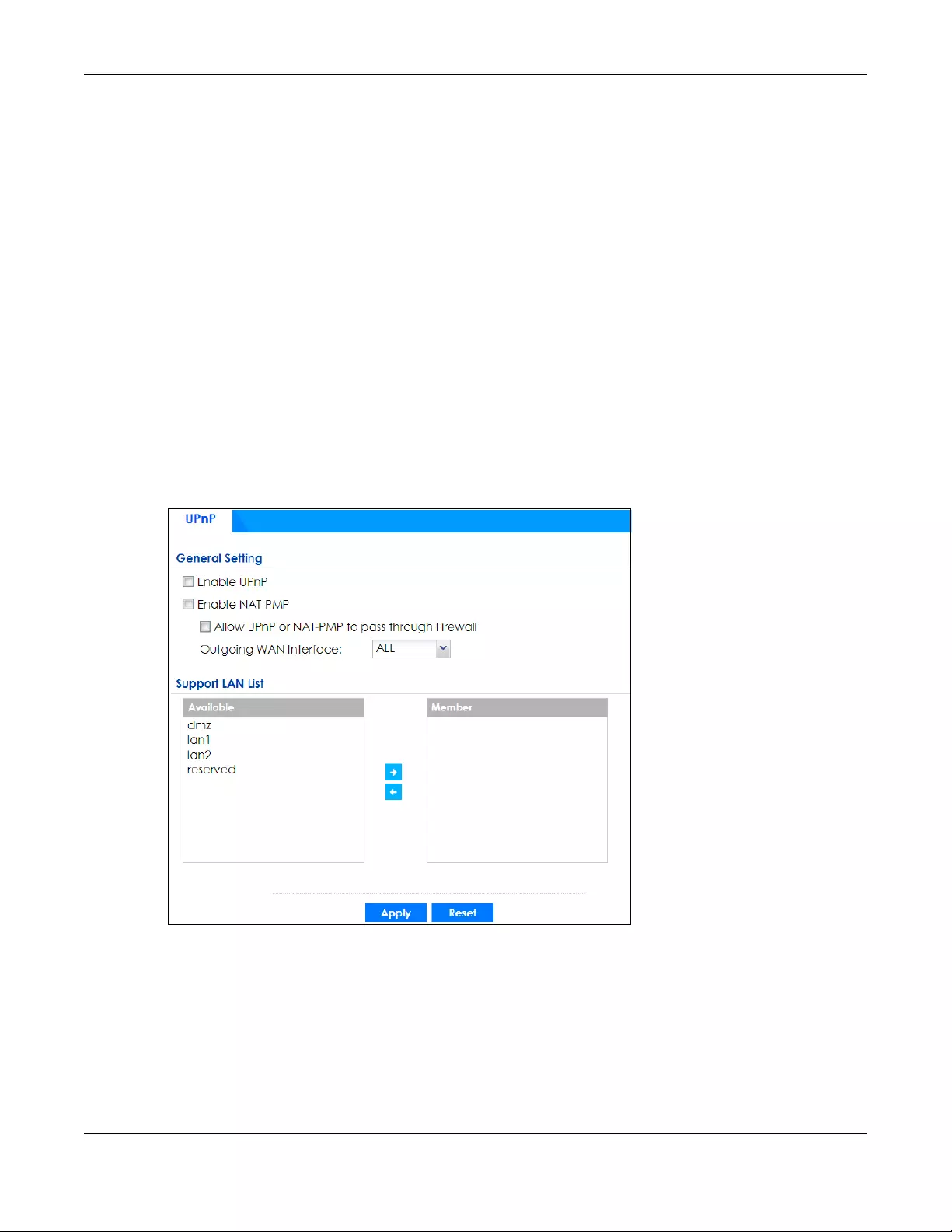
Chapter 15 UPnP
ZyWALL USG FLEX Series User’s Guide
389
15.2.2 Cautions with UPnP and NAT-PMP
The automated nature of NAT traversal applications in establishing their own services and opening
security policy ports may present network security issues. Network information and configuration may
also be obtained and modified by users in some network environments.
When a UPnP or NAT-PMP device joins a network, it announces its presence with a multicast message.
For security reasons, the Zyxel Device allows multicast messages on the LAN only.
All UPnP-enabled or NAT-PMP-enabled devices may communicate freely with each other without
additional configuration. Disable UPnP or NAT-PMP if this is not your intention.
15.3 UPnP Screen
Use this screen to enable UPnP and NAT-PMP on your Zyxel Device.
Click Configuration > Network > UPnP to display the screen shown next.
Figure 262 Configuration > Network > UPnP

Chapter 15 UPnP
ZyWALL USG FLEX Series User’s Guide
390
The following table describes the fields in this screen.
15.4 Technical Reference
The sections show examples of using UPnP.
15.4.1 Turning on UPnP in Windows 7 Example
This section shows you how to use the UPnP feature in Windows 7. UPnP server is installed in Windows 7.
Activate UPnP on the Zyxel Device.
Make sure the computer is connected to a LAN port of the Zyxel Device. Turn on your computer and the
Zyxel Device.
1Click the start icon, Control Panel and then the Network and Sharing Center.
Table 155 Configuration > Network > UPnP
LABEL DESCRIPTION
Enable UPnP Select this check box to activate UPnP on the Zyxel Device. Be aware that anyone could use
a UPnP application to open the web configurator's login screen without entering the Zyxel
Device's IP address (although you must still enter the password to access the web
configurator).
Enable NAT-PMP NAT Port Mapping Protocol (NAT-PMP) automates port forwarding to allow a computer in a
private network (behind the Zyxel Device) to automatically configure the Zyxel Device to
allow computers outside the private network to contact it.
Select this check box to activate NAT-PMP on the Zyxel Device. Be aware that anyone could
use a NAT-PMP application to open the web configurator's login screen without entering the
Zyxel Device's IP address (although you must still enter the password to access the web
configurator).
Allow UPnP or
NAT-PMP to pass
through Firewall
Select this check box to allow traffic from UPnP-enabled or NAT-PMP-enabled applications
to bypass the security policy.
Clear this check box to have the security policy block all UPnP or NAT-PMP application
packets (for example, MSN packets).
Outgoing WAN
Interface Select through which WAN interface(s) you want to send out traffic from UPnP-enabled or
NAT-PMP-enabled applications. If the WAN interface you select loses its connection, the
Zyxel Device attempts to use the other WAN interface. If the other WAN interface also does
not work, the Zyxel Device drops outgoing packets from UPnP-enabled or NAT-PMP-enabled
applications.
Support LAN List The Available list displays the name(s) of the internal interface(s) on which the Zyxel Device
supports UPnP and/or NAT-PMP.
To enable UPnP and/or NAT-PMP on an interface, you can double-click a single entry to
move it or use the [Shift] or [Ctrl] key to select multiple entries and click the right arrow button
to add to the Member list. To remove an interface, select the name(s) in the Member list and
click the left arrow button.
Apply Click Apply to save your changes back to the Zyxel Device.
Reset Click Reset to return the screen to its last-saved settings.

Chapter 15 UPnP
ZyWALL USG FLEX Series User’s Guide
391
2Click Change Advanced Sharing Settings.
3Select Turn on network discovery and click Save Changes. Network discovery allows your computer to
find other computers and devices on the network and other computers on the network to find your
computer. This makes it easier to share files and printers.

Chapter 15 UPnP
ZyWALL USG FLEX Series User’s Guide
392
15.4.1.1 Auto-discover Your UPnP-enabled Network Device
Before you follow these steps, make sure you already have UPnP activated on the Zyxel Device and in
your computer.
Make sure your computer is connected to a LAN port of the Zyxel Device.
1Open the Windows Explorer and click Network.
2Right-click the device icon and select Properties.
Figure 263 Network Connections
3In the Internet Connection Properties window, click Settings to see port mappings.
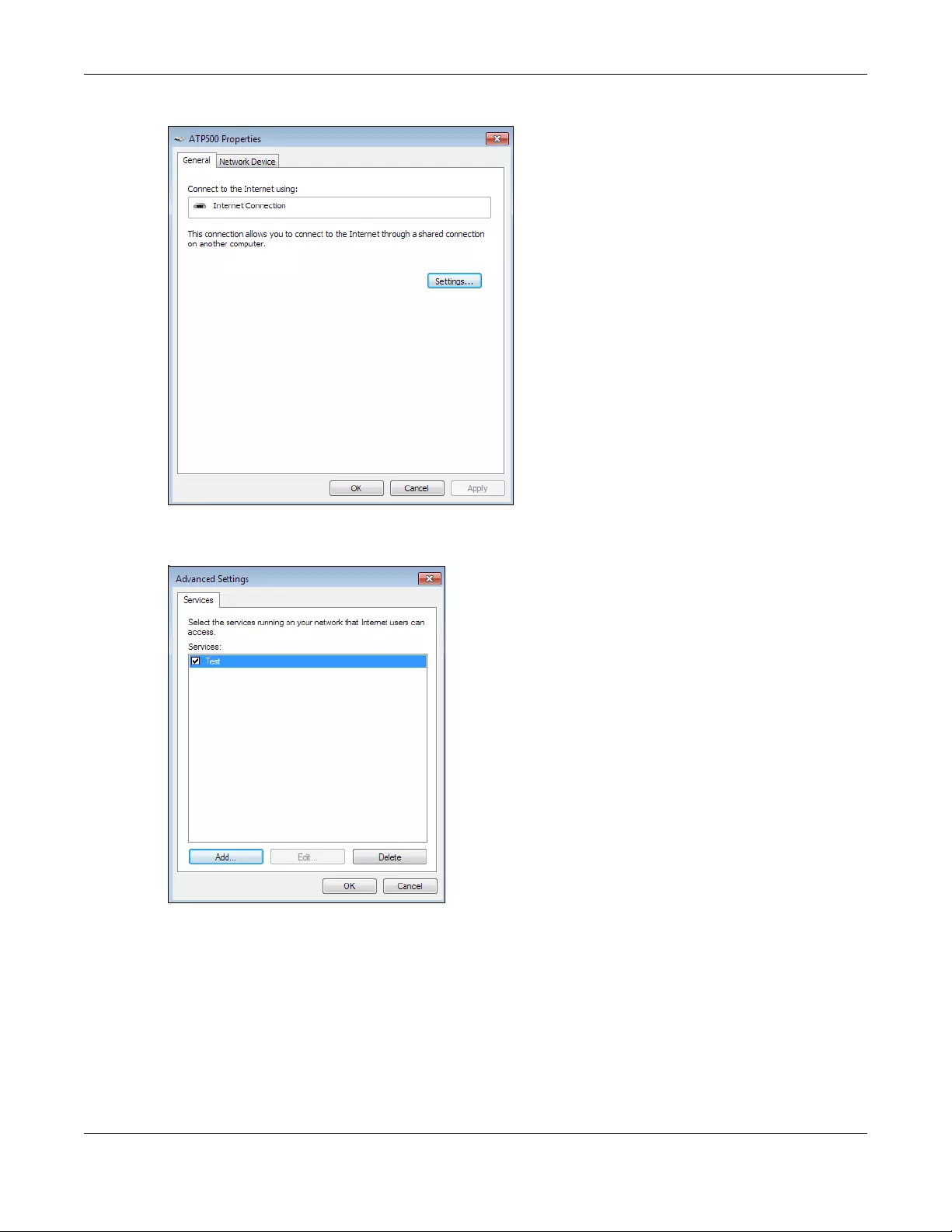
Chapter 15 UPnP
ZyWALL USG FLEX Series User’s Guide
393
Figure 264 Internet Connection Properties
4You may edit or delete the port mappings or click Add to manually add port mappings.
Figure 265 Internet Connection Properties: Advanced Settings

Chapter 15 UPnP
ZyWALL USG FLEX Series User’s Guide
394
Figure 266 Internet Connection Properties: Advanced Settings: Add
Note: When the UPnP-enabled device is disconnected from your computer, all port
mappings will be deleted automatically.
5Click OK. Check the network icon on the system tray to see your Internet connection status.
Figure 267 System Tray Icon
6To see more details about your current Internet connection status, right click on the network icon in the
system tray and click Open Network and Sharing Center. Click Local Area Network.
Figure 268 Internet Connection Status
15.4.2 Turn on UPnP in Windows 10 Example
This section shows you how to use the UPnP feature in Windows 10. UPnP server is installed in Windows 10.
Activate UPnP on the Zyxel Device by clicking Network Setting > Home Networking > UPnP.
Make sure the computer is connected to the LAN port of the Zyxel Device. Turn on your computer and
the Zyxel Device.
1Click the start icon, Settings and then Network & Internet.

Chapter 15 UPnP
ZyWALL USG FLEX Series User’s Guide
395
2Click Network and Sharing Center.
3Click Change advanced sharing settings.

Chapter 15 UPnP
ZyWALL USG FLEX Series User’s Guide
396
4Under Domain, select Turn on network disc overy and click Save Changes. Network discovery allows your
computer to find other computers and devices on the network and other computers on the network to
find your computer. This makes it easier to share files and printers.
15.4.3 Auto-discover Your UPnP-enabled Network Device
Before you follow these steps, make sure you already have UPnP activated on the Zyxel Device and in
your computer.

Chapter 15 UPnP
ZyWALL USG FLEX Series User’s Guide
397
Make sure your computer is connected to the LAN port of the Zyxel Device.
1Open File Explorer and click Network.
2Right-click the Zyxel Device icon and select Properties.
Figure 269 Network Connections
3In the Internet Connection Properties window, click Settings to see port mappings.
Figure 270 Internet Connection Properties
4You may edit or delete the port mappings or click Add to manually add port mappings.

Chapter 15 UPnP
ZyWALL USG FLEX Series User’s Guide
398
Figure 271 Internet Connection Properties: Advanced Settings
Figure 272 Internet Connection Properties: Advanced Settings: Add
Note: When the UPnP-enabled device is disconnected from your computer, all port
mappings will be deleted automatically.
5Click OK. Check the network icon on the system tray to see your Internet connection status.
Figure 273 System Tray Icon
6To see more details about your current Internet connection status, right click the network icon in the
system tray and click Open Network & Internet settings. Click Network and Sharing Center and click the
Connections.
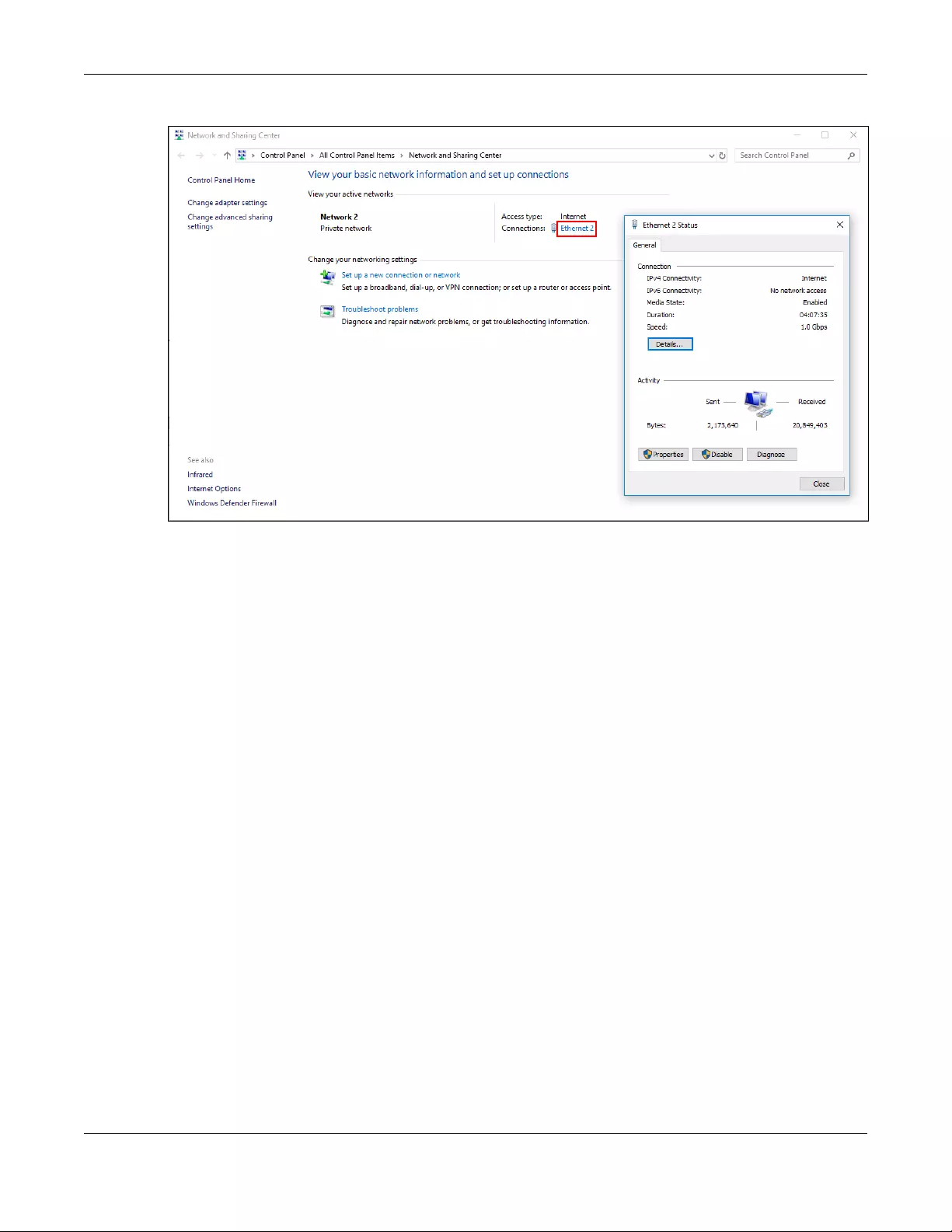
Chapter 15 UPnP
ZyWALL USG FLEX Series User’s Guide
399
Figure 274 Internet Connection Status
15.4.4 Web Configurator Easy Access in Windows 7
With UPnP, you can access the web-based configurator on the Zyxel Device without finding out the IP
address of the Zyxel Device first. This comes helpful if you do not know the IP address of the Zyxel Device.
Follow the steps below to access the web configurator.
1Open Windows Explorer.
2Click Network.

Chapter 15 UPnP
ZyWALL USG FLEX Series User’s Guide
400
Figure 275 Network Connections
3An icon with the description for each UPnP-enabled device displays under Network Infrastructure.
4Right-click on the icon for your Zyxel Device and select View device webpage. The web configurator
login screen displays.
Figure 276 Network Connections: My Network Places
5Right-click on the icon for your Zyxel Device and select Properties. Click the Network Device tab. A
window displays with information about the Zyxel Device.

Chapter 15 UPnP
ZyWALL USG FLEX Series User’s Guide
401
Figure 277 Network Connections: My Network Places: Properties: Example
15.4.5 Web Configurator Easy Access in Windows 10
Follow the steps below to access the Web Configurator.
1Open File Explorer.
2Click Network.
Figure 278 Network Connections

Chapter 15 UPnP
ZyWALL USG FLEX Series User’s Guide
402
3An icon with the description for each UPnP-enabled device displays under Network Infrastructure.
4Right-click the icon for your Zyxel Device and select View device webpage. The Web Configurator login
screen displays.
Figure 279 Network Connections: Network Infrastructure
5Right-click the icon for your Zyxel Device and select Properties. Click the Network Device tab. A window
displays information about the Zyxel Device.
Figure 280 Network Connections: Network Infrastructure: Properties: Example

ZyWALL USG FLEX Series User’s Guide
403
CHAPTER 16
IP/MAC Binding
16.1 IP/MAC Binding Overview
IP address to MAC address binding helps ensure that only the intended devices get to use privileged IP
addresses. The Zyxel Device uses DHCP to assign IP addresses and records the MAC address it assigned
to each IP address. The Zyxel Device then checks incoming connection attempts against this list. A user
cannot manually assign another IP to his computer and use it to connect to the Zyxel Device.
Suppose you configure access privileges for IP address 192.168.1.27 and use static DHCP to assign it to
Tim’s computer’s MAC address of 12:34:56:78:90:AB. IP/MAC binding drops traffic from any computer
trying to use IP address 192.168.1.27 with another MAC address.
Figure 281 IP/MAC Binding Example
16.1.1 What You Can Do in this Chapter
• Use the Summary and Edit screens (Section 16.2 on page 404) to bind IP addresses to MAC addresses.
• Use the Exempt List screen (Section 16.3 on page 407) to configure ranges of IP addresses to which
the Zyxel Device does not apply IP/MAC binding.
16.1.2 What You Need to Know
DHCP
IP/MAC address bindings are based on the Zyxel Device’s dynamic and static DHCP entries.
MAC: 12:34:56:78:90:AB
Tim IP: 192.168.1.27
MAC: AB:CD:EF:12:34:56
Jim
IP: 192.168.1.27

Chapter 16 IP/MAC Binding
ZyWALL USG FLEX Series User’s Guide
404
Interfaces Used With IP/MAC Binding
IP/MAC address bindings are grouped by interface. You can use IP/MAC binding with Ethernet, bridge,
VLAN, and WLAN interfaces. You can also enable or disable IP/MAC binding and logging in an
interface’s configuration screen.
16.2 IP/MAC Binding Summary
Click Configuration > Network > IP/MAC Binding to open the IP/MAC Binding Summary screen. This
screen lists the total number of IP to MAC address bindings for devices connected to each supported
interface.
Figure 282 Configuration > Network > IP/MAC Binding > Summary
The following table describes the labels in this screen.
Table 156 Configuration > Network > IP/MAC Binding > Summary
LABEL DESCRIPTION
Edit Double-click an entry or select it and click Edit to open a screen where you can modify the
entry’s settings.
Activate To turn on an entry, select it and click Activate.
Inactivate To turn off an entry, select it and click Inactivate.
#This field is a sequential value, and it is not associated with a specific entry.
Status This icon is lit when the entry is active and dimmed when the entry is inactive.
Interface This is the name of an interface that supports IP/MAC binding.
Number of
Binding
This field displays the interface’s total number of IP/MAC bindings and IP addresses that the
interface has assigned by DHCP.

Chapter 16 IP/MAC Binding
ZyWALL USG FLEX Series User’s Guide
405
16.2.1 IP/MAC Binding Edit
Click Configuration > Network > IP/MAC Binding > Edit to open the IP/MAC Binding Edit screen. Use this
screen to configure an interface’s IP to MAC address binding settings.
Figure 283 Configuration > Network > IP/MAC Binding > Edit
The following table describes the labels in this screen.
Apply Click Apply to save your changes back to the Zyxel Device.
Reset Click Reset to return the screen to its last-saved settings.
Table 156 Configuration > Network > IP/MAC Binding > Summary (continued)
LABEL DESCRIPTION
Table 157 Configuration > Network > IP/MAC Binding > Edit
LABEL DESCRIPTION
IP/MAC Binding Settings
Interface Name This field displays the name of the interface within the Zyxel Device and the interface’s
IP address and subnet mask.
Enable IP/MAC
Binding Select this option to have this interface enforce links between specific IP addresses
and specific MAC addresses. This stops anyone else from manually using a bound IP
address on another device connected to this interface. Use this to make use only the
intended users get to use specific IP addresses.
Enable Logs for IP/
MAC Binding Violation Select this option to have the Zyxel Device generate a log if a device connected to
this interface attempts to use an IP address not assigned by the Zyxel Device.
Static DHCP Bindings This table lists the bound IP and MAC addresses. The Zyxel Device checks this table
when it assigns IP addresses. If the computer’s MAC address is in the table, the Zyxel
Device assigns the corresponding IP address. You can also access this table from the
interface’s edit screen.
Add Click this to create a new entry.
Edit Double-click an entry or select it and click Edit to open a screen where you can
modify the entry’s settings.

Chapter 16 IP/MAC Binding
ZyWALL USG FLEX Series User’s Guide
406
16.2.2 Static DHCP Edit
Click Configuration > Network > IP/ MAC Binding > Edit to open the IP/MAC Binding Edit screen. Click the
Add or Edit icon to open the following screen. Use this screen to configure an interface’s IP to MAC
address binding settings.
Figure 284 Configuration > Network > IP/MAC Binding > Edit > Add
The following table describes the labels in this screen.
Remove To remove an entry, select it and click Remove. The Zyxel Device confirms you want to
remove it before doing so.
#This is the index number of the static DHCP entry.
IP Address This is the IP address that the Zyxel Device assigns to a device with the entry’s MAC
address.
MAC Address This is the MAC address of the device to which the Zyxel Device assigns the entry’s IP
address.
Description This helps identify the entry.
OK Click OK to save your changes back to the Zyxel Device.
Cancel Click Cancel to exit this screen without saving.
Table 157 Configuration > Network > IP/MAC Binding > Edit (continued)
LABEL DESCRIPTION
Table 158 Configuration > Network > IP/MAC Binding > Edit > Add
LABEL DESCRIPTION
Interface Name This field displays the name of the interface within the Zyxel Device and the interface’s IP
address and subnet mask.
IP Address Enter the IP address that the Zyxel Device is to assign to a device with the entry’s MAC
address.
MAC Address Enter the MAC address of the device to which the Zyxel Device assigns the entry’s IP
address.
Description Enter up to 64 printable ASCII characters to help identify the entry. For example, you may
want to list the computer’s owner.
OK Click OK to save your changes back to the Zyxel Device.
Cancel Click Cancel to exit this screen without saving.

Chapter 16 IP/MAC Binding
ZyWALL USG FLEX Series User’s Guide
407
16.3 IP/MAC Binding Exempt List
Click Configuration > Network > IP/MAC Binding > Exempt List to open the IP/MAC Binding Exempt List
screen. Use this screen to configure ranges of IP addresses to which the Zyxel Device does not apply IP/
MAC binding.
Figure 285 Configuration > Network > IP/MAC Binding > Exempt List
The following table describes the labels in this screen.
Table 159 Configuration > Network > IP/MAC Binding > Exempt List
LABEL DESCRIPTION
Add Click this to create a new entry.
Edit Click an entry or select it and click Edit to modify the entry’s settings.
Remove To remove an entry, select it and click Remove. The Zyxel Device confirms you want to remove it
before doing so.
#This is the index number of the IP/MAC binding list entry.
Name Enter a name to help identify this entry.
Start IP Enter the first IP address in a range of IP addresses for which the Zyxel Device does not apply IP/
MAC binding.
End IP Enter the last IP address in a range of IP addresses for which the Zyxel Device does not apply IP/
MAC binding.
Add icon Click the Add icon to add a new entry.
Click the Remove icon to delete an entry. A window displays asking you to confirm that you want
to delete it.
Apply Click Apply to save your changes back to the Zyxel Device.
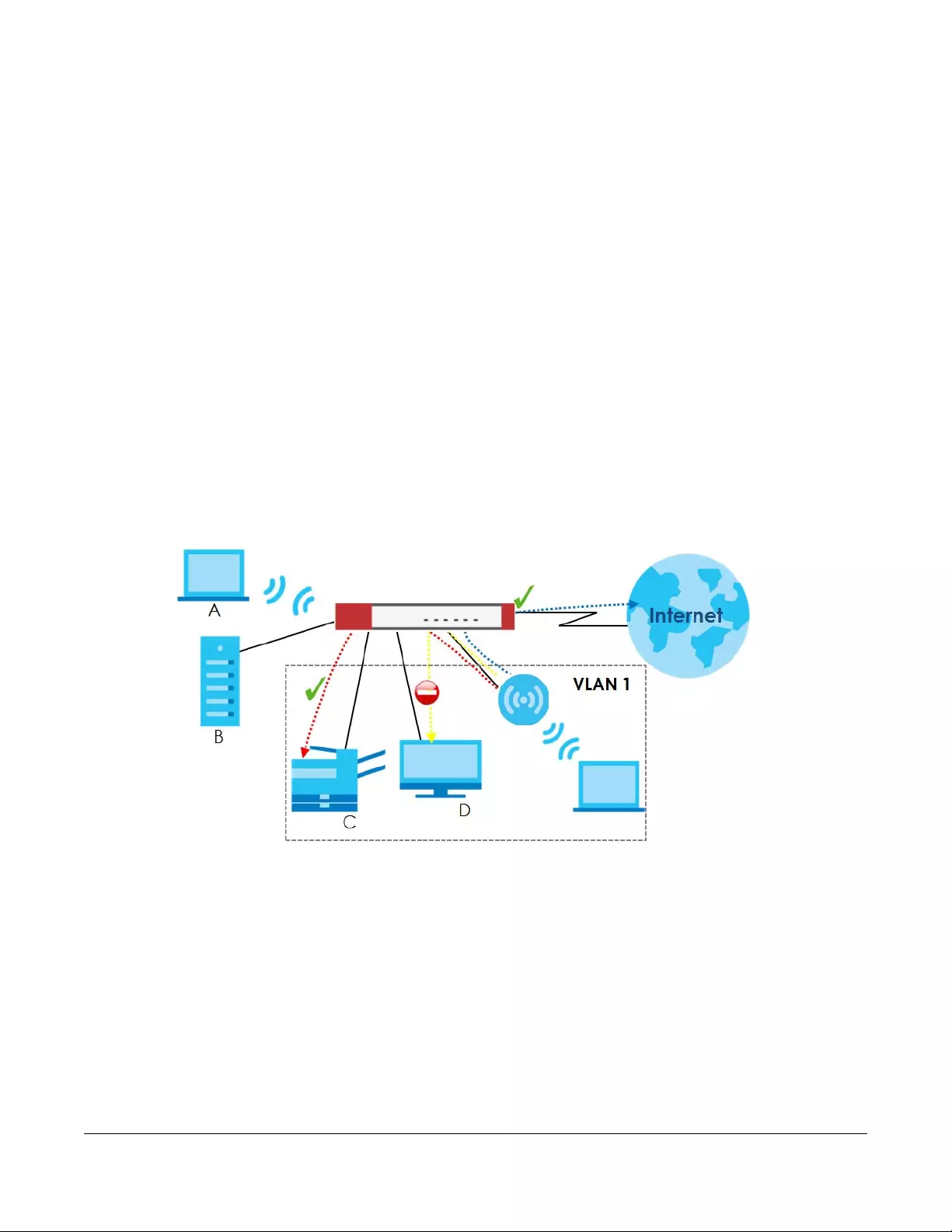
ZyWALL USG FLEX Series User’s Guide
408
CHAPTER 17
Layer 2 Isolation
17.1 Overview
Layer-2 isolation is used to prevent connected devices from communicating with each other in the Zyxel
Device’s local network(s), except for the devices in the white list, when layer-2 isolation is enabled on
the Zyxel Device and the local interface(s).
Note: The security policy control must be enabled before you can use layer-2 isolation.
In the following example, layer-2 isolation is enabled on the Zyxel Device’s interface Vlan1. A printer, PC
and AP are in the Vlan1. The IP address of network printer (C) is added to the white list. With this setting,
the connected AP then cannot communicate with the PC (D), but can access the network printer (C),
server (B), wireless client (A) and the Internet.
Figure 286 Layer-2 Isolation Application
17.1.1 What You Can Do in this Chapter
• Use the General screen (Section 17.2 on page 408) to enable layer-2 isolation on the Zyxel Device
and the internal interface(s).
• Use the White List screen (Section 17.3 on page 409) to enable and configures the white list.
17.2 Layer-2 Isolation General Screen
This screen allows you to enable Layer-2 isolation on the Zyxel Device and specific internal interface(s).
To access this screen click Configuration > Network > Layer 2 Isolation.

Chapter 17 Layer 2 Isolation
ZyWALL USG FLEX Series User’s Guide
409
Figure 287 Configuration > Network > Layer 2 Isolation
The following table describes the labels in this screen.
17.3 White List Screen
IP addresses that are not listed in the white list are blocked from communicating with other devices in
the layer-2-isolation-enabled internal interface(s) except for broadcast packets.
To access this screen click Configuration > Network > Layer 2 Isolation > White List.
Table 160 Configuration > Network > Layer 2 Isolation
LABEL DESCRIPTION
Enable Layer2
Isolation
Select this option to turn on the layer-2 isolation feature on the Zyxel Device.
Note: You can enable this feature only when the security policy is enabled.
Member List The Available list displays the name(s) of the internal interface(s) on which you can enable
layer-2 isolation.
To enable layer-2 isolation on an interface, you can double-click a single entry to move it or use
the [Shift] or [Ctrl] key to select multiple entries and click the right arrow button to add to the
Member list. To remove an interface, select the name(s) in the Member list and click the left
arrow button.
Apply Click Apply to save your changes back to the Zyxel Device.
Reset Click Reset to return the screen to its last-saved settings.

Chapter 17 Layer 2 Isolation
ZyWALL USG FLEX Series User’s Guide
410
Figure 288 Configuration > Network > Layer 2 Isolation > White List
The following table describes the labels in this screen.
17.3.1 Add/Edit White List Rule
This screen allows you to create a new rule in the white list or edit an existing one. To access this screen,
click the Add button or select an entry from the list and click the Edit button.
Note: You can configure up to 100 white list rules on the Zyxel Device.
Note: You need to know the IP address of each connected device that you want to allow to
be accessed by other devices when layer-2 isolation is enabled.
Table 161 Configuration > Network > Layer 2 Isolation > White List
LABEL DESCRIPTION
Enable White List Select this option to turn on the white list on the Zyxel Device.
Note: You can enable this feature only when the security policy is enabled.
Add Click this to add a new rule.
Edit Click this to edit the selected rule.
Remove Click this to remove the selected rule.
Activate To turn on an entry, select it and click Activate.
Inactivate To turn off an entry, select it and click Inactivate.
#This field is a sequential value, and it is not associated with a specific rule.
Status This icon is lit when the rule is active and dimmed when the rule is inactive.
IP Address This field displays the IP address of device that can be accessed by the devices connected to
an internal interface on which layer-2 isolation is enabled.
Description This field displays the description for the IP address in this rule.
Apply Click Apply to save your changes back to the Zyxel Device.
Reset Click Reset to return the screen to its last-saved settings.
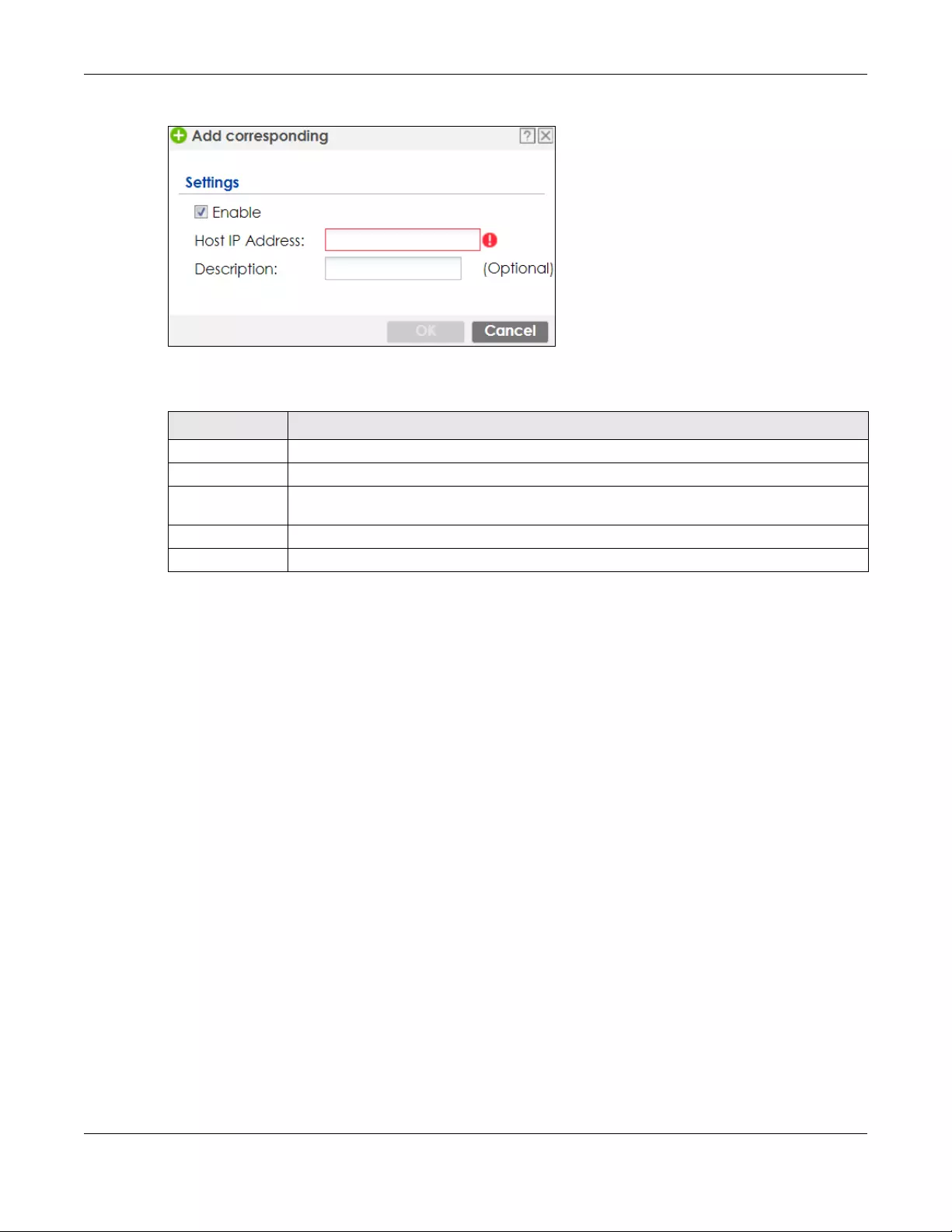
Chapter 17 Layer 2 Isolation
ZyWALL USG FLEX Series User’s Guide
411
Figure 289 Configuration > Network > Layer 2 Isolation > White List > Add/Edit
The following table describes the labels in this screen.
Table 162 Configuration > Network > Layer 2 Isolation > White List > Add/Edit
LABEL DESCRIPTION
Enable Select this option to turn on the rule.
Host IP Address Enter an IPv4 address associated with this rule.
Description Specify a description for the IP address associated with this rule. Enter up to 60 characters,
spaces and underscores allowed.
OK Click OK to save your changes back to the Zyxel Device.
Cancel Click Cancel to exit this screen without saving your changes.

ZyWALL USG FLEX Series User’s Guide
412
CHAPTER 18
DNS Inbound LB
18.1 DNS Inbound Load Balancing Overview
Inbound load balancing enables the Zyxel Device to respond to a DNS query message with a different
IP address for DNS name resolution. The Zyxel Device checks which member interface has the least load
and responds to the DNS query message with the interface’s IP address.
In the following figure, an Internet host (A) sends a DNS query message to the DNS server (D) in order to
resolve a domain name of www.example.com. DNS server D redirects it to the Zyxel Device (Z)’s WAN1
with an IP address of 1.1.1.1. The Zyxel Device receives the DNS query message and responds to it with
the WAN2’s IP address, 2.2.2.2, because the WAN2 has the least load at that moment.
Another Internet host (B) also sends a DNS query message to ask where www.example.com is. The Zyxel
Device responds to it with the WAN1’s IP address, 1.1.1.1, since WAN1 has the least load this time.
Figure 290 DNS Load Balancing Example
18.1.1 What You Can Do in this Chapter
• Use the Inbound LB screen (see Section 18.2 on page 413) to view a list of the configured DNS load
balancing rules.
• Use the Inbound LB Add/Edit screen (see Section 18.2.1 on page 414) to add or edit a DNS load
balancing rule.
Where is
www.example.com?
Ask 1.1.1.1.
A:
D:
A
D
1.1.1.1
2.2.2.2
W
Z
Where is
www.example.com?
It’s 2.2.2.2.
A:
Z:
1
2
3
B
D
1.1.1.1
2.2.2.2
W
Z
1
2
3
Where is
www.example.com?
Ask 1.1.1.1.
B:
D:
Where is
www.example.com?
It’s 1.1.1.1
B:
Z:

Chapter 18 DNS Inbound LB
ZyWALL USG FLEX Series User’s Guide
413
18.2 The DNS Inbound LB Screen
The Inbound LB screen provides a summary of all DNS load balancing rules and the details. You can also
use this screen to add, edit, or remove the rules. Click Configuration > Network > Inb ound LB to open the
following screen.
Note: After you finish the inbound load balancing settings, go to security policy and NAT
screens to configure the corresponding rule and virtual server to allow the Internet users
to access your internal servers.
Figure 291 Configuration > Network > DNS Inbound LB
The following table describes the labels in this screen.
Table 163 Configuration > Network > DNS Inbound LB
LABEL DESCRIPTION
Global Setting
Enable DNS Load
Balancing
Select this to enable DNS load balancing.
Configuration
Add Click this to create a new entry.
Edit Double-click an entry or select it and click Edit to open a screen where you can modify
the entry’s settings.
Remove To remove an entry, select it and click Remove. The Zyxel Device confirms you want to
remove it before doing so.
Activate To turn on an entry, select it and click Activate.
Inactivate To turn off an entry, select it and click Inactivate.
Move To move an entry to a different number in the list, click the Move icon. In the field that
appears, specify the number to which you want to move the entry.
Status This icon is lit when the entry is active and dimmed when the entry is inactive.
Priority This field displays the order in which the Zyxel Device checks the member interfaces of
this DNS load balancing rule.
Query Domain Name This field displays the domain name for which the Zyxel Device manages load
balancing between the specified interfaces.

Chapter 18 DNS Inbound LB
ZyWALL USG FLEX Series User’s Guide
414
18.2.1 The DNS Inbound LB Add/Edit Screen
The Add DNS Load Balancing screen allows you to add a domain name for which the Zyxel Device
manages load balancing between the specified interfaces. You can configure the Zyxel Device to
apply DNS load balancing to some specific hosts only by configuring the Query From settings. Click
Configuration > Network > Inbound LB and then the Add or Edit icon to open this screen.
Query From Address This field displays the source IP address of the DNS query messages to which the Zyxel
Device applies the DNS load balancing rule.
Query From Zone The Zyxel Device applies the DNS load balancing rule to the query messages received
from this zone.
Load Balancing
Member
This field displays the member interfaces which the Zyxel Device manages for load
balancing.
Algorithm This field displays the load balancing method the Zyxel Device uses for this DNS load
balancing rule.
Weighted Round Robin - Each member interface is assigned a weight. An interface with
a larger weight gets more chances to transmit traffic than an interface with a smaller
weight. For example, if the weight ratio of wan1 and wan2 interfaces is 2:1, the Zyxel
Device chooses wan1 for 2 sessions’ traffic and wan2 for 1 session’s traffic in each round
of 3 new sessions.
Least Connection - The Zyxel Device chooses choose a member interface which is
handling the least number of sessions.
Least Load - Outbound - The Zyxel Device chooses a member interface which is
handling the least amount of outgoing traffic.
Least Load - Inbound - The Zyxel Device chooses a member interface which is handling
the least amount of incoming traffic.
Least Load - Total - The Zyxel Device chooses a member interface which is handling the
least amount of outgoing and incoming traffic.
Apply Click this button to save your changes to the Zyxel Device.
Reset Click this button to return the screen to its last-saved settings.
Table 163 Configuration > Network > DNS Inbound LB (continued)
LABEL DESCRIPTION

Chapter 18 DNS Inbound LB
ZyWALL USG FLEX Series User’s Guide
415
Figure 292 Configuration > Network > DNS Inbound LB > Add
The following table describes the labels in this screen.
Table 164 Configuration > Network > DNS Inbound LB > Add/Edit
LABEL DESCRIPTION
Create New Object Use this to configure any new setting objects that you need to use in this screen.
General Settings
Enable Select this to enable this DNS load balancing rule.
DNS Settings
Query Domain Name Type up to 255 characters for a domain name for which you want the Zyxel Device to
manage DNS load balancing. You can use a wildcard (*) to let multiple domains match
the name. For example, use *.example.com to specify any domain name that ends with
“example.com” would match.
Time to Live Enter the number of seconds the Zyxel Device recommends DNS request hosts to keep
the DNS entry in their caches before removing it. Enter 0 to have the Zyxel Device not
recommend this so the DNS request hosts will follow their DNS server’s TTL setting.
Query From Setting
IP Address Select the name of an P address object, including geographic address object, of a
computer or a DNS server which makes the DNS queries upon which to apply this rule.
DNS servers process client queries using recursion or iteration:
• In recursion, DNS servers make recursive queries on behalf of clients. So you have to
configure this field to the DNS server’s IP address when recursion is used.
• In iteration, a client asks the DNS server and expects the best and immediate answer
without the DNS server contacting other DNS servers. If the primary DNS server cannot
provide the best answer, the client makes iteration queries to other configured DNS
servers to resolve the name. You have to configure this field to the client’s IP address
when iteration is used.

Chapter 18 DNS Inbound LB
ZyWALL USG FLEX Series User’s Guide
416
18.2.2 The DNS Inbound LB Add/Edit Member Screen
The Add Load Balancing Member screen allows you to add a member interface for the DNS load
balancing rule. Click Configuration > Network > DNS Inbound LB > Add or Edit and then an Add or Edit
icon to open this screen.
Zone Select the zone of DNS query messages upon which to apply this rule.
Load Balancing
Member
Load Balancing
Algorithm
Select a load balancing method to use from the drop-down list box.
Select Weighted Round Robin to balance the traffic load between interfaces based on
their respective weights. An interface with a larger weight gets more chances to transmit
traffic than an interface with a smaller weight. For example, if the weight ratio of wan1
and wan2 interfaces is 2:1, the Zyxel Device chooses wan1 for 2 sessions’ traffic and
wan2 for every session’s traffic in each round of 3 new sessions.
Select Least Connection to have the Zyxel Device choose the member interface which is
handling the least number of sessions.
Select Least Load - Outbound to have the Zyxel Device choose the member interface
which is handling the least amount of outgoing traffic.
Select Least Load - Inbound to have the Zyxel Device choose the member interface
which is handling the least amount of incoming traffic.
Select Least Load - Total to have the Zyxel Device choose the member interface which is
handling the least amount of outgoing and incoming traffic.
Failover IP Address Enter an alternate IP address with which the Zyxel Device will respond to a DNS query
message when the load balancing algorithm cannot find any available interface.
Add Click this to create a new member interface for this rule.
Edit Double-click an entry or select it and click Edit to open a screen where you can modify
the entry’s settings.
Remove To remove an entry, select it and click Remove. The Zyxel Device confirms you want to
remove it before doing so.
#This field displays the order in which the Zyxel Device checks this rule’s member
interfaces.
IP Address This field displays the IP address of the member interface.
Monitor Interface This field displays the name of the member interface. The Zyxel Device manages load
balancing between the member interfaces.
Weight This field is available if you selected Weighted Round Robin as the load balancing
algorithm. This field displays the weight of the member interface. An interface with a
larger weight gets more chances to transmit traffic than an interface with a smaller
weight.
OK Click OK to save your changes back to the Zyxel Device.
Cancel Click Cancel to exit this screen without saving.
Table 164 Configuration > Network > DNS Inbound LB > Add/Edit (continued)
LABEL DESCRIPTION

Chapter 18 DNS Inbound LB
ZyWALL USG FLEX Series User’s Guide
417
Figure 293 Configuration > Network > DNS Inbound LB > Add/Edit > Add
The following table describes the labels in this screen.
Table 165 Configuration > Network > DNS Inbound LB > Add/Edit > Add/Edit
LABEL DESCRIPTION
Member The Zyxel Device checks each member interface’s loading in the order displayed here.
Monitor Interface Select an interface to associate it with the DNS load balancing rule. This field also displays
whether the IP address is a static IP address (Static), dynamically assigned (Dynamic) or
obtained from a DHCP server (DHCP Client), as well as the IP address and subnet mask.
Weight This field is available if you selected Weighted Round Robin for the load balancing
algorithm.
Specify the weight of the member interface. An interface with a larger weight gets more
chances to transmit traffic than an interface with a smaller weight.
IP Address
Same as Monitor
Interface
Select this to send the IP address displayed in the Monitor Interface field to the DNS query
senders.
Custom Select this and enter another IP address to send to the DNS query senders.
OK Click OK to save your changes back to the Zyxel Device.
Cancel Click Cancel to exit this screen without saving.

ZyWALL USG FLEX Series User’s Guide
418
CHAPTER 19
IPSec VPN
19.1 Virtual Private Networks (VPN) Overview
A virtual private network (VPN) provides secure communications between sites without the expense of
leased site-to-site lines. A secure VPN is a combination of tunneling, encryption, authentication, access
control and auditing. It is used to transport traffic over the Internet or any insecure network that uses
TCP/IP for communication.
IPSec VPN
Internet Protocol Security (IPSec) VPN connects IPSec routers or remote users using IPSec client software.
This standards-based VPN offers flexible solutions for secure data communications across a public
network. IPSec is built around a number of standardized cryptographic techniques to provide
confidentiality, data integrity and authentication at the IP layer. The Zyxel Device can also combine
multiple IPSec VPN connections into one secure network. Here local Zyxel Device X uses an IPSec VPN
tunnel to remote (peer) Zyxel Device Y to connect the local (A) and remote (B) networks.
Figure 294 IPSec VPN Example
Internet Key Exchange (IKE): IKEv1 and IKEv2
The Zyxel Device supports IKEv1 and IKEv2 for IPv4 and IPv6 traffic. IKE (Internet Key Exchange) is a
protocol used in setting up security associations that allows two parties to send data securely.
IKE uses certificates or pre-shared keys for authentication and a Diffie–Hellman key exchange to set up
a shared session secret from which encryption keys are derived. A security policy for each peer must be
manually created.
IPSec VPN consists of two phases: Phase 1 and Phase 2. Phase 1's purpose is to establish a secure
authenticated communication channel by using the Diffie–Hellman key exchange algorithm to
generate a shared secret key to encrypt IKE communications. This negotiation results in one single bi-
directional ISAKMP Security Association (SA). The authentication can be performed using either pre-

Chapter 19 IPSec VPN
ZyWALL USG FLEX Series User’s Guide
419
shared key (shared secret), signatures, or public key encryption. Phase 1 operates in either Main Mode
or Aggressive Mode. Main Mode protects the identity of the peers, but Aggressive Mode does not.
During Phase 2, the remote IPSec routers use the secure channel established in Phase 1 to negotiate
Security Associations for IPSec. The negotiation results in a minimum of two unidirectional security
associations (one inbound and one outbound). Phase 2 uses Quick Mode (only). Quick mode occurs
after IKE has established the secure tunnel in Phase 1. It negotiates a shared IPSec policy, derives shared
secret keys used for the IPSec security algorithms, and establishes IPSec SAs. Quick mode is also used to
renegotiate a new IPSec SA when the IPSec SA lifetime expires.
In the Zyxel Device, use the VPN Connection tab to set up Phase 2 and the VPN Gateway tab to set up
Phase 1.
Some differences between IKEv1 and IKEv2 include:
• IKEv2 uses less bandwidth than IKEv1. IKEv2 uses one exchange procedure with 4 messages. IKEv1 uses
two phases with Main Mode (9 messages) or Aggressive Mode (6 messages) in phase 1.
• IKEv2 supports Extended Authentication Protocol (EAP) authentication, and IKEv1 supports X-Auth.
EAP is important when connecting to existing enterprise authentication systems.
• IKEv2 always uses NAT traversal and Dead Peer Detection (DPD), but they can be disabled in IKEv1
using Zyxel Device firmware (the default is on).
• Configuration payload (includes the IP address pool in the VPN setup data) is supported in IKEv2 (off
by default), but not in IKEv1.
• Narrowed is supported in IKEv2, but not in IKEv1. Narrowed has the SA apply only to IP addresses in
common between the Zyxel Device and the remote IPSec router.
• The IKEv2 protocol supports connectivity checks which is used to detect whether the tunnel is still up
or not. If the check fails (the tunnel is down), IKEv2 can re-establish the connection automatically. The
Zyxel Device uses firmware to perform connectivity checks when using IKEv1.
SSL VPN
SSL VPN uses remote users’ web browsers to provide the easiest-to-use of the Zyxel Device’s VPN
solutions. A user just browses to the Zyxel Device’s web address and enters his user name and password
to securely connect to the Zyxel Device’s network. Remote users do not need to configure security
settings. Here a user uses his browser to securely connect to network resources in the same way as if he
were part of the internal network. See Chapter 20 on page 454 for more on SSL VPN.
Figure 295 SSL VPN
Web Mail File Share
Web-based Application
https://
Application Server
Non-Web
LAN (192.168.1.X)

Chapter 19 IPSec VPN
ZyWALL USG FLEX Series User’s Guide
420
L2TP VPN
L2TP VPN uses the L2TP and IPSec client software included in remote users’ Android, iOS, or Windows
operating systems for secure connections to the network behind the Zyxel Device. The remote users do
not need their own IPSec gateways or third-party VPN client software. For example, configure sales
representatives’ laptops, tablets, or smartphones to securely connect to the Zyxel Device’s network. See
Chapter 21 on page 460 for more on L2TP over IPSec.
Figure 296 L2TP VPN
19.1.1 What You Can Do in this Chapter
• Use the VPN Connection screens (see Section 19.2 on page 423) to specify which IPSec VPN gateway
an IPSec VPN connection policy uses, which devices behind the IPSec routers can use the VPN tunnel,
and the IPSec SA settings (phase 2 settings). You can also activate or deactivate and connect or
disconnect each VPN connection (each IPSec SA).
• Use the VPN Gateway screens (see Section 19.2.1 on page 425) to manage the Zyxel Device’s VPN
gateways. A VPN gateway specifies the IPSec routers at either end of a VPN tunnel and the IKE SA
settings (phase 1 settings). You can also activate and deactivate each VPN gateway.
• Use the VPN Concentrator screens (see Section 19.4 on page 440) to combine several IPSec VPN
connections into a single secure network.
• Use the Configuration Provisioning screen (see Section 19.5 on page 442) to set who can retrieve VPN
rule settings from the Zyxel Device using the Zyxel Device IPSec VPN Client.
19.1.2 What You Need to Know
An IPSec VPN tunnel is usually established in two phases. Each phase establishes a security association
(SA), a contract indicating what security parameters the Zyxel Device and the remote IPSec router will
use. The first phase establishes an Internet Key Exchange (IKE) SA between the Zyxel Device and remote
IPSec router. The second phase uses the IKE SA to securely establish an IPSec SA through which the Zyxel
Device and remote IPSec router can send data between computers on the local network and remote
network. This is illustrated in the following figure.

Chapter 19 IPSec VPN
ZyWALL USG FLEX Series User’s Guide
421
Figure 297 VPN: IKE SA and IPSec SA
In this example, a computer in network A is exchanging data with a computer in network B. Inside
networks A and B, the data is transmitted the same way data is normally transmitted in the networks.
Between routers X and Y, the data is protected by tunneling, encryption, authentication, and other
security features of the IPSec SA. The IPSec SA is secure because routers X and Y established the IKE SA
first.

Chapter 19 IPSec VPN
ZyWALL USG FLEX Series User’s Guide
422
Application Scenarios
The Zyxel Device’s application scenarios make it easier to configure your VPN connection settings.
Finding Out More
•See Section 19.6 on page 444 for IPSec VPN background information.
• See the help in the IPSec VPN quick setup wizard screens.
Table 166 IPSec VPN Application Scenarios
SITE-TO-SITE SITE-TO-SITE WITH
DYNAMIC PEER REMOTE ACCESS
(SERVER ROLE) REMOTE ACCESS
(CLIENT ROLE) VPN TUNNEL
INTERFACE
Choose this if the
remote IPSec router
has a static IP address
or a domain name.
This Zyxel Device can
initiate the VPN
tunnel.
The remote IPSec
router can also initiate
the VPN tunnel if this
Zyxel Device has a
static IP address or a
domain name.
Choose this if the
remote IPSec router has
a dynamic IP address.
You don’t specify the
remote IPSec router’s
address, but you specify
the remote policy (the
addresses of the devices
behind the remote
IPSec router).
This Zyxel Device must
have a static IP address
or a domain name.
Only the remote IPSec
router can initiate the
VPN tunnel.
Choose this to allow
incoming connections
from IPSec VPN clients.
The clients have
dynamic IP addresses
and are also known as
dial-in users.
You don’t specify the
addresses of the client
IPSec routers or the
remote policy.
This creates a dynamic
IPSec VPN rule that can
let multiple clients
connect.
Only the clients can
initiate the VPN tunnel.
Choose this to
connect to an
IPSec server.
This Zyxel Device is
the client (dial-in
user).
Client role Zyxel
Devices initiate
IPSec VPN
connections to a
server role Zyxel
Device.
This Zyxel Device
can have a
dynamic IP
address.
The IPSec server
doesn’t configure
this Zyxel Device’s
IP address or the
addresses of the
devices behind it.
Only this Zyxel
Device can initiate
the VPN tunnel.
Choose this to
set up a VPN
tunnel
interface to
bind with a
VPN
connection.
The Zyxel
Device can
use the
interface to do
load
balancing
using a specific
Trunk. The
remote IPSec
router should
have a static IP
address or a
domain name.

Chapter 19 IPSec VPN
ZyWALL USG FLEX Series User’s Guide
423
19.1.3 Before You Begin
This section briefly explains the relationship between VPN tunnels and other features. It also gives some
basic suggestions for troubleshooting.
You should set up the following features before you set up the VPN tunnel.
• In any VPN connection, you have to select address objects to specify the local policy and remote
policy. You should set up the address objects first.
• In a VPN gateway, you can select an Ethernet interface, virtual Ethernet interface, VLAN interface, or
virtual VLAN interface to specify what address the Zyxel Device uses as its IP address when it
establishes the IKE SA. You should set up the interface first.
• In a VPN gateway, you can enable extended authentication. If the Zyxel Device is in server mode,
you should set up the authentication method (AAA server) first. The authentication method specifies
how the Zyxel Device authenticates the remote IPSec router.
• In a VPN gateway, the Zyxel Device and remote IPSec router can use certificates to authenticate
each other. Make sure the Zyxel Device and the remote IPSec router will trust each other’s
certificates.
19.2 The VPN Connection Screen
Click Configuration > VPN > IPSec VPN to open the VP N Connection screen. The VPN Connection screen
lists the VPN connection policies and their associated VPN gateway(s), and various settings. In addition,
it also lets you activate or deactivate and connect or disconnect each VPN connection (each IPSec
SA). Click a column’s heading cell to sort the table entries by that column’s criteria. Click the heading
cell again to reverse the sort order.
Click on the icons to go to the OneSecurity website where there is guidance on configuration
walkthroughs, troubleshooting and other information.

Chapter 19 IPSec VPN
ZyWALL USG FLEX Series User’s Guide
424
Figure 298 Configuration > VPN > IPSec VPN > VPN Connection
Each field is discussed in the following table.
Table 167 Configuration > VPN > IPSec VPN > VPN Connection
LABEL DESCRIPTION
Global Setting The following two fields are for all IPSec VPN policies.
Click on the VPN icon to go to the Zyxel VPN Client product page at the Zyxel website.
Use Policy
Route to
control
dynamic
IPSec rules
Select this to be able to use policy routes to manually specify the destination addresses of
dynamic IPSec rules. You must manually create these policy routes. The Zyxel Device
automatically obtains source and destination addresses for dynamic IPSec rules that do not
match any of the policy routes.
Clear this to have the Zyxel Device automatically obtain source and destination addresses for all
dynamic IPSec rules.
Ignore
“Don't
Fragment”
setting in
packet
header
Select this to fragment packets larger than the MTU (Maximum Transmission Unit) that have the
“Don't Fragment” bit in the IP header turned on. When you clear this the Zyxel Device drops
packets larger than the MTU that have the “Don't Fragment” bit in the header turned on.
IPv4 / IPv6
Configuration
Add Click this to create a new entry.
Edit Double-click an entry or select it and click Edit to open a screen where you can modify the
entry’s settings.
Remove To remove an entry, select it and click Remove. The Zyxel Device confirms you want to remove it
before doing so.
Activate To turn on an entry, select it and click Activate.
Inactivate To turn off an entry, select it and click Inactivate.
Connect To connect an IPSec SA, select it and click Connect.
Disconnect To disconnect an IPSec SA, select it and click Disconnect.

Chapter 19 IPSec VPN
ZyWALL USG FLEX Series User’s Guide
425
19.2.1 The VPN Connection Add/Edit Screen
The VPN Connection Add/Edit Gateway screen allows you to create a new VPN connection policy or
edit an existing one. To access this screen, go to the Configuration > VPN Connection screen (see
Section 19.2 on page 423), and click either the Add icon or an Edit icon.
References Select an entry and click References to open a screen that shows which settings use the entry.
See Section 9.4.4 on page 255 for an example.
#This field is a sequential value, and it is not associated with a specific connection.
Status The activate (light bulb) icon is lit when the entry is active and dimmed when the entry is
inactive.
The connect icon is lit when the interface is connected and dimmed when it is disconnected.
Name This field displays the name of the IPSec SA.
VPN Gateway This field displays the VPN gateway in use for this VPN connection.
Gateway IP
Version
This field displays what IP version the associated VPN gateway(s) is using. An IPv4 gateway may
use an IKEv1 or IKEv2 SA. An IPv6 gateway may use IKEv2 only.
Policy This field displays the local policy and the remote policy, respectively.
Apply Click Apply to save your changes back to the Zyxel Device.
Reset Click Reset to return the screen to its last-saved settings.
Table 167 Configuration > VPN > IPSec VPN > VPN Connection (continued)
LABEL DESCRIPTION

Chapter 19 IPSec VPN
ZyWALL USG FLEX Series User’s Guide
426
Figure 299 Configuration > VPN > IPSec VPN > VPN Connection > Add/Edit

Chapter 19 IPSec VPN
ZyWALL USG FLEX Series User’s Guide
427
Each field is described in the following table.
Table 168 Configuration > VPN > IPSec VPN > VPN Connection > Add/Edit
LABEL DESCRIPTION
Show Advanced
Settings / Hide
Advanced Settings
Click this button to display a greater or lesser number of configuration fields.
Create new Object Use to configure any new settings objects that you need to use in this screen.
General Settings
Enable Select this check box to activate this VPN connection.
Connection Name Type the name used to identify this IPSec SA. You may use 1-31 alphanumeric characters,
underscores (_), or dashes (-), but the first character cannot be a number. This value is
case-sensitive.
Nailed-Up Select this if you want the Zyxel Device to automatically renegotiate the IPSec SA when
the SA life time expires.
Enable Replay
Detection Select this check box to detect and reject old or duplicate packets to protect against
Denial-of-Service attacks.
Enable NetBIOS
Broadcast over
IPSec
Select this check box if you the Zyxel Device to send NetBIOS (Network Basic Input/
Output System) packets through the IPSec SA.
NetBIOS packets are TCP or UDP packets that enable a computer to connect to and
communicate with a LAN. It may sometimes be necessary to allow NetBIOS packets to
pass through IPSec SAs in order to allow local computers to find computers on the remote
network and vice versa.
MSS Adjustment Select Custom Size to set a specific number of bytes for the Maximum Segment Size (MSS)
meaning the largest amount of data in a single TCP segment or IP datagram for this VPN
connection.
Some VPN clients may not be able to use a custom MSS size if it is set too small. In that
case those VPN clients will ignore the size set here and use the minimum size that they
can use.
Select Auto to have the Zyxel Device automatically set the MSS for this VPN connection.
Narrowed This is visible when you select any options in the VPN Gateway section except for VPN
Tunnel Interface.
If the IP range on the Zyxel Device (local policy) and the local IP range on the remote
IPSec router overlap in an IKEv2 SA, then you may select Narrowed to have the SA only
apply to the IP addresses in common.
Here are some examples.
Zyxel Device (local policy) Remote IPSec router
IKEv2 SA-1 192.168.20.0/24 192.168.20.1 ~ 192.168.20.20
Narrowed 192.168.20.1 ~ 192.168.20.20
IKEv2 SA- 2 192.168.30.50 ~ 192.168.30.70 192.168.30.60 ~ 192.168.30.80
Narrowed 192.168.30.60 ~ 192.168.30.70
VPN Gateway

Chapter 19 IPSec VPN
ZyWALL USG FLEX Series User’s Guide
428
Application
Scenario Select the scenario that best describes your intended VPN connection.
Site-to-site - Choose this if the remote IPSec router has a static IP address or a domain
name. This Zyxel Device can initiate the VPN tunnel.
Site-to-site with Dynamic Peer - Choose this if the remote IPSec router has a dynamic IP
address. Only the remote IPSec router can initiate the VPN tunnel.
Remote Ac cess (Server Ro le) - Choose this to allow incoming connections from IPSec VPN
clients. The clients have dynamic IP addresses and are also known as dial-in users. Only
the clients can initiate the VPN tunnel.
Remote Access (Client Role) - Choose this to connect to an IPSec server. This Zyxel Device
is the client (dial-in user) and can initiate the VPN tunnel.
VPN Tunnel Interface - Choose this to set up a VPN tunnel interface to bind with a VPN
connection. The Zyxel Device can use the interface to do load balancing using a specific
Trunk. The remote IPSec router should have a static IP address or a domain name. See
Configuration > Network > Interface > VTI.
VPN Gateway Select the VPN gateway this VPN connection is to use or select Create Object to add
another VPN gateway for this VPN connection to use.
Policy
Local Policy Select the address corresponding to the local network. Use Create new Object if you
need to configure a new one.
Remote Policy Select the address corresponding to the remote network. Use Create new Object if you
need to configure a new one.
Enable GRE over
IPSec Select this to allow traffic using the Generic Routing Encapsulation (GRE) tunneling
protocol through an IPSec tunnel.
Policy Enforcement Clear this to allow traffic with source and destination IP addresses that do not match the
local and remote policy to use the VPN tunnel. Leave this cleared for free access
between the local and remote networks.
Selecting this restricts who can use the VPN tunnel. The Zyxel Device drops traffic with
source and destination IP addresses that do not match the local and remote policy.
Mode Config This is visible when you select Remote Access (Server Role) and a VPN Gateway.
Enable Mode
Config Select this to have the IPSec VPN client receive an IP address, DNS and WINS information
from the Zyxel Device.
IP Address Pool Select an address object from the drop-down list box.
First DNS Server
(Optional) The Domain Name System (DNS) maps a domain name to an IP address and vice versa.
The Zyxel Device uses these (in the order you specify here) to resolve domain names for
VPN. Enter a DNS server's IP address.
Second DNS Server
(Optional) Enter a secondary DNS server's IP address that is checked if the first one is unavailable.
First WINS Server
(Optional) Type the IP address of the WINS (Windows Internet Naming Service) server that you want
to send to the DHCP clients. The WINS server keeps a mapping table of the computer
names on your network and the IP addresses that they are currently using.
Second WINS
Server (Optional) Enter a secondary WINS server's IP address that is checked if the first one is unavailable.
Configuration Payload This is only available when you have created an IKEv2 Gateway and are using Remote
Access (Server Role).
Enable Configuration
Payload
Select this to have at least have the IP address pool included in the VPN setup data.
IP Address Pool: Select an address object from the drop-down list box.
Table 168 Configuration > VPN > IPSec VPN > VPN Connection > Add/Edit (continued)
LABEL DESCRIPTION

Chapter 19 IPSec VPN
ZyWALL USG FLEX Series User’s Guide
429
First DNS Server
(optional) The Domain Name System (DNS) maps a domain name to an IP address and vice versa.
The Zyxel Device uses these (in the order you specify here) to resolve domain names for
VPN. Enter a DNS server's IP address.
Second DNS Server
(Optional) Enter a secondary DNS server's IP address that is checked if the first one is unavailable.
First WINS Server
(Optional) Type the IP address of the WINS (Windows Internet Naming Service) server that you want
to send to the DHCP clients. The WINS server keeps a mapping table of the computer
names on your network and the IP addresses that they are currently using.
Second WINS
Server (Optional) Enter a secondary WINS server's IP address that is checked if the first one is unavailable.
Phase 2 Settings
SA Life Time Type the maximum number of seconds the IPSec SA can last. Shorter life times provide
better security. The Zyxel Device automatically negotiates a new IPSec SA before the
current one expires, if there are users who are accessing remote resources.
Active Protocol Select which protocol you want to use in the IPSec SA. Choices are:
AH (RFC 2402) - provides integrity, authentication, sequence integrity (replay resistance),
and non-repudiation but not encryption. If you select AH, you must select an
Authentication algorithm.
ESP (RFC 2406) - provides encryption and the same services offered by AH, but its
authentication is weaker. If you select ESP, you must select an Encryption algorithm and
Authentication algorithm.
Both AH and ESP increase processing requirements and latency (delay).
The Zyxel Device and remote IPSec router must use the same active protocol.
Encapsulation Select which type of encapsulation the IPSec SA uses. Choices are
Tunnel - this mode encrypts the IP header information and the data.
Transport - this mode only encrypts the data.
The Zyxel Device and remote IPSec router must use the same encapsulation.
Proposal Use this section to manage the encryption algorithm and authentication algorithm pairs
the Zyxel Device accepts from the remote IPSec router for negotiating the IPSec SA.
Add Click this to create a new entry.
Edit Select an entry and click this to be able to modify it.
Remove Select an entry and click this to delete it.
#This field is a sequential value, and it is not associated with a specific proposal. The
sequence of proposals should not affect performance significantly.
Table 168 Configuration > VPN > IPSec VPN > VPN Connection > Add/Edit (continued)
LABEL DESCRIPTION

Chapter 19 IPSec VPN
ZyWALL USG FLEX Series User’s Guide
430
Encryption This field is applicable when the Active Protocol is ESP. Select which key size and
encryption algorithm to use in the IPSec SA. Choices are:
NULL - no encryption key or algorithm
DES - a 56-bit key with the DES encryption algorithm
3DES - a 168-bit key with the DES encryption algorithm
AES128 - a 128-bit key with the AES encryption algorithm
AES192 - a 192-bit key with the AES encryption algorithm
AES256 - a 256-bit key with the AES encryption algorithm
The Zyxel Device and the remote IPSec router must both have at least one proposal that
uses use the same encryption and the same key.
Longer keys are more secure, but require more processing power, resulting in increased
latency and decreased throughput.
Authentication Select which hash algorithm to use to authenticate packet data in the IPSec SA. Choices
are SHA1, SHA256, SHA512 and MD5. SHA is generally considered stronger than MD5, but
it is also slower.
The Zyxel Device and the remote IPSec router must both have a proposal that uses the
same authentication algorithm.
Perfect Forward
Secrecy (PFS) Select whether or not you want to enable Perfect Forward Secrecy (PFS) and, if you do,
which Diffie-Hellman key group to use for encryption. Choices are:
none - disable PFS
DH1 - enable PFS and use a 768-bit random number
DH2 - enable PFS and use a 1024-bit random number
DH5 - enable PFS and use a 1536-bit random number
DH14 - enable PFS and use a 2048 bit random number
PFS changes the root key that is used to generate encryption keys for each IPSec SA. The
longer the key, the more secure the encryption, but also the longer it takes to encrypt
and decrypt information. Both routers must use the same DH key group.
PFS is ignored in initial IKEv2 authentication but is used when re-authenticating.
Related Settings
Zone Select the security zone into which to add this VPN connection policy. Any security rules
or settings configured for the selected zone apply to this VPN connection policy.
Connectivity Check The Zyxel Device can regularly check the VPN connection to the gateway you specified
to make sure it is still available.
Enable
Connectivity
Check
Select this to turn on the VPN connection check.
Check Method Select how the Zyxel Device checks the connection. The peer must be configured to
respond to the method you select.
Select icmp to have the Zyxel Device regularly ping the address you specify to make sure
traffic can still go through the connection. You may need to configure the peer to
respond to pings.
Select tcp to have the Zyxel Device regularly perform a TCP handshake with the address
you specify to make sure traffic can still go through the connection. You may need to
configure the peer to accept the TCP connection.
Table 168 Configuration > VPN > IPSec VPN > VPN Connection > Add/Edit (continued)
LABEL DESCRIPTION

Chapter 19 IPSec VPN
ZyWALL USG FLEX Series User’s Guide
431
Check Port This field displays when you set the Check Method to tcp. Specify the port number to use
for a TCP connectivity check.
Check Period Enter the number of seconds between connection check attempts.
Check Timeout Enter the number of seconds to wait for a response before the attempt is a failure.
Check Fail
Tolerance Enter the number of consecutive failures allowed before the Zyxel Device disconnects
the VPN tunnel. The Zyxel Device resumes using the first peer gateway address when the
VPN connection passes the connectivity check.
Check this Address Select this to specify a domain name or IP address for the connectivity check. Enter that
domain name or IP address in the field next to it.
Check the First and
Last IP Address in
the Remote Policy
Select this to have the Zyxel Device check the connection to the first and last IP
addresses in the connection’s remote policy. Make sure one of these is the peer
gateway’s LAN IP address.
Log Select this to have the Zyxel Device generate a log every time it checks this VPN
connection.
Inbound/Outbound
traffic NAT
Outbound Traffic
Source NAT This translation hides the source address of computers in the local network. It may also be
necessary if you want the Zyxel Device to route packets from computers outside the local
network through the IPSec SA.
Source Select the address object that represents the original source address (or select Create
Object to configure a new one). This is the address object for the computer or network
outside the local network. The size of the original source address range (Source) must be
equal to the size of the translated source address range (SNAT).
Destination Select the address object that represents the original destination address (or select
Create Object to configure a new one). This is the address object for the remote network.
SNAT Select the address object that represents the translated source address (or select Create
Object to configure a new one). This is the address object for the local network. The size
of the original source address range (Source) must be equal to the size of the translated
source address range (SNAT).
Inbound Traffic
Source NAT This translation hides the source address of computers in the remote network.
Source Select the address object that represents the original source address (or select Create
Object to configure a new one). This is the address object for the remote network. The size
of the original source address range (Source) must be equal to the size of the translated
source address range (SNAT).
Destination Select the address object that represents the original destination address (or select
Create Object to configure a new one). This is the address object for the local network.
SNAT Select the address object that represents the translated source address (or select Create
Object to configure a new one). This is the address that hides the original source address.
The size of the original source address range (Source) must be equal to the size of the
translated source address range (SNAT).
Destination NAT This translation forwards packets (for example, mail) from the remote network to a
specific computer (for example, the mail server) in the local network.
Add Click this to create a new entry. Select an entry and click Add to create a new entry after
the selected entry.
Edit Select an entry and click this to be able to modify it.
Remove Select an entry and click this to delete it.
Table 168 Configuration > VPN > IPSec VPN > VPN Connection > Add/Edit (continued)
LABEL DESCRIPTION
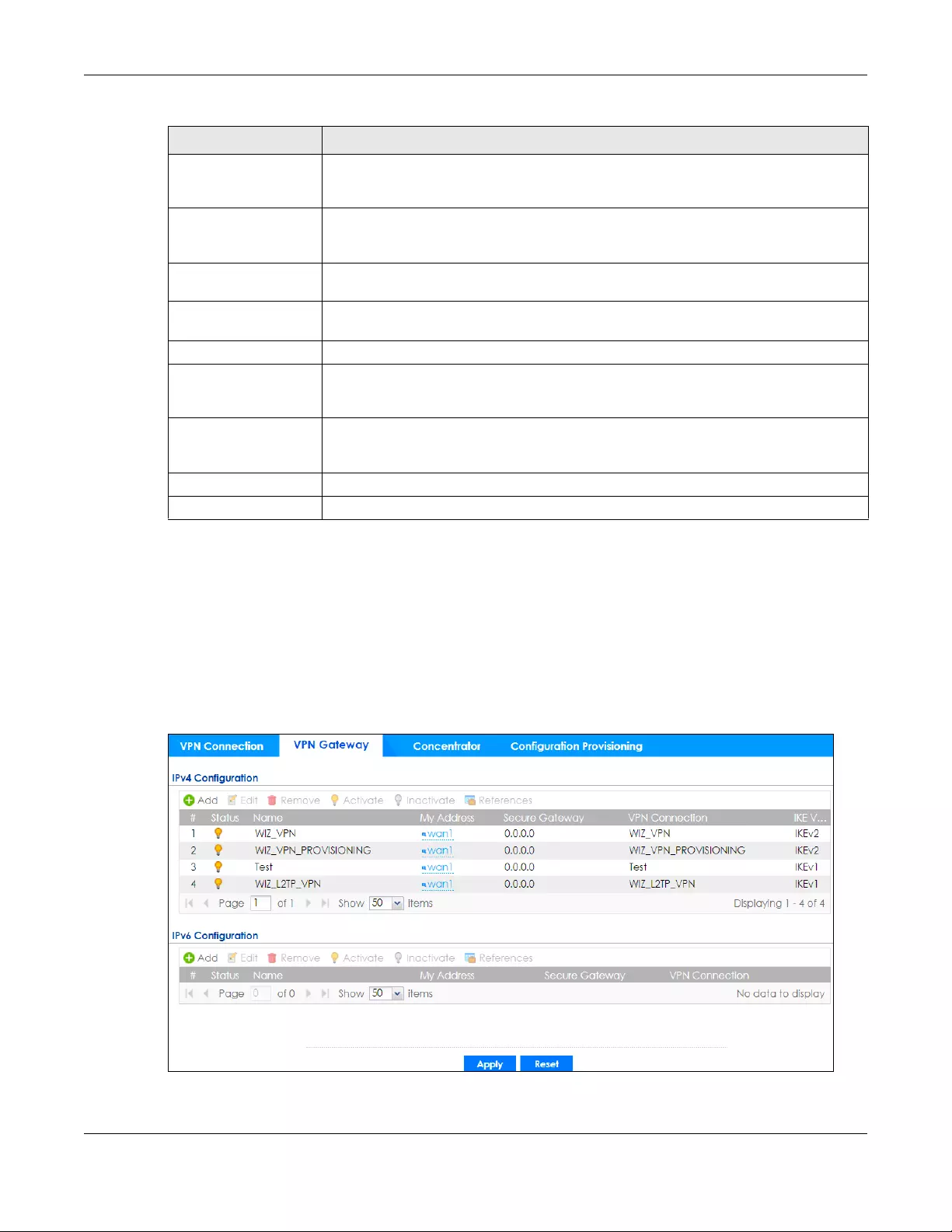
Chapter 19 IPSec VPN
ZyWALL USG FLEX Series User’s Guide
432
19.3 The VPN Gateway Screen
The VPN Gateway summary screen displays the IPSec VPN gateway policies in the Zyxel Device, as well
as the Zyxel Device’s address, remote IPSec router’s address, and associated VPN connections for each
one. In addition, it also lets you activate and deactivate each VPN gateway. To access this screen, click
Configuration > VPN > Network > IPSec VPN > VPN Gateway. The following screen appears.
Figure 300 Configuration > VPN > IPSec VPN > VPN Gateway
Move To change an entry’s position in the numbered list, select it and click Move to display a
field to type a number for where you want to put that entry and press [ENTER] to move
the entry to the number that you typed.
#This field is a sequential value, and it is not associated with a specific NAT record.
However, the order of records is the sequence in which conditions are checked and
executed.
Original IP Select the address object that represents the original destination address. This is the
address object for the remote network.
Mapped IP Select the address object that represents the desired destination address. For example,
this is the address object for the mail server.
Protocol Select the protocol required to use this translation. Choices are: TCP, UDP, or All.
Original Port Start /
Original Port End These fields are available if the protocol is TCP or UDP. Enter the original destination port or
range of original destination ports. The size of the original port range must be the same
size as the size of the mapped port range.
Mapped Port Start /
Mapped Port End These fields are available if the protocol is TCP or UDP. Enter the translated destination
port or range of translated destination ports. The size of the original port range must be
the same size as the size of the mapped port range.
OK Click OK to save the changes.
Cancel Click Cancel to discard all changes and return to the main VPN screen.
Table 168 Configuration > VPN > IPSec VPN > VPN Connection > Add/Edit (continued)
LABEL DESCRIPTION

Chapter 19 IPSec VPN
ZyWALL USG FLEX Series User’s Guide
433
Each field is discussed in the following table. See Section 19.3.1 on page 433 for more information.
19.3.1 The VPN Gateway Add/Edit Screen
The VPN Gateway Add/Edit screen allows you to create a new VPN gateway policy or edit an existing
one. To access this screen, go to the VPN Gateway summary screen (see Section 19.3 on page 432),
and click either the Add icon or an Edit icon.
Table 169 Configuration > VPN > IPSec VPN > VPN Gateway
LABEL DESCRIPTION
Add Click this to create a new entry.
Edit Double-click an entry or select it and click Edit to open a screen where you can modify the
entry’s settings.
Remove To remove an entry, select it and click Remove. The Zyxel Device confirms you want to
remove it before doing so.
Activate To turn on an entry, select it and click Activate.
Inactivate To turn off an entry, select it and click Inactivate.
References Select an entry and click References to open a screen that shows which settings use the
entry. See Section 9.4.4 on page 255 for an example.
#This field is a sequential value, and it is not associated with a specific VPN gateway.
Status The activate (light bulb) icon is lit when the entry is active and dimmed when the entry is
inactive.
Name This field displays the name of the VPN gateway
My address This field displays the interface or a domain name the Zyxel Device uses for the VPN gateway.
Secure Gateway This field displays the IP address(es) of the remote IPSec routers.
VPN Connection This field displays VPN connections that use this VPN gateway.
IKE Version This field displays whether the gateway is using IKEv1 or IKEv2. IKEv1 applies to IPv4 traffic only.
IKEv2 applies to both IPv4 and IPv6 traffic. IKE (Internet Key Exchange) is a protocol used in
setting up security associations that allows two parties to send data securely. See Section 19.1
on page 418 for more information on IKEv1 and IKEv2.
Apply Click Apply to save your changes back to the Zyxel Device.
Reset Click Reset to return the screen to its last-saved settings.

Chapter 19 IPSec VPN
ZyWALL USG FLEX Series User’s Guide
434
Figure 301 Configuration > VPN > IPSec VPN > VPN Gateway > Add/Edit

Chapter 19 IPSec VPN
ZyWALL USG FLEX Series User’s Guide
435
Each field is described in the following table.
Table 170 Configuration > VPN > IPSec VPN > VPN Gateway > Add/Edit
LABEL DESCRIPTION
Show Advanced
Settings / Hide
Advanced Settings
Click this button to display a greater or lesser number of configuration fields.
Create New Object Use to configure any new settings objects that you need to use in this screen.
General Settings
Enable Select this to activate the VPN Gateway policy.
VPN Gateway
Name Type the name used to identify this VPN gateway. You may use 1-31 alphanumeric
characters, underscores(_), or dashes (-), but the first character cannot be a number. This
value is case-sensitive.
IKE Version
IKEv1 / IKEv2 Select IKEv1 or IKEv2. IKEv1 applies to IPv4 traffic only. IKEv2 applies to both IPv4 and IPv6
traffic. IKE (Internet Key Exchange) is a protocol used in setting up security associations that
allows two parties to send data securely. See Section 19.1 on page 418 for more information
on IKEv1 and IKEv2.
Gateway Settings
My Address Select how the IP address of the Zyxel Device in the IKE SA is defined.
If you select Interface, select the Ethernet interface, VLAN interface, virtual Ethernet
interface, virtual VLAN interface or PPPoE/PPTP interface. The IP address of the Zyxel Device
in the IKE SA is the IP address of the interface.
If you select Domain Name / IP, enter the domain name or the IP address of the Zyxel
Device. The IP address of the Zyxel Device in the IKE SA is the specified IP address or the IP
address corresponding to the domain name. 0.0.0.0 is not generally recommended as it
has the Zyxel Device accept IPSec requests destined for any interface address on the Zyxel
Device.
Peer Gateway
Address Select how the IP address of the remote IPSec router in the IKE SA is defined.
Select Static Address to enter the domain name or the IP address of the remote IPSec
router. You can provide a second IP address or domain name for the Zyxel Device to try if it
cannot establish an IKE SA with the first one.
Fall back to Primary Peer Gateway when possible: When you select this, if the
connection to the primary address goes down and the Zyxel Device changes to using
the secondary connection, the Zyxel Device will reconnect to the primary address
when it becomes available again and stop using the secondary connection. Users will
lose their VPN connection briefly while the Zyxel Device changes back to the primary
connection. To use this, the peer device at the secondary address cannot be set to use
a nailed-up VPN connection. In the Fallback Check Interval field, set how often to
check if the primary address is available.
Select Dynamic Address if the remote IPSec router has a dynamic IP address (and does not
use DDNS).
Authentication Note: The Zyxel Device and remote IPSec router must use the same
authentication method to establish the IKE SA.

Chapter 19 IPSec VPN
ZyWALL USG FLEX Series User’s Guide
436
Pre-Shared Key Select this to have the Zyxel Device and remote IPSec router use a pre-shared key
(password) of up to 128 characters to identify each other when they negotiate the IKE SA.
Type the pre-shared key in the field to the right. The pre-shared key can be:
• alphanumeric characters or ,;.|`~!@#$%^&*()_+\{}':./<>=-"
• pairs of hexadecimal (0-9, A-F) characters, preceded by “0x”.
Type “0x” at the beginning of a hexadecimal key. For example, "0x0123456789ABCDEF" is in
hexadecimal format; “0123456789ABCDEF” is in ASCII format. If you use hexadecimal, you
must enter twice as many characters since you need to enter pairs.
The Zyxel Device and remote IPSec router must use the same pre-shared key.
Select unmasked to see the pre-shared key in readable plain text.
Certificate Select this to have the Zyxel Device and remote IPSec router use certificates to
authenticate each other when they negotiate the IKE SA. Then select the certificate the
Zyxel Device uses to identify itself to the remote IPSec router.
This certificate is one of the certificates in My Certificates. If this certificate is self-signed,
import it into the remote IPsec router. If this certificate is signed by a CA, the remote IPsec
router must trust that CA.
Note: The IPSec routers must trust each other’s certificates.
The Zyxel Device uses one of its Trusted Certificates to authenticate the remote IPSec
router’s certificate. The trusted certificate can be a self-signed certificate or that of a
trusted CA that signed the remote IPSec router’s certificate.
User-based PSK User-based PSK (IKEv1 only) generates and manages separate pre-shared keys for every
user. This enables multiple users, each with a unique key, to access the same VPN gateway
policy with one-to-one authentication and strong encryption. Access can be denied on a
per-user basis thus allowing VPN SA user-based policies. Click User-Based PSK then select a
user or group object who is allowed VPN SA access using this VPN gateway policy. This is for
IKEv1 only.
Local ID Type This field is read-only if the Zyxel Device and remote IPSec router use certificates to identify
each other. Select which type of identification is used to identify the Zyxel Device during
authentication. Choices are:
IPv4 or IPv6 - the Zyxel Device is identified by an IP address
DNS - the Zyxel Device is identified by a domain name
E-mail - the Zyxel Device is identified by the string specified in this field
Content This field is read-only if the Zyxel Device and remote IPSec router use certificates to identify
each other. Type the identity of the Zyxel Device during authentication. The identity
depends on the Local ID Type.
IP - type an IP address; if you type 0.0.0.0, the Zyxel Device uses the IP address specified in
the My Address field. This is not recommended in the following situations:
• There is a NAT router between the Zyxel Device and remote IPSec router.
• You want the remote IPSec router to be able to distinguish between IPSec SA requests
that come from IPSec routers with dynamic WAN IP addresses.
In these situations, use a different IP address, or use a different Local ID Type.
DNS - type the fully qualified domain name (FQDN). This value is only used for identification
and can be any string that matches the peer ID string.
E-mail - the Zyxel Device is identified by the string you specify here; you can use up to 63
ASCII characters including spaces, although trailing spaces are truncated. This value is only
used for identification and can be any string.
Table 170 Configuration > VPN > IPSec VPN > VPN Gateway > Add/Edit (continued)
LABEL DESCRIPTION

Chapter 19 IPSec VPN
ZyWALL USG FLEX Series User’s Guide
437
Peer ID Type Select which type of identification is used to identify the remote IPSec router during
authentication. Choices are:
IP - the remote IPSec router is identified by an IP address
DNS - the remote IPSec router is identified by a domain name
E-mail - the remote IPSec router is identified by the string specified in this field
Any - the Zyxel Device does not check the identity of the remote IPSec router
If the Zyxel Device and remote IPSec router use certificates, there is one more choice.
Subject Name - the remote IPSec router is identified by the subject name in the certificate
Content This field is disabled if the Peer ID Type is Any. Type the identity of the remote IPSec router
during authentication. The identity depends on the Peer ID Type.
If the Zyxel Device and remote IPSec router do not use certificates,
IP - type an IP address; see the note at the end of this description.
DNS - type the fully qualified domain name (FQDN). This value is only used for identification
and can be any string that matches the peer ID string.
E-mail - the remote IPSec router is identified by the string you specify here; you can use up
to 31 ASCII characters including spaces, although trailing spaces are truncated. This value is
only used for identification and can be any string.
If the Zyxel Device and remote IPSec router use certificates, type the following fields from
the certificate used by the remote IPSec router.
IP - subject alternative name field; see the note at the end of this description.
DNS - subject alternative name field
E-mail - subject alternative name field
Subject Name - subject name (maximum 255 ASCII characters, including spaces)
Note: If Peer ID Type is IP, please read the rest of this section.
If you type 0.0.0.0, the Zyxel Device uses the IP address specified in the Secure Gateway
Address field. This is not recommended in the following situations:
• There is a NAT router between the Zyxel Device and remote IPSec router.
• You want the remote IPSec router to be able to distinguish between IPSec SA requests
that come from IPSec routers with dynamic WAN IP addresses.
In these situations, use a different IP address, or use a different Peer ID Type.
Phase 1 Settings
SA Life Time
(Seconds) Type the maximum number of seconds the IKE SA can last. When this time has passed, the
Zyxel Device and remote IPSec router have to update the encryption and authentication
keys and re-negotiate the IKE SA. This does not affect any existing IPSec SAs, however.
Negotiation
Mode Select the negotiation mode to use to negotiate the IKE SA. Choices are
Main - this encrypts the Zyxel Device’s and remote IPSec router’s identities but takes more
time to establish the IKE SA
Aggressive - this is faster but does not encrypt the identities
The Zyxel Device and the remote IPSec router must use the same negotiation mode.
Proposal Use this section to manage the encryption algorithm and authentication algorithm pairs the
Zyxel Device accepts from the remote IPSec router for negotiating the IKE SA.
Add Click this to create a new entry.
Table 170 Configuration > VPN > IPSec VPN > VPN Gateway > Add/Edit (continued)
LABEL DESCRIPTION

Chapter 19 IPSec VPN
ZyWALL USG FLEX Series User’s Guide
438
Edit Select an entry and click this to be able to modify it.
Remove Select an entry and click this to delete it.
#This field is a sequential value, and it is not associated with a specific proposal. The
sequence of proposals should not affect performance significantly.
Encryption Select which key size and encryption algorithm to use in the IKE SA. Choices are:
DES - a 56-bit key with the DES encryption algorithm
3DES - a 168-bit key with the DES encryption algorithm
AES128 - a 128-bit key with the AES encryption algorithm
AES192 - a 192-bit key with the AES encryption algorithm
AES256 - a 256-bit key with the AES encryption algorithm
The Zyxel Device and the remote IPSec router must use the same key size and encryption
algorithm. Longer keys require more processing power, resulting in increased latency and
decreased throughput.
Authentication Select which hash algorithm to use to authenticate packet data in the IPSec SA. Choices
are SHA1, SHA256, SHA512 and MD5. SHA is generally considered stronger than MD5, but it is
also slower.
The remote IPSec router must use the same authentication algorithm.
Key Group Select which Diffie-Hellman key group (DHx) you want to use for encryption keys. Choices
are:
DH1 - use a 768-bit random number
DH2 - use a 1024-bit random number
DH5 - use a 1536-bit random number
DH14 - use a 2048 bit random number
The longer the key, the more secure the encryption, but also the longer it takes to encrypt
and decrypt information. Both routers must use the same DH key group.
NAT Traversal Select this if any of these conditions are satisfied.
• This IKE SA might be used to negotiate IPSec SAs that use ESP as the active protocol.
• There are one or more NAT routers between the Zyxel Device and remote IPSec router,
and these routers do not support IPSec pass-thru or a similar feature.
The remote IPSec router must also enable NAT traversal, and the NAT routers have to
forward packets with UDP port 500 and UDP 4500 headers unchanged.
This field applies for IKEv1 only. NAT Traversal is always performed when you use IKEv2.
Dead Peer
Detection (DPD) Select this check box if you want the Zyxel Device to make sure the remote IPSec router is
there before it transmits data through the IKE SA. The remote IPSec router must support DPD.
If there has been no traffic for at least 15 seconds, the Zyxel Device sends a message to the
remote IPSec router. If the remote IPSec router responds, the Zyxel Device transmits the
data. If the remote IPSec router does not respond, the Zyxel Device shuts down the IKE SA.
If the remote IPSec router does not support DPD, see if you can use the VPN connection
connectivity check (see Section 19.2.1 on page 425).
This field applies for IKEv1 only. Dead Peer Detection (DPD) is always performed when you
use IKEv2.
X Auth / Extended
Authentication
Protocol
This part of the screen displays X-Auth when using IKEv1 and Extended Authentication
Protocol when using IKEv2.
Table 170 Configuration > VPN > IPSec VPN > VPN Gateway > Add/Edit (continued)
LABEL DESCRIPTION

Chapter 19 IPSec VPN
ZyWALL USG FLEX Series User’s Guide
439
X-Auth This displays when using IKEv1. When different users use the same VPN tunnel to connect to
the Zyxel Device (telecommuters sharing a tunnel for example), use X-auth to enforce a
user name and password check. This way even though telecommuters all know the VPN
tunnel’s security settings, each still has to provide a unique user name and password.
Enable Extended
Authentication Select this if one of the routers (the Zyxel Device or the remote IPSec router) verifies a user
name and password from the other router using the local user database and/or an external
server.
Server Mode Select this if the Zyxel Device authenticates the user name and password from the remote
IPSec router. You also have to select the authentication method, which specifies how the
Zyxel Device authenticates this information.
AAA Method Select the authentication method, which specifies how the Zyxel Device authenticates this
information.
Allowed User Extended authentication now supports an allowed user. Select what users should be
authenticated.
Client Mode Select this radio button if the Zyxel Device provides a username and password to the
remote IPSec router for authentication. You also have to provide the User Name and the
Password.
User Name This field is required if the Zyxel Device is in Client Mode for extended authentication. Type
the user name the Zyxel Device sends to the remote IPSec router. The user name can be 1-
31 ASCII characters. It is case-sensitive, but spaces are not allowed.
Password This field is required if the Zyxel Device is in Client Mode for extended authentication. Type
the password the Zyxel Device sends to the remote IPSec router. The password can be 1-31
ASCII characters. It is case-sensitive, but spaces are not allowed.
Retype to
Confirm Type the exact same password again here to make sure an error was not made when
typing it originally.
Extended
Authentication
Protocol
This displays when using IKEv2. EAP uses a certificate for authentication.
Enable Extended
Authentication
Protocol
Select this if one of the routers (the Zyxel Device or the remote IPSec router) verifies a user
name and password from the other router using the local user database and/or an external
server or a certificate.
Allowed Auth
Method This field displays the authentication method that is used to authenticate the users.
Server Mode Select this if the Zyxel Device authenticates the user name and password from the remote
IPSec router. You also have to select an AAA method, which specifies how the Zyxel Device
authenticates this information and who may be authenticated (Allowed User).
Client Mode Select this radio button if the Zyxel Device provides a username and password to the
remote IPSec router for authentication. You also have to provide the User Name and the
Password.
User Name This field is required if the Zyxel Device is in Client Mode for extended authentication. Type
the user name the Zyxel Device sends to the remote IPSec router. The user name can be 1-
31 ASCII characters. It is case-sensitive, but spaces are not allowed.
Password This field is required if the Zyxel Device is in Client Mode for extended authentication. Type
the password the Zyxel Device sends to the remote IPSec router. The password can be 1-31
ASCII characters. It is case-sensitive, but spaces are not allowed.
Retype to
Confirm Type the exact same password again here to make sure an error was not made when
typing it originally.
OK Click OK to save your settings and exit this screen.
Cancel Click Cancel to exit this screen without saving.
Table 170 Configuration > VPN > IPSec VPN > VPN Gateway > Add/Edit (continued)
LABEL DESCRIPTION

Chapter 19 IPSec VPN
ZyWALL USG FLEX Series User’s Guide
440
19.4 VPN Concentrator
A VPN concentrator combines several IPSec VPN connections into one secure network.
Figure 302 VPN Topologies (Fully Meshed and Hub and Spoke)
In a fully-meshed VPN topology (1 in the figure), there is a VPN connection between every pair of
routers. In a hub-and-spoke VPN topology (2 in the figure), there is a VPN connection between each
spoke router (B, C, D, and E) and the hub router (A), which uses the VPN concentrator. The VPN
concentrator routes VPN traffic between the spoke routers and itself.
A VPN concentrator reduces the number of VPN connections that you have to set up and maintain on
the network. You might also be able to consolidate the policy routes in each spoke router, depending
on the IP addresses and subnets of each spoke.
However a VPN concentrator is not for every situation. The hub router is a single failure point, so a VPN
concentrator is not as appropriate if the connection between spoke routers cannot be down
occasionally (maintenance, for example). There is also more burden on the hub router. It receives VPN
traffic from one spoke, decrypts it, inspects it to find out to which spoke to route it, encrypts it, and sends
it to the appropriate spoke. Therefore, a VPN concentrator is more suitable when there is a minimum
amount of traffic between spoke routers.
19.4.1 VPN Concentrator Requirements and Suggestions
Consider the following when using the VPN concentrator.
• The local IP addresses configured in the VPN rules should not overlap.
• The concentrator must have at least one separate VPN rule for each spoke. In the local policy,
specify the IP addresses of the networks with which the spoke is to be able to have a VPN tunnel. This
may require you to use more than one VPN rule for each spoke.
• To have all Internet access from the spoke routers go through the VPN tunnel, set the VPN rules in the
spoke routers to use 0.0.0.0 (any) as the remote IP address.
• Your security policies can still block VPN packets.
12
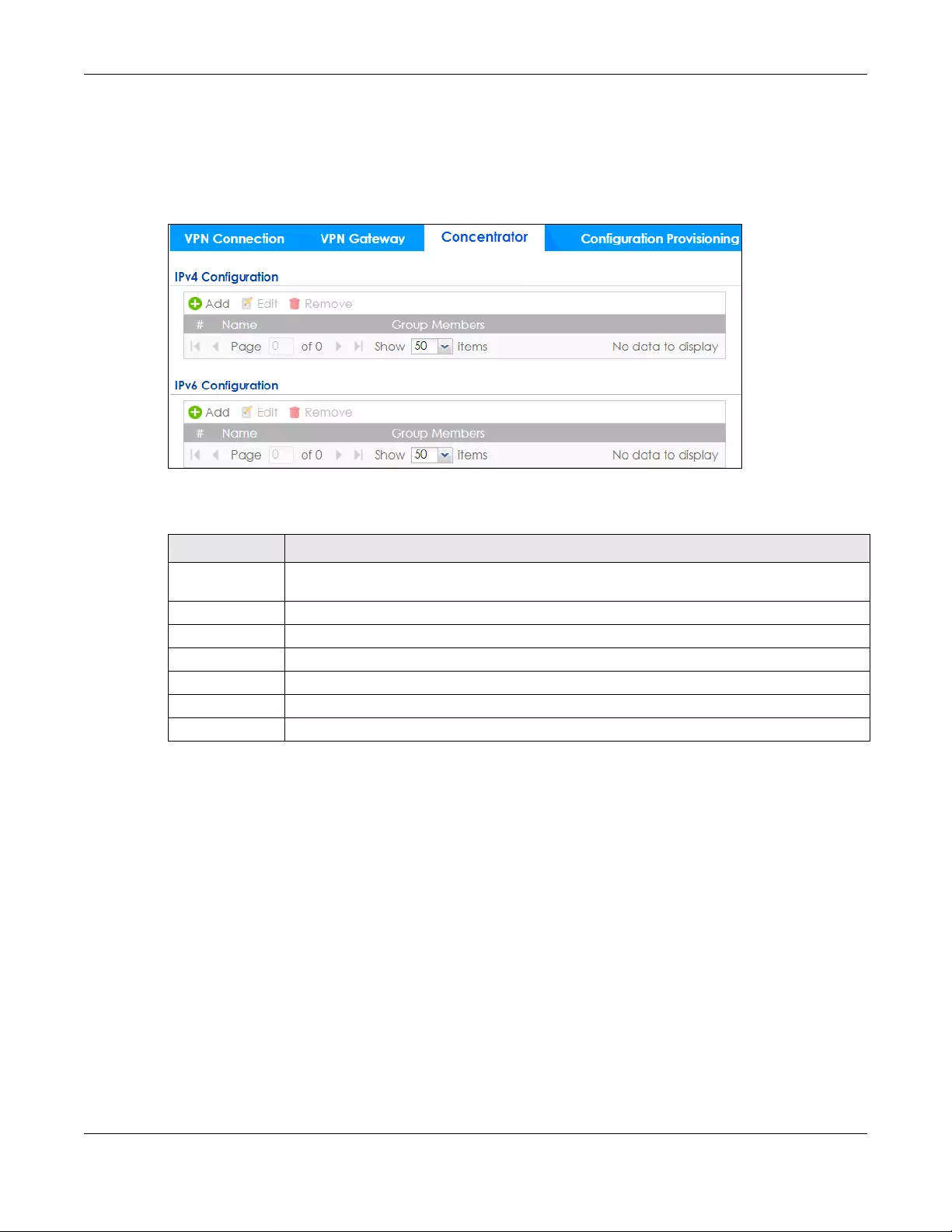
Chapter 19 IPSec VPN
ZyWALL USG FLEX Series User’s Guide
441
19.4.2 VPN Concentrator Screen
The VPN Concentrator summary screen displays the VPN concentrators in the Zyxel Device. To access
this screen, click Configuration > VPN > IPSec VPN > Concentrator.
Figure 303 Configuration > VPN > IPSec VPN > Concentrator
Each field is discussed in the following table. See Section 19.4.3 on page 441 for more information.
19.4.3 The VPN Concentrator Add/Edit Screen
Use the VPN Concentrator Add/Edit screen to create or edit a VPN concentrator. To access this screen,
go to the VPN Concentrator summary screen (see Section 19.4 on page 440), and click either the Add
icon or an Edit icon.
Table 171 Configuration > VPN > IPSec VPN > Concentrator
LABEL DESCRIPTION
IPv4/IPv6
Configuration
Choose to configure for IPv4 or IPv6 traffic.
Add Click this to create a new entry.
Edit Select an entry and click this to be able to modify it.
Remove Select an entry and click this to delete it.
#This field is a sequential value, and it is not associated with a specific concentrator.
Name This field displays the name of the VPN concentrator.
Group Members These are the VPN connection policies that are part of the VPN concentrator.

Chapter 19 IPSec VPN
ZyWALL USG FLEX Series User’s Guide
442
Figure 304 Configuration > VPN > IPSec VPN > Concentrator > Add/Edit
Each field is described in the following table.
19.5 Zyxel Device IPSec VPN Client Configuration
Provisioning
Use the Configuration > VPN > IPSec VPN > Configuration Provisioning screen to configure who can
retrieve VPN rule settings from the Zyxel Device using the Zyxel Device IPSec VPN Client. In the Zyxel
Device IPSec VPN Client, you just need to enter the IP address of the Zyxel Device to get all the VPN rule
settings automatically. You do not need to manually configure all rule settings in the Zyxel Device IPSec
VPN client.
VPN rules for the Zyxel Device IPSec VPN Client have certain restrictions. They must not contain the
following settings:
•AH active protocol
•NULL encryption
•SHA512 authentication
Table 172 VPN > IPSec VPN > Concentrator > Add/Edit
LABEL DESCRIPTION
Name Enter the name of the concentrator. You may use 1-31 alphanumeric characters, underscores(_), or
dashes (-), but the first character cannot be a number. This value is case-sensitive.
Member Select the concentrator’s IPSec VPN connection policies.
Note: You must disable policy enforcement in each member. See Section 19.2.1 on page
425.
IPSec VPN connection policies that do not belong to a VPN concentrator appear under Available.
Select any VPN connection policies that you want to add to the VPN concentrator and click the right
arrow button to add them.
The VPN concentrator’s member VPN connections appear under Member. Select any VPN
connections that you want to remove from the VPN concentrator, and click the left arrow button to
remove them.
OK Click OK to save your changes in the Zyxel Device.
Cancel Click Cancel to exit this screen without saving.

Chapter 19 IPSec VPN
ZyWALL USG FLEX Series User’s Guide
443
• A subnet or range remote policy
The following VPN Gateway rules configured on the Zyxel Device cannot be provisioned to the IPSec
VPN Client:
• IPv4 rules with IKEv2 version
• IPv4 rules with User-based PSK authentication
Note: You must enable IPv6 in System > IPv6 to activate IPv6 VPN tunneling rules.
In the Zyxel Device Quick Setup wizard, you can use the VPN Settings for Configuration Provisioning
wizard to create a VPN rule that will not violate these restrictions.
Figure 305 Configuration > VPN > IPSec VPN > Configuration Provisioning
Each field is discussed in the following table.
Table 173 Configuration > VPN > IPSec VPN > Configuration Provisioning
LABEL DESCRIPTION
Enable
Configuration
Provisioning
Select this for users to be able to retrieve VPN rule settings using the Zyxel Device IPSec VPN
client.
Client
Authentication
Method
Choose how users should be authenticated. They can be authenticated using the local
database on the Zyxel Device or an external authentication database such as LDAP, Active
Directory or RADIUS. default is a method you configured in Object > Auth Method. You may
configure multiple methods there. If you choose the local database on the Zyxel Device, then
configure users using the Object > User/Group screen. If you choose LDAP, Active Directory or
RADIUS authentication servers, then configure users on the respective server.
Configuration When you add or edit a configuration provisioning entry, you are allowed to set the VPN
Connection and Allowed User fields.
Duplicate entries are not allowed. You cannot select the same VPN Connection and Allowed
User pair in a new entry if the same pair exists in a previous entry.
You can bind different rules to the same user, but the Zyxel Device will only allow VPN rule setting
retrieval for the first match found.

Chapter 19 IPSec VPN
ZyWALL USG FLEX Series User’s Guide
444
19.6 IPSec VPN Background Information
Here is some more detailed IPSec VPN background information.
IKE SA Overview
The IKE SA provides a secure connection between the Zyxel Device and remote IPSec router.
It takes several steps to establish an IKE SA. The negotiation mode determines how many. There are two
negotiation modes--main mode and aggressive mode. Main mode provides better security, while
aggressive mode is faster.
Add Click Add to bind a configured VPN rule to a user or group. Only that user or group may then
retrieve the specified VPN rule settings.
If you click Add without selecting an entry in advance then the new entry appears as the first
entry. Entry order is important as the Zyxel Device searches entries in the order listed here to find
a match. After a match is found, the Zyxel Device stops searching. If you want to add an entry
as number three for example, then first select entry 2 and click Add. To reorder an entry, use
Move.
Edit Select an existing entry and click Edit to change its settings.
Remove To remove an entry, select it and click Remove. The Zyxel Device confirms you want to remove it
before doing so.
Activate To turn on an entry, select it and click Activate. Make sure that Enable Configuration Provisioning
is also selected.
Inactivate To turn off an entry, select it and click Inactivate.
Move Use Move to reorder a selected entry. Select an entry, click Move, type the number where the
entry should be moved, press <ENTER>, then click Apply.
Status This icon shows if the entry is active (yellow) or not (gray). VPN rule settings can only be retrieved
when the entry is activated (and Enable Configuration Provisioning is also selected).
Priority Priority shows the order of the entry in the list. Entry order is important as the Zyxel Device
searches entries in the order listed here to find a match. After a match is found the Zyxel Device
stops searching.
VPN
Connection
This field shows all configured VPN rules that match the rule criteria for the Zyxel Device IPSec
VPN client. Select a rule to bind to the associated user or group.
Allowed User Select which user or group of users is allowed to retrieve the associated VPN rule settings using
the Zyxel Device IPSec VPN client. A user may belong to a number of groups. If entries are
configured for different groups, the Zyxel Device will allow VPN rule setting retrieval based on the
first match found.
Users of type admin or limited-admin are not allowed.
Type This field shows how traffic is tunneled from the Zyxel Device to the Zyxel VPN client:
•6in4 (tunnel IPv6 traffic from the Zyxel Device to the Zyxel client in an IPv4 network);
•4in6 (tunnel IPv4 traffic from the Zyxel Device to the Zyxel VPN client in an IPv6 network);
•4in4 (tunnel IPv4 traffic from the Zyxel Device to the Zyxel VPN client in an IPv4 network).
Apply Click Apply to save your changes back to the Zyxel Device.
Reset Click Reset to return the screen to its last-saved settings.
Table 173 Configuration > VPN > IPSec VPN > Configuration Provisioning (continued)
LABEL DESCRIPTION

Chapter 19 IPSec VPN
ZyWALL USG FLEX Series User’s Guide
445
Note: Both routers must use the same negotiation mode.
These modes are discussed in more detail in Negotiation Mode. Main mode is used in various examples
in the rest of this section.
The Zyxel Device supports IKEv1 and IKEv2. See Section 19.1 on page 418 for more information.
IP Addresses of the Zyxel Device and Remote IPSec Router
To set up an IKE SA, you have to specify the IP addresses of the Zyxel Device and remote IPSec router.
You can usually enter a static IP address or a domain name for either or both IP addresses. Sometimes,
your Zyxel Device might offer another alternative, such as using the IP address of a port or interface, as
well.
You can also specify the IP address of the remote IPSec router as 0.0.0.0. This means that the remote
IPSec router can have any IP address. In this case, only the remote IPSec router can initiate an IKE SA
because the Zyxel Device does not know the IP address of the remote IPSec router. This is often used for
telecommuters.
IKE SA Proposal
The IKE SA proposal is used to identify the encryption algorithm, authentication algorithm, and Diffie-
Hellman (DH) key group that the Zyxel Device and remote IPSec router use in the IKE SA. In main mode,
this is done in steps 1 and 2, as illustrated next.
Figure 306 IKE SA: Main Negotiation Mode, Steps 1 - 2: IKE SA Proposal
The Zyxel Device sends one or more proposals to the remote IPSec router. (In some devices, you can
only set up one proposal.) Each proposal consists of an encryption algorithm, authentication algorithm,
and DH key group that the Zyxel Device wants to use in the IKE SA. The remote IPSec router selects an
acceptable proposal and sends the accepted proposal back to the Zyxel Device. If the remote IPSec
router rejects all of the proposals, the Zyxel Device and remote IPSec router cannot establish an IKE SA.
Note: Both routers must use the same encryption algorithm, authentication algorithm, and DH
key group.
In most Zyxel Devices, you can select one of the following encryption algorithms for each proposal. The
algorithms are listed in order from weakest to strongest.
• Data Encryption Standard (DES) is a widely used method of data encryption. It applies a 56-bit key to
each 64-bit block of data.
One or more proposals, each one consisting of:
- encryption algorithm
- authentication algorithm
- Diffie-Hellman key group
1
2
XY

Chapter 19 IPSec VPN
ZyWALL USG FLEX Series User’s Guide
446
• Triple DES (3DES) is a variant of DES. It iterates three times with three separate keys, effectively tripling
the strength of DES.
• Advanced Encryption Standard (AES) is a newer method of data encryption that also uses a secret
key. AES applies a 128-bit key to 128-bit blocks of data. It is faster than 3DES.
Some Zyxel Devices also offer stronger forms of AES that apply 192-bit or 256-bit keys to 128-bit blocks of
data.
In most Zyxel Devices, you can select one of the following authentication algorithms for each proposal.
The algorithms are listed in order from weakest to strongest.
• MD5 (Message Digest 5) produces a 128-bit digest to authenticate packet data.
• SHA1 (Secure Hash Algorithm) produces a 160-bit digest to authenticate packet data.
• SHA256 (Secure Hash Algorithm) produces a 256-bit digest to authenticate packet data.
• SHA512 (Secure Hash Algorithm) produces a 512-bit digest to authenticate packet data.
See Diffie-Hellman (DH) Key Exchange on page 446 for more information about DH key groups.
Diffie-Hellman (DH) Key Exchange
The Zyxel Device and the remote IPSec router use DH public-key cryptography to establish a shared
secret. The shared secret is then used to generate encryption keys for the IKE SA and IPSec SA. In main
mode, this is done in steps 3 and 4, as illustrated next.
Figure 307 IKE SA: Main Negotiation Mode, Steps 3 - 4: DH Key Exchange
DH public-key cryptography is based on DH key groups. Each key group is a fixed number of bits long.
The longer the key, the more secure the encryption, but also the longer it takes to encrypt and decrypt
information. For example, DH2 keys (1024 bits) are more secure than DH1 keys (768 bits), but DH2 keys
take longer to encrypt and decrypt.
Authentication
Before the Zyxel Device and remote IPSec router establish an IKE SA, they have to verify each other’s
identity. This process is based on pre-shared keys and router identities.
In main mode, the Zyxel Device and remote IPSec router authenticate each other in steps 5 and 6, as
illustrated below. The identities are also encrypted using the encryption algorithm and encryption key
the Zyxel Device and remote IPSec router selected in previous steps.
Diffie-Hellman key exchange
3
4
XY
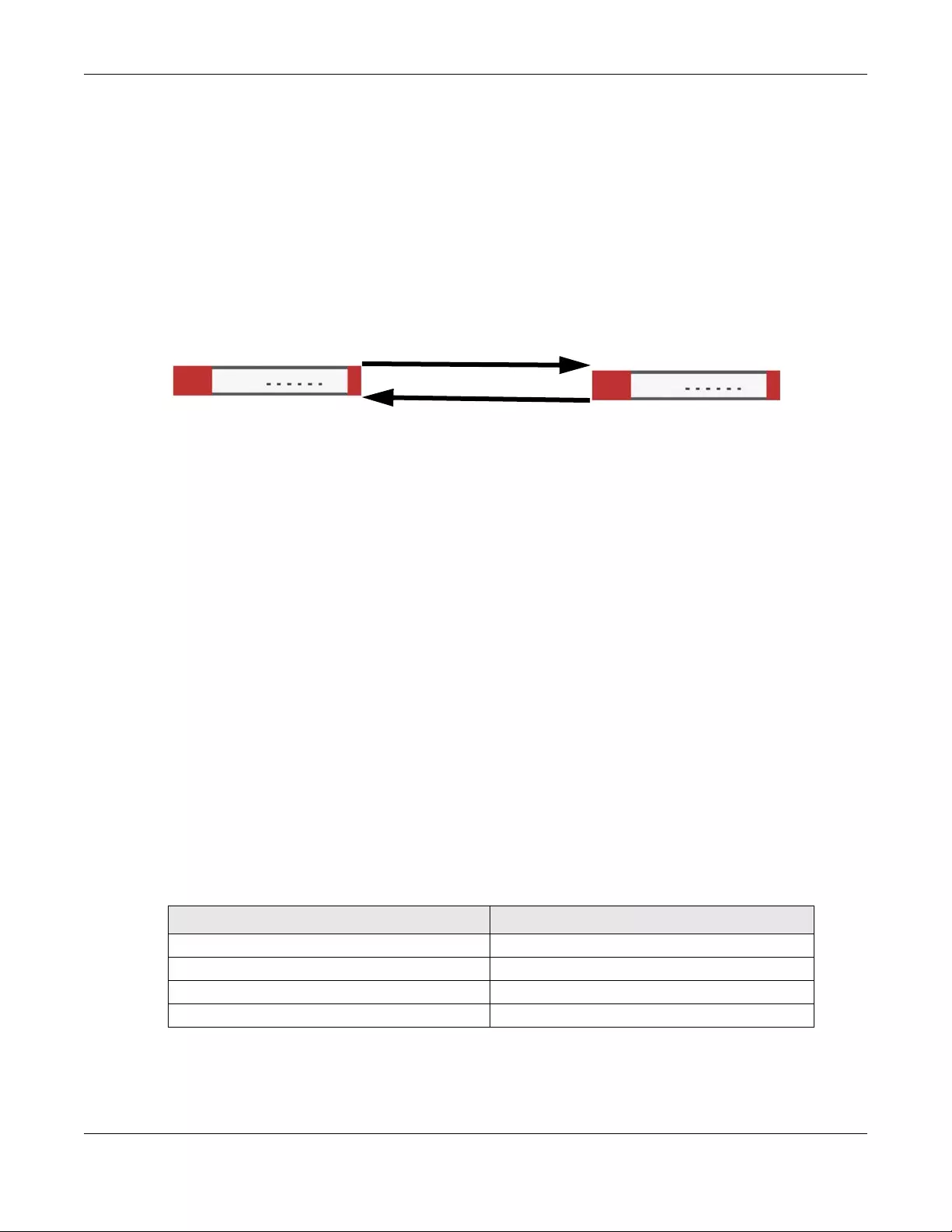
Chapter 19 IPSec VPN
ZyWALL USG FLEX Series User’s Guide
447
Figure 308 IKE SA: Main Negotiation Mode, Steps 5 - 6: Authentication (continued)
You have to create (and distribute) a pre-shared key. The Zyxel Device and remote IPSec router use it in
the authentication process, though it is not actually transmitted or exchanged.
Note: The Zyxel Device and the remote IPSec router must use the same pre-shared key.
Router identity consists of ID type and content. The ID type can be domain name, IP address, or email
address, and the content is a (properly-formatted) domain name, IP address, or email address. The
content is only used for identification. Any domain name or email address that you enter does not have
to actually exist. Similarly, any domain name or IP address that you enter does not have to correspond
to the Zyxel Device’s or remote IPSec router’s properties.
The Zyxel Device and the remote IPSec router have their own identities, so both of them must store two
sets of information, one for themselves and one for the other router. Local ID type and content refers to
the ID type and content that applies to the router itself, and peer ID type and content refers to the ID
type and content that applies to the other router.
Note: The Zyxel Device’s local and peer ID type and content must match the remote IPSec
router’s peer and local ID type and content, respectively.
For example, in the next table, the Zyxel Device and the remote IPSec router authenticate each other
successfully. In contrast, in the following table, the Zyxel Device and the remote IPSec router cannot
authenticate each other and, therefore, cannot establish an IKE SA.
Step 5:
pre-shared key
Zyxel Device identity, consisting of
- ID type
- content
Step 6:
pre-shared key
Remote IPSec router identity, consisting of
- ID type
- content
Table 174 VPN Example: Matching ID Type and Content
ZYXEL DEVICE REMOTE IPSEC ROUTER
Local ID type: E-mail Local ID type: IP
Local ID content: tom@yourcompany.com Local ID content: 1.1.1.2
Peer ID type: IP Peer ID type: E-mail
Peer ID content: 1.1.1.2 Peer ID content: tom@yourcompany.com
5
6
XY

Chapter 19 IPSec VPN
ZyWALL USG FLEX Series User’s Guide
448
It is also possible to configure the Zyxel Device to ignore the identity of the remote IPSec router. In this
case, you usually set the peer ID type to Any. This is less secure, so you should only use this if your Zyxel
Device provides another way to check the identity of the remote IPSec router (for example, extended
authentication) or if you are troubleshooting a VPN tunnel.
Additional Topics for IKE SA
This section provides more information about IKE SA.
Negotiation Mode
There are two negotiation modes--main mode and aggressive mode. Main mode provides better
security, while aggressive mode is faster.
Main mode takes six steps to establish an IKE SA.
Steps 1 - 2: The Zyxel Device sends its proposals to the remote IPSec router. The remote IPSec router
selects an acceptable proposal and sends it back to the Zyxel Device.
Steps 3 - 4: The Zyxel Device and the remote IPSec router exchange pre-shared keys for authentication
and participate in a Diffie-Hellman key exchange, based on the accepted DH key group, to establish a
shared secret.
Steps 5 - 6: Finally, the Zyxel Device and the remote IPSec router generate an encryption key (from the
shared secret), encrypt their identities, and exchange their encrypted identity information for
authentication.
In contrast, aggressive mode only takes three steps to establish an IKE SA. Aggressive mode does not
provide as much security because the identity of the Zyxel Device and the identity of the remote IPSec
router are not encrypted. It is usually used in remote-access situations, where the address of the initiator
is not known by the responder and both parties want to use pre-shared keys for authentication. For
example, the remote IPSec router may be a telecommuter who does not have a static IP address.
VPN, NAT, and NAT Traversal
In the following example, there is another router (A) between router X and router Y.
Table 175 VPN Example: Mismatching ID Type and Content
ZYXEL DEVICE REMOTE IPSEC ROUTER
Local ID type: E-mail Local ID type: IP
Local ID content: tom@yourcompany.com Local ID content: 1.1.1.2
Peer ID type: IP Peer ID type: E-mail
Peer ID content: 1.1.1.20 Peer ID content: tom@yourcompany.com

Chapter 19 IPSec VPN
ZyWALL USG FLEX Series User’s Guide
449
Figure 309 VPN/NAT Example
If router A does NAT, it might change the IP addresses, port numbers, or both. If router X and router Y try
to establish a VPN tunnel, the authentication fails because it depends on this information. The routers
cannot establish a VPN tunnel.
Most routers like router A now have an IPSec pass-thru feature. This feature helps router A recognize VPN
packets and route them appropriately. If router A has this feature, router X and router Y can establish a
VPN tunnel as long as the active protocol is ESP. (See Active Protocol on page 450 for more information
about active protocols.)
If router A does not have an IPSec pass-thru or if the active protocol is AH, you can solve this problem by
enabling NAT traversal. In NAT traversal, router X and router Y add an extra header to the IKE SA and
IPSec SA packets. If you configure router A to forward these packets unchanged, router X and router Y
can establish a VPN tunnel.
You have to do the following things to set up NAT traversal.
• Enable NAT traversal on the Zyxel Device and remote IPSec router.
• Configure the NAT router to forward packets with the extra header unchanged. (See the field
description for detailed information about the extra header.)
The extra header may be UDP port 500 or UDP port 4500, depending on the standard(s) the Zyxel Device
and remote IPSec router support.
X-Auth / Extended Authentication
X-Auth / Extended authentication is often used when multiple IPSec routers use the same VPN tunnel to
connect to a single IPSec router. For example, this might be used with telecommuters.
In extended authentication, one of the routers (the Zyxel Device or the remote IPSec router) provides a
user name and password to the other router, which uses a local user database and/or an external
server to verify the user name and password. If the user name or password is wrong, the routers do not
establish an IKE SA.
You can set up the Zyxel Device to provide a user name and password to the remote IPSec router, or
you can set up the Zyxel Device to check a user name and password that is provided by the remote
IPSec router.
If you use extended authentication, it takes four more steps to establish an IKE SA. These steps occur at
the end, regardless of the negotiation mode (steps 7-10 in main mode, steps 4-7 in aggressive mode).
A
XY

Chapter 19 IPSec VPN
ZyWALL USG FLEX Series User’s Guide
450
Certificates
It is possible for the Zyxel Device and remote IPSec router to authenticate each other with certificates. In
this case, you do not have to set up the pre-shared key, local identity, or remote identity because the
certificates provide this information instead.
• Instead of using the pre-shared key, the Zyxel Device and remote IPSec router check the signatures
on each other’s certificates. Unlike pre-shared keys, the signatures do not have to match.
• The local and peer ID type and content come from the certificates.
Note: You must set up the certificates for the Zyxel Device and remote IPSec router first.
IPSec SA Overview
Once the Zyxel Device and remote IPSec router have established the IKE SA, they can securely
negotiate an IPSec SA through which to send data between computers on the networks.
Note: The IPSec SA stays connected even if the underlying IKE SA is not available anymore.
This section introduces the key components of an IPSec SA.
Local Network and Remote Network
In an IPSec SA, the local network, the one(s) connected to the Zyxel Device, may be called the local
policy. Similarly, the remote network, the one(s) connected to the remote IPSec router, may be called
the remote policy.
Active Protocol
The active protocol controls the format of each packet. It also specifies how much of each packet is
protected by the encryption and authentication algorithms. IPSec VPN includes two active protocols,
AH (Authentication Header, RFC 2402) and ESP (Encapsulating Security Payload, RFC 2406).
Note: The Zyxel Device and remote IPSec router must use the same active protocol.
Usually, you should select ESP. AH does not support encryption, and ESP is more suitable with NAT.
Encapsulation
There are two ways to encapsulate packets. Usually, you should use tunnel mode because it is more
secure. Transport mode is only used when the IPSec SA is used for communication between the Zyxel
Device and remote IPSec router (for example, for remote management), not between computers on
the local and remote networks.
Note: The Zyxel Device and remote IPSec router must use the same encapsulation.
These modes are illustrated below.
Figure 310 VPN: Transport and Tunnel Mode Encapsulation
Original Packet IP Header TCP Header Data

Chapter 19 IPSec VPN
ZyWALL USG FLEX Series User’s Guide
451
In tunnel mode, the Zyxel Device uses the active protocol to encapsulate the entire IP packet. As a
result, there are two IP headers:
• Outside header: The outside IP header contains the IP address of the Zyxel Device or remote IPSec
router, whichever is the destination.
• Inside header: The inside IP header contains the IP address of the computer behind the Zyxel Device
or remote IPSec router. The header for the active protocol (AH or ESP) appears between the IP
headers.
In transport mode, the encapsulation depends on the active protocol. With AH, the Zyxel Device
includes part of the original IP header when it encapsulates the packet. With ESP, however, the Zyxel
Device does not include the IP header when it encapsulates the packet, so it is not possible to verify the
integrity of the source IP address.
IPSec SA Proposal and Perfect Forward Secrecy
An IPSec SA proposal is similar to an IKE SA proposal (see IKE SA Proposal), except that you also have the
choice whether or not the Zyxel Device and remote IPSec router perform a new DH key exchange every
time an IPSec SA is established. This is called Perfect Forward Secrecy (PFS).
If you enable PFS, the Zyxel Device and remote IPSec router perform a DH key exchange every time an
IPSec SA is established, changing the root key from which encryption keys are generated. As a result, if
one encryption key is compromised, other encryption keys remain secure.
If you do not enable PFS, the Zyxel Device and remote IPSec router use the same root key that was
generated when the IKE SA was established to generate encryption keys.
The DH key exchange is time-consuming and may be unnecessary for data that does not require such
security.
PFS is ignored in initial IKEv2 authentication but is used when re-authenticating.
Additional Topics for IPSec SA
This section provides more information about IPSec SA in your Zyxel Device.
Authentication and the Security Parameter Index (SPI)
For authentication, the Zyxel Device and remote IPSec router use the SPI, instead of pre-shared keys, ID
type and content. The SPI is an identification number.
Note: The Zyxel Device and remote IPSec router must use the same SPI.
Transport Mode Packet IP Header AH/ESP
Header
TCP Header Data
Tunnel Mode Packet IP Header AH/ESP
Header
IP Header TCP Header Data
Figure 310 VPN: Transport and Tunnel Mode Encapsulation

Chapter 19 IPSec VPN
ZyWALL USG FLEX Series User’s Guide
452
NAT for Inbound and Outbound Traffic
The Zyxel Device can translate the following types of network addresses in IPSec SA.
• Source address in outbound packets - this translation is necessary if you want the Zyxel Device to
route packets from computers outside the local network through the IPSec SA.
• Source address in inbound packets - this translation hides the source address of computers in the
remote network.
• Destination address in inbound packets - this translation is used if you want to forward packets (for
example, mail) from the remote network to a specific computer (like the mail server) in the local
network.
Each kind of translation is explained below. The following example is used to help explain each one.
Figure 311 VPN Example: NAT for Inbound and Outbound Traffic
Source Address in Outbound Packets (Outbound Traffic, Source NAT)
This translation lets the Zyxel Device route packets from computers that are not part of the specified
local network (local policy) through the IPSec SA. For example, in Figure 311 on page 452, you have to
configure this kind of translation if you want computer M to establish a connection with any computer in
the remote network (B). If you do not configure it, the remote IPSec router may not route messages for
computer M through the IPSec SA because computer M’s IP address is not part of its local policy.
To set up this NAT, you have to specify the following information:
• Source - the original source address; most likely, computer M’s network.
• Destination - the original destination address; the remote network (B).
• SNAT - the translated source address; the local network (A).
Source Address in Inbound Packets (Inbound Traffic, Source NAT)
You can set up this translation if you want to change the source address of computers in the remote
network. To set up this NAT, you have to specify the following information:
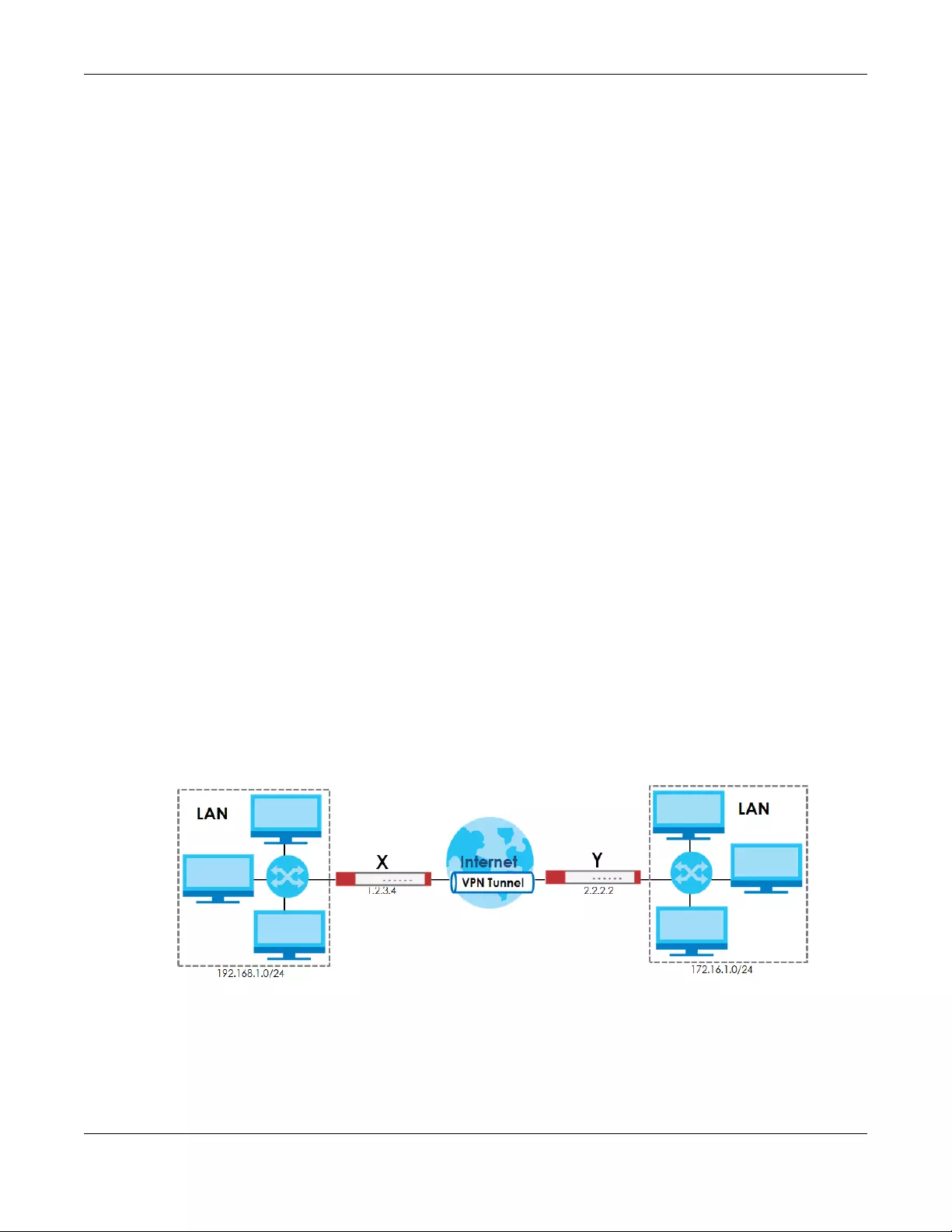
Chapter 19 IPSec VPN
ZyWALL USG FLEX Series User’s Guide
453
• Source - the original source address; the remote network (B).
• Destination - the original destination address; the local network (A).
• SNAT - the translated source address; a different IP address (range of addresses) to hide the original
source address.
Destination Address in Inbound Packets (Inbound Traffic, Destination NAT)
You can set up this translation if you want the Zyxel Device to forward some packets from the remote
network to a specific computer in the local network. For example, in Figure 311 on page 452, you can
configure this kind of translation if you want to forward mail from the remote network to the mail server in
the local network (A).
You have to specify one or more rules when you set up this kind of NAT. The Zyxel Device checks these
rules similar to the way it checks rules for a security policy. The first part of these rules define the
conditions in which the rule apply.
• Original IP - the original destination address; the remote network (B).
• Protocol - the protocol [TCP, UDP, or both] used by the service requesting the connection.
• Original Port - the original destination port or range of destination ports; in Figure 311 on page 452, it
might be port 25 for SMTP.
The second part of these rules controls the translation when the condition is satisfied.
• Mapped IP - the translated destination address; in Figure 311 on page 452, the IP address of the mail
server in the local network (A).
• Mapped Port - the translated destination port or range of destination ports.
The original port range and the mapped port range must be the same size.
IPSec VPN Example Scenario
Here is an example site-to-site IPSec VPN scenario.
Figure 312 Site-to-site IPSec VPN Example

ZyWALL USG FLEX Series User’s Guide
454
CHAPTER 20
SSL VPN
20.1 Overview
Use SSL VPN to allow users to use a web browser for secure remote user login. The remote users do not
need a VPN router or VPN client software.
20.1.1 What You Can Do in this Chapter
• Use the VPN > SSL VPN > Access Privilege screens (see Section 20.2 on page 455) to configure SSL
access policies.
• Use the Click VPN > SSL VPN > Global Setting screen (see Section 20.3 on page 458) to set the IP
address of the Zyxel Device (or a gateway device) on your network for full tunnel mode access, enter
access messages or upload a custom logo to be displayed on the remote user screen.
20.1.2 What You Need to Know
Full Tunnel Mode
In full tunnel mode, a virtual connection is created for remote users with private IP addresses in the same
subnet as the local network. This allows them to access network resources in the same way as if they
were part of the internal network.
Figure 313 Network Access Mode: Full Tunnel Mode
SSL Access Policy
An SSL access policy allows the Zyxel Device to perform the following tasks:
• limit user access to specific applications or file sharing server on the network.
• allow user access to specific networks.
• assign private IP addresses and provide DNS/WINS server information to remote users to access
internal networks.
Web Mail File Share
Web-based Application
https://
Application Server
Non-Web
LAN (192.168.1.X)
192.168.1.100
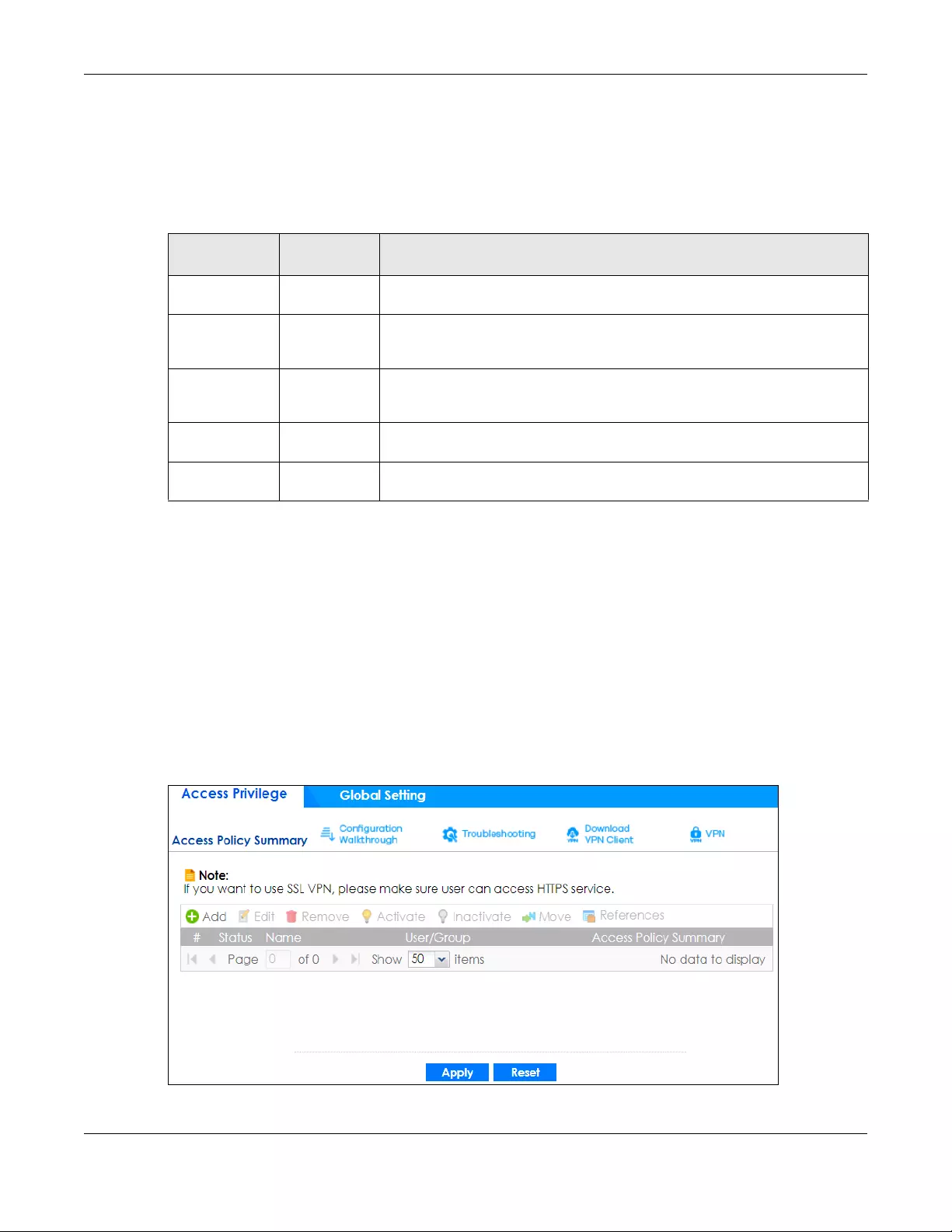
Chapter 20 SSL VPN
ZyWALL USG FLEX Series User’s Guide
455
SSL Access Policy Objects
The SSL access policies reference the following objects. If you update this information, in response to
changes, the Zyxel Device automatically propagates the changes through the SSL policies that use the
object(s). When you delete an SSL policy, the objects are not removed.
You cannot delete an object that is referenced by an SSL access policy. To delete the object, you must
first unassociate the object from the SSL access policy.
20.2 The SSL Access Privilege Screen
Click VPN > SSL VPN to open the Access Privilege screen. This screen lists the configured SSL access
policies.
Click on the icons to go to the OneSecurity website where there is guidance on configuration
walkthroughs, troubleshooting and other information.
Figure 314 VPN > SSL VPN > Access Privilege
Table 176 Objects
OBJECT TYPE OBJECT
SCREEN DESCRIPTION
User Accounts User Account/
User Group
Configure a user account or user group to which you want to apply this SSL
access policy.
Application SSL
Application
Configure an SSL application object to specify the type of application and the
address of the local computer, server, or web site SSL users are to be able to
access.
IP Pool Address Configure an address object that defines a range of private IP addresses to
assign to user computers so they can access the internal network through a
VPN connection.
Server
Addresses
Address Configure address objects for the IP addresses of the DNS and WINS servers that
the Zyxel Device sends to the VPN connection users.
VPN Network Address Configure an address object to specify which network segment users are
allowed to access through a VPN connection.

Chapter 20 SSL VPN
ZyWALL USG FLEX Series User’s Guide
456
The following table describes the labels in this screen.
20.2.1 The SSL Access Privilege Policy Add/Edit Screen
To create a new or edit an existing SSL access policy, click the Add or Edit icon in the Access Privilege
screen.
Table 177 VPN > SSL VPN > Access Privilege
LABEL DESCRIPTION
Access Policy
Summary
This screen shows a summary of SSL VPN policies created.
Click on the VPN icon to go to the Zyxel VPN Client product page at the Zyxel website.
Add Click this to create a new entry. Select an entry and click Add to create a new entry after the
selected entry.
Edit Double-click an entry or select it and click Edit to open a screen where you can modify the entry’s
settings.
Remove To remove an entry, select it and click Remove. The Zyxel Device confirms you want to remove it
before doing so.
Activate To turn on an entry, select it and click Activate.
Inactivate To turn off an entry, select it and click Inactivate.
Move To move an entry to a different number in the list, click the Move icon. In the field that appears,
specify the number to which you want to move the interface.
References Select an entry and click References to open a screen that shows which settings use the entry.
Click Refresh to update information on this screen.
#This field displays the index number of the entry.
Status This icon is lit when the entry is active and dimmed when the entry is inactive.
Name This field displays the descriptive name of the SSL access policy for identification purposes.
User/Group This field displays the user account or user group name(s) associated to an SSL access policy.
This field displays up to three names.
Access Policy
Summary
This field displays details about the SSL application object this policy uses including its name, type,
and address.
Apply Click Apply to save the settings.
Reset Click Reset to discard all changes.
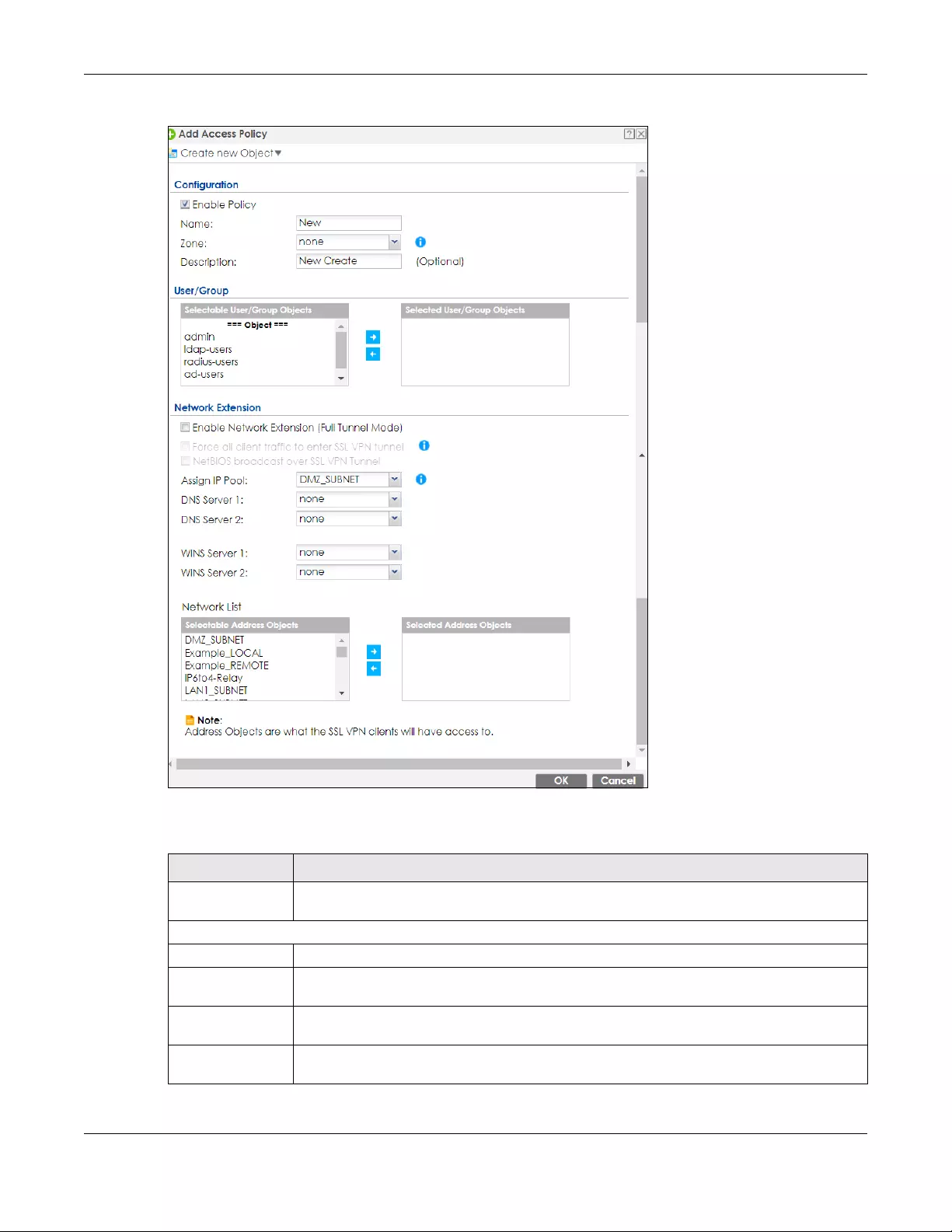
Chapter 20 SSL VPN
ZyWALL USG FLEX Series User’s Guide
457
Figure 315 VPN > SSL VPN > Add/Edit
The following table describes the labels in this screen.
Table 178 VPN > SSL VPN > Access Privilege > Add/Edit
LABEL DESCRIPTION
Create new
Object
Use to configure any new settings objects that you need to use in this screen.
Configuration
Enable Policy Select this option to activate this SSL access policy.
Name Enter a descriptive name to identify this policy. You can enter up to 31 characters (“a-z”, A-Z”,
“0-9”) with no spaces allowed.
Zone Select the zone to which to add this SSL access policy. You use zones to apply security settings
such as security policy and remote management.
Description Enter additional information about this SSL access policy. You can enter up to 60 characters
("0-9", "a-z", "A-Z", "-" and "_").

Chapter 20 SSL VPN
ZyWALL USG FLEX Series User’s Guide
458
20.3 The SSL Global Setting Screen
Click VPN > SSL VPN and click the Global Setting tab to display the following screen. Use this screen to
set the IP address of the Zyxel Device (or a gateway device) on your network for full tunnel mode
access.
User/Group The Selectable User/Group Objects list displays the name(s) of the user account and/or user
group(s) to which you have not applied an SSL access policy yet.
To associate a user or user group to this SSL access policy, select a user account or user group
and click the right arrow button to add to the Selected User/Group Objects list. You can
select more than one name.
To remove a user or user group, select the name(s) in the Selected Us er/Group Ob jects list and
click the left arrow button.
Note: Although you can select admin and limited-admin accounts in this screen,
they are reserved for device configuration only. You cannot use them to
access the SSL VPN portal.
Network Extension (Optional)
Enable Network
Extension
Select this option to create a VPN tunnel between the authenticated users and the internal
network. This allows the users to access the resources on the network as if they were on the
same local network. This includes access to resources not supported by SSL application
objects. For example this lets users Telnet to the internal network even though the Zyxel Device
does not have SSL application objects for Telnet.
Clear this option to disable this feature. Users can only access the applications as defined by
the VPN tunnel’s selected SSL application settings and the remote user computers are not
made to be a part of the local network.
Force all client
traffic to SSL VPN
tunnel
Select this to send all traffic from the SSL VPN clients through the SSL VPN tunnel. This replaces
the default gateway of the SSL VPN clients with the SSL VPN gateway.
NetBIOS
broadcast over
SSL VPN Tunnel
Select this to search for a remote computer and access its applications as if it was in a Local
Area Network. The user can find a computer not only by its IP address but also by computer
name.
Assign IP Pool Define a separate pool of IP addresses to assign to the SSL users. Select it here.
The SSL VPN IP pool should not overlap with IP addresses on the Zyxel Device's local networks
(LAN and DMZ for example), the SSL user's network, or the networks you specify in the SSL VPN
Network List.
DNS/WINS Server
1..2
Select the name of the DNS or WINS server whose information the Zyxel Device sends to the
remote users. This allows them to access devices on the local network using domain names
instead of IP addresses.
Network List To allow user access to local network(s), select a network name in the Selectable Address
Objects list and click the right arrow button to add to the Selecte d Address Objects list. You
can select more than one network.
To block access to a network, select the network name in the Selected Address Objects list
and click the left arrow button.
OK Click OK to save the changes and return to the main Access Privilege screen.
Cancel Click Cancel to discard all changes and return to the main Access Privilege screen.
Table 178 VPN > SSL VPN > Access Privilege > Add/Edit (continued)
LABEL DESCRIPTION
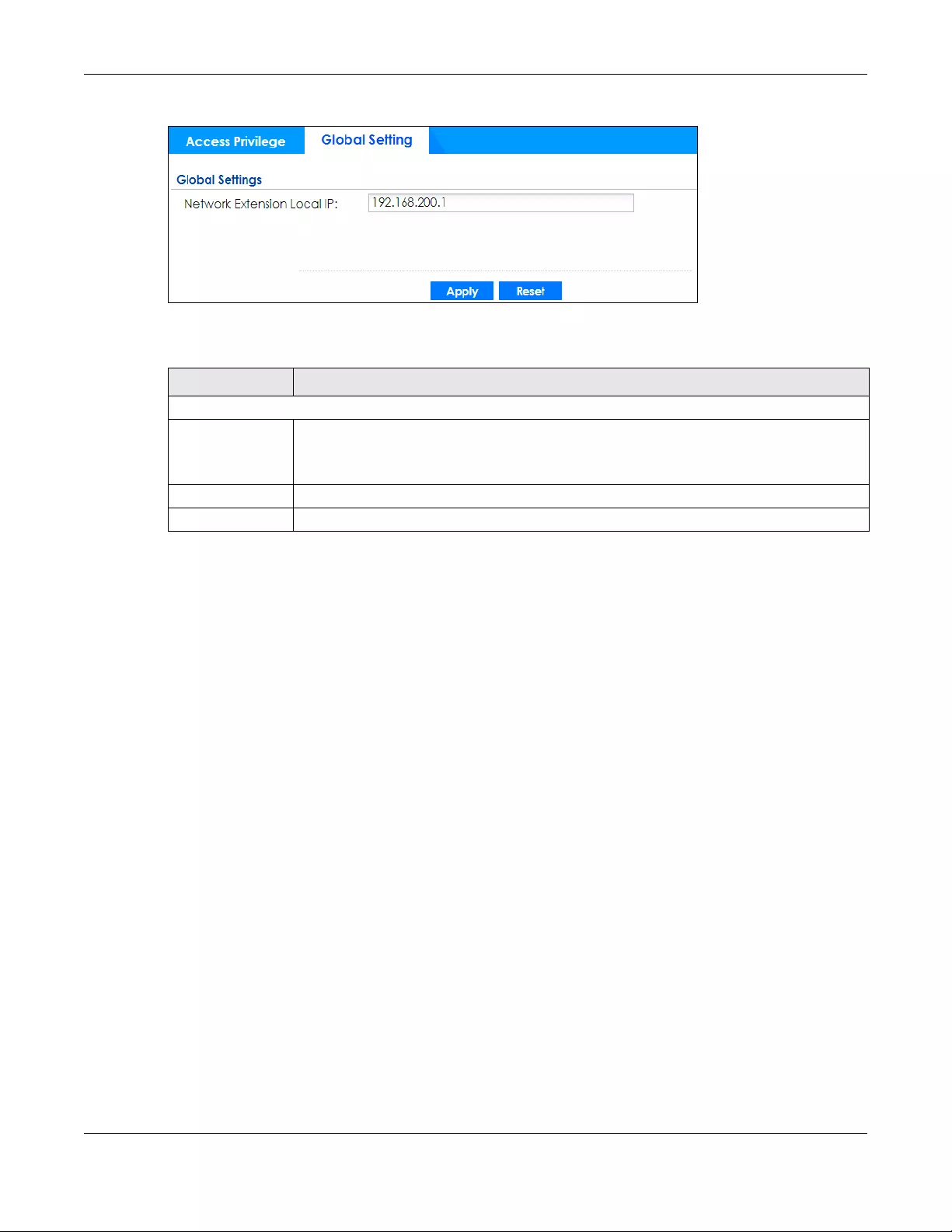
Chapter 20 SSL VPN
ZyWALL USG FLEX Series User’s Guide
459
Figure 316 VPN > SSL VPN > Global Setting
The following table describes the labels in this screen.
Table 179 VPN > SSL VPN > Global Setting
LABEL DESCRIPTION
Global Setting
Network Extension
Local IP
Specify the IP address of the Zyxel Device (or a gateway device) for full tunnel mode SSL VPN
access.
Leave this field to the default settings unless it conflicts with another interface.
Apply Click Apply to save the changes and/or start the logo file upload process.
Reset Click Reset to return the screen to its last-saved settings.

ZyWALL USG FLEX Series User’s Guide
460
CHAPTER 21
L2TP VPN
21.1 Overview
L2TP VPN uses the L2TP and IPSec client software included in remote users’ Android, iOS, Windows or
Mac OS X operating systems for secure connections to the network behind the Zyxel Device. The remote
users do not need their own IPSec gateways or third-party VPN client software.
Note:
Figure 317 L2TP VPN Overview
21.1.1 What You Can Do in this Chapter
• Use the L2TP VPN screen (see Section 21.2 on page 461) to configure the Zyxel Device’s L2TP VPN
settings.
• Use the VPN Setup Wizard screen in Quick Setup (Chapter 4 on page 79) to configure the Zyxel
Device’s L2TP VPN settings.
21.1.2 What You Need to Know
The Layer 2 Tunneling Protocol (L2TP) works at layer 2 (the data link layer) to tunnel network traffic
between two peers over another network (like the Internet). In L2TP VPN, an IPSec VPN tunnel is
established first and then an L2TP tunnel is built inside it. See Chapter 19 on page 418 for information on
IPSec VPN.
IPSec Configuration Required for L2TP VPN
You must configure an IPSec VPN connection prior to proper L2TP VPN usage (see Chapter 21 on page
460 for details). The IPSec VPN connection must:
• Be enabled.
• Use transport mode.

Chapter 21 L2TP VPN
ZyWALL USG FLEX Series User’s Guide
461
• Use Pre-Shared Key authentication.
• Use a VPN gateway with the Secure Gateway set to 0.0.0.0 if you need to allow L2TP VPN clients to
connect from more than one IP address.
Using the Quick Setup VPN Setup Wizard
The VPN Setup Wizard is an easy and convenient way to configure the L2TP VPN settings. Click
Configuration > Quick Setup > VPN Setup > VPN Settings for L2TP VPN Settings to get started.
Policy Route
The Policy Route for return traffic (from LAN to L2TP clients) is automatically created when Zyxel Device
adds a new L2TP connection, allowing users access the resources on a network without additional
configuration. However, if some of the traffic from the L2TP clients needs to go to the Internet, you will
need to create a policy route to send that traffic from the L2TP tunnels out through a WAN trunk. This task
can be easily performed by clicking the Allow L2TP traffic through WAN checkbox at Quick Setu p > VPN
Setup > Allow L2TP traffic through WAN.
Figure 318 Policy Route for L2TP VPN
21.2 L2TP VPN Screen
Click Configuration > VPN > L2T P VPN to open the following screen. Use this screen to configure the Zyxel
Device’s L2TP VPN settings.
Note: Disconnect any existing L2TP VPN sessions before modifying L2TP VPN settings. The
remote users must make any needed matching configuration changes and re-establish
the sessions using the new settings.
Click on the icons to go to the OneSecurity website where there is guidance on configuration
walkthroughs, troubleshooting, and other information.

Chapter 21 L2TP VPN
ZyWALL USG FLEX Series User’s Guide
462
Figure 319 Configuration > VPN > L2TP VPN
The following table describes the fields in this screen.
Table 180 Configuration > VPN > L2TP VPN
LABEL DESCRIPTION
Show Advanced
Settings / Hide
Advanced Settings
Click this button to display a greater or lesser number of configuration fields.
Create new
Object
Use to configure any new settings objects that you need to use in this screen.
Enable L2TP Over
IPSec
Use this field to turn the Zyxel Device’s L2TP VPN function on or off.
VPN Connection Select the IPSec VPN connection the Zyxel Device uses for L2TP VPN. All of the configured VPN
connections display here, but the one you use must meet the requirements listed in IPSec
Configuration Required for L2TP VPN.
Note: Modifying this VPN connection (or the VPN gateway that it uses) disconnects
any existing L2TP VPN sessions.
IP Address Pool Select the pool of IP addresses that the Zyxel Device uses to assign to the L2TP VPN clients. Use
Create new Object if you need to configure a new pool of IP addresses.
This should not conflict with any WAN, LAN, DMZ or WLAN subnet even if they are not in use.
Authentication
Method
Select how the Zyxel Device authenticates a remote user before allowing access to the L2TP
VPN tunnel.
The authentication method has the Zyxel Device check a user’s user name and password
against the Zyxel Device’s local database, a remote LDAP, RADIUS, a Active Directory server,
or more than one of these.
Authentication
Server Certificate
Select the certificate to use to identify the Zyxel Device for L2TP VPN connections. You must
have certificates already configured in the My Certificates screen. The certificate is used with
the EAP, PEAP, and MSCHAPv2 authentication protocols.
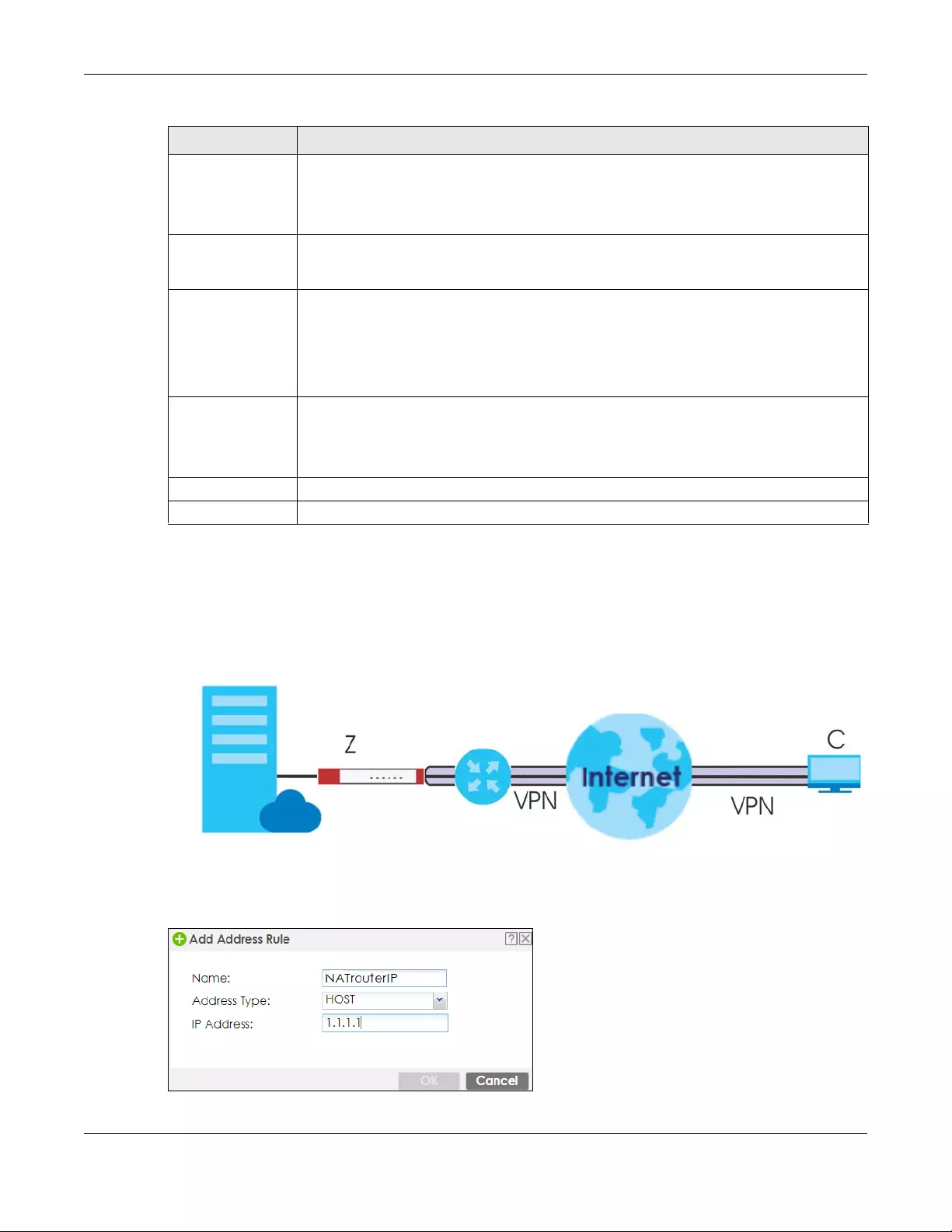
Chapter 21 L2TP VPN
ZyWALL USG FLEX Series User’s Guide
463
21.2.1 Example: L2TP and Zyxel Device Behind a NAT Router
If the Zyxel Device (Z) is behind a NAT router (N), then do the following for remote clients (C) to access
the network behind the Zyxel Device (Z) using L2TP over IPv4.
Figure 320 L2TP and Zyxel Device Behind a NAT Router
1Create an address object in Configuration > Object > Address/GEO IP > Address for the WAN IP address
of the NAT router.
Allowed User The remote user must log into the Zyxel Device to use the L2TP VPN tunnel.
Select a user or user group that can use the L2TP VPN tunnel. Use Cr eate new Object if you
need to configure a new user account. Otherwise, select any to allow any user with a valid
account and password on the Zyxel Device to log in.
Keep Alive Timer The Zyxel Device sends a Hello message after waiting this long without receiving any traffic
from the remote user. The Zyxel Device disconnects the VPN tunnel if the remote user does
not respond.
First DNS Server,
Second DNS Server
Specify the IP addresses of DNS servers to assign to the remote users. You can specify these IP
addresses two ways.
Custom Defined - enter a static IP address.
From ISP - use the IP address of a DNS server that another interface received from its DHCP
server.
First WINS Server,
Second WINS
Server
The WINS (Windows Internet Naming Service) server keeps a mapping table of the computer
names on your network and the IP addresses that they are currently using.
Type the IP addresses of up to two WINS servers to assign to the remote users. You can specify
these IP addresses two ways.
Apply Click Apply to save your changes in the Zyxel Device.
Reset Click Reset to return the screen to its last-saved settings.
Table 180 Configuration > VPN > L2TP VPN (continued)
LABEL DESCRIPTION
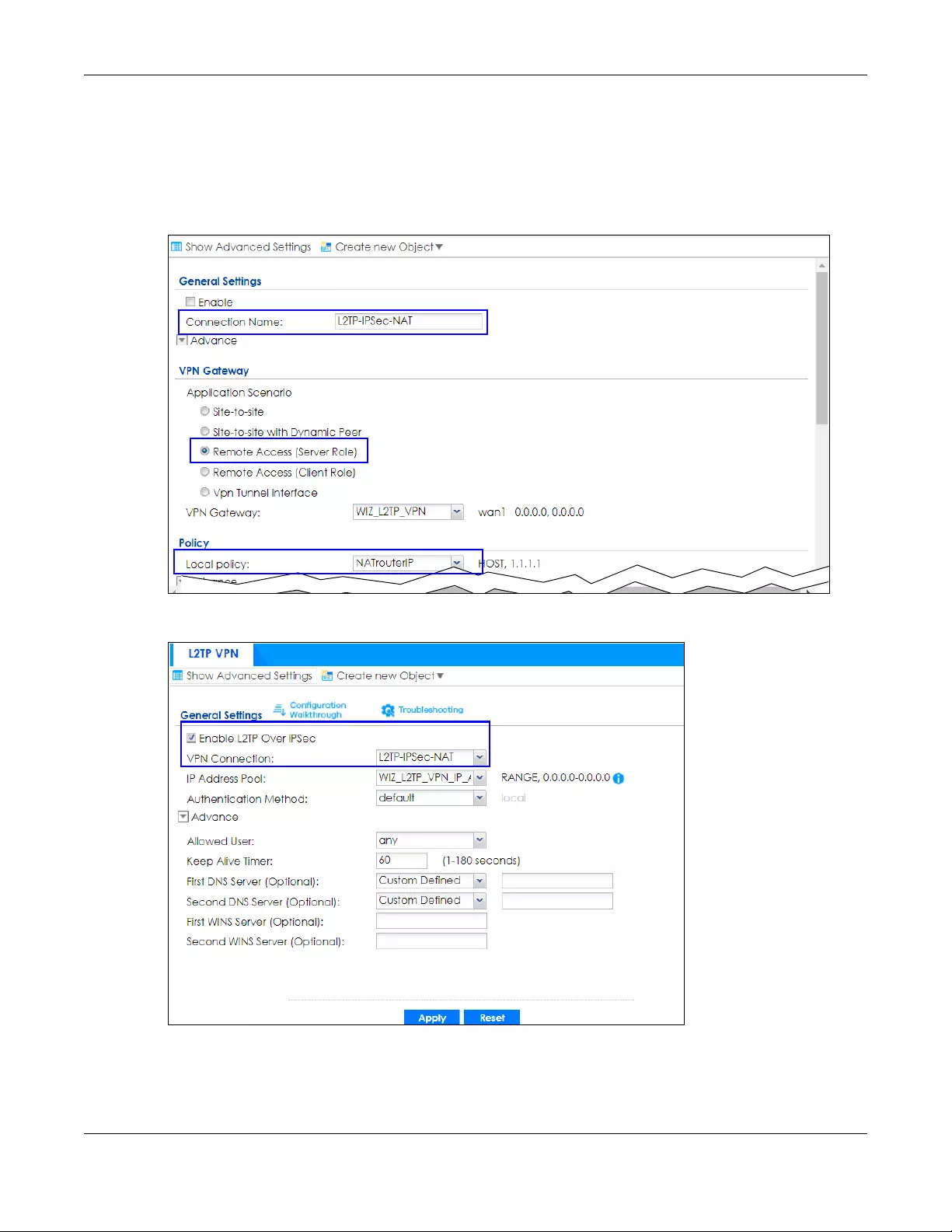
Chapter 21 L2TP VPN
ZyWALL USG FLEX Series User’s Guide
464
2Go to Configuration > VPN > IPSec VPN > VPN Connection and click Add for IPv4 Configuration to create
a new VPN connection.
3Select Remote Access (Server Role) as the VPN scenario for the remote client.
4Select the NAT router WAN IP address object as the Local Policy.
5Go to Configuration > VPN > L2TP VPN and select the VPN Connection just configured.

ZyWALL USG FLEX Series User’s Guide
465
CHAPTER 22
BWM (Bandwidth
Management)
22.1 Overview
Bandwidth management provides a convenient way to manage the use of various services on the
network. It manages general protocols (for example, HTTP and FTP) and applies traffic prioritization to
enhance the performance of delay-sensitive applications like voice and video.
22.1.1 What You Can Do in this Chapter
Use the BWM screens (see Section 22.2 on page 469) to control bandwidth for services passing through
the Zyxel Device, and to identify the conditions that define the bandwidth control.
22.1.2 What You Need to Know
When you allow a service, you can restrict the bandwidth it uses. It controls TCP and UDP traffic. Use
policy routes to manage other types of traffic (like ICMP).
Note: Bandwidth management in policy routes has priority over TCP and UDP traffic policies.
If you want to use a service, make sure both the security policy allow the service’s packets to go through
the Zyxel Device.
Note: The Zyxel Device checks security policies before it checks bandwidth management
rules for traffic going through the Zyxel Device.
Bandwidth management examines every TCP and UDP connection passing through the Zyxel Device.
Then, you can specify, by port, whether or not the Zyxel Device continues to route the connection.
BWM Type
The Zyxel Device supports three types of bandwidth management: Shared, Per user and Per-Source-IP.
The Shared BWM type is selected by default in a bandwidth management rule. All matched traffic
shares the bandwidth configured in the rule.
If the BWM type is set to Per user in a rule, each user that matches the rule can use up to the configured
bandwidth by his/her own.
Select the Per-Source-IP type when you want to set the maximum bandwidth for traffic from an
individual source IP address.

Chapter 22 BWM (Bandwidth Management)
ZyWALL USG FLEX Series User’s Guide
466
In the following example, you configure a Per user bandwidth management rule for radius-users to limit
outgoing traffic to 300 kbs. Then all radius-users (A, B and C) can send 300 kbps of traffic.
Figure 321 Bandwidth Management Per User Type
DiffServ and DSCP Marking
QoS is used to prioritize source-to-destination traffic flows. All packets in the same flow are given the
same priority. CoS (class of service) is a way of managing traffic in a network by grouping similar types of
traffic together and treating each type as a class. You can use CoS to give different priorities to different
packet types.
DiffServ (Differentiated Services) is a class of service (CoS) model that marks packets so that they
receive specific per-hop treatment at DiffServ-compliant network devices along the route based on the
application types and traffic flow. Packets are marked with DiffServ Code Points (DSCPs) indicating the
level of service desired. This allows the intermediary DiffServ-compliant network devices to handle the
packets differently depending on the code points without the need to negotiate paths or remember
state information for every flow. In addition, applications do not have to request a particular service or
give advanced notice of where the traffic is going.
Connection and Packet Directions
Bandwidth management looks at the connection direction, that is, from which interface the connection
was initiated and to which interface the connection is going.
A connection has outbound and inbound packet flows. The Zyxel Device controls the bandwidth of
traffic of each flow as it is going out through an interface or VPN tunnel.
• The outbound traffic flows from the connection initiator to the connection responder.
• The inbound traffic flows from the connection responder to the connection initiator.
For example, a LAN1 to WAN connection is initiated from LAN1 and goes to the WAN.
• Outbound traffic goes from a LAN1 device to a WAN device. Bandwidth management is applied
before sending the packets out a WAN interface on the Zyxel Device.
• Inbound traffic comes back from the WAN device to the LAN1 device. Bandwidth management is
applied before sending the traffic out a LAN1 interface.
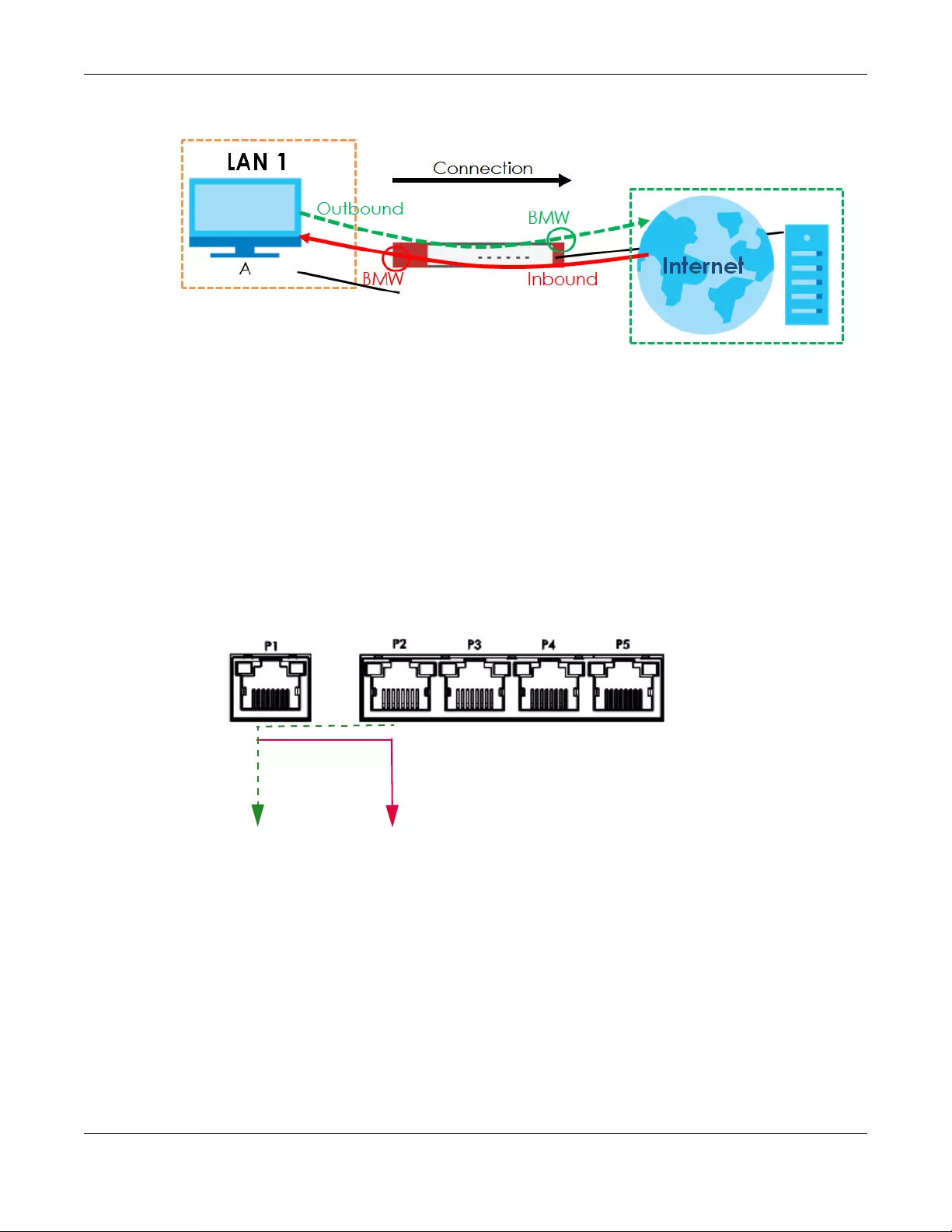
Chapter 22 BWM (Bandwidth Management)
ZyWALL USG FLEX Series User’s Guide
467
Figure 322 LAN1 to WAN Connection and Packet Directions
Outbound and Inbound Bandwidth Limits
You can limit an application’s outbound or inbound bandwidth. This limit keeps the traffic from using up
too much of the out-going interface’s bandwidth. This way you can make sure there is bandwidth for
other applications. When you apply a bandwidth limit to outbound or inbound traffic, each member of
the out-going zone can send up to the limit. Take a LAN1 to WAN policy for example.
• Outbound traffic is limited to 200 kbps. The connection initiator is on the LAN1 so outbound means the
traffic traveling from the LAN1 to the WAN. Each of the WAN zone’s two interfaces can send the limit
of 200 kbps of traffic.
• Inbound traffic is limited to 500 kbs. The connection initiator is on the LAN1 so inbound means the
traffic traveling from the WAN to the LAN1.
Figure 323 LAN1 to WAN, Outbound 200 kbps, Inbound 500 kbps
Bandwidth Management Priority
• The Zyxel Device gives bandwidth to higher-priority traffic first, until it reaches its configured
bandwidth rate.
• Then lower-priority traffic gets bandwidth.
• The Zyxel Device uses a fairness-based (round-robin) scheduler to divide bandwidth among traffic
flows with the same priority.
• The Zyxel Device automatically treats traffic with bandwidth management disabled as priority 7 (the
lowest priority).
Inbound
Outbound 500 kbps
200 kbps
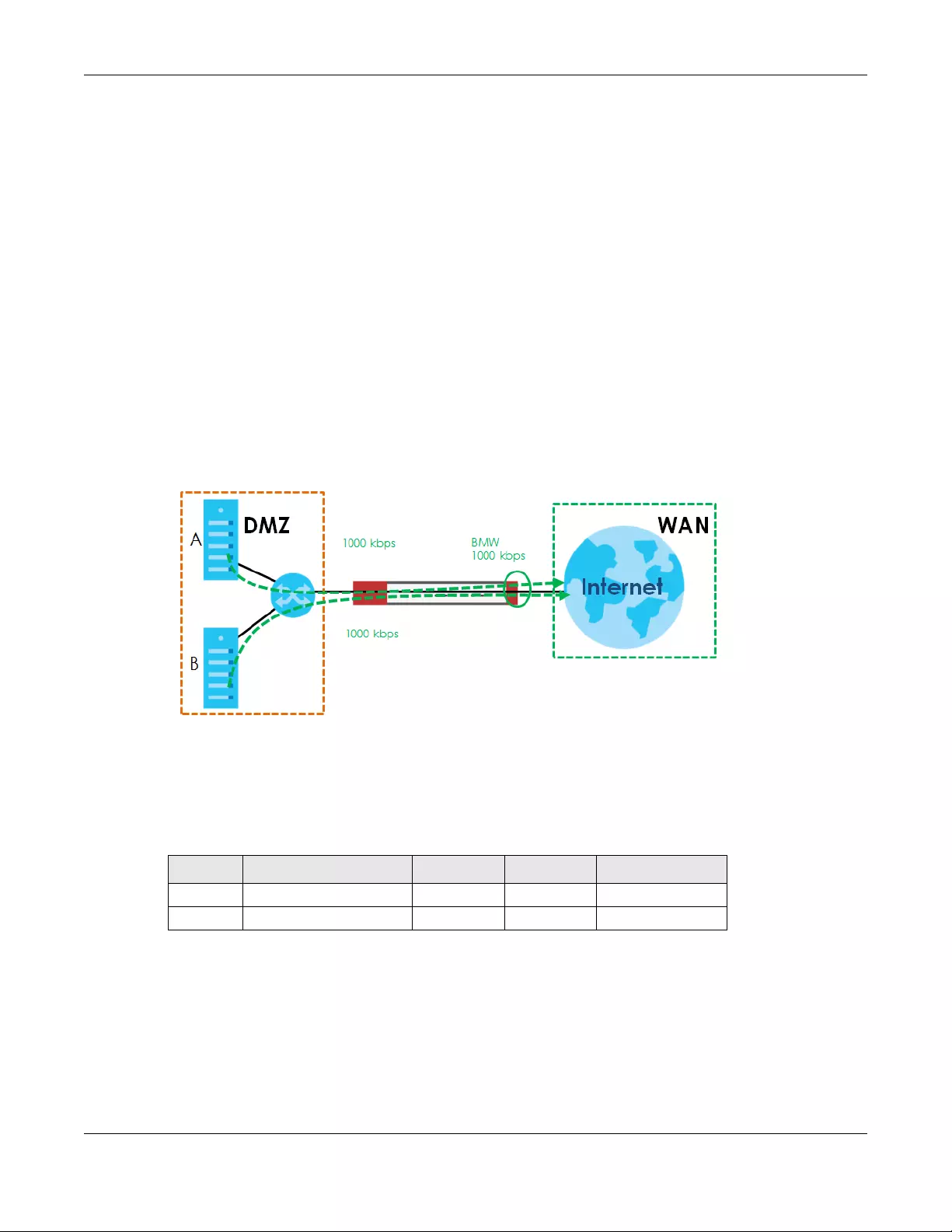
Chapter 22 BWM (Bandwidth Management)
ZyWALL USG FLEX Series User’s Guide
468
Maximize Bandwidth Usage
Maximize bandwidth usage allows applications with maximize bandwidth usage enabled to “borrow”
any unused bandwidth on the out-going interface.
After each application gets its configured bandwidth rate, the Zyxel Device uses the fairness- based
scheduler to divide any unused bandwidth on the out-going interface amongst applications that need
more bandwidth and have maximize bandwidth usage enabled.
Unused bandwidth is divided equally. Higher priority traffic does not get a larger portion of the unused
bandwidth.
Bandwidth Management Behavior
The following sections show how bandwidth management behaves with various settings. For example,
you configure DMZ to WAN policies for FTP servers A and B. Each server tries to send 1000 kbps, but the
WAN is set to a maximum outgoing speed of 1000 kbps. You configure policy A for server A’s traffic and
policy B for server B’s traffic.
Figure 324 Bandwidth Management Behavior
Configured Rate Effect
In the following table the configured rates total less than the available bandwidth and maximize
bandwidth usage is disabled, both servers get their configured rate.
Table 181 Configured Rate Effect
POLICY CONFIGURED RATE MAX. B. U. PRIORITY ACTUAL RATE
A300 kbps No 1300 kbps
B200 kbps No 1200 kbps

Chapter 22 BWM (Bandwidth Management)
ZyWALL USG FLEX Series User’s Guide
469
Priority Effect
Here the configured rates total more than the available bandwidth. Because server A has higher priority,
it gets up to it’s configured rate (800 kbps), leaving only 200 kbps for server B.
Maximize Bandwidth Usage Effect
With maximize bandwidth usage enabled, after each server gets its configured rate, the rest of the
available bandwidth is divided equally between the two. So server A gets its configured rate of 300 kbps
and server B gets its configured rate of 200 kbps. Then the Zyxel Device divides the remaining bandwidth
(1000 - 500 = 500) equally between the two (500 / 2 = 250 kbps for each). The priority has no effect on
how much of the unused bandwidth each server gets.
So server A gets its configured rate of 300 kbps plus 250 kbps for a total of 550 kbps. Server B gets its
configured rate of 200 kbps plus 250 kbps for a total of 450 kbps.
Priority and Over Allotment of Bandwidth Effect
Server A has a configured rate that equals the total amount of available bandwidth and a higher
priority. You should regard extreme over allotment of traffic with different priorities (as shown here) as a
configuration error. Even though the Zyxel Device still attempts to let all traffic get through and not be
lost, regardless of its priority, server B gets almost no bandwidth with this configuration.
22.2 The Bandwidth Management Configuration
The Bandwidth management screens control the bandwidth allocation for TCP and UDP traffic. You can
use source interface, destination interface, destination port, schedule, user, source, destination
information, DSCP code and service type as criteria to create a sequence of specific conditions, similar
to the sequence of rules used by firewalls, to specify how the Zyxel Device handles the DSCP value and
allocate bandwidth for the matching packets.
Click Configuration > BWM to open the following screen. This screen allows you to enable/disable
bandwidth management and add, edit, and remove user-defined bandwidth management policies.
Table 182 Priority Effect
POLICY CONFIGURED RATE MAX. B. U. PRIORITY ACTUAL RATE
A800 kbps Yes 1800 kbps
B1000 kbps Yes 2200 kbps
Table 183 Maximize Bandwidth Usage Effect
POLICY CONFIGURED RATE MAX. B. U. PRIORITY ACTUAL RATE
A300 kbps Yes 1550 kbps
B200 kbps Yes 2450 kbps
Table 184 Priority and Over Allotment of Bandwidth Effect
POLICY CONFIGURED RATE MAX. B. U. PRIORITY ACTUAL RATE
A1000 kbps Yes 1999 kbps
B1000 kbps Yes 21 kbps
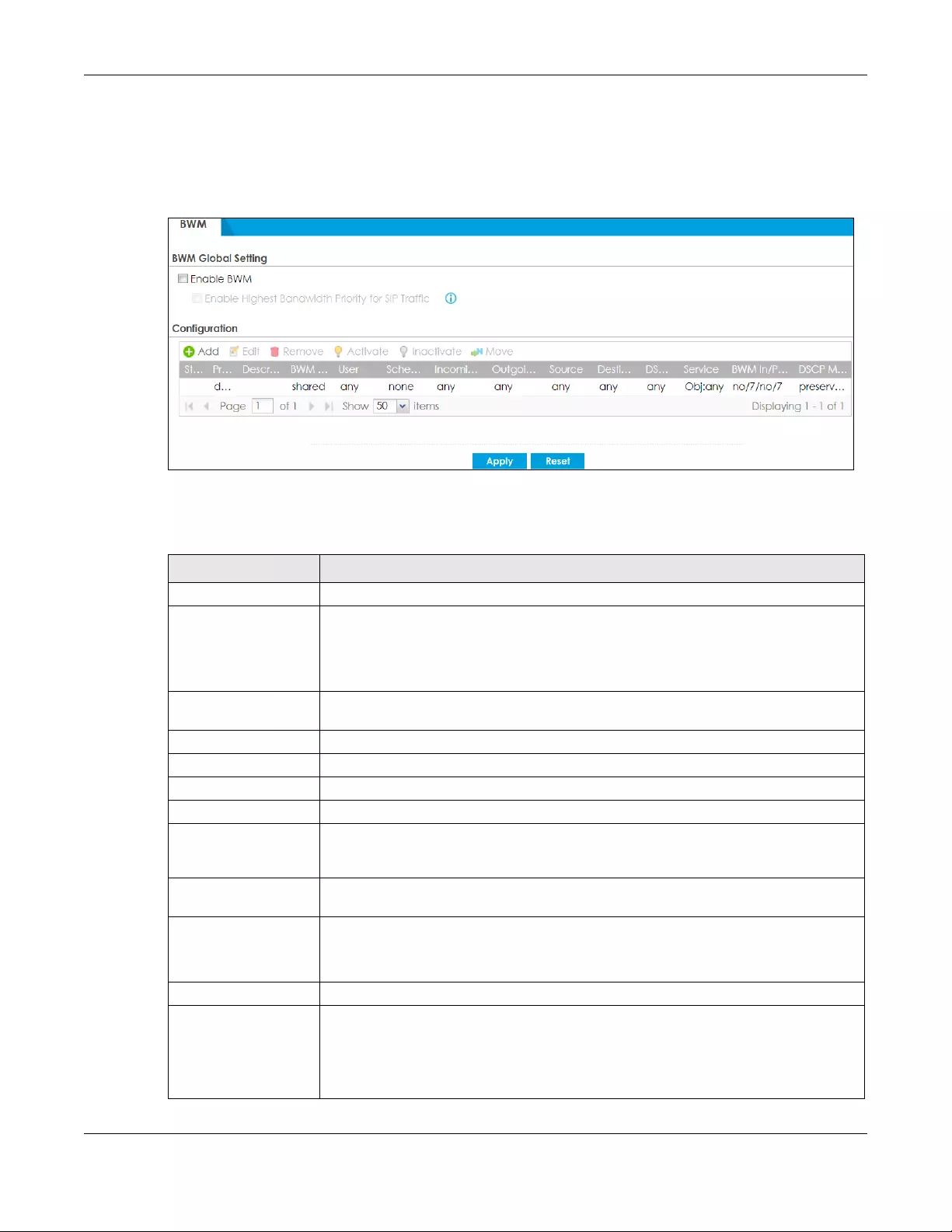
Chapter 22 BWM (Bandwidth Management)
ZyWALL USG FLEX Series User’s Guide
470
The default bandwidth management policy is the one with the priority of “default”. It is the last policy
the Zyxel Device checks if traffic does not match any other bandwidth management policies you have
configured. You cannot remove, activate, deactivate or move the default bandwidth management
policy.
Figure 325 Configuration > Bandwidth Management
The following table describes the labels in this screen. See Section 22.2.1 on page 472 for more
information as well.
Table 185 Configuration > Bandwidth Management
LABEL DESCRIPTION
Enable BWM Select this check box to activate management bandwidth.
Enable Highest
Bandwidth Priority
for SIP Traffic
Select this to maximize the throughput of SIP traffic to improve SIP-based VoIP call sound
quality. This has the Zyxel Device immediately send SIP traffic upon identifying it. When
this option is enabled the Zyxel Device ignores any other application patrol rules for SIP
traffic (so there is no bandwidth control for SIP traffic) and does not record SIP traffic
bandwidth usage statistics.
Add Click this to create a new entry. Select an entry and click Add to create a new entry after
the selected entry.
Edit Select an entry and click this to be able to modify it.
Remove Select an entry and click this to delete it.
Activate To turn on an entry, select it and click Activate.
Inactivate To turn off an entry, select it and click Inactivate.
Move To change an entry’s position in the numbered list, select it and click Move to display a
field to type a number for where you want to put that entry and press [ENTER] to move
the entry to the number that you typed.
Status The activate (light bulb) icon is lit when the entry is active and dimmed when the entry is
inactive. The status icon is not available for the default bandwidth management policy.
Priority This field displays a sequential value for each bandwidth management policy and it is
not associated with a specific setting.
This field displays default for the default bandwidth management policy.
Description This field displays additional information about this policy.
BWM Type This field displays the below types of BWM:
•Shared, when the policy is set for all matched traffic
•Per User, when the policy is set for an individual user or a user group
•Per-Source-IP, when the policy is set for a source IP

Chapter 22 BWM (Bandwidth Management)
ZyWALL USG FLEX Series User’s Guide
471
User This is the type of user account to which the policy applies. If any displays, the policy
applies to all user accounts.
Schedule This is the schedule that defines when the policy applies. none means the policy always
applies.
Incoming Interface This is the source interface of the traffic to which this policy applies.
Outgoing Interface This is the destination interface of the traffic to which this policy applies.
Source This is the source address or address group, including geographic address and FQDN
(group) objects, for whom this policy applies. If any displays, the policy is effective for
every source.
Destination This is the destination address or address group, including geographic address and FQDN
(group) objects, for whom this policy applies. If any displays, the policy is effective for
every destination.
DSCP Code These are the DSCP code point values of incoming and outgoing packets to which this
policy applies. The lower the number the higher the priority with the exception of 0 which
is usually given only best-effort treatment.
any means all DSCP value or no DSCP marker.
default means traffic with a DSCP value of 0. This is usually best effort traffic
The “af” options stand for Assured Forwarding. The number following the “af” identifies
one of four classes and one of three drop preferences.
Service App and the service name displays if you selected Application Object for the service
type. An Application Object is a pre-defined service.
Obj and the service name displays if you selected Service Object for the service type. A
Service Object is a customized pre-defined service or another service. Mouse over the
service object name to view the corresponding IP protocol number.
BWM In/Pri/Out/Pri This field shows the amount of bandwidth the traffic can use.
In - This is how much inbound bandwidth, in kilobits per second, this policy allows the
matching traffic to use. Inbound refers to the traffic the Zyxel Device sends to a
connection’s initiator. If no displays here, this policy does not apply bandwidth
management for the inbound traffic.
Out - This is how much outgoing bandwidth, in kilobits per second, this policy allows the
matching traffic to use. Outbound refers to the traffic the Zyxel Device sends out from a
connection’s initiator. If no displays here, this policy does not apply bandwidth
management for the outbound traffic.
Pri - This is the priority for the incoming (the first Pri value) or outgoing (the second Pri
value) traffic that matches this policy. The smaller the number, the higher the priority.
Traffic with a higher priority is given bandwidth before traffic with a lower priority. The
Zyxel Device ignores this number if the incoming and outgoing limits are both set to 0. In
this case the traffic is automatically treated as being set to the lowest priority (7)
regardless of this field’s configuration.
Table 185 Configuration > Bandwidth Management
LABEL DESCRIPTION

Chapter 22 BWM (Bandwidth Management)
ZyWALL USG FLEX Series User’s Guide
472
22.2.1 The Bandwidth Management Add/Edit Screen
The Configuration > Bandwidth Management Add/Edit screen allows you to create a new condition or
edit an existing one.
802.1P Marking
Use 802.1P to prioritize outgoing traffic from a VLAN interface. The Priority Code is a 3-bit field within a
802.1Q VLAN tag that’s used to prioritize associated outgoing VLAN traffic. "0" is the lowest priority level
and "7" is the highest.
The following table is a guide to types of traffic for the priority code.
DSCP Marking This is how the Zyxel Device handles the DSCP value of the incoming and outgoing
packets that match this policy.
In - Inbound, the traffic the Zyxel Device sends to a connection’s initiator.
Out - Outbound, the traffic the Zyxel Device sends out from a connection’s initiator.
If this field displays a DSCP value, the Zyxel Device applies that DSCP value to the route’s
outgoing packets.
preserve means the Zyxel Device does not modify the DSCP value of the route’s
outgoing packets.
default means the Zyxel Device sets the DSCP value of the route’s outgoing packets to 0.
The “af” choices stand for Assured Forwarding. The number following the “af” identifies
one of four classes and one of three drop preferences.
Apply Click Apply to save your changes back to the Zyxel Device.
Reset Click Reset to return the screen to its last-saved settings.
Table 185 Configuration > Bandwidth Management
LABEL DESCRIPTION
Table 186 Single Tagged 802.1Q Frame Format
DA SA TPID Priority VID Len/Etype Data FCS IEEE 802.1Q customer
tagged frame
Table 187 802.1Q Frame
DA Destination Address Priority 802.1p Priority
SA Source Address Len/Etype Length and type of Ethernet frame
TPID Tag Protocol IDentifier Data Frame data
VID VLAN ID FCS Frame Check Sequence
Table 188 Priority Code and Types of Traffic
PRIORITY TRAFFIC TYPES
0 (lowest) Background
1Best Effort
2Excellent Effort
3Critical Applications
4Video, less than 100 ms latency and jitter
5Voice, less than 10 ms latency and jitter

Chapter 22 BWM (Bandwidth Management)
ZyWALL USG FLEX Series User’s Guide
473
To access this screen, go to the Configuration > Bandwidth Management screen (see Section 22.2 on
page 469), and click either the Add icon or an Edit icon.
Figure 326 Configuration > Bandwidth Management > Edit (For the Default Policy)
6Internetwork Control
7 (highest) Network Control
Table 188 Priority Code and Types of Traffic
PRIORITY TRAFFIC TYPES
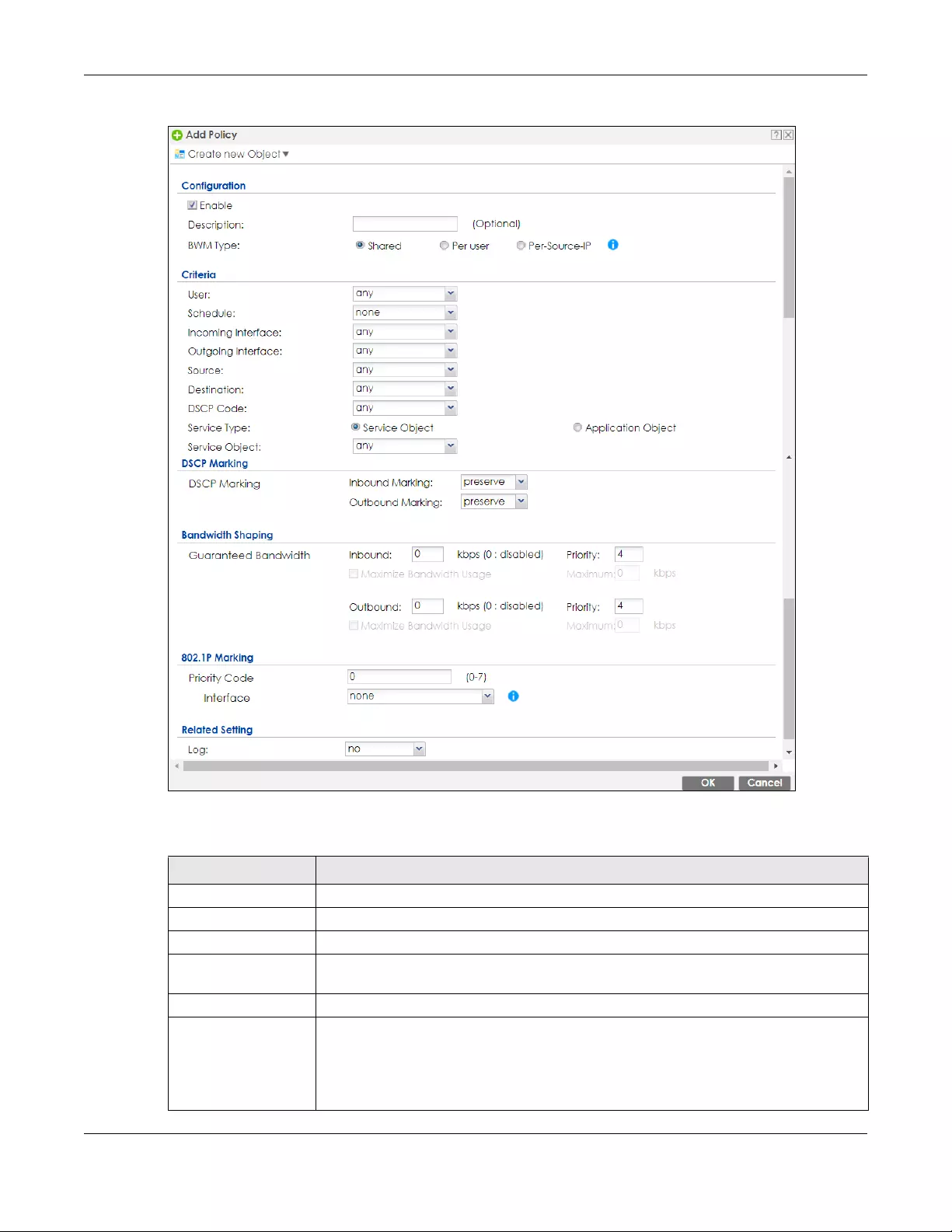
Chapter 22 BWM (Bandwidth Management)
ZyWALL USG FLEX Series User’s Guide
474
Figure 327 Configuration > Bandwidth Management > Add/Edit
The following table describes the labels in this screen.
Table 189 Configuration > Bandwidth Management > Add/Edit
LABEL DESCRIPTION
Create new Object Use to configure any new settings objects that you need to use in this screen.
Configuration
Enable Select this check box to turn on this policy.
Description Enter a description of this policy. It is not used elsewhere. You can use alphanumeric and
()+/:=?!*#@$_%- characters, and it can be up to 60 characters long.
Criteria Use this section to configure the conditions of traffic to which this policy applies.
BWM Type This field displays the below types of BWM rule:
• Shared, when the policy is set for all users
• Per User, when the policy is set for an individual user or a user group
• Per Source IP, when the policy is set for a source IP

Chapter 22 BWM (Bandwidth Management)
ZyWALL USG FLEX Series User’s Guide
475
User Select a user name or user group to which to apply the policy. Use Create new Object if
you need to configure a new user account. Select any to apply the policy for every user.
Schedule Select a schedule that defines when the policy applies or select Create Object to
configure a new one. Otherwise, select none to make the policy always effective.
Incoming Interface Select the source interface of the traffic to which this policy applies.
Outgoing Interface Select the destination interface of the traffic to which this policy applies.
Source Select a source address or address group, including geographic address and FQDN
(group) objects, for whom this policy applies. Use Create new Object if you need to
configure a new one. Select any if the policy is effective for every source.
Destination Select a destination address or address group, including geographic address and FQDN
(group) objects, for whom this policy applies. Use Create new Object if you need to
configure a new one. Select any if the policy is effective for every destination.
DSCP Code Select a DSCP code point value of incoming packets to which this policy
route applies or select User Defined to specify another DSCP code point. The lower the
number the higher the priority with the exception of 0 which is usually given only best-effort
treatment.
any means all DSCP value or no DSCP marker.
default means traffic with a DSCP value of 0. This is usually best effort traffic
The “af” choices stand for Assured Forwarding. The number following the “af” identifies
one of four classes and one of three drop preferences.
User-Defined DSCP
Code Use this field to specify a custom DSCP code point.
Service Type Select Service Object or Application Object if you want a specific service (defined in a
service object) or application patrol service to which the policy applies.
Service Object This field is available if you selected Service Object as the service type.
Select a service or service group to identify the type of traffic to which this policy applies.
any means all services.
Application Object This field is available if you selected Application Object as the service type.
Select an application patrol service to identify the specific traffic to which this policy
applies.
DSCP Marking Set how the Zyxel Device handles the DSCP value of the incoming and outgoing packets
that match this policy. Inbound refers to the traffic the Zyxel Device sends to a
connection’s initiator. Outbound refers to the traffic the Zyxel Device sends out from a
connection’s initiator.
Select one of the pre-defined DSCP values to apply or select User Defined to specify
another DSCP value. The “af” choices stand for Assured Forwarding. The number following
the “af” identifies one of four classes and one of three drop preferences.
Select preserve to have the Zyxel Device keep the packets’ original DSCP value.
Select default to have the Zyxel Device set the DSCP value of the packets to 0.
Bandwidth Shaping Configure these fields to set the amount of bandwidth the matching traffic can use.
Table 189 Configuration > Bandwidth Management > Add/Edit
LABEL DESCRIPTION

Chapter 22 BWM (Bandwidth Management)
ZyWALL USG FLEX Series User’s Guide
476
Inbound kbps Type how much inbound bandwidth, in kilobits per second, this policy allows the traffic to
use. Inbound refers to the traffic the Zyxel Device sends to a connection’s initiator.
If you enter 0 here, this policy does not apply bandwidth management for the matching
traffic that the Zyxel Device sends to the initiator. Traffic with bandwidth management
disabled (inbound and outbound are both set to 0) is automatically treated as the lowest
priority (7).
If the sum of the bandwidths for routes using the same next hop is higher than the actual
transmission speed, lower priority traffic may not be sent if higher priority traffic uses all of
the actual bandwidth.
Outbound kbps Type how much outbound bandwidth, in kilobits per second, this policy allows the traffic to
use. Outbound refers to the traffic the Zyxel Device sends out from a connection’s initiator.
If you enter 0 here, this policy does not apply bandwidth management for the matching
traffic that the Zyxel Device sends out from the initiator. Traffic with bandwidth
management disabled (inbound and outbound are both set to 0) is automatically treated
as the lowest priority (7).
If the sum of the bandwidths for routes using the same next hop is higher than the actual
transmission speed, lower priority traffic may not be sent if higher priority traffic uses all of
the actual bandwidth.
Priority This field displays when the inbound or outbound bandwidth management is not set to 0.
Enter a number between 1 and 7 to set the priority for traffic that matches this policy. The
smaller the number, the higher the priority.
Traffic with a higher priority is given bandwidth before traffic with a lower priority.
The Zyxel Device uses a fairness-based (round-robin) scheduler to divide bandwidth
between traffic flows with the same priority.
The number in this field is ignored if the incoming and outgoing limits are both set to 0. In
this case the traffic is automatically treated as being set to the lowest priority (7) regardless
of this field’s configuration.
Maximize
Bandwidth Usage This field displays when the inbound or outbound bandwidth management is not set to 0
and the BWM Type is set to Shared. Enable maximize bandwidth usage to let the traffic
matching this policy “borrow” all unused bandwidth on the out-going interface.
After each application or type of traffic gets its configured bandwidth rate, the Zyxel
Device uses the fairness-based scheduler to divide any unused bandwidth on the out-
going interface among applications and traffic types that need more bandwidth and
have maximize bandwidth usage enabled.
Maximum If you did not enable Maximize Bandwidth Usage, then type the maximum unused
bandwidth that traffic matching this policy is allowed to “borrow” on the out-going
interface (in Kbps), here.
802.1P Marking Use 802.1P to prioritize outgoing traffic from a VLAN interface.
Priority Code This is a 3-bit field within a 802.1Q VLAN tag that’s used to prioritize associated outgoing
VLAN traffic. "0" is the lowest priority level and "7" is the highest. See Table 188 on page 472.
The setting configured here overwrites existing priority settings.
Interface Choose a VLAN interface to which to apply the priority level for matching frames.
Related Setting
Log Select whether to have the Zyxel Device generate a log (log), log and alert (log alert) or
neither (no) when any traffic matches this policy.
OK Click OK to save your changes back to the Zyxel Device.
Cancel Click Cancel to exit this screen without saving your changes.
Table 189 Configuration > Bandwidth Management > Add/Edit
LABEL DESCRIPTION

Chapter 22 BWM (Bandwidth Management)
ZyWALL USG FLEX Series User’s Guide
477
22.2.1.1 Adding Objects for the BWM Policy
Objects are parameters to which the Policy rules are built upon. There are three kinds of objects you can
add/edit for the BWM policy, they are User, Schedule and Address objects. Click Configuration > BWM >
Add > Create New Object > Add User to see the following screen.
Figure 328 Configuration >BWM > Create New Object > Add User
The following table describes the fields in the above screen.
Table 190 Configuration > BWM > Create New Ob ject > Add User
LABEL DESCRIPTION
User Name Type a user or user group object name of the rule.
User Type Select a user type from the drop down menu. The user types are Admin, Limited
admin, User, Guest, Ext-user, Ext-group-user.

Chapter 22 BWM (Bandwidth Management)
ZyWALL USG FLEX Series User’s Guide
478
Password Type a password for the user object. The password can consist of alphanumeric
characters, the underscore, and some punctuation marks (+-/*= :; .! @$&%#~ ‘ \ () ),
and it can be up to eight characters long.
Retype Retype the password to confirm.
Description Enter a description for this user object. It is not used elsewhere. You can use
alphanumeric and ()+/:=?!*#@$_%- characters, and it can be up to 60
characters long.
Authentication Timeout
Settings
Choose either Use Default setting option, which shows the default Lease Time of
1,440 minutes and Reauthentication Time of 1,440 minutes or you can enter them
manually by choosing Use Manual Settings option.
Lease Time This shows the Lease Time setting for the user, by default it is 1,440 minutes.
Reauthentication Time This shows the Reauthentication Time for the user, by default it is 1,440 minutes.
OK Click OK to save the setting.
Cancel Click Cancel to abandon this screen.
Table 190 Configuration > BWM > Create New Ob ject > Add User
LABEL DESCRIPTION
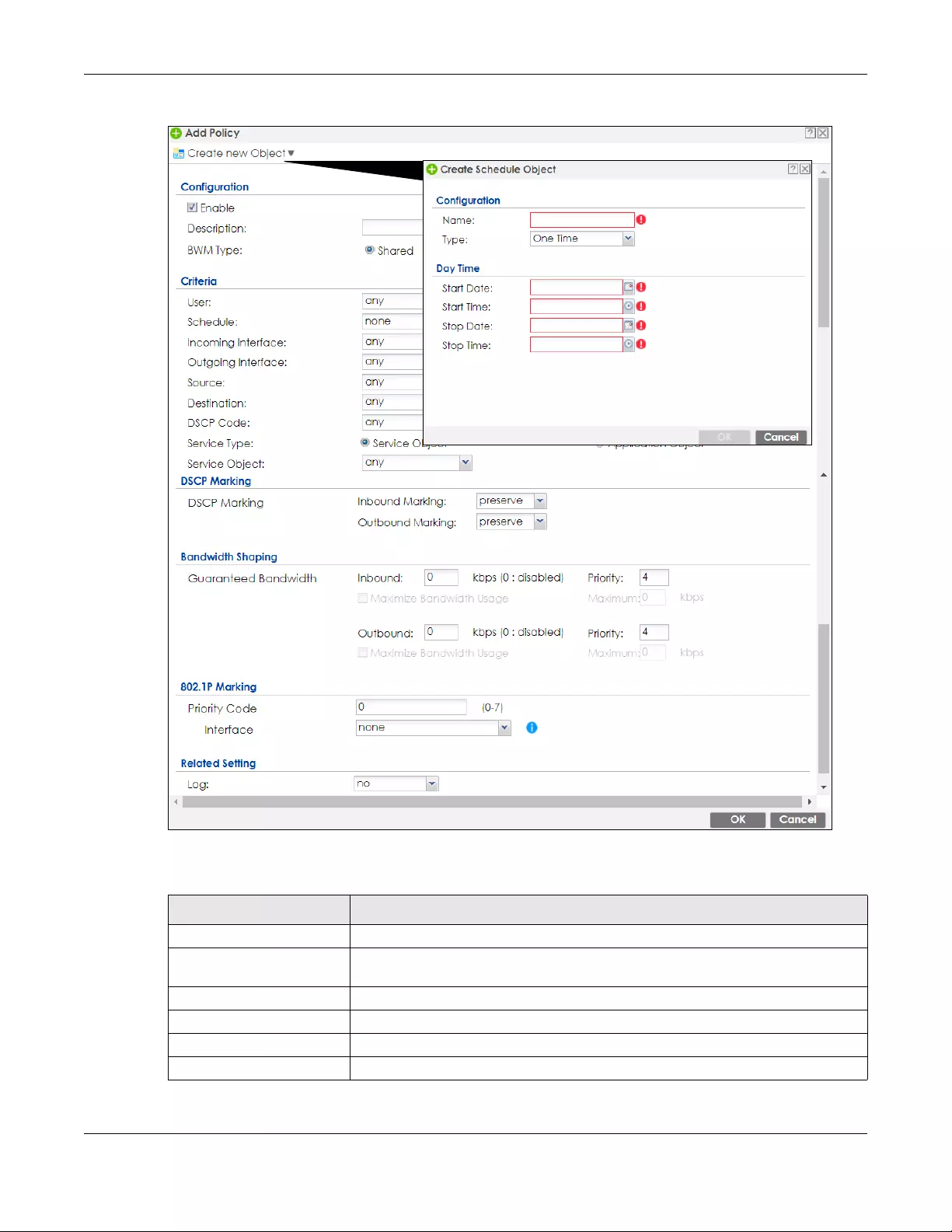
Chapter 22 BWM (Bandwidth Management)
ZyWALL USG FLEX Series User’s Guide
479
Figure 329 Configuration > BWM > Create New Object > Add Schedule
The following table describes the fields in the above screen.
Table 191 Configuration > BWM > Create New Object > Add Schedule
LABEL DESCRIPTION
Name Enter a name for the schedule object of the rule.
Type Select an option from the drop down menu for the schedule object. It will show One
Time or Recurring.
Start Date Click the icon menu on the right to choose a Start Date for the schedule object.
Start Time Click the icon menu on the right to choose a Start Time for the schedule object.
Stop Date Click the icon menu on the right to choose a Stop Date for schedule object.
Stop Time Click the icon menu on the right to choose a Stop Time for the schedule object.

Chapter 22 BWM (Bandwidth Management)
ZyWALL USG FLEX Series User’s Guide
480
Figure 330 Configuration > BWM > Create New Object > Add Address
The following table describes the fields in the above screen.
Table 192 Configuration > BWM > Create New Ob ject > Add Address
LABEL DESCRIPTION
Name Enter a name for the Address object of the rule.
Address Type Select an Address Type from the drop down menu on the right. The Address Types
are Host, Range, Subnet, Interface IP, Interface Subnet, and Interface Gateway.
IP Address Enter an IP address for the Address object.
OK Click OK to save the setting.
Cancel Click Cancel to abandon the setting.

ZyWALL USG FLEX Series User’s Guide
481
CHAPTER 23
Web Authentication
23.1 Web Auth Overview
Web authentication can intercept network traffic, according to the authentication policies, until the
user authenticates his or her connection, usually through a specifically designated login web page. This
means all web page requests can initially be redirected to a special web page that requires users to
authenticate their sessions. Once authentication is successful, they can then connect to the rest of the
network or Internet.
As soon as a user attempt to open a web page, the Zyxel Device reroutes his/her browser to a web
portal page that prompts him/her to log in.
Figure 331 Web Authentication Example
The web authentication page only appears once per authentication session. Unless a user session times
out or he/she closes the connection, he or she generally will not see it again during the same session.
23.1.1 What You Can Do in this Chapter
• Use the Configuration > Web Authentication screens (Section 23.2 on page 482) to create and
manage web authentication policies.
• Use the Configuration > Web Authentication > SSO screen (Section 23.3 on page 502) to configure
how the Zyxel Device communicates with a Single Sign-On agent.

Chapter 23 Web Authentication
ZyWALL USG FLEX Series User’s Guide
482
23.1.2 What You Need to Know
Single Sign-On
A SSO (Single Sign On) agent integrates Domain Controller and Zyxel Device authentication
mechanisms, so that users just need to log in once (single) to get access to permitted resources.
Forced User Authentication
Instead of making users for which user-aware policies have been configured go to the Zyxel Device
Login screen manually, you can configure the Zyxel Device to display the Login screen automatically
whenever it routes HTTP traffic for anyone who has not logged in yet.
Note: This works with HTTP traffic only. The Zyxel Device does not display the Login screen
when users attempt to send other kinds of traffic.
The Zyxel Device does not automatically route the request that prompted the login, however, so users
have to make this request again.
23.2 Web Authentication General Screen
The Web Authentication General screen displays the general web portal settings and web
authentication policies you have configured on the Zyxel Device. Use this screen to enable web
authentication on the Zyxel Device.

Chapter 23 Web Authentication
ZyWALL USG FLEX Series User’s Guide
483
Figure 332 Configuration > Web Authentication > General
The following table gives an overview of the objects you can configure.
Table 193 Configuration > Web Authentication > General
LABEL DESCRIPTION
Global Setting
Enable Web
Authentication
Select the check box to turn on the web authentication feature. Otherwise, clear the check
box to turn it off.
Once enabled, all network traffic is blocked until a client authenticates with the Zyxel Device
through the specifically designated web portal or user agreement page.
Web Portal General Setting
Enable Session
Page
Select this to display a page showing information on the user session after s/he logs in. It
displays remaining time with an option to renew or log out immediately.
Logout IP Specify an IP address that users can use to terminate their sessions manually by entering the IP
address in the address bar of the web browser.
User Agreement
General Setting
Enforce data
collection
Select this to require users to fill in their registration information (name, telephone number,
address and email address) on the User Agreement (PC or mobile) page.
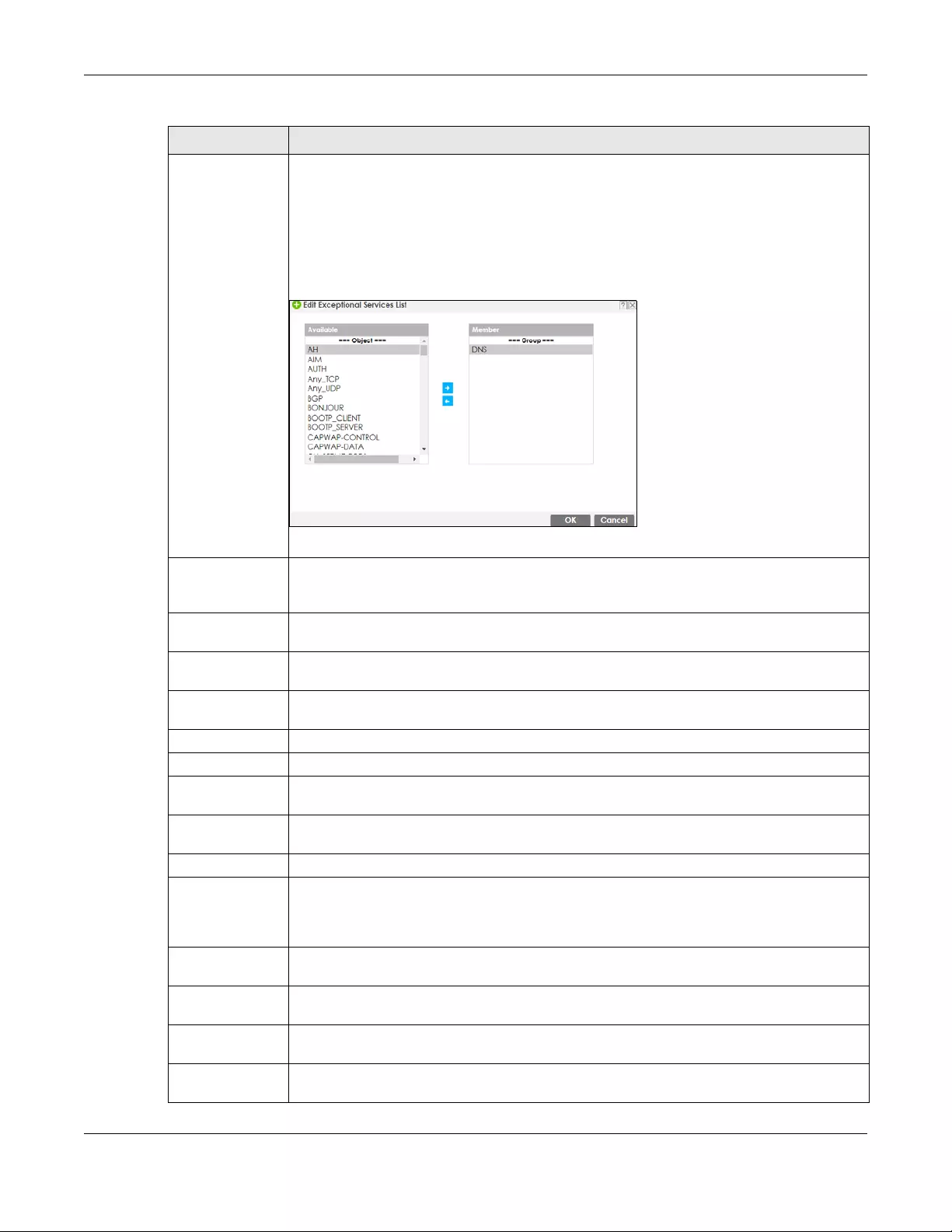
Chapter 23 Web Authentication
ZyWALL USG FLEX Series User’s Guide
484
Exceptional
Services
Use this table to list services that users can access without logging in.
Click Add to change the list’s membership. A screen appears. Available services appear on
the left. Select any services you want users to be able to access without logging in and click
the right arrow button to add them. The member services are on the right. Select any service
that you want to remove from the member list, and click the left arrow button to remove them.
Keeping DNS as a member allows users’ computers to resolve domain names into IP addresses.
Figure 333 Configuration > Web Authentication > Add Exceptional Service
In the table, select one or more entries and click Remove to delete it or them.
Web
Authentication
Policy Summary
Use this table to manage the Zyxel Device’s list of web authentication policies.
Add Click this to create a new entry. Select an entry and click Add to create a new entry after the
selected entry.
Edit Double-click an entry or select it and click Edit to open a screen where you can modify the
entry’s settings.
Remove To remove an entry, select it and click Remove. The Zyxel Device confirms you want to remove
it before doing so.
Activate To turn on an entry, select it and click Activate.
Inactivate To turn off an entry, select it and click Inactivate.
Move To move an entry to a different number in the list, click the Move icon. In the field that appears,
specify the number to which you want to move the interface.
#This field is a sequential value showing the number of the profile. The profile order is not
important.
Status This icon is lit when the entry is active and dimmed when the entry is inactive.
Priority This is the position of the authentication policy in the list. The priority is important as the policies
are applied in order of priority. Default displays for the default authentication policy that the
Zyxel Device uses on traffic that does not match any exceptional service or other
authentication policy. You can edit the default rule but not delete it.
Incoming
Interface
This field displays the interface on which packets for this policy are received.
Source This displays the source address object, including geographic address and FQDN (group)
objects, to which this policy applies.
Destination This displays the destination address object, including geographic address and FQDN (group)
objects, to which this policy applies.
Schedule This field displays the schedule object that dictates when the policy applies. none means the
policy is active at all times if enabled.
Table 193 Configuration > Web Authentication > General (continued)
LABEL DESCRIPTION
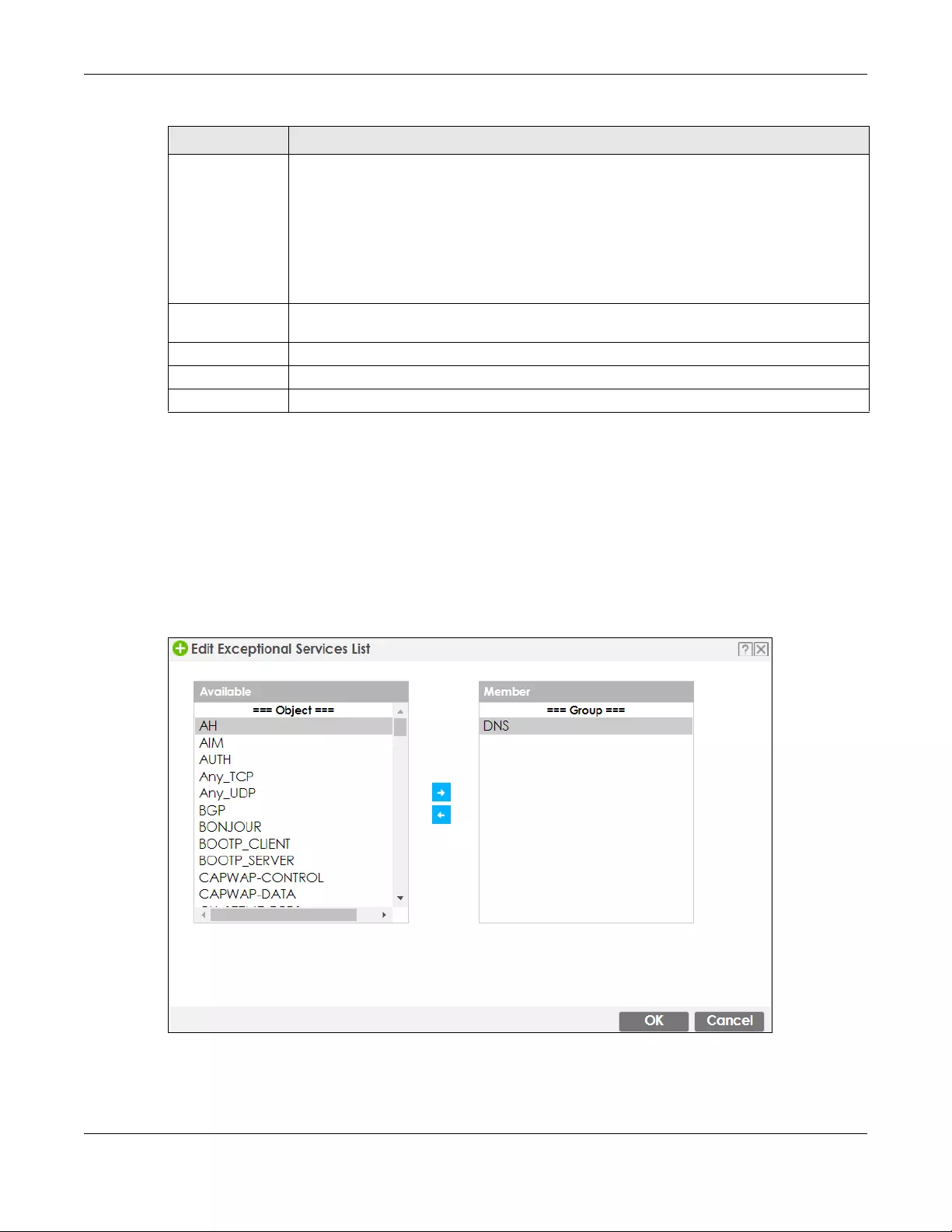
Chapter 23 Web Authentication
ZyWALL USG FLEX Series User’s Guide
485
Creating Exceptional Services
This screen lists services that users can access without logging in. Click Add under Exceptional Services in
the previous screen to display this screen. You can change the list’s membership here. Available
services appear on the left. Select any services you want users to be able to access without logging in
and click the right arrow button -> to add them. The member services are on the right. Select any
service that you want to remove from the member list, and click the left arrow <- button to remove
them. Then click OK to apply the changes and return to the main Web Authentication screen.
Alternatively, click Cancel to discard the changes and return to the main Web Authentication screen.
Figure 334 Configuration > Web Authentication > General > Add Exceptional Service
Authentication This field displays the authentication requirement for users when their traffic matches this policy.
unnecessary - Users do not need to be authenticated.
required - Users need to be authenticated. They must manually go to the login screen or user
agreement page. The Zyxel Device will not redirect them to the login screen.
force - Users need to be authenticated. The Zyxel Device automatically displays the login
screen or user agreement page whenever it routes HTTP traffic for users who have not logged
in yet.
Authentication
Type
This field displays the name of the authentication type profile used in this policy to define how
users authenticate their sessions. It shows n/a if Authentication is set to unnecessary.
Description If the entry has a description configured, it displays here. This is n/a for the default policy.
Apply Click this button to save your changes to the Zyxel Device.
Reset Click this button to return the screen to its last-saved settings.
Table 193 Configuration > Web Authentication > General (continued)
LABEL DESCRIPTION

Chapter 23 Web Authentication
ZyWALL USG FLEX Series User’s Guide
486
Creating/Editing an Authentication Policy
Open the Configuration > Web Authentication > General screen, then click the Add icon or select an
entry and click the Edit icon in the Web Authentication Policy Summary section to open the Auth. Policy
Add/Edit screen. Use this screen to configure an authentication policy.
Figure 335 Configuration > Web Authentication > General > Add Authentication Policy
The following table gives an overview of the objects you can configure.
Table 194 Configuration > Web Authentication > General > Add Authentication Policy
LABEL DESCRIPTION
Create new
Object
Use to configure any new settings objects that you need to use in this screen. Select Address or
Schedule.
Enable Policy Select this check box to activate the authentication policy. This field is available for user-
configured policies.
Description Enter a descriptive name of up to 60 printable ASCII characters for the policy. Spaces are
allowed. This field is available for user-configured policies.
User
Authentication
Policy
Use this section of the screen to determine which traffic requires (or does not require) the
senders to be authenticated in order to be routed.
Incoming
Interface
Select the interface on which packets for this policy are received.
Source Address Select a source address or address group, including geographic address and FQDN (group)
objects, for whom this policy applies. Select any if the policy is effective for every source. This is
any and not configurable for the default policy.
Destination
Address
Select a destination address or address group, including geographic address and FQDN
(group) objects, for whom this policy applies. Select any if the policy is effective for every
destination. This is any and not configurable for the default policy.
Schedule Select a schedule that defines when the policy applies. Otherwise, select none and the rule is
always effective. This is none and not configurable for the default policy.
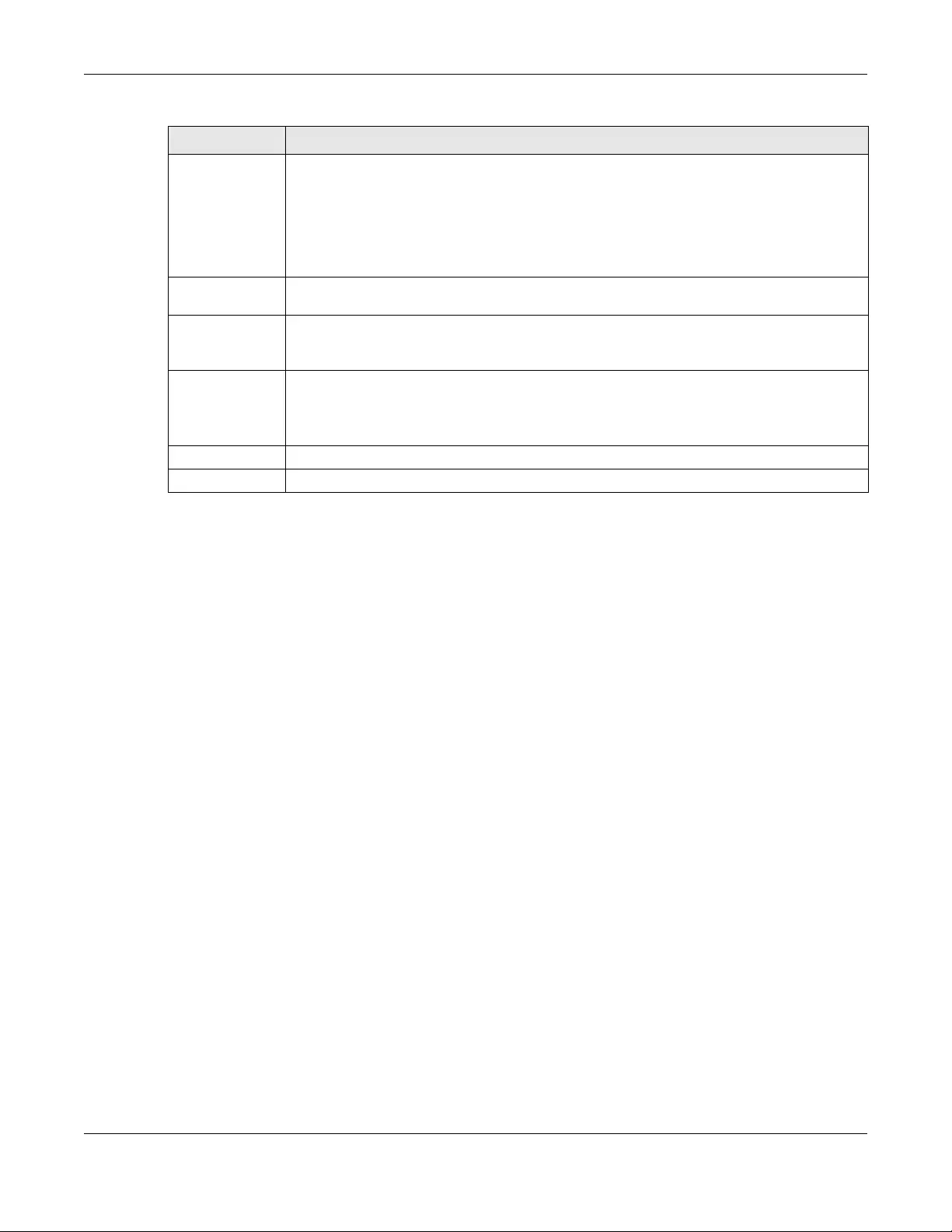
Chapter 23 Web Authentication
ZyWALL USG FLEX Series User’s Guide
487
23.2.1 User-aware Access Control Example
You can configure many policies and security settings for specific users or groups of users. Users can be
authenticated locally by the Zyxel Device or by an external (RADIUS) authentication server.
In this example the users are authenticated by an external RADIUS server at 172.16.1.200. First, set up the
user accounts and user groups in the Zyxel Device. Then, set up user authentication using the RADIUS
server. Finally, set up the policies in the table above.
23.2.1.1 Set Up User Accounts
Set up user accounts in the RADIUS server. This example uses the Web Configurator. If you can export
user names from the RADIUS server to a text file, then you might configure a script to create the user
accounts instead.
1Click Configuration > Object > User/Group > User. Click the Add icon.
2Enter the same user name that is used in the RADIUS server, and set the User Type to ext-user because
this user account is authenticated by an external server. Click OK.
Authentication Select the authentication requirement for users when their traffic matches this policy.
unnecessary - Users do not need to be authenticated.
required - Users need to be authenticated. If Force User Authentication is selected, all HTTP
traffic from unauthenticated users is redirected to a default or user-defined login page.
Otherwise, they must manually go to the login screen. The Zyxel Device will not redirect them to
the login screen.
Single Sign-on This field is available for user-configured policies that require Single Sign-On (SSO). Select this to
have the Zyxel Device enable the SSO feature. You can set up this feature in the SSO screen.
Force User
Authentication
This field is available for user-configured policies that require authentication. Select this to have
the Zyxel Device automatically display the login screen when users who have not logged in yet
try to send HTTP traffic.
Authentication
Type
Select an authentication method.
default-web-portal: the default login page built into the Zyxel Device.
default-user-agreement: the default user agreement page built into the Zyxel Device.
OK Click OK to save your changes back to the Zyxel Device.
Cancel Click Cancel to exit this screen without saving.
Table 194 Configuration > Web Authentication > General > Add Authentication Policy (continued)
LABEL DESCRIPTION
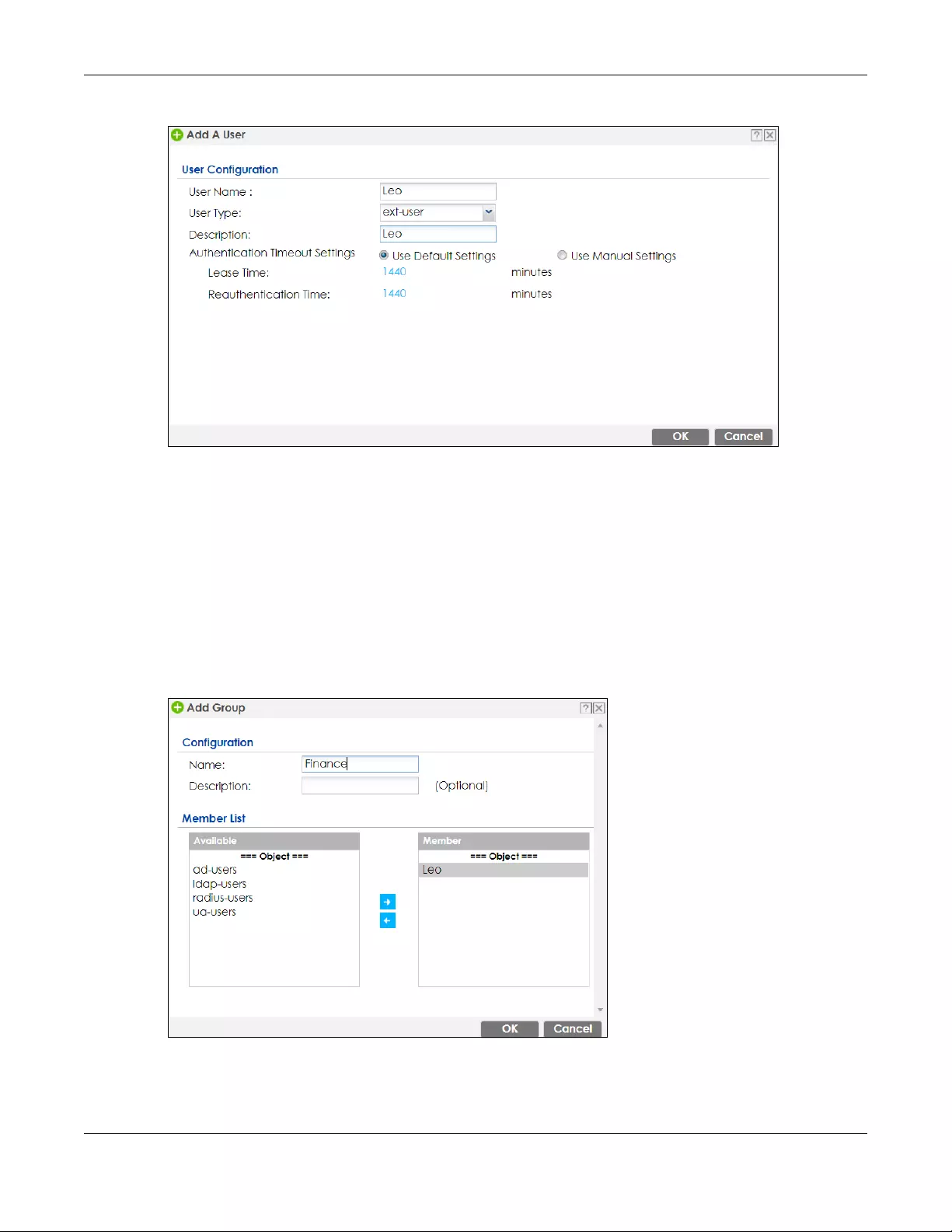
Chapter 23 Web Authentication
ZyWALL USG FLEX Series User’s Guide
488
Figure 336 Configuration > Object > User/Group > User > Add
3Repeat this process to set up the remaining user accounts.
23.2.1.2 Set Up User Groups
Set up the user groups and assign the users to the user groups.
1Click Configuration > Object > User/Group > Group. Click the Add icon.
2Enter the name of the group. In this example, it is “Finance”. Then, select Object/Leo and click the right
arrow to move him to the Member list. This example only has one member in this group, so click OK. Of
course you could add more members later.
Figure 337 Configuration > Object > User/Group > Group > Add
3Repeat this process to set up the remaining user groups.
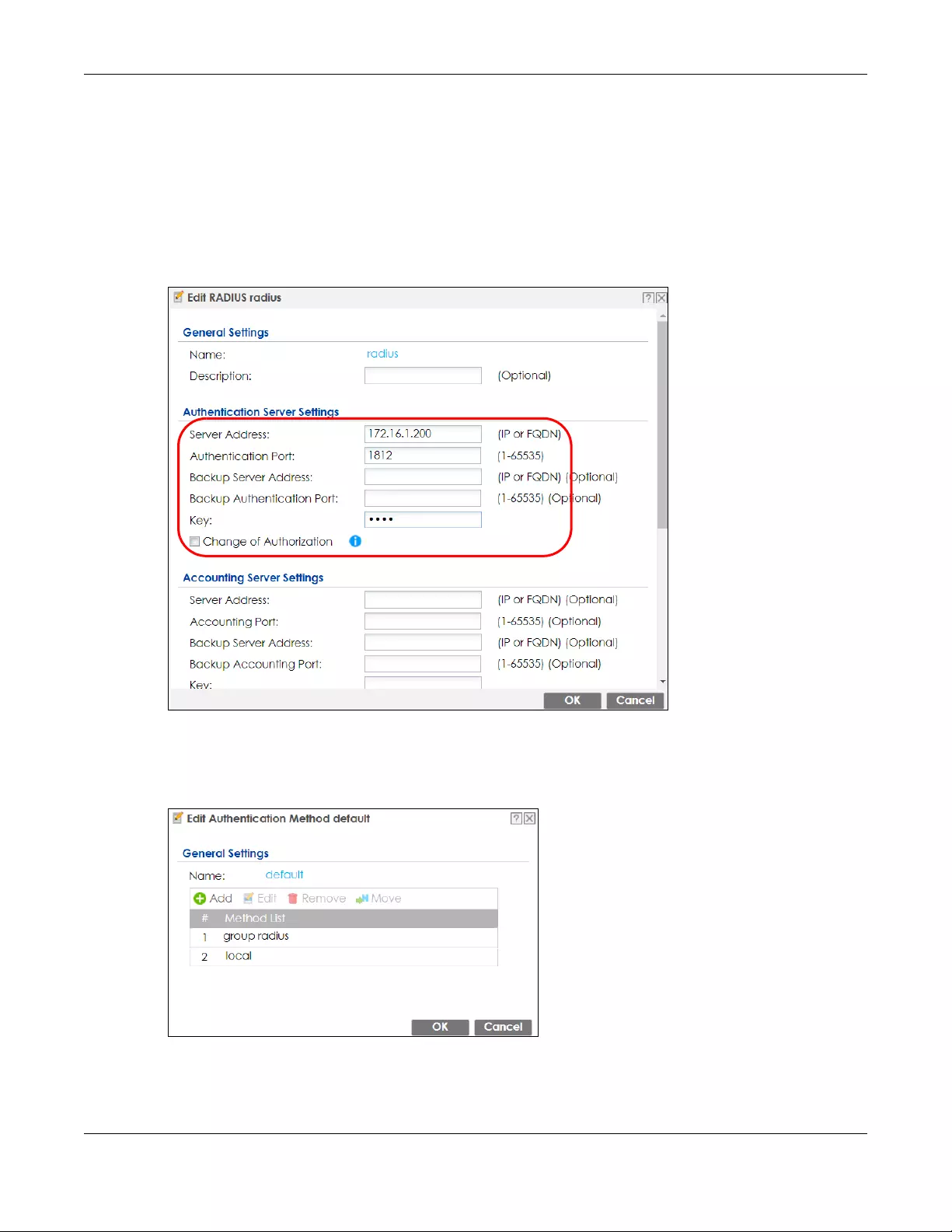
Chapter 23 Web Authentication
ZyWALL USG FLEX Series User’s Guide
489
23.2.1.3 Set Up User Authentication Using the RADIUS Server
This step sets up user authentication using the RADIUS server. First, configure the settings for the RADIUS
server. Then, set up the authentication method, and configure the Zyxel Device to use the
authentication method. Finally, force users to log into the Zyxel Device before it routes traffic for them.
1Click Configuration > Object > AAA Server > RADIUS. Double-click the radius entry. Configure the RADIUS
server’s address, authentication port (1812 if you were not told otherwise), and key. Click OK.
Figure 338 Configuration > Object > AAA Server > RADIUS > Add
2Click Configuration > Object > Auth. Method. Double-click the default entry. Click the Add icon. Select
group radius because the Zyxel Device should use the specified RADIUS server for authentication. Click
OK.
Figure 339 Configuration > Object > Auth. method > Edit
3Click Configuration > Web Authentication. In the Web Authentication > General screen, select Enable
Web Authentication to turn on the web authentication feature and click Apply.

Chapter 23 Web Authentication
ZyWALL USG FLEX Series User’s Guide
490
Figure 340 Configuration > Web Authentication
4In the Web Authentication Policy Summary section, click the Add icon to set up a default policy that has
priority over other policies and forces every user to log into the Zyxel Device before the Zyxel Device
routes traffic for them.
5Select Enable Policy. Enter a descriptive name, “default_policy” for example. Set the Authentication
field to required, and make sure Force User Authentication is selected. Select an authentication type
profile (“default-web-portal” in this example). Keep the rest of the default settings, and click OK.
Note: The users must log in at the Web Configurator login screen before they can use HTTP or
MSN.
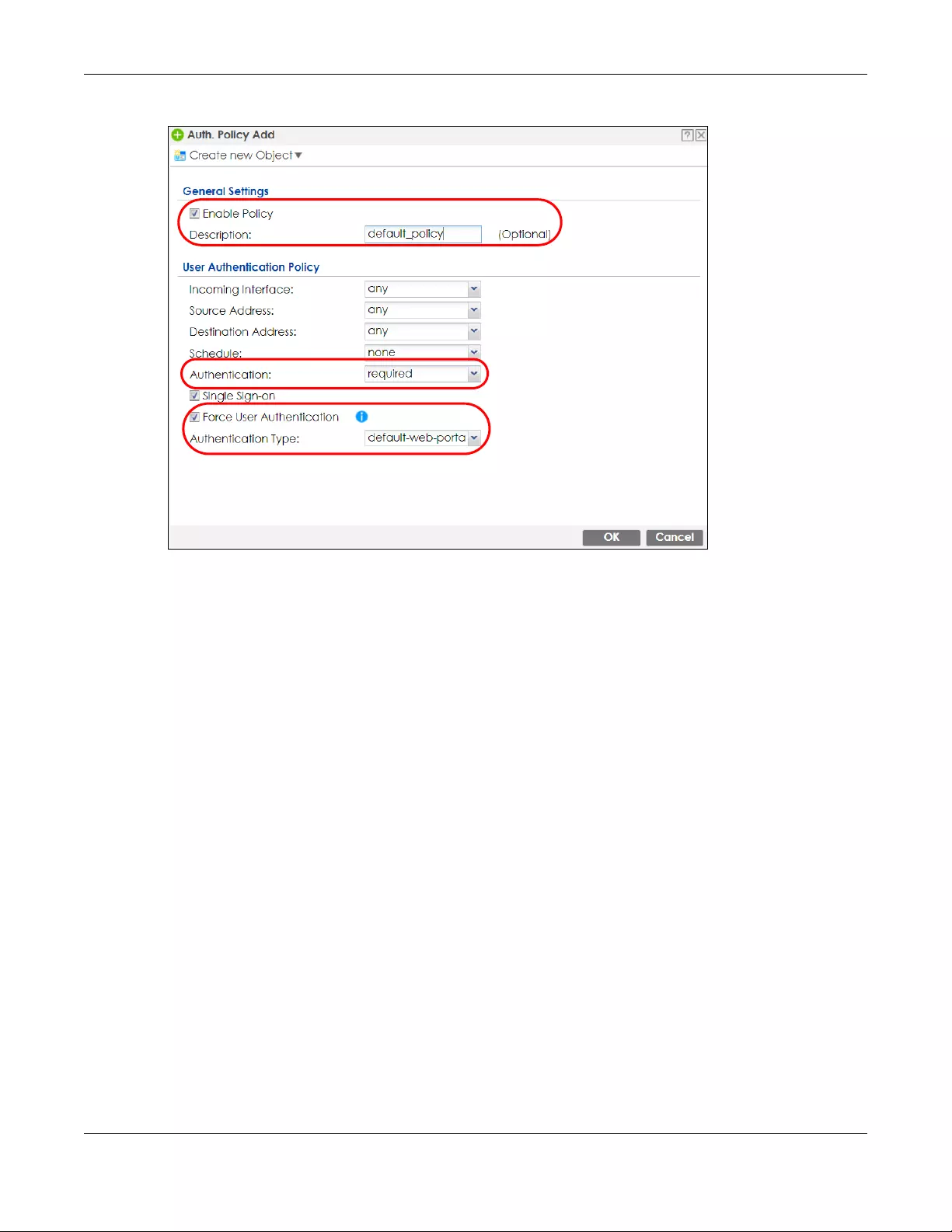
Chapter 23 Web Authentication
ZyWALL USG FLEX Series User’s Guide
491
Figure 341 Configuration > Web Authentication: General: Add
When the users try to browse the web (or use any HTTP application), the login screen appears. They
have to log in using the user name and password in the RADIUS server.
23.2.1.4 User Group Authentication Using the RADIUS Server
The previous example showed how to have a RADIUS server authenticate individual user accounts. If
the RADIUS server has different user groups distinguished by the value of a specific attribute, you can
make a couple of slight changes in the configuration to have the RADIUS server authenticate groups of
user accounts defined in the RADIUS server.
1Click Configuration > Object > AAA Server > RADIUS. Double-click the radius entry. Besides configuring
the RADIUS server’s address, authentication port, and key; set the Group Membership Attribute field to
the attribute that the Zyxel Device is to check to determine to which group a user belongs. This example
uses Class. This attribute’s value is called a group identifier; it determines to which group a user belongs.
In this example the values are Finance, Engineer, Sales, and Boss.
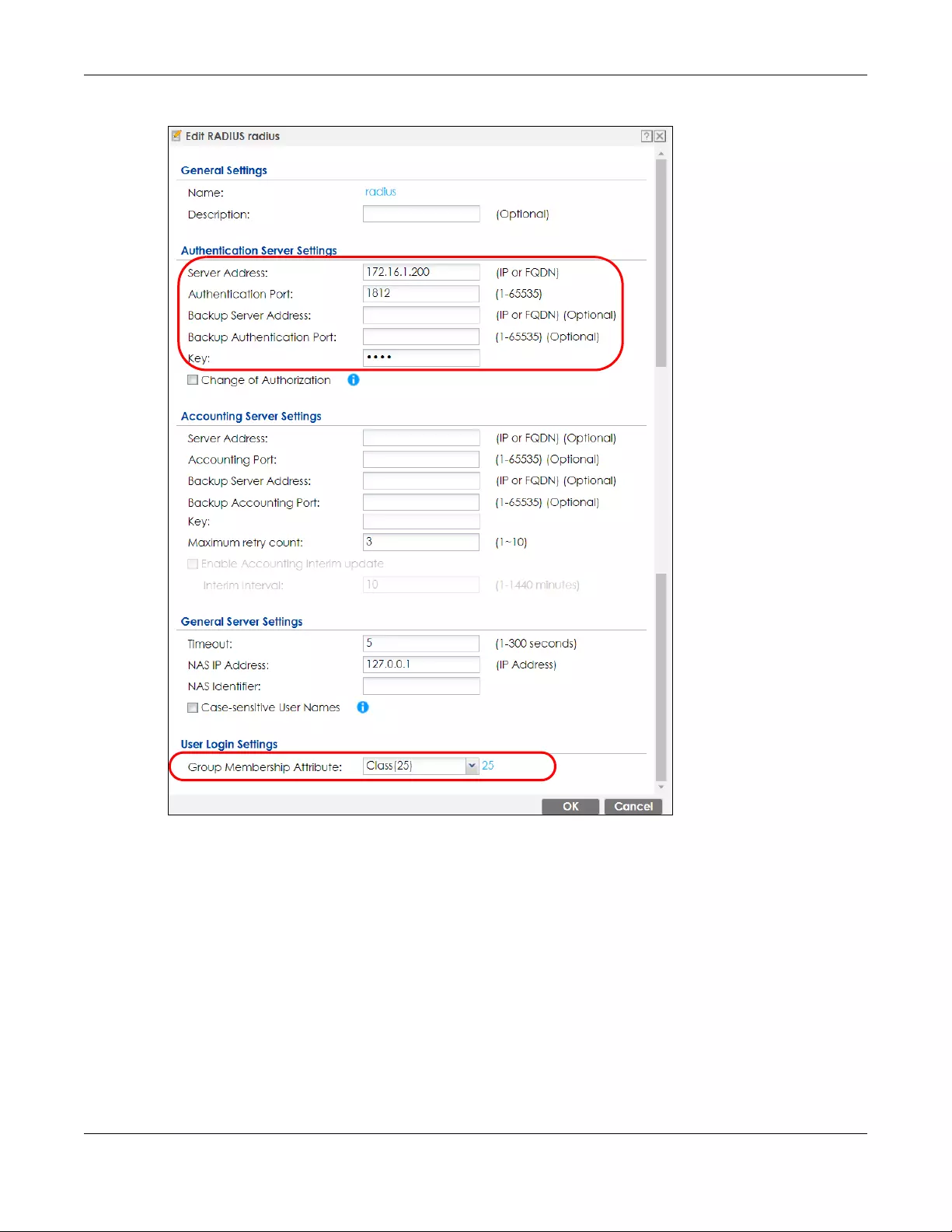
Chapter 23 Web Authentication
ZyWALL USG FLEX Series User’s Guide
492
Figure 342 Configuration > Object > AAA Server > RADIUS > Add
2Now you add ext-group-user objects to identify groups based on the group identifier values. Set up one
user account for each group of user accounts in the RADIUS server. Click Configuration > Object > User/
Group > User. Click the Add icon.
Enter a user name and set the User Type to ext-group-user. In the Group Identifier field, enter Finance,
Engineer, Sales, or Boss and set the Associated AAA Server Object to radius.
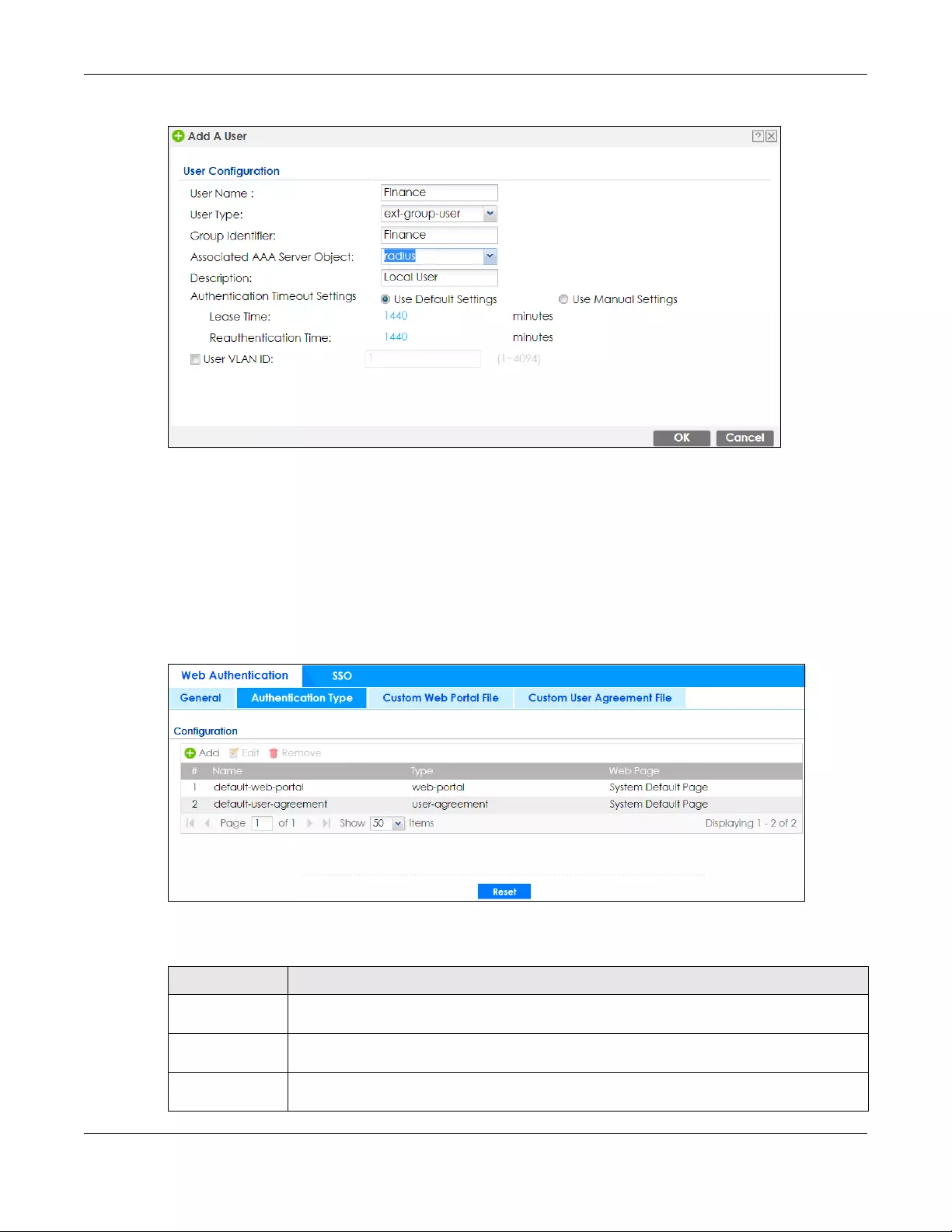
Chapter 23 Web Authentication
ZyWALL USG FLEX Series User’s Guide
493
Figure 343 Configuration > Object > User/Group > User > Add
3Repeat this process to set up the remaining groups of user accounts.
23.2.2 Authentication Type Screen
Use this screen to view, create and manage the authentication type profiles on the Zyxel Device. An
authentication type profile decides which type of web authentication pages to be used for user
authentication. Go to Configuration > Web Authentication and then select the Authentication Type tab
to display the screen.
Figure 344 Configuration > Web Authentication > Authentication Type
The following table describes the labels in this screen.
Table 195 Configuration > Web Authentication > Authentication Type
LABEL DESCRIPTION
Add Click this to create a new entry. Select an entry and click Add to create a new entry after the
selected entry.
Edit Double-click an entry or select it and click Edit to open a screen where you can modify the
entry’s settings.
Remove To remove an entry, select it and click Remove. The Zyxel Device confirms you want to remove
it before doing so.

Chapter 23 Web Authentication
ZyWALL USG FLEX Series User’s Guide
494
Add/Edit an Authentication Type Profile
Click the Add icon or select an entry in the Web Authentication > Authentication Type screen and click
the Edit icon to display the screen. The screen differs depending on what you select in the Type field.
Figure 345 Configuration > Web Authentication > Authentication Type: Add/Edit (Web Portal)
#This field is a sequential value, and it is not associated with a specific entry.
Name This field displays the name of the profile.
default-web-portal: the default login page built into the Zyxel Device.
Note: You can also customize the default login page built into the Zyxel Device in
the System > WWW > Login Page screen.
default-user-agreement: the default user agreement page built into the Zyxel Device.
Type This field displays the type of the web authentication page used by this profile.
Web Page This field displays whether this profile uses the default web authentication page built into the
Zyxel Device (System Default Page) or custom web authentication pages from an external web
server (External Page).
Reset Click Reset to return the screen to its last-saved settings.
Table 195 Configuration > Web Authentication > Authentication Type (continued)
LABEL DESCRIPTION

Chapter 23 Web Authentication
ZyWALL USG FLEX Series User’s Guide
495
Figure 346 Configuration > Web Authentication > Authentication Type: Add/Edit (User Agreement)
The following table describes the labels in this screen.
Table 196 Configuration > Web Authentication > Authentication Type: Add/Edit
LABEL DESCRIPTION
Type Select the type of the web authentication page through which users authenticate their
connections.
If you select User Agreement, by agreeing to the policy of user agreement, users can access
the Internet without a guest account.
Profile Name Enter a name for the profile.
You can use up to 31 alphanumeric characters (A-Z, a-z, 0-9) and underscores (_). Spaces are
not allowed. The first character must be a letter.
The following fields are available if you set Type to Web Portal.
Internal Web
Portal
Select this to use the web portal pages uploaded to the Zyxel Device.
The login page appears whenever the web portal intercepts network traffic, preventing
unauthorized users from gaining access to the network.
Preview Select to display the page you uploaded to the Zyxel Device in a new frame.
Note: You must select a custom file uploaded to the Zyxel Device before you can
preview the pages.
Customize file Select the file name of the web portal file in the Zyxel Device.
Note: You can upload zipped custom web portal files to the Zyxel Device using the
Configuration > Web Authentication > Web Portal Customize File screen.

Chapter 23 Web Authentication
ZyWALL USG FLEX Series User’s Guide
496
External Web
Portal
Select this to use a custom login page from an external web portal instead of the one
uploaded to the Zyxel Device. You can configure the look and feel of the web portal page.
Login URL Specify the login page’s URL; for example, http://IIS server IP Address/login.html.
The Internet Information Server (IIS) is the web server on which the web portal files are installed.
Logout URL Specify the logout page’s URL; for example, http://IIS server IP Address/logout.html.
The Internet Information Server (IIS) is the web server on which the web portal files are installed.
Welcome URL Specify the welcome page’s URL; for example, http://IIS server IP Address/welcome.html.
Users will be redirected to the welcome page after authentication. This field is optional.
The Internet Information Server (IIS) is the web server on which the web portal files are installed.
Session URL Specify the session page’s URL; for example, http://IIS server IP Address/session.html.
The Internet Information Server (IIS) is the web server on which the web portal files are installed.
Error URL Specify the error page’s URL; for example, http://IIS server IP Address/error.html.
The Internet Information Server (IIS) is the web server on which the web portal files are installed.
Download Click this to download an example external web portal file for your reference.
The following fields are available if you set Type to User Agreement.
Enable Idle
Detection
This is applicable for access users.
Select this check box if you want the Zyxel Device to monitor how long each access user is
logged in and idle (in other words, there is no traffic for this access user). The Zyxel Device
automatically logs out the access user once the Idle timeout has been reached.
Idle timeout This is applicable for access users.
This field is effective when Enable Idle Detection is checked. Type the number of minutes each
access user can be logged in and idle before the Zyxel Device automatically logs out the
access user.
Reauthentication
Time
Enter the number of minutes the user can be logged into the Zyxel Device in one session before
having to log in again.
Internal User
Agreement
Select this to use the user agreement pages in the Zyxel Device. The user agreement page
appears whenever the Zyxel Device intercepts network traffic, preventing unauthorized users
from gaining access to the network.
Preview Select to display the page you uploaded to the Zyxel Device in a new frame.
Note: You must select a custom file uploaded to the Zyxel Device before you can
preview the pages.
Customize file Select the file name of the user agreement file in the Zyxel Device.
Note: You can upload zipped custom user agreement files to the Zyxel Device using
the Configuration > Web Authentication > User Agreement Customize File
screen.
External User
Agreement
Select this to use custom user agreement pages from an external web server instead of the
default one built into the Zyxel Device. You can configure the look and feel of the user
agreement page.
Agreement
URL Specify the user agreement page’s URL; for example, http://IIS server IP Address/logout.html.
The Internet Information Server (IIS) is the web server on which the user agreement files are
installed.
Table 196 Configuration > Web Authentication > Authentication Type: Add/Edit (continued)
LABEL DESCRIPTION
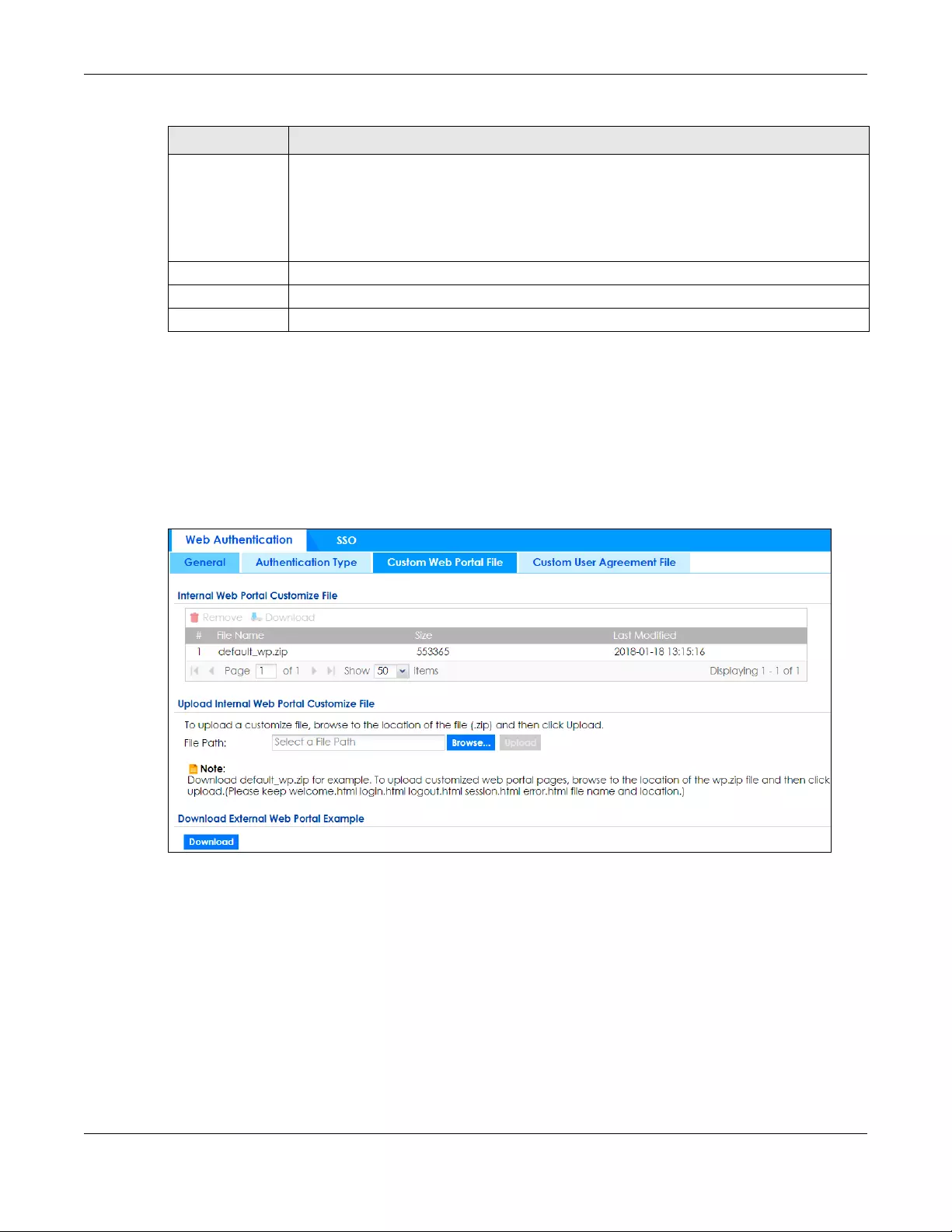
Chapter 23 Web Authentication
ZyWALL USG FLEX Series User’s Guide
497
23.2.3 Custom Web Portal / User Agreement File Screen
Use this screen to upload the zipped custom web portal or user agreement files to the Zyxel Device. You
can also download the custom files to your computer.
Click Configuration > Web Authentication and then select the Custom Web Portal File or Custom User
Agreement File tab to display the screen.
Figure 347 Configuration > Web Authentication > Custom Web Portal File
Welcome URL Specify the welcome page’s URL; for example, http://IIS server IP Address/welcome.html.
The Internet Information Server (IIS) is the web server on which the user agreement files are
installed.
If you leave this field blank, the Zyxel Device will use the welcome page of internal user
agreement file.
Download Click this to download an example external user agreement file for your reference.
OK Click OK to save your changes back to the Zyxel Device.
Cancel Click Cancel to exit this screen without saving.
Table 196 Configuration > Web Authentication > Authentication Type: Add/Edit (continued)
LABEL DESCRIPTION
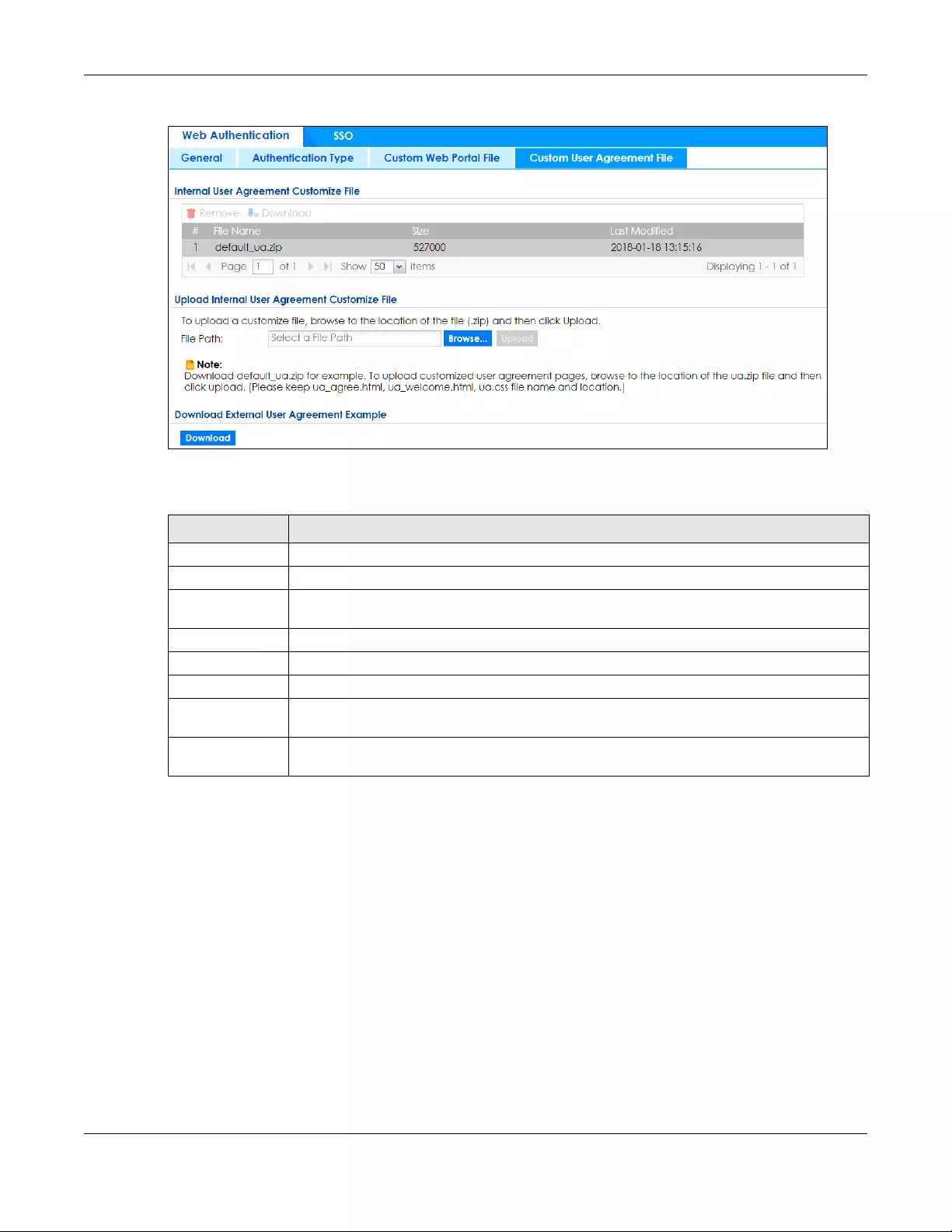
Chapter 23 Web Authentication
ZyWALL USG FLEX Series User’s Guide
498
Figure 348 Configuration > Web Authentication > Custom User Agreement File
The following table describes the labels in this screen.
23.2.4 Facebook Wi-Fi Screen
The Zyxel Device supports Facebook Wi-Fi to let users check in to a business on Facebook for free
Internet access after connecting to the Zyxel Device’s wireless or LAN network. Users then have the
option to like the Facebook fan page. This helps promote the Facebook page and then promote the
business.
Use this screen to turn on Facebook Wi-Fi on the Zyxel Device and select a Facebook Page. You should
already have:
• connected the Zyxel Device to the Internet and registered the Zyxel Device with myZyxel.
• set up a Facebook fan page associated with the business location.
• created an authentication policy in the Configuration > Web Authentication: General screen to
redirect the matched users to the Facebook page before they can have free Internet access.
Table 197 Configuration > Web Authentication > Custom Web Portal / User Agreement File
LABEL DESCRIPTION
Remove Click a file’s row to select it and click Remove to delete it from the Zyxel Device.
Download Click a file’s row to select it and click Download to save the zipped file to your computer.
#This column displays the index number for each file entry. This field is a sequential value, and it is
not associated with a specific entry.
File Name This column displays the label that identifies a web portal or user agreement file.
Size This column displays the size (in KB) of a file.
Last Modified This column displays the date and time that the individual files were last changed or saved.
Browse / Upload Click Browse... to find the zipped file you want to upload, then click the Upload button to put it
on the Zyxel Device.
Download Click this to download an example external web portal or user agreement file for your
reference.

Chapter 23 Web Authentication
ZyWALL USG FLEX Series User’s Guide
499
Note: If you disable Facebook Wi-Fi or reset the Facebook page settings later, the Zyxel
Device automatically logs out existing users who have authenticated their connections
via Facebook Wi-Fi.
Click Configuration > Web Authentication and then select the Facebook Wi-Fi tab to display the
following screen. If your Zyxel Device is not registered at myZyxel, the screen displays a message. Please
register your device on portal.myZyxel.com to activate configure Facebook Wi-Fi. Click here to check
register status.'
Figure 349 Configuration > Web Authentication: Facebook Wi-Fi
The following table describes the labels in this screen.
23.2.4.1 How to Configure Facebook for Facebook Wi-Fi
This section shows you what to do if you have not yet set up a Facebook fan page and see the following
message ‘This device is not paired with facebook. Please configure this device’.
Table 198 Configuration > Web Authentication: Facebook Wi-Fi
LABEL DESCRIPTION
Enable Facebook
Wi-Fi
Select the check box and click Apply to turn on Facebook Wi-Fi on the Zyxel Device.
Configure Click this button to open the Facebook Wi-Fi configuration screen in a new window, where you
can select the Facebook Page associated with your location and configure bypass mode and
session length.
Note: You should have registered your Zyxel Device with myZyxel before you can
click Configure to set up Facebook Wi-Fi on the Zyxel Device.
Reset FB Page Click this button to remove your Facebook Page setting.
Enable user idle
detection
Select this check box if you want the Zyxel Device to monitor how long each user
(authenticated via Facebook Wi-Fi) is idle (in other words, there is no traffic for this user).
User idle timeout Specify the User idle timeout between 1 and 60 minutes. The Zyxel Device automatically
disconnects a user (authenticated via Facebook Wi-Fi) from the network after a period of
inactivity.
Apply Click Apply to save your changes back to the Zyxel Device.
Reset Click Reset to return the screen to its last-saved settings.

Chapter 23 Web Authentication
ZyWALL USG FLEX Series User’s Guide
500
1Click Configure.
2Log into Facebook and click Create Page.
3Select the Facebook page type and fill in the information prompts to create a Facebook page. Then
click Get Started.
4In the following screen, select the page just created and click Save Settings. Your Facebook page is
now paired with Facebook Wi-Fi.
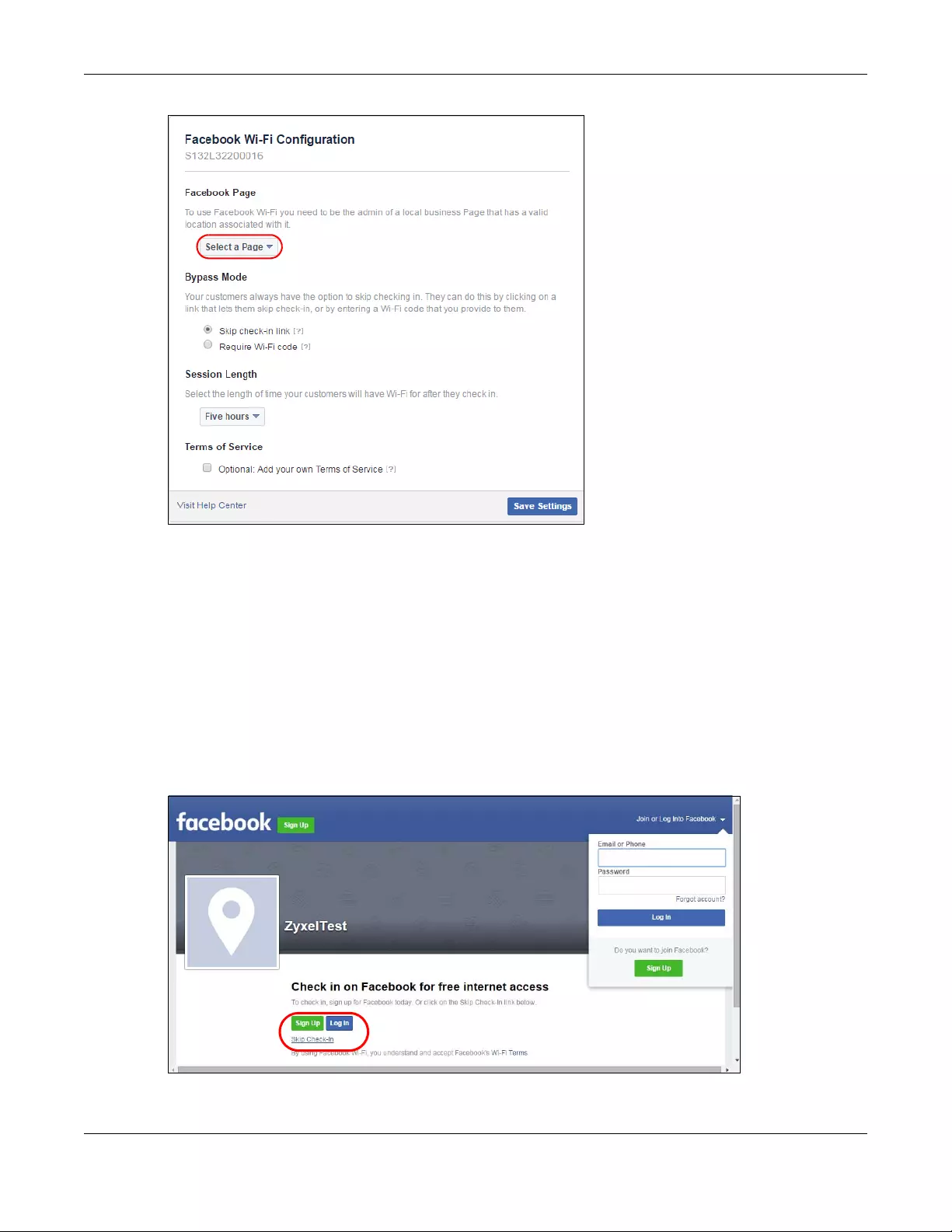
Chapter 23 Web Authentication
ZyWALL USG FLEX Series User’s Guide
501
23.2.4.2 How to use the Zyxel Device’s Facebook Wi-Fi
This section shows how users use Facebook Wi-Fi to access the Internet for free after you enable and set
up Facebook Wi-Fi on the Zyxel Device.
1Connect to the Zyxel Device’s wireless or LAN network.
2Open a web browser from the connected computer or mobile device.
3The Facebook Page you specified displays. By default, users can log in and check in to the location
associated with the Facebook Page, or click a link to skip check-in. If you set Bypass Mode to Require
Wi-Fi code in the Facebook Wi-Fi configuration screen, users need to enter the Wi-Fi password you
provided.
4Users then can click Continue Browsing to surf the Internet through the Zyxel Device.

Chapter 23 Web Authentication
ZyWALL USG FLEX Series User’s Guide
502
23.3 SSO Overview
The SSO (Single Sign-On) function integrates Domain Controller and Zyxel Device authentication
mechanisms, so that users just need to log in once (single login) to get access to permitted resources.
In the following figure, U user logs into a Domain Controller (DC) which passes the user’s login credentials
to the SSO agent. The SSO agent checks that these credentials are correct with the AD server, and if the
AD server confirms so, the SSO then notifies the Zyxel Device to allow access for the user to the permitted
resource (Internet access, for example).
Note: The Zyxel Device, the DC, the SSO agent and the AD server must all be in the same
domain and be able to communicate with each other.
SSO does not support IPv6, LDAP or RADIUS; you must use it in an IPv4 network
environment with Windows AD (Active Directory) authentication database.
You must enable Web Authentication in the Configuration > Web Authentication
screen.
Figure 350 SSO Overview
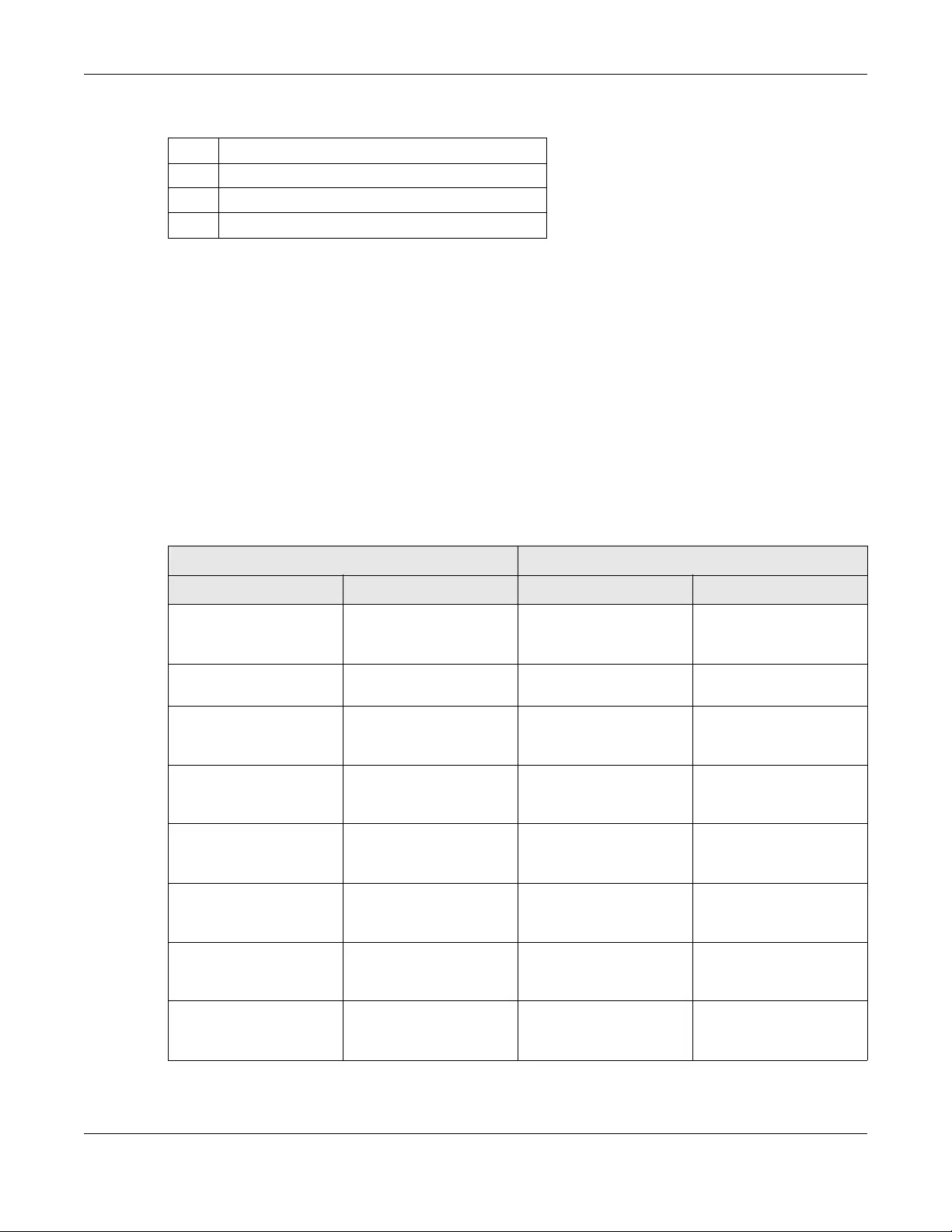
Chapter 23 Web Authentication
ZyWALL USG FLEX Series User’s Guide
503
Install the SSO Agent on one of the following platforms:
• Windows 7 Professional (32-bit and 64-bit)
• Windows Server 2008 Enterprise (32-bit and 64-bit)
• Windows 2008 R2 (64-bit)
• Windows Server 2012 (64-bit)
23.4 SSO - Zyxel Device Configuration
This section shows what you have to do on the Zyxel Device in order to use SSO.
UUser
DC Domain Controller
SSO Single Sign-On agent
AD Active Directory
Table 199 Zyxel Device - SSO Agent Field Mapping
ZYXEL DEVICE SSO
SCREEN FIELD SCREEN FIELD
Web Authentication >
SSO
Listen Port Agent Configuration
Page > Gateway
Setting
Gateway Port
Web Authentication >
SSO
Primary Agent Port Agent Configuration
Page
Agent Listening Port
Object > User/Group >
User > Add
Group Identifier Agent Configuration
Page > Configure
LDAP/AD Server
Group Membership
Object > AAA Server >
Active Directory > Add
Base DN Agent Configuration
Page > Configure
LDAP/AD Server
Base DN
Object > AAA Server >
Active Directory > Add
Bind DN Agent Configuration
Page > Configure
LDAP/AD Server
Bind DN
Object > User/Group >
User > Add
User Name Agent Configuration
Page > Configure
LDAP/AD Server
Login Name Attribute
Object > AAA Server >
Active Directory > Add
Server Address Agent Configuration
Page > Configure
LDAP/AD Server
Server Address
Network > Interface >
Ethernet > wan (IPv4)
IP address Agent Configuration
Page > Gateway
Setting
Gateway IP
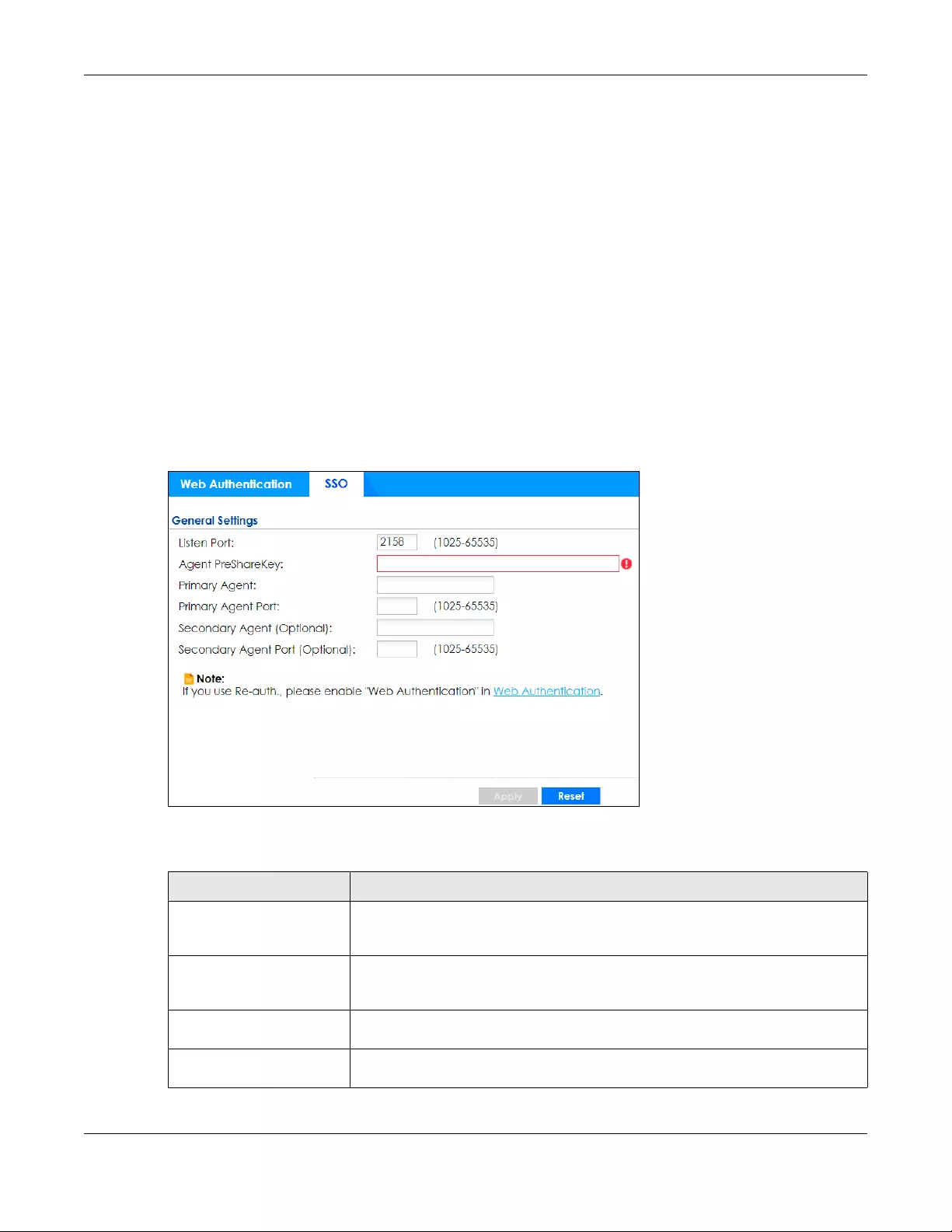
Chapter 23 Web Authentication
ZyWALL USG FLEX Series User’s Guide
504
23.4.1 Configuration Overview
These are the screens you need to configure:
•Configure the Zyxel Device to Communicate with SSO on page 504
•Enable Web Authentication on page 505
•Create a Security Policy on page 506
•Configure User Information on page 507
•Configure an Authentication Method on page 508
•Configure Active Directory on page 509 or Configure Active Directory on page 509
23.4.2 Configure the Zyxel Device to Communicate with SSO
Use Configuration > Web Authentication > SSO to configure how the Zyxel Device communicates with
the Single Sign-On (SSO) agent.
Figure 351 Configuration > Web Authentication > SSO
The following table gives an overview of the objects you can configure.
Table 200 Configuration > Web Authentication > SSO
LABEL DESCRIPTION
Listen Port The default agent listening port is 2158. If you change it on the Zyxel Device, then
change it to the same number in the Gateway Port field on the SSO agent too. Type
a number ranging from 1025 to 65535.
Agent PreShareKey Type 8-32 printable ASCII characters or exactly 32 hex characters (0-9; a-f). The
Agent PreShareKey is used to encrypt communications between the Zyxel Device
and the SSO agent.
Primary Agent Type the IPv4 address of the SSO agent. The Zyxel Device and the SSO agent must
be in the same domain and be able to communicate with each other.
Primary Agent Port Type the same port number here as in the Agent Listening Port field on the SSO
agent. Type a number ranging from 1025 to 65535.
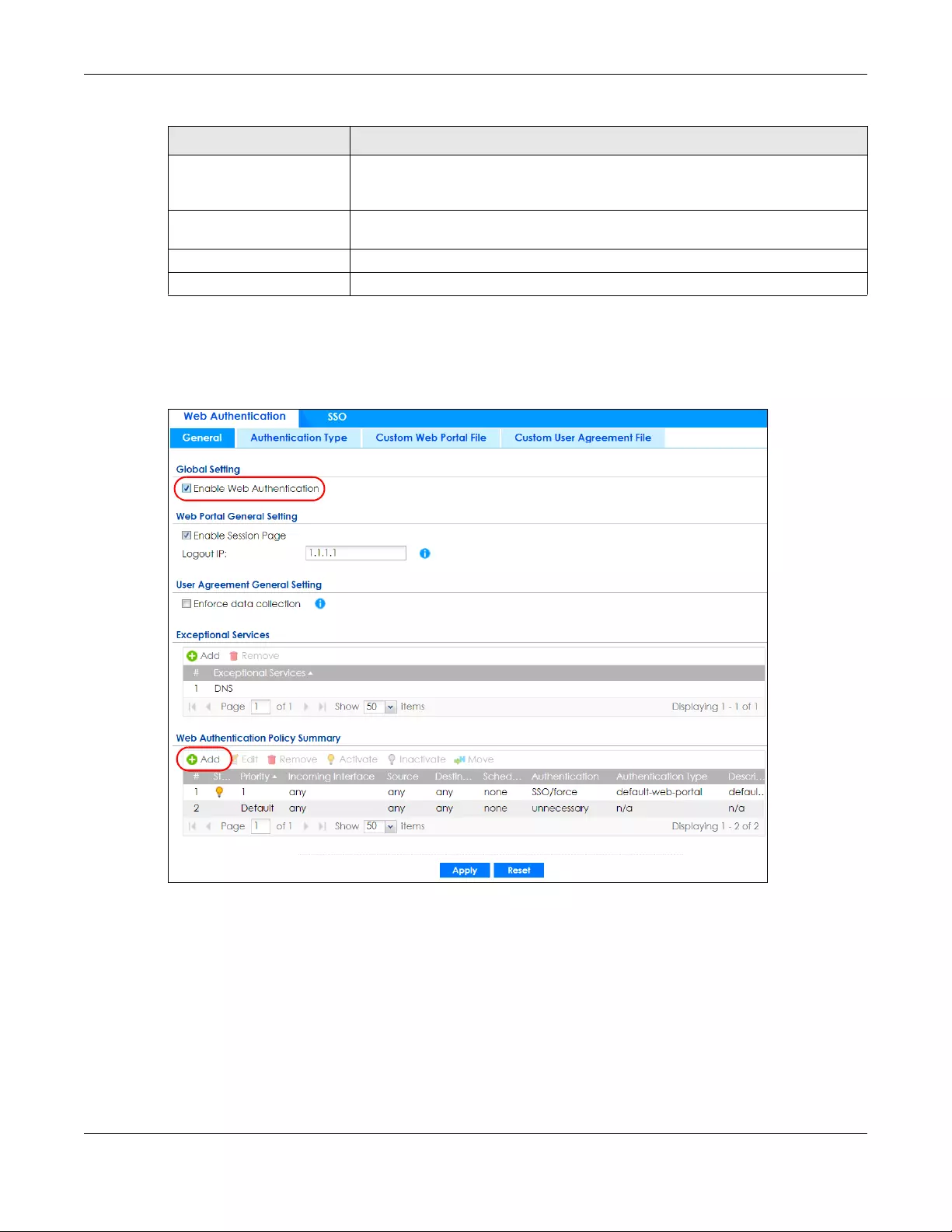
Chapter 23 Web Authentication
ZyWALL USG FLEX Series User’s Guide
505
23.4.3 Enable Web Authentication
Enable Web Authentication and add a web authentication policy.
Make sure you select Enable Policy, Single Sign-On and choose required in Authentication.
Do NOT select any as the source address unless you want all incoming connections to be
authenticated!
Secondary Agent Address
(Optional)
Type the IPv4 address of the backup SSO agent if there is one. The Zyxel Device and
the backup SSO agent must be in the same domain and be able to communicate
with each other.
Secondary Agent Port
(Optional)
Type the same port number here as in the Agent Listening Port field on the backup
SSO agent if there is one. Type a number ranging from 1025 to 65535.
Apply Click this button to save your changes to the Zyxel Device.
Reset Click this button to return the screen to its last-saved settings
Table 200 Configuration > Web Authentication > SSO
LABEL DESCRIPTION
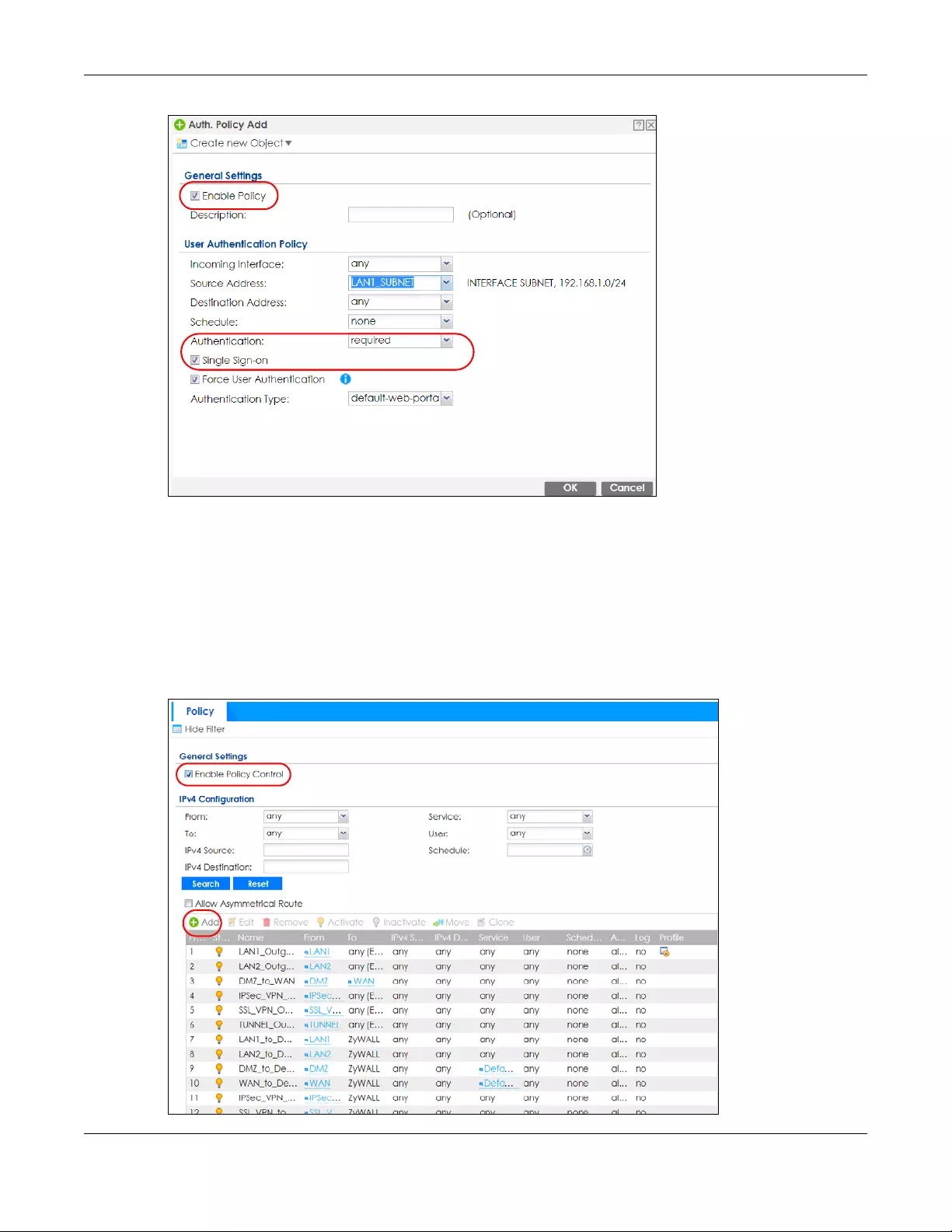
Chapter 23 Web Authentication
ZyWALL USG FLEX Series User’s Guide
506
See Table 193 on page 483 and Table 194 on page 486 for more information on configuring these
screens.
23.4.4 Create a Security Policy
Configure a Security Policy for SSO traffic source and destination direction in order to prevent the
security policy from blocking this traffic. Go to Configuration > Security Policy > Policy Control and add a
new policy if a default one does not cover the SSO web authentication traffic direction.

Chapter 23 Web Authentication
ZyWALL USG FLEX Series User’s Guide
507
Configure the fields as shown in the following screen. Configure the source and destination addresses
according to the SSO web authentication traffic in your network.
23.4.5 Configure User Information
Configure a User account of the ext-group-user type.
Configure Group Identifier to be the same as Group Membership on the SSO agent.

Chapter 23 Web Authentication
ZyWALL USG FLEX Series User’s Guide
508
23.4.6 Configure an Authentication Method
Configure Active Directory (AD) for authentication with SSO.
Choose group ad as the authentication server for SSO.
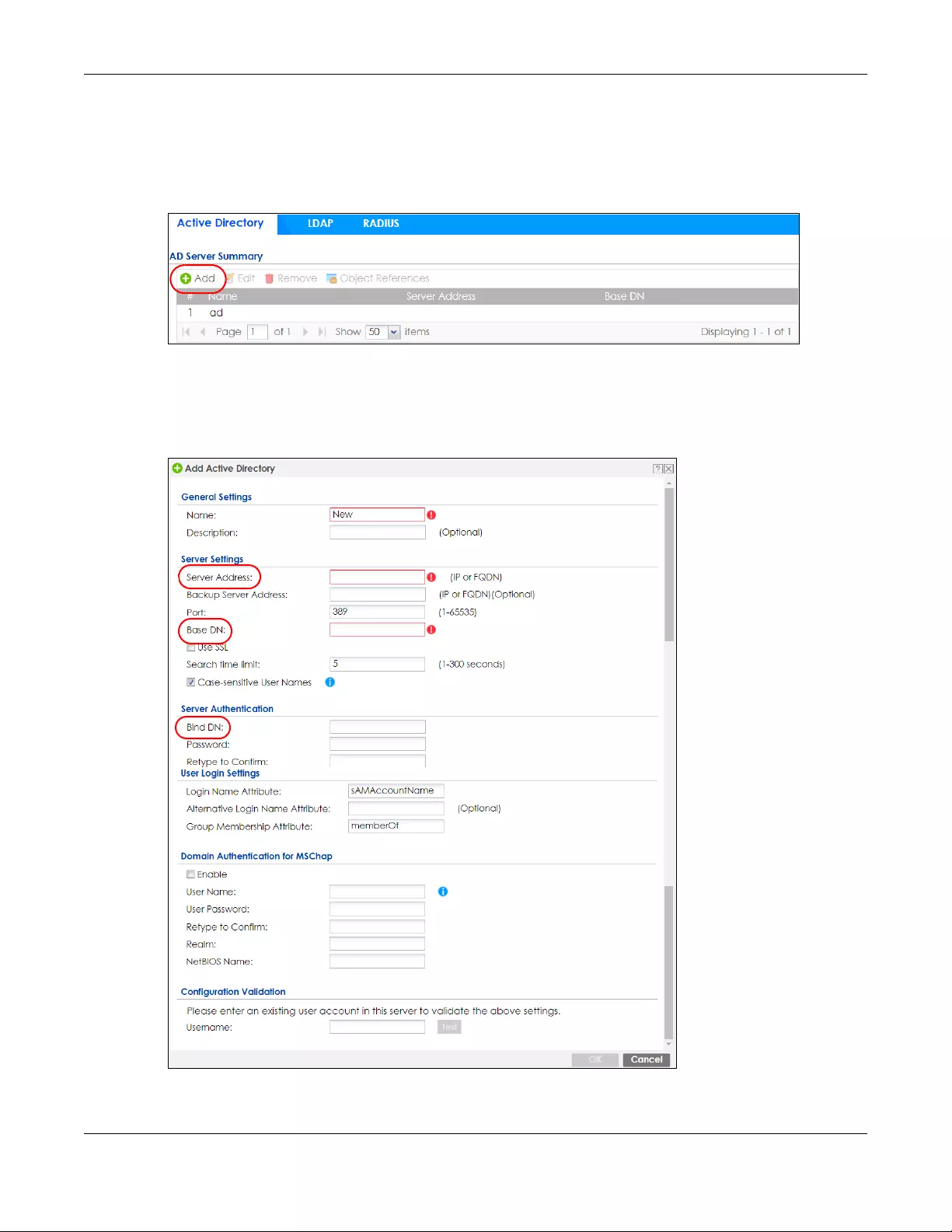
Chapter 23 Web Authentication
ZyWALL USG FLEX Series User’s Guide
509
23.4.7 Configure Active Directory
You must configure an Active Directory (AD) server in AAA Setup to be the same as AD configured on
the SSO agent.
The default AD server port is 389. If you change this, make sure you make the same changes on the SSO.
Configure the Base DN exactly the same as on the Domain Controller and SSO. Bind DN is a user name
and password that allows the Zyxel Device to join the domain with administrative privileges. It is a
required field.
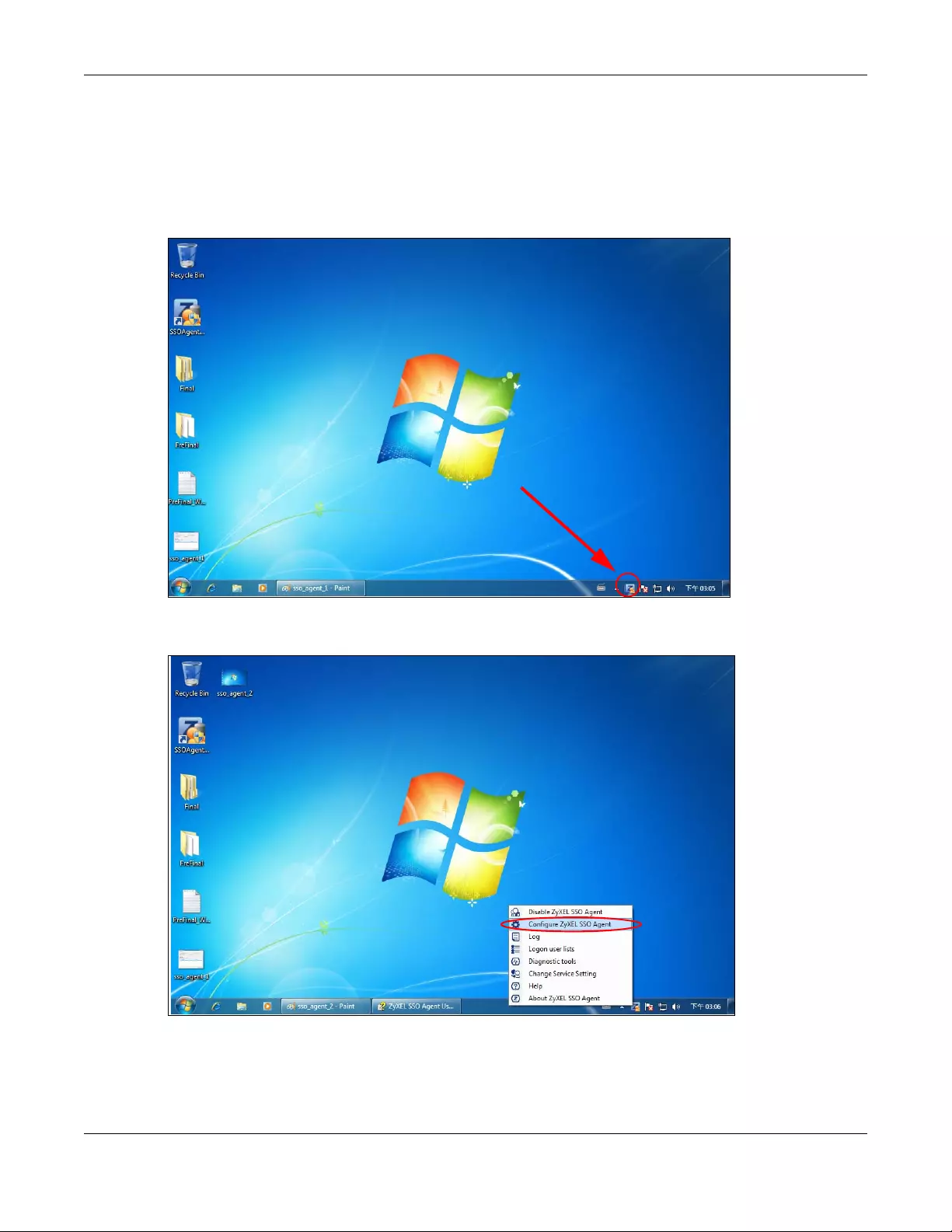
Chapter 23 Web Authentication
ZyWALL USG FLEX Series User’s Guide
510
23.5 SSO Agent Configuration
This section shows what you have to do on the SSO agent in order to work with the Zyxel Device.
After you install the SSO agent, you will see an icon in the system tray (bottom right of the screen)
Right-click the SSO icon and select Configure Zyxel SSO Agent.
Configure the Agent Listening Port, AD server exactly as you have done on the Zyxel Device. Add the
Zyxel Device IP address as the Gateway. Make sure the Zyxel Device and SSO agent are able to
communicate with each other.
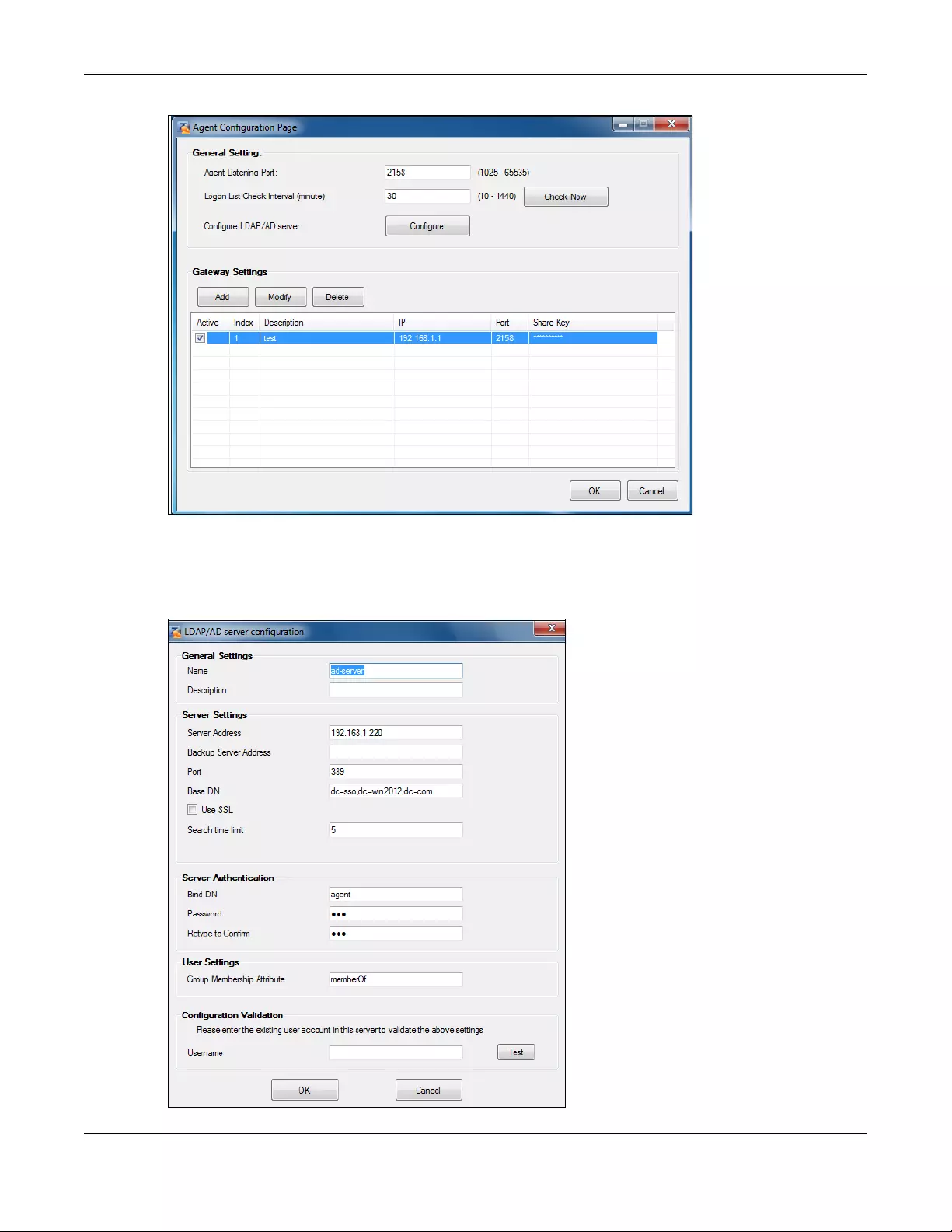
Chapter 23 Web Authentication
ZyWALL USG FLEX Series User’s Guide
511
Configure the Server Address, Port, Base DN, Bind DN, Login Name Attribute and Group Membership for
the AD server settings exactly as you have done on the Zyxel Device. Group Membership is called Group
Identifier on the Zyxel Device.
LDAP/AD Server Configuration

Chapter 23 Web Authentication
ZyWALL USG FLEX Series User’s Guide
512
Configure the Gateway IP address, Gateway Port and PreShareKey exactly as you have done in the
Zyxel Device Configuration > Web Authen tication > SSO screen. If you want to use Generate Key to have
the SSO create a random password, select Check to show PreShareKey as clear Text so as to see the
password, then copy and paste it to the Zyxel Device.
After all SSO agent configurations are done, right-click the SSO icon in the system tray and select Enable
Zyxel SSO Agent.

ZyWALL USG FLEX Series User’s Guide
513
CHAPTER 24
Hotspot
24.1 Overview
See Section 1.1.1 on page 27 to see which models support Hotspot management.
24.2 Billing Overview
You can use the built-in billing function to setup billing profiles. A billing profile describes how to charge
users. This chapter also shows you how to select an accounting method, configure a discount price plan
or use an online payment service by credit card.
• Use the General screen (see Section 24.3 on page 514) to configure the general billing settings, such
as the accounting method, currency unit and the SSID profiles to which the settings are applied.
• Use the Billing Profile screen (see Section 24.4 on page 516) to configure the billing profiles for the
web-based account generator and each button on the connected statement printer.
• Use the Discount screen (see Section 24.5 on page 523) to enable and configure discount price plans.
• Use the Payment Service screen (see Section 24.6 on page 525) to enable online payment service
and configure the service pages.
24.2.1 What You Need to Know
Accumulation Accounting Method
The accumulation accounting method allows multiple re-logins until the allocated time period or until
the user account is expired. The Zyxel Device accounts the time that the user is logged in for Internet
access.
Time-to-finish Accounting Method
The time-to-finish accounting method is good for one-time logins. Once a user logs in, the Zyxel Device
stores the IP address of the user’s computer for the duration of the time allocated. Thus the user does not
have to enter the user name and password again for re-login within the allocated time. Once
activated, the user account is valid until the allocated time is reached even if the user disconnects
Internet access for a certain period within the allocated time. For example, Joe purchases a one-hour
time-to-finish account. He starts using the Internet for the first 20 minutes and then disconnects his
Internet access to go to a 20-minute meeting. After the meeting, he only has 20 minutes left on his
account.

Chapter 24 Hotspot
ZyWALL USG FLEX Series User’s Guide
514
24.3 The Billing > General Screen
Use this screen to configure the general billing settings, such as the accounting method, currency unit
and the SSID profiles to which the settings are applied. Click Configuration > Hotspot > Billing > General
to open the following screen.
Figure 352 Configuration > Hotspot > Billing > General

Chapter 24 Hotspot
ZyWALL USG FLEX Series User’s Guide
515
The following table describes the labels in this screen.
Table 201 Configuration > Hotspot > Billing > General
LABEL DESCRIPTION
General Settings
Unused account
will be deleted
after the time:
Enter the number and select a time unit from the drop-down list box to specify how long to wait
before the Zyxel Device deletes an account that has not been used.
Accounting
Method
Select Time to Finish to allow each user a one-time login. Once the user logs in, the system starts
counting down the pre-defined usage even if the user stops the Internet access before the
time period is finished. If a user disconnects and reconnects before the allocated time expires,
the user does not have to enter the user name and password to access the Internet again.
Select Accumulation to allow each user multiple re-login until the time allocated is used up. The
Zyxel Device accounts the time that the user is logged in for Internet access.
User idle
timeout The Zyxel Device automatically disconnects a computer from the network after a period of
inactivity. The user may need to enter the username and password again before access to the
network is allowed.
If you select Accumulation, specify the idle timeout between 1 and 60 minutes.
Accumulatio
n account will
be deleted
after the time:
Enter the number and select a time unit from the drop-down list box to specify how long to wait
before the Zyxel Device deletes the account.
This is for use with accumulation accounting.
Billing User Logon
Settings
Maximum
number per
billing account
Enter the maximum number of the users that are allowed to log in with the same account.
Reach maximum
number per
billing account
Select Block to stop new users from logging in when the Maximum number per billing account
is reached.
Select Remove previous user and login to disassociate the first user that logged in and allow
new user to log in when the Maximum number per billing account is reached.
Username &
Password length
Select to specify how many characters the username and password of a newly-created
dynamic guest account will have after you click Apply.
Keep user logged
in
Select to let the users automatically log in without entering their user name and password if the
Zyxel Device restarts.
Note: This works only for free guest accounts or when the accounting method is Time
to Finish.
Currency Select the appropriate currency symbol or currency unit.
If you set Currency code to User-Define, enter a three-letter alphabetic code manually.
Number of
decimals places
This shows the number of decimal places to be used for billing.
Decimal symbol Select whether you would like to use a dot (.) or a comma (,) for the decimal point.
Tax Select this option to charge sales tax for the account. Enter the tax rate (a 6% sales tax is
entered as 6).
SSID Profile
Settings
The Selectable SSID Profiles list displays the name(s) of the SSID profile(s) to which you can
apply the general billing settings.
To apply settings to an SSID profile, you can double-click a single entry to move it or use the
[Shift] or [Ctrl] key to select multiple entries and click the right arrow button to add to the
Selected SSID Profiles list. To remove an SSID profile, select the name(s) in the Selected SSID
Profiles list and click the left arrow button.
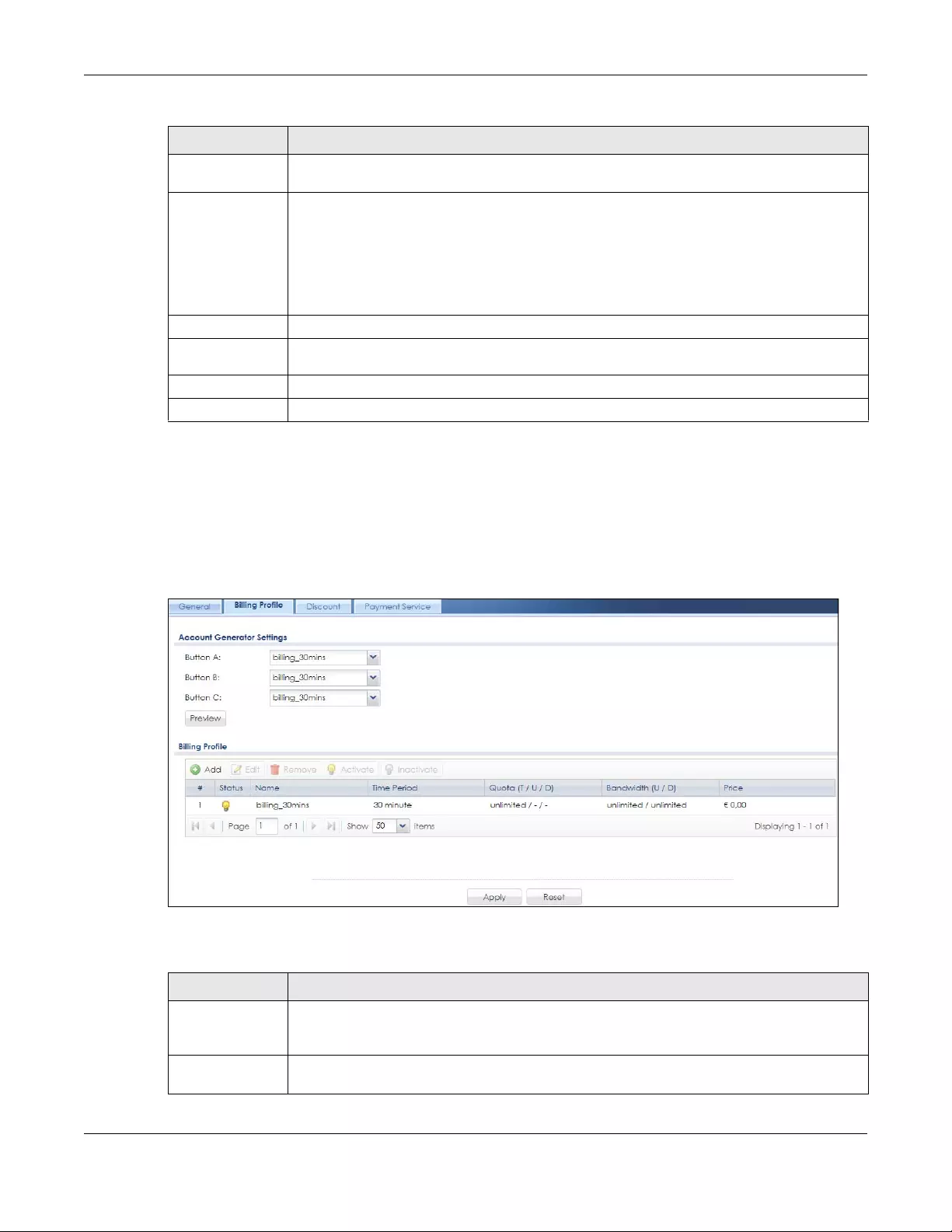
Chapter 24 Hotspot
ZyWALL USG FLEX Series User’s Guide
516
24.4 The Billing > Billing Profile Screen
Use this screen to configure the billing profiles that defines the maximum Internet access time and
charge per time unit. Click Configuration > Hotspot > Billing > Billing Profile to open the following screen.
Figure 353 Configuration > Hotspot > Billing > Billing Profile
The following table describes the labels in this screen.
Hotspot Service
Status
Service Status This field displays whether a service license is enabled at myZyxel (Activated) or not (Not
Activated) or expired (Expired). It displays the remaining Grace Period if your license has
Expired. It displays Not Licensed if there isn’t a license to be activated for this service.
If you need a license or a trial license has expired, click Buy to buy a new one. If a Standard
license has expired, click Renew to extend the license.
Then, click Activate to connect with the myZyxel server to activate the new license.
Service Type This shows whether you have a trial or standard license or none (Tr ial, Standard, None).
Expiration
Date This shows when your hotspot license will expire.
Apply Click this button to save your changes to the Zyxel Device.
Reset Click this button to return the screen to its last-saved settings.
Table 201 Configuration > Hotspot > Billing > General (continued)
LABEL DESCRIPTION
Table 202 Configuration > Hotspot > Billing > Billing Profile
LABEL DESCRIPTION
Account
Generator
Settings
Button A ~ C Select a billing profile for each button of the web-based account generator. The buttons
correspond to the buttons on a connected statement printer.

Chapter 24 Hotspot
ZyWALL USG FLEX Series User’s Guide
517
24.4.1 The Account Generator Screen
The Account Generator screen allows you to automatically create dynamic guest accounts (see
Dynamic-Guest Accounts for more information on dynamic guest accounts).
Click Configuration > Hotspot > Billing > Billing Profile and then the Preview button to open this screen.
You can also open this screen by logging into the Web Configurator with the guest-manager account.
Preview Click this button to open the Account Generator screen, where you can generate a dynamic
guest account and print the account information using a statement printer connected to the
Zyxel Device (see Section 24.4.1 on page 517 for more information).
Billing Profile
Add Click this to create a new entry.
Edit Double-click an entry or select it and click Edit to open a screen where you can modify the
entry’s settings.
Remove To remove an entry, select it and click Remove. The Zyxel Device confirms you want to remove
it before doing so.
Activate To turn on an entry, select it and click Activate.
Inactivate To turn off an entry, select it and click Inactivate.
#This field is a sequential value, and it is not associated with a specific entry.
Status This icon is lit when the entry is active and dimmed when the entry is inactive.
Name This field displays the descriptive profile name for this entry.
Time Period This field displays the duration of the billing period.
Quota (T/U/D) This field is NOT available when you set Accounting Method to Time to Finish in the Billing >
General screen.
This field displays how much data in both directions (Total) or upstream data (Upload) and
downstream data (Download) can be transmitted through the WAN interface before the
account expires.
Bandwidth (U/D) This field displays the maximum upstream (Upload) and downstream (Download) bandwidth
allowed for the user account in kilobits per second.
Price This field displays each profile’s price per time unit.
Apply Click this button to save your changes to the Zyxel Device.
Reset Click this button to return the screen to its last-saved settings.
Table 202 Configuration > Hotspot > Billing > Billing Profile (continued)
LABEL DESCRIPTION
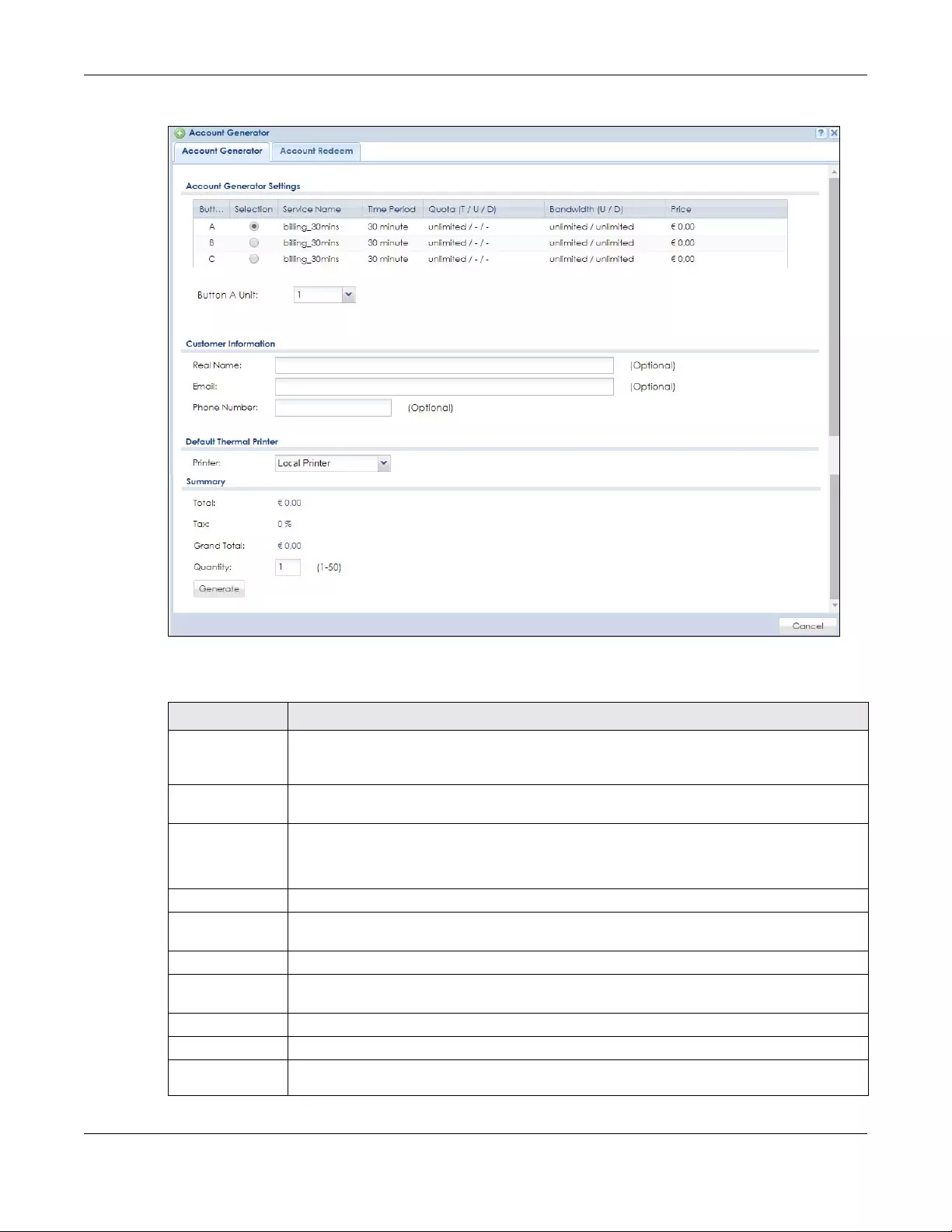
Chapter 24 Hotspot
ZyWALL USG FLEX Series User’s Guide
518
Figure 354 Account Generator
The following table describes the labels in this screen.
Table 203 Account Generator
LABEL DESCRIPTION
Account
Generator
Settings
Select a button and specify how many units of billing period to be charged for new account in
the Button x Unit field.
Discount plan for
Button x
This section displays only when you enable the discount price plan in the Billing > Discount
screen.
#This is the number of each discount level.
The default (first) level cannot be edited or deleted. It is created automatically according to
the billing profile of the button you select.
Name This field displays the conditions of each discount level.
Unit This field displays the duration of the billing period that should be reached before the Zyxel
Device charges users at this level.
Price This field displays the price per time unit for each level.
Customer
Information
Real Name Enter the user’s name.
Email Enter the user’s email address.
Phone
Number Enter the user’s phone number.

Chapter 24 Hotspot
ZyWALL USG FLEX Series User’s Guide
519
The following figure shows an example SMS message with account information. The SMS screen displays
only when you enable SMS in the Configuration > System > Notification > SMS screen. You can enter the
user’s mobile phone number and click Send SMS to send the account information in an SMS text
message to the user’s mobile phone. Click Cancel to close this window when you are finished viewing it.
Default Thermal
Printer
Select a statement printer that is attached to the Zyxel Device. It displays n/a if there is no
printer attached.
Summary
Total This shows the total price for the account before sales tax is added.
Tax This shows the tax rate.
Grand Total This shows the total price including tax.
Quantity Specify the number of account to be created.
Generate Click Generate to generate an account based on the billing settings you configure for the
selected button in the Billing Profile screen. A window displays showing the SMS message and/
or a printout preview of the account generated.
Cancel Click Cancel to exit this screen without saving.
Logout Click Logout to log out of the web configurator. This button is available only when you open this
screen by logging in with the guest-manager account.
Table 203 Account Generator (continued)
LABEL DESCRIPTION
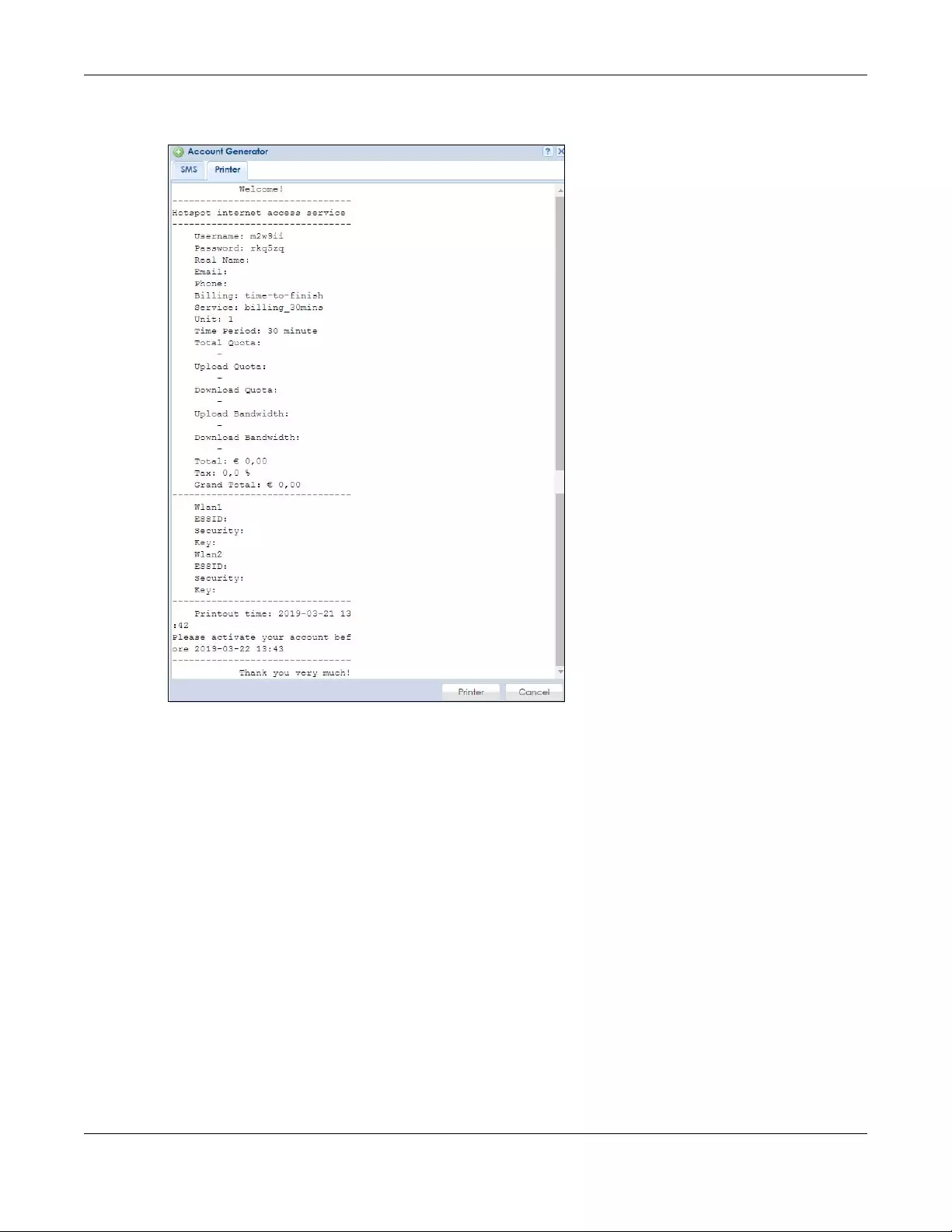
Chapter 24 Hotspot
ZyWALL USG FLEX Series User’s Guide
520
The Printer screen shows a printout preview example. Click Printer to print this subscriber statement. Click
Cancel to close this window when you are finished viewing it.
24.4.2 The Account Redeem Screen
The Account Redeem screen allows you to send SMS messages for certain accounts. Click the Account
Redeem tab in the Account Generator screen to open this screen.
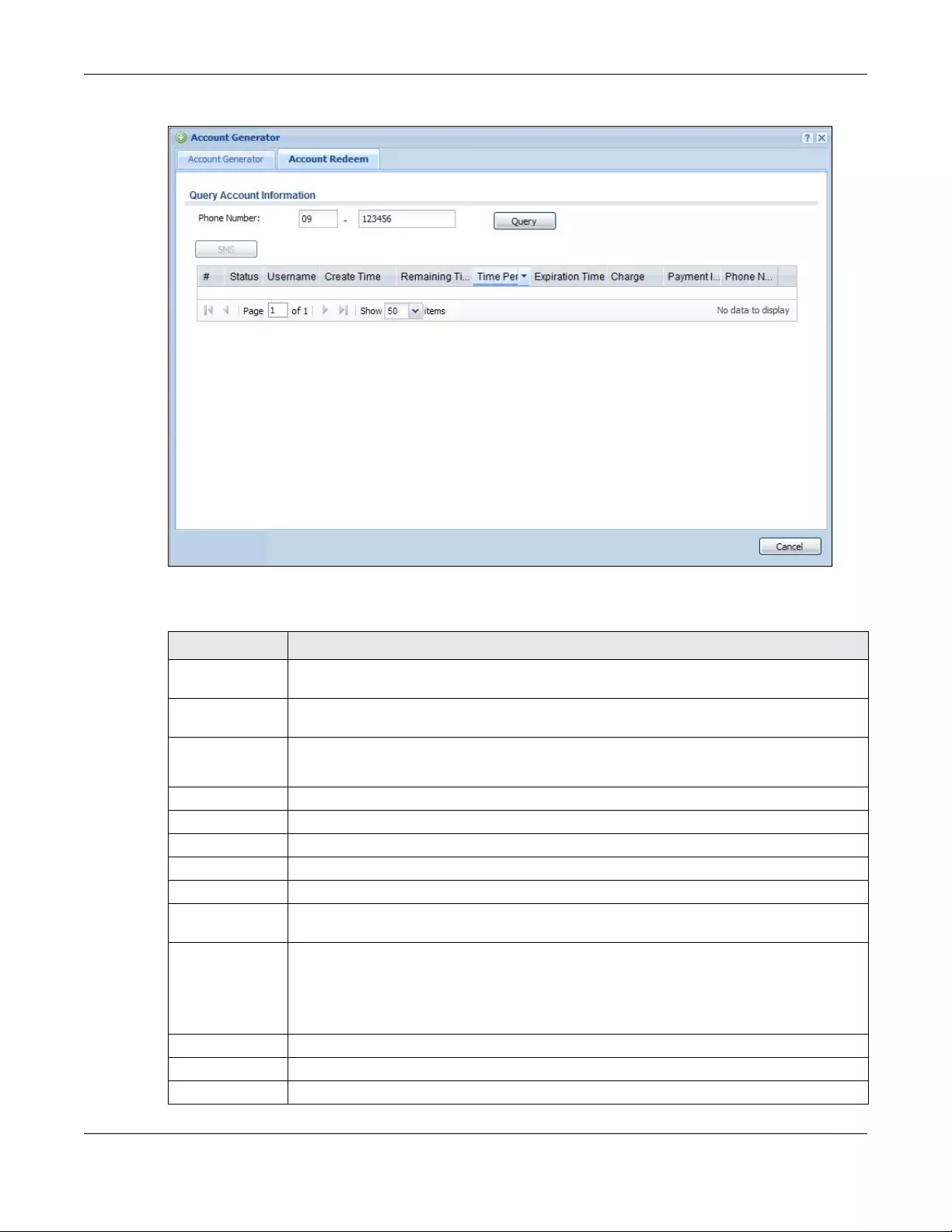
Chapter 24 Hotspot
ZyWALL USG FLEX Series User’s Guide
521
Figure 355 Account Redeem
The following table describes the labels in this screen.
Table 204 Account Redeem
LABEL DESCRIPTION
Query Account
Information
Phone Number Enter the country code and mobile phone number and click Query to display only the
account(s) that has the specified phone number.
SMS Click this button to send text messages for the accounts in the list below.
You can use this button only when SMS is enabled and there is at least one account in the list.
#This is the index number of the dynamic guest account in the list.
Status This field displays whether an account expires or not.
Username This field displays the user name of the account.
Create Time This field displays when the account was created.
Remaining Time This field displays the amount of Internet access time remaining for each account.
Time Period This field displays the total account of time the account can use to access the Internet through
the Zyxel Device.
Expiration Time This field displays the date and time the account becomes invalid.
Note: Once the time allocated to a dynamic account is used up or a dynamic
account remains unused after the expiration time, the account is deleted from
the account list.
Charge This field displays the total cost of the account.
Payment Info This field displays the method of payment for each account.
Phone Num This field displays the mobile phone number for the account.
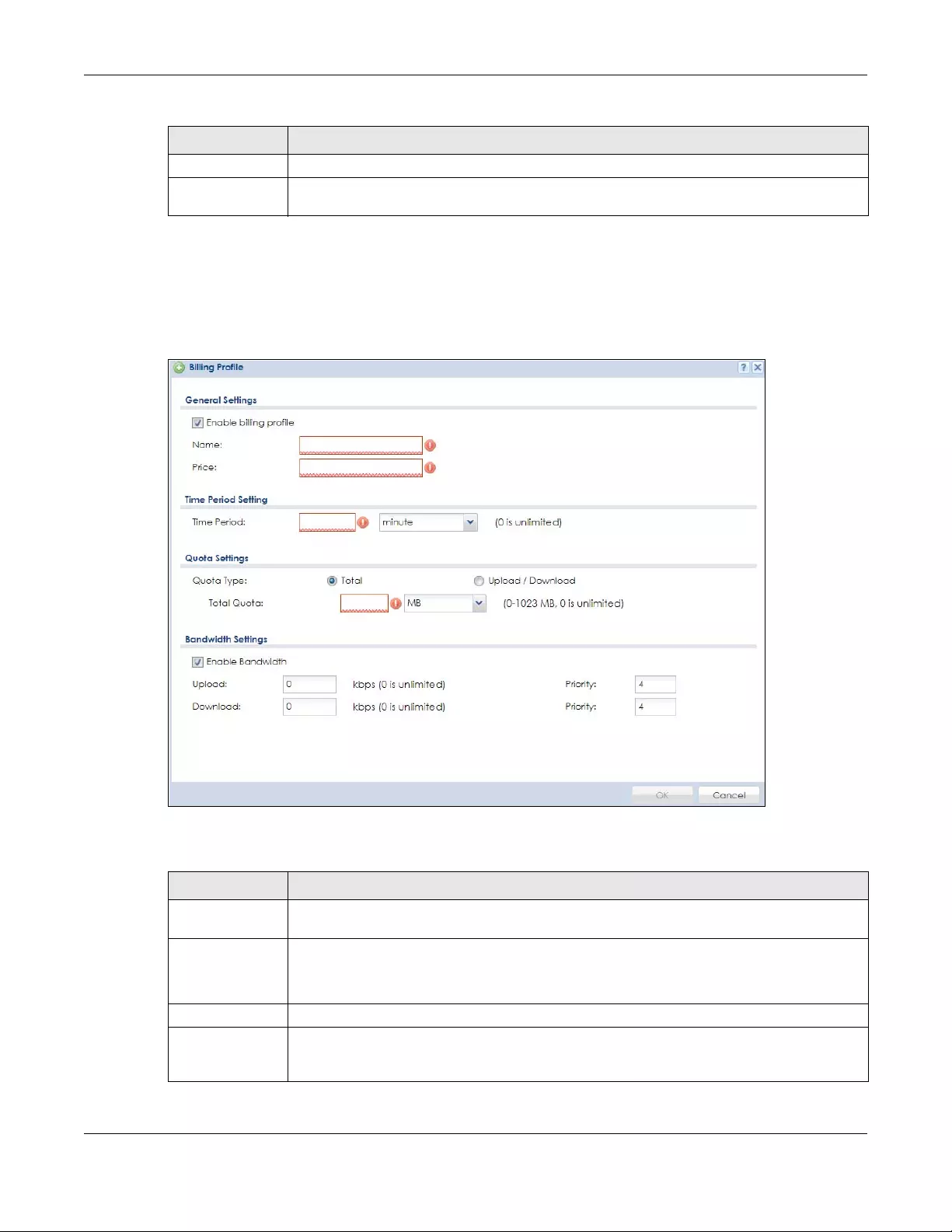
Chapter 24 Hotspot
ZyWALL USG FLEX Series User’s Guide
522
24.4.3 The Billing Profile Add/Edit Screen
The Billing Profile Add/Edit screen allows you to create a new billing profile or edit an existing one. Click
Configuration > Hotspot > Billing > Billing Profile and then an Add or Edit icon to open this screen.
Figure 356 Configuration > Hotspot > Billing > Billing Profile > Add/Edit
The following table describes the labels in this screen.
Cancel Click Cancel to exit this screen without saving.
Logout Click Logout to log out of the web configurator. This button is available only when you open this
screen by logging in with the guest-manager account.
Table 204 Account Redeem (continued)
LABEL DESCRIPTION
Table 205 Configuration > Hotspot > Billing > Billing Profile > Add/Edit
LABEL DESCRIPTION
Enable billing
profile
Select this option to activate the profile.
Name Enter a name for the billing profile.
You can use up to 31 alphanumeric characters (A-Z, a-z, 0-9) and underscores (_). Spaces are
not allowed. The first character must be a letter.
Price Define each profile’s price, up to 999999.99, per time unit.
Time Period Set the duration of the billing period (minute, hour, or day). When this period expires, the user’s
access will be stopped. The allowed time period ranges are 10 to 60 minutes, 0 to 24 hours, or 0
to 365 days.

Chapter 24 Hotspot
ZyWALL USG FLEX Series User’s Guide
523
24.5 The Billing > Discount Screen
Use this screen to configure a custom discount pricing plan. This is useful for providing reduced rates for
purchases of longer periods of time. You can charge higher rates per unit at lower levels (fewer units
purchased) and lower rates per unit at higher levels (more units purchased). Click Configuration >
Hotspot > Billing > Discount to open the following screen.
Note: The discount price plan does not apply to users who purchase access time online with a
credit card.
Quota Type The quota settings section is NOT available when you set Accounting Method to Time to Finish
in the Billing > General screen.
Set a limit for the user accounts. This only applies to user’s traffic that is received or transmitted
through the WAN interface.
Note: When the limit is exceeded, the user is not allowed to access the Internet
through the Zyxel Device.
Select Total to set a limit on the total traffic in both directions.
Select Upload/Download to set a limit on the upstream traffic and downstream traffic
respectively.
Total Quota If you select Total, specify how much downstream and/or upstream data (in MB (Megabytes)
or GB (Gigabytes)) can be transmitted through the WAN interface before the account expires.
0 means there is no data limit for the user account.
Upload Quota If you select Upload/Download, specify how much upstream data (in MB (Megabytes) or GB
(Gigabytes)) can be transmitted through the WAN interface before the account expires.
0 means there is no data limit for the user account.
Download Quota If you select Upload/Download, specify how much downstream data (in MB (Megabytes) or GB
(Gigabytes)) can be transmitted through the WAN interface before the account expires.
0 means there is no data limit for the user account.
Enable
Bandwidth
Select this option to turn on bandwidth management for the user accounts.
Upload Specify the maximum outgoing bandwidth allowed for the user account in kilobits per second.
Upload refers to the traffic the Zyxel Device sends out from a user.
Download Specify the maximum incoming bandwidth allowed for the user account in kilobits per second.
Download refers to the traffic the Zyxel Device sends to a user.
Priority Enter a number between 1 and 7 to set the priority for the user’s traffic. The smaller the number,
the higher the priority.
Traffic with a higher priority is given bandwidth before traffic with a lower priority.
Note: The priority setting here has priority over the priority setting in a bandwidth
management rule.
OK Click OK to save your changes back to the Zyxel Device.
Cancel Click Cancel to exit this screen without saving.
Table 205 Configuration > Hotspot > Billing > Billing Profile > Add/Edit (continued)
LABEL DESCRIPTION
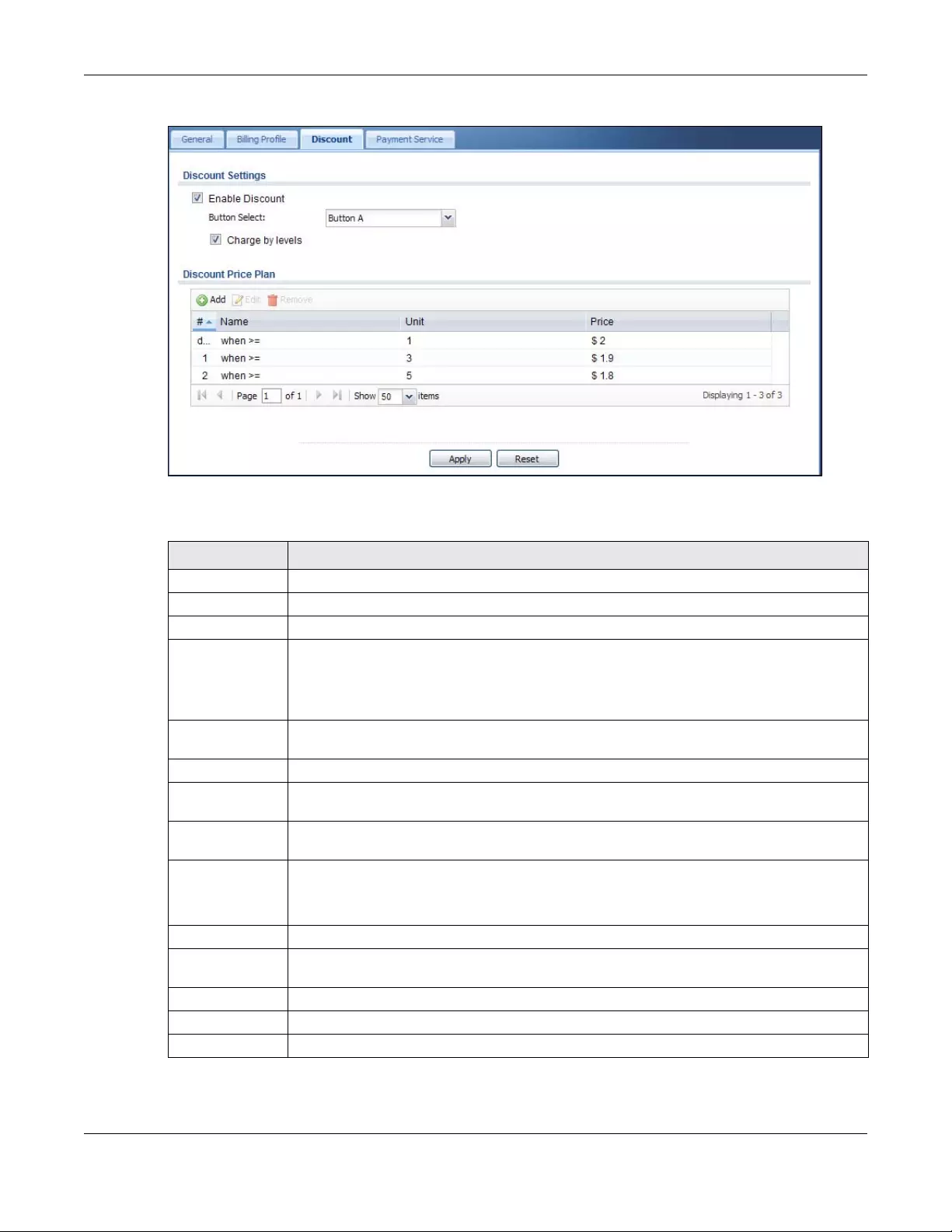
Chapter 24 Hotspot
ZyWALL USG FLEX Series User’s Guide
524
Figure 357 Configuration > Hotspot > Billing > Discount
The following table describes the labels in this screen.
Table 206 Configuration > Hotspot > Billing > Discount
LABEL DESCRIPTION
Discount Settings
Enable Discount Select the check box to activate the discount price plan.
Button Select Select a button from the drop-down list box to assign the base charge.
Charge by levels Select this to charge the rate at each successive level from the first level (most expensive per
unit) to the highest level (least expensive per unit) that the total purchase reaches.
Otherwise, clear this to charge all of the user’s time units only at the highest level (least
expensive) that their total purchase reaches.
Discount Price
Plan
Add Click this to create a new entry.
Edit Double-click an entry or select it and click Edit to open a screen where you can modify the
entry’s settings.
Remove To remove an entry, select it and click Remove. The Zyxel Device confirms you want to remove
it before doing so.
#This is the number of each discount level.
The default (first) level cannot be edited or deleted. It is created automatically according to
the billing profile of the button you select.
Name This field displays the conditions of each discount level.
Unit This field displays the duration of the billing period that should be reached before the Zyxel
Device charges users at this level.
Price This field displays the price per time unit for each level.
Apply Click this button to save your changes to the Zyxel Device.
Reset Click this button to return the screen to its last-saved settings.
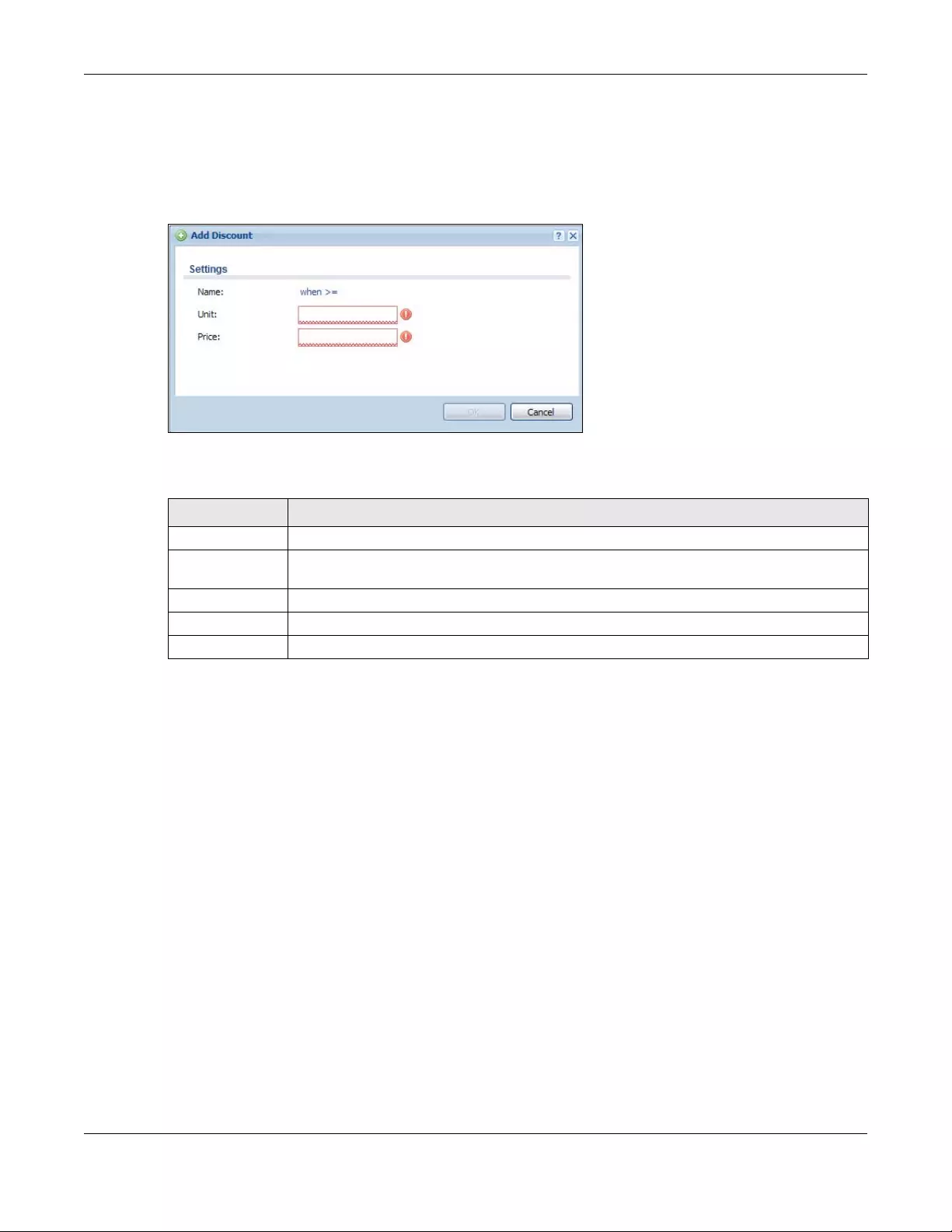
Chapter 24 Hotspot
ZyWALL USG FLEX Series User’s Guide
525
24.5.1 The Discount Add/Edit Screen
The Discount Add/Edit screen allows you to create a new discount level or edit an existing one. Click
Configuration > Hotspot > Billing > Discount and then an Add or Edit icon to open this screen.
Figure 358 Configuration > Hotspot > Billing > Discount > Add/Edit
The following table describes the labels in this screen.
24.6 The Billing > Payment Service Screen
Use this screen to use a credit card service to authorize, process, and manage credit card transactions
directly through the Internet. You must register with the supported credit card service before you can
configure the Zyxel Device to handle credit card transactions. Click Configuration > Hotspot > Billing >
Payment Service to open the following screen.
Table 207 Configuration > Hotspot > Billing > Discount > Add/Edit
LABEL DESCRIPTION
Name This field displays the conditions of each discount level.
Unit Set the duration of the billing period that should be reached before the Zyxel Device charges
users at this level.
Price Define this level’s charge per time unit.
OK Click OK to save your changes back to the Zyxel Device.
Cancel Click Cancel to exit this screen without saving.
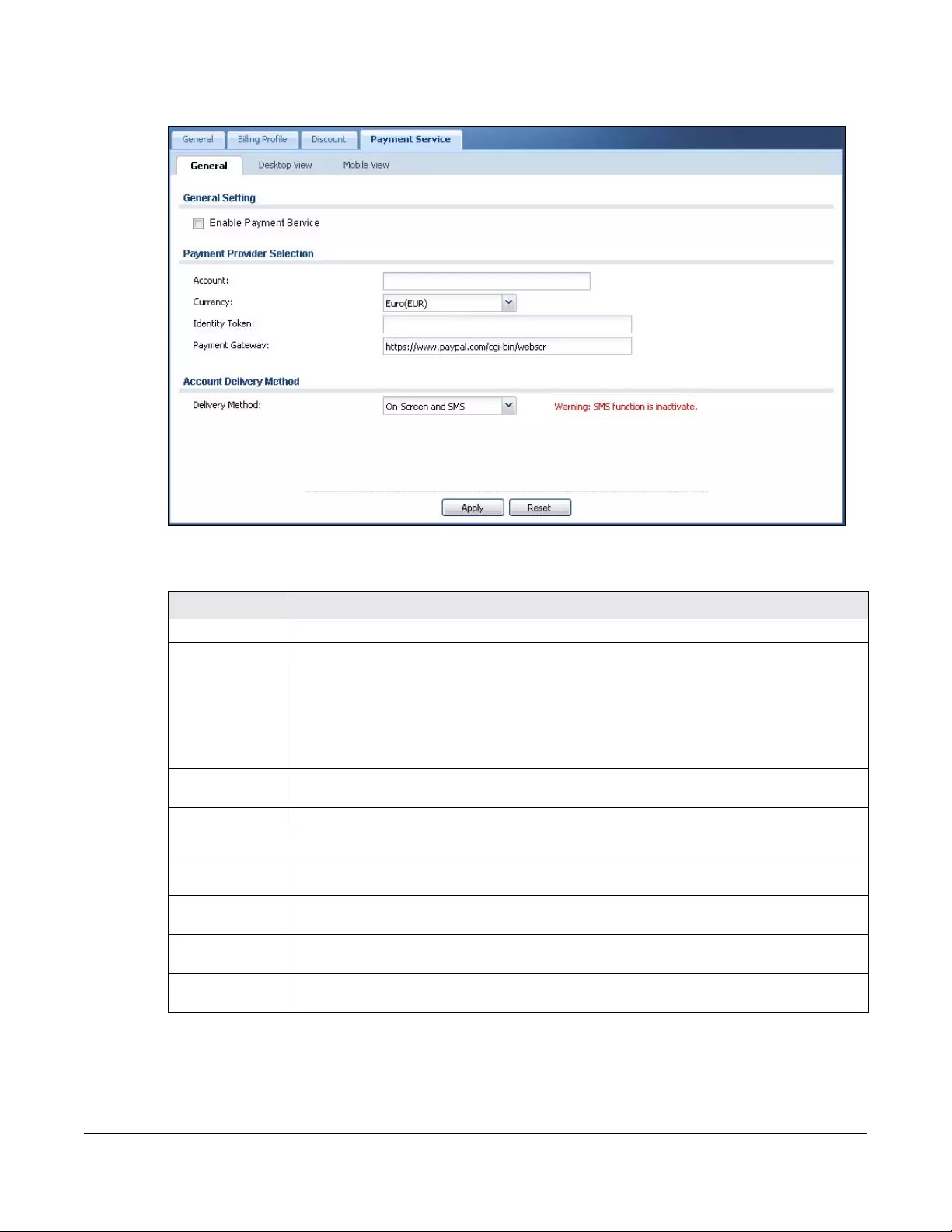
Chapter 24 Hotspot
ZyWALL USG FLEX Series User’s Guide
526
Figure 359 Configuration > Hotspot > Billing > Payment Service > General
The following table describes the labels in this screen.
Table 208 Configuration > Hotspot > Billing > Payment Service > General
LABEL DESCRIPTION
General Setting
Enable Payment
Service
Select the check box to use PayPal to authorize credit card payments.
Note: After you set up web authentication policies and enable the online payment
service on the Zyxel Device, a link displays in the login screen when users try to
access the Internet. The link redirects users to a screen where they can make
online payments by credit card to purchase access time and get dynamic
guest account information.
Payment Provider
Selection
Account You should already have a PayPal account to receive credit card payments.
Enter your PayPal account name.
Currency Select the currency in which payments are made. The available options depend on currencies
that PayPal supports.
Identity Token Enter the ID token provided to you by PayPal after successfully applying for your PayPal
account.
Payment
Gateway
Enter the address of the PayPal gateway provided to you by PayPal after applying for your
PayPal account.
Account Delivery
Method

Chapter 24 Hotspot
ZyWALL USG FLEX Series User’s Guide
527
24.6.1 The Payment Service > Desktop / Mobile View Screen
Use this screen to customize the online payment service pages that displays after an unauthorized user
clicks the link in the Web Configurator login screen to purchase access time. You can configure both
the desktop and mobile versions of the service pages. Users click a link in the pages to switch between
the two versions.
Click Configuration > Hotspot > Billing > Payment Service > Desktop View or Mobile View to open the
following screen.
Delivery Method Specify how the Zyxel Device provides dynamic guest account information after the user’s
online payment is done.
Select On-Screen to display the user account information in the web screen.
Select SMS to use Short Message Service (SMS) to send account information in a text message
to the user’s mobile device.
Select On-Screen and SMS to provide the account information both in the web screen and via
SMS text messages.
Note: You should have enabled SMS in the Configuration > System > Notification >
SMS screen to send text messages to the user’s mobile device.
Apply Click this button to save your changes to the Zyxel Device.
Reset Click this button to return the screen to its last-saved settings.
Table 208 Configuration > Hotspot > Billing > Payment Service > General (continued)
LABEL DESCRIPTION

Chapter 24 Hotspot
ZyWALL USG FLEX Series User’s Guide
528
Figure 360 Configuration > Hotspot > Billing > Payment Service > Desktop View

Chapter 24 Hotspot
ZyWALL USG FLEX Series User’s Guide
529
Figure 361 Configuration > Hotspot > Billing > Payment Service > Mobile View

Chapter 24 Hotspot
ZyWALL USG FLEX Series User’s Guide
530
The following table describes the labels in this screen.
Table 209 Configuration > Hotspot > Billing > Payment Service > Desktop View or Mobile View
LABEL DESCRIPTION
Select Type
Use Default Page Select this to use the default online payment service page built into the device. If you later
create a custom online payment service page, you can still return to the Zyxel Device’s default
page as it is saved indefinitely.
Use Customized
Page
Select this to use a custom online payment service page instead of the default one built into
the Zyxel Device. Once this option is selected, the custom page controls below become
active.
Customized
Profile Selection
Page
Selection
Message
Enter a note to display in the first welcome page that allows users to choose a billing period
they want. Use up to 256 printable ASCII characters. Spaces are allowed.
Customized
Successfully Page
Successfully
Message
Enter a note to display in the second page after the user’s online payment is made
successfully. Use up to 256 printable ASCII characters. Spaces are allowed.
Notification
Message
Enter the important information you want to display. Use up to 256 printable ASCII characters.
Spaces are allowed.
Notification Color Specify the font color of the important information. You can use the color palette chooser, or
enter a color value of your own.
Account
Message
Enter a note to display above the user account information. Use up to 256 printable ASCII
characters. Spaces are allowed.
Day Time Select the format in which you want to display the date and how long an account is allowed
to stay unused before it expires.
Customized Fail
Page
Failed Message Enter a note to display when the user’s online payment failed. Use up to 256 printable ASCII
characters. Spaces are allowed.
Customized SMS
Page
Information
Message
Enter a note to display when you set the Zyxel Device to send account information via SMS text
messages. Use up to 256 printable ASCII characters. Spaces are allowed.
Apply Click this button to save your changes to the Zyxel Device.
Reset Click this button to return the screen to its last-saved settings.

Chapter 25 Printer Manager
ZyWALL USG FLEX Series User’s Guide
531
CHAPTER 25
Printer Manager
25.1 Printer Manager Overview
You can create dynamic guest accounts and print guest account information by pressing the button on
an external statement printer, such as SP350E.
Make sure that the printer is connected to the appropriate power and the Zyxel Device, and that there
is printing paper in the printer. Refer to the printer’s documentation for details.
25.1.1 What You Can Do in this Chapter
• Use the Printer Manager > General screen (see Section 24.3 on page 514) to configure the printer list
and enable printer management.
• Use the Printer Manager > Printout Configuration screen (see Section 25.3 on page 538) to customize
the account printout.
25.2 The Printer Manager > General Screen
Use this screen to configure a printer list and allow the Zyxel Device to monitor the printer status. Click
Configuration > Hotspot > Printer Manager > General to open the following screen.
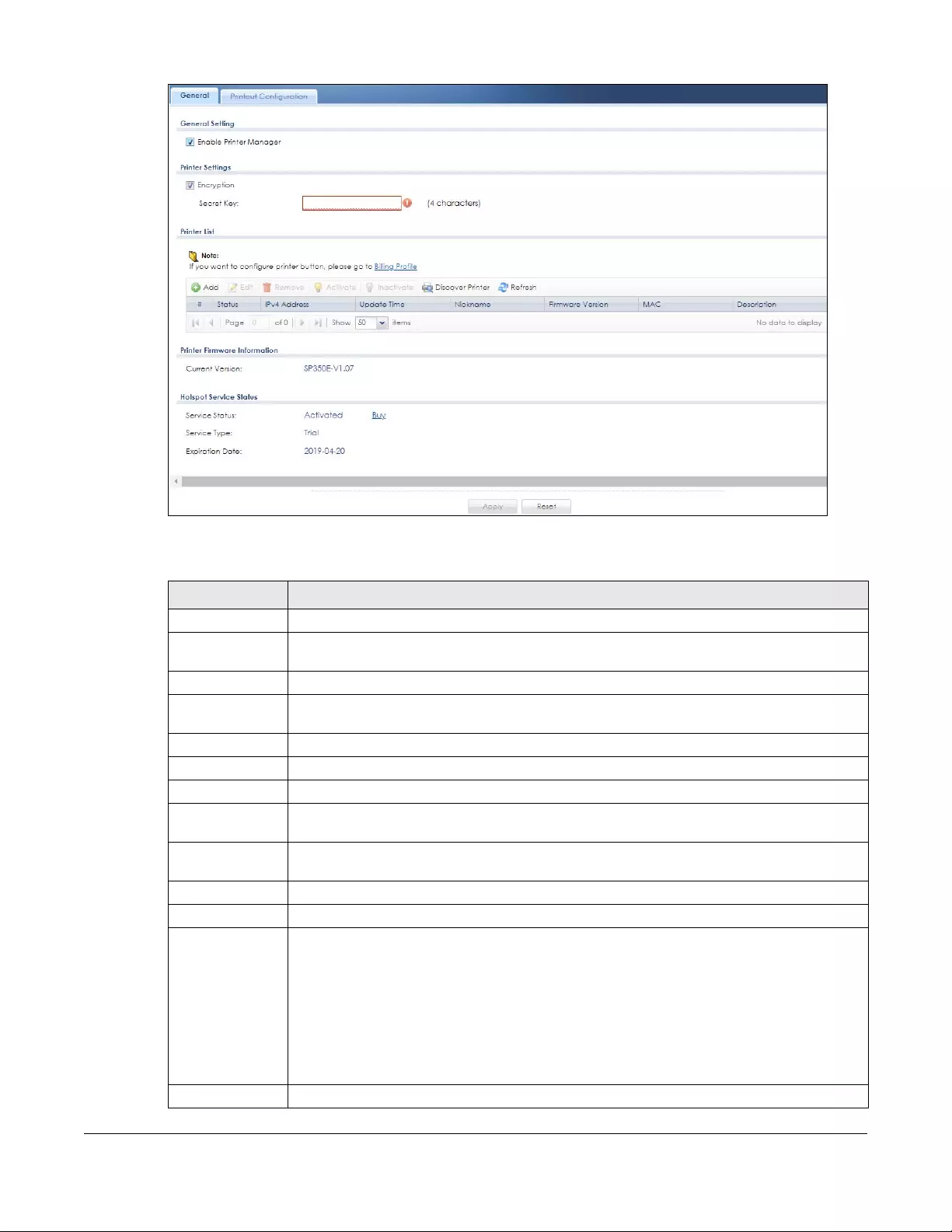
ZyWALL USG FLEX Series User’s Guide
532
Figure 362 Configuration > Hotspot > Printer Manager > General
The following table describes the labels in this screen.
Table 210 Configuration > Hotspot > Printer Manager > General
LABEL DESCRIPTION
General Setting
Enable Printer
Manager
Select the check box to allow the Zyxel Device to manage and monitor the printer status.
Printer Settings
Encryption Select the check box to turn on data encryption. Data transmitted between the Zyxel Device
and the printer will be encrypted with a secret key
Secret Key Enter four alphanumeric characters (A-Z, a-z, 0-9) to specify a key for data encryption.
Printer List Use this section to add the printer(s) that can be managed by the Zyxel Device.
Add Click this to create a new entry.
Edit Double-click an entry or select it and click Edit to open a screen where you can modify the
entry’s settings.
Remove To remove an entry, select it and click Remove. The Zyxel Device confirms you want to remove
it before doing so.
Activate To turn on an entry, select it and click Activate.
Inactivate To turn off an entry, select it and click Inactivate.
Discover
Printer Click this to discover the printer(s) that is connected to the Zyxel Device and display the printer
information in a pop-up window. IPnP is enabled while discovering the printer and disabled
when the discovering process has finished.
Note: You need a Hotspot license to use this feature.
Use Printer Manager > General > Add to manually configure a printer’s IP address
and add it to the managed printer list when the printer is not detected or
connected to the Zyxel Device.
Refresh Click this to update the printer list table.

Chapter 25 Printer Manager
ZyWALL USG FLEX Series User’s Guide
533
#This field is a sequential value, and it is not associated with any entry.
Status This icon is lit when the entry is active and dimmed when the entry is inactive. Click the
Connection icon for the Zyxel Device connect to the printer.
IPv4 Address This field displays the IP address of the printer.
Update Time This field displays the date and time the Zyxel Device last synchronized with the printer.
This shows n/a when the printer is not in the managed printer list or the printer status is sync fail
or sync progressing.
Status This field is hidden by default. It displays whether the Zyxel Device can connect to the printer
and update the printer information.
This shows n/a when the printer is not in the managed printer list.
Nickname This shows an optional friendly name for the printer that you configured.
Firmware Version This field displays the model number and firmware version of the printer.
This shows n/a when the printer is not in the managed printer list or the printer status is sync fail.
MAC This shows the hardware MAC address of the printer.
Description This field displays the descriptive name for the printer that you configured.
Printer Firmware
Information
Current Version This is the version of the printer firmware currently uploaded to the Zyxel Device. The Zyxel
Device automatically installs it in the connected printers to make sure the printers are
upgraded to the same version.
Hotspot Service
Status
The hotspot license must be registered in order to be activated.
Service Status This field displays whether a service license is enabled at myZyxel (Activated) or not (Not
Activated) or expired (Expired). It displays the remaining Grace Period if your license has
Expired. It displays Not Licensed if there isn’t a license to be activated for this service.
If you need a license or a trial license has expired, click Buy to buy a new one. If a Standard
license has expired, click Renew to extend the license.
Then, click Activate to connect with the myZyxel server to activate the new license.
Service Type This shows whether you have a trial or standard license or none (Tr ial, Standard, None).
Expiration
Date This shows when your hotspot license will expire.
Apply Click this button to save your changes to the Zyxel Device.
Reset Click this button to return the screen to its last-saved settings.
Table 210 Configuration > Hotspot > Printer Manager > General (continued)
LABEL DESCRIPTION

Chapter 25 Printer Manager
ZyWALL USG FLEX Series User’s Guide
534
25.2.1 Add Printer Rule
Click the Add icon to open the following screen. Use this screen to add a new printer.
Figure 363 Configuration > Hotspot > Printer Manager > General: Add
The following table describes the labels in this screen.
25.2.2 Edit Printer Rule
Select an entry in the Printer Manager > General screen and click the Edit icon to open the following
screen. Use this screen to modify the printer’s settings. You can't click the Edit icon when the printer
status is sync fail or sync progressing.
Figure 364 Configuration > Hotspot > Printer Manager > General: Edit
Table 211 Configuration > Hotspot > Printer Manager > General: Add
LABEL DESCRIPTION
Enable Printer
Manager
Select this option to turn on this entry in order to allow the Zyxel Device to manage this printer.
IPv4 Address Enter an IPv4 address for the printer.
Description Enter a description of this printer. You can use alphanumeric and ()+,/:=?!*#@$_%-”
characters, and it can be up to 60 characters long.
OK Click OK to save your changes back to the Zyxel Device.
Cancel Click Cancel to exit this screen without saving.

Chapter 25 Printer Manager
ZyWALL USG FLEX Series User’s Guide
535
The following table describes the labels in this screen.
25.2.3 Discover Printer
Click the Discover Printer icon in the Printer Manager > Ge neral screen to open the following screen. Use
this screen to find connected printers or edit a connected printer’s settings. Use Printer Manager
>General > Add to manually configure a printer’s IP address and add it to the managed printer list when
the printer is not detected or connected to the Zyxel Device.
Table 212 Configuration > Hotspot > Printer Manager > General: Edit
LABEL DESCRIPTION
Enable Printer
Manager
Select this option to turn on this entry in order to allow the Zyxel Device to manage this printer.
Nickname Type an optional friendly name for the printer. A nickname must begin with a letter and cannot
exceed 15 characters. Valid characters are [a-zA-Z0-9_-].
Description Enter a description of this printer. You can use alphanumeric and ()+,/:=?!*#@$_%-”
characters, and it can be up to 60 characters long.
IP Address
Assignment
Get
Automatically
Select this to make the printer a DHCP client and automatically get the IP address, subnet
mask, and gateway address from a DHCP server.
Use Fixed IP
Address
Select this if you want to specify the IP address, subnet mask, and gateway manually.
IP Address This field is enabled if you select Use Fixed IP Address.
Enter the IP address for the printer.
Subnet Mask This field is enabled if you select Use Fixed IP Address.
Enter the subnet mask of the printer in dot decimal notation. The subnet mask indicates what
part of the IP address is the same for all computers on the network.
Gateway This field is enabled if you select Use Fixed IP Address.
Enter the IP address of the gateway. The Zyxel Device sends packets to the gateway when it
does not know how to route the packet to its destination. The gateway should be on the same
network as the printer.
OK Click OK to save your changes back to the Zyxel Device.
Cancel Click Cancel to exit this screen without saving.
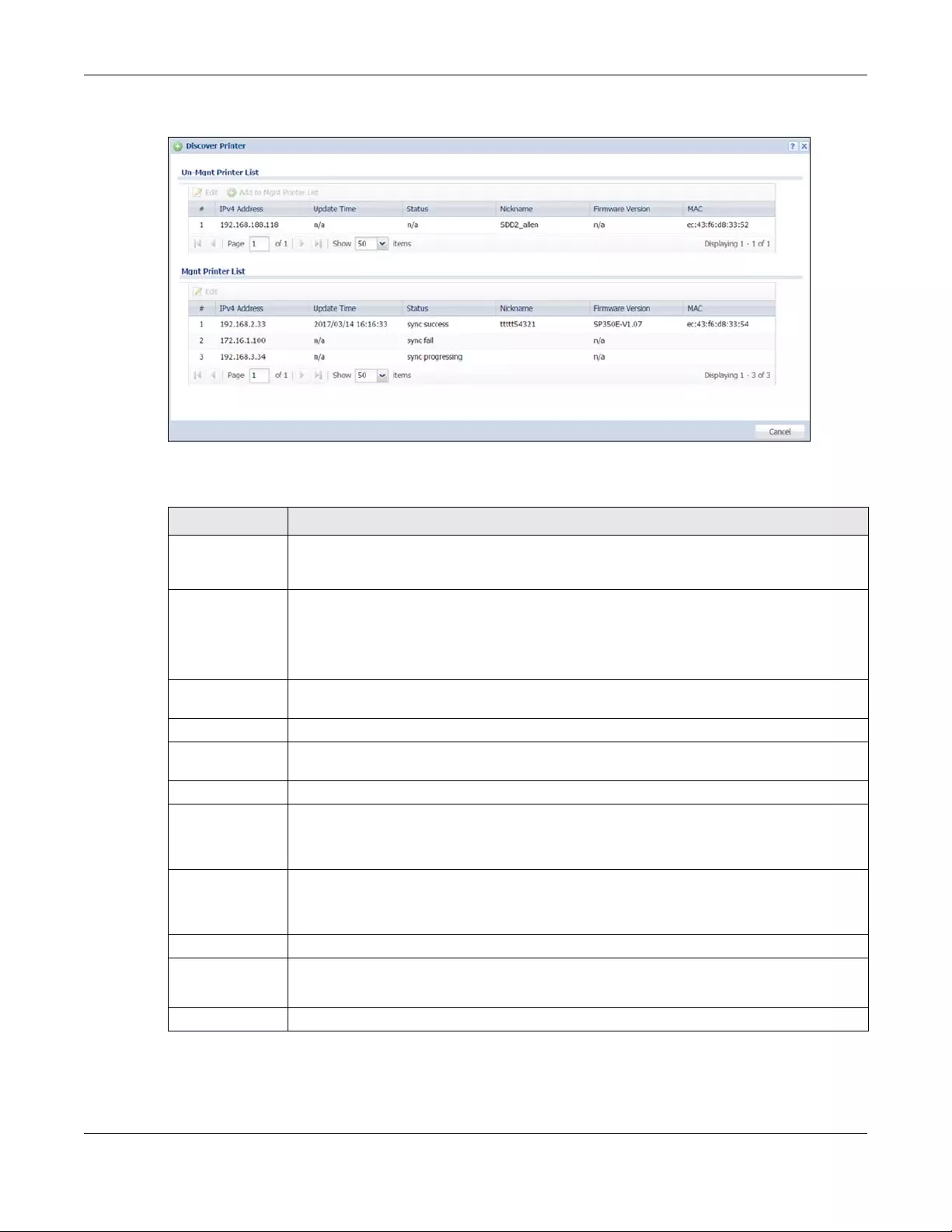
Chapter 25 Printer Manager
ZyWALL USG FLEX Series User’s Guide
536
Figure 365 Configuration > Hotspot > Printer Manager > General: Discover Printer
The following table describes the labels in this screen.
Table 213 Configuration > Hotspot > Printer Manager > General > Discover Printer
LABEL DESCRIPTION
Un-Mgnt Printer
List / Mgnt Printer
List
The tables displays according to whether the printer is in the unmanaged printer list (Un-Mgnt
Printer List) or the managed printer list (Mgnt Printer List).
Edit Double-click an entry or select it and click Edit to open a screen where you can modify the
entry’s settings.
Note: You cannot edit an entry’s settings when the printer status is sync fail or sync
progressing.
Add to Mgnt
Printer List
Click this to add the selected printer to the managed printer list.
#This is the index number of the printer in the list.
Registration This field displays whether the printer is added to the managed printer list (Mgnt Printer) or not
(Un-Mgnt Printer).
IPv4 Address This field displays the IP address of the printer.
Update Time This field displays the date and time the Zyxel Device last synchronized with the printer.
This shows n/a when the printer is not in the managed printer list or the printer status is sync fail
or sync progressing.
Status This field displays whether the Zyxel Device can connect to the printer and update the printer
information.
This shows n/a when the printer is not in the managed printer list.
Nickname This field displays the optional friendly name of the printer that you configured.
Firmware Version This field displays the model number and firmware version of the printer.
This shows n/a when the printer is not in the managed printer list or the printer status is sync fail.
MAC This field displays the MAC address of the printer.
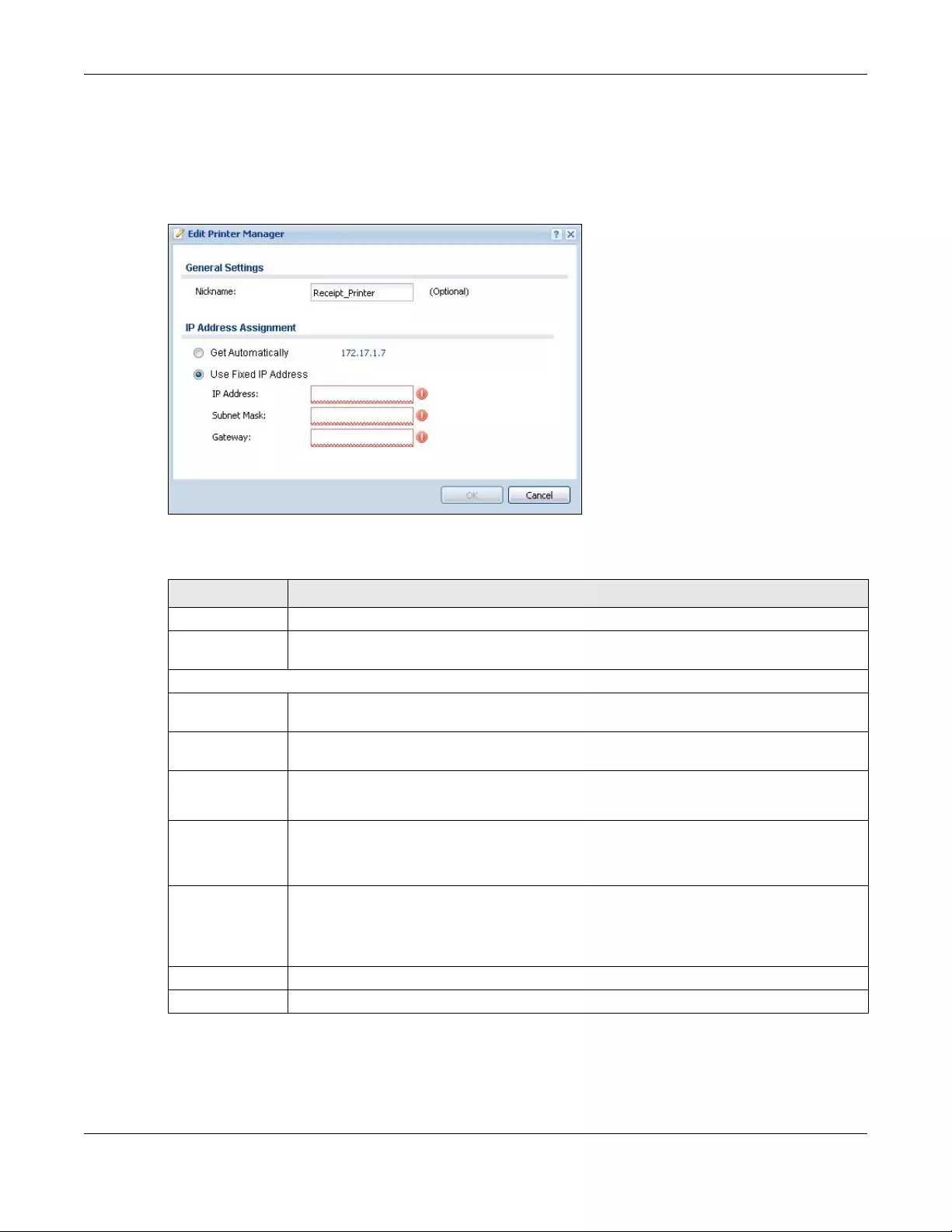
Chapter 25 Printer Manager
ZyWALL USG FLEX Series User’s Guide
537
25.2.4 Edit Printer Manager (Discover Printer)
Select an entry in the Printer Manager > General > Discover Printer screen and click the Edit icon to open
the following screen. Use this screen to modify the printer’s nickname and IP address.
Figure 366 Configuration > Hotspot > Printer Manager > General > Discover Printer: Edit
The following table describes the labels in this screen.
Table 214 Configuration > Hotspot > Printer Manager > General > Discover Printer: Edit
LABEL DESCRIPTION
General Settings
Nickname Type an optional friendly name for the printer. A nickname must begin with a letter and cannot
exceed 15 characters. Valid characters are [a-zA-Z0-9_-].
IP Address Assignment
Get
Automatically
Select this to make the printer a DHCP client and automatically get the IP address, subnet
mask, and gateway address from a DHCP server.
Use Fixed IP
Address
Select this if you want to specify the IP address, subnet mask, and gateway manually.
IP Address This field is enabled if you select Use Fixed IP Address.
Enter the IP address for the printer.
Subnet Mask This field is enabled if you select Use Fixed IP Address.
Enter the subnet mask of the printer in dot decimal notation. The subnet mask indicates what
part of the IP address is the same for all computers on the network.
Gateway This field is enabled if you select Use Fixed IP Address.
Enter the IP address of the gateway. The Zyxel Device sends packets to the gateway when it
does not know how to route the packet to its destination. The gateway should be on the same
network as the printer.
OK Click OK to save your changes back to the Zyxel Device.
Cancel Click Cancel to exit this screen without saving.

Chapter 25 Printer Manager
ZyWALL USG FLEX Series User’s Guide
538
25.3 The Printout Configuration Screen
Use this screen to customize the account printout. Click Configuration > Hotspot > Printer Manager >
Printout Configuration to open the following screen.
Figure 367 Configuration > Hotspot > Printer Manager > Printout Configuration
The following table describes the labels in this screen.
Table 215 Configuration > Hotspot > Printer Manager > Printout Configuration
LABEL DESCRIPTION
Use Default
Printout
Configuration
Select this to use the default account printout format built into the device. If you later create a
custom account printout format, you can still return to the Zyxel Device’s default format as it is
saved indefinitely.
Use Customized
Printout
Configuration
Select this to use a custom account printout format instead of the default one built into the
Zyxel Device. Once this option is selected, the custom format controls below become active.
Preview Click the button to display a preview of account printout format you uploaded to the Zyxel
Device.
File Name This shows the file name of account printout format file in the Zyxel Device.
Click Download to download the account printout format file from the Zyxel Device to your
computer.
File Path /
Browse /
Upload
Browse for the account printout format file or enter the file path in the available input box, then
click the Upload button to put it on the Zyxel Device.
Restore
Customized
File to Default
Click Restore to set the Zyxel Device back to use the default built-in account printout format.
Download Click this to download an example account printout format file from the Zyxel Device for your
reference.
Printout
Number of
Copies Select how many copies of subscriber statements you want to print (1 is the default).
Apply Click this button to save your changes to the Zyxel Device.
Reset Click this button to return the screen to its last-saved settings.

Chapter 25 Printer Manager
ZyWALL USG FLEX Series User’s Guide
539
25.4 Printer Reports Overview
The SP350E allows you to print status reports about the guest accounts and general Zyxel Device system
information. Simply press a key combination on the SP350E to print a report instantly without accessing
the web configurator.
The following lists the reports that you can print using the SP300E.
• Daily account summary
• Monthly account summary
• Last month account summary
•System status
25.4.1 Key Combinations
The following table lists the key combination to print each report.
Note: You must press the key combination on the SP350E within five seconds to print.
The following sections describe each report printout in detail.
25.4.2 Daily Account Summary
The daily account report lists the accounts printed during the current day, the current day’s total
number of accounts and the total charge. It covers the accounts that have been printed during the
current day starting from midnight (not the past 24 hours). For example, if you press the daily account
key combination on 2013/05/10 at 20:00:00, the daily account report includes the accounts created on
2013/05/10 between 00:00:01 and 19:59:59.
Key combination: A B C A A
The following figure shows an example.
Table 216 Report Printing Key Combinations
REPORT TYPE KEY COMBINATION
Daily Account Summary A B C A A
Monthly Account Summary A B C B A
Last Month Account Summary A B C B B
System Status A B C C A

Chapter 25 Printer Manager
ZyWALL USG FLEX Series User’s Guide
540
Figure 368 Daily Account Example
25.4.3 Monthly Account Summary
The monthly account report lists the accounts printed during the current month, the current month’s
total number of accounts and the total charge. It covers the accounts that have been printed during
the current month starting from midnight of the first day of the current month (not the past one month
period). For example, if you press the monthly account key combination on 2013/05/17 at 20:00:00, the
monthly account report includes the accounts created from 2013/05/01 at 00:00:01 to 2013/05/17 at
19:59:59.
Key combination: A B C B A
The following figure shows an example.
Figure 369 Monthly Account Example
25.4.4 Account Report Notes
The daily, monthly or last month account report holds up to 2000 entries. If there are more than 2000
accounts created in the same month or same day, the account report’s calculations only include the
latest 2000.
Daily Account
----------------------------
2013/05/10
Username Price
----------------------------
p2m6pf52 1.00
s4pcms28 2.00
----------------------------
TOTAL ACCOUNTS: 2
TOTAL PRICE: $ 3.00
----------------------------
2013/05/10 20:00:00
---End---
Monthly Account
----------------------------
2013/05
Username Price
----------------------------
p2m6pf52 1.00
s4pcms28 2.00
7ufm7z22 2.00
qm5fxn95 6.00
----------------------------
TOTAL ACCOUNTS: 4
TOTAL PRICE: $ 11.00
----------------------------
2013/05/17 20:00:11
---End---
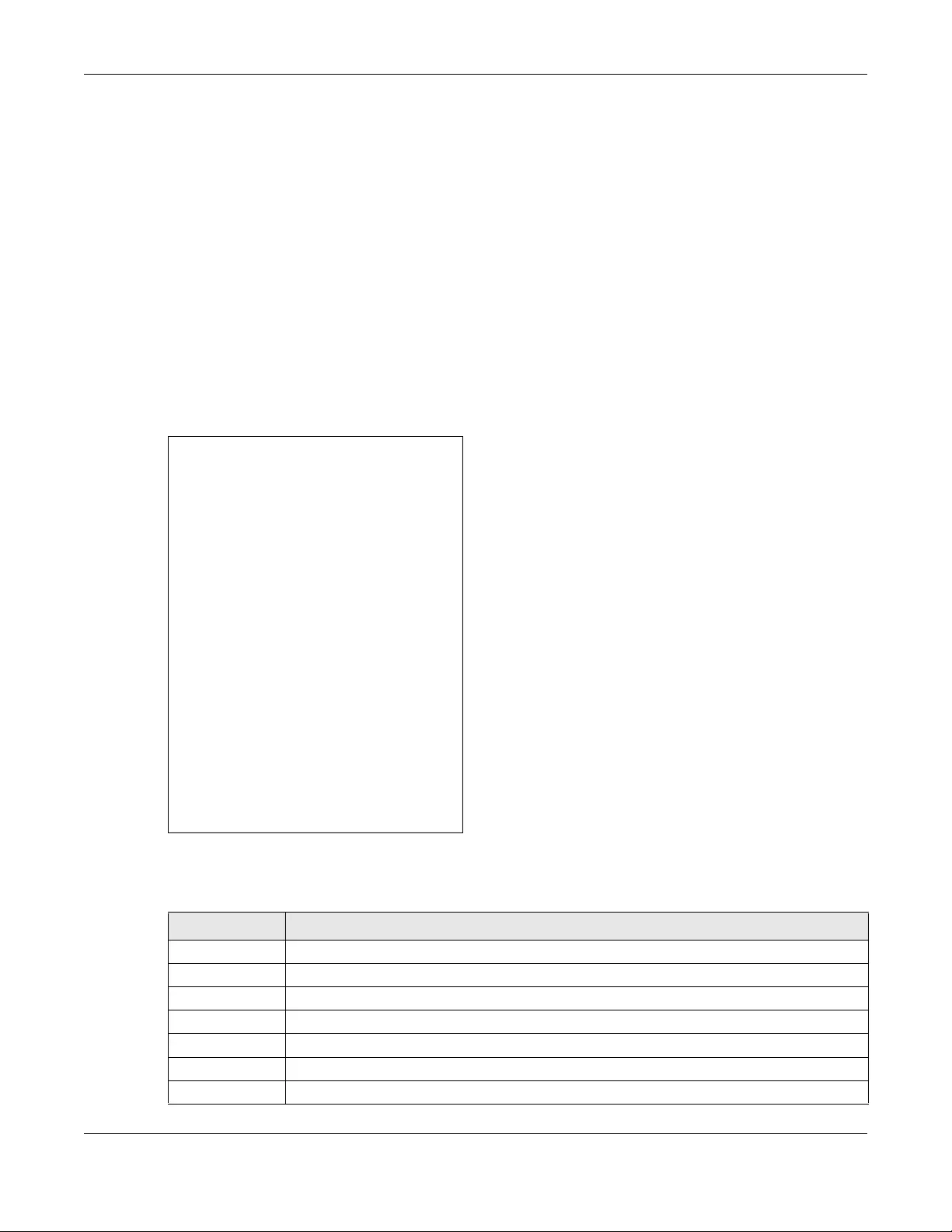
Chapter 25 Printer Manager
ZyWALL USG FLEX Series User’s Guide
541
For example, if 2030 accounts (each priced at $1) have been created from 2013/05/01 00:00:00 to 2013/
05/31 19:59:59, the monthly account report includes the latest 2000 accounts, so the total would be
$2,000 instead of $2,030.
Use the Monitor > System Status > Dynamic Guest screen to see the accounts generated on another
day or month (up to 2000 entries total).
25.4.5 System Status
This report shows the current system information such as the host name and WAN IP address.
Key combination: A B C C A
The following figure shows an example.
Figure 370 System Status Example
The following table describes the labels in this report.
System Status
--------------------------------------
Item Description
--------------------------------------
SYST 02:02:35
WAST Link up
WLST Activate
FWVR 2.50(AACG.0)
BTVR 1.22
WAMA 00-90-0E-00-4A-29
LAMA 00-90-0E-00-4A-30
WAIP 10.21.2.267
LAIP 172.16.0.1
WLIP 10.59.1.1
DHSP 10.59.1.33
DHEP 10.59.1.254
--------------------------------------
CPUS 5%
MEMS 40%
DKST 5%
--------------------------------------
2012/04/12 17:10:22
---End---
Table 217 System Status
LABEL DESCRIPTION
SYST This field displays the time since the system was last restarted.
WAST This field displays the WAN connection status.
WLST This field displays the status of the Zyxel Device’s wireless LAN.
FWVR This field displays the version of the firmware on the Zyxel Device.
BTVR This field displays the version of the bootrom.
WAMA This field displays the MAC address of the Zyxel Device on the WAN.
LAMA This field displays the MAC address of the Zyxel Device on the LAN.
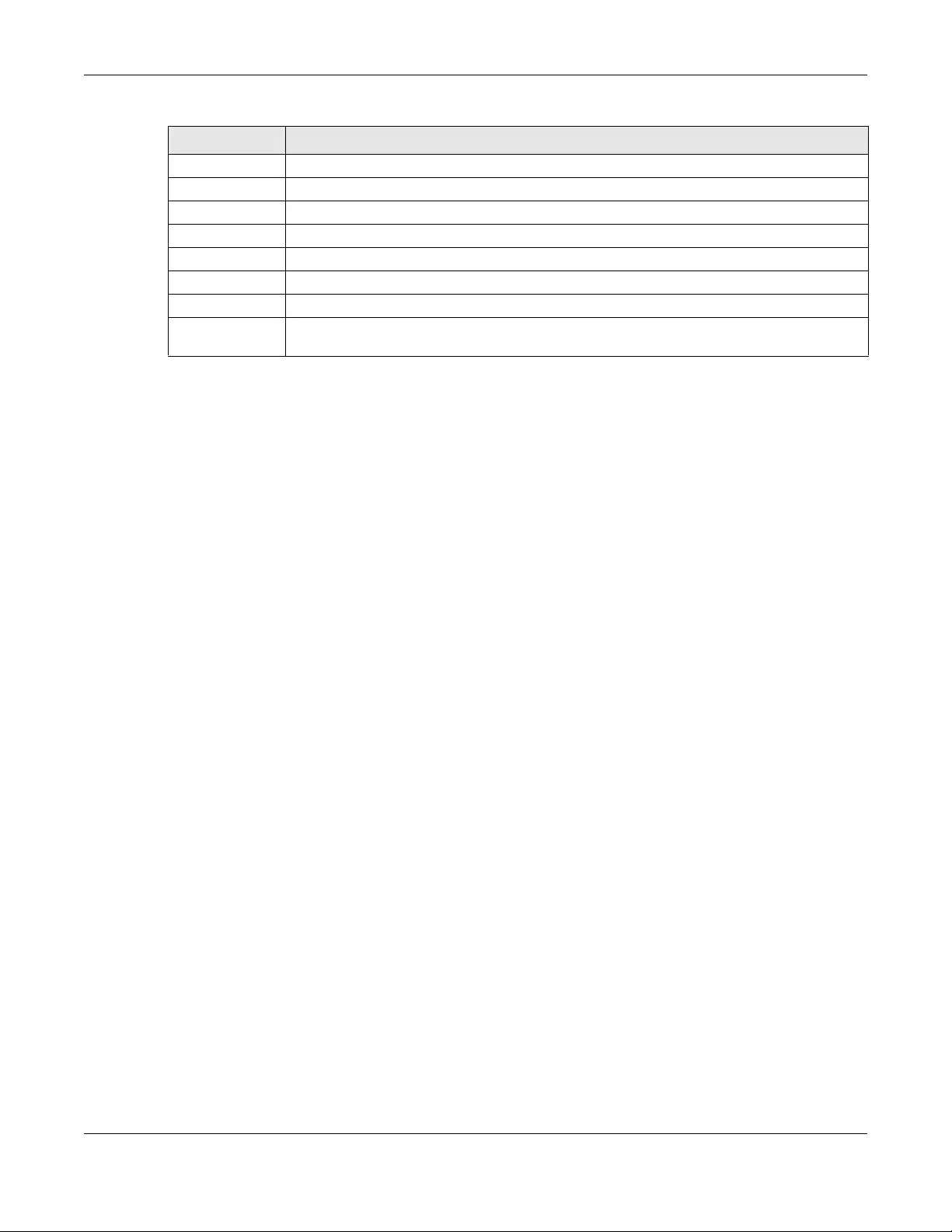
Chapter 25 Printer Manager
ZyWALL USG FLEX Series User’s Guide
542
WAIP This field displays the IP address of the WAN port on the Zyxel Device.
LAIP This field displays the IP address of the LAN port on the Zyxel Device.
WLIP This field displays the IP address of the wireless LAN interface on the Zyxel Device.
DHSP This field displays the first of the continuous addresses in the IP address pool.
DHEP This field displays the end of the continuous addresses in the IP address pool.
CPUS This field displays the Zyxel Device’s recent CPU usage.
MEMS This field displays the Zyxel Device’s recent memory usage.
DKST This field displays what percentage of the Zyxel Device’s on-board flash memory is currently
being used.
Table 217 System Status (continued)
LABEL DESCRIPTION

ZyWALL USG FLEX Series User’s Guide
543
CHAPTER 26
Free Time
26.1 Free Time Overview
With Free Time, the Zyxel Device can create dynamic guest accounts that allow users to browse the
Internet free of charge for a specified period of time.
26.1.1 What You Can Do in this Chapter
Use the Free Time screen (see Section 26.2 on page 543) to turn on this feature to allow users to get a
free account for Internet surfing during the specified time period.
26.2 The Free Time Screen
Use this screen to enable and configure the free time settings. Click Configuration > Hotspot > Free Time
to open the following screen.
Figure 371 Configuration > Hotspot > Free Time

Chapter 26 Free Time
ZyWALL USG FLEX Series User’s Guide
544
The following table describes the labels in this screen.
Table 218 Configuration > Hotspot > Free Time
LABEL DESCRIPTION
Enable Free Time Select the check box to turn on the free time feature.
Note: After you set up web authentication policies and enable the free time feature
on the Zyxel Device, a link displays in the login screen when users try to access
the Internet. The link redirects users to a screen where they can get a free
account.
Free Time Period Select the duration of time period for which the free time account is allowed to access the
Internet.
Reset Time Select Daily to have the Zyxel Device allow free account access every day at the specified
time.
Select Weekly to have the Zyxel Device allow free account access once a week on the day
you select.
Select Monthly to have the Zyxel Device allow free account access once a month on a set
date.
When your free period ends, you will see a message telling you when you can use free time
again. This depends on the Reset Time period chosen.
Time If you select Daily, select the time in 24-hour format at which the new free time account is
allowed to access the Internet.
Day If you select Weekly, select the day on which the new free time account is allowed to access
the Internet.
If you select Monthly, enter the date on which the new free time account is allowed to access
the Internet. If the date you selected is not available in a month, such as 30th or 31th, the Zyxel
Device allows the free account access on the last day of the month.
Maximum
Registration
Number Before
Reset Time
Enter the maximum number of users that are allowed to log in for Internet access with a free
guest account before the time specified in the Reset Time field. This also sets how many free
guest accounts a user can get.
For example, if you set the Maximum Registration Number Before Reset Time to 1, the Reset
Time to Daily and the Reset Time to 13:00, even the first free guest account has expired at
11:30, the user cannot get a second account and/or access the Internet until 13:00.
Delivery Method Specify how the Zyxel Device provides dynamic guest account information.
Select On-Screen to display the user account information in the web screen.
Select SMS to use Short Message Service (SMS) to send account information in a text message
to the user’s mobile device.
Select On-Screen and SMS to provide the account information both in the web screen and via
SMS text messages.
Note: You should have enabled SMS in the Configuration > System > Notification >
SMS screen to send text messages to the user’s mobile device.
Auto Login Select this to allow users to log into their free account directly without having to enter their user
name and password.
Clearing this requires users to enter their user name and password, and click login to access
their free account.
Hotspot Service
Status
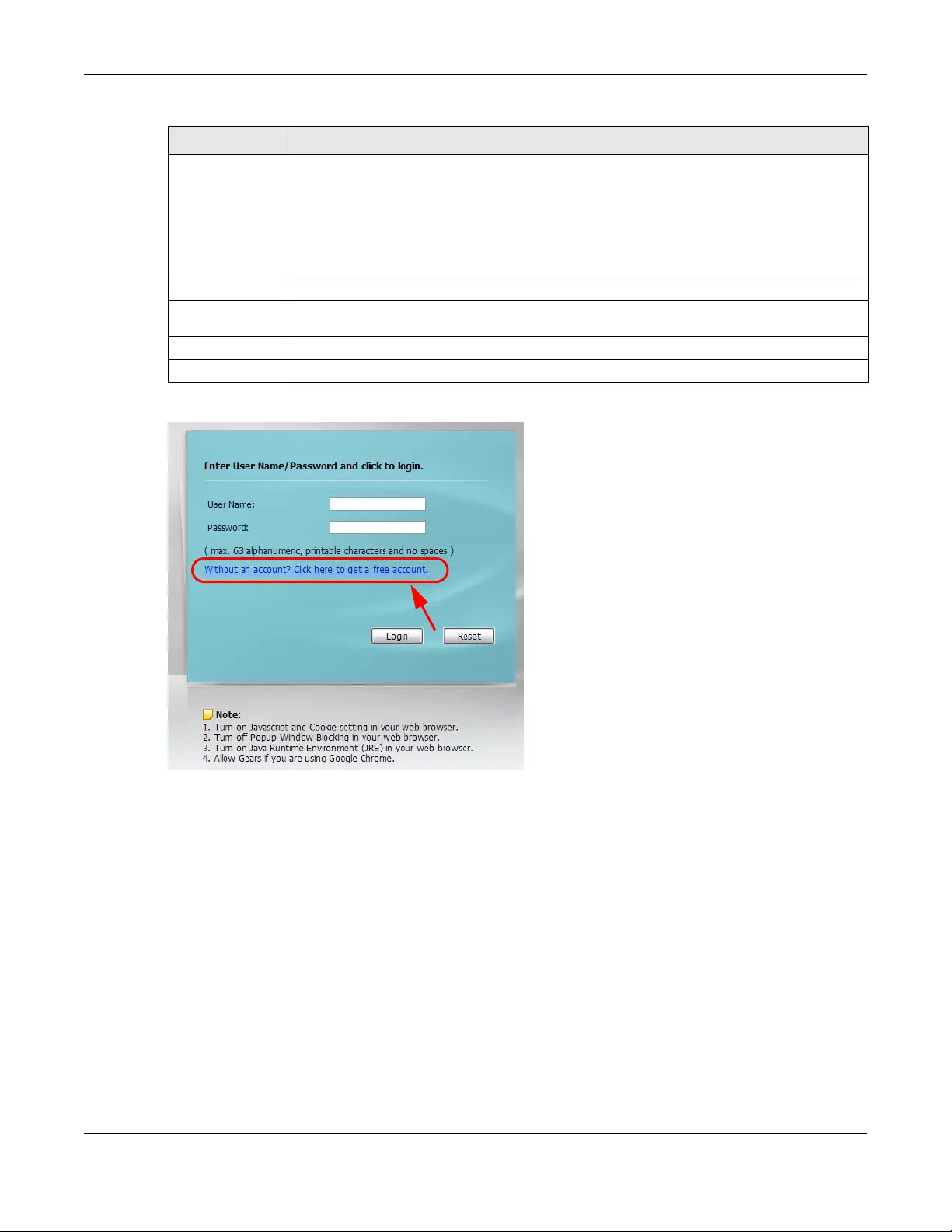
Chapter 26 Free Time
ZyWALL USG FLEX Series User’s Guide
545
The following figure shows an example login screen with a link to create a free guest account.
Service Status This field displays whether a service license is enabled at myZyxel (Activated) or not (Not
Activated) or expired (Expired). It displays the remaining Grace Period if your license has
Expired. It displays Not Licensed if there isn’t a license to be activated for this service.
If you need a license or a trial license has expired, click Buy to buy a new one. If a Standard
license has expired, click Renew to extend the license.
Then, click Activate to connect with the myZyxel server to activate the new license.
Service Type This shows whether you have a trial or standard license or none (Tr ial, Standard, None).
Expiration
Date This shows when your hotspot license will expire.
Apply Click this button to save your changes to the Zyxel Device.
Reset Click this button to return the screen to its last-saved settings.
Table 218 Configuration > Hotspot > Free Time (continued)
LABEL DESCRIPTION

Chapter 26 Free Time
ZyWALL USG FLEX Series User’s Guide
546
If you enable both online payment service and free time feature on the Zyxel Device, the link description
in the login screen will be mainly for online payment service. You can still click the link to get a free
account.
If SMS is enabled on the Zyxel Device, you have to enter your mobile phone number before clicking OK
to get a free guest account.
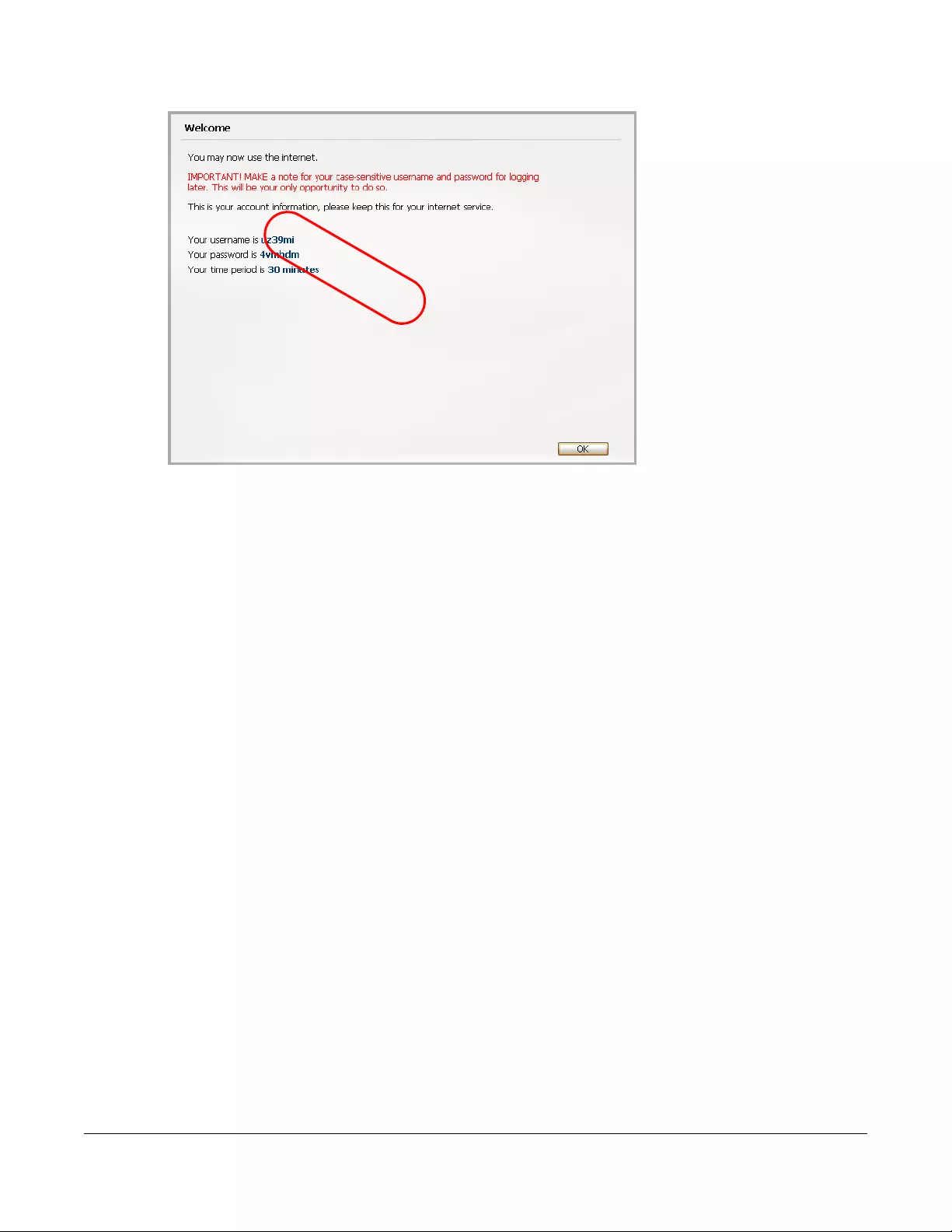
ZyWALL USG FLEX Series User’s Guide
547
The guest account information then displays on the screen and/or is sent to the configured mobile
phone number.
EXAMPLE
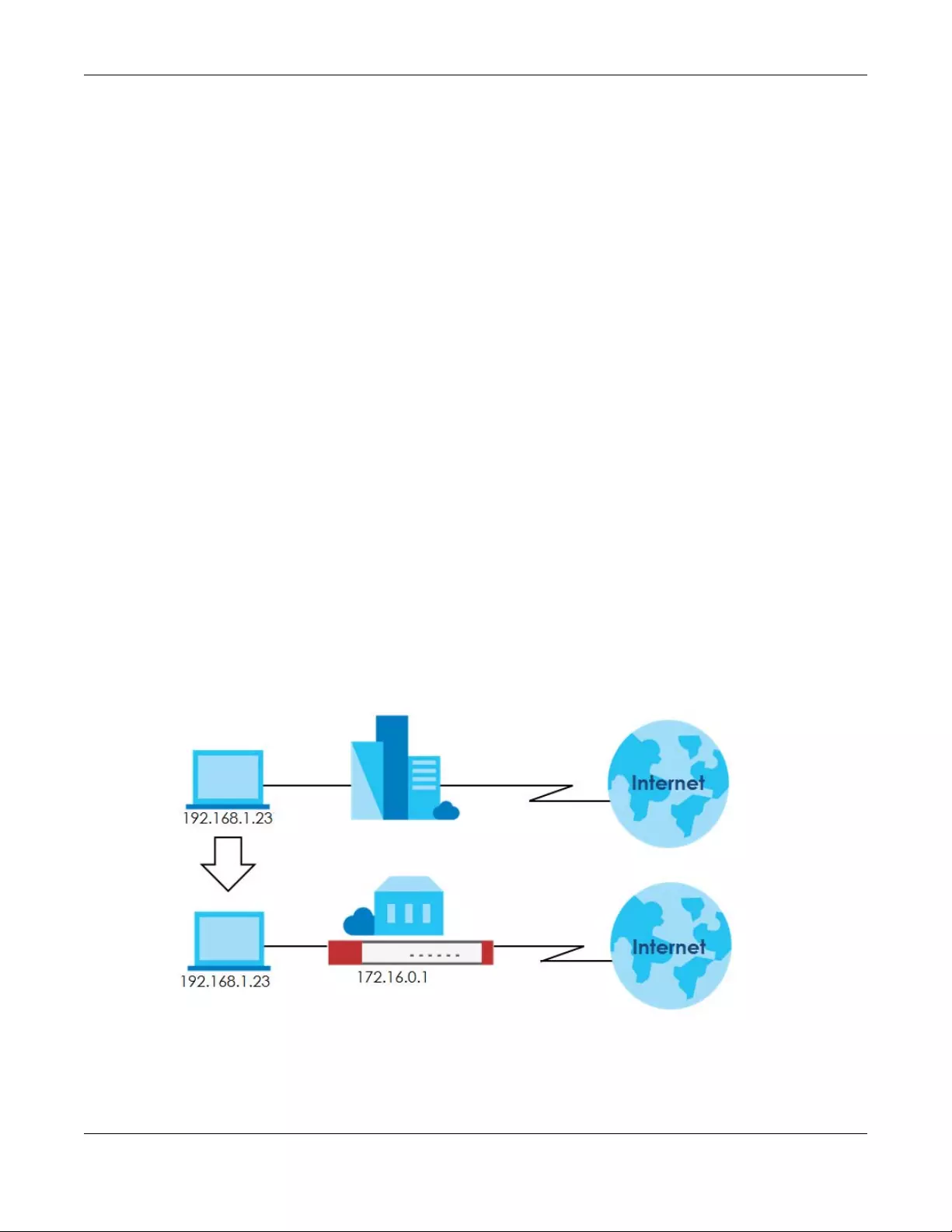
Chapter 27 IPnP
ZyWALL USG FLEX Series User’s Guide
548
CHAPTER 27
IPnP
27.1 IPnP Overview
IP Plug and Play (IPnP) allows a computer to access the Internet without changing the network settings
(such as IP address and subnet mask) of the computer, even when the IP addresses of the computer
and the Zyxel Device are not in the same subnet.
When you disable the IPnP feature, only computers with dynamic IP addresses or static IP addresses in
the same subnet as the Zyxel Device’s LAN IP address can connect to the Zyxel Device or access the
Internet through the Zyxel Device.
The IPnP feature does not apply to a computer using either a dynamic IP address or a static IP address
that is in the same subnet as the Zyxel Device's IP address.
Note: You must enable NAT to use the IPnP feature.
The following figure depicts a scenario where a computer is set to use a static private IP address in the
corporate environment. In a residential house where a Zyxel Device is installed, you can still use the
computer to access the Internet without changing the network settings, even when the IP addresses of
the computer and the Zyxel Device are not in the same subnet.
Figure 372 IPnP Application
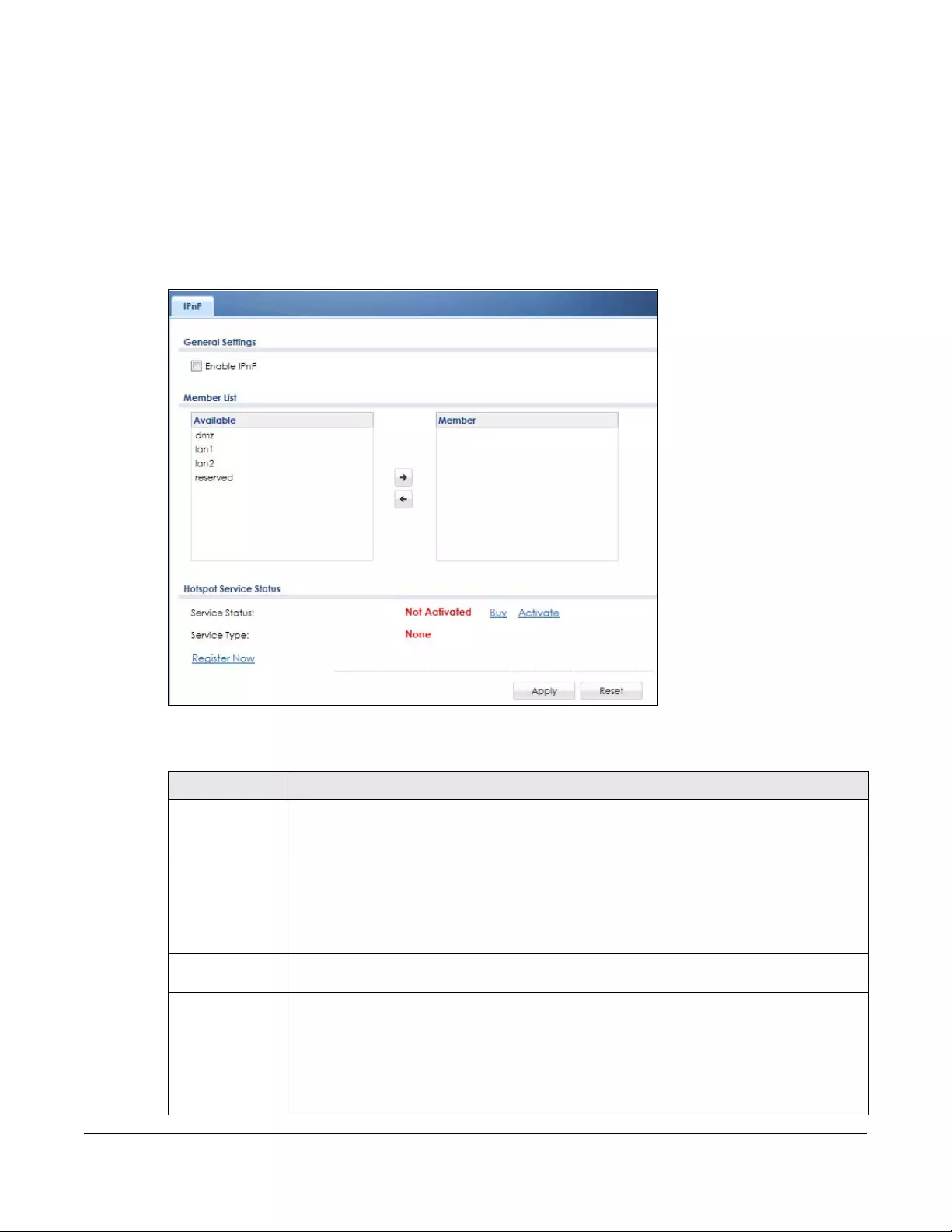
ZyWALL USG FLEX Series User’s Guide
549
27.1.1 What You Can Do in this Chapter
Use the IP screen (Section 27.1.2 on page 549) to enable IPnP on the Zyxel Device and the internal
interface(s).
27.1.2 IPnP Screen
This screen allows you to enable IPnP on the Zyxel Device and specific internal interface(s). To access
this screen click Configuration > Hotspot > IPnP.
Figure 373 Configuration > Hotspot > IPnP
The following table describes the labels in this screen.
Table 219 Configuration > Hotspot > IPnP
LABEL DESCRIPTION
Enable IPnP Select this option to turn on the IPnP feature on the Zyxel Device.
Note: You can enable this feature only when the security policy is enabled.
Member List The Available list displays the name(s) of the internal interface(s) on which you can enable
IPnP.
To enable IPnP on an interface, you can double-click a single entry to move it or use the [Shift]
or [Ctrl] key to select multiple entries and click the right arrow button to add to the Member list.
To remove an interface, select the name(s) in the Member list and click the left arrow button.
Hotspot Service
Status
Service Status This field displays whether a service license is enabled at myZyxel (Activated) or not (Not
Activated) or expired (Expired). It displays the remaining Grace Period if your license has
Expired. It displays Not Licensed if there isn’t a license to be activated for this service.
If you need a license or a trial license has expired, click Buy to buy a new one. If a Standard
license has expired, click Renew to extend the license.
Then, click Activate to connect with the myZyxel server to activate the new license.
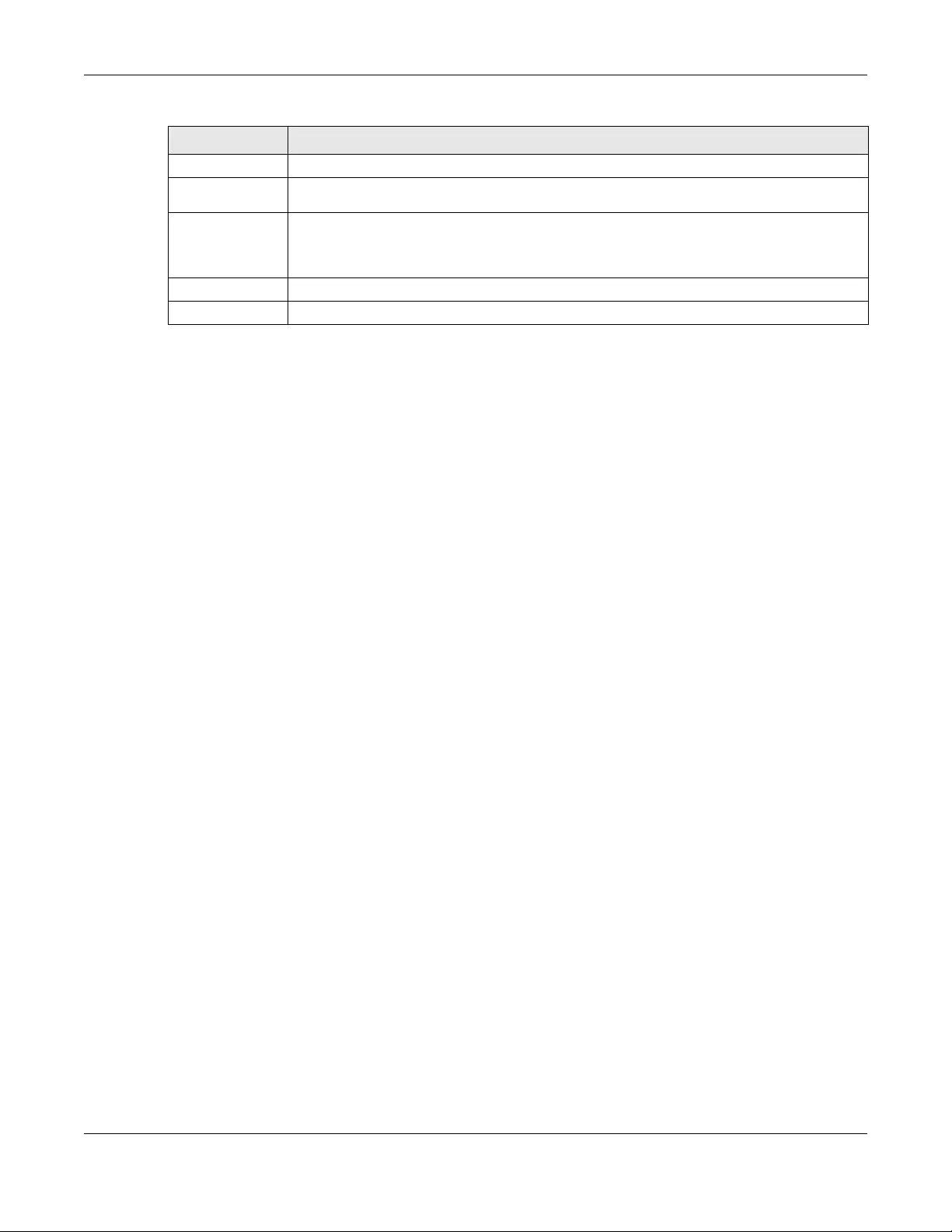
Chapter 27 IPnP
ZyWALL USG FLEX Series User’s Guide
550
Service Type This shows whether you have a trial or standard license or none (Tr ial, Standard, None).
Expiration
Date This shows when your hotspot license will expire.
Register Now Click the link to go to myZyxel where you can register your Zyxel Device and activate the
service.
This link is available only when the service is not activated yet.
Apply Click Apply to save your changes back to the Zyxel Device.
Reset Click Reset to return the screen to its last-saved settings.
Table 219 Configuration > Hotspot > IPnP (continued)
LABEL DESCRIPTION

ZyWALL USG FLEX Series User’s Guide
551
CHAPTER 28
Walled Garden
28.1 Walled Garden Overview
A user must log in before the Zyxel Device allows the user’s access to the Internet. However, with a
walled garden, you can define one or more web site addresses that all users can access without
logging in. These can be used for advertisements for example.
28.2 Walled Garden > General Screen
Use this screen to turn on the walled garden feature.
Note: You must enable web authentication before you can access the Walled Garden
screens.
Note: You can configure up to 50 walled garden web site links.
Click Configuration > Hotspot > Walled Garden to display the screen.
Figure 374 Configuration > Hotspot > Walled Garden: General
The following table describes the labels in this screen.
Table 220 Configuration > Hotspot > Walled Garden: General
LABEL DESCRIPTION
Enable Walled
Garden
Select this to turn on the walled garden feature.
Note: This feature works only with the web portal authentication type.
Hotspot Service
Status
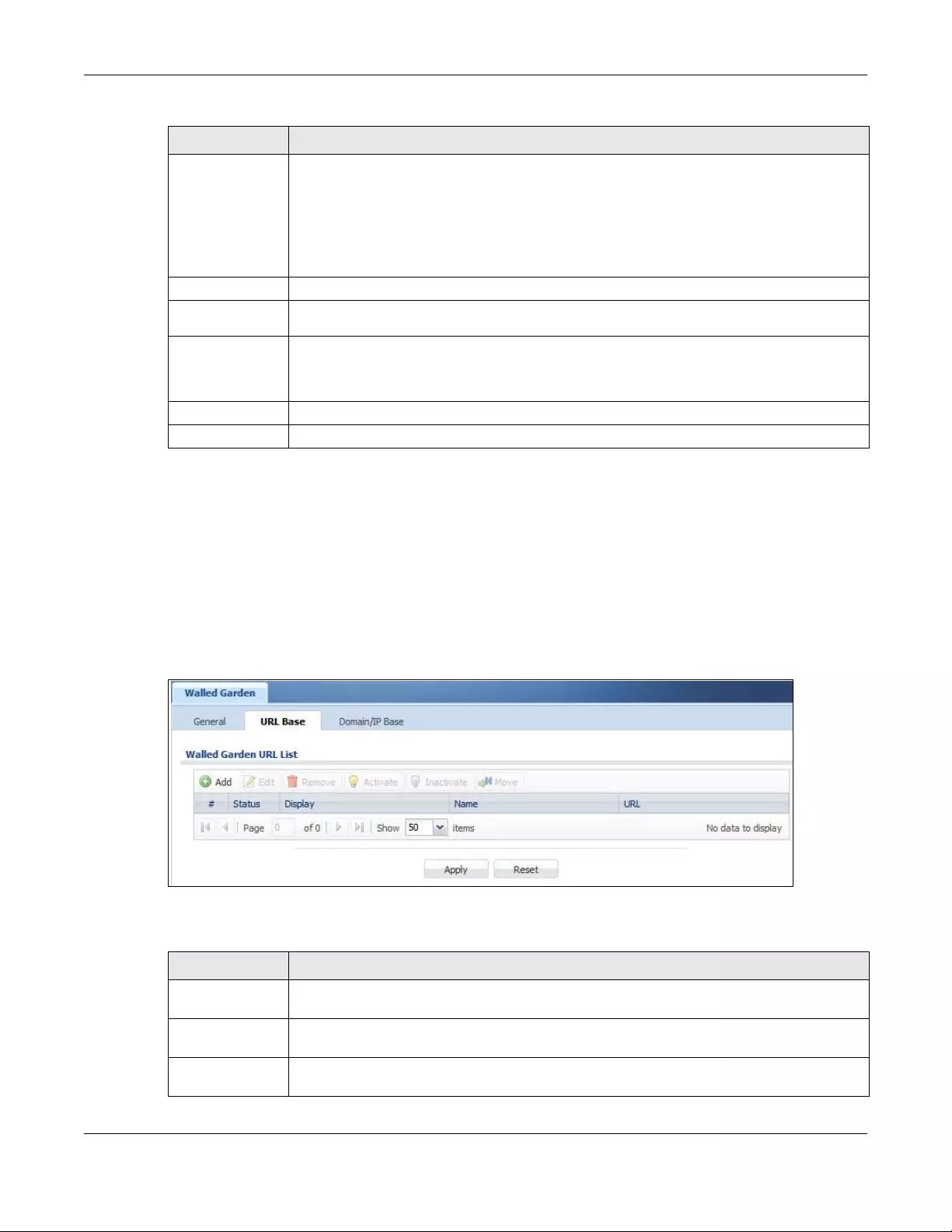
Chapter 28 Walled Garden
ZyWALL USG FLEX Series User’s Guide
552
28.3 Walled Garden > URL Base Screen
Use this screen to configure the walled garden web addresses (URLs that use the HTTP or HTTPS protocol)
for web sites that all users are allowed to access without logging in. The web site link(s) displays in the
user login screen by default.
Click Configuration > Hotspot > Walled Garden and then select the URL Base tab to display the screen.
Figure 375 Configuration > Hotspot > Walled Garden: URL Base
The following table describes the labels in this screen.
Service Status This field displays whether a service license is enabled at myZyxel (Activated) or not (Not
Activated) or expired (Expired). It displays the remaining Grace Period if your license has
Expired. It displays Not Licensed if there isn’t a license to be activated for this service.
If you need a license or a trial license has expired, click Buy to buy a new one. If a Standard
license has expired, click Renew to extend the license.
Then, click Activate to connect with the myZyxel server to activate the new license.
Service Type This shows whether you have a trial or standard license or none (Trial, Standard, None).
Expiration
Date This shows when your hotspot license will expire.
Register Now Click the link to go to myZyxel where you can register your Zyxel Device and activate the
service.
This link is available only when the service is not activated yet.
Apply Click this button to save your changes to the Zyxel Device.
Reset Click this button to return the screen to its last-saved settings.
Table 220 Configuration > Hotspot > Walled Garden: General (continued)
LABEL DESCRIPTION
Table 221 Configuration > Hotspot > Walled Garden: URL Based
LABEL DESCRIPTION
Walled Garden
URL List
Use this table to manage the list of walled garden web site links.
Add Click this to create a new entry. Select an entry and click Add to create a new entry after the
selected entry.
Edit Double-click an entry or select it and click Edit to open a screen where you can modify the
entry’s settings.
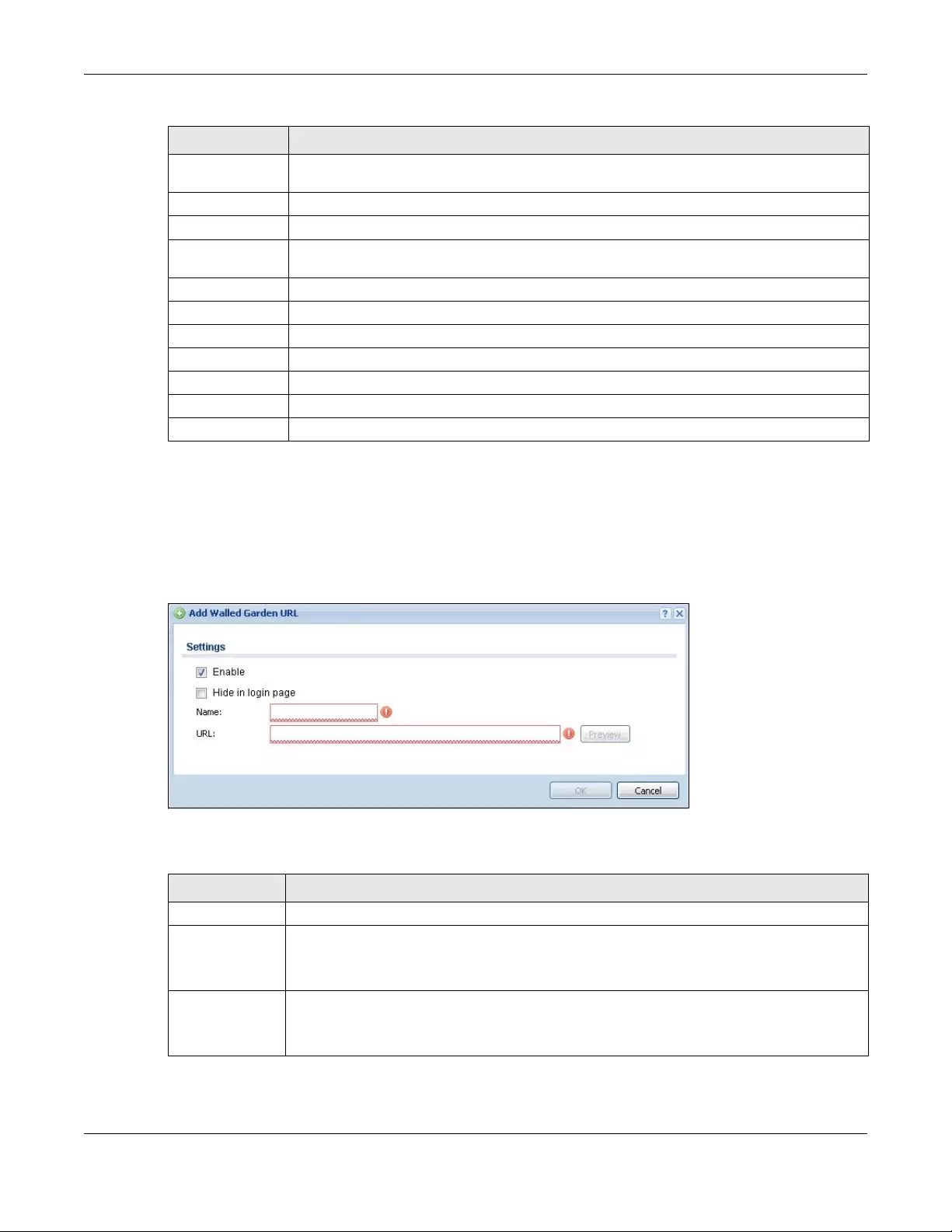
Chapter 28 Walled Garden
ZyWALL USG FLEX Series User’s Guide
553
28.3.1 Adding/Editing a Walled Garden URL
Go to the Configuration > Web Authentication > Walled Garden > URL Base screen. Click Add or select
an entry and click the Edit to open the Add/Edit Walled Garden URL screen. Use this screen to configure
a walled garden web site URL entry.
Figure 376 Configuration > Hotspot > Walled Garden: URL Base: Add/Edit
The following table describes the labels in this screen.
Remove To remove an entry, select it and click Remove. The Zyxel Device confirms you want to remove
it before doing so.
Activate To turn on an entry, select it and click Activate.
Inactivate To turn off an entry, select it and click Inactivate.
Move To move an entry to a different number in the list, click the Move icon. In the field that appears,
specify the number to which you want to move the interface.
#This field is a sequential value, and it is not associated with any entry.
Status This icon is lit when the entry is active and dimmed when the entry is inactive.
Display This icon is lit when the web site link is set to display in the user login screen.
Name This field displays the descriptive name of the web site.
URL This field displays the URL of the web site.
Apply Click this button to save your changes to the Zyxel Device.
Reset Click this button to return the screen to its last-saved settings.
Table 221 Configuration > Hotspot > Walled Garden: URL Based (continued)
LABEL DESCRIPTION
Table 222 Configuration > Hotspot > Walled Garden: URL Base: Add/Edit
LABEL DESCRIPTION
Enable Select this to activate the entry.
Hide in login
page
Select this to not display the web site link in the user login screen.
This is helpful if a user’s access to a specific web site is required to stay connected but he or she
doesn’t need to visit that web site.
Name Enter a descriptive name for the walled garden link to be displayed in the login screen.
You can use up to 31 alphanumeric characters (A-Z, a-z, 0-9) and underscores (_). Spaces are
also allowed. The first character must be a letter.
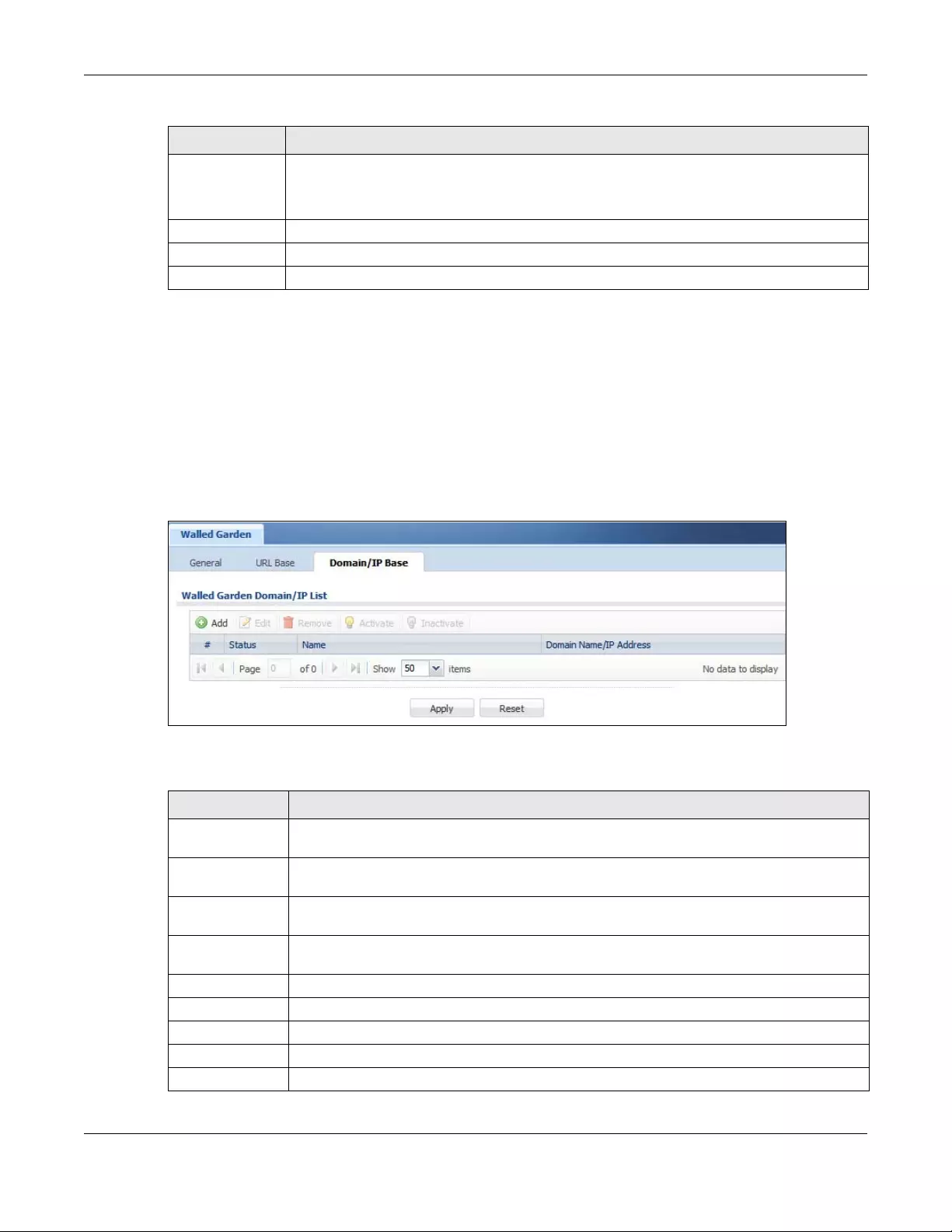
Chapter 28 Walled Garden
ZyWALL USG FLEX Series User’s Guide
554
28.4 Walled Garden > Domain/IP Base Screen
Use this screen to configure walled garden web site links, which use a (wildcard) domain name or an IP
address. These links will not display in the login page.
Click Configuration > Hotspot > Walled Garden and then select the Domain/IP Base tab to display the
screen.
Figure 377 Configuration > Hotspot > Walled Garden: Domain/IP Base
The following table describes the labels in this screen.
URL Enter the URL of the web site.
Use “http://” or “https://” followed by up to 262 characters (0-9a-zA-Z;/?:@&=+$\.-_!~*'()%). For
example, http://www.example.com or http://172.16.1.35.
Preview Click this button to open the specified web site in a new frame.
OK Click OK to save your changes back to the Zyxel Device.
Cancel Click Cancel to exit this screen without saving.
Table 222 Configuration > Hotspot > Walled Garden: URL Base: Add/Edit (continued)
LABEL DESCRIPTION
Table 223 Configuration > Hotspot > Walled Garden: Domain/IP Based
LABEL DESCRIPTION
Walled Garden
Domain/IP List
Use this table to manage the list of walled garden web site links.
Add Click this to create a new entry. Select an entry and click Add to create a new entry after the
selected entry.
Edit Double-click an entry or select it and click Edit to open a screen where you can modify the
entry’s settings.
Remove To remove an entry, select it and click Remove. The Zyxel Device confirms you want to remove
it before doing so.
Activate To turn on an entry, select it and click Activate.
Inactivate To turn off an entry, select it and click Inactivate.
#This field is a sequential value, and it is not associated with any entry.
Status This icon is lit when the entry is active and dimmed when the entry is inactive.
Name This field displays the descriptive name of the web site.

Chapter 28 Walled Garden
ZyWALL USG FLEX Series User’s Guide
555
28.4.1 Adding/Editing a Walled Garden Domain or IP
Go to the Configuration > Hotspot > Walled Garden > Domain/IP Base screen. Click Add or select an
entry and click the Edit to open the Add/Edit Walled Garden Domain/IP screen. Use this screen to
configure the domain name or IP address entry for a walled garden web site.
Figure 378 Configuration > Hotspot > Walled Garden: Domain/IP Base: Add/Edit
The following table describes the labels in this screen.
28.4.2 Walled Garden Login Example
The following figure shows the user login screen with two walled garden links. The links are named
WalledGardenLink1 through 2 for demonstration purposes.
Domain Name/IP
Address
This field displays the domain name or IP address and subnet mask of the web site.
Apply Click this button to save your changes to the Zyxel Device.
Reset Click this button to return the screen to its last-saved settings.
Table 223 Configuration > Hotspot > Walled Garden: Domain/IP Based (continued)
LABEL DESCRIPTION
Table 224 Configuration > Hotspot > Walled Garden: Domain/IP Base: Add/Edit
LABEL DESCRIPTION
Enable Select this to activate the entry.
Name Enter a descriptive name for the walled garden link.
You can use up to 31 alphanumeric characters (A-Z, a-z, 0-9) and underscores (_). Spaces are
also allowed. The first character must be a letter.
Type Select whether you want to create the link by entering a domain name or an IP address.
Domain Name /
IP Address
If you select Domain, type a Fully-Qualified Domain Name (FQDN) of a web site. An FQDN starts
with a host name and continues all the way up to the top-level domain name. For example,
www.zyxel.com.tw is a fully qualified domain name, where “www” is the host, “zyxel” is the
third-level domain, “com” is the second-level domain, and “tw” is the top level domain.
Underscores are not allowed. Use "*." as a prefix in the FQDN for a wildcard domain name (for
example, *.example.com).
If you select IP, enter the IP address and subnet mask of the web site.
OK Click OK to save your changes back to the Zyxel Device.
Cancel Click Cancel to exit this screen without saving.

Chapter 28 Walled Garden
ZyWALL USG FLEX Series User’s Guide
556
Figure 379 Walled Garden Login Example
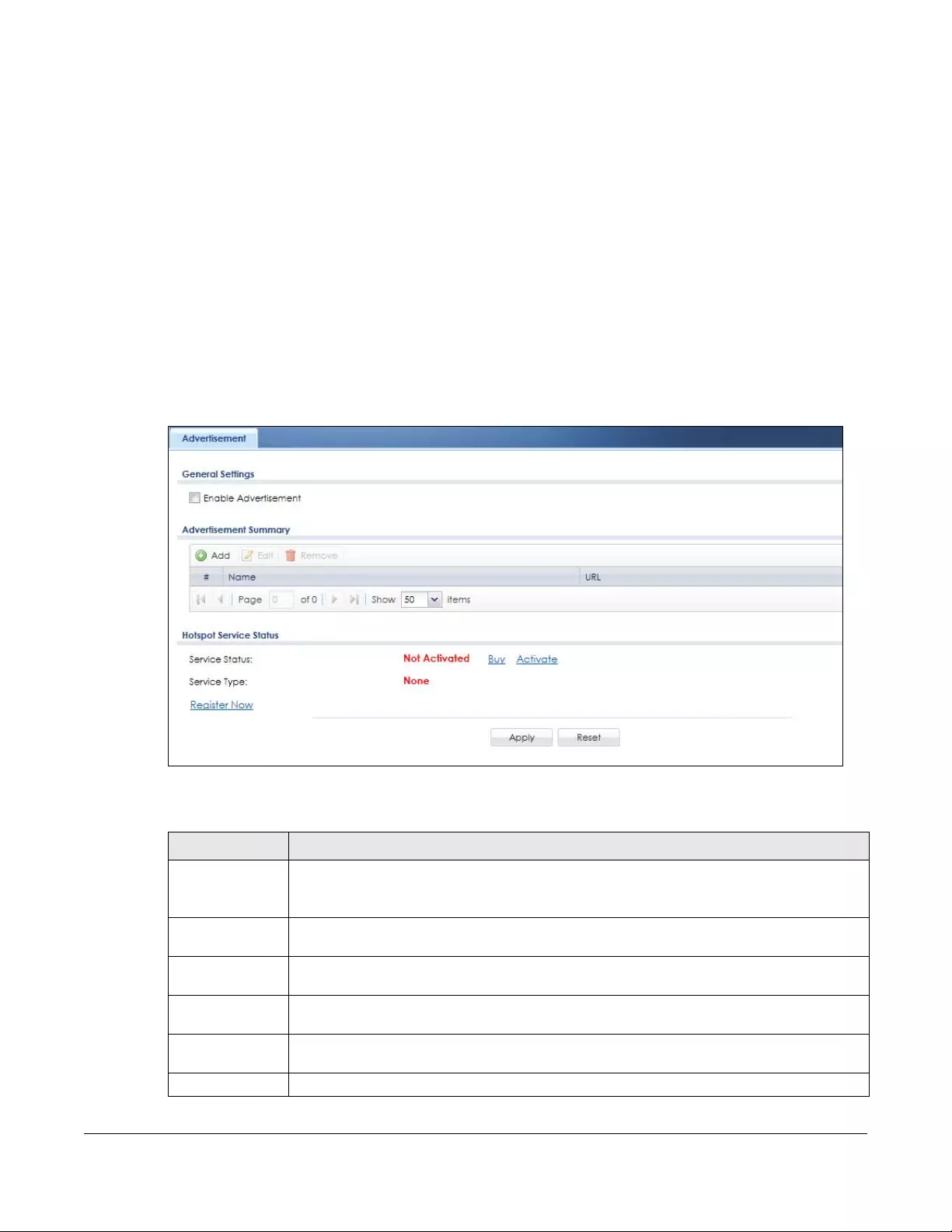
ZyWALL USG FLEX Series User’s Guide
557
CHAPTER 29
Advertisement Screen
29.1 Advertisement Overview
Use this screen to set the Zyxel Device to display an advertisement web page as the first web page
whenever the user connects to the Internet.
Click Configuration > Hotspot > Advertisement to display the screen.
Figure 380 Configuration > Hotspot > Advertisement
The following table gives an overview of the objects you can configure.
Table 225 Configuration > Hotspot > Advertisement
LABEL DESCRIPTION
Enable
Advertisement
Select this to turn on the advertisement feature.
Note: This feature works only when you enable web authentication.
Advertisement
Summary
Use this table to manage the list of advertisement web pages.
Add Click this to create a new entry. Select an entry and click Add to create a new entry after the
selected entry.
Edit Double-click an entry or select it and click Edit to open a screen where you can modify the
entry’s settings.
Remove To remove an entry, select it and click Remove. The Zyxel Device confirms you want to remove
it before doing so.
#This field is a sequential value, and it is not associated with any entry.
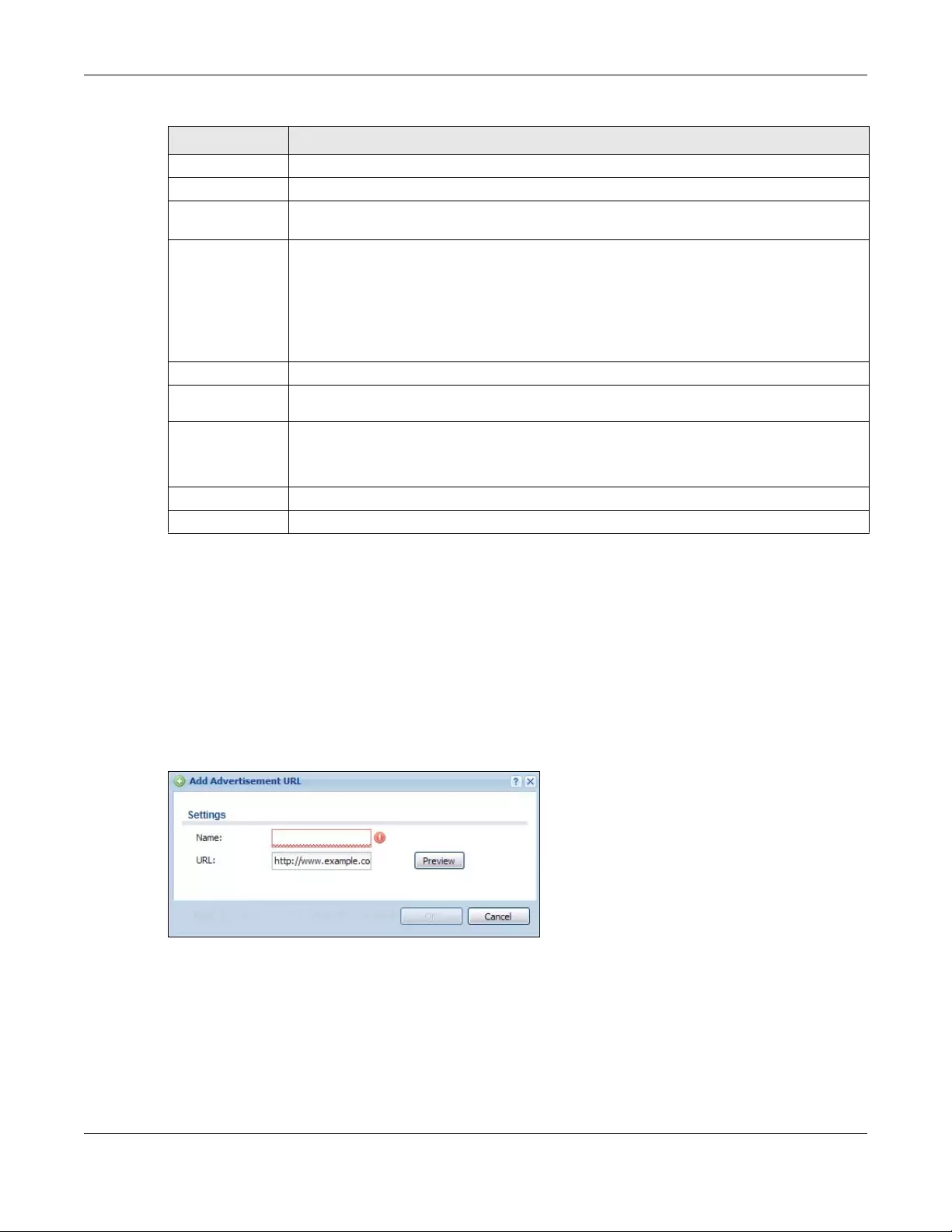
Chapter 29 Advertisement Screen
ZyWALL USG FLEX Series User’s Guide
558
29.1.1 Adding/Editing an Advertisement URL
Click Configuration > Hotspot > Advertisement and then the Add (or Edit) icon in the Advertisement
Summary section to open the Add/Edit Advertisement URL screen. Use this screen to configure an
advertisement address entry.
Note: You can create up to 20 advertisement URL entries. The Zyxel Device randomly picks
one and open the specified web site in a new frame when an authenticated user is
attempts to access the Internet.
Figure 381 Configuration > Hotspot > Advertisement > Add/Edit
Name This field displays the descriptive name of web site.
URL This field displays the address of web site.
Hotspot Service
Status
Service Status This field displays whether a service license is enabled at myZyxel (Activated) or not (Not
Activated) or expired (Expired). It displays the remaining Grace Period if your license has
Expired. It displays Not Licensed if there isn’t a license to be activated for this service.
If you need a license or a trial license has expired, click Buy to buy a new one. If a Standard
license has expired, click Renew to extend the license.
Then, click Activate to connect with the myZyxel server to activate the new license.
Service Type This shows whether you have a trial or standard license or none (Trial, Standard, None).
Expiration
Date This shows when your hotspot license will expire.
Register Now Click the link to go to myZyxel where you can register your Zyxel Device and activate the
service.
This link is available only when the service is not activated yet.
Apply Click this button to save your changes to the Zyxel Device.
Reset Click this button to return the screen to its last-saved settings.
Table 225 Configuration > Hotspot > Advertisement (continued)
LABEL DESCRIPTION

Chapter 29 Advertisement Screen
ZyWALL USG FLEX Series User’s Guide
559
The following table gives an overview of the objects you can configure.
Table 226 Configuration > Hotspot > Advertisement > Add/Edit
LABEL DESCRIPTION
Name Enter a descriptive name for the advertisement web site.
You can use up to 31 alphanumeric characters (A-Z, a-z, 0-9) and underscores (_). Spaces are
not allowed. The first character must be a letter.
URL Enter the URL or IP address of the web site.
Use “http://” followed by up to 262 characters (0-9a-zA-Z;/?:@&=+$\.-_!~*'()%). For example,
http://www.example.com or http://172.16.1.35.
Preview Click this button to open the specified web site in a new frame.
OK Click OK to save your changes back to the Zyxel Device.
Cancel Click Cancel to exit this screen without saving.
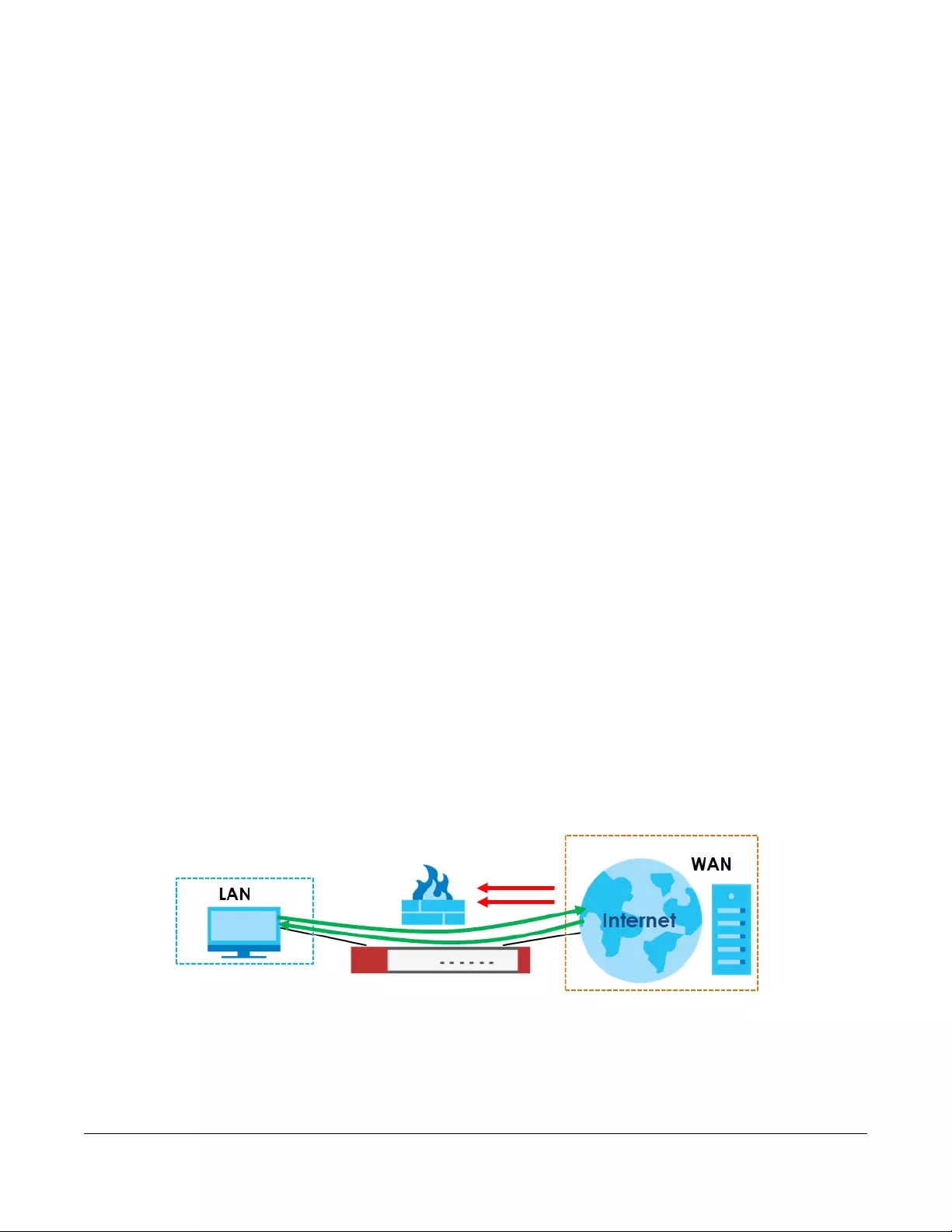
ZyWALL USG FLEX Series User’s Guide
560
CHAPTER 30
Security Policy
30.1 Overview
A security policy is a template of security settings that can be applied to specific traffic at specific times.
The policy can be applied:
• to a specific direction of travel of packets (from / to)
• to a specific source and destination address objects
• to a specific type of traffic (services)
• to a specific user or group of users
• at a specific schedule
The policy can be configured:
• to allow or deny traffic that matches the criteria above
• send a log or alert for traffic that matches the criteria above
• to apply the actions configured in the profiles (application patrol, content filter, IDP, anti-malware,
email security) to traffic that matches the criteria above
Note: Security policies can be applied to both IPv4 and IPv6 traffic.
The security policies can also limit the number of user sessions.
The following example shows the Zyxel Device’s default security policies behavior for a specific direction
of travel of packets. WAN to LAN traffic and how stateful inspection works. A LAN user can initiate a
Telnet session from within the LAN zone and the Zyxel Device allows the response. However, the Zyxel
Device blocks incoming Telnet traffic initiated from the WAN zone and destined for the LAN zone.
Figure 382 Default Directional Security Policy Example

Chapter 30 Security Policy
ZyWALL USG FLEX Series User’s Guide
561
30.2 One Security
OneSecurity is a website with guidance on configuration walkthroughs, troubleshooting, and other
information. This is an example of a port forwarding configuration walkthrough.
Figure 383 Example of a Port Forwarding Configuration Walkthrough.
This is an example of L2TP over IPSec VPN Troubleshooting troubleshooting.
12
34
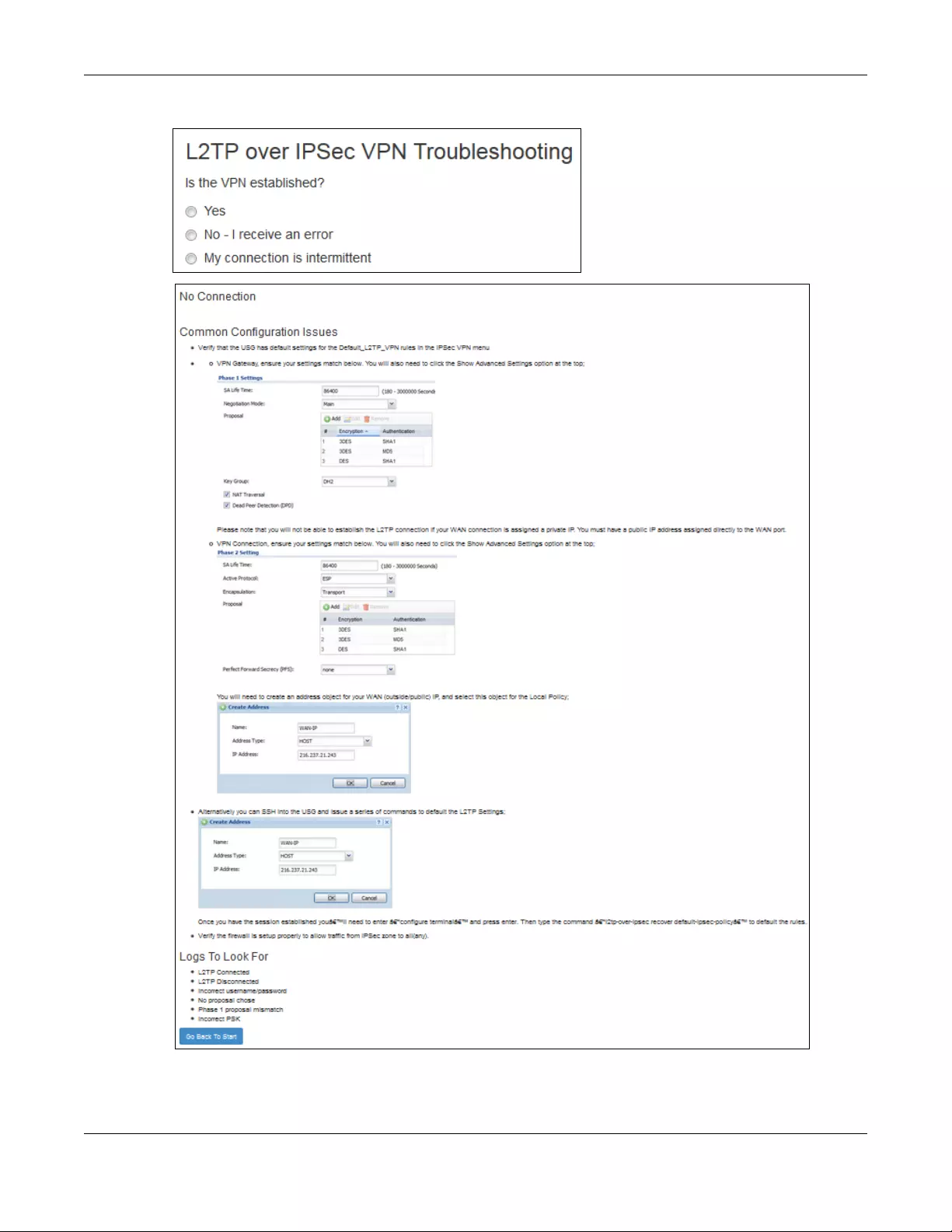
Chapter 30 Security Policy
ZyWALL USG FLEX Series User’s Guide
562
Figure 384 Example of L2TP over IPSec Troubleshooting - 1
1
2
23
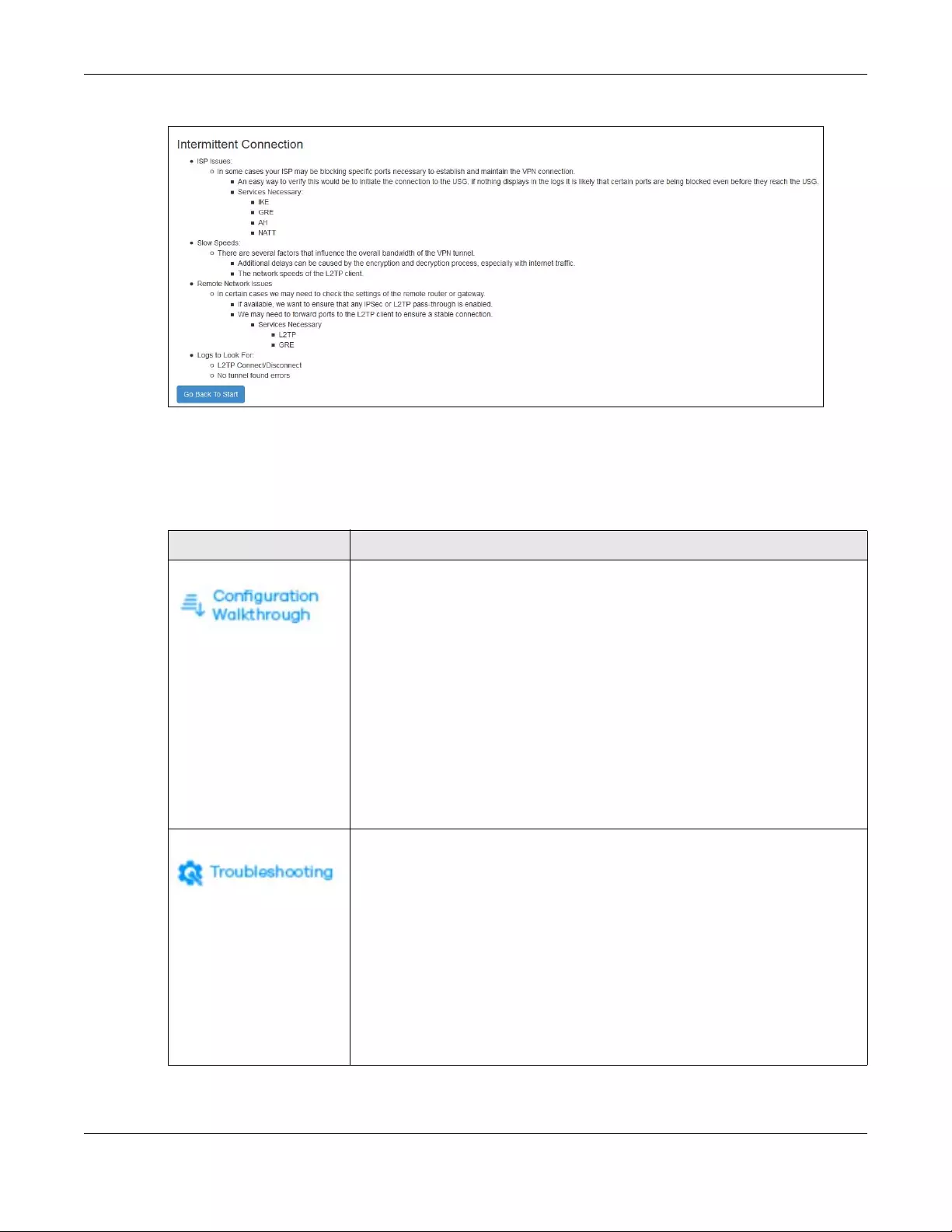
Chapter 30 Security Policy
ZyWALL USG FLEX Series User’s Guide
563
Figure 385 Example of L2TP over IPSec Troubleshooting - 2
In the Zyxel Device, you will see icons that link to OneSecurity walkthroughs, troubleshooting and so on in
certain screens.
For example, at the time of writing, these are the OneSecurity icons you can see.
Table 227 OneSecurity Icons
ONESECURITY ICON SCREEN
Click this icon to go to a series of screens that guide you how to configure the
feature. Note that the walkthroughs do not perform the actual configuring, but just
show you how to do it.
• Device HA > General
• Licensing > Registration
• Network > NAT
• Network > Routing > Policy Route
• Security Service > App Patrol
• Security Service > Content Filter
• Security Service > IDP
• Security Service > Anti-Malware
• Security Service > Email Security
•VPN > IPSec VPN
•VPN > SSL VPN
•VPN > L2TP VPN
Click this icon to go to a series of screens that guide you how to fix problems with the
feature.
• Device HA > General
• Network > NAT
• Network > Routing > Policy Route
• Security Service > App Patrol
• Security Service > Content Filter
• Security Service > IDP
• Security Service > Anti-Malware
• Security Service > Email Security
•VPN > IPSec VPN
•VPN > SSL VPN
•VPN > L2TP VPN
3
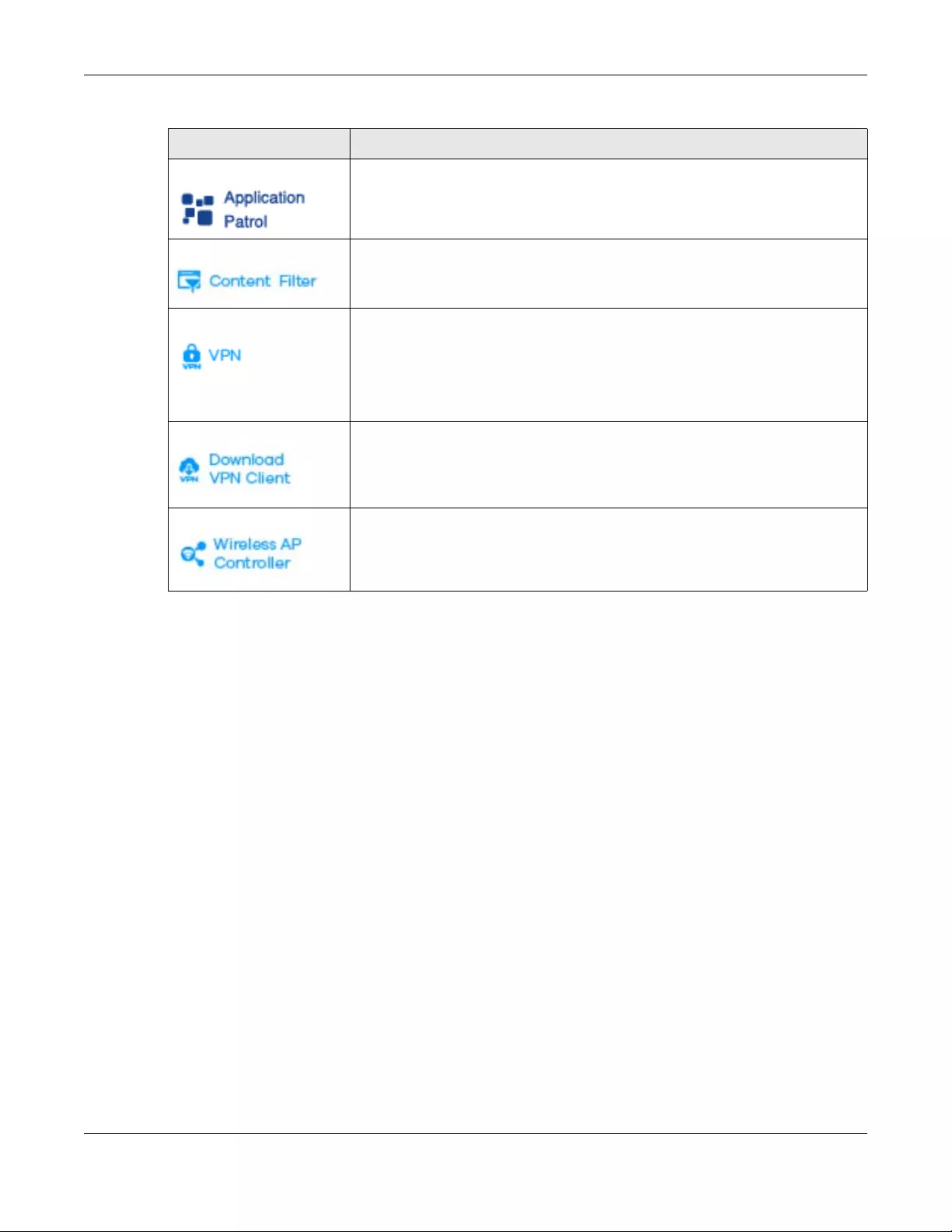
Chapter 30 Security Policy
ZyWALL USG FLEX Series User’s Guide
564
30.3 What You Can Do in this Chapter
• Use the Security Policy Control screens (Section 30.4 on page 566) to enable or disable policies,
asymmetrical routes, and manage and configure policies.
• Use the Anomaly Detection and Prevention (ADP) screens (Section 30.5 on page 572) to detect traffic
with protocol anomalies and take appropriate action.
• Use the Session Control screens (see Section 30.6 on page 581) to limit the number of concurrent NAT/
security policies traffic sessions a client can use.
30.3.1 What You Need to Know
Stateful Inspection
The Zyxel Device uses stateful inspection in its security policies. The Zyxel Device restricts access by
screening data packets against defined access rules. It also inspects sessions. For example, traffic from
one zone is not allowed unless it is initiated by a computer in another zone first.
Zones
A zone is a group of interfaces. Group the Zyxel Device’s interfaces into different zones based on your
needs. You can configure security policies for data passing between zones or even between interfaces.
Click this icon for more information on Application Patrol, which identifies traffic that
passes through the Zyxel Device, so you can decide what to do with specific types
of traffic. Traffic not recognized by application patrol is ignored.
• Security Service > Application Patrol
Click this icon for more information on Content Filter, which controls access to
specific web sites or web content.
• Security Service > Content Filter
Click this icon for more information on IPSec and SSL VPN. Internet Protocol Security
(IPSec) VPN connects IPSec routers or remote users using IPSec client software. SSL
VPN allows users to use a web browser for secure remote user login without need of
a VPN router or VPN client software.
•VPN > IPSec VPN
•VPN > SSL VPN
Click this icon to download VPN client software.
•VPN > IPSec VPN
•VPN > SSL VPN
Click this icon for more information on the Wireless AP Controller which sets how the
Zyxel Device allows APs to connect to the wireless network.
• Wireless > AP Management > Mgnt. AP List
Table 227 OneSecurity Icons (continued)
ONESECURITY ICON SCREEN

Chapter 30 Security Policy
ZyWALL USG FLEX Series User’s Guide
565
Default Directional Security Policy Behavior
Security Policies can be grouped based on the direction of travel of packets to which they apply. Here
is the The Zyxel Device has default Security Policy behavior for traffic going through the Zyxel Device in
various directions.
To-Device Policies
Policies with Device as the To Zone apply to traffic going to the Zyxel Device itself. By default:
• The Security Policy allows only LAN, or WAN computers to access or manage the Zyxel Device.
• The Zyxel Device allows DHCP traffic from any interface to the Zyxel Device.
• The Zyxel Device drops most packets from the WAN zone to the Zyxel Device itself and generates a
log except for AH, ESP, GRE, HTTPS, IKE, NATT.
When you configure a Security Policy rule for packets destined for the Zyxel Device itself, make sure it
does not conflict with your service control rule. The Zyxel Device checks the security policy before the
service control rules for traffic destined for the Zyxel Device.
A From Any To Device direction policy applies to traffic from an interface which is not in a zone.
Global Security Policies
Security Policies with from any and/or to any as the packet direction are called global Security Policies.
The global Security Policies are the only Security Policies that apply to an interface that is not included in
a zone. The from any policies apply to traffic coming from the interface and the to any policies apply to
traffic going to the interface.
Security Policy Rule Criteria
The Zyxel Device checks the schedule, user name (user’s login name on the Zyxel Device), source IP
address and object, destination IP address and object, IP protocol type of network traffic (service) and
Security Service profile criteria against the Security Policies (in the order you list them). When the traffic
matches a policy, the Zyxel Device takes the action specified in the policy.
Table 228 Directional Security Policy Behavior
FROM ZONE TO ZONE BEHAVIOR
From any to Device DHCP traffic from any interface to the Zyxel Device is allowed.
From LAN1 to any (other than
the Zyxel Device)
Traffic from the LAN1 to any of the networks connected to the Zyxel Device is
allowed.
From LAN2 to any (other than
the Zyxel Device)
Traffic from the LAN2 to any of the networks connected to the Zyxel Device is
allowed.
From LAN1 to Device Traffic from the LAN1 to the Zyxel Device itself is allowed.
From LAN2 to Device Traffic from the LAN2 to the Zyxel Device itself is allowed.
From WAN to Device The default services listed in To-Device Policies are allowed from the WAN to the
Zyxel Device itself. All other WAN to Zyxel Device traffic is dropped.
From any to any Traffic that does not match any Security policy is dropped. This includes traffic
from the WAN to any of the networks behind the Zyxel Device.
This also includes traffic to or from interfaces that are not assigned to a zone
(extra-zone traffic).

Chapter 30 Security Policy
ZyWALL USG FLEX Series User’s Guide
566
User Specific Security Policies
You can specify users or user groups in Security Policies. For example, to allow a specific user from any
computer to access a zone by logging in to the Zyxel Device, you can set up a policy based on the user
name only. If you also apply a schedule to the Security Policy, the user can only access the network at
the scheduled time. A user-aware Security Policy is activated whenever the user logs in to the Zyxel
Device and will be disabled after the user logs out of the Zyxel Device.
Session Limits
Accessing the Zyxel Device or network resources through the Zyxel Device requires a NAT session and
corresponding Security Policy session. Peer to peer applications, such as file sharing applications, may
use a large number of NAT sessions. A single client could use all of the available NAT sessions and
prevent others from connecting to or through the Zyxel Device. The Zyxel Device lets you limit the
number of concurrent NAT/Security Policy sessions a client can use.
30.4 The Security Policy Screen
Asymmetrical Routes
If an alternate gateway on the LAN has an IP address in the same subnet as the Zyxel Device’s LAN IP
address, return traffic may not go through the Zyxel Device. This is called an asymmetrical or “triangle”
route. This causes the Zyxel Device to reset the connection, as the connection has not been
acknowledged.
You can have the Zyxel Device permit the use of asymmetrical route topology on the network (not reset
the connection). However, allowing asymmetrical routes may let traffic from the WAN go directly to the
LAN without passing through the Zyxel Device. A better solution is to use virtual interfaces to put the Zyxel
Device and the backup gateway on separate subnets. Virtual interfaces allow you to partition your
network into logical sections over the same interface. See the chapter about interfaces for more
information.
By putting LAN 1 and the alternate gateway (A in the figure) in different subnets, all returning network
traffic must pass through the Zyxel Device to the LAN. The following steps and figure describe such a
scenario.
1A computer on the LAN1 initiates a connection by sending a SYN packet to a receiving server on the
WAN.
2The Zyxel Device reroutes the packet to gateway A, which is in Subnet 2.
3The reply from the WAN goes to the Zyxel Device.
4The Zyxel Device then sends it to the computer on the LAN1 in Subnet 1.
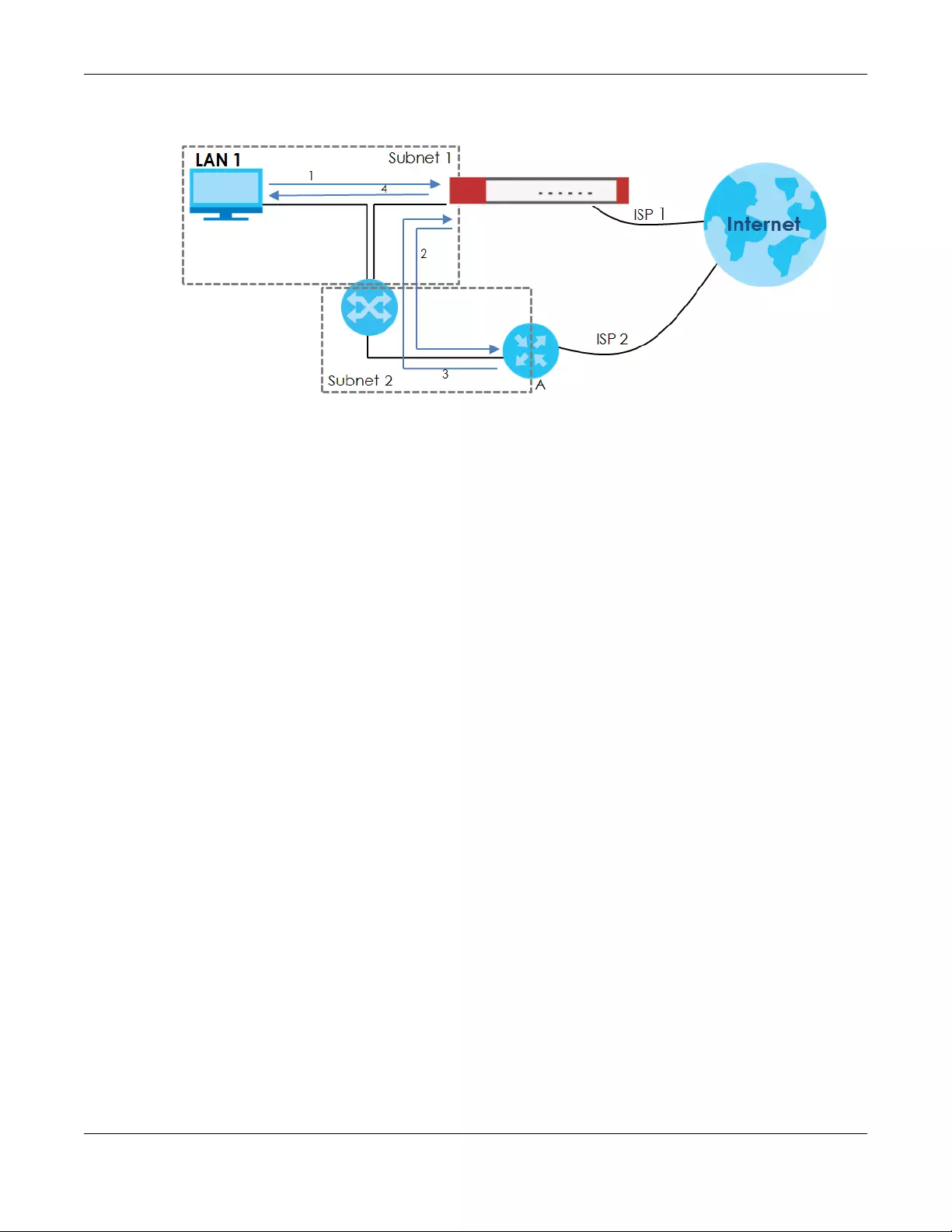
Chapter 30 Security Policy
ZyWALL USG FLEX Series User’s Guide
567
Figure 386 Using Virtual Interfaces to Avoid Asymmetrical Routes
30.4.1 Configuring the Security Policy Control Screen
Click Configuration > Security Policy > Policy Control to open the Security Policy screen. Use this screen
to enable or disable the Security Policy and asymmetrical routes, set a maximum number of sessions per
host, and display the configured Security Policies. Specify from which zone packets come and to which
zone packets travel to display only the policies specific to the selected direction. Note the following.
• Besides configuring the Security Policy, you also need to configure NAT rules to allow computers on
the WAN to access LAN devices.
• The Zyxel Device applies NAT (Destination NAT) settings before applying the Security Policies. So for
example, if you configure a NAT entry that sends WAN traffic to a LAN IP address, when you configure
a corresponding Security Policy to allow the traffic, you need to set the LAN IP address as the
destination.
• The ordering of your policies is very important as policies are applied in sequence.
The following screen shows the Security Policy summary screen.
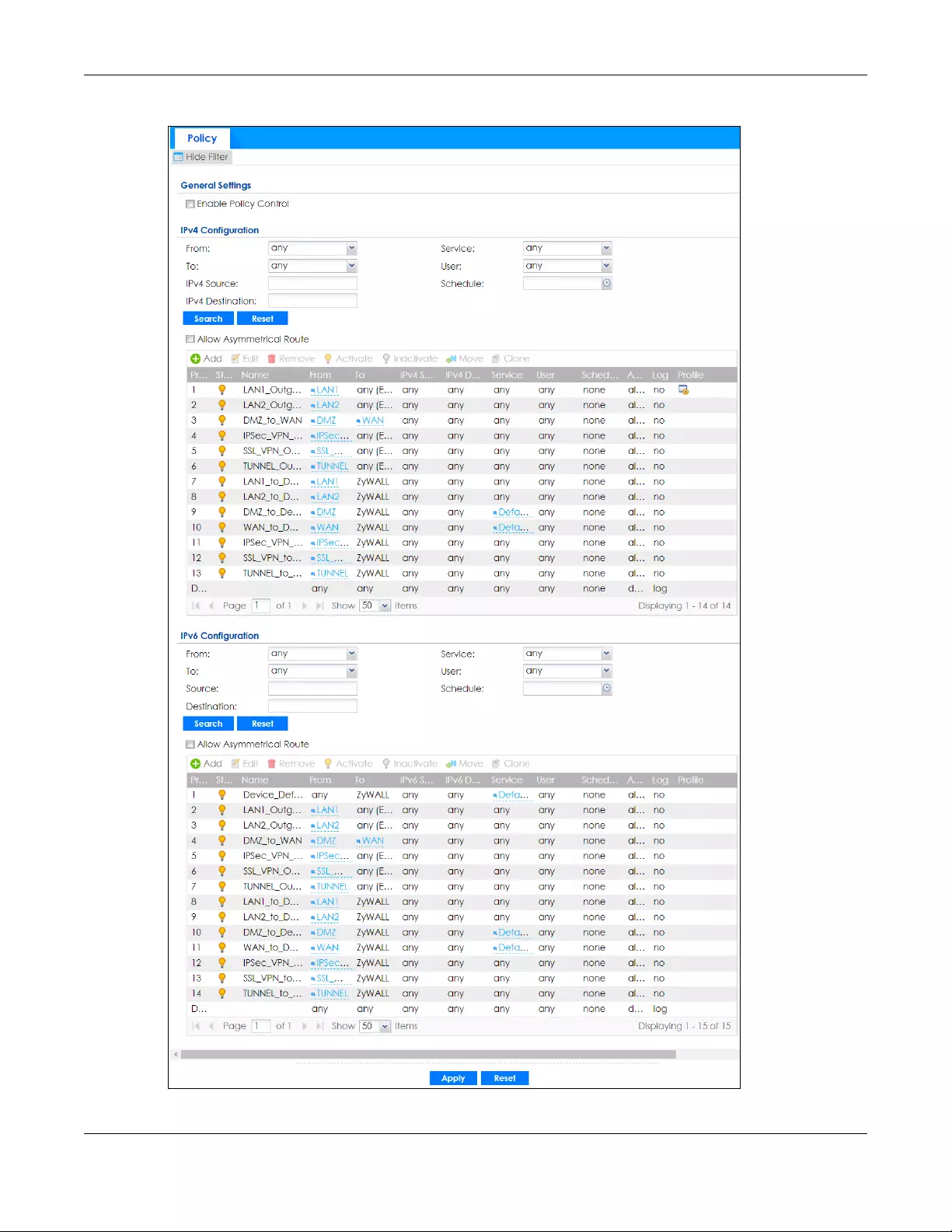
Chapter 30 Security Policy
ZyWALL USG FLEX Series User’s Guide
568
Figure 387 Configuration > Security Policy > Policy Control

Chapter 30 Security Policy
ZyWALL USG FLEX Series User’s Guide
569
The following table describes the labels in this screen.
Table 229 Configuration > Security Policy > Policy Control
LABEL DESCRIPTION
Show Filter/Hide
Filter
Click Show Filter to display IPv4 and IPv6 (if enabled) security policy search filters.
General Settings Enable or disable the Security Policy feature on the Zyxel Device.
Enable Policy
Control
Select this to activate Security Policy on the Zyxel Device to perform access control.
IPv4 / IPv6
Configuration
Use IPv4 / IPv6 search filters to find specific IPv4 and IPv6 (if enabled) security policies based on
direction, application, user, source, destination and/or schedule.
From / To Select a zone to view all security policies from a particular zone and/or to a particular zone.
any means all zones.
IPv4 / IPv6
Source Type an IPv4 or IPv6 IP address to view all security policies based on the IPv4 / IPv6 source
address object used.
• An IPv4 IP address is written as four integer blocks separated by periods. This is an example
IPv4 address: 172.16.6.7.
• An 128-bit IPv6 address is written as eight 16-bit hexadecimal blocks separated by colons
(:). This is an example IPv6 address: 2001:0db8:1a2b:0015:0000:0000:1a2f:0000.
IPv4 / IPv6
Destination Type an IPv4 or IPv6 IP address to view all security policies based on the IPv4 / IPv6 destination
address object used.
• An IPv4 IP address is written as four integer blocks separated by periods. This is an example
IPv4 address: 172.16.6.7.
• An 128-bit IPv6 address is written as eight 16-bit hexadecimal blocks separated by colons
(:). This is an example IPv6 address: 2001:0db8:1a2b:0015:0000:0000:1a2f:0000.
Service View all security policies based the service object used.
User View all security policies based on user or user group object used.
Schedule View all security policies based on the schedule object used.
IPv4/IPv6 Policy
Management
Use the following items to manage IPv4 and IPv6 policies.
Allow
Asymmetrical
Route
If an alternate gateway on the LAN has an IP address in the same subnet as the Zyxel Device’s
LAN IP address, return traffic may not go through the Zyxel Device. This is called an
asymmetrical or “triangle” route. This causes the Zyxel Device to reset the connection, as the
connection has not been acknowledged.
Select this check box to have the Zyxel Device permit the use of asymmetrical route topology
on the network (not reset the connection).
Note: Allowing asymmetrical routes may let traffic from the WAN go directly to the
LAN without passing through the Zyxel Device. A better solution is to use virtual
interfaces to put the Zyxel Device and the backup gateway on separate
subnets.
Add Click this to create a new entry. Select an entry and click Add to create a new entry after the
selected entry.
Edit Double-click an entry or select it and click Edit to open a screen where you can modify the
entry’s settings.
Remove To remove an entry, select it and click Remove. The Zyxel Device confirms you want to remove
it before doing so.
Activate To turn on an entry, select it and click Activate.
Inactivate To turn off an entry, select it and click Inactivate.

Chapter 30 Security Policy
ZyWALL USG FLEX Series User’s Guide
570
Move To change a policy’s position in the numbered list, select the policy and click Move to display a
field to type a number for where you want to put that policy and press [ENTER] to move the
policy to the number that you typed.
The ordering of your policies is important as they are applied in order of their numbering.
Clone Use Clone to create a new entry by modifying an existing one.
• Select an existing entry.
•Click Clone, type a number where the new entry should go and then press [ENTER].
• A configuration copy of the selected entry pops up. You must at least change the name as
duplicate entry names are not allowed.
The following read-only fields summarize the policies you have created that apply to traffic traveling in the
selected packet direction.
Priority This is the position of your Security Policy in the global policy list (including all through-Zyxel
Device and to-Zyxel Device policies). The ordering of your policies is important as policies are
applied in sequence. Default displays for the default Security Policy behavior that the Zyxel
Device performs on traffic that does not match any other Security Policy.
Status This icon is lit when the entry is active and dimmed when the entry is inactive.
Name This is the name of the Security policy.
From / To This is the direction of travel of packets. Select from which zone the packets come and to
which zone they go.
Security Policies are grouped based on the direction of travel of packets to which they apply.
For example, from LAN to LAN means packets traveling from a computer or subnet on the LAN
to either another computer or subnet on the LAN.
From any displays all the Security Policies for traffic going to the selected To Zone.
To any displays all the Security Policies for traffic coming from the selected Fr om Zone.
From any to any displays all of the Security Policies.
To ZyWALL policies are for traffic that is destined for the Zyxel Device and control which
computers can manage the Zyxel Device.
IPv4 / IPv6 Source This displays the IPv4 / IPv6 source address object, including geographic address and FQDN
(group) objects, to which this Security Policy applies.
IPv4 / IPv6
Destination
This displays the IPv4 / IPv6 destination address object, including geographic address and
FQDN (group) objects, to which this Security Policy applies.
Service This displays the service object to which this Security Policy applies.
User This is the user name or user group name to which this Security Policy applies.
Schedule This field tells you the schedule object that the policy uses. none means the policy is active at all
times if enabled.
Action This field displays whether the Security Policy silently discards packets without notification
(deny), permits the passage of packets (allow) or drops packets with notification (reject)
Log Select whether to have the Zyxel Device generate a log (log), log and alert (log alert) or not
(no) when the policy is matched to the criteria listed above.
Profile This field shows you which Security Service profiles (application patrol, content filter, IDP, anti-
malware, email security) apply to this Security policy. Click an applied Security Service profile
icon to edit the profile directly.
Apply Click Apply to save your changes back to the Zyxel Device.
Reset Click Reset to return the screen to its last-saved settings.
Table 229 Configuration > Security Policy > Policy Control (continued)
LABEL DESCRIPTION

Chapter 30 Security Policy
ZyWALL USG FLEX Series User’s Guide
571
30.4.2 The Security Policy Control Add/Edit Screen
In the Security Policy Control screen, click the Edit or Add icon to display the Security Policy Edit or Add
screen.
Figure 388 Configuration > Security Policy > Policy Control > Add
The following table describes the labels in this screen.
Table 230 Configuration > Security Policy > Policy Control > Add
LABEL DESCRIPTION
Create new
Object
Use to configure any new settings objects that you need to use in this screen.
Enable Select this check box to activate the Security policy.
Name Type a name to identify the policy
Description Enter a descriptive name of up to 60 printable ASCII characters for the Policy. Spaces are
allowed.
From
To
For through-Zyxel Device policies, select the direction of travel of packets to which the policy
applies.
any means all interfaces.
Device means packets destined for the Zyxel Device itself.
Source Select an IPv4 / IPv6 address or address group object, including geographic address and FQDN
(group) objects, to apply the policy to traffic coming from it. Select any to apply the policy to all
traffic coming from IPv4 / IPv6 addresses.
Destination Select an IPv4 / IPv6 address or address group, including geographic address and FQDN (group)
objects, to apply the policy to traffic going to it. Select any to apply the policy to all traffic going
to IPv4 / IPv6 addresses.
Service Select a service or service group from the drop-down list box.

Chapter 30 Security Policy
ZyWALL USG FLEX Series User’s Guide
572
30.5 Anomaly Detection and Prevention Overview
Anomaly Detection and Prevention (ADP) protects against anomalies based on violations of protocol
standards (RFCs – Requests for Comments) and abnormal flows such as port scans. This section
introduces ADP, anomaly profiles and applying an ADP profile to a traffic direction.
Traffic Anomalies
Traffic anomaly policies look for abnormal behavior or events such as port scanning, sweeping or
network flooding. They operate at OSI layer-2 and layer-3. Traffic anomaly policies may be updated
when you upload new firmware.
User This field is not available when you are configuring a to-Zyxel Device policy.
Select a user name or user group to which to apply the policy. The Security Policy is activated
only when the specified user logs into the system and the policy will be disabled when the user
logs out.
Otherwise, select any and there is no need for user logging.
Note: If you specified a source IP address (group) instead of any in the field below, the
user’s IP address should be within the IP address range.
Schedule Select a schedule that defines when the policy applies. Otherwise, select none and the policy is
always effective.
Action Use the drop-down list box to select what the Security Policy is to do with packets that match this
policy.
Select deny to silently discard the packets without sending a TCP reset packet or an ICMP
destination-unreachable message to the sender.
Select reject to discard the packets and send a TCP reset packet or an ICMP destination-
unreachable message to the sender.
Select allow to permit the passage of the packets.
Log matched
traffic
Select whether to have the Zyxel Device generate a log (log), log and alert (log alert) or not (no)
when the policy is matched to the criteria listed above..
Profile Use this section to apply anti- x profiles (created in the Configuration > Security Service screens)
to traffic that matches the criteria above. You must have created a profile first; otherwise none
displays.
Use Log to generate a log (log), log and alert (log alert) or not (no) for all traffic that matches
criteria in the profile.
Application
Patrol Select an Application Patrol profile from the list box; none displays if no profiles have been
created in the Configuration > Security Service > App Patrol screen.
Content
Filter Select a Content Filter profile from the list box; none displays if no profiles have been created in
the Configuration > Security Service > Content Filter screen.
SSL
Inspection Select an SSL Inspection profile from the list box; none displays if no profiles have been created in
the Configuration > Security Service > SSL Inspection screen.
OK Click OK to save your customized settings and exit this screen.
Cancel Click Cancel to exit this screen without saving.
Table 230 Configuration > Security Policy > Policy Control > Add (continued)
LABEL DESCRIPTION
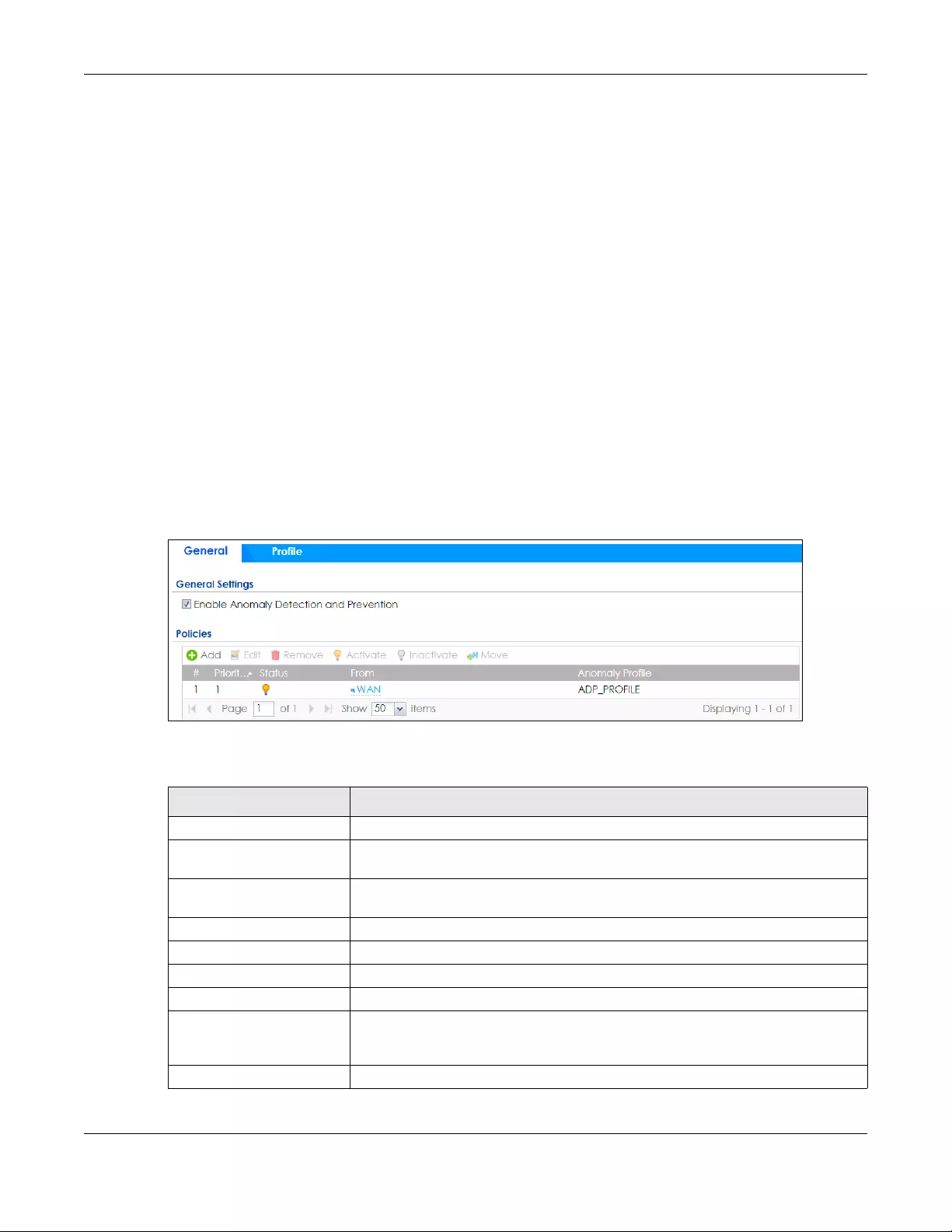
Chapter 30 Security Policy
ZyWALL USG FLEX Series User’s Guide
573
Protocol Anomalies
Protocol anomalies are packets that do not comply with the relevant RFC (Request For Comments).
Protocol anomaly detection includes:
•TCP Decoder
• UDP Decoder
•ICMP Decoder
Protocol anomaly policies may be updated when you upload new firmware.
Note: First, create an ADP profile in the In the Configuration > Security Policy > ADP > Profile
screen.
Then, apply the profile to traffic originating from a specific zone in the Configuration >
Security Policy > ADP > General screen.
30.5.1 The Anomaly Detection and Prevention General Screen
Click Configuration > Security Policy > ADP > General to display the next screen.
Figure 389 Configuration > Security Policy > ADP > General
The following table describes the labels in this screen.
Table 231 Configuration > Security Policy > ADP > General
LABEL DESCRIPTION
General Settings
Enable Anomaly Detection
and Prevention
Select this to enable traffic anomaly and protocol anomaly detection and
prevention.
Add Select an entry and click Add to append a new row beneath the one selected. ADP
policies are applied in order (Priority) shown in this screen
Edit Select an entry and click this to be able to modify it.
Remove Select an entry and click this to delete it.
Activate To turn on an entry, select it and click Activate.
Inactivate To turn off an entry, select it and click Inactivate.
Move To change an entry’s position in the numbered list, select it and click Move to display
a field to type a number for where you want to put that entry and press [ENTER] to
move the entry to the number that you typed.
#This is the entry’s index number in the list.

Chapter 30 Security Policy
ZyWALL USG FLEX Series User’s Guide
574
30.5.2 Creating New ADP Profiles
Create new ADP profiles in the Configuration > Security Policy > ADP > Profile screens.
When creating ADP profiles. you may find that certain policies are triggering too many false positives or
false negatives. A false positive is when valid traffic is flagged as an attack. A false negative is when
invalid traffic is wrongly allowed to pass through the Zyxel Device. As each network is different, false
positives and false negatives are common on initial ADP deployment.
To counter this, you could create a ‘monitor profile’ that creates logs, but all actions are disabled.
Observe the logs over time and try to eliminate the causes of the false alarms. When you’re satisfied that
they have been reduced to an acceptable level, you could then create an ‘in-line profile’ whereby you
configure appropriate actions to be taken when a packet matches a policy.
ADP profiles consist of traffic anomaly profiles and protocol anomaly profiles. To create a new profile,
select a base profile and then click OK to go to the profile details screen. Type a new profile name,
enable or disable individual policies and then edit the default log options and actions.
Click Configuration > Security Policy > ADP > Profile to view the following screen.
Priority This is the rank in the list of anomaly profile policies. The list is applied in order of
priority.
Status The activate (light bulb) icon is lit when the entry is active and dimmed when the
entry is inactive.
From This is the direction of travel of packets to which an anomaly profile is bound. Traffic
direction is defined by the zone the traffic is coming from.
Use the From field to specify the zone from which the traffic is coming. Select ZyWALL
to specify traffic coming from the Zyxel Device itself.
From LAN means packets traveling from a computer on one LAN subnet to a
computer on another subnet via the Zyxel Device’s LAN1 zone interfaces. The Zyxel
Device does not check packets traveling from a LAN computer to another LAN
computer on the same subnet.
From WAN means packets that come in from the WAN zone and the Zyxel Device
routes back out through the WAN zone.
Note: Depending on your network topology and traffic load, applying
every packet direction to an anomaly profile may affect the Zyxel
Device’s performance.
Anomaly Profile An anomaly profile is a set of anomaly policies with configured activation, log and
action settings. This field shows which anomaly profile is bound to which traffic
direction. Select an ADP profile to apply to the entry’s traffic direction. Configure the
ADP profiles in the ADP profile screens.
Table 231 Configuration > Security Policy > ADP > General
LABEL DESCRIPTION
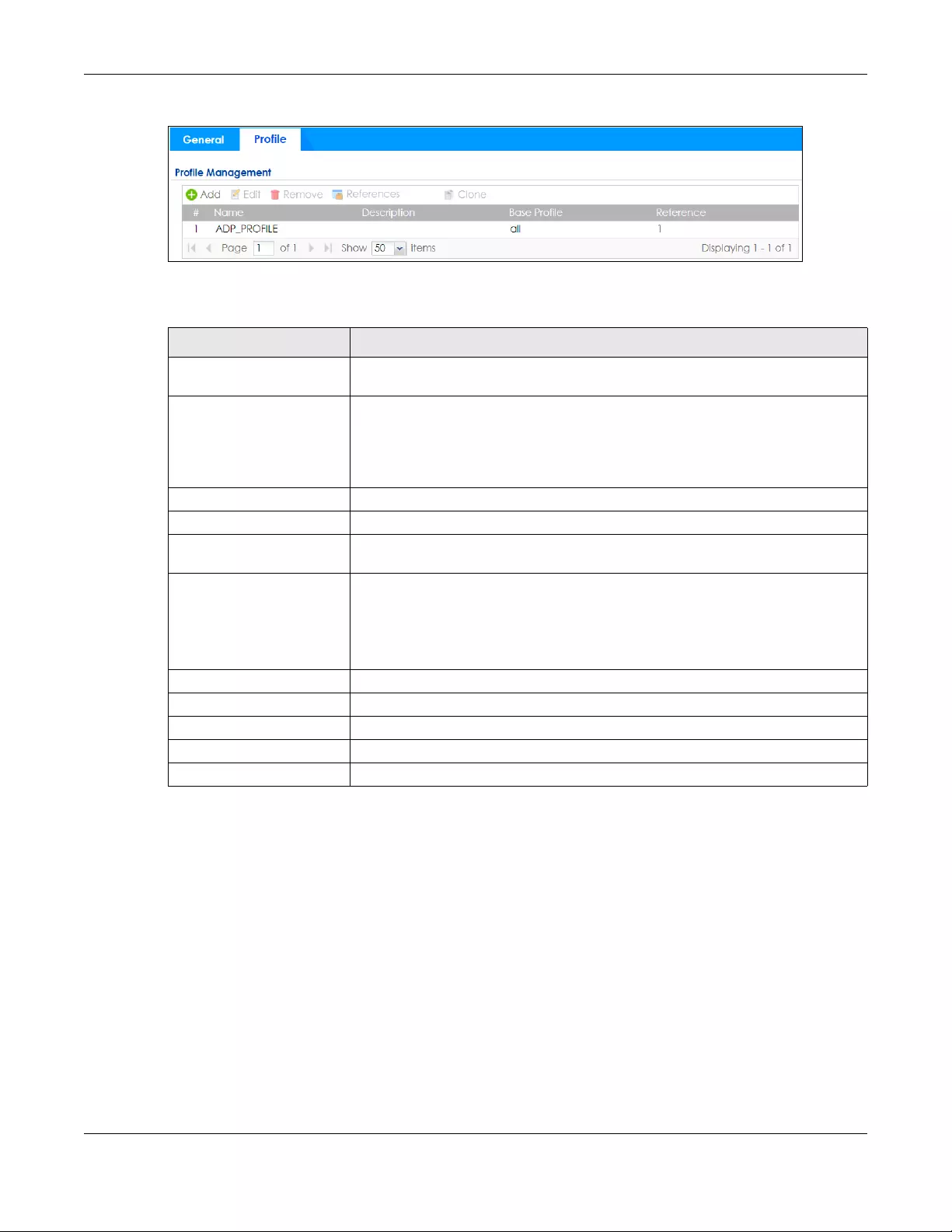
Chapter 30 Security Policy
ZyWALL USG FLEX Series User’s Guide
575
Figure 390 Configuration > Security Policy > ADP > Profile
The following table describes the labels in this screen.
30.5.3 Traffic Anomaly Profiles
Traffic anomaly detection looks for abnormal behavior such as scan or flooding attempts. In the
Configuration > Security Policy > ADP > Profile screen, click the Edit or Add icon and choose a base
profile. Traffic Anomaly is the first tab in the profile.
Table 232 Configuration > Security Policy > ADP > Profile
LABEL DESCRIPTION
Profile Management Create ADP profiles here and then apply them in the Configuration > Security Policy
> ADP > Profile screen.
Add Click Add and first choose a none or all Base Profile.
•none base profile sets all ADP entries to have Log set to no and Action set to
none by default.
•all base profile sets all ADP entries to have Log set to log and Action set to block
by default.
Edit Select an entry and click this to be able to modify it.
Remove Select an entry and click this to delete it.
References Select an entry and click References to open a screen that shows which settings use
the entry. Click Refresh to update information on this screen.
Clone Use Clone to create a new entry by modifying an existing one.
• Select an existing entry.
•Click Clone.
• A configuration copy of the selected entry pops up. You must at least change
the name as duplicate entry names are not allowed.
#This is the entry’s index number in the list.
Name This is the name of the profile you created.
Description This is the description of the profile you created.
Base Profile This is the name of the base profile used to create this profile.
Reference This is the number of object references used to create this profile.
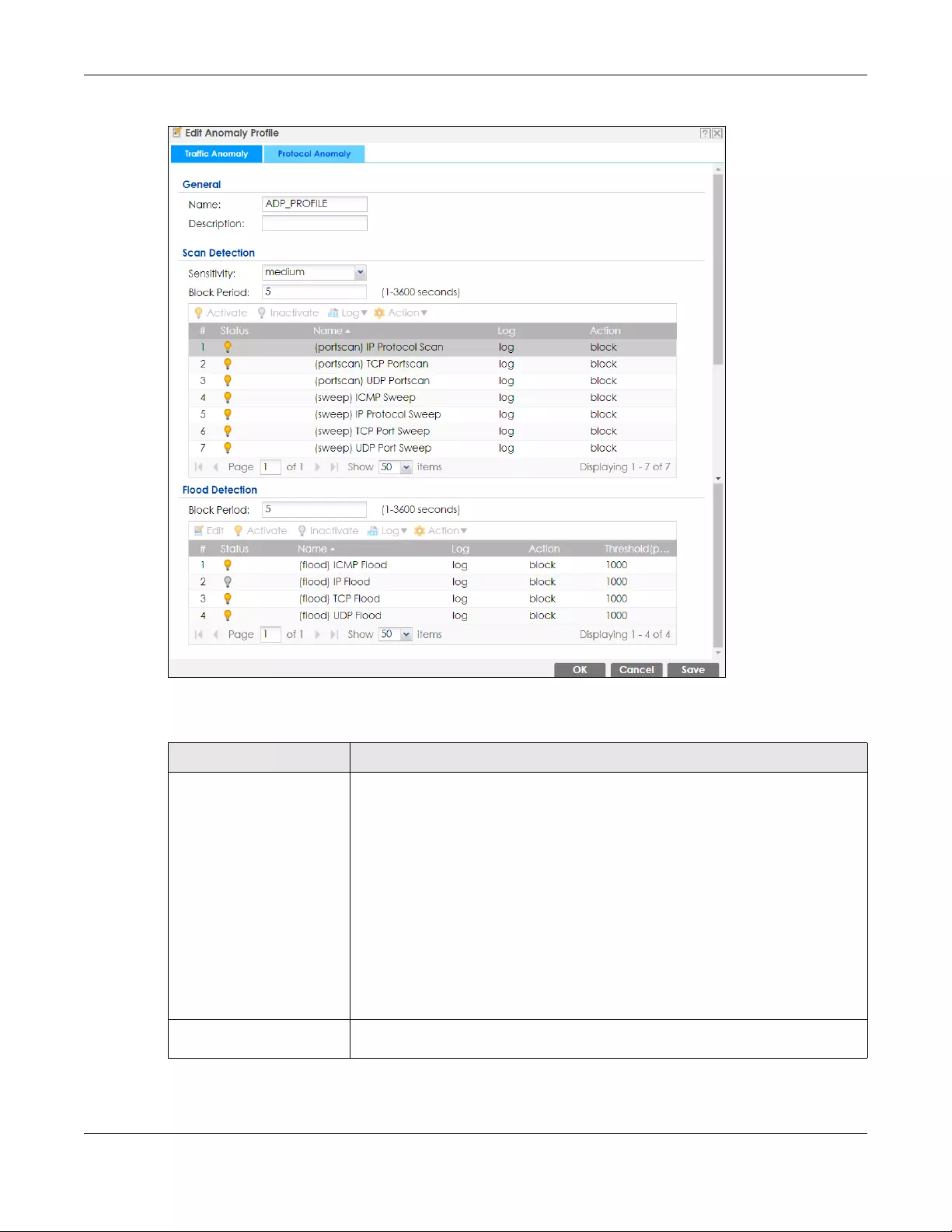
Chapter 30 Security Policy
ZyWALL USG FLEX Series User’s Guide
576
Figure 391 Configuration > Security Policy > ADP > Profile > Add-Traffic-Anomaly
The following table describes the labels in this screen.
Table 233 Configuration > Security Policy > ADP > Profile > Add-Traffic-Anomaly
LABELS DESCRIPTION
Name A name is automatically generated that you can edit. The name must be the same
in the Traffic Anomaly and Protocol Anomaly screens for the same ADP profile. You
may use 1-31 alphanumeric characters, underscores(_), or dashes (-), but the first
character cannot be a number. This value is case-sensitive. These are valid, unique
profile names:
•MyProfile
• mYProfile
• Mymy12_3-4
These are invalid profile names:
•1mYProfile
•My Profile
• MyProfile?
• Whatalongprofilename123456789012
Description In addition to the name, type additional information to help you identify this ADP
profile.

Chapter 30 Security Policy
ZyWALL USG FLEX Series User’s Guide
577
Scan/Flood Detection Scan detection, such as port scanning, tries to find attacks where an attacker scans
device(s) to determine what types of network protocols or services a device
supports.
Flood detection tries to find attacks that saturate a network with useless data, use up
all available bandwidth, and so aim to make communications on the network
impossible.
Sensitivity (Scan detection only.) Select a sensitivity level so as to reduce false positives in your
network. If you choose low sensitivity, then scan thresholds and sample times are set
low, so you will have fewer logs and false positives; however some traffic anomaly
attacks may not be detected.
If you choose high sensitivity, then scan thresholds and sample times are set high, so
most traffic anomaly attacks will be detected; however you will have more logs and
false positives.
Block Period Specify for how many seconds the Zyxel Device blocks all packets from being sent
to the victim (destination) of a detected anomaly attack. Flood Detection applies
blocking to the destination IP address and Scan Detection applies blocking to the
source IP address.
Edit (Flood Detection
only) Select an entry and click this to be able to modify it.
Activate To turn on an entry, select it and click Activate.
Inactivate To turn off an entry, select it and click Inactivate.
Log To edit an item’s log option, select it and use the Log icon. Select whether to have
the Zyxel Device generate a log (log), log and alert (log alert) or neither (no) when
traffic matches this anomaly policy.
Action To edit what action the Zyxel Device takes when a packet matches a policy, select
the policy and use the Action icon.
none: The Zyxel Device takes no action when a packet matches the policy.
block: The Zyxel Device silently drops packets that matches the policy. Neither
sender nor receiver are notified.
#This is the entry’s index number in the list.
Status The activate (light bulb) icon is lit when the entry is active and dimmed when the
entry is inactive.
Name This is the name of the anomaly policy. Click the Name column heading to sort in
ascending or descending order according to the protocol anomaly policy name.
Log These are the log options. To edit this, select an item and use the Log icon.
Action This is the action the Zyxel Device should take when a packet matches a policy. To
edit this, select an item and use the Action icon.
Threshold (pkt/sec) (Flood detection only.) Select a suitable threshold level (the number of packets per
second that match the flood detection criteria) for your network. If you choose a
low threshold, most traffic anomaly attacks will be detected, but you may have
more logs and false positives.
If you choose a high threshold, some traffic anomaly attacks may not be detected,
but you will have fewer logs and false positives.
OK Click OK to save your settings to the Zyxel Device, complete the profile and return to
the profile summary page.
Cancel Click Cancel to return to the profile summary page without saving any changes.
Save Click Save to save the configuration to the Zyxel Device but remain in the same
page. You may then go to the another profile screen (tab) in order to complete the
profile. Click OK in the final profile screen to complete the profile.
Table 233 Configuration > Security Policy > ADP > Profile > Add-Traffic-Anomaly (continued)
LABELS DESCRIPTION

Chapter 30 Security Policy
ZyWALL USG FLEX Series User’s Guide
578
30.5.4 Protocol Anomaly Profiles
Protocol anomalies are packets that do not comply with the relevant RFC (Request For Comments).
Protocol anomaly detection includes:
•TCP Decoder
• UDP Decoder
•ICMP Decoder
• IP Decoder
Teardrop
When an IP packet is larger than the Maximum Transmission Unit (MTU) configured in the Zyxel Device, it
is fragmented using the TCP or ICMP protocol.
A Teardrop attack falsifies the offset which defines the size of the fragment and the original packet. A
series of IP fragments with overlapping offset fields can cause some systems to crash, hang, or reboot
when fragment reassembling is attempted at the destination.
IP Spoofing
IP Spoofing is used to gain unauthorized access to network devices by modifying packet headers so
that it appears that the packets originate from a host within a trusted network.
• In an IP Spoof from the WAN, the source address appears to be in the same subnet as a Zyxel Device
LAN interface.
• In an IP Spoof from a LAN interface, the source address appears to be in a different subnet from that
Zyxel Device LAN interface.

Chapter 30 Security Policy
ZyWALL USG FLEX Series User’s Guide
579
Figure 392 Configuration > Security Policy > ADP > Profile > Add-Protocol-Anomaly

Chapter 30 Security Policy
ZyWALL USG FLEX Series User’s Guide
580
The following table describes the labels in this screen.
Table 234 Configuration > Security Policy > ADP > Profile > Add-Protocol-Anomaly
LABEL DESCRIPTION
Name A name is automatically generated that you can edit. The name must be the same
in the Traffic Anomaly and Protocol Anomaly screens for the same ADP profile. You
may use 1-31 alphanumeric characters, underscores(_), or dashes (-), but the first
character cannot be a number. This value is case-sensitive. These are valid, unique
profile names:
•MyProfile
• mYProfile
• Mymy12_3-4
• These are invalid profile names:
•1mYProfile
•My Profile
• MyProfile?
• Whatalongprofilename123456789012
Description In addition to the name, type additional information to help you identify this ADP
profile.
TCP Decoder/UDP
Decoder/ICMP Decoder/IP
Decoder
Perform the following actions for each type of encoder.
Activate To turn on an entry, select it and click Activate.
Inactivate To turn off an entry, select it and click Inactivate.
Log To edit an item’s log option, select it and use the Log icon. Select whether to have
the Zyxel Device generate a log (log), log and alert (log alert) or neither (no) when
traffic matches this anomaly policy.
Action To edit what action the Zyxel Device takes when a packet matches a policy, select
the policy and use the Action icon.
original setting: Select this action to return each rule in a service group to its
previously saved configuration.
none: Select this action to have the Zyxel Device take no action when a packet
matches a policy.
drop: Select this action to have the Zyxel Device silently drop a packet that matches
a policy. Neither sender nor receiver are notified.
reject-sender: Select this action to have the Zyxel Device send a reset to the sender
when a packet matches the policy. If it is a TCP attack packet, the Zyxel Device will
send a packet with a ‘RST’ flag. If it is an ICMP or UDP attack packet, the Zyxel
Device will send an ICMP unreachable packet.
reject-receiver: Select this action to have the Zyxel Device send a reset to the
receiver when a packet matches the policy. If it is a TCP attack packet, the Zyxel
Device will send a packet with an a ‘RST’ flag. If it is an ICMP or UDP attack packet,
the Zyxel Device will do nothing.
reject-both: Select this action to have the Zyxel Device send a reset to both the
sender and receiver when a packet matches the policy. If it is a TCP attack packet,
the Zyxel Device will send a packet with a ‘RST’ flag to the receiver and sender. If it is
an ICMP or UDP attack packet, the Zyxel Device will send an ICMP unreachable
packet.
#This is the entry’s index number in the list.
Status The activate (light bulb) icon is lit when the entry is active and dimmed when the
entry is inactive.
Name This is the name of the anomaly policy. Click the Name column heading to sort in
ascending or descending order according to the protocol anomaly policy name.
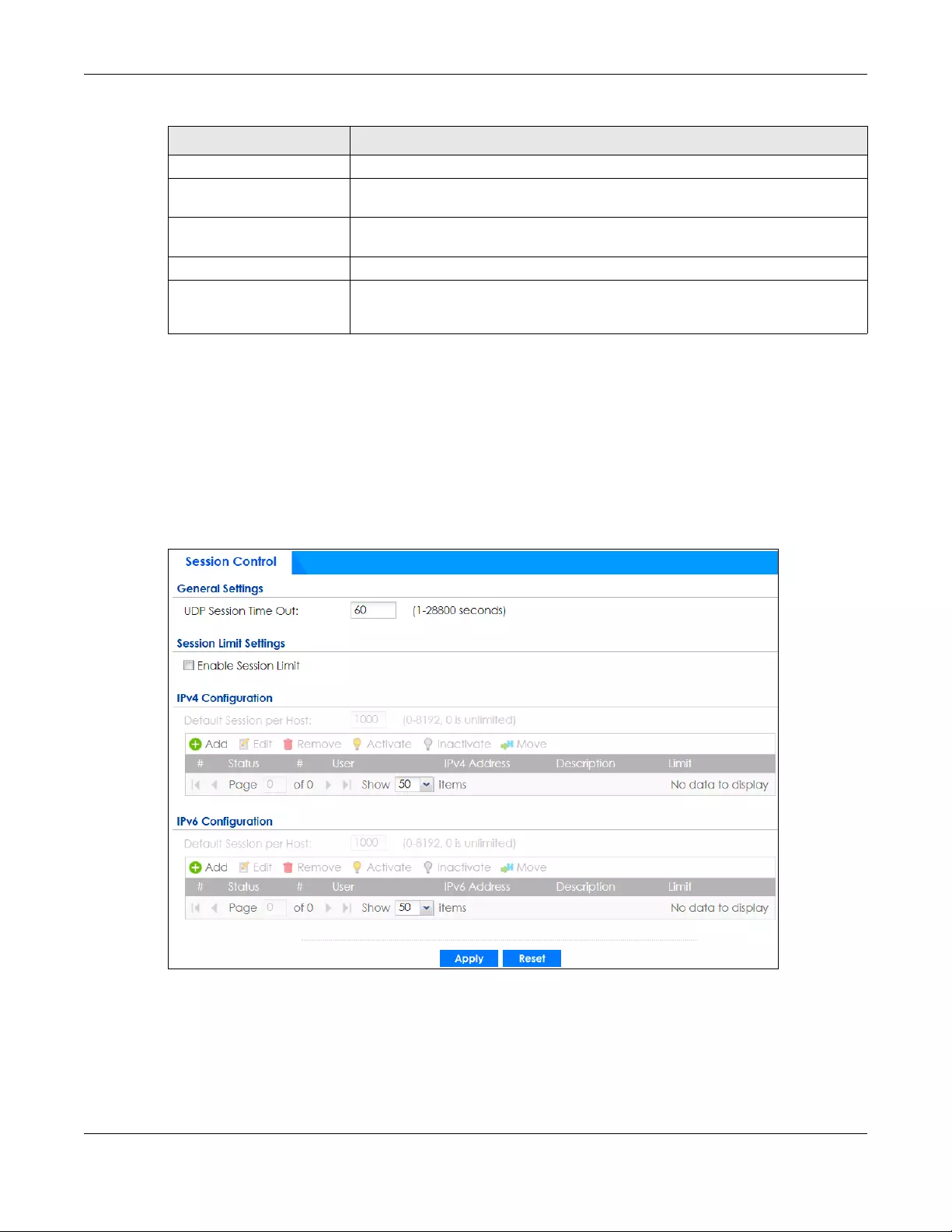
Chapter 30 Security Policy
ZyWALL USG FLEX Series User’s Guide
581
30.6 The Session Control Screen
Click Configuration > Security Policy > Session Control to display the Security Policy Session Control
screen. Use this screen to limit the number of concurrent NAT/Security Policy sessions a client can use.
You can apply a default limit for all users and individual limits for specific users, addresses, or both. The
individual limit takes priority if you apply both.
Figure 393 Configuration > Security Policy > Session Control
Log These are the log options. To edit this, select an item and use the Log icon.
Action This is the action the Zyxel Device should take when a packet matches a policy. To
edit this, select an item and use the Action icon.
OK Click OK to save your settings to the Zyxel Device, complete the profile and return to
the profile summary page.
Cancel Click Cancel to return to the profile summary page without saving any changes.
Save Click Save to save the configuration to the Zyxel Device but remain in the same
page. You may then go to the another profile screen (tab) in order to complete the
profile. Click OK in the final profile screen to complete the profile.
Table 234 Configuration > Security Policy > ADP > Profile > Add-Protocol-Anomaly
LABEL DESCRIPTION

Chapter 30 Security Policy
ZyWALL USG FLEX Series User’s Guide
582
The following table describes the labels in this screen.
30.6.1 The Session Control Add/Edit Screen
Click Configuration > Security Policy > Ses sion Control and the Add or Edit icon to display the Add or Edit
screen. Use this screen to configure rules that define a session limit for specific users or addresses.
Table 235 Configuration > Security Policy > Session Control
LABEL DESCRIPTION
General Settings
UDP Session Time
Out
Set how many seconds the Zyxel Device will allow a UDP session to remain idle (without UDP
traffic) before closing it.
Session Limit
Settings
Enable Session
limit
Select this check box to control the number of concurrent sessions hosts can have.
IPv4 / IPv6
Configuration
This table lists the rules for limiting the number of concurrent sessions hosts can have.
Default
Session per
Host
This field is configurable only when you enable session limit.
Use this field to set a common limit to the number of concurrent NAT/Security Policy sessions
each client computer can have.
If only a few clients use peer to peer applications, you can raise this number to improve their
performance. With heavy peer to peer application use, lower this number to ensure no single
client uses too many of the available NAT sessions.
Create rules below to apply other limits for specific users or addresses.
Add Click this to create a new entry. Select an entry and click Add to create a new entry after the
selected entry.
Edit Double-click an entry or select it and click Edit to open a screen where you can modify the
entry’s settings.
Remove To remove an entry, select it and click Remove. The Zyxel Device confirms you want to remove
it before doing so.
Activate To turn on an entry, select it and click Activate.
Inactivate To turn off an entry, select it and click Inactivate.
Move To change a rule’s position in the numbered list, select the rule and click Move to display a field
to type a number for where you want to put that rule and press [ENTER] to move the rule to the
number that you typed.
The ordering of your rules is important as they are applied in order of their numbering.
#This field is a sequential value showing the number of the profile. The profile order is not
important.
Status This icon is lit when the entry is active and dimmed when the entry is inactive.
#This is the index number of a session limit rule. It is not associated with a specific rule.
User This is the user name or user group name to which this session limit rule applies.
IPv4 / IPv6 Address This is the IPv4 / IPv6 address object, including geographic address (group) objects to which
this session limit rule applies.
Description This is the information configured to help you identify the rule.
Limit This is how many concurrent sessions this user or address is allowed to have.
Apply Click Apply to save your changes back to the Zyxel Device.
Reset Click Reset to return the screen to its last-saved settings.
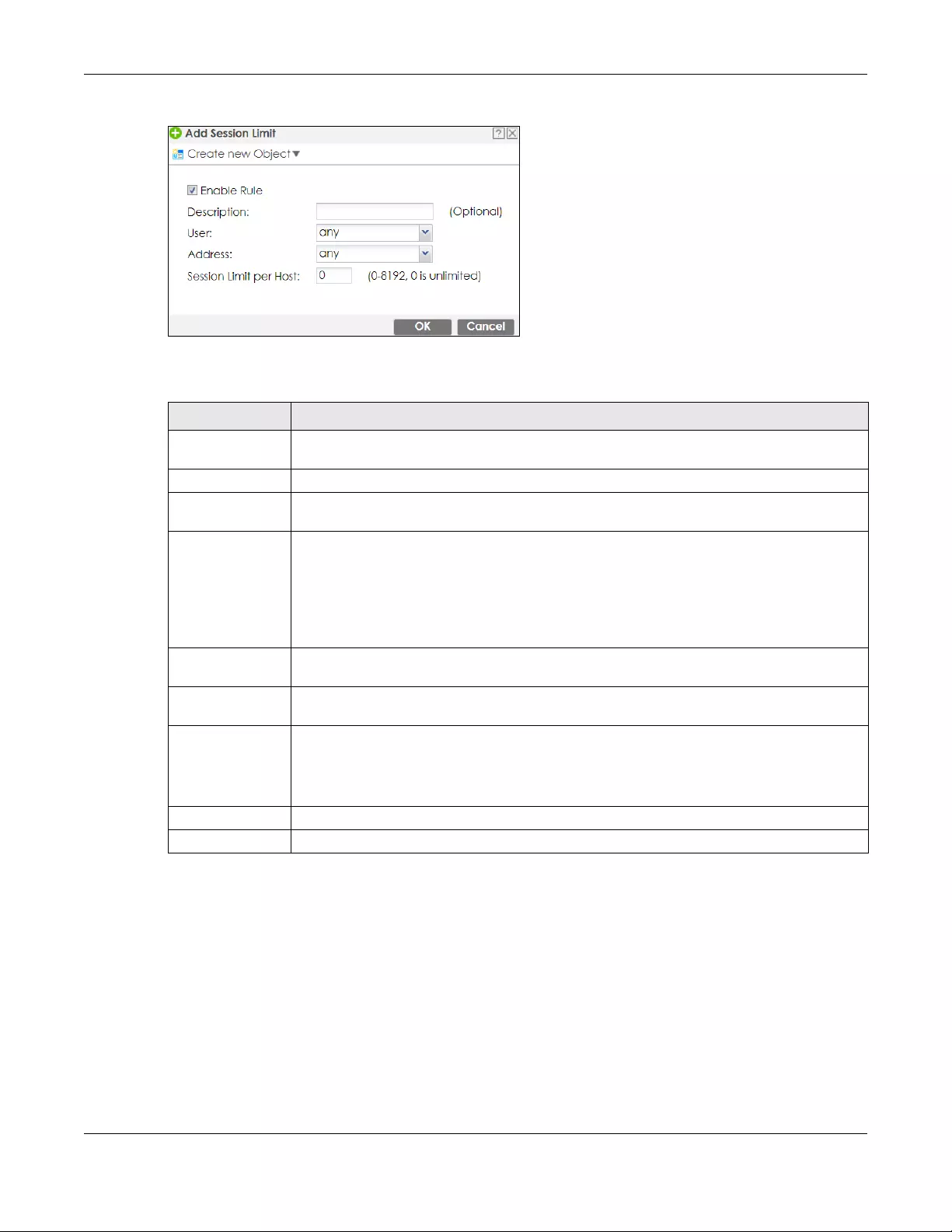
Chapter 30 Security Policy
ZyWALL USG FLEX Series User’s Guide
583
Figure 394 Configuration > Security Policy > Session Control > Edit
The following table describes the labels in this screen.
30.7 Security Policy Example Applications
Suppose you decide to block LAN users from using IRC (Internet Relay Chat) through the Internet. To do
this, you would configure a LAN to WAN Security Policy that blocks IRC traffic from any source IP address
from going to any destination address. You do not need to specify a schedule since you need the
Security Policy to always be in effect. The following figure shows the results of this policy.
Table 236 Configuration > Security Policy > Session Control > Add / Edit
LABEL DESCRIPTION
Create new
Object
Use to configure new settings for User or Address objects that you need to use in this
screen.Click on the down arrow to see the menu.
Enable Rule Select this check box to turn on this session limit rule.
Description Enter information to help you identify this rule. Use up to 60 printable ASCII characters. Spaces
are allowed.
User Select a user name or user group to which to apply the rule. The rule is activated only when the
specified user logs into the system and the rule will be disabled when the user logs out.
Otherwise, select any and there is no need for user logging.
Note: If you specified an IP address (or address group) instead of any in the field
below, the user’s IP address should be within the IP address range.
Address Select the IPv4 source address or address group, including geographic address (group)
object, to which this rule applies. Select any to apply the rule to all IPv4 source addresses.
IPv6 Address Select the IPv6 source address or address group, including geographic address (group)
object, to which this rule applies. Select any to apply the rule to all IPv6 source addresses.
Session Limit per
Host
Use this field to set a limit to the number of concurrent NAT/Security Policy sessions this rule’s
users or addresses can have.
For this rule’s users and addresses, this setting overrides the Default Session per Host setting in
the general Security Policy Session Control screen.
OK Click OK to save your customized settings and exit this screen.
Cancel Click Cancel to exit this screen without saving.
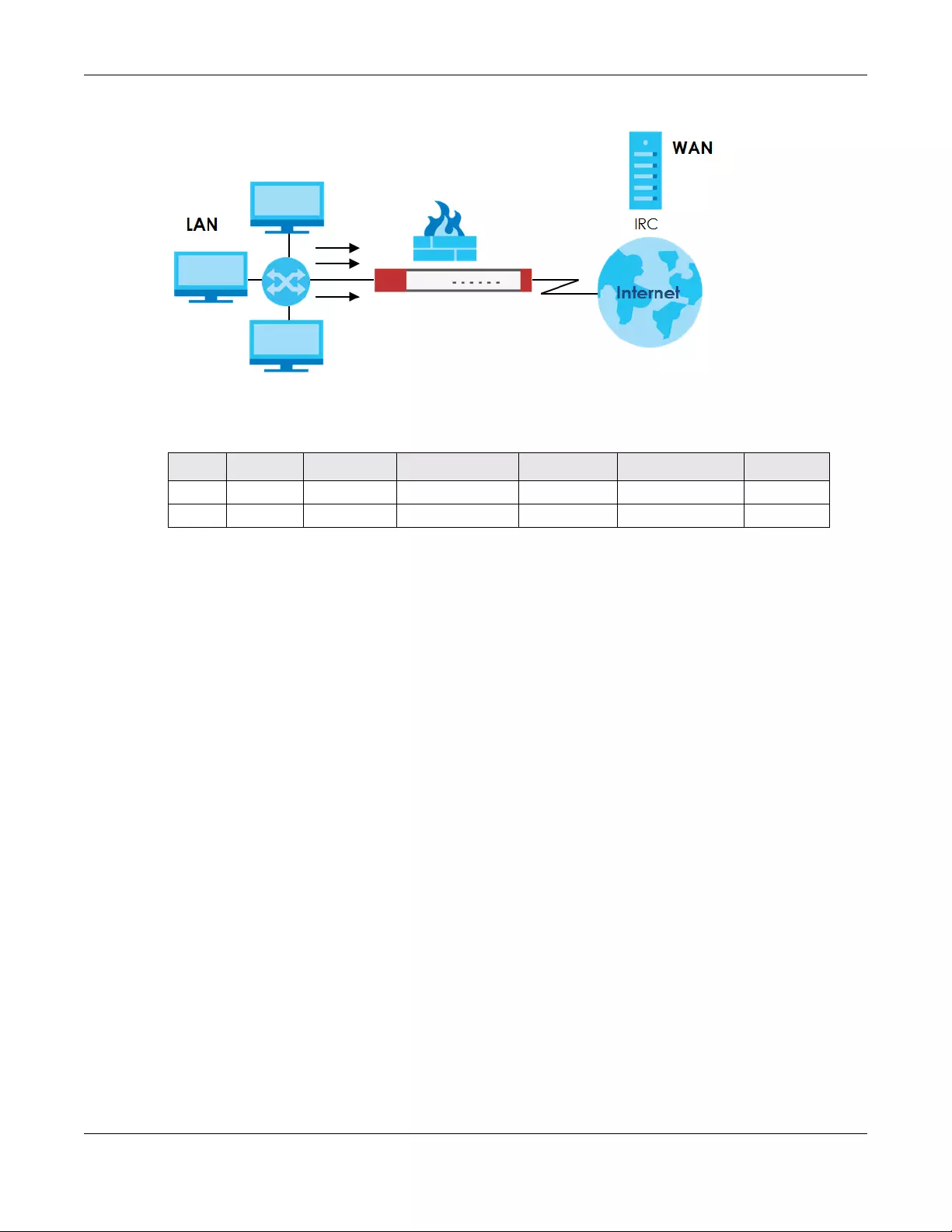
Chapter 30 Security Policy
ZyWALL USG FLEX Series User’s Guide
584
Figure 395 Blocking All LAN to WAN IRC Traffic Example
Your Security Policy would have the following settings.
• The first row blocks LAN access to the IRC service on the WAN.
• The second row is the Security Policy’s default policy that allows all LAN1 to WAN traffic.
The Zyxel Device applies the security policies in order. So for this example, when the Zyxel Device
receives traffic from the LAN, it checks it against the first policy. If the traffic matches (if it is IRC traffic)
the security policy takes the action in the policy (drop) and stops checking the subsequent security
policies. Any traffic that does not match the first security policy will match the second security policy
and the Zyxel Device forwards it.
Now suppose you need to let the CEO use IRC. You configure a LAN1 to WAN security policy that allows
IRC traffic from the IP address of the CEO’s computer. You can also configure a LAN to WAN policy that
allows IRC traffic from any computer through which the CEO logs into the Zyxel Device with his/her user
name. In order to make sure that the CEO’s computer always uses the same IP address, make sure it
either:
• Has a static IP address,
or
• You configure a static DHCP entry for it so the Zyxel Device always assigns it the same IP address.
Now you configure a LAN1 to WAN security policy that allows IRC traffic from the IP address of the CEO’s
computer (172.16.1.7 for example) to go to any destination address. You do not need to specify a
schedule since you want the security policy to always be in effect. The following figure shows the results
of your two custom policies.
Table 237 Blocking All LAN to WAN IRC Traffic Example
# USER SOURCE DESTINATION SCHEDULE SERVICE ACTION
1Any Any Any Any IRC Deny
2Any Any Any Any Any Allow
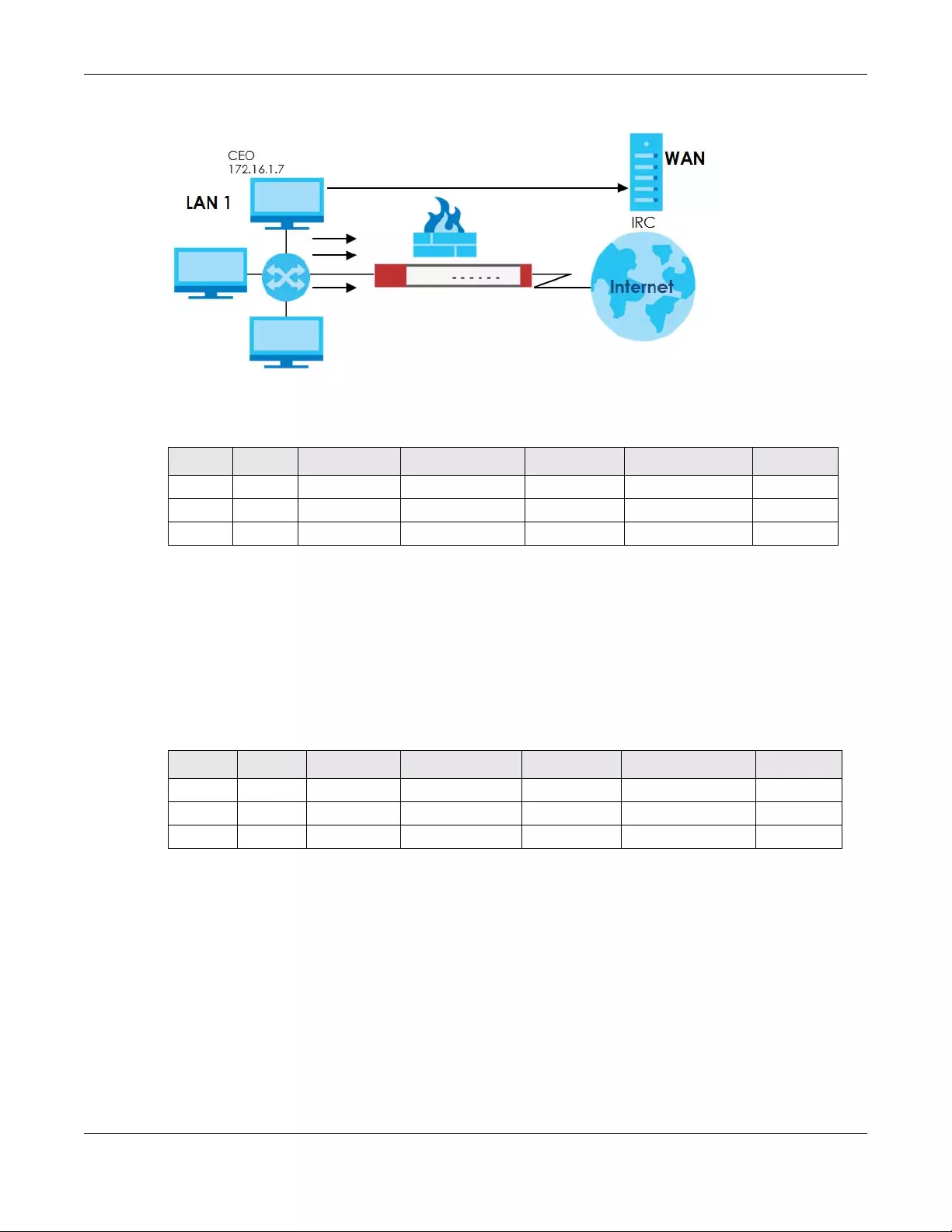
Chapter 30 Security Policy
ZyWALL USG FLEX Series User’s Guide
585
Figure 396 Limited LAN to WAN IRC Traffic Example
Your security policy would have the following configuration.
• The first row allows the LAN1 computer at IP address 172.16.1.7 to access the IRC service on the WAN.
• The second row blocks LAN1 access to the IRC service on the WAN.
• The third row is the default policy of allowing all traffic from the LAN1 to go to the WAN.
Alternatively, you configure a LAN1 to WAN policy with the CEO’s user name (say CEO) to allow IRC
traffic from any source IP address to go to any destination address.
Your Security Policy would have the following settings.
• The first row allows any LAN1 computer to access the IRC service on the WAN by logging into the Zyxel
Device with the CEO’s user name.
• The second row blocks LAN1 access to the IRC service on the WAN.
• The third row is the default policy of allowing allows all traffic from the LAN1 to go to the WAN.
The policy for the CEO must come before the policy that blocks all LAN1 to WAN IRC traffic. If the policy
that blocks all LAN1 to WAN IRC traffic came first, the CEO’s IRC traffic would match that policy and the
Zyxel Device would drop it and not check any other security policies.
Table 238 Limited LAN1 to WAN IRC Traffic Example 1
# USER SOURCE DESTINATION SCHEDULE SERVICE ACTION
1Any 172.16.1.7 Any Any IRC Allow
2Any Any Any Any IRC Deny
3Any Any Any Any Any Allow
Table 239 Limited LAN1 to WAN IRC Traffic Example 2
# USER SOURCE DESTINATION SCHEDULE SERVICE ACTION
1CEO Any Any Any IRC Allow
2Any Any Any Any IRC Deny
3Any Any Any Any Any Allow

ZyWALL USG FLEX Series User’s Guide
586
CHAPTER 31
Application Patrol
31.1 Overview
Application patrol provides a convenient way to manage the use of various applications on the
network. It manages general protocols (for example, HTTP and FTP) and instant messenger (IM), peer-to-
peer (P2P), Voice over IP (VoIP), and streaming (RSTP) applications. You can even control the use of a
particular application’s individual features (like text messaging, voice, video conferencing, and file
transfers).
31.1.1 What You Can Do in this Chapter
• Use the App Patrol summary screen (see Section 31.2 on page 587) to manage the application patrol
profiles. You can also view license registration and signature information.
• Use the App Patrol Add/Edit screens (see Section 31.2.2 on page 591 & Section 31.2.3 on page 592) to
set actions for application categories and for specific applications within the category.
31.1.2 What You Need to Know
If you want to use a service, make sure both the Security Policy and application patrol allow the
service’s packets to go through the Zyxel Device.
Note: The Zyxel Device checks secure policies before it checks application patrol rules for
traffic going through the Zyxel Device.
Application patrol examines every TCP and UDP connection passing through the Zyxel Device and
identifies what application is using the connection. Then, you can specify whether or not the Zyxel
Device continues to route the connection. Traffic not recognized by the application patrol signatures is
ignored.
Application Profiles & Policies
An application patrol profile is a group of categories of application patrol signatures. For each profile,
you can specify the default action the Zyxel Device takes once a packet matches a signature (forward,
drop, or reject a service’s connections and/or create a log alert).
Use policies to link profiles to traffic flows based on criteria such as source zone, destination zone, source
address, destination address, schedule, user.
Classification of Applications
There are two ways the Zyxel Device can identify the application. The first is called auto. The Zyxel
Device looks at the IP payload (OSI level-7 inspection) and attempts to match it with known patterns for
specific applications. Usually, this occurs at the beginning of a connection, when the payload is more
consistent across connections, and the Zyxel Device examines several packets to make sure the match
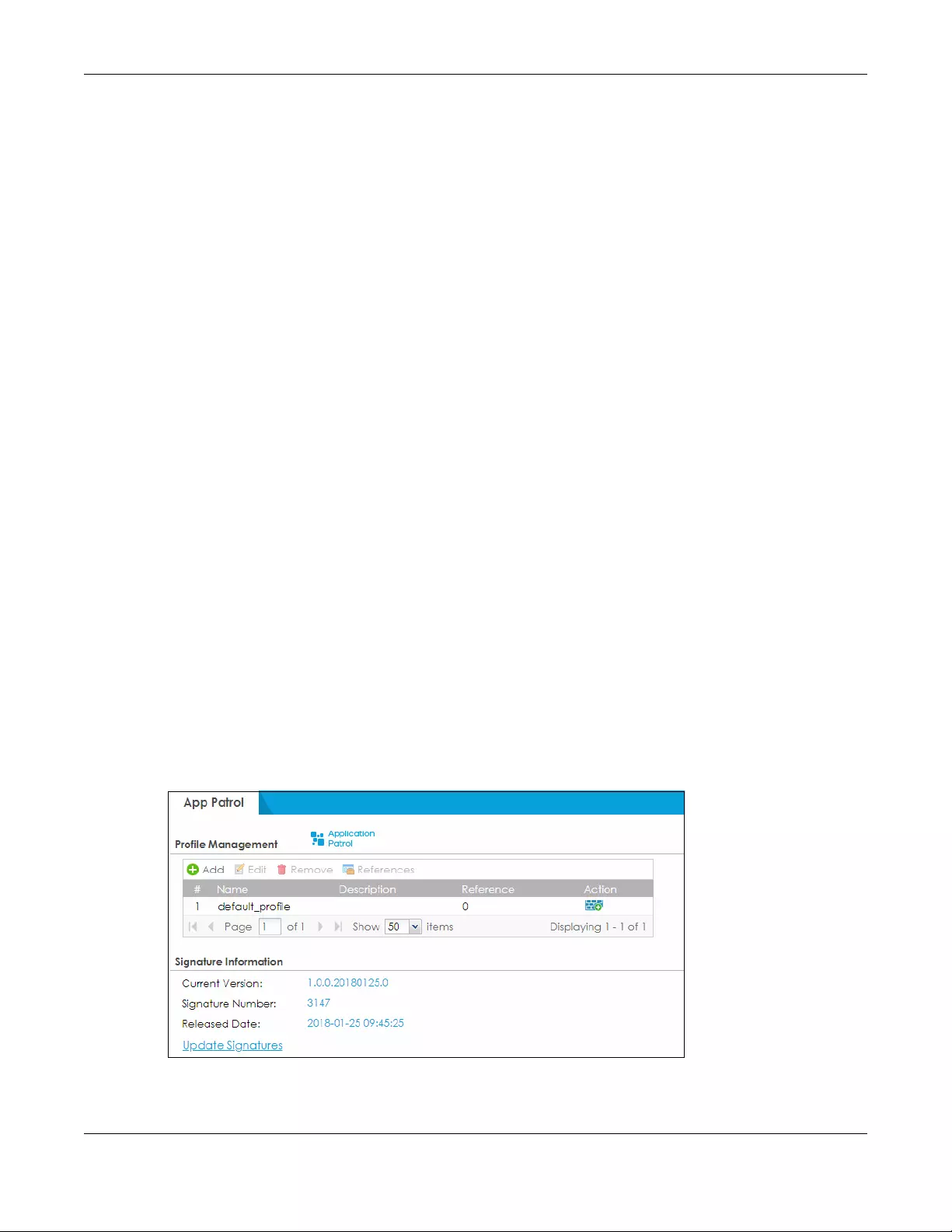
Chapter 31 Application Patrol
ZyWALL USG FLEX Series User’s Guide
587
is correct. Before confirmation, packets are forwarded by App Patrol with no action taken. The number
of packets inspected before confirmation varies by signature.
Note: The Zyxel Device allows the first eight packets to go through the security policy,
regardless of the application patrol policy for the application. The Zyxel Device
examines these first eight packets to identify the application.
The second approach is called service ports. The Zyxel Device uses only OSI level-4 information, such as
ports, to identify what application is using the connection. This approach is available in case the Zyxel
Device identifies a lot of “false positives” for a particular application.
Custom Ports for SIP and the SIP ALG
Configuring application patrol to use custom port numbers for SIP traffic also configures the SIP ALG to
use the same port numbers for SIP traffic. Likewise, configuring the SIP ALG to use custom port numbers
for SIP traffic also configures application patrol to use the same port numbers for SIP traffic.
31.2 Application Patrol Profile
Use the application patrol screens to customize action and log settings for a group of application patrol
signatures. You then link a profile to a policy. Use this screen to create an application patrol profile, and
view signature information. It also lists the registration status and details about the signature set the Zyxel
Device is using.
Note: You must register for the AppPatrol signature service (at least the trial) before you can
use it.
A profile is an application object(s) or application group(s) that has customized action and log settings.
Click Configuration > Security Service > App Patrol to open the following screen.
Click the Application Patrol icon for more information on the Zyxel Device’s security features.
Figure 397 Configuration > Security Service > App Patrol

Chapter 31 Application Patrol
ZyWALL USG FLEX Series User’s Guide
588
The following table describes the labels in this screen.
31.2.1 Profile Action: Apply to a Security Policy
Click the icon in the Action field of an existing application patrol file to apply the profile to a security
policy.
Go to the Configuration > Security Policy > Policy Control screen to check the result.
Table 240 Configuration > Security Service > App Patrol
LABEL DESCRIPTION
Add Click this to create a new entry. Select an entry and click Add to create a new entry after the
selected entry.
Edit Double-click an entry or select it and click Edit to open a screen where you can modify the
entry’s settings.
Remove Select an entry and click Remove to delete the selected entry.
References Select an entry and click References to open a screen that shows which settings use the entry.
Click Refresh to update information on this screen.
#This field is a sequential value showing the number of the profile. The profile order is not
important.
Name This displays the name of the profile created.
Description This displays the description of the App Patrol Profile.
Scan Option This field displays the scan options from the App Patrol profile.
Reference This displays the number of times an object reference is used in a profile.
Action Click this icon to apply the entry to a security policy.
Go to the Configuration > Security Policy > Policy Control screen to check the result.
Signature
Information
The following fields display information on the current signature set that the Zyxel Device is
using.
Current Version This field displays the App Patrol signature set version number. This number gets larger as the set
is enhanced.
Signature
Number
This field displays the number of IDP signatures in this set. This number usually gets larger as the
set is enhanced. Older signatures and rules may be removed if they are no longer applicable
or have been supplanted by newer ones.
Released Date This field displays the date and time the set was released.
Update
Signatures
Click this link to go to the screen you can use to download signatures from the update server.
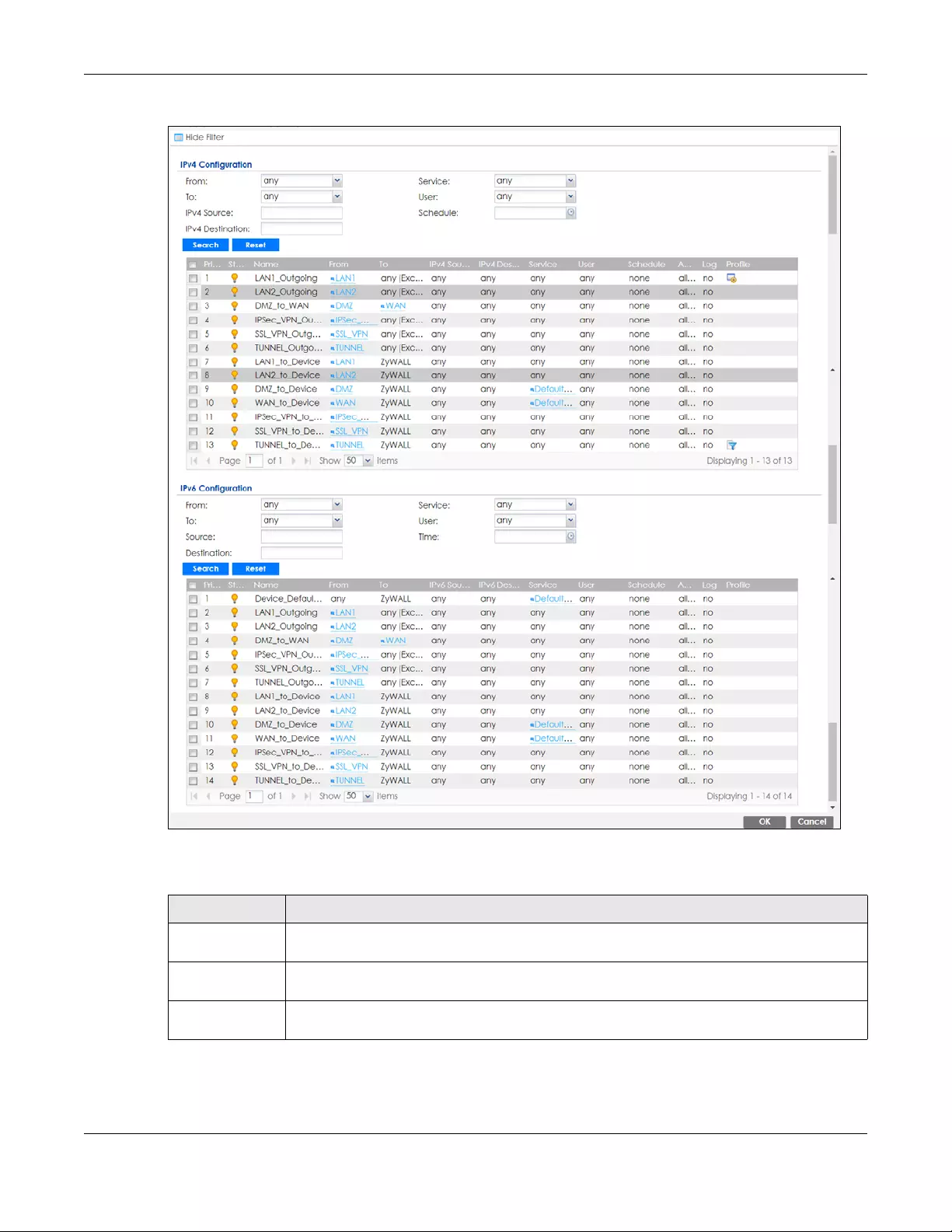
Chapter 31 Application Patrol
ZyWALL USG FLEX Series User’s Guide
589
Figure 398 Configuration > Security Service > App Patrol > Action
The following table describes the labels in this screen.
Table 241 Configuration > Security Service > App Patrol > Action
LABEL DESCRIPTION
Show Filter/Hide
Filter
Click Show Filter to display IPv4 and IPv6 (if enabled) security policy search filters.
IPv4 / IPv6
Configuration
Use IPv4 / IPv6 search filters to find specific IPv4 and IPv6 (if enabled) security policies based on
direction, application, user, source, destination and/or schedule.
From / To Select a zone to view all security policies from a particular zone and/or to a particular zone.
any means all zones.

Chapter 31 Application Patrol
ZyWALL USG FLEX Series User’s Guide
590
IPv4 / IPv6
Source Type an IPv4 or IPv6 IP address to view all security policies based on the IPv4 / IPv6 source
address object used.
• An IPv4 IP address is written as four integer blocks separated by periods. This is an example
IPv4 address: 172.16.6.7.
• An 128-bit IPv6 address is written as eight 16-bit hexadecimal blocks separated by colons
(:). This is an example IPv6 address: 2001:0db8:1a2b:0015:0000:0000:1a2f:0000.
IPv4 / IPv6
Destination Type an IPv4 or IPv6 IP address to view all security policies based on the IPv4 / IPv6 destination
address object used.
• An IPv4 IP address is written as four integer blocks separated by periods. This is an example
IPv4 address: 172.16.6.7.
• An 128-bit IPv6 address is written as eight 16-bit hexadecimal blocks separated by colons
(:). This is an example IPv6 address: 2001:0db8:1a2b:0015:0000:0000:1a2f:0000.
Service View all security policies based the service object used.
User View all security policies based on user or user group object used.
Schedule View all security policies based on the schedule object used.
Priority This is the position of your Security Policy in the global policy list (including all through-Zyxel
Device and to-Zyxel Device policies). The ordering of your policies is important as policies are
applied in sequence. Default displays for the default Security Policy behavior that the Zyxel
Device performs on traffic that does not match any other Security Policy.
Status This icon is lit when the entry is active and dimmed when the entry is inactive.
Name This is the name of the Security policy.
From / To This is the direction of travel of packets. Select from which zone the packets come and to
which zone they go.
Security Policies are grouped based on the direction of travel of packets to which they apply.
For example, from LAN to LAN means packets traveling from a computer or subnet on the LAN
to either another computer or subnet on the LAN.
From any displays all the Security Policies for traffic going to the selected To Zone.
To any displays all the Security Policies for traffic coming from the selected Fr om Zone.
From any to any displays all of the Security Policies.
To ZyWALL policies are for traffic that is destined for the Zyxel Device and control which
computers can manage the Zyxel Device.
IPv4 / IPv6 Source This displays the IPv4 / IPv6 source address object, including geographic address and FQDN
(group) objects, to which this Security Policy applies.
IPv4 / IPv6
Destination
This displays the IPv4 / IPv6 destination address object, including geographic address and
FQDN (group) objects, to which this Security Policy applies.
Service This displays the service object to which this Security Policy applies.
User This is the user name or user group name to which this Security Policy applies.
Schedule This field tells you the schedule object that the policy uses. none means the policy is active at all
times if enabled.
Action This field displays whether the Security Policy silently discards packets without notification
(deny), permits the passage of packets (allow) or drops packets with notification (reject)
Log Select whether to have the Zyxel Device generate a log (log), log and alert (log alert) or not
(no) when the policy is matched to the criteria listed above.
Profile This field shows you which Security Service profiles (application patrol, content filter, IDP, anti-
malware, email security) apply to this Security policy. Click an applied Security Service profile
icon to edit the profile directly.
OK Click OK to save your changes back to the Zyxel Device.
Cancel Click Cancel to exit this screen without saving.
Table 241 Configuration > Security Service > App Patrol > Action
LABEL DESCRIPTION
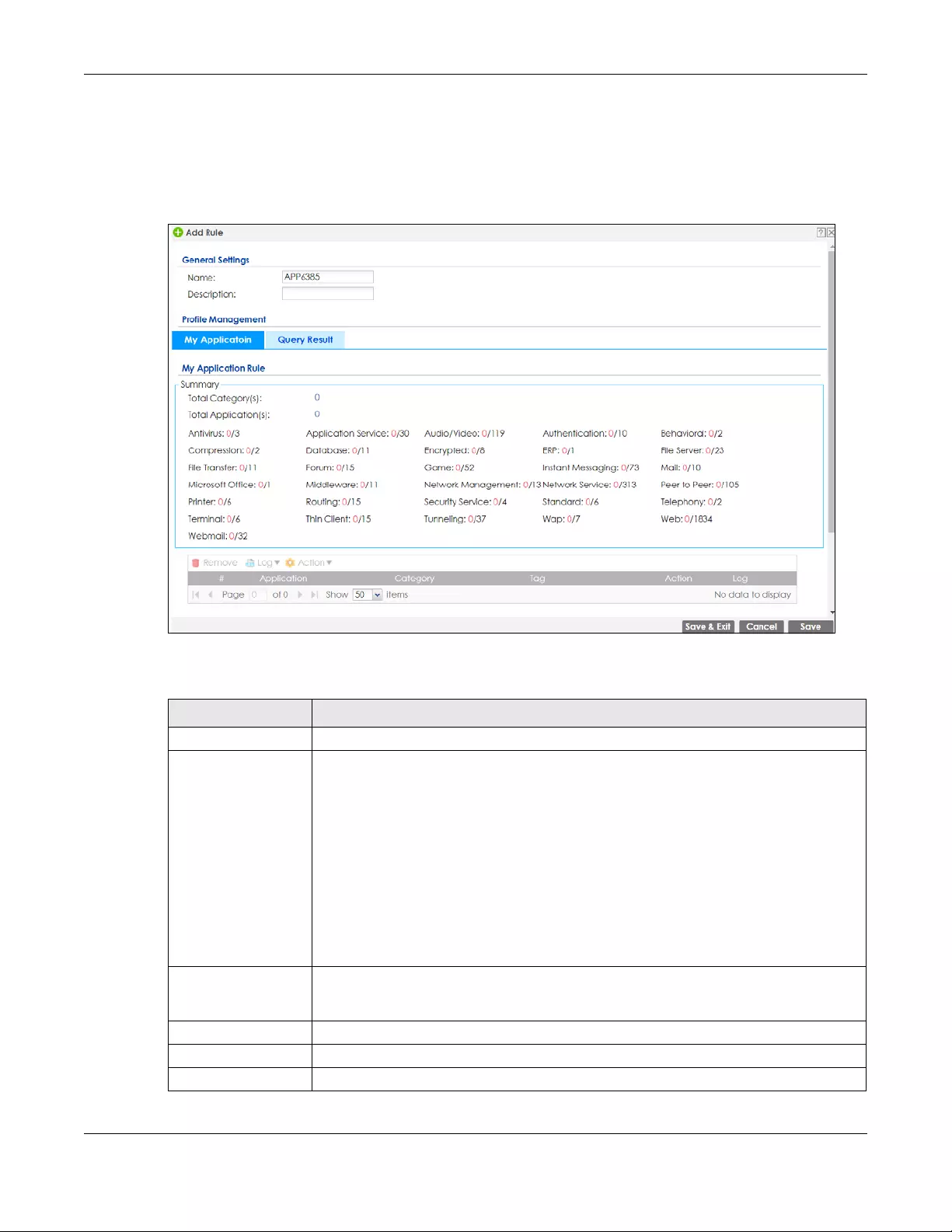
Chapter 31 Application Patrol
ZyWALL USG FLEX Series User’s Guide
591
31.2.2 Application Patrol Profile > Add/Edit - My Application
Use this screen to configure profile settings. Click Configuration > Security Service > App Patrol > Add/
Edit, then click My Application to open the following screen.
Figure 399 Configuration > Security Service > App Patrol > Add/Edit > My Application
The following table describes the labels in this screen.
Table 242 Configuration > Security Service > App Patrol > Add/Edit > My Application
LABEL DESCRIPTION
General Settings
Name Type the name of the profile. You may use 1-31 alphanumeric characters, underscores(_),
or dashes (-), but the first character cannot be a number. This value is case-sensitive. These
are valid, unique profile names:
•MyProfile
•mYProfile
•Mymy12_3-4
These are invalid profile names:
• 1mYProfile
• My Profile
• MyProfile?
• Whatalongprofilename123456789012
Description Type a description for the profile rule to help identify the purpose of rule. You may use 1-31
alphanumeric characters, underscores (_), or dashes (-), but the first character cannot be
a number. This value is case-sensitive. This field is optional.
Total Category(s) This field displays the total number of the selected category(ies) in the Query Result screen.
Total Application(s) This field displays the total number of the selected applications in the Query Result screen.
Remove Select an entry and click Remove to delete the selected entry.

Chapter 31 Application Patrol
ZyWALL USG FLEX Series User’s Guide
592
31.2.3 Application Patrol Profile > Add/Edit - Query Result
Click Configuration > Security Service > App Patrol > Add, then click Query Result to search for certain
applications within a specific category, and the selected applications will be added to My Application
screen. You can also click an existing profile, click Edit (or double-click it), then click Query Result to
open the following screen.
Log Select whether to have the Zyxel Device generate a log (log), log and alert (log alert) or
neither (no) by default when traffic matches a signature in this category.
Action Select the default action for all signatures in this category.
forward - the Zyxel Device routes packets that matches these signatures.
drop - the Zyxel Device silently drops packets that matches these signatures without
notification.
reject - the Zyxel Device drops packets that matches these signatures and sends
notification.
#This field is a sequential value showing the number of the profile. The profile order is not
important.
Application This field displays the application name of the policy.
Category This field displays the category type of the application.
Tag This field displays the tag information of the application.
Action Select the default action for all signatures in this category.
forward - the Zyxel Device routes packets that matches these signatures.
drop - the Zyxel Device silently drops packets that matches these signatures without
notification.
reject - the Zyxel Device drops packets that matches these signatures and sends
notification.
Log Select whether to have the Zyxel Device generate a log (log), log and alert (log alert) or
neither (no) by default when traffic matches a signature in this category.
Save & Exit A profile consists of separate category editing screens. If you want to configure just one
category for a profile, click OK to save your settings to the Zyxel Device, complete the
profile and return to the profile summary page.
Cancel Click Cancel to return to the profile summary page without saving any changes.
Save If you want to configure more than one category for a profile, click Save to save your
settings to the Zyxel Device without leaving this page.
Table 242 Configuration > Security Service > App Patrol > Add/Edit (continued)> My Application
LABEL DESCRIPTION

Chapter 31 Application Patrol
ZyWALL USG FLEX Series User’s Guide
593
Figure 400 Configuration > Security Service > App Patrol > Add/Edit > Query Result
The following table describes the labels in this screen.
Table 243 Configuration > Security Service > App Patrol > Add/Edit > Query Result
LABEL DESCRIPTION
General Settings
Name Type the name of the profile. You may use 1-31 alphanumeric characters, underscores(_),
or dashes (-), but the first character cannot be a number. This value is case-sensitive. These
are valid, unique profile names:
•MyProfile
•mYProfile
•Mymy12_3-4
These are invalid profile names:
• 1mYProfile
• My Profile
• MyProfile?
• Whatalongprofilename123456789012
Description Type a description for the profile rule to help identify the purpose of rule. You may use 1-31
alphanumeric characters, underscores (_), or dashes (-), but the first character cannot be
a number. This value is case-sensitive. This field is optional.
Search Application(s)
By Name
Enter a name to search for relevant applications.
Search Application(s)
By Category
Select a category(ies) below to search for relevant applications.
Filter by Tags Add or delete a tag(s) to display or not display an application(s).
#This field is a sequential value showing the number of the profile. The profile order is not
important.
Application This field displays the application name of the policy.
Category This field displays the category type of the application.
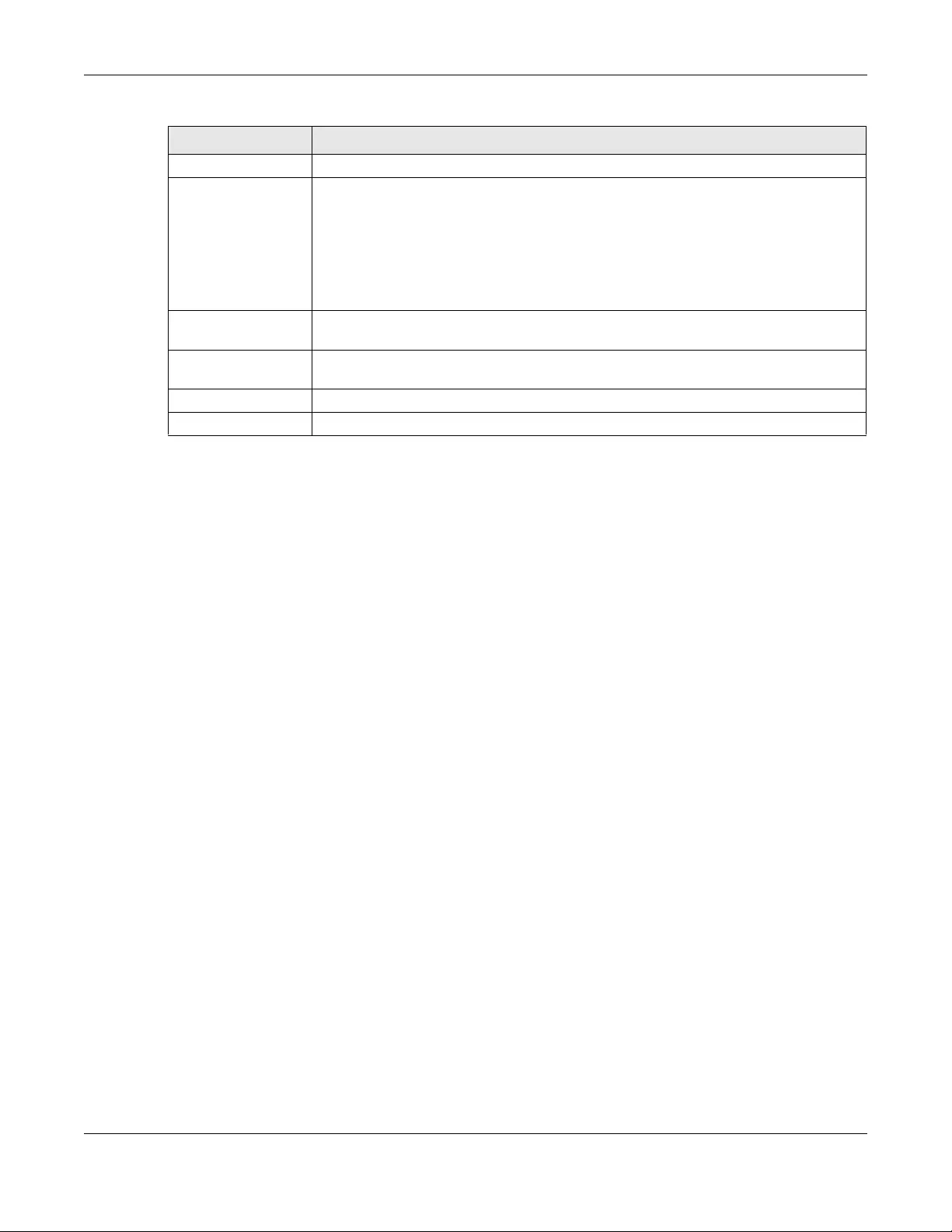
Chapter 31 Application Patrol
ZyWALL USG FLEX Series User’s Guide
594
Tag This field displays the tag information of the policy.
Action Select the default action for all signatures in this category.
forward - the Zyxel Device routes packets that matches these signatures.
drop - the Zyxel Device silently drops packets that matches these signatures without
notification.
reject - the Zyxel Device drops packets that matches these signatures and sends
notification.
Log Select whether to have the Zyxel Device generate a log (log), log and alert (log alert) or
neither (no) by default when traffic matches a signature in this category.
Add to My
Application
Select an application(s) to show in the My Application profile screen.
Reset Click this button to reset the fields to default settings.
Cancel Click Cancel to return to the profile summary page without saving any changes.
Table 243 Configuration > Security Service > App Patrol > Add/Edit (continued)> Query Result
LABEL DESCRIPTION

ZyWALL USG FLEX Series User’s Guide
595
CHAPTER 32
Content Filter
32.1 Overview
Use the content filtering feature to control access to specific web sites or web content.
32.1.1 What You Can Do in this Chapter
• Use the Filter Profile screens (Section 32.2 on page 597) to set up content filtering profiles.
• Use the Trusted Web Sites screens (Section 32.3 on page 616) to create a common list of good
(allowed) web site addresses.
• Use the Forbidden Web Sites screens (Section 32.4 on page 617) to create a common list of bad
(blocked) web site addresses.
32.1.2 What You Need to Know
Content Filtering
Content filtering allows you to block certain web features, such as cookies, and/or block access to
specific web sites. It can also block access to specific categories of web site content. You can create
different content filter policies for different addresses, schedules, users or groups and content filter
profiles. For example, you can configure one policy that blocks John Doe’s access to arts and
entertainment web pages during the workday and another policy that lets him access them after work.
Content Filtering Policies
A content filtering policy allows you to do the following.
• Use schedule objects to define when to apply a content filter profile.
• Use address and/or user/group objects to define to whose web access to apply the content filter
profile.
• Apply a content filter profile that you have custom-tailored.
Content Filtering Profiles
A content filtering profile conveniently stores your custom settings for the following features.
• Category-based Blocking
The Zyxel Device can block access to particular categories of web site content, such as pornography
or racial intolerance.

Chapter 32 Content Filter
ZyWALL USG FLEX Series User’s Guide
596
• Restrict Web Features
The Zyxel Device can disable web proxies and block web features such as ActiveX controls, Java
applets and cookies.
• Customize Web Site Access
You can specify URLs to which the Zyxel Device blocks access. You can alternatively block access to
all URLs except ones that you specify. You can also have the Zyxel Device block access to URLs that
contain particular keywords.
Content Filtering Configuration Guidelines
When the Zyxel Device receives an HTTP request, the content filter searches for a policy that matches
the source address and time (schedule). The content filter checks the policies in order (based on the
policy numbers). When a matching policy is found, the content filter allows or blocks the request
depending on the settings of the filtering profile specified by the policy. Some requests may not match
any policy. The Zyxel Device allows the request if the default policy is not set to block. The Zyxel Device
blocks the request if the default policy is set to block.
External Web Filtering Service
When you register for and enable the external web filtering service, your Zyxel Device accesses an
external database that has millions of web sites categorized based on content. You can have the Zyxel
Device block, block and/or log access to web sites based on these categories.
HTTPS Domain Filter
HTTPS Domain Filter works with the Content Filter category feature to identify HTTPS traffic and take
appropriate action. SSL Inspection identifies HTTPS traffic for all Security Service traffic and has higher
priority than HTTPS Domain Filter. HTTPS Domain Filter only identifies keywords in the domain name of an
URL and matches it to a category. For example, if the keyword is 'picture' and the URL is http://
www.google.com/picture/index.htm, then HTTPS Domain Filter cannot identify 'picture' because that
keyword in not in the domain name 'www.google.com'. However, SSL Inspection can identify 'picture' in
the URL http://www.google.com/picture/index.htm.
Keyword Blocking URL Checking
The Zyxel Device checks the URL’s domain name (or IP address) and file path separately when
performing keyword blocking.
The URL’s domain name or IP address is the characters that come before the first slash in the URL. For
example, with the URL www.zyxel.com.tw/news/pressroom.php, the domain name is
www.zyxel.com.tw.
The file path is the characters that come after the first slash in the URL. For example, with the URL
www.zyxel.com.tw/news/pressroom.php, the file path is news/pressroom.php.
Since the Zyxel Device checks the URL’s domain name (or IP address) and file path separately, it will not
find items that go across the two. For example, with the URL www.zyxel.com.tw/news/pressroom.php,
the Zyxel Device would find “tw” in the domain name (www.zyxel.com.tw). It would also find “news” in
the file path (news/pressroom.php) but it would not find “tw/news”.
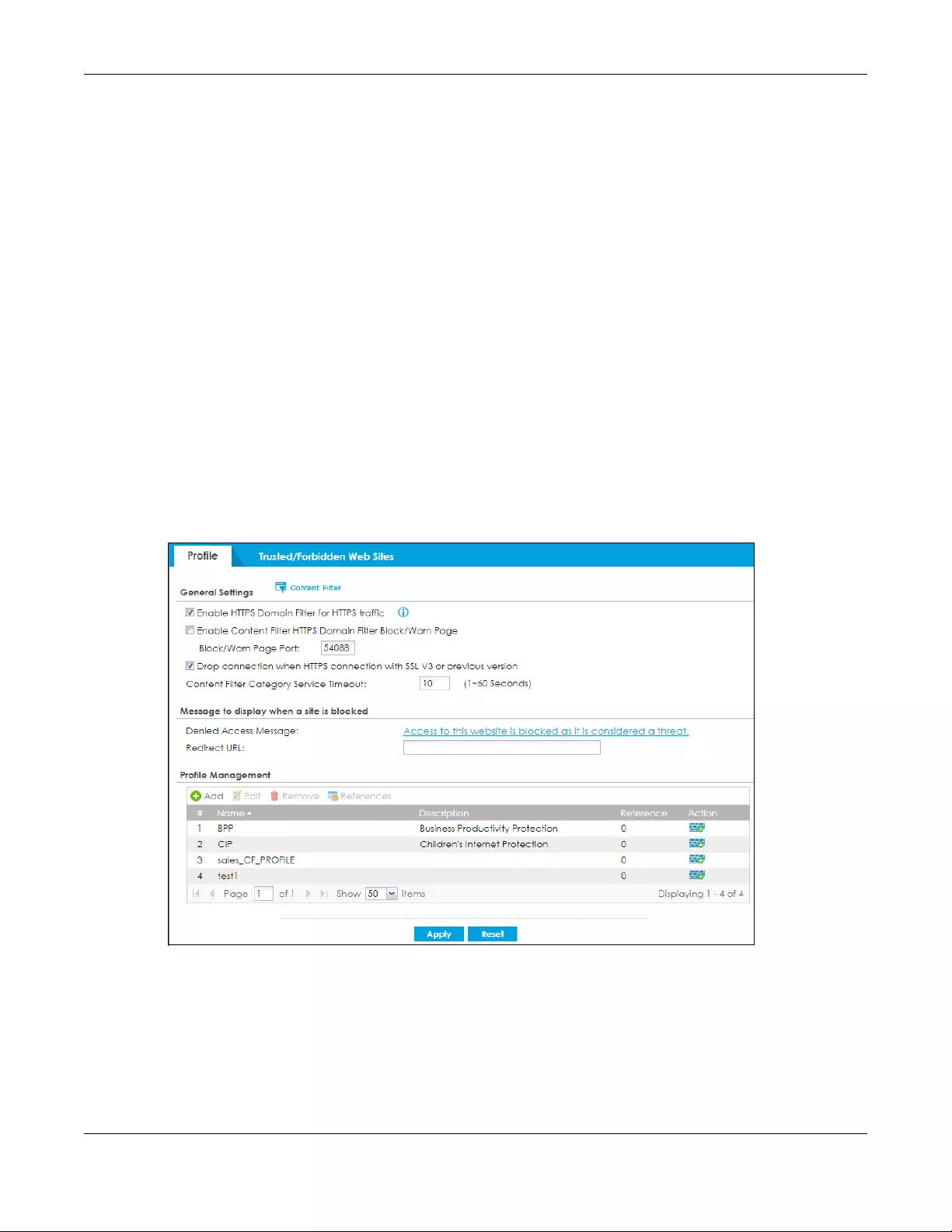
Chapter 32 Content Filter
ZyWALL USG FLEX Series User’s Guide
597
Finding Out More
•See Section 32.5 on page 618 for content filtering background/technical information.
32.1.3 Before You Begin
• You must configure an address object, a schedule object and a filtering profile before you can set up
a content security policy.
• You must have Content Filtering license in order to use the function.subscribe to use the external
database content filtering (see the Licensing > Registration screens).
32.2 Content Filter Profile Screen
Click Configuration > Security Service> Content Filter > Profile to open the Content Filter Profile screen.
Use this screen to enable content filtering, view and order your list of content filter policies, create a
denial of access message or specify a redirect URL and check your external web filtering service
registration status.
Click the Content Filter icon for more information on the Zyxel Device’s security features.
Figure 401 Configuration > Security Service > Content Filter > Profile

Chapter 32 Content Filter
ZyWALL USG FLEX Series User’s Guide
598
The following table describes the labels in this screen.
32.2.1 Apply to a Security Policy
Click the icon in the Action field to apply the entry to a security policy.
Table 244 Configuration > Security Service > Content Filter > Profile
LABEL DESCRIPTION
General Settings
Enable HTTPS Domain Filter
for HTTPS traffic
Select this check box to have the Zyxel Device block HTTPS web pages using the
cloud category service.
In an HTTPS connection, the Zyxel Device can extract the Server Name Indication
(SNI) from a client request, check if it matches a category in the cloud content filter
and then take appropriate action. The keyword match is for the domain name only.
Enable Content Filter HTTPS
Domain Filter Block/Warn
Page
Use this field to have the Zyxel Device display a warning page instead of a blank
page when an HTPPS connection is redirected.
Block/Warn Page Port Use the default port number as displayed for the warning page. If you change it, the
new port number should be unique.
Drop connection when
HTTPS connection with SSL
V3 or previous version
Select this check box to have the Zyxel Device block HTTPS web pages using SSL V3 or
a previous version.
Content Filter Category
Service Timeout
Specify the allowable time period in seconds for accessing the external web filtering
service’s server.
Denied Access Message Enter a message to be displayed when content filter blocks access to a web page.
Use up to 127 characters (0-9a-zA-Z;/?:@&=+$\.-_!~*'()%,”). For example, “Access to
this web page is not allowed. Please contact the network administrator”.
It is also possible to leave this field blank if you have a URL specified in the Redirect URL
field. In this case if the content filter blocks access to a web page, the Zyxel Device
just opens the web page you specified without showing a denied access message.
Redirect URL Enter the URL of the web page to which you want to send users when their web
access is blocked by content filter. The web page you specify here opens in a new
frame below the denied access message.
Use “http://” or “https://” followed by up to 262 characters (0-9a-zA-Z;/?:@&=+$\.-
_!~*'()%). For example, http://192.168.1.17/blocked access.
Profile Management
Add Click Add to create a new content filter rule.
Edit Click Edit to make changes to a content filter rule.
Remove Click Remove the delete a content filter rule.
References Select an entry and click References to open a screen that shows which settings use
the entry. Click Refresh to update information on this screen.
#This column lists the index numbers of the content filter profile.
Name This column lists the names of the content filter profile rule.
Description This column lists the description of the content filter profile rule.
Reference This displays the number of times an Object Reference is used in a rule.
Action Click this icon to apply the content filter profile with a security policy.
Go to the Configuration > Security Policy > Policy Control screen to check the result.
Apply Click Apply to save your changes back to the Zyxel Device.
Reset Click Reset to return the screen to its last-saved settings.
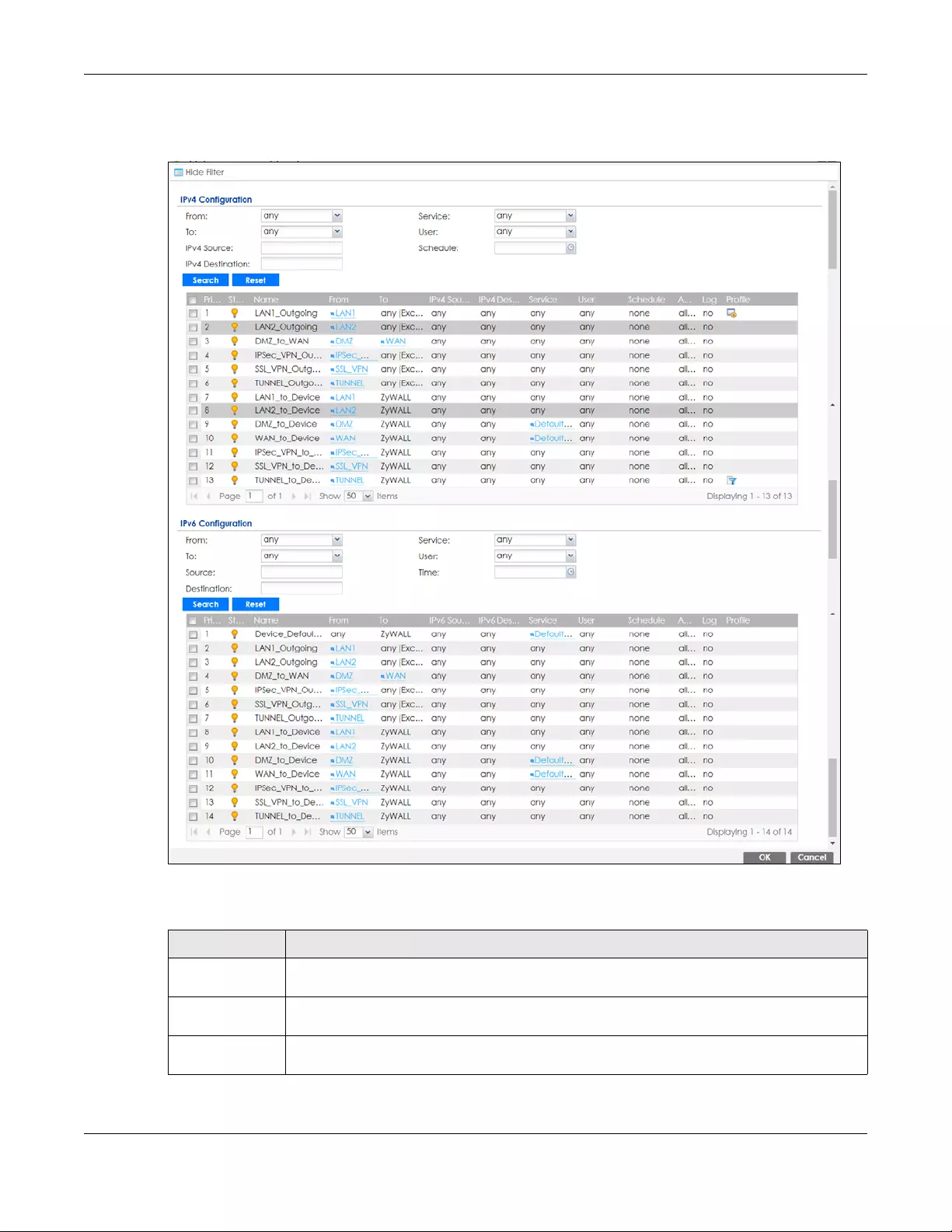
Chapter 32 Content Filter
ZyWALL USG FLEX Series User’s Guide
599
Go to the Configuration > Security Policy > Policy Control screen to check the result.
Figure 402 Configuration > Security Service > Content Filter > Action
The following table describes the labels in this screen.
Table 245 Configuration > Security Service > Content Filter > Action
LABEL DESCRIPTION
Show Filter/Hide
Filter
Click Show Filter to display IPv4 and IPv6 (if enabled) security policy search filters.
IPv4 / IPv6
Configuration
Use IPv4 / IPv6 search filters to find specific IPv4 and IPv6 (if enabled) security policies based on
direction, application, user, source, destination and/or schedule.
From / To Select a zone to view all security policies from a particular zone and/or to a particular zone.
any means all zones.

Chapter 32 Content Filter
ZyWALL USG FLEX Series User’s Guide
600
IPv4 / IPv6
Source Type an IPv4 or IPv6 IP address to view all security policies based on the IPv4 / IPv6 source
address object used.
• An IPv4 IP address is written as four integer blocks separated by periods. This is an example
IPv4 address: 172.16.6.7.
• An 128-bit IPv6 address is written as eight 16-bit hexadecimal blocks separated by colons
(:). This is an example IPv6 address: 2001:0db8:1a2b:0015:0000:0000:1a2f:0000.
IPv4 / IPv6
Destination Type an IPv4 or IPv6 IP address to view all security policies based on the IPv4 / IPv6 destination
address object used.
• An IPv4 IP address is written as four integer blocks separated by periods. This is an example
IPv4 address: 172.16.6.7.
• An 128-bit IPv6 address is written as eight 16-bit hexadecimal blocks separated by colons
(:). This is an example IPv6 address: 2001:0db8:1a2b:0015:0000:0000:1a2f:0000.
Service View all security policies based the service object used.
User View all security policies based on user or user group object used.
Schedule View all security policies based on the schedule object used.
Priority This is the position of your Security Policy in the global policy list (including all through-Zyxel
Device and to-Zyxel Device policies). The ordering of your policies is important as policies are
applied in sequence. Default displays for the default Security Policy behavior that the Zyxel
Device performs on traffic that does not match any other Security Policy.
Status This icon is lit when the entry is active and dimmed when the entry is inactive.
Name This is the name of the Security policy.
From / To This is the direction of travel of packets. Select from which zone the packets come and to
which zone they go.
Security Policies are grouped based on the direction of travel of packets to which they apply.
For example, from LAN to LAN means packets traveling from a computer or subnet on the LAN
to either another computer or subnet on the LAN.
From any displays all the Security Policies for traffic going to the selected To Zone.
To any displays all the Security Policies for traffic coming from the selected Fr om Zone.
From any to any displays all of the Security Policies.
To ZyWALL policies are for traffic that is destined for the Zyxel Device and control which
computers can manage the Zyxel Device.
IPv4 / IPv6 Source This displays the IPv4 / IPv6 source address object, including geographic address and FQDN
(group) objects, to which this Security Policy applies.
IPv4 / IPv6
Destination
This displays the IPv4 / IPv6 destination address object, including geographic address and
FQDN (group) objects, to which this Security Policy applies.
Service This displays the service object to which this Security Policy applies.
User This is the user name or user group name to which this Security Policy applies.
Schedule This field tells you the schedule object that the policy uses. none means the policy is active at all
times if enabled.
Action This field displays whether the Security Policy silently discards packets without notification
(deny), permits the passage of packets (allow) or drops packets with notification (reject)
Log Select whether to have the Zyxel Device generate a log (log), log and alert (log alert) or not
(no) when the policy is matched to the criteria listed above.
Profile This field shows you which Security Service profiles (application patrol, content filter, IDP, anti-
malware, email security) apply to this Security policy. Click an applied Security Service profile
icon to edit the profile directly.
OK Click OK to save your changes back to the Zyxel Device.
Cancel Click Cancel to exit this screen without saving.
Table 245 Configuration > Security Service > Content Filter > Action
LABEL DESCRIPTION

Chapter 32 Content Filter
ZyWALL USG FLEX Series User’s Guide
601
32.2.2 Content Filter Add Profile Category Service
Click Configuration > Security Service > Content Filter > Profile > Add or Edit to open the Add Filter Profile
screen.
Figure 403 Content Filter > Profile > Add Filter Profile > Category Service

Chapter 32 Content Filter
ZyWALL USG FLEX Series User’s Guide
602
The following table describes the labels in this screen.
Table 246 Configuration > Security Service > Content Filter > Profile > Add > Category Service
LABEL DESCRIPTION
Name Enter a descriptive name for this content filtering profile name. You may use 1-31
alphanumeric characters, underscores(_), or dashes (-), but the first character
cannot be a number. This value is case-sensitive.
Description Enter a description for the content filtering profile rule to help identify the purpose
of rule. You may use 1-31 alphanumeric characters, underscores(_), or dashes (-),
but the first character cannot be a number. This value is case-sensitive.
This field is optional.
Enable SafeSearch SafeSearch is a search engine that can automatically filter sexually explicit videos
and images from the search result without overloading the Zyxel Device. It does
this by adding a parameter in the search URL:
https://www.google.com.tw/?gws_rd=ssl#q=porn&safe=active.
Supported search engines at the time of writing are:
Yahoo, Google, MSN Live Bing, Yandex
Enable Content Filter
Category Service
Enable external database content filtering to have the Zyxel Device check an
external database to find to which category a requested web page belongs. The
Zyxel Device then blocks or forwards access to the web page depending on the
configuration of the rest of this page.
Log all web pages Select this to record attempts to access web pages when:
• They match the other categories that you select below.
• They are not categorized.
• The external content filtering database is unavailable.
Action for Managed Web
Pages Select Pass to allow users to access web pages that match the other categories
that you select below.
Select Block to prevent users from accessing web pages that match the other
categories that you select below. When external database content filtering
blocks access to a web page, it displays the denied access message that you
configured in the Content Filter General screen along with the category of the
blocked web page.
Select Log to record attempts to access web pages that match the other
categories that you select below.
Action for Unrated Web
Pages Select Pass to allow users to access web pages that the external web filtering
service has not categorized.
Select Block to prevent users from accessing web pages that the external web
filtering service has not categorized. When the external database content filtering
blocks access to a web page, it displays the denied access message that you
configured in the Content Filter General screen along with the category of the
blocked web page.
Select Warn to display a warning message before allowing users to access web
pages that the external web filtering service has not categorized.
Select Log to record attempts to access web pages that are not categorized.

Chapter 32 Content Filter
ZyWALL USG FLEX Series User’s Guide
603
The following table describes the managed categories.
Action When Category
Server Is Unavailable Select Pass to allow users to access any requested web page if the external
content filtering database is unavailable.
Select Block to block access to any requested web page if the external content
filtering database is unavailable.
Select Warn to display a warning message before allowing users to access any
requested web page if the external content filtering database is unavailable.
The following are possible causes for the external content filtering server not being
available:
• There is no response from the external content filtering server within the time
period specified in the Content Filter Server Unavailable Timeout field.
• The Zyxel Device is not able to resolve the domain name of the external
content filtering database.
• There is an error response from the external content filtering database. This can
be caused by an expired content filtering registration (External content
filtering’s license key is invalid”).
Select Log to record attempts to access web pages that occur when the external
content filtering database is unavailable.
Select Categories
Select All Categories Select this check box to restrict access to all site categories listed below.
Clear All Categories Select this check box to clear the selected categories below.
Managed Categories These are categories of web pages based on their content. Select categories in
this section to control access to specific types of Internet content.
You must have the Category Service content filtering license to filter these
categories. See the next table for category details.
Test Web Site Category
URL to test You can check which category a web page belongs to. Enter a web site URL in
the text box.
When the content filter is active, you should see the web page’s category. The
query fails if the content filter is not active.
Content Filtering can query a category by full URL string (for example, http://
www.google.com/picture/index.htm), but HTTPS Domain Filter can only query a
category by domain name ('www.google.com'), so the category may be
different in the query result. URL to test displays both results in the test.
If you think the category is
incorrect
Click this link to see the category recorded in the Zyxel Device’s content filtering
database for the web page you specified (if the database has an entry for it).
Test Against Content Filter
Category Server
Click this button to see the category recorded in the external content filter server’s
database for the web page you specified.
OK Click OK to save your changes back to the Zyxel Device.
Cancel Click Cancel to exit this screen without saving your changes.
Table 247 Managed Category Descriptions
CATEGORY DESCRIPTION
Adult Topics Web pages that contain content or themes that are generally considered
unsuitable for children.
Alcohol Web pages that mainly sell, promote, or advocate the use of alcohol, such as
beer, wine, and liquor.
This category also includes cocktail recipes and home-brewing instructions.
Table 246 Configuration > Security Service > Content Filter > Profile > Add > Category Service
LABEL DESCRIPTION

Chapter 32 Content Filter
ZyWALL USG FLEX Series User’s Guide
604
Anonymizing Utilities Web pages that result in anonymous web browsing without the explicit intent to
provide such a service.
This category includes URL translators, web-page caching, and other utilities that
might function as anonymizers, but without the express purpose of bypassing
filtering software.
This category does not include text translation.
Art Culture Heritage Web pages that contain virtual art galleries, artist sites (including sculpture and
photography), museums, ethnic customs, and country customs.
This category does not include online photograph albums.
Auctions Classifieds Web pages that provide online bidding and selling of items or services.
This category includes web pages that focus on bidding and sales.
This category does not include classified advertisements such as real estate
postings, personal ads, or companies marketing their auctions.
Blogs/Wiki Web pages containing dynamic content, which often changes because users
can post or edit content at any time.
This category covers the risks with dynamic content that might range from
harmless to offensive.
Business Web pages that provide business-related information, such as corporate
overviews or business planning and strategies.
This category also includes information, services, or products that help other
businesses plan, manage, and market their enterprises, and multi-level marketing.
This category does not include personal pages and web-hosting web pages.
Chat Web pages that provide web-based, real-time social messaging in public and
private chat rooms. This category includes IRC.
This category does not include instant messaging.
Computing Internet Web pages containing reviews, information, buyer's guides of computers,
computer parts and accessories, computer software and internet companies,
industry news and magazines, and pay-to-surf sites.
Consumer Protection Websites that try to rob or cheat consumers.
Some examples of their activities include selling counterfeit products, selling
products that were originally provided for free, or improperly using the brand of
another company. This category also includes sites where many consumers
reported being cheated or not receiving services.
This category does not include phishing, which tries to perpetrate fraud or theft by
stealing account information.
Content Server URLs for servers that host images, media files, or JavaScript for one or more sites
and are intended to speed up content retrieval for existing web servers, such as
Apache.
This category includes domain-level and sub-domain-level URLs that function as
content servers.
This category does not include:
• Web pages for businesses that provide the content servers
• Web pages that allow users to browse photographs. See the Media Sharing
category.
• URLs for servers that serve only advertisements. See the Web Ads category.
Table 247 Managed Category Descriptions (continued)

Chapter 32 Content Filter
ZyWALL USG FLEX Series User’s Guide
605
Controversial Opinions Web pages that contain opinions that are likely to offend political or social
sensibilities and incite controversy. Much of this content is at the extremes of public
opinion.
This category does not include opinion or language clearly intended to promote
hate or discrimination.
Cult Occult Sites relating to non-traditional religious practices considered to be false,
unorthodox, extremist, or coercive.
Dating Personals Web pages that provide networking for online dating, matchmaking, escort
services, or introductions to potential spouses.
This category does not include sites that provide social networking that might
include dating, but are not specific to dating.
Dating Social Networking Web pages that focus on social interaction such as online dating, friendship,
school reunions, pen-pals, escort services, or introductions to potential spouses.
This category does not include wedding-related content, dating tips, or related
marketing.
Digital Postcards Web pages that allow people to send and receive digital postcards and greeting
cards via the Internet.
Discrimination Web pages, which provide information that explicitly encourages the oppression
or discrimination of a specific group of individuals.
This category does not include jokes and humor, unless the focus of the entire site
is considered discriminatory.
Drugs Websites that provide information on the purchase, manufacture, and use of
illegal or recreational drugs.
This category does not include sites with exclusive health or political themes.
Education Reference Web pages devoted to academic-related content such as academic subjects
(mathematics, history), school or university web pages, and education
administration pages (school boards, teacher curriculum).
Entertainment Web pages that provide information about cinema, theater, music, television,
infotainment, entertainment industry gossip-news, and sites about celebrities such
as actors and musicians.
This category also includes sites where the content is devoted to providing
entertainment on the web, such as horoscopes or fan clubs.
Extreme Web pages that provide content considered gory, perverse, or horrific.
Fashion Beauty Web pages that market clothing, cosmetics, jewelry, and other fashion-oriented
products, accessories, or services.
This category also includes product reviews, comparisons, and general consumer
information, and services such as hair salons, tanning salons, tattoo studios, and
body-piercing studios.
This category does not include fashion-related content such as modeling or
celebrity fashion unless the site focuses on marketing the product line.
Finance Banking Web pages that provide financial information or access to online financial
accounts.
This category includes stock information (but not stock trading), home finance,
and government-related financial information.
For Kids Web pages that are family-safe, specifically for children of approximate ages ten
and under.
This category can also be used as an exception to allow web pages that do not
pose a risk to children, or to access sites that have a primary educational or
recreational focus for children, but are in other categories such as Games, Humor/
Comics, Recreation/Hobbies, or Entertainment.
Table 247 Managed Category Descriptions (continued)

Chapter 32 Content Filter
ZyWALL USG FLEX Series User’s Guide
606
Forum Bulletin Boards Web pages that provide access (http://) to Usenet newsgroups or hold discussions
and post user-generated content, such as real-time message posting for an
interest group. This category also includes archives of files uploaded to
newsgroups.
This category does not include message forums with a business or technical
support focus.
Gambling Web pages that allow users to wager or place bets online, or provide gambling
software that allows online betting, such as casino games, betting pools, sports
betting, and lotteries.
This category does not include web pages related to gambling that do not allow
betting online.
Gambling Related Web pages that offer information about gambling, without providing the means
to gamble.
This category includes casino-related web pages that do not offer online
gambling, gambling links, tips, sports picks, lottery results, and horse, car, or boat
racing.
Game Cartoon Violence Web pages that provide fantasy or fictitious representations of violence within the
context of games, comics, cartoons, or graphic novels.
This category includes images and textual descriptions of physical assaults or
hand-to-hand combat, and grave injury and destruction caused by weapons or
explosives.
Games Web pages that offer online games and related information such as cheats,
codes, demos, emulators, online contests or role-playing games, gaming clans,
game manufacturer sites, fantasy or virtual sports leagues, and other gaming sites
without chances of profit.
This category includes gaming consoles.
General News Web pages that provide online news media, such as international or regional news
broadcasting and publication.
This category includes portal sites that provide news content.
Government Military Web pages that contain content maintained by governmental or military
organizations, such as government branches or agencies, police departments, fire
departments, civil defense, counter-terrorism organizations, or supranational
organizations, such as the United Nations or the European Union.
This category includes military and veterans’ medical facilities.
Gruesome Content Web pages with content that can be considered tasteless, gross, shocking, or
gruesome.
This category does not include web pages with content pertaining to physical
assault.
Health Web pages that cover all health-related information and health care services.
This category does not include cosmetic surgery, marketing/selling
pharmaceuticals, or animal-related medical services.
Historical Revisionism Web pages that denounce, or offer different interpretations of, significant
historical facts, such as holocaust denial.
This category does not include all re-examination of historical facts, only historical
events that are highly sensitive.
History Web pages that provide content about historical facts.
This category includes content suitable for higher education, but the Education
category includes content for primary education. For example, a site with
Holocaust photographs might be offensive, but have academic value.
Table 247 Managed Category Descriptions (continued)

Chapter 32 Content Filter
ZyWALL USG FLEX Series User’s Guide
607
Humor Comics Web pages that provide comical or funny content.
This category includes sites with jokes, sketches, comics, and satire pages. This
category might also include graphic novel content, which is often associated with
comics.
Illegal UK Web pages that contain child sexual abuse content hosted anywhere in the
world, and criminally obscene and incitement to racial hatred content hosted in
the UK.
Incidental Nudity Web pages that contain non-pornographic images of the bare human body like
those in classic sculpture and paintings, or medical images.
This category enables you to allow or block sites in order to address cultural or
geographic differences in opinion about nudity. For example, you can use this
category to block access to nudity, but allow access when nudity is not the
primary focus of a site, such as news sites or major portals.
Information Security Web pages that legitimately provide information about data protection. This
category includes detailed information for safeguarding business or personal
data, intellectual property, privacy, and infrastructure on the Internet, private
networks, or in other bandwidth services such as telecommunications.
This category does not include:
• Legitimate information security companies and security software providers,
such as virus protection companies.
• Sites that intend to exploit security or teach how to bypass security.
Information Security New Web pages that legitimately provide information about data protection. This
category includes detailed information for safeguarding business or personal
data, intellectual property, privacy, and infrastructure on the Internet, private
networks, or in other bandwidth services such as telecommunications.
This category does not include:
• Legitimate information security companies and security software providers,
such as virus protection companies.
• Sites that intend to exploit security or teach how to bypass security.
Instant Messaging Web pages that provide software for real-time communication over a network
exclusively for users who joined a member’s contact list or an instant-messaging
session.
Most instant-messaging software includes features such as file transfer, PC-to-PC
phone calls, and can track when other people log on and off.
Interactive Web Applications Web pages that provide access to live or interactive web applications, such as
browser-based office suites and groupware. This category includes sites with
business, academic, or individual focus.
This category does not include sites providing access to interactive web
applications that do not take critical user data or offer security risks, such as
Google Maps.
Internet Radio TV Web pages that provide software or access to continuous audio or video
broadcasting, such as Internet radio, TV programming, or podcasting.
Quick downloads and shorter streams that consume less bandwidth are in the
Streaming Media or Media Downloads categories.
Internet Services Web pages that provide services for publication and maintenance of Internet sites
such as web design, domain registration, Internet Service Providers, and
broadband and telecommunications companies that provide web services.
This category includes web utilities such as statistics and access logs, and web
graphics like clip art.
Table 247 Managed Category Descriptions (continued)

Chapter 32 Content Filter
ZyWALL USG FLEX Series User’s Guide
608
Job Search Web pages related to a job search including sites concerned with resume writing,
interviewing, changing careers, classified advertising, and large job databases.
This category also includes corporate web pages that list job openings, salary
comparison sites, temporary employment, and company job-posting sites.
This category does not include make-money-at-home sites.
Major Global Religions Web pages with content about religious topics and information related to major
religions. This category includes sites that cover religious content such as
discussion, beliefs, non-controversial commentary, articles, and information for
local congregations such as a church or synagogue homepage.
The religions in this category are Baha'i, Buddhism, Chinese Traditional, Christianity,
Hinduism, Islam, Jainism, Judaism, Shinto, Sikhism, Tenrikyo, Zoroastrianism.
Marketing Merchandising Web pages that promote individual or business products or services on the web,
but do not sell their products or services online.
This category includes websites that are generally a company overview,
describing services or products that cannot be purchased directly from these sites.
Examples include automobile manufacturer sites, wedding photography services,
or graphic design services.
This category does not include:
• Other categories that imply marketing such as Alcohol, Auctions/Classifieds,
Drugs, Finance/Banking, Mobile Phone, Online Shopping, Real Estate, School
Cheating Information, Software/Hardware, Stock Trading, Tobacco, Travel,
and Weapons.
• Sites that market their services only to other businesses. See the Business
category.
• Sites that rob or cheat consumers. See the Consumer Protection category.
Media Downloads Web pages that provide audio or video files for download such as MP3, WAV, AVI,
and MPEG formats. The files are saved to, and played from, the user’s computer.
This category does not include audio or video files that are played directly through
a browser window. See the Streaming Media category.
Media Sharing Web pages that allow users to upload, search for, and share media files and
photographs, such as online photograph albums.
Messaging Examples include text messaging to mobile phones, PDAs, fax machines, and
internal website user-to-user messaging or site-to-site messaging.
This category does not include real-time chat or instant messaging, or message
posts that can be viewed by anyone but the intended recipient.
Mobile Phone Web pages that sell media, software, or utilities for mobile phones that can be
downloaded and delivered to mobile phones.
Examples include ringtones, logos/skins, games, screen-savers, text-based tunes,
and software for SMS, MMS, WAP, and other mobile phone protocols.
Moderated Bulletin boards, chat rooms, search engines, or web mail sites that are monitored
by an individual or group who has the authority to block messages or content
considered inappropriate.
This category does not include sites with posted rules against offensive content.
See the Forum/Bulletin Boards category.
Motor Vehicles Websites for manufacturers and dealerships of consumer transportation vehicles,
such as cars, vans, trucks, SUVs, motorcycles, and scooters. This category also
includes sites that provide product marketing, reviews, comparisons, pricing
information, auto fairs, auto expos, and general consumer information about
motor vehicles.
This category does not include automotive accessories, mechanics, auto-body
shops, and recreational hobby pages. This category does not include sites that
provide business-to-business-only content regarding motor vehicles.
Table 247 Managed Category Descriptions (continued)

Chapter 32 Content Filter
ZyWALL USG FLEX Series User’s Guide
609
Non Profit Advocacy NGO Web pages from charitable or educational groups that fulfill a stated mission,
benefiting the larger community, such as clubs, lobbies, communities, non-profit
organizations, labor unions, and advocacy groups.
Examples are Masons, Elks, Boy and Girl Scouts, or Big Brothers.
Nudity Web pages that have non-pornographic images of the bare human body. This
category includes classic sculpture and paintings, artistic nude photographs,
some naturism pictures, and detailed medical illustrations.
This category does not include high-profile sites where nudity is not a concern for
visitors. See the Incidental Nudity category.
Online Shopping Web pages that sell products or services online.
Web pages selling a broad range of products might pose a risk to users by offering
access to items that are normally in other categories such as Pornography,
Weapons, Nudity, or Violence. Web pages selling such content exclusively are in
their respective categories.
P2P File Sharing Web pages that allow the exchange of files between computers and users for
business or personal use, such as downloadable music.
P2P clients allow users to search for and exchange files from a peer-user network.
They often include spyware or real-time chat capabilities. This category includes
BitTorrent web pages.
Parked Domain Web pages that once served content, but their domains have been sold or
abandoned and are no longer registered.
Parked domains do not host their own content, but usually redirect users to a
generic page that states the domain name is for sale, or redirect users to a generic
search engine and portal page, some of which provide valid search engine
results.
Personal Network Storage Web pages that allow users to upload folders and files to an online network server
in order to backup, share, edit, or retrieve files or folders from any web browser.
Personal Pages Personal home pages that share a common domain such as those hosted by ISPs,
university/education servers, or free web page hosts.
This category also includes unique domains that contain personal information,
such as a personal home page. This category does not include home pages of
public figures.
Pharmacy Web pages that provide reviews, descriptions, and market or sell prescription-
based drugs, over-the-counter drugs, birth control, or dietary supplements.
Politics Opinion Web pages covering political parties, individuals in political life, and opinion on
various topics.
This category might also cover laws and political opinion about drugs. This
category includes URLs for political parties, political campaigning, and opinions on
various topics, including political debates.
Pornography Web pages that contain materials intended to be sexually arousing or erotic.
This category includes fetish pages, animation, cartoons, stories, and illegal
pornography.
Portal Sites Web pages that serve as major gateways or directories to content on the web.
Many portal sites also provide a variety of internal site features or services such as
search engines, email, news, and entertainment. Mailing list sites with a variety of
content are in this category.
This category does not include sites with topic-specific content.
Table 247 Managed Category Descriptions (continued)

Chapter 32 Content Filter
ZyWALL USG FLEX Series User’s Guide
610
Potential Criminal Activities Web pages that provide instructions to commit illegal or criminal activities.
Instructions include committing murder or suicide, sabotage, bomb-making, lock-
picking, service theft, evading law enforcement, or spoofing drug tests. This
category might also include information on how to distribute illegal content,
perpetrate fraud, or consumer scams.
This category does not include computer-related fraud.
Potential Hacking Computer
Crime
Web pages that provide instructions, or otherwise enable, fraud, crime, or
malicious activity that is computer-oriented.
This category includes web pages related to computer crime include malicious
hacking information or tools that help individuals gain unauthorized access to
computers and networks (root kits, kiddy scripts). This category also includes other
areas of electronic fraud such as dialer scams and illegal manipulation of
electronic devices.
This category does not include illegal software.
Potential Illegal Software Web pages, which the filter believes offer information to potentially ‘pirated’ or
illegally distribute software or electronic media, such as copyrighted music or film,
distribution of illegal license key generators, software cracks, and serial numbers.
This category does not include peer-to-peer web pages.
Private IP Addresses Sites that are private IP addresses as defined in RFC 1918, that is, hosts that do not
require access to hosts in other enterprises (or require just limited access) and
whose IP address may be ambiguous between enterprises but are well defined
within a certain enterprise.
Profanity Web pages that contain crude, vulgar, or obscene language or gestures.
Professional Networking Web pages that provide social networking exclusively for professional or business
purposes.
This category includes sites that provide personal or group profiles, and enable
their members to interact through real-time communication, message posting,
public bulletins, and media sharing. This category also contains alumni sites that
have a networking function.
This category does not include social networking sites where the focus might vary,
but include friendship, dating, or professional focuses.
Provocative Attire Web pages with pictures that include alluring or revealing attire, lingerie and
swimsuits, or supermodel or celebrity photograph collections, but do not involve
nudity.
This category does not include sites with swimwear or similar attire that is not
intended to be provocative. For example, Olympic swimming sites are not in this
category.
Public Information Web pages that provide general reference information such as public service
providers, regional information, transportation schedules, maps, or weather
reports.
PUPs Web pages that contain Potentially Unwanted Programs (PUPs).
PUPs are often made for a beneficial purpose but they alter the security of a
computer or the computer user’s privacy. Computer users who are concerned
about security or privacy might want to be informed about this software, and in
some cases, they might want to remove this software from their computers.
Table 247 Managed Category Descriptions (continued)

Chapter 32 Content Filter
ZyWALL USG FLEX Series User’s Guide
611
Real Estate Web pages that provide commercial or residential real estate services and
information.
Service and information includes sales and rental of living space or retail space
and guides for apartments, housing, and property, and information on appraisal
and brokerage. This category includes sites that allow you to browse model
homes.
This category does not include content related to personal finance, such as credit
applications.
Recreation Hobbies Web pages for recreational organizations and facilities that include content
devoted to recreational activities and hobbies.
This category includes information about public swimming pools, zoos, fairs,
festivals, amusement parks, recreation guides, hiking, fishing, bird watching, or
stamp collecting.
This category does not include activities that need no active participation, such as
watching a movie or reading celebrity gossip.
Religion Ideology Web pages with content related to religious topics and beliefs in human spirituality
that are not within the major religions.
This category includes religious discussion, beliefs, articles, and information for local
congregations or groups such as a church homepage, unless the site is already in
the Major Global Religions category. This category also includes comparative
religion, or sites that include religions and ideologies.
This category does not include astrology and horoscope sites
Remote Access Web pages that provide remote access to a program, online service, or an entire
computer system.
Although remote access is often used legitimately to run a computer from a
remote location, it creates a security risk, such as backdoor access. Backdoor
access, written by the original programmer, allows the system to be controlled by
another party without the user's knowledge.
Reserved This category is reserved for future use.
Residential IP Addresses IP addresses (and any domains associated with them) that access the Internet by
DSL modems or cable modems.
Because this content is not generally intended for Internet access via HTTP, access
to the Internet through these IP addresses can indicate suspicious behavior. This
behavior might be related to malware located on the home computer or
homegrown gateways set up to allow anonymous Internet access.
Resource Sharing Web pages that harness idle or unused computer resources to focus on a
common task.
The task can be on a company or an international basis. Well known examples are
the SETI program and the Human Genome Project, which use the idle time of
thousands of volunteered computers to analyze data.
Restaurants Web pages that provide information about restaurants, bars, catering, take-out
and delivery, including online ordering.
This category includes sites that provide information about location, hours, prices,
menus and related dietary information. This category also includes restaurant
guides and reviews, and cafes and coffee shops.
This category does not include groceries, wholesale food, non-profit and
charitable food organizations, or bars that do not focus on serving food.
School Cheating Information Web pages that promote plagiarism or cheating by providing free or fee-based
term papers, written essays, or exam answers.
This category does not include sites that offer student help, discuss literature, films,
or books, or other content that is often the subject of research papers.
Table 247 Managed Category Descriptions (continued)

Chapter 32 Content Filter
ZyWALL USG FLEX Series User’s Guide
612
Search Engines Web pages that provide search results that enable users to find information on the
Internet based on key words.
This category does not include site-specific search engines.
Sexual Materials Web pages that describe or depict sexual acts, but are not intended to be
arousing or erotic.
Examples of sexual materials include sex education, sexual innuendo, humor, or
sex related merchandise.
This category does not include web pages with content intended to arouse.
Shareware Freeware Web pages that are repositories of downloadable copies of shareware and
freeware.
This category does not include subscription-based software.
Social Networking Web pages that enable social networking for a variety of purposes, such as
friendship, dating, professional, or topics of interest.
These sites provide personal or group profiles and enable interaction among their
members through real-time communication, message posting, public bulletins,
and media sharing.
This category does not include sites that are exclusive to dating, matchmaking, or
a specific professional networking focus.
Software Hardware Web pages related to computing software and hardware, including vendors,
product marketing and reviews, deployment and maintenance of software and
hardware, and software updates and add-ons such as scripts, plug-ins, or drivers.
Hardware includes computer parts, accessories, and electronic equipment used
with computers and networks.
This category includes the marketing of software and hardware, and magazines
focused on software or hardware product reviews or industry trends.
Sports Web pages related to professional or organized recreational sports.
This category includes sporting news, events, and information such as playing tips,
strategies, game scores, or player trades.
This category does not include fantasy leagues, sports centers, athletic clubs,
fitness or martial arts clubs, and non-league billiards, darts, or other such activities.
Stock Trading Web pages that offer purchasing, selling, or trading of shares online.
This category also includes ticker-tape information that enables viewing of real-
time stock prices and financial spread betting in the stock market. Other betting is
in the Gambling category.
This category does not include sites that offer information about stocks, but do not
offer purchasing, selling, or trading of shares.
Streaming Media Web pages that provide streaming media, or contain software plug-ins for
displaying audio and visual data before the entire file has been transmitted.
This category does not include audio or video files that are downloaded to a
user’s computer before being played.
Technical Business Forums Web pages with a technical or business focus that provide online message posting
or real-time chatting, such as technical support or interactive business
communication.
Although users can post any type of content, these forums tend to present less risk
of containing offensive content.
Sites that offer a variety of forums with themes, including technical and business
content, are only in the categories of Forum/Bulletin Boards or Chat.
Table 247 Managed Category Descriptions (continued)

Chapter 32 Content Filter
ZyWALL USG FLEX Series User’s Guide
613
Technical Information Web pages that provide computing information with an educational focus in
areas such as Information Technology, computer programming, and certification.
Examples include Linux user groups, UNIX commands, software tutorials, or
dictionaries of technical terms. Most sites in this category might be subdirectories
of larger domains. For example, a software site with a tutorial page is in this
category only at the tutorial page URL.
This category does not include content about information security.
Text Spoken Only Content that is text or audio only, and does not contain pictures.
This category can be used as an exception to allow explicit text and recorded
material to be accessed when you want pictures blocked using the Pornography,
Violence, or Sexual Materials categories. Libraries or universities can use this
category to prevent the display of offensive graphics in their public facilities.
Text Translators Web pages that allow users to type phrases or a block of text to translate it from
one language into another.
This category also includes language identifier web pages. URL translation is in the
Anonymizing Utilities category.
Tobacco Web pages that sell, promote, or advocate the use of tobacco products,
tobacco paraphernalia, including cigarettes, cigars, pipes, snuff and chewing
tobacco.
Travel Web pages that promote personal or business travel, such as hotels, resorts,
airlines, ground transportation, car rentals, travel agencies, and general tourist
and travel information.
This category also includes sites for buying tickets or accommodation.
This category does not include personal vacation photographs.
Usenet News Web pages that provide access (http://) to Usenet newsgroups and archives of
files uploaded to newsgroups.
This category also includes online groups that offer similar community-oriented
content posting.
Violence Web pages that contain real or lifelike images or text that portray, describe, or
advocate physical assaults against people, animals, or institutions, such as
depictions of war, suicide, mutilation, or dismemberment.
Visual Search Engine Web pages that provide image-specific search results such as thumbnail pictures.
This category does not include sites that offer site-specific visual search engines.
Weapons Web pages that provide information about buying, making, modifying, or using
weapons, such as guns, knives, swords, paintball guns, and ammunition,
explosives, and weapon accessories.
This category also includes sites that contain content for: weapons for personal or
military use, homemade weapons, non-lethal weapons such as mace, pepper
spray, or Taser guns, weapons facilities, such as shooting ranges, and government
or military oriented weapons.
This category does not include political action groups, such as the NRA.
Web Ads Web pages that provide advertisement-hosting or programs that create
advertisements.
Examples include links, source code or applets for banners, popups, and other
kinds of static or dynamically generated advertisements that appear on web
pages. This category is intended to block advertisements on web pages, not the
companies that provide the advertisements or advertising services.
This category does not include aggressive advertising adware. See the Spyware/
Adware category.
Web Mail Web pages that enable users to send or receive email through the Internet.
Table 247 Managed Category Descriptions (continued)
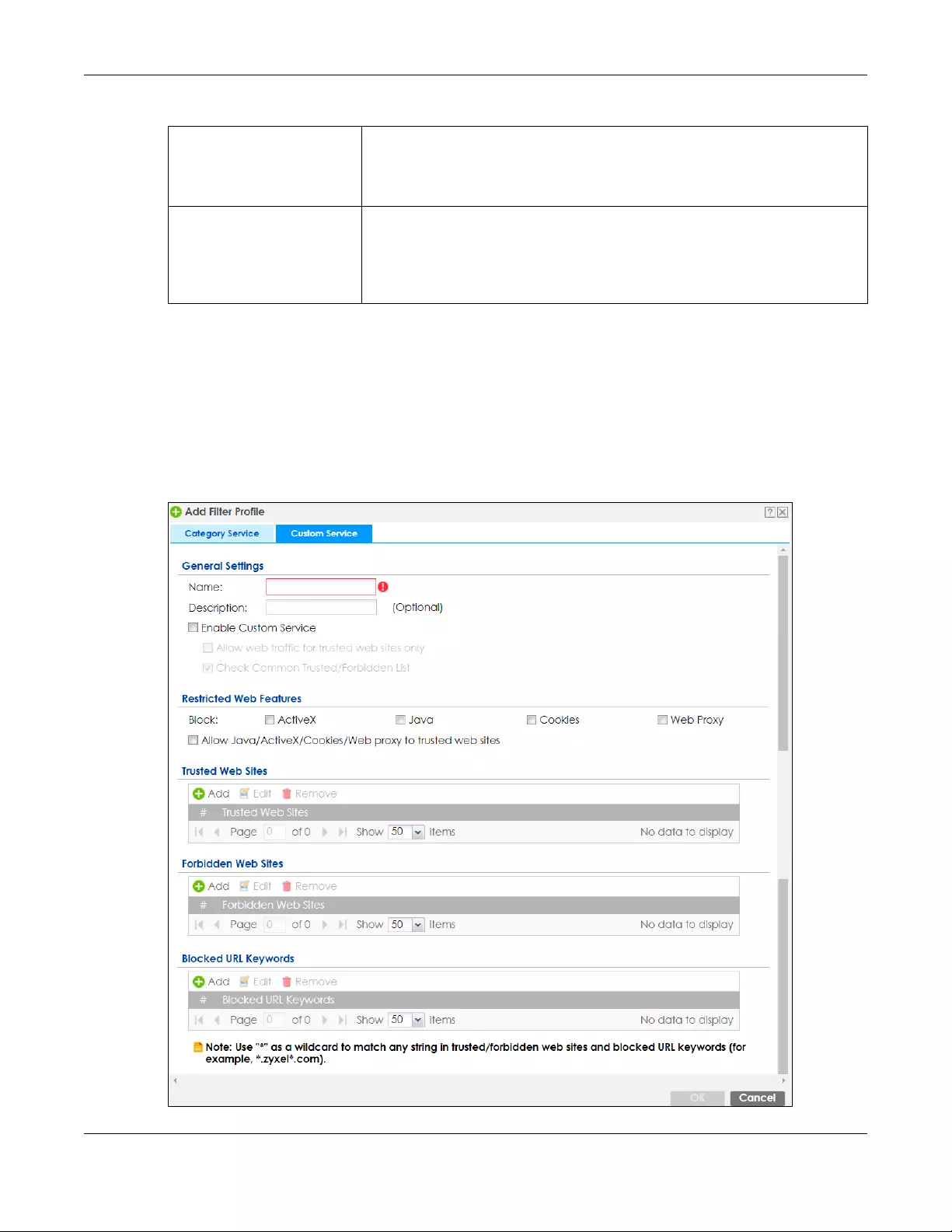
Chapter 32 Content Filter
ZyWALL USG FLEX Series User’s Guide
614
32.2.3 Content Filter Add Filter Profile Custom Service
Click Configuration > Security Service > Content Filter > Filter Profile > Add or Edit > Custom Service to
open the Custom Service screen. You can create a list of good (allowed) web site addresses and a list
of bad (blocked) web site addresses. You can also block web sites based on whether the web site’s
address contains a keyword. Use this screen to add or remove specific sites or keywords from the filter
list.
Figure 404 Configuration > Security Service > Content Filter > Filter Profile > Custom Service
Web Meetings Web pages that host live meetings, video conferences, and interactive
presentations mainly for businesses.
Web meetings generally include streaming audio and video, and allow data
transfer or office-oriented application sharing, such as online presentations.
Web Phone Web pages that enable users to make telephone calls via the Internet or obtain
information or software for this purpose.
Web Phone service is also called Internet Telephony, or VoIP. Web phone service
includes PC-to-PC, PC-to-phone, and phone-to-phone services connecting via
TCP/IP networks.
Table 247 Managed Category Descriptions (continued)

Chapter 32 Content Filter
ZyWALL USG FLEX Series User’s Guide
615
The following table describes the labels in this screen.
Table 248 Configuration > Security Service > Content Filter > Profile > Custom Service
LABEL DESCRIPTION
Name Enter a descriptive name for this content filtering profile name. You may use 1-31
alphanumeric characters, underscores(_), or dashes (-), but the first character
cannot be a number. This value is case-sensitive.
Description Enter a description for the content filtering profile rule to help identify the
purpose of rule. You may use 1-31 alphanumeric characters, underscores(_), or
dashes (-), but the first character cannot be a number. This value is case-
sensitive.
This field is optional.
Enable Custom Service Select this check box to allow trusted web sites and block forbidden web sites.
Content filter list customization may be enabled and disabled without re-
entering these site names.
Allow Web traffic for trusted web
sites only
When this box is selected, the Zyxel Device blocks Web access to sites that are
not on the Trusted Web Sites list. If they are chosen carefully, this is the most
effective way to block objectionable material.
Check Common Trusted/
Forbidden List
Select this check box to check the common trusted and forbidden web sites
lists. See Section 32.3 on page 616 and Section 32.4 on page 617 for information
on configuring these lists.
Restricted Web Features Select the check box(es) to restrict a feature. Select the check box(es) to
restrict a feature.
• When you download a page containing ActiveX or Java, that part of the
web page will be blocked with an X.
• When you download a page coming from a Web Proxy, the whole web
page will be blocked.
• When you download a page containing cookies, the cookies will be
removed, but the page will not be blocked.
Block
ActiveX
ActiveX is a tool for building dynamic and active web pages and distributed
object applications. When you visit an ActiveX web site, ActiveX controls are
downloaded to your browser, where they remain in case you visit the site again.
Java Java is a programming language and development environment for building
downloadable Web components or Internet and intranet business applications
of all kinds.
Cookies Cookies are files stored on a computer’s hard drive. Some web servers use them
to track usage and provide service based on ID.
Web Proxy A server that acts as an intermediary between a user and the Internet to
provide security, administrative control, and caching service. When a proxy
server is located on the WAN it is possible for LAN users to circumvent content
filtering by pointing to this proxy server.
Allow Java/ActiveX/Cookies/
Web proxy to trusted web sites
When this box is selected, the Zyxel Device will permit Java, ActiveX and
Cookies from sites on the Trusted Web Sites list to the LAN. In certain cases, it
may be desirable to allow Java, ActiveX or Cookies from sites that are known
and trusted.
Trusted Web Sites These are sites that you want to allow access to, regardless of their content
rating, can be allowed by adding them to this list.
Add Click this to create a new entry.
Edit Select an entry and click this to be able to modify it.
Remove Select an entry and click this to delete it.
#This displays the index number of the trusted web sites.

Chapter 32 Content Filter
ZyWALL USG FLEX Series User’s Guide
616
32.3 Content Filter Trusted Web Sites Screen
Click Configuration > Security Service > Content Filter > Trusted Web Sites to open the Trusted Web Sites
screen. You can create a common list of good (allowed) web site addresses. When you configure Filter
Trusted Web Site This column displays the trusted web sites already added.
Enter host names such as www.good-site.com into this text field. Do not enter
the complete URL of the site – that is, do not include “http://”. All subdomains
are allowed. For example, entering “*zyxel.com” also allows “www.zyxel.com”,
“partner.zyxel.com”, “press.zyxel.com”, and so on. You can also enter just a top
level domain. For example, enter “*.com” to allow all .com domains.
Use up to 127 characters (0-9a-z-). The casing does not matter. “*” can be used
as a wildcard to match any string. The entry must contain at least one “.” or it
will be invalid.
Add Click this to create a new entry.
Edit Select an entry and click this to be able to modify it.
Remove Select an entry and click this to delete it.
#This displays the index number of the forbidden web sites.
Forbidden Web Sites This list displays the forbidden web sites already added.
Enter host names such as www.bad-site.com into this text field. Do not enter the
complete URL of the site – that is, do not include “http://”. All subdomains are
also blocked. For example, entering “*bad-site.com” also blocks “www.bad-
site.com”, “partner.bad-site.com”, “press.bad-site.com”, and do on. You can
also enter just a top level domain. For example, enter “*.com” to block all .com
domains.
Use up to 127 characters (0-9a-z-). The casing does not matter. “*” can be used
as a wildcard to match any string. The entry must contain at least one “.” or it
will be invalid.
Blocked URL Keywords This section allows you to block Web sites with URLs that contain certain
keywords in the domain name or IP address.
Add Click this to create a new entry.
Edit Select an entry and click this to be able to modify it.
Remove Select an entry and click this to delete it.
#This displays the index number of the blocked URL keywords.
Blocked URL Keywords This list displays the keywords already added.
Enter a keyword or a numerical IP address to block. You can also enter a
numerical IP address.
Use up to 127 case-insensitive characters (0-9a-zA-Z;/?:@&=+$\.-_!~*()%). “*”
can be used as a wildcard to match any string. Use “|*” to indicate a single
wildcard character.
For example enter *Bad_Site* to block access to any web page that includes
the exact phrase Bad_Site. This does not block access to web pages that only
include part of the phrase (such as Bad for example).
OK Click OK to save your changes back to the Zyxel Device.
Cancel Click Cancel to exit this screen without saving your changes.
Table 248 Configuration > Security Service > Content Filter > Profile > Custom Service (continued)
LABEL DESCRIPTION
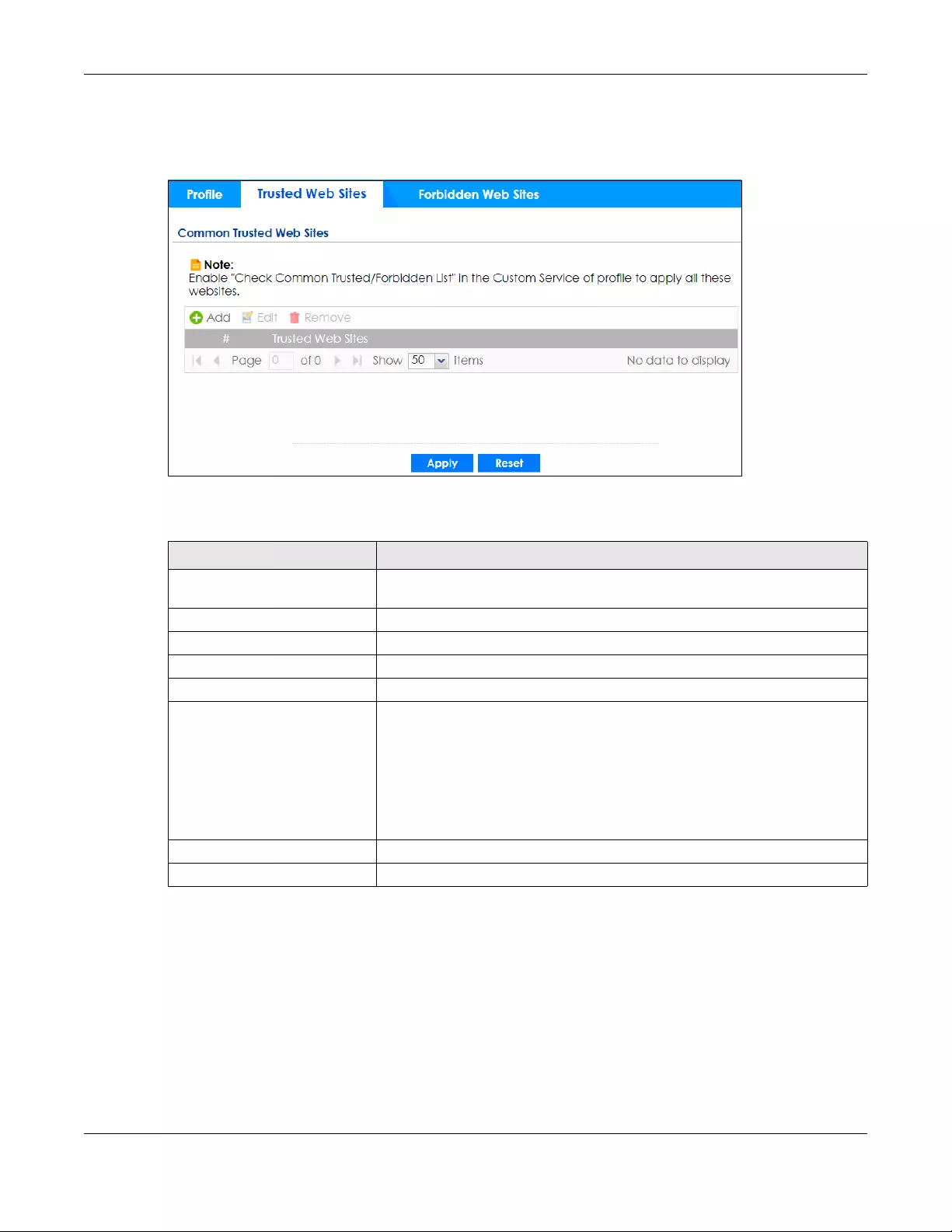
Chapter 32 Content Filter
ZyWALL USG FLEX Series User’s Guide
617
Profiles, you can select the option to check the Common Trusted Web Sites list. Use this screen to add or
remove specific sites from the filter list.
Figure 405 Configuration > Security Service > Content Filter > Trusted Web Sites
The following table describes the labels in this screen.
32.4 Content Filter Forbidden Web Sites Screen
Click Configuration > Security Service > Content Filter > Forbidden Web Sites to open the Forbi dden Web
Sites screen. You can create a common list of bad (blocked) web site addresses. When you configure
Filter Profiles, you can select the option to check the Common Forbidden Web Sites list. Use this screen to
add or remove specific sites from the filter list.
Table 249 Configuration > Security Service > Content Filter > Trusted Web Sites
LABEL DESCRIPTION
Common Trusted Web Sites These are sites that you want to allow access to, regardless of their content
rating, can be allowed by adding them to this list.
Add Click this to create a new entry.
Edit Select an entry and click this to be able to modify it.
Remove Select an entry and click this to delete it.
#This displays the index number of the trusted web sites.
Trusted Web Site This column displays the trusted web sites already added.
Enter host names such as www.good-site.com into this text field. Do not enter
the complete URL of the site – that is, do not include “http://”. All subdomains
are allowed. For example, entering “zyxel.com” also allows “www.zyxel.com”,
“partner.zyxel.com”, “press.zyxel.com”, and so on. You can also enter just a top
level domain. For example, enter .com to allow all .com domains.
Use up to 127 characters (0-9a-z-). The casing does not matter.
Apply Click Apply to save your changes back to the Zyxel Device.
Reset Click Reset to return the screen to its last-saved settings.

Chapter 32 Content Filter
ZyWALL USG FLEX Series User’s Guide
618
Figure 406 Configuration > Security Service > Content Filter > Forbidden Web Sites
The following table describes the labels in this screen.
32.5 Content Filter Technical Reference
This section provides content filtering background information.
External Content Filter Server Lookup Procedure
The content filter lookup process is described below.
Table 250 Configuration > Security Service > Content Filter > Forbidden Web Sites
LABEL DESCRIPTION
Forbidden Web Site List Sites that you want to block access to, regardless of their content rating, can be
allowed by adding them to this list.
Add Click this to create a new entry.
Edit Select an entry and click this to be able to modify it.
Remove Select an entry and click this to delete it.
#This displays the index number of the forbidden web sites.
Forbidden Web Sites This list displays the forbidden web sites already added.
Enter host names such as www.bad-site.com into this text field. Do not enter the
complete URL of the site – that is, do not include “http://”. All subdomains are
also blocked. For example, entering “bad-site.com” also blocks “www.bad-
site.com”, “partner.bad-site.com”, “press.bad-site.com”, and do on. You can
also enter just a top level domain. For example, enter .com to block all .com
domains.
Use up to 127 characters (0-9a-z-). The casing does not matter.
Apply Click Apply to save your changes back to the Zyxel Device.
Cancel Click Reset to return the screen to its last-saved settings.

Chapter 32 Content Filter
ZyWALL USG FLEX Series User’s Guide
619
Figure 407 Content Filter Lookup Procedure
1A computer behind the Zyxel Device tries to access a web site.
2The Zyxel Device looks up the web site in its cache. If an attempt to access the web site was made in the
past, a record of that web site’s category will be in the Zyxel Device’s cache. The Zyxel Device blocks,
blocks and logs or just logs the request based on your configuration.
3Use the Content Filter Cache screen to configure how long a web site address remains in the cache as
well as view those web site addresses. All of the web site address records are also cleared from the local
cache when the Zyxel Device restarts.
4If the Zyxel Device has no record of the web site, it queries the external content filter database and
simultaneously sends the request to the web server.
5The external content filter server sends the category information back to the Zyxel Device, which then
blocks and/or logs access to the web site based on the settings in the content filter profile. The web
site’s address and category are then stored in the Zyxel Device’s content filter cache.
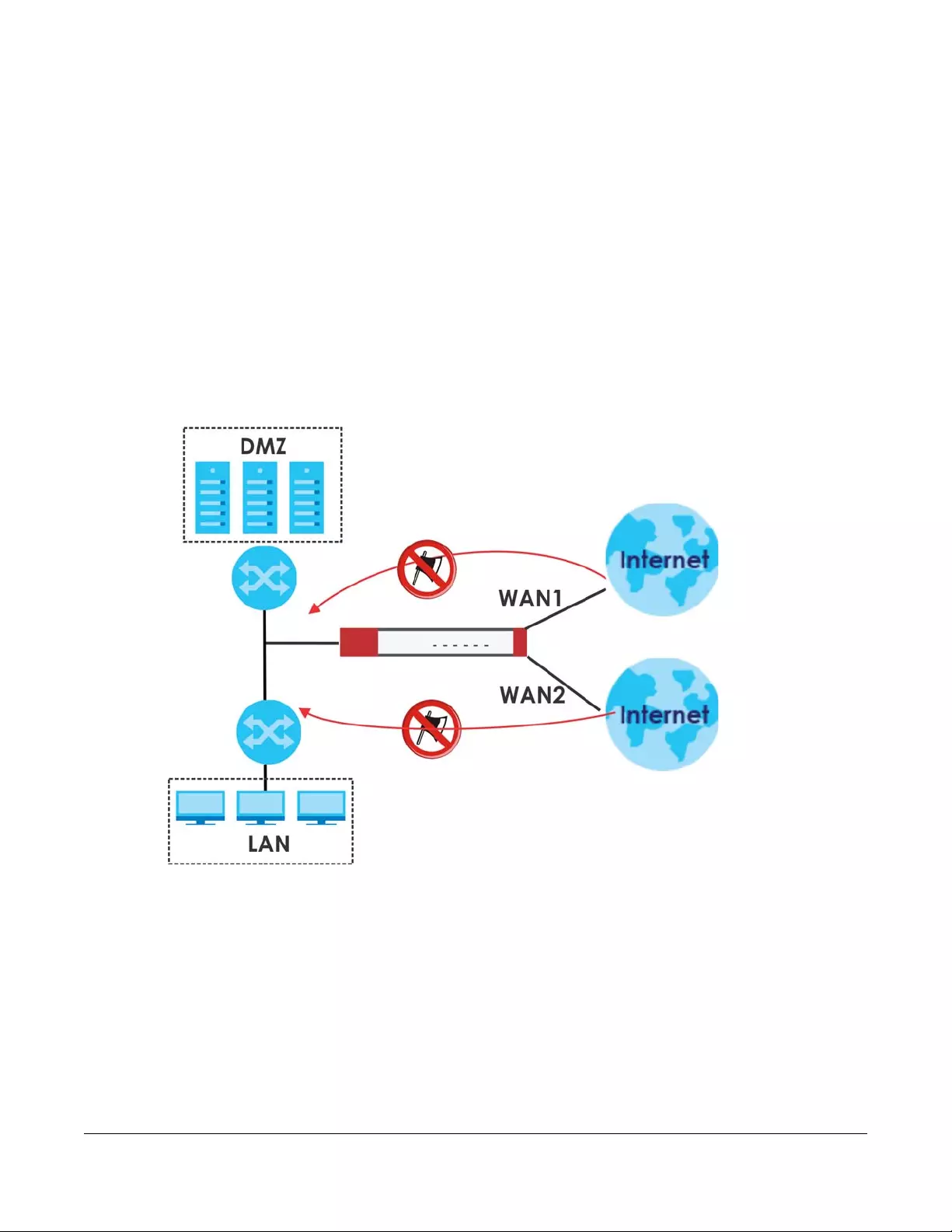
ZyWALL USG FLEX Series User’s Guide
620
CHAPTER 33
Anti-Malware
33.1 Overview
Use the Zyxel Device’s anti-malware feature to protect your connected network from malware
(malicious software) infection, such as computer virus, worms, and spyware. The Zyxel Device scans
traffic going in both directions for malware signature matches. In the following figure, the Zyxel Device
scans traffic coming from the WAN zone (which includes two interfaces) to the LAN zone.
Figure 408 Zyxel Device Anti-Malware Example
The anti-malware matches a file with those in a malware database. This is done as files go through the
Zyxel Device.
Virus, Worm, and Spyware
A computer virus is a type of malicious software designed to corrupt and/or alter the operation of other
legitimate programs. A worm is a self-replicating virus that resides in active memory and duplicates itself.
The effect of a virus attack varies from doing so little damage that you are unaware your computer is
infected to wiping out the entire contents of a hard drive to rendering your computer inoperable.
Spyware infiltrate your device and secretly gathers information about you, such as your network activity,
passwords, bank details, and so on.
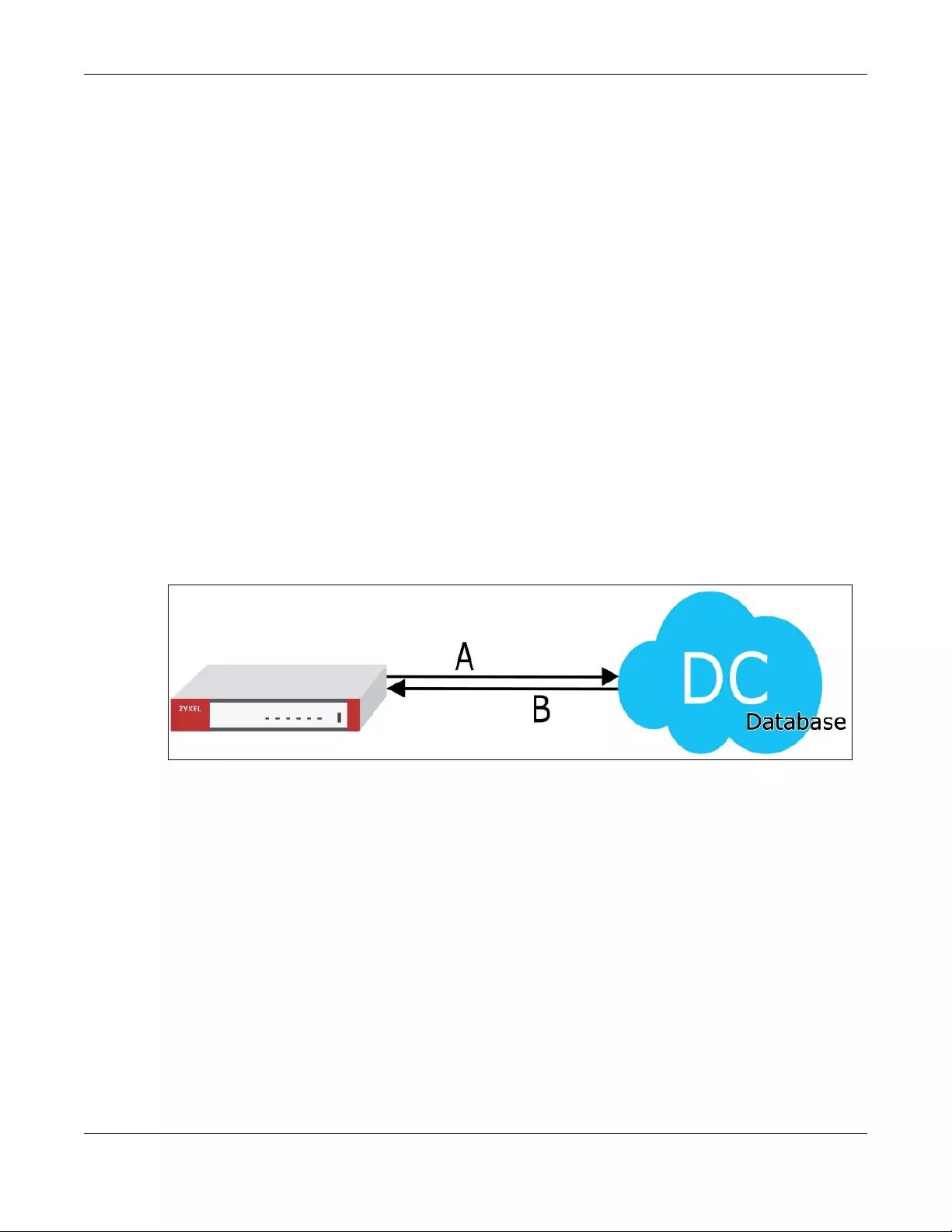
Chapter 33 Anti-Malware
ZyWALL USG FLEX Series User’s Guide
621
Hash Value
A hash function is an algorithm that maps data of arbitrary size to data of fixed size. The value returned
by a hash function is a hash value. Hash values can be used to identify if the contents of a file have
changed. At the time of writing, the MD5 (Message Digest 5) hash algorithm is supported.
Local Signature Databases
The Zyxel Device downloads the signature(s) after it is registered and the anti-malware license is
activated at myZyxel. A signature is a unique string of bits, or binary pattern, of a malware. A signature
acts as a fingerprint that can be used to detect and identify specific malware. The Zyxel Device
downloads the following signatures:
• Anti-malware signature
These signatures are periodically updated if you have a valid license. See Section 33.2 on page 625 for
how the Zyxel Device updates these signatures for the anti-malware license.
Cloud Query
Another method of malware protection is through cloud query. This process is illustrated in the next
figure. With Cloud Query, the Zyxel Device queries the Defend Center database by sending the file’s
hash value (A) and receiving the scan results (B) through the Defend Center (DC).
Figure 409 Cloud Query
Anti-Malware Licensing
Having extensive, up-to-date signatures with the most common malware is critical to making the anti-
malware service work effectively. Section 7.2 on page 199 shows licensing information for the different
signature databases that can be used by the Zyxel Device.
After the anti-malware license expires, you need to purchase an iCard to update your local signature
database and use cloud query. Extend your license in the Registration > Service screen.
Anti-Malware Scan Process
Before going through the Anti-Malware scan, the Zyxel Device first identifies the packets sent by the
following four major protocols with corresponding standard ports:
• FTP (File Transfer Protocol)
• HTTP (Hyper Text Transfer Protocol)
• SMTP (Simple Mail Transfer Protocol)

Chapter 33 Anti-Malware
ZyWALL USG FLEX Series User’s Guide
622
• POP3 (Post Office Protocol version 3)
The Zyxel Device records the order of packets in TCP connection-oriented sessions to check for
matching malware signatures. The order of non-setup packets such as SYN, ACK and FIN is ignored.
Anti-Malware Scanning Procedure:
1The Zyxel Device checks every packet of the file for matches with the local signature databases.
If a malware pattern signature is matched, the actions you specify for identified malware will be
applied. If Destroy infected file is enabled, the file will be modified. Logs/alerts will be sent according to
your settings.
Note: The receiver is not notified if a file is modified by the Zyxel Device. If the file cannot be
used, the receiver should contact the Zyxel Device administrator to confirm if the Zyxel
Device modified the file by checking the logs.
2If no match is found with the local databases, the Zyxel Device uses Cloud Query to forward the file’s
hash value to Defend Center.
3Defend Center checks its database for malware signature matches and sends the results back to the
Zyxel Device.
If a malware signature is matched, the actions you specify for identified malware will be applied. If
Destroy infected file is enabled, the file will be modified. Logs/alerts will be sent according to your
settings.
The next figure shows a flow chart detailing the anti-malware scan.

Chapter 33 Anti-Malware
ZyWALL USG FLEX Series User’s Guide
623
Figure 410 Anti-Malware Flowchart

Chapter 33 Anti-Malware
ZyWALL USG FLEX Series User’s Guide
624
File Scanning Cloud Query Supported File Types
At the time of writing, the following file types are supported:
Notes About the Zyxel Device Anti-Malware
The following lists important notes about the Zyxel Device’s anti-malware feature:
1Zyxel’s anti-malware feature can detect polymorphic malware (see Section 33.5 on page 631).
2When malware is detected, a log is created or an alert message is sent to the administrator depending
on your log settings.
3Changes to the Zyxel Device’s anti-malware settings only affect new sessions, not sessions that already
existed before you applied the changed settings.
4Enabling Cloud Query may affect file transfer speeds.
5The Zyxel Device does not scan the following file/traffic types:
• Simultaneous downloads of a file using multiple connections. For example, when you use FlashGet
to download sections of a file simultaneously.
• Encrypted traffic. This could be password-protected files or VPN traffic where the Zyxel Device is not
the endpoint (pass-through VPN traffic).
• Traffic through custom (non-standard) ports. The Zyxel Device scans whatever port number is
specified for FTP in the ALG screen.
• All compressed files within a compressed file. Note that a single file can still be decompressed and
scanned if you select Enable file decompression (ZIP and RAR).
• Traffic compressed or encoded using a method the Zyxel Device does not support.
Finding Out More
•See Section 33.7 on page 638 for anti-malware background information.
33.1.1 What You Can Do in this Chapter
• Use the Anti-Malware screen (Section 33.2 on page 625) to turn anti-malware on or off, and check
the anti-malware signature status. In addition, you can set up anti-malware black (blocked) and
white (allowed) lists of malware patterns.
Table 251 File Scanning Cloud Query Supported File Types
• 7z Archive (7z) • AVI Video (avi) •BMP Image (bmp) • BZ2 Archive (bz2)
• Executables (exe) • Macromedia Flash
Data (swf)
• GIF Image (gif) •GZ Archive (gz)
•JPG Image (jpg) •MOV Video (mov) • MP3 Audio (mp3) • MPG Video (mpg)
• MS Office
Document (doc...)
• PDF Document
(pdf)
•PNG Image (png) • RAR Archive (rar)
•RM Video (rm) •RTF Document (rtf) •TIFF Image (tif) •WAV Audio (wav)
• ZIP Archive (zip)

Chapter 33 Anti-Malware
ZyWALL USG FLEX Series User’s Guide
625
• Use the White List screen (Section 33.3 on page 628) to specify the file or encryption pattern to allow in
order to avoid false positives. False positives occur when a non-infected file matches a malware
signature.
• Use the Black List screen (Section 33.4 on page 630) to specify the file or encryption pattern that you
want to block.
• Use the Signature screen (Section 33.5 on page 631) to search for particular signatures and get more
information about them.
33.2 Anti-Malware Screen
Click Config uration > Security S ervice > Anti-Malware to display the configuration screen as shown next.
Click the Anti-Malware icon for more information on the Zyxel Device’s security features.
See Subscription Services Available on page 196 for more information on the
subscription services for the two types of security packs.
Note: If Destroy infected file is disabled and log is set to no, the Zyxel Device will still perform
the scan but will not do anything else. It is recommended to enable at least one of the
two functions.
If Destroy infected file is disabled, any malicious file found can still be
executed by the end user after it is forwarded. The administrator would
have to inform the user if there is an infected file.

Chapter 33 Anti-Malware
ZyWALL USG FLEX Series User’s Guide
626
Figure 411 Configuration > Security Service > Anti-Malware
The following table describes the labels in this screen.
Table 252 Configuration > Security Service > Anti-Malware
LABEL DESCRIPTION
General Setting
Enable Select this checkbox to activate the anti-malware feature to protect your connected
network from infection and the installation of malicious software.

Chapter 33 Anti-Malware
ZyWALL USG FLEX Series User’s Guide
627
Scan and detect
EICAR test virus
Select this option to have the Zyxel Device check for an EICAR test file and treat it in the
same way as a real malware file.
The EICAR test file is a standardized test file for signature based anti-malware scanners.
When the scanner detects the EICAR file, it responds in the same way as if it found real
malware. The EICAR file can also be compressed to test whether the anti-malware software
can detect it in a compressed file. The EICAR test string consists of the following human-
readable ASCII characters.
X5O!P%@AP[4\PZX54(P^)7CC)7}$EICAR-STANDARD-ANTIVIRUS-TEST-FILE!$H+H*
Scan Mode
Express Mode In this mode you can define which types of files are scanned using the File Type For Scan
fields. The Zyxel Device then scans files by sending each file’s hash value to a cloud
database using cloud query. This is the fastest scan mode.
Stream Mode In this mode the Zyxel Device scans all files for viruses using its anti-malware signatures to
detect known virus pattens. This is the deepest scan mode.
File Type For Scan
Available File Types File types that can be checked by the Zyxel Device are listed here. Note that the files on this
list are currently bypassed. To use this feature on a specific file type, click this file type and
then click the right arrow button.
See available file types in Table 251 on page 624.
Applied File Types File types that will be checked are listed here. If you don’t want a file type to be checked,
click this file type and then click the left arrow button.
Destroy infected file When you select this check box, if a malware signature is matched, the Zyxel Device
overwrites the infected portion of the file with zeros before being forwarded to the user. The
uninfected portion of the file will pass through unmodified.
Log These are the log options:
•no: Do not create a log when a packet matches a signature.
•log: Create a log on the Zyxel Device when a packet matches a signature.
•log alert: An alert is an emailed log for more serious events that may need more
immediate attention. Select this option to have the Zyxel Device send an alert when a
packet matches a signature(s).
Check White List Select this check box to have the Zyxel Device not perform the anti-malware check on files
with names that match the white list patterns.
Add Click this to create a new entry.
Edit Select an entry and click this to be able to modify it.
Remove Select an entry and click this to delete it.
Activate To turn on an entry, select it and click Activate.
Inactivate To turn off an entry, select it and click Inactivate.
Status The activate (light bulb) icon is lit when the entry is active and dimmed when the entry is
inactive.
#This is the entry’s index number in the list.
File Pattern This is the file name pattern. If a file’s name matches this pattern, the Zyxel Device does not
check the file for malware.
Check Black List Select this check box to log and delete files with names that match the black list patterns.
Add Click this to create a new entry.
Edit Select an entry and click this to be able to modify it.
Remove Select an entry and click this to delete it.
Activate To turn on an entry, select it and click Activate.
Table 252 Configuration > Security Service > Anti-Malware (continued)
LABEL DESCRIPTION

Chapter 33 Anti-Malware
ZyWALL USG FLEX Series User’s Guide
628
33.3 The White List Screen
A white list allows you to specify the file or encryption pattern to allow in order to avoid false positives.
False positives occur when a non-infected file matches a malware signature.
Enter a file or encryption pattern that would cause the Zyxel Device to allow this file.
Click Configuration > Security Service > Anti-Malware > Black/White List > White List to display the
following screen. Use Add to put a new entry in the list or Edit to change an existing one or Remove to
delete an existing entry.
Inactivate To turn off an entry, select it and click Inactivate.
Status The activate (light bulb) icon is lit when the entry is active and dimmed when the entry is
inactive.
#This is the entry’s index number in the list.
File Pattern This is the file name pattern. If a file’s name that matches this pattern, the Zyxel Device logs
and then destroys the file.
File decompression
Enable file
decompression (ZIP
and RAR)
Select this check box to have the Zyxel Device scan a compressed file (the file does not
need to have a “zip” or “rar” file extension). The Zyxel Device first decompresses the file and
then scans the contents for malware.
Note: The Zyxel Device decompresses a compressed file once. The Zyxel Device
does NOT decompress any file(s) within a compressed file.
Destroy
compressed files
that could not
be
decompressed
When you select this check box, the Zyxel Device deletes compressed files that use
password encryption.
Select this check box to have the Zyxel Device delete any compressed files that it cannot
decompress. The Zyxel Device cannot decompress password protected files or a file within
another compressed file. There are also limits to the number of compressed files that the
Zyxel Device can concurrently decompress.
Note: The Zyxel Device’s firmware package cannot go through the Zyxel Device
with this check box enabled. The Zyxel Device classifies the firmware
package as a file that cannot be decompressed and then deletes it. Clear
this check box when you download a firmware package from the Zyxel
website. It’s OK to upload a firmware package to the Zyxel Device with the
check box selected.
Signature
Information
The following fields display information on the current signature set that the Zyxel Device is
using.
Current Version This field displays the signature set version number currently used by the Zyxel Device. This
number gets larger as the set is enhanced.
Released Date This field displays the date and time the set was released.
Update Signatures Click this link to go to the screen you can use to download signatures from the update
server.
Apply Click Apply to save your changes.
Reset Click Reset to return the screen to its last-saved settings.
Table 252 Configuration > Security Service > Anti-Malware (continued)
LABEL DESCRIPTION
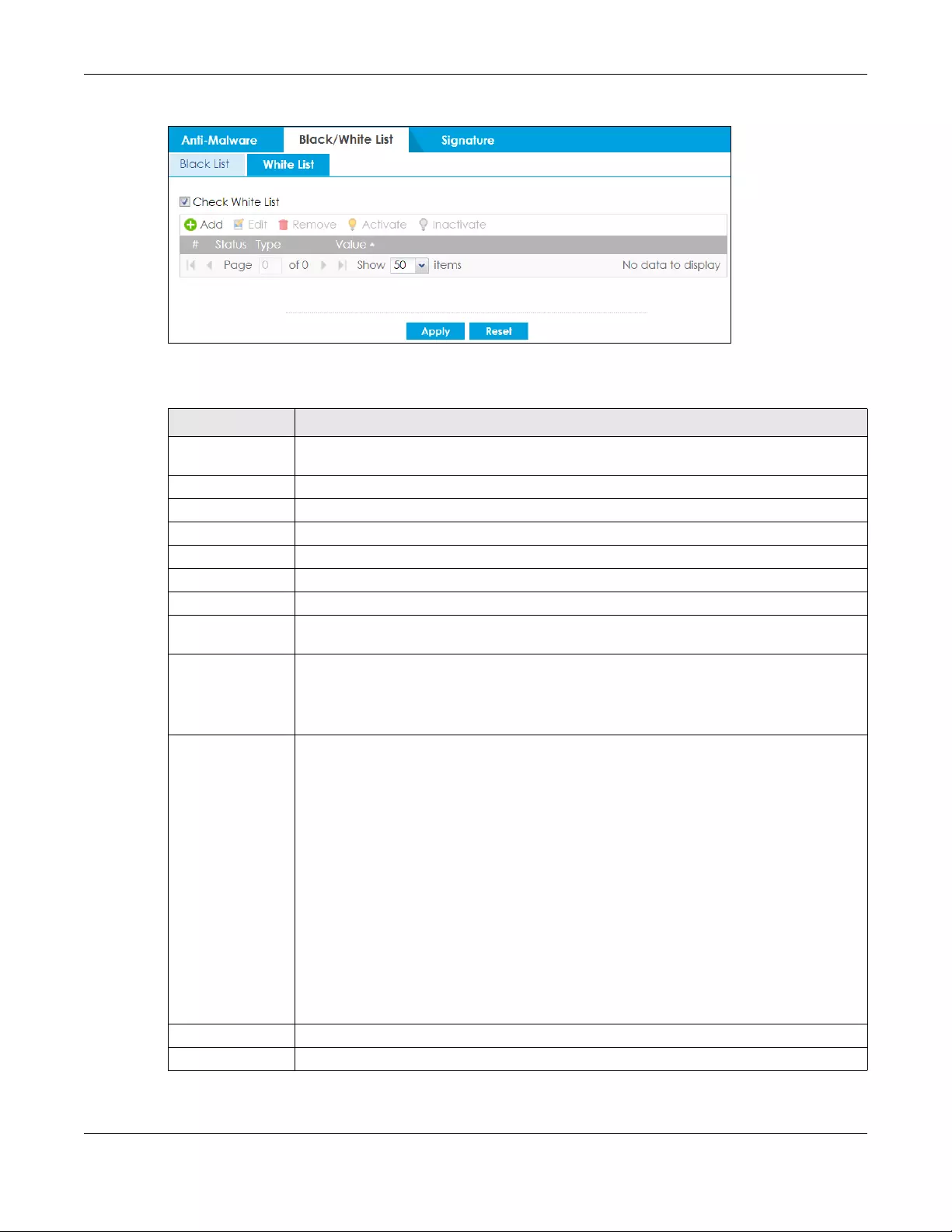
Chapter 33 Anti-Malware
ZyWALL USG FLEX Series User’s Guide
629
Figure 412 Configuration > Security Service > Anti-Malware > Black/White List > White List
The following table describes the fields in this screen.
Table 253 Configuration > Security Service > Anti-Malware > Black/White List > White List
LABEL DESCRIPTION
Check White List Select this check box to have the Zyxel Device not perform the anti-malware check on files
with names or algorithm (MD5 Hash) that match the white list patterns.
Add Click this to create a new entry.
Edit Select an entry and click this to be able to modify it.
Remove Select an entry and click this to delete it.
Activate To turn on an entry, select it and click Activate.
Inactivate To turn off an entry, select it and click Inactivate.
#This is the entry’s index number in the list.
Status The activate (light bulb) icon is lit when the entry is active and dimmed when the entry is
inactive.
Type This field displays the type (MD5 Hash or File Pattern) used to distinguish whether a file should
be allowed.
Select the type (MD5 Hash or File Pattern) that you want to use to distinguish whether a file
should be allowed.
Value This field displays the file or encryption pattern of the entry.
Enter the file or encryption pattern for this entry. Specify a pattern to identify the names of files
that the Zyxel Device should not scan for viruses.
• Use up to 80 characters. Alphanumeric characters, underscores (_), dashes (-), question
marks (?) and asterisks (*) are allowed.
• A question mark (?) lets a single character in the file name vary. For example, use “a?.zip”
(without the quotation marks) to specify aa.zip, ab.zip and so on.
• Wildcards (*) let multiple files match the pattern. For example, use “*a.zip” (without the
quotation marks) to specify any file that ends with “a.zip”. A file named “testa.zip would
match. There could be any number (of any type) of characters in front of the “a.zip” at
the end and the file name would still match. A file named “test.zipa” for example would
not match.
• A * in the middle of a pattern has the Zyxel Device check the beginning and end of the
file name and ignore the middle. For example, with “abc*.zip”, any file starting with “abc”
and ending in “.zip” matches, no matter how many characters are in between.
• The whole file name has to match if you do not use a question mark or asterisk.
• If you do not use a wildcard, the Zyxel Device checks up to the first 80 characters of a file
name.
Apply Click Apply to save your changes back to the Zyxel Device.
Reset Click Reset to return the screen to its last-saved settings.
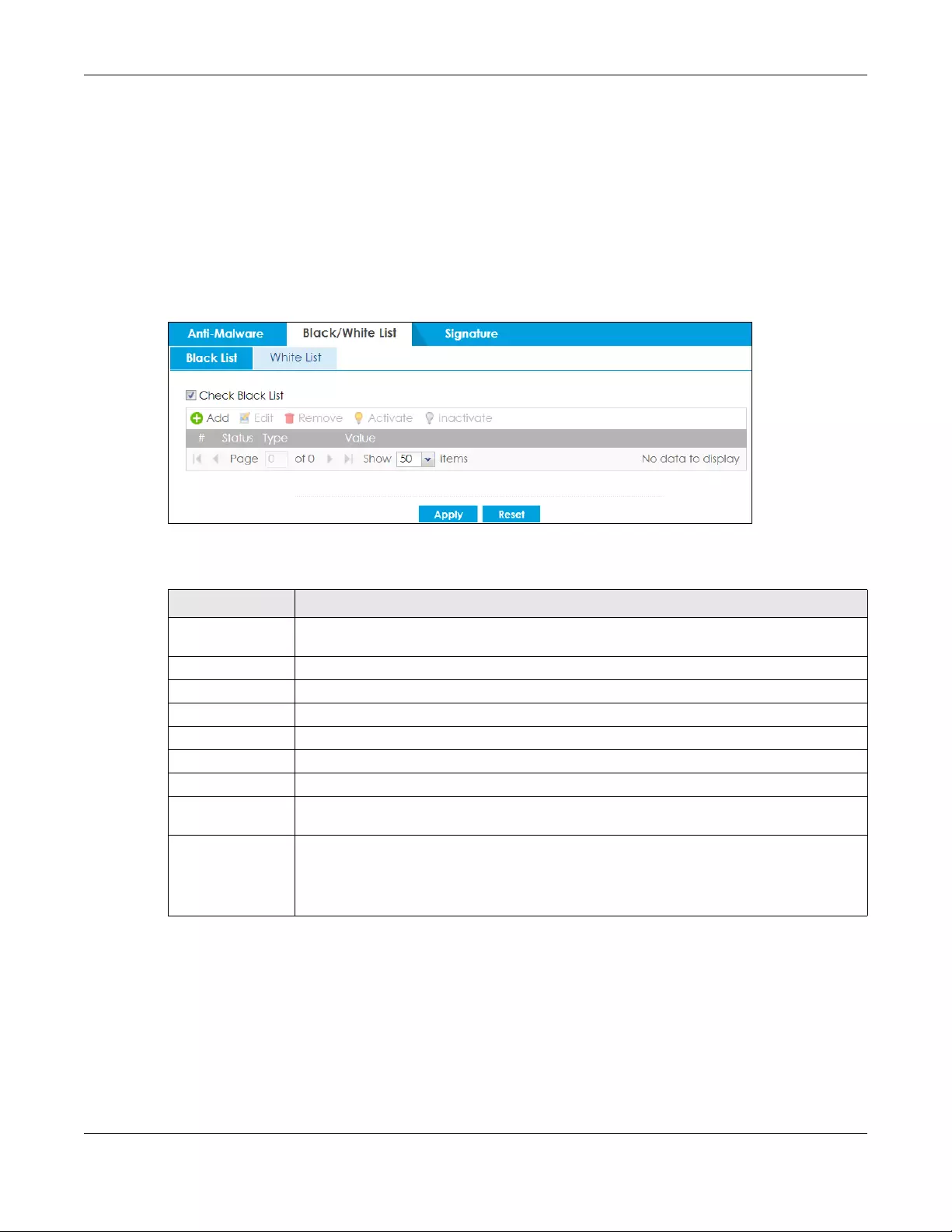
Chapter 33 Anti-Malware
ZyWALL USG FLEX Series User’s Guide
630
33.4 The Black List Screen
A black list allows you to specify the file or encryption pattern that you want to block.
Enter a file or encryption pattern that would cause the Zyxel Device to log and then destroy this file.
Click Configuration > Security Service > Anti-Malware > Black/White List > Black List to display the
following screen. Use Add to put a new entry in the list or Edit to change an existing one or Remove to
delete an existing entry.
Figure 413 Configuration > Security Service > Anti-Malware > Black/White List > Black List
The following table describes the fields in this screen.
Table 254 Configuration > Security Service > Anti-Malware > Black/White List > Black List
LABEL DESCRIPTION
Check Black List Select this check box to log and delete files with names or encryption algorithm (MD5 Hash)
that match the black list patterns.
Add Click this to create a new entry.
Edit Select an entry and click this to be able to modify it.
Remove Select an entry and click this to delete it.
Activate To turn on an entry, select it and click Activate.
Inactivate To turn off an entry, select it and click Inactivate.
#This is the entry’s index number in the list.
Status The activate (light bulb) icon is lit when the entry is active and dimmed when the entry is
inactive.
Type This field displays the type (MD5 Hash or File Pattern) used to distinguish whether a file should
be blocked.
Select the type (MD5 Hash or File Pattern) that you want to use to distinguish whether a file
should be blocked.

Chapter 33 Anti-Malware
ZyWALL USG FLEX Series User’s Guide
631
33.5 Anti-Malware Signature Searching
Click Configuration > Security Service > Anti-Malware > Signature to display this screen. Use this screen
to locate signatures and display details about them.
If your web browser opens a warning screen about a script making the web browser run slowly and the
computer unresponsive, just click No to continue.
Click a column’s heading cell to sort the table entries by that column’s criteria. Click the heading cell
again to reverse the sort order.
Figure 414 Configuration > Security Service > Anti-Malware > Signature
The following table describes the labels in this screen.
Value This field displays the file or encryption pattern of the entry. Enter a file pattern that would
cause the Zyxel Device to log and modify this file.
• Use up to 80 characters. Alphanumeric characters, underscores (_), dashes (-), question
marks (?) and asterisks (*) are allowed.
• A question mark (?) lets a single character in the file name vary. For example, use “a?.zip”
(without the quotation marks) to specify aa.zip, ab.zip and so on.
• Wildcards (*) let multiple files match the pattern. For example, use “*a.zip” (without the
quotation marks) to specify any file that ends with “a.zip”. A file named “testa.zip would
match. There could be any number (of any type) of characters in front of the “a.zip” at
the end and the file name would still match. A file named “test.zipa” for example would
not match.
• A * in the middle of a pattern has the Zyxel Device check the beginning and end of the
file name and ignore the middle. For example, with “abc*.zip”, any file starting with “abc”
and ending in “.zip” matches, no matter how many characters are in between.
• The whole file name has to match if you do not use a question mark or asterisk.
• If you do not use a wildcard, the Zyxel Device checks up to the first 80 characters of a file
name.
Apply Click Apply to save your changes back to the Zyxel Device.
Reset Click Reset to return the screen to its last-saved settings.
Table 254 Configuration > Security Service > Anti-Malware > Black/White List > Black List
LABEL DESCRIPTION
Table 255 Configuration > Security Service > Anti-Malware > Signature
LABEL DESCRIPTION
Signatures Search Enter the name, part of the name or keyword of the signature(s) you want to find and click
Search. This search is not case-sensitive and accepts numerical strings.
Query Result
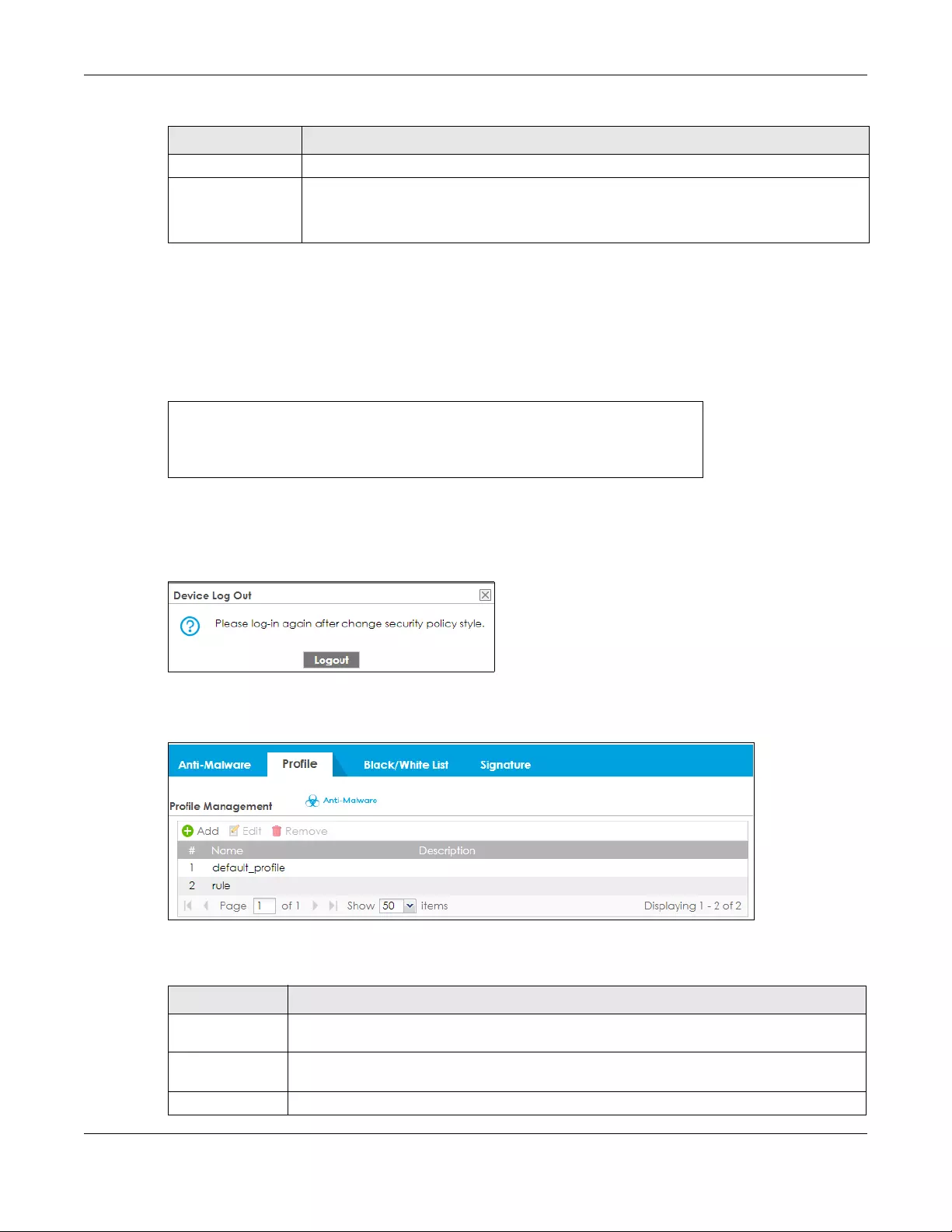
Chapter 33 Anti-Malware
ZyWALL USG FLEX Series User’s Guide
632
33.6 Anti-Malware Profile
To use multiple profiles for this feature, run the following commands in the Zyxel Device Command Line
Interface (CLI).
After you run these command, go to the feature screen again in the web configurator. You will be
prompted to log out and then log in again.
Figure 415 Logout Prompt
After you log in again, you will see the new profile screen for this feature.
Figure 416 Configuration > Security Service > Anti-Malware > Profile
The following table describes the labels in this screen.
#This is the entry’s index number in the list.
Name This is the name of the anti-malware signature. Click the Name column heading to sort your
search results in ascending or descending order according to the signature name.
Click a signature’s name to see details about the malware.
Table 255 Configuration > Security Service > Anti-Malware > Signature (continued)
LABEL DESCRIPTION
Router# configure terminal
Router(config)# secure-policy-style advance
Router(config)# show secure-policy-style status
secure-policy-style: advance
Table 256 Configuration > Security Service > Anti-Malware > Profile
LABEL DESCRIPTION
Add Click this to create a new entry. Select an entry and click Add to create a new entry after the
selected entry.
Edit Double-click an entry or select it and click Edit to open a screen where you can modify the
entry’s settings.
Remove Select an entry and click Remove to delete the selected entry.
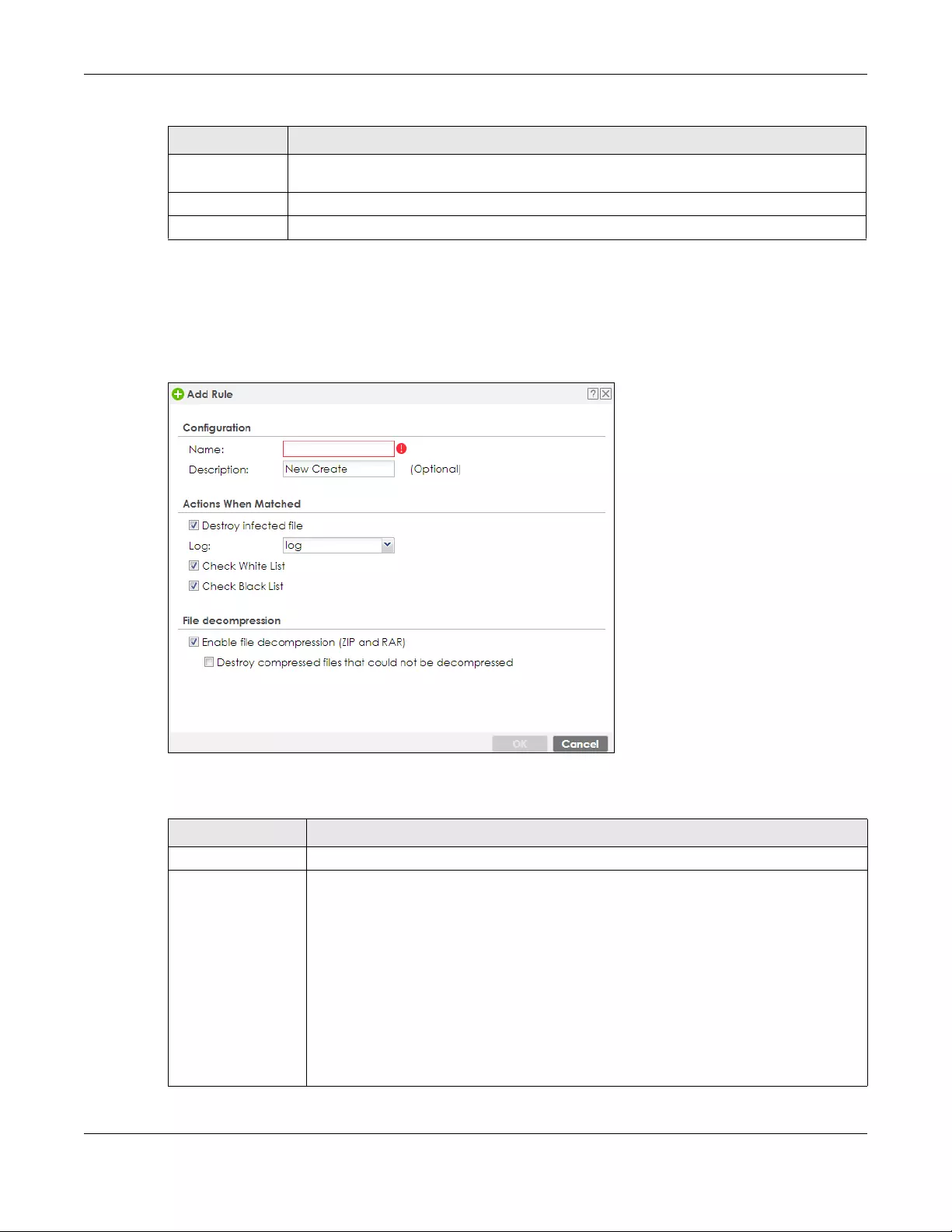
Chapter 33 Anti-Malware
ZyWALL USG FLEX Series User’s Guide
633
33.6.1 Add or Edit an Anti-Malware Profile
Click Add to create a new entry or select an existing entry and click Edit to open the following screen
where you can create or modify the entry’s settings.
Figure 417 Configuration > Security Service > Anti-Malware > Profile > Add/Edit
The following table describes the labels in this screen.
#This field is a sequential value showing the number of the profile. The profile order is not
important.
Name This displays the name of the profile created.
Description This displays the description of the profile.
Table 256 Configuration > Security Service > Anti-Malware > Profile
LABEL DESCRIPTION
Table 257 Configuration > Security Service > Anti-Malware > Profile > Add/Edit
LABEL DESCRIPTION
General Setting
Name Type the name of the profile. You may use 1-31 alphanumeric characters, underscores(_),
or dashes (-), but the first character cannot be a number. This value is case-sensitive. These
are valid, unique profile names:
•MyProfile
•mYProfile
• Mymy12_3-4
These are invalid profile names:
• 1mYProfile
•My Profile
•MyProfile?
• Whatalongprofilename123456789012

Chapter 33 Anti-Malware
ZyWALL USG FLEX Series User’s Guide
634
33.6.2 Link a Profile
To link a profile to a policy, go to the Configuration > Security Policy > Policy Control screen, select a pol-
icy, and then click Edit. In the Edit Policy screen under Profile, select which profile you want to use for
each security service.
Description Type a description for the profile rule to help identify the purpose of rule. You may use 1-31
alphanumeric characters, underscores (_), or dashes (-), but the first character cannot be
a number. This value is case-sensitive. This field is optional.
Actions When
Matched
Destroy infected file When you select this check box, if a malware signature is matched, the Zyxel Device
overwrites the infected portion of the file with zeros before being forwarded to the user. The
uninfected portion of the file will pass through unmodified.
Log These are the log options:
•no: Do not create a log when a packet matches a signature.
•log: Create a log on the Zyxel Device when a packet matches a signature.
•log alert: An alert is an emailed log for more serious events that may need more
immediate attention. Select this option to have the Zyxel Device send an alert when a
packet matches a signature(s).
Scan Options
Check White List Select this check box to have the Zyxel Device not perform the anti-malware check on files
with names that match the white list patterns.
Check Black List Select this check box to log and delete files with names that match the black list patterns.
File decompression
Enable file
decompression (ZIP
and RAR)
Select this check box to have the Zyxel Device scan a compressed file (the file does not
need to have a “zip” or “rar” file extension). The Zyxel Device first decompresses the file and
then scans the contents for malware.
Note: The Zyxel Device decompresses a compressed file once. The Zyxel Device
does NOT decompress any file(s) within a compressed file.
Destroy
compressed files
that could not
be
decompressed
When you select this check box, the Zyxel Device deletes compressed files that use
password encryption.
Select this check box to have the Zyxel Device delete any compressed files that it cannot
decompress. The Zyxel Device cannot decompress password protected files or a file within
another compressed file. There are also limits to the number of compressed files that the
Zyxel Device can concurrently decompress.
Note: The Zyxel Device’s firmware package cannot go through the Zyxel Device
with this check box enabled. The Zyxel Device classifies the firmware
package as a file that cannot be decompressed and then deletes it. Clear
this check box when you download a firmware package from the Zyxel
website. It’s OK to upload a firmware package to the Zyxel Device with the
check box selected.
OK Click OK to save your changes back to the Zyxel Device.
Cancel Click Cancel to exit this screen without saving.
Table 257 Configuration > Security Service > Anti-Malware > Profile > Add/Edit (continued)
LABEL DESCRIPTION
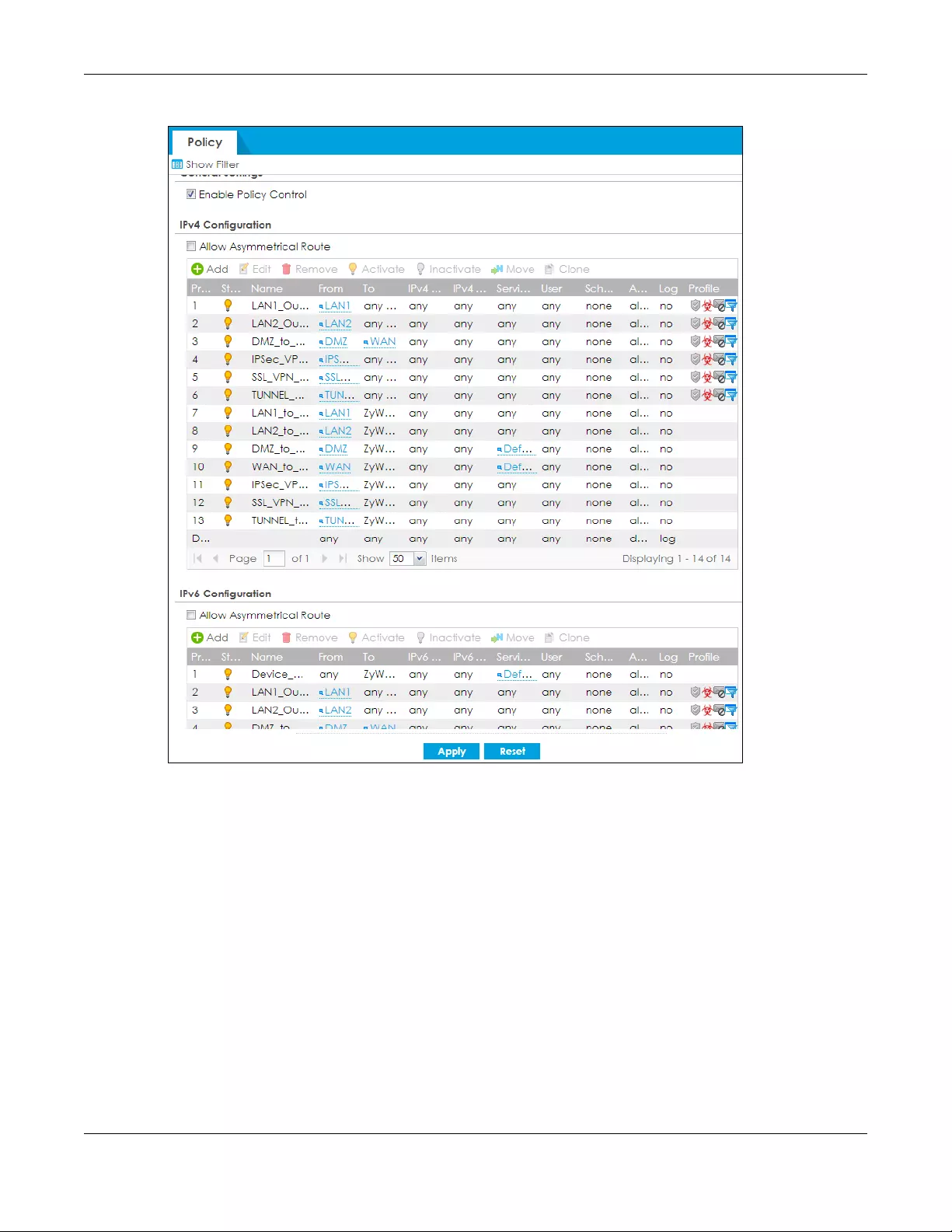
Chapter 33 Anti-Malware
ZyWALL USG FLEX Series User’s Guide
635
Figure 418 Configuration > Security Service > Policy Control > Profile
33.6.3 Anti-Malware Advance Screen
The Security Service > Anti-Malware > Anti-Malware screen changes when using profiles.

Chapter 33 Anti-Malware
ZyWALL USG FLEX Series User’s Guide
636
Figure 419 Configuration > Security Service > Anti-Malware Advance
The following table describes the labels in this screen.
Table 258 Configuration > Security Service > Anti-Malware Advance
LABEL DESCRIPTION
General Setting
Enable Select this checkbox to activate the anti-malware feature to protect your connected
network from infection and the installation of malicious software.
Inspect all traffic,
setting:
Select this to have all traffic inspected by the default_profile. You cannot rename or delete
the default_profile profile, but you can edit it by clicking the link here.
Inspect by policy If you configured a specific profile in the Profile tab for this service, select this to have
specific traffic inspected by that profile. You must bind the profile to a policy in Security
Policy > Policy Control.
Scan and detect
EICAR test virus
Select this option to have the Zyxel Device check for an EICAR test file and treat it in the
same way as a real malware file.
The EICAR test file is a standardized test file for signature based anti-malware scanners.
When the scanner detects the EICAR file, it responds in the same way as if it found real
malware. The EICAR file can also be compressed to test whether the anti-malware software
can detect it in a compressed file. The EICAR test string consists of the following human-
readable ASCII characters.
X5O!P%@AP[4\PZX54(P^)7CC)7}$EICAR-STANDARD-ANTIVIRUS-TEST-FILE!$H+H*
Scan Mode

Chapter 33 Anti-Malware
ZyWALL USG FLEX Series User’s Guide
637
33.6.4 Remove Profiles
To remove profiles and revert to the default general security policy style, you must first make sure to
change Inspect by policy to Inspect all traffic in the following security services: Anti-Malware, DNS Filter,
URL Threat Filter, IDP, Email Security.
Note: All profiles that you created will be removed from Security Policy > Policy Control.
Run the following commands in the Zyxel Device Command Line Interface (CLI).
Wait a minute and then go to the feature screen again in the web configurator. You will be prompted
to log out and then log in again.
Figure 420 Logout Prompt
After you log in again, you will not see the profile screen for this feature.
Express Mode In this mode you can define which types of files are scanned using the File Type For Scan
fields. The Zyxel Device then scans files by sending each file’s hash value to a cloud
database using cloud query. This is the fastest scan mode.
Stream Mode In this mode the Zyxel Device scans all files for viruses using its anti-malware signatures to
detect known virus pattens. This is the deepest scan mode.
File Type For Scan
Available File Types File types that can be checked by the Zyxel Device are listed here. Note that the files on this
list are currently bypassed. To use this feature on a specific file type, click this file type and
then click the right arrow button.
See available file types in Table 251 on page 624.
Applied File Types File types that will be checked are listed here. If you don’t want a file type to be checked,
click this file type and then click the left arrow button.
Apply Click Apply to save your changes.
Reset Click Reset to return the screen to its last-saved settings.
Table 258 Configuration > Security Service > Anti-Malware Advance (continued)
LABEL DESCRIPTION
Router# configure terminal
Router(config)# secure-policy-style general
Router(config)# show secure-policy-style status
secure-policy-style: general
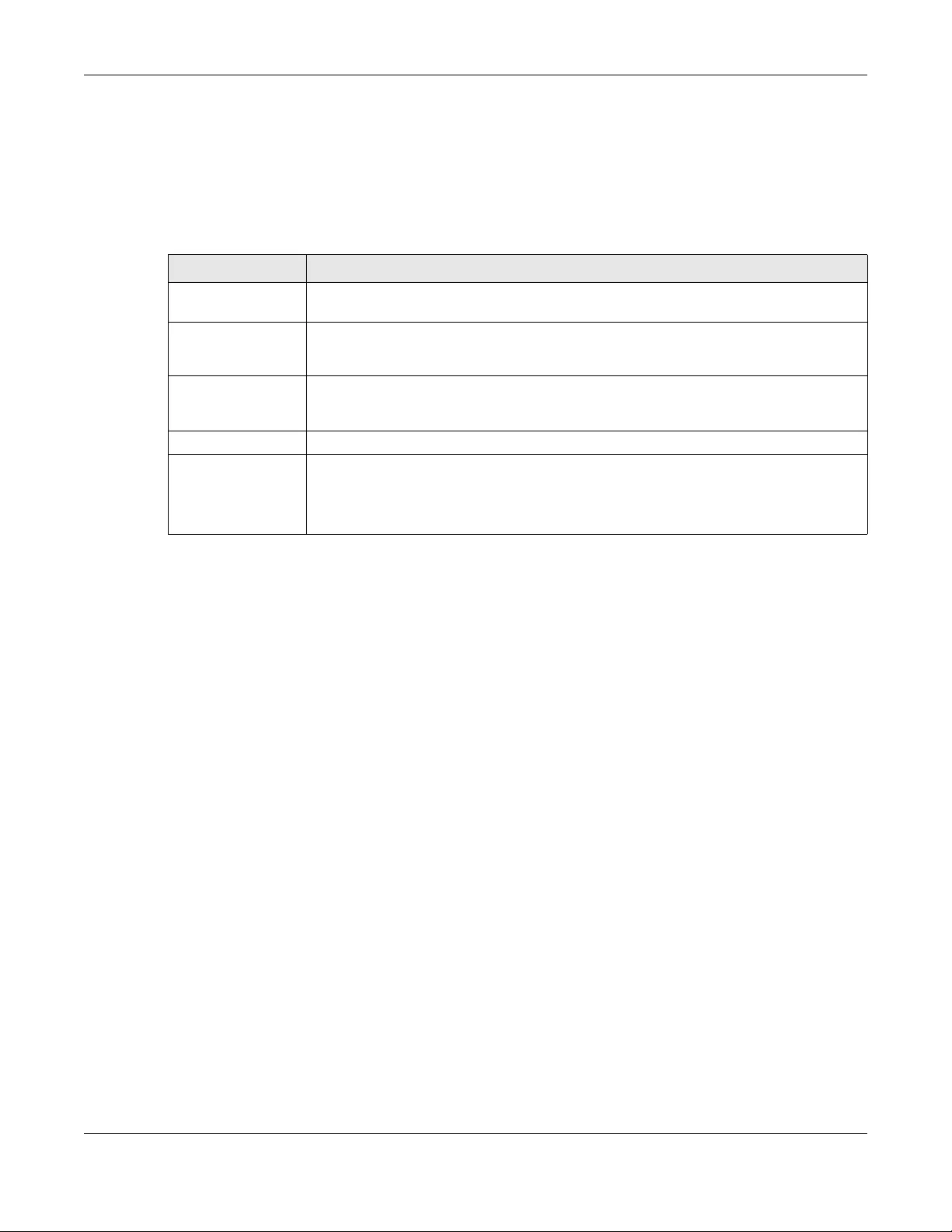
Chapter 33 Anti-Malware
ZyWALL USG FLEX Series User’s Guide
638
33.7 Anti-Malware Technical Reference
Types of Malware
The following table describes some of the common malware.
Malware Infection and Prevention
The following describes a simple life cycle of malware.
1A computer gets a copy of malware from a source such as the Internet, email, file sharing or any
removable storage media. The malware is harmless until the execution of an infected program.
2The malware spreads to other files and programs on the computer.
3The infected files are unintentionally sent to another computer thus starting the spread of the malware.
4Once the malware is spread through the network, the number of infected networked computers can
grow exponentially.
Types of Anti-Malware Scanner
The section describes two types of anti-malware scanner: host-based and network-based.
A host-based anti-malware (HAM) scanner is often software installed on computers and/or servers on
the network. It inspects files for malware patterns as they are moved in and out of the drive. However,
host-based anti-malware scanners cannot eliminate all malware for a number of reasons:
• HAM scanners are slow in stopping malware threats through real-time traffic (such as from the
Internet).
• HAM scanners may reduce computing performance as they also share resources (such as CPU time)
on the computer for file inspection.
• You have to update the malware signatures and/or perform malware scans on all computers on the
network regularly.
Table 259 Common Malware Types
TYPE DESCRIPTION
File Infector This is a small program that embeds itself in a legitimate program. A file infector is able to
copy and attach itself to other programs that are executed on an infected computer.
Boot Sector Virus This type of virus infects the area of a hard drive that a computer reads and executes
during startup. The virus causes computer crashes and to some extend renders the infected
computer inoperable.
Macro Virus Macro viruses or Macros are small programs that are created to perform repetitive actions.
Macros run automatically when a file to which they are attached is opened. Macros
spread more rapidly than other types of viruses as data files are often shared on a network.
Email Virus Email viruses are malicious programs that spread through email.
Polymorphic Virus A polymorphic virus (also known as a mutation virus) tries to evade detection by changing
a portion of its code structure after each execution or self replication. This makes it harder
for an anti-malware scanner to detect or intercept it.
A polymorphic virus can also belong to any of the virus types discussed above.

Chapter 33 Anti-Malware
ZyWALL USG FLEX Series User’s Guide
639
A network-based anti-malware (NAM) scanner is often deployed as a dedicated security device (such
as your Zyxel Device) on the network edge. NAM scanners inspect real-time data traffic (such as email
messages or web) that tends to bypass HAM scanners. The following lists some of the benefits of NAM
scanners.
• NAM scanners stop malware threats at the network edge before they enter or exit a network.
• NAM scanners reduce computing loading on computers as the read-time data traffic inspection is
done on a dedicated security device.

ZyWALL USG FLEX Series User’s Guide
640
CHAPTER 34
Reputation Filter
34.1 Overview
Use the Reputation Filter screens to configure settings forURL Threat filtering.
34.1.1 What You Need to Know
URL Threat Filter
URL filtering compares access to specific URLs against a database of blocked or allowed sites. Sites on
the database are sorted into categories such as:
34.1.2 What You Can Do in this Chapter
• Use the URL Threat Filter screen (Section 34.2 on page 640) to enable URL Threat filtering and specify
what action the Zyxel Device takes when any suspicious activity is detected.
34.2 URL Threat Filter Screen
When you enable the URL Threat filtering service, your Zyxel Device will access an external database,
Cloud Query, that has millions of web sites categorized based on content. You can have the Zyxel
Device allow, block, warn and/or log access to web sites or hosts based on selected categories.
The priority for URL Threat checking is as follows:
1White List
2Black List
3Cloud Query Cache
4Cloud Query
Use this screen to enable URL Threat filtering and specify the action the Zyxel Device takes when it
detects a suspicious activity or a connection attempt to or from a site in a selected category.
•Anonymizers •Browser Exploits • Malicious Downloads
• Malicious Sites • Phishing •Spam URLs
• Spyware Adware Keyloggers • •
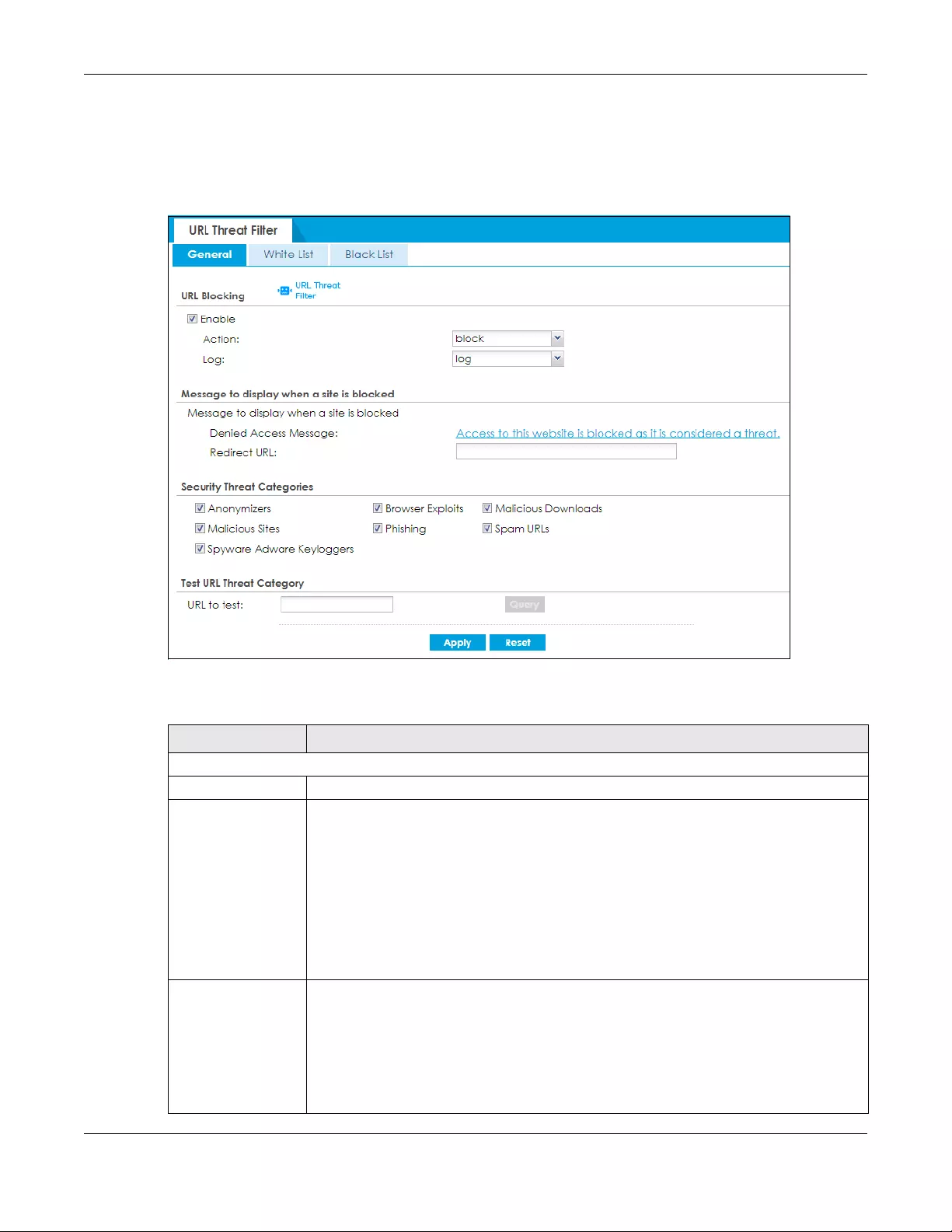
Chapter 34 Reputation Filter
ZyWALL USG FLEX Series User’s Guide
641
Click the URL Threat Filter icon for more information on the Zyxel Device’s security features.
Click Configuration > Security Service > Reputation Filter > URL Threat Filter to display the configuration
screen as shown next.
Figure 421 Configuration > Security Service > Reputation Filter > URL Threat Filter > General
The following table describes the labels in this screen.
Table 260 Configuration > Security Service > Reputation Filter > URL Threat Filter > General
LABEL DESCRIPTION
URL Blocking
Enable Select this option to turn on URL blocking on the Zyxel Device.
Action Set what action the Zyxel Device takes when it detects a connection attempt to or from the
web pages of the specified categories.
block: Select this action to have the Zyxel Device block access to the web pages that
match the categories that you select above.
warn: Select this action to have the Zyxel Device display a warning message to the access
requesters for the web pages before allowing users to access web pages that match the
categories that you select above.
pass: Select this action to have the Zyxel Device allow access to the web pages that match
the categories that you select above.
Log These are the log options:
•no: Do not create a log when it detects a connection attempt to or from the web
pages of the specified categories.
•log: Create a log on the Zyxel Device when it detects a connection attempt to or from
the web pages of the specified categories.
•log alert: An alert is an emailed log for more serious events that may need more
immediate attention. Select this option to have the Zyxel Device send an alert when a
connection matches web pages of the specified categories.

Chapter 34 Reputation Filter
ZyWALL USG FLEX Series User’s Guide
642
34.2.1 URL Threat Filter White List Screen
Use this screen to create white list entries. The Zyxel Device will allow incoming packets from the listed
IPv4 addresses and URLs.
Message to display when a site is blocked
Denied Access
Message
Enter a message to be displayed when the URL Threat filter blocks access to a web page.
Use up to 127 characters (0-9a-zA-Z;/?:@&=+$\.-_!~*'()%,”). For example, “Access to this
web page is not allowed. Please contact the network administrator”.
It is also possible to leave this field blank if you have a URL specified in the Redirect URL field.
In this case if the URL Threat filter blocks access to a web page, the Zyxel Device just opens
the web page you specified without showing a denied access message.
Redirect URL Enter the URL of the web page to which you want to send users when their web access is
blocked by the URL Threat filter. The web page you specify here opens in a new frame
below the denied access message.
Use “http://” or “https://” followed by up to 262 characters (0-9a-zA-Z;/?:@&=+$\.-_!~*'()%).
For example, http://192.168.1.17/blocked access.
Security Threat
Categories
Select the categories of web pages that may pose a security threat to network devices
behind the Zyxel Device.
Anonymizers Sites and proxies that act as an intermediary for surfing to other Web sites in an anonymous
fashion, whether to circumvent Web filtering or for other reasons.
Browser Exploits Sites that contain browser exploits. A browser exploit is any content that forces a web
browser to perform operations that you do not explicitly intend.
Malicious
Downloads Sites that have been identified as containing malicious downloads or malware harmful to a
user's computer.
Malicious Sites Sites that install unwanted software on a user's computer with the intent to enable third-
party monitoring or make system changes without the user's consent.
Phishing Sites that are used for deceptive or fraudulent purposes, such as stealing financial or other
user account information. These sites are most often designed to appear as legitimate sites
in order to mislead users into entering their credentials.
Spam URLs Sites that have been promoted through spam techniques.
Spyware Adware
Keyloggers Sites that contain spyware, adware or keyloggers.
• Spyware is a program installed on your computer, usually without your explicit
knowledge, that captures and transmits personal information or Internet browsing habits
and details to companies. Companies use this information to analyze browsing habits,
to gather marketing data, and to sell your information to others.
• Key logger programs try to capture and steal your passwords and watch and record
everything you do on your computer.
• Adware programs typically display blinking advertisements or pop-up windows when
you perform a certain action. Adware programs are often installed in exchange for
another service, such as the right to use a program without paying for it.
Test URL Threat
Category
URL to test Enter a URL using http://domain or https://domain and click the Query button to check if
the domain belongs to a URL threat category.
Apply Click Apply to save your changes.
Reset Click Reset to return the screen to its last-saved settings.
Table 260 Configuration > Security Service > Reputation Filter > URL Threat Filter > General (continued)
LABEL DESCRIPTION
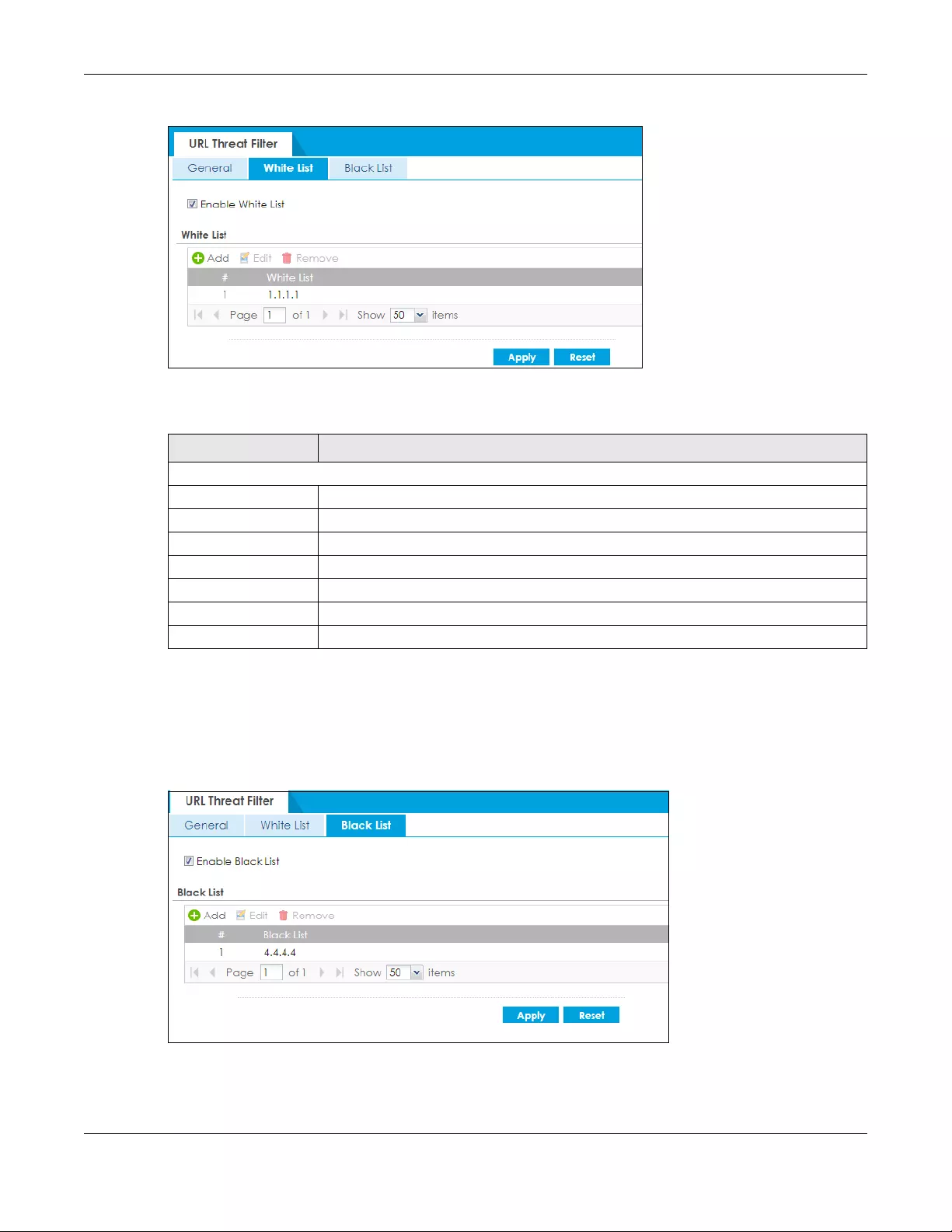
Chapter 34 Reputation Filter
ZyWALL USG FLEX Series User’s Guide
643
Figure 422 Configuration > Security Service > Reputation Filter > URL Threat Filter > White List
The following table describes the labels in this screen.
34.2.2 URL Threat Filter Black List Screen
Use this screen to create black list entries. The Zyxel Device will block incoming packets from the listed
IPv4 addresses and URLs.
Figure 423 Configuration > Security Service > Reputation Filter > URL Threat Filter > Black List
Table 261 Configuration > Security Service > Reputation Filter > URL Threat Filter > White List
LABEL DESCRIPTION
White List
Add Click this to create a new entry.
Edit Select an entry and click this to be able to modify it.
Remove Select an entry and click this to delete it.
#This is the entry’s index number in the list.
White List This field displays the URL of this entry.
Apply Click Apply to save your changes back to the Zyxel Device.
Reset Click Reset to return the screen to its last-saved settings.
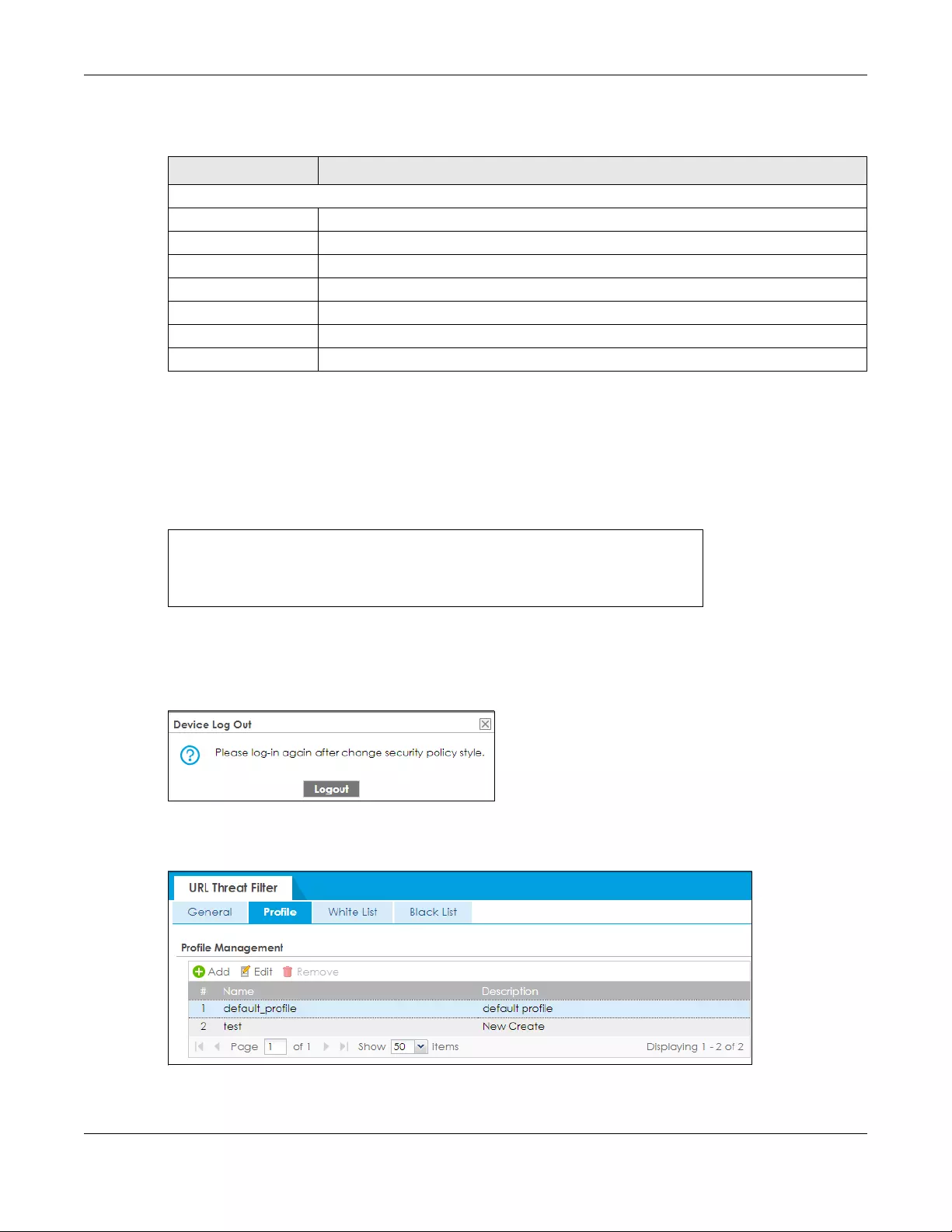
Chapter 34 Reputation Filter
ZyWALL USG FLEX Series User’s Guide
644
The following table describes the labels in this screen.
34.3 URL Threat Filter Profile
To use multiple profiles for this feature, run the following commands in the Zyxel Device Command Line
Interface (CLI).
After you run these command, go to the feature screen again in the web configurator. You will be
prompted to log out and then log in again.
Figure 424 Logout Prompt
After you log in again, you will see the new profile screen for this feature.
Figure 425 Configuration > Security Service > Reputation Filter > URL Threat Filter > Profile
Table 262 Configuration > Security Service > Reputation Filter > URL Threat Filter > Black List
LABEL DESCRIPTION
Black List
Add Click this to create a new entry.
Edit Select an entry and click this to be able to modify it.
Remove Select an entry and click this to delete it.
#This is the entry’s index number in the list.
Black List This field displays the URL of this entry.
Apply Click Apply to save your changes back to the Zyxel Device.
Reset Click Reset to return the screen to its last-saved settings.
Router# configure terminal
Router(config)# secure-policy-style advance
Router(config)# show secure-policy-style status
secure-policy-style: advance

Chapter 34 Reputation Filter
ZyWALL USG FLEX Series User’s Guide
645
The following table describes the labels in this screen.
34.3.1 Add or Edit a URL Threat Filter Profile
Click Add to create a new entry or select an existing entry and click Edit to open the following screen
where you can create or modify the entry’s settings.
Figure 426 Configuration > Security Service > Reputation Filter > URL Threat Filter > Profile > Add/Edit
Table 263 Configuration > Security Service > Reputation Filter > URL Threat Filter > Profile
LABEL DESCRIPTION
Add Click this to create a new entry. Select an entry and click Add to create a new entry after the
selected entry.
Edit Double-click an entry or select it and click Edit to open a screen where you can modify the
entry’s settings.
Remove Select an entry and click Remove to delete the selected entry.
#This field is a sequential value showing the number of the profile. The profile order is not
important.
Name This displays the name of the profile created.
Description This displays the description of the profile.

Chapter 34 Reputation Filter
ZyWALL USG FLEX Series User’s Guide
646
The following table describes the labels in this screen.
Table 264 Configuration > Security Service > Reputation Filter > URL Threat Filter > Profile > Add/Edit
LABEL DESCRIPTION
Configuration
Profile Name Type the name of the profile. You may use 1-31 alphanumeric characters, underscores(_),
or dashes (-), but the first character cannot be a number. This value is case-sensitive. These
are valid, unique profile names:
•MyProfile
•mYProfile
• Mymy12_3-4
These are invalid profile names:
• 1mYProfile
•My Profile
•MyProfile?
• Whatalongprofilename123456789012
Description Type a description for the profile rule to help identify the purpose of rule. You may use 1-31
alphanumeric characters, underscores (_), or dashes (-), but the first character cannot be
a number. This value is case-sensitive. This field is optional.
Action Set what action the Zyxel Device takes when it detects a connection attempt to or from the
web pages of the specified categories.
block: Select this action to have the Zyxel Device block access to the web pages that
match the categories that you select above.
warn: Select this action to have the Zyxel Device display a warning message to the access
requesters for the web pages before allowing users to access web pages that match the
categories that you select above.
pass: Select this action to have the Zyxel Device allow access to the web pages that match
the categories that you select above.
Log These are the log options:
•no: Do not create a log when it detects a connection attempt to or from the web
pages of the specified categories.
•log: Create a log on the Zyxel Device when it detects a connection attempt to or from
the web pages of the specified categories.
•log alert: An alert is an emailed log for more serious events that may need more
immediate attention. Select this option to have the Zyxel Device send an alert when a
connection matches web pages of the specified categories.
Scan Options
Check White List Select this check box to have the Zyxel Device not perform the URL Threat filter check on
URLs that match the white list entries.
Check Black List Select this check box to have the Zyxel Device perform the URL Threat filter check on URLs
that match the black list entries.
Security Threat
Categories
Select the categories of FQDNs that may pose a security threat to network devices behind
the Zyxel Device.
Anonymizers Sites and proxies that act as an intermediary for surfing to other Web sites in an anonymous
fashion, whether to circumvent Web filtering or for other reasons.
Browser Exploits Sites that contain browser exploits. A browser exploit is any content that forces a web
browser to perform operations that you do not explicitly intend.
Malicious
Downloads Sites that have been identified as containing malicious downloads or malware harmful to a
user's computer.
Malicious Sites Sites that install unwanted software on a user's computer with the intent to enable third-
party monitoring or make system changes without the user's consent.

Chapter 34 Reputation Filter
ZyWALL USG FLEX Series User’s Guide
647
34.3.2 Link a Profile
To link a profile to a policy, go to the Configuration > Security Policy > Policy Control screen, select a pol-
icy, and then click Edit. In the Edit Policy screen under Profile, select which profile you want to use for
each security service.
Phishing Sites that are used for deceptive or fraudulent purposes, such as stealing financial or other
user account information. These sites are most often designed to appear as legitimate sites
in order to mislead users into entering their credentials.
Spam URLs Sites that have been promoted through spam techniques.
Spyware Adware
Keyloggers Sites that contain spyware, adware or keyloggers.
• Spyware is a program installed on your computer, usually without your explicit
knowledge, that captures and transmits personal information or Internet browsing habits
and details to companies. Companies use this information to analyze browsing habits,
to gather marketing data, and to sell your information to others.
• Key logger programs try to capture and steal your passwords and watch and record
everything you do on your computer.
• Adware programs typically display blinking advertisements or pop-up windows when
you perform a certain action. Adware programs are often installed in exchange for
another service, such as the right to use a program without paying for it.
OK Click OK to save your changes back to the Zyxel Device.
Cancel Click Cancel to exit this screen without saving.
Table 264 Configuration > Security Service > Reputation Filter > URL Threat Filter > Profile > Add/Edit
LABEL DESCRIPTION
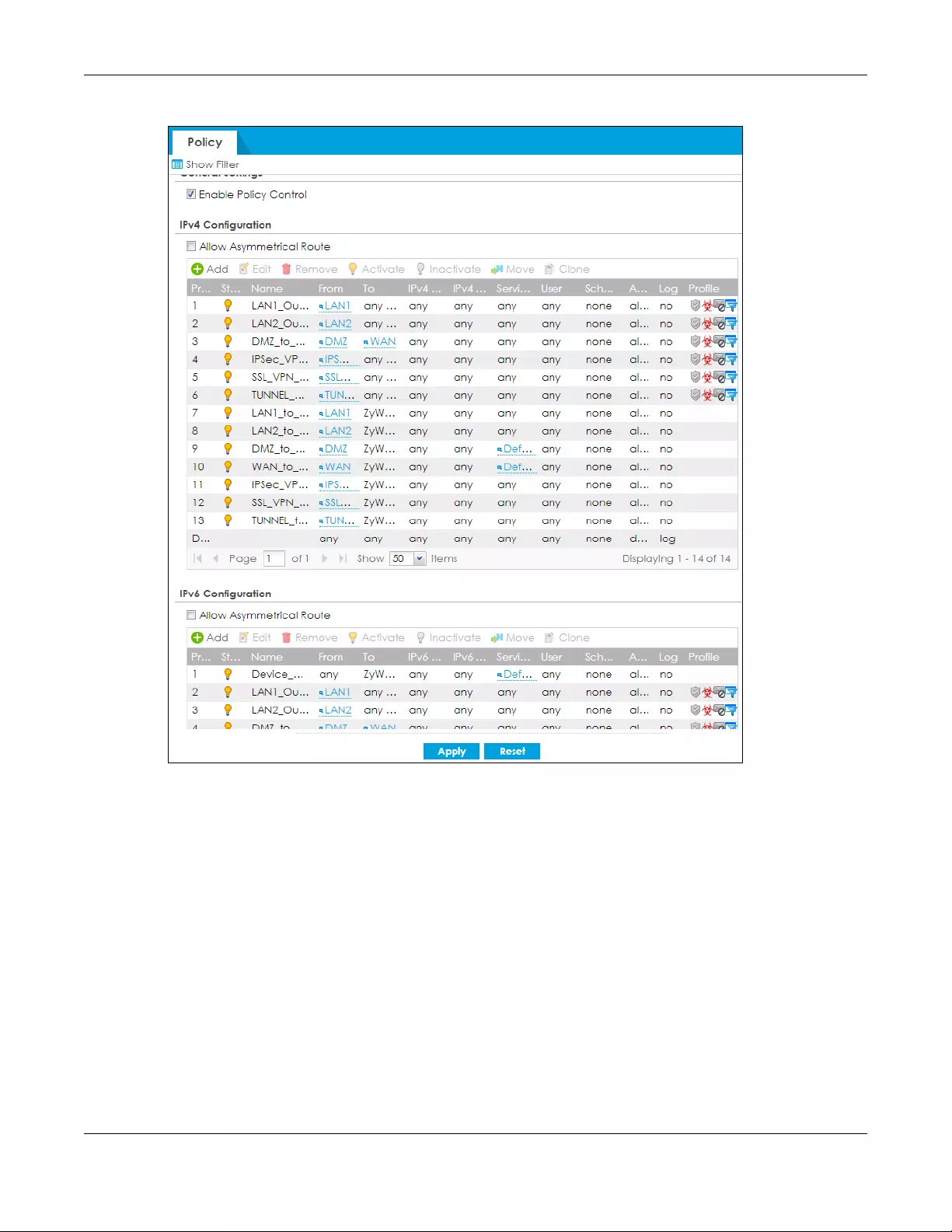
Chapter 34 Reputation Filter
ZyWALL USG FLEX Series User’s Guide
648
Figure 427 Configuration > Security Service > Policy Control > Profile
34.3.3 URL Threat Filter Advance Screen
The Configuration > Security Service > Reputation Filter > URL Threat Filter screen also changes when
using profiles.
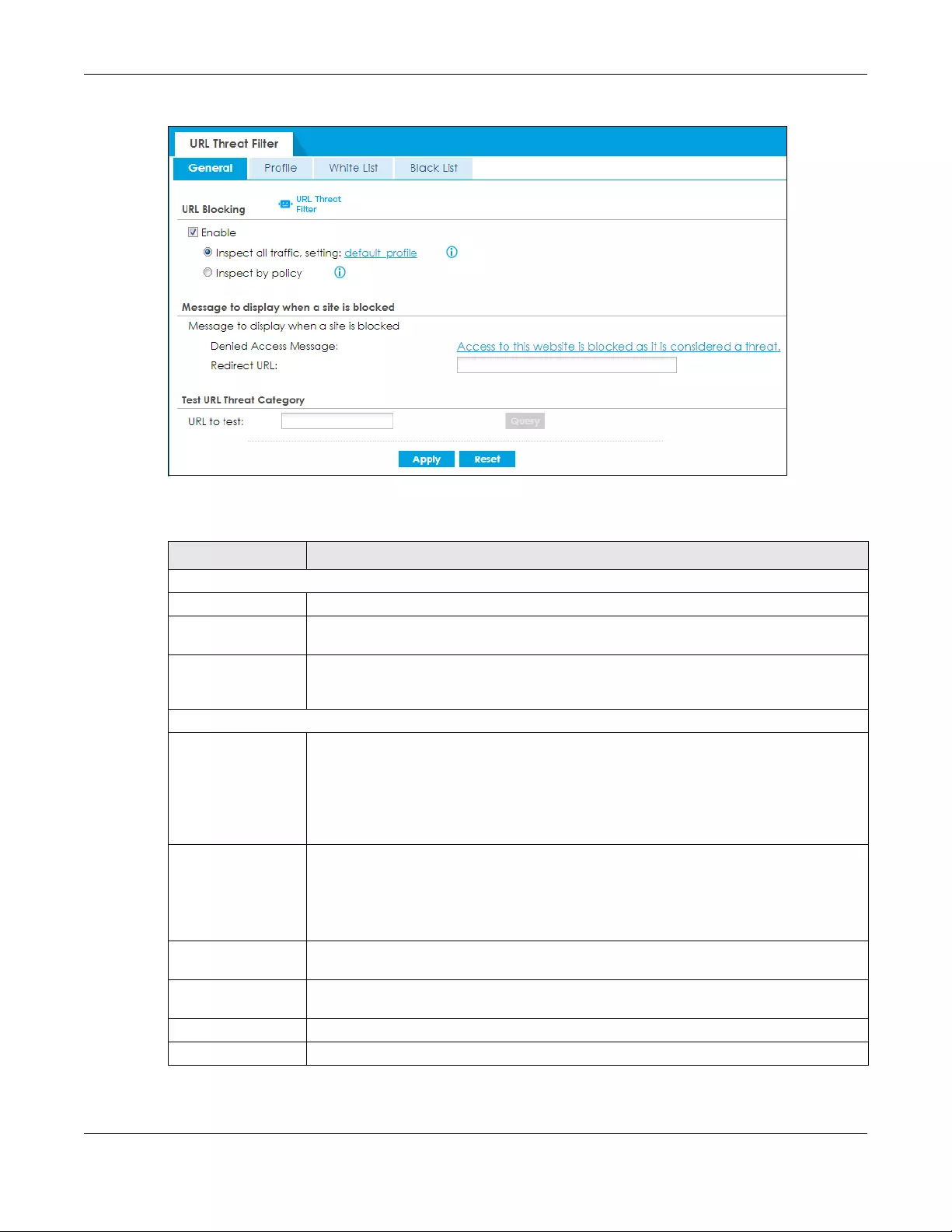
Chapter 34 Reputation Filter
ZyWALL USG FLEX Series User’s Guide
649
Figure 428 Configuration > Security Service > Reputation Filter > URL Threat Filter > General
The following table describes the labels in this screen.
Table 265 Configuration > Security Service > Reputation Filter > URL Threat Filter > General
LABEL DESCRIPTION
URL Blocking
Enable Select this option to turn on URL blocking on the Zyxel Device.
Inspect all traffic,
setting:
Select this to have all traffic inspected by the default_profile. You cannot rename or delete
the default_profile profile, but you can edit it by clicking the link here.
Inspect by policy If you configured a specific profile in the Profile tab for this service, select this to have
specific traffic inspected by that profile. You must bind the profile to a policy in Security
Policy > Policy Control.
Message to display when a site is blocked
Denied Access
Message
Enter a message to be displayed when the URL Threat filter blocks access to a web page.
Use up to 127 characters (0-9a-zA-Z;/?:@&=+$\.-_!~*'()%,”). For example, “Access to this
web page is not allowed. Please contact the network administrator”.
It is also possible to leave this field blank if you have a URL specified in the Redirect URL field.
In this case if the URL Threat filter blocks access to a web page, the Zyxel Device just opens
the web page you specified without showing a denied access message.
Redirect URL Enter the URL of the web page to which you want to send users when their web access is
blocked by the URL Threat filter. The web page you specify here opens in a new frame
below the denied access message.
Use “http://” or “https://” followed by up to 262 characters (0-9a-zA-Z;/?:@&=+$\.-_!~*'()%).
For example, http://192.168.1.17/blocked access.
Test URL Threat
Category
URL to test Enter a URL using http://domain or https://domain and click the Query button to check if
the domain belongs to a URL threat category.
Apply Click Apply to save your changes.
Reset Click Reset to return the screen to its last-saved settings.
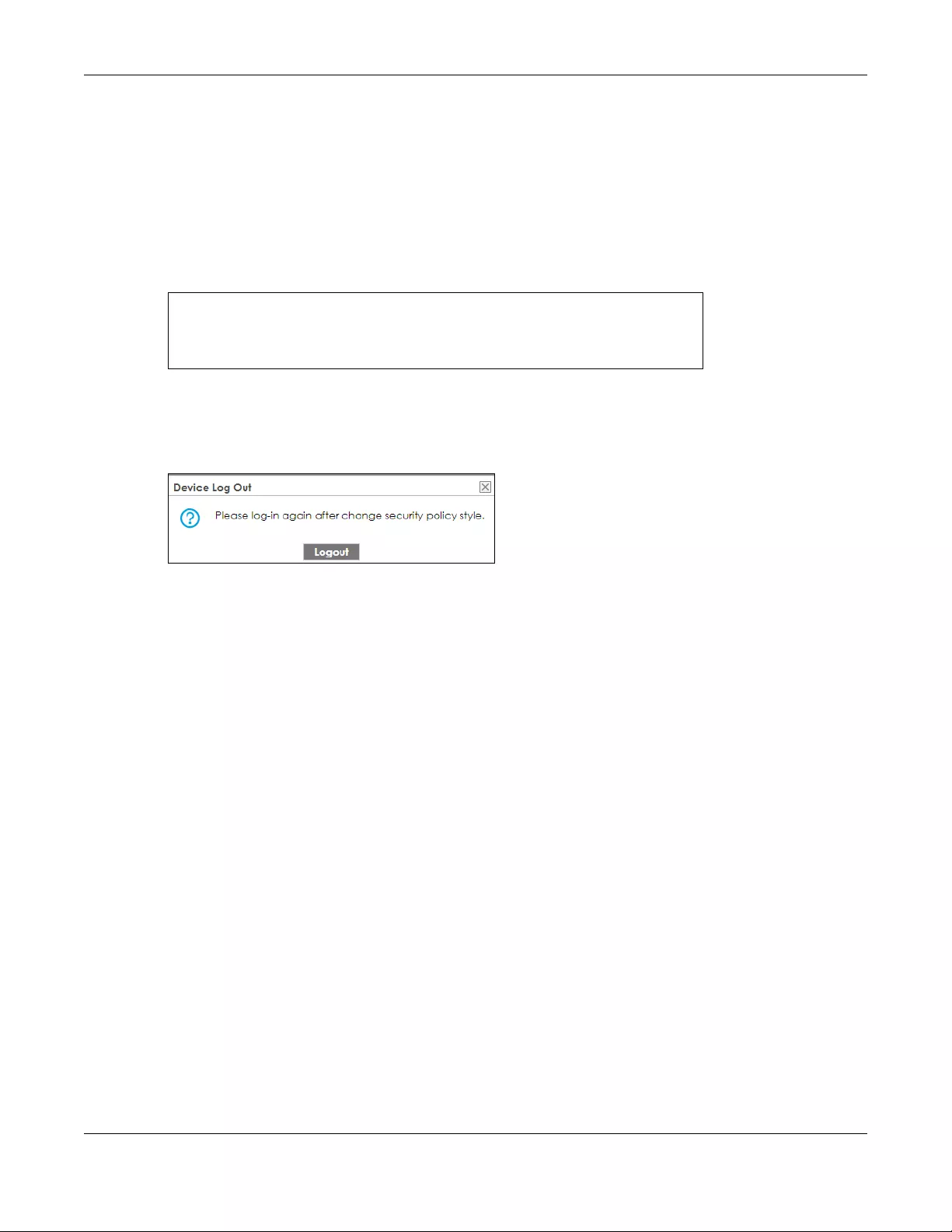
Chapter 34 Reputation Filter
ZyWALL USG FLEX Series User’s Guide
650
34.3.4 Remove Profiles
To remove profiles and revert to the default general security policy style, you must first make sure to
change Inspect by policy to Inspect all traffic in the following security services: Anti-Malware, DNS Filter,
URL Threat Filter, IDP, Email Security.
Note: All profiles that you created will be removed from Security Policy > Policy Control.
Run the following commands in the Zyxel Device Command Line Interface (CLI).
Wait a minute and then go to the feature screen again in the web configurator. You will be prompted
to log out and then log in again.
Figure 429 Logout Prompt
After you log in again, you will not see the profile screen for this feature.
Router# configure terminal
Router(config)# secure-policy-style general
Router(config)# show secure-policy-style status
secure-policy-style: general

ZyWALL USG FLEX Series User’s Guide
651
CHAPTER 35
IDP
35.1 Overview
This chapter introduces packet inspection IDP (Intrusion, Detection and Prevention), custom signatures,
and updating signatures. An IDP system can detect malicious or suspicious packets and respond
instantaneously. IDP on the Zyxel Device protects against network-based intrusions.
35.1.1 What You Can Do in this Chapter
• Use the Security Service > IDP screen (Section 35.2 on page 652) to view registration and signature
information.
• Use the Security Service > IDP > Custom Signature > Add screens (Section 35.3 on page 657) to create
a new custom signature, edit an existing signature, delete existing signatures or save signatures to
your computer.
• Use the Security Service > IDP > White List screen (Section 35.4 on page 665) to list signatures that will
be exempted from IDP inspection.
35.1.2 What You Need To Know
Packet Inspection Signatures
A signature is a pattern of malicious or suspicious packet activity. You can specify an action to be taken
if the system matches a stream of data to a malicious signature. You can change the action in the
profile screens. Packet inspection examine OSI (Open System Interconnection) layer-4 to layer-7 packet
contents for malicious data. Generally, packet inspection signatures are created for known attacks
while anomaly detection looks for abnormal behavior.
Applying Your IDP Configuration
Changes to the Zyxel Device’s IDP settings affect new sessions, but not the sessions that already existed
before you applied the new settings.
35.1.3 Before You Begin
• Register for a trial IDP subscription in the Registration screen. This gives you access to free signature
updates. This is important as new signatures are created as new attacks evolve. When the trial
subscription expires, purchase and enter a license key using the same screens to continue the
subscription.
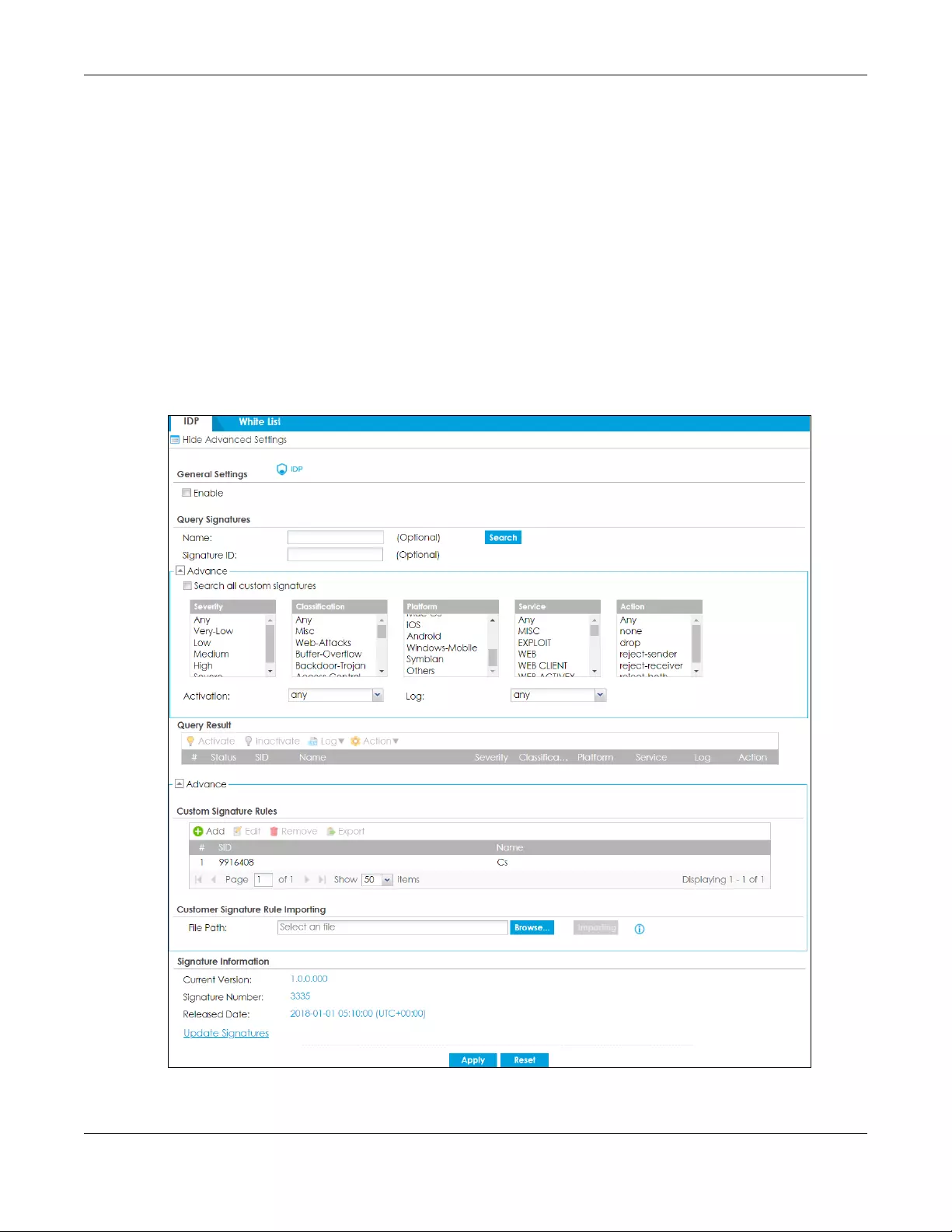
Chapter 35 IDP
ZyWALL USG FLEX Series User’s Guide
652
35.2 The IDP Screen
An IDP profile is a set of packet inspection signatures.
Click Configuration > Security Service > IDP to open this screen. Use this screen to view registration and
signature information.
Note: You must register in order to update packet inspection signatures. See the Registration
screens.
If you try to enable IDP when the IDP service has not yet been registered, a warning screen displays and
IDP is not enabled.
Click the IDP icon for more information on the Zyxel Device’s security features.
Figure 430 Configuration > Security Service > IDP

Chapter 35 IDP
ZyWALL USG FLEX Series User’s Guide
653
The following table describes the fields in this screen.
Table 266 Configuration > Security Service > IDP
LABEL DESCRIPTION
General Settings
Enable Select this check box to activate the IDP feature which detects and prevents malicious
or suspicious packets and responds instantaneously.
Query Signatures
Name Type the name or part of the name of the signature(s) you want to find.
Signature ID Type the ID or part of the ID of the signature(s) you want to find.
Search all custom
signatures Select this check box to include signatures you created or imported in the Custom
Signatures screen in the search. You can search for specific signatures by name or ID. If
the name and ID fields are left blank, then all signatures are searched according to the
criteria you select.
Severity Search for signatures by severity level(s). Hold down the [Ctrl] key if you want to make
multiple selections.
These are the severities as defined in the Zyxel Device. The number in brackets is the
number you use if using commands.
Severe (5): These denote attacks that try to run arbitrary code or gain system privileges.
High (4): These denote known serious vulnerabilities or attacks that are probably not
false alarms.
Medium (3): These denote medium threats, access control attacks or attacks that could
be false alarms.
Low (2): These denote mild threats or attacks that could be false alarms.
Very-Low (1): These denote possible attacks caused by traffic such as Ping, trace route,
ICMP queries etc.
Classification Type Search for signatures by attack type(s) (see Table 267 on page 654). Attack types are
known as policy types in the group view screen. Hold down the [Ctrl] key if you want to
make multiple selections.
Platform Search for signatures created to prevent intrusions targeting specific operating
system(s). Hold down the [Ctrl] key if you want to make multiple selections.
Service Search for signatures by IDP service group(s). See Table 267 on page 654 for group
details. Hold down the [Ctrl] key if you want to make multiple selections.
Action Search for signatures by the response the Zyxel Device takes when a packet matches a
signature.Hold down the [Ctrl] key if you want to make multiple selections.
Activation Search for activated and/or inactivated signatures here.
Log Search for signatures by log option here.
Query Result The results are displayed in a table showing the SID, Name, Severity, Classification Type,
Platform, Service, Log, and Action criteria as selected in the search. Click the SID column
header to sort search results by signature ID.
Custom Signature Rules Use this part of the screen to create, edit, delete or export (save to your computer)
custom signatures.
Add Click this to create a new entry.
Edit Select an entry and click this to be able to modify it.
Remove Select an entry and click this to delete it.
Export To save an entry or entries as a file on your computer, select them and click Export. Click
Save in the file download dialog box and then select a location and name for the file.
Custom signatures must end with the ‘rules’ file name extension, for example,
MySig.rules.

Chapter 35 IDP
ZyWALL USG FLEX Series User’s Guide
654
Policy Types
This table describes Policy Types as categorized in the Zyxel Device.
#This is the entry’s index number in the list.
SID SID is the signature ID that uniquely identifies a signature. Click the SID header to sort
signatures in ascending or descending order. It is automatically created when you click
the Add icon to create a new signature. You can edit the ID, but it cannot already exist
and it must be in the 9000000 to 9999999 range.
Name This is the name of your custom signature. Duplicate names can exist, but it is advisable
to use unique signature names that give some hint as to intent of the signature and the
type of attack it is supposed to prevent.
Customer Signature Rule
Importing
Use this part of the screen to import custom signatures (previously saved to your
computer) to the Zyxel Device.
Note: The name of the complete custom signature file on the Zyxel Device is
‘custom.rules’. If you import a file named ‘custom.rules’, then all custom
signatures on the Zyxel Device are overwritten with the new file. If this is
not your intention, make sure that the files you import are not named
‘custom.rules’.
File Path Type the file path and name of the custom signature file you want to import in the text
box (or click Browse to find it on your computer) and then click Importing to transfer the
file to the Zyxel Device.
New signatures then display in the Zyxel Device IDP > Custom Signatures screen.
Signature Information The following fields display information on the current signature set that the Zyxel Device
is using.
Current Version This field displays the IDP signature set version number. This number gets larger as the set
is enhanced.
Signature Number This field displays the number of IDP signatures in this set. This number usually gets larger
as the set is enhanced. Older signatures and rules may be removed if they are no longer
applicable or have been supplanted by newer ones.
Released Date This field displays the date and time the set was released.
Update Signatures Click this link to go to the screen you can use to download signatures from the update
server.
Apply Click Apply to save your changes back to the Zyxel Device.
Reset Click Reset to return the screen to its last-saved settings.
Table 267 Policy Types
POLICY TYPE DESCRIPTION
Access Control Access control refers to procedures and controls that limit or detect access. Access
control attacks try to bypass validation checks in order to access network resources such
as servers, directories, and files.
Any Any attack includes all other kinds of attacks that are not specified in the policy such as
password, spoof, hijack, phishing, and close-in.
Table 266 Configuration > Security Service > IDP (continued)
LABEL DESCRIPTION

Chapter 35 IDP
ZyWALL USG FLEX Series User’s Guide
655
Backdoor/Trojan Horse A backdoor (also called a trapdoor) is hidden software or a hardware mechanism that
can be triggered to gain access to a program, online service or an entire computer
system. A Trojan horse is a harmful program that is hidden inside apparently harmless
programs or data.
Although a virus, a worm and a Trojan are different types of attacks, they can be
blended into one attack. For example, W32/Blaster and W32/Sasser are blended attacks
that feature a combination of a worm and a Trojan.
BotNet A Botnet is a number of Internet computers that have been set up to forward
transmissions including spam or viruses to other computers on the Internet though their
owners are unaware of it. It is also a collection of Internet-connected programs
communicating with other similar programs in order to perform tasks and participate in
distributed Denial-Of-Service attacks.
Buffer Overflow A buffer overflow occurs when a program or process tries to store more data in a buffer
(temporary data storage area) than it was intended to hold. The excess information can
overflow into adjacent buffers, corrupting or overwriting the valid data held in them.
Intruders could run codes in the overflow buffer region to obtain control of the system,
install a backdoor or use the victim to launch attacks on other devices.
DoS/DDoS The goal of Denial of Service (DoS) attacks is not to steal information, but to disable a
device or network on the Internet.
A Distributed Denial of Service (DDoS) attack is one in which multiple compromised
systems attack a single target, thereby causing denial of service for users of the targeted
system.
Instant Messenger IM (Instant Messenger) refers to chat applications. Chat is real-time, text-based
communication between two or more users via networks-connected computers. After
you enter a chat (or chat room), any room member can type a message that will
appear on the monitors of all the other participants.
Mail A Mail or email bombing attack involves sending several thousand identical messages to
an electronic mailbox in order to overflow it, making it unusable.
Misc Miscellaneous attacks takes advantage of vulnerable computer networks and web
servers by forcing cache servers or web browsers into disclosing user-specific information
that might be sensitive and confidential. The most common type of Misc. attacks are
HTTP Response Smuggling, HTTP Response Splitting and JSON Hijacking.
P2P Peer-to-peer (P2P) is where computing devices link directly to each other and can
directly initiate communication with each other; they do not need an intermediary. A
device can be both the client and the server. In the Zyxel Device, P2P refers to peer-to-
peer applications such as e-Mule, e-Donkey, BitTorrent, iMesh, etc.
Scan A scan describes the action of searching a network for an exposed service. An attack
may then occur once a vulnerability has been found. Scans occur on several network
levels.
A network scan occurs at layer-3. For example, an attacker looks for network devices
such as a router or server running in an IP network.
A scan on a protocol is commonly referred to as a layer-4 scan. For example, once an
attacker has found a live end system, he looks for open ports.
A scan on a service is commonly referred to a layer-7 scan. For example, once an
attacker has found an open port, say port 80 on a server, he determines that it is a HTTP
service run by some web server application. He then uses a web vulnerability scanner (for
example, Nikto) to look for documented vulnerabilities.
SPAM Spam is unsolicited “junk” email sent to large numbers of people to promote products or
services.
Table 267 Policy Types (continued)
POLICY TYPE DESCRIPTION

Chapter 35 IDP
ZyWALL USG FLEX Series User’s Guide
656
IDP Service Groups
An IDP service group is a set of related packet inspection signatures.
35.2.1 Query Example
This example shows a search with these criteria:
•Severity: Severe
• Classification Type: Misc
• Platform: Windows
•Service: Any
•Actions: Any
Stream Media A Stream Media attack occurs when a malicious network node downloads an
overwhelming amount of media stream data that could potentially exhaust the entire
system. This method allows users to send small requests messages that result in the
streaming of large media objects, providing an opportunity for malicious users to exhaust
resources in the system with little effort expended on their part.
Tunnel A Tunneling attack involves sending IPv6 traffic over IPv4, slipping viruses, worms and
spyware through the network using secret tunnels. This method infiltrates standard
security measures through IPv6 tunnels, passing through IPv4 undetected. An external
signal then triggers the malware to spring to life and wreak havoc from inside the
network.
Virus/Worm A computer virus is a small program designed to corrupt and/or alter the operation of
other legitimate programs. A worm is a program that is designed to copy itself from one
computer to another on a network. A worm’s uncontrolled replication consumes system
resources, thus slowing or stopping other tasks.
Web Attack Web attacks refer to attacks on web servers such as IIS (Internet Information Services).
Table 268 IDP Service Groups
WEB_PHP WEB_MISC WEB_IIS WEB_FRONTPAGE
WEB_CGI WEB_ATTACKS TFTP TELNET
SQL SNMP SMTP RSERVICES
RPC POP3 POP2 P2P
ORACLE NNTP NETBIOS MYSQL
MISC_EXPLOIT MISC_DDOS MISC_BACKDOOR MISC
IMAP IM ICMP FTP
FINGER DNS n/a
Table 267 Policy Types (continued)
POLICY TYPE DESCRIPTION

Chapter 35 IDP
ZyWALL USG FLEX Series User’s Guide
657
Figure 431 Query Example Search
35.3 IDP Custom Signatures
Create custom signatures for new attacks or attacks peculiar to your network. Custom signatures can
also be saved to/from your computer so as to share with others.
You need some knowledge of packet headers and attack types to create your own custom signatures.
IP Packet Header
These are the fields in an Internet Protocol (IP) version 4 packet header.
Figure 432 IP v4 Packet Headers

Chapter 35 IDP
ZyWALL USG FLEX Series User’s Guide
658
The header fields are discussed in the following table.
Select Configuration > Security Service. The Custom Signature Rules section shows a summary of all
custom signatures created. Click the SID or Name heading to sort. Click the Add icon to create a new
signature or click the Edit icon to edit an existing signature. You can also delete custom signatures here
or save them to your computer.
Note: The Zyxel Device checks all signatures and continues searching even after a match is
found. If two or more rules have conflicting actions for the same packet, then the Zyxel
Device applies the more restrictive action (reject-both, reject-receiver or reject-sender,
drop, none in this order). If a packet matches a rule for reject-receiver and it also
matches a rule for reject-sender, then the Zyxel Device will reject-both.
35.3.1 Add / Edit Custom Signatures
Click the Add icon to create a new signature or click the Edit icon to edit an existing signature on the
screen as shown in Figure 430 on page 652.
Table 269 IP v4 Packet Headers
HEADER DESCRIPTION
Version The value 4 indicates IP version 4.
IHL IP Header Length is the number of 32 bit words forming the total length of the header
(usually five).
Type of Service The Type of Service, (also known as Differentiated Services Code Point (DSCP)) is
usually set to 0, but may indicate particular quality of service needs from the network.
Total Length This is the size of the datagram in bytes. It is the combined length of the header and
the data.
Identification This is a 16-bit number, which together with the source address, uniquely identifies this
packet. It is used during reassembly of fragmented datagrams.
Flags Flags are used to control whether routers are allowed to fragment a packet and to
indicate the parts of a packet to the receiver.
Fragment Offset This is a byte count from the start of the original sent packet.
Time To Live This is a counter that decrements every time it passes through a router. When it
reaches zero, the datagram is discarded. It is used to prevent accidental routing
loops.
Protocol The protocol indicates the type of transport packet being carried, for example, 1 =
ICMP; 2= IGMP; 6 = TCP; 17= UDP.
Header Checksum This is used to detect processing errors introduced into the packet inside a router or
bridge where the packet is not protected by a link layer cyclic redundancy check.
Packets with an invalid checksum are discarded by all nodes in an IP network.
Source IP Address This is the IP address of the original sender of the packet.
Destination IP Address This is the IP address of the final destination of the packet.
Options IP options is a variable-length list of IP options for a datagram that define IP Security
Option, IP Stream Identifier, (security and handling restrictions for the military), Record
Route (have each router record its IP address), Loose Source Routing (specifies a list of
IP addresses that must be traversed by the datagram), Strict Source Routing (specifies
a list of IP addresses that must ONLY be traversed by the datagram), Timestamp (have
each router record its IP address and time), End of IP List and No IP Options.
Padding Padding is used as a filler to ensure that the IP packet is a multiple of 32 bits.
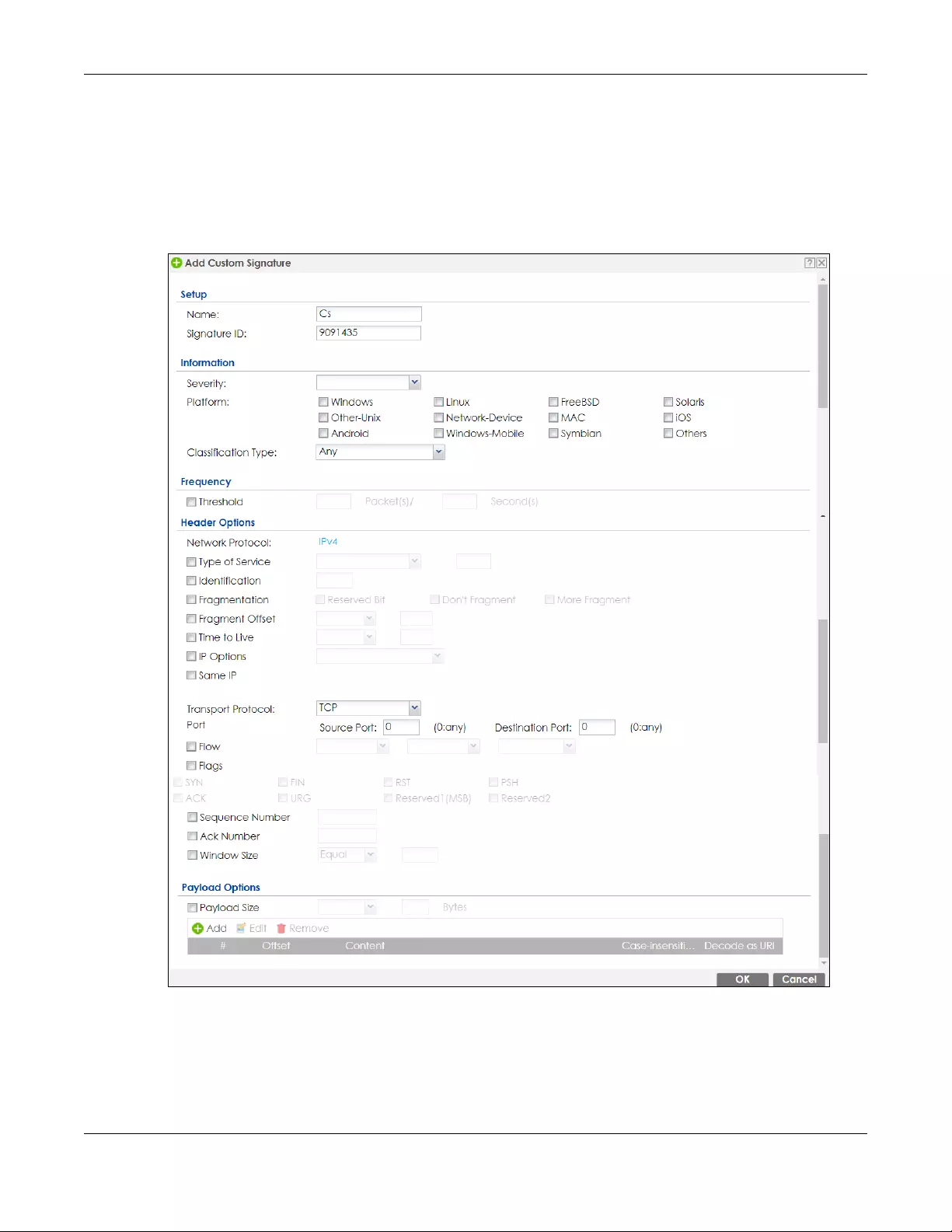
Chapter 35 IDP
ZyWALL USG FLEX Series User’s Guide
659
A packet must match all items you configure in this screen before it matches the signature. The more
specific your signature (including packet contents), then the fewer false positives the signature will
trigger.
Try to write signatures that target a vulnerability, for example a certain type of traffic on certain
operating systems, instead of a specific exploit.
Figure 433 Configuration > Security Service > IDP > Custom Signatures > Add/Edit

Chapter 35 IDP
ZyWALL USG FLEX Series User’s Guide
660
The following table describes the fields in this screen.
Table 270 Configuration > Security Service > IDP > Custom Signatures > Add/Edit
LABEL DESCRIPTION
Name Type the name of this custom signature. You may use 1-31 alphanumeric characters,
underscores(_), or dashes (-), but the first character cannot be a number. This value is
case-sensitive.
Duplicate names can exist but it is advisable to use unique signature names that give
some hint as to intent of the signature and the type of attack it is supposed to prevent.
Refer to (but do not copy) the packet inspection signature names for hints on creating a
naming convention.
Signature ID A signature ID is automatically created when you click the Add icon to create a new
signature. You can edit the ID to create a new one (in the 9000000 to 9999999 range),
but you cannot use one that already exists. You may want to do that if you want to order
custom signatures by SID.
Information Use the following fields to set general information about the signature as denoted below.
Severity The severity level denotes how serious the intrusion is. Categorize the seriousness of the
intrusion here.
Platform Some intrusions target specific operating systems only. Select the operating systems that
the intrusion targets, that is, the operating systems you want to protect from this intrusion.
SGI refers to Silicon Graphics Incorporated, who manufactures multi-user Unix
workstations that run the IRIX operating system (SGI's version of UNIX). A router is an
example of a network device.
Classification Type Categorize the attack type here. See Table 267 on page 654 as a reference.
Frequency Recurring packets of the same type may indicate an attack. Use the following field to
indicate how many packets per how many seconds constitute an intrusion
Threshold Select Threshold and then type how many packets (that meet the criteria in this
signature) per how many seconds constitute an intrusion.
Header Options
Network Protocol Configure signatures for IP version 4.
Type Of Service Type of service in an IP header is used to specify levels of speed and/or reliability. Some
intrusions use an invalid Type Of Service number. Select the check box, then select Equal
or Not-Equal and then type in a number.
Identification The identification field in a datagram uniquely identifies the datagram. If a datagram is
fragmented, it contains a value that identifies the datagram to which the fragment
belongs. Some intrusions use an invalid Identification number. Select the check box and
then type in the invalid number that the intrusion uses.
Fragmentation A fragmentation flag identifies whether the IP datagram should be fragmented, not
fragmented or is a reserved bit. Some intrusions can be identified by this flag. Select the
check box and then select the flag that the intrusion uses.
Fragment Offset When an IP datagram is fragmented, it is reassembled at the final destination. The
fragmentation offset identifies where the fragment belongs in a set of fragments. Some
intrusions use an invalid Fragment Offset number. Select the check box, select Equal,
Smaller or Greater and then type in a number
Time to Live Time to Live is a counter that decrements every time it passes through a router. When it
reaches zero, the datagram is discarded. Usually it’s used to set an upper limit on the
number of routers a datagram can pass through. Some intrusions can be identified by
the number in this field. Select the check box, select Equal, Smaller or Greater and then
type in a number.

Chapter 35 IDP
ZyWALL USG FLEX Series User’s Guide
661
IP Options IP options is a variable-length list of IP options for a datagram that define IP Security
Option, IP Stream Identifier, (security and handling restrictions for the military), Record
Route (have each router record its IP address), Loose Source Routing (specifies a list of IP
addresses that must be traversed by the datagram), Strict Sourc e Routi ng (specifies a list
of IP addresses that must ONLY be traversed by the datagram), Timestamp (have each
router record its IP address and time), End of IP List and No IP Options. IP Options can help
identify some intrusions. Select the check box, then select an item from the list box that
the intrusion uses
Same IP Select the check box for the signature to check for packets that have the same source
and destination IP addresses.
Transport Protocol The following fields vary depending on whether you choose TCP, UDP or ICMP.
Transport Protocol: TCP
Port Select the check box and then enter the source and destination TCP port numbers that
will trigger this signature.
Flow The selected keyword sets the criteria as to which traffic is matched. You can match
traffic based on direction or whether the connection is established or not. You can also
specify whether you want to match signatures per packet or in a stream of packets.
Established: Match established connections.
Stateless: Match packets that are not part of an established connection.
To Client: Match packets that flow from server to client..
To Server: Match packets that flow from client to server.
From Client: Match packets that flow from client to server.
From Servers: Match packets that flow from server to client.
No Stream: Match packets that have not been reassembled by the stream engine. It will
not match packets that have been reassembled.
Only Stream: Match packets that have been reassembled.
Flags Select what TCP flag bits the signature should check.
Sequence Number Use this field to check for a specific TCP sequence number.
Ack Number Use this field to check for a specific TCP acknowledgment number.
Window Size Use this field to check for a specific TCP window size.
Transport Protocol: UDP
Port Select the check box and then enter the source and destination UDP port numbers that
will trigger this signature.
Transport Protocol:
ICMP
Type Use this field to check for a specific ICMP type value.
Code Use this field to check for a specific ICMP code value.
ID Use this field to check for a specific ICMP ID value. This is useful for covert channel
programs that use static ICMP fields when they communicate.
Sequence Number Use this field to check for a specific ICMP sequence number. This is useful for covert
channel programs that use static ICMP fields when they communicate.
Payload Options The longer a payload option is, the more exact the match, the faster the signature
processing. Therefore, if possible, it is recommended to have at least one payload option
in your signature.
Table 270 Configuration > Security Service > IDP > Custom Signatures > Add/Edit (continued)
LABEL DESCRIPTION

Chapter 35 IDP
ZyWALL USG FLEX Series User’s Guide
662
35.3.2 Custom Signature Example
Before creating a custom signature, you must first clearly understand the vulnerability.
Payload Size This field may be used to check for abnormally sized packets or for detecting buffer
overflows.
Select the check box, then select Equal, Smaller or Greater and then type the payload
size.
Stream rebuilt packets are not checked regardless of the size of the payload.
Add Click this to create a new entry.
Edit Select an entry and click this to be able to modify it.
Remove Select an entry and click this to delete it.
#This is the entry’s index number in the list.
Offset This field specifies where to start searching for a pattern within a packet. For example, an
offset of 5 would start looking for the specified pattern after the first five bytes of the
payload.
Content Type the content that the signature should search for in the packet payload.
Hexadecimal code entered between pipes is converted to ASCII. For example, you
could represent the ampersand as either & or |26| (26 is the hexadecimal code for the
ampersand).
Case-insensitive Select Yes if content casing does NOT matter.
Decode as URI A Uniform Resource Identifier (URI) is a string of characters for identifying an abstract or
physical resource (RFC 2396). A resource can be anything that has identity, for example,
an electronic document, an image, a service (“today's weather report for Taiwan”), a
collection of other resources. An identifier is an object that can act as a reference to
something that has identity. Example URIs are:
ftp://ftp.is.co.za/rfc/rfc1808.txt; ftp scheme for File Transfer Protocol services
http://www.math.uio.no/faq/compression-faq/part1.html; http scheme for Hypertext
Transfer Protocol services
mailto:mduerst@ifi.unizh.ch; mailto scheme for electronic mail addresses
telnet://melvyl.ucop.edu/; telnet scheme for interactive services via the TELNET Protocol
Select Yes for the signature to search for normalized URI fields. This means that if you are
writing signatures that includes normalized content, such as %2 for directory traversals,
these signatures will not be triggered because the content is normalized out of the URI
buffer.
For example, the URI:
/scripts/..%c0%af../winnt/system32/cmd.exe?/c+ver
will get normalized into:
/winnt/system32/cmd.exe?/c+ver
OK Click this button to save your changes to the Zyxel Device and return to the summary
screen.
Cancel Click this button to return to the summary screen without saving any changes.
Table 270 Configuration > Security Service > IDP > Custom Signatures > Add/Edit (continued)
LABEL DESCRIPTION
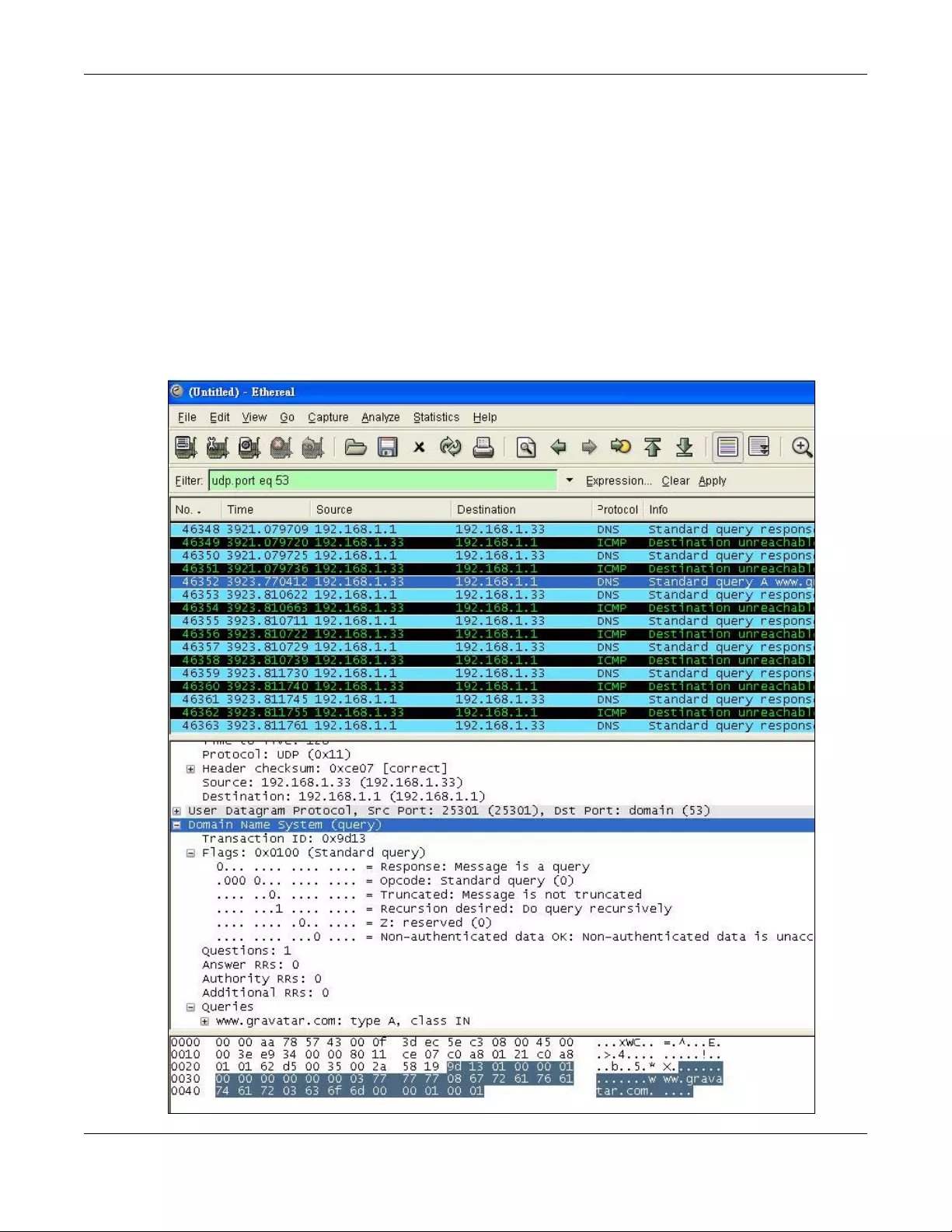
Chapter 35 IDP
ZyWALL USG FLEX Series User’s Guide
663
35.3.2.1 Understand the Vulnerability
Check the Zyxel Device logs when the attack occurs. Use web sites such as Google or Security Focus to
get as much information about the attack as you can. The more specific your signature, the less chance
it will cause false positives.
As an example, say you want to check if your router is being overloaded with DNS queries so you create
a signature to detect DNS query traffic.
35.3.2.2 Analyze Packets
Use the packet capture screen and a packet analyzer (also known as a network or protocol analyzer)
such as Wireshark or Ethereal to investigate some more.
Figure 434 DNS Query Packet Details
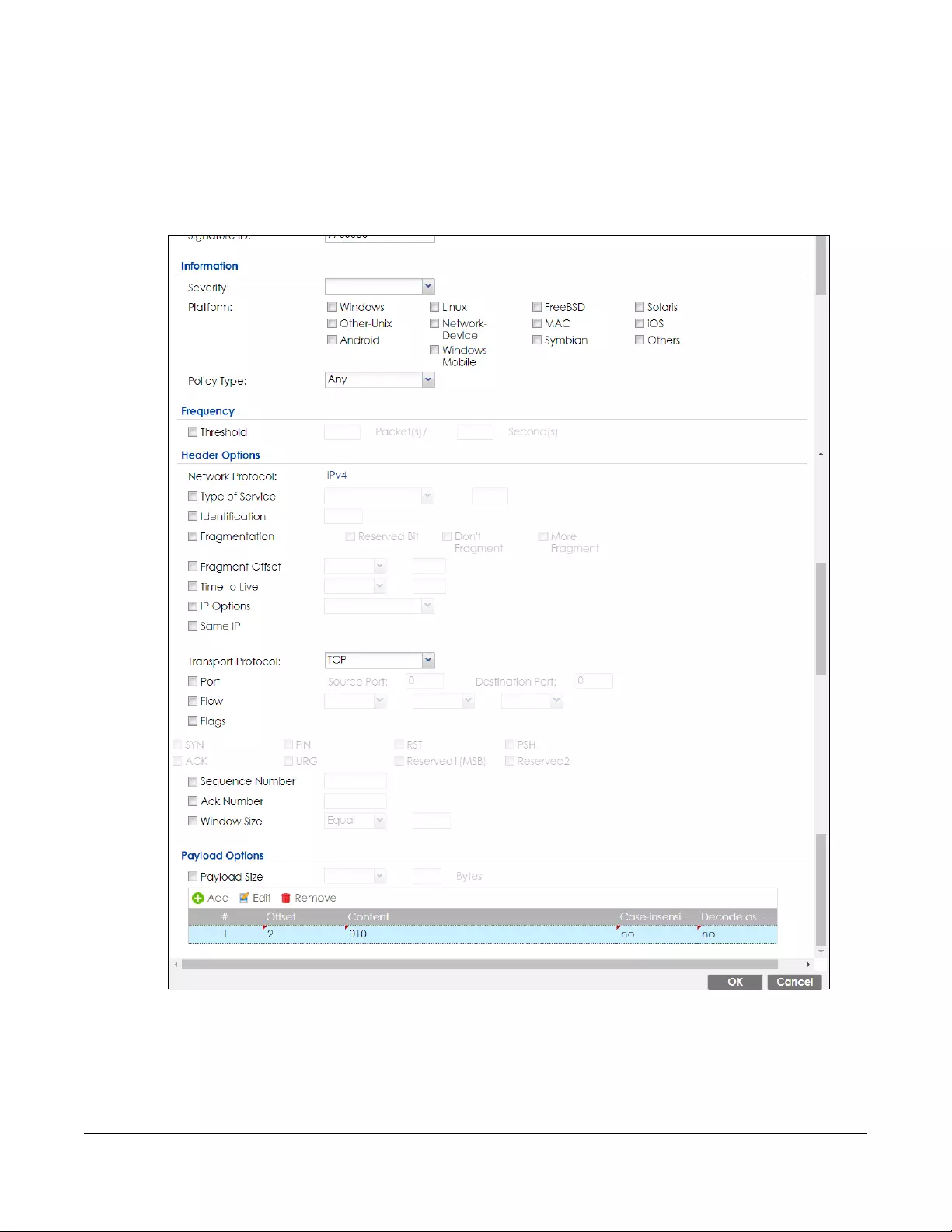
Chapter 35 IDP
ZyWALL USG FLEX Series User’s Guide
664
From the details about DNS query you see that the protocol is UDP and the port is 53. The type of DNS
packet is standard query and the Flag is 0x0100 with an offset of 2. Therefore enter |010| as the first
pattern.
The final custom signature should look like as shown in the following figure.
Figure 435 Example Custom Signature
35.3.3 Applying Custom Signatures
After you create your custom signature, it becomes available in an IDP profile (Configuration > Security
Service > IDP > Profile > Edit screen). Custom signatures have an SID from 9000000 to 9999999.

Chapter 35 IDP
ZyWALL USG FLEX Series User’s Guide
665
Search for, then activate the signature, configure what action to take when a packet matches it and if
it should generate a log or alert in a profile. Then bind the profile to a zone.
35.3.4 Verifying Custom Signatures
Configure the signature to create a log when traffic matches the signature. (You may also want to
configure an alert if it is for a serious attack and needs immediate attention.) After you apply the
signature to a zone, you can see if it works by checking the logs (Monitor > Log).
The Priority column shows warn for signatures that are configured to generate a log only. It shows critical
for signatures that are configured to generate a log and alert. All IDP signatures come under the IDP
category. The Note column displays ACCESS FORWARD when no action is configured for the signature. It
displays ACCESS DENIED if you configure the signature action to drop the packet. The destination port is
the service port (53 for DNS in this case) that the attack tries to exploit.
Figure 436 Custom Signature Log
35.4 The White List Screen
Use this screen to list signatures that will be exempted from IDP inspection. The Zyxel Device will exclude
incoming packets with the listed signature(s) from being intercepted and inspected.
Click Config uration > Security Service > IDP > W hite List to display the following screen. Use Add to put a
new item in the list or Edit to change an existing one or Remove to delete an existing entry.
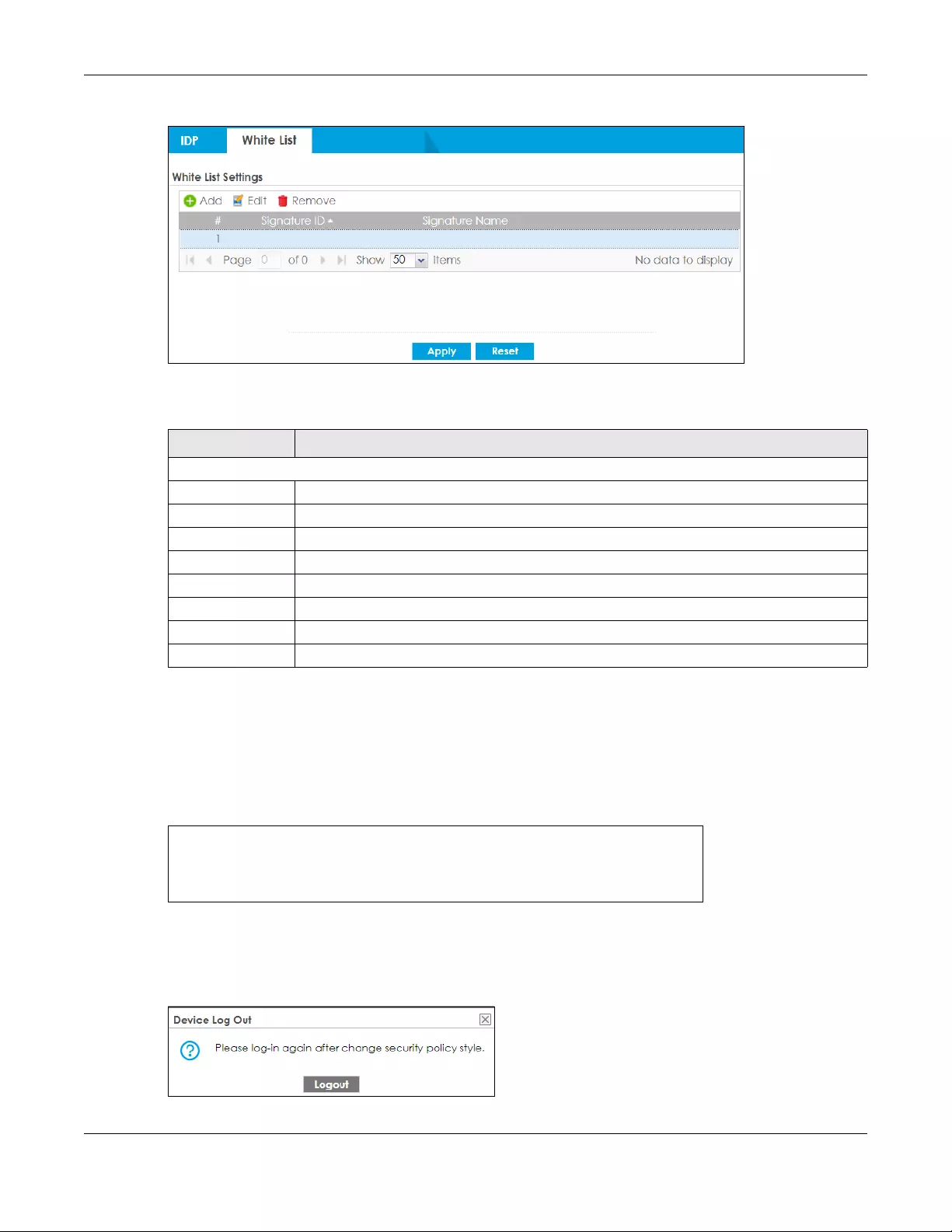
Chapter 35 IDP
ZyWALL USG FLEX Series User’s Guide
666
Figure 437 Configuration > Security Service > IDP > White List
The following table describes the fields in this screen.
35.5 IDP Profile
To use multiple profiles for this feature, run the following commands in the Zyxel Device Command Line
Interface (CLI).
After you run these command, go to the feature screen again in the web configurator. You will be
prompted to log out and then log in again.
Figure 438 Logout Prompt
Table 271 Configuration > Security Service > IDP > White List
LABEL DESCRIPTION
White List Settings
Add Click this to create a new entry.
Edit Select an entry and click this to be able to modify it.
Remove Select an entry and click this to delete it.
#This is the entry’s index number in the list.
Signature ID This field displays the signature ID of this entry.
Signature Name This field displays the signature name of this entry.
Apply Click Apply to save your changes back to the Zyxel Device.
Reset Click Reset to return the screen to its last-saved settings.
Router# configure terminal
Router(config)# secure-policy-style advance
Router(config)# show secure-policy-style status
secure-policy-style: advance

Chapter 35 IDP
ZyWALL USG FLEX Series User’s Guide
667
After you log in again, you will see the new profile screen for this feature.
Figure 439 Configuration > Security Service > IDP> Profile
The following table describes the labels in this screen.
35.5.1 Add or Edit an IDP Profile
Click Add to create a new entry or select an existing entry and click Edit to open the following screen
where you can create or modify the entry’s settings.
Table 272 Configuration > Security Service > IDP > Profile
LABEL DESCRIPTION
Add Click this to create a new entry. Select an entry and click Add to create a new entry after the
selected entry.
Edit Double-click an entry or select it and click Edit to open a screen where you can modify the
entry’s settings.
Remove Select an entry and click Remove to delete the selected entry.
#This field is a sequential value showing the number of the profile. The profile order is not
important.
Name This displays the name of the profile created.
Description This displays the description of the profile.
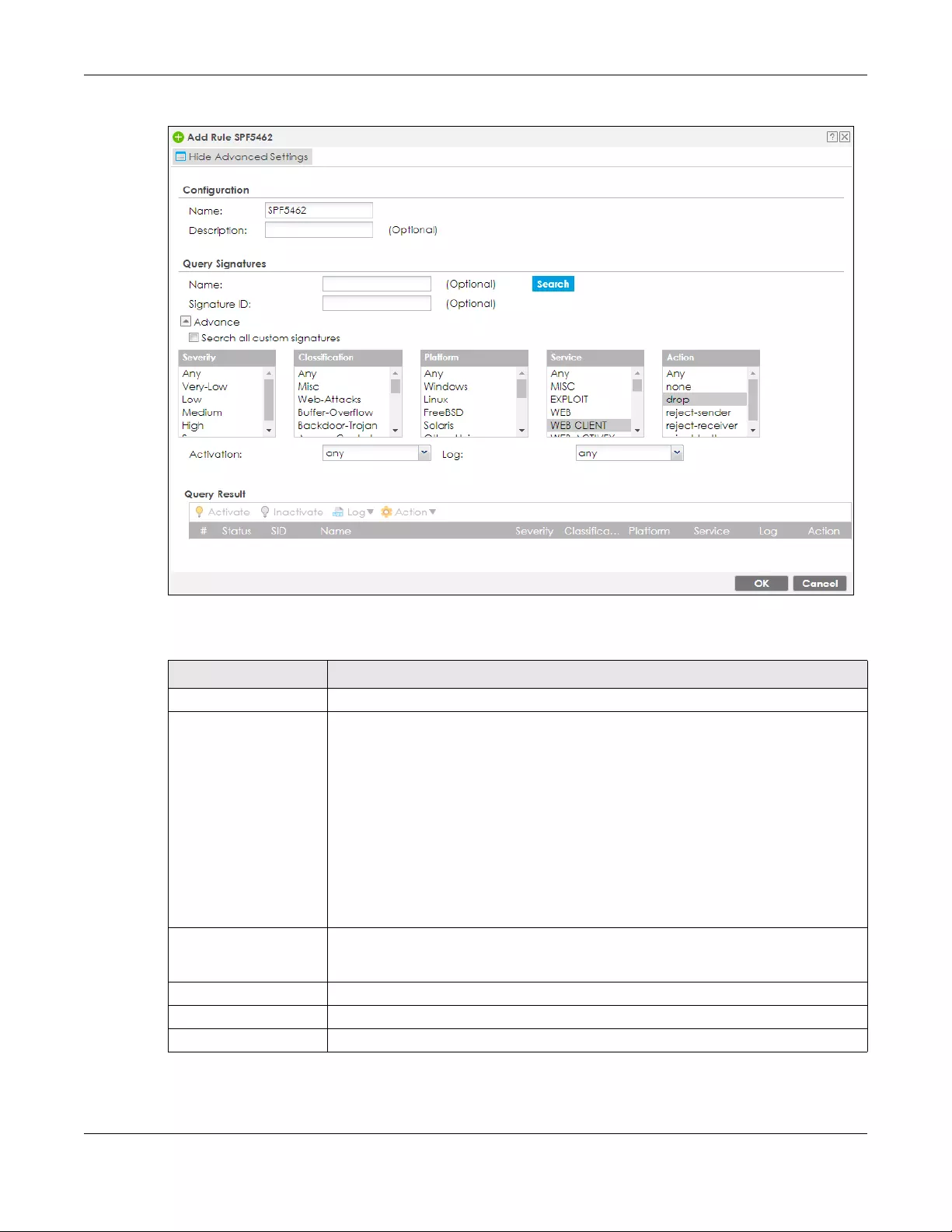
Chapter 35 IDP
ZyWALL USG FLEX Series User’s Guide
668
Figure 440 Configuration > Security Service > IDP > Profile > Add/Edit
The following table describes the labels in this screen.
Table 273 Configuration > Security Service > IDP
LABEL DESCRIPTION
Configuration
Profile Name Type the name of the profile. You may use 1-31 alphanumeric characters,
underscores(_), or dashes (-), but the first character cannot be a number. This value is
case-sensitive. These are valid, unique profile names:
•MyProfile
• mYProfile
• Mymy12_3-4
These are invalid profile names:
• 1mYProfile
•My Profile
• MyProfile?
• Whatalongprofilename123456789012
Description Type a description for the profile rule to help identify the purpose of rule. You may use 1-
31 alphanumeric characters, underscores (_), or dashes (-), but the first character
cannot be a number. This value is case-sensitive. This field is optional.
Query Signatures
Name Type the name or part of the name of the signature(s) you want to find.
Signature ID Type the ID or part of the ID of the signature(s) you want to find.

Chapter 35 IDP
ZyWALL USG FLEX Series User’s Guide
669
35.5.2 Link a Profile
To link a profile to a policy, go to the Configuration > Security Policy > Policy Control screen, select a pol-
icy, and then click Edit. In the Edit Policy screen under Profile, select which profile you want to use for
each security service.
Search all custom
signatures Select this check box to include signatures you created or imported in the Custom
Signatures screen in the search. You can search for specific signatures by name or ID. If
the name and ID fields are left blank, then all signatures are searched according to the
criteria you select.
Severity Search for signatures by severity level(s). Hold down the [Ctrl] key if you want to make
multiple selections.
These are the severities as defined in the Zyxel Device. The number in brackets is the
number you use if using commands.
Severe (5): These denote attacks that try to run arbitrary code or gain system privileges.
High (4): These denote known serious vulnerabilities or attacks that are probably not
false alarms.
Medium (3): These denote medium threats, access control attacks or attacks that could
be false alarms.
Low (2): These denote mild threats or attacks that could be false alarms.
Very-Low (1): These denote possible attacks caused by traffic such as Ping, trace route,
ICMP queries etc.
Classification Type Search for signatures by attack type(s) (see Table 267 on page 654). Attack types are
known as policy types in the group view screen. Hold down the [Ctrl] key if you want to
make multiple selections.
Platform Search for signatures created to prevent intrusions targeting specific operating
system(s). Hold down the [Ctrl] key if you want to make multiple selections.
Service Search for signatures by IDP service group(s). See Table 267 on page 654 for group
details. Hold down the [Ctrl] key if you want to make multiple selections.
Action Search for signatures by the response the Zyxel Device takes when a packet matches a
signature.Hold down the [Ctrl] key if you want to make multiple selections.
Activation Search for activated and/or inactivated signatures here.
Log Search for signatures by log option here.
Query Result The results are displayed in a table showing the SID, Name, Severity, Classification Type,
Platform, Service, Log, and Action criteria as selected in the search. Click the SID column
header to sort search results by signature ID.
OK Click OK to save your changes back to the Zyxel Device.
Cancel Click Cancel to exit this screen without saving.
Table 273 Configuration > Security Service > IDP (continued)
LABEL DESCRIPTION
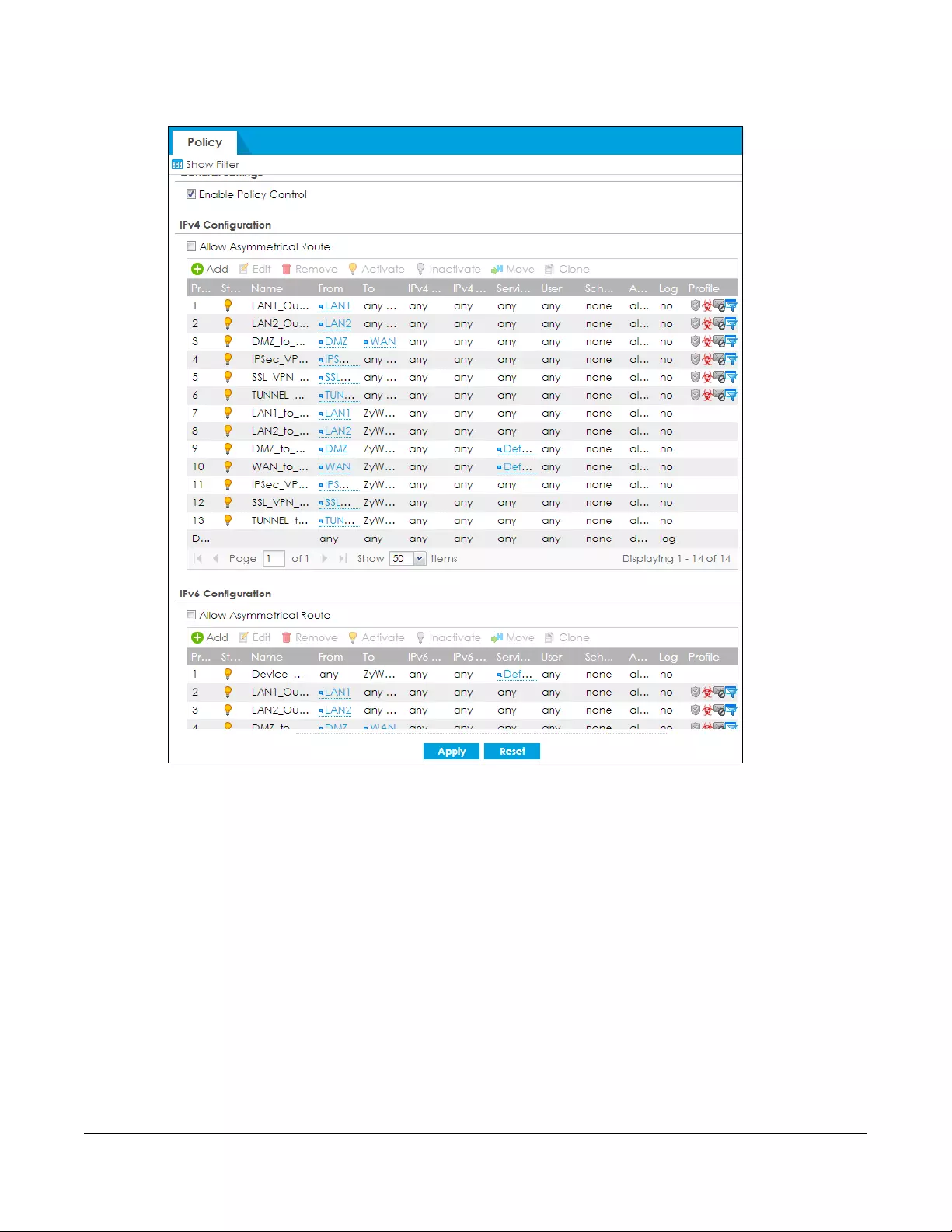
Chapter 35 IDP
ZyWALL USG FLEX Series User’s Guide
670
Figure 441 Configuration > Security Service > Policy Control > Profile
35.5.3 The IDP Advance Screen
The Configuration > Security Service > IDP screen changes when using profiles.
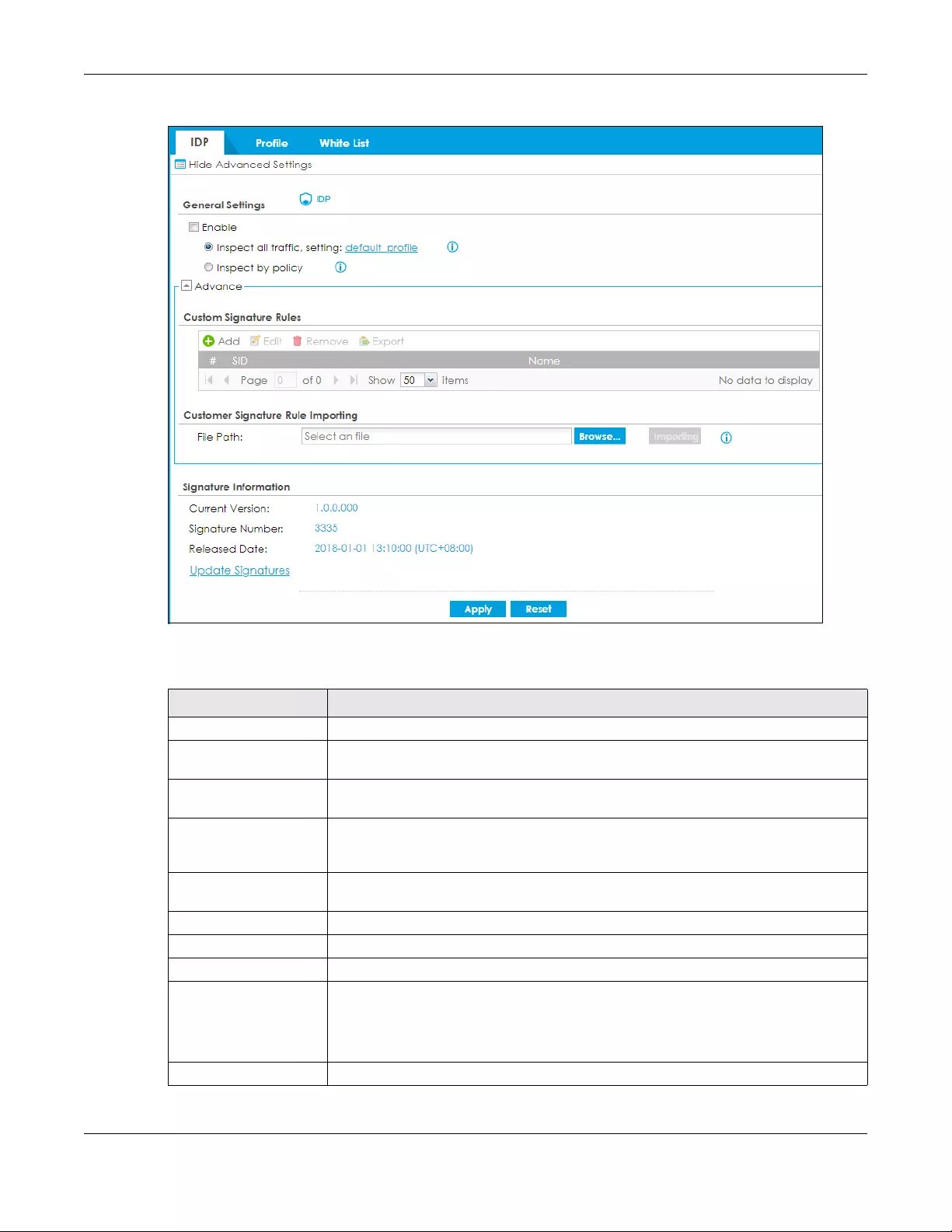
Chapter 35 IDP
ZyWALL USG FLEX Series User’s Guide
671
Figure 442 Configuration > Security Service > IDP Advance
The following table describes the fields in this screen.
Table 274 Configuration > Security Service > IDP Advance
LABEL DESCRIPTION
General Settings
Enable Select this check box to activate the IDP feature which detects and prevents malicious
or suspicious packets and responds instantaneously.
Inspect all traffic,
setting:
Select this to have all traffic inspected by the default_profile. You cannot rename or
delete the default_profile profile, but you can edit it by clicking the link here.
Inspect by policy If you configured a specific profile in the Profile tab for this service, select this to have
specific traffic inspected by that profile. You must bind the profile to a policy in Security
Policy > Policy Control.
Custom Signature Rules Use this part of the screen to create, edit, delete or export (save to your computer)
custom signatures.
Add Click this to create a new entry.
Edit Select an entry and click this to be able to modify it.
Remove Select an entry and click this to delete it.
Export To save an entry or entries as a file on your computer, select them and click Export. Click
Save in the file download dialog box and then select a location and name for the file.
Custom signatures must end with the ‘rules’ file name extension, for example,
MySig.rules.
#This is the entry’s index number in the list.

Chapter 35 IDP
ZyWALL USG FLEX Series User’s Guide
672
35.5.4 Remove Profiles
To remove profiles and revert to the default general security policy style, you must first make sure to
change Inspect by policy to Inspect all traffic in the following security services: Anti-Malware, DNS Filter,
URL Threat Filter, IDP, Email Security.
Note: All profiles that you created will be removed from Security Policy > Policy Control.
Run the following commands in the Zyxel Device Command Line Interface (CLI).
Wait a minute and then go to the feature screen again in the web configurator. You will be prompted
to log out and then log in again.
SID SID is the signature ID that uniquely identifies a signature. Click the SID header to sort
signatures in ascending or descending order. It is automatically created when you click
the Add icon to create a new signature. You can edit the ID, but it cannot already exist
and it must be in the 9000000 to 9999999 range.
Name This is the name of your custom signature. Duplicate names can exist, but it is advisable
to use unique signature names that give some hint as to intent of the signature and the
type of attack it is supposed to prevent.
Customer Signature Rule
Importing
Use this part of the screen to import custom signatures (previously saved to your
computer) to the Zyxel Device.
Note: The name of the complete custom signature file on the Zyxel Device is
‘custom.rules’. If you import a file named ‘custom.rules’, then all custom
signatures on the Zyxel Device are overwritten with the new file. If this is
not your intention, make sure that the files you import are not named
‘custom.rules’.
File Path Type the file path and name of the custom signature file you want to import in the text
box (or click Browse to find it on your computer) and then click Importing to transfer the
file to the Zyxel Device.
New signatures then display in the Zyxel Device IDP > Custom Signatures screen.
Signature Information The following fields display information on the current signature set that the Zyxel Device
is using.
Current Version This field displays the IDP signature set version number. This number gets larger as the set
is enhanced.
Signature Number This field displays the number of IDP signatures in this set. This number usually gets larger
as the set is enhanced. Older signatures and rules may be removed if they are no longer
applicable or have been supplanted by newer ones.
Released Date This field displays the date and time the set was released.
Update Signatures Click this link to go to the screen you can use to download signatures from the update
server.
Apply Click Apply to save your changes back to the Zyxel Device.
Reset Click Reset to return the screen to its last-saved settings.
Table 274 Configuration > Security Service > IDP Advance (continued)
LABEL DESCRIPTION
Router# configure terminal
Router(config)# secure-policy-style general
Router(config)# show secure-policy-style status
secure-policy-style: general
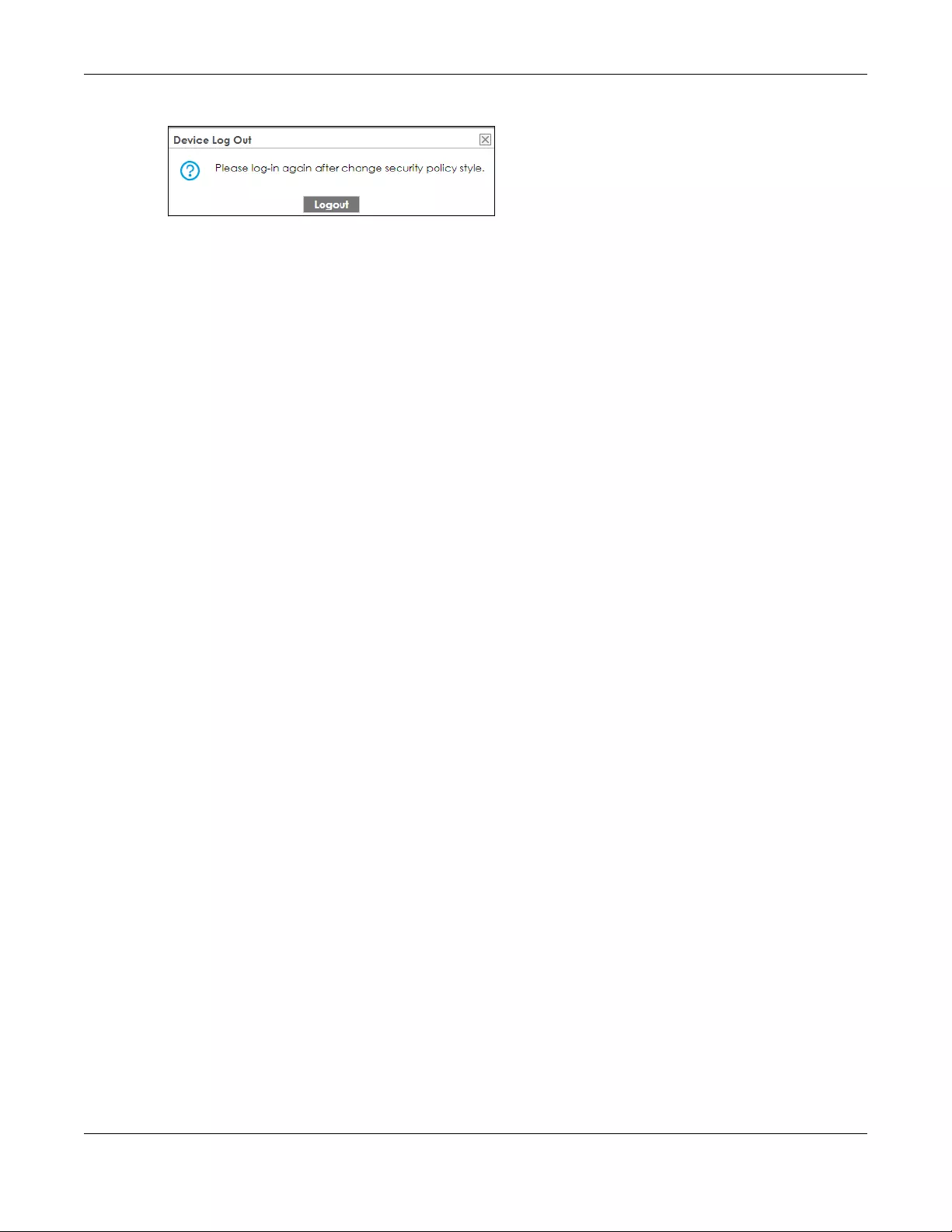
Chapter 35 IDP
ZyWALL USG FLEX Series User’s Guide
673
Figure 443 Logout Prompt
After you log in again, you will not see the profile screen for this feature.
35.6 IDP Technical Reference
This section contains some background information on IDP.
Host Intrusions
The goal of host-based intrusions is to infiltrate files on an individual computer or server in with the goal of
accessing confidential information or destroying information on a computer.
You must install a host IDP directly on the system being protected. It works closely with the operating
system, monitoring and intercepting system calls to the kernel or APIs in order to prevent attacks as well
as log them.
Disadvantages of host IDPs are that you have to install them on each device (that you want to protect)
in your network and due to the necessarily tight integration with the host operating system, future
operating system upgrades could cause problems.
Network Intrusions
Network-based intrusions have the goal of bringing down a network or networks by attacking
computer(s), switch(es), router(s) or modem(s). If a LAN switch is compromised for example, then the
whole LAN is compromised. Host-based intrusions may be used to cause network-based intrusions when
the goal of the host virus is to propagate attacks on the network, or attack computer/server operating
system vulnerabilities with the goal of bringing down the computer/server. Typical “network-based
intrusions” are SQL slammer, Blaster, Nimda MyDoom etc.
Snort Signatures
You may want to refer to open source Snort signatures when creating custom Zyxel Device ones. Most
Snort rules are written in a single line. Snort rules are divided into two logical sections, the rule header
and the rule options as shown in the following example:
alert tcp any any -> 192.168.1.0/24 111 (content:”|00 01 a5|”; msg:”mountd access”;)
The text up to the first parenthesis is the rule header and the section enclosed in parenthesis contains the
rule options. The words before the colons in the rule options section are the option keywords.
The rule header contains the rule's:
•Action
•Protocol

Chapter 35 IDP
ZyWALL USG FLEX Series User’s Guide
674
• Source and destination IP addresses and netmasks
• Source and destination ports information.
The rule option section contains alert messages and information on which parts of the packet should be
inspected to determine if the rule action should be taken.
These are some equivalent Snort terms in the Zyxel Device.
Note: Not all Snort functionality is supported in the Zyxel Device.
Table 275 Zyxel Device - Snort Equivalent Terms
ZYXEL DEVICE TERM SNORT EQUIVALENT TERM
Type Of Service tos
Identification id
Fragmentation fragbits
Fragmentation Offset fragoffset
Time to Live ttl
IP Options ipopts
Same IP sameip
Transport Protocol
Transport Protocol: TCP
Port (In Snort rule header)
Flow flow
Flags flags
Sequence Number seq
Ack Number ack
Window Size window
Transport Protocol: UDP (In Snort rule header)
Port (In Snort rule header)
Transport Protocol: ICMP
Type itype
Code icode
ID icmp_id
Sequence Number icmp_seq
Payload Options (Snort rule options)
Payload Size dsize
Offset (relative to start of payload) offset
Relative to end of last match distance
Content content
Case-insensitive nocase
Decode as URI uricontent

ZyWALL USG FLEX Series User’s Guide
675
CHAPTER 36
Email Security
36.1 Overview
The email security feature can mark or discard spam (unsolicited commercial or junk email). Use the
white list to identify legitimate email. Use the black list to identify spam email. The Zyxel Device can also
check email against a DNS black list (DNSBL) of IP addresses of servers that are suspected of being used
by spammers.
36.1.1 What You Can Do in this Chapter
• Use the Email Security screens (Section 36.3 on page 677) to turn email security on or off and manage
email security policies. Also, you can enable and configure the mail scan functions and have the
Zyxel Device check email against DNS Black Lists.
• Use the Black/White List screens (Section 36.4 on page 679) to set up a black list to identify spam and
a white list to identify legitimate email.
36.1.2 What You Need to Know
White List
Configure white list entries to identify legitimate email. The white list entries have the Zyxel Device classify
any email that is from a specified sender or uses a specified header field and header value as being
legitimate (see Email Headers for more on mail headers). The email security feature checks an email
against the white list entries before doing any other email security checking. If the email matches a
white list entry, the Zyxel Device classifies the email as legitimate and does not perform any more email
security checking on that individual email. A properly configured white list helps keep important email
from being incorrectly classified as spam. The white list can also increases the Zyxel Device’s email
security speed and efficiency by not having the Zyxel Device perform the full email security checking
process on legitimate email.
Black List
Configure black list entries to identify spam. The black list entries have the Zyxel Device classify any email
that is from or forwarded by a specified IP address or uses a specified header field and header value as
being spam. If an email does not match any of the white list entries, the Zyxel Device checks it against
the black list entries. The Zyxel Device classifies an email that matches a black list entry as spam and
immediately takes the configured action for dealing with spam. If an email matches a blacklist entry,
the Zyxel Device does not perform any more email security checking on that individual email. A properly
configured black list helps catch spam email and increases the Zyxel Device’s email security speed and
efficiency.

Chapter 36 Email Security
ZyWALL USG FLEX Series User’s Guide
676
SMTP and POP3
Simple Mail Transfer Protocol (SMTP) is the Internet’s message transport standard. It controls the sending
of email messages between servers. Email clients (also called email applications) then use mail server
protocols such as POP (Post Office Protocol) or IMAP (Internet Message Access Protocol) to retrieve
email. Email clients also generally use SMTP to send messages to a mail server. The older POP2 requires
SMTP for sending messages while the newer POP3 can be used with or without it. This is why many email
applications require you to specify both the SMTP server and the POP or IMAP server (even though they
may actually be the same server).
The Zyxel Device’s email security feature checks SMTP (TCP port 25) and POP3 (TCP port 110) emails by
default. You can also specify custom SMTP and POP3 ports for the Zyxel Device to check.
Email Headers
Every email has a header and a body. The header is structured into fields and includes the addresses of
the recipient and sender, the subject, and other information about the email and its journey. The body is
the actual message text and any attachments. You can have the Zyxel Device check for specific
header fields with specific values.
Email programs usually only show you the To:, From:, Subject:, and Date: header fields but there are
others such as Received: and Content-Type:. To see all of an email’s header, you can select an email in
your email program and look at its properties or details. For example, in Microsoft’s Outlook Express,
select a mail and click File > Properties > Details . This displays the email’s header. Click Message Source
to see the source for the entire mail including both the header and the body.
Email Header Buffer Size
The Zyxel Device has a 5 K buffer for an individual email header. If an email’s header is longer than 5 K,
the Zyxel Device only checks up to the first 5 K.
DNSBL
A DNS Black List (DNSBL) is a server that hosts a list of IP addresses known or suspected of having sent or
forwarded spam. A DNSBL is also known as a DNS spam blocking list. The Zyxel Device can check the
routing addresses of email against DNSBLs and classify an email as spam if it was sent or forwarded by a
computer with an IP address in the DNSBL.
Finding Out More
See Section 36.6 on page 689 for more background information on email security.
36.2 Before You Begin
• Before using the email security features (IP Reputation, Mail Content Analysis and Virus Outbreak
Detection) you must activate your email security Service license.
• Configure your zones before you configure email security.
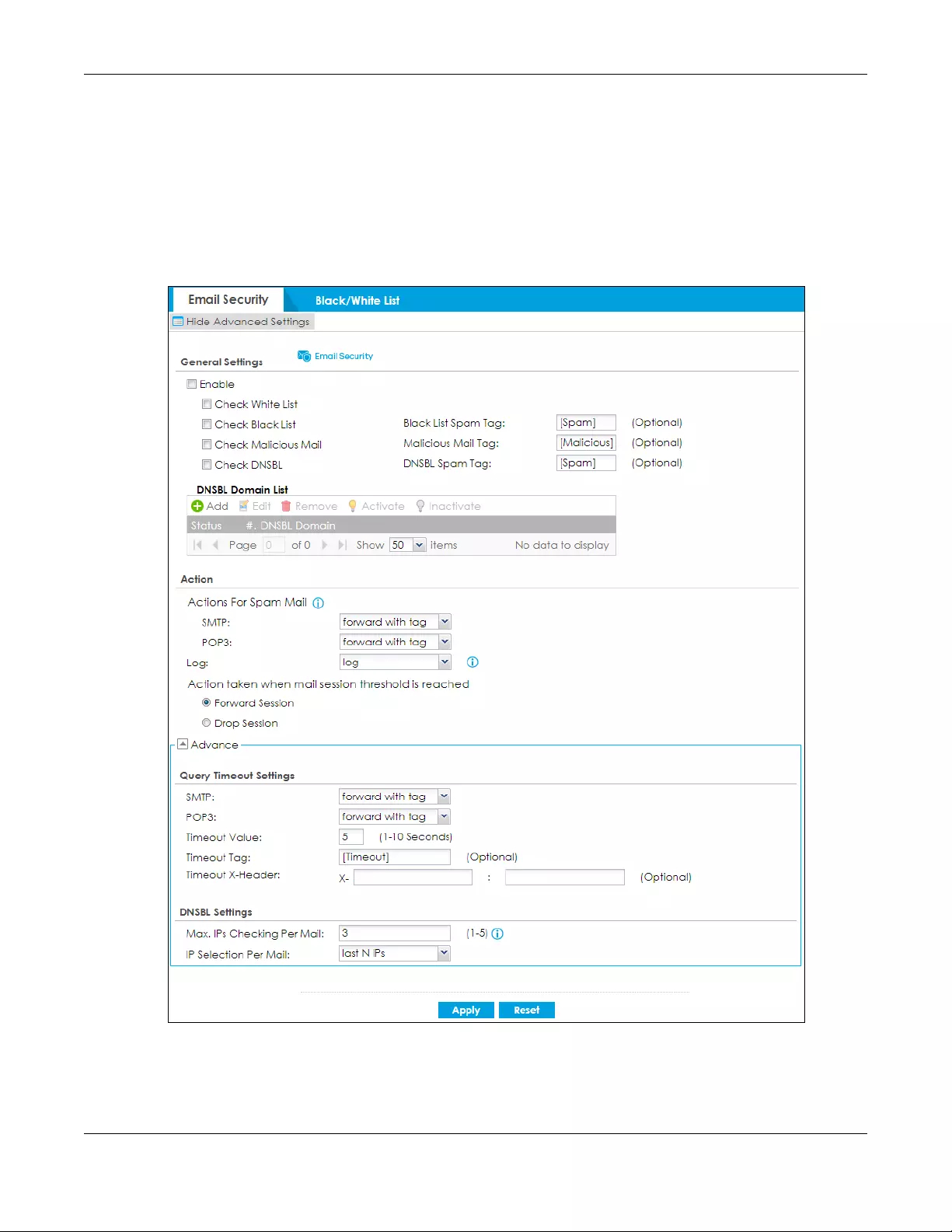
Chapter 36 Email Security
ZyWALL USG FLEX Series User’s Guide
677
36.3 The Email Security Screen
Click Configuration > Security Service > Email Security to open the Email Security screen. Use this screen
to turn the email security feature on or off and manage email security policies. You can also select the
action the Zyxel Device takes when the mail sessions threshold is reached.
Click the Email Security icon for more information on the Zyxel Device’s security features.
Figure 444 Configuration > Security Service > Email Security

Chapter 36 Email Security
ZyWALL USG FLEX Series User’s Guide
678
The following table describes the labels in this screen.
Table 276 Configuration > Security Service > Email Security
LABEL DESCRIPTION
General Settings
Enable Select this check box to activate the settings in this section.
Check White List Select this check box to check email against the white list. The Zyxel Device classifies email
that matches a white list entry as legitimate (not spam).
Check Black List Select this check box to check email against the black list. The Zyxel Device classifies email
that matches a black list entry as spam.
Black List Spam Tag Enter a message or label (up to 15 ASCII characters) to add to the mail subject of emails that
match the Zyxel Device’s spam black list.
Check Malicious Mail Select this to identify spam email by content, such as malicious content.
Malicious Mail Tag Enter a message or label (up to 15 ASCII characters) to add to the beginning of the mail
subject of emails that are determined to spam based on the mail content analysis.
This tag is only added if the email security policy is configured to forward spam mail with a
spam tag.
Check DNSBL Select this check box to check email against the Zyxel Device’s configured DNSBL domains.
The Zyxel Device classifies email that matches a DNS black list as spam.
DNSBL Spam Tag Enter a message or label (up to 15 ASCII characters) to add to the beginning of the mail
subject of emails that have a sender or relay IP address in the header that matches a black
list maintained by one of the DNSBL domains listed in the Zyxel Device.
This tag is only added if the email security policy is configured to forward spam mail with a
spam tag.
DNSBL Domain List
Add Click this to create a new entry.
Edit Select an entry and click this to be able to modify it.
Remove Select an entry and click this to delete it.
Activate To turn on an entry, select it and click Activate.
Inactivate To turn off an entry, select it and click Inactivate.
Status The activate (light bulb) icon is lit when the entry is active and dimmed when the entry is
inactive.
#This is the entry’s index number in the list.
DNSBL Domain This is the name of a domain that maintains DNSBL servers. Enter the domain that is
maintaining a DNSBL.
Actions for Spam Mail Use this section to set how the Zyxel Device is to handle spam mail.
SMTP Select how the Zyxel Device is to handle spam SMTP mail.
Select drop to discard spam SMTP mail.
Select forward to allow spam SMTP mail to go through.
Select forward with tag to add a spam tag to an SMTP spam mail’s mail subject and send it
on to the destination.
POP3 Select how the Zyxel Device is to handle spam POP3 mail.
Select forward to allow spam POP3 mail to go through.
Select forward with tag to add a spam tag to an POP3 spam mail’s mail subject and send it
on to the destination.
Log Select whether to have the ZyXEL device generate a log (log), log and alert (log alert) or
neither (no) by default when traffic matches a signature in this category.

Chapter 36 Email Security
ZyWALL USG FLEX Series User’s Guide
679
36.4 The Black List / White List Screen
Click Configuration > Security Se rvice > Email Security > Black /White List to display the Black List / White
List screen.
Configure the black list to identify spam email. You can create black list entries based on the sender’s or
relay server’s IP address or email address. You can also create entries that check for particular email
header fields with specific values or specific subject text. Click a column’s heading cell to sort the table
entries by that column’s criteria. Click the heading cell again to reverse the sort order.
Action taken when mail
sessions threshold is
reached
An email session is when an email client and email server (or two email servers) connect
through the Zyxel Device. Select how to handle concurrent email sessions that exceed the
maximum number of concurrent email sessions that the email security feature can handle.
See the chapter of product specifications for the threshold.
Select Forward Session to have the Zyxel Device allow the excess email sessions without any
spam filtering.
Select Drop Session to have the Zyxel Device drop mail connections to stop the excess email
sessions. The email client or server will have to re-attempt to send or receive email later when
the number of email sessions is under the threshold.
Query Timeout Settings
SMTP Select how the Zyxel Device is to handle SMTP mail query timeout.
Select drop to discard SMTP mail.
Select forward to allow SMTP mail to go through.
Select forward with tag to add a tag to an SMTP query timeout mail’s mail subject and send it
on to the destination.
POP3 Select how the Zyxel Device is to handle POP3 mail query timeout.
Select forward to allow POP3 mail to go through.
Select forward with tag to add a tag to an POP3 query timeout mail’s mail subject and send it
on to the destination.
Timeout Value Set how long the Zyxel Device waits for a reply from the mail scan server. If there is no reply
before this time period expires, the Zyxel Device takes the action defined in the relevant
Actions when Query Timeout field.
Timeout Tag Enter a message or label (up to 15 ASCII characters) to add to the mail subject of emails that
the Zyxel Device forwards if queries to the mail scan servers time out.
Timeout X-Header Specify the name and value for the X-Header to be added when queries to the mail scan
servers time out.
DNSBL Settings
Max. IPs Checking Per
Mail
Set the maximum number of sender and relay server IP addresses in the mail header to check
against the DNSBL domain servers.
IP Selection Per Mail Select first N IPs to have the Zyxel Device start checking from the first IP address in the mail
header. This is the IP of the sender or the first server that forwarded the mail.
Select last N IPs to have the Zyxel Device start checking from the last IP address in the mail
header. This is the IP of the last server that forwarded the mail.
Apply Click Apply to save your changes back to the Zyxel Device.
Reset Click Reset to return the screen to its last-saved settings.
Table 276 Configuration > Security Service > Email Security
LABEL DESCRIPTION

Chapter 36 Email Security
ZyWALL USG FLEX Series User’s Guide
680
Figure 445 Configuration > Security Service > Email Security > Black/White List
The following table describes the labels in this screen.
36.4.1 The Black or White List Add/Edit Screen
In the Black List or White List screen, click the Add icon or an Edit icon to display the following screen.
Use this screen to configure an email security black list entry to identify spam email. You can create
entries based on specific subject text, or the sender’s or relay’s IP address or email address. You can also
create entries that check for particular header fields and values.
Table 277 Configuration > Security Service > Email Security > Black/White List
LABEL DESCRIPTION
Rule Summary
Add Click this to create a new entry.
Edit Select an entry and click this to be able to modify it.
Remove Select an entry and click this to delete it.
Activate To turn on an entry, select it and click Activate.
Inactivate To turn off an entry, select it and click Inactivate.
Status The activate (light bulb) icon is lit when the entry is active and dimmed when the entry is
inactive.
#This is the entry’s index number in the list.
Type This field displays whether the entry is based on the email’s subject, source or relay IP
address, source email address, or header.
Content This field displays the subject content, source or relay IP address, source email address, or
header value for which the entry checks.
Apply Click Apply to save your changes back to the Zyxel Device.
Reset Click Reset to return the screen to its last-saved settings.
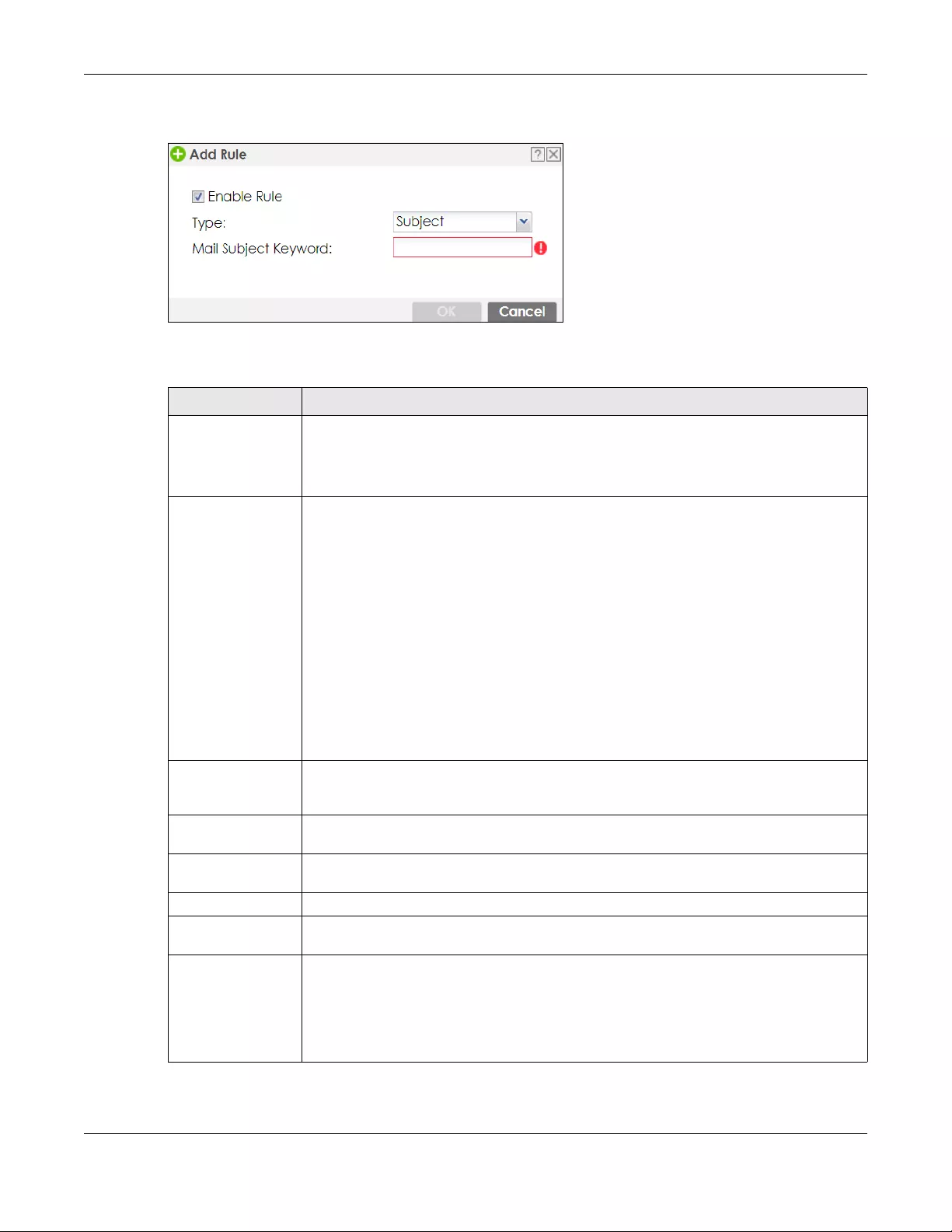
Chapter 36 Email Security
ZyWALL USG FLEX Series User’s Guide
681
Figure 446 Configuration > Security Service > Email Security > Black/White List > Black List (or White List) >
Add
The following table describes the labels in this screen.
Table 278 Configuration > Security Service > Email Security > Black/White List > Black/White List > Add
LABEL DESCRIPTION
Enable Rule Select this to have the Zyxel Device use this entry as part of the black or white list.
To actually use the entry, you must also turn on the use of the list in the corresponding list
screen, enable the email security feature in the email security general screen, and configure
an email security policy to use the list.
Type Use this field to base the entry on the email’s subject, source or relay IP address, source email
address, or header.
Select Subject to have the Zyxel Device check email for specific content in the subject line.
Select IP Address to have the Zyxel Device check email for a specific source or relay IP
address.
Select IPv6 Address to have the Zyxel Device check email for a specific source or relay IPv6
address.
Select E-Mail Address to have the Zyxel Device check email for a specific source email
address or domain name.
Select Mail Header to have the Zyxel Device check email for specific header fields and
values. Configure black list header entries to check for email from bulk mail programs or with
content commonly used in spam. Configure white list header entries to allow certain header
values that identify the email as being from a trusted source.
Mail Subject
Keyword
This field displays when you select the Subject type. Enter up to 63 ASCII characters of text to
check for in email headers. Spaces are not allowed, although you could substitute a
question mark (?). See Section 36.4.2 on page 682 for more details.
Sender or Mail Relay
IP Address
This field displays when you select the IP Address type. Enter an IP address in dotted decimal
notation.
Sender or Mail Relay
IPv6 Address
This field displays when you select the IPv6 Address type. Enter an IPv6 address with prefix.
Netmask This field displays when you select the IP type. Enter the subnet mask here, if applicable.
Sender E-Mail
Address
This field displays when you select the E-Mail type. Enter a keyword (up to 63 ASCII
characters). See Section 36.4.2 on page 682 for more details.
Mail Header Field
Name
This field displays when you select the Mail Header type.
Type the name part of an email header (the part that comes before the colon). Use up to 63
ASCII characters.
For example, if you want the entry to check the “Received:” header for a specific mail
server’s domain, enter “Received” here.
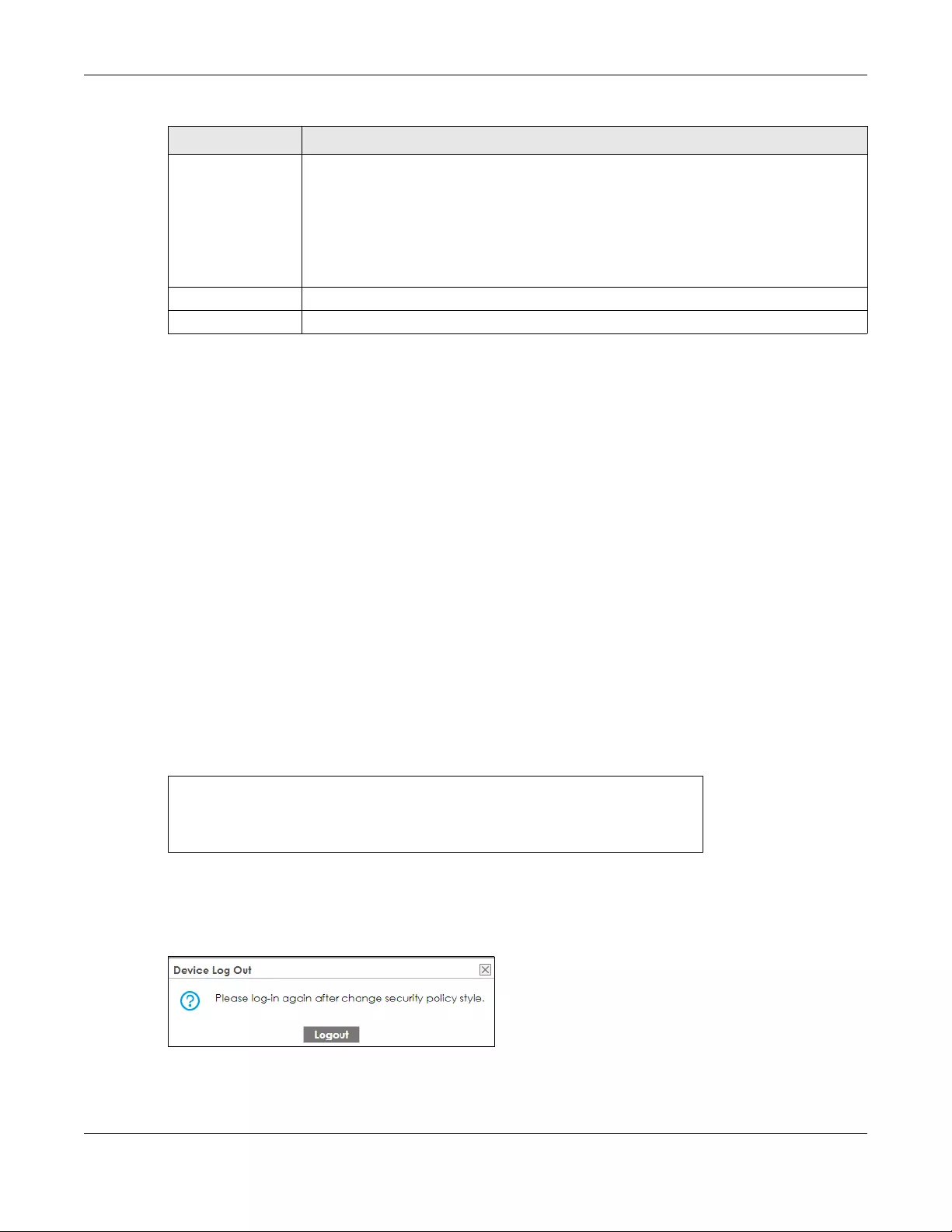
Chapter 36 Email Security
ZyWALL USG FLEX Series User’s Guide
682
36.4.2 Regular Expressions in Black or White List Entries
The following applies for a black or white list entry based on an email subject, email address, or email
header value.
• Use a question mark (?) to let a single character vary. For example, use “a?c” (without the quotation
marks) to specify abc, acc and so on.
• You can also use a wildcard (*). For example, if you configure *def.com, any email address that ends
in def.com matches. So “mail.def.com” matches.
• The wildcard can be anywhere in the text string and you can use more than one wildcard. You
cannot use two wildcards side by side, there must be other characters between them.
• The Zyxel Device checks the first header with the name you specified in the entry. So if the email has
more than one “Received” header, the Zyxel Device checks the first one.
36.5 Email Security Profile
To use multiple profiles for this feature, run the following commands in the Zyxel Device Command Line
Interface (CLI).
After you run these command, go to the feature screen again in the web configurator. You will be
prompted to log out and then log in again.
Figure 447 Logout Prompt
After you log in again, you will see the new profile screen for this feature.
Field Value
Keyword
This field displays when you select the Mail Header type.
Type the value part of an email header (the part that comes after the colon). Use up to 63
ASCII characters.
For example, if you want the entry to check the “Received:” header for a specific mail
server’s domain, enter the mail server’s domain here.
See Section 36.4.2 on page 682 for more details.
OK Click OK to save your changes.
Cancel Click Cancel to exit this screen without saving your changes.
Table 278 Configuration > Security Service > Email Security > Black/White List > Black/White List > Add
LABEL DESCRIPTION
Router# configure terminal
Router(config)# secure-policy-style advance
Router(config)# show secure-policy-style status
secure-policy-style: advance
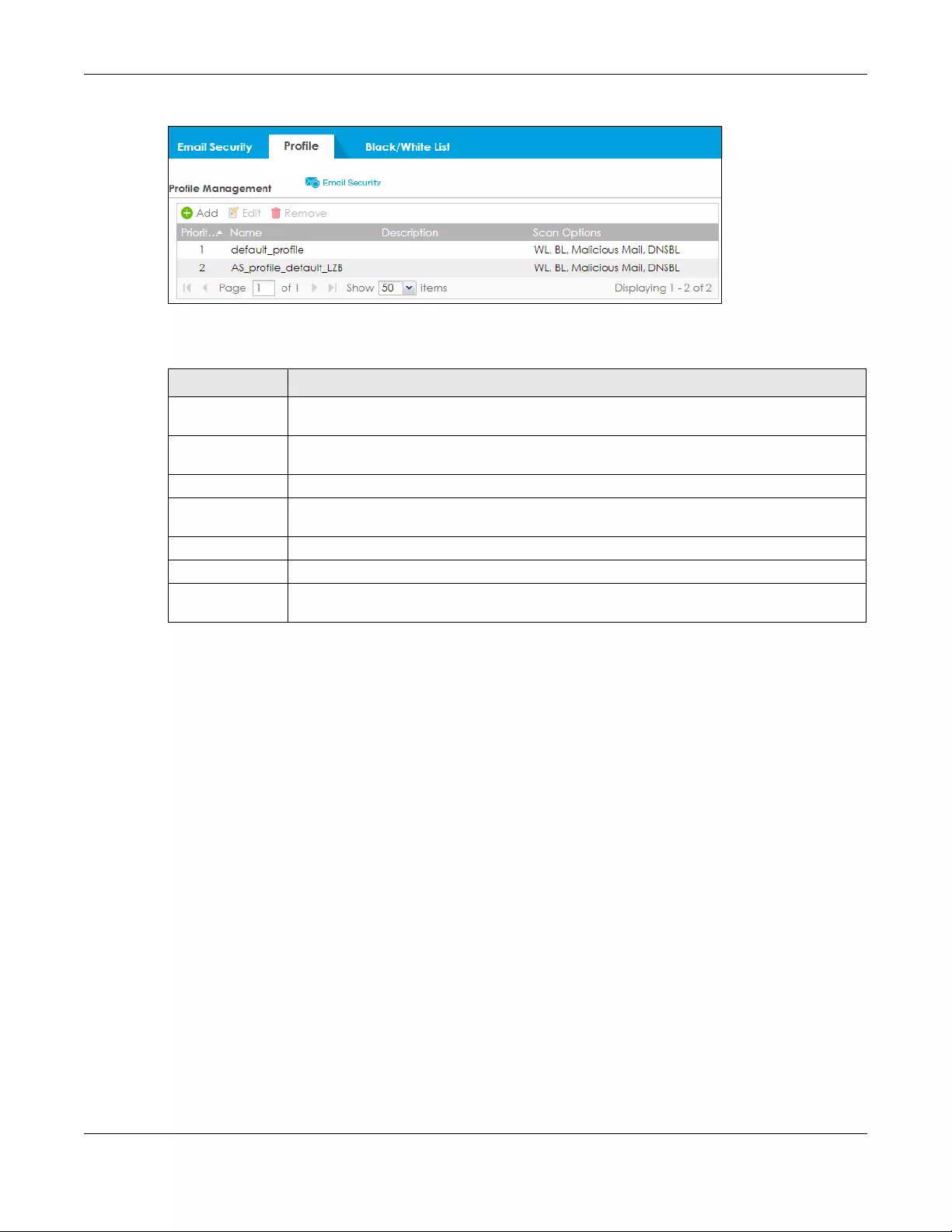
Chapter 36 Email Security
ZyWALL USG FLEX Series User’s Guide
683
Figure 448 Configuration > Security Service > Email Security > Profile
The following table describes the labels in this screen.
36.5.1 Add or Edit Email Security Profile
Click Add to create a new entry or select an existing entry and click Edit to open the following screen
where you can create or modify the entry’s settings.
Table 279 Configuration > Security Service > > Profile
LABEL DESCRIPTION
Add Click this to create a new entry. Select an entry and click Add to create a new entry after the
selected entry.
Edit Double-click an entry or select it and click Edit to open a screen where you can modify the
entry’s settings.
Remove Select an entry and click Remove to delete the selected entry.
#This field is a sequential value showing the number of the profile. The profile order is not
important.
Name This displays the name of the profile created.
Description This displays the description of the profile.
Scan Options This displays which lists are checked for email security: White List (WL), Black List (BL), Malicious
Mail, DNSBL.
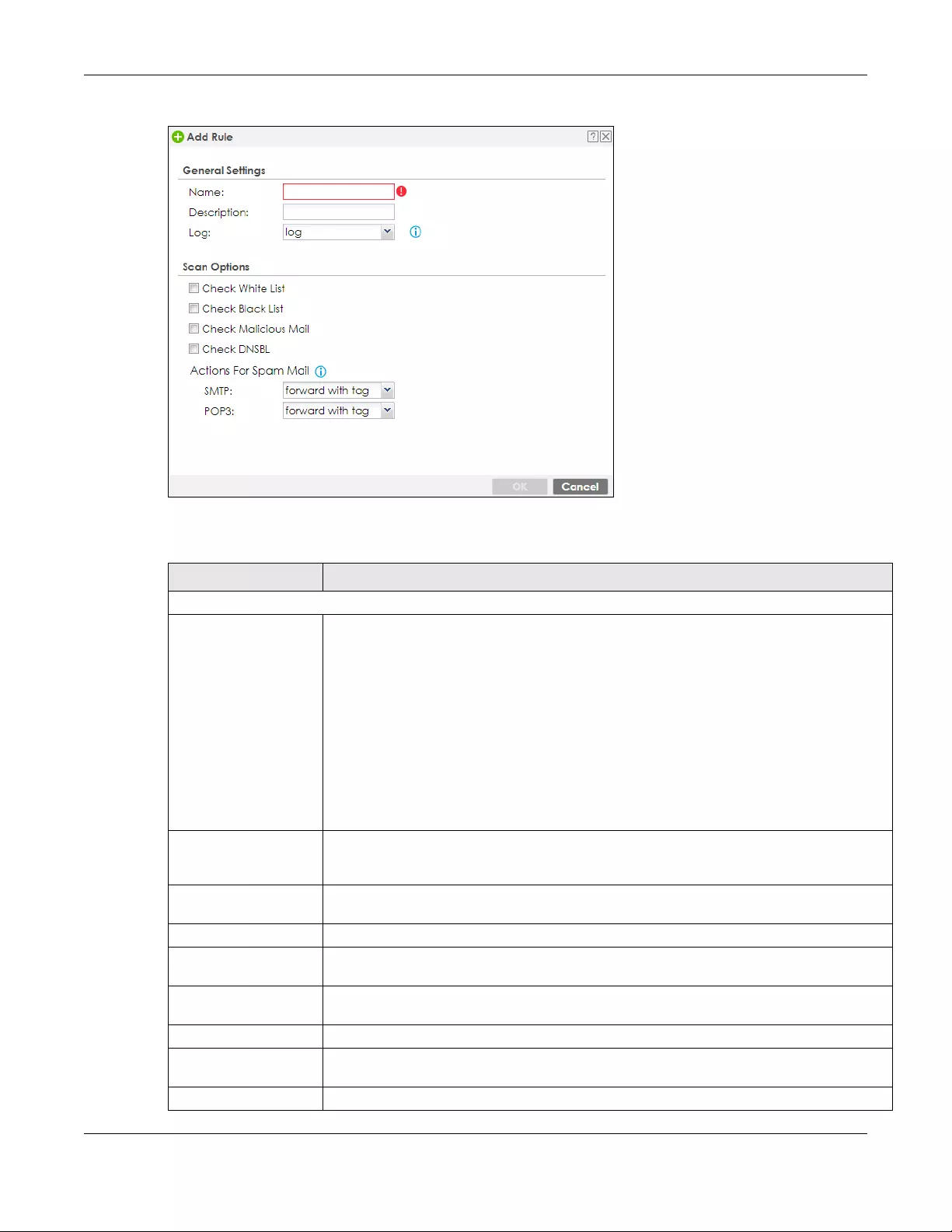
Chapter 36 Email Security
ZyWALL USG FLEX Series User’s Guide
684
Figure 449 Configuration > Security Service > Email Security > Profile > Add/Edit
The following table describes the labels in this screen.
Table 280 Configuration > Security Service > Email Security Profile > Add/Edit
LABEL DESCRIPTION
General Settings
Name Type the name of the profile. You may use 1-31 alphanumeric characters, underscores(_), or
dashes (-), but the first character cannot be a number. This value is case-sensitive. These are
valid, unique profile names:
•MyProfile
• mYProfile
• Mymy12_3-4
These are invalid profile names:
• 1mYProfile
•My Profile
• MyProfile?
• Whatalongprofilename123456789012
Description Type a description for the profile rule to help identify the purpose of rule. You may use 1-31
alphanumeric characters, underscores (_), or dashes (-), but the first character cannot be a
number. This value is case-sensitive. This field is optional.
Log Select whether to have the ZyXEL device generate a log (log), log and alert (log alert) or
neither (no) by default when traffic matches a signature in this category.
Scan Options
Check White List Select this check box to check email against the white list. The Zyxel Device classifies email
that matches a white list entry as legitimate (not spam).
Check Black List Select this check box to check email against the black list. The Zyxel Device classifies email
that matches a black list entry as spam.
Check Malicious Mail Select this to identify spam email by content, such as malicious content.
Check DNSBL Select this check box to check email against the Zyxel Device’s configured DNSBL domains.
The Zyxel Device classifies email that matches a DNS black list as spam.
Actions for Spam Mail Use this section to set how the Zyxel Device is to handle spam mail.

Chapter 36 Email Security
ZyWALL USG FLEX Series User’s Guide
685
36.5.2 Link a Profile
To link a profile to a policy, go to the Configuration > Security Policy > Policy Control screen, select a pol-
icy, and then click Edit. In the Edit Policy screen under Profile, select which profile you want to use for
each security service.
SMTP Select how the Zyxel Device is to handle spam SMTP mail.
Select drop to discard spam SMTP mail.
Select forward to allow spam SMTP mail to go through.
Select forward with tag to add a spam tag to an SMTP spam mail’s mail subject and send it
on to the destination.
POP3 Select how the Zyxel Device is to handle spam POP3 mail.
Select forward to allow spam POP3 mail to go through.
Select forward with tag to add a spam tag to an POP3 spam mail’s mail subject and send it
on to the destination.
OK Click OK to save your changes back to the Zyxel Device.
Cancel Click Cancel to exit this screen without saving.
Table 280 Configuration > Security Service > Email Security Profile > Add/Edit (continued)
LABEL DESCRIPTION
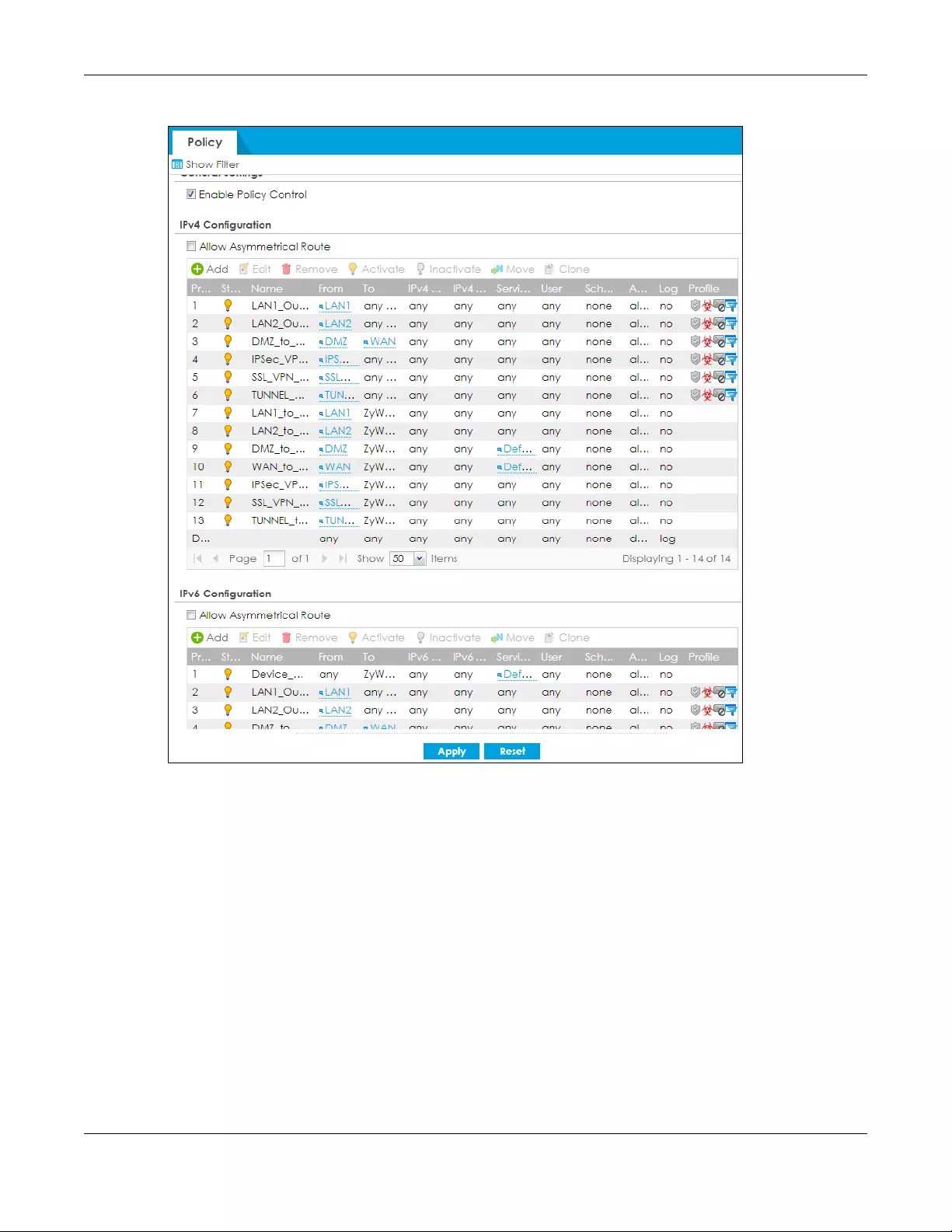
Chapter 36 Email Security
ZyWALL USG FLEX Series User’s Guide
686
Figure 450 Configuration > Security Service > Policy Control > Profile
36.5.3 The Email Security Advance Screen
The Configuration > Security Service > Email Security screen changes when using profiles.
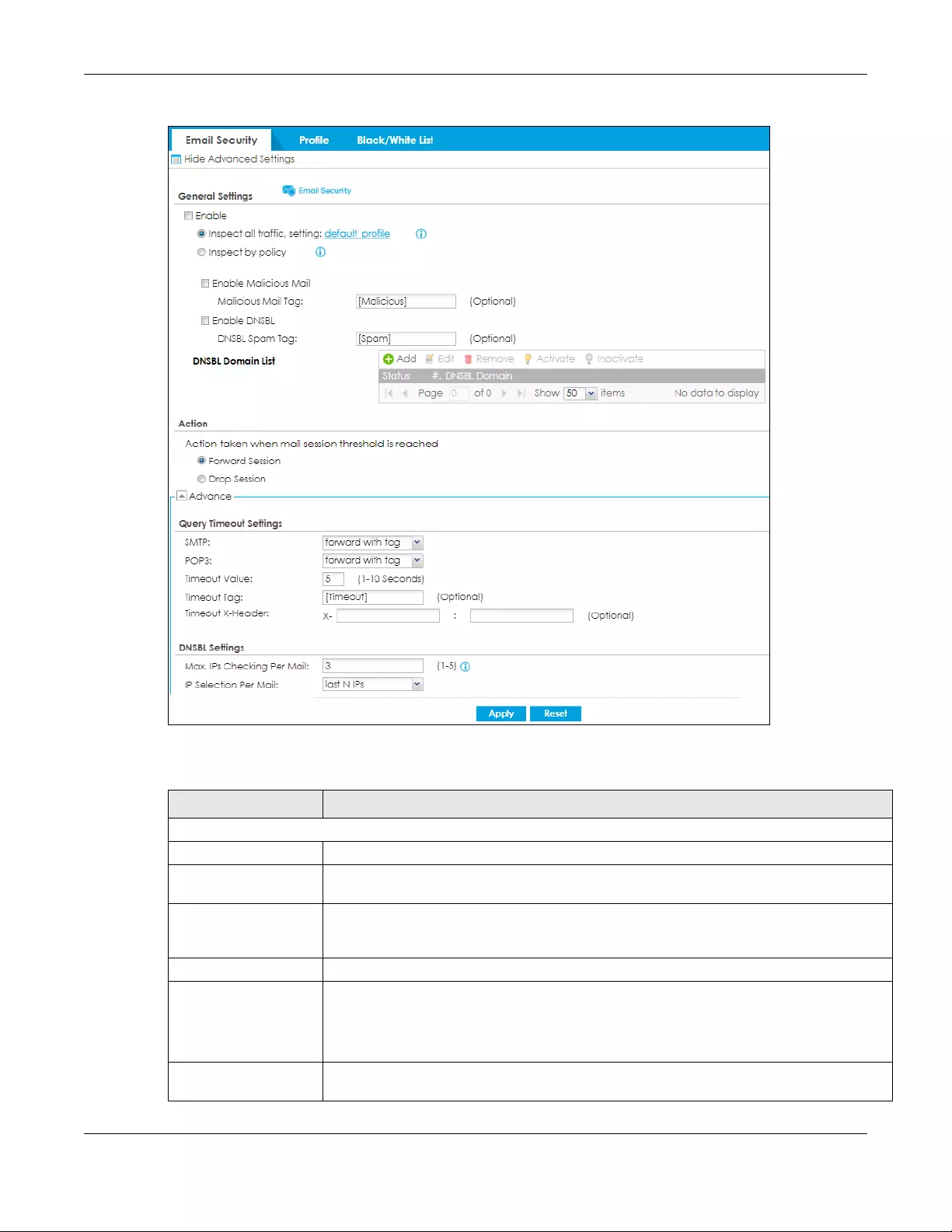
Chapter 36 Email Security
ZyWALL USG FLEX Series User’s Guide
687
Figure 451 Configuration > Security Service > Email Security Advance
The following table describes the labels in this screen.
Table 281 Configuration > Security Service > Email Security Advance
LABEL DESCRIPTION
General Settings
Enable Select this check box to activate the settings in this section.
Inspect all traffic,
setting:
Select this to have all traffic inspected by the default_profile. You cannot rename or delete
the default_profile profile, but you can edit it by clicking the link here.
Inspect by policy If you configured a specific profile in the Profile tab for this service, select this to have specific
traffic inspected by that profile. You must bind the profile to a policy in Security Policy >
Policy Control.
Enable Malicious Mail Select this to identify spam email by content, such as malicious content.
Malicious Mail Tag Enter a message or label (up to 15 ASCII characters) to add to the beginning of the mail
subject of emails that are determined to spam based on the mail content analysis.
This tag is only added if the email security policy is configured to forward spam mail with a
spam tag.
Enable DNSBL Select this check box to check email against the Zyxel Device’s configured DNSBL domains.
The Zyxel Device classifies email that matches a DNS black list as spam.

Chapter 36 Email Security
ZyWALL USG FLEX Series User’s Guide
688
DNSBL Spam Tag Enter a message or label (up to 15 ASCII characters) to add to the beginning of the mail
subject of emails that have a sender or relay IP address in the header that matches a black
list maintained by one of the DNSBL domains listed in the Zyxel Device.
This tag is only added if the email security policy is configured to forward spam mail with a
spam tag.
DNSBL Domain List
Add Click this to create a new entry.
Edit Select an entry and click this to be able to modify it.
Remove Select an entry and click this to delete it.
Activate To turn on an entry, select it and click Activate.
Inactivate To turn off an entry, select it and click Inactivate.
Status The activate (light bulb) icon is lit when the entry is active and dimmed when the entry is
inactive.
#This is the entry’s index number in the list.
DNSBL Domain This is the name of a domain that maintains DNSBL servers. Enter the domain that is
maintaining a DNSBL.
Action
Action taken when mail
sessions threshold is
reached
An email session is when an email client and email server (or two email servers) connect
through the Zyxel Device. Select how to handle concurrent email sessions that exceed the
maximum number of concurrent email sessions that the email security feature can handle.
See the chapter of product specifications for the threshold.
Select Forward Session to have the Zyxel Device allow the excess email sessions without any
spam filtering.
Select Drop Session to have the Zyxel Device drop mail connections to stop the excess email
sessions. The email client or server will have to re-attempt to send or receive email later when
the number of email sessions is under the threshold.
Query Timeout Settings
SMTP Select how the Zyxel Device is to handle SMTP mail query timeout.
Select drop to discard SMTP mail.
Select forward to allow SMTP mail to go through.
Select forward with tag to add a tag to an SMTP query timeout mail’s mail subject and send it
on to the destination.
POP3 Select how the Zyxel Device is to handle POP3 mail query timeout.
Select forward to allow POP3 mail to go through.
Select forward with tag to add a tag to an POP3 query timeout mail’s mail subject and send it
on to the destination.
Timeout Value Set how long the Zyxel Device waits for a reply from the mail scan server. If there is no reply
before this time period expires, the Zyxel Device takes the action defined in the relevant
Actions when Query Timeout field.
Timeout Tag Enter a message or label (up to 15 ASCII characters) to add to the mail subject of emails that
the Zyxel Device forwards if queries to the mail scan servers time out.
Timeout X-Header Specify the name and value for the X-Header to be added when queries to the mail scan
servers time out.
DNSBL Settings
Max. IPs Checking Per
Mail
Set the maximum number of sender and relay server IP addresses in the mail header to check
against the DNSBL domain servers.
Table 281 Configuration > Security Service > Email Security Advance (continued)
LABEL DESCRIPTION
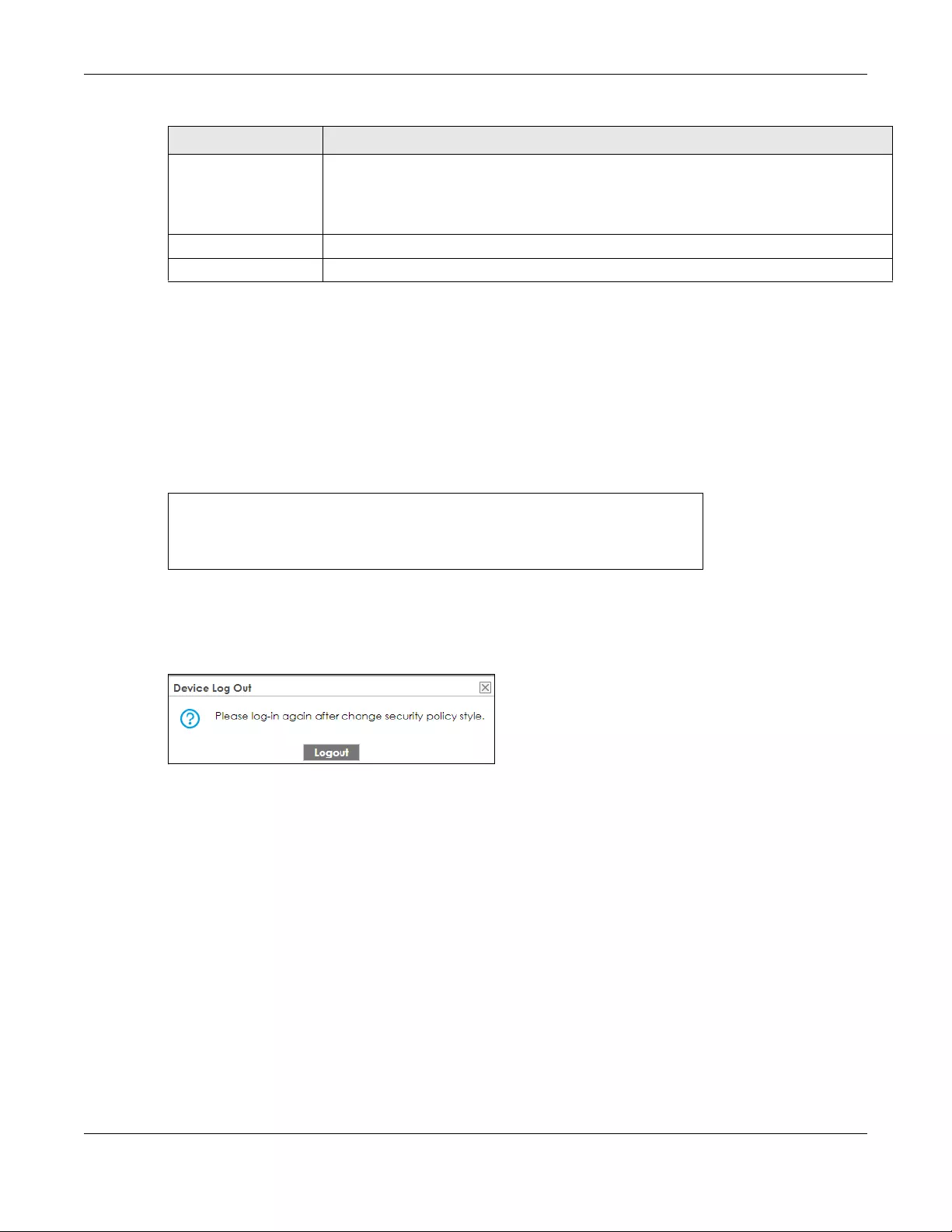
Chapter 36 Email Security
ZyWALL USG FLEX Series User’s Guide
689
36.5.4 Remove Profiles
To remove profiles and revert to the default general security policy style, you must first make sure to
change Inspect by policy to Inspect all traffic in the following security services: Anti-Malware, DNS Filter,
URL Threat Filter, IDP, Email Security.
Note: All profiles that you created will be removed from Security Policy > Policy Control.
Run the following commands in the Zyxel Device Command Line Interface (CLI).
Wait a minute and then go to the feature screen again in the web configurator. You will be prompted
to log out and then log in again.
Figure 452 Logout Prompt
After you log in again, you will not see the profile screen for this feature.
36.6 Email Security Technical Reference
Here is more detailed email security information.
DNSBL
• The Zyxel Device checks only public sender and relay IP addresses, it does not check private IP
addresses.
• The Zyxel Device sends a separate query (DNS lookup) for each sender or relay IP address in the
email’s header to each of the Zyxel Device’s DNSBL domains at the same time.
• The DNSBL servers send replies as to whether or not each IP address matches an entry in their list. Each
IP address has a separate reply.
IP Selection Per Mail Select first N IPs to have the Zyxel Device start checking from the first IP address in the mail
header. This is the IP of the sender or the first server that forwarded the mail.
Select last N IPs to have the Zyxel Device start checking from the last IP address in the mail
header. This is the IP of the last server that forwarded the mail.
Apply Click Apply to save your changes back to the Zyxel Device.
Reset Click Reset to return the screen to its last-saved settings.
Table 281 Configuration > Security Service > Email Security Advance (continued)
LABEL DESCRIPTION
Router# configure terminal
Router(config)# secure-policy-style general
Router(config)# show secure-policy-style status
secure-policy-style: general

Chapter 36 Email Security
ZyWALL USG FLEX Series User’s Guide
690
• As long as the replies are indicating the IP addresses do not match entries on the DNSBL lists, the Zyxel
Device waits until it receives at least one reply for each IP address.
• If the Zyxel Device receives a DNSBL reply that one of the IP addresses is in the DNSBL list, the Zyxel
Device immediately classifies the email as spam and takes the email security policy’s configured
action for spam. The Zyxel Device does not wait for any more DNSBL replies.
• If the Zyxel Device receives at least one non-spam reply for each of an email’s routing IP addresses,
the Zyxel Device immediately classifies the email as legitimate and forwards it.
• Any further DNSBL replies that come after the Zyxel Device classifies an email as spam or legitimate
have no effect.
• The Zyxel Device records DNSBL responses for IP addresses in a cache for up to 72 hours. The Zyxel
Device checks an email’s sender and relay IP addresses against the cache first and only sends DNSBL
queries for IP addresses that are not in the cache.
Here is an example of an email classified as spam based on DNSBL replies.
Figure 453 DNSBL Spam Detection Example
1The Zyxel Device receives an email that was sent from IP address a.a.a.a and relayed by an email server
at IP address b.b.b.b. The Zyxel Device sends a separate query to each of its DNSBL domains for IP
address a.a.a.a. The Zyxel Device sends another separate query to each of its DNSBL domains for IP
address b.b.b.b.
2DNSBL A replies that IP address a.a.a.a does not match any entries in its list (not spam).
3DNSBL C replies that IP address b.b.b.b matches an entry in its list.
4The Zyxel Device immediately classifies the email as spam and takes the action for spam that you
defined in the email security policy. In this example it was an SMTP mail and the defined action was to
drop the mail. The Zyxel Device does not wait for any more DNSBL replies.
Here is an example of an email classified as legitimate based on DNSBL replies.
DNSBL A
DNSBL B
DNSBL C
IPs: a.a.a.a
b.b.b.b
1
2
a.a.a.a Not spam
3
4
a.a.a.a?
b.b.b.b?
a.a.a.a?
b.b.b.b?
a.a.a.a?
b.b.b.b?
b.b.b.b Spam
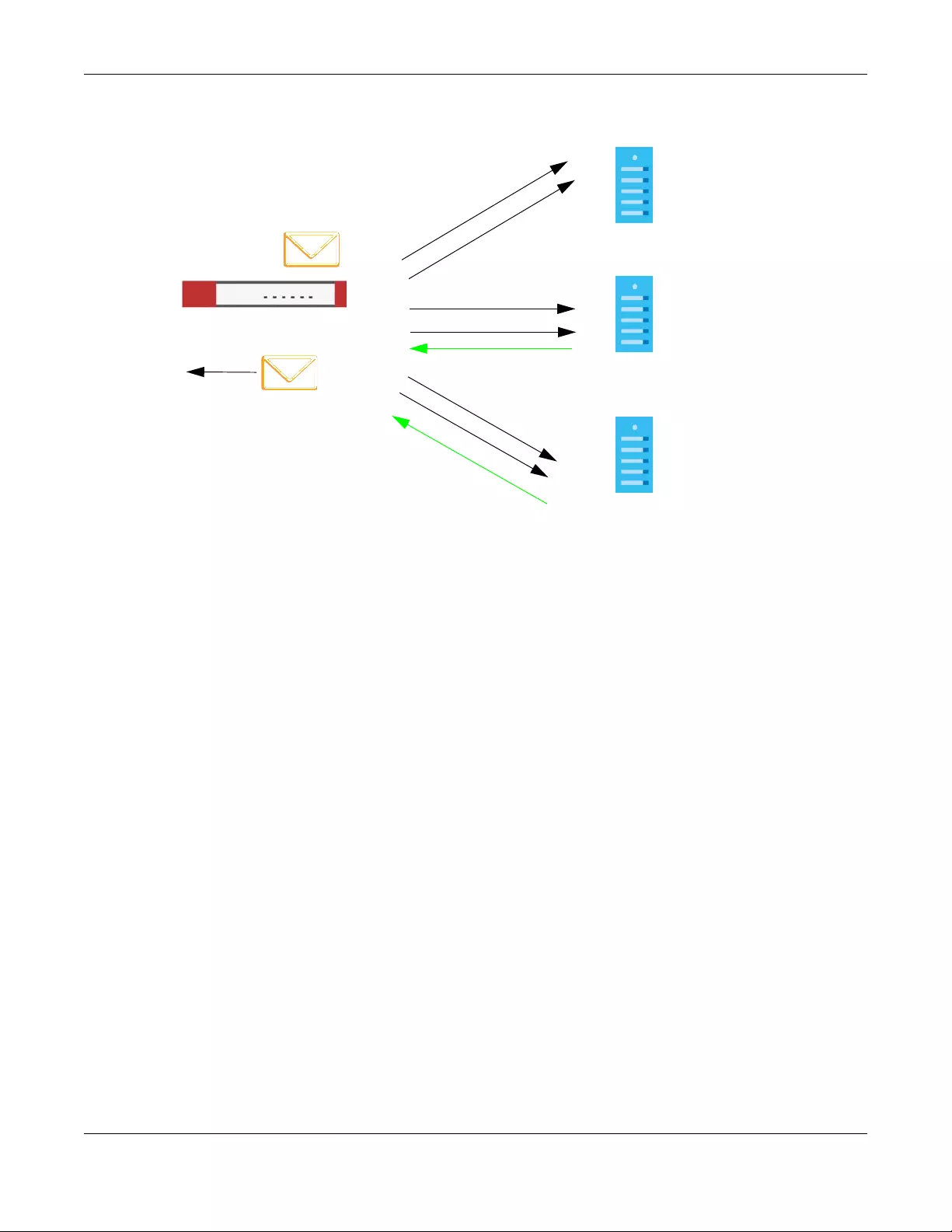
Chapter 36 Email Security
ZyWALL USG FLEX Series User’s Guide
691
Figure 454 DNSBL Legitimate Email Detection Example
1The Zyxel Device receives an email that was sent from IP address c.c.c.c and relayed by an email server
at IP address d.d.d.d. The Zyxel Device sends a separate query to each of its DNSBL domains for IP
address c.c.c.c. The Zyxel Device sends another separate query to each of its DNSBL domains for IP
address d.d.d.d.
2DNSBL B replies that IP address d.d.d.d does not match any entries in its list (not spam).
3DNSBL C replies that IP address c.c.c.c does not match any entries in its list (not spam).
4Now that the Zyxel Device has received at least one non-spam reply for each of the email’s routing IP
addresses, the Zyxel Device immediately classifies the email as legitimate and forwards it. The Zyxel
Device does not wait for any more DNSBL replies.
If the Zyxel Device receives conflicting DNSBL replies for an email routing IP address, the Zyxel Device
classifies the email as spam. Here is an example.
DNSBL A
DNSBL B
DNSBL C
IPs: c.c.c.c
d.d.d.d
1
c.c.c.c Not spam
2
4
c.c.c.c?
d.d.d.d?
c.c.c.c?
d.d.d.d?
c.c.c.c?
d.d.d.d?
d.d.d.d Not spam
3

Chapter 36 Email Security
ZyWALL USG FLEX Series User’s Guide
692
Figure 455 Conflicting DNSBL Replies Example
1The Zyxel Device receives an email that was sent from IP address a.b.c.d and relayed by an email server
at IP address w.x.y.z. The Zyxel Device sends a separate query to each of its DNSBL domains for IP
address a.b.c.d. The Zyxel Device sends another separate query to each of its DNSBL domains for IP
address w.x.y.z.
2DNSBL A replies that IP address a.b.c.d does not match any entries in its list (not spam).
3While waiting for a DNSBL reply about IP address w.x.y.z, the Zyxel Device receives a reply from DNSBL B
saying IP address a.b.c.d is in its list.
4The Zyxel Device immediately classifies the email as spam and takes the action for spam that you
defined in the email security policy. In this example it was an SMTP mail and the defined action was to
drop the mail. The Zyxel Device does not wait for any more DNSBL replies.
DNSBL A
DNSBL B
DNSBL C
IPs: a.b.c.d
w.x.y.z
1
2
a.b.c.d Not spam
3
4
a.b.c.d?
w.x.y.z?
a.b.c.d?
w.x.y.z?
a.b.c.d?
w.x.y.z?
a.b.c.d S pam!
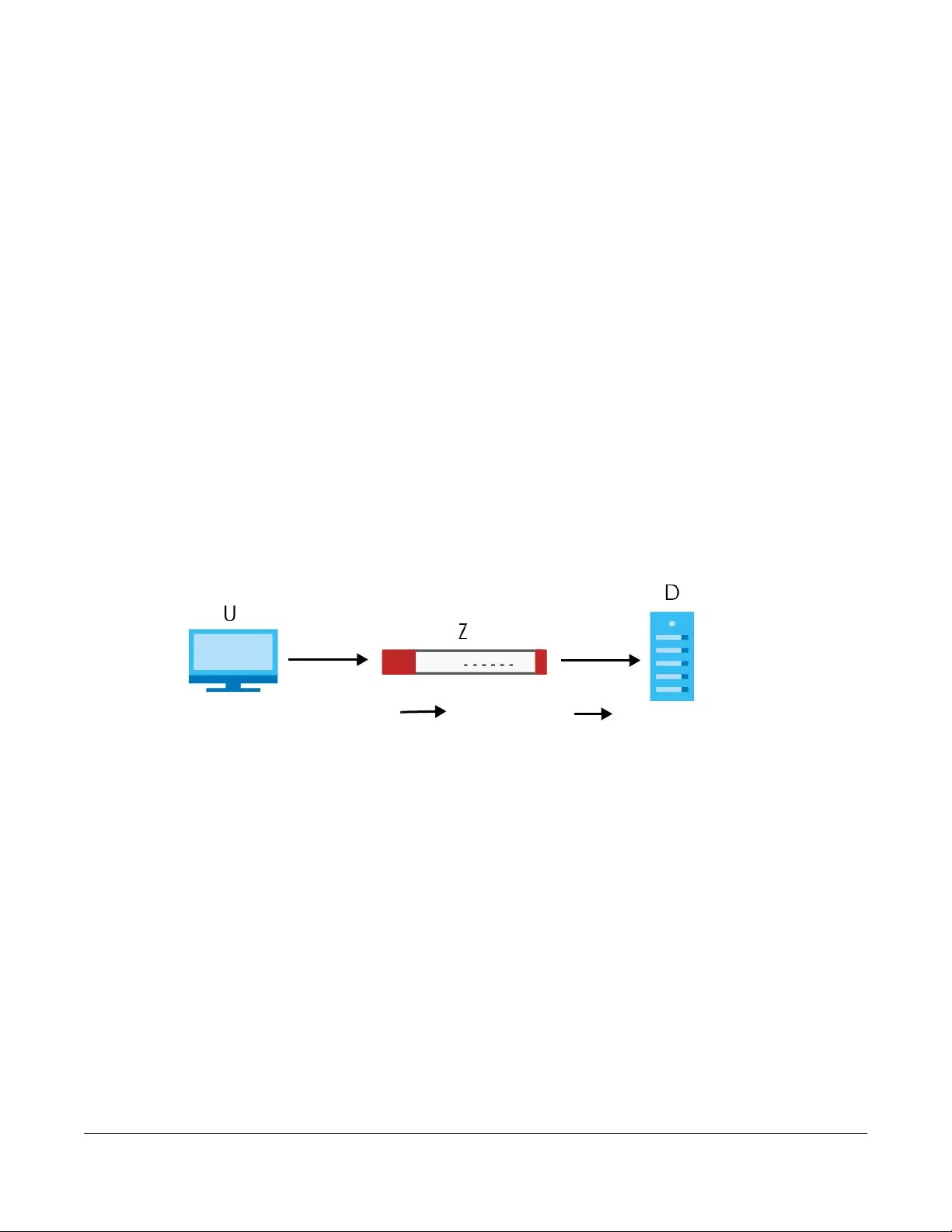
ZyWALL USG FLEX Series User’s Guide
693
CHAPTER 37
SSL Inspection
37.1 Overview
Secure Socket Layer (SSL) traffic, such as https://www.google.com/HTTPS, FTPs, POP3s, SMTPs, etc. is
encrypted, and cannot be inspected using Security Service profiles such as App Patrol, Content Filter,
Intrusion, Detection and Prevention (IDP), or Anti-Malware. The Zyxel Device uses SSL Inspection to
decrypt SSL traffic, sends it to the Security Service engines for inspection, then encrypts traffic that
passes inspection and forwards it to the destination server, such as Google.
An example process is shown in the following figure. User U sends a HTTPS request (SSL) to destination
server D, via the Zyxel Device, Z. The traffic matches an SSL Inspection profile in a security policy, so the
Zyxel Device decrypts the traffic using SSL Inspection. The decrypted traffic is then inspected by the
Security Service profiles in the same security profile that matched the SSL Inspection profile. If all is OK,
then the Zyxel Device re-encrypts the traffic using SSL Inspection and forwards it to the destination server
D. SSL traffic could be in the opposite direction for other examples.
Figure 456 SSL Inspection Overview
Note: Email security cannot be applied to traffic decrypted by SSL Inspection.
37.1.1 What You Can Do in this Chapter
• Use the Security Service > SSL Inspection > Profile screen (Section 37.2 on page 694) to view SSL
Inspection profiles. Click the Add or Edit icon in this screen to configure the CA certificate, action and
log in an SSL Inspection profile.
• Use the Security Service > SSL Inspection > Exclude List screens (Section 37.3 on page 701) to create a
whitelist of destination servers to which traffic is passed through uninspected.
• Use the Security Service > SSL Inspection > Certificate Update screens (Section 37.4 on page 703) to
update the latest certificates of servers using SSL connections to the Zyxel Device network
HTTPS SSL
Inspection
Decrypt
Security Service
AP
CF
IDP
Anti-Malware
SSL
Inspection
Encrypt

Chapter 37 SSL Inspection
ZyWALL USG FLEX Series User’s Guide
694
37.1.2 What You Need To Know
SSL Inspection supports the following TLS protocols and encryption algorithms
• SSLv3 AES-CBC
• TLS1.0 AES-CBC
• TLS1.2 AES-CBC/AES-GCM
• TLS1.3 AES-GCM (no key update support nor 0-RTT)
• SSL Inspection does not support the following:
• Compression Support
• Client Authentication
37.1.3 What You Can Do in this Chapter
•See Configuration > Object > Certificate > My Certificates for information on creating certificates
on the Zyxel Device.
•See Monitor > Security Statistics > SSL Inspection to get usage data and easily add a destination
server to the whitelist of exclusion servers.
•See Configuration > Security Policy > Policy Control > Policy to bind an SSL Inspection profile to a
traffic flow(s).
37.1.4 Before You Begin
• If you don’t want to use the default Zyxel Device certificate, then create a new certificate in Object >
Certificate > My Certificates.
• Decide what destination servers to which traffic is sent directly without inspection. This may be a
matter of privacy and legality regarding inspecting an individual’s encrypted session, such as
financial websites. This may vary by locale.
37.2 The SSL Inspection Profile Screen
An SSL Inspection profile is a template with pre-configured certificate, action and log.
Click Configuration > Security Service > SSL Inspection > Profile to open this screen.
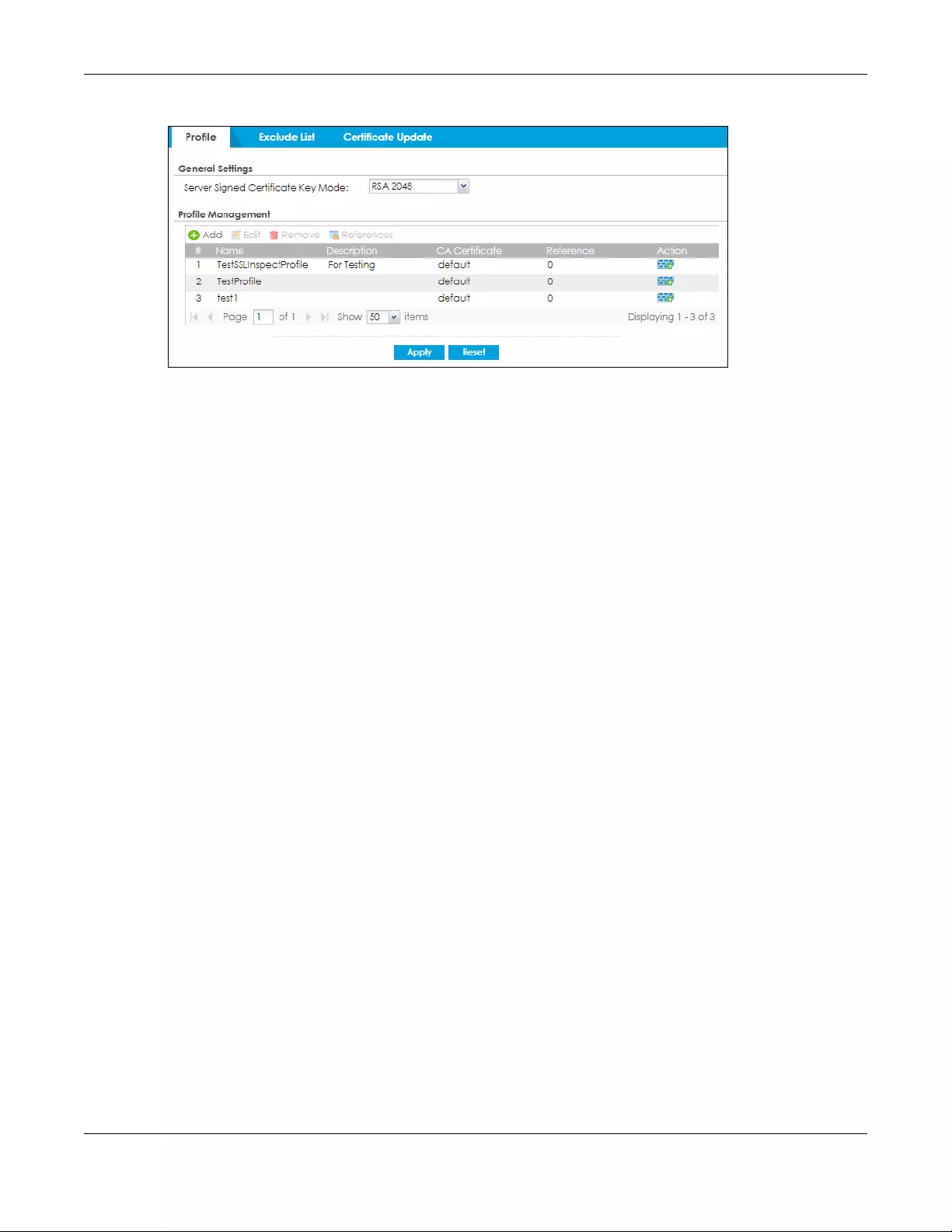
Chapter 37 SSL Inspection
ZyWALL USG FLEX Series User’s Guide
695
Figure 457 Configuration > Security Service > SSL Inspection > Profile

Chapter 37 SSL Inspection
ZyWALL USG FLEX Series User’s Guide
696
The following table describes the fields in this screen.
Table 282 Configuration > Security Service > SSL Inspection > Profile
LABEL DESCRIPTION
General Settings
Server Signed
Certificate Key
Mode
With SSL inspection, the Zyxel Device acts as a 'man-in-the-middle' between a client and
a remote server, when the client and server are communicating using an SSL-encrypted
session. Every time the client and server send data to each other, the Zyxel Device
decrypts the sender’s encrypted data, scans the plain data for threats, re-encrypts the
data, and then sends the encrypted data to the receiver.
• For outgoing sessions from the client to the remote server, the Zyxel Device creates a
virtual server to decrypt data and a virtual client to re-encrypt data.
• For incoming sessions from the remote server to the client, the Zyxel Device creates a
virtual client to decrypt data, and a virtual server to re-encrypt data.
To perform SSL Inspection for clients using SSL (HTTPS, SSH, SMTP) through the Zyxel
Device, the Zyxel Device must check that the server’s certificate with corresponding
public key are valid and were issued by a Certificate Authority (CA) listed in the Zyxel
Device's list of trusted CAs. According to the selected key mode RSA 1024, RSA 2048,
ECDSA-RSA-1024 or ECDSA-RSA-2048, the Zyxel Device will construct the corresponding
self-signed certificate for the virtual server.
RSA is a public-key cryptosystem used for data encryption or signing messages. For data
encryption, the encryption key is public and the decryption key is private. For signing
messages, the signing key is private and the verification key is public. Elliptic Curve
Cryptography (ECC) is a public-key cryptosystem based on elliptic curve theory, and
more efficient than RSA. ECC allows smaller keys compared to RSA to provide
equivalent security. For example, a 224-bit elliptic curve public key should provide
comparable security to a 2048-bit RSA public key.
•ECDSA-RSA-1024 indicates Zyxel Device support for clients that support both ECDSA-
256 and RSA-1024 with ECDSA-256 having higher priority, that is ECDSA-256 is used by
the virtual server, if a client supports both ECDSA-256 and RSA-1024.
•ECDSA-RSA-2048 indicates Zyxel Device support for clients that support both ECDSA-
256 and RSA-2048 with ECDSA-256 having higher priority, that is ECDSA-256 is used by
the virtual server, if a client supports both ECDSA-256 and RSA-2048.
Select a mode that the client’s browser, FTP client, or mail client supports. The Zyxel
Device will use different keys (cryptosystems) for each client according to the client’s
support list.
For example, if there are three clients behind a Zyxel Device with the following key
mode support:
• Client 1 - RSA-1024
• Client 2 - RSA-2048 and RSA-1024
• Client 3 - ECDSA-256 and RSA-2048.
If you set the key mode to ECDSA-RSA-1024, then the following will be used by each
client:
• Client 1 - RSA-1024
• Client 2 - RSA-1024
• Client 3 - ECDSA-256.
If you set the key mode to ECDSA-RSA-2048, then the following will be used by each
client:
• Client 1 - sessions will not be processed (pass) by SSL inspection
• Client 2 - RSA-2048
• Client 3 - ECDSA-256.
Profile Management
Add Click Add to create a new profile.
Edit Select an entry and click this to be able to modify it.
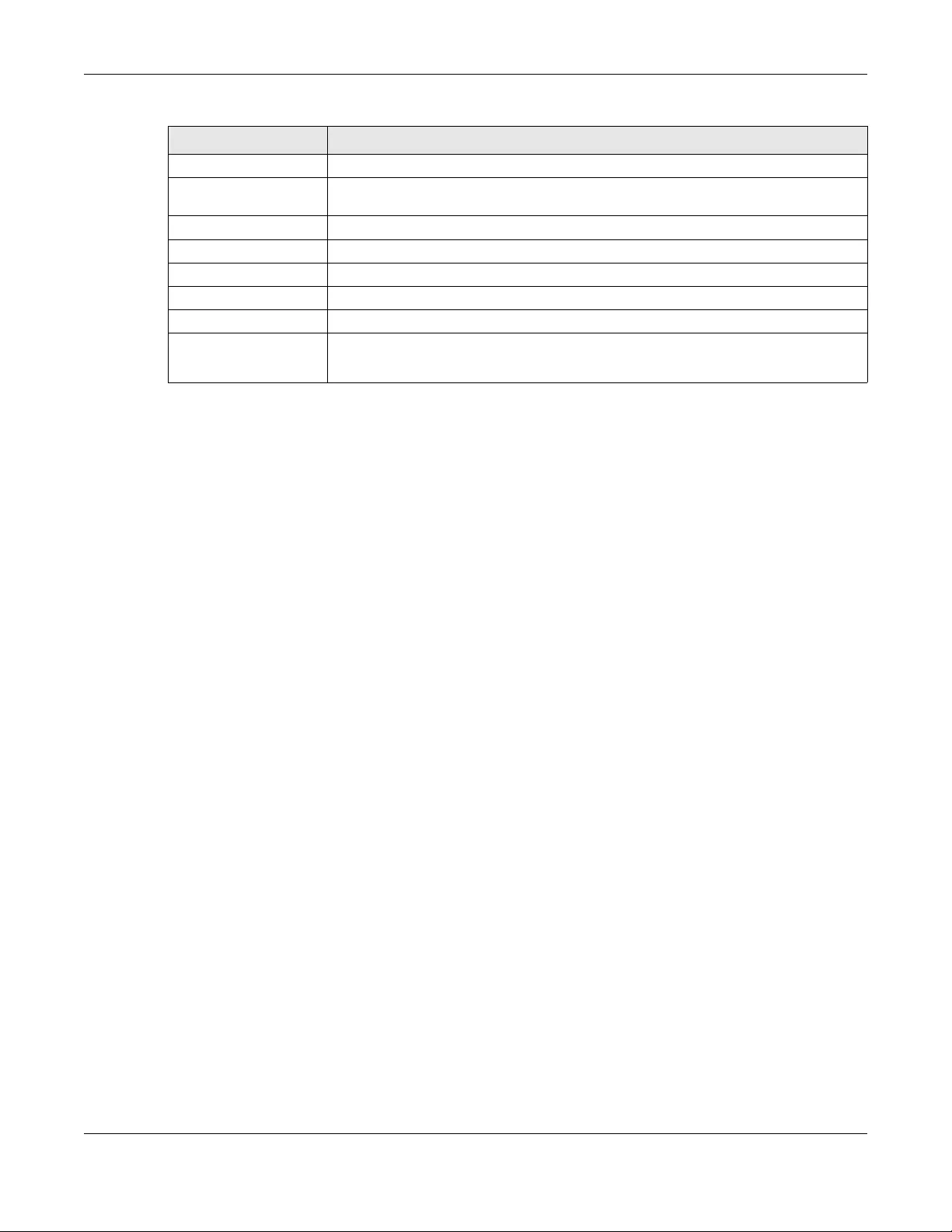
Chapter 37 SSL Inspection
ZyWALL USG FLEX Series User’s Guide
697
37.2.1 Apply to a Security Policy
Click the icon in the Action field to apply the entry to a security policy.
Go to the Configuration > Security Policy > Policy Control screen to check the result.
Remove Select an entry and click this to delete it.
References Select an entry and click References to open a screen that shows which settings use the
entry. Click Refresh to update information on this screen.
#This is the entry’s index number in the list.
Name This displays the name of the profile.
Description This displays the description of the profile.
CA Certificate This displays the CA certificate being used in this profile.
Reference This displays the number of times an object reference is used in a profile.
Action Click this icon to apply the entry to a security policy.
Go to the Configuration > Security Policy > Policy Control screen to check the result.
Table 282 Configuration > Security Service > SSL Inspection > Profile (continued)
LABEL DESCRIPTION
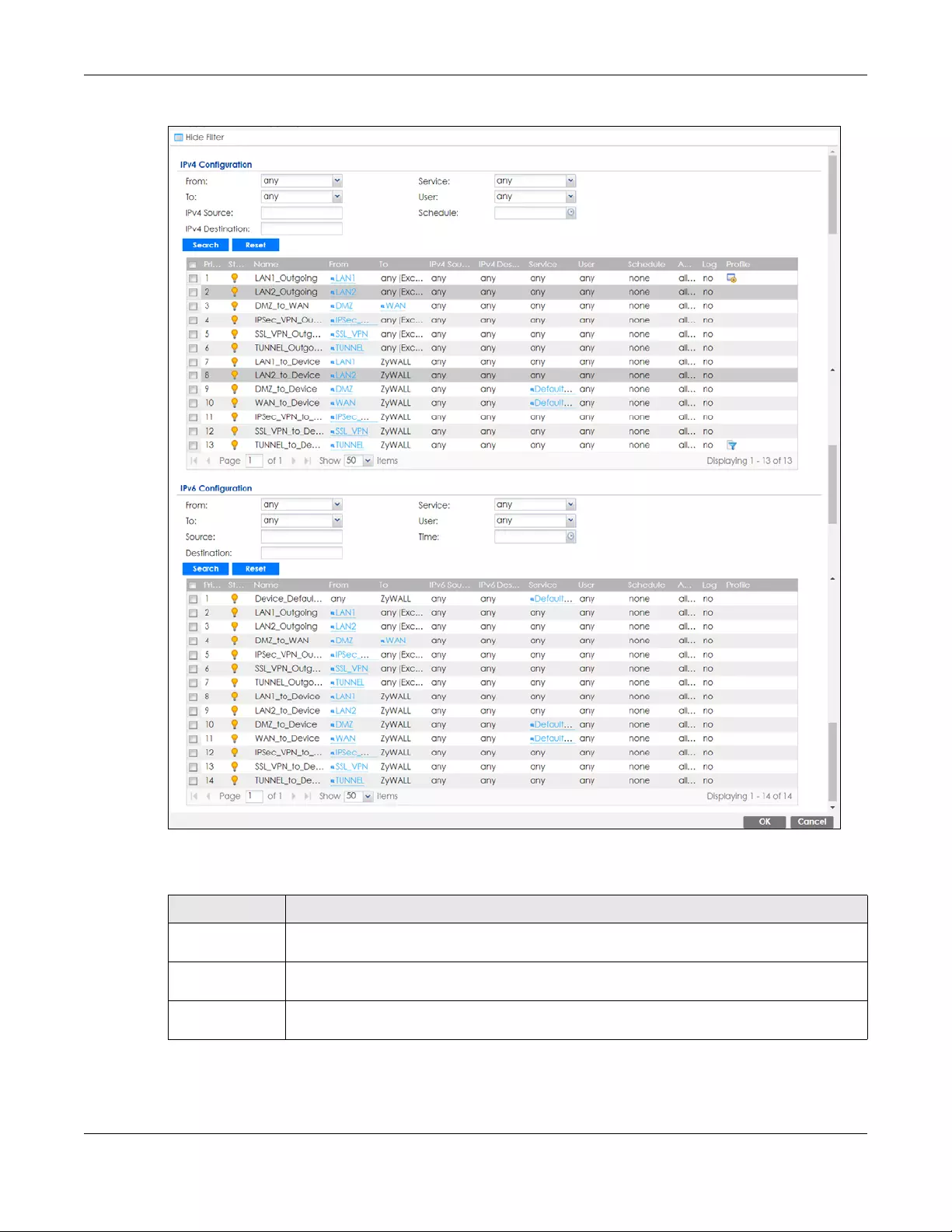
Chapter 37 SSL Inspection
ZyWALL USG FLEX Series User’s Guide
698
Figure 458 Configuration > Security Service > SSL Inspection > Action
The following table describes the labels in this screen.
Table 283 Configuration > Security Service > SSL Inspection > Action
LABEL DESCRIPTION
Show Filter/Hide
Filter
Click Show Filter to display IPv4 and IPv6 (if enabled) security policy search filters.
IPv4 / IPv6
Configuration
Use IPv4 / IPv6 search filters to find specific IPv4 and IPv6 (if enabled) security policies based on
direction, application, user, source, destination and/or schedule.
From / To Select a zone to view all security policies from a particular zone and/or to a particular zone.
any means all zones.

Chapter 37 SSL Inspection
ZyWALL USG FLEX Series User’s Guide
699
IPv4 / IPv6
Source Type an IPv4 or IPv6 IP address to view all security policies based on the IPv4 / IPv6 source
address object used.
• An IPv4 IP address is written as four integer blocks separated by periods. This is an example
IPv4 address: 172.16.6.7.
• An 128-bit IPv6 address is written as eight 16-bit hexadecimal blocks separated by colons
(:). This is an example IPv6 address: 2001:0db8:1a2b:0015:0000:0000:1a2f:0000.
IPv4 / IPv6
Destination Type an IPv4 or IPv6 IP address to view all security policies based on the IPv4 / IPv6 destination
address object used.
• An IPv4 IP address is written as four integer blocks separated by periods. This is an example
IPv4 address: 172.16.6.7.
• An 128-bit IPv6 address is written as eight 16-bit hexadecimal blocks separated by colons
(:). This is an example IPv6 address: 2001:0db8:1a2b:0015:0000:0000:1a2f:0000.
Service View all security policies based the service object used.
User View all security policies based on user or user group object used.
Schedule View all security policies based on the schedule object used.
Priority This is the position of your Security Policy in the global policy list (including all through-Zyxel
Device and to-Zyxel Device policies). The ordering of your policies is important as policies are
applied in sequence. Default displays for the default Security Policy behavior that the Zyxel
Device performs on traffic that does not match any other Security Policy.
Status This icon is lit when the entry is active and dimmed when the entry is inactive.
Name This is the name of the Security policy.
From / To This is the direction of travel of packets. Select from which zone the packets come and to
which zone they go.
Security Policies are grouped based on the direction of travel of packets to which they apply.
For example, from LAN to LAN means packets traveling from a computer or subnet on the LAN
to either another computer or subnet on the LAN.
From any displays all the Security Policies for traffic going to the selected To Zone.
To any displays all the Security Policies for traffic coming from the selected Fr om Zone.
From any to any displays all of the Security Policies.
To ZyWALL policies are for traffic that is destined for the Zyxel Device and control which
computers can manage the Zyxel Device.
IPv4 / IPv6 Source This displays the IPv4 / IPv6 source address object, including geographic address and FQDN
(group) objects, to which this Security Policy applies.
IPv4 / IPv6
Destination
This displays the IPv4 / IPv6 destination address object, including geographic address and
FQDN (group) objects, to which this Security Policy applies.
Service This displays the service object to which this Security Policy applies.
User This is the user name or user group name to which this Security Policy applies.
Schedule This field tells you the schedule object that the policy uses. none means the policy is active at all
times if enabled.
Action This field displays whether the Security Policy silently discards packets without notification
(deny), permits the passage of packets (allow) or drops packets with notification (reject)
Log Select whether to have the Zyxel Device generate a log (log), log and alert (log alert) or not
(no) when the policy is matched to the criteria listed above.
Profile This field shows you which Security Service profiles (application patrol, content filter, IDP, anti-
malware, email security) apply to this Security policy. Click an applied Security Service profile
icon to edit the profile directly.
OK Click OK to save your changes back to the Zyxel Device.
Cancel Click Cancel to exit this screen without saving.
Table 283 Configuration > Security Service > SSL Inspection > Action
LABEL DESCRIPTION

Chapter 37 SSL Inspection
ZyWALL USG FLEX Series User’s Guide
700
37.2.2 Add / Edit SSL Inspection Profiles
Click Configuration > Security Service > SSL Inspection > Profile > Add to create a new profile or select
an existing profile and click Edit to change its settings.
Figure 459 Configuration > Security Service > SSL Inspection > Profile > Add / Edit
The following table describes the fields in this screen.
Table 284 Configuration > Security Service > SSL Inspection > Profile > Add / Edit
LABEL DESCRIPTION
Name This is the name of the profile. You may use 1-31 alphanumeric characters, underscores(_), or
dashes (-), but the first character cannot be a number. This value is case-sensitive. These are
valid, unique profile names:
• MyProfile
• mYProfile
• Mymy12_3-4
These are invalid profile names:
• 1mYProfile
• My Profile
• MyProfile?
• Whatalongprofilename123456789012
Description Enter additional information about this SSL Inspection entry. You can enter up to 60 characters
("0-9", "a-z", "A-Z", "-" and "_").
CA Certificate This contains the default certificate and the certificates created in Object > Certificate > My
Certificates. Choose the certificate for this profile.
SSL/TLS version
supported
minimum
SSL / TLS connections using versions lower than this setting are blocked.
Log These are the log options for unsupported traffic that matches traffic bound to this policy:
•no: Select this option to have the Zyxel Device create no log for unsupported traffic that
matches traffic bound to this policy.
•log: Select this option to have the Zyxel Device create a log for unsupported traffic that
matches traffic bound to this policy
•log alert: An alert is an emailed log for more serious events that may need more immediate
attention. They also appear in red in the Monitor > Log screen. Select this option to have the
Zyxel Device send an alert for unsupported traffic that matches traffic bound to this policy.

Chapter 37 SSL Inspection
ZyWALL USG FLEX Series User’s Guide
701
37.3 Exclude List Screen
There may be privacy and legality issues regarding inspecting a user's encrypted session. The legal issues
may vary by locale, so it's important to check with your legal department to make sure that it’s OK to
intercept SSL traffic from your Zyxel Device users.
To ensure individual privacy and meet legal requirements, you can configure an exclusion list to exclude
matching sessions to destination servers. This traffic is not intercepted and is passed through
uninspected.
Click Configu ration > Se curity Serv ice > SSL In spection > Exclude Lis t to display the following screen. Use
Add to put a new item in the list or Edit to change an existing one or Remove to delete an existing entry.
Action for
Connection with
unsupported suit
SSL Inspection supports these cipher suites:
•DES
•3DES
•AES
Select to pass or block unsupported traffic (such as other cipher suites, compressed traffic,
client authentication requests, and so on) that matches traffic bound to this policy here.
Log These are the log options for unsupported traffic that matches traffic bound to this policy:
•no: Select this option to have the Zyxel Device create no log for unsupported traffic that
matches traffic bound to this policy.
•log: Select this option to have the Zyxel Device create a log for unsupported traffic that
matches traffic bound to this policy
•log alert: An alert is an emailed log for more serious events that may need more immediate
attention. They also appear in red in the Monitor > Log screen. Select this option to have the
Zyxel Device send an alert for unsupported traffic that matches traffic bound to this policy.
Action for
connection with
untrusted cert
chain
A certificate chain is a certification process that involves the following certificates between the
SSL/TLS server and a client. A certificate chain will fail if one of the following certificates is not
correct.
• A certificate owned by a user
• The certificate signed by a certification authority
• A root certificate
Select to pass, inspect, or block an untrusted certification chain.
Log These are the log options for unsupported traffic that matches traffic bound to this policy:
•no: Select this option to have the Zyxel Device create no log for unsupported traffic that
matches traffic bound to this policy.
•log: Select this option to have the Zyxel Device create a log for unsupported traffic that
matches traffic bound to this policy
•log alert: An alert is an emailed log for more serious events that may need more immediate
attention. They also appear in red in the Monitor > Log screen. Select this option to have the
Zyxel Device send an alert for unsupported traffic that matches traffic bound to this policy.
OK Click OK to save your settings to the Zyxel Device, and return to the profile summary page.
Cancel Click Cancel to return to the profile summary page without saving any changes.
Table 284 Configuration > Security Service > SSL Inspection > Profile > Add / Edit (continued)
LABEL DESCRIPTION
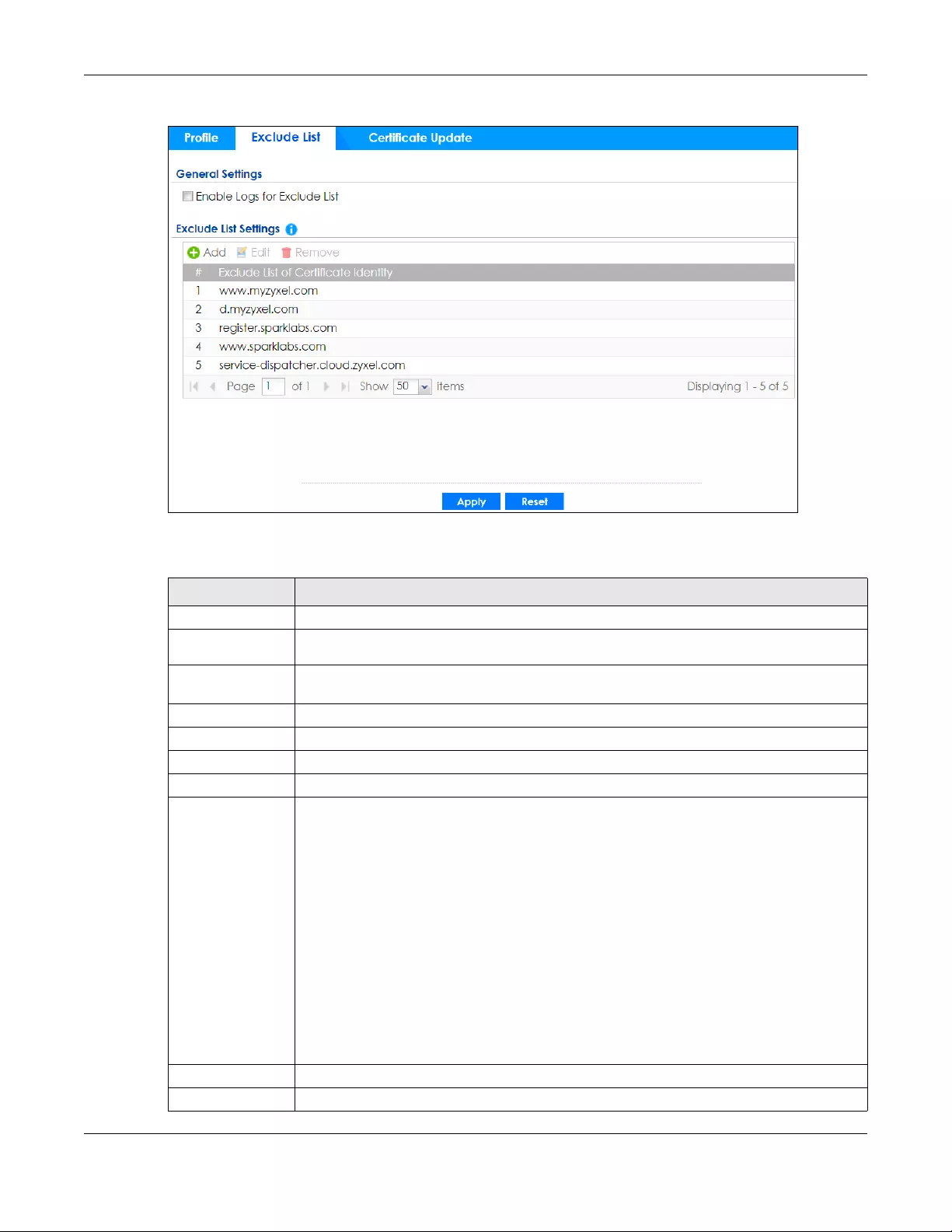
Chapter 37 SSL Inspection
ZyWALL USG FLEX Series User’s Guide
702
Figure 460 Configuration > Security Service > SSL Inspection > Exclude List (> Add/Edit)
The following table describes the fields in this screen.
Table 285 Configuration > Security Service > SSL Inspection > Exclude List
LABEL DESCRIPTION
General Settings
Enable Logs for
Exclude List Click this to create a log for traffic that bypasses SSL Inspection.
Exclude List
Settings
Use this part of the screen to create, edit, or delete items in the SSL Inspection exclusion list.
Add Click this to create a new entry.
Edit Select an entry and click this to be able to modify it.
Remove Select an entry and click this to delete it.
#This is the entry’s index number in the list.
Exclude List of
Certificate
Identity
SSL traffic to a server to be excluded from SSL Inspection is identified by its certificate. Identify
the certificate in one of the following ways:
• The Common Name (CN) of the certificate. The common name of the certificate can be
created in the Object > Certificate > My Certificates screen.
• Type an IPv4 or IPv6 address. For example, type 192.168.1.35, or 2001:7300:3500::1
• Type an IPv4/IPv6 in CIDR notation. For example, type 192.168.1.1/24, or 2001:7300:3500::1/
64
• Type an IPv4/IPv6 address range. For example, type 192.168.1.1-192.168.1.35, or
2001:7300:3500::1-2001:7300:3500::35
• Type an email address. For example, type abc@zyxel.com.tw
• Type a DNS name or a common name (wildcard char: '*', escape char: '\'). Use up to 127
case-insensitive characters (0-9a-zA-Z`~!@#$%^&*()-_=+[]{}\|;:',.<>/?). ‘*’ can be used as
a wildcard to match any string. Use ‘\*’ to indicate a single wildcard character.
Alternatively, to automatically add an entry for existing SSL traffic to a destination server, go to
Monitor > Security Statistics > SSL Inspection > Certificate Cache List, select an item and then
click Add to Exclude List. The item will then appear here.
Apply Click Apply to save your settings to the Zyxel Device.
Reset Click Reset to return to the profile summary page without saving any changes.
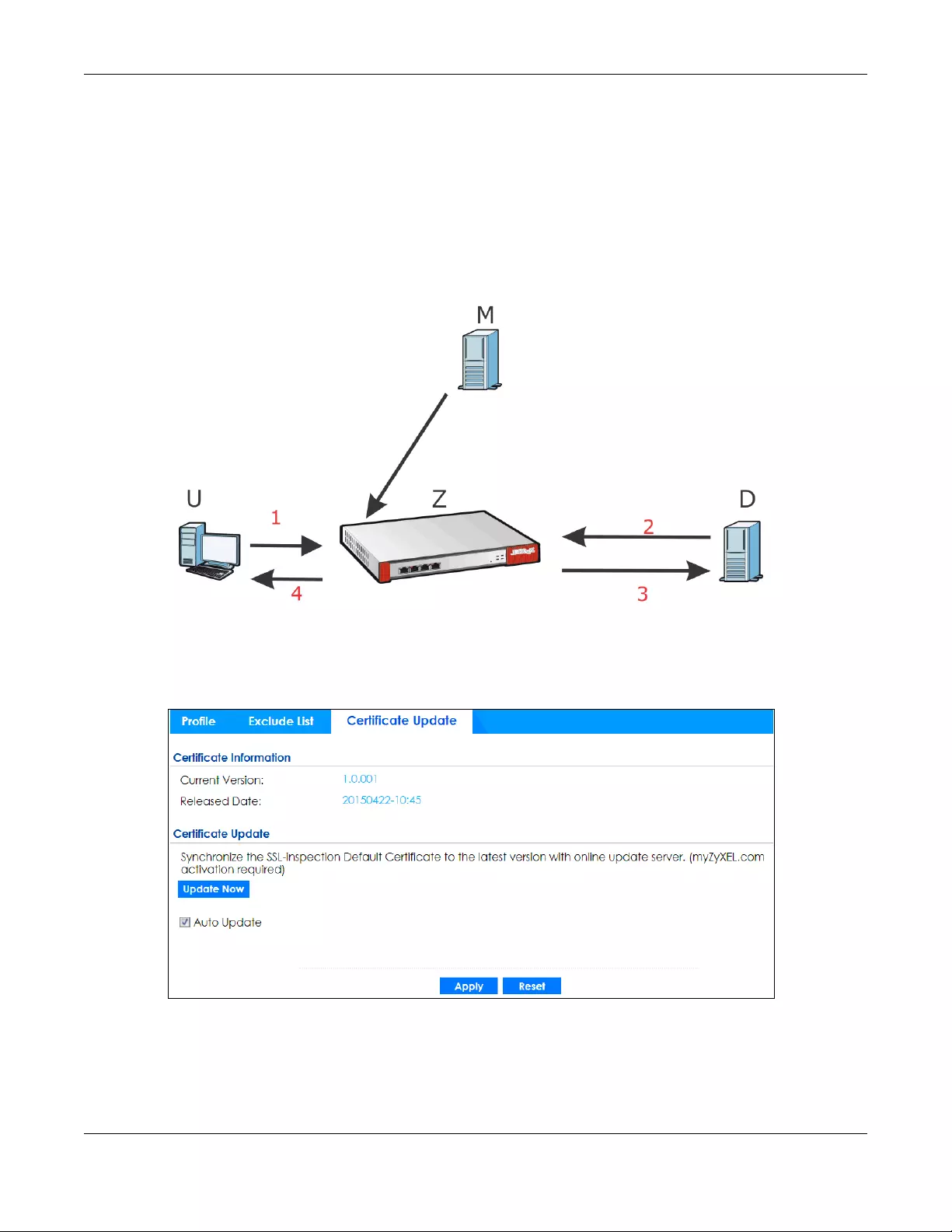
Chapter 37 SSL Inspection
ZyWALL USG FLEX Series User’s Guide
703
37.4 Certificate Update Screen
Use this screen to update the latest certificates of servers using SSL connections to the Zyxel Device
network. User U sends an SSL request to destination server D (1), via the Zyxel Device, Z. D replies (2); Z
intercepts the response from D and checks if the certificate has been previously signed. Z then replies to
D (3) and also to U (4). D’s latest certificate is stored at myZyxel (M) along with other server certificates
and can be downloaded to the Zyxel Device.
Figure 461 SSL Inspection Certificate Update Overview
Click Configuration > Security Service > SSL Inspection > Certificate Update to display the following
screen.
Figure 462 Configuration > Security Service > SSL Inspection > Certificate Update
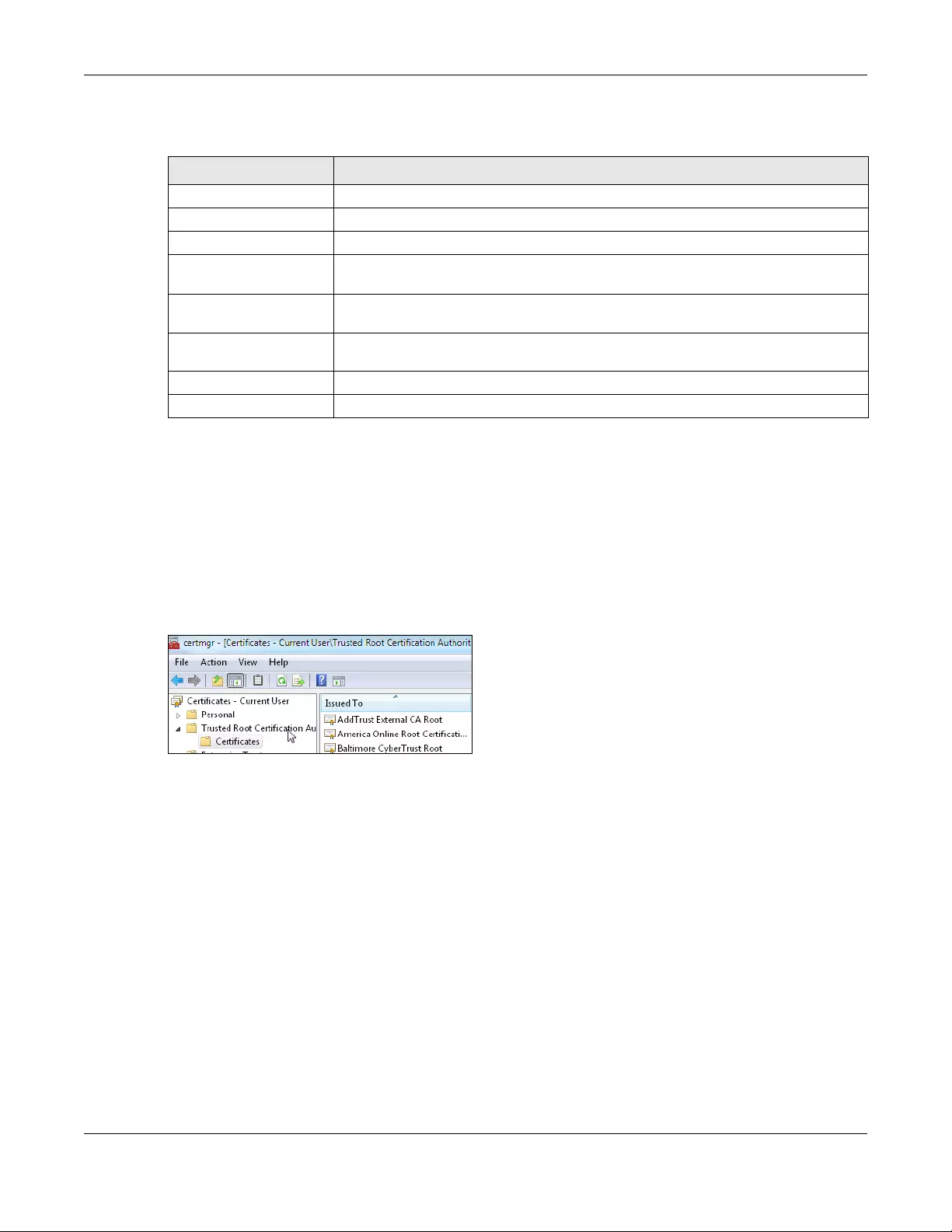
Chapter 37 SSL Inspection
ZyWALL USG FLEX Series User’s Guide
704
The following table describes the fields in this screen.
37.5 Install a CA Certificate in a Browser
Certificates used in SSL Inspection profiles should be installed in user web browsers. Do the following
steps to install a certificate in a computer with a Windows operating system (PC). First, save the
certificate to your computer.
1Run the certificate manager using certmgr.msc.
2Go to Trusted Root Certification Authorities > Certificates.
Table 286 Configuration > Security Service > SSL Inspection > Certificate Update
LABEL DESCRIPTION
Certificate Information
Current Version This displays the current certificate set version.
Released Date This field displays the date and time the current certificate set was released.
Certificate Update You should have Internet access and have activated SSL Inspection on the Zyxel
Device at myZyxel.
Update Now Click this button to download the latest certificate set (Windows, MAC OS X, and
Android) from the myZyxel and update it on the Zyxel Device.
Auto Update Select this to automatically have the Zyxel Device update the certificate set when a
new one becomes available on myZyxel.
Apply Click Apply to save your settings to the Zyxel Device.
Reset Click Reset to return to the profile summary page without saving any changes.
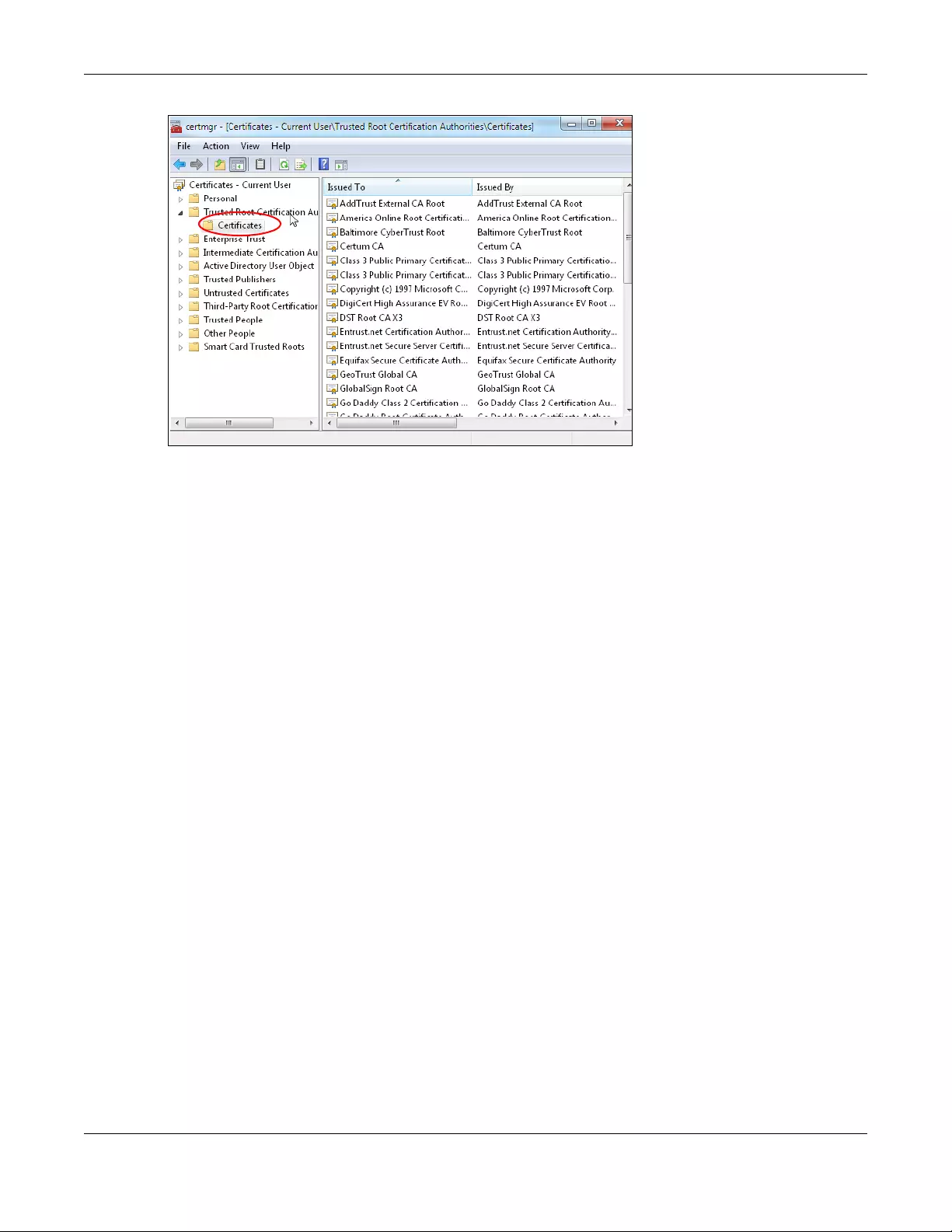
Chapter 37 SSL Inspection
ZyWALL USG FLEX Series User’s Guide
705
3From the main menu, select Action > All Tasks > Import and run the Certificate Import Wizard to install
the certificate on the PC.
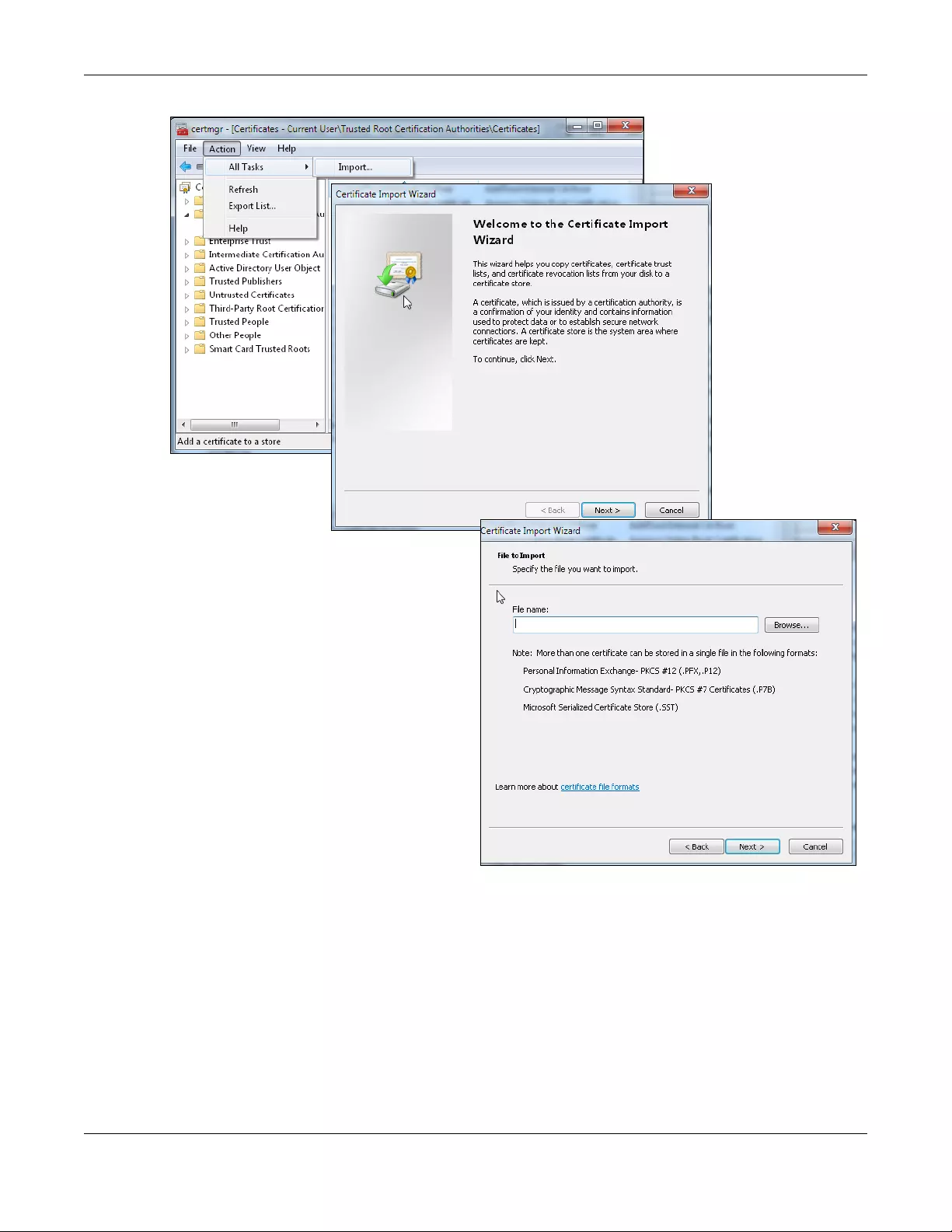
Chapter 37 SSL Inspection
ZyWALL USG FLEX Series User’s Guide
706
37.5.0.1 Firefox Browser
If you’re using a Firefox browser, in addition to the above you need to do the following to import a
certificate into the browser.
Click Tools > Options > Advanced > Encryption > View Certificates, click Import and enter the filename
of the certificate you want to import. See the browser's help for further information.

ZyWALL USG FLEX Series User’s Guide
707
CHAPTER 38
IP Exception
38.1 Overview
IP Exception allows incoming IP packets to bypass specific security services based on the packet’s
source or destination address. Bypassing a security service means the security service does not intercept
nor inspect the packet. IP Exception supports bypassing the following security services:
•Anti-Malware
• URL Threat Filter
• IDP (Intrusion Detection and Prevention)
38.2 The IP Exception Screen
Use this screen to view the IP exception list for the specified services. The Zyxel Device will not inspect
incoming packets that match the listed source and destination IP address(es) wit h the specified
services.
Click Configuration > Security Service > IP Exception to display the following screen. Use Add to put a
new entry in the list or Edit to change an existing one or Remove to delete an existing entry.
Figure 463 Configuration > Security Service > IP Exception

Chapter 38 IP Exception
ZyWALL USG FLEX Series User’s Guide
708
The following table describes the fields in this screen.
38.2.1 The IP Exception Add/Edit Screen
Use this screen to add or edit entries of IPv4 or IPv6 address in the IP exception list.
Click Configuration > Security Service > IP Exception > Add/Edit to display the following screen.
Figure 464 Configuration > Security Service > IP Exception > Add/Edit
Table 287 Configuration > Security Service > IP Exception
LABEL DESCRIPTION
IPv4/IPv6 Exception List Settings
Add Click this to create a new entry.
Edit Select an entry and click this to be able to modify it.
Remove Select an entry and click this to delete it.
#This is the entry’s index number in the list.
Name This field displays the descriptive name of this entry.
IPv4/IPv6 Source This field displays the source IP address (or address object) of incoming traffic. It displays any if
there is no restriction on the source IP address.
IPv4/IPv6
Destination
This field displays the destination IP address (or address object) of incoming traffic. It displays
any if there is no restriction on the destination IP address.
Service to Bypass This field displays which services will not inspect matched packets.
Log This field displays if the Zyxel Device will generate a log when the incoming traffic is in the
exception list.
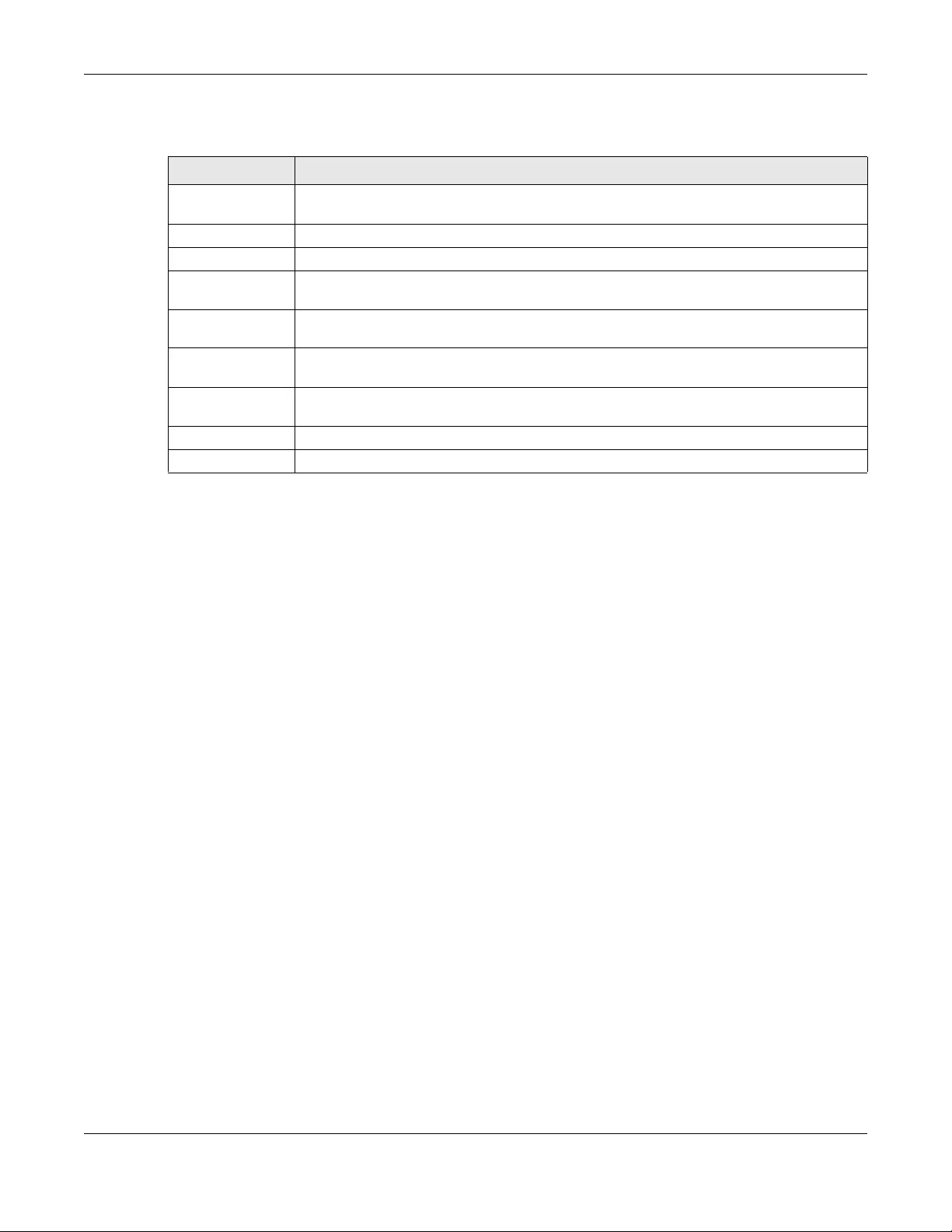
Chapter 38 IP Exception
ZyWALL USG FLEX Series User’s Guide
709
The following table describes the fields in this screen.
Table 288 Configuration > Security Service > IP Exception > Add/Edit
LABEL DESCRIPTION
Create New
Object
Use this to configure any new settings objects that you need to use in this screen.
Name Enter a descriptive name of this entry.
Description Enter the description for this entry. You can use up to 60 printable ASCII characters.
Source Select any or an address object of the source IP address for this entry. Select any so there’s no
restriction on the source IP address.
Destination Select any or an address object of the destination IP address for this entry. Select any so
there’s no restriction on the destination IP address.
Log Select Yes to have the Zyxel Device generate a log when the incoming traffic is in the
exception list. Otherwise, select No.
Service to Bypass Selected services do not inspect packets that match source/destination criteria above. Non-
selected services do inspect packets that match source/destination criteria above.
OK Click OK to save your customized settings and exit this screen.
Cancel Click Cancel to exit this screen without saving.
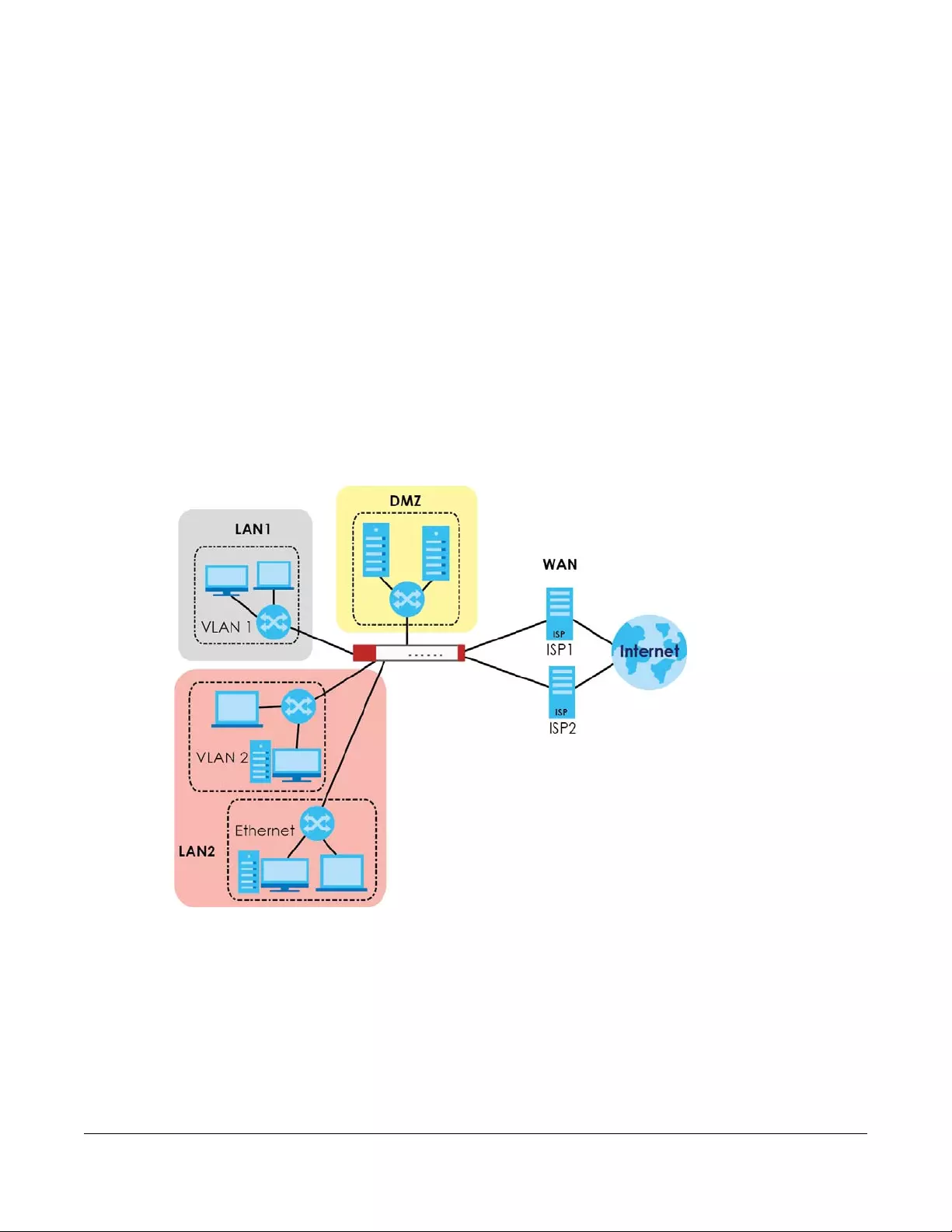
ZyWALL USG FLEX Series User’s Guide
710
CHAPTER 39
Object
39.1 Zones Overview
Set up zones to configure network security and network policies in the Zyxel Device. A zone is a group of
interfaces and/or VPN tunnels. The Zyxel Device uses zones instead of interfaces in many security and
policy settings, such as Secure Policies rules, Security Service, and remote management.
Zones cannot overlap. Each Ethernet interface, VLAN interface, bridge interface, PPPoE/PPTP interface
and VPN tunnel can be assigned to at most one zone. Virtual interfaces are automatically assigned to
the same zone as the interface on which they run.
Figure 465 Example: Zones
Use the Zone screens (see Section 39.8.2 on page 780) to manage the Zyxel Device’s zones.
39.1.1 What You Need to Know
Zones effectively divide traffic into three types--intra-zone traffic, inter-zone traffic, and extra-zone
traffic.
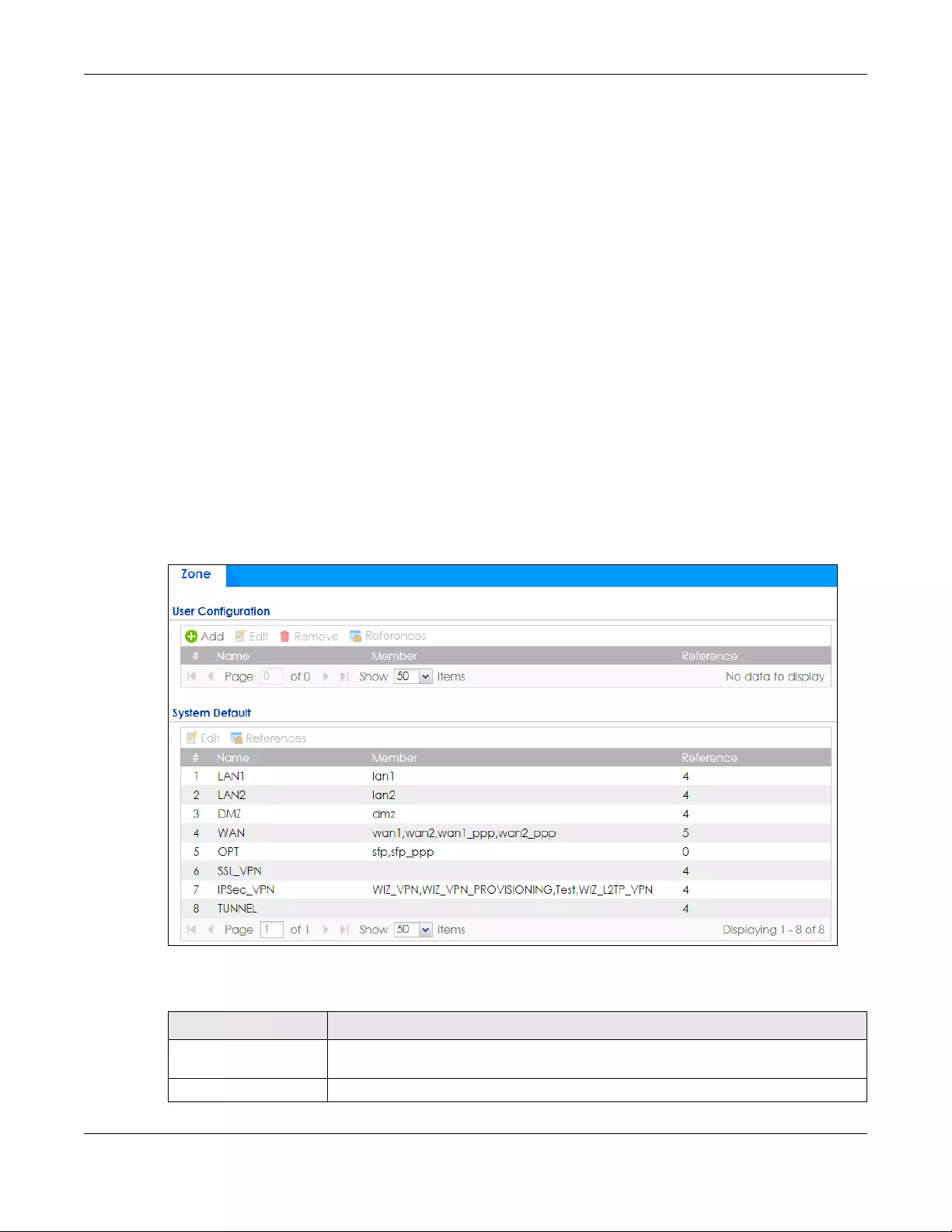
Chapter 39 Object
ZyWALL USG FLEX Series User’s Guide
711
Intra-zone Traffic
• Intra-zone traffic is traffic between interfaces or VPN tunnels in the same zone. For example, in Figure
465 on page 710, traffic between VLAN 2 and the Ethernet is intra-zone traffic.
Inter-zone Traffic
Inter-zone traffic is traffic between interfaces or VPN tunnels in different zones. For example, in Figure 465
on page 710, traffic between VLAN 1 and the Internet is inter-zone traffic. This is the normal case when
zone-based security and policy settings apply.
Extra-zone Traffic
• Extra-zone traffic is traffic to or from any interface or VPN tunnel that is not assigned to a zone. For
example, in Figure 465 on page 710, traffic to or from computer C is extra-zone traffic.
• Some zone-based security and policy settings may apply to extra-zone traffic, especially if you can
set the zone attribute in them to Any or All. See the specific feature for more information.
39.1.2 The Zone Screen
The Zone screen provides a summary of all zones. In addition, this screen allows you to add, edit, and
remove zones. To access this screen, click Configuration > Object > Zone.
Figure 466 Configuration > Object > Zone
The following table describes the labels in this screen.
Table 289 Configuration > Object > Zone
LABEL DESCRIPTION
User Configuration /
System Default
The Zyxel Device comes with pre-configured System Default zones that you cannot
delete. You can create your own User Configuration zones
Add Click this to create a new, user-configured zone.
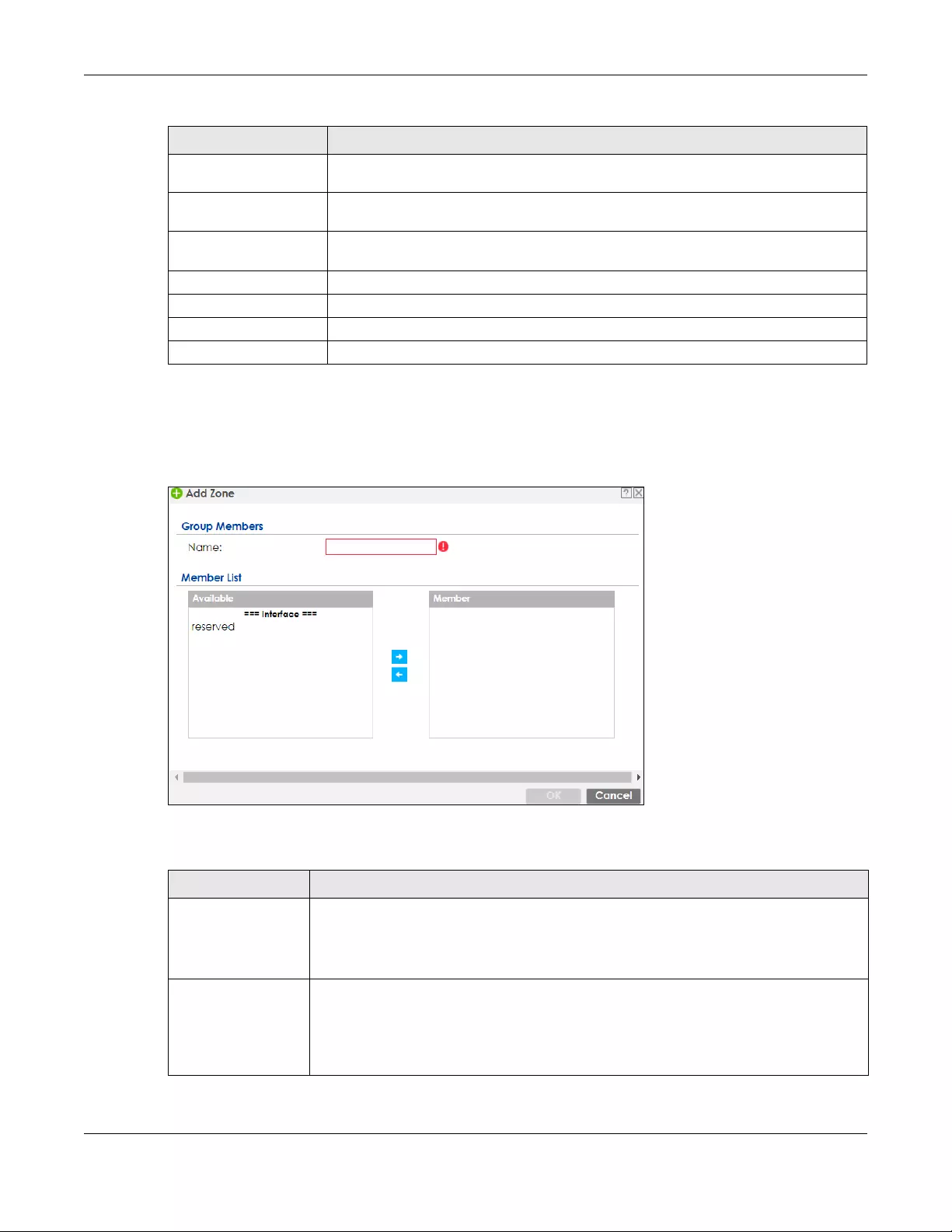
Chapter 39 Object
ZyWALL USG FLEX Series User’s Guide
712
39.1.2.1 Zone Edit
The Zone Edit screen allows you to add or edit a zone. To access this screen, go to the Zone screen (see
Section 39.8.2 on page 780), and click the Add icon or an Edit icon.
Figure 467 Configuration > Object > Zone > Add
The following table describes the labels in this screen.
Edit Double-click an entry or select it and click Edit to open a screen where you can modify
the entry’s settings.
Remove To remove a user-configured trunk, select it and click Remove. The Zyxel Device
confirms you want to remove it before doing so.
References Select an entry and click References to open a screen that shows which settings use the
entry. Click Refresh to update information in this screen.
#This field is a sequential value, and it is not associated with any interface.
Name This field displays the name of the zone.
Member This field displays the names of the interfaces that belong to each zone.
Reference This field displays the number of times an Object Reference is used in a policy.
Table 289 Configuration > Object > Zone (continued)
LABEL DESCRIPTION
Table 290 Configuration > Object > Zone > Add/Edit
LABEL DESCRIPTION
Name For a system default zone, the name is read only.
For a user-configured zone, type the name used to refer to the zone. You may use 1-31
alphanumeric characters, underscores (_), or dashes (-), but the first character cannot be
a number. This value is case-sensitive.
Member List Available lists the interfaces and VPN tunnels that do not belong to any zone. Select the
interfaces and VPN tunnels that you want to add to the zone you are editing, and click the
right arrow button to add them.
Member lists the interfaces and VPN tunnels that belong to the zone. Select any interfaces
that you want to remove from the zone, and click the left arrow button to remove them.

Chapter 39 Object
ZyWALL USG FLEX Series User’s Guide
713
39.2 User/Group Overview
This section describes how to set up user accounts, user groups, and user settings for the Zyxel Device.
You can also set up rules that control when users have to log in to the Zyxel Device before the Zyxel
Device routes traffic for them.
• The User screen (see Section 39.13.1 on page 822) provides a summary of all user accounts.
• The Group screen (see Section 39.2.5 on page 722) provides a summary of all user groups. In addition,
this screen allows you to add, edit, and remove user groups. User groups may consist of access users
and other user groups. You cannot put admin users in user groups.
•The Setting screen (see Section 39.2.6 on page 724) controls default settings, login settings, lockout
settings, and other user settings for the Zyxel Device. You can also use this screen to specify when
users must log in to the Zyxel Device before it routes traffic for them.
•The MAC Address screen (see Section 39.2.7 on page 729) allows you to configure the MAC
addresses or OUI (Organizationally Unique Identifier) of wireless clients for MAC authentication using
the local user database. The OUI is the first three octets in a MAC address and uniquely identifies the
manufacturer of a network device.
39.2.1 What You Need To Know
User Account
A user account defines the privileges of a user logged into the Zyxel Device. User accounts are used in
security policies and application patrol, in addition to controlling access to configuration and services in
the Zyxel Device.
User Types
These are the types of user accounts the Zyxel Device uses.
OK Click OK to save your customized settings and exit this screen.
Cancel Click Cancel to exit this screen without saving.
Table 290 Configuration > Object > Zone > Add/Edit (continued)
LABEL DESCRIPTION
Table 291 Types of User Accounts
TYPE ABILITIES LOGIN METHOD(S)
Admin Users
admin Change Zyxel Device configuration (web, CLI) WWW, TELNET, SSH, FTP, Console
limited-admin Look at Zyxel Device configuration (web, CLI)
Perform basic diagnostics (CLI)
WWW, TELNET, SSH, Console
Access Users
user Access network services
Browse user-mode commands (CLI)
WWW, TELNET, SSH
guest Access network services WWW
ext-user External user account WWW

Chapter 39 Object
ZyWALL USG FLEX Series User’s Guide
714
Note: The default admin account is always authenticated locally, regardless of the
authentication method setting. (See Chapter 39 on page 794 for more information
about authentication methods.)
Ext-User Accounts
Set up an ext-user account if the user is authenticated by an external server and you want to set up
specific policies for this user in the Zyxel Device. If you do not want to set up policies for this user, you do
not have to set up an ext-user account.
All ext-user users should be authenticated by an external server, such as AD, LDAP or RADIUS. If the Zyxel
Device tries to use the local database to authenticate an ext-user, the authentication attempt always
fails. (This is related to AAA servers and authentication methods, which are discussed in those chapters in
this guide.)
Note: If the Zyxel Device tries to authenticate an ext-user using the local database, the
attempt always fails.
Once an ext-user user has been authenticated, the Zyxel Device tries to get the user type (see Table 291
on page 713) from the external server. If the external server does not have the information, the Zyxel
Device sets the user type for this session to User.
For the rest of the user attributes, such as reauthentication time, the Zyxel Device checks the following
places, in order.
1User account in the remote server.
2User account (Ext-User) in the Zyxel Device.
3Default user account for AD users (ad-users), LDAP users (ldap-users) or RADIUS users (radius-users) in
the Zyxel Device.
See Setting up User Attributes in an External Server for a list of attributes and how to set up the attributes
in an external server.
Ext-Group-User Accounts
Ext-Group-User accounts work are similar to ext-user accounts but allow you to group users by the value
of the group membership attribute configured for the AD or LDAP server. See Section 39.9.5.1 on page
788 for more on the group membership attribute.
Dynamic-Guest Accounts
Dynamic guest accounts are guest accounts, but are created dynamically and stored in the Zyxel
Device’s local user database. A dynamic guest account has a dynamically-created user name and
ext-group-user External group user account WWW
guest-manager Create dynamic guest accounts WWW
dynamic-guest Access network services Hotspot Portal
Table 291 Types of User Accounts (continued)
TYPE ABILITIES LOGIN METHOD(S)

Chapter 39 Object
ZyWALL USG FLEX Series User’s Guide
715
password. A dynamic guest account user can access the Zyxel Device’s services only within a given
period of time and will become invalid after the expiration date/time.
There are three types of dynamic guest accounts depending on how they are created or
authenticated: billing-users, ua-users and trial-users.
billing-users are guest account created with the guest manager account or an external printer and
paid by cash or created and paid via the on-line payment service. ua-users are users that log in from
the user agreement page. trial-users are free guest accounts that are created with the Free Time
function.
User Groups
User groups may consist of user accounts or other user groups. Use user groups when you want to create
the same rule for several user accounts, instead of creating separate rules for each one.
Note: You cannot put access users and admin users in the same user group.
Note: You cannot put the default admin account into any user group.
The sequence of members in a user group is not important.
User Awareness
By default, users do not have to log into the Zyxel Device to use the network services it provides. The
Zyxel Device automatically routes packets for everyone. If you want to restrict network services that
certain users can use via the Zyxel Device, you can require them to log in to the Zyxel Device first. The
Zyxel Device is then ‘aware’ of the user who is logged in and you can create ‘user-aware policies’ that
define what services they can use. See Section 39.2.8 on page 731 for a user-aware login example.
Finding Out More
•See Section 39.2.8 on page 731 for some information on users who use an external authentication
server in order to log in.
• The Zyxel Device supports TTLS using PAP so you can use the Zyxel Device’s local user database to
authenticate users with WPA or WPA2 instead of needing an external RADIUS server.
39.2.2 User/Group User Summary Screen
The User screen provides a summary of all user accounts. To access this screen, login to the Web
Configurator, and click Configuration > Object > User/Group.
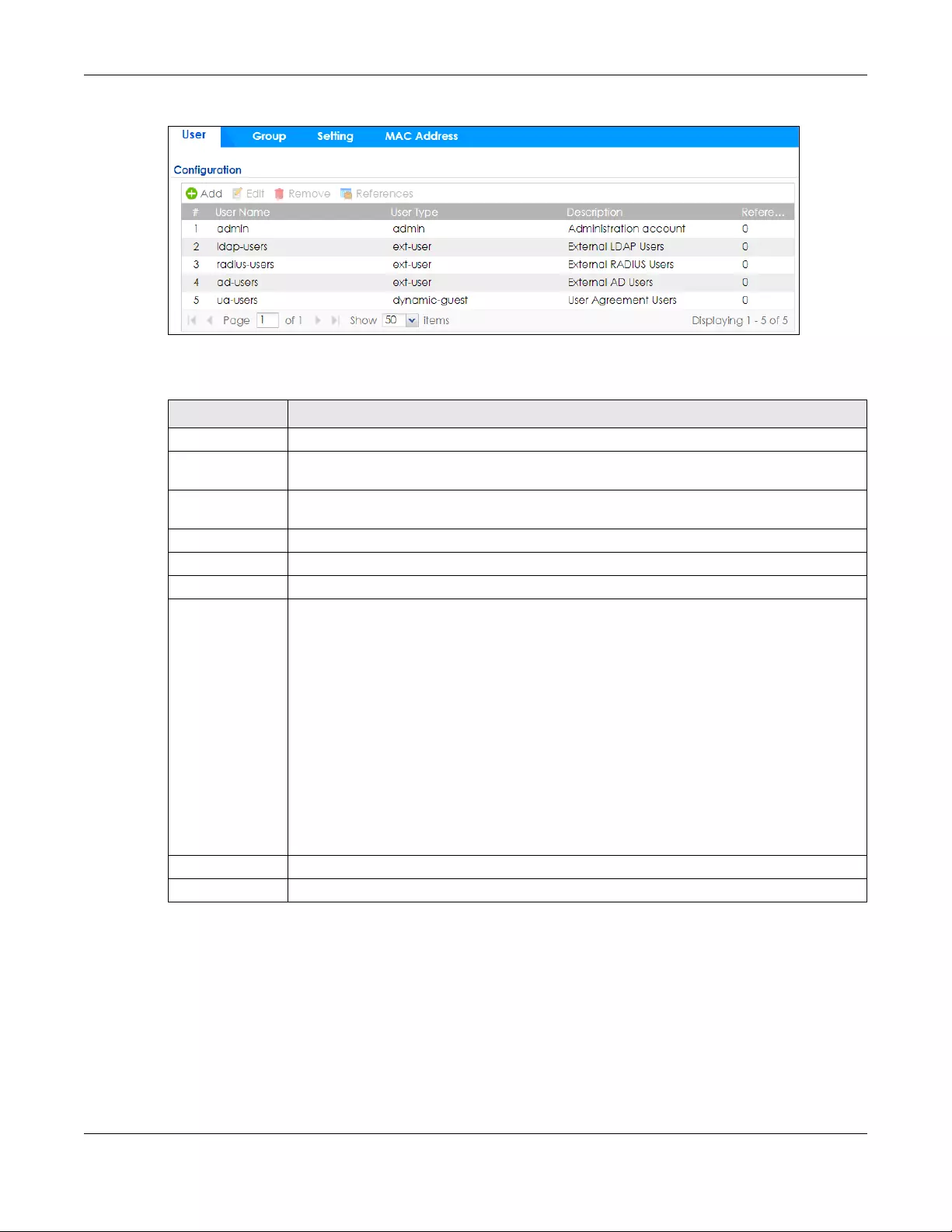
Chapter 39 Object
ZyWALL USG FLEX Series User’s Guide
716
Figure 468 Configuration > Object > User/Group > User
The following table describes the labels in this screen.
39.2.3 User Add/Edit General Screen
The User Add/Edit General screen allows you to create a new user account or edit an existing one.
39.2.3.1 Rules for User Names
Enter a user name from 1 to 31 characters.
The user name can only contain the following characters:
Table 292 Configuration > Object > User/Group > User
LABEL DESCRIPTION
Add Click this to create a new entry.
Edit Double-click an entry or select it and click Edit to open a screen where you can modify the
entry’s settings.
Remove To remove an entry, select it and click Remove. The Zyxel Device confirms you want to remove
it before doing so.
References Select an entry and click References to open a screen that shows which settings use the entry.
#This field is a sequential value, and it is not associated with a specific user.
User Name This field displays the user name of each user.
User Type This field displays the types of user accounts the Zyxel Device uses:
•admin - this user can look at and change the configuration of the Zyxel Device
•limited-admin - this user can look at the configuration of the Zyxel Device but not to
change it
•dynamic-guest - this user has access to the Zyxel Device’s services but cannot look at the
configuration.
•user - this user has access to the Zyxel Device’s services and can also browse user-mode
commands (CLI).
•guest - this user has access to the Zyxel Device’s services but cannot look at the
configuration
•ext-user - this user account is maintained in a remote server, such as RADIUS or LDAP. See
Ext-User Accounts on page 714 for more information about this type.
•ext-group-user - this user account is maintained in a remote server, such as RADIUS or
LDAP. See Ext-Group-User Accounts on page 714 for more information about this type.
•guest-manager - this user can log in via the web configurator login screen and create
dynamic guest accounts using the Account Generator screen that pops up.
Description This field displays the description for each user.
Reference This displays the number of times an object reference is used in a profile.
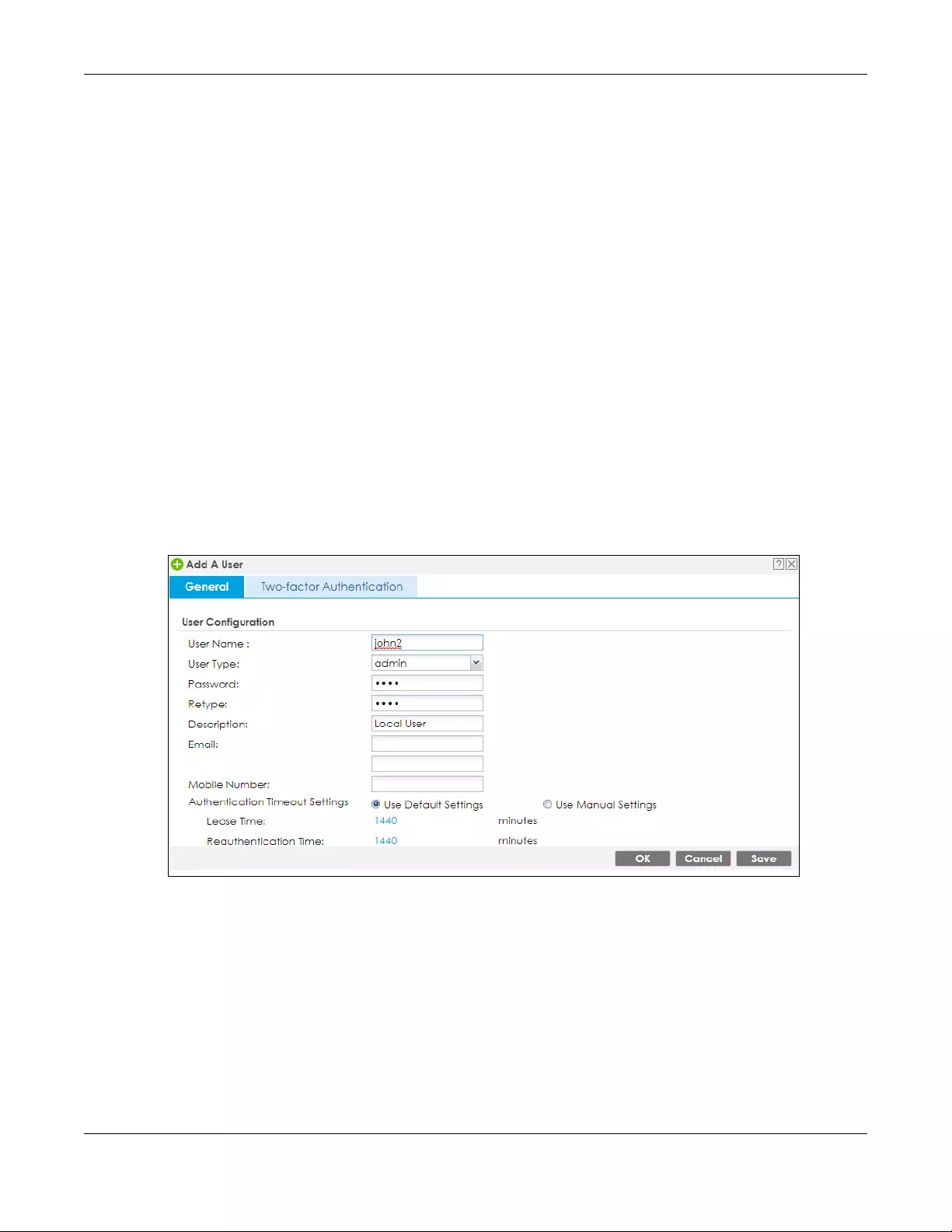
Chapter 39 Object
ZyWALL USG FLEX Series User’s Guide
717
• Alphanumeric A-z 0-9 (there is no unicode support)
• _ [underscores]
• - [dashes]
The first character must be alphabetical (A-Z a-z), an underscore (_), or a dash (-). Other limitations on
user names are:
• User names are case-sensitive. If you enter a user 'bob' but use 'BOB' when connecting via CIFS or FTP,
it will use the account settings used for 'BOB' not ‘bob’.
• User names have to be different than user group names.
• Here are the reserved user names:
To access this screen, go to the User screen (see Section 39.13.1 on page 822), and click either the Add
icon or an Edit icon.
Figure 469 Configuration > Object > User/Group > User > Add/Edit_General
•adm •admin •any •bin •daemon
•debug • devicehaecived •ftp •games •halt
•ldap-users •lp •mail •news •nobody
• operator • radius-users •root •shutdown •sshd
•sync • uucp •zyxel

Chapter 39 Object
ZyWALL USG FLEX Series User’s Guide
718
The following table describes the labels in this screen.
Table 293 Configuration > Object > User/Group > User > Add/Edit_General
LABEL DESCRIPTION
User Name Type the user name for this user account. You may use 1-31 alphanumeric characters,
underscores(_), or dashes (-), but the first character cannot be a number. This value is case-
sensitive. User names have to be different than user group names, and some words are
reserved. See Section 39.2.3.1 on page 716.
User Type This field displays the types of user accounts the Zyxel Device uses:
•admin - this user can look at and change the configuration of the Zyxel Device
•limited-admin - this user can look at the configuration of the Zyxel Device but not to
change it
•user - this user has access to the Zyxel Device’s services and can also browse user-mode
commands (CLI).
•guest - this user has access to the Zyxel Device’s services but cannot look at the
configuration.
•ext-user - this user account is maintained in a remote server, such as RADIUS or LDAP.
See Ext-User Accounts on page 714 for more information about this type.
•ext-group-user - this user account is maintained in a remote server, such as RADIUS or
LDAP. See Ext-Group-User Accounts on page 714 for more information about this type.
Password This field is not available if you select the ext-user or ext-group-user type.
Enter a password of from 1 to 64 characters for this user account. If you selected Enable
Password Complexity in Configuration > Object > User/Group > Setting, it must consist of at
least 8 characters and at most 64. At least 1 character must be a number, at least 1 a lower
case letter, at least 1 an upper case letter and at least 1 a special character from the
keyboard, such as !@#$%^&*()_+.
Retype This field is not available if you select the ext-user or ext-group-user type.
Group Identifier This field is available for a ext-group-user type user account.
Specify the value of the AD or LDAP server’s Group Membership Attribute that identifies the
group to which this user belongs.
Associated AAA
Server Object
This field is available for a ext-group-user type user account. Select the AAA server to use to
authenticate this account’s users.
Description Enter the description of each user, if any. You can use up to 60 printable ASCII characters.
Default descriptions are provided.
Email Type one or more valid email addresses for this user so that email messages can be sent to
this user if required. A valid email address must contain the @ character. For example, this is
a valid email address: abc@example.com.
Mobile Number Type a valid mobile telephone number for this user so that SMS messages can be sent to this
user if required. A valid mobile telephone number can be up to 20 characters in length,
including the numbers 1~9 and the following characters in the square brackets [+*#()-].
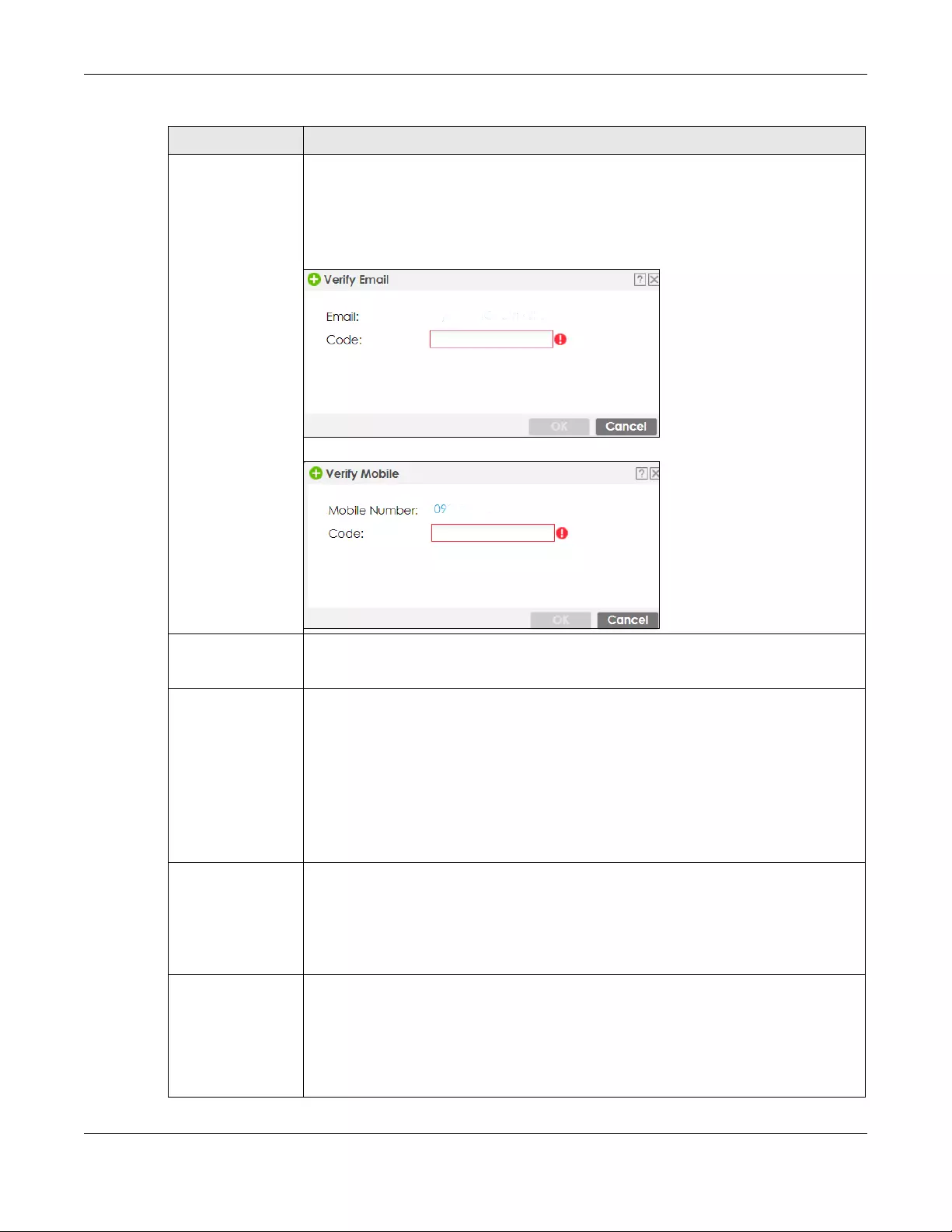
Chapter 39 Object
ZyWALL USG FLEX Series User’s Guide
719
Send Code This button is available when the user type is admin or limited-admin.
Click this and an authorization email or SMS message with a code of six digits will be sent to
the email addresses or mobile telephone number you put in.
Enter the verification code to verify your email addresses or mobile telephone number.
Figure 470 Verification Code for Email
Figure 471 Verification Code for Mobile Telephone Number
Authentication
Timeout Settings
If you want the system to use default settings, select Use Default Settings. If you want to set
authentication timeout to a value other than the default settings, select Use Manual Settings
then fill your preferred values in the fields that follow.
Lease Time If you select Use Default Settings in the Authentication Timeout Settings field, the default
lease time is shown.
If you select Use Manual Settings, you need to enter the number of minutes this user has to
renew the current session before the user is logged out. You can specify 1 to 1440 minutes.
You can enter 0 to make the number of minutes unlimited. Admin users renew the session
every time the main screen refreshes in the Web Configurator. Access users can renew the
session by clicking the Renew button on their screen. If you allow access users to renew time
automatically (see Section 39.2.6 on page 724), the users can select this check box on their
screen as well. In this case, the session is automatically renewed before the lease time
expires.
Reauthentication
Time
If you select Use Default Settings in the Authentication Timeout Settings field, the default
lease time is shown.
If you select Use Manual Settings, you need to type the number of minutes this user can be
logged into the Zyxel Device in one session before the user has to log in again. You can
specify 1 to 1440 minutes. You can enter 0 to make the number of minutes unlimited. Unlike
Lease Time, the user has no opportunity to renew the session without logging out.
User VLAN ID This field is available for a ext-group-user type user account.
Select this option to enable dynamic VLAN assignment on the Zyxel Device. When a user is
authenticated successfully, all data traffic from this user is tagged with the VLAN ID number
you specify here.
This allows you to assign a user of the ext-group-user type to a specific VLAN based on the
user credentials instead of using an AAA server.
Table 293 Configuration > Object > User/Group > User > Add/Edit_General (continued)
LABEL DESCRIPTION

Chapter 39 Object
ZyWALL USG FLEX Series User’s Guide
720
39.2.4 User Add/Edit Two-factor Authentication Screen
The User Add/Edit Two-factor Authentication screen allows you to create two-factor security for VPN
access or admin access for this user to the Zyxel Device.
Two-factor authentication adds an extra layer of security for users logging into the Zyxel Device. When
two-factor authentication is enabled, a user has to first enter their username and password, and then
click on a temporary link or enter a one-time password when logging in.
You can enable two-factor authentication for users who are logging into the Zyxel Device to create a
VPN tunnel (VPN access), and for administrator and limited admin users who are logging into the Web
Configurator or CLI (admin access) to configure the Zyxel Device.
You must first enable two-factor authentication on the Zyxel Device in Object > Auth. Method > Two-
factor Authentication > VPN Access and Object > Auth. Method > Two-factor Authentication > Admin
Access. See Section 39.10.4 on page 797 and Section 39.10.6 on page 801 for more prerequisites and
other information.
In Object > User/Group > User, click Add to create a new entry or select an entry and click Edit to modify the entry.
Configuration
Validation
Use a user account from the group specified above to test if the configuration is correct.
Enter the account’s user name in the User Name field and click Test.
OK Click OK to save your changes back to the Zyxel Device and close the screen.
Cancel Click Cancel to exit this screen without saving your changes.
Save This button is only available when adding a new user. Click Save to save your changes back
to the Zyxel Device and then go to the Two-factor Authentication screen.
Table 293 Configuration > Object > User/Group > User > Add/Edit_General (continued)
LABEL DESCRIPTION
Table 294 Two Factor Authentication Methods
ACCESS TYPE TWO-FACTOR AUTHENTICATION METHODS FACTOR 2 PASSWORD
VPN SMS Code
VPN Email Link
Admin SMS Code
Admin Email Link
Admin Google Authenticator app Code
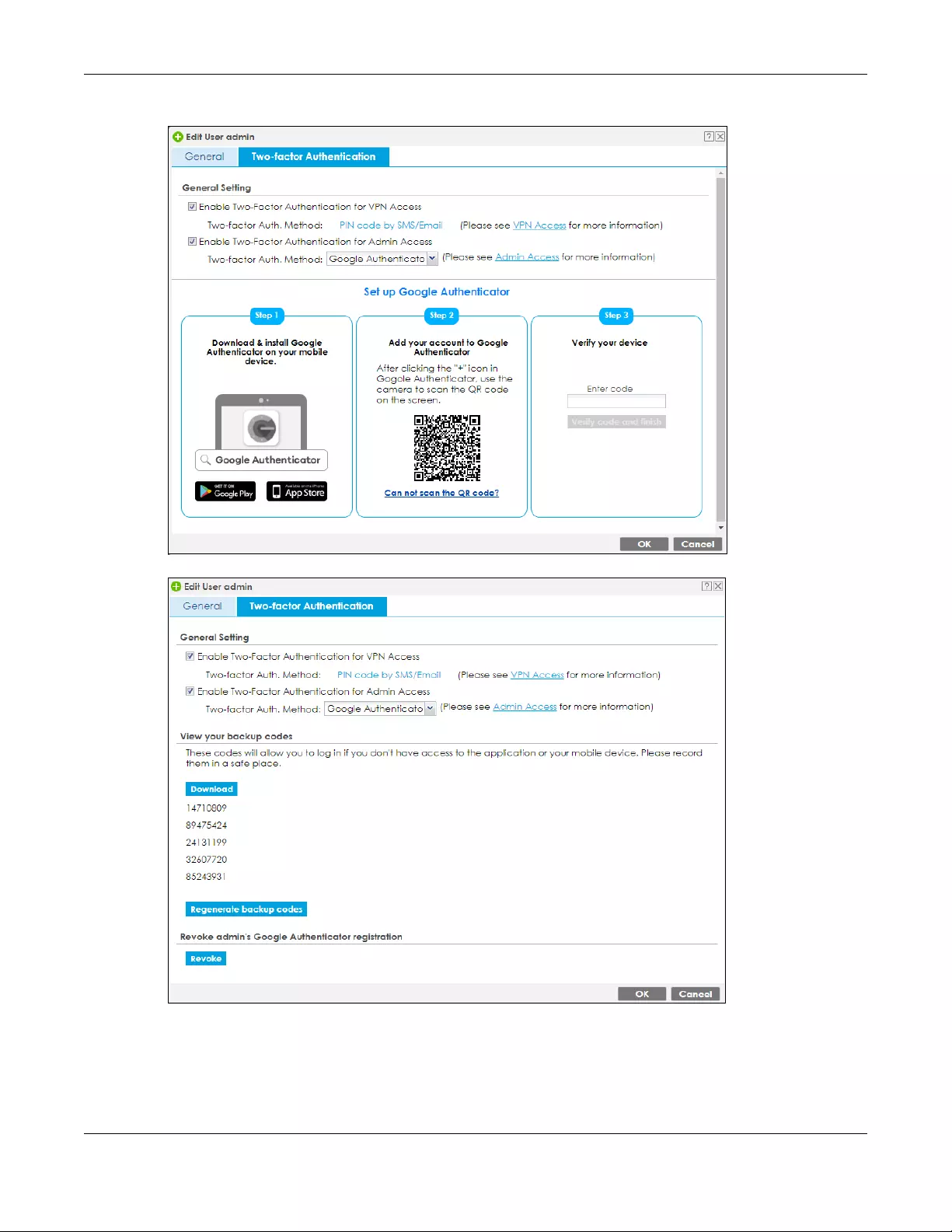
Chapter 39 Object
ZyWALL USG FLEX Series User’s Guide
721
Figure 472 Configuration > Object > User/Group > User > Add/Edit_Two-factor Authentication
Figure 473 Configuration > Object > User/Group > User > Add/Edit_Two-factor Authentication_Verified
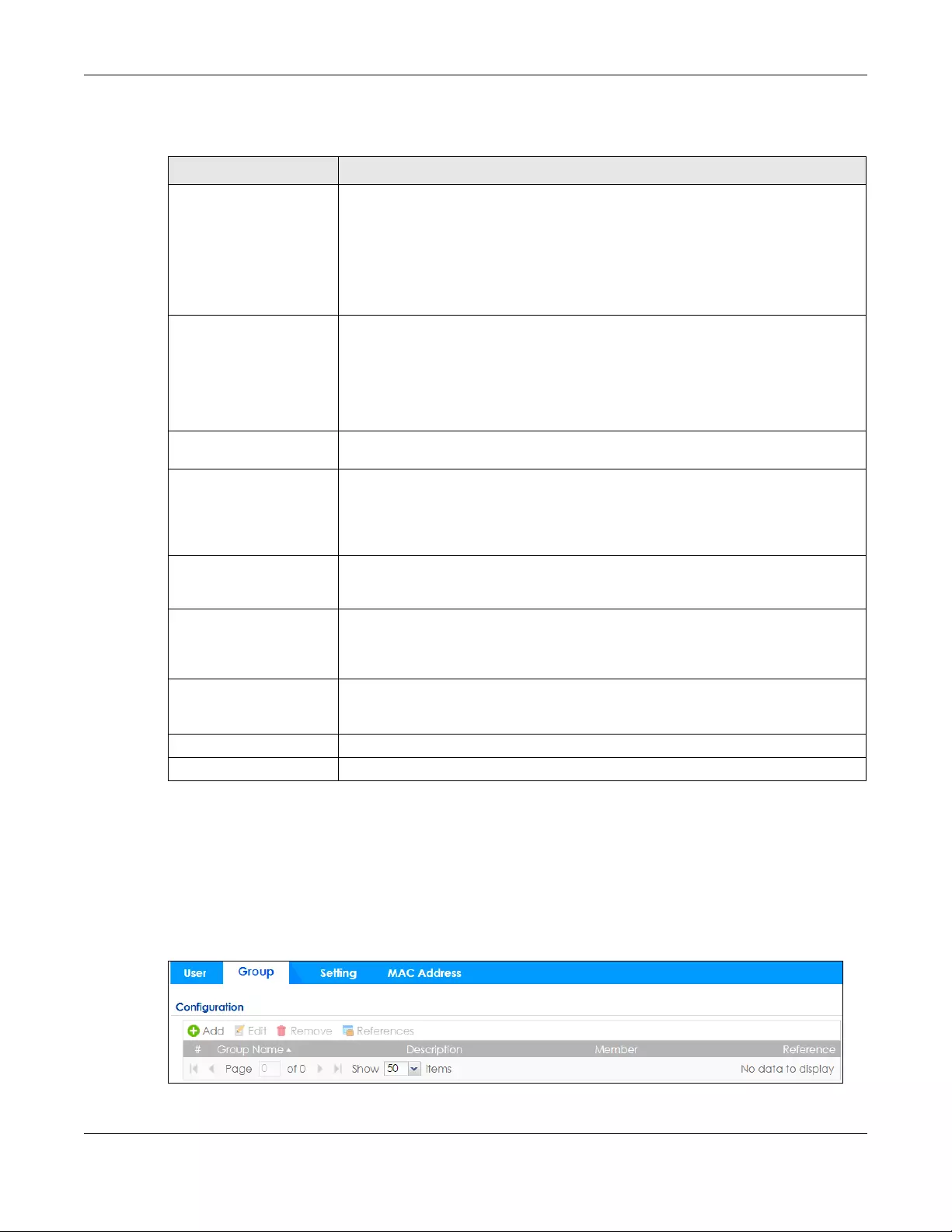
Chapter 39 Object
ZyWALL USG FLEX Series User’s Guide
722
The following table describes the labels in this screen.
39.2.5 User/Group Group Summary Screen
User groups consist of access users and other user groups. You cannot put admin users in user groups.
The Group screen provides a summary of all user groups. In addition, this screen allows you to add, edit,
and remove user groups. To access this screen, login to the Web Configurator, and click Configuration >
Object > User/Group > Group.
Figure 474 Configuration > Object > User/Group > Group
Table 295 Configuration > Object > User/Group > User > Add_Two-factor Authentication
LABEL DESCRIPTION
Enable Two-factor
Authentication for VPN
Access.
Select this to require two-factor authentication for this user to use a pre-configured
VPN tunnel for secure access to a network behind the Zyxel Device. Select the types
of VPN allowed in Object > Auth. Method > Two-factor Authentication > VPN Access.
You may choose from:
• SSL VPN Acces s
• IPSec VP N Access
•L2TP/IPSec VPN Access.
Enable Two-factor
Authentication for Admin
Access.
Select this to require two-factor authentication for an admin user to access the Zyxel
Device. Select the types of access allowed in Object > Auth. Method > Two-factor
Authentication > Admin Access. You may choose from:
•Web
•SSH
•TELNET
Two-factor Auth. Method Select Default or User Defined and select from PIN code by SMS/Email or Google
Authenticator
Set up Google
Authenticator
If you chose Google Authenticator for offline two-factor authentication, on your
mobile device, go to an app store to download Google Authenticator. To add your
account to Google Authenticator, press the plus (+) icon, select Scan Barcode, then
use your mobile device's camera to scan the barcode. Finally enter the verification
code you receive on your mobile device in Verify your device.
View your backup codes You see this after successful Google authentication. In the event that you do not have
access to email or your mobile device, click Download to create backup codes as
second-factor authentication. Make sure to put them in a safe place.
Verify your device In the event that you do not have access to email or your mobile device, enter a
backup code here as second factor authentication. You can use each code only
once. If you generate a new set of backup codes (Regenerate backup codes), the
old set become obsolete.
Revoke Click this to cancel Google authentication as second-factor authentication for Admin
Access. You must then use a PIN code by SMS or email as second-factor
authentication instead.
OK Click OK to save your changes back to the Zyxel Device and close the screen.
Cancel Click Cancel to exit this screen without saving your changes.
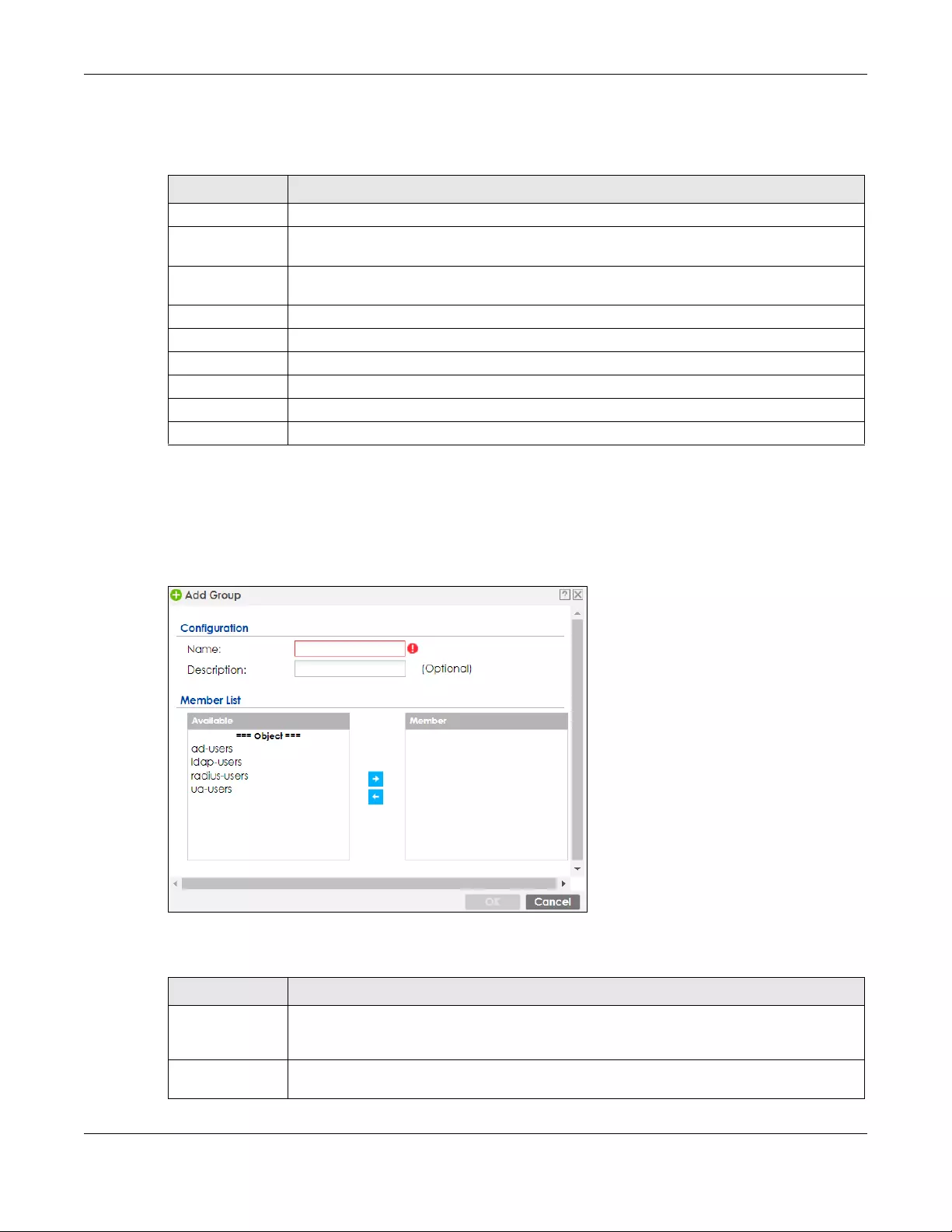
Chapter 39 Object
ZyWALL USG FLEX Series User’s Guide
723
The following table describes the labels in this screen. See Section 39.2.5.1 on page 723 for more
information as well.
39.2.5.1 Group Add/Edit Screen
The Group Add/Edit screen allows you to create a new user group or edit an existing one. To access this
screen, go to the Group screen (see Section 39.2.5 on page 722), and click either the Add icon or an
Edit icon.
Figure 475 Configuration > Object > User/Group > Group > Add
The following table describes the labels in this screen.
Table 296 Configuration > Object > User/Group > Group
LABEL DESCRIPTION
Add Click this to create a new entry.
Edit Double-click an entry or select it and click Edit to open a screen where you can modify the
entry’s settings.
Remove To remove an entry, select it and click Remove. The Zyxel Device confirms you want to remove
it before doing so. Removing a group does not remove the user accounts in the group.
References Select an entry and click References to open a screen that shows which settings use the entry.
#This field is a sequential value, and it is not associated with a specific user group.
Group Name This field displays the name of each user group.
Description This field displays the description for each user group.
Member This field lists the members in the user group. Each member is separated by a comma.
Reference This displays the number of times an object reference is used in a profile.
Table 297 Configuration > Object > User/Group > Group > Add
LABEL DESCRIPTION
Name Type the name for this user group. You may use 1-31 alphanumeric characters,
underscores(_), or dashes (-), but the first character cannot be a number. This value is case-
sensitive. User group names have to be different than user names.
Description Enter the description of the user group, if any. You can use up to 60 characters, punctuation
marks, and spaces.

Chapter 39 Object
ZyWALL USG FLEX Series User’s Guide
724
39.2.6 User/Group Setting Screen
The Setting screen controls default settings, login settings, lockout settings, and other user settings for the
Zyxel Device. You can also use this screen to specify when users must log in to the Zyxel Device before it
routes traffic for them.
To access this screen, login to the Web Configurator, and click Configuration > Object > User/Group >
Setting.
Member List The Member list displays the names of the users and user groups that have been added to the
user group. The order of members is not important. Select users and groups from the Available
list that you want to be members of this group and move them to the Member list. You can
double-click a single entry to move it or use the [Shift] or [Ctrl] key to select multiple entries and
use the arrow button to move them.
Move any members you do not want included to the Available list.
OK Click OK to save your changes back to the Zyxel Device.
Cancel Click Cancel to exit this screen without saving your changes.
Table 297 Configuration > Object > User/Group > Group > Add (continued)
LABEL DESCRIPTION

Chapter 39 Object
ZyWALL USG FLEX Series User’s Guide
725
Figure 476 Configuration > Object > User/Group > Setting
The following table describes the labels in this screen.
Table 298 Configuration > Object > User/Group > Setting
LABEL DESCRIPTION
User Authentication Timeout Settings
Default Authentication Timeout
Settings
These authentication timeout settings are used by default when you create a
new user account. They also control the settings for any existing user accounts
that are set to use the default settings. You can still manually configure any user
account’s authentication timeout settings.
Edit Double-click an entry or select it and click Edit to open a screen where you can
modify the entry’s settings.

Chapter 39 Object
ZyWALL USG FLEX Series User’s Guide
726
#This field is a sequential value, and it is not associated with a specific entry.
User Type These are the kinds of user account the Zyxel Device supports.
•admin - this user can look at and change the configuration of the Zyxel
Device
•limited-admin - this user can look at the configuration of the Zyxel Device
but not to change it
•user - this user has access to the Zyxel Device’s services but cannot look at
the configuration
•guest - this user has access to the Zyxel Device’s services but cannot look
at the configuration
•ext-user - this user account is maintained in a remote server, such as RADIUS
or LDAP. See Ext-User Accounts on page 714 for more information about this
type.
•ext-group-user - this user account is maintained in a remote server, such as
RADIUS or LDAP. See Ext-Group-User Accounts on page 714 for more
information about this type.
Lease Time This is the default lease time in minutes for each type of user account. It defines
the number of minutes the user has to renew the current session before the user
is logged out.
Admin users renew the session every time the main screen refreshes in the Web
Configurator. Access users can renew the session by clicking the Renew button
on their screen. If you allow access users to renew time automatically (see
Section 39.2.6 on page 724), the users can select this check box on their screen
as well. In this case, the session is automatically renewed before the lease time
expires.
Reauthentication Time This is the default reauthentication time in minutes for each type of user
account. It defines the number of minutes the user can be logged into the Zyxel
Device in one session before having to log in again. Unlike Lease Time, the user
has no opportunity to renew the session without logging out.
Miscellaneous Settings
Allow renewing lease time
automatically Select this check box if access users can renew lease time automatically, as well
as manually, simply by selecting the Updating lease time automatically check
box on their screen.
Enable user idle detection This is applicable for access users.
Select this check box if you want the Zyxel Device to monitor how long each
access user is logged in and idle (in other words, there is no traffic for this access
user). The Zyxel Device automatically logs out the access user once the User idle
timeout has been reached.
User idle timeout This is applicable for access users.
This field is effective when Enable user idle detection is checked. Type the
number of minutes each access user can be logged in and idle before the Zyxel
Device automatically logs out the access user.
Login Security
Password must changed
every (days): Enter how often users must change their password when they log into the Zyxel
Device. You can choose from once a day to once a year.
Password reset link (FQDN/
IP): Associate the password expiration to a specific Zyxel Device. Default is this Zyxel
Device (myrouter) or select Custom and enter the IP address or Fully Qualified
Domain Name (FQDN).
Enable Password
Complexity Select this to enforce the following conditions in a user password. Requiring a
strong password is good for security. The conditions are that the password must
consist of at least 8 characters and at most 64. At least 1 character must be a
number, at least 1 a lower case letter, at least 1 an upper case letter and at
least 1 a special character from the keyboard, such as !@#$%^&*()_+.
Table 298 Configuration > Object > User/Group > Setting (continued)
LABEL DESCRIPTION

Chapter 39 Object
ZyWALL USG FLEX Series User’s Guide
727
39.2.6.1 Default User Authentication Timeout Settings Edit Screens
The Default Authentication Timeout Settings Edit screen allows you to set the default authentication
timeout settings for the selected type of user account. These default authentication timeout settings
also control the settings for any existing user accounts that are set to use the default settings. You can
still manually configure any user account’s authentication timeout settings.
To access this screen, go to the Configuration > Object > User/Group > Setting screen (see Section 39.2.6
on page 724), and click one of the Default Authentication Timeout Settings section’s Edit icons.
Figure 477 Configuration > Object > User/Group > Setting > Edit
User Logon Settings
Limit the number of
simultaneous logons for
administration account
Select this check box if you want to set a limit on the number of simultaneous
logins by admin users. If you do not select this, admin users can login as many
times as they want at the same time using the same or different IP addresses.
Maximum number per
administration account This field is effective when Limit ... for administration account is checked. Type
the maximum number of simultaneous logins by each admin user.
Limit the number of
simultaneous logons for
access account
Select this check box if you want to set a limit on the number of simultaneous
logins by non-admin users. If you do not select this, access users can login as
many times as they want as long as they use different IP addresses.
Maximum number per
access account This field is effective when Limit ... for access account is checked. Type the
maximum number of simultaneous logins by each access user.
User Lockout Settings
Enable logon retry limit Select this check box to set a limit on the number of times each user can login
unsuccessfully (for example, wrong password) before the IP address is locked
out for a specified amount of time.
Maximum retry count This field is effective when Enable logon retry limit is checked. Type the
maximum number of times each user can login unsuccessfully before the IP
address is locked out for the specified lockout period. The number must be
between 1 and 99.
Lockout period This field is effective when Enable logon retry limit is checked. Type the number
of minutes the user must wait to try to login again, if logon retry limit is enabled
and the maximum retry count is reached. This number must be between 1 and
65,535 (about 45.5 days).
Apply Click Apply to save the changes.
Reset Click Reset to return the screen to its last-saved settings.
Table 298 Configuration > Object > User/Group > Setting (continued)
LABEL DESCRIPTION

Chapter 39 Object
ZyWALL USG FLEX Series User’s Guide
728
The following table describes the labels in this screen.
39.2.6.2 User Aware Login Example
Access users cannot use the Web Configurator to browse the configuration of the Zyxel Device. Instead,
after access users log into the Zyxel Device, the following screen appears.
Table 299 Configuration > Object > User/Group > Setting > Edit
LABEL DESCRIPTION
User Type This read-only field identifies the type of user account for which you are configuring the
default settings.
•admin - this user can look at and change the configuration of the Zyxel Device
•limited-admin - this user can look at the configuration of the Zyxel Device but not to
change it.
•dynamic-guest - this user has access to the Zyxel Device’s services but cannot look at
the configuration.
•user - this user has access to the Zyxel Device’s services but cannot look at the
configuration.
•guest - this user has access to the Zyxel Device’s services but cannot look at the
configuration.
•ext-user - this user account is maintained in a remote server, such as RADIUS or LDAP.
See Ext-User Accounts on page 714 for more information about this type.
•ext-group-user - this user account is maintained in a remote server, such as RADIUS or
LDAP. See Ext-Group-User Accounts on page 714 for more information about this type.
•guest-manager - this user can log in via the web configurator login screen and create
dynamic guest accounts using the Account Generator screen that pops up.
Lease Time Enter the number of minutes this type of user account has to renew the current session
before the user is logged out. You can specify 1 to 1440 minutes. You can enter 0 to make
the number of minutes unlimited.
Admin users renew the session every time the main screen refreshes in the Web
Configurator. Access users can renew the session by clicking the Renew button on their
screen. If you allow access users to renew time automatically (see Section 39.2.6 on page
724), the users can select this check box on their screen as well. In this case, the session is
automatically renewed before the lease time expires.
Reauthentication
Time
Type the number of minutes this type of user account can be logged into the Zyxel Device in
one session before the user has to log in again. You can specify 1 to 1440 minutes. You can
enter 0 to make the number of minutes unlimited. Unlike Lease Time, the user has no
opportunity to renew the session without logging out.
OK Click OK to save your changes back to the Zyxel Device.
Cancel Click Cancel to exit this screen without saving your changes.
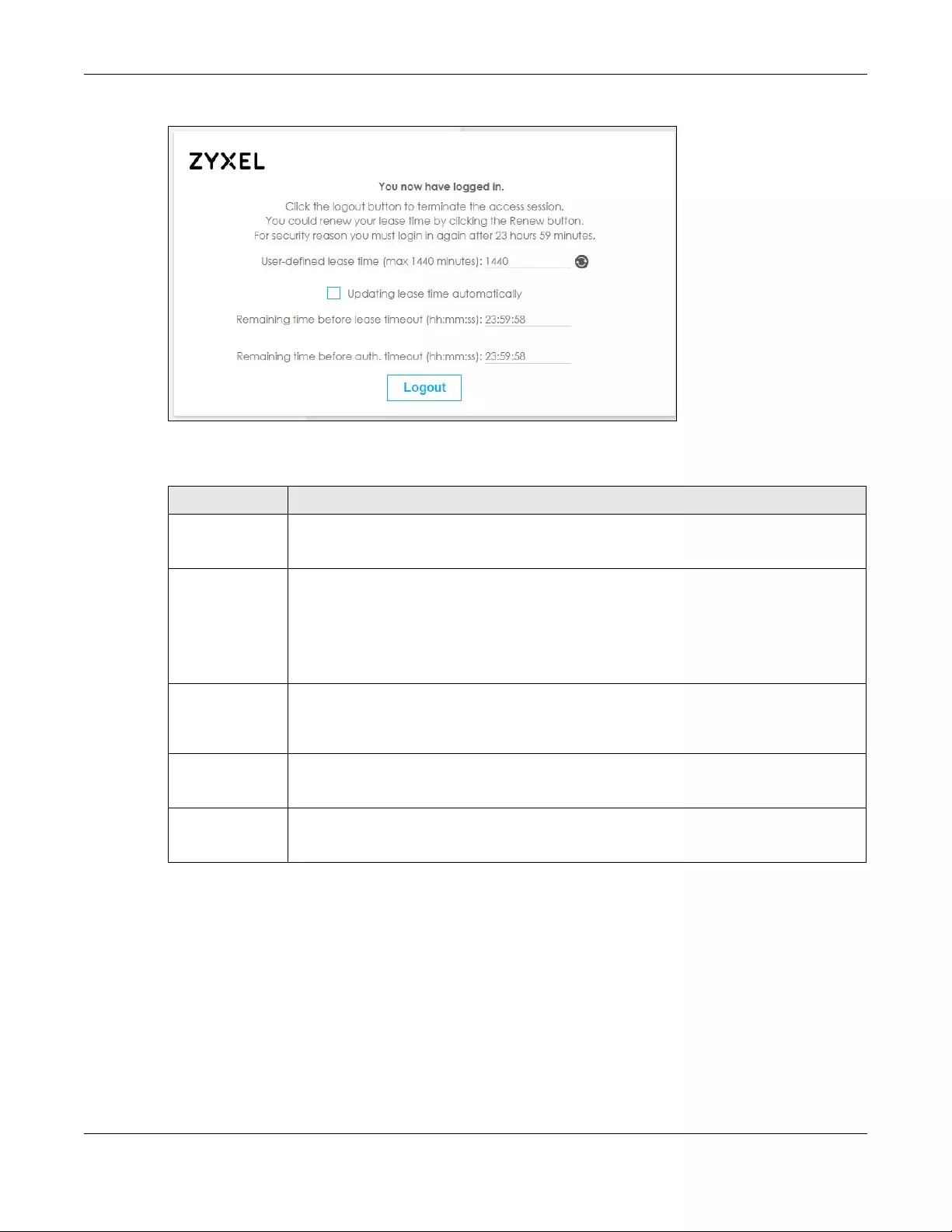
Chapter 39 Object
ZyWALL USG FLEX Series User’s Guide
729
Figure 478 Web Configurator for Non-Admin Users
The following table describes the labels in this screen.
39.2.7 User/Group MAC Address Summary Screen
This screen shows the MAC addresses of wireless clients, which can be authenticated by their
MAC addresses using the local user database. Click Configuration > Object > User/Group > MAC
Address to open this screen.
Note: You need to configure an SSID security profile’s MAC authentication settings to have
the AP use the Zyxel Device’s local database to authenticate wireless clients by their
MAC addresses.
Table 300 Web Configurator for Non-Admin Users
LABEL DESCRIPTION
User-defined
lease time (max
... minutes)
Access users can specify a lease time shorter than or equal to the one that you specified. The
default value is the lease time that you specified.
Renew Access users can click this button to reset the lease time, the amount of time remaining before
the Zyxel Device automatically logs them out. The Zyxel Device sets this amount of time
according to the:
•User-defined lease time field in this screen
•Lease time field in the User Add/Edit screen (see Section 39.13.1.1 on page 823)
•Lease time field in the Setting screen (see Section 39.2.6 on page 724).
Updating lease
time
automatically
This box appears if you checked the Allow renewing lease time automatically box in the
Setting screen. (See Section 39.2.6 on page 724.) Access users can select this check box to
reset the lease time automatically 30 seconds before it expires. Otherwise, access users have
to click the Renew button to reset the lease time.
Remaining time
before lease
timeout
This field displays the amount of lease time that remains, though the user might be able to reset
it.
Remaining time
before auth.
timeout
This field displays the amount of time that remains before the Zyxel Device automatically logs
the access user out, regardless of the lease time.
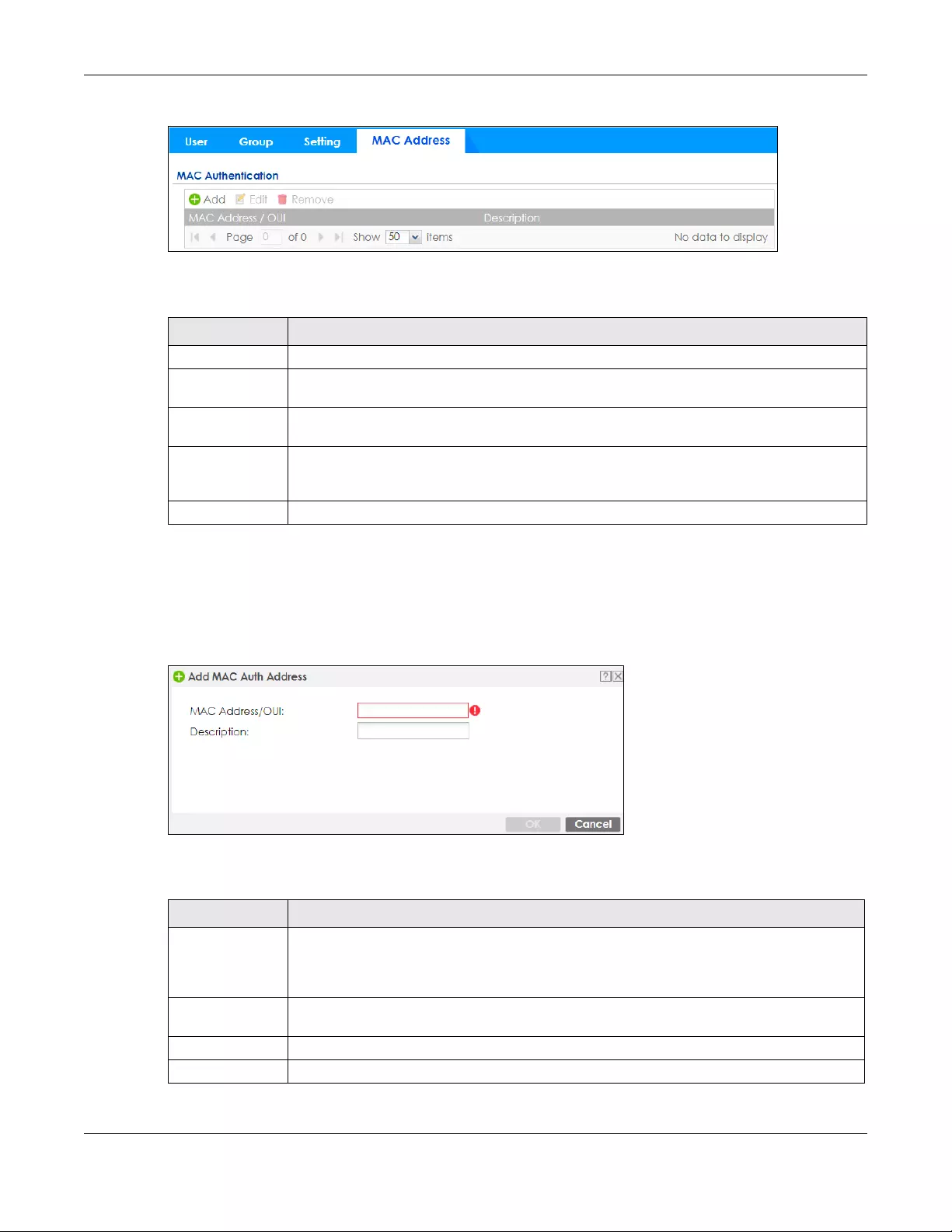
Chapter 39 Object
ZyWALL USG FLEX Series User’s Guide
730
Figure 479 Configuration > Object > User/Group > MAC Address
The following table describes the labels in this screen.
39.2.7.1 MAC Address Add/Edit Screen
This screen allows you to create a new allowed device or edit an existing one. To access this screen, go
to the MAC Address screen (see Section 39.2.7 on page 729), and click either the Add icon or an Edit
icon.
Figure 480 Configuration > Object > User/Group > MAC Address > Add
The following table describes the labels in this screen.
Table 301 Configuration > Object > User/Group > MAC Address
LABEL DESCRIPTION
Add Click this to create a new entry.
Edit Double-click an entry or select it and click Edit to open a screen where you can modify the
entry’s settings.
Remove To remove an entry, select it and click Remove. The Zyxel Device confirms you want to remove
it before doing so.
MAC Address/
OUI
This field displays the MAC address or OUI (Organizationally Unique Identifier of computer
hardware manufacturers) of wireless clients using MAC authentication with the Zyxel Device
local user database.
Description This field displays a description of the device identified by the MAC address or OUI.
Table 302 Configuration > Object > User/Group > MAC Address > Add
LABEL DESCRIPTION
MAC Address/
OUI
Type the MAC address (six hexadecimal number pairs separated by colons or hyphens) or OUI
(three hexadecimal number pairs separated by colons or hyphens) to identify specific wireless
clients for MAC authentication using the Zyxel Device local user database. The OUI is the first
three octets in a MAC address and uniquely identifies the manufacturer of a network device.
Description Enter an optional description of the wireless device(s) identified by the MAC or OUI. You can
use up to 60 characters, punctuation marks, and spaces.
OK Click OK to save your changes back to the Zyxel Device.
Cancel Click Cancel to exit this screen without saving your changes.

Chapter 39 Object
ZyWALL USG FLEX Series User’s Guide
731
39.2.8 User /Group Technical Reference
This section provides some information on users who use an external authentication server in order to log
in.
Setting up User Attributes in an External Server
To set up user attributes, such as reauthentication time, in LDAP or RADIUS servers, use the following
keywords in the user configuration file.
The following examples show you how you might set up user attributes in LDAP and RADIUS servers.
Creating a Large Number of Ext-User Accounts
If you plan to create a large number of Ext-User accounts, you might use CLI commands, instead of the
Web Configurator, to create the accounts. Extract the user names from the LDAP or RADIUS server, and
create a shell script that creates the user accounts.
39.3 AP Profile Overview
This section shows you how to configure preset profiles for the Access Points (APs) connected to your
Zyxel Device’s wireless network.
• The Radio screen (Section 39.3.1 on page 733) creates radio configurations that can be used by the
APs.
• The SSID screen (Section 39.3.2 on page 740) configures three different types of profiles for your
networked APs.
39.3.0.1 What You Need To Know
The following terms and concepts may help as you read this section.
Table 303 LDAP/RADIUS: Keywords for User Attributes
KEYWORD CORRESPONDING ATTRIBUTE IN WEB CONFIGURATOR
type User Type. Possible Values: admin, limited-admin, dynamic-guest, user, guest.
leaseTime Lease Time. Possible Values: 1-1440 (minutes).
reauthTime Reauthentication Time. Possible Values: 1-1440 (minutes).
Figure 481 LDAP Example: Keywords for User Attributes
type: admin
leaseTime: 99
reauthTime: 199
Figure 482 RADIUS Example: Keywords for User Attributes
type=user;leaseTime=222;reauthTime=222

Chapter 39 Object
ZyWALL USG FLEX Series User’s Guide
732
Wireless Profiles
At the heart of all wireless AP configurations on the Zyxel Device are profiles. A profile represents a group
of saved settings that you can use across any number of connected APs. You can set up the following
wireless profile types:
•Radio - This profile type defines the properties of an AP’s radio transmitter. You can have a maximum
of 32 radio profiles on the Zyxel Device.
•SSID - This profile type defines the properties of a single wireless network signal broadcast by an AP.
Each radio on a single AP can broadcast up to 8 SSIDs. You can have a maximum of 32 SSID profiles
on the Zyxel Device.
•Security - This profile type defines the security settings used by a single SSID. It controls the encryption
method required for a wireless client to associate itself with the SSID. You can have a maximum of 32
security profiles on the Zyxel Device.
•MAC Filtering - This profile provides an additional layer of security for an SSID, allowing you to block
access or allow access to that SSID based on wireless client MAC addresses. If a client’s MAC address
is on the list, then it is either allowed or denied, depending on how you set up the MAC Filter profile.
You can have a maximum of 32 MAC filtering profiles on the Zyxel Device.
SSID
The SSID (Service Set IDentifier) is the name that identifies the Service Set with which a wireless station is
associated. Wireless stations associating to the access point (AP) must have the same SSID. In other
words, it is the name of the wireless network that clients use to connect to it.
WEP
WEP (Wired Equivalent Privacy) encryption scrambles all data packets transmitted between the AP and
the wireless stations associated with it in order to keep network communications private. Both the
wireless stations and the access points must use the same WEP key for data encryption and decryption.
WPA and WPA2
Wi-Fi Protected Access (WPA) is a subset of the IEEE 802.11i standard. WPA2 (IEEE 802.11i) is a wireless
security standard that defines stronger encryption, authentication and key management than WPA.
Key differences between WPA(2) and WEP are improved data encryption and user authentication.
IEEE 802.1x
The IEEE 802.1x standard outlines enhanced security methods for both the authentication of wireless
stations and encryption key management. Authentication is done using an external RADIUS server.
WiFi6 / IEEE 802.11ax
WiFi6 is backwards compatible with IEEE 802.11a/b/g/n/ac and is most suitable in areas with a high
concentration of users. WiFi6 devices support Target Wakeup Time (TWT) allowing them to automatically
power down when they are inactive.
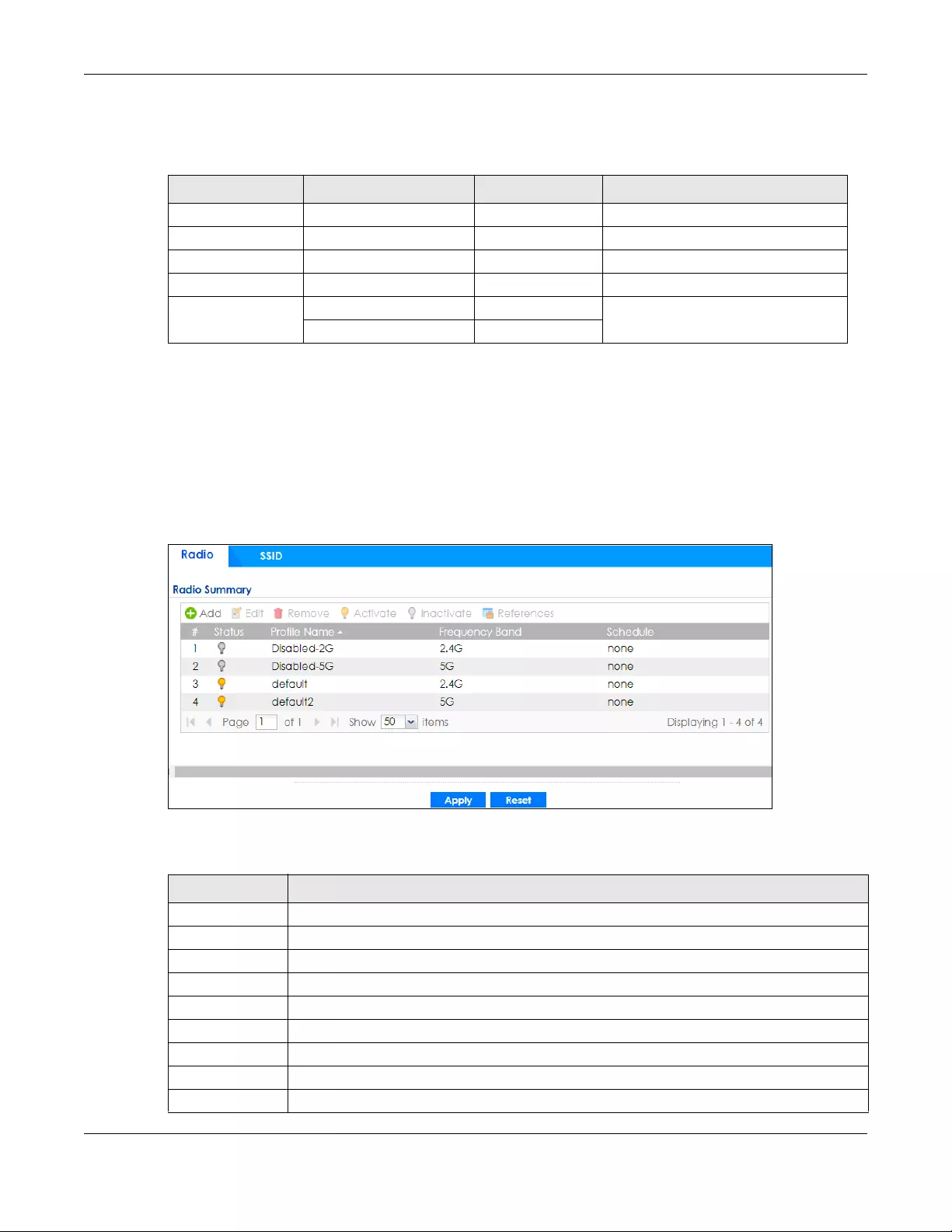
Chapter 39 Object
ZyWALL USG FLEX Series User’s Guide
733
The following table displays the comparison of the different WiFi standards. The maximum link rate is for
reference under ideal conditions only.
39.3.1 Radio Screen
This screen allows you to create radio profiles for the APs on your network. A radio profile is a list of
settings that a supported managed AP (NWA5121-N for example) can use to configure either one of its
two radio transmitters. To access this screen click Configuration > Object > AP Profile.
Note: You can have a maximum of 32 radio profiles on the Zyxel Device.
Figure 483 Configuration > Object > AP Profile > Radio
The following table describes the labels in this screen.
Table 304 WiFI Standards Comparison
WIFI STANDARD MAXIMUM LINK RATE * BAND SIMULTANEOUS CONNECTIONS
802.11b 11 Mbps 2.4 GHz 1
802.11a/g 54 Mbps 2.4 GHz and 5 GHz 1
802.11n 600 Mbps 2.4 GHz and 5 GHz 1
802.11ac 6.93 Gbps 5 GHz 4
802.11ax 2.4 Gbps 2.4 GHz 128
9.61 Gbps 5 GHz and 6 GHz
Table 305 Configuration > Object > AP Profile > Radio
LABEL DESCRIPTION
Add Click this to add a new radio profile.
Edit Click this to edit the selected radio profile.
Remove Click this to remove the selected radio profile.
Activate To turn on an entry, select it and click Activate.
Inactivate To turn off an entry, select it and click Inactivate.
References Click this to view which other objects are linked to the selected radio profile.
#This field is a sequential value, and it is not associated with a specific profile.
Status This icon is lit when the entry is active and dimmed when the entry is inactive.
Profile Name This field indicates the name assigned to the radio profile.

Chapter 39 Object
ZyWALL USG FLEX Series User’s Guide
734
Frequency Band This field indicates the frequency band which this radio profile is configured to use.
Schedule This field displays the schedule object which defines when this radio profile can be used.
Apply Click Apply to save your changes back to the Zyxel Device.
Reset Click Reset to return the screen to its last-saved settings.
Table 305 Configuration > Object > AP Profile > Radio (continued)
LABEL DESCRIPTION
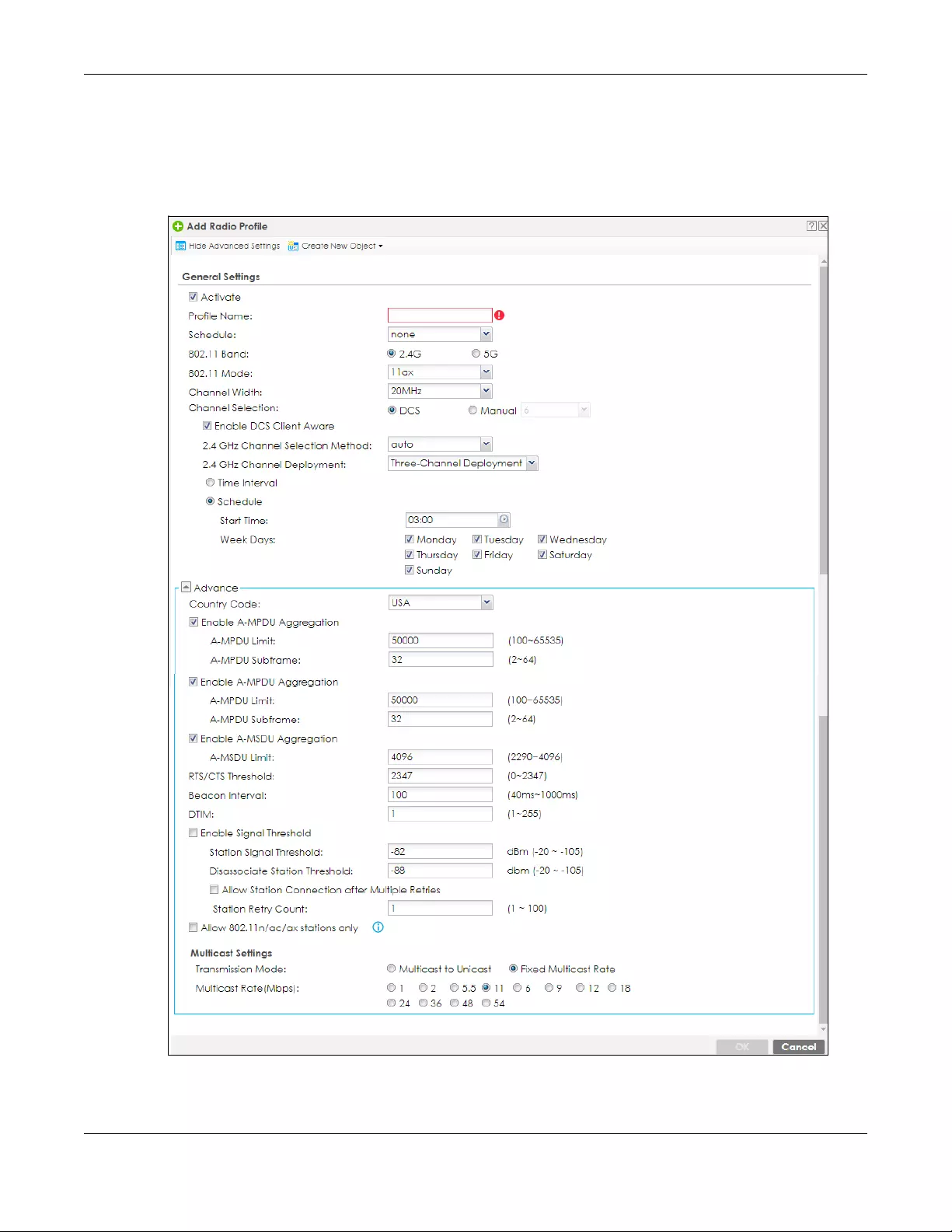
Chapter 39 Object
ZyWALL USG FLEX Series User’s Guide
735
39.3.1.1 Add/Edit Radio Profile
This screen allows you to create a new radio profile or edit an existing one. To access this screen, click
the Add button or select a radio profile from the list and click the Edit button.
Figure 484 Configuration > Object > AP Profile > Add/Edit Radio Profile

Chapter 39 Object
ZyWALL USG FLEX Series User’s Guide
736
The following table describes the labels in this screen.
Table 306 Configuration > Object > AP Profile > Add/Edit Radio Profile
LABEL DESCRIPTION
Hide / Show
Advanced Settings
Click this to hide or show the Advanced Settings in this window.
Create New Object Use this to configure any new settings objects that you need to use in this screen.
General Settings
Activate Select this option to make this profile active.
Profile Name Enter up to 31 alphanumeric characters to be used as this profile’s name. Spaces and
underscores are allowed.
Schedule This field displays the schedule object which defines when this radio profile can be used.
802.11 Band Select how to let wireless clients connect to the AP.
If 802.11 Band is set to 2.4G:
•11b/g: allows either IEEE 802.11b or IEEE 802.11g compliant WLAN devices to associate
with the AP. The AP adjusts the transmission rate automatically according to the
wireless standard supported by the wireless devices.
•11n: allows IEEE802.11b, IEEE802.11g and IEEE802.11n compliant WLAN devices to
associate with the AP.
If 802.11 Band is set to 5G:
•11a: allows only IEEE 802.11a compliant WLAN devices to associate with the AP.
•11a/n: allows both IEEE802.11n and IEEE802.11a compliant WLAN devices to associate
with the AP. The transmission rate of your AP might be reduced.
•11ac: allows only IEEE802.11ac compliant WLAN devices to associate with the AP.
•11ax: allows IEEE802.11n, IEEE802.11a, IEEE802.11ac, and IEEE802.11ax compliant WLAN
devices to associate with the AP. If the WLAN device isn’t compatible with 802.11ax,
the AP will communicate with the WLAN device using 802.11ac, and so on
Note: If you select 11ac but the WLAN devices in the network do not support IEEE
802.11ac, the Zyxel Device automatically sets the AP to use 11a/n.
Channel Width Select the wireless channel bandwidth you want the AP to use.
A standard 20 MHz channel offers transfer speeds of up to 144Mbps (2.4GHz) or 217Mbps
(5GHZ) whereas a 40MHz channel uses two standard channels and offers speeds of up to
300Mbps (2.4GHz) or 450Mbps (5GHZ). An IEEE 802.11ac-specific 80MHz channel offers
speeds of up to 1.3Gbps.
40 MHz (channel bonding or dual channel) bonds two adjacent radio channels to increase
throughput. A 80 MHz channel consists of two adjacent 40 MHz channels. The wireless
clients must also support 40 MHz or 80 MHz. It is often better to use the 20 MHz setting in a
location where the environment hinders the wireless signal.
Because not all devices support 40 MHz and/or 80 MHz channels, select 20/40MHz or 20/
40/80MHz to allow the AP to adjust the channel bandwidth automatically.
Select 20MHz if you want to lessen radio interference with other wireless devices in your
neighborhood or the wireless clients do not support channel bonding.
Note: If the environment has poor signal-to-noise (SNR), the Zyxel Device will
switch to a lower bandwidth.

Chapter 39 Object
ZyWALL USG FLEX Series User’s Guide
737
Channel
Selection Select the wireless channel which this radio profile should use.
It is recommended that you choose the channel least in use by other APs in the region
where this profile will be implemented. This will reduce the amount of interference between
wireless clients and the AP to which this profile is assigned.
Select DCS to have the AP automatically select the radio channel upon which it
broadcasts by scanning the area around it and determining what channels are currently
being used by other devices.
Select Manual and specify the channels the AP uses.
Blacklist DFS
channels in
presence of radar
This field is available if 802.11 Band is set to 5G and Channel Selection is set to DCS.
Enable this to temporarily blacklist the wireless channels in the Dynamic Frequency
Selection (DFS) range whenever a radar signal is detected by the AP.
Enable DCS
Client Aware This field is available when you set Channel Selection to DCS.
Select this to have the AP wait until all connected clients have disconnected before
switching channels.
If you disable this then the AP switches channels immediately regardless of any client
connections. In this instance, clients that are connected to the AP when it switches
channels are dropped.
2.4 GHz Channel
Selection Method This field is available when you set Channel Selection to DCS.
Select auto to have the AP search for available channels automatically in the 2.4 GHz
band. The available channels vary depending on what you select in the 2.4 GHz Channel
Deployment field.
Select manual and specify the channels the AP uses in the 2.4 GHz band.
Channel ID This field is available only when you set Channel Selection to DCS and set 2.4 GHz Channel
Selection Method to manual.
Select the check boxes of the channels that you want the AP to use.
Time Interval Select this option to have the AP survey the other APs within its broadcast radius at the end
of the specified time interval.
2.4 GHz Channel
Deployment This field is available only when you set Channel Selection to DCS and set 2.4 GHz Channel
Selection Method to auto.
Select Three-Channel Deployment to limit channel switching to channels 1,6, and 11, the
three channels that are sufficiently attenuated to have almost no impact on one another.
In other words, this allows you to minimize channel interference by limiting channel-
hopping to these three “safe” channels.
Select Four-Channel Deployment to limit channel switching to four channels. Depending
on the country domain, if the only allowable channels are 1-11 then the Zyxel Device uses
channels 1, 4, 7, 11 in this configuration; otherwise, the Zyxel Device uses channels 1, 5, 9, 13
in this configuration. Four channel deployment expands your pool of possible channels
while keeping the channel interference to a minimum.
Note: For US and Canada models, country code is fixed to US or Canada
respectively and is not user selectable.
DCS Time Interval This field is available when you set Channel Sele ction to DCS.
Enter a number of minutes. This regulates how often the AP surveys the other APs within its
broadcast radius. If the channel on which it is currently broadcasting suddenly comes into
use by another AP, the AP will then dynamically select the next available clean channel or
a channel with lower interference.
Table 306 Configuration > Object > AP Profile > Add/Edit Radio Profile (continued)
LABEL DESCRIPTION

Chapter 39 Object
ZyWALL USG FLEX Series User’s Guide
738
Channel ID This field is available only when you set Channel Selection to DCS and set 2.4 GHz Channel
Selection Method to manual.
Select the check boxes of the channels that you want the AP to use.
Schedule Select this option to have the AP survey the other APs within its broadcast radius at a
specific time on selected days of the week.
Start Time Specify the time of the day (in 24-hour format) to have the AP use DCS to automatically
scan and find a less-used channel.
Week Days Select each day of the week to have the AP use DCS to automatically scan and find a less-
used channel.
Enable 5 GHz DFS
Aware This field is available only when you select 11a, 11a/n or 11ac in the 802.11 Band field.
Select this if your APs are operating in an area known to have RADAR devices. This allows
the device to downgrade its frequency to below 5 GHz in the event a RADAR signal is
detected, thus preventing it from interfering with that signal.
Enabling this forces the AP to select a non-DFS channel.
5 GHz Channel
Selection Method This shows auto and allows the AP to search for available channels automatically in the 5
GHz band.
Advanced Settings
Country Code Select the country code of APs that are connected to the Zyxel Device to be the same as
where the Zyxel Device is located/installed.
The available channels vary depending on the country you select. Be sure to select the
correct/same country for both radios on an AP and all connected APs, in order to prevent
roaming failure and interference to other systems.
Note: For US and Canada models, country code is fixed to US or Canada
respectively and is not user selectable.
Guard Interval This field is available only when the 802.11 Band is set to 5G and 802.11 Mode is set to 11n or
11ac.
Set the guard interval for this radio profile to either Short or Long.
The guard interval is the gap introduced between data transmission from users in order to
reduce interference. Reducing the interval increases data transfer rates but also increases
interference. Increasing the interval reduces data transfer rates but also reduces
interference.
Enable A-MPDU
Aggregation Select this to enable A-MPDU aggregation.
Message Protocol Data Unit (MPDU) aggregation collects Ethernet frames along with their
802.11n headers and wraps them in a 802.11n MAC header. This method is useful for
increasing bandwidth throughput in environments that are prone to high error rates.
A-MPDU Limit Enter the maximum frame size to be aggregated.
A-MPDU
Subframe Enter the maximum number of frames to be aggregated each time.
Enable A-MSDU
Aggregation Select this to enable A-MSDU aggregation.
Mac Service Data Unit (MSDU) aggregation collects Ethernet frames without any of their
802.11n headers and wraps the header-less payload in a single 802.11n MAC header. This
method is useful for increasing bandwidth throughput. It is also more efficient than A-MPDU
except in environments that are prone to high error rates.
A-MSDU Limit Enter the maximum frame size to be aggregated.
Table 306 Configuration > Object > AP Profile > Add/Edit Radio Profile (continued)
LABEL DESCRIPTION

Chapter 39 Object
ZyWALL USG FLEX Series User’s Guide
739
RTS/CTS Threshold Use RTS/CTS to reduce data collisions on the wireless network if you have wireless clients
that are associated with the same AP but out of range of one another. When enabled, a
wireless client sends an RTS (Request To Send) and then waits for a CTS (Clear To Send)
before it transmits. This stops wireless clients from transmitting packets at the same time
(and causing data collisions).
A wireless client sends an RTS for all packets larger than the number (of bytes) that you
enter here. Set the RTS/CTS equal to or higher than the fragmentation threshold to turn RTS/
CTS off.
Beacon Interval When a wirelessly networked device sends a beacon, it includes with it a beacon interval.
This specifies the time period before the device sends the beacon again. The interval tells
receiving devices on the network how long they can wait in low-power mode before
waking up to handle the beacon. A high value helps save current consumption of the
access point.
DTIM Delivery Traffic Indication Message (DTIM) is the time period after which broadcast and
multicast packets are transmitted to mobile clients in the Active Power Management
mode. A high DTIM value can cause clients to lose connectivity with the network. This value
can be set from 1 to 255.
Enable Signal
Threshold Select the check box to use the signal threshold to ensure wireless clients receive good
throughput. This allows only wireless clients with a strong signal to connect to the AP.
Clear the check box to not require wireless clients to have a minimum signal strength to
connect to the AP.
Station Signal
Threshold Set a minimum client signal strength. A wireless client is allowed to connect to the AP only
when its signal strength is stronger than the specified threshold.
-20 dBm is the strongest signal you can require and -76 is the weakest.
Disassociate
Station Threshold Set a minimum kick-off signal strength. When a wireless client’s signal strength is lower than
the specified threshold, the Zyxel Device disconnects the wireless client from the AP.
-20 dBm is the strongest signal you can require and -90 is the weakest.
Allow Station
Connection after
Multiple Retries
Select this option to allow a wireless client to try to associate with the AP again after it is
disconnected due to weak signal strength.
Station Retry
Count Set the maximum number of times a wireless client can attempt to re-connect to the AP
Allow 802.11n/
ac/ax stations
only
Select this option to allow only 802.11 n/ac/ax stations to connect, and reject 802.11a/b/g
stations.
Multicast Settings Use this section to set a transmission mode and maximum rate for multicast traffic.
Transmission
Mode Set how the AP handles multicast traffic.
Select Multicast to Unicast to broadcast wireless multicast traffic to all of the wireless clients
as unicast traffic. Unicast traffic dynamically changes the data rate based on the
application’s bandwidth requirements. The retransmit mechanism of unicast traffic
provides more reliable transmission of the multicast traffic, although it also produces
duplicate packets.
Select Fixed Multicast Rate to send wireless multicast traffic at a single data rate. You must
know the multicast application’s bandwidth requirements and set it in the following field.
Multicast Rate
(Mbps) If you set the multicast transmission mode to fixed multicast rate, set the data rate for
multicast traffic here. For example, to deploy 4 Mbps video, select a fixed multicast rate
higher than 4 Mbps.
OK Click OK to save your changes back to the Zyxel Device.
Cancel Click Cancel to exit this screen without saving your changes.
Table 306 Configuration > Object > AP Profile > Add/Edit Radio Profile (continued)
LABEL DESCRIPTION
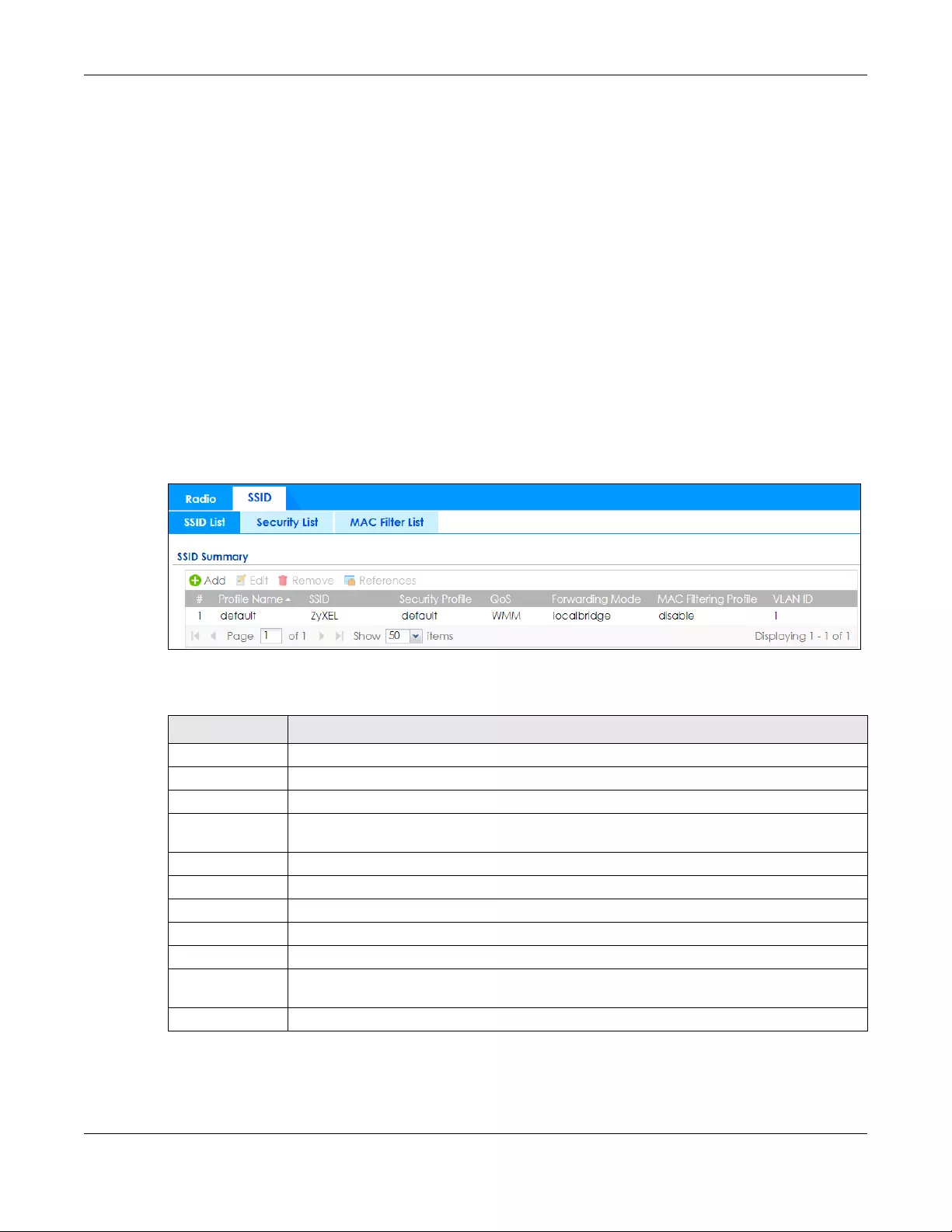
Chapter 39 Object
ZyWALL USG FLEX Series User’s Guide
740
39.3.2 SSID Screen
The SSID screens allow you to configure three different types of profiles for your networked APs: an SSID
list, which can assign specific SSID configurations to your APs; a security list, which can assign specific
encryption methods to the APs when allowing wireless clients to connect to them; and a MAC filter list,
which can limit connections to an AP based on wireless clients MAC addresses.
39.3.2.1 SSID List
This screen allows you to create and manage SSID configurations that can be used by the APs. An SSID,
or Service Set IDentifier, is basically the name of the wireless network to which a wireless client can
connect. The SSID appears as readable text to any device capable of scanning for wireless frequencies
(such as the WiFi adapter in a laptop), and is displayed as the wireless network name when a person
makes a connection to it.
To access this screen click Configuration > Object > AP Profile > SSID.
Note: You can have a maximum of 32 SSID profiles on the Zyxel Device.
Figure 485 Configuration > Object > AP Profile > SSID List
The following table describes the labels in this screen.
Table 307 Configuration > Object > AP Profile > SSID List
LABEL DESCRIPTION
Add Click this to add a new SSID profile.
Edit Click this to edit the selected SSID profile.
Remove Click this to remove the selected SSID profile.
References Click this to view which other objects are linked to the selected SSID profile (for example, radio
profile).
#This field is a sequential value, and it is not associated with a specific profile.
Profile Name This field indicates the name assigned to the SSID profile.
SSID This field indicates the SSID name as it appears to wireless clients.
Security Profile This field indicates which (if any) security profile is associated with the SSID profile.
QoS This field indicates the QoS type associated with the SSID profile.
MAC Filtering
Profile
This field indicates which (if any) MAC Filter Profile is associated with the SSID profile.
VLAN ID This field indicates the VLAN ID associated with the SSID profile.

Chapter 39 Object
ZyWALL USG FLEX Series User’s Guide
741
39.3.2.2 Add/Edit SSID Profile
This screen allows you to create a new SSID profile or edit an existing one. To access this screen, click the
Add button or select an SSID profile from the list and click the Edit button.
Figure 486 Configuration > Object > AP Profile > SSID > Add/Edit SSID Profile
The following table describes the labels in this screen.
Table 308 Configuration > Object > AP Profile > SSID > Add/Edit SSID Profile
LABEL DESCRIPTION
Create new
Object
Select an object type from the list to create a new one associated with this SSID profile.
Profile Name Enter up to 31 alphanumeric characters for the profile name. This name is only visible in the
Web Configurator and is only for management purposes. Spaces and underscores are
allowed.
SSID Enter the SSID name for this profile. This is the name visible on the network to wireless clients.
Enter up to 32 characters, spaces and underscores are allowed.
Security Profile Select a security profile from this list to associate with this SSID. If none exist, you can use the
Create new Object menu to create one.
Note: It is highly recommended that you create security profiles for all of your SSIDs to
enhance your network security.
MAC Filtering
Profile
Select a MAC filtering profile from the list to associate with this SSID. If none exist, you can use
the Create new Object menu to create one.
MAC filtering allows you to limit the wireless clients connecting to your network through a
particular SSID by wireless client MAC addresses. Any clients that have MAC addresses not in
the MAC filtering profile of allowed addresses are denied connections.
The disable setting means no MAC filtering is used.

Chapter 39 Object
ZyWALL USG FLEX Series User’s Guide
742
QoS Select a Quality of Service (QoS) access category to associate with this SSID. Access categories
minimize the delay of data packets across a wireless network. Certain categories, such as
video or voice, are given a higher priority due to the time sensitive nature of their data packets.
QoS access categories are as follows:
disable: Turns off QoS for this SSID. All data packets are treated equally and not tagged with
access categories.
WMM: Enables automatic tagging of data packets. The Zyxel Device assigns access categories
to the SSID by examining data as it passes through it and making a best guess effort. If
something looks like video traffic, for instance, it is tagged as such.
WMM_VOICE: All wireless traffic to the SSID is tagged as voice data. This is recommended if an
SSID is used for activities like placing and receiving VoIP phone calls.
WMM_VIDEO: All wireless traffic to the SSID is tagged as video data. This is recommended for
activities like video conferencing.
WMM_BEST_EFFORT: All wireless traffic to the SSID is tagged as “best effort,” meaning the data
travels the best route it can without displacing higher priority traffic. This is good for activities
that do not require the best bandwidth throughput, such as surfing the Internet.
WMM_BACKGROUND: All wireless traffic to the SSID is tagged as low priority or “background
traffic”, meaning all other access categories take precedence over this one. If traffic from an
SSID does not have strict throughput requirements, then this access category is recommended.
For example, an SSID that only has network printers connected to it.
Rate Limiting (Per
Station Traffic
Rate)
Define the maximum incoming and outgoing transmission data rate per wireless station
Downlink: Define the maximum incoming transmission data rate (either in Mbps or Kbps) on a per-station
basis.
Uplink: Define the maximum outgoing transmission data rate (either in Mbps or Kbps) on a per-station
basis.
Band Select: To improve network performance and avoid interference in the 2.4 GHz frequency band, you
can enable this feature to use the 5 GHz band first. You should set 2.4GHz and 5 GHz radio
profiles to use the same SSID and security settings.
Select standard to have the AP try to connect the wireless clients to the same SSID using the 5
GHZ band. Connections to an SSID using the 2.4GHz band are still allowed.
Otherwise, select disable to turn off this feature.
Stop
Threshold This field is not available when you disable Band Select.
Select this option and set the threshold number of the connected wireless clients at which the
Zyxel Device disables the band select feature.
Balance Ratio This field is not available when you disable Band Select.
Select this option and set a ratio of the wireless clients using the 5 GHz band to the wireless
clients using the 2.4 GHz band.
Forwarding Mode Select a forwarding mode (Tunnel or Local bridge) for traffic from wireless stations in this wireless
network (SSID). In earlier firmware, you could only forward traffic from this wireless network with
a tunnel using an existing VLAN interface in Network > Interface > VLAN > Add.
From firmware version 4.60, you can select an existing VLAN interface or a local Ethernet
interface (lan1, lan2) for forwarding traffic from wireless stations in this wireless network using a
tunnel. These interfaces cannot be bridge members (Network > Interface > Bridge).
VLAN ID If you selected Local Bridge forwarding mode, enter the VLAN ID that will be used to tag all
traffic originating from this SSID if the VLAN is different from the native VLAN. All the wireless
station’s traffic goes through the associated AP’s gateway.
Table 308 Configuration > Object > AP Profile > SSID > Add/Edit SSID Profile (continued)
LABEL DESCRIPTION

Chapter 39 Object
ZyWALL USG FLEX Series User’s Guide
743
39.3.2.3 Security List
This screen allows you to manage wireless security configurations that can be used by your SSIDs.
Wireless security is implemented strictly between the AP broadcasting the SSID and the stations that are
connected to it.
To access this screen click Configuration > Object > AP Profile > SSID > Security List.
Note: You can have a maximum of 32 security profiles on the Zyxel Device.
Figure 487 Configuration > Object > AP Profile > SSID > Security List
VLAN Interface If you selected the Tunnel forwarding mode, select a VLAN interface. All the wireless station’s
traffic is forwarded to the Zyxel Device first.
Hidden SSID Select this if you want to “hide” your SSID from wireless clients. This tells any wireless clients in the
vicinity of the AP using this SSID profile not to display its SSID name as a potential connection.
Not all wireless clients respect this flag and display it anyway.
When an SSID is “hidden” and a wireless client cannot see it, the only way you can connect to
the SSID is by manually entering the SSID name in your wireless connection setup screen(s)
(these vary by client, client connectivity software, and operating system).
Enable Intra-BSS
Traffic Blocking
Select this option to prevent crossover traffic from within the same SSID.
Enable U-APSD Select this option to enable Unscheduled Automatic Power Save Delivery (U-APSD), which is
also known as WMM-Power Save. This helps increase battery life for battery-powered wireless
clients connected to the Zyxel Device using this SSID profile.
Enable ARP Proxy The Address Resolution Protocol (ARP) is a protocol for mapping an IP address to a MAC
address. An ARP broadcast is sent to all devices on the same Ethernet network to request the
MAC address of a target IP address.
Select this option to allow the Zyxel Device to answer ARP requests for an IP address on behalf
of a client associated with this SSID. This can reduce broadcast traffic and improve network
performance.
802.11 k/v
Assisted Roaming
Select this option to enable IEEE 802.11k/v assisted roaming on the Zyxel Device. When the
connected clients request 802.11k neighbor lists, the Zyxel Device will response with a list of
neighbor APs that can be candidates for roaming.
Schedule SSID Select this option and set whether the SSID is enabled or disabled on each day of the week.
You also need to select the hour and minute (in 24-hour format) to specify the time period of
each day during which the SSID is enabled/enabled.
OK Click OK to save your changes back to the Zyxel Device.
Cancel Click Cancel to exit this screen without saving your changes.
Table 308 Configuration > Object > AP Profile > SSID > Add/Edit SSID Profile (continued)
LABEL DESCRIPTION
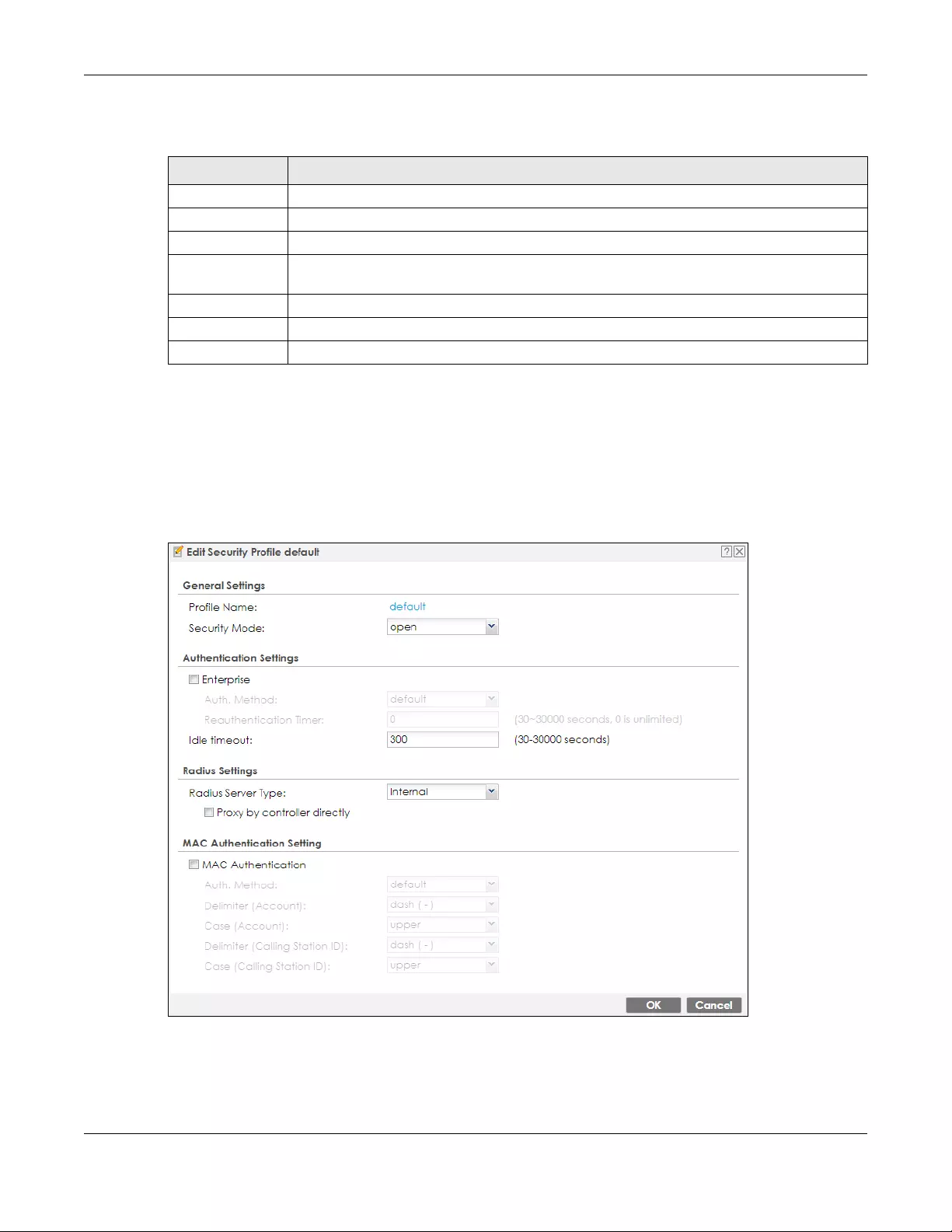
Chapter 39 Object
ZyWALL USG FLEX Series User’s Guide
744
The following table describes the labels in this screen.
39.3.2.4 Add/Edit Security Profile
This screen allows you to create a new security profile or edit an existing one. To access this screen, click
the Add button or select a security profile from the list and click the Edit button.
Note: This screen’s options change based on the Security Mode selected.
Figure 488 Configuration > Object > AP Profile > SSID > Security Profile > Add/Edit Security Profile>
Security Mode: open
Table 309 Configuration > Object > AP Profile > SSID > Security List
LABEL DESCRIPTION
Add Click this to add a new security profile.
Edit Click this to edit the selected security profile.
Remove Click this to remove the selected security profile.
References Click this to view which other objects are linked to the selected security profile (for example,
SSID profile).
#This field is a sequential value, and it is not associated with a specific profile.
Profile Name This field indicates the name assigned to the security profile.
Security Mode This field indicates this profile’s security mode (if any).

Chapter 39 Object
ZyWALL USG FLEX Series User’s Guide
745
The following table describes the labels in this screen.
Table 310 Configuration > Object > AP Profile > SSID > Security Profile > Add/Edit Security Profile>
Security Mode: open
LABEL DESCRIPTION
Profile Name Enter up to 31 alphanumeric characters for the profile name. This name is only visible in the
Web Configurator and is only for management purposes. Spaces and underscores are
allowed.
Security Mode Select a security mode from the list: open, enhanced open, wep, wpa2, or wpa2-mix, wpa3.
Authentication Settings
Enterprise Select this to enable 802.1x secure authentication with a RADIUS server.
Reauthenticatio
n Timer Enter the interval (in seconds) between authentication requests. Enter a 0 for unlimited time.
Idle Timeout Enter the idle interval (in seconds) that a client can be idle before authentication is
discontinued.
Radius Settings
Primary / Secondary
Radius Server
Activate
Select this to have the Zyxel Device use the specified RADIUS server.
Radius Server IP
Address Enter the IP address of the RADIUS server to be used for authentication.
Radius Server
Port Enter the port number of the RADIUS server to be used for authentication.
Radius Server
Secret Enter the shared secret password of the RADIUS server to be used for authentication.
Primary / Secondary
Accounting Server
Activate
Select the check box to enable user accounting through an external authentication server.
Accounting
Server IP Address Enter the IP address of the external accounting server in dotted decimal notation.
Accounting
Server Port Enter the port number of the external accounting server. The default port number is 1813.
You need not change this value unless your network administrator instructs you to do so with
additional information.
Accounting
Share Secret Enter a password (up to 128 alphanumeric characters) as the key to be shared between the
external accounting server and the Zyxel Device. The key must be the same on the external
accounting server and your Zyxel Device. The key is not sent over the network.
Accounting Interim
Update
This field is available only when you enable user accounting through an external
authentication server.
Select this to have the Zyxel Device send subscriber status updates to the accounting server
at the interval you specify.
Interim Update
Interval Specify the time interval for how often the Zyxel Device is to send a subscriber status update
to the accounting server.
MAC Authentication Select this to use an external server or the Zyxel Device’s local database to authenticate
wireless clients by their MAC addresses. Users cannot get an IP address if the MAC
authentication fails.
An external server can use the wireless client’s account (username/password) or Calling
Station ID for MAC authentication. Configure the ones the external server uses.
Delimiter
(Account) Select the separator the external server uses for the two-character pairs within account
MAC addresses.
Case (Account) Select the case (upper or lower) the external server requires for letters in the account MAC
addresses.
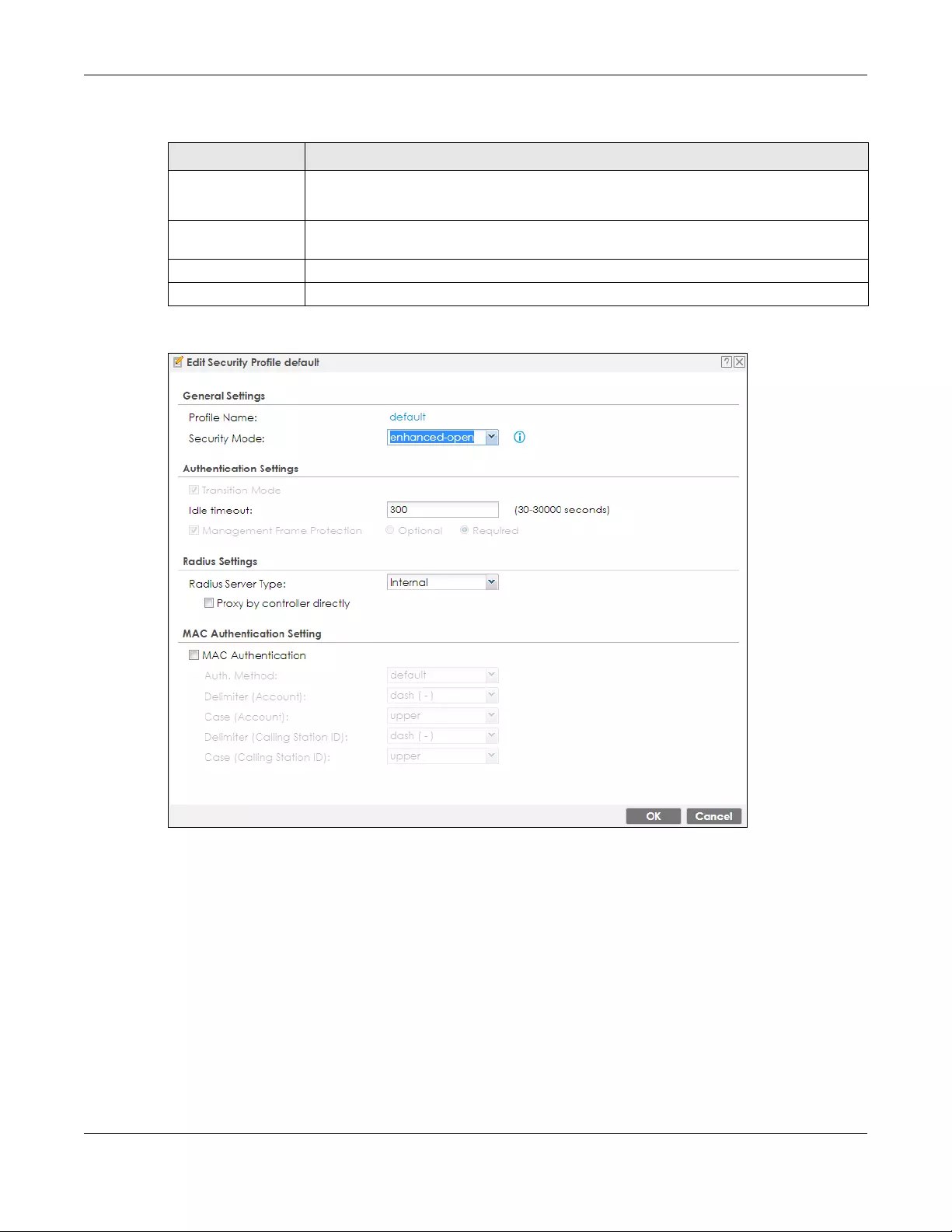
Chapter 39 Object
ZyWALL USG FLEX Series User’s Guide
746
Figure 489 Configuration > Object > AP Profile > SSID > Security Profile > Add/Edit Security Profile>
Security Mode: enhanced-open
Delimiter (Calling
Station ID) RADIUS servers can require the MAC address in the Calling Station ID RADIUS attribute.
Select the separator the external server uses for the pairs in calling station MAC addresses.
Case (Calling
Station ID) Select the case (upper or lower) the external server requires for letters in the calling station
MAC addresses.
OK Click OK to save your changes back to the Zyxel Device.
Cancel Click Cancel to exit this screen without saving your changes.
Table 310 Configuration > Object > AP Profile > SSID > Security Profile > Add/Edit Security Profile>
Security Mode: open (continued)
LABEL DESCRIPTION

Chapter 39 Object
ZyWALL USG FLEX Series User’s Guide
747
The following table describes the labels in this screen.
Table 311 Configuration > Object > AP Profile > SSID > Security Profile > Add/Edit Security Profile>
Security Mode: enhanced-open
LABEL DESCRIPTION
Profile Name Enter up to 31 alphanumeric characters for the profile name. This name is only visible in the
Web Configurator and is only for management purposes. Spaces and underscores are
allowed.
Security Mode Select a security mode from the list: open, enhanced open, wep, wpa2, or wpa2-mix, wpa3.
Authentication Settings
Transition Mode Enable this for backwards compatibility. This option is only available if the Security Mode is
wpa3 or enhanced-open. This creates two virtual APs (VAPs) with a primary (wpa3 or
enhanced-open) and fallback (wpa2 or none) security method.
If the Security Mode is wpa3, enabling this will force Management Frame Protection to be set
to Optional. If this is disabled or if the Security Mode is enhanced-open, Management Frame
Protection will be set to Required.
Idle Timeout Enter the idle interval (in seconds) that a client can be idle before authentication is
discontinued.
Radius Settings
Primary / Secondary
Radius Server
Activate
Select this to have the Zyxel Device use the specified RADIUS server.
Radius Server IP
Address Enter the IP address of the RADIUS server to be used for authentication.
Radius Server
Port Enter the port number of the RADIUS server to be used for authentication.
Radius Server
Secret Enter the shared secret password of the RADIUS server to be used for authentication.
Primary / Secondary
Accounting Server
Activate
Select the check box to enable user accounting through an external authentication server.
Accounting
Server IP Address Enter the IP address of the external accounting server in dotted decimal notation.
Accounting
Server Port Enter the port number of the external accounting server. The default port number is 1813.
You need not change this value unless your network administrator instructs you to do so with
additional information.
Accounting
Share Secret Enter a password (up to 128 alphanumeric characters) as the key to be shared between the
external accounting server and the Zyxel Device. The key must be the same on the external
accounting server and your Zyxel Device. The key is not sent over the network.
Accounting Interim
Update
This field is available only when you enable user accounting through an external
authentication server.
Select this to have the Zyxel Device send subscriber status updates to the accounting server
at the interval you specify.
Interim Update
Interval Specify the time interval for how often the Zyxel Device is to send a subscriber status update
to the accounting server.
MAC Authentication Select this to use an external server or the Zyxel Device’s local database to authenticate
wireless clients by their MAC addresses. Users cannot get an IP address if the MAC
authentication fails.
An external server can use the wireless client’s account (username/password) or Calling
Station ID for MAC authentication. Configure the ones the external server uses.
Delimiter
(Account) Select the separator the external server uses for the two-character pairs within account
MAC addresses.

Chapter 39 Object
ZyWALL USG FLEX Series User’s Guide
748
Figure 490 Configuration > Object > AP Profile > SSID > Security Profile > Add/Edit Security Profile>
Security Mode: wep
Case (Account) Select the case (upper or lower) the external server requires for letters in the account MAC
addresses.
Delimiter (Calling
Station ID) RADIUS servers can require the MAC address in the Calling Station ID RADIUS attribute.
Select the separator the external server uses for the pairs in calling station MAC addresses.
Case (Calling
Station ID) Select the case (upper or lower) the external server requires for letters in the calling station
MAC addresses.
OK Click OK to save your changes back to the Zyxel Device.
Cancel Click Cancel to exit this screen without saving your changes.
Table 311 Configuration > Object > AP Profile > SSID > Security Profile > Add/Edit Security Profile>
Security Mode: enhanced-open (continued)
LABEL DESCRIPTION

Chapter 39 Object
ZyWALL USG FLEX Series User’s Guide
749
The following table describes the labels in this screen.
Table 312 Configuration > Object > AP Profile > SSID > Security Profile > Add/Edit Security Profile>
Security Mode: wep
LABEL DESCRIPTION
Profile Name Enter up to 31 alphanumeric characters for the profile name. This name is only visible in the
Web Configurator and is only for management purposes. Spaces and underscores are
allowed.
Security Mode Select a security mode from the list: open, enhanced open, wep, wpa2, or wpa2-mix, wpa3.
Authentication Settings
Enterprise Select this to enable 802.1x secure authentication with a RADIUS server.
Reauthenticatio
n Timer Enter the interval (in seconds) between authentication requests. Enter a 0 for unlimited time.
Idle Timeout Enter the idle interval (in seconds) that a client can be idle before authentication is
discontinued.
Authentication Type Select a WEP authentication method. Choices are Open or Share key.
Key Length Select the bit-length of the encryption key to be used in WEP connections.
If you select WEP-64:
• Enter 10 hexadecimal digits in the range of “A-F”, “a-f” and “0-9” (for example,
0x11AA22BB33) for each Key used.
or
• Enter 5 ASCII characters (case sensitive) ranging from “a-z”, “A-Z” and “0-9” (for
example, MyKey) for each Key used.
If you select WEP-128:
• Enter 26 hexadecimal digits in the range of “A-F”, “a-f” and “0-9” (for example,
0x00112233445566778899AABBCC) for each Key used.
or
• Enter 13 ASCII characters (case sensitive) ranging from “a-z”, “A-Z” and “0-9” (for
example, MyKey12345678) for each Key used.
Key 1~4 Based on your Key Length selection, enter the appropriate length hexadecimal or ASCII key.
Radius Settings
Primary / Secondary
Radius Server
Activate
Select this to have the Zyxel Device use the specified RADIUS server.
Radius Server IP
Address Enter the IP address of the RADIUS server to be used for authentication.
Radius Server
Port Enter the port number of the RADIUS server to be used for authentication.
Radius Server
Secret Enter the shared secret password of the RADIUS server to be used for authentication.
Primary / Secondary
Accounting Server
Activate
Select the check box to enable user accounting through an external authentication server.
Accounting
Server IP Address Enter the IP address of the external accounting server in dotted decimal notation.
Accounting
Server Port Enter the port number of the external accounting server. The default port number is 1813.
You need not change this value unless your network administrator instructs you to do so with
additional information.
Accounting
Share Secret Enter a password (up to 128 alphanumeric characters) as the key to be shared between the
external accounting server and the Zyxel Device. The key must be the same on the external
accounting server and your Zyxel Device. The key is not sent over the network.

Chapter 39 Object
ZyWALL USG FLEX Series User’s Guide
750
Accounting Interim
Update
This field is available only when you enable user accounting through an external
authentication server.
Select this to have the Zyxel Device send subscriber status updates to the accounting server
at the interval you specify.
Interim Update
Interval Specify the time interval for how often the Zyxel Device is to send a subscriber status update
to the accounting server.
MAC Authentication Select this to use an external server or the Zyxel Device’s local database to authenticate
wireless clients by their MAC addresses. Users cannot get an IP address if the MAC
authentication fails.
An external server can use the wireless client’s account (username/password) or Calling
Station ID for MAC authentication. Configure the ones the external server uses.
Delimiter
(Account) Select the separator the external server uses for the two-character pairs within account
MAC addresses.
Case (Account) Select the case (upper or lower) the external server requires for letters in the account MAC
addresses.
Delimiter (Calling
Station ID) RADIUS servers can require the MAC address in the Calling Station ID RADIUS attribute.
Select the separator the external server uses for the pairs in calling station MAC addresses.
Case (Calling
Station ID) Select the case (upper or lower) the external server requires for letters in the calling station
MAC addresses.
OK Click OK to save your changes back to the Zyxel Device.
Cancel Click Cancel to exit this screen without saving your changes.
Table 312 Configuration > Object > AP Profile > SSID > Security Profile > Add/Edit Security Profile>
Security Mode: wep (continued)
LABEL DESCRIPTION
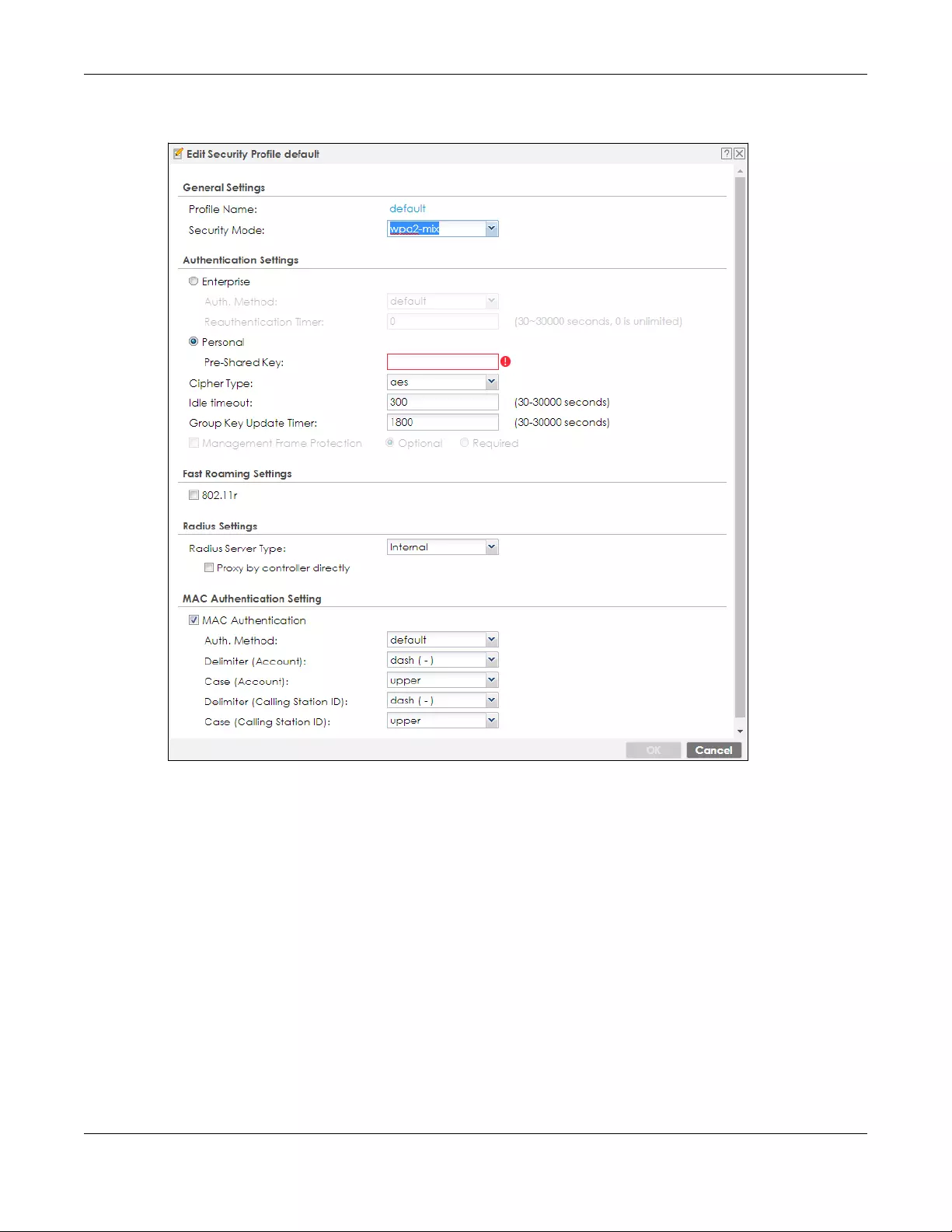
Chapter 39 Object
ZyWALL USG FLEX Series User’s Guide
751
Figure 491 Configuration > Object > AP Profile > SSID > Security Profile > Add/Edit Security Profile>
Security Mode: wpa2/ wpa2-mix

Chapter 39 Object
ZyWALL USG FLEX Series User’s Guide
752
The following table describes the labels in this screen.
Table 313 Configuration > Object > AP Profile > SSID > Security Profile > Add/Edit Security Profile>
Security Mode: wpa2/ wpa2-mix
LABEL DESCRIPTION
Profile Name Enter up to 31 alphanumeric characters for the profile name. This name is only visible in the
Web Configurator and is only for management purposes. Spaces and underscores are
allowed.
Security Mode Select a security mode from the list: open, enhanced open, wep, wpa2, or wpa2-mix, wpa3.
Authentication Settings
Enterprise Select this to enable 802.1x secure authentication with a RADIUS server.
Reauthenticatio
n Timer Enter the interval (in seconds) between authentication requests. Enter a 0 for unlimited time.
Personal This field is available when you select the wpa2, wpa2-mix or wpa3 security mode.
Select this option to use a Pre-Shared Key (PSK) with WPA2 encryption or Simultaneous
Authentication of Equals (SAE) with WPA3 encryption.
Pre-Shared Key Enter a pre-shared key of between 8 and 63 case-sensitive ASCII characters (including
spaces and symbols) or 64 hexadecimal characters.
Cipher Type Select an encryption cipher type from the list.
•auto - This automatically chooses the best available cipher based on the cipher in use
by the wireless client that is attempting to make a connection.
•aes - This is the Advanced Encryption Standard encryption method. It is a more recent
development over TKIP and considerably more robust. Not all wireless clients may
support this.
Idle Timeout Enter the idle interval (in seconds) that a client can be idle before authentication is
discontinued.
Group Key Update
Timer
Enter the interval (in seconds) at which the AP updates the group WPA2 encryption key.
Management
Frame Protection
This field is available only when you select wpa2 in the Security Mode field and set Cipher
Type to aes.
Data frames in 802.11 WLANs can be encrypted and authenticated with WEP, WPA or
WPA2. But 802.11 management frames, such as beacon/probe response, association
request, association response, de-authentication and disassociation are always
unauthenticated and unencrypted. IEEE 802.11w Protected Management Frames allows
APs to use the existing security mechanisms (encryption and authentication methods
defined in IEEE 802.11i WPA/WPA2) to protect management frames. This helps prevent
wireless DoS attacks.
Select the check box to enable management frame protection (MFP) to add security to
802.11 management frames.
Select Optional if you do not require the wireless clients to support MFP. Management
frames will be encrypted if the clients support MFP.
Select Required and wireless clients must support MFP in order to join the Zyxel Device’s
wireless network.
Fast Roaming
Settings
IEEE 802.11r fast roaming, which is also known as Fast BSS Transition (FT), allows wireless clients
to quickly move from one AP to another in a WiFi network that uses WPA2 with 802.1x
authentication. Information from the original association is passed to the target AP when the
client roams. The client doesn’t need to perform the whole 802.1x authentication process.
Messages exchanged between the target AP and client are reduced and performed using
one of the two methods:
• Over-the-DS: The wireless client communicates with the target AP via the current AP. The
communication is sent to the target AP through the wired Ethernet connection.
• Over-the-Air: The wireless client communicates directly with the target AP.

Chapter 39 Object
ZyWALL USG FLEX Series User’s Guide
753
802.11r Select this to turn on IEEE 802.11r fast roaming on the AP (Zyxel Device). This is good for
wireless clients that transport a lot of real-time interactive traffic, such as voice and video.
Wireless clients should also support WPA2 and fast roaming to associate with the AP (Zyxel
Device) and roam seamlessly.
Radius Settings
Primary / Secondary
Radius Server
Activate
Select this to have the Zyxel Device use the specified RADIUS server.
Radius Server IP
Address Enter the IP address of the RADIUS server to be used for authentication.
Radius Server
Port Enter the port number of the RADIUS server to be used for authentication.
Radius Server
Secret Enter the shared secret password of the RADIUS server to be used for authentication.
Primary / Secondary
Accounting Server
Activate
Select the check box to enable user accounting through an external authentication server.
Accounting
Server IP Address Enter the IP address of the external accounting server in dotted decimal notation.
Accounting
Server Port Enter the port number of the external accounting server. The default port number is 1813.
You need not change this value unless your network administrator instructs you to do so with
additional information.
Accounting
Share Secret Enter a password (up to 128 alphanumeric characters) as the key to be shared between the
external accounting server and the Zyxel Device. The key must be the same on the external
accounting server and your Zyxel Device. The key is not sent over the network.
Accounting Interim
Update
This field is available only when you enable user accounting through an external
authentication server.
Select this to have the Zyxel Device send subscriber status updates to the accounting server
at the interval you specify.
Interim Update
Interval Specify the time interval for how often the Zyxel Device is to send a subscriber status update
to the accounting server.
MAC Authentication Select this to use an external server or the Zyxel Device’s local database to authenticate
wireless clients by their MAC addresses. Users cannot get an IP address if the MAC
authentication fails.
An external server can use the wireless client’s account (username/password) or Calling
Station ID for MAC authentication. Configure the ones the external server uses.
Delimiter
(Account) Select the separator the external server uses for the two-character pairs within account
MAC addresses.
Case (Account) Select the case (upper or lower) the external server requires for letters in the account MAC
addresses.
Delimiter (Calling
Station ID) RADIUS servers can require the MAC address in the Calling Station ID RADIUS attribute.
Select the separator the external server uses for the pairs in calling station MAC addresses.
Case (Calling
Station ID) Select the case (upper or lower) the external server requires for letters in the calling station
MAC addresses.
OK Click OK to save your changes back to the Zyxel Device.
Cancel Click Cancel to exit this screen without saving your changes.
Table 313 Configuration > Object > AP Profile > SSID > Security Profile > Add/Edit Security Profile>
Security Mode: wpa2/ wpa2-mix (continued)
LABEL DESCRIPTION
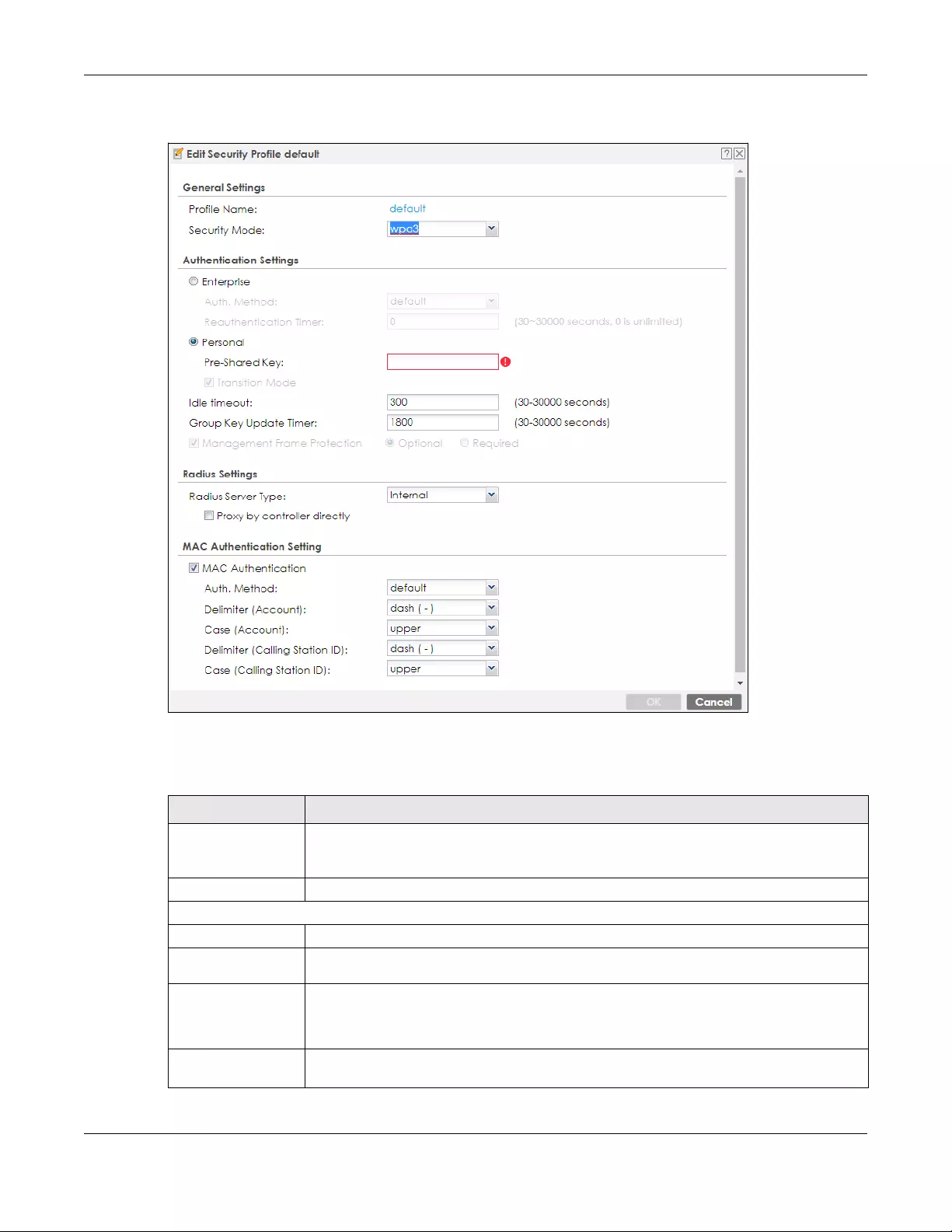
Chapter 39 Object
ZyWALL USG FLEX Series User’s Guide
754
Figure 492 Configuration > Object > AP Profile > SSID > Security Profile > Add/Edit Security Profile>
Security Mode: wpa3
The following table describes the labels in this screen.
Table 314 Configuration > Object > AP Profile > SSID > Security Profile > Add/Edit Security Profile>
Security Mode: wpa3
LABEL DESCRIPTION
Profile Name Enter up to 31 alphanumeric characters for the profile name. This name is only visible in the
Web Configurator and is only for management purposes. Spaces and underscores are
allowed.
Security Mode Select a security mode from the list: open, enhanced open, wep, wpa2, or wpa2-mix, wpa3.
Authentication Settings
Enterprise Select this to enable 802.1x secure authentication with a RADIUS server.
Reauthenticatio
n Timer Enter the interval (in seconds) between authentication requests. Enter a 0 for unlimited time.
Personal This field is available when you select the wpa2, wpa2-mix or wpa3 security mode.
Select this option to use a Pre-Shared Key (PSK) with WPA2 encryption or Simultaneous
Authentication of Equals (SAE) with WPA3 encryption.
Pre-Shared Key Enter a pre-shared key of between 8 and 63 case-sensitive ASCII characters (including
spaces and symbols) or 64 hexadecimal characters.

Chapter 39 Object
ZyWALL USG FLEX Series User’s Guide
755
Transition Mode Enable this for backwards compatibility. This option is only available if the Security Mode is
wpa3 or enhanced-open. This creates two virtual APs (VAPs) with a primary (wpa3 or
enhanced-open) and fallback (wpa2 or none) security method.
If the Security Mode is wpa3, enabling this will force Management Frame Protection to be set
to Optional. If this is disabled or if the Security Mode is enhanced-open, Management Frame
Protection will be set to Required.
Idle Timeout Enter the idle interval (in seconds) that a client can be idle before authentication is
discontinued.
Group Key Update
Timer
Enter the interval (in seconds) at which the AP updates the group WPA2 encryption key.
Management
Frame Protection
This field is available only when you select wpa2 in the Security Mode field and set Cipher
Type to aes.
Data frames in 802.11 WLANs can be encrypted and authenticated with WEP, WPA or
WPA2. But 802.11 management frames, such as beacon/probe response, association
request, association response, de-authentication and disassociation are always
unauthenticated and unencrypted. IEEE 802.11w Protected Management Frames allows
APs to use the existing security mechanisms (encryption and authentication methods
defined in IEEE 802.11i WPA/WPA2) to protect management frames. This helps prevent
wireless DoS attacks.
Select the check box to enable management frame protection (MFP) to add security to
802.11 management frames.
Select Optional if you do not require the wireless clients to support MFP. Management
frames will be encrypted if the clients support MFP.
Select Required and wireless clients must support MFP in order to join the Zyxel Device’s
wireless network.
Radius Settings
Primary / Secondary
Radius Server
Activate
Select this to have the Zyxel Device use the specified RADIUS server.
Radius Server IP
Address Enter the IP address of the RADIUS server to be used for authentication.
Radius Server
Port Enter the port number of the RADIUS server to be used for authentication.
Radius Server
Secret Enter the shared secret password of the RADIUS server to be used for authentication.
Primary / Secondary
Accounting Server
Activate
Select the check box to enable user accounting through an external authentication server.
Accounting
Server IP Address Enter the IP address of the external accounting server in dotted decimal notation.
Accounting
Server Port Enter the port number of the external accounting server. The default port number is 1813.
You need not change this value unless your network administrator instructs you to do so with
additional information.
Accounting
Share Secret Enter a password (up to 128 alphanumeric characters) as the key to be shared between the
external accounting server and the Zyxel Device. The key must be the same on the external
accounting server and your Zyxel Device. The key is not sent over the network.
Accounting Interim
Update
This field is available only when you enable user accounting through an external
authentication server.
Select this to have the Zyxel Device send subscriber status updates to the accounting server
at the interval you specify.
Table 314 Configuration > Object > AP Profile > SSID > Security Profile > Add/Edit Security Profile>
Security Mode: wpa3 (continued)
LABEL DESCRIPTION
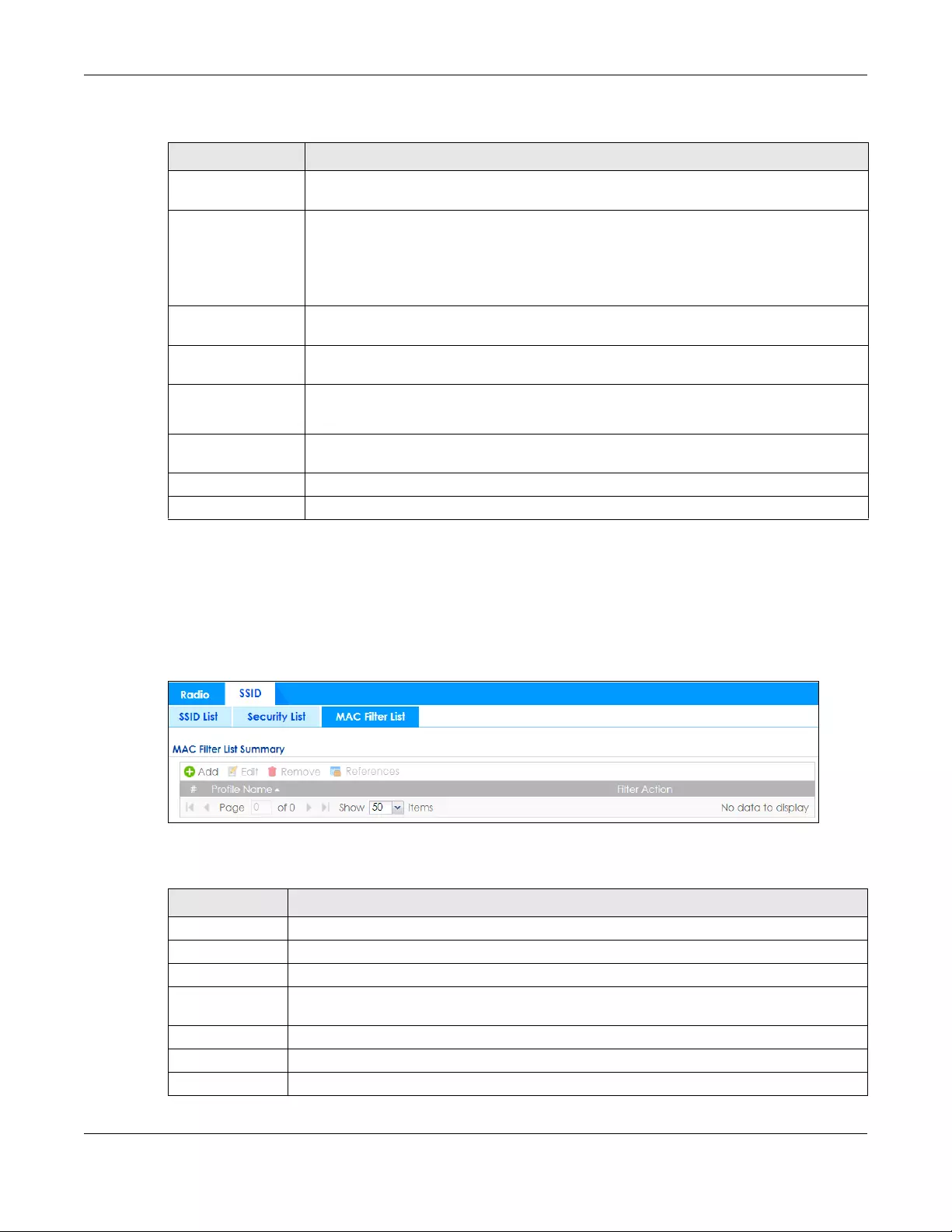
Chapter 39 Object
ZyWALL USG FLEX Series User’s Guide
756
39.3.2.5 MAC Filter List
This screen allows you to create and manage security configurations that can be used by your SSIDs. To
access this screen click Configuration > Object > AP Profile > SSID > MAC Filter List.
Note: You can have a maximum of 32 MAC filtering profiles on the Zyxel Device.
Figure 493 Configuration > Object > AP Profile > SSID > MAC Filter List
The following table describes the labels in this screen.
Interim Update
Interval Specify the time interval for how often the Zyxel Device is to send a subscriber status update
to the accounting server.
MAC Authentication Select this to use an external server or the Zyxel Device’s local database to authenticate
wireless clients by their MAC addresses. Users cannot get an IP address if the MAC
authentication fails.
An external server can use the wireless client’s account (username/password) or Calling
Station ID for MAC authentication. Configure the ones the external server uses.
Delimiter
(Account) Select the separator the external server uses for the two-character pairs within account
MAC addresses.
Case (Account) Select the case (upper or lower) the external server requires for letters in the account MAC
addresses.
Delimiter (Calling
Station ID) RADIUS servers can require the MAC address in the Calling Station ID RADIUS attribute.
Select the separator the external server uses for the pairs in calling station MAC addresses.
Case (Calling
Station ID) Select the case (upper or lower) the external server requires for letters in the calling station
MAC addresses.
OK Click OK to save your changes back to the Zyxel Device.
Cancel Click Cancel to exit this screen without saving your changes.
Table 314 Configuration > Object > AP Profile > SSID > Security Profile > Add/Edit Security Profile>
Security Mode: wpa3 (continued)
LABEL DESCRIPTION
Table 315 Configuration > Object > AP Profile > SSID > MAC Filter List
LABEL DESCRIPTION
Add Click this to add a new MAC filtering profile.
Edit Click this to edit the selected MAC filtering profile.
Remove Click this to remove the selected MAC filtering profile.
References Click this to view which other objects are linked to the selected MAC filtering profile (for
example, SSID profile).
#This field is a sequential value, and it is not associated with a specific profile.
Profile Name This field indicates the name assigned to the MAC filtering profile.
Filter Action This field indicates this profile’s filter action (if any).
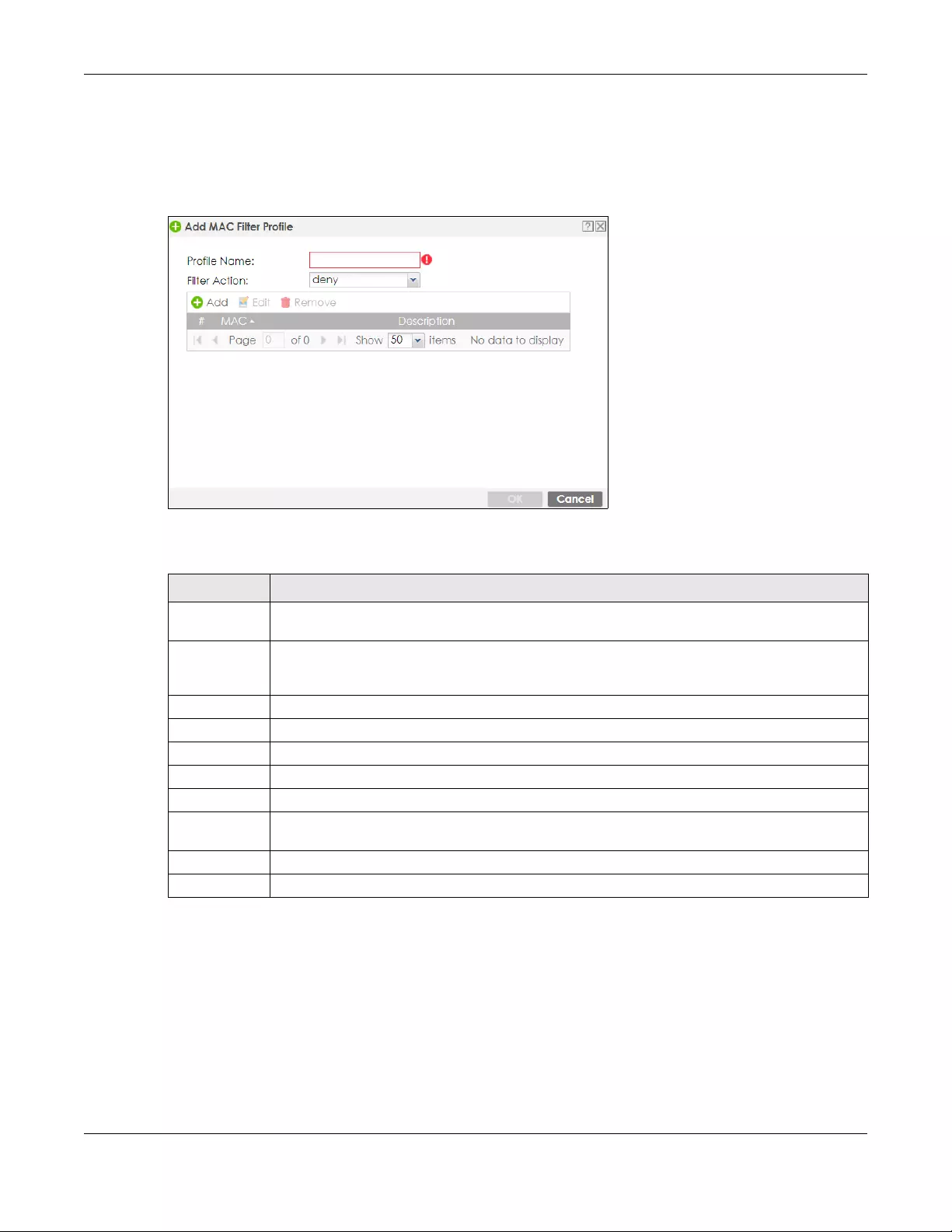
Chapter 39 Object
ZyWALL USG FLEX Series User’s Guide
757
39.3.2.6 Add/Edit MAC Filter Profile
This screen allows you to create a new MAC filtering profile or edit an existing one. To access this screen,
click the Add button or select a MAC filter profile from the list and click the Edit button.
Figure 494 SSID > MAC Filter List > Add/Edit MAC Filter Profile
The following table describes the labels in this screen.
39.4 MON Profile
39.4.1 Overview
This screen allows you to set up monitor mode configurations that allow your connected APs to scan for
other wireless devices in the vicinity. Once detected, you can use the Rogue AP screen (Section 8.4 on
page 220) to classify them as either rogue or friendly and then manage them accordingly.
Table 316 SSID > MAC Filter List > Add/Edit MAC Filter Profile
LABEL DESCRIPTION
Profile Name Enter up to 31 alphanumeric characters for the profile name. This name is only visible in the Web
Configurator and is only for management purposes. Spaces and underscores are allowed.
Filter Action Select allow to permit the wireless client with the MAC addresses in this profile to connect to the
network through the associated SSID; select deny to block the wireless clients with the specified
MAC addresses.
Add Click this to add a MAC address to the profile’s list.
Edit Click this to edit the selected MAC address in the profile’s list.
Remove Click this to remove the selected MAC address from the profile’s list.
#This field is a sequential value, and it is not associated with a specific profile.
MAC This field specifies a MAC address associated with this profile.
Description This field displays a description for the MAC address associated with this profile. You can click the
description to make it editable. Enter up to 60 characters, spaces and underscores allowed.
OK Click OK to save your changes back to the Zyxel Device.
Cancel Click Cancel to exit this screen without saving your changes.

Chapter 39 Object
ZyWALL USG FLEX Series User’s Guide
758
The MON Profile screen (Section 39.4.2 on page 758) creates preset monitor mode configurations that
can be used by the APs.
39.4.1.1 What You Need To Know
The following terms and concepts may help as you read this chapter.
Active Scan
An active scan is performed when an 802.11-compatible wireless monitoring device is explicitly
triggered to scan a specified channel or number of channels for other wireless devices broadcasting on
the 802.11 frequencies by sending probe request frames.
Passive Scan
A passive scan is performed when an 802.11-compatible monitoring device is set to periodically listen to
a specified channel or number of channels for other wireless devices broadcasting on the 802.11
frequencies.
39.4.2 Configuring MON Profile
This screen allows you to create monitor mode configurations that can be used by the APs. To access
this screen, login to the Web Configurator, and click Configuration > Object > MON Profile.
Figure 495 Configuration > Object > MON Profile
The following table describes the labels in this screen.
Table 317 Configuration > Object > MON Profile
LABEL DESCRIPTION
Add Click this to add a new monitor mode profile.
Edit Click this to edit the selected monitor mode profile.
Remove Click this to remove the selected monitor mode profile.
Activate To turn on an entry, select it and click Activate.
Inactivate To turn off an entry, select it and click Inactivate.
References Click this to view which other objects are linked to the selected monitor mode profile (for
example, an AP management profile).
#This field is a sequential value, and it is not associated with a specific user.
Status This icon is lit when the entry is active and dimmed when the entry is inactive.
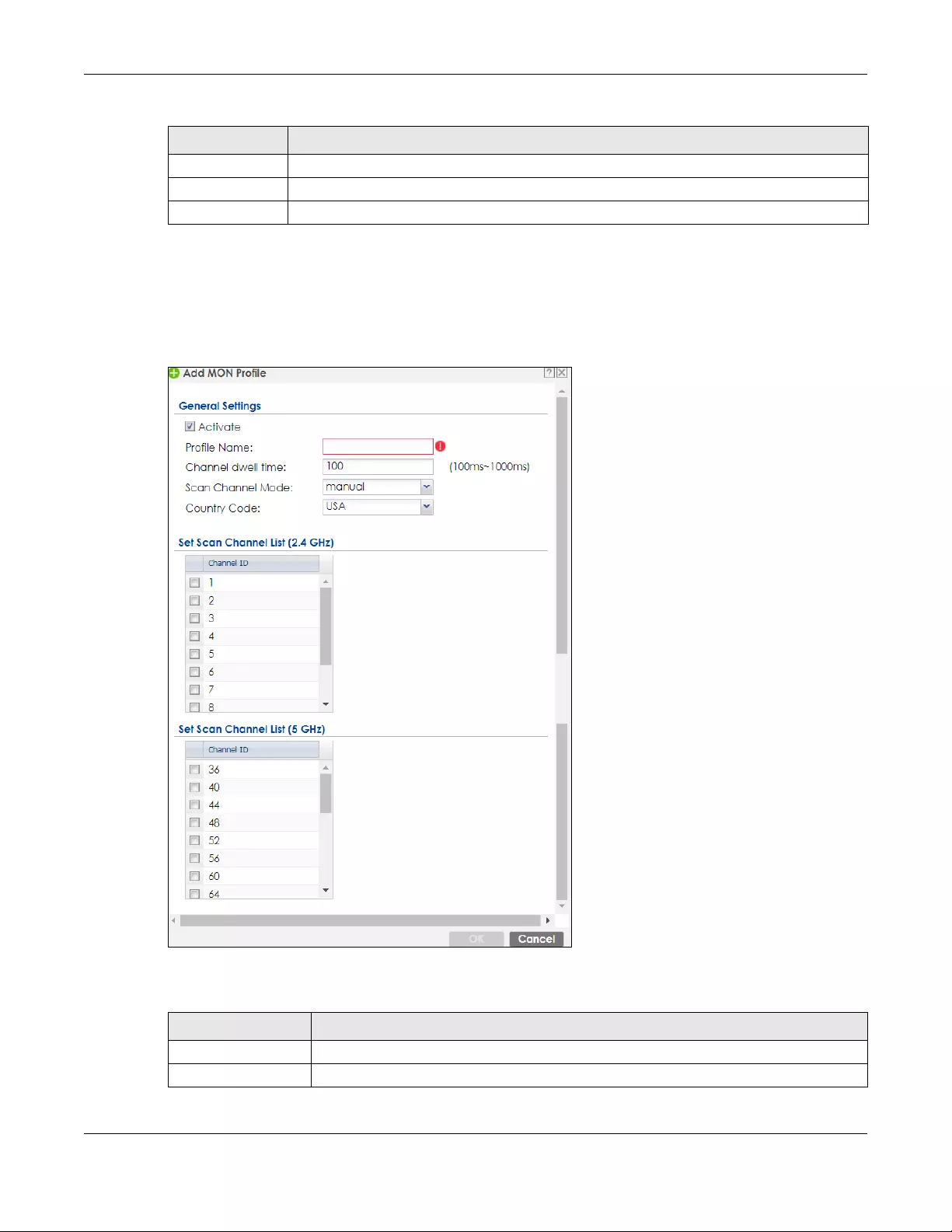
Chapter 39 Object
ZyWALL USG FLEX Series User’s Guide
759
39.4.3 Add/Edit MON Profile
This screen allows you to create a new monitor mode profile or edit an existing one. To access this
screen, click the Add button or select and existing monitor mode profile and click the Edit button.
Figure 496 Configuration > Object > MON Profile > Add/Edit MON Profile
The following table describes the labels in this screen.
Profile Name This field indicates the name assigned to the monitor profile.
Apply Click Apply to save your changes back to the Zyxel Device.
Reset Click Reset to return the screen to its last-saved settings.
Table 317 Configuration > Object > MON Profile (continued)
LABEL DESCRIPTION
Table 318 Configuration > Object > MON Profile > Add/Edit MON Profile
LABEL DESCRIPTION
Activate Select this to activate this monitor mode profile.
Profile Name This field indicates the name assigned to the monitor mode profile.

Chapter 39 Object
ZyWALL USG FLEX Series User’s Guide
760
39.4.4 Technical Reference
The following section contains additional technical information about the features described in this
chapter.
Rogue APs
Rogue APs are wireless access points operating in a network’s coverage area that are not under the
control of the network’s administrators, and can open up holes in a network’s security. Attackers can
take advantage of a rogue AP’s weaker (or non-existent) security to gain access to the network, or set
up their own rogue APs in order to capture information from wireless clients. If a scan reveals a rogue AP,
you can use commercially-available software to physically locate it.
Channel dwell time Enter the interval (in milliseconds) before the AP switches to another channel for
monitoring.
Scan Channel Mode Select auto to have the AP switch to the next sequential channel once the Channel dwell
time expires.
Select manual to set specific channels through which to cycle sequentially when the
Channel dwell time expires. Selecting this options makes the Scan Channel List options
available.
Country Code Select the country code of APs that are connected to the Zyxel Device to be the same as
where the Zyxel Device is located/installed.
The available channels vary depending on the country you selected. Be sure to select the
correct/same country for both radios on an AP and all connected APs, in order to prevent
roaming failure and interference to other systems.
Note: For US and Canada models, country code is fixed to US or Canada
respectively and is not user selectable.
Set Scan Channel List
(2.4 GHz)
Move a channel from the Available channels column to the Channels selected column to
have the APs using this profile scan that channel when Scan Channel Mode is set to
manual.
These channels are limited to the 2 GHz range (802.11 b/g/n).
Set Scan Channel List
(5 GHz)
Move a channel from the Available channels column to the Channels selected column to
have the APs using this profile scan that channel when Scan Channel Mode is set to
manual.
These channels are limited to the 5 GHz range (802.11 a/n).
OK Click OK to save your changes back to the Zyxel Device.
Cancel Click Cancel to exit this screen without saving your changes.
Table 318 Configuration > Object > MON Profile > Add/Edit MON Profile (continued)
LABEL DESCRIPTION
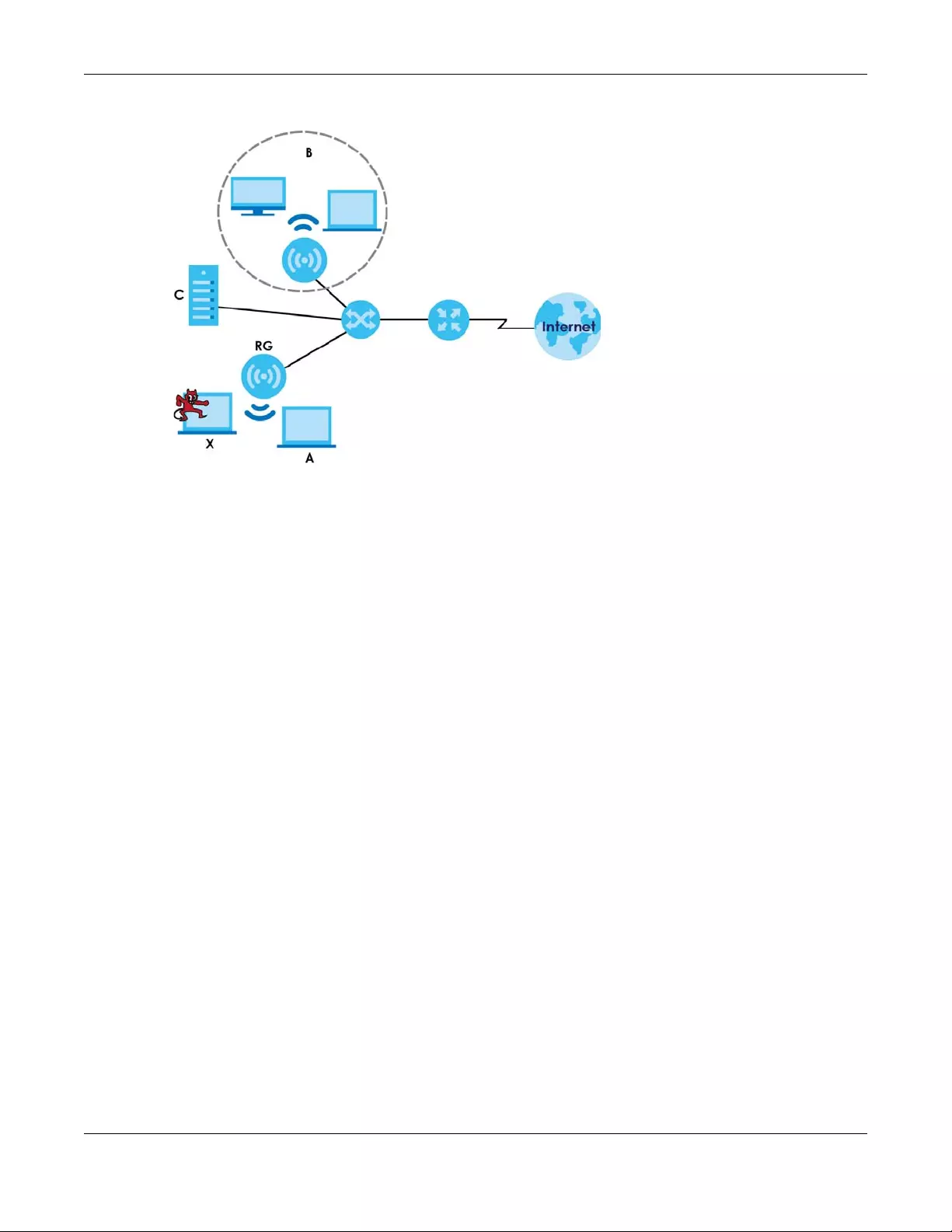
Chapter 39 Object
ZyWALL USG FLEX Series User’s Guide
761
Figure 497 Rogue AP Example
In the example above, a corporate network’s security is compromised by a rogue AP (RG) set up by an
employee at his workstation in order to allow him to connect his notebook computer wirelessly (A). The
company’s legitimate wireless network (the dashed ellipse B) is well-secured, but the rogue AP uses
inferior security that is easily broken by an attacker (X) running readily available encryption-cracking
software. In this example, the attacker now has access to the company network, including sensitive
data stored on the file server (C).
Friendly APs
If you have more than one AP in your wireless network, you should also configure a list of “friendly” APs.
Friendly APs are other wireless access points that are detected in your network, as well as any others that
you know are not a threat (those from recognized networks, for example). It is recommended that you
export (save) your list of friendly APs often, especially if you have a network with a large number of
access points.
39.5 ZyMesh Overview
This section shows you how to configure ZyMesh profiles for the Zyxel Device to apply to the managed
APs.
ZyMesh is a Zyxel proprietary protocol that creates wireless mesh links between managed APs to expand
the wireless network. Managed APs can provide services or forward traffic between the Zyxel Device
and wireless clients. ZyMesh also allows the Zyxel Device to use CAPWAP to automatically update the
configuration settings on the managed APs (in repeater mode) through wireless connections. The
managed APs (in repeater mode) are provisioned hop by hop.
The managed APs in a ZyMesh must use the same SSID, channel number and pre-shared key. A manged
AP can be either a root AP or repeater in a ZyMesh.
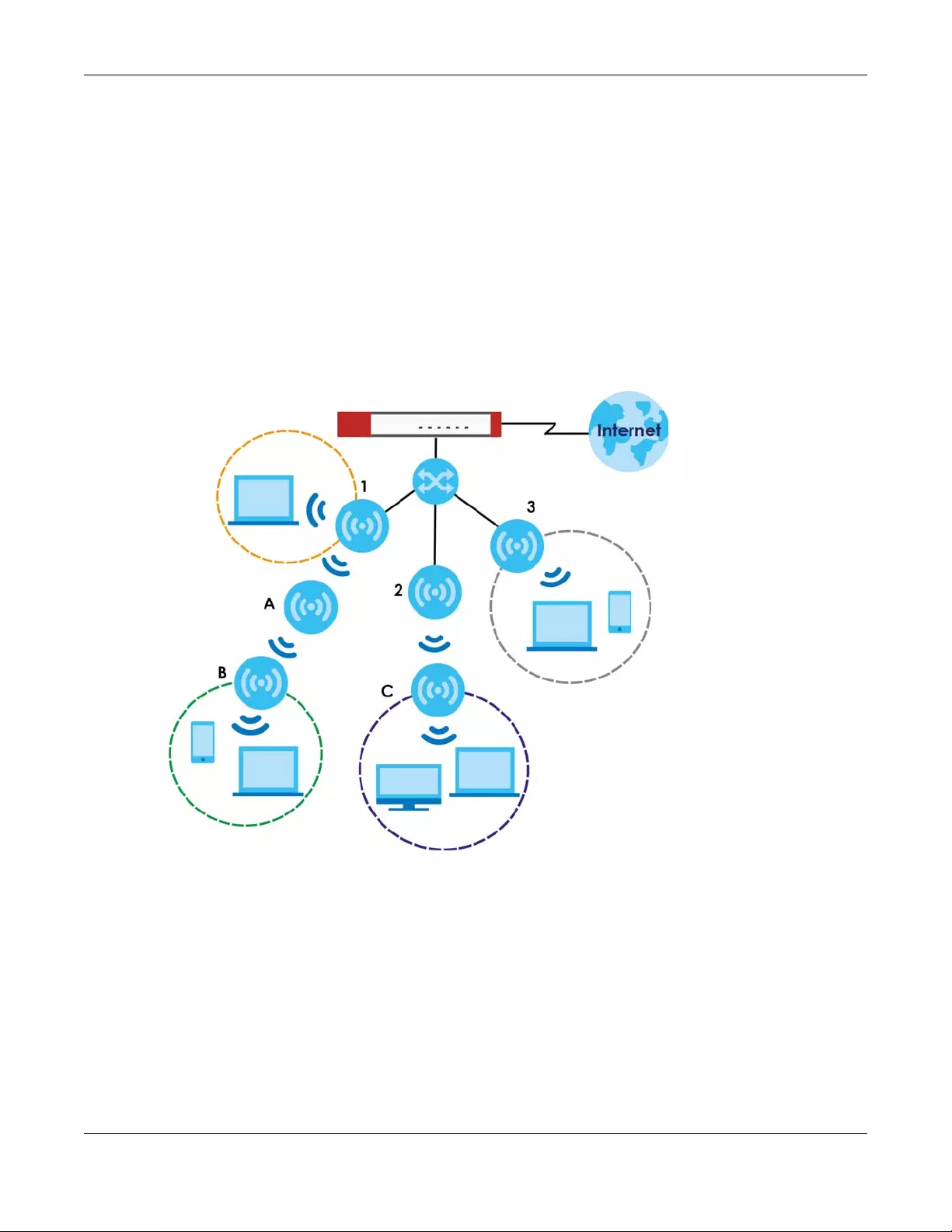
Chapter 39 Object
ZyWALL USG FLEX Series User’s Guide
762
Note: All managed APs should be connected to the Zyxel Device directly to get the
configuration file before being deployed to build a ZyMesh. Ensure you restart the
managed AP after you change its operating mode using the Configuration > Wireless >
AP Management screen (see Section 8.3 on page 204).
• Root AP: a managed AP that can transmit and receive data from the Zyxel Device via a wired
Ethernet connection.
• Repeater: a managed AP that transmits and/or receives data from the Zyxel Device via a wireless
connection through a root AP.
Note: When managed APs are deployed to form a ZyMesh for the first time, the root AP must
be connected to an AP controller (the Zyxel Device).
In the following example, managed APs 1 and 2 act as a root AP and managed APs A, B and C are
repeaters.
The maximum number of hops (the repeaters between a wireless client and the root AP) you can have
in a ZyMesh varies according to how many wireless clients a managed AP can support.
Note: A ZyMesh link with more hops has lower throughput.
Note: When the wireless connection between the root AP and the repeater is up, in order to
prevent bridge loops, the repeater would not be able to transmit data through its
Ethernet port(s). The repeater then could only receive power from a PoE device if you
use PoE to provide power to the managed AP via an 8-ping Ethernet cable.
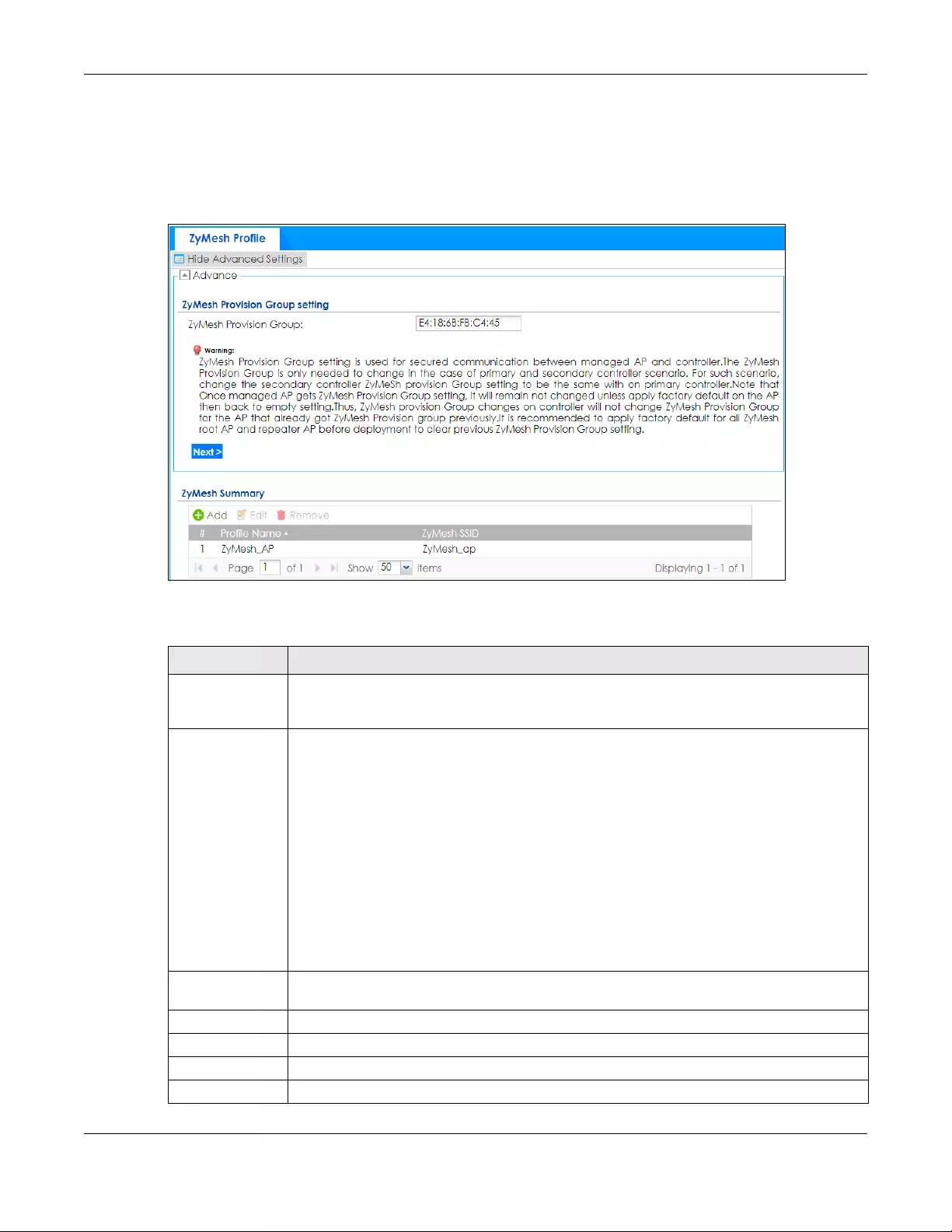
Chapter 39 Object
ZyWALL USG FLEX Series User’s Guide
763
39.5.1 ZyMesh Profile
This screen allows you to manage and create ZyMesh profiles that can be used by the APs. To access
this screen, click Configuration > Object > ZyMesh Profile.
Figure 498 Configuration > Object > ZyMesh Profile
The following table describes the labels in this screen.
Table 319 Configuration > Object > ZyMesh Profile
LABEL DESCRIPTION
Hide / Show
Advanced
Settings
Click this to display a greater or lesser number of configuration fields.
ZyMesh Provision
Group
By default, this shows the MAC address used by the Zyxel Device’s first Ethernet port.
Say you have two AP controllers (Zyxel Devices) in your network and the primary AP controller is
not reachable. You may want to deploy the second/backup AP controller in your network to
replace the primary AP controller. In this case, it is recommended that you enter the primary AP
controller’s ZyMesh Provision Group MAC address in the second AP controller’s ZyMesh
Provision Group field.
If you didn’t change the second AP controller’s MAC address, managed APs in an existing
ZyMesh can still access the networks through the second AP controller and communicate with
each other. But new managed APs will not be able to communicate with the managed APs in
the existing ZyMesh, which is set up with the primary AP controller’s MAC address.
To allow all managed APs to communicate in the same ZyMesh, you can just set the second AP
controller to use the primary AP controller’s MAC address. Otherwise, reset all managed APs to
the factory defaults and set up a new ZyMesh with the second AP controller’s MAC address.
Next Click this button and follow the on-screen instructions to update the AP controller’s MAC
address.
Add Click this to add a new profile.
Edit Click this to edit the selected profile.
Remove Click this to remove the selected profile.
#This field is a sequential value, and it is not associated with a specific profile.
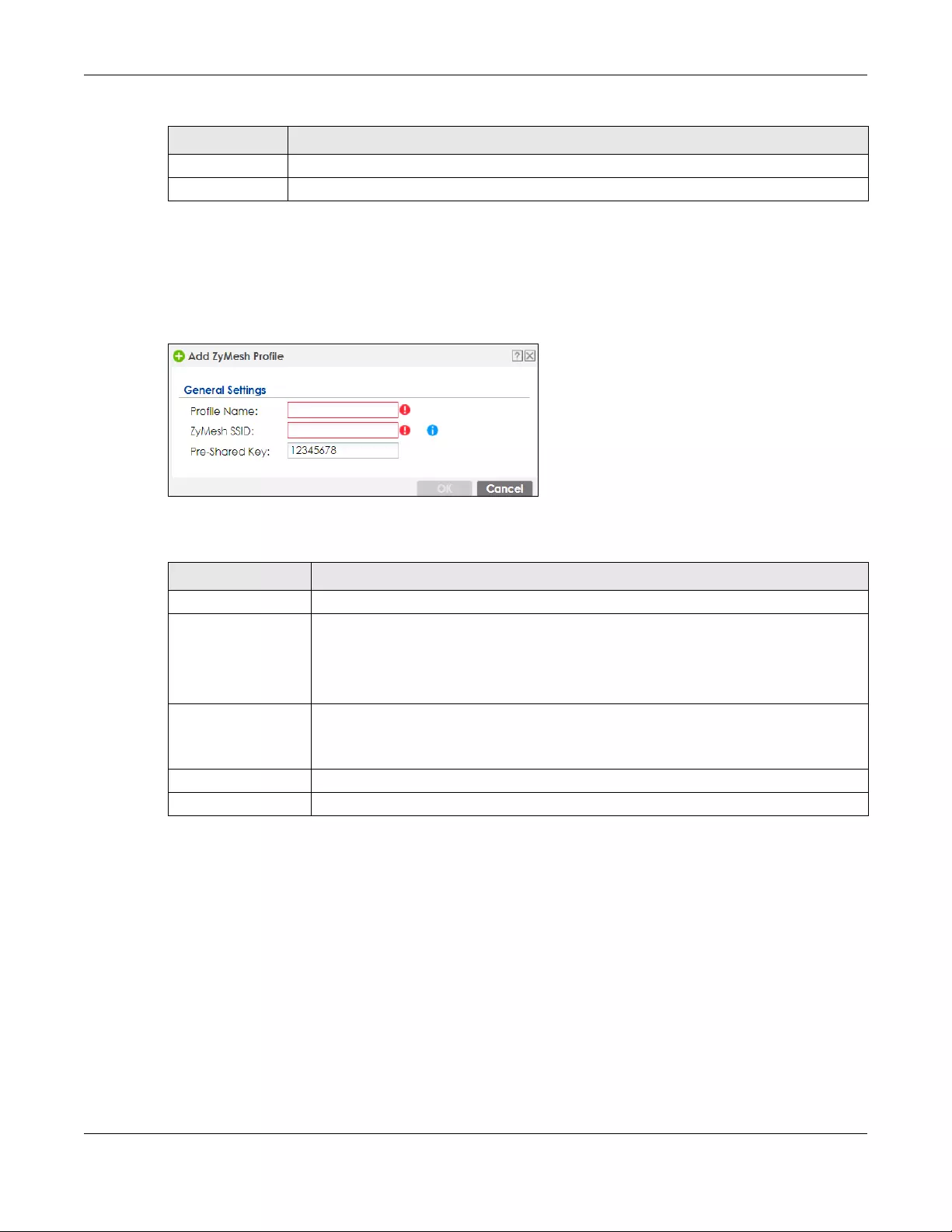
Chapter 39 Object
ZyWALL USG FLEX Series User’s Guide
764
39.5.2 Add/Edit ZyMesh Profile
This screen allows you to create a new ZyMesh profile or edit an existing one. To access this screen, click
the Add button or select and existing profile and click the Edit button.
Figure 499 Configuration > Object > ZyMesh Profile > Add/Edit ZyMesh Profile
The following table describes the labels in this screen.
39.6 Address/Geo IP Overview
Address objects can represent a single IP address or a range of IP addresses. Address groups are
composed of address objects and other address groups.
• The Address screen (Section 39.6.2 on page 765) provides a summary of all addresses in the Zyxel
Device. Use the Address Add/Edit screen to create a new address or edit an existing one.
• Use the Address Group summary screen (Section 39.6.3 on page 769) and the Address Group Add/
Edit screen, to maintain address groups in the Zyxel Device.
• Use the Geo IP screen (Section 39.6.4 on page 771) to update the database of country-to-IP address
mappings and to manually configure country-to-IP address mappings.
Profile Name This field indicates the name assigned to the profile.
ZyMesh SSID This field shows the SSID specified in this ZyMesh profile.
Table 319 Configuration > Object > ZyMesh Profile (continued)
LABEL DESCRIPTION
Table 320 Configuration > Object > ZyMesh Profile > Add/Edit ZyMesh Profile
LABEL DESCRIPTION
Profile Name Enter up to 31 alphanumeric characters for the profile name.
ZyMesh SSID Enter the SSID with which you want the managed AP to connect to a root AP or repeater to
build a ZyMesh link.
Note: The ZyMesh SSID is hidden in the outgoing beacon frame so a wireless
device cannot obtain the SSID through scanning using a site survey tool.
Pre-Shared Key Enter a pre-shared key of between 8 and 63 case-sensitive ASCII characters (including
spaces and symbols) or 64 hexadecimal characters.
The key is used to encrypt the wireless traffic between the APs.
OK Click OK to save your changes back to the Zyxel Device.
Cancel Click Cancel to exit this screen without saving your changes.
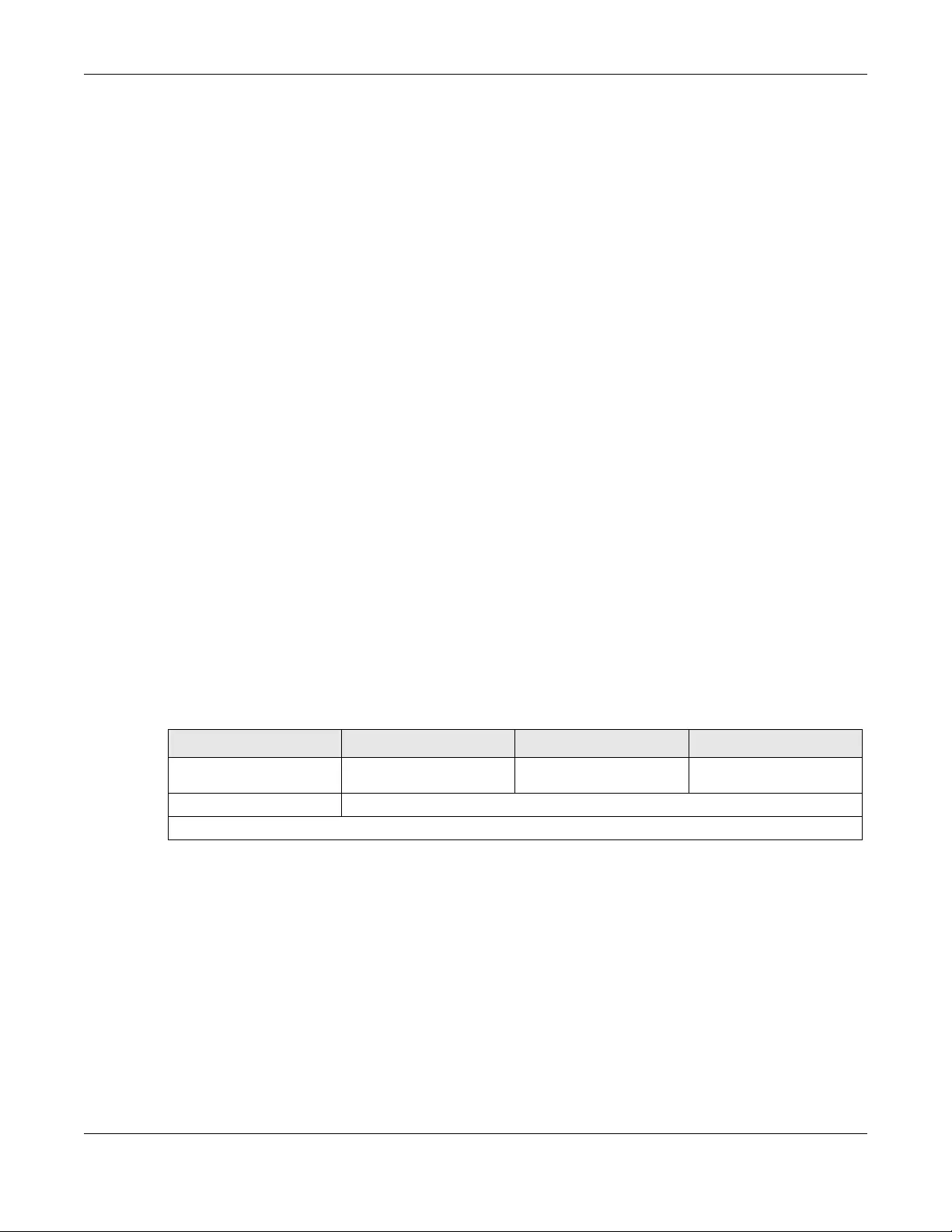
Chapter 39 Object
ZyWALL USG FLEX Series User’s Guide
765
39.6.1 What You Need To Know
Address objects and address groups are used in dynamic routes, security policies, application patrol,
content filtering, and VPN connection policies. For example, addresses are used to specify where
content restrictions apply in content filtering. Please see the respective sections for more information
about how address objects and address groups are used in each one.
Address groups are composed of address objects and address groups. The sequence of members in the
address group is not important.
39.6.2 Address Summary Screen
The address screens are used to create, maintain, and remove addresses. There are the types of
address objects:
•HOST - the object uses an IP Address to define a host address
•RANGE - the object uses a range address defined by a Starting IP Address and an Ending IP Address
•SUBNET - the object uses a network address defined by a Network IP address and Netmask subnet
mask
•INTERFACE IP - the object uses the IP address of one of the Zyxel Device’s interfaces
•INTERFACE SUBNET - the object uses the subnet mask of one of the Zyxel Device’s interfaces
•INTERFACE GATEWAY - the object uses the gateway IP address of one of the Zyxel Device’s interfaces
•GEOGRAPHY - the object uses the IP addresses of a country to represent a country
FQDN - the object uses a FQDN (Fully Qualified Domain Name). An FQDN consists of a host and domain
name. For example, www.zyxel.com is a fully qualified domain name, where “www” is the host, “zyxel” is
the second-level domain, and “com” is the top level domain. mail.myZyxel.com.tw is also an FQDN,
where “mail” is the host, “myZyxel” is the third-level domain, “com” is the second-level domain, and
“tw” is the top level domain.
In an address FQDN object, you can also use one wildcard. For example, *.zyxel.com. An FQDN is
resolved to its IP address using the DNS server configured on the Zyxel Device.
The Address screen provides a summary of all addresses in the Zyxel Device. To access this screen, click
Configuration > Object > Address > Address. Click a column’s heading cell to sort the table entries by
that column’s criteria. Click the heading cell again to reverse the sort order.
Table 321 FQDN Example
HTTP:// WWW. ZYXEL. COM
host name second-level domain
name top-level domain name
FQDN
Uniform Resource Locator (URL)

Chapter 39 Object
ZyWALL USG FLEX Series User’s Guide
766
Figure 500 Configuration > Object > Address/Geo IP > Address
The following table describes the labels in this screen. See Section 39.6.2.1 on page 767 for more
information as well.
Table 322 Configuration > Object > Address/Geo IP > Address
LABEL DESCRIPTION
IPv4 Address Configuration
Add Click this to create a new entry.
Edit Double-click an entry or select it and click Edit to be able to modify the entry’s settings.
Remove To remove an entry, select it and click Remove. The Zyxel Device confirms you want to remove
it before doing so.
References Select an entry and click References to open a screen that shows which settings use the entry.
#This field is a sequential value, and it is not associated with a specific address.
Name This field displays the configured name of each address object.
Type This field displays the type of each address object. “INTERFACE” means the object uses the
settings of one of the Zyxel Device’s interfaces.
IPv4 Address This field displays the IPv4 addresses represented by each address object. If the object’s
settings are based on one of the Zyxel Device’s interfaces, the name of the interface displays
first followed by the object’s current address settings.
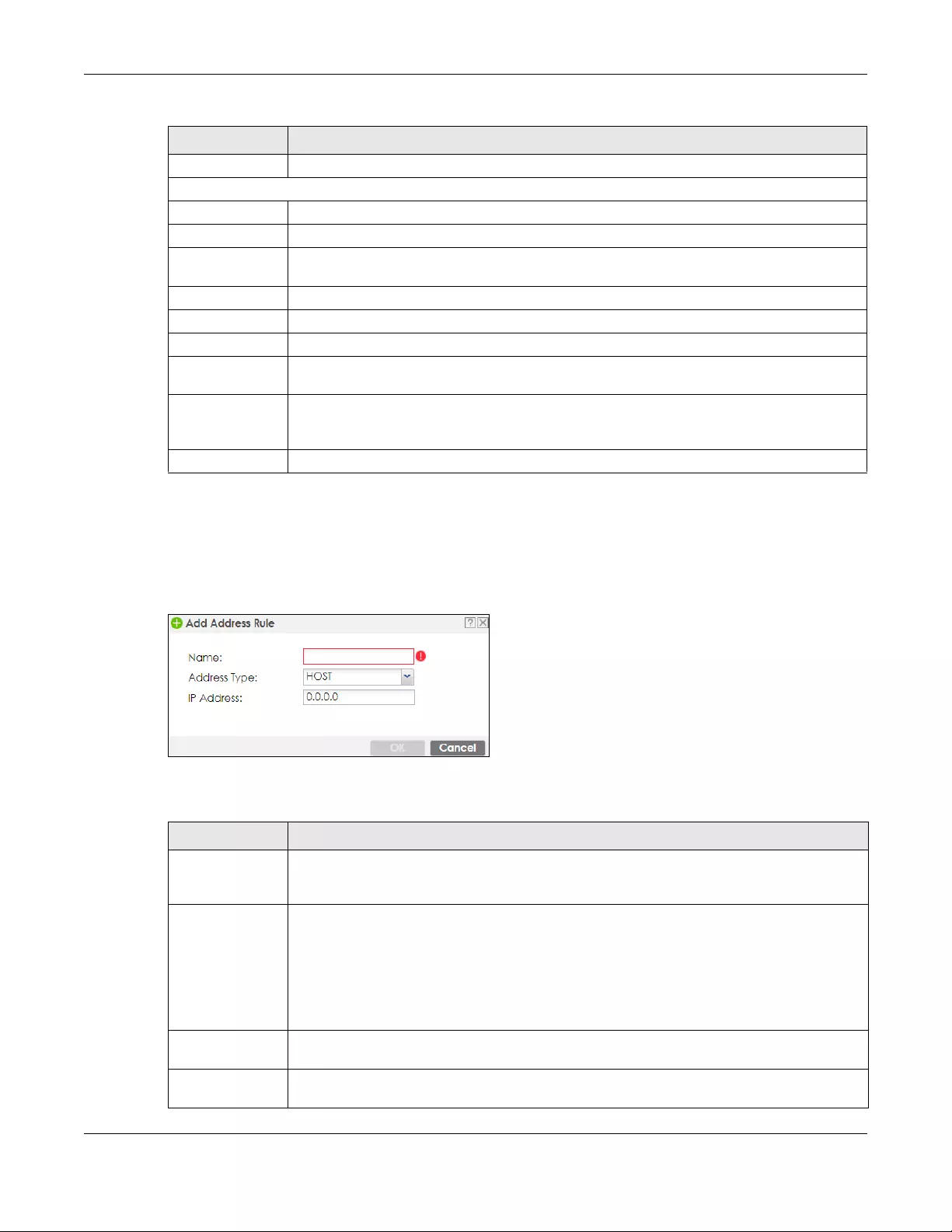
Chapter 39 Object
ZyWALL USG FLEX Series User’s Guide
767
39.6.2.1 IPv4 Address Add/Edit Screen
The Configuration > Object > Address/GeoIP > Address > Add/Edit (IPv4) screen allows you to create a
new address or edit an existing one. To access this screen, go to the Address screen (see Section 39.6.2
on page 765), and click either the Add icon or an Edit icon in the IPv4 Address Configuration section.
Figure 501 Configuration > Object > Address/GeoIP > Address > Add/Edit (IPv4) t
The following table describes the labels in this screen.
Reference This displays the number of times an object reference is used in a profile.
IPv6 Address Configuration
Add Click this to create a new entry.
Edit Double-click an entry or select it and click Edit to be able to modify the entry’s settings.
Remove To remove an entry, select it and click Remove. The Zyxel Device confirms you want to remove
it before doing so.
References Select an entry and click References to open a screen that shows which settings use the entry.
#This field is a sequential value, and it is not associated with a specific address.
Name This field displays the configured name of each address object.
Type This field displays the type of each address object. “INTERFACE” means the object uses the
settings of one of the Zyxel Device’s interfaces.
IPv6 Address This field displays the IPv6 addresses represented by each address object. If the object’s
settings are based on one of the Zyxel Device’s interfaces, the name of the interface displays
first followed by the object’s current address settings.
Reference This displays the number of times an object reference is used in a profile.
Table 322 Configuration > Object > Address/Geo IP > Address (continued)
LABEL DESCRIPTION
Table 323 Configuration > Object > Address/GeoIP > Address > Add/Edit (IPv4)
LABEL DESCRIPTION
Name Type the name used to refer to the address. You may use 1-31 alphanumeric characters,
underscores(_), or dashes (-), but the first character cannot be a number. This value is case-
sensitive.
Address Type Select the type of address you want to create.
Note: The Zyxel Device automatically updates address objects that are based on an
interface’s IP address, subnet, or gateway if the interface’s IP address settings
change. For example, if you change 1’s IP address, the Zyxel Device
automatically updates the corresponding interface-based, LAN subnet
address object.
IP Address This field is only available if the Address Type is HOST. This field cannot be blank. Enter the IP
address that this address object represents.
Starting IP
Address
This field is only available if the Address Type is RANGE. This field cannot be blank. Enter the
beginning of the range of IP addresses that this address object represents.

Chapter 39 Object
ZyWALL USG FLEX Series User’s Guide
768
39.6.2.2 IPv6 Address Add/Edit Screen
The Configuration > Object > Address/GeoIP > Address > Add/Edit (IPv6) screen allows you to create a
new address or edit an existing one. To access this screen, go to the Address screen (see Section 39.6.2
on page 765), and click either the Add icon or an Edit icon in the IPv6 Address Configuration section.
Figure 502 Configuration > Object > Address/GeoIP > Address > Add/Edit (IPv6)
The following table describes the labels in this screen.
Ending IP Address This field is only available if the Address Type is RANGE. This field cannot be blank. Enter the end
of the range of IP address that this address object represents.
Network This field is only available if the Address Type is SUBNET, in which case this field cannot be blank.
Enter the IP address of the network that this address object represents.
Netmask This field is only available if the Address Type is SUBNET, in which case this field cannot be blank.
Enter the subnet mask of the network that this address object represents. Use dotted decimal
format.
Interface If you selected INTERFACE IP , INTERFACE SUBNET, or INTERFACE GATEWAY as the Address Type,
use this field to select the interface of the network that this address object represents.
Region If you selected GEOGRAPHY as the Address Type, use this field to select a country or continent.
A GEOGRAPHY object uses the data from the country-to-IP/continent-to-IP address database.
Go to the Configuration > Object > Address/Geo IP > Geo IP screen to configure the custom
country-to-IP/continent-to-IP address mappings for a GEOGRAPHY object.
Country If you selected Geography as the Address Type, use this field to select a country.
FQDN If you selected FQDN as the Address Type, use this field to enter a fully qualified domain name.
OK Click OK to save your changes back to the Zyxel Device.
Cancel Click Cancel to exit this screen without saving your changes.
Table 323 Configuration > Object > Address/GeoIP > Address > Add/Edit (IPv4)
LABEL DESCRIPTION
Table 324 Configuration > Object > Address/GeoIP > Address > Add/Edit (IPv6)
LABEL DESCRIPTION
Name Type the name used to refer to the address. You may use 1-31 alphanumeric characters,
underscores(_), or dashes (-), but the first character cannot be a number. This value is case-
sensitive.
Object Type Select the type of address you want to create.
Note: The Zyxel Device automatically updates address objects that are based on an
interface’s IP address, subnet, or gateway if the interface’s IP address settings
change. For example, if you change 1’s IP address, the Zyxel Device
automatically updates the corresponding interface-based, LAN subnet
address object.
IPv6 Address This field is only available if the Address Type is HOST. This field cannot be blank. Enter the IP
address that this address object represents.

Chapter 39 Object
ZyWALL USG FLEX Series User’s Guide
769
39.6.3 Address Group Summary Screen
The Address Group screen provides a summary of all address groups. To access this screen, click
Configuration > Object > Address/Geo IP > Address Group. Click a column’s heading cell to sort the
table entries by that column’s criteria. Click the heading cell again to reverse the sort order.
Figure 503 Configuration > Object > Address/Geo IP > Address Group
The following table describes the labels in this screen. See Section 39.6.3.1 on page 770 for more
information as well.
IPv6 Starting
Address
This field is only available if the Address Type is RANGE. This field cannot be blank. Enter the
beginning of the range of IP addresses that this address object represents.
IPv6 Ending
Address
This field is only available if the Address Type is RANGE. This field cannot be blank. Enter the end
of the range of IP address that this address object represents.
IPv6 Address
Prefix
This field is only available if the Addr ess Type is SUBNET. This field cannot be blank. Enter the IPv6
address prefix that the Zyxel Device uses for the LAN IPv6 address.
Interface If you selected INTERFACE IP , INTERFACE SUBNET, or INTERFACE GATEWAY as the Address Type,
use this field to select the interface of the network that this address object represents.
IPv6 Address Type Select whether the IPv6 address is a link-local IP address (LINK LOCAL), static IP address
(STATIC), an IPv6 StateLess Address Auto Configuration IP address (SLAAC), or is obtained from
a DHCPv6 server (DHCPv6).
Region If you selected Geography as the Address Type, use this field to select a country or continent.
FQDN If you selected FQDN as the Address Type, use this field to enter a fully qualified domain name.
OK Click OK to save your changes back to the Zyxel Device.
Cancel Click Cancel to exit this screen without saving your changes.
Table 324 Configuration > Object > Address/GeoIP > Address > Add/Edit (IPv6)
LABEL DESCRIPTION
Table 325 Configuration > Object > Address/Geo IP > Address Group
LABEL DESCRIPTION
IPv4 Address Group Configuration
Add Click this to create a new entry.
Edit Double-click an entry or select it and click Edit to be able to modify the entry’s settings.
Remove To remove an entry, select it and click Remove. The Zyxel Device confirms you want to remove
it before doing so.
References Select an entry and click References to open a screen that shows which settings use the entry.
#This field is a sequential value, and it is not associated with a specific address group.
Name This field displays the name of each address group.
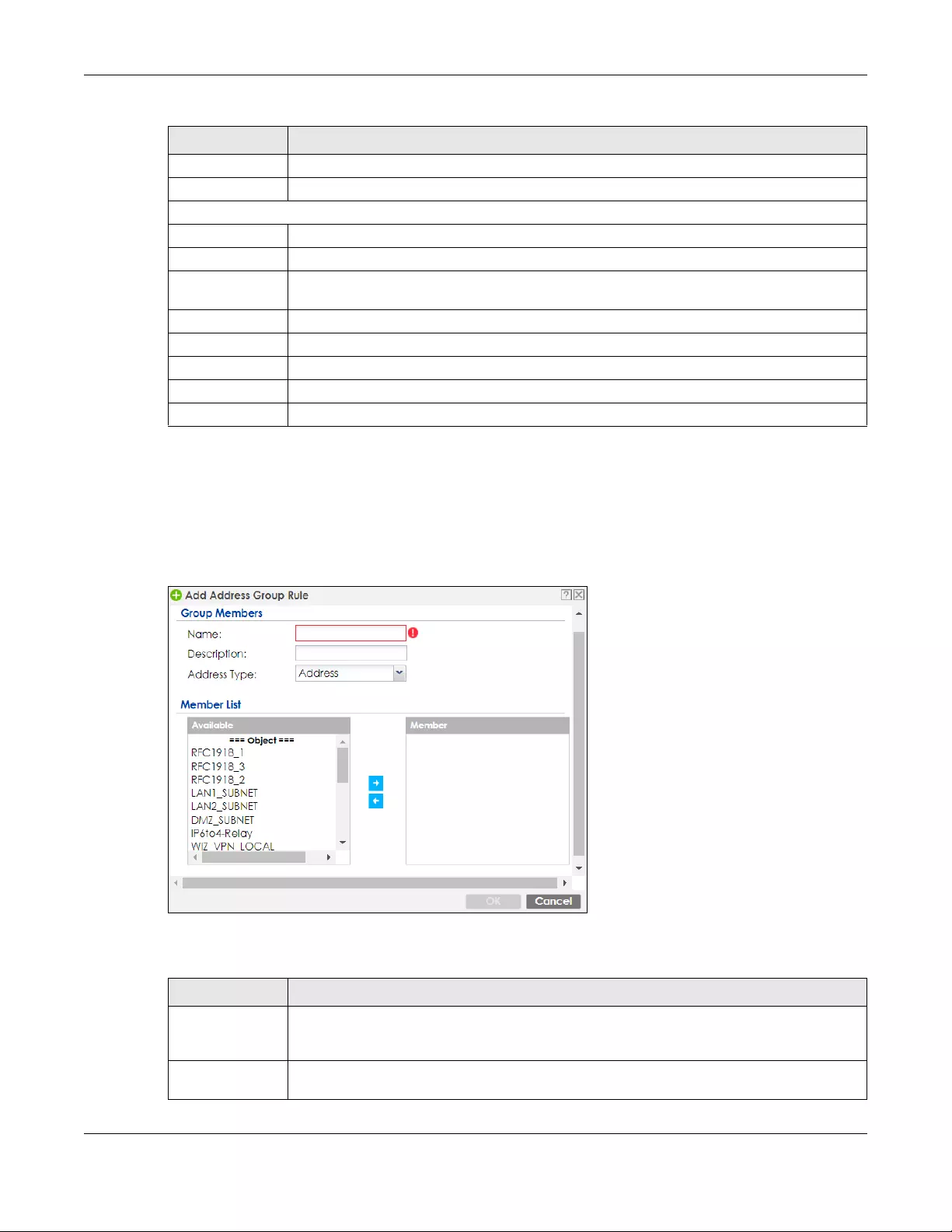
Chapter 39 Object
ZyWALL USG FLEX Series User’s Guide
770
39.6.3.1 Address Group Add/Edit Screen
The Address Group Add/Edit screen allows you to create a new address group or edit an existing one. To
access this screen, go to the Address Group screen (see Section 39.6.3 on page 769), and click either
the Add icon or an Edit icon in the IPv4 Address Group Configuration or IPv6 Address Group
Configuration section.
Figure 504 IPv4/IPv6 Address Group Configuration > Add
The following table describes the labels in this screen.
Description This field displays the description of each address group, if any.
Reference This displays the number of times an object reference is used in a profile.
IPv6 Address Group Configuration
Add Click this to create a new entry.
Edit Double-click an entry or select it and click Edit to be able to modify the entry’s settings.
Remove To remove an entry, select it and click Remove. The Zyxel Device confirms you want to remove
it before doing so.
References Select an entry and click References to open a screen that shows which settings use the entry.
#This field is a sequential value, and it is not associated with a specific address group.
Name This field displays the name of each address group.
Description This field displays the description of each address group, if any.
Reference This displays the number of times an object reference is used in a profile.
Table 325 Configuration > Object > Address/Geo IP > Address Group (continued)
LABEL DESCRIPTION
Table 326 IPv4/IPv6 Address Group Configuration > Add
LABEL DESCRIPTION
Name Enter a name for the address group. You may use 1-31 alphanumeric characters,
underscores(_), or dashes (-), but the first character cannot be a number. This value is case-
sensitive.
Description This field displays the description of each address group, if any. You can use up to 60
characters, punctuation marks, and spaces.

Chapter 39 Object
ZyWALL USG FLEX Series User’s Guide
771
39.6.4 Geo IP Summary Screen
Use this screen to update the database of country-to-IP and continent-to-IP address mappings and
manually configure custom country-to-IP and continent-to-IP address mappings in geographic address
objects. You can then use geographic address objects in security policies to forward or deny traffic to
whole countries or regions.
Click a column’s heading cell to sort the table entries by that column’s criteria. Click the heading cell
again to reverse the sort order.
Address Type Select the type of address you want to create.
Note: The Zyxel Device automatically updates address objects that are based on an
interface’s IP address, subnet, or gateway if the interface’s IP address settings
change. For example, if you change 1’s IP address, the Zyxel Device
automatically updates the corresponding interface-based, LAN subnet
address object.
Member List The Member list displays the names of the address and address group objects that have been
added to the address group. The order of members is not important.
Select items from the Available list that you want to be members and move them to the
Member list. You can double-click a single entry to move it or use the [Shift] or [Ctrl] key to
select multiple entries and use the arrow button to move them.
Move any members you do not want included to the Available list.
Note: Only objects of the same address type can be added to a address group.
OK Click OK to save your changes back to the Zyxel Device.
Cancel Click Cancel to exit this screen without saving your changes.
Table 326 IPv4/IPv6 Address Group Configuration > Add (continued)
LABEL DESCRIPTION
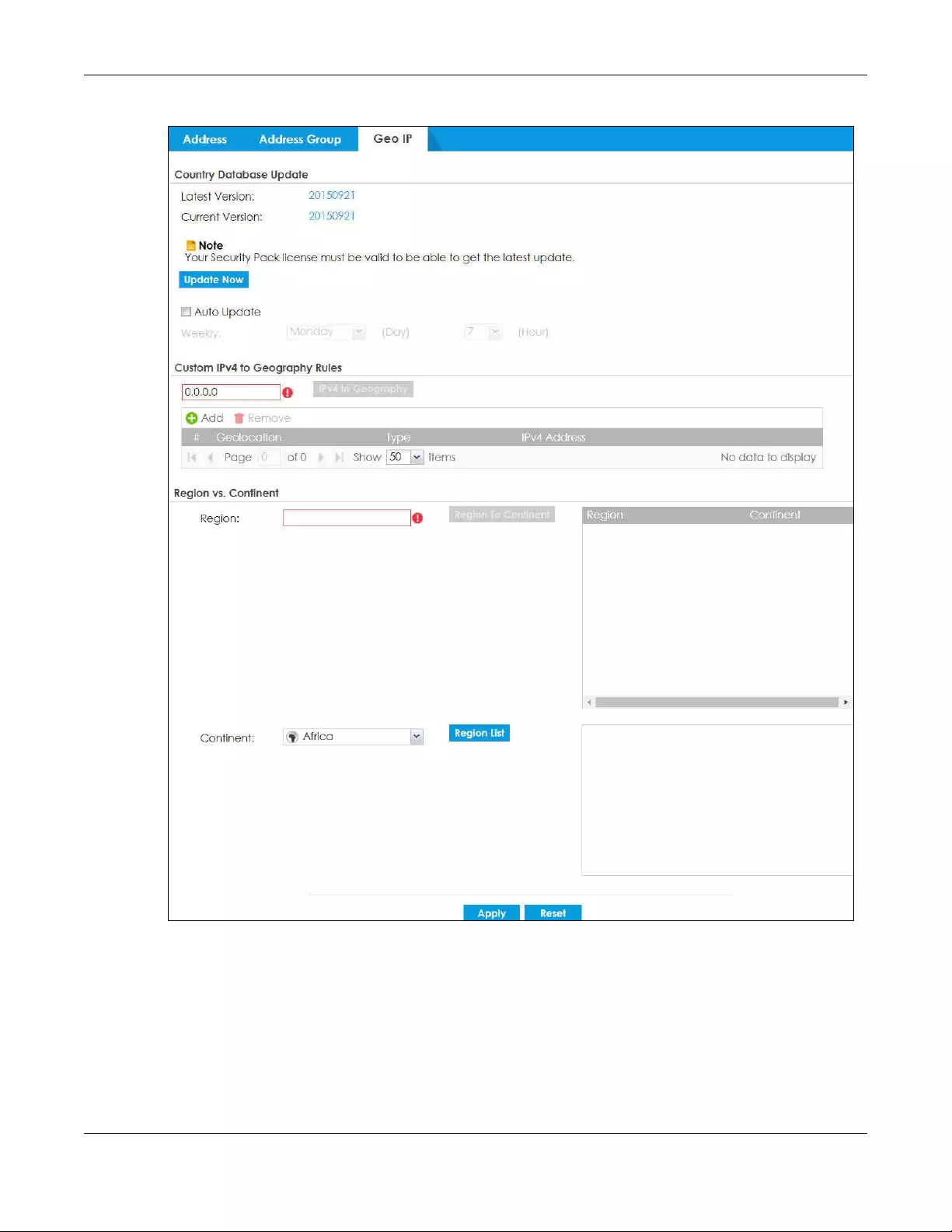
Chapter 39 Object
ZyWALL USG FLEX Series User’s Guide
772
Figure 505 Configuration > Object > Address/Geo IP > Geo IP

Chapter 39 Object
ZyWALL USG FLEX Series User’s Guide
773
The following table describes the labels in this screen.
39.6.4.1 Add Custom IPv4/IPv6 Address to Geography Screen
This screen allows you to create a new geography-to-IP address mapping. To access this screen, go to
the Geo IP screen (see Section 39.6.4 on page 771), and click the Add icon in the Custom IPv4 to
Geography Rules or Custom IPv6 to Geography Rules section.
Table 327 Configuration > Object > Address/Geo IP > Geo IP
LABEL DESCRIPTION
Country Database Update
Latest Version This is the latest country-to-IP address database version on myZyxel. You need to have a
registered Content Filter Service license.
Current Version This is the country-to-IP address database version currently on the Zyxel Device.
Update Now Click this to check for the latest country-to-IP address database version on myZyxel. The latest
version is downloaded to the Zyxel Device and replaces the current version if it is newer. There
are logs to show the update status. You need to have a registered Content Filter Service
license.
Auto Update If you want the Zyxel Device to check weekly for the latest country-to-IP address database
version on myZyxel, select the checkbox, choose a day and time each week and then click
Apply. The default day and time displayed is the Zyxel Device current day and time.
Custom IPv4/IPv6 to Geography Rules
IPv4/IPv6 to
Geography
Enter an IP address, then click this button to query which country this IP address belongs to.
Add Click this to create a new entry.
Remove To remove an entry, select it and click Remove. The Zyxel Device confirms you want to remove
it before doing so.
#This field is a sequential value, and it is not associated with a specific entry.
Geolocation This field displays the name of the country or region that is associated with this IP address.
Type This field displays whether this address object is HOST, RANGE or SUBNET.
IPv4/IPv6 Address This field displays the IPv4/IPv6 addresses represented by the type of address object.
Region vs. Continent
Region Enter a country name, then click the Region to Continent button to query which continent this
country belongs to.
Continent Select a continent, then click the Region List button to query which countries belong to the
continent.
Apply Click Apply to save the changes.
Reset Click Reset to return the screen to its last-saved settings.

Chapter 39 Object
ZyWALL USG FLEX Series User’s Guide
774
Figure 506 Geo IP > Add
The following table describes the labels in this screen.
39.7 Service Overview
Use service objects to define TCP applications, UDP applications, and ICMP messages. You can also
create service groups to refer to multiple service objects in other features.
• Use the Service screens (Section 39.7.2 on page 775) to view and configure the Zyxel Device’s list of
services and their definitions.
• Use the Service Group screens (Section 39.7.2 on page 775) to view and configure the Zyxel Device’s
list of service groups.
39.7.1 What You Need to Know
IP Protocols
IP protocols are based on the eight-bit protocol field in the IP header. This field represents the next-level
protocol that is sent in this packet. This section discusses three of the most common IP protocols.
Table 328 Geo IP > Add
LABEL DESCRIPTION
Region Select the country or continent that maps to this IP address.
Address Type Select the type of address you want to create. Choices are: HOST, RANGE, SUBNET.
IP Address This field is only available if the Address Type is HOST. This field cannot be blank. Enter the IP
address that this address object represents.
IP Starting
Address
This field is only available if the Address Type is RANGE. This field cannot be blank. Enter the
beginning of the range of IP addresses that this address object represents.
IP Ending Address This field is only available if the Address Type is RANGE. This field cannot be blank. Enter the end
of the range of IP address that this address object represents.
Network /
Netmask
These fields are only available if the IPv4 Address Type is SUBNET. They cannot be blank. Enter
the network IP and subnet mask that defines the IPv4 subnet.
IPv6 Address
Prefix
This field is only available if the IPv6 Address Type is SUBNET. This field cannot be blank. Enter the
IPv6 address prefix that the Zyxel Device uses for the LAN IPv6 address.
OK Click OK to save your changes back to the Zyxel Device.
Cancel Click Cancel to exit this screen without saving your changes.

Chapter 39 Object
ZyWALL USG FLEX Series User’s Guide
775
Computers use Transmission Control Protocol (TCP, IP protocol 6) and User Datagram Protocol (UDP, IP
protocol 17) to exchange data with each other. TCP guarantees reliable delivery but is slower and more
complex. Some uses are FTP, HTTP, SMTP, and TELNET. UDP is simpler and faster but is less reliable. Some
uses are DHCP, DNS, RIP, and SNMP.
TCP creates connections between computers to exchange data. Once the connection is established,
the computers exchange data. If data arrives out of sequence or is missing, TCP puts it in sequence or
waits for the data to be re-transmitted. Then, the connection is terminated.
In contrast, computers use UDP to send short messages to each other. There is no guarantee that the
messages arrive in sequence or that the messages arrive at all.
Both TCP and UDP use ports to identify the source and destination. Each port is a 16-bit number. Some
port numbers have been standardized and are used by low-level system processes; many others have
no particular meaning.
Unlike TCP and UDP, Internet Control Message Protocol (ICMP, IP protocol 1) is mainly used to send error
messages or to investigate problems. For example, ICMP is used to send the response if a computer
cannot be reached. Another use is ping. ICMP does not guarantee delivery, but networks often treat
ICMP messages differently, sometimes looking at the message itself to decide where to send it.
Service Objects and Service Groups
Use service objects to define IP protocols.
• TCP applications
• UDP applications
• ICMP messages
• user-defined services (for other types of IP protocols)
These objects are used in policy routes, security policies, and IDP profiles.
Use service groups when you want to create the same rule for several services, instead of creating
separate rules for each service. Service groups may consist of services and other service groups. The
sequence of members in the service group is not important.
39.7.2 The Service Summary Screen
The Service summary screen provides a summary of all services and their definitions. In addition, this
screen allows you to add, edit, and remove services.
To access this screen, log in to the Web Configurator, and click Configuration > Object > Service >
Service. Click a column’s heading cell to sort the table entries by that column’s criteria. Click the
heading cell again to reverse the sort order.

Chapter 39 Object
ZyWALL USG FLEX Series User’s Guide
776
Figure 507 Configuration > Object > Service > Service
The following table describes the labels in this screen.
39.7.2.1 The Service Add/Edit Screen
The Service Add/Edit screen allows you to create a new service or edit an existing one. To access this
screen, go to the Service screen (see Section 39.7.2 on page 775), and click either the Add icon or an
Edit icon.
Figure 508 Configuration > Object > Service > Service > Edit
Table 329 Configuration > Object > Service > Service
LABEL DESCRIPTION
Add Click this to create a new entry.
Edit Double-click an entry or select it and click Edit to be able to modify the entry’s settings.
Remove To remove an entry, select it and click Remove. The Zyxel Device confirms you want to remove
it before doing so.
References Select an entry and click References to open a screen that shows which settings use the entry.
#This field is a sequential value, and it is not associated with a specific service.
Name This field displays the name of each service.
Content This field displays a description of each service.
Reference This displays the number of times an object reference is used in a profile.

Chapter 39 Object
ZyWALL USG FLEX Series User’s Guide
777
The following table describes the labels in this screen.
39.7.3 The Service Group Summary Screen
The Service Group summary screen provides a summary of all service groups. In addition, this screen
allows you to add, edit, and remove service groups.
Note: If you want to access the Zyxel Device using HTTP, HTTPS, SSH, and/or, TELNET, you must
add them in the Object > Service > Service Group > Default_Allow_WAN_To_ZyWALL
service group, which is used in the WAN_to_Device security policy.
To access this screen, log in to the Web Configurator, and click Configuration > Object > Service >
Service Group.
Figure 509 Configuration > Object > Service > Service Group
Table 330 Configuration > Object > Service > Service > Edit
LABEL DESCRIPTION
Name Type the name used to refer to the service. You may use 1-31 alphanumeric characters,
underscores(_), or dashes (-), but the first character cannot be a number. This value is case-
sensitive.
IP Protocol Select the protocol the service uses. Choices are: TCP, UDP, ICMP, ICMPv6, and User Defined.
Starting Port
Ending Port
This field appears if the IP Protocol is TCP or UDP. Specify the port number(s) used by this service.
If you fill in one of these fields, the service uses that port. If you fill in both fields, the service uses
the range of ports.
ICMP Type This field appears if the IP Protocol is ICMP or ICMPv6.
Select the ICMP message used by this service. This field displays the message text, not the
message number.
IP Protocol
Number
This field appears if the IP Protocol is User Defined.
Enter the number of the next-level protocol (IP protocol). Allowed values are 1 - 255.
OK Click OK to save your changes back to the Zyxel Device.
Cancel Click Cancel to exit this screen without saving your changes.

Chapter 39 Object
ZyWALL USG FLEX Series User’s Guide
778
The following table describes the labels in this screen. See Section 39.7.3.1 on page 778 for more
information as well.
39.7.3.1 The Service Group Add/Edit Screen
The Service Group Add/Edit screen allows you to create a new service group or edit an existing one. To
access this screen, go to the Service Group screen (see Section 39.7.3 on page 777), and click either the
Add icon or an Edit icon.
Figure 510 Configuration > Object > Service > Service Group > Edit
Table 331 Configuration > Object > Service > Service Group
LABEL DESCRIPTION
Add Click this to create a new entry.
Edit Double-click an entry or select it and click Edit to be able to modify the entry’s settings.
Remove To remove an entry, select it and click Remove. The Zyxel Device confirms you want to remove
it before doing so.
References Select an entry and click References to open a screen that shows which settings use the entry.
#This field is a sequential value, and it is not associated with a specific service group.
Family This field displays the Server Group supported type, which is according to your configurations in
the Service Group Add/Edit screen.
There are 3 types of families:
•: Supports IPv4 only
•: Supports IPv6 only
•: Supports both IPv4 and IPv6
Name This field displays the name of each service group.
By default, the Zyxel Device uses services starting with “Default_Allow_” in the security policies
to allow certain services to connect to the Zyxel Device.
Description This field displays the description of each service group, if any.
Reference This displays the number of times an object reference is used in a profile.

Chapter 39 Object
ZyWALL USG FLEX Series User’s Guide
779
The following table describes the labels in this screen.
39.8 Schedule Overview
Use schedules to set up one-time and recurring schedules for policy routes, security policies, application
patrol, and content filtering. The Zyxel Device supports one-time and recurring schedules. One-time
schedules are effective only once, while recurring schedules usually repeat. Both types of schedules are
based on the current date and time in the Zyxel Device.
Note: Schedules are based on the Zyxel Device’s current date and time.
• Use the Schedule summary screen (Section 39.8.2 on page 780) to see a list of all schedules in the
Zyxel Device.
• Use the One-Time Schedule Add/Edit screen (Section 39.8.2.1 on page 781) to create or edit a one-
time schedule.
• Use the Recurring Schedule Add/Edit screen (Section 39.8.2.2 on page 782) to create or edit a
recurring schedule.
• Use the Schedule Group screen (Section 39.8.3 on page 783) to merge individual schedule objects as
one object.
39.8.1 What You Need to Know
One-time Schedules
One-time schedules begin on a specific start date and time and end on a specific stop date and time.
One-time schedules are useful for long holidays and vacation periods.
Recurring Schedules
Recurring schedules begin at a specific start time and end at a specific stop time on selected days of
the week (Sunday, Monday, Tuesday, Wednesday, Thursday, Friday, and Saturday). Recurring schedules
always begin and end in the same day. Recurring schedules are useful for defining the workday and off-
work hours.
Table 332 Configuration > Object > Service > Service Group > Edit
LABEL DESCRIPTION
Name Enter the name of the service group. You may use 1-31 alphanumeric characters,
underscores(_), or dashes (-), but the first character cannot be a number. This value is case-
sensitive.
Description Enter a description of the service group, if any. You can use up to 60 printable ASCII characters.
Configuration The Member list displays the names of the service and service group objects that have been
added to the service group. The order of members is not important.
Select items from the Available list that you want to be members and move them to the
Member list. You can double-click a single entry to move it or use the [Shift] or [Ctrl] key to
select multiple entries and use the arrow button to move them.
Move any members you do not want included to the Available list.
OK Click OK to save your changes back to the Zyxel Device.
Cancel Click Cancel to exit this screen without saving your changes.
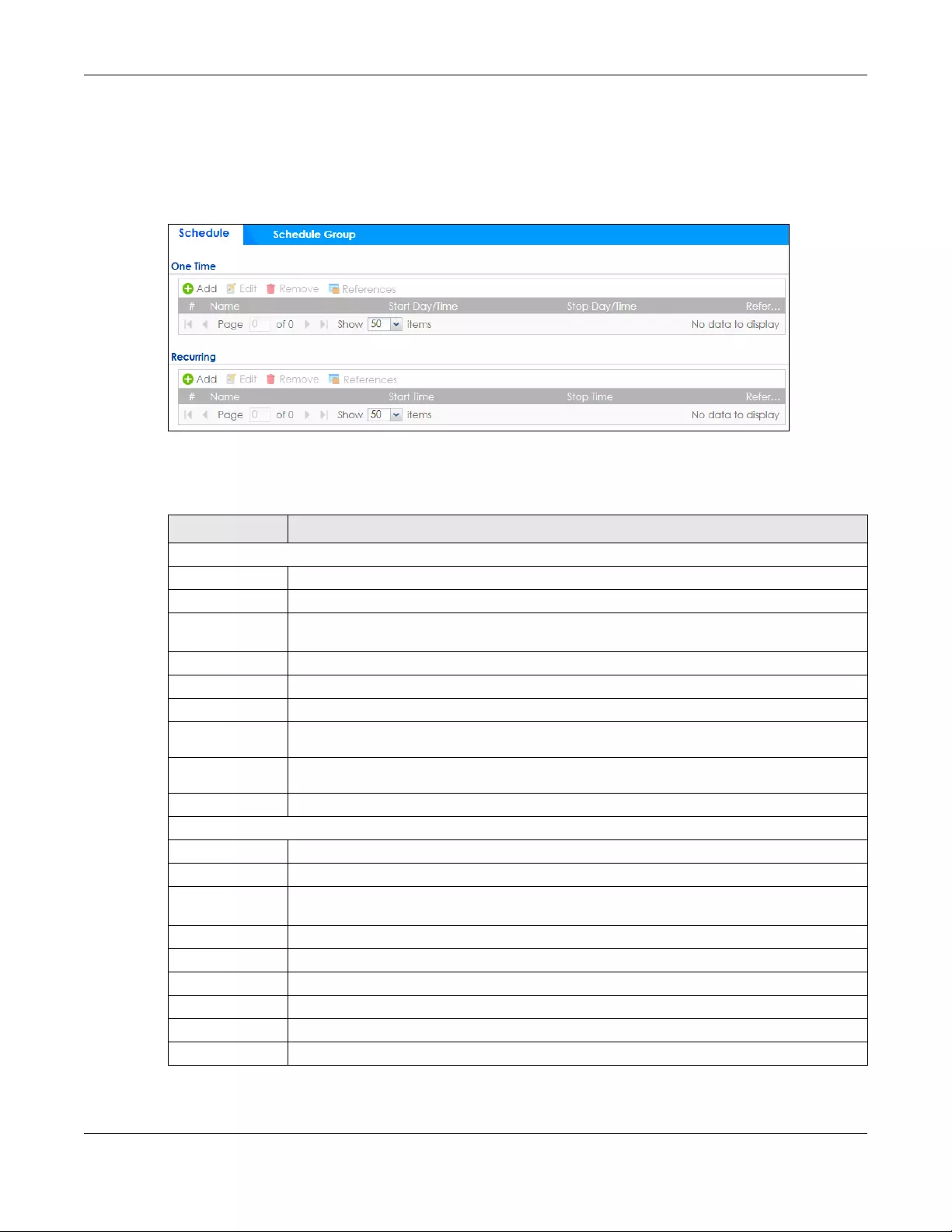
Chapter 39 Object
ZyWALL USG FLEX Series User’s Guide
780
39.8.2 The Schedule Screen
The Schedule screen provides a summary of all schedules in the Zyxel Device. To access this screen, click
Configuration > Object > Schedule.
Figure 511 Configuration > Object > Schedule
The following table describes the labels in this screen. See Section 39.8.2.1 on page 781 and Section
39.8.2.2 on page 782 for more information as well.
Table 333 Configuration > Object > Schedule
LABEL DESCRIPTION
One Time
Add Click this to create a new entry.
Edit Double-click an entry or select it and click Edit to be able to modify the entry’s settings.
Remove To remove an entry, select it and click Remove. The Zyxel Device confirms you want to remove
it before doing so.
References Select an entry and click References to open a screen that shows which settings use the entry.
#This field is a sequential value, and it is not associated with a specific schedule.
Name This field displays the name of the schedule, which is used to refer to the schedule.
Start Day /
Time This field displays the date and time at which the schedule begins.
Stop Day /
Time This field displays the date and time at which the schedule ends.
Reference This displays the number of times an object reference is used in a profile.
Recurring
Add Click this to create a new entry.
Edit Double-click an entry or select it and click Edit to be able to modify the entry’s settings.
Remove To remove an entry, select it and click Remove. The Zyxel Device confirms you want to remove
it before doing so.
References Select an entry and click References to open a screen that shows which settings use the entry.
#This field is a sequential value, and it is not associated with a specific schedule.
Name This field displays the name of the schedule, which is used to refer to the schedule.
Start Time This field displays the time at which the schedule begins.
Stop Time This field displays the time at which the schedule ends.
Reference This displays the number of times an object reference is used in a profile.
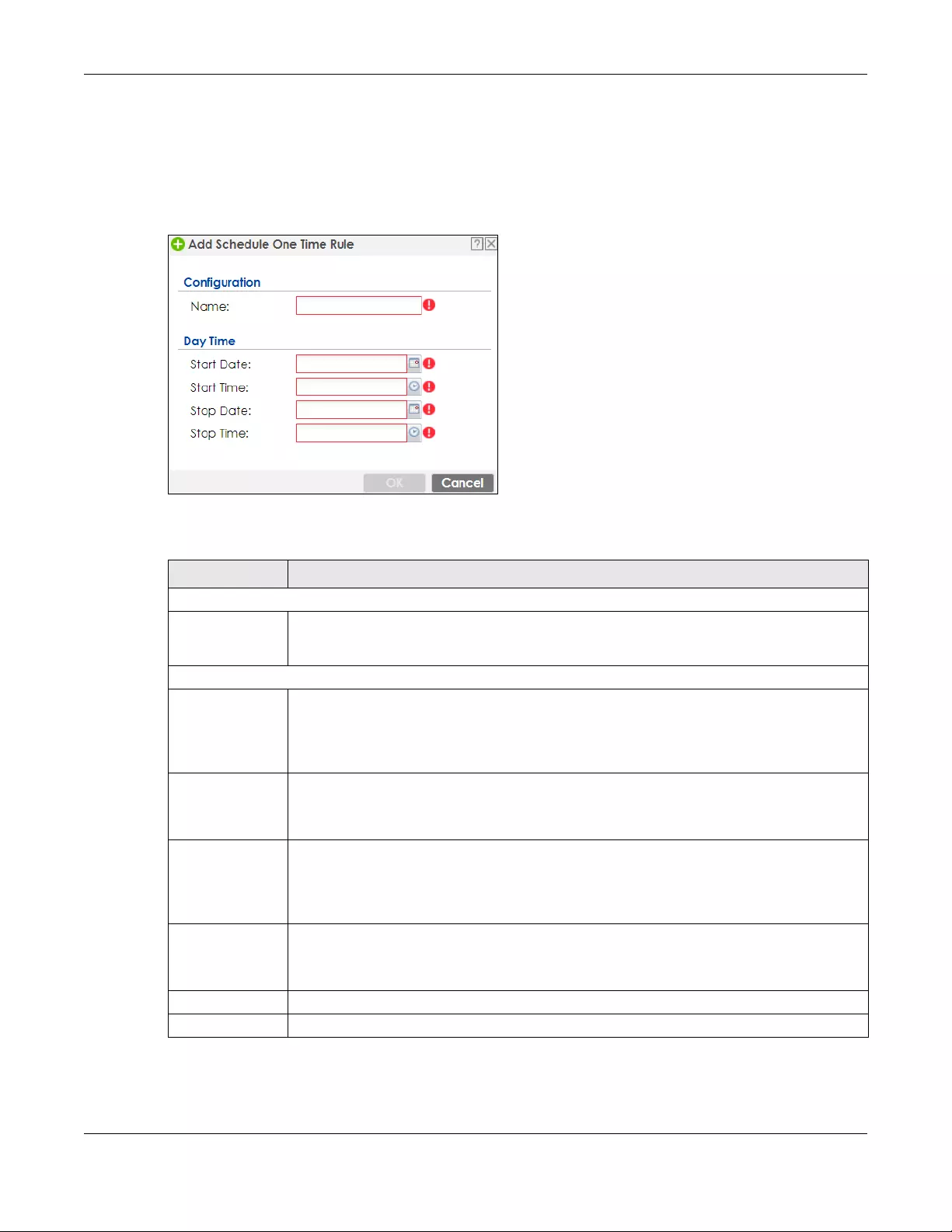
Chapter 39 Object
ZyWALL USG FLEX Series User’s Guide
781
39.8.2.1 The One-Time Schedule Add/Edit Screen
The One-Time Schedule Add/Edit screen allows you to define a one-time schedule or edit an existing
one. To access this screen, go to the Schedule screen (see Section 39.8.2 on page 780), and click either
the Add icon or an Edit icon in the One Time section.
Figure 512 Configuration > Object > Schedule > Edit (One Time)
The following table describes the labels in this screen.
Table 334 Configuration > Object > Schedule > Edit (One Time)
LABEL DESCRIPTION
Configuration
Name Type the name used to refer to the one-time schedule. You may use 1-31 alphanumeric
characters, underscores(_), or dashes (-), but the first character cannot be a number. This
value is case-sensitive.
Day Time
StartDate Specify the year, month, and day when the schedule begins.
•Year - 1900 - 2999
•Month - 1 - 12
•Day - 1 - 31 (it is not possible to specify illegal dates, such as February 31.)
StartTime Specify the hour and minute when the schedule begins.
•Hour - 0 - 23
•Minute - 0 - 59
StopDate Specify the year, month, and day when the schedule ends.
•Year - 1900 - 2999
•Month - 1 - 12
•Day - 1 - 31 (it is not possible to specify illegal dates, such as February 31.)
StopTime Specify the hour and minute when the schedule ends.
•Hour - 0 - 23
•Minute - 0 - 59
OK Click OK to save your changes back to the Zyxel Device.
Cancel Click Cancel to exit this screen without saving your changes.
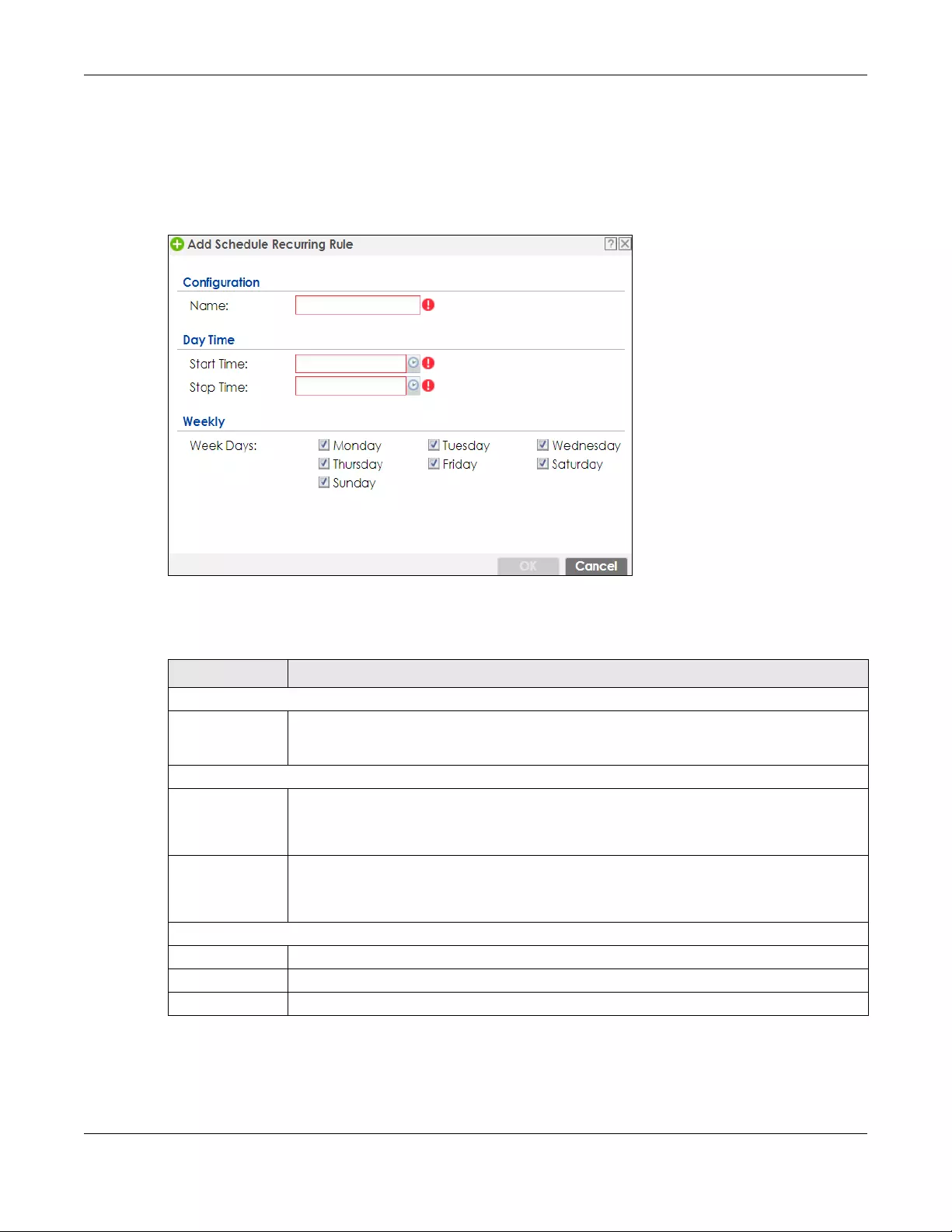
Chapter 39 Object
ZyWALL USG FLEX Series User’s Guide
782
39.8.2.2 The Recurring Schedule Add/Edit Screen
The Recurring Schedule Add/Edit screen allows you to define a recurring schedule or edit an existing
one. To access this screen, go to the Schedule screen (see Section 39.8.2 on page 780), and click either
the Add icon or an Edit icon in the Recurring section.
Figure 513 Configuration > Object > Schedule > Edit (Recurring)
The Year, Month, and Day columns are not used in recurring schedules and are disabled in this screen.
The following table describes the remaining labels in this screen.
Table 335 Configuration > Object > Schedule > Edit (Recurring)
LABEL DESCRIPTION
Configuration
Name Type the name used to refer to the recurring schedule. You may use 1-31 alphanumeric
characters, underscores(_), or dashes (-), but the first character cannot be a number. This
value is case-sensitive.
Date Time
StartTime Specify the hour and minute when the schedule begins each day.
•Hour - 0 - 23
•Minute - 0 - 59
StopTime Specify the hour and minute when the schedule ends each day.
•Hour - 0 - 23
•Minute - 0 - 59
Weekly
Week Days Select each day of the week the recurring schedule is effective.
OK Click OK to save your changes back to the Zyxel Device.
Cancel Click Cancel to exit this screen without saving your changes.
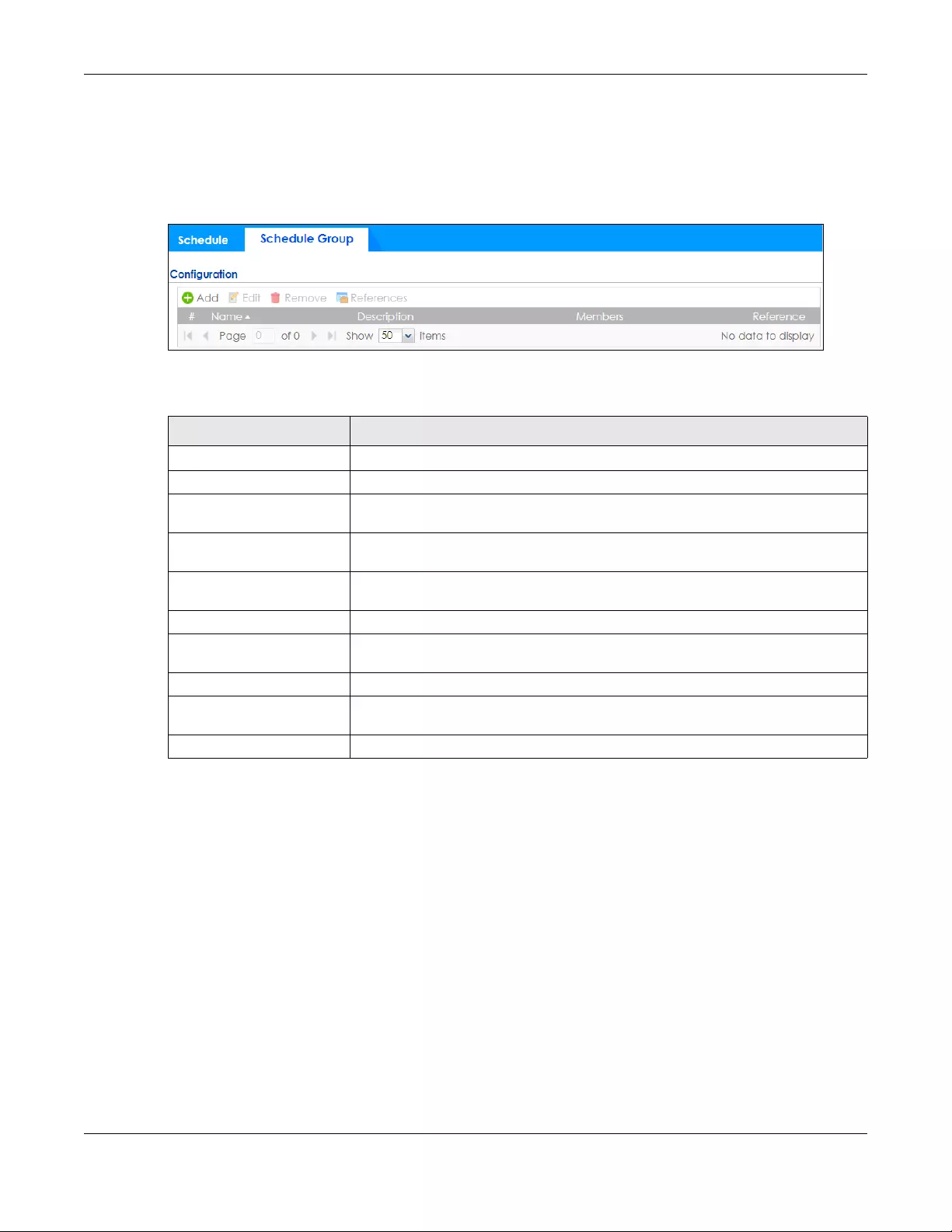
Chapter 39 Object
ZyWALL USG FLEX Series User’s Guide
783
39.8.3 The Schedule Group Screen
The Schedule Group screen provides a summary of all groups of schedules in the Zyxel Device. To
access this screen, click Configuration > Object > Schedule >Group.
Figure 514 Configuration > Object > Schedule > Schedule Group
The following table describes the fields in the above screen.
39.8.3.1 The Schedule Group Add/Edit Screen
The Schedule Group Add/Edit screen allows you to define a schedule group or edit an existing one. To
access this screen, go to the Schedule screen (see), and click either the Add icon or an Edit icon in the
Schedule Group section.
Table 336 Configuration > Object > Schedule > Schedule Group
LABEL DESCRIPTION
Configuration
Add Click this to create a new entry.
Edit Double-click an entry or select it and click Edit to be able to modify the entry’s
settings.
Remove To remove an entry, select it and click Remove. The Zyxel Device confirms you want
to remove it before doing so.
References Select an entry and click References to open a screen that shows which settings use
the entry.
#This field is a sequential value, and it is not associated with a specific schedule.
Name This field displays the name of the schedule group, which is used to refer to the
schedule.
Description This field displays the description of the schedule group.
Members This field lists the members in the schedule group. Each member is separated by a
comma.
Reference This displays the number of times an object reference is used in a profile.
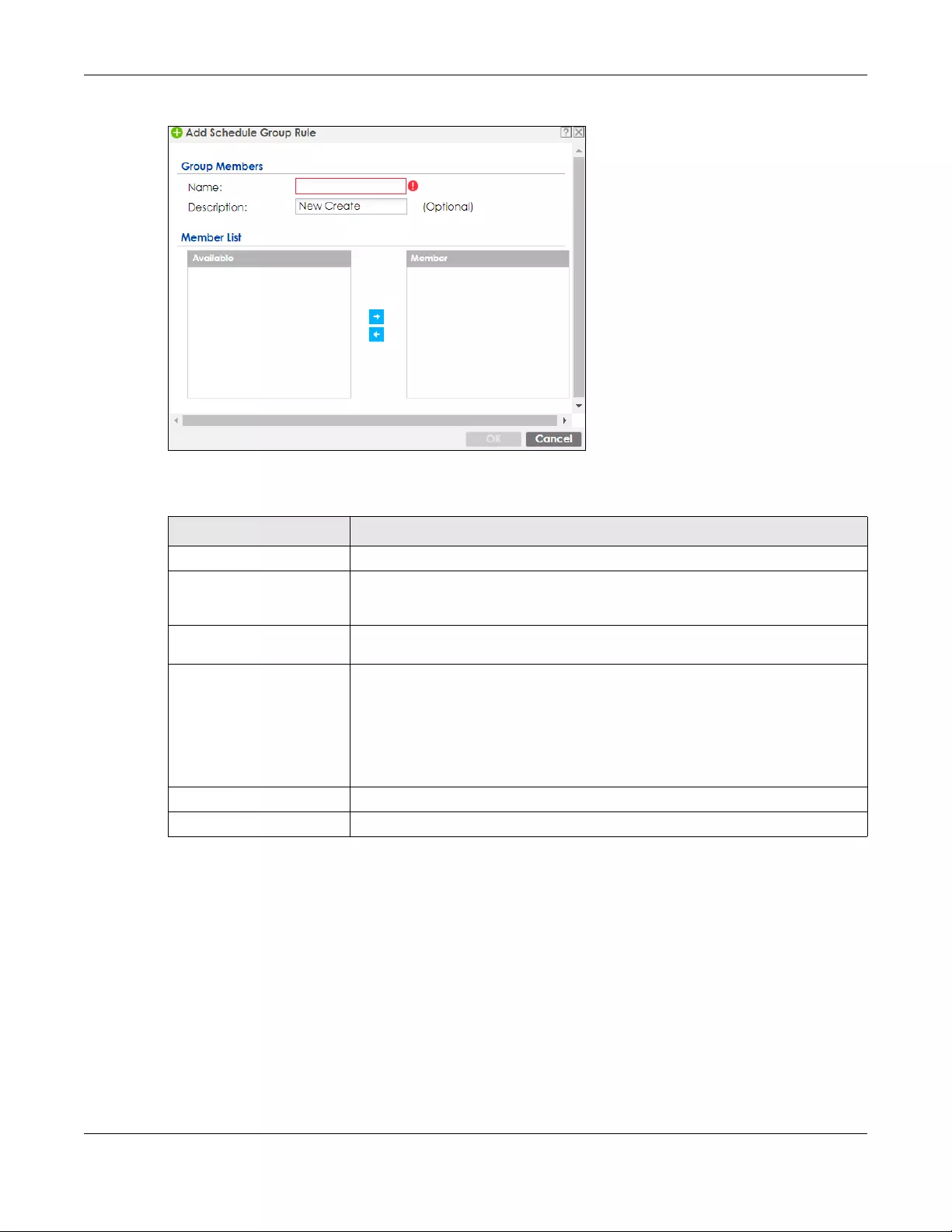
Chapter 39 Object
ZyWALL USG FLEX Series User’s Guide
784
Figure 515 Configuration > Schedule > Schedule Group > Add
The following table describes the fields in the above screen.
39.9 AAA Server Overview
You can use a AAA (Authentication, Authorization, Accounting) server to provide access control to your
network. The AAA server can be a Active Directory, LDAP, or RADIUS server. Use the AAA Server screens
to create and manage objects that contain settings for using AAA servers. You use AAA server objects in
configuring ext-group-user user objects and authentication method objects (see Chapter 39 on page
794).
Table 337 Configuration > Schedule > Schedule Group > Add
LABEL DESCRIPTION
Group Members
Name Type the name used to refer to the recurring schedule. You may use 1-31
alphanumeric characters, underscores(_), or dashes (-), but the first character
cannot be a number. This value is case-sensitive.
Description Enter a description of the service group, if any. You can use up to 60 printable ASCII
characters.
Member List The Member list displays the names of the service and service group objects that
have been added to the service group. The order of members is not important.
Select items from the Available list that you want to be members and move them to
the Member list. You can double-click a single entry to move it or use the [Shift] or
[Ctrl] key to select multiple entries and use the arrow button to move them.
Move any members you do not want included to the Available list.
OK Click OK to save your changes back to the Zyxel Device.
Cancel Click Cancel to exit this screen without saving your changes.

Chapter 39 Object
ZyWALL USG FLEX Series User’s Guide
785
39.9.1 Directory Service (AD/LDAP)
LDAP/AD allows a client (the Zyxel Device) to connect to a server to retrieve information from a
directory. A network example is shown next.
Figure 516 Example: Directory Service Client and Server
The following describes the user authentication procedure via an LDAP/AD server.
1A user logs in with a user name and password pair.
2The Zyxel Device tries to bind (or log in) to the LDAP/AD server.
3When the binding process is successful, the Zyxel Device checks the user information in the directory
against the user name and password pair.
4If it matches, the user is allowed access. Otherwise, access is blocked.
39.9.2 RADIUS Server
RADIUS (Remote Authentication Dial-In User Service) authentication is a popular protocol used to
authenticate users by means of an external server instead of (or in addition to) an internal device user
database that is limited to the memory capacity of the device. In essence, RADIUS authentication
allows you to validate a large number of users from a central location.
Figure 517 RADIUS Server Network Example
39.9.3 ASAS
ASAS (Authenex Strong Authentication System) is a RADIUS server that works with the One-Time Password
(OTP) feature. Purchase a Zyxel Device OTP package in order to use this feature. The package contains
server software and physical OTP tokens (PIN generators). Do the following to use OTP. See the
documentation included on the ASAS’ CD for details.

Chapter 39 Object
ZyWALL USG FLEX Series User’s Guide
786
1Install the ASAS server software on a computer.
2Create user accounts on the Zyxel Device and in the ASAS server.
3Import each token’s database file (located on the included CD) into the server.
4Assign users to OTP tokens (on the ASAS server).
5Configure the ASAS as a RADIUS server in the Zyxel Device’s Configuration > Object > AAA Server
screens.
6Give the OTP tokens to (local or remote) users.
• Use the Configuration > Object > AAA Server > Active Directory (or LDAP) screens (Section 39.9.5 on
page 787) to configure Active Directory or LDAP server objects.
• Use the Configuration > Object > AAA Server > RADIUS screen (Section 39.9.2 on page 785) to
configure the default external RADIUS server to use for user authentication.
39.9.4 What You Need To Know
AAA Servers Supported by the Zyxel Device
The following lists the types of authentication server the Zyxel Device supports.
•Local user database
The Zyxel Device uses the built-in local user database to authenticate administrative users logging into
the Zyxel Device’s Web Configurator or network access users logging into the network through the
Zyxel Device. You can also use the local user database to authenticate VPN users.
• Directory Service (LDAP/AD)
LDAP (Lightweight Directory Access Protocol)/AD (Active Directory) is a directory service that is both
a directory and a protocol for controlling access to a network. The directory consists of a database
specialized for fast information retrieval and filtering activities. You create and store user profile and
login information on the external server.
•RADIUS
RADIUS (Remote Authentication Dial-In User Service) authentication is a popular protocol used to
authenticate users by means of an external or built-in RADIUS server. RADIUS authentication allows
you to validate a large number of users from a central location.
Directory Structure
The directory entries are arranged in a hierarchical order much like a tree structure. Normally, the
directory structure reflects the geographical or organizational boundaries. The following figure shows a
basic directory structure branching from countries to organizations to organizational units to individuals.

Chapter 39 Object
ZyWALL USG FLEX Series User’s Guide
787
Figure 518 Basic Directory Structure
Distinguished Name (DN)
A DN uniquely identifies an entry in a directory. A DN consists of attribute-value pairs separated by
commas. The leftmost attribute is the Relative Distinguished Name (RDN). This provides a unique name
for entries that have the same “parent DN” (“cn=domain1.com, ou=Sales, o=MyCompany” in the
following examples).
cn=domain1.com, ou = Sales, o=MyCompany, c=US
cn=domain1.com, ou = Sales, o=MyCompany, c=JP
Base DN
A base DN specifies a directory. A base DN usually contains information such as the name of an
organization, a domain name and/or country. For example, o=MyCompany, c=UK where o means
organization and c means country.
Bind DN
A bind DN is used to authenticate with an LDAP/AD server. For example a bind DN of cn=zywallAdmin
allows the Zyxel Device to log into the LDAP/AD server using the user name of zywallAdmin. The bind
DN is used in conjunction with a bind password. When a bind DN is not specified, the Zyxel Device will try
to log in as an anonymous user. If the bind password is incorrect, the login will fail.
39.9.5 Active Directory or LDAP Server Summary
Use the Active Directory or LDAP screen to manage the list of AD or LDAP servers the Zyxel Device can
use in authenticating users.
Click Configuration > Object > AAA Server > Active Directory (or LDAP) to display the Active Directory (or
LDAP) screen.
Root
US
Japan
Sprint
UPS
NEC
Sales
RD3
QA
CSO
Sales
RD
Countries (c) Organizations (o) Organization Units (ou) Unique
Common Name
(cn)
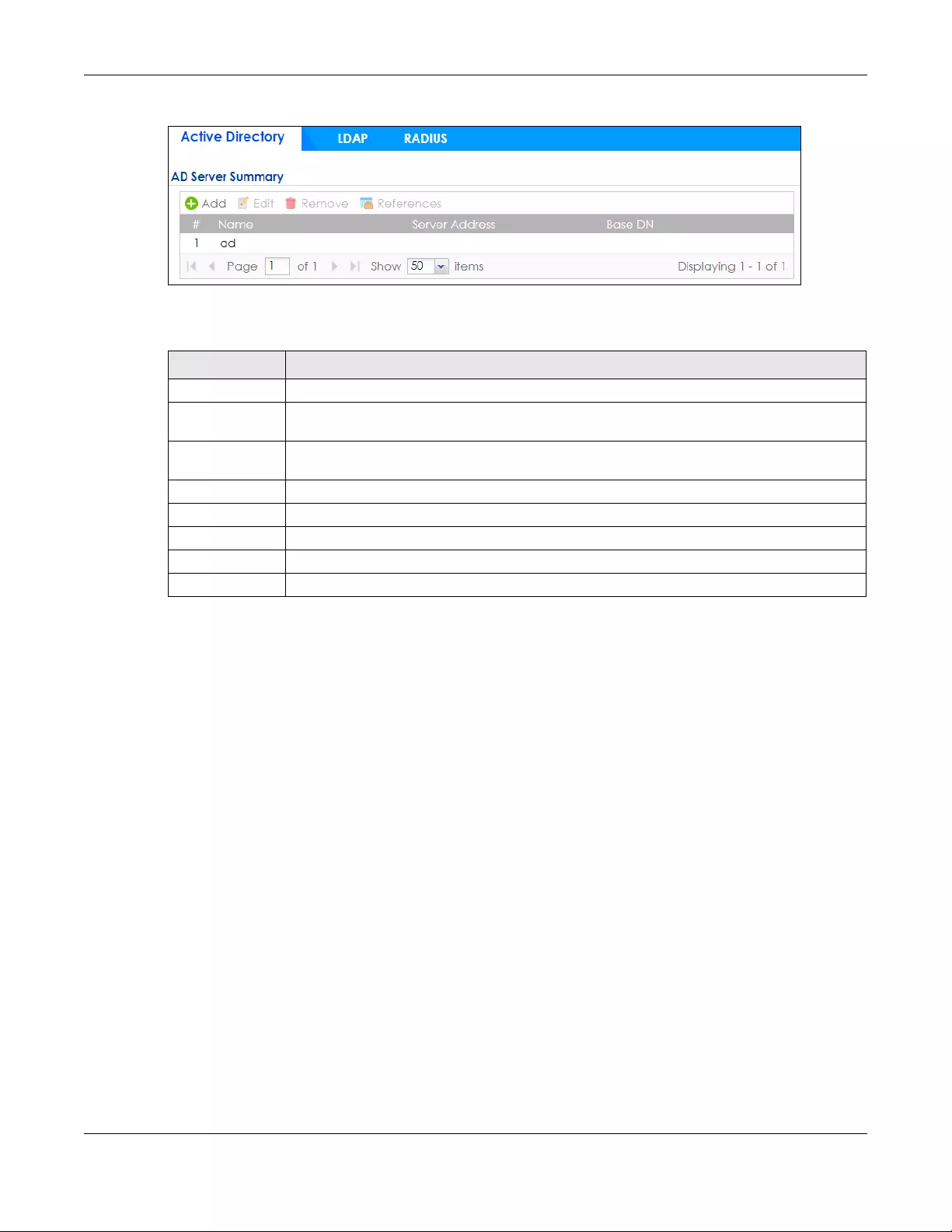
Chapter 39 Object
ZyWALL USG FLEX Series User’s Guide
788
Figure 519 Configuration > Object > AAA Server > Active Directory (or LDAP)
The following table describes the labels in this screen.
39.9.5.1 Adding an Active Directory or LDAP Server
Click Object > AAA Server > Active Directory (or LDAP) to display the Active Directory (or LDAP) screen.
Click the Add icon or an Edit icon to display the following screen. Use this screen to create a new AD or
LDAP entry or edit an existing one.
Table 338 Configuration > Object > AAA Server > Active Directory (or LDAP)
LABEL DESCRIPTION
Add Click this to create a new entry.
Edit Double-click an entry or select it and click Edit to open a screen where you can modify the
entry’s settings.
Remove To remove an entry, select it and click Remove. The Zyxel Device confirms you want to remove
it before doing so.
References Select an entry and click References to open a screen that shows which settings use the entry.
#This field is a sequential value, and it is not associated with a specific AD or LDAP server.
Name This field displays the name of the Active Directory.
Server Address This is the address of the AD or LDAP server.
Base DN This specifies a directory. For example, o=Zyxel, c=US.
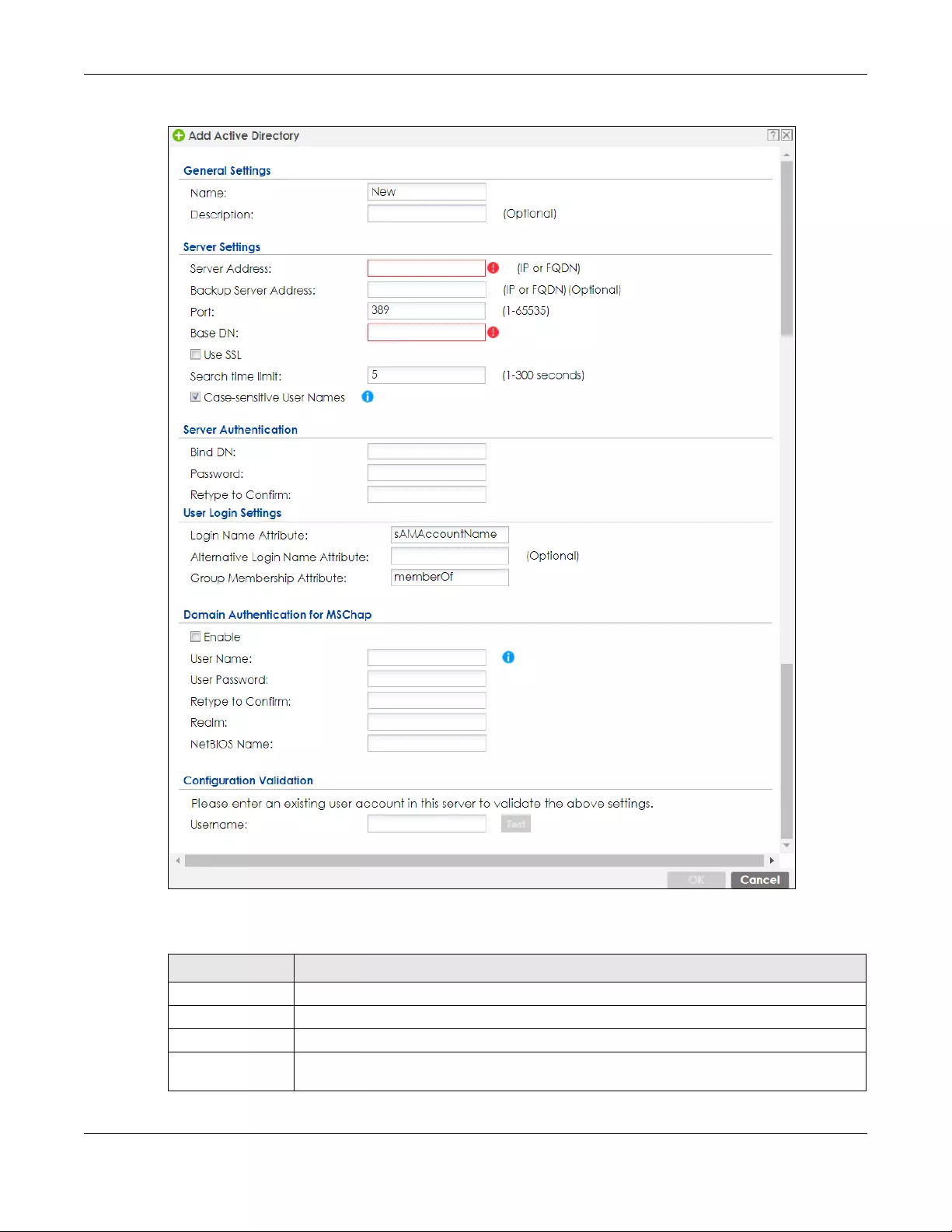
Chapter 39 Object
ZyWALL USG FLEX Series User’s Guide
789
Figure 520 Configuration > Object > AAA Server > Active Directory (or LDAP) > Add
The following table describes the labels in this screen.
Table 339 Configuration > Object > AAA Server > Active Directory (or LDAP) > Add
LABEL DESCRIPTION
Name Enter a descriptive name (up to 63 alphanumerical characters) for identification purposes.
Description Enter the description of each server, if any. You can use up to 60 printable ASCII characters.
Server Address Enter the address of the AD or LDAP server.
Backup Server
Address
If the AD or LDAP server has a backup server, enter its address here.

Chapter 39 Object
ZyWALL USG FLEX Series User’s Guide
790
Port Specify the port number on the AD or LDAP server to which the Zyxel Device sends
authentication requests. Enter a number between 1 and 65535.
This port number should be the same on all AD or LDAP server(s) in this group.
Base DN Specify the directory (up to 127 alphanumerical characters). For example, o=Zyxel,
c=US.
This is only for LDAP.
Use SSL Select Use SSL to establish a secure connection to the AD or LDAP server(s).
Search time limit Specify the timeout period (between 1 and 300 seconds) before the Zyxel Device
disconnects from the AD or LDAP server. In this case, user authentication fails.
Search timeout occurs when either the user information is not in the AD or LDAP server(s) or
the AD or LDAP server(s) is down.
Case-sensitive User
Names
Select this if the server checks the case of the usernames.
Bind DN Specify the bind DN for logging into the AD or LDAP server. Enter up to 127 alphanumerical
characters.
For example, cn=zywallAdmin specifies zywallAdmin as the user name.
Password If required, enter the password (up to 15 alphanumerical characters) for the Zyxel Device to
bind (or log in) to the AD or LDAP server.
Retype to Confirm Retype your new password for confirmation.
Login Name
Attribute
Enter the type of identifier the users are to use to log in. For example “name” or “email
address”.
Alternative Login
Name Attribute
If there is a second type of identifier that the users can use to log in, enter it here. For example
“name” or “email address”.
Group
Membership
Attribute
An AD or LDAP server defines attributes for its accounts. Enter the name of the attribute that
the Zyxel Device is to check to determine to which group a user belongs. The value for this
attribute is called a group identifier; it determines to which group a user belongs. You can
add ext-group-user user objects to identify groups based on these group identifier values.
For example you could have an attribute named “memberOf” with values like “sales”, “RD”,
and “management”. Then you could also create a ext-group-user user object for each
group. One with “sales” as the group identifier, another for “RD” and a third for
“management”.
Domain
Authentication for
MSChap
Select the Enable checkbox to enable domain authentication for MSChap.
This is only for Active Directory.
User Name Enter the user name for the user who has rights to add a machine to the domain.
This is only for Active Directory.
User Password Enter the password for the associated user name.
This is only for Active Directory.
Retype to Confirm Retype your new password for confirmation.
This is only for Active Directory.
Realm Enter the realm FQDN.
This is only for Active Directory.
NetBIOS Name Type the NetBIOS name. This field is optional. NetBIOS packets are TCP or UDP packets that
enable a computer to connect to and communicate with a LAN which allows local
computers to find computers on the remote network and vice versa.
Table 339 Configuration > Object > AAA Server > Active Directory (or LDAP) > Add (continued)
LABEL DESCRIPTION
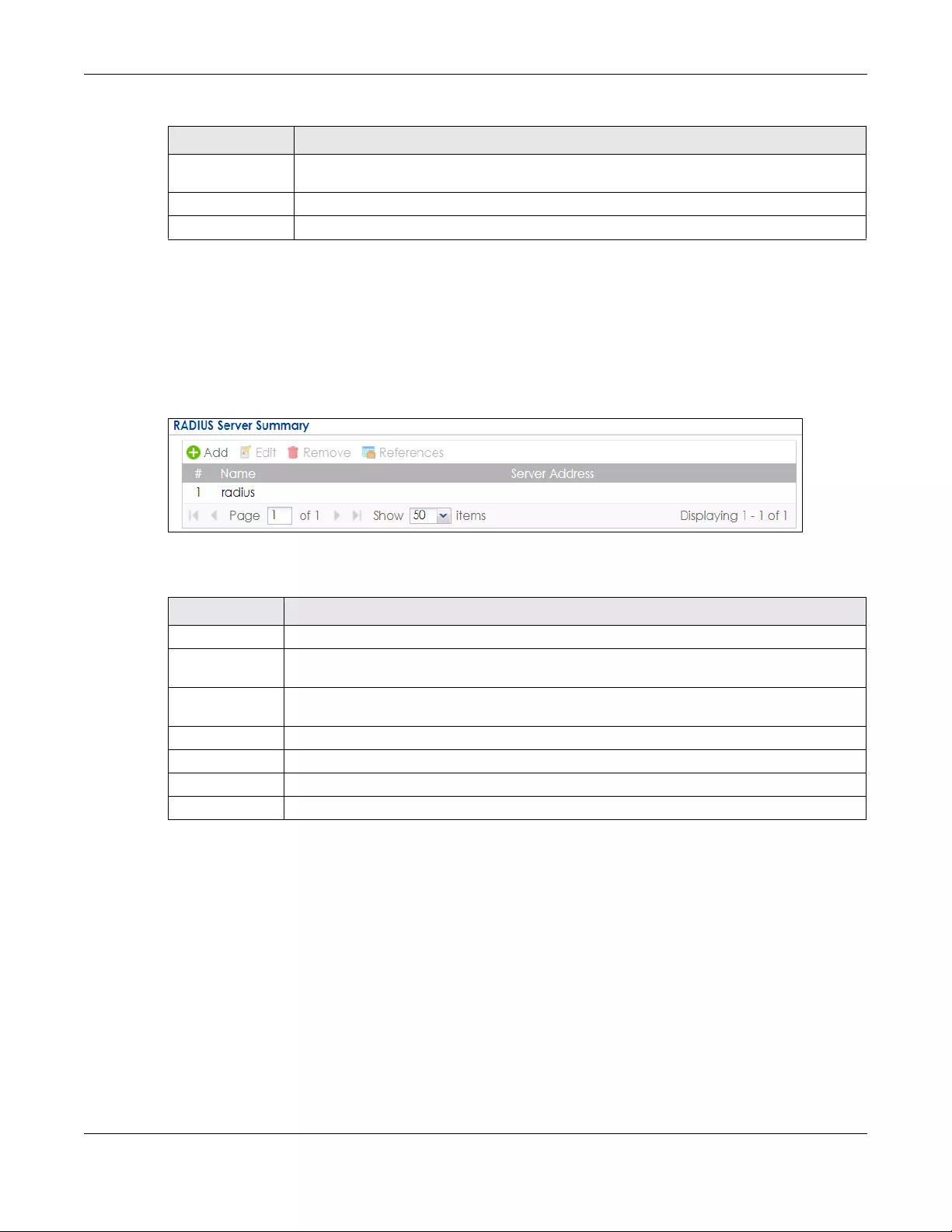
Chapter 39 Object
ZyWALL USG FLEX Series User’s Guide
791
39.9.6 RADIUS Server Summary
Use the RADIUS screen to manage the list of RADIUS servers the Zyxel Device can use in authenticating
users.
Click Configuration > Object > AAA Server > RADIUS to display the RADIUS screen.
Figure 521 Configuration > Object > AAA Server > RADIUS
The following table describes the labels in this screen.
39.9.6.1 Adding a RADIUS Server
Click Configuration > Object > AAA Server > RADIUS to display the RADIUS screen. Click the Add icon or
an Edit icon to display the following screen. Use this screen to create a new AD or LDAP entry or edit an
existing one.
Configuration
Validation
Use a user account from the server specified above to test if the configuration is correct. Enter
the account’s user name in the Username field and click Test.
OK Click OK to save the changes.
Cancel Click Cancel to discard the changes.
Table 339 Configuration > Object > AAA Server > Active Directory (or LDAP) > Add (continued)
LABEL DESCRIPTION
Table 340 Configuration > Object > AAA Server > RADIUS
LABEL DESCRIPTION
Add Click this to create a new entry.
Edit Double-click an entry or select it and click Edit to open a screen where you can modify the
entry’s settings.
Remove To remove an entry, select it and click Remove. The Zyxel Device confirms you want to remove
it before doing so.
References Select an entry and click References to open a screen that shows which settings use the entry.
#This field displays the index number.
Name This is the name of the RADIUS server entry.
Server Address This is the address of the AD or LDAP server.
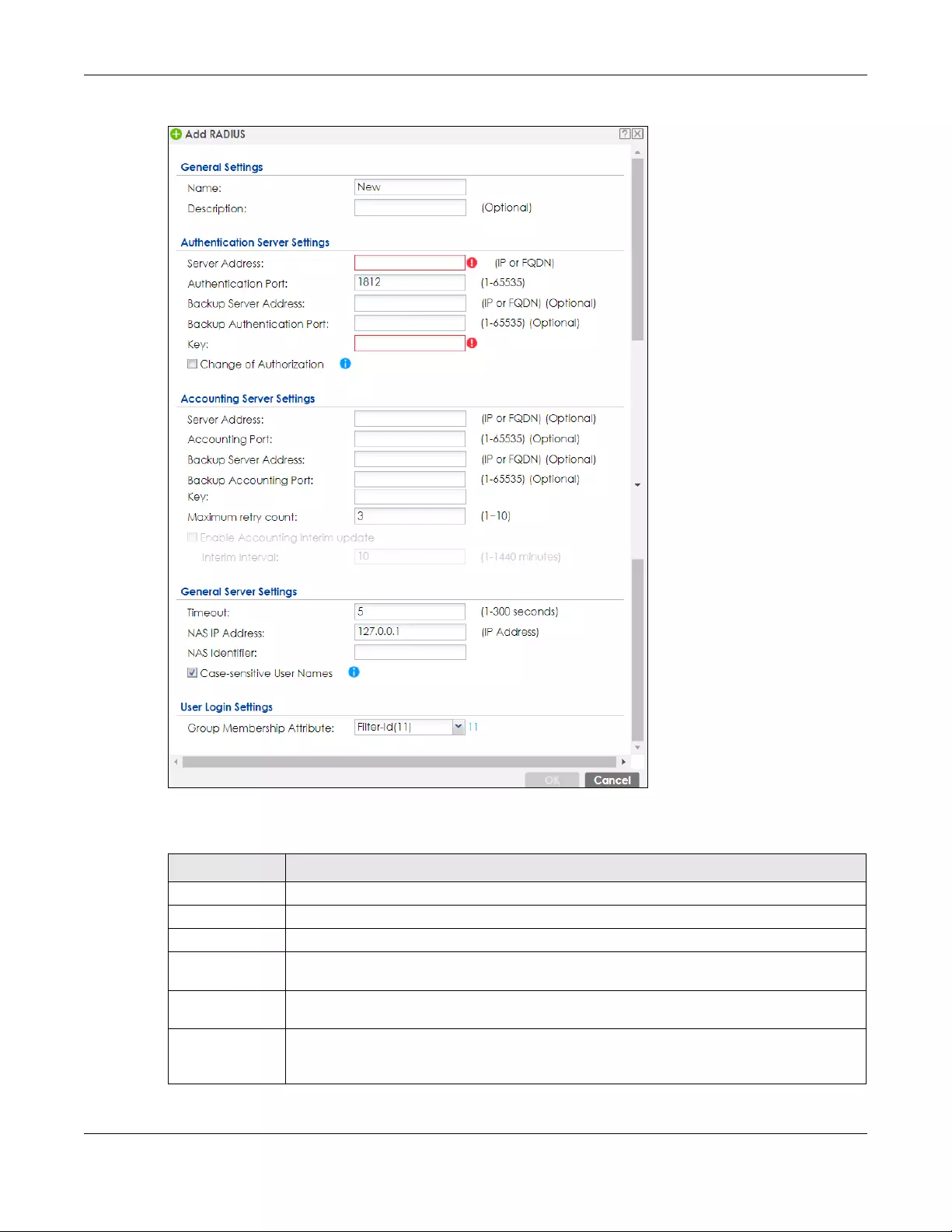
Chapter 39 Object
ZyWALL USG FLEX Series User’s Guide
792
Figure 522 Configuration > Object > AAA Server > RADIUS > Add
The following table describes the labels in this screen.
Table 341 Configuration > Object > AAA Server > RADIUS > Add
LABEL DESCRIPTION
Name Enter a descriptive name (up to 63 alphanumerical characters) for identification purposes.
Description Enter the description of each server, if any. You can use up to 60 printable ASCII characters.
Server Address Enter the address of the RADIUS server.
Authentication
Port
Specify the port number on the RADIUS server to which the Zyxel Device sends authentication
requests. Enter a number between 1 and 65535.
Backup Server
Address
If the RADIUS server has a backup server, enter its address here.
Backup
Authentication
Port
Specify the port number on the RADIUS server to which the Zyxel Device sends authentication
requests. Enter a number between 1 and 65535.

Chapter 39 Object
ZyWALL USG FLEX Series User’s Guide
793
Key Enter a password (up to 15 alphanumeric characters) as the key to be shared between the
external authentication server and the Zyxel Device.
The key is not sent over the network. This key must be the same on the external authentication
server and the Zyxel Device.
Change of
Authorization
The external RADIUS server can change its authentication policy and send CoA (Change of
Authorization) or RADIUS Disconnect messages in order to terminate the subscriber’s service.
Select this option to allow the Zyxel Device to disconnect wireless clients based on the
information (such as client’s user name and MAC address) specified in CoA or RADIUS
Disconnect messages sent by the RADIUS server.
Server Address Enter the IP address or Fully-Qualified Domain Name (FQDN) of the RADIUS accounting server.
Accounting Port Specify the port number on the RADIUS server to which the Zyxel Device sends accounting
information. Enter a number between 1 and 65535.
Backup Server
Address
If the RADIUS server has a backup accounting server, enter its address here.
Backup
Accounting Port
Specify the port number on the RADIUS server to which the Zyxel Device sends accounting
information. Enter a number between 1 and 65535.
Key Enter a password (up to 15 alphanumeric characters) as the key to be shared between the
external authentication server and the Zyxel Device.
The key is not sent over the network. This key must be the same on the external authentication
server and the Zyxel Device.
Maximum Retry
Count
At times the Zyxel Device may not be able to use the primary RADIUS accounting server.
Specify the number of times the Zyxel Device should reattempt to use the primary RADIUS
server before attempting to use the secondary RADIUS server. This also sets how many times the
Zyxel Device will attempt to use the secondary RADIUS server.
For example, you set this field to 3. If the Zyxel Device does not get a response from the primary
RADIUS server, it tries again up to three times. If there is no response, the Zyxel Device tries the
secondary RADIUS server up to three times.
If there is also no response from the secondary RADIUS server, the Zyxel Device stops
attempting to authenticate the subscriber. The subscriber will see a message that says the
RADIUS server was not found.
Enable
Accounting
Interim Update
This field is configurable only after you configure a RADIUS accounting server address. Select
this to have the Zyxel Device send subscriber status updates to the RADIUS server at the interval
you specify.
Interim Interval Specify the time interval for how often the Zyxel Device is to send a subscriber status update to
the RADIUS server.
Timeout Specify the timeout period (between 1 and 300 seconds) before the Zyxel Device disconnects
from the RADIUS server. In this case, user authentication fails.
Search timeout occurs when either the user information is not in the RADIUS server or the
RADIUS server is down.
NAS IP Address Type the IP address of the NAS (Network Access Server).
NAS Identifier If the RADIUS server requires the Zyxel Device to provide the Network Access Server identifier
attribute with a specific value, enter it here.
Case-sensitive
User Names
Select this if you want configure your username as case-sensitive.
Table 341 Configuration > Object > AAA Server > RADIUS > Add (continued)
LABEL DESCRIPTION

Chapter 39 Object
ZyWALL USG FLEX Series User’s Guide
794
39.10 Auth. Method Overview
Authentication method objects set how the Zyxel Device authenticates wireless, HTTP/HTTPS clients, and
peer IPSec routers (extended authentication) clients. Configure authentication method objects to have
the Zyxel Device use the local user database, and/or the authentication servers and authentication
server groups specified by AAA server objects. By default, user accounts created and stored on the
Zyxel Device are authenticated locally.
• Use the Configuration > Object > Auth. Method screens (Section 39.10.3 on page 795) to create and
manage authentication method objects.
• Use the Configuration > Object > Auth. Method > Two-Factor Authentication screen (Section 39.10.4
on page 797) to configure double-layer security to access a secured network behind the Zyxel
Device via a VPN tunnel, or access the Zyxel Device using Web Configurator, SSH, or Telnet.
39.10.1 Before You Begin
Configure AAA server objects before you configure authentication method objects.
39.10.2 Example: Selecting a VPN Authentication Method
After you set up an authentication method object in the Auth. Method screens, you can use it in the VPN
Gateway screen to authenticate VPN users for establishing a VPN connection. Refer to the chapter on
VPN for more information.
Follow the steps below to specify the authentication method for a VPN connection.
1Access the Configuration > VPN > IPSec VPN > VPN Gateway > Edit screen.
2Click Show Advance Setting and select Enable Extended Authentication.
3Select Server Mode and select an authentication method object from the drop-down list box.
4Click OK to save the settings.
Group
Membership
Attribute
A RADIUS server defines attributes for its accounts. Select the name and number of the
attribute that the Zyxel Device is to check to determine to which group a user belongs. If it does
not display, select user-defined and specify the attribute’s number.
This attribute’s value is called a group identifier; it determines to which group a user belongs.
You can add ext-group-user user objects to identify groups based on these group identifier
values.
For example you could have an attribute named “memberOf” with values like “sales”, “RD”,
and “management”. Then you could also create a ext-group-user user object for each group.
One with “sales” as the group identifier, another for “RD” and a third for “management”.
OK Click OK to save the changes.
Cancel Click Cancel to discard the changes.
Table 341 Configuration > Object > AAA Server > RADIUS > Add (continued)
LABEL DESCRIPTION
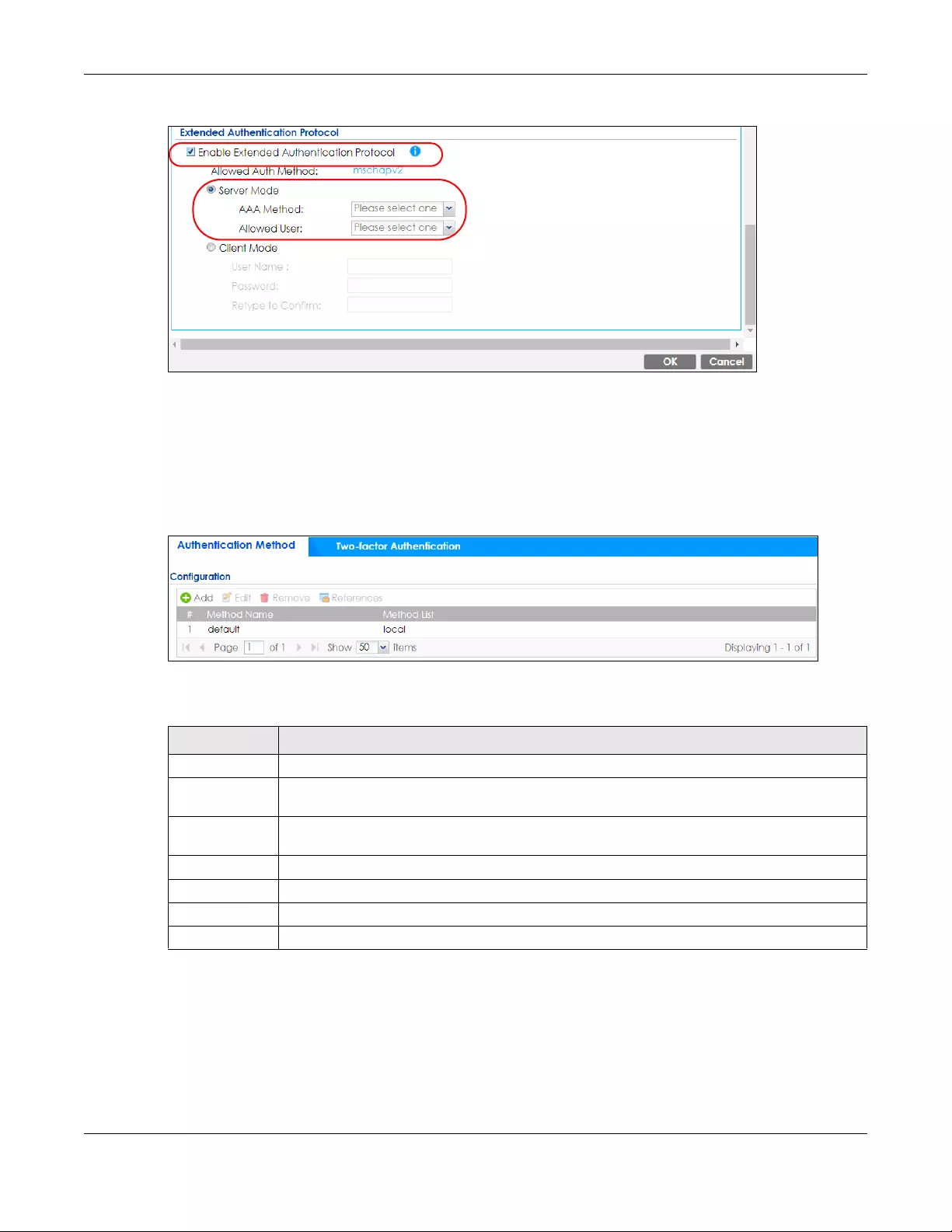
Chapter 39 Object
ZyWALL USG FLEX Series User’s Guide
795
Figure 523 Example: Using Authentication Method in VPN
39.10.3 Authentication Method Objects
Click Configuration > Object > Auth. Method to display the screen as shown.
Note: You can create up to 16 authentication method objects.
Figure 524 Configuration > Object > Auth. Method
The following table describes the labels in this screen.
39.10.3.1 Creating an Authentication Method Object
Follow the steps below to create an authentication method object.
1Click Configuration > Object > Auth. Method.
2Click Add.
Table 342 Configuration > Object > Auth. Method
LABEL DESCRIPTION
Add Click this to create a new entry.
Edit Double-click an entry or select it and click Edit to open a screen where you can modify the
entry’s settings.
Remove To remove an entry, select it and click Remove. The Zyxel Device confirms you want to remove it
before doing so.
References Select an entry and click References to open a screen that shows which settings use the entry.
#This field displays the index number.
Method Name This field displays a descriptive name for identification purposes.
Method List This field displays the authentication method(s) for this entry.
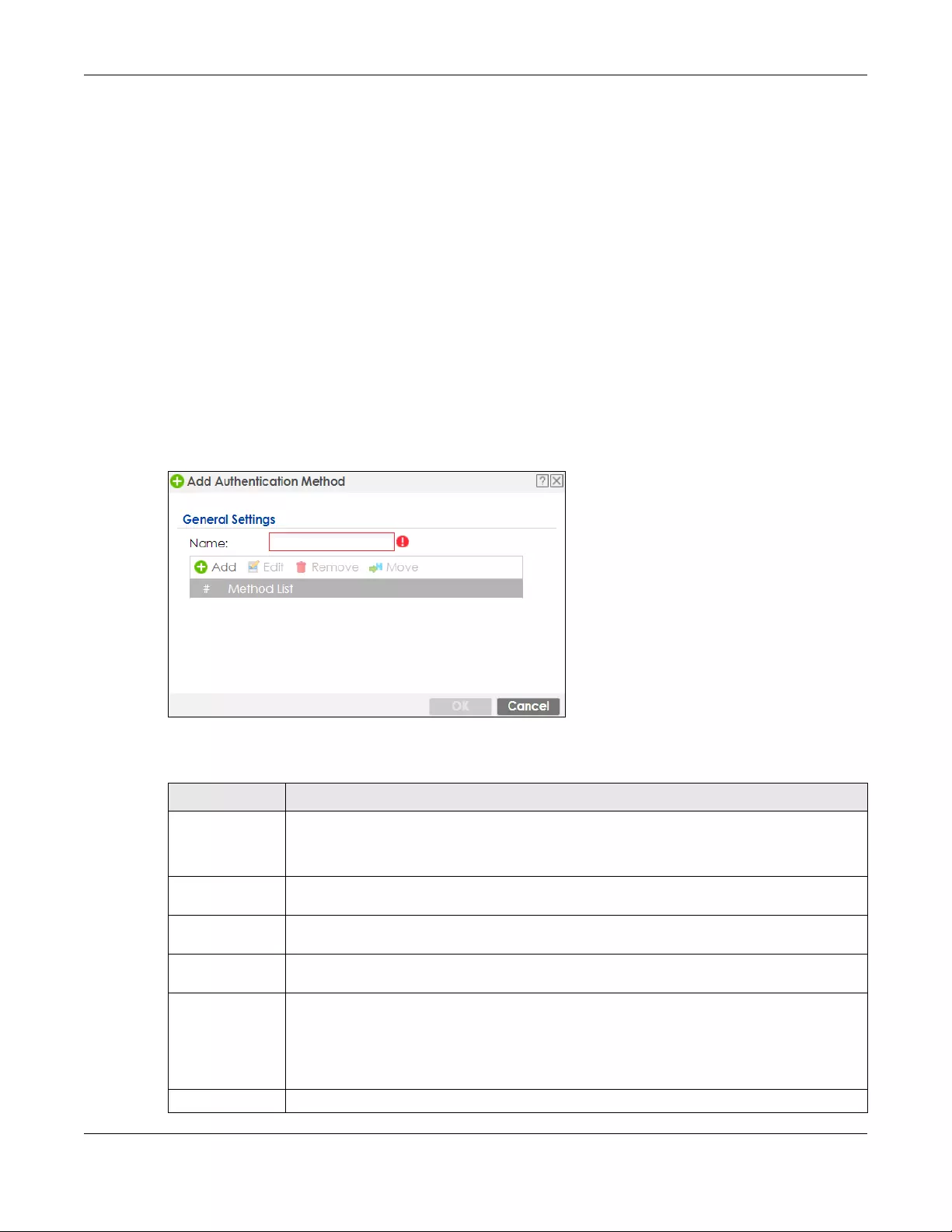
Chapter 39 Object
ZyWALL USG FLEX Series User’s Guide
796
3Specify a descriptive name for identification purposes in the Name field. You may use 1-31
alphanumeric characters, underscores(_), or dashes (-), but the first character cannot be a number. This
value is case-sensitive. For example, “My_Device”.
4Click Add to insert an authentication method in the table.
5Select a server object from the Method List drop-down list box.
6You can add up to four server objects to the table. The ordering of the Method List column is important.
The Zyxel Device authenticates the users using the databases (in the local user database or the external
authentication server) in the order they appear in this screen.
If two accounts with the same username exist on two authentication servers you specify, the Zyxel
Device does not continue the search on the second authentication server when you enter the
username and password that doesn’t match the one on the first authentication server.
Note: You can NOT select two server objects of the same type.
7Click OK to save the settings or click Cancel to discard all changes and return to the previous screen.
Figure 525 Configuration > Object > Auth. Method > Add
The following table describes the labels in this screen.
Table 343 Configuration > Object > Auth. Method > Add
LABEL DESCRIPTION
Name Specify a descriptive name for identification purposes.
You may use 1-31 alphanumeric characters, underscores(_), or dashes (-), but the first
character cannot be a number. This value is case-sensitive. For example, “My_Device”.
Add Click this to create a new entry. Select an entry and click Add to create a new entry after the
selected entry.
Edit Double-click an entry or select it and click Edit to open a screen where you can modify the
entry’s settings.
Remove To remove an entry, select it and click Remove. The Zyxel Device confirms you want to remove
it before doing so.
Move To change a method’s position in the numbered list, select the method and click Move to
display a field to type a number for where you want to put it and press [ENTER] to move the rule
to the number that you typed.
The ordering of your methods is important as Zyxel Device authenticates the users using the
authentication methods in the order they appear in this screen.
#This field displays the index number.
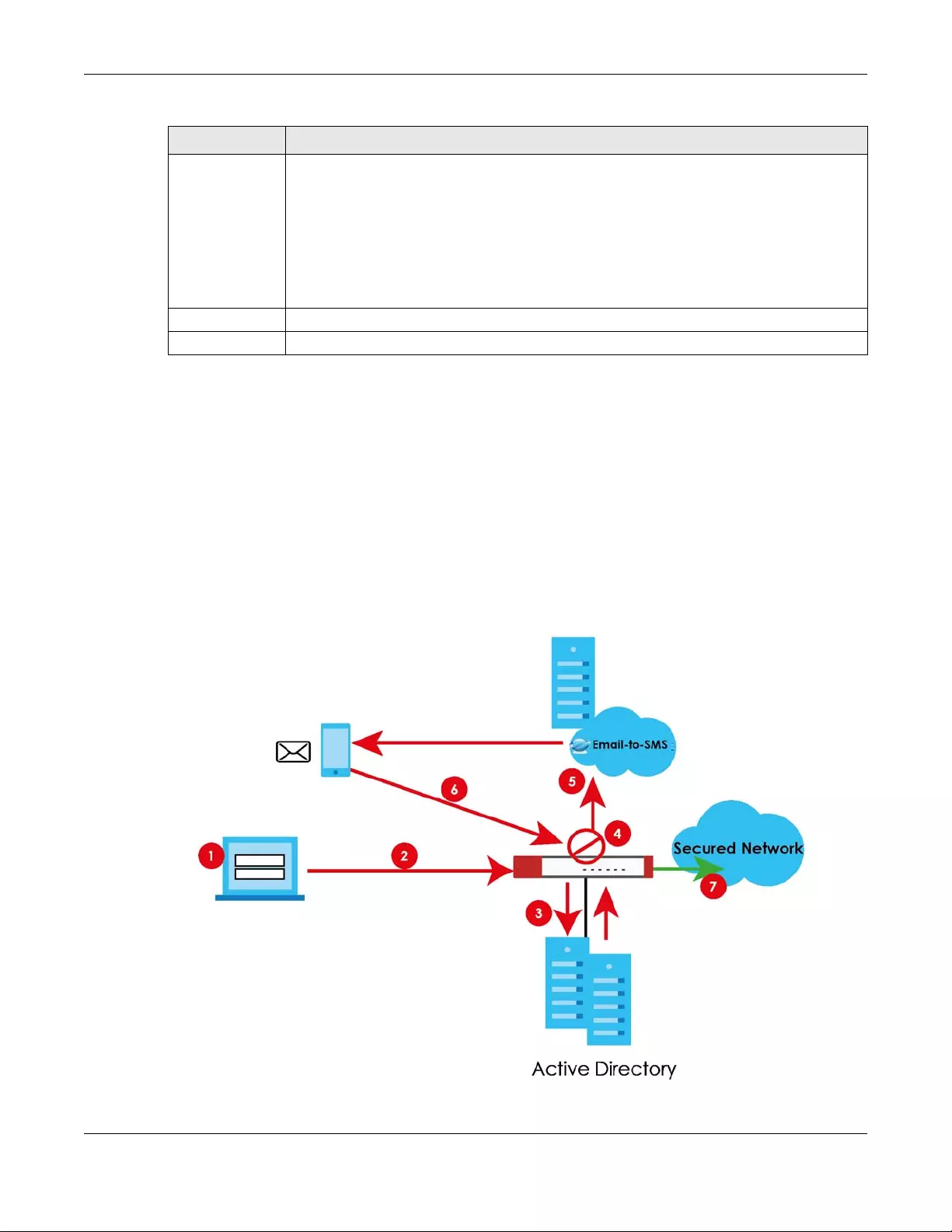
Chapter 39 Object
ZyWALL USG FLEX Series User’s Guide
797
39.10.4 Two-Factor Authentication
Use two-factor authentication to have double-layer security to access a secured network behind the
Zyxel Device via a VPN tunnel, Web Configurator, SSH, or Telnet.
The first layer is the VPN client/Zyxel Device’s login user name / password and the second layer is an
authorized SMS (via mobile phone number) or email address.
39.10.4.1 Overview
This section introduces how two-factor authentication works.
Figure 526 Two-Factor Authentication
Method List Select a server object from the drop-down list box. You can create a server object in the AAA
Server screen.
The Zyxel Device authenticates the users using the databases (in the local user database or the
external authentication server) in the order they appear in this screen.
If two accounts with the same username exist on two authentication servers you specify, the
Zyxel Device does not continue the search on the second authentication server when you
enter the username and password that doesn’t match the one on the first authentication
server.
OK Click OK to save the changes.
Cancel Click Cancel to discard the changes.
Table 343 Configuration > Object > Auth. Method > Add (continued)
LABEL DESCRIPTION

Chapter 39 Object
ZyWALL USG FLEX Series User’s Guide
798
VPN Access Via a VPN tunnel
1A user runs a VPN client and logs in with the user name and password for this VPN tunnel.
2The VPN client connects to the Zyxel Device and authenticates using the specified username and
password.
3The Zyxel Device requests the user’s user-name, password and mobile phone number or email address
from the Active Directory, RADIUS server or local Zyxel Device database in order to authenticate this user
(factor 1). If they are not found, then the Zyxel Device terminates the connection.
4If all correct credentials are found, then the Zyxel Device performs one of the following actions:
• Emails an authorization link to the admin user
• Requests that the Email-to-SMS cloud system send an SMS with the authorization link
5The client must open the authorization link or enter the authorization code within a specified deadline
(Valid Time).
6If the authorization is correct and received on time, then the client can access the secured network
through the VPN tunnel. If the authorization deadline has expired, then the client has to log into the Zyxel
Device again. If authorization credentials are incorrect or if the SMS/email was not received, then the
client should contact the network administrator.
Admin Access Via the Web Configurator, SSH, or Telnet
1An admin user connects to the Zyxel Device through the Web Configurator, SSH, or Telnet.
2The Zyxel Device requests the admin user’s user-name, password and mobile phone number or email
address from the Active Directory, RADIUS server or local Zyxel Device database in order to
authenticate this admin user.
3If all correct credentials are found, then the Zyxel Device performs one of the following actions:
• Requests the Google Authenticator code
• Emails an authorization link or code to the admin user
• Requests that the Email-to-SMS cloud system send an SMS with an authorization link or code
4The admin user must open the authorization link or enter the authorization code within a specified
deadline (Valid Time).
5If the authorization is correct and received on time, then the admin user can log into Zyxel Device. If the
authorization deadline has expired, then the admin user has to log in again. If authorization credentials
are incorrect code was received, then the admin user should contact the network administrator.
39.10.4.2 Pre-configuration
Before configuration, you must:
• Set up the user’s user-name, password and email address or mobile number in the Active Directory,
RADIUS server or local Zyxel Device database
• Enable Two-factor Authentication in Object > User/Group > User > Edit > Two-factor Authentication for
a specific user

Chapter 39 Object
ZyWALL USG FLEX Series User’s Guide
799
• Enable Two-factor Authentication in Object > Auth. Method > Two-factor Authentication for the Zyxel
Device
• Enable HTTP and/or HTTPS in System > WWW > Service Control
• Enable SSH and/or Telnet in System > SSH and/or System > TELNET
•Add HTTP, HTTPS, SSH, and/or, TELNET in the Object > Service > Service Group >
Default_Allow_WAN_To_ZyWALL service group. This service group defines the default services allowed
in the WAN_to_Device security policy.
• For VPN access, configure the VPN tunnel for this user on the Zyxel Device
Email Authentication
•Configure Mail Server in System > Notification > Mail Server.
SMS Authentication
•Configure Mail Server in System > Notification > Mail Server.
•Configure SMS in System > Notification > SMS.
• Have an account with an Email-to-SMS cloud provider to be able to send SMS authorization requests
Google Authentication
• Install Google Authenticator
Two-Factor authentication will fail under the following conditions:
• You omit any of the pre-configuration items. Make sure to perform all pre-configuration items.
• The user cannot receive the authorization SMS or email. Make sure the mobile telephone number or
email address of the user in the Active Directory, RADIUS Server or local Zyxel Device database is
configured correctly.
• Email-to-SMS cloud system authentication fails. Make sure that SMS is enabled and credentials are
correct in System > Notification > SMS.
• Mail server authentication fails. Make sure the System > Notification > Mail Server settings are correct.
• Authorization times out. Extend the Valid Time in Configuration > Object > Auth. Method > Two-factor
Authentication > VPN Access.
• You are unable to access Google Authenticator (you lost your phone or uninstalled the app). Log in
using one of the backup codes.
• You get a Google Authenticator verification error. You must enter the code within the time displayed
in Google Authenticator. The time on your cellphone and the time on the Zyxel Device must be the
same.
39.10.5 Two-Factor Authentication VPN Access
Use this screen to select the users and VPN services that requires two-factor authentication.
Go to Configuration > Object > Auth. Method > Two-factor Authentication > VPN Access and configure
the following screen as shown.
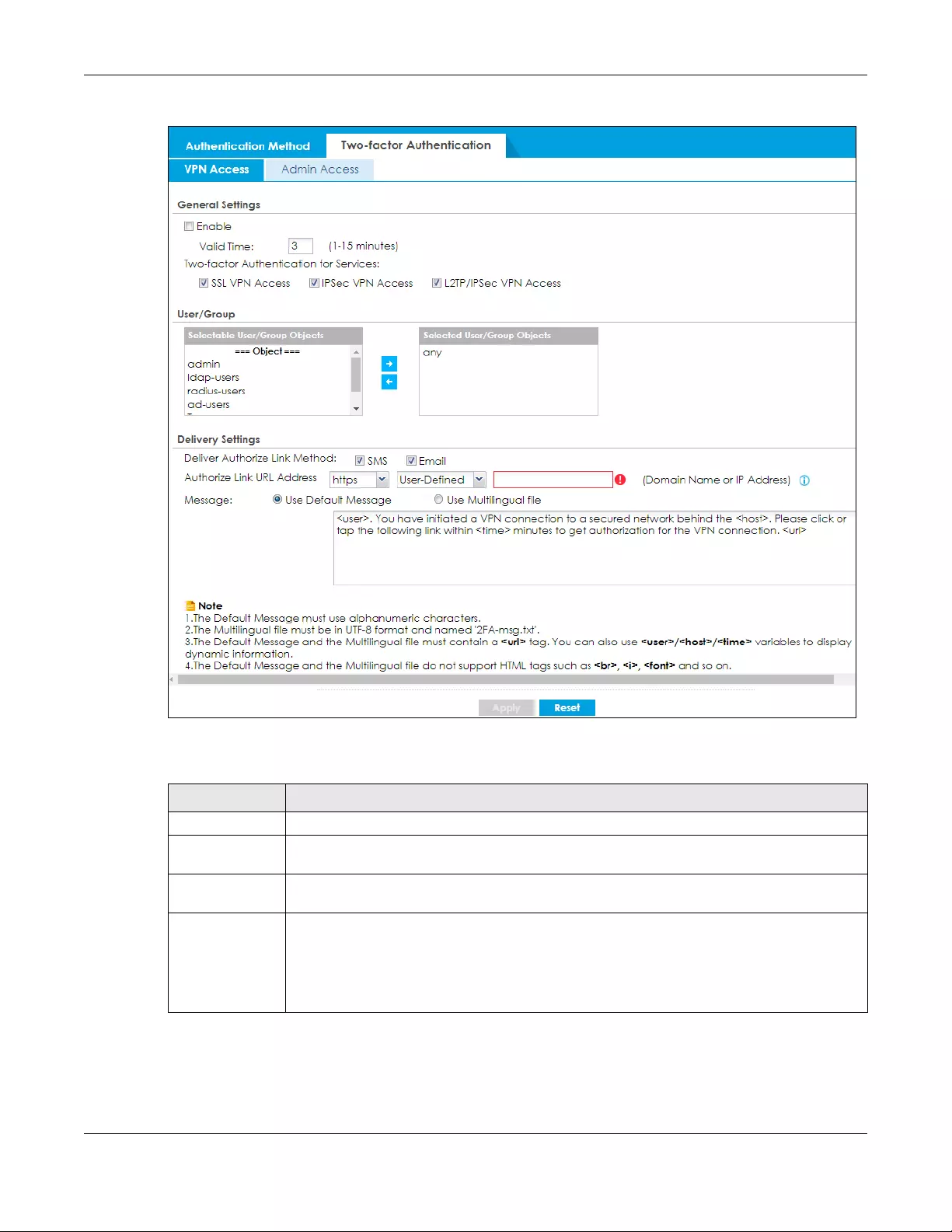
Chapter 39 Object
ZyWALL USG FLEX Series User’s Guide
800
Figure 527 Configuration > Object > Auth. Method > Two-factor Authentication > VPN Access
The following table describes the labels in this screen.
Table 344 Configuration > Object > Auth. Method > Two-factor Authentication > VPN Access
LABEL DESCRIPTION
General Settings
Enable Select the check box to require double-layer security to access a secured network behind the
Zyxel Device via a VPN tunnel.
Valid Time Enter the maximum time (in minutes) that the user must click or tap the authorization link in the
SMS or email in order to get authorization for the VPN connection.
Two-factor
Authentication
for Services:
Select which kinds of VPN tunnels require Two-Factor Authentication. You should have
configured the VPN tunnel first.
• SSL VPN Access
• IPSec VPN Access
• L2TP/IPSec VPN Access

Chapter 39 Object
ZyWALL USG FLEX Series User’s Guide
801
39.10.6 Two-Factor Authentication Admin Access
Use this screen to select the service (Web, SSH, and TELNET) that requires two-factor authentication for
the admin user.
Go to Configuration > Object > Auth. Method > Two-factor Authentication > Admin Access and
configure the following screen as shown.
User/Group This list displays the names of the users and user groups that can be selected for two-factor
authentication. The order of members is not important. Select users and groups from the
Selectable User/Group Objects list that require two-factor authentication for VPN access to a
secured network behind the Zyxel Device and move them to the Selected User/Group Objects
list. You can double-click a single entry to move it or use the [Shift] or [Ctrl] key to select multiple
entries and use the arrow button to move them.
Similarly, move user/groups that do not you do not require two-factor authentication back to
the Selectable User/Group Objects list.
Delivery Settings Use this section to configure how to send an SMS or email for authorization.
Deliver Authorize
Link Method:
Select one or both methods:
•SMS: Object > User/Group > User must contain a valid mobile telephone number. A valid
mobile telephone number can be up to 20 characters in length, including the numbers 1~9
and the following characters in the square brackets [+*#()-].
•Email: Object > User/Group > User must contain a valid email address. A valid email address
must contain the @ character. For example, this is a valid email address:
abc@example.com
Authorize Link
URL Address:
Configure the link that the user will receive in the SMS or email. The user must be able to access
the link.
•http/https: you must enable HTTP or HTTPS in System > WWW > Service Control
•From Interface/User-Defined: select the Zyxel Device WAN interface (wan1/2) or select
User-Defined and then enter an IP address.
Message You can either create a default message in the text box or upload a message file (Use
Multilingual file) from your computer. The message file must be named '2FA-msg.txt' and be in
UTF-8 format. To create the file, click Download the default 2FA-msg.txt example and edit the
file for your needs. (If you make a mistake, use Restore Customized File to Default to restore your
customized file to the default.) Use Select a File Path to locate the final file on your computer
and then click Upload to transfer it to the Zyxel Device.
The message in either the text box or the file must contain the <url> variable within angle
brackets, while the <user>, <host>, and <time> variables are optional.
Apply Click Apply to save the changes.
Reset Click Reset to return the screen to its last-saved settings.
Table 344 Configuration > Object > Auth. Method > Two-factor Authentication > VPN
LABEL DESCRIPTION
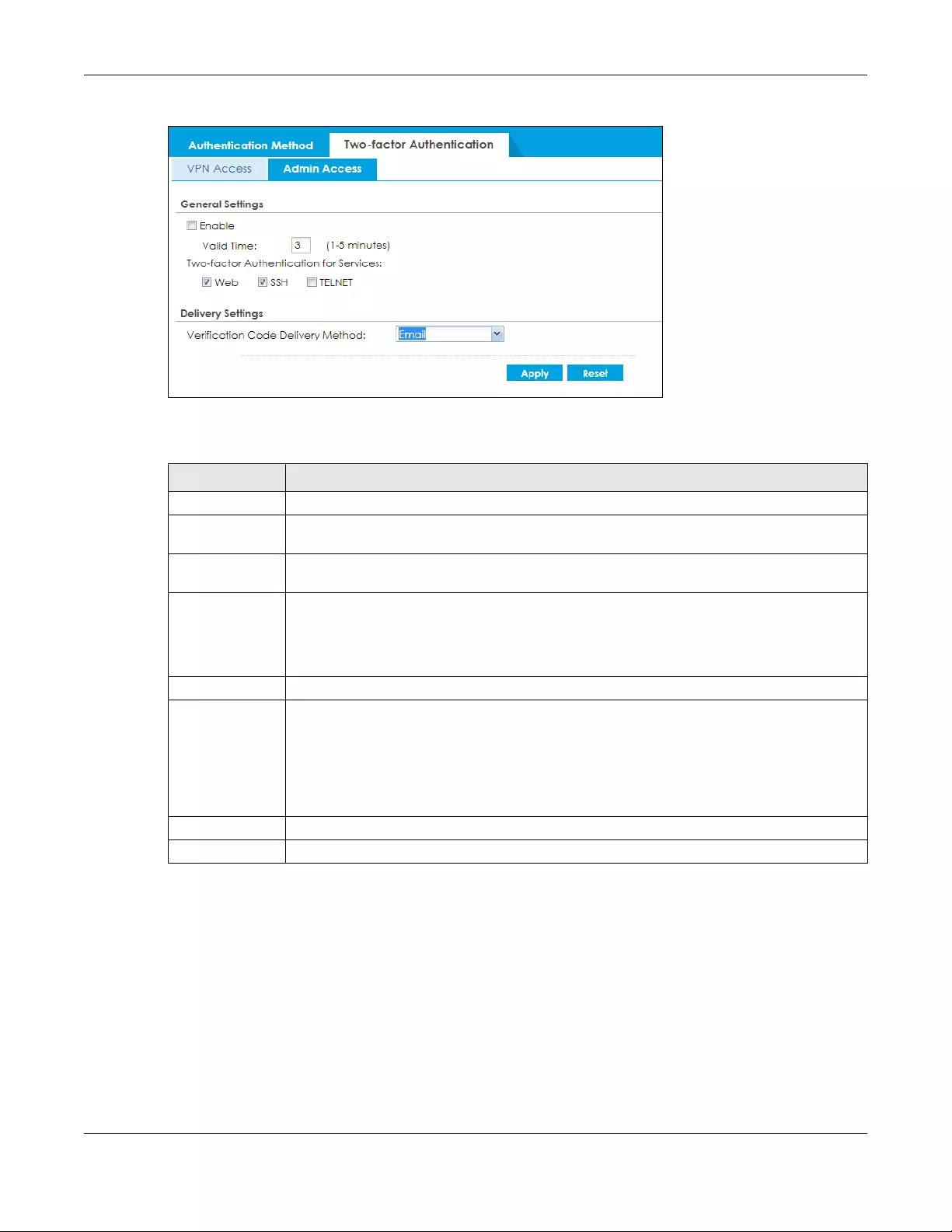
Chapter 39 Object
ZyWALL USG FLEX Series User’s Guide
802
Figure 528 Configuration > Object > Auth. Method > Two-factor Authentication > Admin Access
The following table describes the labels in this screen.
39.11 Certificate Overview
The Zyxel Device can use certificates (also called digital IDs) to authenticate users. Certificates are
based on public-private key pairs. A certificate contains the certificate owner’s identity and public key.
Certificates provide a way to exchange public keys for use in authentication.
• Use the My Certificates screens (see Section 39.11.3 on page 805 to Section 39.11.3.3 on page 813) to
generate and export self-signed certificates or certification requests and import the CA-signed
certificates.
Table 345 Configuration > Object > Auth. Method > Two-factor Authentication > Admin Access
LABEL DESCRIPTION
General Settings
Enable Select the check box to require double-layer security to access a secured network behind the
Zyxel Device via the Web Configurator, SSH, or Telnet.
Valid Time Enter the maximum time (in minutes) that the user must click or tap the authorization link in the
SMS or email in order to get authorization for logins via the Web Configurator, SSH, or Telnet.
Two-factor
Authentication
for Services:
Select which services require Two-Factor Authentication for the admin user.
•Web
•SSH
•TELNET
Delivery Settings Use this section to configure how to send an SMS or email for authorization.
Verification
Code Delivery
Method
Select one or both (All) methods:
•SMS: Object > User/Group > User must contain a valid mobile telephone number. A valid
mobile telephone number can be up to 20 characters in length, including the numbers 1~9
and the following characters in the square brackets [+*#()-].
•Email: Object > User/Group > User must contain a valid email address. A valid email address
must contain the @ character. For example, this is a valid email address:
abc@example.com
Apply Click Apply to save the changes.
Reset Click Reset to return the screen to its last-saved settings.

Chapter 39 Object
ZyWALL USG FLEX Series User’s Guide
803
• Use the Trusted Certificates screens (see Section 39.11.4 on page 814 to Section 39.11.4.2 on page
818) to save CA certificates and trusted remote host certificates to the Zyxel Device. The Zyxel Device
trusts any valid certificate that you have imported as a trusted certificate. It also trusts any valid
certificate signed by any of the certificates that you have imported as a trusted certificate.
39.11.1 What You Need to Know
When using public-key cryptology for authentication, each host has two keys. One key is public and can
be made openly available. The other key is private and must be kept secure.
These keys work like a handwritten signature (in fact, certificates are often referred to as “digital
signatures”). Only you can write your signature exactly as it should look. When people know what your
signature looks like, they can verify whether something was signed by you, or by someone else. In the
same way, your private key “writes” your digital signature and your public key allows people to verify
whether data was signed by you, or by someone else. This process works as follows.
1Tim wants to send a message to Jenny. He needs her to be sure that it comes from him, and that the
message content has not been altered by anyone else along the way. Tim generates a public key pair
(one public key and one private key).
2Tim keeps the private key and makes the public key openly available. This means that anyone who
receives a message seeming to come from Tim can read it and verify whether it is really from him or not.
3Tim uses his private key to sign the message and sends it to Jenny.
4Jenny receives the message and uses Tim’s public key to verify it. Jenny knows that the message is from
Tim, and that although other people may have been able to read the message, no-one can have
altered it (because they cannot re-sign the message with Tim’s private key).
5Additionally, Jenny uses her own private key to sign a message and Tim uses Jenny’s public key to verify
the message.
The Zyxel Device uses certificates based on public-key cryptology to authenticate users attempting to
establish a connection, not to encrypt the data that you send after establishing a connection. The
method used to secure the data that you send through an established connection depends on the
type of connection. For example, a VPN tunnel might use the triple DES encryption algorithm.
The certification authority uses its private key to sign certificates. Anyone can then use the certification
authority’s public key to verify the certificates.
A certification path is the hierarchy of certification authority certificates that validate a certificate. The
Zyxel Device does not trust a certificate if any certificate on its path has expired or been revoked.
Certification authorities maintain directory servers with databases of valid and revoked certificates. A
directory of certificates that have been revoked before the scheduled expiration is called a CRL
(Certificate Revocation List). The Zyxel Device can check a peer’s certificate against a directory server’s
list of revoked certificates. The framework of servers, software, procedures and policies that handles keys
is called PKI (public-key infrastructure).
Advantages of Certificates
Certificates offer the following benefits.

Chapter 39 Object
ZyWALL USG FLEX Series User’s Guide
804
• The Zyxel Device only has to store the certificates of the certification authorities that you decide to
trust, no matter how many devices you need to authenticate.
• Key distribution is simple and very secure since you can freely distribute public keys and you never
need to transmit private keys.
Self-signed Certificates
You can have the Zyxel Device act as a certification authority and sign its own certificates.
Factory Default Certificate
The Zyxel Device generates its own unique self-signed certificate when you first turn it on. This certificate
is referred to in the GUI as the factory default certificate.
Certificate File Formats
Any certificate that you want to import has to be in one of these file formats:
• Binary X.509: This is an ITU-T recommendation that defines the formats for X.509 certificates.
• PEM (Base-64) encoded X.509: This Privacy Enhanced Mail format uses lowercase letters, uppercase
letters and numerals to convert a binary X.509 certificate into a printable form.
• Binary PKCS#7: This is a standard that defines the general syntax for data (including digital signatures)
that may be encrypted. A PKCS #7 file is used to transfer a public key certificate. The private key is not
included. The Zyxel Device currently allows the importation of a PKS#7 file that contains a single
certificate.
• PEM (Base-64) encoded PKCS#7: This Privacy Enhanced Mail (PEM) format uses lowercase letters,
uppercase letters and numerals to convert a binary PKCS#7 certificate into a printable form.
• Binary PKCS#12: This is a format for transferring public key and private key certificates. The private key
in a PKCS #12 file is within a password-encrypted envelope. The file’s password is not connected to
your certificate’s public or private passwords. Exporting a PKCS #12 file creates this and you must
provide it to decrypt the contents when you import the file into the Zyxel Device.
Note: Be careful not to convert a binary file to text during the transfer process. It is easy for this
to occur since many programs use text files by default.
39.11.2 Verifying a Certificate
Before you import a trusted certificate into the Zyxel Device, you should verify that you have the correct
certificate. You can do this using the certificate’s fingerprint. A certificate’s fingerprint is a message
digest calculated using the MD5 or SHA1 algorithm. The following procedure describes how to check a
certificate’s fingerprint to verify that you have the actual certificate.
1Browse to where you have the certificate saved on your computer.
2Make sure that the certificate has a “.cer” or “.crt” file name extension.

Chapter 39 Object
ZyWALL USG FLEX Series User’s Guide
805
Figure 529 Remote Host Certificates
3Double-click the certificate’s icon to open the Certificate window. Click the Details tab and scroll down
to the Thumbprint Algorithm and Thumbprint fields.
Figure 530 Certificate Details
4Use a secure method to verify that the certificate owner has the same information in the Thumbprint
Algorithm and Thumbprint fields. The secure method may very based on your situation. Possible
examples would be over the telephone or through an HTTPS connection.
39.11.3 The My Certificates Screen
Click Configuration > Object > Certifica te > My Certificates to open the My Certificates screen. This is the
Zyxel Device’s summary list of certificates and certification requests.
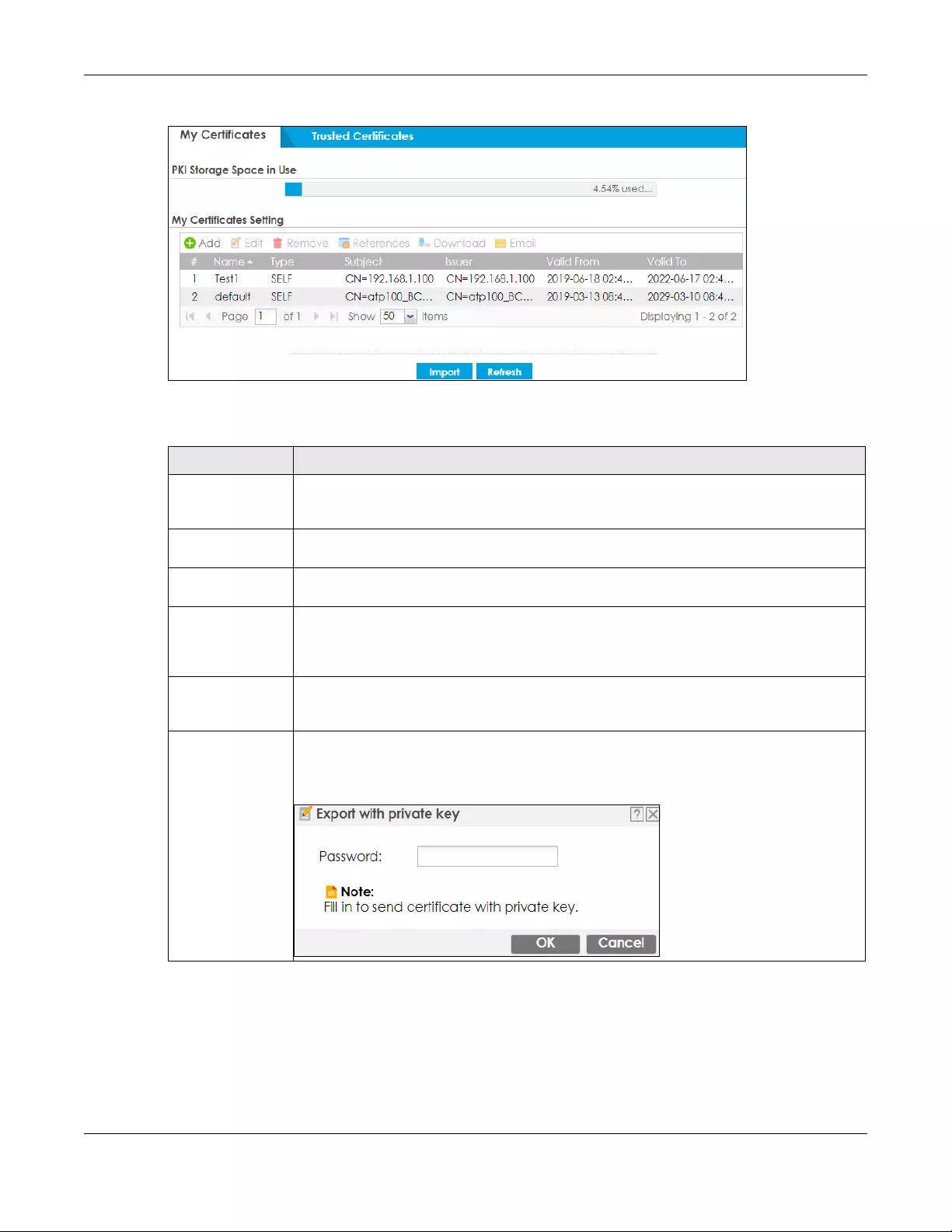
Chapter 39 Object
ZyWALL USG FLEX Series User’s Guide
806
Figure 531 Configuration > Object > Certificate > My Certificates
The following table describes the labels in this screen.
Table 346 Configuration > Object > Certificate > My Certificates
LABEL DESCRIPTION
PKI Storage Space
in Use
This bar displays the percentage of the Zyxel Device’s PKI storage space that is currently in
use. When the storage space is almost full, you should consider deleting expired or
unnecessary certificates before adding more certificates.
Add Click this to go to the screen where you can have the Zyxel Device generate a certificate or
a certification request.
Edit Double-click an entry or select it and click Edit to open a screen with an in-depth list of
information about the certificate.
Remove The Zyxel Device keeps all of your certificates unless you specifically delete them. Uploading
a new firmware or default configuration file does not delete your certificates. To remove an
entry, select it and click Remove. The Zyxel Device confirms you want to remove it before
doing so. Subsequent certificates move up by one when you take this action.
References You cannot delete certificates that any of the Zyxel Device’s features are configured to use.
Select an entry and click References to open a screen that shows which settings use the
entry.
Download Click this and the following screen will appear.
Type the selected certificate’s password and save the selected certificate to your computer.
Figure 532 Download a Certificate

Chapter 39 Object
ZyWALL USG FLEX Series User’s Guide
807
Email Click this to email the selected certificate to the configured email address(es) for SSL
connection establishment. This enables you to establish an SSL connection on your laptops,
tablets, or smartphones.
Click this and the following screen will appear.
Here are the field descriptions:
•Mail Subject: Type the subject line for outgoing email from the Zyxel Device.
•Mail To: Type the email address (or addresses) to which the outgoing email is
delivered.
•Send Certificate with Private Key: Select the check box to send the selected
certificate with a private key.
•Password: Enter a private key of up to 31 keyboard characters for the certificate.
The special characters listed in the brackets [;\|`~!@#$%^&*()_+\\{}':,./<>=-"]
are allowed.
•E-mail Content: Create the email content in English, and use up to 250 keyboard
characters. The special characters listed in the brackets
[;\|`~!@#$%^&*()_+\\{}':,./<>=-"] are allowed.
•Compress as a ZIP File: Select the check box to compress the selected
certificate.
Make sure the endpoint devices can decompress ZIP files before sending the
compressed certificate.
It's recommended to compress the certificate with a private key. Some email
servers block PKCS #12 files.
•Send Email: Click this to send the selected certificate.
•Cancel: Click this to return to the previous screen without saving your changes.
Figure 533 Email My Certificate
#This field displays the certificate index number. The certificates are listed in alphabetical order.
Name This field displays the name used to identify this certificate. It is recommended that you give
each certificate a unique name.
Table 346 Configuration > Object > Certificate > My Certificates (continued)
LABEL DESCRIPTION

Chapter 39 Object
ZyWALL USG FLEX Series User’s Guide
808
39.11.3.1 The My Certificates Add Screen
Click Configuration > Object > Certificate > My Certificates and then the Add icon to open the My
Certificates Add screen. Use this screen to have the Zyxel Device create a self-signed certificate, enroll a
certificate with a certification authority or generate a certification request.
Type This field displays what kind of certificate this is.
REQ represents a certification request and is not yet a valid certificate. Send a certification
request to a certification authority, which then issues a certificate. Use the My Certificate
Import screen to import the certificate and replace the request.
SELF represents a self-signed certificate.
CERT represents a certificate issued by a certification authority.
Subject This field displays identifying information about the certificate’s owner, such as CN (Common
Name), OU (Organizational Unit or department), O (Organization or company) and C
(Country). It is recommended that each certificate have unique subject information.
Issuer This field displays identifying information about the certificate’s issuing certification authority,
such as a common name, organizational unit or department, organization or company and
country. With self-signed certificates, this is the same information as in the Subject field.
Valid From This field displays the date that the certificate becomes applicable.
Valid To This field displays the date that the certificate expires. The text displays in red and includes an
Expired! message if the certificate has expired.
Import Click Import to open a screen where you can save a certificate to the Zyxel Device.
Refresh Click Refresh to display the current validity status of the certificates.
Table 346 Configuration > Object > Certificate > My Certificates (continued)
LABEL DESCRIPTION

Chapter 39 Object
ZyWALL USG FLEX Series User’s Guide
809
Figure 534 Configuration > Object > Certificate > My Certificates > Add
The following table describes the labels in this screen.
Table 347 Configuration > Object > Certificate > My Certificates > Add
LABEL DESCRIPTION
Name Type a name to identify this certificate. You can use up to 31 alphanumeric and
;‘~!@#$%^&()_+[]{}’,.=- characters.
Subject Information Use these fields to record information that identifies the owner of the certificate. You do
not have to fill in every field, although you must specify a Host IP Address, Host IPv6
Address, Host Domain Name, or E-Mail. The certification authority may add fields (such as
a serial number) to the subject information when it issues a certificate. It is recommended
that each certificate have unique subject information.
Select a radio button to identify the certificate’s owner by IP address, domain name or
email address. Type the IP address (in dotted decimal notation), domain name or email
address in the field provided. The domain name or email address is for identification
purposes only and can be any string.
A domain name can be up to 255 characters. You can use alphanumeric characters, the
hyphen and periods.
An email address can be up to 63 characters. You can use alphanumeric characters, the
hyphen, the @ symbol, periods and the underscore.
Organizational Unit Identify the organizational unit or department to which the certificate owner belongs. You
can use up to 31 characters. You can use alphanumeric characters, the hyphen and the
underscore.
Organization Identify the company or group to which the certificate owner belongs. You can use up to
31 characters. You can use alphanumeric characters, the hyphen and the underscore.
Town (City) Identify the town or city where the certificate owner is located. You can use up to 31
characters. You can use alphanumeric characters, the hyphen and the underscore.

Chapter 39 Object
ZyWALL USG FLEX Series User’s Guide
810
If you configured the My Certificate Create screen to have the Zyxel Device enroll a certificate and the
certificate enrollment is not successful, you see a screen with a Return button that takes you back to the
My Certificate Create screen. Click Return and check your information in the My Certificate Create
screen. Make sure that the certification authority information is correct and that your Internet
connection is working properly if you want the Zyxel Device to enroll a certificate online.
39.11.3.2 The My Certificates Edit Screen
Click Configuration > Object > Certificate > My Certificates and then the Edit icon to open the My
Certificate Edit screen. You can use this screen to view in-depth certificate information and change the
certificate’s name.
State, (Province) Identify the state or province where the certificate owner is located. You can use up to 31
characters. You can use alphanumeric characters, the hyphen and the underscore.
Country Enter a two-letter country code to Identify the nation where the certificate owner is
located.
Key Type Select RSA to use the Rivest, Shamir and Adleman public-key algorithm.
Select DSA to use the Digital Signature Algorithm public-key algorithm.
Key Length Select a number from the drop-down list box to determine how many bits the key should
use (1024 to 2048). The longer the key, the more secure it is. A longer key also uses more
PKI storage space.
LifeTimes Select how long the certificate is valid. It can be valid from 2 to 10 years.
Extended Key Usage
Server Authentication Select this to have Zyxel Device generate and store a request for server authentication
certificate.
Client Authentication Select this to have Zyxel Device generate and store a request for client authentication
certificate.
IKE Intermediate Select this to have Zyxel Device generate and store a request for IKE Intermediate
authentication certificate.
Create a self-signed
certificate
Select this to have the Zyxel Device generate the certificate and act as the Certification
Authority (CA) itself. This way you do not need to apply to a certification authority for
certificates.
Create a certification
request and save it
locally for later
manual enrollment
Select this to have the Zyxel Device generate and store a request for a certificate. Use the
My Certificate Details screen to view the certification request and copy it to send to the
certification authority.
Copy the certification request from the My Certificate Details screen (see Section 39.11.3.2
on page 810) and then send it to the certification authority.
OK Click OK to begin certificate or certification request generation.
Cancel Click Cancel to quit and return to the My Certificates screen.
Table 347 Configuration > Object > Certificate > My Certificates > Add (continued)
LABEL DESCRIPTION
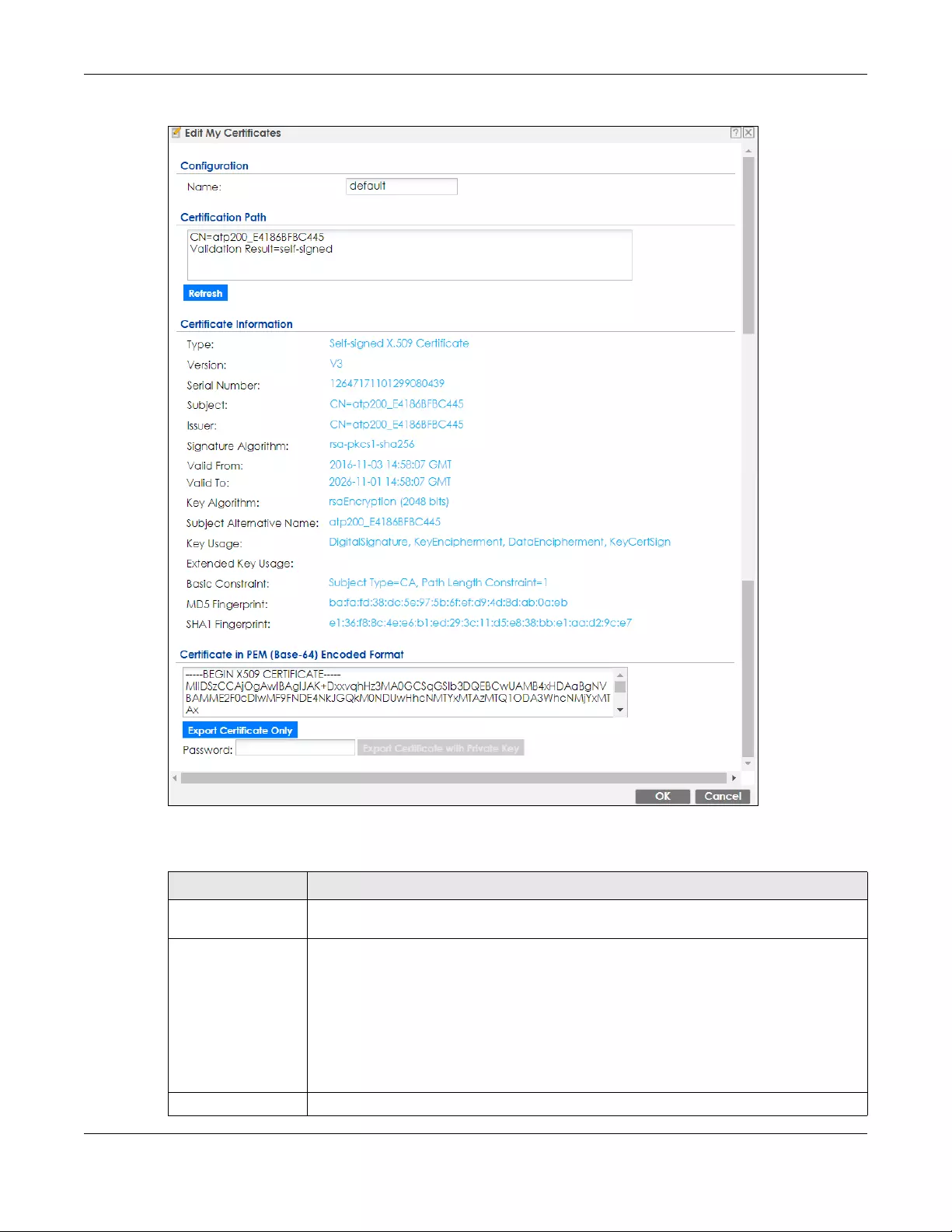
Chapter 39 Object
ZyWALL USG FLEX Series User’s Guide
811
Figure 535 Configuration > Object > Certificate > My Certificates > Edit
The following table describes the labels in this screen.
Table 348 Configuration > Object > Certificate > My Certificates > Edit
LABEL DESCRIPTION
Name This field displays the identifying name of this certificate. You can use up to 31 alphanumeric
and ;‘~!@#$%^&()_+[]{}’,.=- characters.
Certification Path This field displays for a certificate, not a certification request.
Click the Refresh button to have this read-only text box display the hierarchy of certification
authorities that validate the certificate (and the certificate itself).
If the issuing certification authority is one that you have imported as a trusted certification
authority, it may be the only certification authority in the list (along with the certificate itself).
If the certificate is a self-signed certificate, the certificate itself is the only one in the list. The
Zyxel Device does not trust the certificate and displays “Not trusted” in this field if any
certificate on the path has expired or been revoked.
Refresh Click Refresh to display the certification path.

Chapter 39 Object
ZyWALL USG FLEX Series User’s Guide
812
Certificate
Information
These read-only fields display detailed information about the certificate.
Type This field displays general information about the certificate. CA-signed means that a
Certification Authority signed the certificate. Self-signed means that the certificate’s owner
signed the certificate (not a certification authority). “X.509” means that this certificate was
created and signed according to the ITU-T X.509 recommendation that defines the formats
for public-key certificates.
Version This field displays the X.509 version number.
Serial Number This field displays the certificate’s identification number given by the certification authority
or generated by the Zyxel Device.
Subject This field displays information that identifies the owner of the certificate, such as Common
Name (CN), Organizational Unit (OU), Organization (O), State (ST), and Country (C).
Issuer This field displays identifying information about the certificate’s issuing certification
authority, such as Common Name, Organizational Unit, Organization and Country.
With self-signed certificates, this is the same as the Subject Name field.
“none” displays for a certification request.
Signature Algorithm This field displays the type of algorithm that was used to sign the certificate. The Zyxel
Device uses rsa-pkcs1-sha1 (RSA public-private key encryption algorithm and the SHA1
hash algorithm). Some certification authorities may use rsa-pkcs1-md5 (RSA public-private
key encryption algorithm and the MD5 hash algorithm).
Valid From This field displays the date that the certificate becomes applicable. “none” displays for a
certification request.
Valid To This field displays the date that the certificate expires. The text displays in red and includes
an Expired! message if the certificate has expired. “none” displays for a certification
request.
Key Algorithm This field displays the type of algorithm that was used to generate the certificate’s key pair
(the Zyxel Device uses RSA encryption) and the length of the key set in bits (1024 bits for
example).
Subject Alternative
Name
This field displays the certificate owner‘s IP address (IP), domain name (DNS) or email
address (EMAIL).
Key Usage This field displays for what functions the certificate’s key can be used. For example,
“DigitalSignature” means that the key can be used to sign certificates and
“KeyEncipherment” means that the key can be used to encrypt text.
Extended Key Usage This field displays how the Zyxel Device generates and stores a request for server
authentication, client authentication, or IKE Intermediate authentication certificate.
Basic Constraint This field displays general information about the certificate. For example, Subject Type=CA
means that this is a certification authority’s certificate and “Path Length Constraint=1”
means that there can only be one certification authority in the certificate’s path. This field
does not display for a certification request.
MD5 Fingerprint This is the certificate’s message digest that the Zyxel Device calculated using the MD5
algorithm.
SHA1 Fingerprint This is the certificate’s message digest that the Zyxel Device calculated using the SHA1
algorithm.
Table 348 Configuration > Object > Certificate > My Certificates > Edit (continued)
LABEL DESCRIPTION
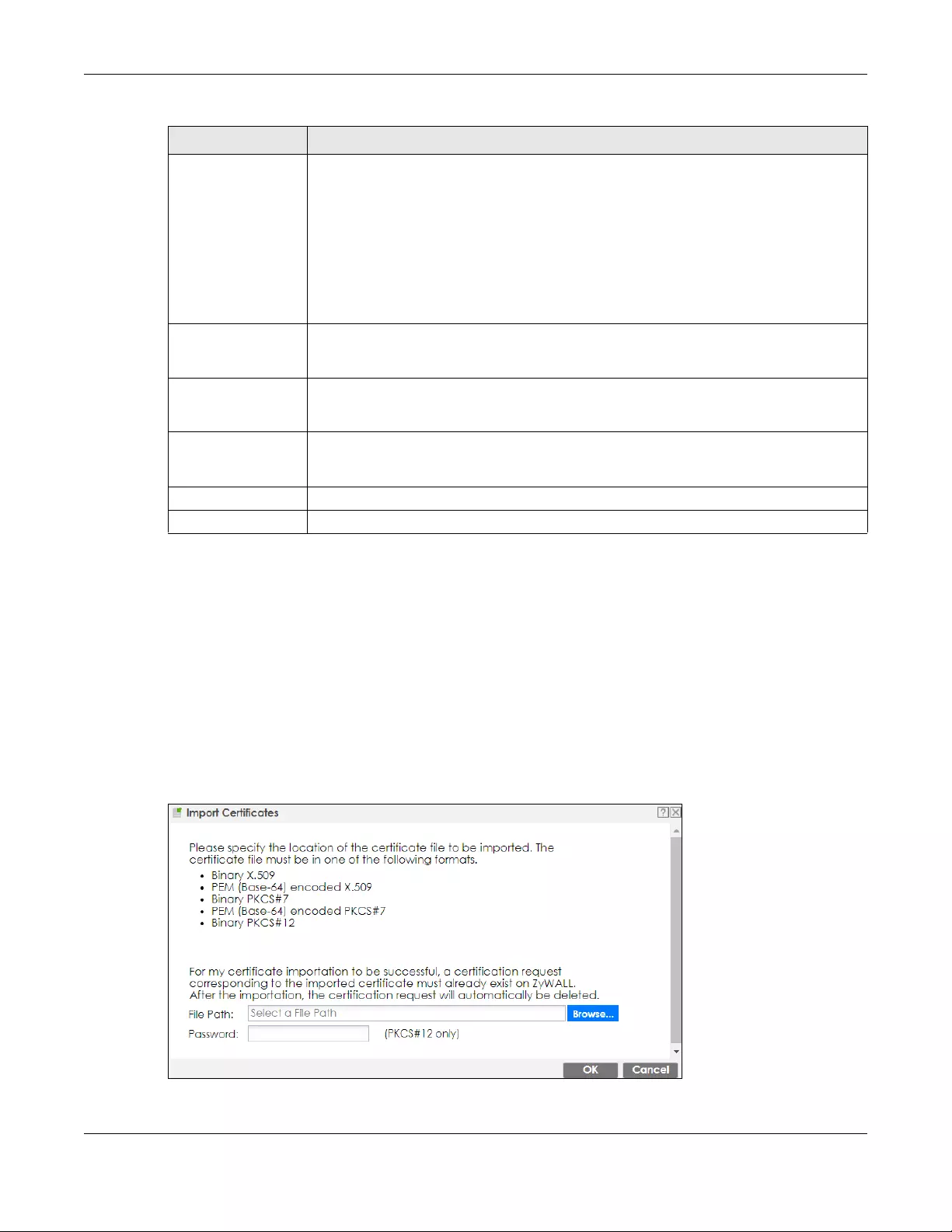
Chapter 39 Object
ZyWALL USG FLEX Series User’s Guide
813
39.11.3.3 The My Certificates Import Screen
Click Configuration > Object > Certificate > My Certificates > Import to open the My Certificate Import
screen. Follow the instructions in this screen to save an existing certificate to the Zyxel Device.
Note: You can import a certificate that matches a corresponding certification request that
was generated by the Zyxel Device. You can also import a certificate in PKCS#12
format, including the certificate’s public and private keys.
The certificate you import replaces the corresponding request in the My Certificates screen.
You must remove any spaces from the certificate’s filename before you can import it.
Figure 536 Configuration > Object > Certificate > My Certificates > Import
Certificate in PEM
(Base-64) Encoded
Format
This read-only text box displays the certificate or certification request in Privacy Enhanced
Mail (PEM) format. PEM uses lowercase letters, uppercase letters and numerals to convert a
binary certificate into a printable form.
You can copy and paste a certification request into a certification authority’s web page,
an email that you send to the certification authority or a text editor and save the file on a
management computer for later manual enrollment.
You can copy and paste a certificate into an email to send to friends or colleagues or you
can copy and paste a certificate into a text editor and save the file on a management
computer for later distribution (via external storage device for example).
Export Certificate
Only
Use this button to save a copy of the certificate without its private key. Click this button and
then Save in the File Download screen. The Save As screen opens, browse to the location
that you want to use and click Save.
Password If you want to export the certificate with its private key, create a password and type it here.
Make sure you keep this password in a safe place. You will need to use it if you import the
certificate to another device.
Export Certificate
with Private Key
Use this button to save a copy of the certificate with its private key. Type the certificate’s
password and click this button. Click Save in the File Download screen. The Save As screen
opens, browse to the location that you want to use and click Save.
OK Click OK to save your changes back to the Zyxel Device. You can only change the name.
Cancel Click Cancel to quit and return to the My Certificates screen.
Table 348 Configuration > Object > Certificate > My Certificates > Edit (continued)
LABEL DESCRIPTION

Chapter 39 Object
ZyWALL USG FLEX Series User’s Guide
814
The following table describes the labels in this screen.
39.11.4 The Trusted Certificates Screen
Click Configuration > Object > Certificate > Trusted Certificates to open the Trusted Certificates screen.
This screen displays a summary list of certificates that you have set the Zyxel Device to accept as trusted.
The Zyxel Device also accepts any valid certificate signed by a certificate on this list as being
trustworthy; thus you do not need to import any certificate that is signed by one of these certificates.
Figure 537 Configuration > Object > Certificate > Trusted Certificates
The following table describes the labels in this screen.
Table 349 Configuration > Object > Certificate > My Certificates > Import
LABEL DESCRIPTION
File Path Type in the location of the file you want to upload in this field or click Browse to find it.
You cannot import a certificate with the same name as a certificate that is already in the Zyxel
Device.
Browse Click Browse to find the certificate file you want to upload.
Password This field only applies when you import a binary PKCS#12 format file. Type the file’s password that was
created when the PKCS #12 file was exported.
OK Click OK to save the certificate on the Zyxel Device.
Cancel Click Cancel to quit and return to the My Certificates screen.
Table 350 Configuration > Object > Certificate > Trusted Certificates
LABEL DESCRIPTION
PKI Storage Space
in Use
This bar displays the percentage of the Zyxel Device’s PKI storage space that is currently in
use. When the storage space is almost full, you should consider deleting expired or
unnecessary certificates before adding more certificates.
Edit Double-click an entry or select it and click Edit to open a screen with an in-depth list of
information about the certificate.
Remove The Zyxel Device keeps all of your certificates unless you specifically delete them. Uploading a
new firmware or default configuration file does not delete your certificates. To remove an
entry, select it and click Remove. The Zyxel Device confirms you want to remove it before
doing so. Subsequent certificates move up by one when you take this action.
References You cannot delete certificates that any of the Zyxel Device’s features are configured to use.
Select an entry and click References to open a screen that shows which settings use the entry.
#This field displays the certificate index number. The certificates are listed in alphabetical order.

Chapter 39 Object
ZyWALL USG FLEX Series User’s Guide
815
39.11.4.1 The Trusted Certificates Edit Screen
Click Configuration > Object > Certificate > Trusted Certificates and then a certificate’s Edit icon to open
the Trusted Certificates Edit screen. Use this screen to view in-depth information about the certificate,
change the certificate’s name and set whether or not you want the Zyxel Device to check a
certification authority’s list of revoked certificates before trusting a certificate issued by the certification
authority.
Name This field displays the name used to identify this certificate.
Subject This field displays identifying information about the certificate’s owner, such as CN (Common
Name), OU (Organizational Unit or department), O (Organization or company) and C
(Country). It is recommended that each certificate have unique subject information.
Issuer This field displays identifying information about the certificate’s issuing certification authority,
such as a common name, organizational unit or department, organization or company and
country. With self-signed certificates, this is the same information as in the Subject field.
Valid From This field displays the date that the certificate becomes applicable.
Valid To This field displays the date that the certificate expires. The text displays in red and includes an
Expired! message if the certificate has expired.
Import Click Import to open a screen where you can save the certificate of a certification authority
that you trust, from your computer to the Zyxel Device.
Refresh Click this button to display the current validity status of the certificates.
Table 350 Configuration > Object > Certificate > Trusted Certificates (continued)
LABEL DESCRIPTION

Chapter 39 Object
ZyWALL USG FLEX Series User’s Guide
816
Figure 538 Configuration > Object > Certificate > Trusted Certificates > Edit

Chapter 39 Object
ZyWALL USG FLEX Series User’s Guide
817
The following table describes the labels in this screen.
Table 351 Configuration > Object > Certificate > Trusted Certificates > Edit
LABEL DESCRIPTION
Name This field displays the identifying name of this certificate. You can change the name. You
can use up to 31 alphanumeric and ;‘~!@#$%^&()_+[]{}’,.=- characters.
Certification Path Click the Refresh button to have this read-only text box display the end entity’s certificate
and a list of certification authority certificates that shows the hierarchy of certification
authorities that validate the end entity’s certificate. If the issuing certification authority is
one that you have imported as a trusted certificate, it may be the only certification
authority in the list (along with the end entity’s own certificate). The Zyxel Device does not
trust the end entity’s certificate and displays “Not trusted” in this field if any certificate on
the path has expired or been revoked.
Refresh Click Refresh to display the certification path.
Enable X.509v3 CRL
Distribution Points
and OCSP checking
Select this check box to turn on/off certificate revocation. When it is turned on, the Zyxel
Device validates a certificate by getting Certificate Revocation List (CRL) through HTTP or
LDAP (can be configured after selecting the LDAP Server check box) and online responder
(can be configured after selecting the OCSP Server check box).
OCSP Server Select this check box if the directory server uses OCSP (Online Certificate Status Protocol).
URL Type the protocol, IP address and path name of the OCSP server.
ID The Zyxel Device may need to authenticate itself in order to assess the OCSP server. Type
the login name (up to 31 ASCII characters) from the entity maintaining the server (usually a
certification authority).
Password Type the password (up to 31 ASCII characters) from the entity maintaining the OCSP server
(usually a certification authority).
LDAP Server Select this check box if the directory server uses LDAP (Lightweight Directory Access
Protocol). LDAP is a protocol over TCP that specifies how clients access directories of
certificates and lists of revoked certificates.
Address Type the IP address (in dotted decimal notation) of the directory server.
Port Use this field to specify the LDAP server port number. You must use the same server port
number that the directory server uses. 389 is the default server port number for LDAP.
ID The Zyxel Device may need to authenticate itself in order to assess the CRL directory server.
Type the login name (up to 31 ASCII characters) from the entity maintaining the server
(usually a certification authority).
Password Type the password (up to 31 ASCII characters) from the entity maintaining the CRL directory
server (usually a certification authority).
Certificate
Information
These read-only fields display detailed information about the certificate.
Type This field displays general information about the certificate. CA-signed means that a
Certification Authority signed the certificate. Self-signed means that the certificate’s owner
signed the certificate (not a certification authority). X.509 means that this certificate was
created and signed according to the ITU-T X.509 recommendation that defines the formats
for public-key certificates.
Version This field displays the X.509 version number.
Serial Number This field displays the certificate’s identification number given by the certification authority.
Subject This field displays information that identifies the owner of the certificate, such as Common
Name (CN), Organizational Unit (OU), Organization (O) and Country (C).
Issuer This field displays identifying information about the certificate’s issuing certification
authority, such as Common Name, Organizational Unit, Organization and Country.
With self-signed certificates, this is the same information as in the Subject Name field.

Chapter 39 Object
ZyWALL USG FLEX Series User’s Guide
818
39.11.4.2 The Trusted Certificates Import Screen
Click Co nfiguration > Object > Certificate > Trusted Certificates > Import to open the Trus ted Ce rtificates
Import screen. Follow the instructions in this screen to save a trusted certificate to the Zyxel Device.
Note: You must remove any spaces from the certificate’s filename before you can import the
certificate.
Signature Algorithm This field displays the type of algorithm that was used to sign the certificate. Some
certification authorities use rsa-pkcs1-sha1 (RSA public-private key encryption algorithm
and the SHA1 hash algorithm). Other certification authorities may use rsa-pkcs1-md5 (RSA
public-private key encryption algorithm and the MD5 hash algorithm).
Valid From This field displays the date that the certificate becomes applicable. The text displays in red
and includes a Not Yet Valid! message if the certificate has not yet become applicable.
Valid To This field displays the date that the certificate expires. The text displays in red and includes
an Expiring! or Expired! message if the certificate is about to expire or has already expired.
Key Algorithm This field displays the type of algorithm that was used to generate the certificate’s key pair
(the Zyxel Device uses RSA encryption) and the length of the key set in bits (1024 bits for
example).
Subject Alternative
Name
This field displays the certificate’s owner‘s IP address (IP), domain name (DNS) or email
address (EMAIL).
Key Usage This field displays for what functions the certificate’s key can be used. For example,
“DigitalSignature” means that the key can be used to sign certificates and
“KeyEncipherment” means that the key can be used to encrypt text.
Extended Key Usage This field displays the method that the Zyxel Device generates and stores a request for server
authentication, client authentication, or IKE Intermediate authentication certificate.
Basic Constraint This field displays general information about the certificate. For example, Subject Type=CA
means that this is a certification authority’s certificate and “Path Length Constraint=1”
means that there can only be one certification authority in the certificate’s path.
MD5 Fingerprint This is the certificate’s message digest that the Zyxel Device calculated using the MD5
algorithm. You can use this value to verify with the certification authority (over the phone for
example) that this is actually their certificate.
SHA1 Fingerprint This is the certificate’s message digest that the Zyxel Device calculated using the SHA1
algorithm. You can use this value to verify with the certification authority (over the phone for
example) that this is actually their certificate.
Certificate This read-only text box displays the certificate or certification request in Privacy Enhanced
Mail (PEM) format. PEM uses lowercase letters, uppercase letters and numerals to convert a
binary certificate into a printable form.
You can copy and paste the certificate into an email to send to friends or colleagues or
you can copy and paste the certificate into a text editor and save the file on a
management computer for later distribution (via external storage device for example).
Export Certificate Click this button and then Save in the File Download screen. The Save As screen opens,
browse to the location that you want to use and click Save.
OK Click OK to save your changes back to the Zyxel Device. You can only change the name.
Cancel Click Cancel to quit and return to the Trusted Certificates screen.
Table 351 Configuration > Object > Certificate > Trusted Certificates > Edit (continued)
LABEL DESCRIPTION
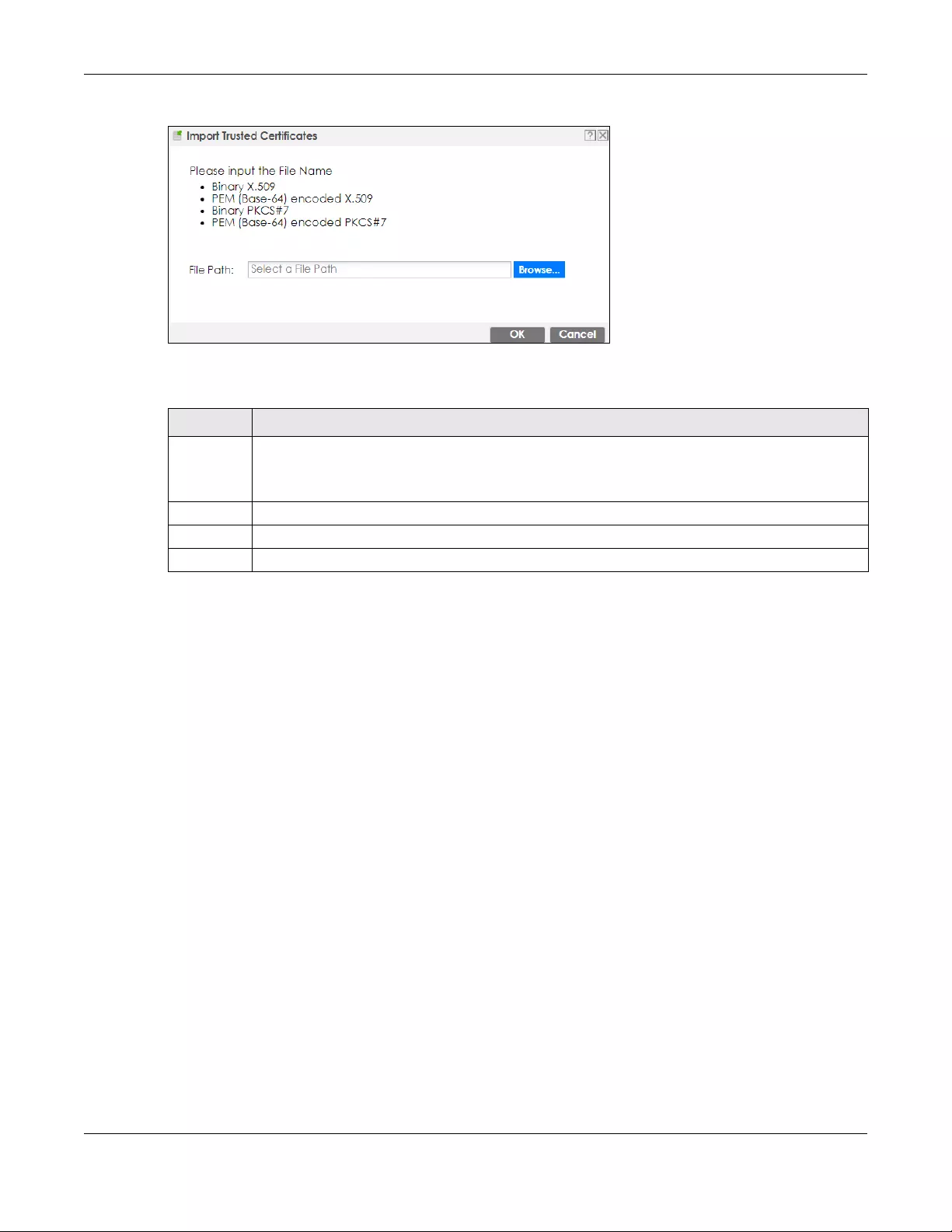
Chapter 39 Object
ZyWALL USG FLEX Series User’s Guide
819
Figure 539 Configuration > Object > Certificate > Trusted Certificates > Import
The following table describes the labels in this screen.
39.11.5 Certificates Technical Reference
OCSP
OCSP (Online Certificate Status Protocol) allows an application or device to check whether a certificate
is valid. With OCSP the Zyxel Device checks the status of individual certificates instead of downloading a
Certificate Revocation List (CRL). OCSP has two main advantages over a CRL. The first is real-time status
information. The second is a reduction in network traffic since the Zyxel Device only gets information on
the certificates that it needs to verify, not a huge list. When the Zyxel Device requests certificate status
information, the OCSP server returns a “expired”, “current” or “unknown” response.
39.12 ISP Account Overview
Use ISP accounts to manage Internet Service Provider (ISP) account information for PPPoE/PPTP/L2TP
interfaces. An ISP account is a profile of settings for Internet access using PPPoE, PPTP or L2TP.
Use the Object > ISP Account screens (Section 39.12.1 on page 819) to create and manage ISP
accounts in the Zyxel Device.
39.12.1 ISP Account Summary
This screen provides a summary of ISP accounts in the Zyxel Device. To access this screen, click
Configuration > Object > ISP Account.
Table 352 Configuration > Object > Certificate > Trusted Certificates > Import
LABEL DESCRIPTION
File Path Type in the location of the file you want to upload in this field or click Browse to find it.
You cannot import a certificate with the same name as a certificate that is already in the Zyxel
Device.
Browse Click Browse to find the certificate file you want to upload.
OK Click OK to save the certificate on the Zyxel Device.
Cancel Click Cancel to quit and return to the previous screen.
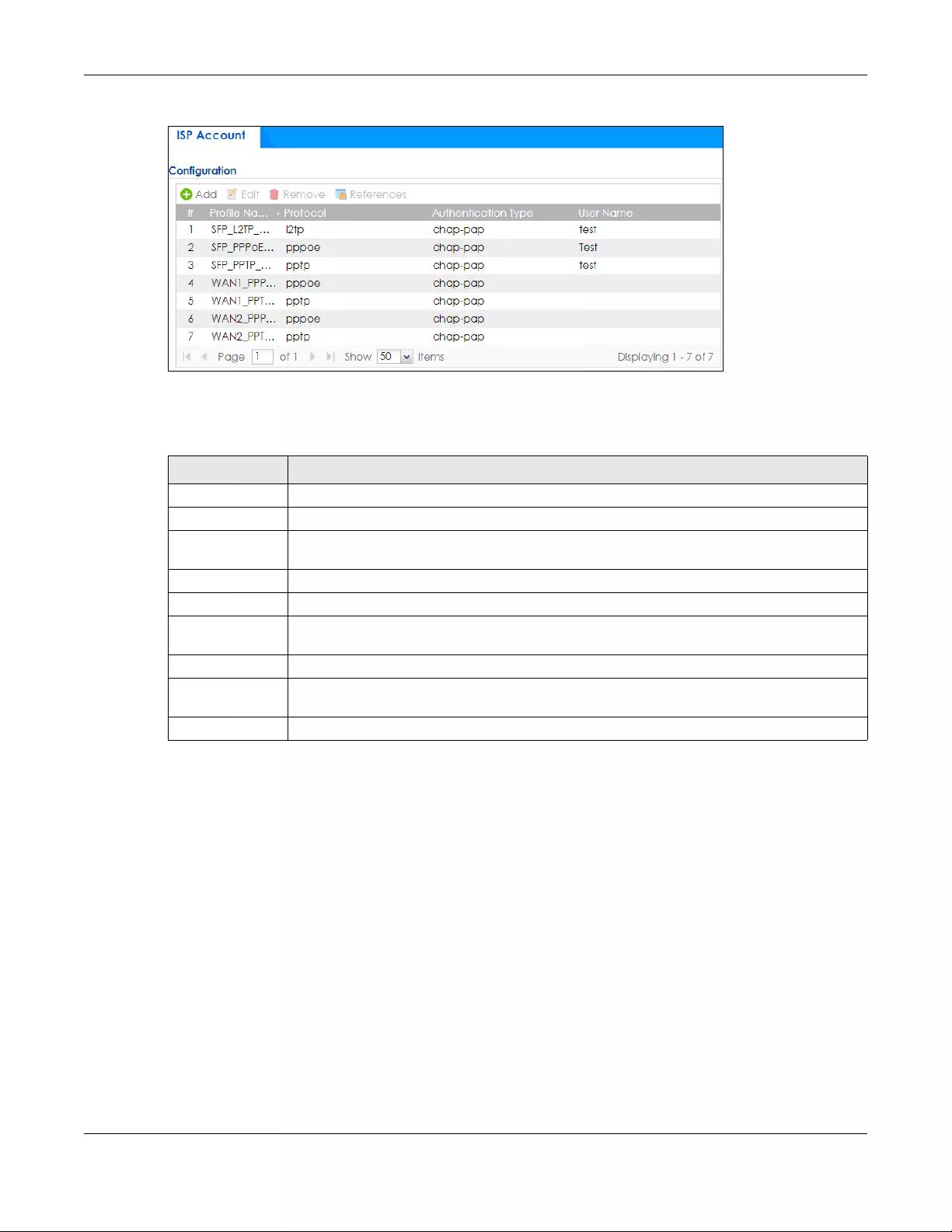
Chapter 39 Object
ZyWALL USG FLEX Series User’s Guide
820
Figure 540 Configuration > Object > ISP Account
The following table describes the labels in this screen. See the ISP Account Add/Edit section below for
more information as well.
39.12.1.1 ISP Account Add/Edit
The ISP Account Add/Edit screen lets you add information about new accounts and edit information
about existing accounts. To open this window, open the ISP Account screen. (See Section 39.12.1 on
page 819.) Then, click on an Add icon or Edit icon to open the ISP Account Edit screen below.
Table 353 Configuration > Object > ISP Account
LABEL DESCRIPTION
Add Click this to create a new entry.
Edit Double-click an entry or select it and click Edit to be able to modify the entry’s settings.
Remove To remove an entry, select it and click Remove. The Zyxel Device confirms you want to remove
it before doing so.
References Select an entry and click References to open a screen that shows which settings use the entry.
#This field is a sequential value, and it is not associated with a specific entry.
Profile Name This field displays the profile name of the ISP account. This name is used to identify the ISP
account.
Protocol This field displays the protocol used by the ISP account.
Authentication
Type
This field displays the authentication type used by the ISP account.
User Name This field displays the user name of the ISP account.

Chapter 39 Object
ZyWALL USG FLEX Series User’s Guide
821
Figure 541 Configuration > Object > ISP Account > Edit
The following table describes the labels in this screen.
Table 354 Configuration > Object > ISP Account > Edit
LABEL DESCRIPTION
Profile Name This field is read-only if you are editing an existing account. Type in the profile name of the ISP
account. The profile name is used to refer to the ISP account. You may use 1-31 alphanumeric
characters, underscores(_), or dashes (-), but the first character cannot be a number. This
value is case-sensitive.
Protocol This field is read-only if you are editing an existing account. Select the protocol used by the ISP
account. Your ISP will provide you with a related username, password and IP (server)
information. Options are:
pppoe - This ISP account uses the PPPoE protocol.
pptp - This ISP account uses the PPTP protocol.
l2tp - This ISP account uses the L2TP protocol.
Authentication
Type
Use the drop-down list box to select an authentication protocol for outgoing calls. Options are:
CHAP/PAP - Your Zyxel Device accepts either CHAP or PAP when requested by this remote
node.
Chap - Your Zyxel Device accepts CHAP only.
PAP - Your Zyxel Device accepts PAP only.
MSCHAP - Your Zyxel Device accepts MSCHAP only.
MSCHAP-V2 - Your Zyxel Device accepts MSCHAP-V2 only.
Encryption
Method
This field is available if this ISP account uses the PPTP protocol. Use the drop-down list box to
select the type of Microsoft Point-to-Point Encryption (MPPE). Options are:
nomppe - This ISP account does not use MPPE.
mppe-40 - This ISP account uses 40-bit MPPE.
mppe-128 - This ISP account uses 128-bit MMPE.
User Name Type the user name given to you by your ISP.

Chapter 39 Object
ZyWALL USG FLEX Series User’s Guide
822
39.13 DHCPv6 Overview
This section describes how to configure DHCPv6 request type and lease type objects.
• The Request screen (see Section 39.13.1 on page 822) allows you to configure DHCPv6 request type
objects.
• The Lease screen (see Section 39.2.5 on page 722) allows you to configure DHCPv6 lease type
objects.
39.13.1 The DHCPv6 Request Screen
The Request screen allows you to add, edit, and remove DHCPv6 request type objects. To access this
screen, login to the Web Configurator, and click Configuration > Object > DHCPv6 > Request.
Figure 542 Configuration > Object > DHCPv6 > Request
Password Type the password associated with the user name above. The password can only consist of
alphanumeric characters (A-Z, a-z, 0-9). This field can be blank.
Retype to
Confirm
Type your password again to make sure that you have entered is correctly.
IP Address/FQDN Enter the IP address or Fully-Qualified Domain Name (FQDN) of the PPTP or L2TP server.
Connection ID This field is available if this ISP account uses the PPTP protocol. Type your identification name for
the PPTP server. This field can be blank.
Service Name If this ISP account uses the PPPoE protocol, type the PPPoE service name to access. PPPoE uses
the specified service name to identify and reach the PPPoE server. This field can be blank.
If this ISP account uses the PPTP protocol, this field is not displayed.
Compression Select On button to turn on stac compression, and select Off to turn off stac compression. Stac
compression is a data compression technique capable of compressing data by a factor of
about four.
Idle Timeout This value specifies the number of seconds that must elapse without outbound traffic before
the Zyxel Device automatically disconnects from the PPPoE/PPTP server. This value must be an
integer between 0 and 360. If this value is zero, this timeout is disabled.
OK Click OK to save your changes back to the Zyxel Device. If there are no errors, the program
returns to the ISP Account screen. If there are errors, a message box explains the error, and the
program stays in the ISP Account Edit screen.
Cancel Click Cancel to return to the ISP Account screen without creating the profile (if it is new) or
saving any changes to the profile (if it already exists).
Table 354 Configuration > Object > ISP Account > Edit (continued)
LABEL DESCRIPTION
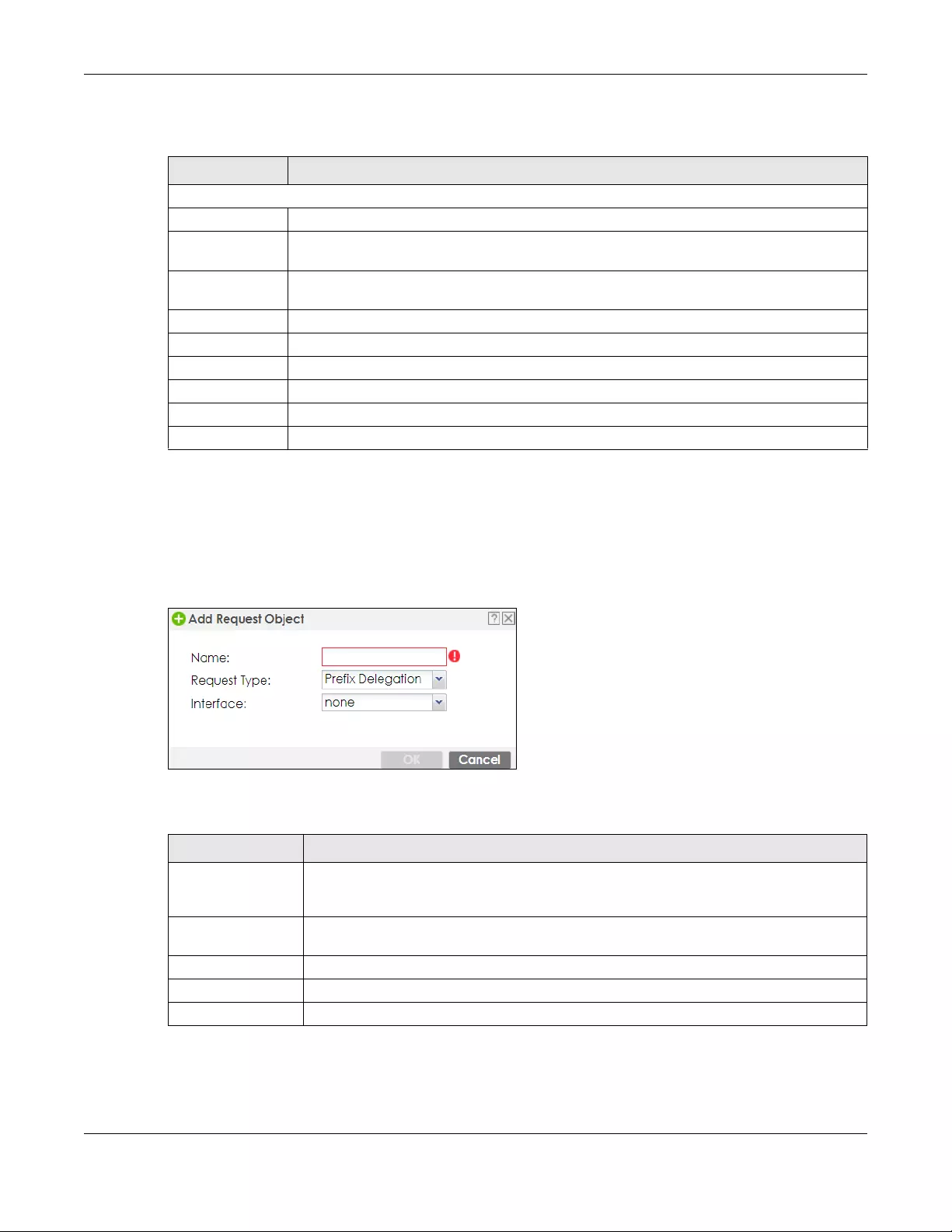
Chapter 39 Object
ZyWALL USG FLEX Series User’s Guide
823
The following table describes the labels in this screen.
39.13.1.1 DHCPv6 Request Add/Edit Screen
The Request Add/Edit screen allows you to create a new request object or edit an existing one.
To access this screen, go to the Request screen (see Section 39.13.1 on page 822), and click either the
Add icon or an Edit icon.
Figure 543 Configuration > DHCPv6 > Request > Add
The following table describes the labels in this screen.
Table 355 Configuration > Object > DHCPv6 > Request
LABEL DESCRIPTION
Configuration
Add Click this to create a new entry.
Edit Double-click an entry or select it and click Edit to open a screen where you can modify the
entry’s settings.
Remove To remove an entry, select it and click Remove. The Zyxel Device confirms you want to remove
it before doing so.
References Select an entry and click References to open a screen that shows which settings use the entry.
#This field is a sequential value, and it is not associated with a specific object.
Name This field displays the name of each request object.
Type This field displays the request type of each request object.
Interface This field displays the interface used for each request object.
Value This field displays the value for each request object.
Table 356 Configuration > DHCPv6 > Request > Add
LABEL DESCRIPTION
Name Type the name for this request object. You may use 1-31 alphanumeric characters,
underscores(_), or dashes (-), but the first character cannot be a number. This value is case-
sensitive.
Request Type Select the request type for this request object. You can choose from Prefix Delegation, DNS
Server, NTP Server, or SIP Server.
Interface Select the interface for this request object.
OK Click OK to save your changes back to the Zyxel Device.
Cancel Click Cancel to exit this screen without saving your changes.
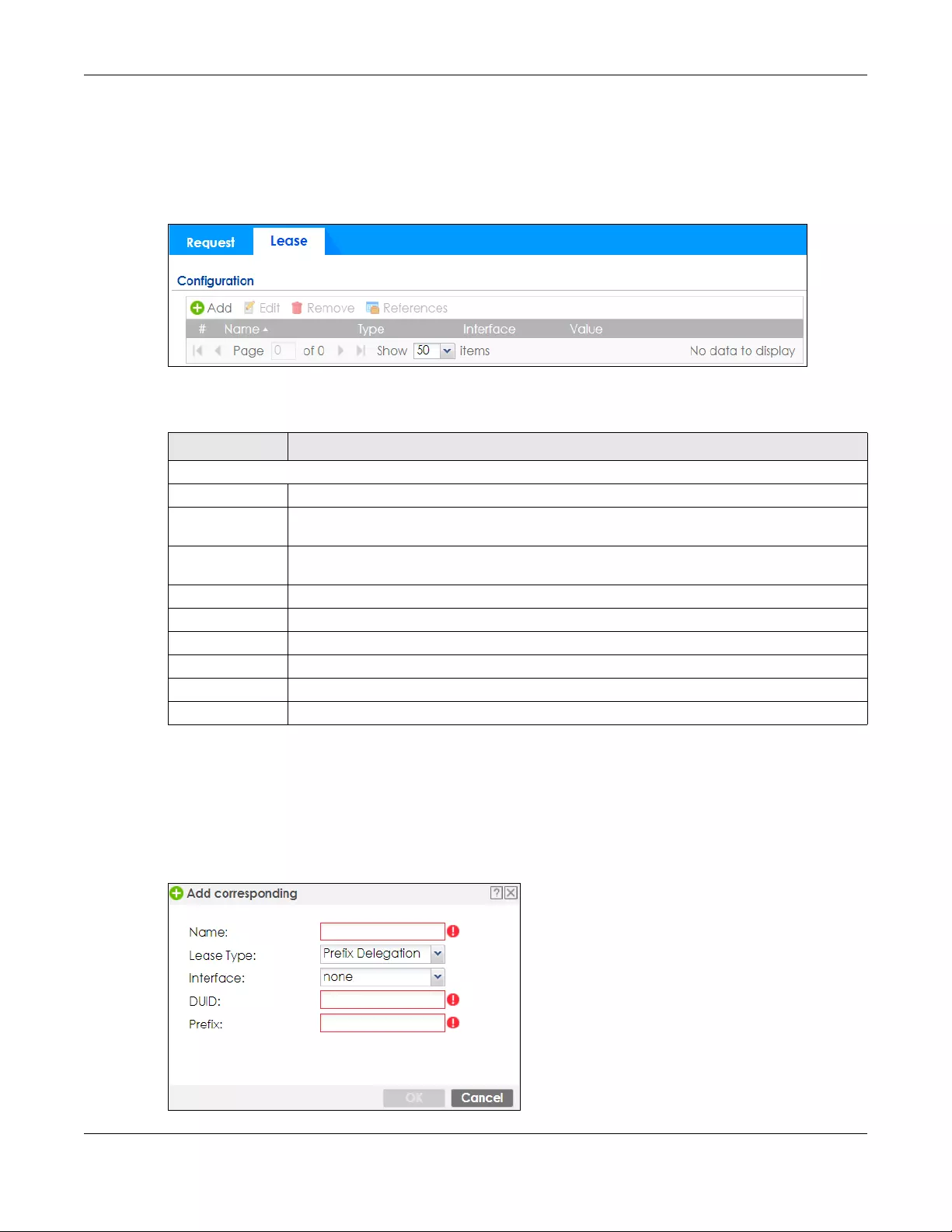
Chapter 39 Object
ZyWALL USG FLEX Series User’s Guide
824
39.13.2 The DHCPv6 Lease Screen
The Lease screen allows you to add, edit, and remove DHCPv6 lease type objects. To access this screen,
login to the Web Configurator, and click Configuration > Object > DHCPv6 > Lease.
Figure 544 Configuration > Object > DHCPv6 > Lease
The following table describes the labels in this screen.
39.13.2.1 DHCPv6 Lease Add/Edit Screen
The Lease Add/Edit screen allows you to create a new lease object or edit an existing one.
To access this screen, go to the Lease screen (see Section 39.13.2 on page 824), and click either the
Add icon or an Edit icon.
Figure 545 Configuration > DHCPv6 > Lease > Add
Table 357 Configuration > Object > DHCPv6 > Lease
LABEL DESCRIPTION
Configuration
Add Click this to create a new entry.
Edit Double-click an entry or select it and click Edit to open a screen where you can modify the
entry’s settings.
Remove To remove an entry, select it and click Remove. The Zyxel Device confirms you want to remove
it before doing so.
References Select an entry and click References to open a screen that shows which settings use the entry.
#This field is a sequential value, and it is not associated with a specific object.
Name This field displays the name of each lease object.
Type This field displays the request type of each lease object.
Interface This field displays the interface used for each lease object.
Value This field displays the value for each lease object.

Chapter 39 Object
ZyWALL USG FLEX Series User’s Guide
825
The following table describes the labels in this screen.
Table 358 Configuration > DHCPv6 > Lease > Add/Edit
LABEL DESCRIPTION
Name Type the name for this lease object. You may use 1-31 alphanumeric characters,
underscores(_), or dashes (-), but the first character cannot be a number. This value is case-
sensitive.
Lease Type Select the lease type for this lease object. You can choose from Prefix Delegation, DNS
Server, Address, Address Pool, NTP Server, or SIP Server.
Interface Select the interface for this lease object.
DUID If you select Prefix Delegation or Address in the Lease Type field, enter the DUID of the
interface.
Address If you select Address in the Lease Type field, enter the IP address of the DHCPv6 server.
Prefix If you select Prefix Delegation or Address in the Lease Type field, enter the IPv6 prefix of the
interface.
DNS Server If you select DNS Server in the Lease Type field, select a request object or User Defined in the
DNS Server field and enter the IP address of the DNS server in the User Defined Address field
below.
Starting IP Address If you select Address Pool in the Lease Type field, enter the first of the contiguous addresses
in the IP address pool.
End IP Address If you select Address Pool in the Lease Type field, enter the last of the contiguous addresses
in the IP address pool.
NTP Server If you select NTP Serv er in the Lease Type field, select a request object or User Defined in the
NTP Server field and enter the IP address of the NTP server in the User Defined Address field
below.
SIP Server If you select SIP Server in the Lease Type field, select a request object or User Defined in the
SIP field and enter the IP address of the SIP server in the User Defined Address field below.
User Defined
Address
If you select DNS Server, NTP Server, or SIP Server as your lease type, you must enter the IP
address of the server your selected.
OK Click OK to save your changes back to the Zyxel Device.
Cancel Click Cancel to exit this screen without saving your changes.
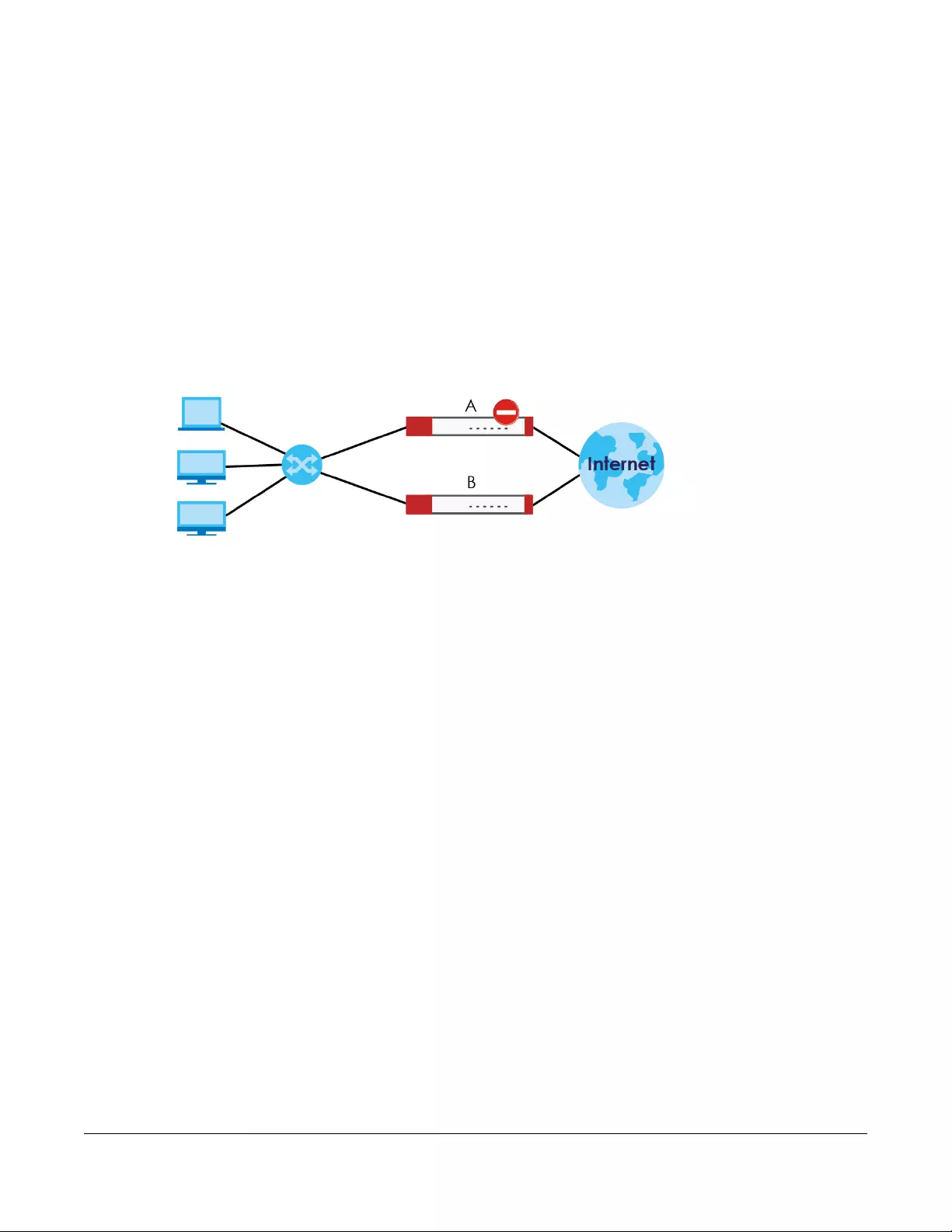
ZyWALL USG FLEX Series User’s Guide
826
CHAPTER 40
Device HA
40.1 Device HA Overview
Device HA lets a backup (or passive) Zyxel Device (B) automatically take over if the master (or active)
Zyxel Device (A) fails.
Figure 546 Device HA Backup Taking Over for the Master
40.1.1 What You Can Do in These Screens
• Use the Device HA Status screen (Section 40.2 on page 826) to see the license status for Device HA
Pro, and see the status of the active and passive devices.
• Use the Device HA Pro screen (Section 40.3 on page 828) to configure Device HA Pro global settings,
monitored interfaces and synchronization settings.
• Use the View Log screen (Section 40.4 on page 831) to see logs of the active and passive devices.
40.2 Device HA Status
Use this screen to view Device HA Pro license status and details on the active and passive Zyxel Devices.
Go to Configuration > Device HA > Device HA Status to view the following screen.

Chapter 40 Device HA
ZyWALL USG FLEX Series User’s Guide
827
Figure 547 Configuration > Device HA > Device HA Status
The following table describes the labels in this screen.
Table 359 Configuration > Device HA > Device HA Status
LABEL DESCRIPTION
Active Device Status This section displays information on the active Zyxel Device with an activated Device
HA Pro license.
Health Status This displays Off or On depending on whether Device HA Pro is disabled or enabled
on the active Zyxel Device.
S/N This displays the serial number of the active Zyxel Device.
Virtual MAC This displays the hardware MAC address of the active Zyxel Device with an
activated Device HA Pro license.
Synch Status This displays the synchronization progress, No Progress / Fail / Abort / Success / In
Progress, between the active Zyxel Device with an activated Device HA Pro license
and the passive Zyxel Device.
Passive Device Status This section displays information on the passive Zyxel Device with an activated
Device HA Pro license.
Health Status This displays Off or On depending on whether Device HA Pro is disabled or enabled
on the passive Zyxel Device.
S/N This displays the serial number of the passive Zyxel Device.
Virtual MAC This displays the hardware MAC address of the passive Zyxel Device.
Synch Status This displays the synchronization progress, No Progress / Fail / Abort / Success / In
Progress, between the passive Zyxel Device with an activated Device HA Pro license
and the active Zyxel Device.
Device HA Pro License These are the steps to activate a Device HA Pro license on your active and passive
Zyxel Devices.
1. See your Device HA Pro iCard. The card contains two keys.
2. Register your active and passive Zyxel Devices at myZyxel.
3. Activate the license by entering one key on the active Zyxel Device and the
other key on the passive Zyxel Device. It doesn’t matter which Zyxel Device is
actually active or passive as this is dynamic in Device HA Pro.
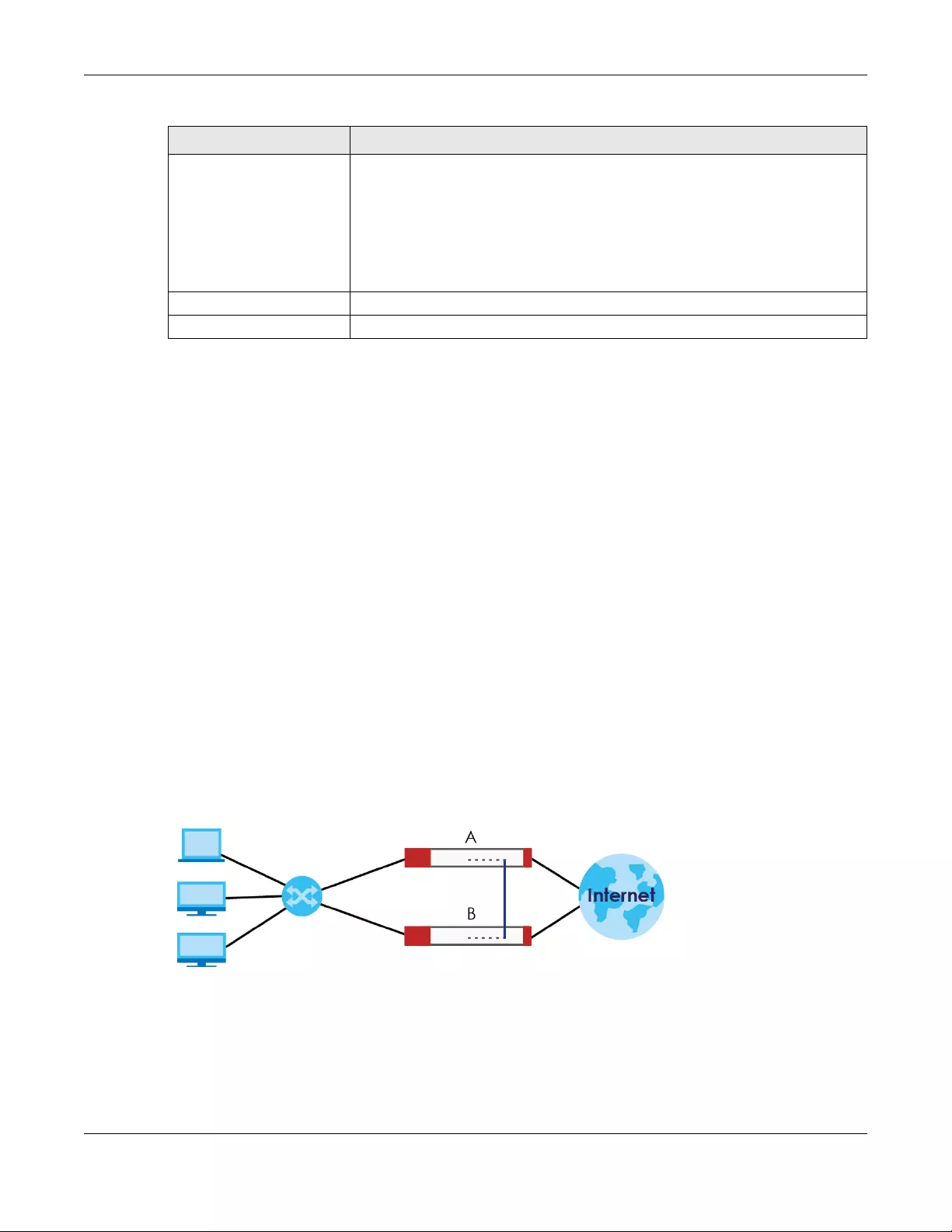
Chapter 40 Device HA
ZyWALL USG FLEX Series User’s Guide
828
40.3 Device HA Pro
You need a license to use Device HA Pro. Device HA Pro is easier to deploy than Device HA, is more
reliable (no risk of overloading), and faster (Device HA causes a connection break of 10~30 seconds
while Device HA Pro just has 1~2 seconds). In addition to configuration file backup in Device HA, device
time, TCP sessions (IPv4/IPv6), IPSec VPN sessions, login/logout information, DHCP table, IP/MAC binding
table and license status can also be backed up using Device HA Pro.
Active and Passive Devices
Device HA Pro uses a dedicated heartbeat link between an active device (‘master’) and a passive
device (‘backup’) for status syncing and backup to the passive device. On the passive device, all ports
are disabled except for the port with the heartbeat link.
In the following example, Zyxel Device A is the active device that is connected to passive device Zyxel
Device B via a dedicated link that is used for heartbeat control, configuration synchronization and
troubleshooting. All links on Zyxel Device B are down except for the dedicated heartbeat link.
Note: The dedicated heartbeat link port must be the highest-numbered copper Ethernet port
on each Zyxel Device for Device HA Pro to work.
Figure 548 Device HA Pro
Failover from the active Zyxel Device to the passive Zyxel Device is activated when:
• A monitored interface is down.
• A monitored service (daemon) is down.
• The heartbeat link exceeds the failure tolerance.
Service Status This field displays whether a service license is enabled at myZyxel (Activated) or not
(Not Activated) or expired (Expired). It displays the remaining Grace Period if your
license has Expired. It displays Not Licensed if there isn’t a license to be activated for
this service.
If you need a license or a trial license has expired, click Buy to buy a new one. If a
Standard license has expired, click Renew to extend the license.
Then, click Activate to connect with the myZyxel server to activate the new license.
Apply Click Apply to save your changes back to the Zyxel Device.
Reset Click Reset to return the screen to its last-saved settings.
Table 359 Configuration > Device HA > Device HA Status (continued)
LABEL DESCRIPTION

Chapter 40 Device HA
ZyWALL USG FLEX Series User’s Guide
829
After failover, the initial active Zyxel Device becomes the passive Zyxel Device after it recovers.
40.3.1 Deploying Device HA Pro
1Register either the active or passive Zyxel Device with a Device HA Pro license at myZyxel. Check that it’s
properly licensed in Licensing > Registration > Service in the active Zyxel Device.
2Make sure the passive Zyxel Device is offline, then enable Device HA in Device HA > General in the
passive Zyxel Device.
3Must make sure the FTP port in System > FTP (default 21) is the same on both Zyxel Devices. FTP is used for
transferring files in the event of failover from active to passive Zyxel Device.
4Connect the passive Zyxel Device to the active Zyxel Device using the highest-numbered copper
Ethernet ports on both Zyxel Devices. This is the heartbeat interface. Make sure that this interface is not
already configured for other features such as LAG, VLAN, Bridge.
5If both Zyxel Devices are turned on at the same time with Device HA enabled, then they may send the
heartbeat at the same time. In this case, the Zyxel Device with the bigger MAC address becomes the
passive Zyxel Device.
6When using Device HA Pro to synchronize firmware, the location of the running firmware must be the
same in both active and passive Zyxel Devices. For example, if the running firmware is in partition 1 in the
active Zyxel Device (standby firmware in partition 2), then the running firmware must also be in partition
1 in the passive Zyxel Device (standby firmware in partition 2).
40.3.2 Configuring Device HA Pro
Go to Configuration > Device HA > Device HA Pro and configure the following screen.

Chapter 40 Device HA
ZyWALL USG FLEX Series User’s Guide
830
Figure 549 Configuration > Device HA > Device HA Pro
The following table describes the labels in this screen.
Table 360 Configuration > Device HA > Device HA Pro
LABEL DESCRIPTION
Enable Device HA Select this to turn the Zyxel Device’s Device HA Pro feature on.
Enable Configuration
Provisioning From Active
Device.
Select this to have a passive Zyxel Device copy the active Zyxel Device’s
configuration, signatures (anti-malware, IDP/application patrol, URL Threat filter, and
IP reputation), and certificates.
Note: Only Zyxel Devices of the same model and firmware version can
synchronize.
Serial Number of Licensed
Device for License
Synchronization
Type the serial number of the Zyxel Device (active or passive) with the Device HA Pro
subscribed license.
Active Device
Management IP
Type the IPv4 address of the highest-numbered copper Ethernet port on the active
Zyxel Device (the heartbeat dedicated link port).
Passive Device
Management IP
Type the IPv4 address of the highest-numbered copper Ethernet port on the passive
Zyxel Device (the heartbeat dedicated link port).
Note: The active and passive Zyxel Device Management IP addresses must
be in the same subnet.
Subnet Mask Type the subnet mask for the management IP addresses.

Chapter 40 Device HA
ZyWALL USG FLEX Series User’s Guide
831
40.4 View Log
Use this screen to see Device HA Pro logs on the active and passive Zyxel Devices.
Go to Configuration > Device HA > View Log to display the following screen.
Password Type a synchronization password of between 1 and 32 single-byte printable
characters. You will be prompted for the password before synchronization takes
place.
Retype to Confirm Type the exact same synchronization password as typed above.
Heartbeat Interval Type the number of seconds (1-10) allowed for absence of a heartbeat signal
before a failure of the active Zyxel Device is recorded.
Heartbeat Lost Tolerance Type the number of heartbeat failures allowed before failover is activated on the
passive Zyxel Device.
Monitor Interface Select an interface in Available Interfaces and click the right-arrow button to move
it to Monitor Interface to become a Device HA pro monitored interface. To remove
a Device HA pro monitored interface, select it in Monitor Interface and click the left-
arrow button to move it to Available Interfaces.
Failover Detection
Enable Failover When
Interface Failure
(Option)
Select this to have the passive Zyxel Device take over when a monitored interface
fails.
Enable Failover When
Device Service Fails
(Option)
Select this to have the passive Zyxel Device take over when a monitored service
daemon on the active Zyxel Device fails.
Apply Click Apply to save your Device HA Pro configurations back to the Zyxel Device but
keep the Zyxel Device using Device HA (general).
Reset Click Reset to return the screen to its last-saved settings.
Table 360 Configuration > Device HA > Device HA Pro (continued)
LABEL DESCRIPTION

Chapter 40 Device HA
ZyWALL USG FLEX Series User’s Guide
832
Figure 550 Configuration > Device HA > View Log
The following table describes the labels in this screen.
Table 361 Configuration > Device HA > View Log
LABEL DESCRIPTION
Logs
Active Device This displays Device HA Pro logs on the active Zyxel Device.
Passive Device This displays Device HA Pro logs on the passive Zyxel Device.
Refresh Click Refresh to update information in this screen.

ZyWALL USG FLEX Series User’s Guide
833
CHAPTER 41
Cloud CNM
41.1 Cloud CNM Overview
You need licenses to use Cloud CNM SecuManager and Cloud CNM SecuReporter. You need the
SecuManager license to get a CNM ID with which you can access the SecuManager server. It is
independent from the Zyxel Devices. The SecuReporter license must be activated on each Zyxel Device.
41.1.1 What You Can Do in this Chapter
• Use the Cloud CNM > SecuManager screen (Section 41.2 on page 833) to enable and configure
management of the Zyxel Device by a Central Network Management system.
• Use the Cloud CNM > SecuReporter screen (Section 41.3 on page 836) to enable SecuReporter
logging on your Zyxel Device, see license status, type, expiration date and access a link to the
SecuReporter web portal. The SecuReporter web portal collects and analyzes logs from your Zyxel
Device in order to identify anomalies, alert on potential internal / external threats, and report on
network usage.
41.2 Cloud CNM SecuManager
Cloud CNM SecuManager is a Virtual Machine-based (VM) management system that uses the TR-069
protocol to encapsulate commands to ZyWALL/USG devices for management and monitoring; these
devices must have firmware that supports the TR-069 protocol.
In the following figure, SP is the management service provider, while A and B are sites with devices being
managed by SP.
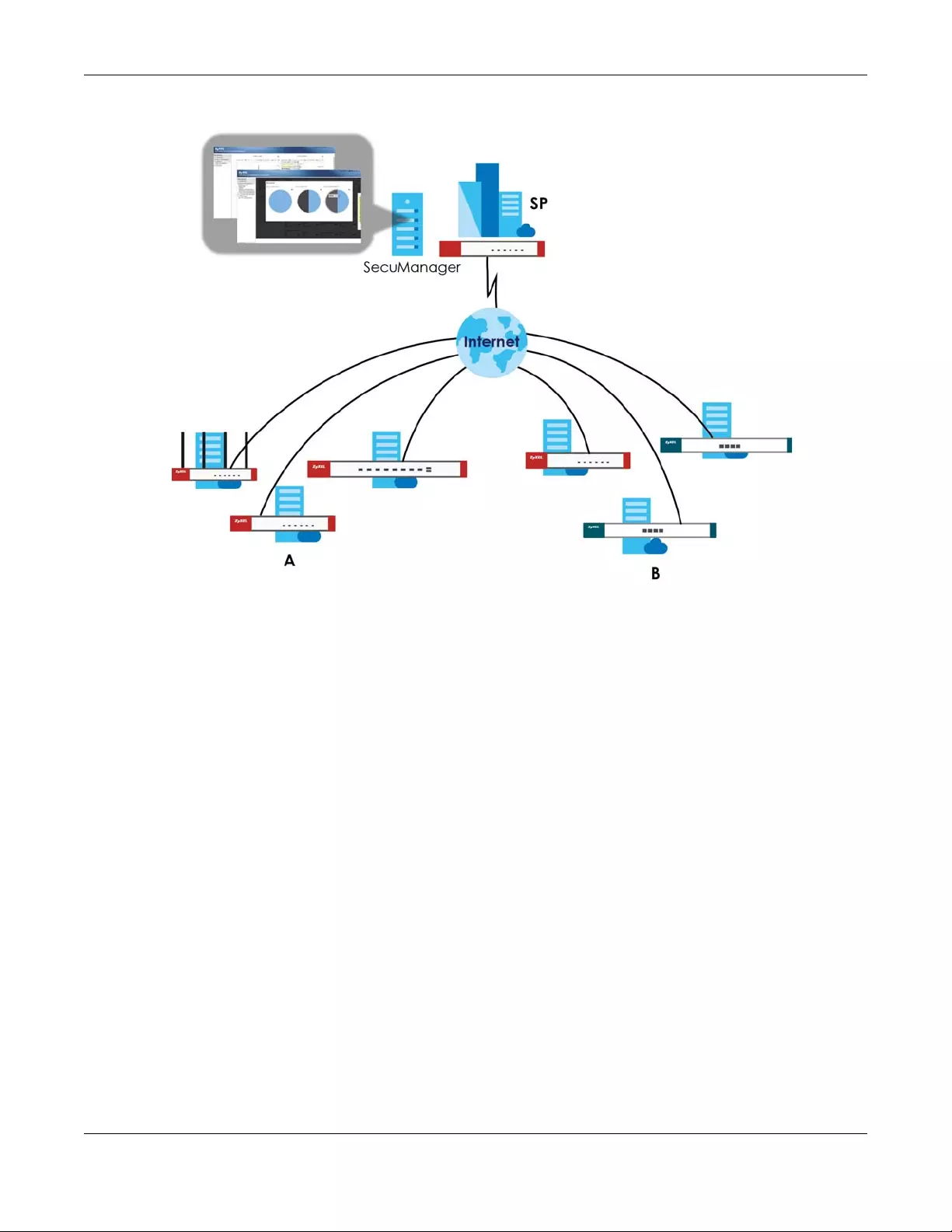
Chapter 41 Cloud CNM
ZyWALL USG FLEX Series User’s Guide
834
Figure 551 Cloud CNM SecuManager Example Network Topology
Cloud CNM SecuManager features include:
• Batch import of managed devices at one time using one CSV file
• See an overview of all managed devices and system information in one place
• Monitor and manage devices
• Install firmware to multiple devices of the same model at one time
• Backup and restore device configuration
• View the location of managed devices on a map
• Receive notification for events and alarms, such as when a device goes down
• Graphically monitor individual devices and see related statistics
• Directly access a device for remote configuration
• Create four types of administrators with different privileges
• Perform Site-to-Site, Hub & Spoke, Fully-meshed and Remote Access VPN provisioning.
To allow Cloud CNM SecuManager management of your Zyxel Device:
• You must have a Cloud CNM SecuManager license with CNM ID number or a Cloud CNM
SecuManager server URL.
• The Zyxel Device must be able to communicate with the Cloud CNM SecuManager server.
You must configure Configuration > Cloud CNM > SecuManager to allow the Zyxel Device to find the
Cloud CNM SecuManager server.
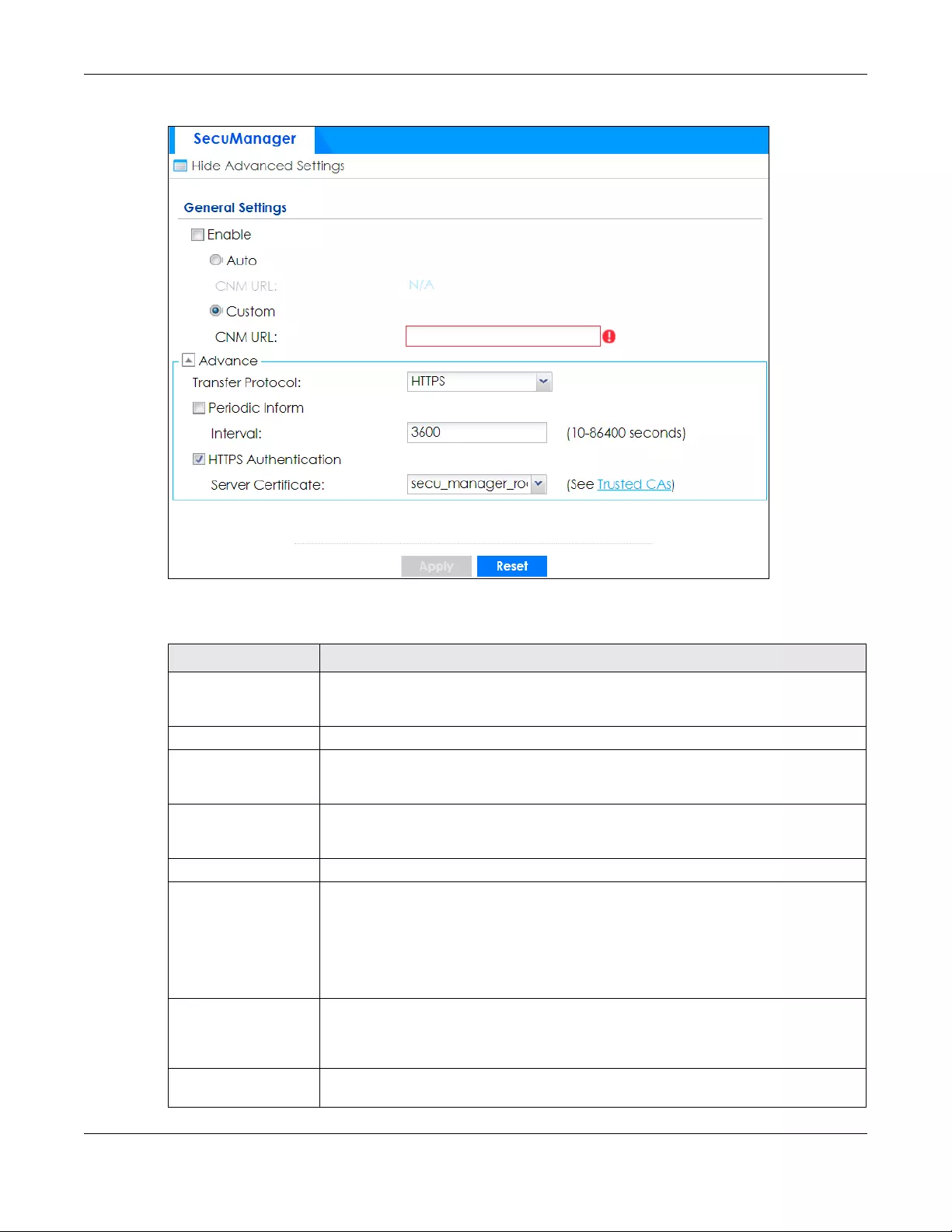
Chapter 41 Cloud CNM
ZyWALL USG FLEX Series User’s Guide
835
Figure 552 Configuration > Cloud CNM > SecuManager
The following table describes the labels in this screen.
Table 362 Configuration > Cloud CNM > SecuManager
LABEL DESCRIPTION
Show Advanced
Settings / Hide
Advanced Settings
Click this button to display a greater or lesser number of configuration fields.
Enable Select this to allow management of the Zyxel Device by Cloud CNM SecuManager.
Auto Select this if your Cloud CNM SecuManager server can access myZyxel to automatically
get the VM server URL from myZyxel. You also need CNM ID from the Cloud CNM
SecuManager license.
CNM URL myZyxel associates the CNM ID with the CNM URL which identifies the server on which
Cloud CNM SecuManager is installed. Therefore you don’t need to enter the CNM URL
when you select Auto.
Custom Select this if your Cloud CNM SecuManager server cannot access myZyxel.
CNM URL Select this if your VM server or Zyxel Device are in a private network, or if the VM server is
behind a NAT router. You then need to manually enter the VM server URL into the Zyxel
Device. Enter the IPv4 IP address of the Cloud CNM SecuManager server followed by the
port number (default 7547 for HTTPS or 7549 for HTPP) followed by the CNM ID from the
license in CNM URL. For example, if you installed Cloud CNM SecuManager on a server
with IP address 1.1.1.1 and CNM ID V6ABQNTPYGD, then type 1.1.1.1:7547/
V6ABQNTPYG or 1.1.1.1:7549/V6ABQNTPYG as the CNM URL.
Transfer Protocol Choose the CNM URL protocol: HTTP or HTTPS. If you enter 1.1.1.1:7547 as the CNM URL,
you must choose HTTPS as the Transfer Protocol, and then the whole CNM URL is https://
1.1.1.1:7547. If you enter 1.1.1.1:7549 as the CNM URL, you must choose HTTP as the
Transfer Protocol, and then the whole CNM URL is http://1.1.1.1:7549.
Periodic Inform Enable this to have the Zyxel Device inform the Cloud CNM SecuManager server of its
presence at regular intervals.

Chapter 41 Cloud CNM
ZyWALL USG FLEX Series User’s Guide
836
Note: See the Cloud CNM SecuManager User’s Guide for more information on Cloud CNM
SecuManager.
41.3 Cloud CNM SecuReporter
Cloud CNM SecuReporter is a security analytics portal that collects and analyzes logs from
SecuReporter-licensed Zyxel Devices in order to identify anomalies, alert on potential internal / external
threats, and report on network usage. You need to buy a license for SecuReporter for your Zyxel Device
and register it at myZyxel. You must be a registered user at myZyxel.
You can access the portal from a web browser and also get notifications sent to an app on your mobile
phone.
Interval Type how often the Zyxel Device should inform Cloud CNM SecuManager server of its
presence.
HTTPS Authentication Select the check box if you have a HTTPs server certificate.
Server Certificate Select a certificate the HTTPS server (the Zyxel Device) uses to authenticate itself to the
HTTPS client.
Apply Click Apply to save your changes back to the Zyxel Device.
Reset Click Reset to return the screen to its last-saved settings.
Table 362 Configuration > Cloud CNM > SecuManager (continued)
LABEL DESCRIPTION

Chapter 41 Cloud CNM
ZyWALL USG FLEX Series User’s Guide
837
Figure 553 Cloud CNM SecuReporter Application Scenario
How to activate and enable SecuReporter
1Does Service Status displays Activated in the Configuration > Cloud CNM > SecuReporter screen? If not,
you have to log in to myZyxel.com and activate the SecuReporter license for this Zyxel Device. The Zyxel
Device must be able to communicate with the myZyxel server.
Your SecuReporter license displays in Configuration > Licensing > Registration > Service after you
activate the SecuReporter license at myZyxel.
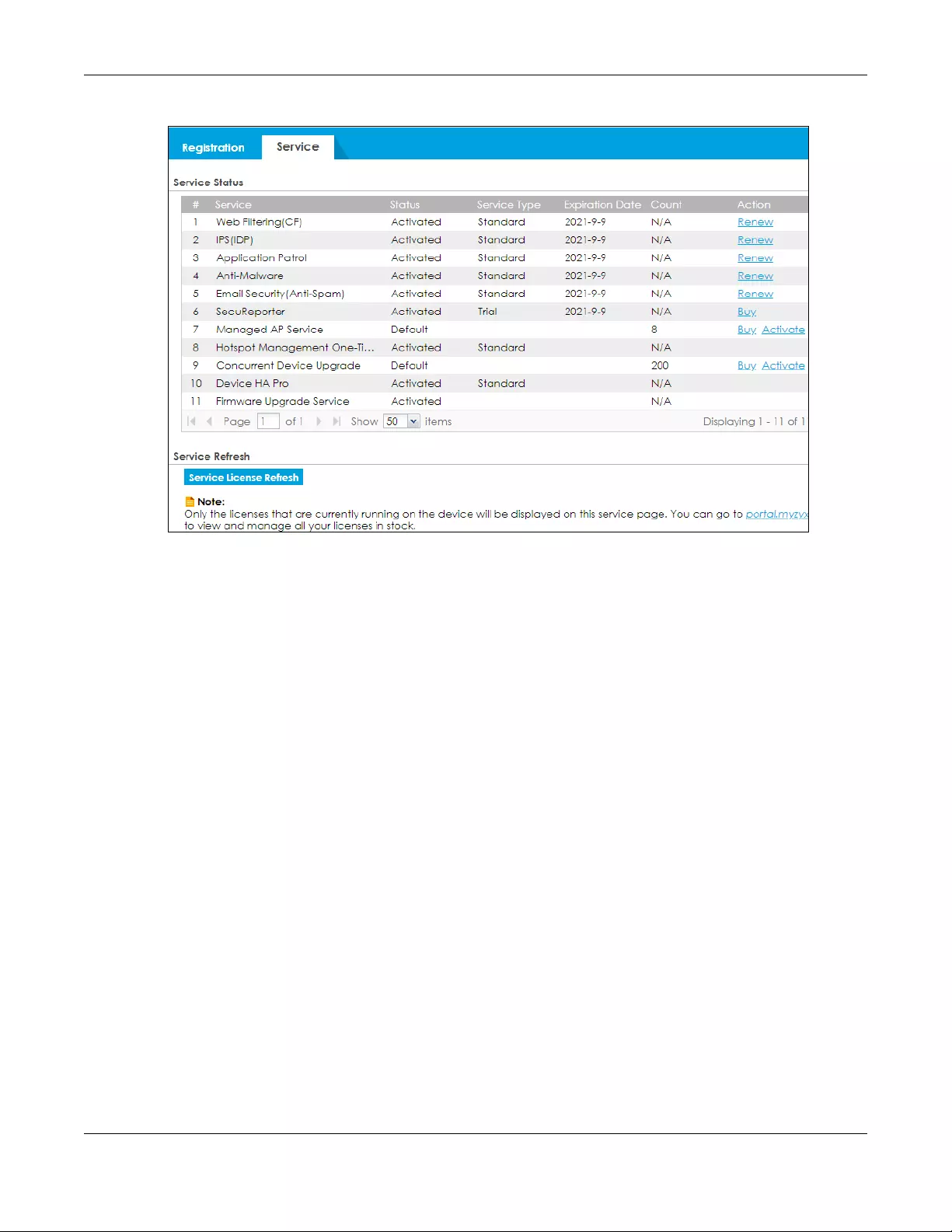
Chapter 41 Cloud CNM
ZyWALL USG FLEX Series User’s Guide
838
Figure 554 Configuration > Licensing > Registration > Service
2After the SecuReporter license is activated, go back to the Configuration > Cloud CNM > SecuReporter
screen, and select the categories of logs that you want this Zyxel Device to send to the SecuReporter
portal.
3Select Enable SecuReporter. Do not go to the SecuReporter portal until after you have enabled
SecuReporter on this Zyxel Device and applied the settings. You can also see license status, type,
expiration date.
4Click Apply and wait.
How to add this Zyxel Device to SecuReporter
1Log in to the SecuReporter portal.
2Go to Settings > Organization & Devices > Add to create an organization.
3Add this Zyxel Device to an Organization using the hyper link under Unclaimed Device.
SecuReporter Banner
The SecuReporter banner appears when:
1SecuReporter hasn’t been enabled before.
2The Zyxel Device is not added to an organization yet.
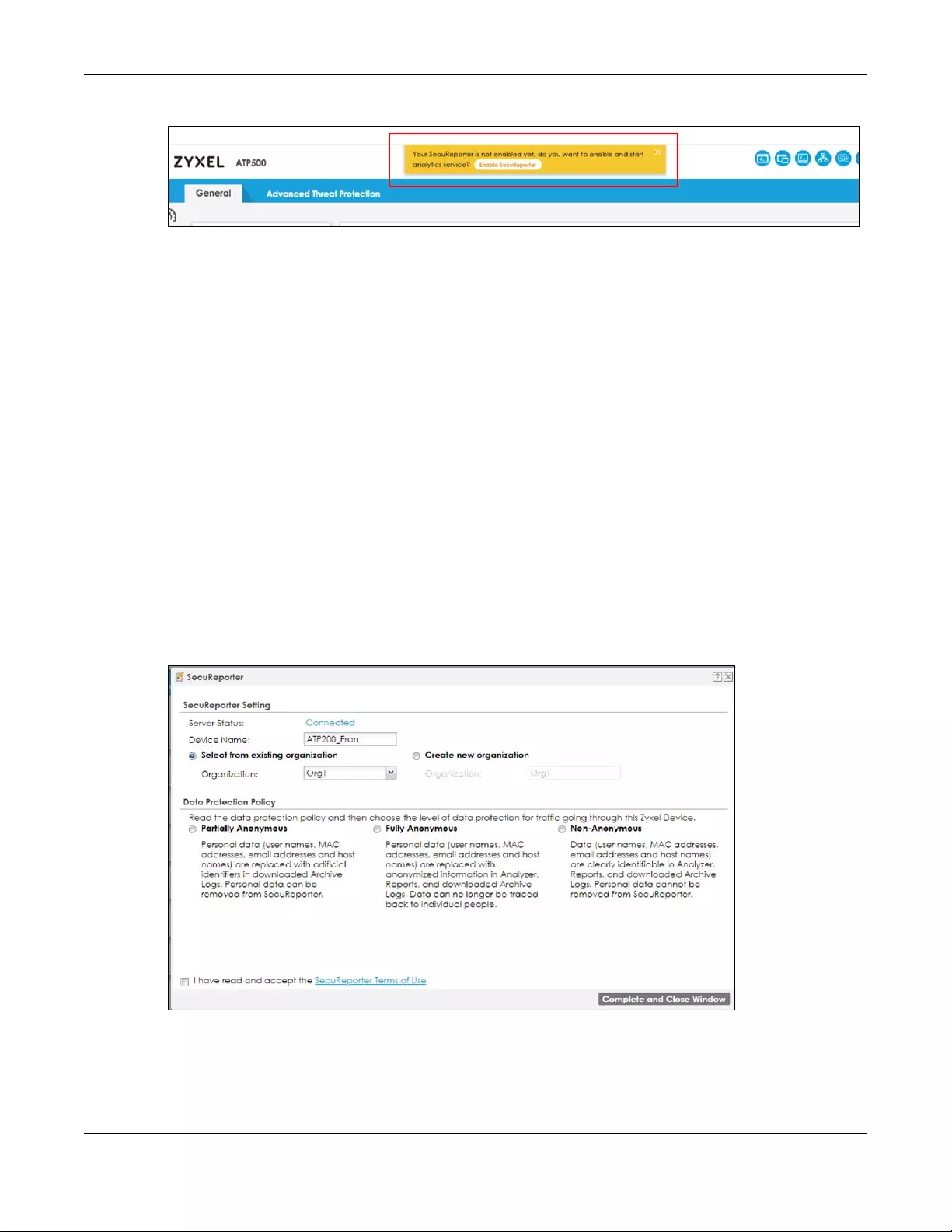
Chapter 41 Cloud CNM
ZyWALL USG FLEX Series User’s Guide
839
Figure 555 SecuReporter Banner
Click the Continue button in the SecuReporter banner to configure the SecuReporter settings.
•Server Status: This is the connection status between the Zyxel Device and the SecuReporter server. This
field shows Connected when the Zyxel Device can synchronize with the SecuReporter server. This field
shows Timeout when the Zyxel Device can’t synchronize with the SecuReporter server. This field shows
Fail when the connection between the Zyxel Device and the SecuReporter server is down.
•Device Name: Enter the name of the Zyxel Device. This Zyxel Device will be added to a new or existing
organization.
•Organization: This field appears if you haven’t created an organization in the SecuReporter server.
Type a name of up to 255 characters and description to create a new organization.
•Select from existing organization: Select an existing organization from the drop-down list box to add
the Zyxel Device to the selected organization.
•Create new organization: Type a name of up to 255 characters and description to create a new
organization.
•Partially Anonymous: Select this and personal data, such as user names, MAC addresses, email
addresses, and host names, will be replaced with artificial identifiers in downloaded logs.
•Fully Anonymous: Select this and personal data, such as user names, MAC addresses, email
addresses, and host names, will be replaced with anonymized information in downloaded logs.
•Non-Anonymous: Select this and personal data, such as user names, MAC addresses, email
addresses, and host names, will be identifiable in downloaded logs.
Figure 556 SecuReporter Banner Settings
Click Configuration > Cloud CNM > SecuReporter to open the following screen.
Figure 557

Chapter 41 Cloud CNM
ZyWALL USG FLEX Series User’s Guide
840
Figure 558 Configuration > Cloud CNM > SecuReporter
The following table describes the labels in this screen.
Table 363 Configuration > Cloud CNM > SecuReporter
LABEL DESCRIPTION
Enable SecuReporter Security-related logs are sent to the SecuReporter portal. Click the General Data
Protection Regulation (GDPR) privacy link below to see the Zyxel privacy policy.
This must be selected to have SecuReporter collect and analyze logs from this Zyxel
Device.
• It’s selected by default if you have activated a SecuReporter Standard license,
• You need to select this if you have a SecuReporter Trial license.
• This field is not available if you do not have a SecuReporter license.
Categories Select the categories of logs that you want this Zyxel Device to send to SecuReporter for
analysis and trend spotting.
SecuReporter Service License Status
Service Status This field displays whether a service license is enabled at myZyxel (Activated) or not (Not
Activated) or expired (Expired). It displays the remaining Grace Period if your license has
Expired. It displays Not Licensed if there isn’t a license to be activated for this service.
Service Type This field displays whether you applied for a trial application (Trial) or registered this
service with your iCard’s PIN number (Standard). This field is blank when the service is not
activated.
Expiration Date This field displays the date your service expires.
Apply Click Apply to save your changes back to the Zyxel Device.
Reset Click Reset to return the screen to its last-saved settings.

ZyWALL USG FLEX Series User’s Guide
841
CHAPTER 42
System
42.1 Overview
Use the system screens to configure general Zyxel Device settings.
42.1.1 What You Can Do in this Chapter
• Use the System > Host Name screen (see Section 42.2 on page 842) to configure a unique name for
the Zyxel Device in your network.
• Use the System > USB Storage screen (see Section 42.3 on page 842) to configure the settings for the
connected USB devices.
• Use the System > Date/Time screen (see Section 42.4 on page 843) to configure the date and time for
the Zyxel Device.
• Use the System > Console Speed screen (see Section 42.5 on page 847) to configure the console port
speed when you connect to the Zyxel Device via the console port using a terminal emulation
program.
• Use the System > DNS screen (see Section 42.6 on page 848) to configure the DNS (Domain Name
System) server used for mapping a domain name to its corresponding IP address and vice versa.
• Use the System > WWW screens (see Section 42.7 on page 858) to configure settings for HTTP or HTTPS
access to the Zyxel Device and how the login and access user screens look.
• Use the System > SSH screen (see Section 42.8 on page 875) to configure SSH (Secure SHell) used to
securely access the Zyxel Device’s command line interface. You can specify which zones allow SSH
access and from which IP address the access can come.
• Use the System > TELNET screen (see Section 42.9 on page 879) to configure Telnet to access the Zyxel
Device’s command line interface. Specify which zones allow Telnet access and from which IP address
the access can come.
• Use the System > FTP screen (see Section 42.10 on page 881) to specify from which zones FTP can be
used to access the Zyxel Device. You can also specify from which IP addresses the access can come.
You can upload and download the Zyxel Device’s firmware and configuration files using FTP.
• Your Zyxel Device can act as an SNMP agent, which allows a manager station to manage and
monitor the Zyxel Device through the network. Use the System > SNMP screen (see Section 42.11 on
page 883) to configure SNMP settings, including from which zones SNMP can be used to access the
Zyxel Device. You can also specify from which IP addresses the access can come.
• Use the Auth. Server screen (Section 42.12 on page 889) to configure the Zyxel Device to operate as a
RADIUS server.
• Use the Notification > Mail Server screen (Section 42.13 on page 891) to configure the Zyxel Device to
operate as a RADIUS server.
• Use the Notification > SMS screen (Section 42.14 on page 892) to turn on the SMS service on the Zyxel
Device in order to send dynamic guest account information in text messages and authorization for
VPN tunnel access to a secured network.
• Use the Notification > Response Message screen (Section 42.15 on page 894) to create a web page
when access to a website is restricted due to a security service.
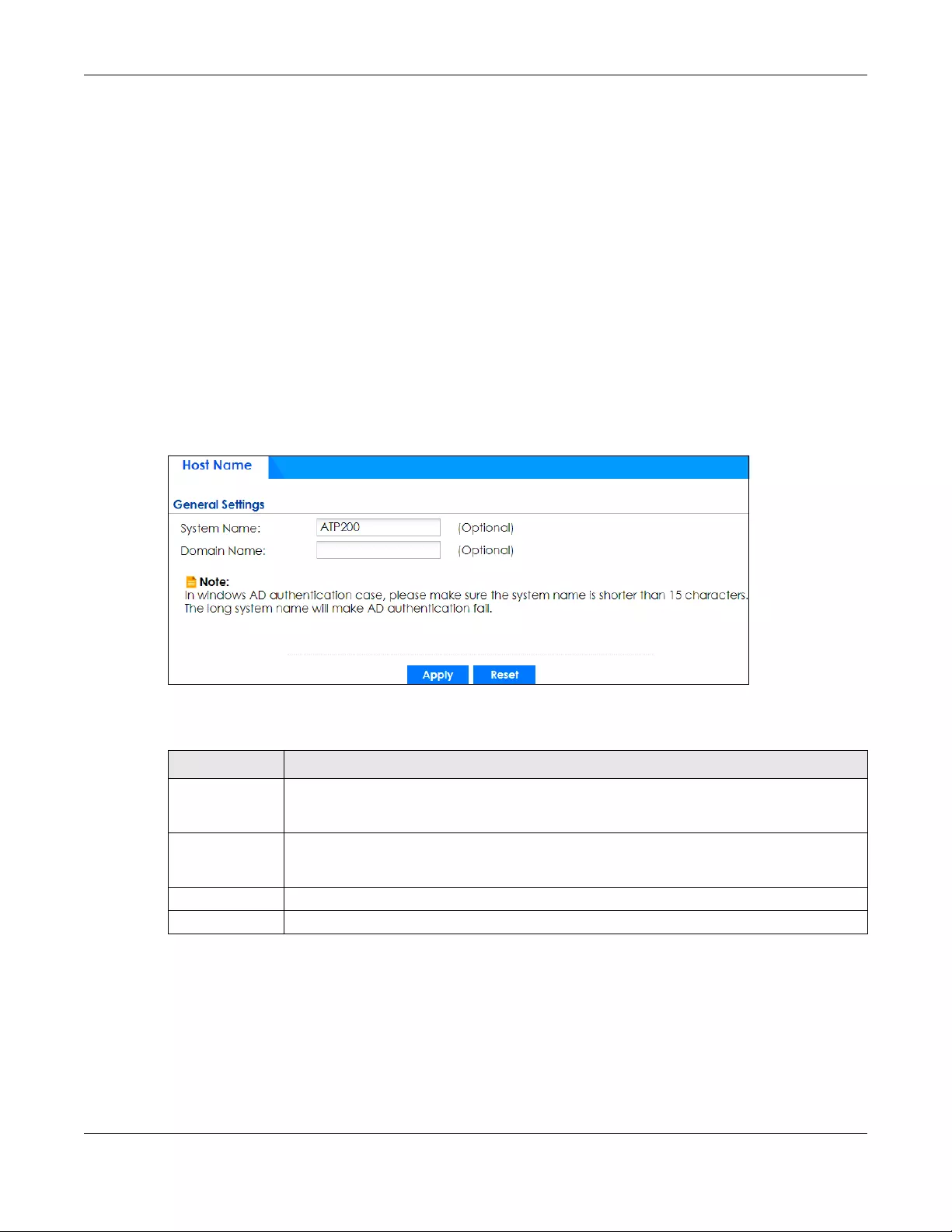
Chapter 42 System
ZyWALL USG FLEX Series User’s Guide
842
• Use the System > Language screen (see Section 42.16 on page 895) to set a language for the Zyxel
Device’s Web Configurator screens.
• Use the System > IPv6 screen (see Section 42.17 on page 896) to enable or disable IPv6 support on the
Zyxel Device.
• Use the System > ZON screen (see Section 42.18 on page 896) to enable or disable the Zyxel One
Network (ZON) utility that uses Zyxel Discovery Protocol (ZDP) for discovering and configuring ZDP-
aware Zyxel devices in the same network as the computer on which ZON is installed.
Note: See each section for related background information and term definitions.
42.2 Host Name
A host name is the unique name by which a device is known on a network. Click Configuration > System
> Host Name to open the Host Name screen.
Figure 559 Configuration > System > Host Name
The following table describes the labels in this screen.
42.3 USB Storage
The Zyxel Device can use a connected USB device to store the system log and other diagnostic
information. Use this screen to turn on this feature and set a disk full warning limit.
Table 364 Configuration > System > Host Name
LABEL DESCRIPTION
System Name Enter a descriptive name to identify your Zyxel Device device. This name can be up to 64
alphanumeric characters long. Spaces are not allowed, but dashes (-) underscores (_) and
periods (.) are accepted.
Domain Name Enter the domain name (if you know it) here. This name is propagated to DHCP clients
connected to interfaces with the DHCP server enabled. This name can be up to 254
alphanumeric characters long. Spaces are not allowed, but dashes “-” are accepted.
Apply Click Apply to save your changes back to the Zyxel Device.
Reset Click Reset to return the screen to its last-saved settings.
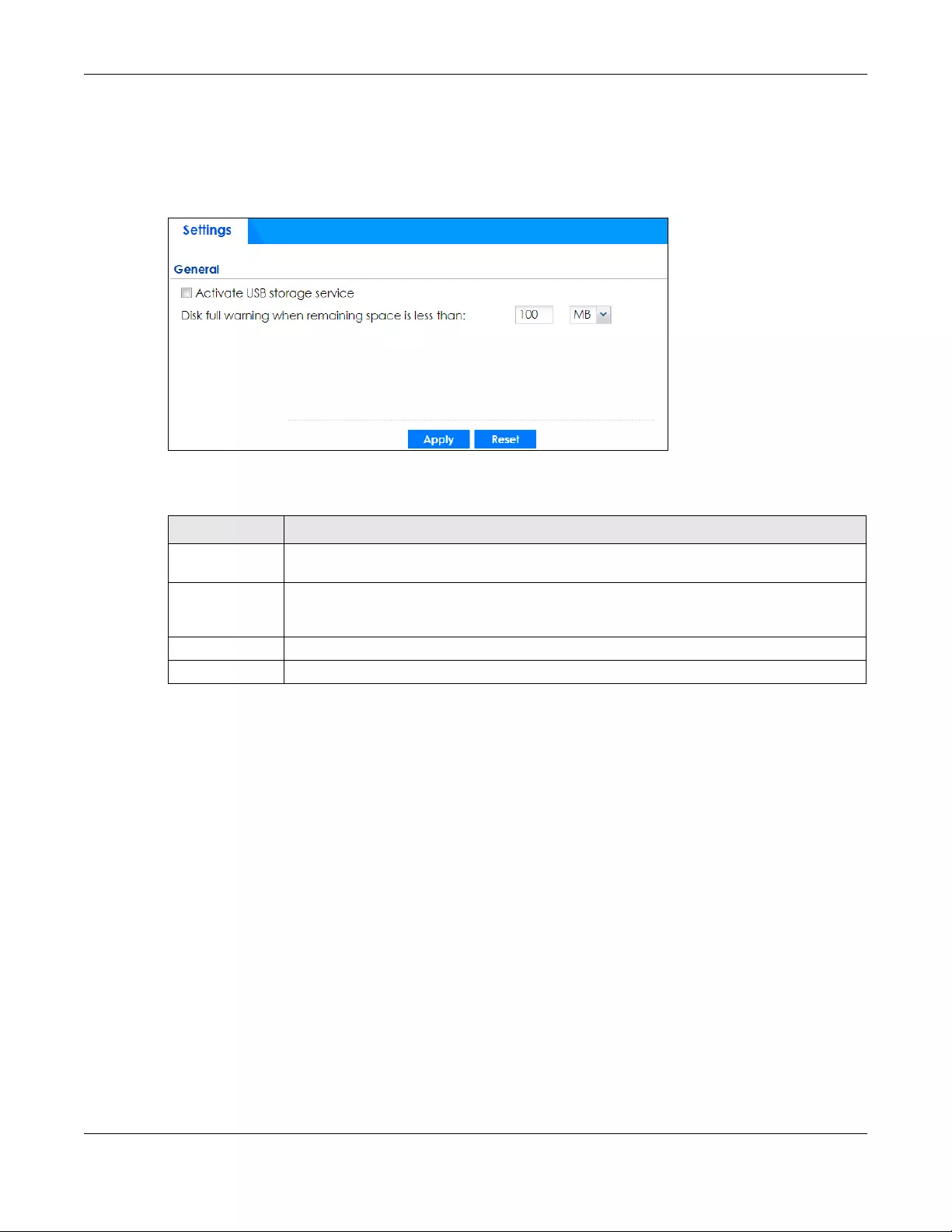
Chapter 42 System
ZyWALL USG FLEX Series User’s Guide
843
Note: Only connect one USB device. It must allow writing (it cannot be read-only) and use the
FAT16, FAT32, EXT2, or EXT3 file system.
Click Configuration > System > USB Storage to open the screen as shown next.
Figure 560 Configuration > System > USB Storage
The following table describes the labels in this screen.
42.4 Date and Time
For effective scheduling and logging, the Zyxel Device system time must be accurate. The Zyxel
Device’s Real Time Chip (RTC) keeps track of the time and date. There is also a software mechanism to
set the time manually or get the current time and date from an external server.
To change your Zyxel Device’s time based on your local time zone and date, click Configuration >
System > Date/Time. The screen displays as shown. You can manually set the Zyxel Device’s time and
date or have the Zyxel Device get the date and time from a time server.
Table 365 Configuration > System > USB Storage
LABEL DESCRIPTION
Activate USB
storage service
Select this if you want to use the connected USB device(s).
Disk full warning
when remaining
space is less than
Set a number and select a unit (MB or %) to have the Zyxel Device send a warning message
when the remaining USB storage space is less than the value you set here.
Apply Click Apply to save your changes back to the Zyxel Device.
Reset Click Reset to return the screen to its last-saved settings.
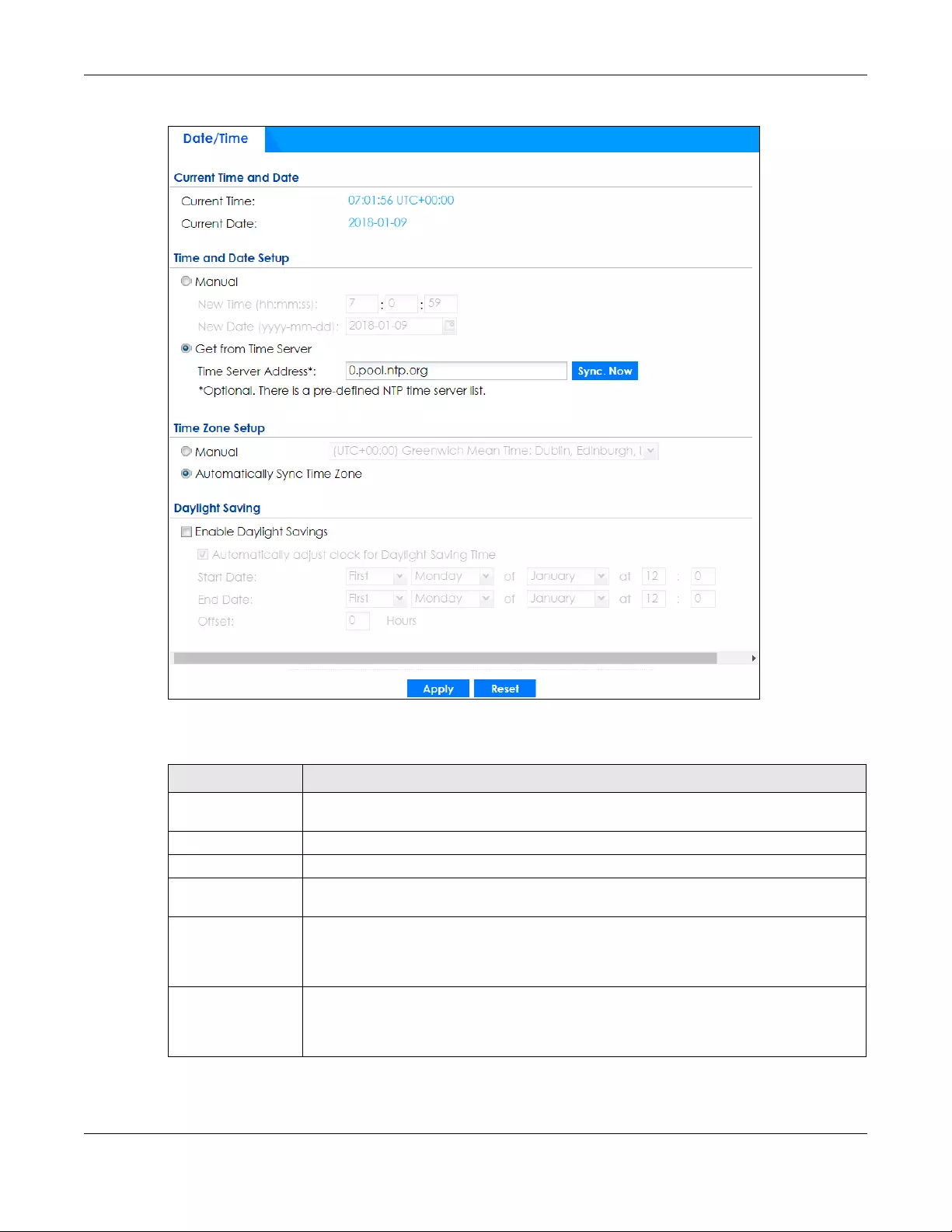
Chapter 42 System
ZyWALL USG FLEX Series User’s Guide
844
Figure 561 Configuration > System > Date and Time
The following table describes the labels in this screen.
Table 366 Configuration > System > Date and Time
LABEL DESCRIPTION
Current Time and
Date
Current Time This field displays the present time of your Zyxel Device.
Current Date This field displays the present date of your Zyxel Device.
Time and Date
Setup
Manual Select this radio button to enter the time and date manually. If you configure a new time
and date, time zone and daylight saving at the same time, the time zone and daylight
saving will affect the new time and date you entered. When you enter the time settings
manually, the Zyxel Device uses the new setting once you click Apply.
New Time (hh-mm-
ss)
This field displays the last updated time from the time server or the last time configured
manually.
When you set Time and Date Setup to Manual, enter the new time in this field and then click
Apply.

Chapter 42 System
ZyWALL USG FLEX Series User’s Guide
845
New Date (yyyy-
mm-dd)
This field displays the last updated date from the time server or the last date configured
manually.
When you set Time and Date Setup to Manual, enter the new date in this field and then click
Apply.
Get from Time
Server
Select this radio button to have the Zyxel Device get the time and date from the time server
you specify below. The Zyxel Device requests time and date settings from the time server
under the following circumstances.
• When the Zyxel Device starts up.
• When you click Apply or Synchronize Now in this screen.
• 24-hour intervals after starting up.
Time Server Address Enter the IP address or URL of your time server. Check with your ISP/network administrator if
you are unsure of this information.
Sync. Now Click this button to have the Zyxel Device get the time and date from a time server (see the
Time Server Address field). This also saves your changes (except the daylight saving
settings).
Time Zone Setup
Time Zone Choose the time zone of your location. This will set the time difference between your time
zone and Greenwich Mean Time (GMT).
Automatically Sync
Time Zone
Select this for the Zyxel Device to automatically get its time zone.
Daylight Saving
Enable Daylight
Savings
Daylight savings is a period from late spring to early fall when many countries set their clocks
ahead of normal local time by one hour to give more daytime light in the evening.
Select this option if you use Daylight Saving Time.
Automatically
adjust clock for
Daylight Saving
Time
Select this for the Zyxel Device to automatically adjust the time if daylight savings is
implemented in its time zone.
Start Date Configure the day and time when Daylight Saving Time starts if you selected Enable Daylight
Saving. The at field uses the 24 hour format. Here are a couple of examples:
Daylight Saving Time starts in most parts of the United States on the second Sunday of
March. Each time zone in the United States starts using Daylight Saving Time at 2 A.M. local
time. So in the United States you would select Second, Sunday, March and type 2 in the at
field.
Daylight Saving Time starts in the European Union on the last Sunday of March. All of the time
zones in the European Union start using Daylight Saving Time at the same moment (1 A.M.
GMT or UTC). So in the European Union you would select Last, Sunday, March. The time you
type in the at field depends on your time zone. In Germany for instance, you would type 2
because Germany's time zone is one hour ahead of GMT or UTC (GMT+1).
End Date Configure the day and time when Daylight Saving Time ends if you selected Enable Daylight
Saving. The at field uses the 24 hour format. Here are a couple of examples:
Daylight Saving Time ends in the United States on the first Sunday of November. Each time
zone in the United States stops using Daylight Saving Time at 2 A.M. local time. So in the
United States you would select First, Sunday, November and type 2 in the at field.
Daylight Saving Time ends in the European Union on the last Sunday of October. All of the
time zones in the European Union stop using Daylight Saving Time at the same moment (1
A.M. GMT or UTC). So in the European Union you would select Last, Sunday, October. The
time you type in the at field depends on your time zone. In Germany for instance, you would
type 2 because Germany's time zone is one hour ahead of GMT or UTC (GMT+1).
Table 366 Configuration > System > Date and Time (continued)
LABEL DESCRIPTION
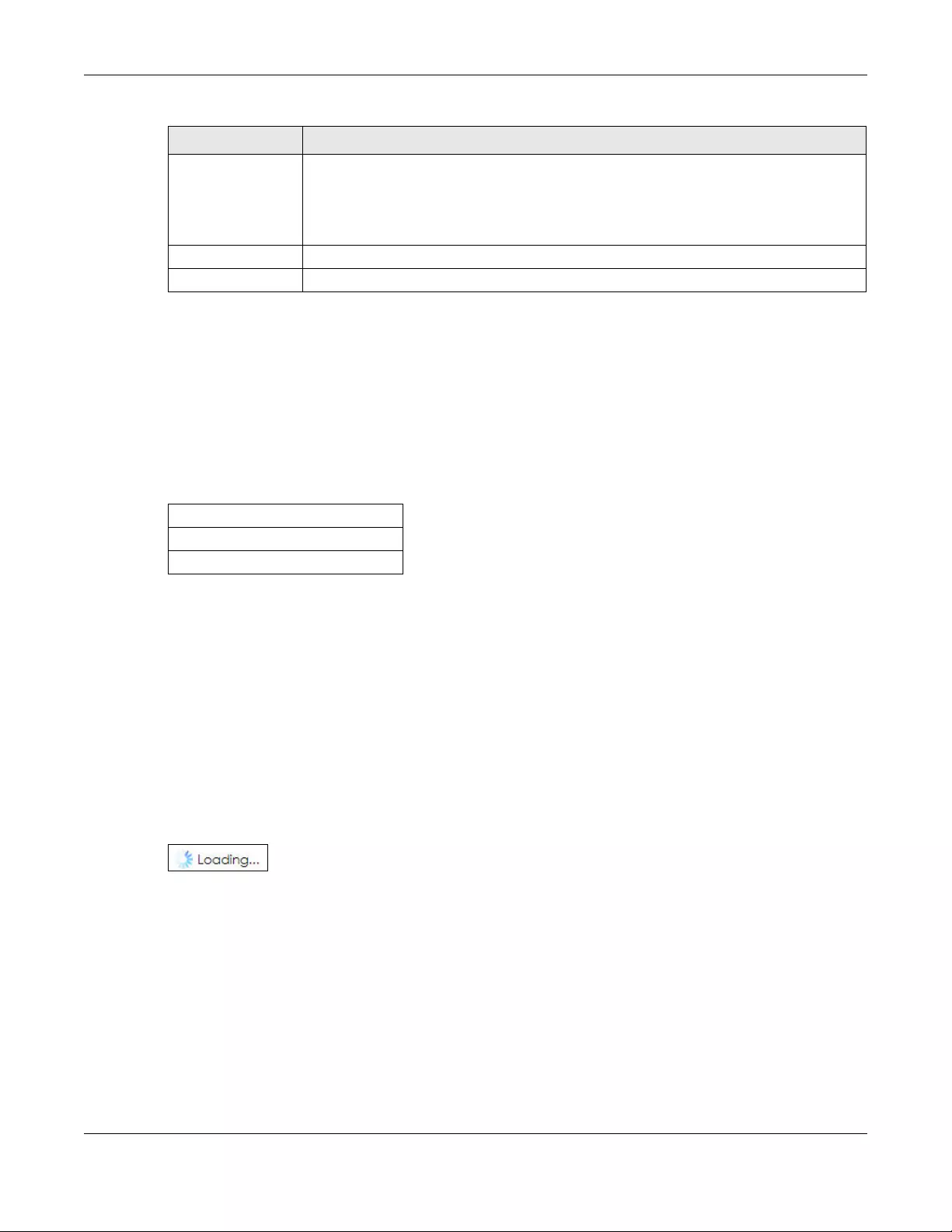
Chapter 42 System
ZyWALL USG FLEX Series User’s Guide
846
42.4.1 Pre-defined NTP Time Servers List
When you turn on the Zyxel Device for the first time, the date and time start at 2003-01-01 00:00:00. The
Zyxel Device then attempts to synchronize with one of the following pre-defined list of Network Time
Protocol (NTP) time servers.
The Zyxel Device continues to use the following pre-defined list of NTP time servers if you do not specify a
time server or it cannot synchronize with the time server you specified.
When the Zyxel Device uses the pre-defined list of NTP time servers, it randomly selects one server and
tries to synchronize with it. If the synchronization fails, then the Zyxel Device goes through the rest of the
list in order from the first one tried until either it is successful or all the pre-defined NTP time servers have
been tried.
42.4.2 Time Server Synchronization
Click the Synchronize Now button to get the time and date from the time server you specified in the
Time Server Address field.
When the Loading screen appears, you may have to wait up to one minute.
Figure 562 Synchronization in Process
The Current Time and Current Date fields will display the appropriate settings if the synchronization is
successful.
If the synchronization was not successful, a log displays in the View Log screen. Try re-configuring the
Date/Time screen.
To manually set the Zyxel Device date and time.
1Click System > Date/Time.
2Select Manual under Time and Date Setup.
Offset Specify how much the clock changes when daylight saving begins and ends.
Enter a number from 1 to 5.5 (by 0.5 increments).
For example, if you set this field to 3.5, a log occurred at 6 P.M. in local official time will
appear as if it had occurred at 10:30 P.M.
Apply Click Apply to save your changes back to the Zyxel Device.
Reset Click Reset to return the screen to its last-saved settings.
Table 366 Configuration > System > Date and Time (continued)
LABEL DESCRIPTION
Table 367 Default Time Servers
0.pool.ntp.org
1.pool.ntp.org
2.pool.ntp.org

Chapter 42 System
ZyWALL USG FLEX Series User’s Guide
847
3Enter the Zyxel Device’s time in the New Time field.
4Enter the Zyxel Device’s date in the New Date field.
5Under Time Zone Setup, select your Time Zone from the list.
6As an option you can select the Enable Daylight Saving check box to adjust the Zyxel Device clock for
daylight savings.
7Click Apply.
To get the Zyxel Device date and time from a time server
1Click System > Date/Time.
2Select Get from Time Server under Time and Date Setup.
3Under Time Zone Setup, select your Time Zone from the list.
4As an option you can select the Enable Daylight Saving check box to adjust the Zyxel Device clock for
daylight savings.
5Under Time and Date Setup, enter a Time Server Address (Table 367 on page 846).
6Click Apply.
42.5 Console Port Speed
This section shows you how to set the console port speed when you connect to the Zyxel Device via the
console port using a terminal emulation program.
Click Configuration > System > Console Speed to open the Console Speed screen.
Figure 563 Configuration > System > Console Speed

Chapter 42 System
ZyWALL USG FLEX Series User’s Guide
848
The following table describes the labels in this screen.
42.6 DNS Overview
DNS (Domain Name System) is for mapping a domain name to its corresponding IP address and vice
versa. The DNS server is extremely important because without it, you must know the IP address of a
machine before you can access it.
42.6.1 DNS Server Address Assignment
The Zyxel Device can get the DNS server addresses in the following ways.
• The ISP tells you the DNS server addresses, usually in the form of an information sheet, when you sign
up. If your ISP gives you DNS server addresses, manually enter them in the DNS server fields.
• If your ISP dynamically assigns the DNS server IP addresses (along with the Zyxel Device’s WAN IP
address), set the DNS server fields to get the DNS server address from the ISP.
• You can manually enter the IP addresses of other DNS servers.
42.6.2 Configuring the DNS Screen
Click Configuration > System > DNS to change your Zyxel Device’s DNS settings. Use the DNS screen to
configure the Zyxel Device to use a DNS server to resolve domain names for Zyxel Device system
features like VPN, DDNS and the time server. You can also configure the Zyxel Device to accept or
discard DNS queries. Use the Network > Interface screens to configure the DNS server information that
the Zyxel Device sends to the specified DHCP client devices.
A name query begins at a client computer and is passed to a resolver, a DNS client service, for
resolution. The Zyxel Device can be a DNS client service. The Zyxel Device can resolve a DNS query
locally using cached Resource Records (RR) obtained from a previous query (and kept for a period of
time). If the Zyxel Device does not have the requested information, it can forward the request to DNS
servers. This is known as recursion.
The Zyxel Device can ask a DNS server to use recursion to resolve its DNS client requests. If recursion on
the Zyxel Device or a DNS server is disabled, they cannot forward DNS requests for resolution.
A Domain Name Server (DNS) amplification attack is a kind of Distributed Denial of Service (DDoS)
attack that uses publicly accessible open DNS servers to flood a victim with DNS response traffic. An
open DNS server is a DNS server which is willing to resolve recursive DNS queries from anyone on the
Internet.
Table 368 Configuration > System > Console Speed
LABEL DESCRIPTION
Console Port Speed Use the drop-down list box to change the speed of the console port. Your Zyxel Device
supports 9600, 19200, 38400, 57600, and 115200 bps (default) for the console port.
The Console Port Speed applies to a console port connection using terminal emulation
software and NOT the Console in the Zyxel Device Web Configurator Status screen.
Apply Click Apply to save your changes back to the Zyxel Device.
Reset Click Reset to return the screen to its last-saved settings.
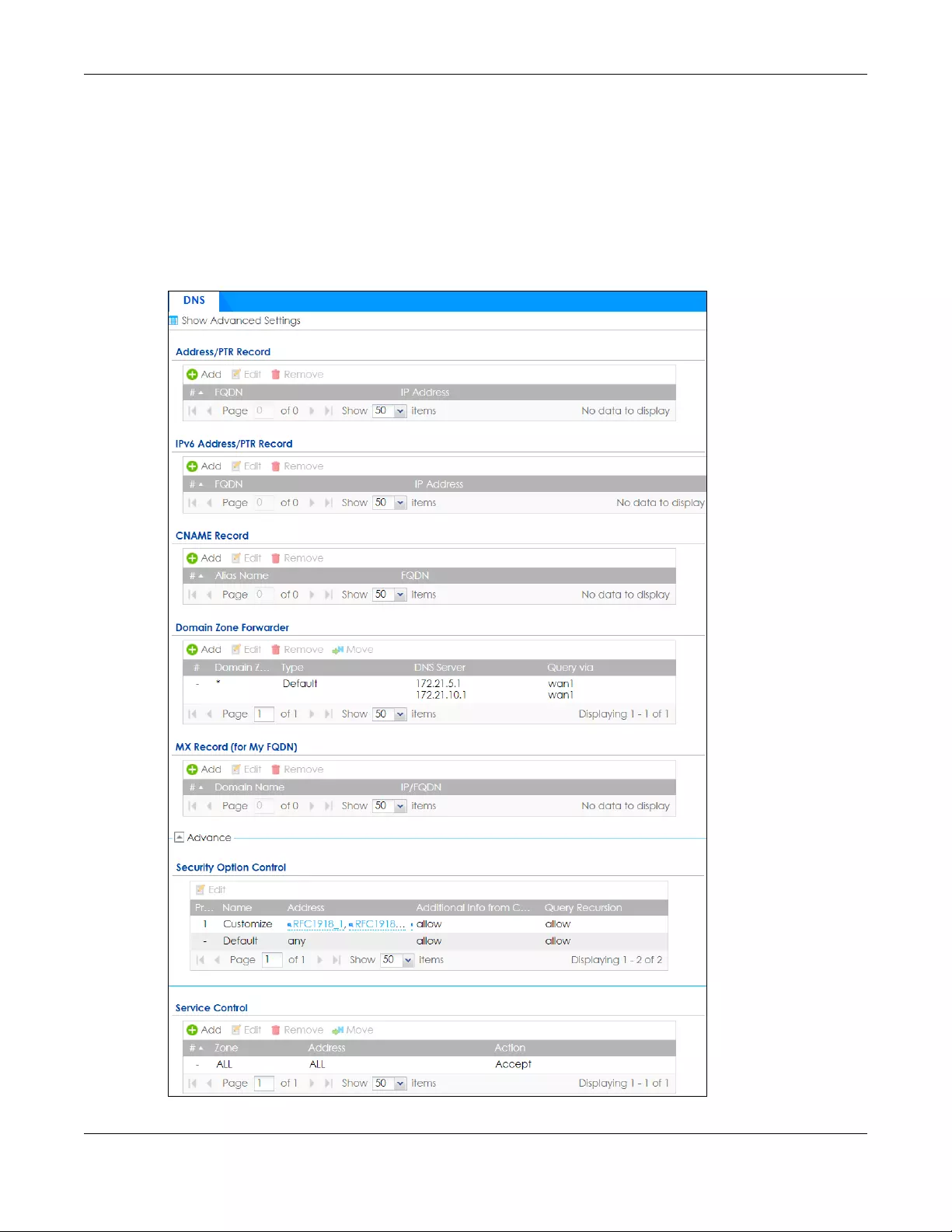
Chapter 42 System
ZyWALL USG FLEX Series User’s Guide
849
In a DNS amplification attack, an attacker sends a DNS name lookup request to an open DNS server
with the source address spoofed as the victim’s address. When the DNS server sends the DNS record
response, it is sent to the victim. Attackers can request as much information as possible to maximize the
amplification effect.
Configure the Security Option Control section in the Configuration > System > DNS screen (click Show
Advanced Settings to display it) if you suspect the Zyxel Device is being used (either by hackers or by a
corrupted open DNS server) in a DNS amplification attack.
Figure 564 Configuration > System > DNS

Chapter 42 System
ZyWALL USG FLEX Series User’s Guide
850
The following table describes the labels in this screen.
Table 369 Configuration > System > DNS
LABEL DESCRIPTION
Address/PTR
Record
This record specifies the mapping of a Fully-Qualified Domain Name (FQDN) to an IP address.
An FQDN consists of a host and domain name. For example, www.zyxel.com.tw is a fully
qualified domain name, where “www” is the host, “zyxel” is the third-level domain, “com” is
the second-level domain, and “tw” is the top level domain.
Add Click this to create a new entry.
Edit Double-click an entry or select it and click Edit to be able to modify the entry’s settings.
Remove To remove an entry, select it and click Remove. The Zyxel Device confirms you want to
remove it before doing so. Note that subsequent entries move up by one when you take this
action.
#This is the index number of the address/PTR record.
FQDN This is a host’s fully qualified domain name.
IP Address This is the IP address of a host.
CNAME Record This record specifies an alias for a FQDN. Use this record to bind all subdomains with the same
IP address as the FQDN without having to update each one individually, which increases
chance for errors. See CNAME Record (Section 42.6.6 on page 853) for more details.
Add Click this to create a new entry.
Edit Double-click an entry or select it and click Edit to be able to modify the entry’s settings.
Remove To remove an entry, select it and click Remove. The Zyxel Device confirms you want to
remove it before doing so. Note that subsequent entries move up by one when you take this
action.
#This is the index number of the domain zone forwarder record. The ordering of your rules is
important as rules are applied in sequence.
A hyphen (-) displays for the default domain zone forwarder record. The default record is not
configurable. The Zyxel Device uses this default record if the domain zone that needs to be
resolved does not match any of the other domain zone forwarder records.
Alias Name Enter an Alias name. Use “*.” as prefix for a wildcard domain name. For example,
*.example.com.
FQDN Enter the Fully Qualified Domain Name (FQDN).
Domain Zone
Forwarder
This specifies a DNS server’s IP address. The Zyxel Device can query the DNS server to resolve
domain zones for features like VPN, DDNS and the time server.
When the Zyxel Device needs to resolve a domain zone, it checks it against the domain zone
forwarder entries in the order that they appear in this list.
Add Click this to create a new entry. Select an entry and click Add to create a new entry after the
selected entry.
Edit Double-click an entry or select it and click Edit to be able to modify the entry’s settings.
Remove To remove an entry, select it and click Remove. The Zyxel Device confirms you want to
remove it before doing so. Note that subsequent entries move up by one when you take this
action.
Move To change an entry’s position in the numbered list, select the method and click Move to
display a field to type a number for where you want to put it and press [ENTER] to move the
rule to the number that you typed.
#This is the index number of the domain zone forwarder record. The ordering of your rules is
important as rules are applied in sequence.
A hyphen (-) displays for the default domain zone forwarder record. The default record is not
configurable. The Zyxel Device uses this default record if the domain zone that needs to be
resolved does not match any of the other domain zone forwarder records.

Chapter 42 System
ZyWALL USG FLEX Series User’s Guide
851
Domain Zone A domain zone is a fully qualified domain name without the host. For example, zyxel.com.tw
is the domain zone for the www.zyxel.com.tw fully qualified domain name.
A “*” means all domain zones.
Type This displays whether the DNS server IP address is assigned by the ISP dynamically through a
specified interface or configured manually (User-Defined).
DNS Server This is the IP address of a DNS server. This field displays N/A if you have the Zyxel Device get a
DNS server IP address from the ISP dynamically but the specified interface is not active.
Query Via This is the interface through which the Zyxel Device sends DNS queries to the entry’s DNS
server. If the Zyxel Device connects through a VPN tunnel, tunnel displays.
MX Record (for My
FQDN)
A MX (Mail eXchange) record identifies a mail server that handles the mail for a particular
domain.
Add Click this to create a new entry.
Edit Double-click an entry or select it and click Edit to be able to modify the entry’s settings.
Remove To remove an entry, select it and click Remove. The Zyxel Device confirms you want to
remove it before doing so. Note that subsequent entries move up by one when you take this
action.
#This is the index number of the MX record.
Domain Name This is the domain name where the mail is destined for.
IP/FQDN This is the IP address or Fully-Qualified Domain Name (FQDN) of a mail server that handles the
mail for the domain specified in the field above.
Security Option
Control
Click Show Advanced Settings to display this part of the screen. There are two control
policies: Default and Customize.
Edit Click either control policy and then click this button to change allow or deny actions for
Query Recursion and Additional Info from Cache.
Priority The Customize control policy is checked first and if an address object match is not found, the
Default control policy is checked.
Name You may change the name of the Customize control policy.
Address These are the object addresses used in the control policy. RFC1918 refers to private IP address
ranges. It can be modified in Object > Address.
Additional Info
from Cache This displays if the Zyxel Device is allowed or denied to cache Resource Records (RR)
obtained from previous DNS queries.
Query
Recursion This displays if the Zyxel Device is allowed or denied to forward DNS client requests to DNS
servers for resolution.
Service Control This specifies from which computers and zones you can send DNS queries to the Zyxel Device.
Add Click this to create a new entry. Select an entry and click Add to create a new entry after the
selected entry.
Edit Double-click an entry or select it and click Edit to be able to modify the entry’s settings.
Remove To remove an entry, select it and click Remove. The Zyxel Device confirms you want to
remove it before doing so. Note that subsequent entries move up by one when you take this
action.
Move To change an entry’s position in the numbered list, select the method and click Move to
display a field to type a number for where you want to put it and press [ENTER] to move the
rule to the number that you typed.
Table 369 Configuration > System > DNS (continued)
LABEL DESCRIPTION
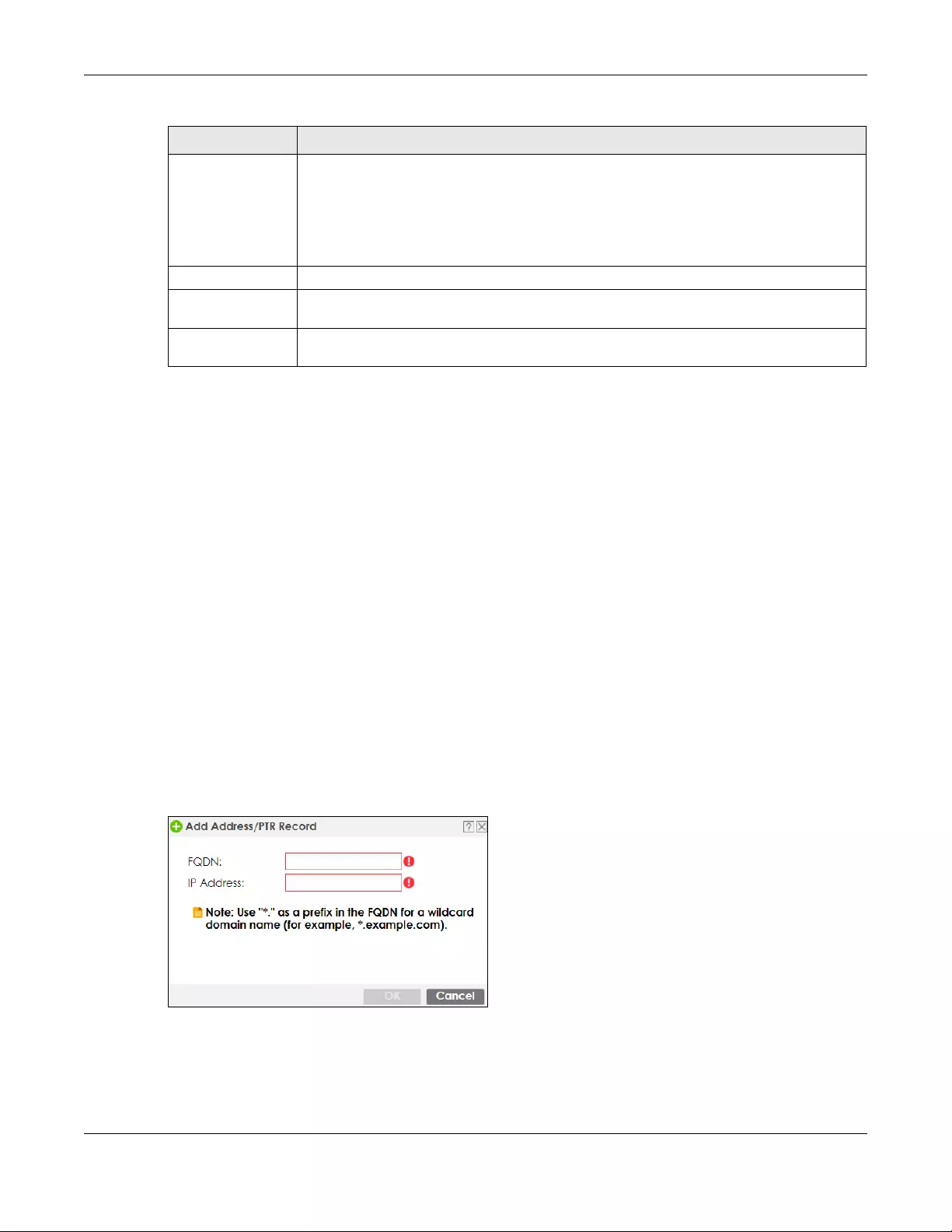
Chapter 42 System
ZyWALL USG FLEX Series User’s Guide
852
42.6.3 (IPv6) Address Record
An address record contains the mapping of a Fully-Qualified Domain Name (FQDN) to an IP address.
The Zyxel Device allows you to configure address records about the Zyxel Device itself or another
device. This way you can keep a record of DNS names and addresses that people on your network may
use frequently. If the Zyxel Device receives a DNS query for an FQDN for which the Zyxel Device has an
address record, the Zyxel Device can send the IP address in a DNS response without having to query a
DNS name server.
42.6.4 PTR Record
A PTR (pointer) record is also called a reverse record or a reverse lookup record. It is a mapping of an IP
address to a domain name.
42.6.5 Adding an (IPv6) Address/PTR Record
Click the Add icon in the Address/PTR Record or IPv6 Address/PTR Record table to add an IPv4 or IPv6
address/PTR record.
Figure 565 Configuration > System > DNS > Address/PTR Record Edit
#This the index number of the service control rule. The ordering of your rules is important as
rules are applied in sequence.
The entry with a hyphen (-) instead of a number is the Zyxel Device’s (non-configurable)
default policy. The Zyxel Device applies this to traffic that does not match any other
configured rule. It is not an editable rule. To apply other behavior, configure a rule that traffic
will match so the Zyxel Device will not have to use the default policy.
Zone This is the zone on the Zyxel Device the user is allowed or denied to access.
Address This is the object name of the IP address(es) with which the computer is allowed or denied to
send DNS queries.
Action This displays whether the Zyxel Device accepts DNS queries from the computer with the IP
address specified above through the specified zone (Accept) or discards them (Deny).
Table 369 Configuration > System > DNS (continued)
LABEL DESCRIPTION
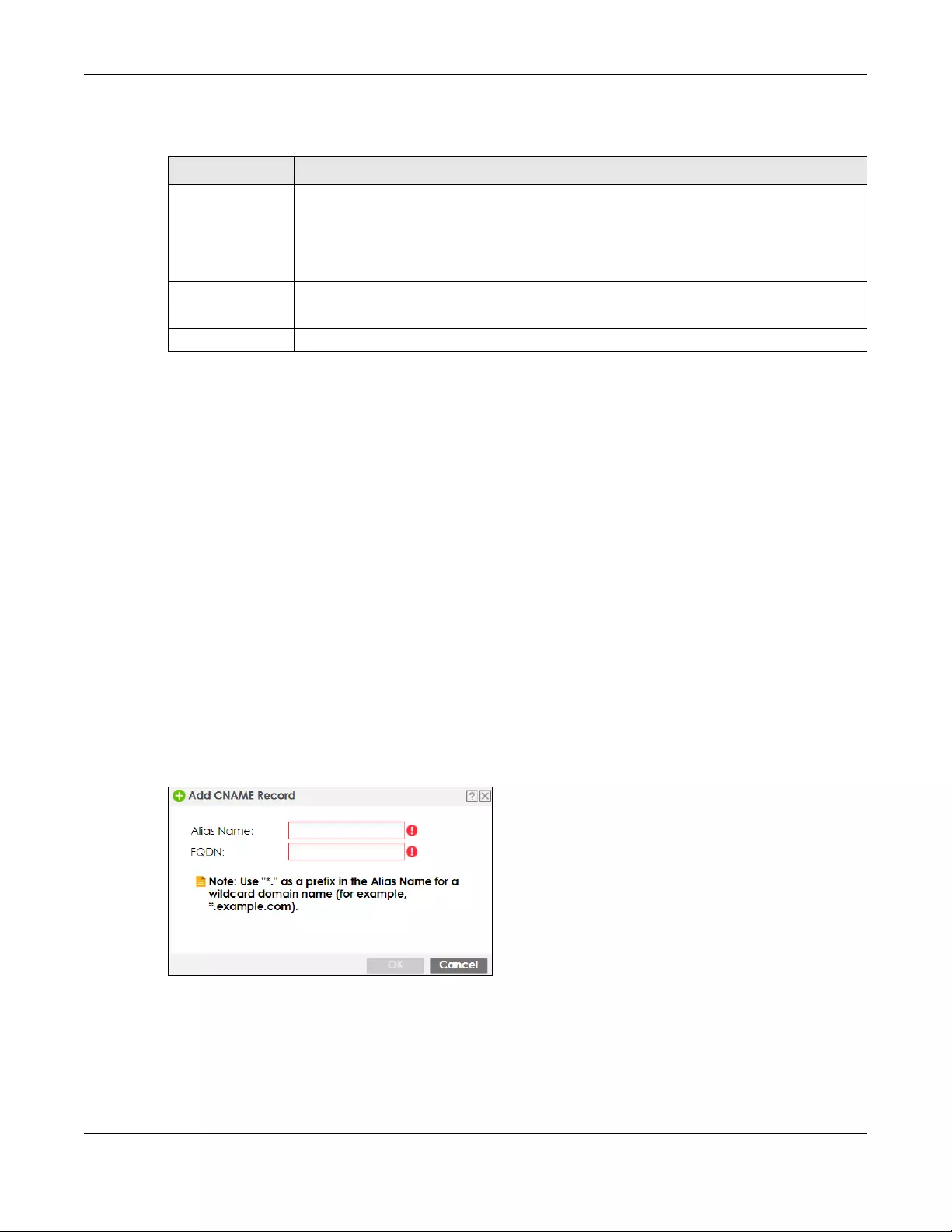
Chapter 42 System
ZyWALL USG FLEX Series User’s Guide
853
The following table describes the labels in this screen.
42.6.6 CNAME Record
A Canonical Name Record or CNAME record is a type of resource record in the Domain Name System
(DNS) that specifies that the domain name is an alias of another, canonical domain name. This allows
users to set up a record for a domain name which translates to an IP address, in other words, the domain
name is an alias of another. This record also binds all the subdomains to the same IP address without
having to create a record for each, so when the IP address is changed, all subdomain’s IP address is
updated as well, with one edit to the record.
For example, the domain name zyxel.com is hooked up to a record named A which translates it to
11.22.33.44. You also have several subdomains, like mail.zyxel.com, ftp.zyxel.com and you want this
subdomain to point to your main domain zyxel.com. Edit the IP Address in record A and all subdomains
will follow automatically. This eliminates chances for errors and increases efficiency in DNS
management.
42.6.7 Adding a CNAME Record
Click the Add icon in the CNAME Record table to add a record. Use “*.” as a prefix for a wildcard
domain name. For example *.zyxel.com.
Figure 566 Configuration > System > DNS > CNAME Record > Add
Table 370 Configuration > System > DNS > (IPv6) Address/PTR Record Edit
LABEL DESCRIPTION
FQDN Type a Fully-Qualified Domain Name (FQDN) of a server. An FQDN starts with a host name and
continues all the way up to the top-level domain name. For example, www.zyxel.com.tw is a
fully qualified domain name, where “www” is the host, “zyxel” is the third-level domain, “com”
is the second-level domain, and “tw” is the top level domain. Underscores are not allowed.
Use "*." as a prefix in the FQDN for a wildcard domain name (for example, *.example.com).
IP Address Enter the IP address of the host in dotted decimal notation.
OK Click OK to save your customized settings and exit this screen.
Cancel Click Cancel to exit this screen without saving.
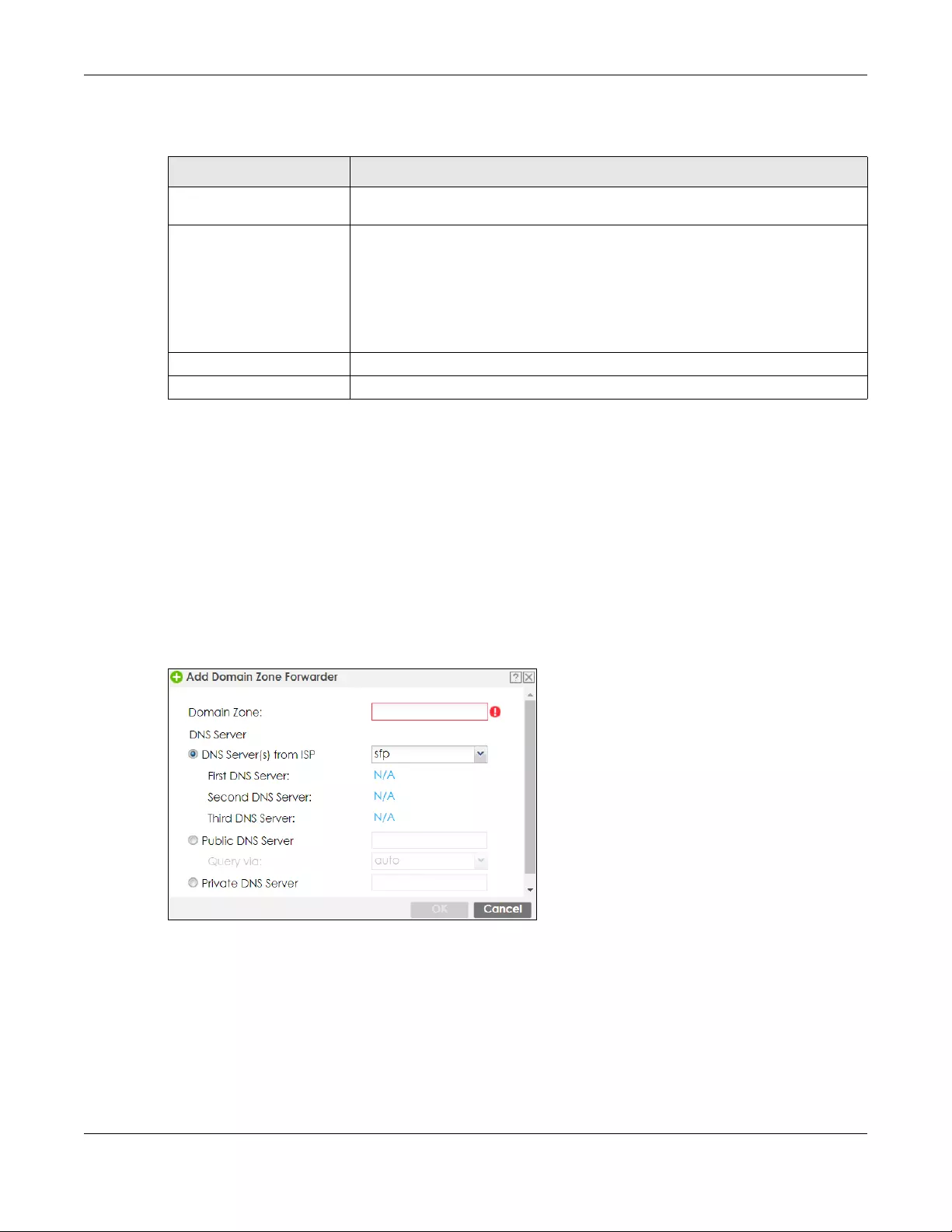
Chapter 42 System
ZyWALL USG FLEX Series User’s Guide
854
The following table describes the labels in this screen.
42.6.8 Domain Zone Forwarder
A domain zone forwarder contains a DNS server’s IP address. The Zyxel Device can query the DNS server
to resolve domain zones for features like VPN, DDNS and the time server. A domain zone is a fully
qualified domain name without the host. For example, zyxel.com.tw is the domain zone for the
www.zyxel.com.tw fully qualified domain name.
42.6.9 Adding a Domain Zone Forwarder
Click the Add icon in the Domain Zone Forwarder table to add a domain zone forwarder record.
Figure 567 Configuration > System > DNS > Domain Zone Forwarder Add
Table 371 Configuration > System > DNS > CNAME Record > Add
LABEL DESCRIPTION
Alias name Enter an Alias Name. Use "*." as a prefix in the Alias name for a wildcard domain
name (for example, *.example.com).
FQDN Type a Fully-Qualified Domain Name (FQDN) of a server. An FQDN starts with a host
name and continues all the way up to the top-level domain name. For example,
www.zyxel.com.tw is a fully qualified domain name, where “www” is the host, “zyxel”
is the third-level domain, “com” is the second-level domain, and “tw” is the top level
domain. Underscores are not allowed.
Use "*." as a prefix in the FQDN for a wildcard domain name (for example,
*.example.com).
OK Click OK to save your customized settings and exit this screen.
Cancel Click Cancel to exit this screen without saving.
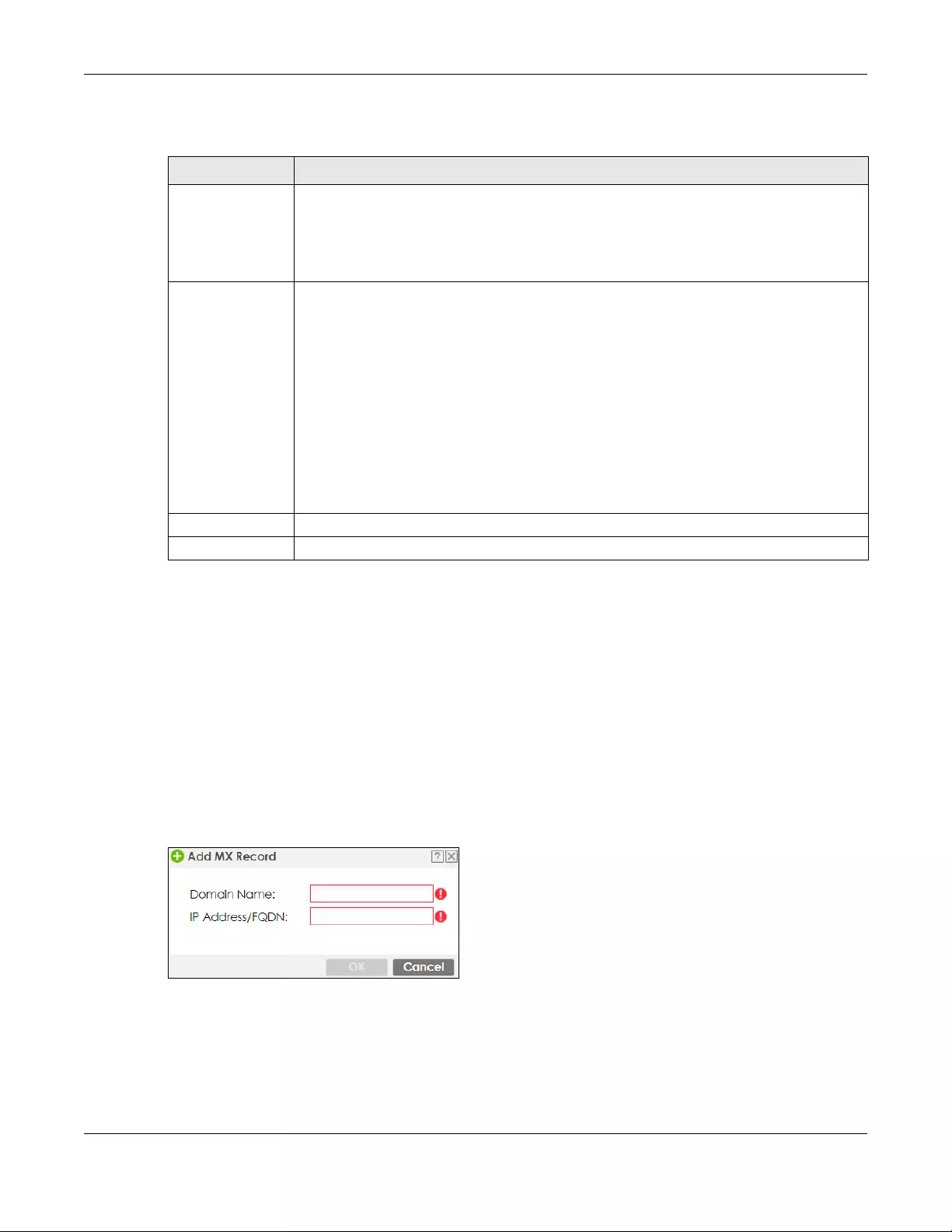
Chapter 42 System
ZyWALL USG FLEX Series User’s Guide
855
The following table describes the labels in this screen.
42.6.10 MX Record
A MX (Mail eXchange) record indicates which host is responsible for the mail for a particular domain,
that is, controls where mail is sent for that domain. If you do not configure proper MX records for your
domain or other domain, external email from other mail servers will not be able to be delivered to your
mail server and vice versa. Each host or domain can have only one MX record, that is, one domain is
mapping to one host.
42.6.11 Adding a MX Record
Click the Add icon in the MX Record table to add a MX record.
Figure 568 Configuration > System > DNS > MX Record Add
Table 372 Configuration > System > DNS > Domain Zone Forwarder Add
LABEL DESCRIPTION
Domain Zone A domain zone is a fully qualified domain name without the host. For example, zyxel.com.tw is
the domain zone for the www.zyxel.com.tw fully qualified domain name. For example,
whenever the Zyxel Device receives needs to resolve a zyxel.com.tw domain name, it can
send a query to the recorded name server IP address.
Enter * if all domain zones are served by the specified DNS server(s).
DNS Server Select DNS Server(s) from ISP if your ISP dynamically assigns DNS server information. You also
need to select an interface through which the ISP provides the DNS server IP address(es). The
interface should be activated and set to be a DHCP client. The fields below display the (read-
only) DNS server IP address(es) that the ISP assigns. N/A displays for any DNS server IP address
fields for which the ISP does not assign an IP address.
Select Public DNS Server if you have the IP address of a DNS server. Enter the DNS server's IP
address in the field to the right. The Zyxel Device must be able to connect to the DNS server
without using a VPN tunnel. The DNS server could be on the Internet or one of the Zyxel
Device’s local networks. You cannot use 0.0.0.0. Use the Query via field to select the interface
through which the Zyxel Device sends DNS queries to a DNS server.
Select Private DNS Server if you have the IP address of a DNS server to which the Zyxel Device
connects through a VPN tunnel. Enter the DNS server's IP address in the field to the right. You
cannot use 0.0.0.0.
OK Click OK to save your customized settings and exit this screen.
Cancel Click Cancel to exit this screen without saving.
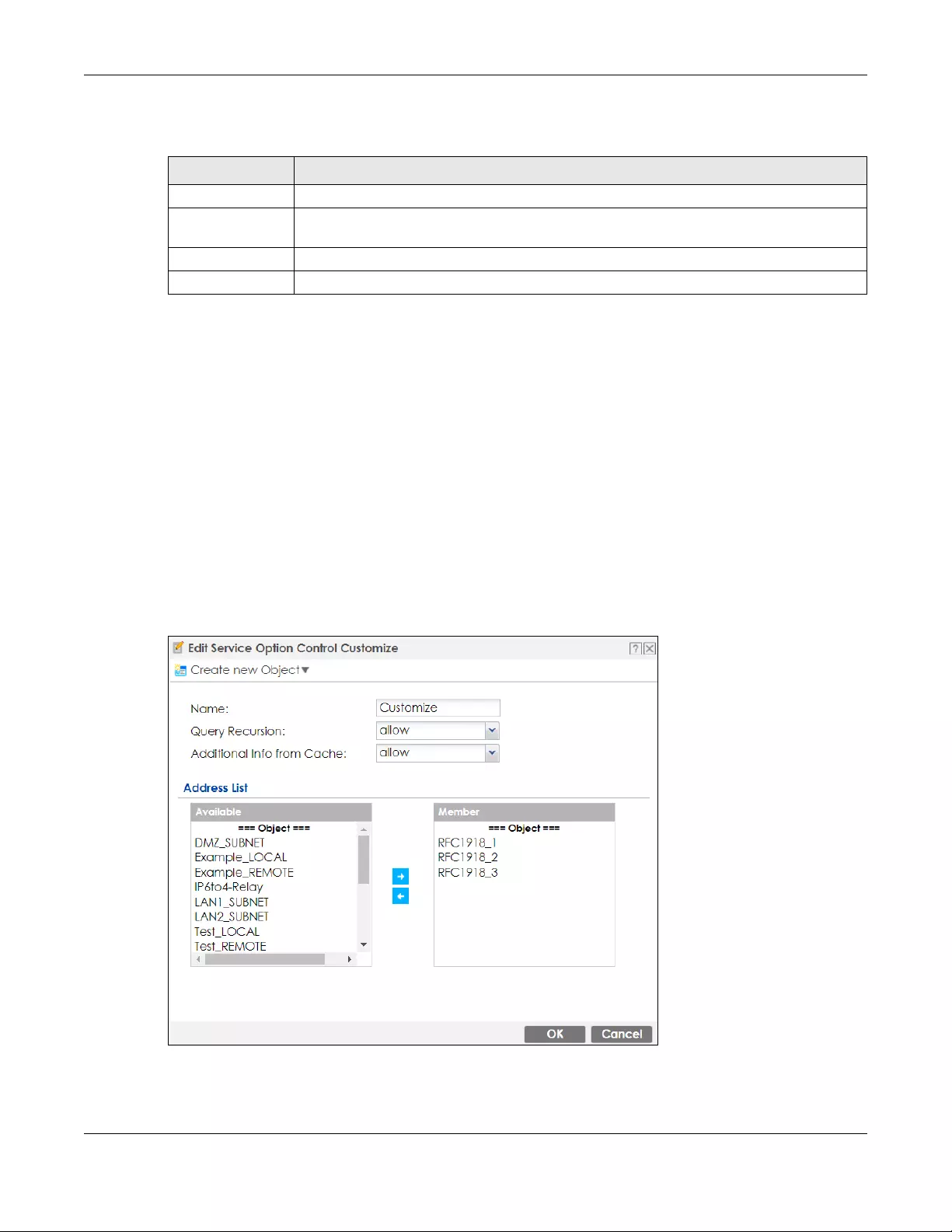
Chapter 42 System
ZyWALL USG FLEX Series User’s Guide
856
The following table describes the labels in this screen.
42.6.12 Security Option Control
Configure the Security Option Control section in the Configuration > System > DNS screen (click Show
Advanced Settings to display it) if you suspect the Zyxel Device is being used by hackers in a DNS
amplification attack.
One possible strategy would be to deny Query Recursion and Add itional Info from Cach e in the default
policy and allow Query Recursion and Additional Info from Cache only from trusted DNS servers
identified by address objects and added as members in the customized policy.
42.6.13 Editing a Security Option Control
Click a control policy and then click Edit to change allow or deny actions for Query Recursion and
Additional Info from Cache.
Figure 569 Configuration > System > DNS > Security Option Control Edit (Customize)
Table 373 Configuration > System > DNS > MX Record Add
LABEL DESCRIPTION
Domain Name Enter the domain name where the mail is destined for.
IP Address/FQDN Enter the IP address or Fully-Qualified Domain Name (FQDN) of a mail server that handles the
mail for the domain specified in the field above.
OK Click OK to save your customized settings and exit this screen.
Cancel Click Cancel to exit this screen without saving.
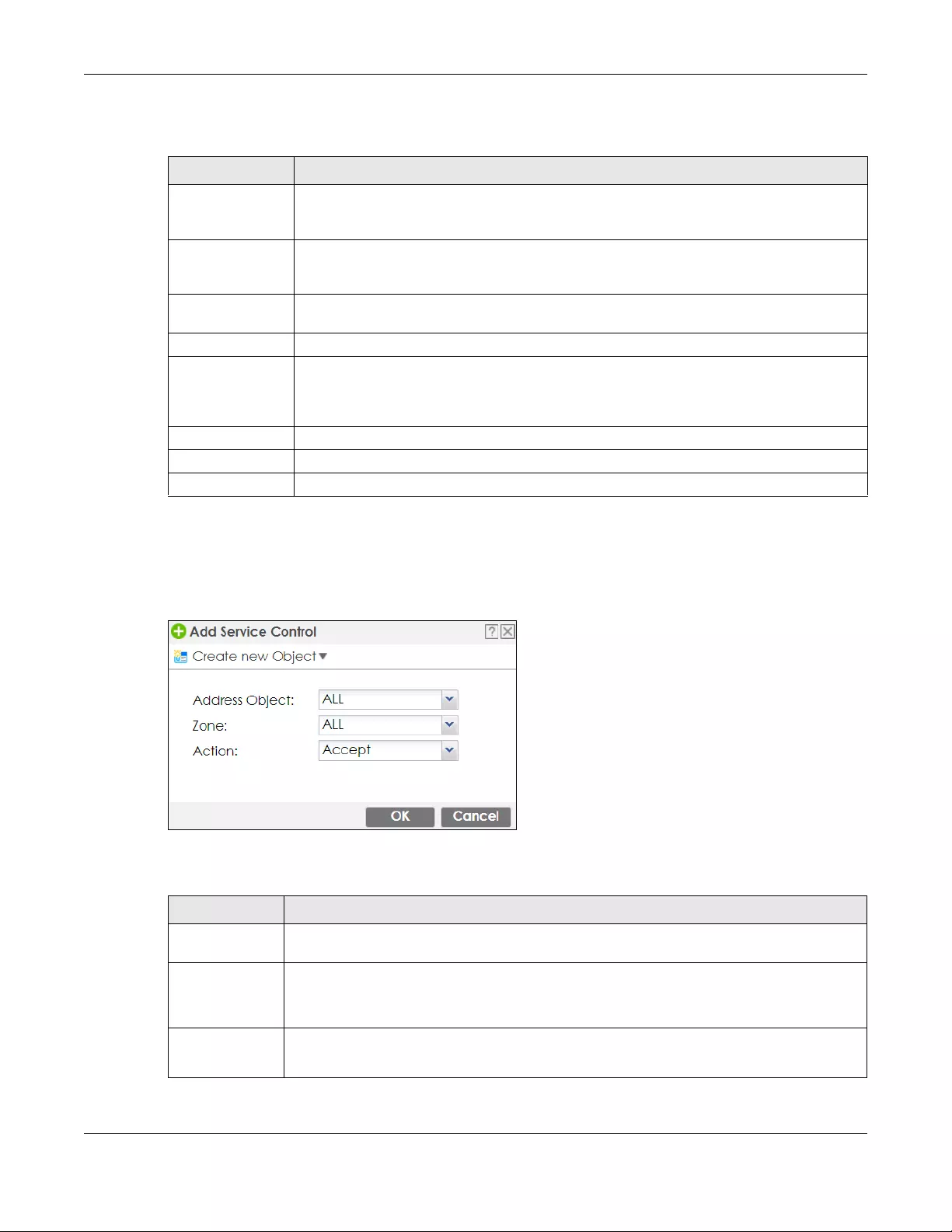
Chapter 42 System
ZyWALL USG FLEX Series User’s Guide
857
The following table describes the labels in this screen.
42.6.14 Adding a DNS Service Control Rule
Click the Add icon in the Service Control table to add a service control rule.
Figure 570 Configuration > System > DNS > Service Control Rule Add
The following table describes the labels in this screen.
Table 374 Configuration > System > DNS > Security Option Control Edit (Customize)
LABEL DESCRIPTION
Name You may change the name for the customized security option control policy. The customized
security option control policy is checked first and if an address object match is not found, the
Default control policy is checked.
Query Recursion Choose if the ZyWALL/USG is allowed or denied to forward DNS client requests to DNS servers
for resolution. This can apply to specific open DNS servers using the address objects in a
customized rule.
Additional Info
from Cache
Choose if the ZyWALL/USG is allowed or denied to cache Resource Records (RR) obtained
from previous DNS queries.
Address List Specifying address objects is not available in the default policy as all addresses are included.
Available This box displays address objects created in Object > Address. Select one (or more), and click
the > arrow to have it (them) join the Member list of address objects that will apply to this rule.
For example, you could specify an open DNS server suspect of sending compromised
resource records by adding an address object for that server to the member list.
Member This box displays address objects that will apply to this rule.
OK Click OK to save your customized settings and exit this screen.
Cancel Click Cancel to exit this screen without saving.
Table 375 Configuration > System > DNS > Service Control Rule Add
LABEL DESCRIPTION
Create new
Object
Use this to configure any new settings objects that you need to use in this screen.
Address Object Select ALL to allow or deny any computer to send DNS queries to the Zyxel Device.
Select a predefined address object to just allow or deny the computer with the IP address that
you specified to send DNS queries to the Zyxel Device.
Zone Select ALL to allow or prevent DNS queries through any zones.
Select a predefined zone on which a DNS query to the Zyxel Device is allowed or denied.

Chapter 42 System
ZyWALL USG FLEX Series User’s Guide
858
42.7 WWW Overview
The following figure shows secure and insecure management of the Zyxel Device coming in from the
WAN. HTTPS and SSH access are secure. HTTP and Telnet access are not secure.
Note: To allow the Zyxel Device to be accessed from a specified computer using a service,
make sure you do not have a service control rule or to-Zyxel Device security policy rule
to block that traffic.
To stop a service from accessing the Zyxel Device, clear Enable in the corresponding service screen.
42.7.1 Service Access Limitations
A service cannot be used to access the Zyxel Device when:
1You have disabled that service in the corresponding screen.
2The allowed IP address (address object) in the Service Control table does not match the client IP
address (the Zyxel Device disallows the session).
3The IP address (address object) in the Service Control table is not in the allowed zone or the action is set
to Deny.
4There is a security policy rule that blocks it.
42.7.2 System Timeout
There is a lease timeout for administrators. The Zyxel Device automatically logs you out if the
management session remains idle for longer than this timeout period. The management session does
not time out when a statistics screen is polling.
Each user is also forced to log in the Zyxel Device for authentication again when the reauthentication
time expires.
You can change the timeout settings in the User/Group screens.
42.7.3 HTTPS
You can set the Zyxel Device to use HTTP or HTTPS (HTTPS adds security) for Web Configurator sessions.
Specify which zones allow Web Configurator access and from which IP address the access can come.
Action Select Accept to have the Zyxel Device allow the DNS queries from the specified computer.
Select Deny to have the Zyxel Device reject the DNS queries from the specified computer.
OK Click OK to save your customized settings and exit this screen.
Cancel Click Cancel to exit this screen without saving.
Table 375 Configuration > System > DNS > Service Control Rule Add (continued)
LABEL DESCRIPTION
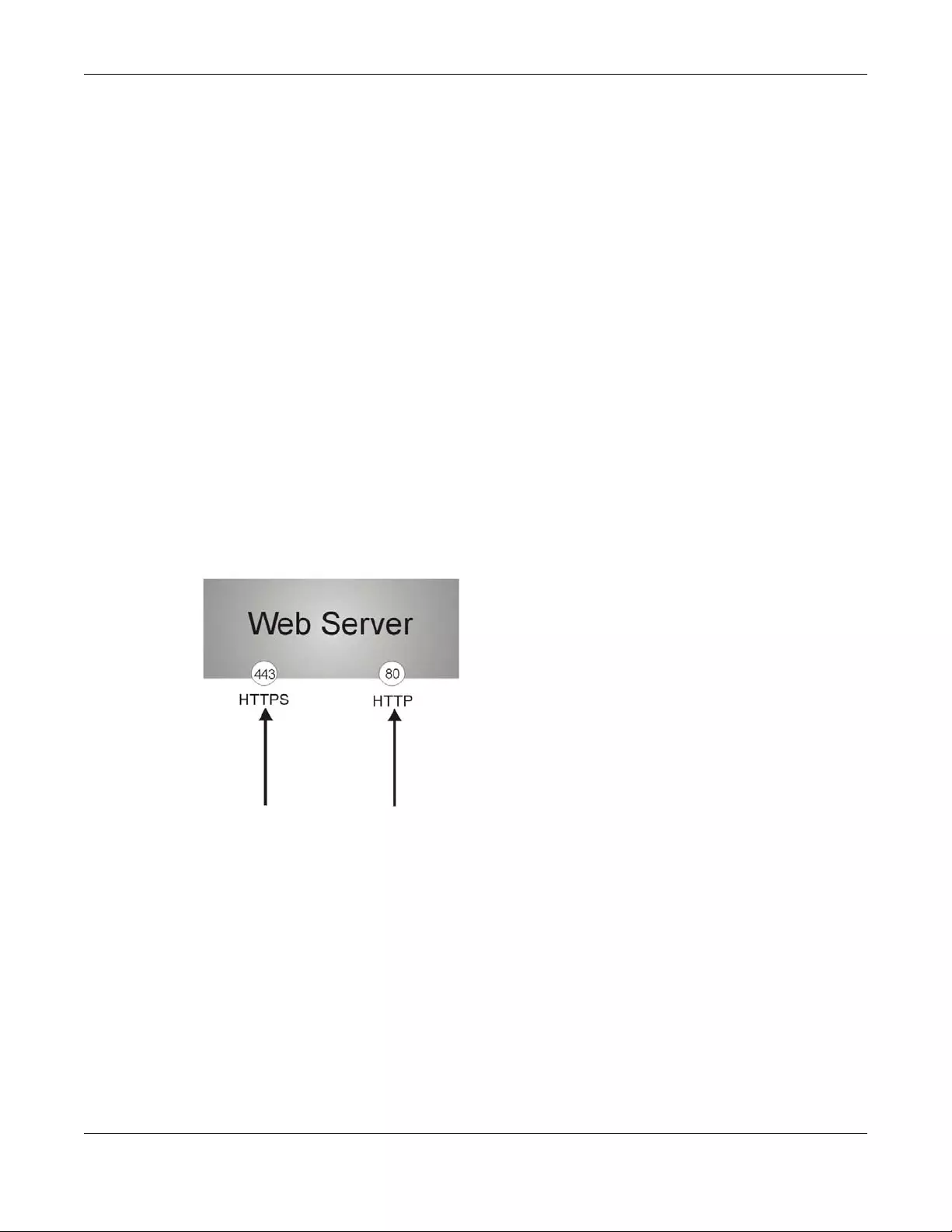
Chapter 42 System
ZyWALL USG FLEX Series User’s Guide
859
HTTPS (HyperText Transfer Protocol over Secure Socket Layer, or HTTP over SSL) is a web protocol that
encrypts and decrypts web pages. Secure Socket Layer (SSL) is an application-level protocol that
enables secure transactions of data by ensuring confidentiality (an unauthorized party cannot read the
transferred data), authentication (one party can identify the other party) and data integrity (you know if
data has been changed).
It relies upon certificates, public keys, and private keys.
HTTPS on the Zyxel Device is used so that you can securely access the Zyxel Device using the Web
Configurator. The SSL protocol specifies that the HTTPS server (the Zyxel Device) must always
authenticate itself to the HTTPS client (the computer which requests the HTTPS connection with the Zyxel
Device), whereas the HTTPS client only should authenticate itself when the HTTPS server requires it to do
so (select Authenticate Client Certificates in the WWW screen). Authenticate Client Certificates is
optional and if selected means the HTTPS client must send the Zyxel Device a certificate. You must apply
for a certificate for the browser from a CA that is a trusted CA on the Zyxel Device.
Please refer to the following figure.
1HTTPS connection requests from an SSL-aware web browser go to port 443 (by default) on the Zyxel
Device’s web server.
2HTTP connection requests from a web browser go to port 80 (by default) on the Zyxel Device’s web
server.
Figure 571 HTTP/HTTPS Implementation
Note: If you disable HTTP in the WWW screen, then the Zyxel Device blocks all HTTP connection
attempts.
42.7.4 Configuring WWW Service Control
Click Configuration > System > WWW to open the WWW screen. Use this screen to specify from which
zones you can access the Zyxel Device using HTTP or HTTPS. You can also specify which IP addresses the
access can come from.
Note: Admin Service Control deals with management access (to the Web Configurator).
User Service Control deals with user access to the Zyxel Device (logging into SSL VPN for
example).
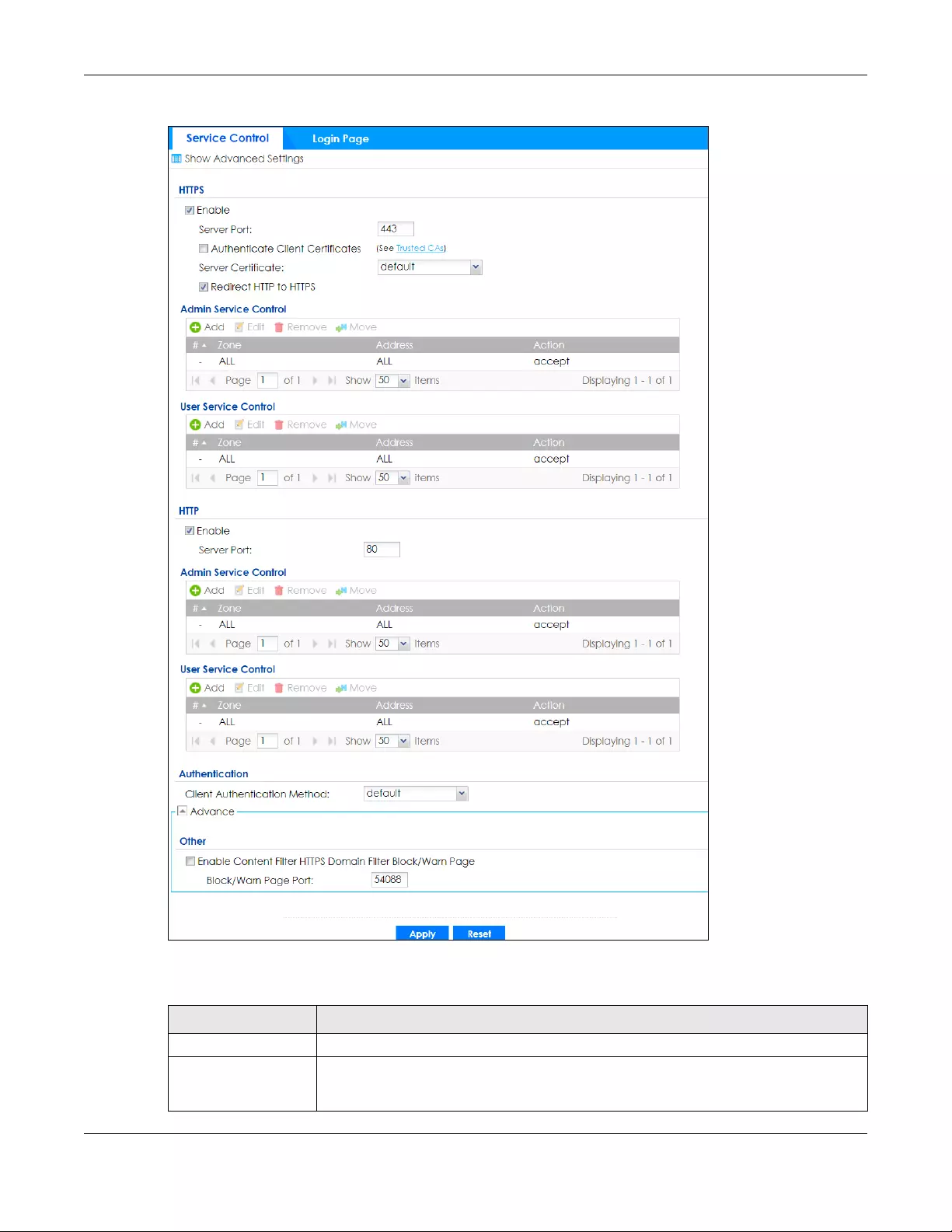
Chapter 42 System
ZyWALL USG FLEX Series User’s Guide
860
Figure 572 Configuration > System > WWW > Service Control
The following table describes the labels in this screen.
Table 376 Configuration > System > WWW > Service Control
LABEL DESCRIPTION
HTTPS
Enable Select the check box to allow or disallow the computer with the IP address that matches
the IP address(es) in the Service Control table to access the Zyxel Device Web
Configurator using secure HTTPs connections.

Chapter 42 System
ZyWALL USG FLEX Series User’s Guide
861
Server Port The HTTPS server listens on port 443 by default. If you change the HTTPS server port to a
different number on the Zyxel Device, for example 8443, then you must notify people who
need to access the Zyxel Device Web Configurator to use “https://Zyxel Device IP
Address:8443” as the URL.
Authenticate Client
Certificates
Select Authenticate Client Certificates (optional) to require the SSL client to authenticate
itself to the Zyxel Device by sending the Zyxel Device a certificate. To do that the SSL client
must have a CA-signed certificate from a CA that has been imported as a trusted CA on
the Zyxel Device (see Section 42.7.7.5 on page 870 on importing certificates for details).
Server Certificate Select a certificate the HTTPS server (the Zyxel Device) uses to authenticate itself to the
HTTPS client. You must have certificates already configured in the My Certificates screen.
Redirect HTTP to HTTPS To allow only secure Web Configurator access, select this to redirect all HTTP connection
requests to the HTTPS server.
Admin/User Service
Control
Admin Service Control specifies from which zones an administrator can use HTTPS to
manage the Zyxel Device (using the Web Configurator). You can also specify the IP
addresses from which the administrators can manage the Zyxel Device.
User Service Control specifies from which zones a user can use HTTPS to log into the Zyxel
Device (to log into SSL VPN for example). You can also specify the IP addresses from which
the users can access the Zyxel Device.
Add Click this to create a new entry. Select an entry and click Add to create a new entry after
the selected entry.
Edit Double-click an entry or select it and click Edit to be able to modify the entry’s settings.
Remove To remove an entry, select it and click Remove. The Zyxel Device confirms you want to
remove it before doing so. Note that subsequent entries move up by one when you take
this action.
Move To change an entry’s position in the numbered list, select the method and click Move to
display a field to type a number for where you want to put it and press [ENTER] to move
the rule to the number that you typed.
#This is the index number of the service control rule.
The entry with a hyphen (-) instead of a number is the Zyxel Device’s (non-configurable)
default policy. The Zyxel Device applies this to traffic that does not match any other
configured rule. It is not an editable rule. To apply other behavior, configure a rule that
traffic will match so the Zyxel Device will not have to use the default policy.
Zone This is the zone on the Zyxel Device the user is allowed or denied to access.
Address This is the object name of the IP address(es) with which the computer is allowed or denied
to access.
Action This displays whether the computer with the IP address specified above can access the
Zyxel Device zone(s) configured in the Zone field (Accept) or not (Deny).
HTTP
Enable Select the check box to allow or disallow the computer with the IP address that matches
the IP address(es) in the Service Control table to access the Zyxel Device Web
Configurator using HTTP connections.
Server Port You may change the server port number for a service if needed, however you must use
the same port number in order to use that service to access the Zyxel Device.
Admin/User Service
Control
Admin Service Control specifies from which zones an administrator can use HTTP to
manage the Zyxel Device (using the Web Configurator). You can also specify the IP
addresses from which the administrators can manage the Zyxel Device.
User Service Control specifies from which zones a user can use HTTP to log into the Zyxel
Device (to log into SSL VPN for example). You can also specify the IP addresses from which
the users can access the Zyxel Device.
Add Click this to create a new entry. Select an entry and click Add to create a new entry after
the selected entry.
Table 376 Configuration > System > WWW > Service Control (continued)
LABEL DESCRIPTION
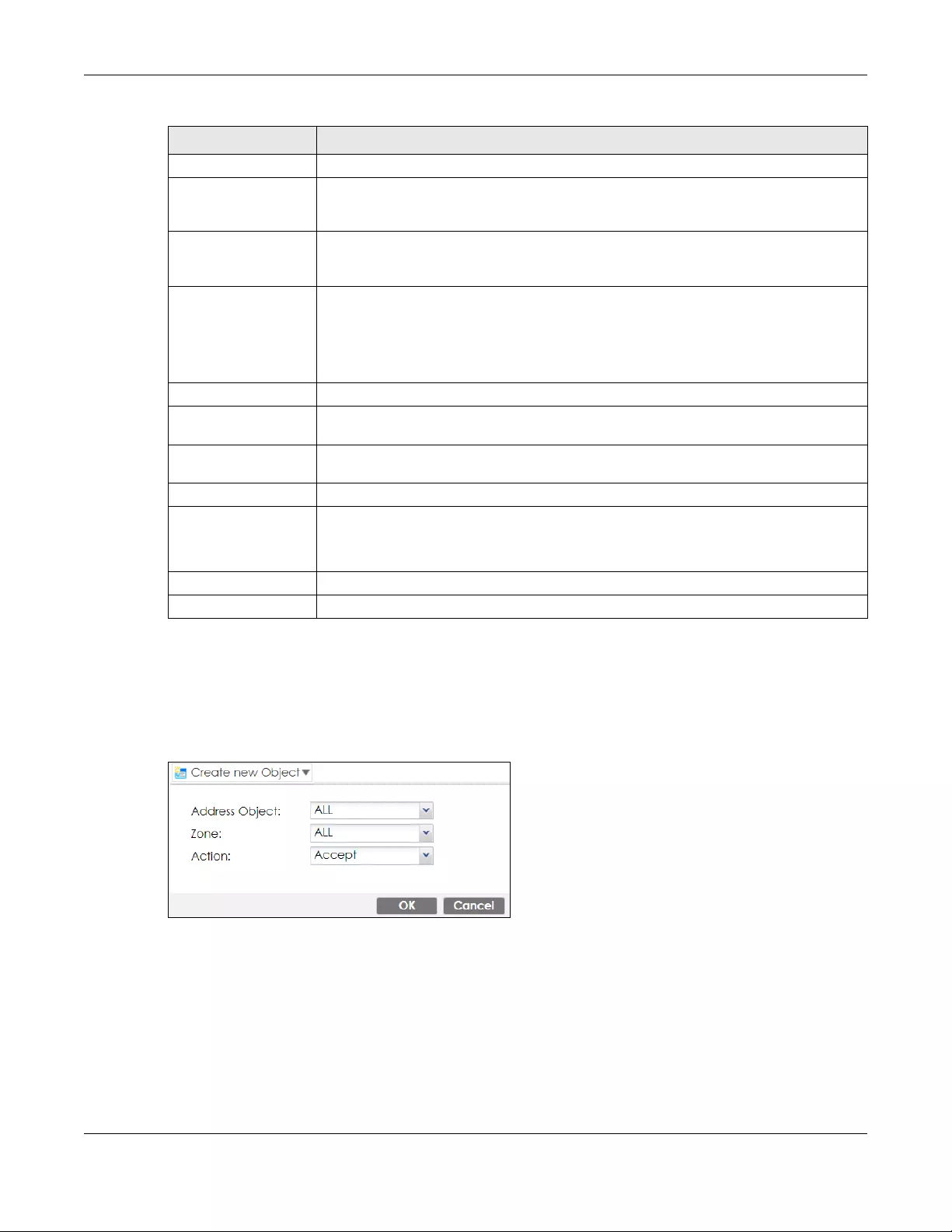
Chapter 42 System
ZyWALL USG FLEX Series User’s Guide
862
42.7.5 Service Control Rules
Click Add or Edit in the Service Control table in a WWW, SSH, Telnet, FTP or SNMP screen to add a service
control rule.
Figure 573 Configuration > System > Service Control Rule > Edit
Edit Double-click an entry or select it and click Edit to be able to modify the entry’s settings.
Remove To remove an entry, select it and click Remove. The Zyxel Device confirms you want to
remove it before doing so. Note that subsequent entries move up by one when you take
this action.
Move To change an entry’s position in the numbered list, select the method and click Move to
display a field to type a number for where you want to put it and press [ENTER] to move
the rule to the number that you typed.
#This is the index number of the service control rule.
The entry with a hyphen (-) instead of a number is the Zyxel Device’s (non-configurable)
default policy. The Zyxel Device applies this to traffic that does not match any other
configured rule. It is not an editable rule. To apply other behavior, configure a rule that
traffic will match so the Zyxel Device will not have to use the default policy.
Zone This is the zone on the Zyxel Device the user is allowed or denied to access.
Address This is the object name of the IP address(es) with which the computer is allowed or denied
to access.
Action This displays whether the computer with the IP address specified above can access the
Zyxel Device zone(s) configured in the Zone field (Accept) or not (Deny).
Authentication
Client Authentication
Method
Select a method the HTTPS or HTTP server uses to authenticate a client.
You must have configured the authentication methods in the Object > Auth. method
screen.
Apply Click Apply to save your changes back to the Zyxel Device.
Reset Click Reset to return the screen to its last-saved settings.
Table 376 Configuration > System > WWW > Service Control (continued)
LABEL DESCRIPTION

Chapter 42 System
ZyWALL USG FLEX Series User’s Guide
863
The following table describes the labels in this screen.
42.7.6 Customizing the WWW Login Page
Click Configuration > System > WWW > Login Page to open the Login Page screen. Use this screen to
customize the Web Configurator login screen. You can also customize the page that displays after an
access user logs into the Web Configurator to access network services like the Internet.
Table 377 Configuration > System > Service Control Rule > Edit
LABEL DESCRIPTION
Create new
Object
Use this to configure any new settings objects that you need to use in this screen.
Address Object Select ALL to allow or deny any computer to communicate with the Zyxel Device using this
service.
Select a predefined address object to just allow or deny the computer with the IP address that
you specified to access the Zyxel Device using this service.
Zone Select ALL to allow or prevent any Zyxel Device zones from being accessed using this service.
Select a predefined Zyxel Device zone on which a incoming service is allowed or denied.
Action Select Accept to allow the user to access the Zyxel Device from the specified computers.
Select Deny to block the user’s access to the Zyxel Device from the specified computers.
OK Click OK to save your customized settings and exit this screen.
Cancel Click Cancel to exit this screen without saving.
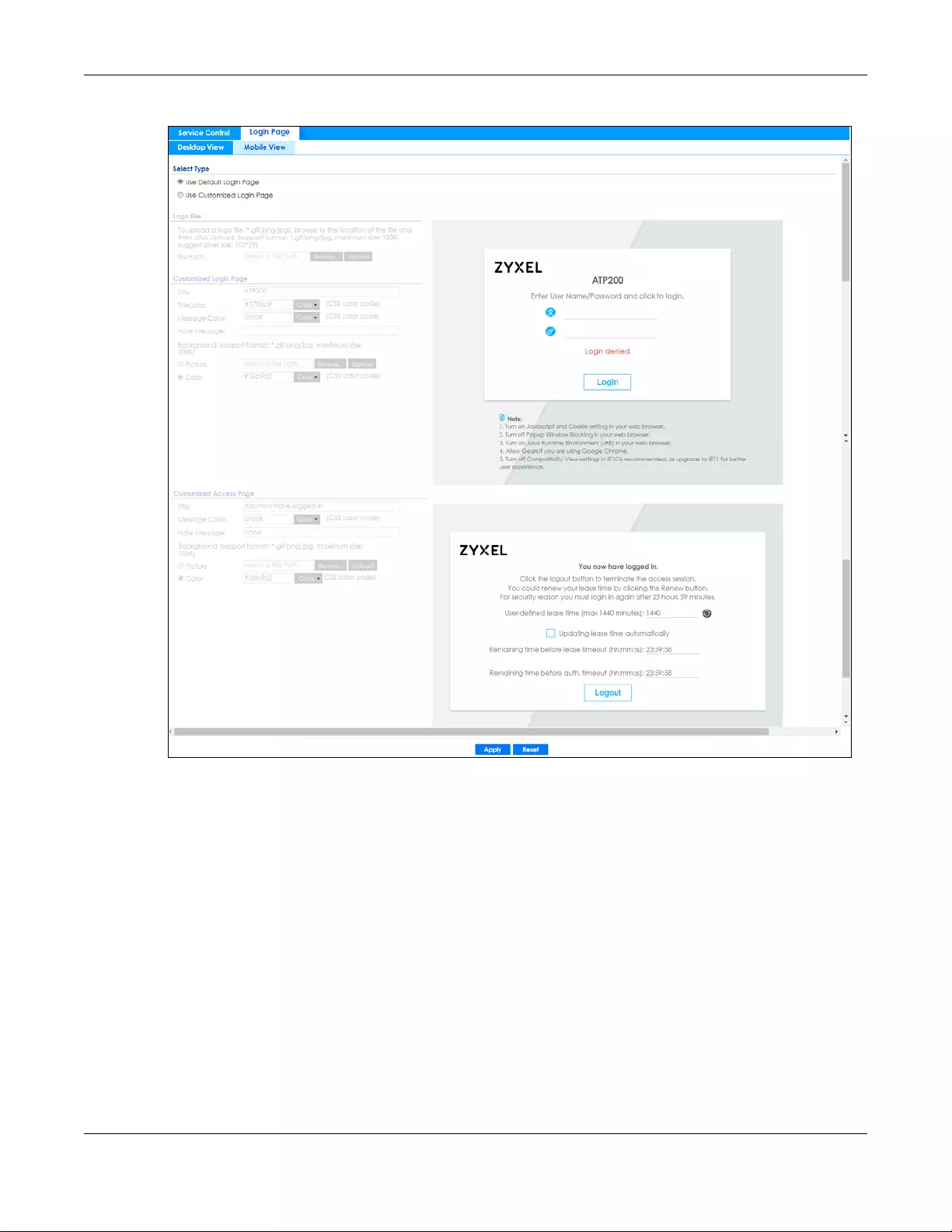
Chapter 42 System
ZyWALL USG FLEX Series User’s Guide
864
Figure 574 Configuration > System > WWW > Login Page (Desktop View)
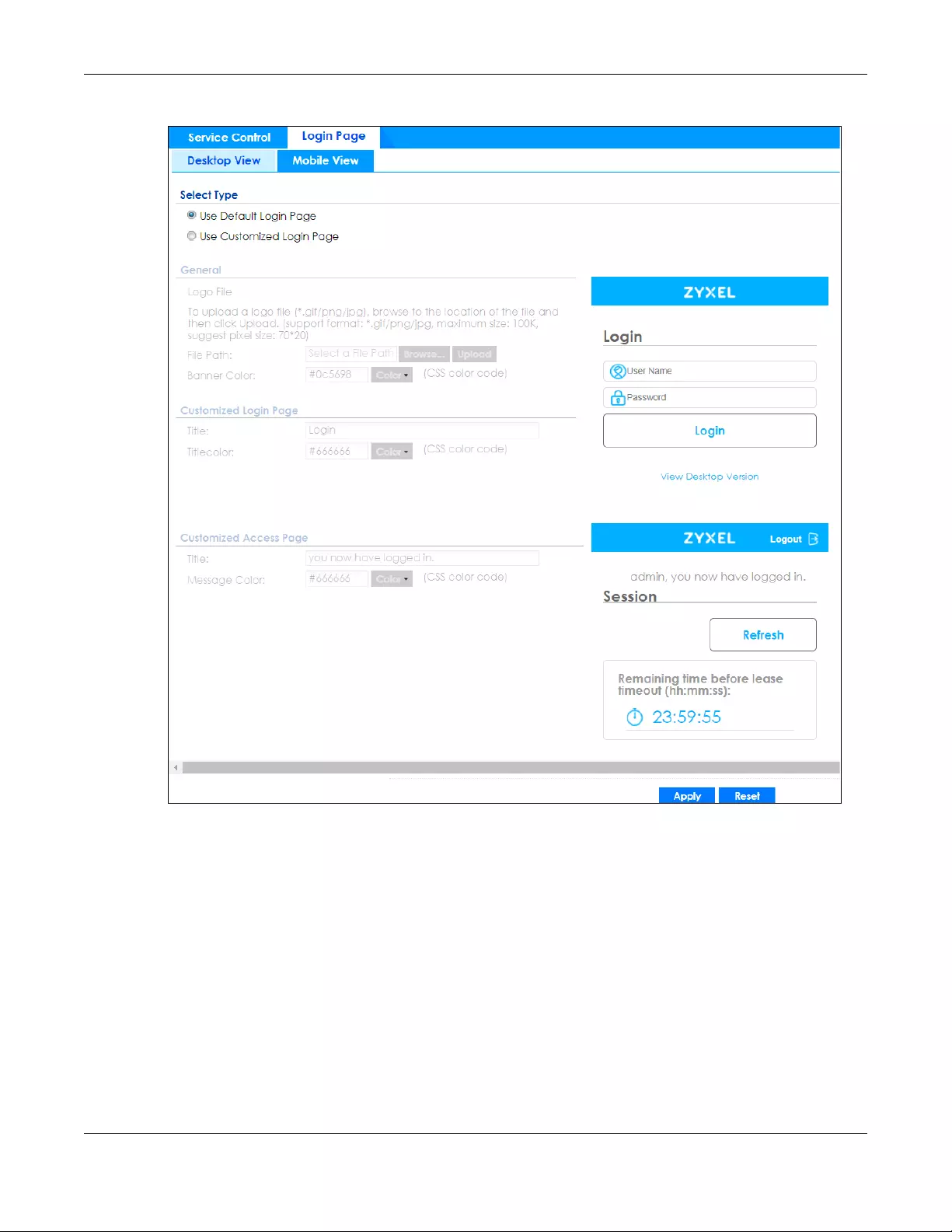
Chapter 42 System
ZyWALL USG FLEX Series User’s Guide
865
Figure 575 Configuration > System > WWW > Login Page (Mobile View)
The following figures identify the parts you can customize in the login and access pages.
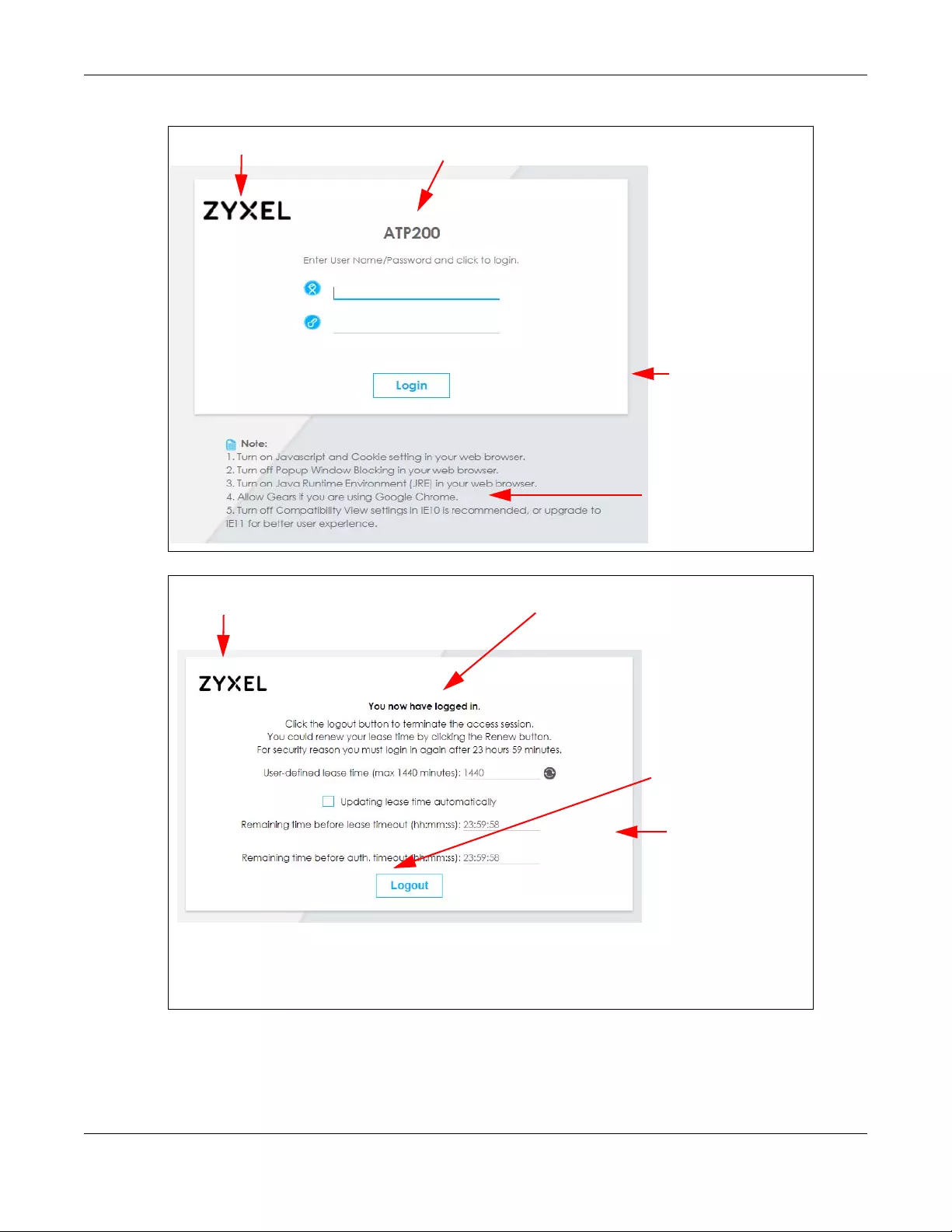
Chapter 42 System
ZyWALL USG FLEX Series User’s Guide
866
Figure 576 Login Page Customization
Figure 577 Access Page Customization
You can specify colors in one of the following ways:
• Click Color to display a screen of web-safe colors from which to choose.
• Enter the name of the desired color.
Logo Title
Message
Note Message
Background
(last line of text)
(color of all text)
Logo Title
Message
Note Message
Window
(last line of text)
(color of all text)
Background

Chapter 42 System
ZyWALL USG FLEX Series User’s Guide
867
• Enter a pound sign (#) followed by the six-digit hexadecimal number that represents the desired
color. For example, use “#000000” for black.
• Enter “rgb” followed by red, green, and blue values in parenthesis and separate by commas. For
example, use “rgb(0,0,0)” for black.
Your desired color should display in the preview screen on the right after you click in another field, click
Apply, or press [ENTER]. If your desired color does not display, your browser may not support it. Try
selecting another color.
The following table describes the labels on the screen.
Table 378 Configuration > System > WWW > Login Page
LABEL DESCRIPTION
Select Type Select whether the Web Configurator uses the default login screen or one that you customize in
the rest of this screen.
Logo File You can upload a graphic logo to be displayed on the upper left corner of the Web
Configurator login screen and access page.
Specify the location and file name of the logo graphic or click Browse to locate it.
Note: Use a GIF, JPG, or PNG of 100 kilobytes or less.
Click Upload to transfer the specified graphic file from your computer to the Zyxel Device.
Customized
Login Page
Use this section to set how the Web Configurator login screen looks.
Title Enter the title for the top of the screen. Use up to 64 printable ASCII characters. Spaces are
allowed.
Title Color Specify the color of the screen’s title text.
Message Color Specify the color of the screen’s text.
Note Message Enter a note to display at the bottom of the screen. Use up to 64 printable ASCII characters.
Spaces are allowed.
Background Set how the screen background looks.
To use a graphic, select Picture and upload a graphic. Specify the location and file name of
the logo graphic or click Browse to locate it. The picture’s size cannot be over 438 x 337 pixels.
Note: Use a GIF, JPG, or PNG of 100 kilobytes or less.
To use a color, select Color and specify the color.
Customized
Access Page
Use this section to customize the page that displays after an access user logs into the Web
Configurator to access network services like the Internet.
Title Enter the title for the top of the screen. Use up to 64 printable ASCII characters. Spaces are
allowed.
Message Color Specify the color of the screen’s text.
Note Message Enter a note to display below the title. Use up to 64 printable ASCII characters. Spaces are
allowed.
Background Set how the window’s background looks.
To use a graphic, select Picture and upload a graphic. Specify the location and file name of
the logo graphic or click Browse to locate it. The picture’s size cannot be over 438 x 337 pixels.
Note: Use a GIF, JPG, or PNG of 100 kilobytes or less.
To use a color, select Color and specify the color.
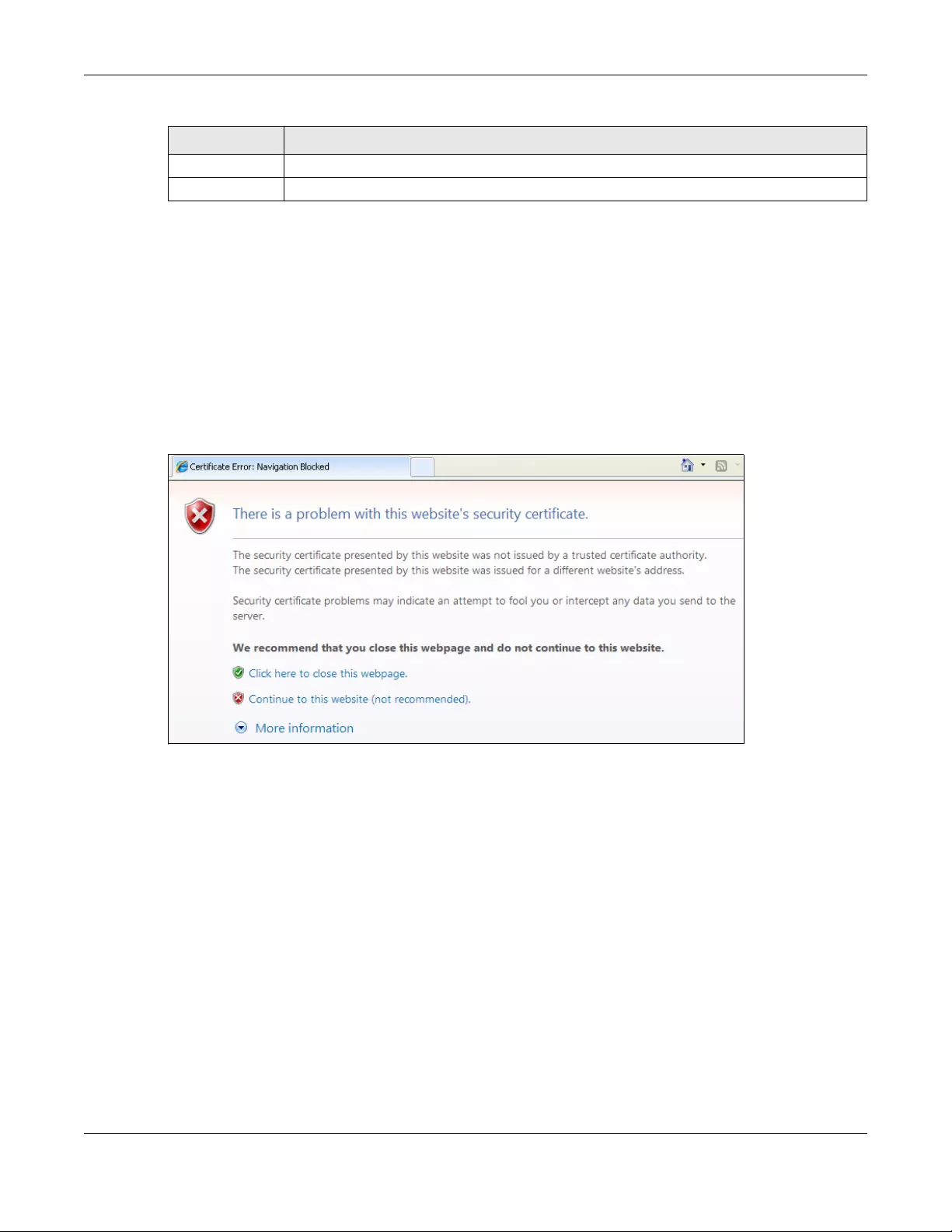
Chapter 42 System
ZyWALL USG FLEX Series User’s Guide
868
42.7.7 HTTPS Example
If you haven’t changed the default HTTPS port on the Zyxel Device, then in your browser enter “https://
Zyxel Device IP Address/” as the web site address where “Zyxel Device IP Address” is the IP address or
domain name of the Zyxel Device you wish to access.
42.7.7.1 Internet Explorer Warning Messages
When you attempt to access the Zyxel Device HTTPS server, you will see the error message shown in the
following screen.
Figure 578 Security Alert Dialog Box (Internet Explorer)
Select Continue to this website to proceed to the Web Configurator login screen. Otherwise, select Click
here to close this web page to block the access.
42.7.7.2 Mozilla Firefox Warning Messages
When you attempt to access the Zyxel Device HTTPS server, a The Connection is Untrusted screen
appears as shown in the following screen. Click Technical Details if you want to verify more information
about the certificate from the Zyxel Device.
Select I Understand the Risks and then click Add Exception to add the Zyxel Device to the security
exception list. Click Confirm Security Exception.
Apply Click Apply to save your changes back to the Zyxel Device.
Reset Click Reset to return the screen to its last-saved settings.
Table 378 Configuration > System > WWW > Login Page (continued)
LABEL DESCRIPTION
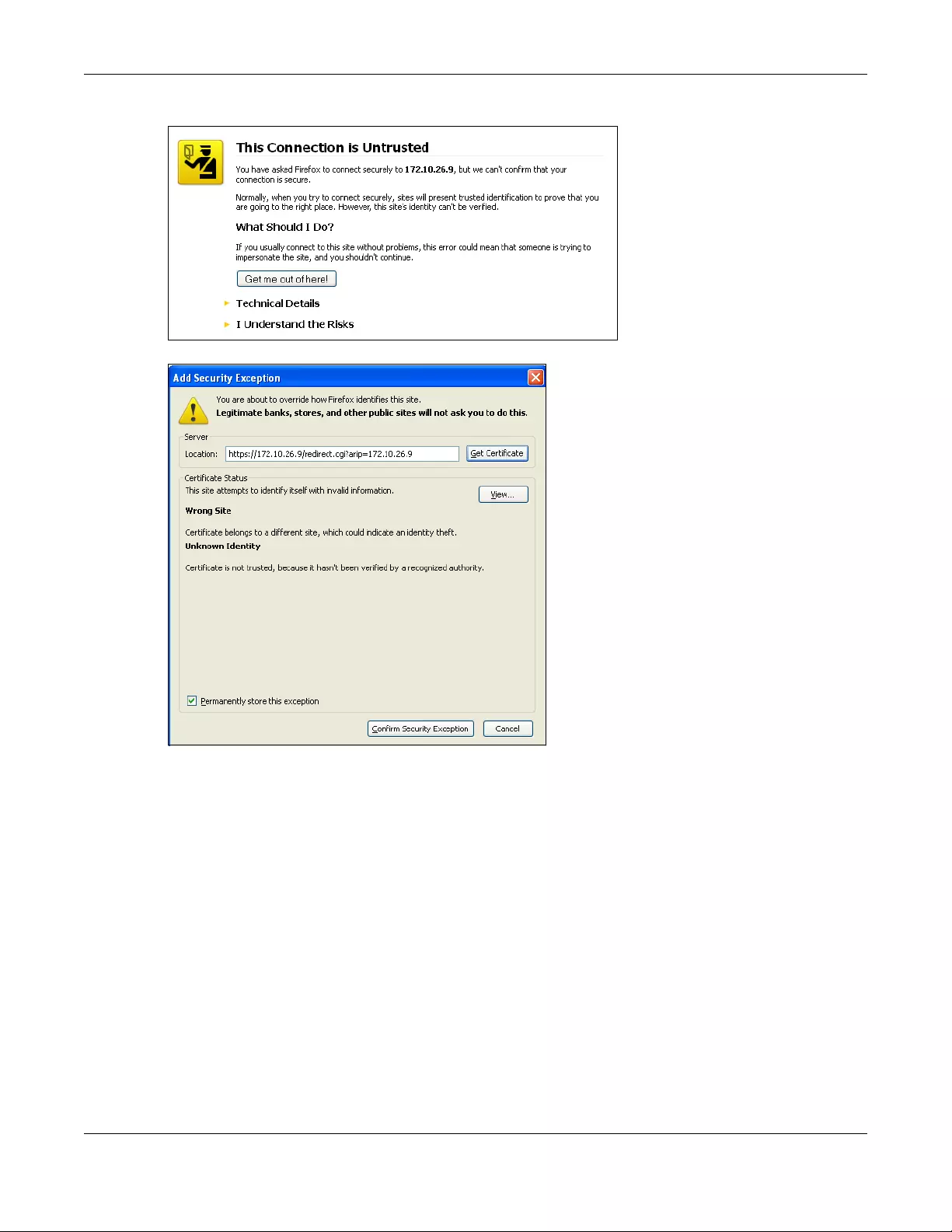
Chapter 42 System
ZyWALL USG FLEX Series User’s Guide
869
Figure 579 Security Certificate 1 (Firefox)
Figure 580 Security Certificate 2 (Firefox)
42.7.7.3 Avoiding Browser Warning Messages
Here are the main reasons your browser displays warnings about the Zyxel Device’s HTTPS server
certificate and what you can do to avoid seeing the warnings:
• The issuing certificate authority of the Zyxel Device’s HTTPS server certificate is not one of the browser’s
trusted certificate authorities. The issuing certificate authority of the Zyxel Device's factory default
certificate is the Zyxel Device itself since the certificate is a self-signed certificate.
• For the browser to trust a self-signed certificate, import the self-signed certificate into your operating
system as a trusted certificate.
• To have the browser trust the certificates issued by a certificate authority, import the certificate
authority’s certificate into your operating system as a trusted certificate.
42.7.7.4 Login Screen
After you accept the certificate, the Zyxel Device login screen appears. The lock displayed in the
bottom of the browser status bar denotes a secure connection.
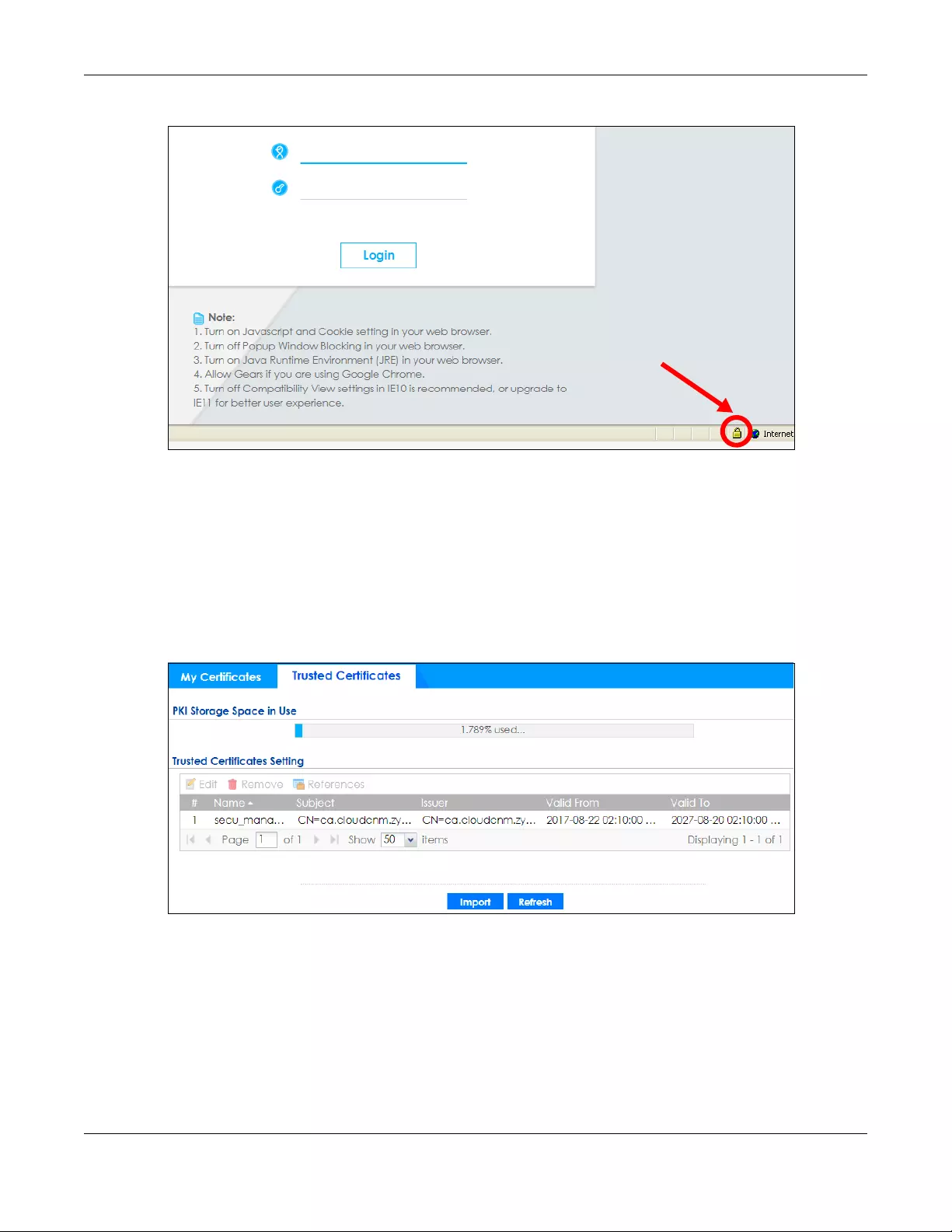
Chapter 42 System
ZyWALL USG FLEX Series User’s Guide
870
Figure 581 Login Screen (Internet Explorer)
42.7.7.5 Enrolling and Importing SSL Client Certificates
The SSL client needs a certificate if Authenticate Client Certificates is selected on the Zyxel Device.
You must have imported at least one trusted CA to the Zyxel Device in order for the Authenticate Client
Certificates to be active (see the Certificates chapter for details).
Apply for a certificate from a Certification Authority (CA) that is trusted by the Zyxel Device (see the
Zyxel Device’s Trusted CA Web Configurator screen).
Figure 582 Zyxel Device Trusted CA Screen
The CA sends you a package containing the CA’s trusted certificate(s), your personal certificate(s) and
a password to install the personal certificate(s).
42.7.7.5.1 Installing the CA’s Certificate
1Double click the CA’s trusted certificate to produce a screen similar to the one shown next.

Chapter 42 System
ZyWALL USG FLEX Series User’s Guide
871
Figure 583 CA Certificate Example
2Click Install Certificate and follow the wizard as shown earlier in this appendix.
42.7.7.5.2 Installing Your Personal Certificate(s)
You need a password in advance. The CA may issue the password or you may have to specify it during
the enrollment. Double-click the personal certificate given to you by the CA to produce a screen similar
to the one shown next
1Click Next to begin the wizard.

Chapter 42 System
ZyWALL USG FLEX Series User’s Guide
872
Figure 584 Personal Certificate Import Wizard 1
2The file name and path of the certificate you double-clicked should automatically appear in the File
name text box. Click Browse if you wish to import a different certificate.
Figure 585 Personal Certificate Import Wizard 2
3Enter the password given to you by the CA.

Chapter 42 System
ZyWALL USG FLEX Series User’s Guide
873
Figure 586 Personal Certificate Import Wizard 3
4Have the wizard determine where the certificate should be saved on your computer or select Place all
certificates in the following store and choose a different location.
Figure 587 Personal Certificate Import Wizard 4
5Click Finish to complete the wizard and begin the import process.

Chapter 42 System
ZyWALL USG FLEX Series User’s Guide
874
Figure 588 Personal Certificate Import Wizard 5
6You should see the following screen when the certificate is correctly installed on your computer.
Figure 589 Personal Certificate Import Wizard 6
42.7.7.6 Using a Certificate When Accessing the Zyxel Device Example
Use the following procedure to access the Zyxel Device via HTTPS.
1Enter ‘https://Zyxel Device IP Address/ in your browser’s web address field.
Figure 590 Access the Zyxel Device Via HTTPS
2When Authenticate Client Certificates is selected on the Zyxel Device, the following screen asks you to
select a personal certificate to send to the Zyxel Device. This screen displays even if you only have a
single certificate as in the example.

Chapter 42 System
ZyWALL USG FLEX Series User’s Guide
875
Figure 591 SSL Client Authentication
3You next see the Web Configurator login screen.
Figure 592 Secure Web Configurator Login Screen
42.8 SSH
You can use SSH (Secure SHell) to securely access the Zyxel Device’s command line interface. Specify
which zones allow SSH access and from which IP address the access can come.
SSH is a secure communication protocol that combines authentication and data encryption to provide
secure encrypted communication between two hosts over an unsecured network. In the following
figure, computer A on the Internet uses SSH to securely connect to the WAN port of the Zyxel Device for
a management session.

Chapter 42 System
ZyWALL USG FLEX Series User’s Guide
876
Note: To allow an SSH connection to the Zyxel Device, add SSH in the Object > Service >
Service Group > Default_Allow_WAN_To_ZyWALL service group which defines the
default services allowed in the WAN_to_Device security policy.
Figure 593 SSH Communication Over the WAN Example
42.8.1 SSH Implementation on the Zyxel Device
Your Zyxel Device supports SSH version 2 using RSA authentication and four encryption methods (AES,
3DES, Archfour, and Blowfish). The SSH server is implemented on the Zyxel Device for management using
port 22 (by default).
42.8.2 Requirements for Using SSH
You must install an SSH client program on a client computer (Windows or Linux operating system) that is
used to connect to the Zyxel Device over SSH.
42.8.3 Configuring SSH
Click Configuration > System > SSH to change your Zyxel Device’s Secure Shell settings. Use this screen to
specify from which zones SSH can be used to manage the Zyxel Device. You can also specify from
which IP addresses the access can come.
Figure 594 Configuration > System > SSH
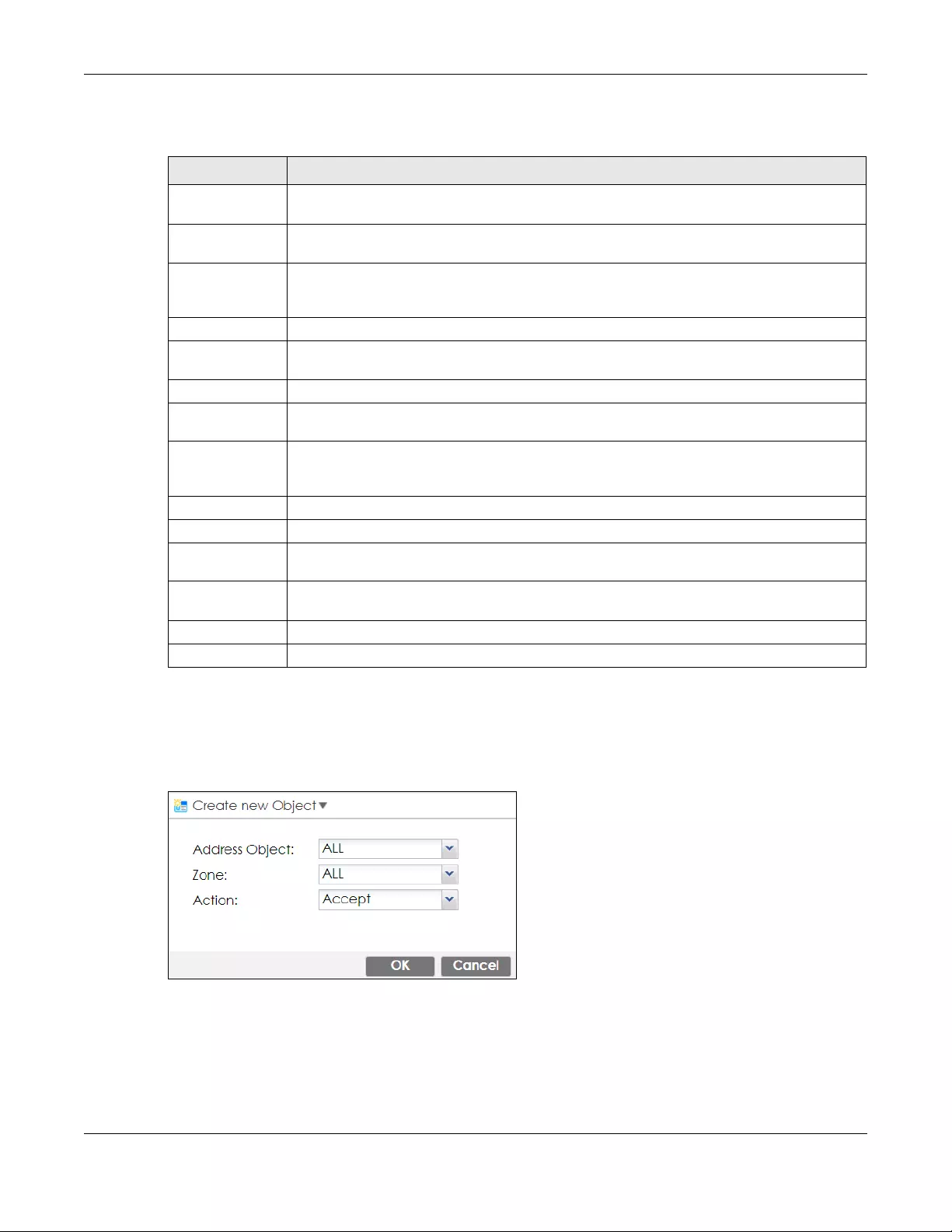
Chapter 42 System
ZyWALL USG FLEX Series User’s Guide
877
The following table describes the labels in this screen.
42.8.4 Service Control Rules
Click the Add or Edit icon in the Service Control table to add a service control rule.
Figure 595 Configuration > System > SSH > Service Control Rule Add/Edit
Table 379 Configuration > System > SSH
LABEL DESCRIPTION
Enable Select the check box to allow or disallow the computer with the IP address that matches the IP
address(es) in the Service Control table to access the Zyxel Device CLI using this service.
Server Port You may change the server port number for a service if needed, however you must use the
same port number in order to use that service for remote management.
Server Certificate Select the certificate whose corresponding private key is to be used to identify the Zyxel
Device for SSH connections. You must have certificates already configured in the My
Certificates screen.
Service Control This specifies from which computers you can access which Zyxel Device zones.
Add Click this to create a new entry. Select an entry and click Add to create a new entry after the
selected entry. Refer to Table 377 on page 863 for details on the screen that opens.
Edit Double-click an entry or select it and click Edit to be able to modify the entry’s settings.
Remove To remove an entry, select it and click Remove. The Zyxel Device confirms you want to remove
it before doing so. Note that subsequent entries move up by one when you take this action.
Move To change an entry’s position in the numbered list, select the method and click Move to
display a field to type a number for where you want to put it and press [ENTER] to move the rule
to the number that you typed.
#This the index number of the service control rule.
Zone This is the zone on the Zyxel Device the user is allowed or denied to access.
Address This is the object name of the IP address(es) with which the computer is allowed or denied to
access.
Action This displays whether the computer with the IP address specified above can access the Zyxel
Device zone(s) configured in the Zone field (Accept) or not (Deny).
Apply Click Apply to save your changes back to the Zyxel Device.
Reset Click Reset to return the screen to its last-saved settings.

Chapter 42 System
ZyWALL USG FLEX Series User’s Guide
878
The following table describes the labels in this screen.
42.8.5 SSH Example
This section shows using a PuTTY SSH client to remotely access the Zyxel Device. The configuration and
connection steps are similar for most SSH client programs. Refer to your SSH client program user’s guide.
1Launch the SSH client and configure the SSH client to use SSH version 2.
2Specify the connection information (IP address, port number) for the Zyxel Device.
Table 380 Configuration > System > SSH > Service Control Rule Add/Edit
LABEL DESCRIPTION
Create new
Object
Use this to configure any new settings objects that you need to use in this screen.
Address Object Select ALL to allow or deny any computer to communicate with the Zyxel Device using SSH.
Select a predefined address object to just allow or deny the computer with the IP address that
you specified to access the Zyxel Device using SSH.
Zone Select ALL to allow or prevent any Zyxel Device zones from being accessed using SSH.
Select a predefined Zyxel Device zone on which a incoming service is allowed or denied.
Action Select Accept to allow the user to access the Zyxel Device from the specified computers.
Select Deny to block the user’s access to the Zyxel Device from the specified computers.
OK Click OK to save your customized settings and exit this screen.
Cancel Click Cancel to exit this screen without saving.

Chapter 42 System
ZyWALL USG FLEX Series User’s Guide
879
3A command window displays. Enter the password to log in to the Zyxel Device.
42.9 Telnet
You can use Telnet to access the Zyxel Device’s command line interface. Specify which zones allow
Telnet access and from which IP address the access can come.
42.9.1 Configuring Telnet
Click Configuration > System > TELNET to configure your Zyxel Device for remote Telnet access. Use this
screen to specify from which zones Telnet can be used to manage the Zyxel Device. You can also
specify from which IP addresses the access can come.
Note: To allow a Telnet connection to the Zyxel Device, add Telnet in the Object > Service >
Service Group > Default_Allow_WAN_To_ZyWALL service group which defines the
default services allowed in the WAN_to_Device security policy.
login as: admin
Using keyboard-interactive authentication.
Password:
% session is not found
Bad terminal type: "xterm". Will assume vt100.
Router> enable
Router#
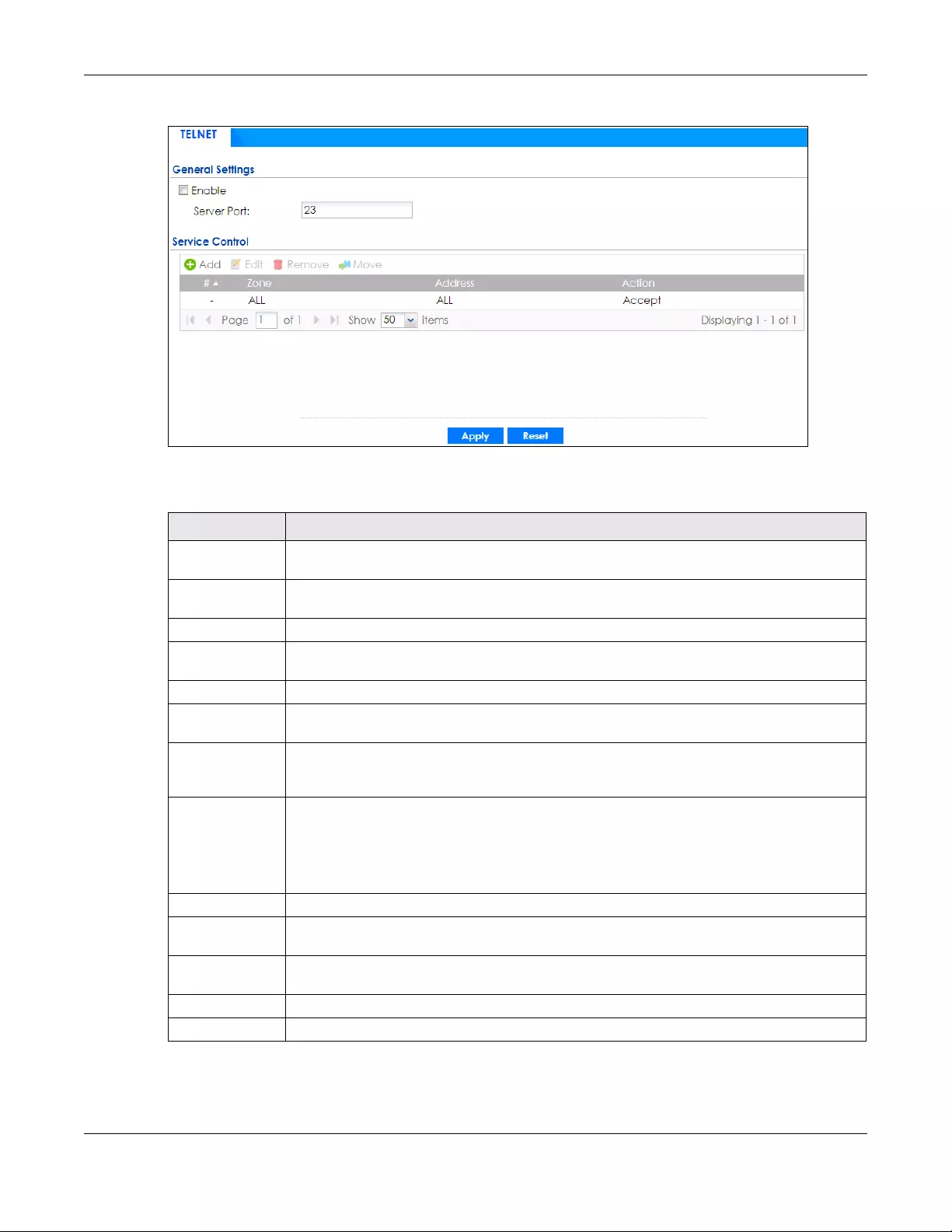
Chapter 42 System
ZyWALL USG FLEX Series User’s Guide
880
Figure 596 Configuration > System > TELNET
The following table describes the labels in this screen.
Table 381 Configuration > System > TELNET
LABEL DESCRIPTION
Enable Select the check box to allow or disallow the computer with the IP address that matches the IP
address(es) in the Service Control table to access the Zyxel Device CLI using this service.
Server Port You may change the server port number for a service if needed, however you must use the
same port number in order to use that service for remote management.
Service Control This specifies from which computers you can access which Zyxel Device zones.
Add Click this to create a new entry. Select an entry and click Add to create a new entry after the
selected entry. Refer to Table 377 on page 863 for details on the screen that opens.
Edit Double-click an entry or select it and click Edit to be able to modify the entry’s settings.
Remove To remove an entry, select it and click Remove. The Zyxel Device confirms you want to remove
it before doing so. Note that subsequent entries move up by one when you take this action.
Move To change an entry’s position in the numbered list, select the method and click Move to display
a field to type a number for where you want to put it and press [ENTER] to move the rule to the
number that you typed.
#This the index number of the service control rule.
The entry with a hyphen (-) instead of a number is the Zyxel Device’s (non-configurable) default
policy. The Zyxel Device applies this to traffic that does not match any other configured rule. It
is not an editable rule. To apply other behavior, configure a rule that traffic will match so the
Zyxel Device will not have to use the default policy.
Zone This is the zone on the Zyxel Device the user is allowed or denied to access.
Address This is the object name of the IP address(es) with which the computer is allowed or denied to
access.
Action This displays whether the computer with the IP address specified above can access the Zyxel
Device zone(s) configured in the Zone field (Accept) or not (Deny).
Apply Click Apply to save your changes back to the Zyxel Device.
Reset Click Reset to return the screen to its last-saved settings.
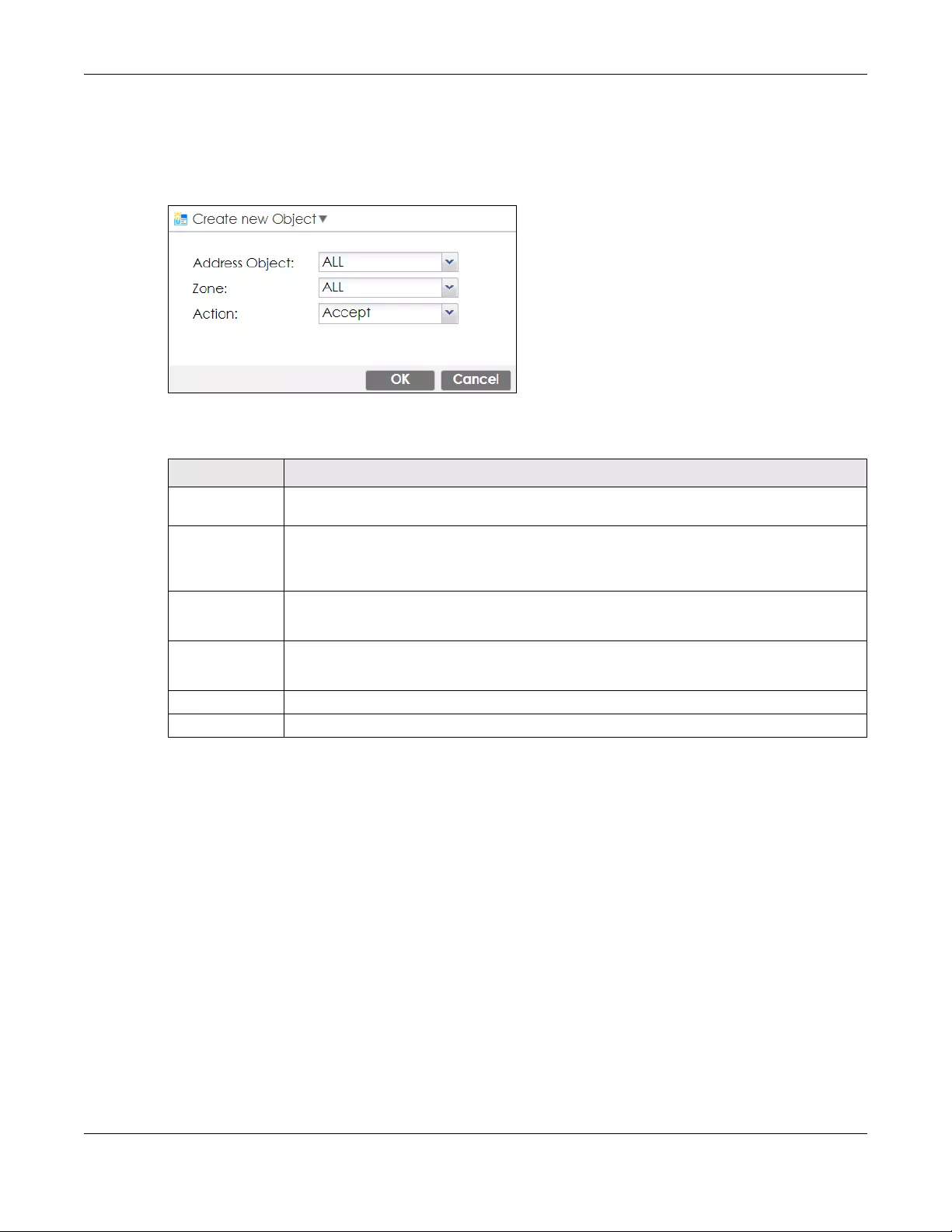
Chapter 42 System
ZyWALL USG FLEX Series User’s Guide
881
42.9.2 Service Control Rules
Click the Add or Edit icon in the Service Control table to add a service control rule.
Figure 597 Configuration > System > TELNET > Service Control Rule Add/Edit
The following table describes the labels in this screen.
42.10 FTP
You can upload and download the Zyxel Device’s firmware and configuration files using FTP. To use this
feature, your computer must have an FTP client.
42.10.1 Configuring FTP
To change your Zyxel Device’s FTP settings, click Configuration > System > FTP tab. The screen appears
as shown. Use this screen to specify from which zones FTP can be used to access the Zyxel Device. You
can also specify from which IP addresses the access can come.
Table 382 Configuration > System > TELNET > Service Control Rule Add/Edit
LABEL DESCRIPTION
Create new
Object
Use this to configure any new settings objects that you need to use in this screen.
Address Object Select ALL to allow or deny any computer to communicate with the Zyxel Device using Telnet.
Select a predefined address object to just allow or deny the computer with the IP address that
you specified to access the Zyxel Device using Telnet.
Zone Select ALL to allow or prevent any Zyxel Device zones from being accessed using Telnet.
Select a predefined Zyxel Device zone on which a incoming service is allowed or denied.
Action Select Accept to allow the user to access the Zyxel Device from the specified computers.
Select Deny to block the user’s access to the Zyxel Device from the specified computers.
OK Click OK to save your customized settings and exit this screen.
Cancel Click Cancel to exit this screen without saving.
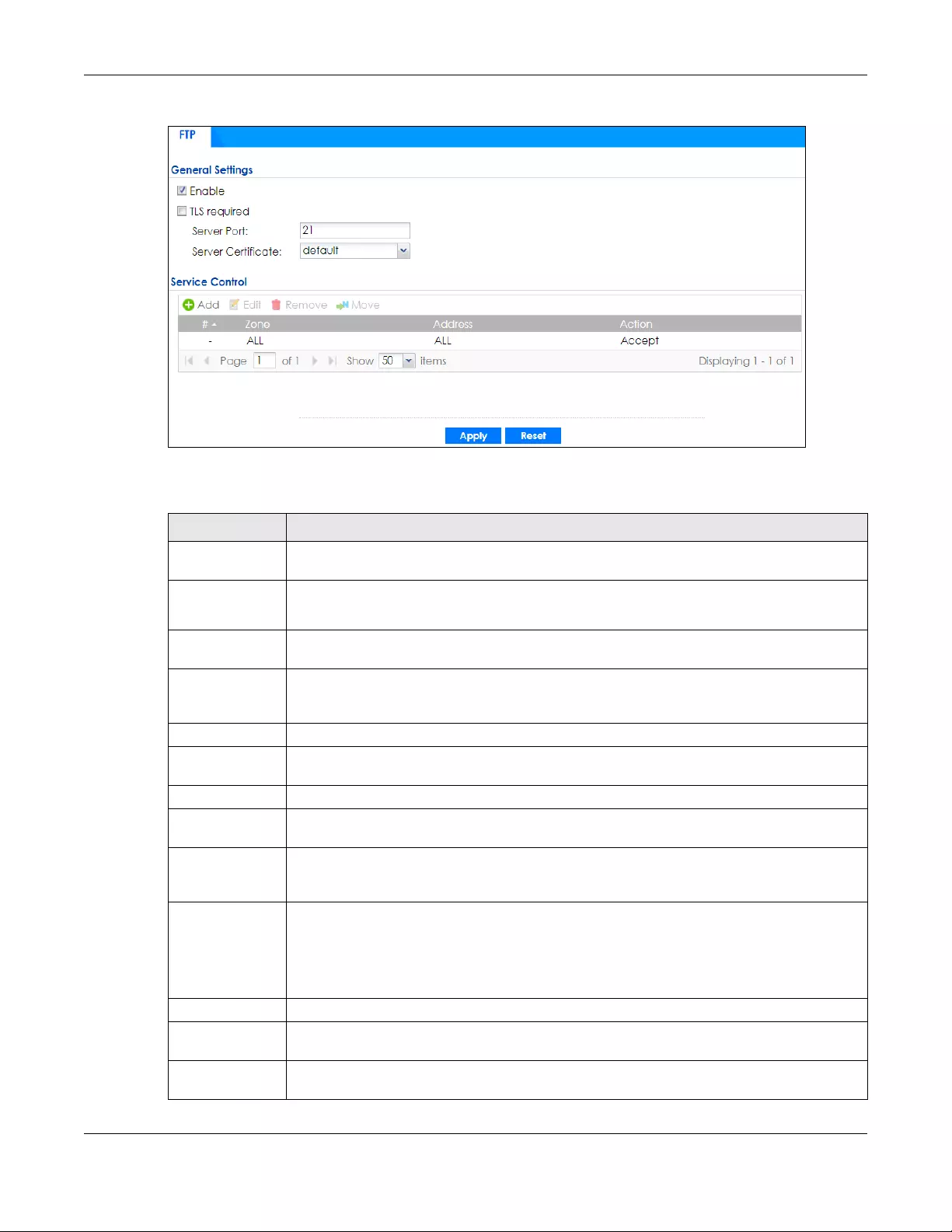
Chapter 42 System
ZyWALL USG FLEX Series User’s Guide
882
Figure 598 Configuration > System > FTP
The following table describes the labels in this screen.
Table 383 Configuration > System > FTP
LABEL DESCRIPTION
Enable Select the check box to allow or disallow the computer with the IP address that matches the IP
address(es) in the Service Control table to access the Zyxel Device using this service.
TLS required Select the check box to use FTP over TLS (Transport Layer Security) to encrypt communication.
This implements TLS as a security mechanism to secure FTP clients and/or servers.
Server Port You may change the server port number for a service if needed, however you must use the
same port number in order to use that service for remote management.
Server Certificate Select the certificate whose corresponding private key is to be used to identify the Zyxel Device
for FTP connections. You must have certificates already configured in the My Certificates
screen.
Service Control This specifies from which computers you can access which Zyxel Device zones.
Add Click this to create a new entry. Select an entry and click Add to create a new entry after the
selected entry. Refer to Table 377 on page 863 for details on the screen that opens.
Edit Double-click an entry or select it and click Edit to be able to modify the entry’s settings.
Remove To remove an entry, select it and click Remove. The Zyxel Device confirms you want to remove
it before doing so. Note that subsequent entries move up by one when you take this action.
Move To change an entry’s position in the numbered list, select the method and click Move to display
a field to type a number for where you want to put it and press [ENTER] to move the rule to the
number that you typed.
#This the index number of the service control rule.
The entry with a hyphen (-) instead of a number is the Zyxel Device’s (non-configurable) default
policy. The Zyxel Device applies this to traffic that does not match any other configured rule. It
is not an editable rule. To apply other behavior, configure a rule that traffic will match so the
Zyxel Device will not have to use the default policy.
Zone This is the zone on the Zyxel Device the user is allowed or denied to access.
Address This is the object name of the IP address(es) with which the computer is allowed or denied to
access.
Action This displays whether the computer with the IP address specified above can access the Zyxel
Device zone(s) configured in the Zone field (Accept) or not (Deny).
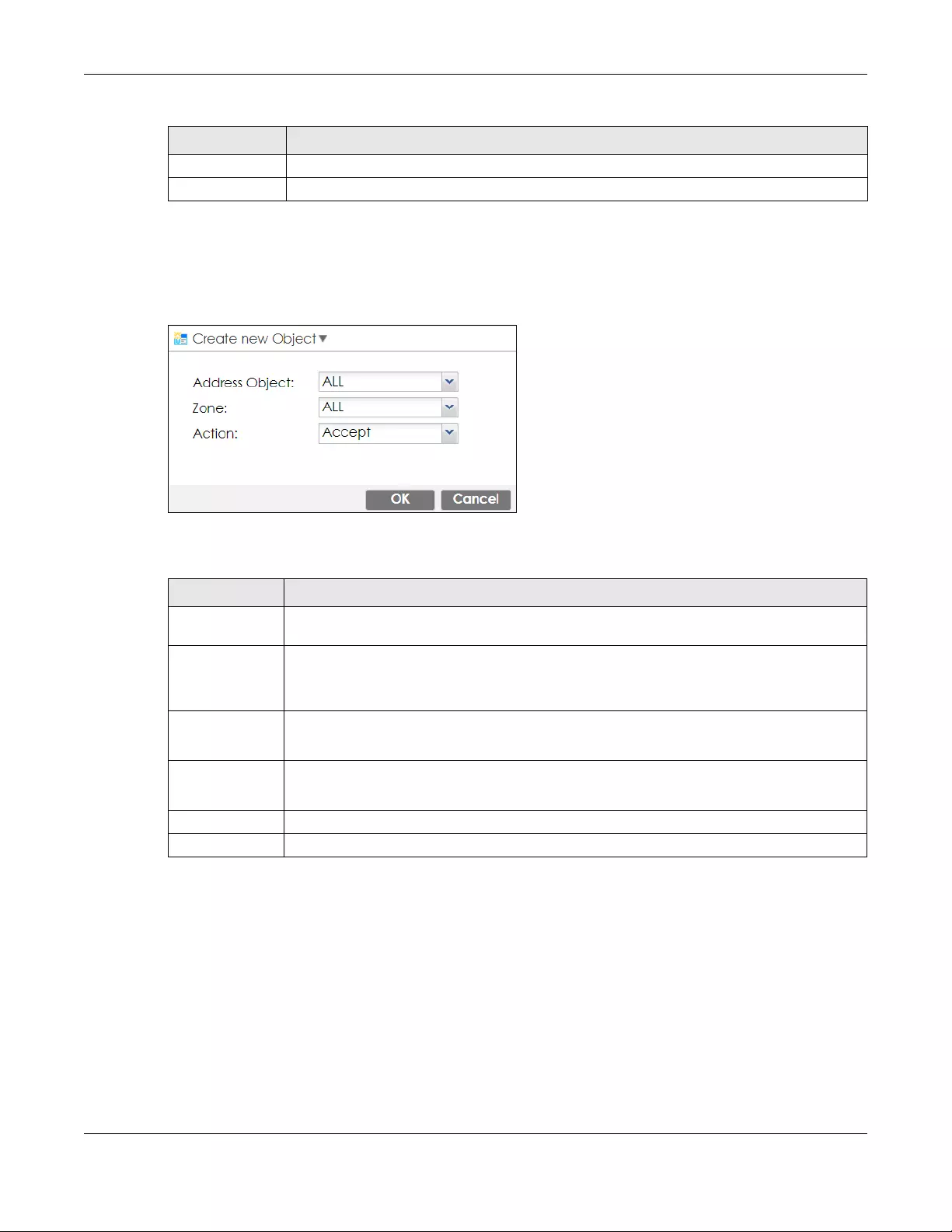
Chapter 42 System
ZyWALL USG FLEX Series User’s Guide
883
42.10.2 Service Control Rules
Click the Add or Edit icon in the Service Control table to add a service control rule.
Figure 599 Configuration > System > FTP > Service Control Rule Add/Edit
The following table describes the labels in this screen.
42.11 SNMP
Simple Network Management Protocol is a protocol used for exchanging management information
between network devices. Your Zyxel Device supports SNMP agent functionality, which allows a
manager station to manage and monitor the Zyxel Device through the network. The Zyxel Device
supports SNMP version one (SNMPv1), version two (SNMPv2c) and version 3 (SNMPv3). The next figure
illustrates an SNMP management operation.
Apply Click Apply to save your changes back to the Zyxel Device.
Reset Click Reset to return the screen to its last-saved settings.
Table 383 Configuration > System > FTP (continued)
LABEL DESCRIPTION
Table 384 Configuration > System > FTP > Service Control Rule Add/Edit
LABEL DESCRIPTION
Create new
Object
Use this to configure any new settings objects that you need to use in this screen.
Address Object Select ALL to allow or deny any computer to communicate with the Zyxel Device using FTP.
Select a predefined address object to just allow or deny the computer with the IP address that
you specified to access the Zyxel Device using FTP.
Zone Select ALL to allow or prevent any Zyxel Device zones from being accessed using FTP.
Select a predefined Zyxel Device zone on which a incoming service is allowed or denied.
Action Select Accept to allow the user to access the Zyxel Device from the specified computers.
Select Deny to block the user’s access to the Zyxel Device from the specified computers.
OK Click OK to save your customized settings and exit this screen.
Cancel Click Cancel to exit this screen without saving.
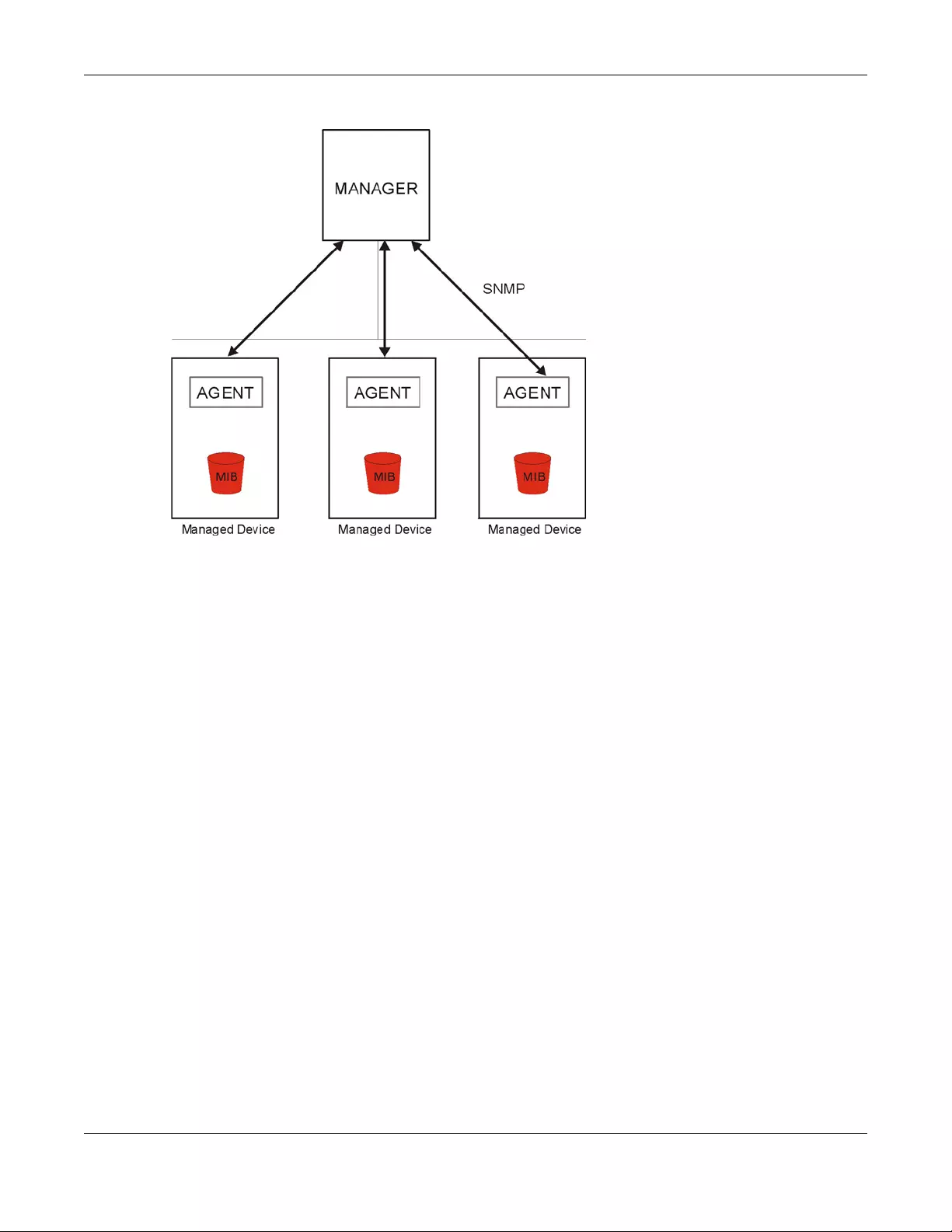
Chapter 42 System
ZyWALL USG FLEX Series User’s Guide
884
Figure 600 SNMP Management Model
An SNMP managed network consists of two main types of component: agents and a manager.
An agent is a management software module that resides in a managed device (the Zyxel Device). An
agent translates the local management information from the managed device into a form compatible
with SNMP. The manager is the console through which network administrators perform network
management functions. It executes applications that control and monitor managed devices.
The managed devices contain object variables/managed objects that define each piece of
information to be collected about a device. Examples of variables include such as number of packets
received, node port status etc. A Management Information Base (MIB) is a collection of managed
objects. SNMP allows a manager and agents to communicate for the purpose of accessing these
objects.
SNMP itself is a simple request/response protocol based on the manager/agent model. The manager
issues a request and the agent returns responses using the following protocol operations:
• Get - Allows the manager to retrieve an object variable from the agent.
• GetNext - Allows the manager to retrieve the next object variable from a table or list within an agent.
In SNMPv1, when a manager wants to retrieve all elements of a table from an agent, it initiates a Get
operation, followed by a series of GetNext operations.
• Set - Allows the manager to set values for object variables within an agent.
• Trap - Used by the agent to inform the manager of some events.
42.11.1 SNMPv3 and Security
SNMPv3 enhances security for SNMP management using authentication and encryption. SNMP
managers can be required to authenticate with agents before conducting SNMP management
sessions.
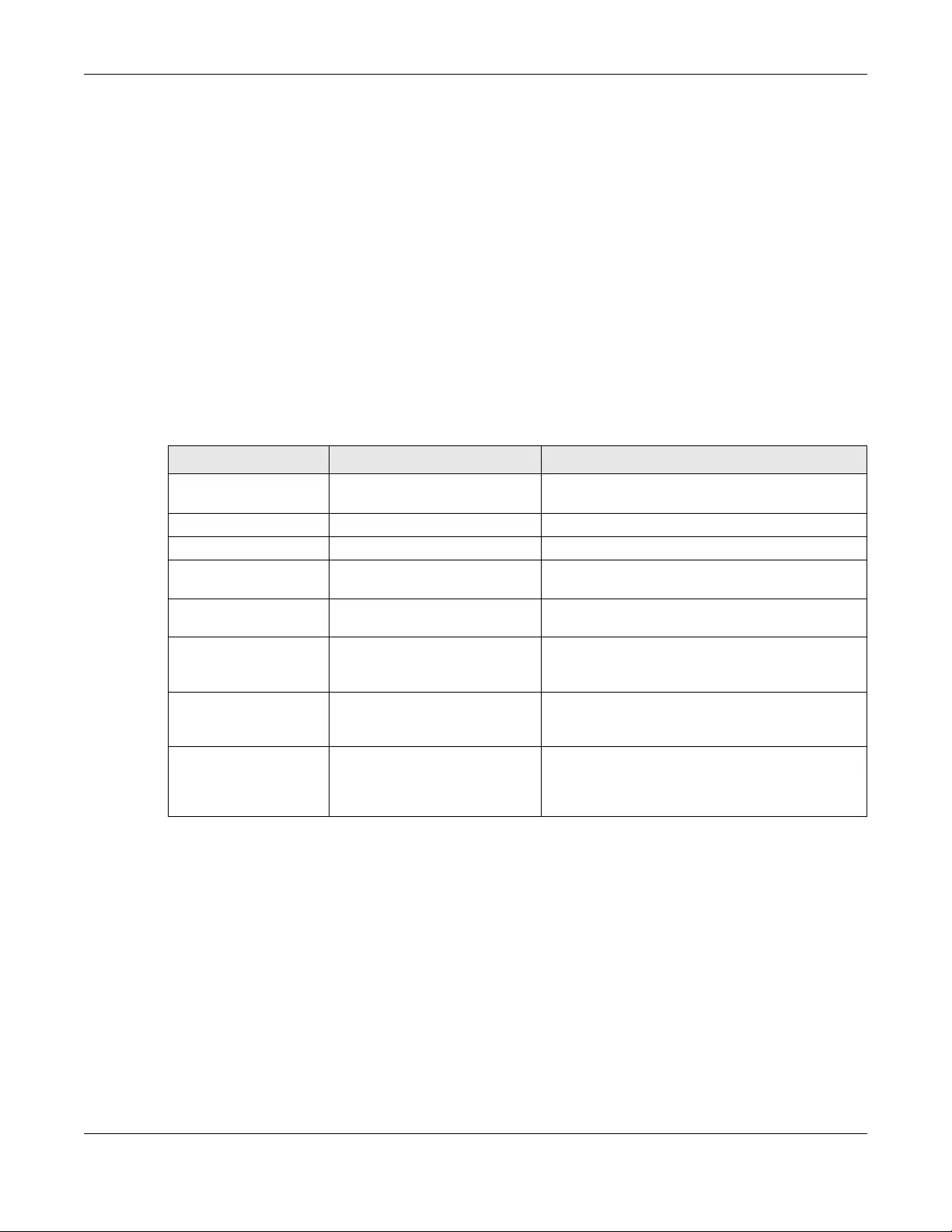
Chapter 42 System
ZyWALL USG FLEX Series User’s Guide
885
Security can be further enhanced by encrypting the SNMP messages sent from the managers.
Encryption protects the contents of the SNMP messages. When the contents of the SNMP messages are
encrypted, only the intended recipients can read them.
42.11.2 Supported MIBs
The Zyxel Device supports MIB II that is defined in RFC-1213 and RFC-1215. The Zyxel Device also supports
private MIBs (zywall.mib and zyxel-zywall-ZLD-Common.mib) to collect information about CPU and
memory usage and VPN total throughput. The focus of the MIBs is to let administrators collect statistical
data and monitor status and performance. You can download the Zyxel Device’s MIBs from
www.zyxel.com.
42.11.3 SNMP Traps
The Zyxel Device will send traps to the SNMP manager when any one of the following events occurs.
42.11.4 Configuring SNMP
To change your Zyxel Device’s SNMP settings, click Configuration > System > SNMP tab. The screen
appears as shown. Use this screen to configure your SNMP settings, including from which zones SNMP
can be used to access the Zyxel Device. You can also specify from which IP addresses the access can
come.
Table 385 SNMP Traps
OBJECT LABEL OBJECT ID DESCRIPTION
Cold Start 1.3.6.1.6.3.1.1.5.1 This trap is sent when the Zyxel Device is turned on or
an agent restarts.
linkDown 1.3.6.1.6.3.1.1.5.3 This trap is sent when the Ethernet link is down.
linkUp 1.3.6.1.6.3.1.1.5.4 This trap is sent when the Ethernet link is up.
authenticationFailure 1.3.6.1.6.3.1.1.5.5 This trap is sent when an SNMP request comes from
non-authenticated hosts.
vpnTunnelDisconnected 1.3.6.1.4.1.890.1.6.22.2.3 This trap is sent when an IPSec VPN tunnel is
disconnected.
vpnTunnelName 1.3.6.1.4.1.890.1.6.22.2.2.1.1 This trap is sent along with the
vpnTunnelDisconnected trap. This trap carries the
disconnected tunnel’s IPSec SA name.
vpnIKEName 1.3.6.1.4.1.890.1.6.22.2.2.1.2 This trap is sent along with the
vpnTunnelDisconnected trap. This trap carries the
disconnected tunnel’s IKE SA name.
vpnTunnelSPI 1.3.6.1.4.1.890.1.6.22.2.2.1.3 This trap is sent along with the
vpnTunnelDisconnected trap. This trap carries the
security parameter index (SPI) of the disconnected
VPN tunnel.

Chapter 42 System
ZyWALL USG FLEX Series User’s Guide
886
Figure 601 Configuration > System > SNMP
The following table describes the labels in this screen.
Table 386 Configuration > System > SNMP
LABEL DESCRIPTION
Enable Select the check box to allow or disallow the computer with the IP address that matches the IP
address(es) in the Service Control table to access the Zyxel Device using this service.
Server Port You may change the server port number for a service if needed, however you must use the
same port number in order to use that service for remote management.
Trap
Community Type the trap community, which is the password sent with each trap to the SNMP manager. The
default is public and allows all requests.
Destination Type the IP address of the station to send your SNMP traps to.
Trap CAPWAP
Event
Select this option to have the Zyxel Device send a trap to the SNMP manager when a
managed AP is connected to or disconnected from the Zyxel Device.
SNMPv2c Select the SNMP version for the Zyxel Device. The SNMP version on the Zyxel Device must match
the version on the SNMP manager.
Get
Community Enter the Get Community, which is the password for the incoming Get and GetNext requests
from the management station. The default is public and allows all requests.
Set
Community Enter the Set community, which is the password for incoming Set requests from the
management station. The default is private and allows all requests.
SNMPv3 Select the SNMP version for the Zyxel Device. The SNMP version on the Zyxel Device must match
the version on the SNMP manager. SNMPv3 (RFCs 3413 to 3415) provides secure access by
authenticating and encrypting data packets over the network. The Zyxel Device uses your login
password as the SNMPv3 authentication and encryption passphrase.
Note: Your login password must consist of at least 8 printable characters for SNMPv3.
An error message will display if your login password has fewer characters.

Chapter 42 System
ZyWALL USG FLEX Series User’s Guide
887
42.11.5 Add SNMPv3 User
Click Add under SNMPv3 in Configuration > System > SNMP to create an SNMPv3 user for authentication
with managers using SNMP v3. Use the username and password of the login accounts you specify in this
screen to create accounts on the SNMP v3 manager.
Add Click this to create a new entry. Select an entry and click Add to create a new entry after the
selected entry.
Edit Double-click an entry or select it and click Edit to be able to modify the entry’s settings.
Remove To remove an entry, select it and click Remove. The Zyxel Device confirms you want to remove
it before doing so. Note that subsequent entries move up by one when you take this action.
#This is the index number of the entry.
User This displays the name of the user object to be sent to the SNMP manager along with the SNMP
v3 trap.
Authenticati
on This displays the authentication algorithm used for this entry. MD5 (Message Digest 5) and SHA
(Secure Hash Algorithm) are hash algorithms used to authenticate SNMP data. SHA
authentication is generally considered stronger than MD5, but is slower.
Privacy This displays the encryption method for SNMP communication from this user. Methods available
are:
•DES - Data Encryption Standard is a widely used (but breakable) method of data
encryption. It applies a 56-bit key to each 64-bit block of data.
•AES - Advanced Encryption Standard is another method for data encryption that also uses
a secret key. AES applies a 128-bit key to 128-bit blocks of data.
Privilege This displays the access rights to MIBs.
•Read-Write - The associated user can create and edit the MIBs on the Zyxel Device, except
the user account.
•Read-Only - The associated user can only collect information from the Zyxel Device MIBs.
Service Control This specifies from which computers you can access which Zyxel Device zones.
Add Click this to create a new entry. Select an entry and click Add to create a new entry after the
selected entry. Refer to Table 377 on page 863 for details on the screen that opens.
Edit Double-click an entry or select it and click Edit to be able to modify the entry’s settings.
Remove To remove an entry, select it and click Remove. The Zyxel Device confirms you want to remove
it before doing so. Note that subsequent entries move up by one when you take this action.
Move To change an entry’s position in the numbered list, select the method and click Move to display
a field to type a number for where you want to put it and press [ENTER] to move the rule to the
number that you typed.
#This the index number of the service control rule.
The entry with a hyphen (-) instead of a number is the Zyxel Device’s (non-configurable) default
policy. The Zyxel Device applies this to traffic that does not match any other configured rule. It is
not an editable rule. To apply other behavior, configure a rule that traffic will match so the Zyxel
Device will not have to use the default policy.
Zone This is the zone on the Zyxel Device the user is allowed or denied to access.
Address This is the object name of the IP address(es) with which the computer is allowed or denied to
access.
Action This displays whether the computer with the IP address specified above can access the Zyxel
Device zone(s) configured in the Zone field (Accept) or not (Deny).
Apply Click Apply to save your changes back to the Zyxel Device.
Reset Click Reset to return the screen to its last-saved settings.
Table 386 Configuration > System > SNMP (continued)
LABEL DESCRIPTION
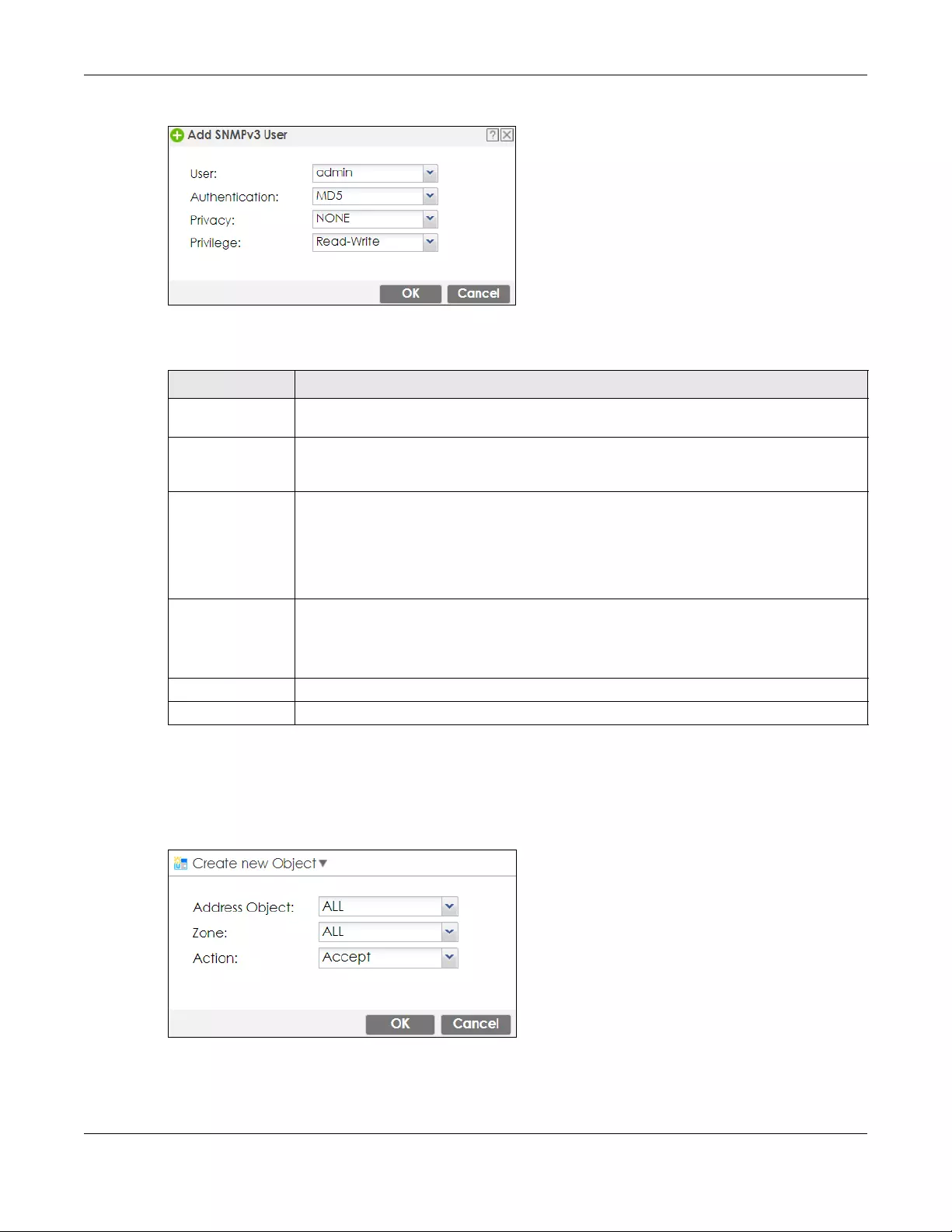
Chapter 42 System
ZyWALL USG FLEX Series User’s Guide
888
Figure 602 Configuration > System > SNMP(v3) > Add
The following table describes the labels in this screen.
42.11.6 Service Control Rules
Click the Add or Edit icon in the Service Control table to add a service control rule.
Figure 603 Configuration > System > SNMP > Service Control Rule Add/Edit
Table 387 Configuration > System > SNMP(v3) > Add
LABEL DESCRIPTION
User Specify the username of a login account on the Zyxel Device. The associated password is
used in authentication algorithms and encryption methods.
Authentication Select an authentication algorithm. MD5 (Message Digest 5) and SHA (Secure Hash
Algorithm) are hash algorithms used to authenticate SNMP data. SHA authentication is
generally considered stronger than MD5, but is slower.
Privacy Specify the encryption method for SNMP communication from this user. You can choose one
of the following:
•DES - Data Encryption Standard is a widely used (but breakable) method of data
encryption. It applies a 56-bit key to each 64-bit block of data.
•AES - Advanced Encryption Standard is another method for data encryption that also
uses a secret key. AES applies a 128-bit key to 128-bit blocks of data.
Privilege Select the access rights to MIBs.
•Read-Write - The associated user can create and edit the MIBs on the Zyxel Device,
except the user account.
•Read-Only - The associated user can only collect information from the Zyxel Device MIBs.
OK Click OK to save the changes.
Cancel Click Cancel to begin configuring this screen afresh.

Chapter 42 System
ZyWALL USG FLEX Series User’s Guide
889
The following table describes the labels in this screen.
42.12 Authentication Server
You can set the Zyxel Device to work as a RADIUS server to exchange messages with a RADIUS client,
such as an AP for user authentication and authorization. Click Configuration > System > Auth. Server tab.
The screen appears as shown. Use this screen to enable the authentication server feature of the Zyxel
Device and specify the RADIUS client’s IP address.
Figure 604 Configuration > System > Auth. Server
Table 388 Configuration > System > SNMP > Service Control Rule Add/Edit
LABEL DESCRIPTION
Create new
Object
Use this to configure any new settings objects that you need to use in this screen.
Address Object Select ALL to allow or deny any computer to communicate with the Zyxel Device using SNMP.
Select a predefined address object to just allow or deny the computer with the IP address that
you specified to access the Zyxel Device using SNMP.
Zone Select ALL to allow or prevent any Zyxel Device zones from being accessed using SNMP.
Select a predefined Zyxel Device zone on which a incoming service is allowed or denied.
Action Select Accept to allow the user to access the Zyxel Device from the specified computers.
Select Deny to block the user’s access to the Zyxel Device from the specified computers.
OK Click OK to save your customized settings and exit this screen.
Cancel Click Cancel to exit this screen without saving.
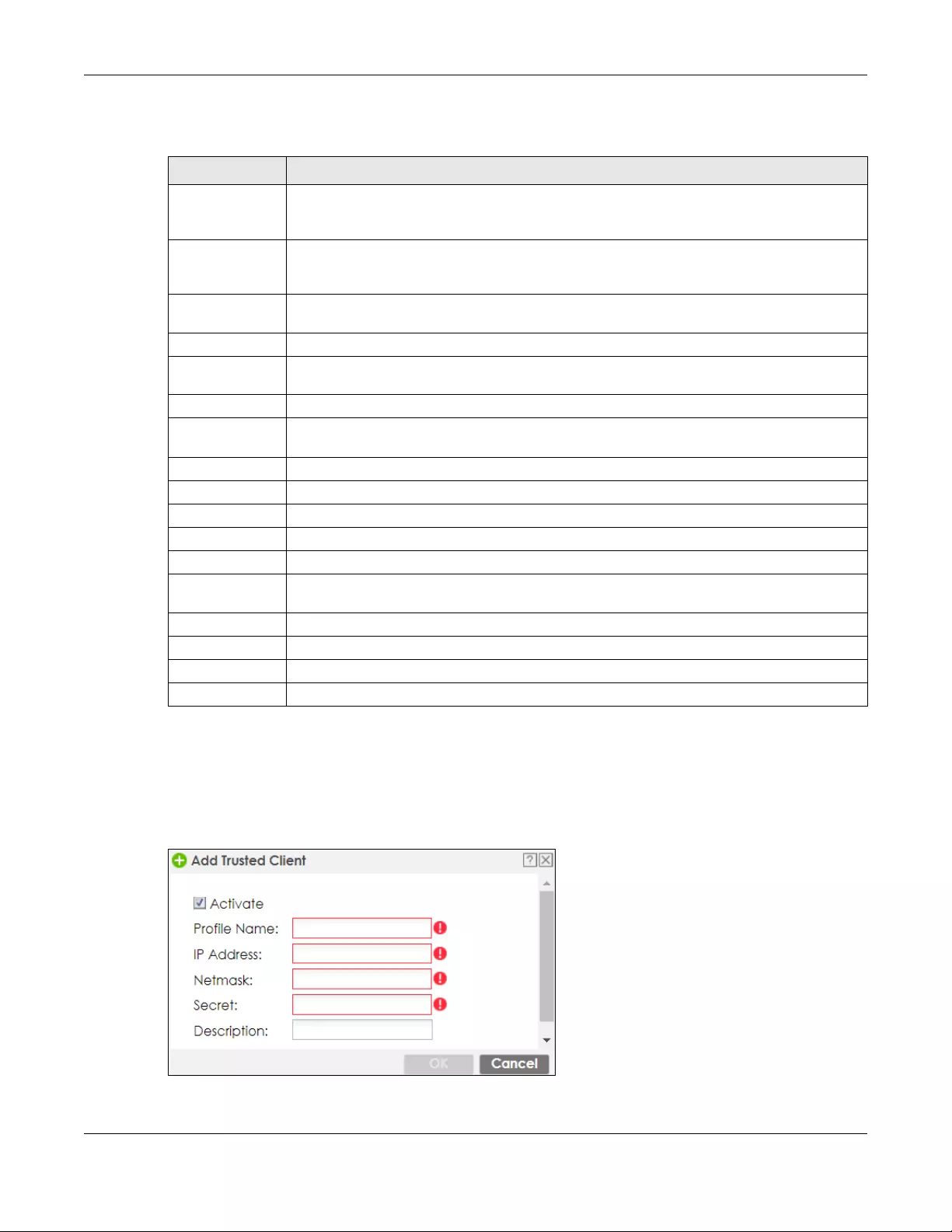
Chapter 42 System
ZyWALL USG FLEX Series User’s Guide
890
The following table describes the labels in this screen.
42.12.1 Add/Edit Trusted RADIUS Client
Click Configuration > System > Auth. Server to display the Auth. Server screen. Click the Add icon or an
Edit icon to display the following screen. Use this screen to create a new entry or edit an existing one.
Figure 605 Configuration > System > Auth. Server > Add/Edit
Table 389 Configuration > System > Auth. Server
LABEL DESCRIPTION
Enable
Authentication
Server
Select the check box to have the Zyxel Device act as a RADIUS server.
Authentication
Server Certificate
Select the certificate whose corresponding private key is to be used to identify the Zyxel Device
to the RADIUS client. You must have certificates already configured in the My Certificates
screen.
Authentication
Method
Select an authentication method if you have created any in the Configuration > Object > Auth.
Method screen.
Trusted Client Use this section to configure trusted clients in the Zyxel Device RADIUS server database.
Add Click this to create a new entry. Select an entry and click Add to create a new entry after the
selected entry.
Edit Double-click an entry or select it and click Edit to be able to modify the entry’s settings.
Remove To remove an entry, select it and click Remove. The Zyxel Device confirms you want to remove
it before doing so. Note that subsequent entries move up by one when you take this action.
Activate To turn on an entry, select it and click Activate.
Inactivate To turn off an entry, select it and click Inactivate.
#This is the index number of the entry.
Status This icon is lit when the entry is active and dimmed when the entry is inactive.
Profile Name This field indicates the name assigned to the profile.
IP Address This is the IP address of the RADIUS client that is allowed to exchange messages with the Zyxel
Device.
Mask This is the subnet mask of the RADIUS client.
Description This is the description of the RADIUS client.
Apply Click Apply to save your changes back to the Zyxel Device.
Reset Click Reset to return the screen to its last-saved settings.
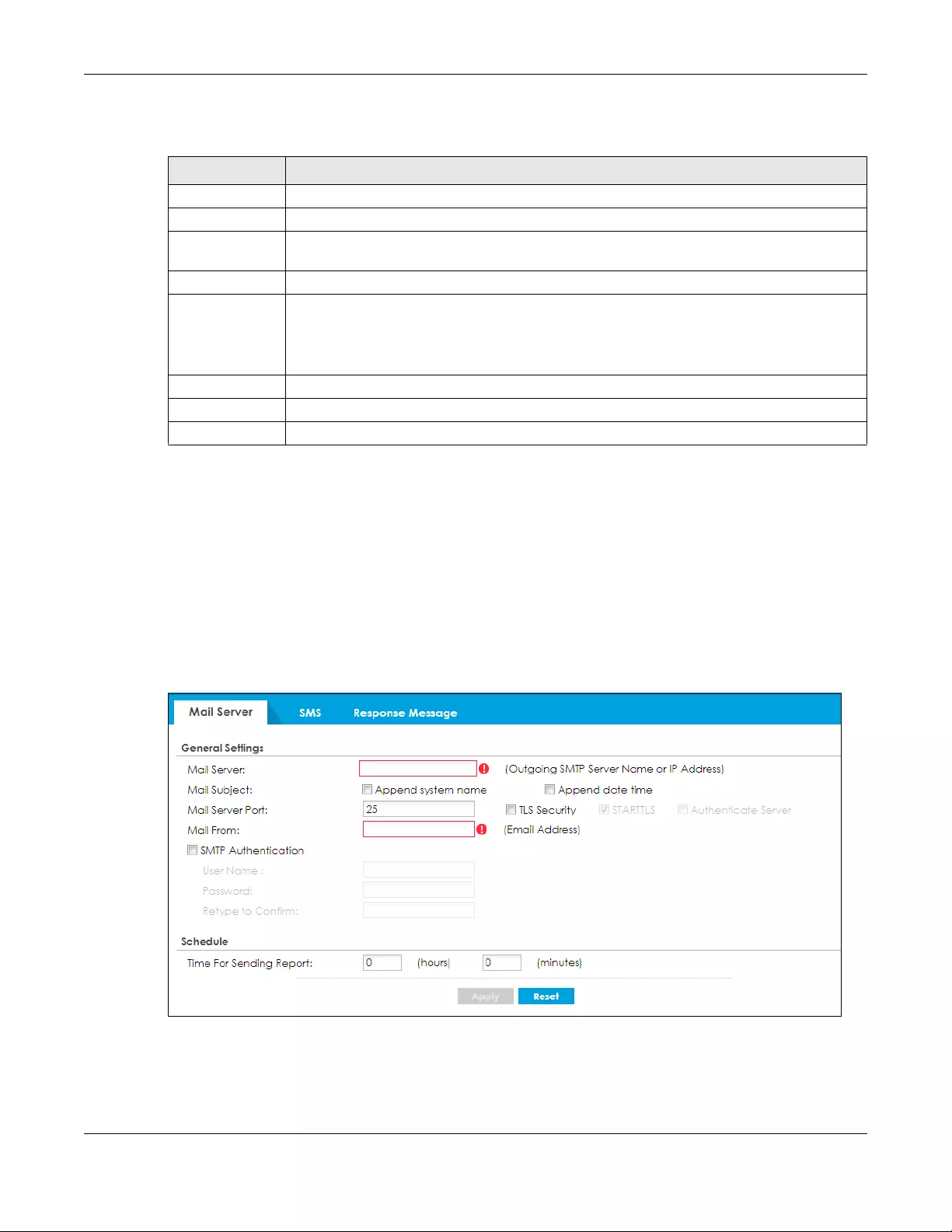
Chapter 42 System
ZyWALL USG FLEX Series User’s Guide
891
The following table describes the labels in this screen.
42.13 Notification > Mail Server
Use this screen to configure a mail server so you can receive reports and notification emails such as
when your password is about to expire. After you configure the screen, you can test the settings in
Maintenance > Diagnostics > Network Tool and then select Test Email Server. See Configuration > Log &
Report > Email Daily Report to configure what reports to send and to whom.
Click Configuration > System > Notification to display the Mail Server screen.
Figure 606 Configuration > System > Notification
Table 390 Configuration > System > Auth. Server > Add/Edit
LABEL DESCRIPTION
Activate Select this check box to make this profile active.
Profile Name Enter a descriptive name (up to 31 alphanumerical characters) for identification purposes.
IP Address Enter the IP address of the RADIUS client that is allowed to exchange messages with the Zyxel
Device.
Netmask Enter the subnet mask of the RADIUS client.
Secret Enter a password (up to 64 alphanumeric characters) as the key to be shared between the
Zyxel Device and the RADIUS client.
The key is not sent over the network. This key must be the same on the external authentication
server and the Zyxel Device.
Description Enter the description of each server, if any. You can use up to 60 printable ASCII characters.
OK Click OK to save the changes.
Cancel Click Cancel to discard the changes.

Chapter 42 System
ZyWALL USG FLEX Series User’s Guide
892
The following table describes the labels in this screen.
42.14 Notification > SMS
The Zyxel Device supports Short Message Service (SMS) to send short text messages to mobile phone
devices.
Click Configuration > System > Notification > SMS to open the following screen.
Table 391 Configuration > System > Notification
LABEL DESCRIPTION
Mail Server Type the name or IP address of the outgoing SMTP server.
Mail Subject Go to Configuration > Log & Report > Email Daily Report to type a subject line for outgoing
email from the Zyxel Device.
Append
system name Select Append system name to add the Zyxel Device’s system name to the subject.
Append date
time Select Append date time to add the Zyxel Device’s system date and time to the subject.
Mail Server Port Enter the same port number here as is on the mail server for mail traffic.
TLS Security Select this option if the mail server uses Transport Layer Security (TLS) for encrypted
communications between the mail server and the Zyxel Device.
STARTTLS Select this option if the mail server uses SSL or TLS for encrypted communications between the
mail server and the Zyxel Device.
Authenticate
Server Select this if the Zyxel Device authenticates the mail server in the TLS handshake.
Mail From Type the email address from which the outgoing email is delivered. This address is used in
replies.
SMTP
Authentication
Select this check box if it is necessary to provide a user name and password to the SMTP server.
User Name This box is effective when you select the SMTP Authentication check box. Type the user name
to provide to the SMTP server when the log is emailed.
Password This box is effective when you select the SMTP Authentication check box. Type a password of
up to 63 characters to provide to the SMTP server when the log is emailed.
Retype to
Confirm Type the password again to make sure that you have entered is correctly.
Time for sending
report
Select the time of day (hours and minutes) when the log is emailed. Use 24-hour notation.
Apply Click Apply to save your changes back to the Zyxel Device.
Reset Click Reset to return the screen to its last-saved settings.

Chapter 42 System
ZyWALL USG FLEX Series User’s Guide
893
Figure 607 Configuration > System > Notification > SMS
The following table describes the labels in this screen.
Table 392 Configuration > System > Notification > SMS
LABEL DESCRIPTION
General Settings
Enable SMS Select the check box to turn on the SMS service.
Default country
code for phone
number
Enter the default country code for the mobile phone number to which you want to send SMS
messages.
SMS Provider The Zyxel Device uses Email-to-SMS Provider to forward SMS messages.
Note: Go to the Configuration > System > Notification > Mail Server screen to
configure a mail server to allow the Zyxel Device to send SMS messages to the
SMS service provider using emails.
Provider
Domain Enter the domain name of your SMS service provider. The domain name can be of up to 252
characters.
Select auto append to "Mail to" to add the domain name of your SMS service provider after the
mobile phone number in the Mail To field.
Mail Subject Type the subject line of up to 128 characters for outgoing e-mail from the Zyxel Device.
Mail From Enter the sender’s email address of up to 64 characters. This email address needs to be in your
SMS provider’s allowed sender address list.
If you leave this field blank, the Zyxel Device will use the IP address or domain name of the Mail
Server field in the Configuration > System > Notification > Mail Server screen.
Mail To Enter the mobile phone number of up to 80 characters. You can only have one receiver.
Use this variable in brackets [$mobile_number$], and the Zyxel Device will use the mobile
phone number of the user logging in. Go to the Configuration > Object > User/Group > User
screen to add a valid mobile telephone number for a user.
Apply Click this button to save your changes to the Zyxel Device.
Reset Click this button to return the screen to its last-saved settings.
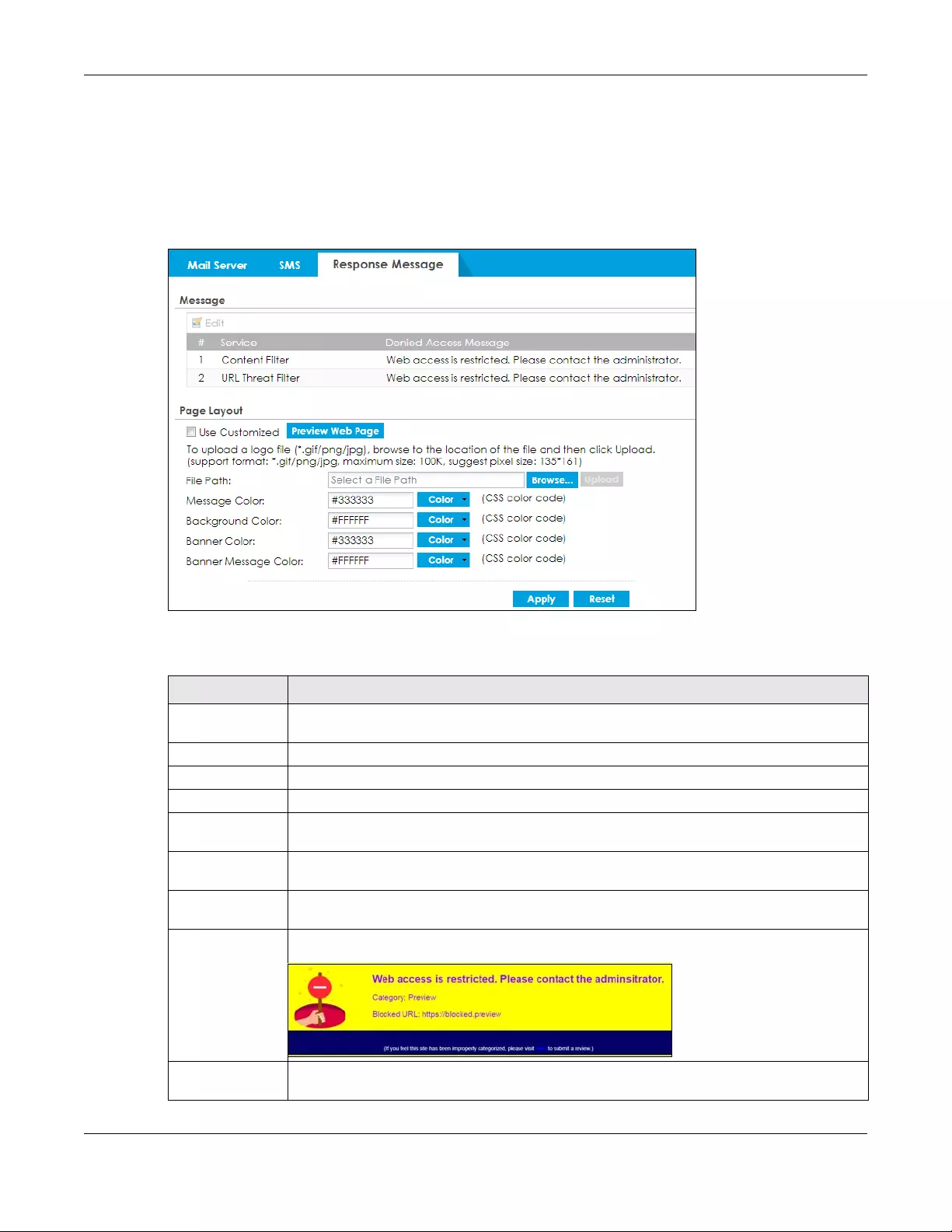
Chapter 42 System
ZyWALL USG FLEX Series User’s Guide
894
42.15 Notification > Response Message
Use this screen to create a web page when access to a website is restricted due to a security service.
Click Configuration > System > Notification > Response Message to open the following screen.
Figure 608 Configuration > System > Notification > Response Message
The following table describes the labels in this screen.
Table 393 Configuration > System > Notification > Response Message
LABEL DESCRIPTION
Message Use this part of the screen to create a message to display when access to a website is blocked
due to a security service.
Edit Double-click an entry or select it and click Edit to be able to modify the entry’s settings.
# This is the index number of the entry.
Service This is the security service that may restrict access to a website.
Denied Access
Message
Type a message to display when access to a website is blocked due to this security service.
You may type up to 127 characters.
Page Layout Use this part of the screen to create a web page to display when access to a website is
blocked due to a security service.
Use Customized Select this if you want to specify a logo and colors in the access blocked web page. You
cannot change the banner message.
Preview Web
Page
Use this to see how the colors look in your customized access blocked web page. The below
example also shows the location of the access blocked message, the logo and banner.
File Path Type the path to the access blocked web page file or use Browse to find it on your computer.
After, click Upload to send the file to the Zyxel Device.
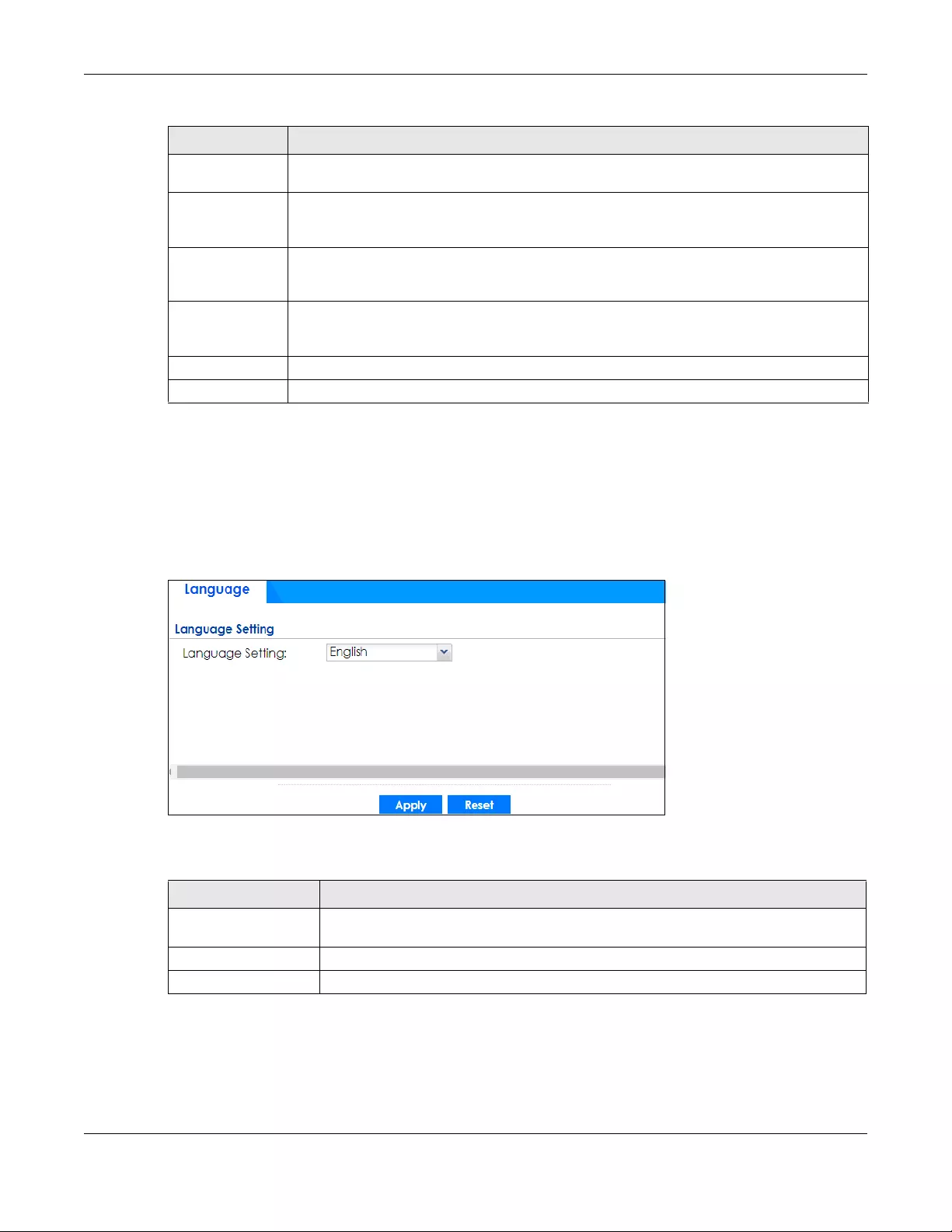
Chapter 42 System
ZyWALL USG FLEX Series User’s Guide
895
42.16 Language Screen
Click Configuration > System > Language to open the following screen. Use this screen to select a
display language for the Zyxel Device’s Web Configurator screens.
Figure 609 Configuration > System > Language
The following table describes the labels in this screen.
Message
Color Specify the font color of the message. You can use the Color palette chooser, or enter a CSS
hex color code. For example, the CSS hex color code for blue is #0000FF.
Background
Color Specify the color of the access blocked web page background. You can use the Color palette
chooser, or enter a CSS hex color code. For example, the CSS hex color code for blue is
#0000FF.
Banner Color Specify the color of the access blocked web page banner. You can use the Color palette
chooser, or enter a CSS hex color code. For example, the CSS hex color code for blue is
#0000FF.
Banner
Message
Color
Specify the color of the access blocked web page banner text. You can use the Color palette
chooser, or enter a CSS hex color code. For example, the CSS hex color code for blue is
#0000FF.
Apply Click this button to save your changes to the Zyxel Device.
Reset Click this button to return the screen to its last-saved settings.
Table 393 Configuration > System > Notification > Response Message (continued)
LABEL DESCRIPTION
Table 394 Configuration > System > Language
LABEL DESCRIPTION
Language Setting Select a display language for the Zyxel Device’s Web Configurator screens. You also
need to open a new browser session to display the screens in the new language.
Apply Click Apply to save your changes back to the Zyxel Device.
Reset Click Reset to return the screen to its last-saved settings.
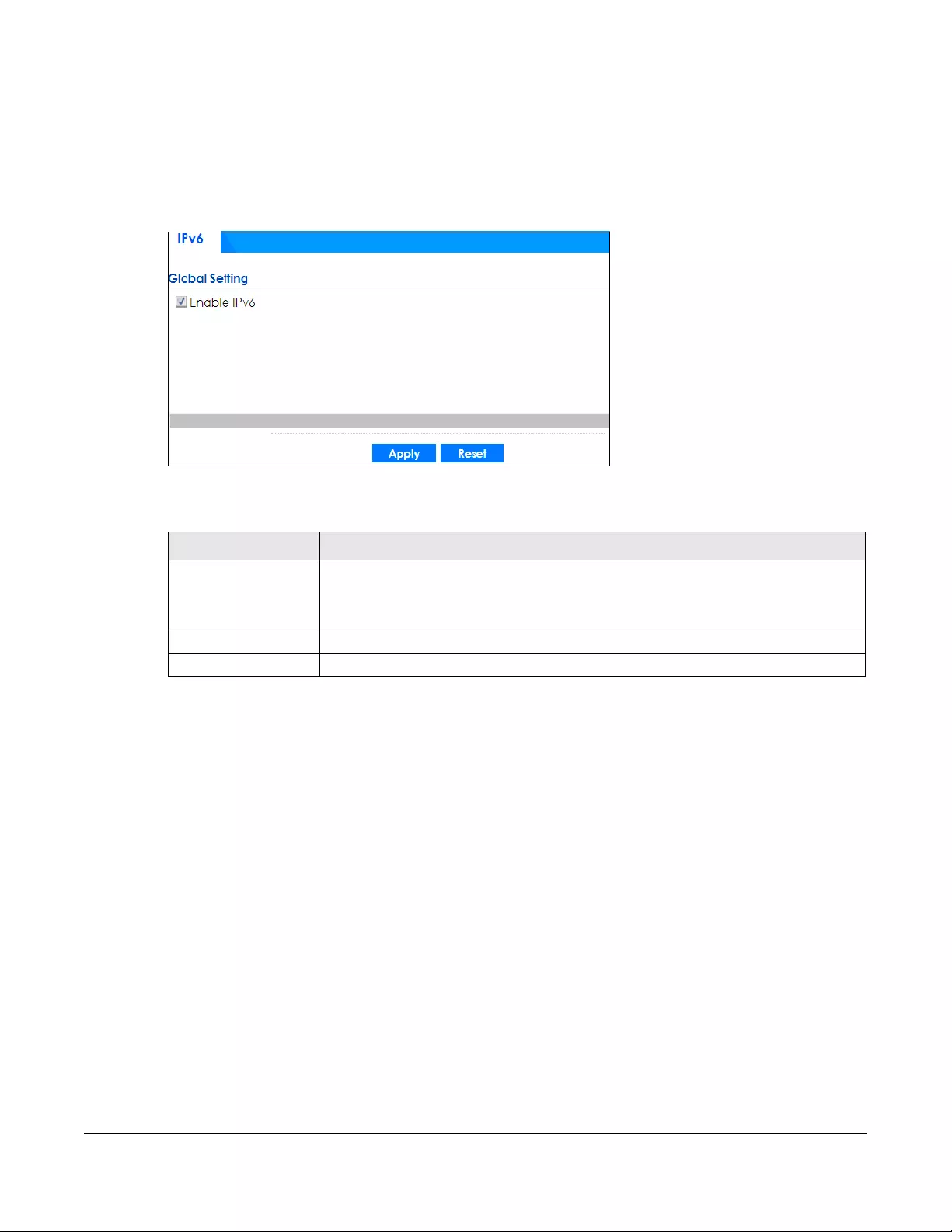
Chapter 42 System
ZyWALL USG FLEX Series User’s Guide
896
42.17 IPv6 Screen
Click Configuration > System > IPv6 to open the following screen. Use this screen to enable IPv6 support
for the Zyxel Device’s Web Configurator screens.
Figure 610 Configuration > System > IPv6
The following table describes the labels in this screen.
42.18 Zyxel One Network (ZON) Utility
The Zyxel One Network (ZON) utility uses the Zyxel Discovery Protocol (ZDP) for discovering and
configuring ZDP-aware Zyxel devices in the same broadcast domain as the computer on which ZON is
installed.
The ZON Utility issues requests via ZDP and in response to the query, the Zyxel device responds with basic
information including IP address, firmware version, location, system and model name. The information is
then displayed in the ZON Utility screen and you can perform tasks like basic configuration of the
devices and batch firmware upgrade in it. You can download the ZON Utility at www.zyxel.com and
install it on a computer.
42.18.1 Requirements
Before installing the ZON Utility on your computer, please make sure it meets the requirements listed
below.
Table 395 Configuration > System > IPv6
LABEL DESCRIPTION
Enable IPv6 Select this to have the Zyxel Device support IPv6 and make IPv6 settings be available on
the screens that the functions support, such as the Configuration > Network > Interface >
Ethernet, VLAN, and Bridge screens. The Zyxel Device discards all IPv6 packets if you clear
this check box.
Apply Click Apply to save your changes back to the Zyxel Device.
Reset Click Reset to return the screen to its last-saved settings.

Chapter 42 System
ZyWALL USG FLEX Series User’s Guide
897
Operating System
At the time of writing, the ZON Utility is compatible with:
• Windows 7 (both 32-bit / 64-bit versions)
• Windows 8 (both 32-bit / 64-bit versions)
• Windows 8.1 (both 32-bit / 64-bit versions)
• Window 10 (both 32-bit / 64-bit versions)
Note: To check for your Windows operating system version, right-click on My Computer >
Properties. You should see this information in the General tab.
Hardware
Here are the minimum hardware requirements to use the ZON Utility on your computer.
• Core i3 processor
•2GB RAM
• 100MB free hard disk
• WXGA (Wide XGA 1280x800)
42.18.2 Run the ZON Utility
1Double-click the ZON Utility to run it.
2The first time you run the ZON Utility you will see if your Zyxel Device and firmware version support the ZON
Utility. Click the OK button to close this screen.
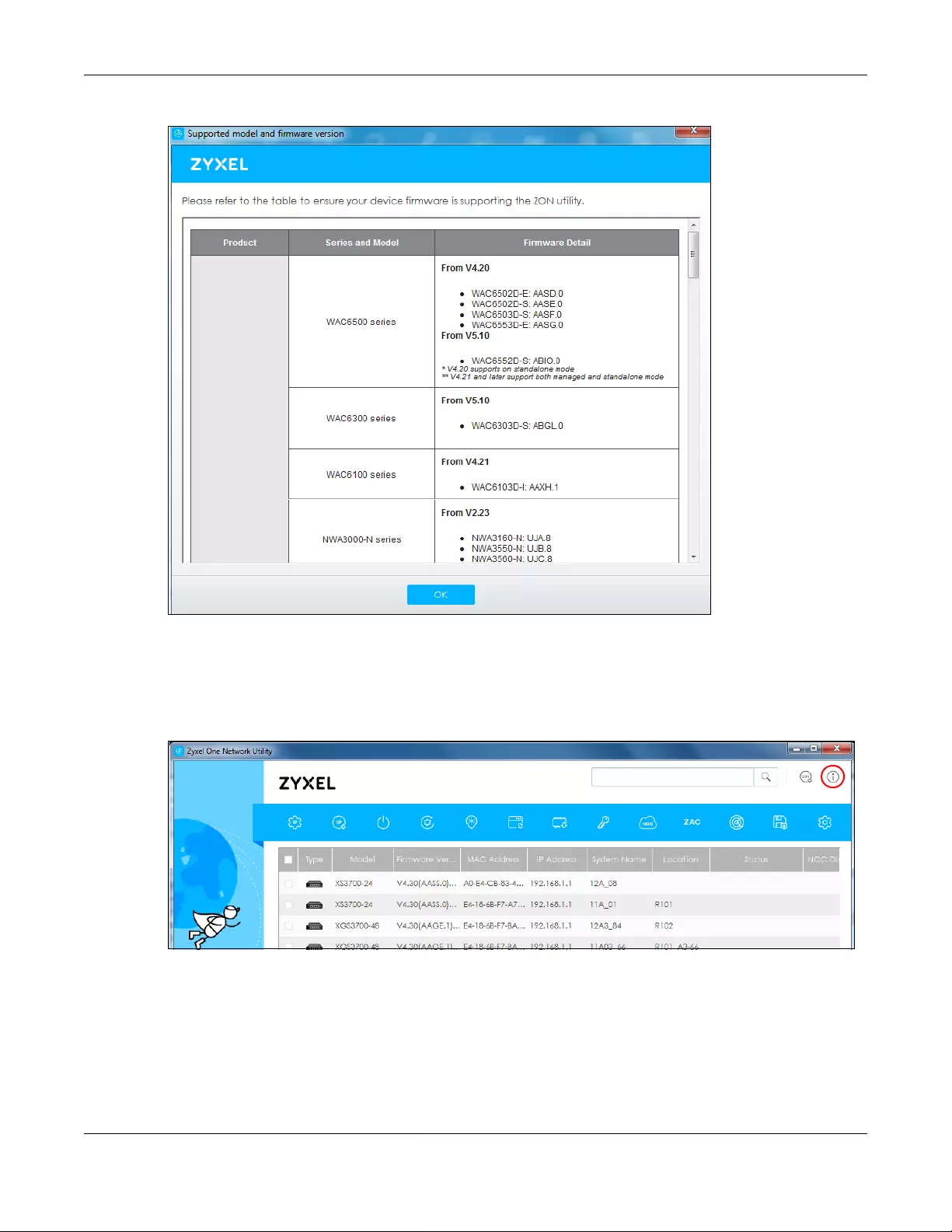
Chapter 42 System
ZyWALL USG FLEX Series User’s Guide
898
Figure 611 Supported Devices and Versions
If you want to check the supported models and firmware versions later, you can click the Show
information about ZON icon in the upper right hand corner of the screen. Then select the Supported
model and firmware version link. If your device is not listed here, see the device release notes for ZON
utility support. The release notes are in the firmware zip file on the Zyxel web site.
Figure 612 ZON Utility Screen
3Select a network adapter to which your supported devices are connected.
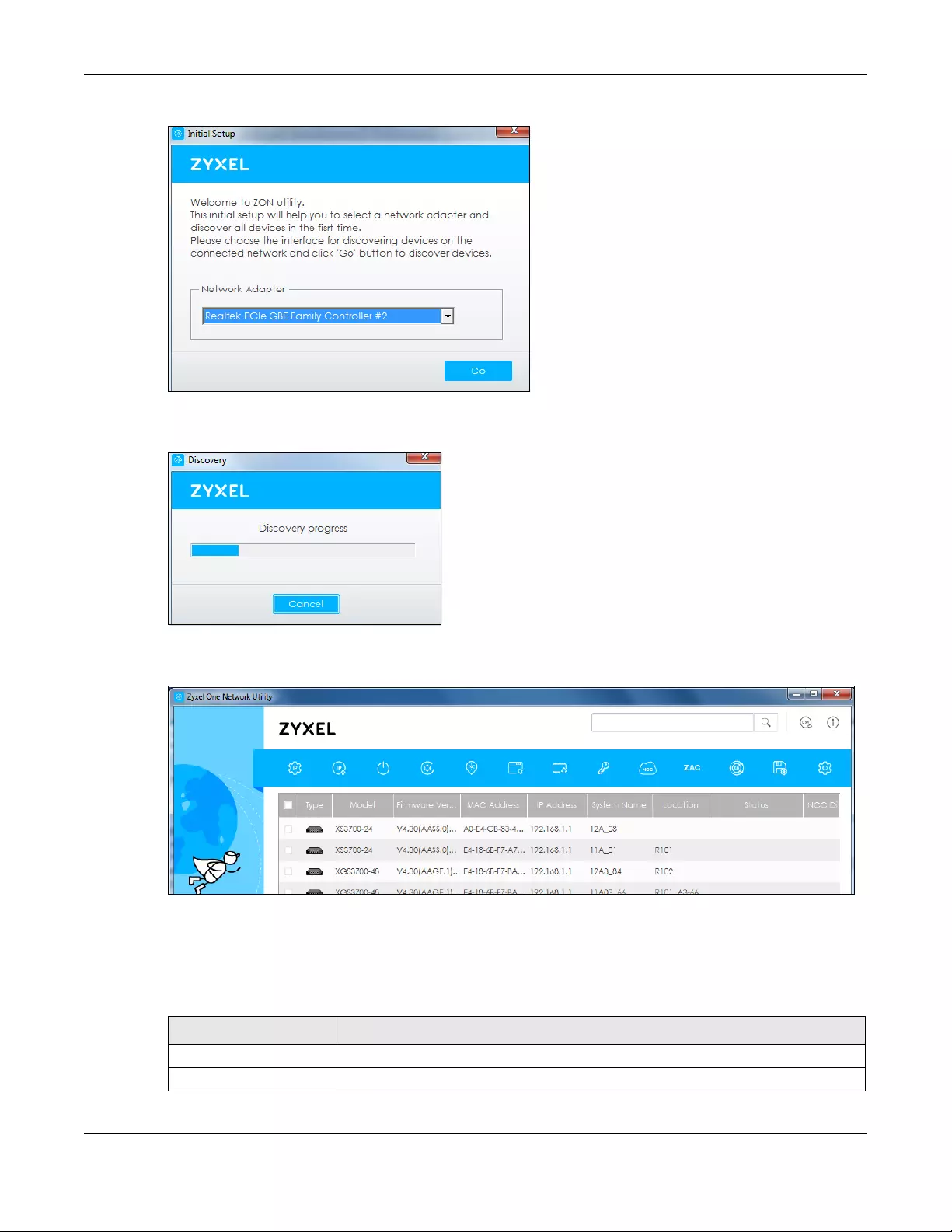
Chapter 42 System
ZyWALL USG FLEX Series User’s Guide
899
Figure 613 Network Adapter
4Click the Go button for the ZON Utility to discover all supported devices in your network.
Figure 614 Discovery
5The ZON Utility screen shows the devices discovered.
Figure 615 ZON Utility Screen
6Select a device and then use the icons to perform actions. Some functions may not be available for
your devices.
The following table describes the icons numbered from left to right in the ZON Utility screen.
12345678910 11 12 13
Table 396 ZON Utility Icons
ICON DESCRIPTION
1 IP configuration Change the selected device’s IP address.
2 Renew IP Address Update a DHCP-assigned dynamic IP address.

Chapter 42 System
ZyWALL USG FLEX Series User’s Guide
900
The following table describes the fields in the ZON Utility main screen.
3 Reboot Device Use this icon to restart the selected device(s). This may be useful when troubleshooting
or upgrading new firmware.
4 Reset Configuration to
Default
If you forget your password or cannot access the Web Configurator, you can use this
icon to reload the factory-default configuration file. This means that you will lose all
configurations that you had previously.
5 Locator LED Use this icon to locate the selected device by causing its Locator LED to blink.
6 Web GUI Use this to access the selected device web configurator from your browser. You will
need a username and password to log in.
7 Firmware Upgrade Use this icon to upgrade new firmware to selected device(s) of the same model. Make
sure you have downloaded the firmware from the Zyxel website to your computer and
unzipped it in advance.
If your Zyxel Device supports dual firmware images, the standby image will be
upgraded. After the new firmware is uploaded, you Zyxel Device will reboot, and the
new firmware will be the running firmware.
8 Change Password Use this icon to change the admin password of the selected device. You must know
the current admin password before changing to a new one.
9 Configure NCC
Discovery
You must have Internet access to use this feature. Use this icon to enable or disable
the Nebula Control Center (NCC) discovery feature on the selected device. If it’s
enabled, the selected device will try to connect to the NCC. Once the selected
device is connected to and has registered in the NCC, it’ll go into the cloud
management mode.
10 ZAC Use this icon to run the Zyxel AP Configurator of the selected AP.
11 Clear and Rescan Use this icon to clear the list and discover all devices on the connected network
again.
12 Save Configuration Use this icon to save configuration changes to permanent memory on a selected
device.
13 Settings Use this icon to select a network adaptor for the computer on which the ZON utility is
installed, and the utility language.
Table 397 ZON Utility Fields
LABEL DESCRIPTION
Type This field displays an icon of the kind of device discovered.
Model This field displays the model name of the discovered device.
Firmware Version This field displays the firmware version of the discovered device.
MAC Address This field displays the MAC address of the discovered device.
IP Address This field displays the IP address of an internal interface on the discovered device that
first received an ZDP discovery request from the ZON utility.
System Name This field displays the system name of the discovered device.
Location This field displays where the discovered device is.
Status This field displays whether changes to the discovered device have been done
successfully. As the Zyxel Device does not support IP Configuration, Renew IP address
and Flash Locator LED, this field displays “Update failed”, “Not support Renew IP
address” and “Not support Flash Locator LED” respectively.
NCC Discovery This field displays if the discovered device supports the Nebula Control Center (NCC)
discovery feature. If it’s enabled, the selected device will try to connect to the NCC.
Once the selected device is connected to and has registered in the NCC, it’ll go into
the cloud management mode.
Table 396 ZON Utility Icons
ICON DESCRIPTION
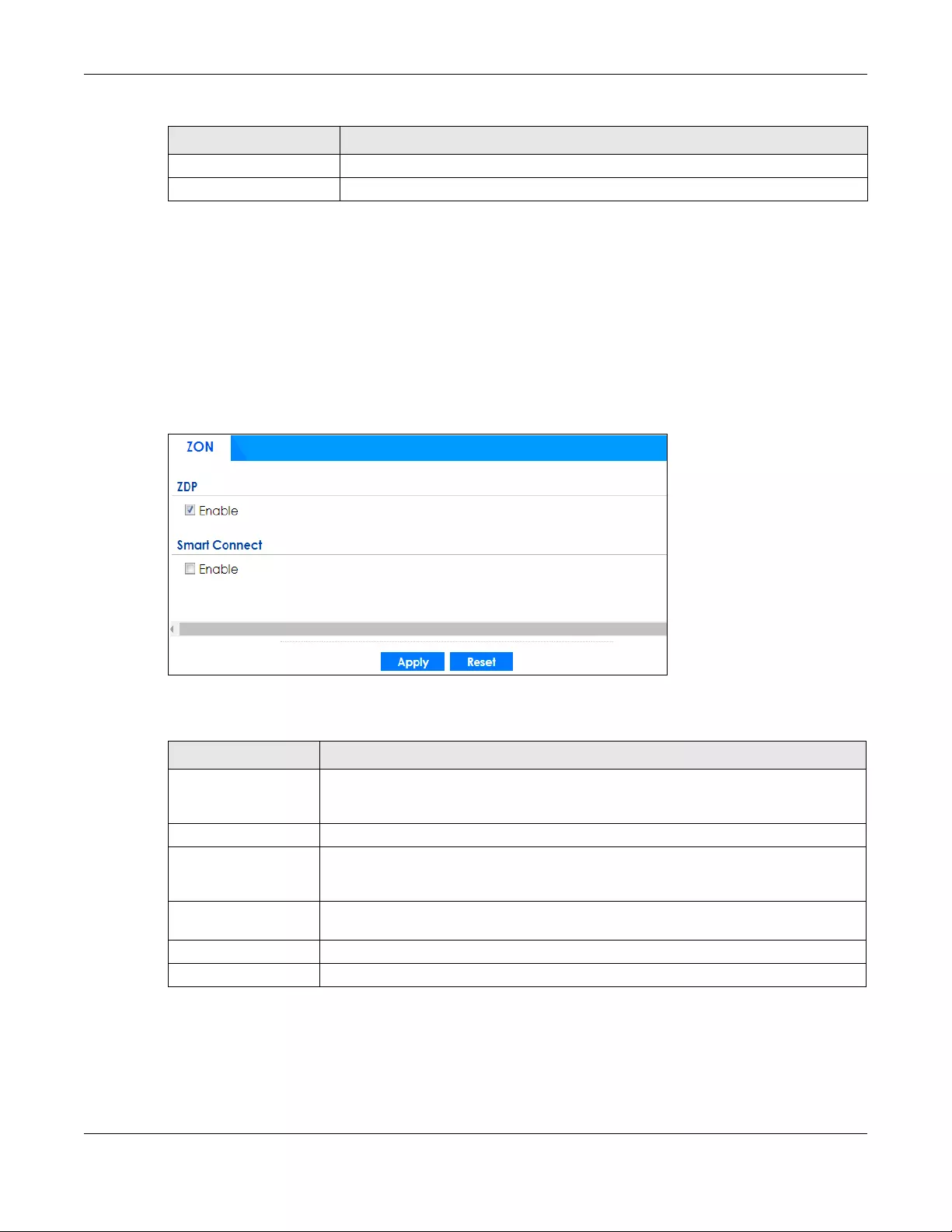
Chapter 42 System
ZyWALL USG FLEX Series User’s Guide
901
42.18.3 Zyxel One Network (ZON) System Screen
Enable ZDP (ZON) and Smart Connect (Ethernet Neighbor) in the System > ZON screen.
See Monitor > System Status > Ethernet Neighbor for information on using Smart Connect (Link Layer
Discovery Protocol (LLDP)) for discovering and configuring LLDP-aware devices in the same broadcast
domain as the Zyxel Device that you’re logged into using the web configurator.
The following figure shows the System > ZON screen.
Figure 616 Configuration > System > ZON
The following table describes the labels in this screen.
Serial Number Enter the admin password of the discovered device to display its serial number.
Hardware Version This field displays the hardware version of the discovered device.
Table 397 ZON Utility Fields
LABEL DESCRIPTION
Table 398 Configuration > System > ZON
LABEL DESCRIPTION
ZDP Zyxel Discovery Protocol (ZDP) is the protocol that the Zyxel One Network (ZON) utility uses
for discovering and configuring ZDP-aware Zyxel devices in the same broadcast domain
as the computer on which ZON is installed.
Enable Select to activate ZDP discovery on the Zyxel Device.
Smart Connect Smart Connect uses Link Layer Discovery Protocol (LLDP) for discovering and configuring
LLDP-aware devices in the same broadcast domain as the Zyxel Device that you’re
logged into using the web configurator.
Enable Select to activate LLDP discovery on the Zyxel Device. See also Monitor > System Status >
Ethernet Discovery.
Apply Click Apply to save your changes back to the Zyxel Device.
Reset Click Reset to return the screen to its last-saved settings.

ZyWALL USG FLEX Series User’s Guide
902
CHAPTER 43
Log and Report
43.1 Overview
Use these screens to configure daily reporting and log settings.
43.1.1 What You Can Do In this Chapter
• Use the Email Daily Report screen (Section 43.2 on page 902) to configure where and how to send
daily reports and what reports to send.
• Use the Log Setting screens (Section 43.3 on page 904) to specify settings for recording log messages
and alerts, e-mailing them, storing them on a connected USB storage device, and sending them to
remote syslog servers.
43.2 Email Daily Report
Use the Email Daily Report screen to start or stop data collection and view various statistics about traffic
passing through your Zyxel Device. See Configuration > System > Notification to set up the mail server.
Note: Data collection may decrease the Zyxel Device’s traffic throughput rate.
Click Configuration > Log & Report > Email Daily Report to display the following screen. Configure this
screen to have the Zyxel Device email you system statistics every day.

Chapter 43 Log and Report
ZyWALL USG FLEX Series User’s Guide
903
Figure 617 Configuration > Log & Report > Email Daily Report
The following table describes the labels in this screen.
Table 399 Configuration > Log & Report > Email Daily Report
LABEL DESCRIPTION
Enable Email Daily
Report
Select this to send reports by email every day.
Mail Subject Type the subject line for outgoing email from the Zyxel Device.

Chapter 43 Log and Report
ZyWALL USG FLEX Series User’s Guide
904
43.3 Log Setting Screens
The Log Setting screens control log messages and alerts. A log message stores the information for
viewing or regular emailing later, and an alert is emailed immediately. Usually, alerts are used for events
that require more serious attention, such as system errors and attacks.
The Zyxel Device provides a system log and supports email profiles and remote syslog servers. View the
system log in the MONITOR > Log screen. Use the email profiles to mail log messages to the specific
destinations. You can also have the Zyxel Device store system logs on a connected USB storage device.
The other four logs are stored on specified syslog servers.
The Log Setting screens control what information the Zyxel Device saves in each log. You can also
specify which log messages to email for the system log, and where and how often to email them. These
screens also set for which events to generate alerts and where to email the alerts.
The first Log Setting screen provides a settings summary. Use the Edit screens to configure settings such as
log categories, email addresses, and server names for any log. Use the Log Category Settings screen to
edit what information is included in the system log, USB storage, email profiles, and remote servers.
43.3.1 Log Setting Summary
To access this screen, click Configuration > Log & Report > Log Setting.
Mail To Type the email address (or addresses) to which the outgoing email is delivered.
Send Report Now Click this button to have the Zyxel Device send the daily email report immediately.
Report Items Select the information to include in the report. Types of information include System Resource
Usage, Wireless Report, Security Service, Interface Traffic Statistics and DHCP Table.
Select Reset counters after sending report successfully if you only want to see statistics for a 24
hour period.
Reset All Counters Click this to discard all report data and start all of the counters over at zero.
Apply Click Apply to save your changes back to the Zyxel Device.
Reset Click Reset to return the screen to its last-saved settings.
Table 399 Configuration > Log & Report > Email Daily Report (continued)
LABEL DESCRIPTION
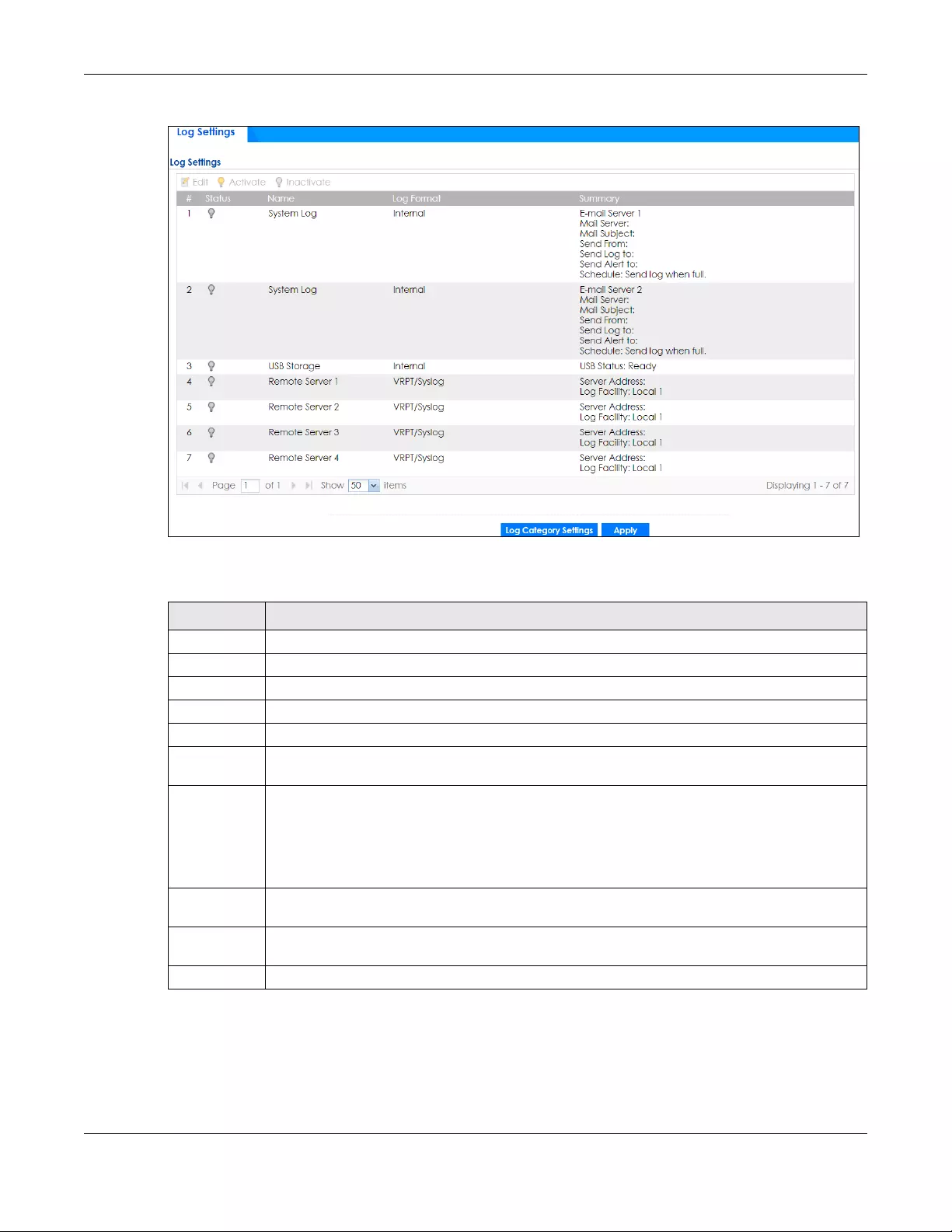
Chapter 43 Log and Report
ZyWALL USG FLEX Series User’s Guide
905
Figure 618 Configuration > Log & Report > Log Setting
The following table describes the labels in this screen.
43.3.2 Edit System Log Settings
The Log Settings Edit screen controls the detailed settings for each log in the system log (which includes
the email profiles). Go to the Log Settings Summary screen (see Section 43.3.1 on page 904), and click
the system log Edit icon.
Table 400 Configuration > Log & Report > Log Setting
LABEL DESCRIPTION
Edit Double-click an entry or select it and click Edit to open a screen where you can modify it.
Activate To turn on an entry, select it and click Activate.
Inactivate To turn off an entry, select it and click Inactivate.
#This field is a sequential value, and it is not associated with a specific log.
Status The activate (light bulb) icon is lit when the entry is active and dimmed when the entry is inactive.
Name This field displays the type of log setting entry (system log, logs stored on a USB storage device
connected to the Zyxel Device, or one of the remote servers).
Log Format This field displays the format of the log.
Internal - system log; you can view the log on the View Log tab.
VRPT/Syslog - Zyxel’s Vantage Report, syslog-compatible format.
CEF/Syslog - Common Event Format, syslog-compatible format.
Summary This field is a summary of the settings for each log. Please see Section 43.3.2 on page 905 for more
information.
Log Category
Settings
Click this button to open the Log Category Settings Edit screen.
Apply Click this button to save your changes (activate and deactivate logs) and make them take effect.
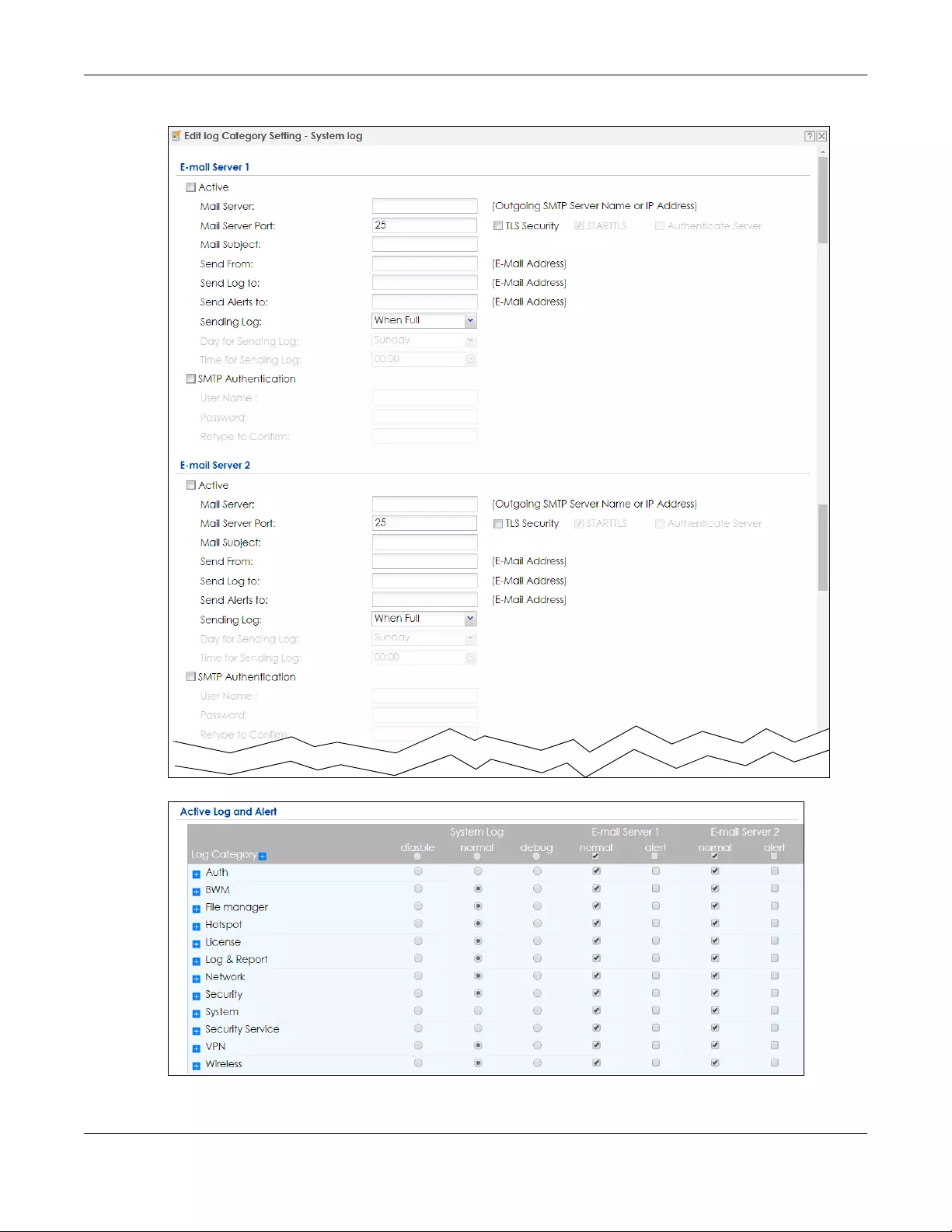
Chapter 43 Log and Report
ZyWALL USG FLEX Series User’s Guide
906
Figure 619 Configuration > Log & Report > Log Setting > Edit (System Log - E-mail Servers)
Figure 620 Configuration > Log & Report > Log Setting > Edit (System Log )

Chapter 43 Log and Report
ZyWALL USG FLEX Series User’s Guide
907
Figure 621 Configuration > Log & Report > Log Setting > Edit (System Log - AP)
The following table describes the labels in this screen.
Table 401 Configuration > Log & Report > Log Setting > Edit (System Log)
LABEL DESCRIPTION
E-Mail Server 1/2
Active Select this to send log messages and alerts according to the information in this section.
You specify what kinds of log messages are included in log information and what kinds of
log messages are included in alerts in the Active Log and Alert section.
Mail Server Type the name or IP address of the outgoing SMTP server.
Mail Server Port Enter the same port number here as is on the mail server for mail traffic.
Mail Subject Type the subject line for the outgoing email.
Send From Type the email address from which the outgoing email is delivered. This address is used in
replies.
Send Log To Type the email address to which the outgoing email is delivered.
Send Alerts To Type the email address to which alerts are delivered.
Sending Log Select how often log information is emailed. Choices are: When Full, Hourly and When Full,
Daily and When Full, and Weekly and When Full.
Day for Sending
Log This field is available if the log is emailed weekly. Select the day of the week the log is
emailed.
Time for Sending
Log This field is available if the log is emailed weekly or daily. Select the time of day (hours and
minutes) when the log is emailed. Use 24-hour notation.
SMTP
Authentication Select this check box if it is necessary to provide a user name and password to the SMTP
server.
User Name This box is effective when you select the SMTP Authentication check box. Type the user
name to provide to the SMTP server when the log is emailed.
Password This box is effective when you select the SMTP Authentication check box. Type the
password of up to 63 characters to provide to the SMTP server when the log is emailed.
Retype to Confirm Type the password again to make sure that you have entered is correctly.
Active Log and Alert
System Log Use the System Log drop-down list to change the log settings for all of the log categories.
disable all logs (red X) - do not log any information for any category for the system log or
email any logs to email server 1 or 2.
enable normal logs (green check mark) - create log messages and alerts for all
categories for the system log. If email server 1 or 2 also has normal logs enabled, the Zyxel
Device will email logs to them.
enable normal logs and debug logs (yellow check mark) - create log messages, alerts,
and debugging information for all categories. The Zyxel Device does not email
debugging information, even if this setting is selected.

Chapter 43 Log and Report
ZyWALL USG FLEX Series User’s Guide
908
E-mail Server 1 Use the E-Mail Server 1 drop-down list to change the settings for emailing logs to email
server 1 for all log categories.
Using the System Log drop-down list to disable all logs overrides your email server 1
settings.
enable normal logs (green check mark) - email log messages for all categories to email
server 1.
enable alert logs (red exclamation point) - email alerts for all categories to email server 1.
E-mail Server 2 Use the E-Mail Server 2 drop-down list to change the settings for emailing logs to email
server 2 for all log categories.
Using the System Log drop-down list to disable all logs overrides your email server 2
settings.
enable normal logs (green check mark) - email log messages for all categories to email
server 2.
enable alert logs (red exclamation point) - email alerts for all categories to email server 2.
Log Category This field displays each category of messages. It is the same value used in the Display and
Category fields in the View Log tab. The Default category includes debugging messages
generated by open source software.
System log Select which events you want to log by Log Category. There are three choices:
disable all logs (red X) - do not log any information from this category
enable normal logs (green check mark) - create log messages and alerts from this
category
enable normal logs and debug logs (yellow check mark) - create log messages, alerts,
and debugging information from this category; the Zyxel Device does not email
debugging information, however, even if this setting is selected.
E-mail Server 1 Select whether each category of events should be included in the log messages when it
is emailed (green check mark) and/or in alerts (red exclamation point) for the email
settings specified in E-Mail Server 1. The Zyxel Device does not email debugging
information, even if it is recorded in the System log.
E-mail Server 2 Select whether each category of events should be included in log messages when it is
emailed (green check mark) and/or in alerts (red exclamation point) for the email
settings specified in E-Mail Server 2. The Zyxel Device does not email debugging
information, even if it is recorded in the System log.
Log Consolidation
Active Select this to activate log consolidation. Log consolidation aggregates multiple log
messages that arrive within the specified Log Consolidation Interval. In the View Log tab,
the text “[count=x]”, where x is the number of original log messages, is appended at the
end of the Message field, when multiple log messages were aggregated.
Log Consolidation
Interval Type how often, in seconds, to consolidate log information. If the same log message
appears multiple times, it is aggregated into one log message with the text “[count=x]”,
where x is the number of original log messages, appended at the end of the Message
field.
OK Click this to save your changes and return to the previous screen.
Cancel Click this to return to the previous screen without saving your changes.
Table 401 Configuration > Log & Report > Log Setting > Edit (System Log) (continued)
LABEL DESCRIPTION
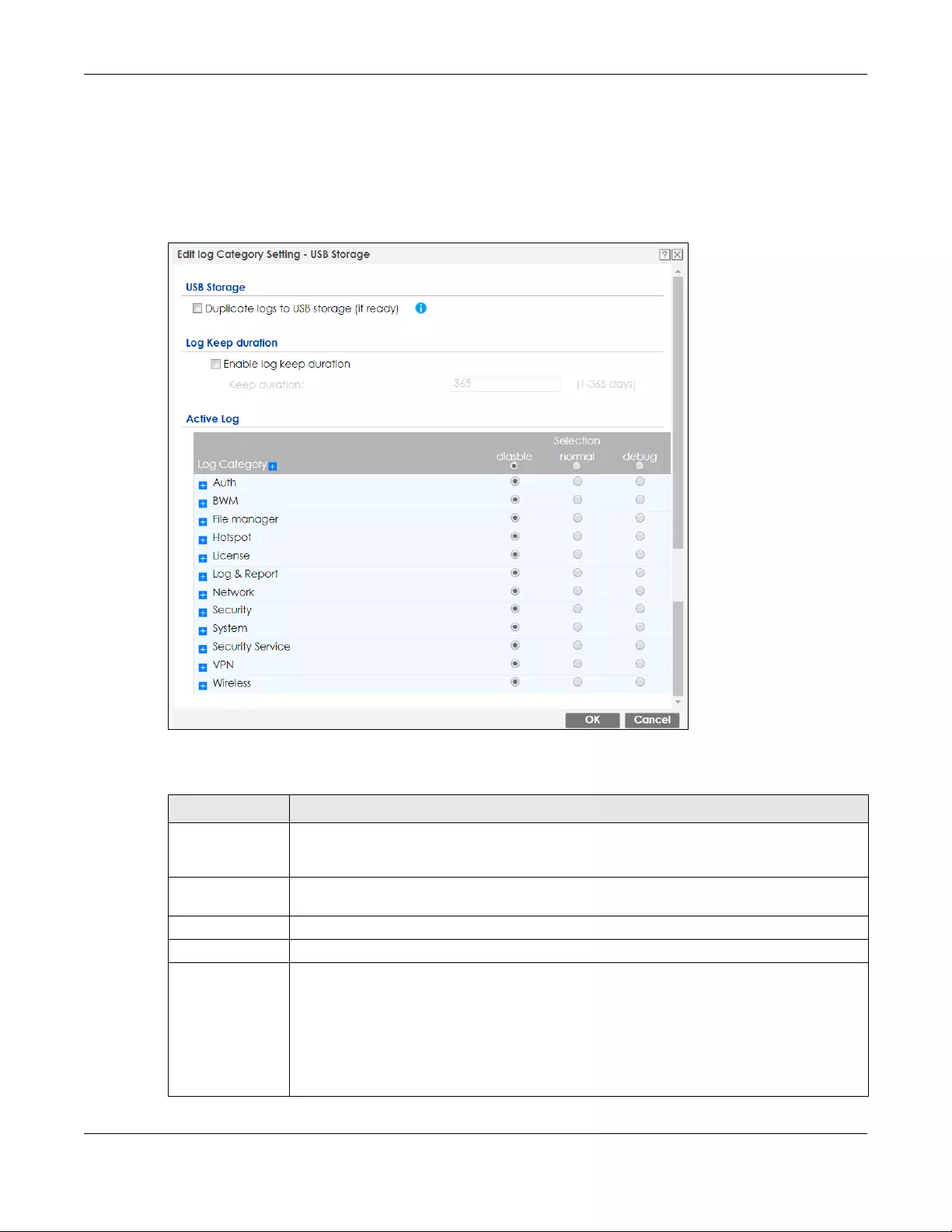
Chapter 43 Log and Report
ZyWALL USG FLEX Series User’s Guide
909
43.3.3 Edit Log on USB Storage Setting
The Edit Log on USB Storage Setting screen controls the detailed settings for saving logs to a connected
USB storage device. Go to the Log Setting Summary screen (see Section 43.3.1 on page 904), and click
the USB storage Edit icon.
Figure 622 Configuration > Log & Report > Log Setting > Edit (USB Storage)
The following table describes the labels in this screen.
Table 402 Configuration > Log & Report > Log Setting > Edit (USB Storage)
LABEL DESCRIPTION
Duplicate logs to
USB storage (if
ready)
Select this to have the Zyxel Device save a copy of its system logs to a connected USB storage
device. Use the Active Log section to specify what kinds of messages to include.
Enable log keep
duration
Select this checkbox to enter a value in the Keep Duration field.
Keep Duration Enter a number of days that the Zyxel Device keeps this log.
Active Log
Selection Use the Selection drop-down list to change the log settings for all of the log categories.
disable all logs (red X) - do not send the remote server logs for any log category.
enable normal logs (green check mark) - send the remote server log messages and alerts for
all log categories.
enable normal logs and debug logs (yellow check mark) - send the remote server log
messages, alerts, and debugging information for all log categories.
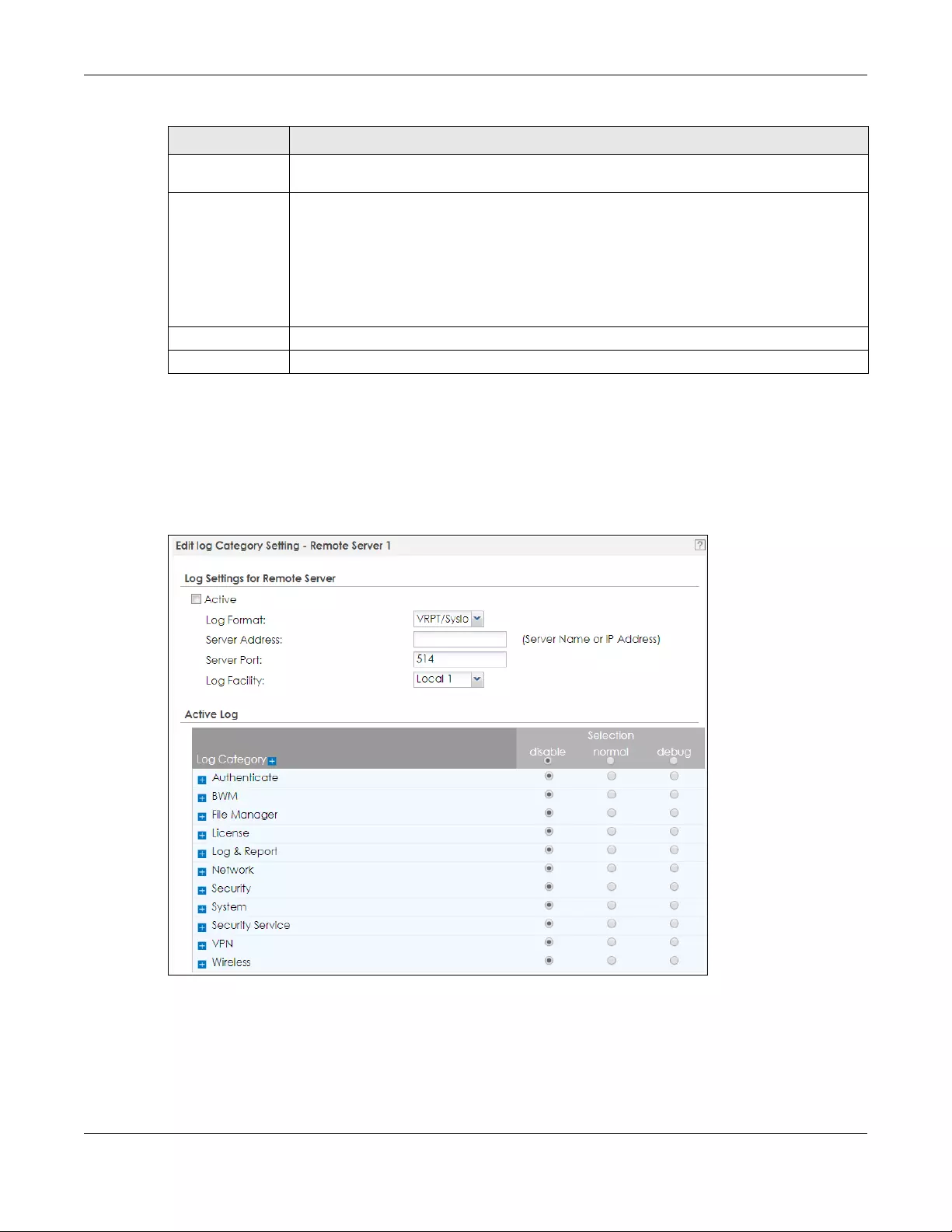
Chapter 43 Log and Report
ZyWALL USG FLEX Series User’s Guide
910
43.3.4 Edit Remote Server Log Settings
The Log Settings Edit screen controls the detailed settings for each log in the remote server (syslog). Go
to the Log Settings Summary screen (see Section 43.3.1 on page 904), and click a remote server Edit
icon.
Figure 623 Configuration > Log & Report > Log Setting > Edit (Remote Server - AC)
Log Category This field displays each category of messages. The Default category includes debugging
messages generated by open source software.
Selection Select what information you want to log from each Log Category (except All Logs; see below).
Choices are:
disable all logs (red X) - do not log any information from this category
enable normal logs (green check mark) - log regular information and alerts from this category
enable normal logs and debug logs (yellow check mark) - log regular information, alerts, and
debugging information from this category
OK Click this to save your changes and return to the previous screen.
Cancel Click this to return to the previous screen without saving your changes.
Table 402 Configuration > Log & Report > Log Setting > Edit (USB Storage) (continued)
LABEL DESCRIPTION

Chapter 43 Log and Report
ZyWALL USG FLEX Series User’s Guide
911
Configuration > Log & Report > Log Setting > Edit (Remote Server - AP)
The following table describes the labels in this screen.
Table 403 Configuration > Log & Report > Log Setting > Edit (Remote Server)
LABEL DESCRIPTION
Log Settings for
Remote Server
Active Select this check box to send log information according to the information in this section. You
specify what kinds of messages are included in log information in the Active Log section.
Log Format This field displays the format of the log information. It is read-only.
VRPT/Syslog - Zyxel’s Vantage Report, syslog-compatible format.
CEF/Syslog - Common Event Format, syslog-compatible format.
Server
Address Type the server name or the IP address of the syslog server to which to send log information.
Server Port Type the service port number used by the remote server.
Log Facility Select a log facility. The log facility allows you to log the messages to different files in the syslog
server. Please see the documentation for your syslog program for more information.
Active Log
Selection Use the Selection drop-down list to change the log settings for all of the log categories.
disable all logs (red X) - do not send the remote server logs for any log category.
enable normal logs (green check mark) - send the remote server log messages and alerts for all
log categories.
enable normal logs and debug logs (yellow check mark) - send the remote server log messages,
alerts, and debugging information for all log categories.
Log
Category This field displays each category of messages. It is the same value used in the Display and
Category fields in the View Log tab. The Default category includes debugging messages
generated by open source software.
Selection Select what information you want to log from each Log Category (except All Logs; see below).
Choices are:
disable all logs (red X) - do not log any information from this category
enable normal logs (green check mark) - log regular information and alerts from this category
enable normal logs and debug logs (yellow check mark) - log regular information, alerts, and
debugging information from this category
OK Click this to save your changes and return to the previous screen.
Cancel Click this to return to the previous screen without saving your changes.
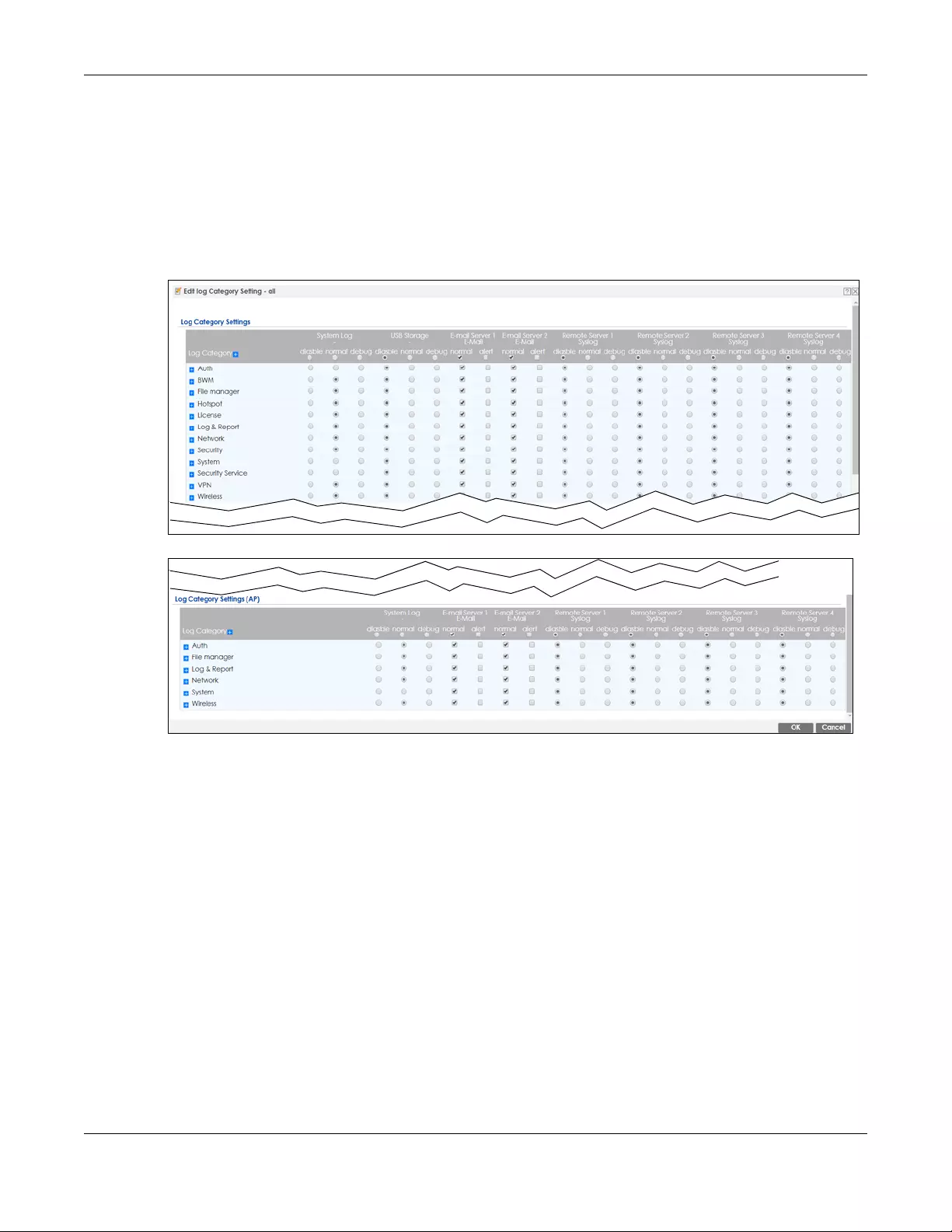
Chapter 43 Log and Report
ZyWALL USG FLEX Series User’s Guide
912
43.3.5 Log Category Settings Screen
The Log Category Settings screen allows you to view and to edit what information is included in the
system log, USB storage, email profiles, and remote servers at the same time. It does not let you change
other log settings (for example, where and how often log information is emailed or remote server
names). To access this screen, go to the Log Settings Summary screen (see Section 43.3.1 on page 904),
and click the Log Category Settings button.
Figure 624 Log Category Settings AC
Figure 625 Log Category Settings AP
This screen provides a different view and a different way of indicating which messages are included in
each log and each alert. Please see Section 43.3.2 on page 905, where this process is discussed. (The
Default category includes debugging messages generated by open source software.)

Chapter 43 Log and Report
ZyWALL USG FLEX Series User’s Guide
913
The following table describes the fields in this screen.
Table 404 Configuration > Log & Report > Log Setting > Log Category Settings
LABEL DESCRIPTION
System Log Use the System Log drop-down list to change the log settings for all of the log categories.
disable all logs (red X) - do not log any information for any category for the system log or email
any logs to email server 1 or 2.
enable normal logs (green check mark) - create log messages and alerts for all categories for
the system log. If email server 1 or 2 also has normal logs enabled, the Zyxel Device will email logs
to them.
enable normal logs and debug logs (yellow check mark) - create log messages, alerts, and
debugging information for all categories. The Zyxel Device does not email debugging
information, even if this setting is selected.
USB Storage Use the USB Storage drop-down list to change the log settings for saving logs to a connected
USB storage device.
disable all logs (red X) - do not log any information for any category to a connected USB
storage device.
enable normal logs (green check mark) - create log messages and alerts for all categories and
save them to a connected USB storage device.
enable normal logs and debug logs (yellow check mark) - create log messages, alerts, and
debugging information for all categories and save them to a connected USB storage device.
E-mail Server 1 E-
mail
Use the E-Mail Server 1 drop-down list to change the settings for emailing logs to email server 1
for all log categories.
Using the System Log drop-down list to disable all logs overrides your email server 1 settings.
enable normal logs (green check mark) - email log messages for all categories to email server 1.
enable alert logs (red exclamation point) - email alerts for all categories to email server 1.
E-mail Server 2 E-
mail
Use the E-Mail Server 2 drop-down list to change the settings for emailing logs to email server 2
for all log categories.
Using the System Log drop-down list to disable all logs overrides your email server 2 settings.
enable normal logs (green check mark) - email log messages for all categories to email server 2.
enable alert logs (red exclamation point) - email alerts for all categories to email server 2.
Remote Server
1~4 Syslog
For each remote server, use the Selection drop-down list to change the log settings for all of the
log categories.
disable all logs (red X) - do not send the remote server logs for any log category.
enable normal logs (green check mark) - send the remote server log messages and alerts for all
log categories.
enable normal logs and debug logs (yellow check mark) - send the remote server log messages,
alerts, and debugging information for all log categories.
Log Category This field displays each category of messages. It is the same value used in the Display and
Category fields in the View Log tab. The Default category includes debugging messages
generated by open source software.
System Log Select which events you want to log by Log Category. There are three choices:
disable all logs (red X) - do not log any information from this category
enable normal logs (green check mark) - create log messages and alerts from this category
enable normal logs and debug logs (yellow check mark) - create log messages, alerts, and
debugging information from this category; the Zyxel Device does not email debugging
information, however, even if this setting is selected.

Chapter 43 Log and Report
ZyWALL USG FLEX Series User’s Guide
914
USB Storage Select which event log categories to save to a connected USB storage device. There are three
choices:
disable all logs (red X) - do not log any information from this category
enable normal logs (green check mark) - save log messages and alerts from this category
enable normal logs and debug logs (yellow check mark) - save log messages, alerts, and
debugging information from this category.
E-mail Server 1 E-
mail
Select whether each category of events should be included in the log messages when it is
emailed (green check mark) and/or in alerts (red exclamation point) for the email settings
specified in E-Mail Server 1. The Zyxel Device does not email debugging information, even if it is
recorded in the System log.
E-mail Server 2 E-
mail
Select whether each category of events should be included in log messages when it is emailed
(green check mark) and/or in alerts (red exclamation point) for the email settings specified in E-
Mail Server 2. The Zyxel Device does not email debugging information, even if it is recorded in
the System log.
Remote Server
1~4 Syslog
For each remote server, select what information you want to log from each Log Category
(except All Logs; see below). Choices are:
disable all logs (red X) - do not log any information from this category
enable normal logs (green check mark) - log regular information and alerts from this category
enable normal logs and debug logs (yellow check mark) - log regular information, alerts, and
debugging information from this category
OK Click this to save your changes and return to the previous screen.
Cancel Click this to return to the previous screen without saving your changes.
Table 404 Configuration > Log & Report > Log Setting > Log Category Settings (continued)
LABEL DESCRIPTION

ZyWALL USG FLEX Series User’s Guide
915
CHAPTER 44
File Manager
44.1 Overview
Configuration files define the Zyxel Device’s settings. Shell scripts are files of commands that you can
store on the Zyxel Device and run when you need them. You can apply a configuration file or run a shell
script without the Zyxel Device restarting. You can store multiple configuration files and shell script files
on the Zyxel Device. You can edit configuration files or shell scripts in a text editor and upload them to
the Zyxel Device. Configuration files use a .conf extension and shell scripts use a .zysh extension.
44.1.1 What You Can Do in this Chapter
• Use the Configuration File screen (see Section 44.2 on page 917) to store and name configuration
files. You can also download configuration files from the Zyxel Device to your computer and upload
configuration files from your computer to the Zyxel Device.
• Use the Firmware Package screen (see Section 44.3 on page 922) to check your current firmware
version and upload firmware to the Zyxel Device.
• Use the Shell Script screen (see Section 44.4 on page 928) to store, name, download, upload and run
shell script files.
44.1.2 What you Need to Know
Configuration Files and Shell Scripts
When you apply a configuration file, the Zyxel Device uses the factory default settings for any features
that the configuration file does not include. When you run a shell script, the Zyxel Device only applies the
commands that it contains. Other settings do not change.

Chapter 44 File Manager
ZyWALL USG FLEX Series User’s Guide
916
These files have the same syntax, which is also identical to the way you run CLI commands manually. An
example is shown below.
While configuration files and shell scripts have the same syntax, the Zyxel Device applies configuration
files differently than it runs shell scripts. This is explained below.
You have to run the example in Figure 626 on page 916 as a shell script because the first command is run
in Privilege mode. If you remove the first command, you have to run the example as a configuration file
because the rest of the commands are executed in Configuration mode.
Comments in Configuration Files or Shell Scripts
In a configuration file or shell script, use “#” or “!” as the first character of a command line to have the
Zyxel Device treat the line as a comment.
Your configuration files or shell scripts can use “exit” or a command line consisting of a single “!” to have
the Zyxel Device exit sub command mode.
Note: “exit” or “!” must follow sub commands if it is to make the Zyxel Device exit sub
command mode.
Figure 626 Configuration File / Shell Script: Example
# enter configuration mode
configure terminal
# change administrator password
username admin password 4321 user-type admin
# configure ge3
interface ge3
ip address 172.23.37.240 255.255.255.0
ip gateway 172.23.37.254 metric 1
exit
# create address objects for remote management / to-ZyWALL firewall rules
# use the address group in case we want to open up remote management later
address-object TW_SUBNET 172.23.37.0/24
object-group address TW_TEAM
address-object TW_SUBNET
exit
# enable Telnet access (not enabled by default, unlike other services)
ip telnet server
# open WAN-to-ZyWALL firewall for TW_TEAM for remote management
firewall WAN ZyWALL insert 4
sourceip TW_TEAM
service TELNET
action allow
exit
write
Table 405 Configuration Files and Shell Scripts in the Zyxel Device
Configuration Files (.conf) Shell Scripts (.zysh)
• Resets to default configuration.
•Goes into CLI Configuration mode.
• Runs the commands in the configuration file.
•Goes into CLI Privilege mode.
• Runs the commands in the shell script.
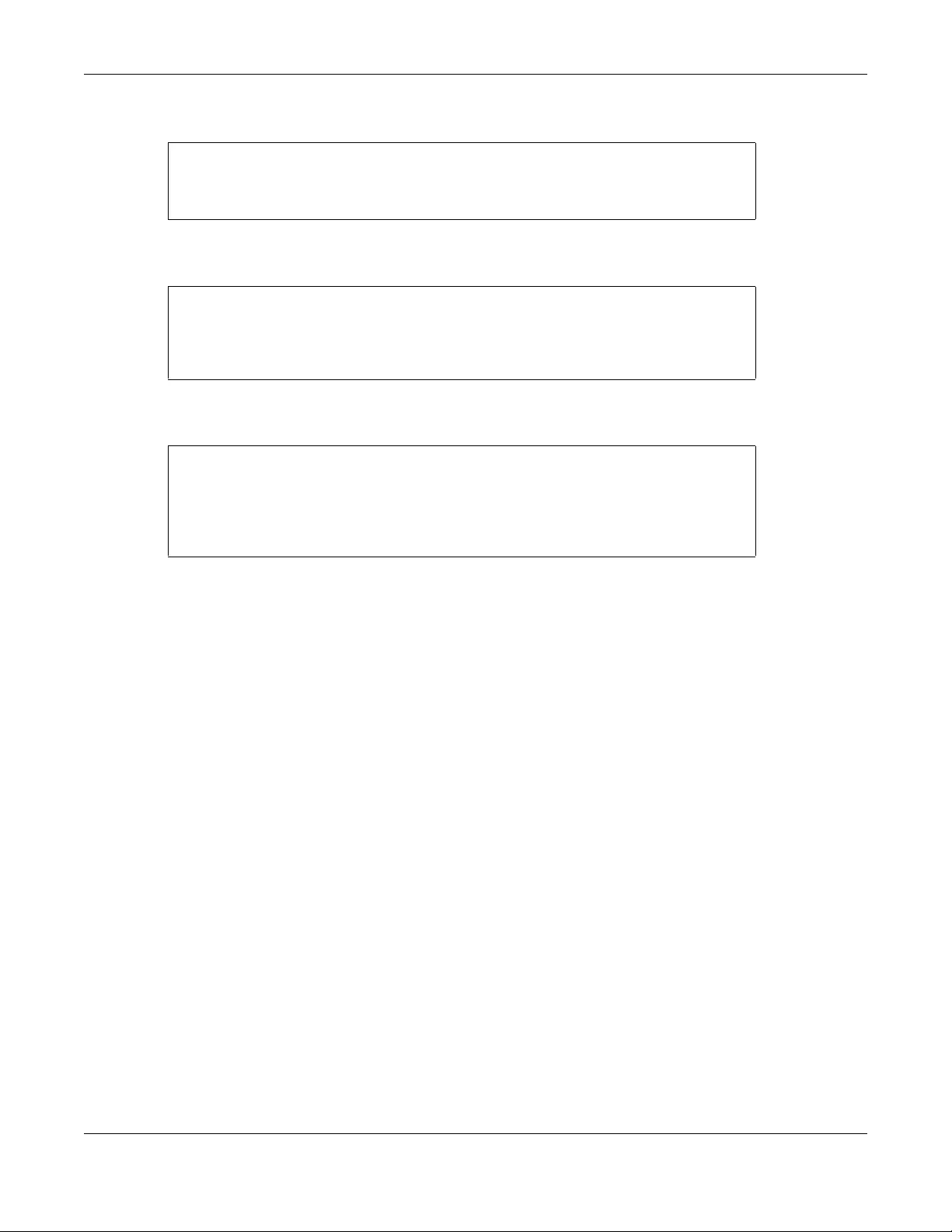
Chapter 44 File Manager
ZyWALL USG FLEX Series User’s Guide
917
Line 3 in the following example exits sub command mode.
Lines 1 and 3 in the following example are comments and line 4 exits sub command mode.
Lines 1 and 2 are comments. Line 5 exits sub command mode.
Errors in Configuration Files or Shell Scripts
When you apply a configuration file or run a shell script, the Zyxel Device processes the file line-by-line.
The Zyxel Device checks the first line and applies the line if no errors are detected. Then it continues with
the next line. If the Zyxel Device finds an error, it stops applying the configuration file or shell script and
generates a log.
You can change the way a configuration file or shell script is applied. Include setenv stop-on-error
off in the configuration file or shell script. The Zyxel Device ignores any errors in the configuration file or
shell script and applies all of the valid commands. The Zyxel Device still generates a log for any errors.
44.2 The Configuration Screen
Click Maintenance > File Manager > Configuration File > Configuration to open the Configuration
screen. Use the Configuration screen to store, run, and name configuration files. You can also download
configuration files from the Zyxel Device to your computer and upload configuration files from your
computer to the Zyxel Device.
Once your Zyxel Device is configured and functioning properly, it is highly recommended that you back
up your configuration file before making further configuration changes. The backup configuration file
will be useful in case you need to return to your previous settings.
Filenames beginning with autoback are automatic configuration files created when new firmware is
uploaded. backup-yyyy-mm-dd-hh-mm-ss.conf is the name of the automatic backup when a secure
policy is added or changed. Select a configuration file, then click Apply to apply the file to the Zyxel
Device .
interface ge1
ip address dhcp
!
!
interface ge1
# this interface is a DHCP client
!
! this is from Joe
# on 2008/04/05
interface ge1
ip address dhcp
!

Chapter 44 File Manager
ZyWALL USG FLEX Series User’s Guide
918
Configuration File Flow at Restart
• If there is not a startup-config.conf when you restart the Zyxel Device (whether through a
management interface or by physically turning the power off and back on), the Zyxel Device uses the
system-default.conf configuration file with the Zyxel Device’s default settings.
•If there is a startup-config.conf, the Zyxel Device checks it for errors and applies it. If there are no
errors, the Zyxel Device uses it and copies it to the lastgood.conf configuration file as a back up file. If
there is an error, the Zyxel Device generates a log and copies the startup-config.conf configuration
file to the startup-config-bad.conf configuration file and tries the existing lastgood.conf configuration
file. If there isn’t a lastgood.conf configuration file or it also has an error, the Zyxel Device applies the
system-default.conf configuration file.
• You can change the way the startup-config.conf file is applied. Include the setenv-startup stop-
on-error off command. The Zyxel Device ignores any errors in the startup-config.conf file and
applies all of the valid commands. The Zyxel Device still generates a log for any errors.
Figure 627 Maintenance > File Manager > Configuration File
Do not turn off the Zyxel Device while configuration file upload is in
progress.

Chapter 44 File Manager
ZyWALL USG FLEX Series User’s Guide
919
The following table describes the labels in this screen.
Table 406 Maintenance > File Manager > Configuration File
LABEL DESCRIPTION
Rename Use this button to change the label of a configuration file on the Zyxel Device. You can only
rename manually saved configuration files. You cannot rename the lastgood.conf, system-
default.conf and startup-config.conf files.
You cannot rename a configuration file to the name of another configuration file in the Zyxel
Device.
Click a configuration file’s row to select it and click Rename to open the Rename File screen.
Figure 628 Maintenance > File Manager > Configuration File > Rename
Specify the new name for the configuration file. Use up to 63 characters (including a-zA-Z0-
9;‘~!@#$%^&()_+[]{}’,.=-).
Click OK to save the duplicate or click Cancel to close the screen without saving a duplicate
of the configuration file.
Remove Click a configuration file’s row to select it and click Remove to delete it from the Zyxel Device.
You can only delete manually saved configuration files. You cannot delete the system-
default.conf, startup-config.conf and lastgood.conf files.
A pop-up window asks you to confirm that you want to delete the configuration file. Click OK
to delete the configuration file or click Cancel to close the screen without deleting the
configuration file.
Download Click a configuration file’s row to select it and click Download to save the configuration to your
computer.
Copy Use this button to save a duplicate of a configuration file on the Zyxel Device.
Click a configuration file’s row to select it and click Copy to open the Copy File screen.
Figure 629 Maintenance > File Manager > Configuration File > Copy
Specify a name for the duplicate configuration file. Use up to 63 characters (including a-zA-Z0-
9;‘~!@#$%^&()_+[]{}’,.=-).
Click OK to save the duplicate or click Cancel to close the screen without saving a duplicate
of the configuration file.

Chapter 44 File Manager
ZyWALL USG FLEX Series User’s Guide
920
Apply Use this button to have the Zyxel Device use a specific configuration file.
Click a configuration file’s row to select it and click Apply to have the Zyxel Device use that
configuration file. The Zyxel Device does not have to restart in order to use a different
configuration file, although you will need to wait for a few minutes while the system
reconfigures.
The following screen gives you options for what the Zyxel Device is to do if it encounters an
error in the configuration file.
Figure 630 Maintenance > File Manager > Configuration File > Apply
Immediately stop applying the configuration file - this is not recommended because it would
leave the rest of the configuration blank. If the interfaces were not configured before the first
error, the console port may be the only way to access the device.
Immediately stop applying the configuration file and roll back to the previous configuration -
this gets the Zyxel Device started with a fully valid configuration file as quickly as possible.
Ignore errors and finish applying the configuration file - this applies the valid parts of the
configuration file and generates error logs for all of the configuration file’s errors. This lets the
Zyxel Device apply most of your configuration and you can refer to the logs for what to fix.
Ignore errors and finish applying the configuration file and then roll back to the previous
configuration - this applies the valid parts of the configuration file, generates error logs for all of
the configuration file’s errors, and starts the Zyxel Device with a fully valid configuration file.
Click OK to have the Zyxel Device start applying the configuration file or click Cancel to close
the screen
#This column displays the number for each configuration file entry. This field is a sequential value,
and it is not associated with a specific address. The total number of configuration files that you
can save depends on the sizes of the configuration files and the available flash storage space.
File Name This column displays the label that identifies a configuration file.
You cannot delete the following configuration files or change their file names.
The system-default.conf file contains the Zyxel Device’s default settings. Select this file and click
Apply to reset all of the Zyxel Device settings to the factory defaults. This configuration file is
included when you upload a firmware package.
The startup-config.conf file is the configuration file that the Zyxel Device is currently using. If you
make and save changes during your management session, the changes are applied to this
configuration file. The Zyxel Device applies configuration changes made in the Web
Configurator to the configuration file when you click Apply or OK. It applies configuration
changes made via commands when you use the write command.
The lastgood.conf is the most recently used (valid) configuration file that was saved when the
device last restarted. If you upload and apply a configuration file with an error, you can apply
lastgood.conf to return to a valid configuration.
Table 406 Maintenance > File Manager > Configuration File (continued)
LABEL DESCRIPTION
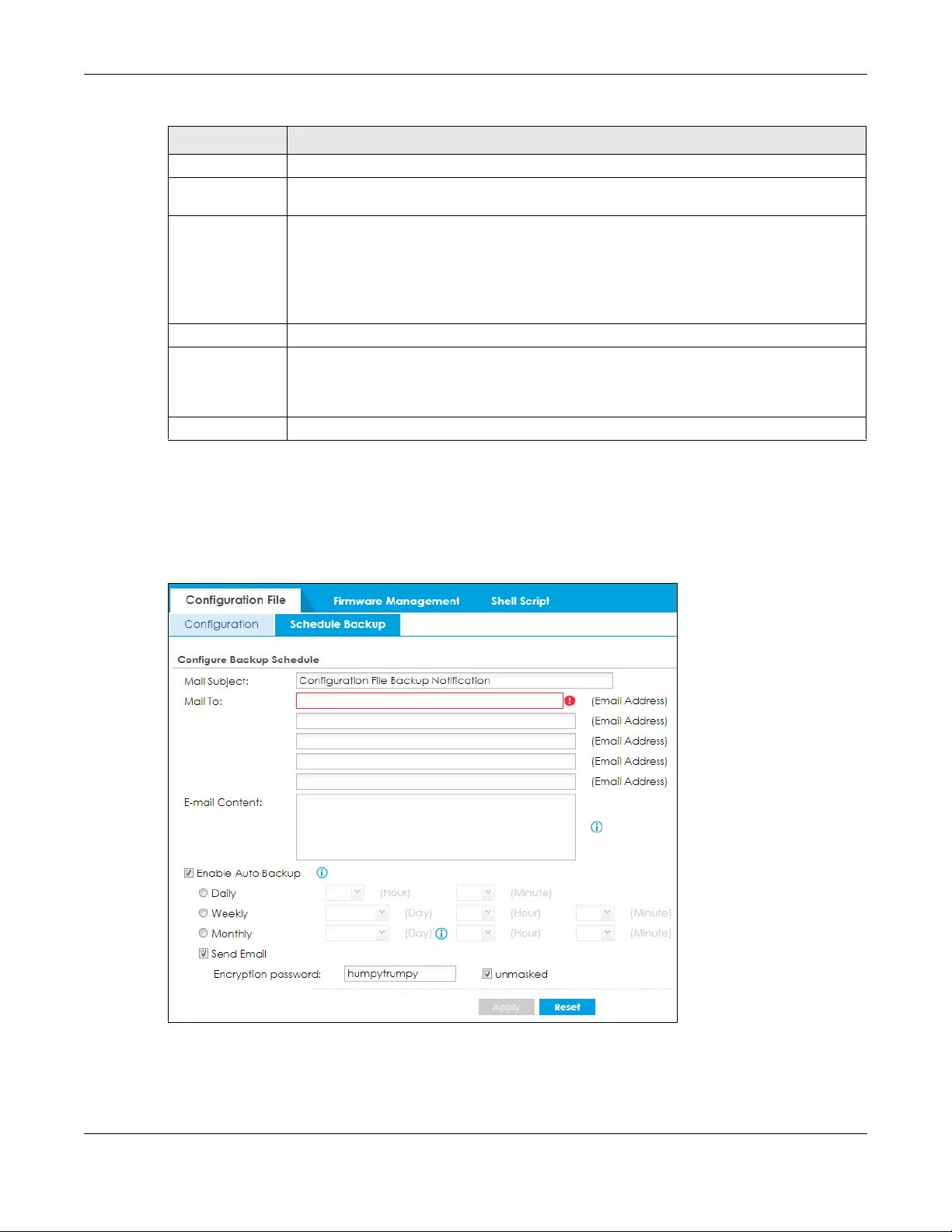
Chapter 44 File Manager
ZyWALL USG FLEX Series User’s Guide
921
44.2.1 The Configuration Schedule Backup Screen
Use the Schedule Backup screen to automatically back up the current Zyxel Device configuration file
according to a schedule, and then send it to the configured email addresses.
Figure 631 Maintenance > File Manager > Configuration File> Schedule Backup
Size This column displays the size (in KB) of a configuration file.
Last Modified This column displays the date and time that the individual configuration files were last
changed or saved.
Upload
Configuration File
The bottom part of the screen allows you to upload a new or previously saved configuration
file from your computer to your Zyxel Device
You cannot upload a configuration file named system-default.conf or lastgood.conf.
If you upload startup-config.conf, it will replace the current configuration and immediately
apply the new settings.
File Path Type in the location of the file you want to upload in this field or click Browse ... to find it.
Browse... Click Browse... to find the .conf file you want to upload. The configuration file must use a
“.conf” filename extension. You will receive an error message if you try to upload a fie of a
different format. Remember that you must decompress compressed (.zip) files before you can
upload them.
Upload Click Upload to begin the upload process. This process may take up to two minutes.
Table 406 Maintenance > File Manager > Configuration File (continued)
LABEL DESCRIPTION

Chapter 44 File Manager
ZyWALL USG FLEX Series User’s Guide
922
The following table describes the labels in this screen.
44.3 Firmware Management
Use the Firmware Management screen to check your current firmware version and upload firmware to
the Zyxel Device. You can upload firmware to be the Running firmware or Standby firmware.
Note: The Web Configurator is the recommended method for uploading firmware. You only
need to use the command line interface if you need to recover the firmware. See the
CLI Reference Guide for how to determine if you need to recover the firmware and
how to recover it.
Find the firmware file in a folder that (usually) uses the system model name with the model code and a
bin extension. For example, a firmware for ZyWALL VPN100 is “430ABFV0b2s1.bin”.
The Zyxel Device’s firmware package cannot go through the Zyxel Device when you enable the anti-
malware Destroy compressed files that could not be decompressed option. The Zyxel Device classifies
the firmware package as not being able to be decompressed and deletes it. You can upload the
firmware package to the Zyxel Device with the option enabled, so you only need to clear the Destroy
compressed files that could not be decompressed option while you download the firmware package.
Table 407 Maintenance > File Manager > Configuration File> Schedule Backup
LABEL DESCRIPTION
Configure Backup Schedule
Mail Subject Enter a email subject text with 1-60 characters. It may consist of letters, numbers, and the
following special characters: ‘()+,./:=?;!*#@$%-
Mail To Enter the receiving email address. You and send the configuration file to a maximum of five
email addresses.
E-mail Content Enter the backup email body text consists of 1-250 ASCII characters.
Enable Auto
Backup
Select the check box to back up the configuration file at a user defined schedule.
Note: After the first backup, the back up only occurs if the configuration file is
different from the previous backed up configuration file.
Daily Set the Zyxel Device to back up its configuration file once a day at the specified hour and
minute.
Weekly Set the Zyxel Device to back up its configuration file once a week on the specified day, at the
specified hour and minute.
Monthly Set the Zyxel Device to back up its configuration file once a month on the specified day, at the
a specified hour and minute.
Note: If the date you select is greater than the number of days in a month, the Zyxel Device
automatically backs up its configuration file on the last day of the month. For example, if
you select 31 and the month is February, the Zyxel Device backs up its configuration file
on day 28 or 29.
Send Email Select the check box to have the Zyxel Device sends the current configuration file to the
configured email addresses.
Encryption
password Enter a password consists of 1-31 ASCII characters to add an encryption password to the
configuration file in the email.
Apply Click Apply to save your changes back to the Zyxel Device.
Reset Click Reset to return the screen to its last-saved settings.

Chapter 44 File Manager
ZyWALL USG FLEX Series User’s Guide
923
See Section 33.2 on page 625 for more on the anti-malware Destroy compressed files that could not be
decompressed option.
The firmware update can take up to five minutes. Do not turn off or reset
the Zyxel Device while the firmware update is in progress!
If your Zyxel Device has two firmware images installed, and one fails to boot (kernel crash, kernel panic,
out-of-memory etc.), then the Zyxel Device will automatically use the (good) backup image to boot.
44.3.1 Cloud Helper
Cloud Helper lets you know if there is a later firmware available on the Cloud Helper server and lets you
download it if there is.
Note: Go to myZyxel, create an account and register your Zyxel Device first. Then you will be
able to see links to and get notifications on new firmware available.
At the time of writing, the Firmware Upgrade license providing Cloud Helper new firmware notifications is
free when you register your Zyxel Device. The license does not expire if you have firmware version 4.32
patch 1 and later.
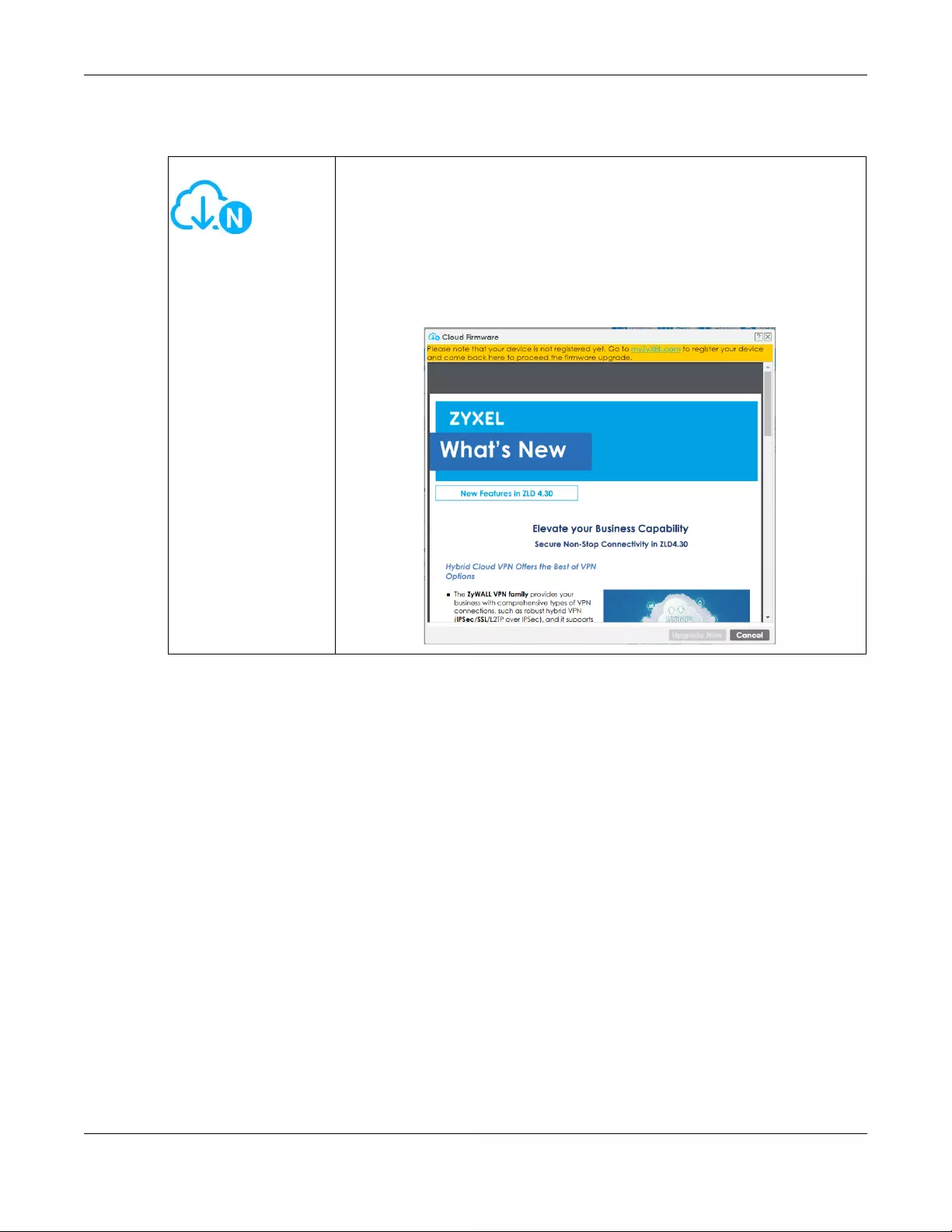
Chapter 44 File Manager
ZyWALL USG FLEX Series User’s Guide
924
The following table explains the Upgrade icons in the web configurator.
Table 408 Cloud Helper Firmware Icons
Cloud Helper New A later firmware is available on the Cloud Helper Server. Click this icon to
display a What’s New pop-up screen. You need a Firmware Upgrade license
to upgrade the firmware. If you do not have a license, Upgrade Now is
grayed out. If you have a license, click Upgrade Now to directly upgrade
firmware to the standby partition and have the Zyxel Device reboot
automatically so that the new standby firmware becomes the running
firmware. The previous running firmware becomes the standby firmware.
If you haven’t registered the Zyxel Device, a message will appear and
remind you to register it. Also, Upgrade Now is grayed out.

Chapter 44 File Manager
ZyWALL USG FLEX Series User’s Guide
925
44.3.2 The Firmware Management Screen
Click Maintenance > File Manager > Firmware Management to open the Firmware Management screen.
Cloud Helper
Downloading
Cloud firmware is being downloaded from the Cloud Helper Server. If you
select another partition or the local firmware upgrade icon, you will see the
following warning message.
When firmware is downloading, you can pause, resume, stop or retry the
firmware download.
Local Firmware Use this if you have already downloaded the latest firmware from the Zyxel
website to your computer and unzipped it.
Click the icon and then browse to the location of the unzipped files.
If you upload the latest firmware to the running partition, the Zyxel Device will
reboot automatically when it finishes uploading.
If you upload the latest firmware to the standby partition, a message will
appear to ask if you want to reboot the Zyxel Device.
Table 408 Cloud Helper Firmware Icons
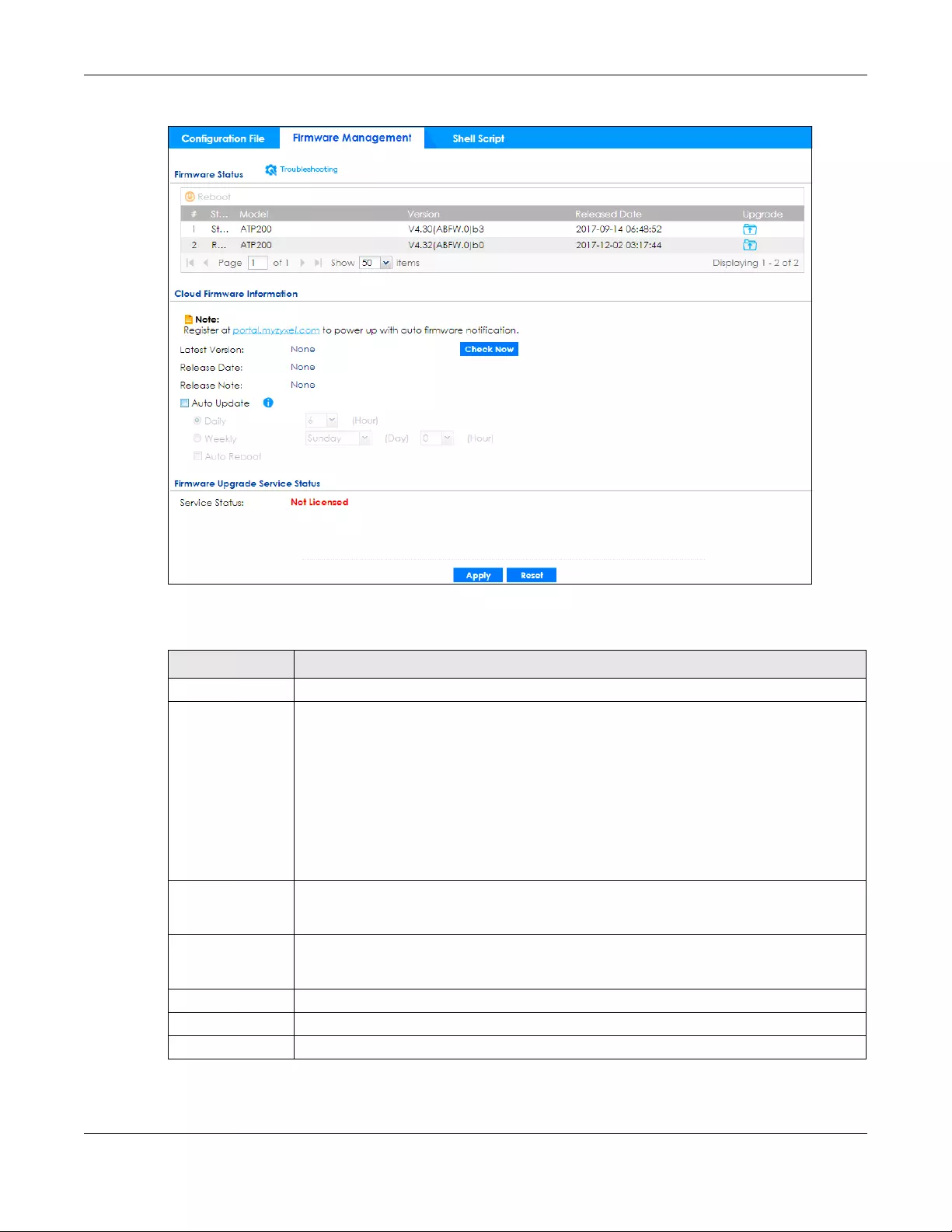
Chapter 44 File Manager
ZyWALL USG FLEX Series User’s Guide
926
Figure 632 Maintenance > File Manager > Firmware Management
The following table describes the labels in this screen.
Table 409 Maintenance > File Manager > Firmware Management
LABEL DESCRIPTION
Firmware Status
Reboot Click the Reboot icon to restart the Zyxel Device. If you applied changes in the Web
configurator, these were saved automatically and do not change when you reboot. If you
made changes in the CLI, however, you have to use the write command to save the
configuration before you reboot. Otherwise, the changes are lost when you reboot.
If you want the Standby firmware to be the Running firmware, then select the Standby
firmware row and click Reboot. Wait a few minutes until the login screen appears. If the login
screen does not appear, clear your browser cache and refresh the screen or type the IP
address of the Zyxel Device in your Web browser again.
You can also use the CLI command reboot to restart the Zyxel Device.
#This displays the system space (partition) index number where the firmware is located. The
firmware can be either Standby or Running; only one firmware can be running at any one
time.
Status This indicates whether the firmware is Running, or not running but already uploaded to the
Zyxel Device and is on Standby. It displays N/A if there is no firmware uploaded to that system
space.
Model This is the model name of the device which the firmware is running on.
Version This is the firmware version and the date created.
Released Date This is the date that the version of the firmware was created.
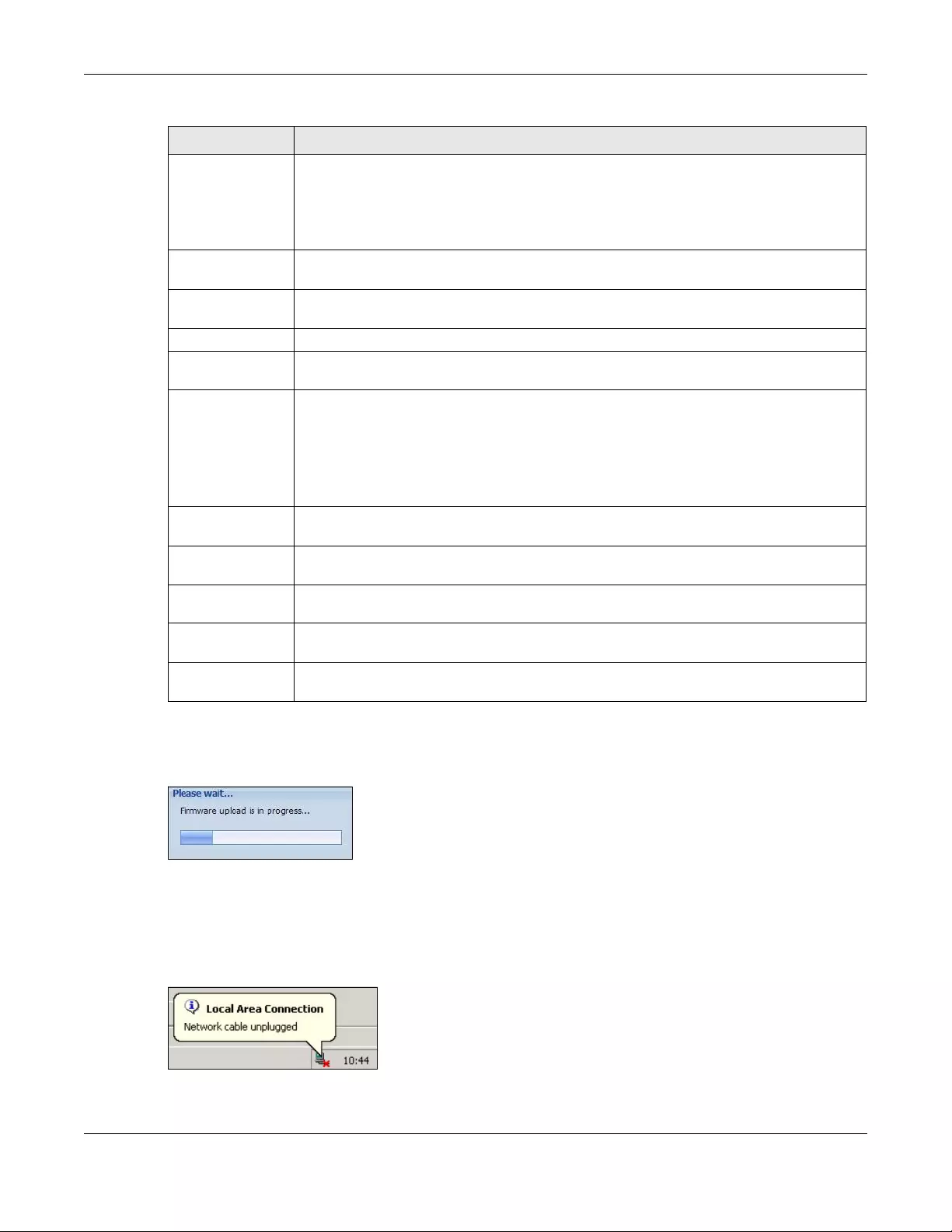
Chapter 44 File Manager
ZyWALL USG FLEX Series User’s Guide
927
After you see the Firmware Upload in Process screen, wait a few minutes before logging into the Zyxel
Device again.
Figure 633 Firmware Upload In Process
Note: The Zyxel Device automatically reboots after a successful upload.
The Zyxel Device automatically restarts causing a temporary network disconnect. In some operating
systems, you may see the following icon on your desktop.
Figure 634 Network
After five minutes, log in again and check your new firmware version in the Dashboard screen.
Upgrade A cloud helper icon displays if there is a later firmware on the Cloud Server than the firmware
in the partition. Click the cloud helper icon to download a later firmware from the Cloud
Helper Server.
Use the local firmware icon if you have already downloaded the latest firmware from the
Zyxel website to your computer and unzipped it.
Cloud Firmware
Information
You must register your Zyxel Device at myZyxel first to use cloud firmware.
Latest Version This displays the latest firmware version at the Cloud Helper Server. Click Check Now to see if
there is a later firmware at the Cloud Server.
Release Date This displays the date the latest firmware version was made available.
Release Note The release note contains details of latest firmware version such as new features and bug
fixes.
Auto Update Select this check box to have the Zyxel Device automatically check for and download new
firmware to the standby partition at the time and day specified.
You should select a time when your network is not busy for minimal interruption.
Note: You cannot enable Auto Update in File Manager > Firmware Management
and Schedule Reboot in Maintenance > Shutdown-Reboot at the same time.
Daily Select this option to have the Zyxel Device check for new firmware every day at the specified
time. The time format is the 24 hour clock, so ‘0’ means midnight for example.
Weekly Select this option to have the Zyxel Device check for new firmware once a week on the day
and at the time specified.
Auto Reboot Select this to have the newly downloaded firmware in the standby partition become the
running firmware after the Zyxel Device automatically restarts.
Firmware Upgrade
Service Status
Service Status This field displays whether the firmware license service is activated at myZyxel (Activated) or
not (Not Activated).
Table 409 Maintenance > File Manager > Firmware Management (continued)
LABEL DESCRIPTION

ZyWALL USG FLEX Series User’s Guide
928
If the upload was not successful, the following message appears in the status bar at the bottom of the
screen.
Figure 635 Firmware Upload Error
44.3.3 Firmware Upgrade via USB Stick
In addition to uploading firmware via the web configurator or console port (see the CLI Reference
Guide), you can also upload firmware directly from a USB stick connected to the Zyxel Device.
1Create a folder on the USB stick called ‘/[ProductName_dir]/firmware’. For example, if your Zyxel Device
is USG110, then create a ‘/usg110_dir/firmware/’ folder on the stick.
2Put one firmware ‘bin’ file into the firmware folder. Make sure the firmware ID and version number are
correct for your model (the firmware ID is in brackets after the firmware version number - for USG100 it is
AAPH).
Note: Do not put more than one firmware ‘bin’ file into the firmware folder.
The firmware version in the USB stick must be different to the currently running firmware.
If the firmware on the USB stick is older, then the Zyxel Device will ‘upgrade’ to the older
version. It is recommended that the firmware on the USB stick be the latest firmware
version.
3Insert the USB stick into the Zyxel Device. The firmware uploads to the standby system space.
4The SYS LED blinks when the Zyxel Device automatically reboots making the upgraded firmware in
standby become the running firmware.
Note: If the startup-config.conf configuration file has problems and you are upgrading to 4.25
or later firmware, then the Zyxel Device will revert (failover) to the previously running
firmware.
If the startup-config.conf configuration file has problems and you are upgrading to
earlier than 4.25 firmware, then the Zyxel Device uses the new earlier firmware, but
generates a log and tries the existing lastgood.conf configuration file. If there isn’t a
lastgood.conf configuration file or it also has an error, the Zyxel Device applies the
system-default.conf configuration file.
44.4 The Shell Script Screen
Use shell script files to have the Zyxel Device execute commands that you specify. Use a text editor to
create the shell script files. They must use a “.zysh” filename extension.
Click Maintenance > File Manager > Shell Script to open the Shell Script screen. Use the Shell Script
screen to store, name, download, upload and run shell script files. You can store multiple shell script files
on the Zyxel Device at the same time.
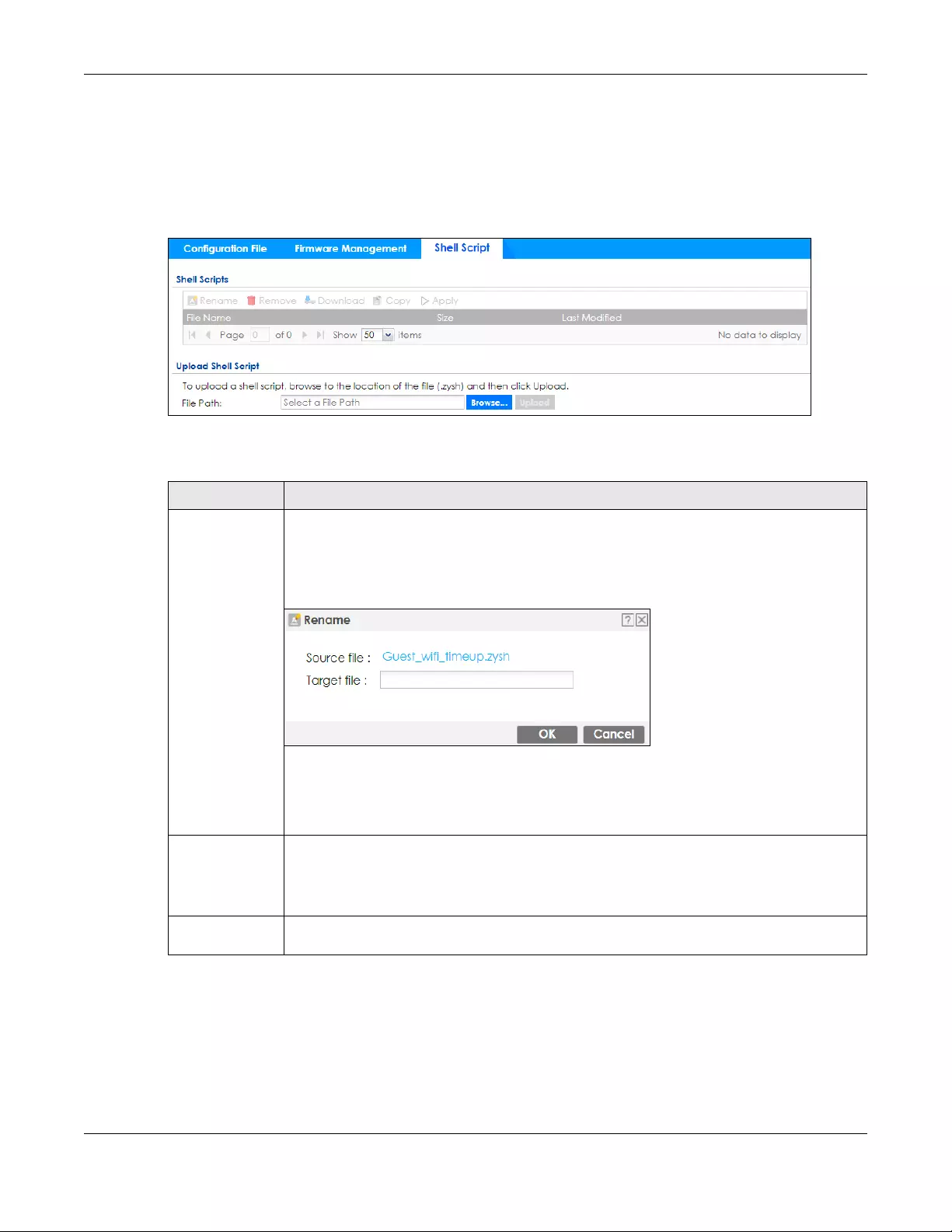
Chapter 44 File Manager
ZyWALL USG FLEX Series User’s Guide
929
Note: You should include write commands in your scripts. If you do not use the write
command, the changes will be lost when the Zyxel Device restarts. You could use
multiple write commands in a long script.
See Section 45.2.1 on page 931 for more information on scripts.
Figure 636 Maintenance > File Manager > Shell Script
Each field is described in the following table.
Table 410 Maintenance > File Manager > Shell Script
LABEL DESCRIPTION
Rename Use this button to change the label of a shell script file on the Zyxel Device.
You cannot rename a shell script to the name of another shell script in the Zyxel Device.
Click a shell script’s row to select it and click Rename to open the Rename File screen.
Figure 637 Maintenance > File Manager > Shell Script > Rename
Specify the new name for the shell script file. Use up to 63 characters (including a-zA-Z0-
9;‘~!@#$%^&()_+[]{}’,.=-).
Click OK to save the duplicate or click Cancel to close the screen without saving a duplicate of
the configuration file.
Remove Click a shell script file’s row to select it and click Remove to delete the shell script file from the
Zyxel Device.
A pop-up window asks you to confirm that you want to delete the shell script file. Click OK to
delete the shell script file or click Cancel to close the screen without deleting the shell script file.
Download Click a shell script file’s row to select it and click Download to save the configuration to your
computer.
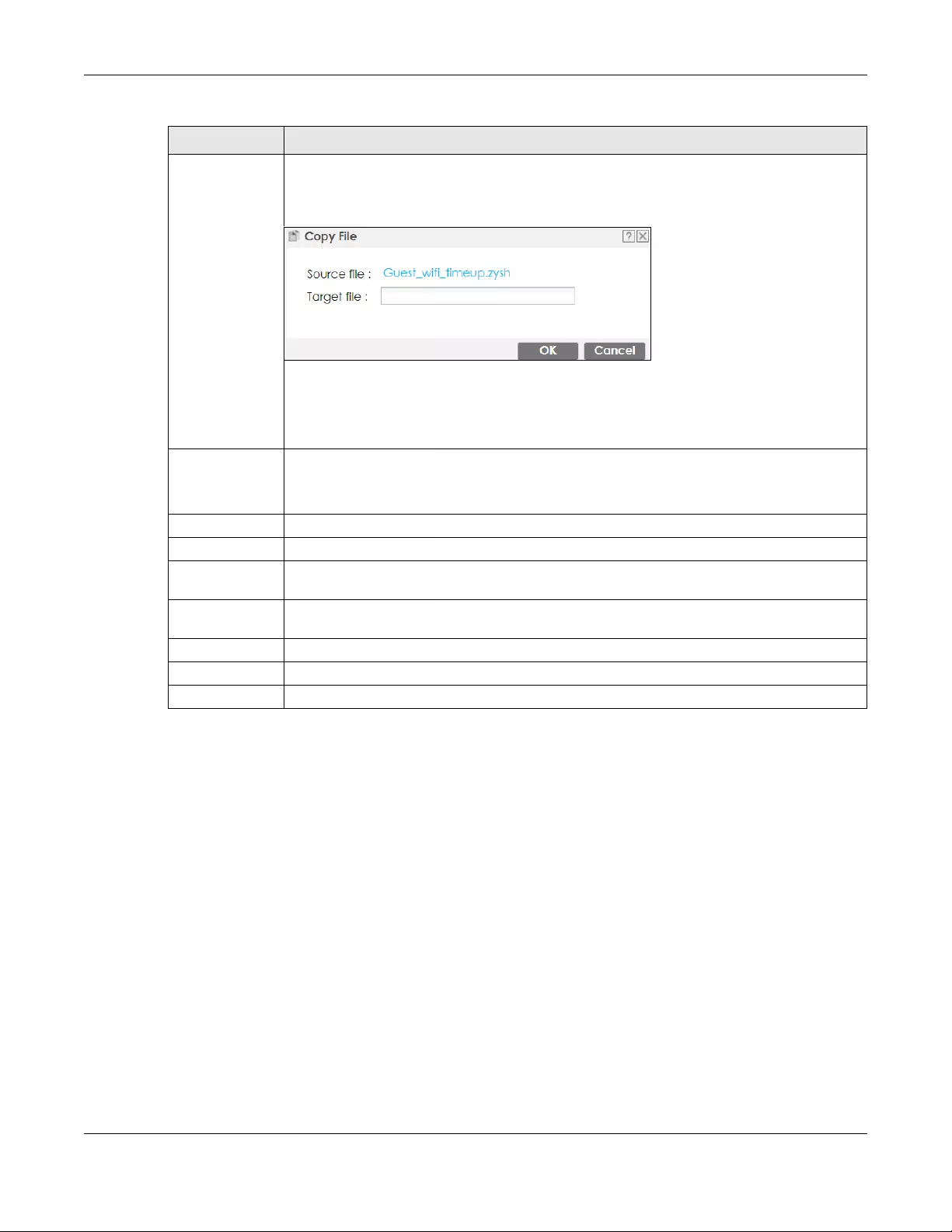
Chapter 44 File Manager
ZyWALL USG FLEX Series User’s Guide
930
Copy Use this button to save a duplicate of a shell script file on the Zyxel Device.
Click a shell script file’s row to select it and click Copy to open the Copy File screen.
Figure 638 Maintenance > File Manager > Shell Script > Copy
Specify a name for the duplicate file. Use up to 63 characters (including a-zA-Z0-
9;‘~!@#$%^&()_+[]{}’,.=-).
Click OK to save the duplicate or click Cancel to close the screen without saving a duplicate of
the configuration file.
Apply Use this button to have the Zyxel Device use a specific shell script file.
Click a shell script file’s row to select it and click Apply to have the Zyxel Device use that shell
script file. You may need to wait awhile for the Zyxel Device to finish applying the commands.
File Name This column displays the label that identifies a shell script file.
Size This column displays the size (in KB) of a shell script file.
Last Modified This column displays the date and time that the individual shell script files were last changed or
saved.
Upload Shell
Script
The bottom part of the screen allows you to upload a new or previously saved shell script file
from your computer to your Zyxel Device.
File Path Type in the location of the file you want to upload in this field or click Browse ... to find it.
Browse... Click Browse... to find the .zysh file you want to upload.
Upload Click Upload to begin the upload process. This process may take up to several minutes.
Table 410 Maintenance > File Manager > Shell Script (continued)
LABEL DESCRIPTION

Chapter 45 Diagnostics
ZyWALL USG FLEX Series User’s Guide
931
CHAPTER 45
Diagnostics
45.1 Overview
Use the diagnostics screens for troubleshooting.
45.1.1 What You Can Do in this Chapter
• Use the Diagnostics screens (see Section 45.2 on page 931) to generate a file containing the Zyxel
Device’s configuration and diagnostic information if you need to provide it to customer support
during troubleshooting.
• Use the Packet Capture screens (see Section 45.3 on page 937) to capture packets going through the
Zyxel Device.
• Use the CPU / Memory Status screens (see Section 45.4 on page 944) to view the CPU and memory
performance of various applications on the Zyxel Device.
• Use the System Logs screen (see Section 45.5 on page 946) to see system logs stored on a connected
USB storage device on the Zyxel Device.
• Use the Network Tool screen (see Section 45.6 on page 946) to ping an IP address or trace the route
packets take to a host.
• Use the Routing Traces screens (see Section 45.7 on page 949) to configure traceroute to identify
where packets are dropped for troubleshooting.
• Use the Wireless Frame Capture screens (see Section 45.8 on page 950) to capture network traffic
going through the AP interfaces connected to your Zyxel Device.
45.2 The Diagnostics Screens
The Diagnostics screens provide an easy way for you to generate a file containing the Zyxel Device’s
configuration and diagnostic information. You may need to send this file to customer support for
troubleshooting.
45.2.1 Scripts
Use scripts to gather information on the Zyxel Device or on external APs connected to the Zyxel Device.
Use a notepad editor that supports Unicode, such as Notepad to create a script. Each command in a
script must be on its own line and the file must end with an empty line. The script must be saved in
Unicode format (UTF-8).

Chapter 45 Diagnostics
ZyWALL USG FLEX Series User’s Guide
932
This is an example of a script to display information about the Zyxel Device.
This is an example of a default script with interface diagnostic commands.
Script Name
The script name must use a “.zysh” filename extension with a file name of up to 25 characters (including
a-z, A-Z, 0-9 and ;‘~!@#$%^&()_+[]{}’,.=-). Spaces are allowed
Script Uploads to the Zyxel Device
You can upload scripts in File Manager > Shell Script to run commands on the Zyxel Device. You can
also copy, and download scripts here.
Upload a script in Diagnostics > Controller to generate information about the Zyxel Device own
configuration and diagnostics.
Upload a script in Diagnostics > AP to generate information about the selected managed AP in
Diagnostics > AP.
Script Output
The results of generating a script are shown in Diagnostics > Files in bz2 format. You need to decompress
the bz2 file to tar, and then unwrap the tar file to display a debug folder that contains other folders
containing debug dbg text files. Customer support may request the bz2 file for troubleshooting.
45.2.2 The Diagnostics Controller Screen
Click Maintenance > Diagnostics > Controller to open the following screen. When you click Collect Now,
a series of commands are run to display information about the Zyxel Device.
show service-register status all
show myzyxel-service get-cloud-timezone
show cloud-helper firmware
show cloud-helper remind
debug interface ifconfig
debug interface show event_sink
debug interface show interface_obj
debug switch table
debug switch port_groupping
show ping-check status
debug system netstat interface
show interface all
show port status

Chapter 45 Diagnostics
ZyWALL USG FLEX Series User’s Guide
933
Figure 639 Maintenance > Diagnostics > Controller
The following table describes the labels in this screen.
Table 411 Maintenance > Diagnostics > Controller
LABEL DESCRIPTION
Diagnostics Collect Status
Status This field displays the following states the Zyxel Device is in when collecting
diagnostic data.
•Standby: The Zyxel Device is ready to generate a diagnostic file or has just
finished generating a diagnostic file.
•Busy on Ap: The Zyxel Device is generating a diagnostic file for the selected
managed AP in Diagnostics > AP.
•Busy on ZyWall: The Zyxel Device is generating a diagnostic file containing its
own configuration and diagnostic information.
General Setting
Filename This is the name of the most recently created diagnostic file.
Last modified This is the date and time that the last diagnostic file was created. The format is yyyy-
mm-dd hh:mm:ss.
Size This is the size of the most recently created diagnostic file.
Copy the diagnostic file to
USB storage (if ready)
Select this to have the Zyxel Device create an extra copy of the diagnostic file to a
connected USB storage device.
Diagnostic Collect by Script
files
Script File Select a script here to generate information about configuration and diagnostics of
managed APs. See Section 45.2.1 on page 931 for more information on scripts.
Upload Shell Script
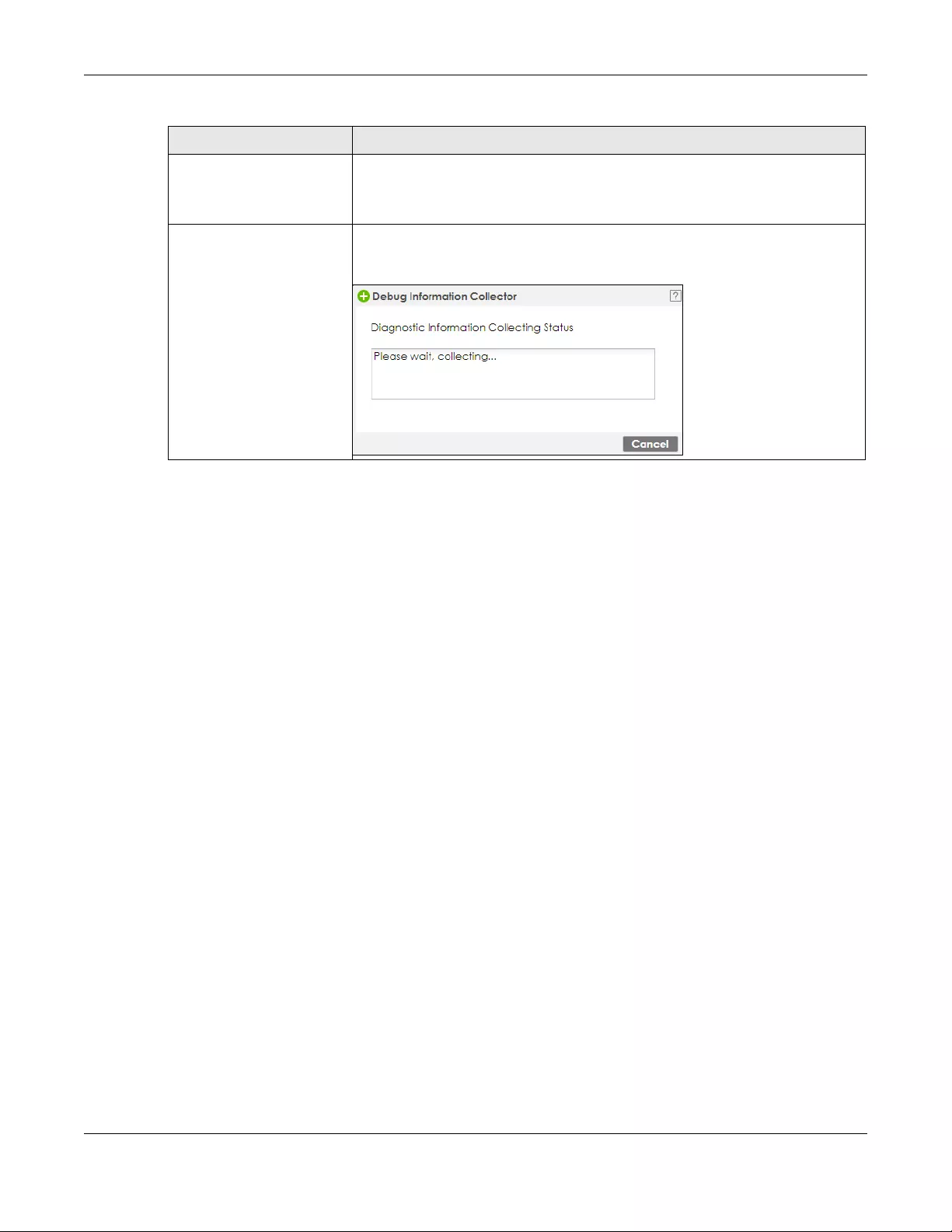
Chapter 45 Diagnostics
ZyWALL USG FLEX Series User’s Guide
934
45.2.3 The Diagnostics AP Screen
This screen provides an easy way for you to generate a file containing the selected managed AP’s
configuration and diagnostic information. You may need to generate this file and send it to customer
support during troubleshooting. Click Maintenance > Diagnostics > Collect on AP to open the Collect on
AP screen.
File Upload a script here to generate information about the Zyxel Device’s own
configuration and diagnostics. Click Browse to find the location of the file you want
to upload in this field. Click Upload to begin the upload process. This process may
take a few minutes.
Collect Now Click this to have the Zyxel Device run the uploaded script and create a new
diagnostic file.
Wait while information is collected.
Table 411 Maintenance > Diagnostics > Controller (continued)
LABEL DESCRIPTION

Chapter 45 Diagnostics
ZyWALL USG FLEX Series User’s Guide
935
Figure 640 Maintenance > Diagnostics > AP
The following table describes the labels in this screen.
Table 412 Maintenance > Diagnostics > AP
LABEL DESCRIPTION
Diagnostics Collect Status
Status This field displays the following states the Zyxel Device is in when collecting
diagnostic data.
•Standby: The Zyxel Device is ready to generate a diagnostic file or has just
finished generating a diagnostic file.
•Busy on Ap: The Zyxel Device is generating a diagnostic file for the selected
managed AP in Diagnostics > AP.
•Busy on ZyWall: The Zyxel Device is generating a diagnostic file containing its
own configuration and diagnostic information.
Progress This field displays the number of APs processed compared to the number of APs
selected for processing.
Latest AP Result This field displays the latest AP description and status
AP General Setting
Available APs This text box lists the managed APs that are connected and available. Select the
managed APs that you want the Zyxel Device to generate a diagnostic file
containing their configuration, and click the right arrow button to add them.
Collected APs This text box lists the managed APs that you allow the Zyxel Device to generate a
diagnostic file containing their configuration. Select any managed APs that you
want to prevent the Zyxel Device from generating a diagnostic file for them, and
click the left arrow button to remove them.
Copy the diagnostic file to
USB storage (if ready)
Select this to have the Zyxel Device create an extra copy of the diagnostic file to a
connected USB storage device.

Chapter 45 Diagnostics
ZyWALL USG FLEX Series User’s Guide
936
45.2.4 The Diagnostics Files Screen
Click Maintenance > Diagnostics > Files to open the diagnostic files screen. This screen lists the files of
diagnostic information the Zyxel Device has collected and stored on the Zyxel Device or in a connected
USB storage device. You may need to send these files to customer support for troubleshooting.
Figure 641 Maintenance > Diagnostics > Files
Diagnostic Collect by Script
files
Script File Select a script here to generate information about configuration and diagnostics of
managed APs. See Section 45.2.1 on page 931 for more information on scripts.
Upload Shell Script
File Upload a script hereto generate information about configuration and diagnostics
of managed APs. Click Browse to find the location of the script you want to upload
in this field. Click Upload to begin the upload process. This process may take a few
minutes.
Collect Now Click this to have the Zyxel Device create a new diagnostic file.
Table 412 Maintenance > Diagnostics > AP
LABEL DESCRIPTION

Chapter 45 Diagnostics
ZyWALL USG FLEX Series User’s Guide
937
The following table describes the labels in this screen.
45.3 The Packet Capture Screen
Use this screen to capture network traffic going through the Zyxel Device’s interfaces. Studying these
packet captures may help you identify network problems. Click Maintenance > Diagnostics > Packet
Capture to open the packet capture screen.
Note: New capture files overwrite existing files of the same name. Change the File Suffix field’s
setting to avoid this.
Table 413 Maintenance > Diagnostics > Files
LABEL DESCRIPTION
Diagnostic
files
This lists the files of generated diagnostic information stored on the Zyxel Device.
Diagnostic
files in USB
storage
This lists the files of generated diagnostic information stored in a connected USB storage device.
Remove Select files and click Remove to delete them from the Zyxel Device or the USB storage device. Use
the [Shift] and/or [Ctrl] key to select multiple files. A pop-up window asks you to confirm that you
want to delete.
Download Click a file to select it and click Download to save it to your computer.
#This column displays the number for each file entry. The total number of files that you can save
depends on the file sizes and the available storage space.
File Name This column displays the label that identifies the file.
Size This column displays the size (in bytes) of a file.
Last Modified This column displays the date and time that the individual files were saved.

ZyWALL USG FLEX Series User’s Guide
938
Figure 642 Maintenance > Diagnostics > Packet Capture
The following table describes the labels in this screen.
Table 414 Maintenance > Diagnostics > Packet Capture
LABEL DESCRIPTION
Interfaces Enabled interfaces (except for virtual interfaces) appear under Available Interfaces.
Select interfaces for which to capture packets and click the right arrow button to move
them to the Capture Interfaces list. Use the [Shift] and/or [Ctrl] key to select multiple
objects.
IP Version Select the version of IP for which to capture packets. Select any to capture packets for
all IP versions.
Protocol Type Select the protocol of traffic for which to capture packets. Select any to capture
packets for all types of traffic.
Host IP Select a host IP address object for which to capture packets. Select any to capture
packets for all hosts. Select User Defined to be able to enter an IP address.

Chapter 45 Diagnostics
ZyWALL USG FLEX Series User’s Guide
939
Host Port This field is configurable when you set the IP Type to any, tcp, or udp. Specify the port
number of traffic to capture.
Continuously capture
and overwrite old ones
Select this to have the Zyxel Device keep capturing traffic and overwriting old packet
capture entries when the available storage space runs out.
Captured Packet Files When saving packet captures only to the Zyxel Device’s on board storage, specify a
maximum limit in megabytes for the total combined size of all the capture files on the
Zyxel Device.
When saving packet captures to a connected USB storage device, specify a maximum
limit in megabytes for each capture file.
Note: If you have existing capture files and have not selected the
Continuously capture and overwrite old ones option, you may need to
set this size larger or delete existing capture files.
The valid range depends on the available on board/USB storage size. The Zyxel Device
stops the capture and generates the capture file when either the file reaches this size or
the time period specified in the Duration field expires.
Split threshold Specify a maximum size limit in megabytes for individual packet capture files. After a
packet capture file reaches this size, the Zyxel Device starts another packet capture file.
Duration Set a time limit in seconds for the capture. The Zyxel Device stops the capture and
generates the capture file when either this period of time has passed or the file reaches
the size specified in the File Size field. 0 means there is no time limit.
File Suffix Specify text to add to the end of the file name (before the dot and filename extension)
to help you identify the packet capture files. Modifying the file suffix also avoids making
new capture files that overwrite existing files of the same name.
The file name format is “interface name-file suffix.cap”, for example “vlan2-packet-
capture.cap”.
Number Of Bytes To
Capture (Per Packet)
Specify the maximum number of bytes to capture per packet. The Zyxel Device
automatically truncates packets that exceed this size. As a result, when you view the
packet capture files in a packet analyzer, the actual size of the packets may be larger
than the size of captured packets.
Save data to onboard
storage only
Select this to have the Zyxel Device only store packet capture entries on the Zyxel
Device. The available storage size is displayed as well.
Note: The Zyxel Device reserves some on board storage space as a buffer.
Save data to USB
storage
Select this to have the Zyxel Device store packet capture entries only on a USB storage
device connected to the Zyxel Device if the Zyxel Device allows this.
Status:
Unused - the connected USB storage device was manually unmounted by using the
Remove Now button or for some reason the Zyxel Device cannot mount it.
none - no USB storage device is connected.
service deactivated - USB storage feature is disabled (in Configuration > System > USB
Storage), so the Zyxel Device cannot use a connected USB device to store system logs
and other diagnostic information.
available - you can have the Zyxel Device use the USB storage device. The available
storage capacity also displays.
Note: The Zyxel Device reserves some USB storage space as a buffer.
Save data to ftp server
(available: xx MB)
Select this to have the Zyxel Device store packet capture entries on the defined FTP site.
The available storage size is displayed as well.
Table 414 Maintenance > Diagnostics > Packet Capture (continued)
LABEL DESCRIPTION

Chapter 45 Diagnostics
ZyWALL USG FLEX Series User’s Guide
940
45.3.1 The Packet Capture on AP Screen
Use this screen to capture network traffic going through the connected APs’ interfaces. Studying these
packet captures may help you identify network problems. Click Maintenance > Diagnostics > Packet
Capture > Capture on AP to open the packet capture screen.
Note: New capture files overwrite existing files of the same name. Change the File Suffix field’s
setting to avoid this.
Server Address Type the IP address of the FTP server.
Server Port Type the port this server uses for FTP traffic. The default FTP port is 21.
Name Type the login username to access the FTP server.
Password Type the associated login password to access the FTP server.
Capture Click this button to have the Zyxel Device capture packets according to the settings
configured in this screen.
You can configure the Zyxel Device while a packet capture is in progress although you
cannot modify the packet capture settings.
The Zyxel Device’s throughput or performance may be affected while a packet capture
is in progress.
After the Zyxel Device finishes the capture it saves a separate capture file for each
selected interface. The total number of packet capture files that you can save depends
on the file sizes and the available flash storage space. Once the flash storage space is
full, adding more packet captures will fail.
Stop Click this button to stop a currently running packet capture and generate a separate
capture file for each selected interface.
Reset Click this button to return the screen to its last-saved settings.
Table 414 Maintenance > Diagnostics > Packet Capture (continued)
LABEL DESCRIPTION
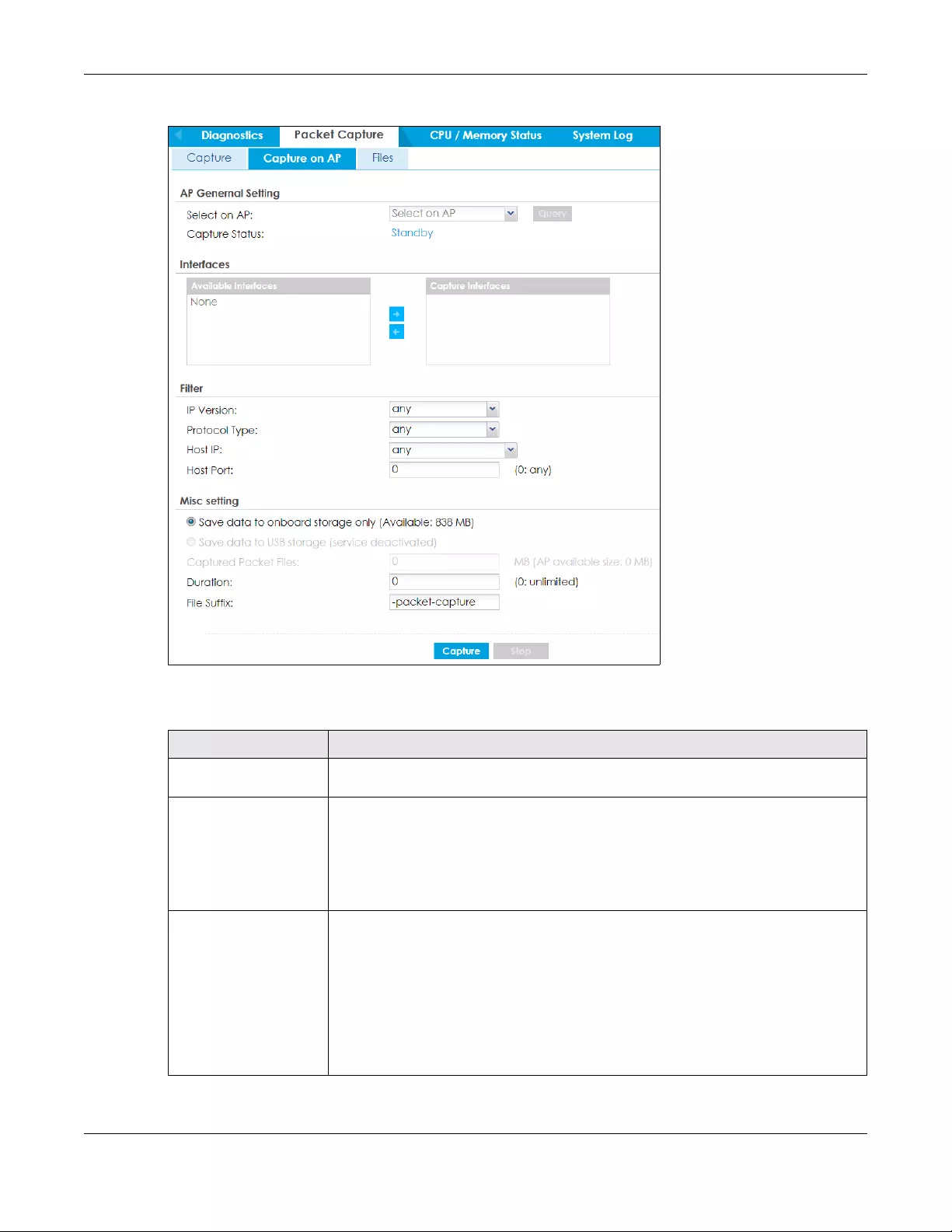
Chapter 45 Diagnostics
ZyWALL USG FLEX Series User’s Guide
941
Figure 643 Maintenance > Diagnostics > Packet Capture > Capture on AP
The following table describes the labels in this screen.
Table 415 Maintenance > Diagnostics > Packet Capture > Capture on AP
LABEL DESCRIPTION
Select on AP This lists the managed APs that are connected and available. Select the managed AP
that you want the Zyxel Device to capture network traffic going through it.
Query After you select an AP, click this button to update and display the interfaces, filter
configuration and storage size available for the selected AP on the screen.
Note: You need to use the Query button before packet capturing on
an AP if the AP has rebooted or the applied AP profile settings
have been changed.
Capture Status This shows Standby when the Zyxel Device is ready to or have finished capturing network
traffic going through the selected AP’s interface(s).
This shows Preparing when the Zyxel Device is sending the capture command to the
AP’s interface(s).
This shows Capturing when the AP is capturing network traffic going through the
selected AP’s interface(s).
This shows File Receiving when the Zyxel Device starts to receive capture files from the
AP’s interface(s) after you press the Stop button.

Chapter 45 Diagnostics
ZyWALL USG FLEX Series User’s Guide
942
Interfaces Enabled interfaces (except for virtual interfaces) appear under Available Interfaces.
Select interfaces for which to capture packets and click the right arrow button to move
them to the Capture Interfaces list. Use the [Shift] and/or [Ctrl] key to select multiple
objects.
IP Version Select the version of IP for which to capture packets. Select any to capture packets for
all IP versions.
Protocol Type Select the protocol of traffic for which to capture packets. Select any to capture
packets for all types of traffic.
Host IP Select a host IP address object for which to capture packets. Select any to capture
packets for all hosts. Select User Defined to be able to enter an IP address.
Host Port This field is configurable when you set the IP Type to any, tcp, or udp. Specify the port
number of traffic to capture.
Continuously capture
and overwrite old ones
Select this to have the Zyxel Device keep capturing traffic and overwriting old packet
capture entries when the available storage space runs out.
Captured Packet Files When saving packet captures only to the Zyxel Device’s on board storage, specify a
maximum limit in megabytes for the total combined size of all the capture files on the
Zyxel Device.
When saving packet captures to a connected USB storage device, specify a maximum
limit in megabytes for each capture file.
Note: If you have existing capture files and have not selected the
Continuously capture and overwrite old ones option, you may need to
set this size larger or delete existing capture files.
The valid range depends on the available on board/USB storage size. The Zyxel Device
stops the capture and generates the capture file when either the file reaches this size or
the time period specified in the Duration field expires.
Split threshold Specify a maximum size limit in megabytes for individual packet capture files. After a
packet capture file reaches this size, the Zyxel Device starts another packet capture file.
Duration Set a time limit in seconds for the capture. The Zyxel Device stops the capture and
generates the capture file when either this period of time has passed or the file reaches
the size specified in the File Size field. 0 means there is no time limit.
File Suffix Specify text to add to the end of the file name (before the dot and filename extension)
to help you identify the packet capture files. Modifying the file suffix also avoids making
new capture files that overwrite existing files of the same name.
The file name format is “interface name-file suffix.cap”, for example “vlan2-packet-
capture.cap”.
Number Of Bytes To
Capture (Per Packet)
Specify the maximum number of bytes to capture per packet. The Zyxel Device
automatically truncates packets that exceed this size. As a result, when you view the
packet capture files in a packet analyzer, the actual size of the packets may be larger
than the size of captured packets.
Save data to onboard
storage only
Select this to have the Zyxel Device only store packet capture entries on the Zyxel
Device. The available storage size is displayed as well.
Note: The Zyxel Device reserves some on board storage space as a buffer.
Table 415 Maintenance > Diagnostics > Packet Capture > Capture on AP (continued)
LABEL DESCRIPTION

Chapter 45 Diagnostics
ZyWALL USG FLEX Series User’s Guide
943
45.3.2 The Packet Capture Files Screen
Click Maintenance > Diagnostics > Packet Capture > Files to open the packet capture files screen. This
screen lists the files of packet captures stored on the Zyxel Device or a connected USB storage device.
You can download the files to your computer where you can study them using a packet analyzer (also
known as a network or protocol analyzer) such as Wireshark.
Save data to USB
storage
Select this to have the Zyxel Device store packet capture entries only on a USB storage
device connected to the Zyxel Device if the Zyxel Device allows this.
Status:
Unused - the connected USB storage device was manually unmounted by using the
Remove Now button or for some reason the Zyxel Device cannot mount it.
none - no USB storage device is connected.
service deactivated - USB storage feature is disabled (in Configuration > System > USB
Storage), so the Zyxel Device cannot use a connected USB device to store system logs
and other diagnostic information.
available - you can have the Zyxel Device use the USB storage device. The available
storage capacity also displays.
Note: The Zyxel Device reserves some USB storage space as a buffer.
Save data to ftp server
(available: xx MB)
Select this to have the Zyxel Device store packet capture entries on the defined FTP site.
The available storage size is displayed as well.
Server Address Type the IP address of the FTP server.
Server Port Type the port this server uses for FTP traffic. The default FTP port is 21.
Name Type the login username to access the FTP server.
Password Type the associated login password to access the FTP server.
Capture Click this button to have the Zyxel Device capture packets according to the settings
configured in this screen.
You can configure the Zyxel Device while a packet capture is in progress although you
cannot modify the packet capture settings.
The Zyxel Device’s throughput or performance may be affected while a packet capture
is in progress.
After the Zyxel Device finishes the capture it saves a separate capture file for each
selected interface. The total number of packet capture files that you can save depends
on the file sizes and the available flash storage space. Once the flash storage space is
full, adding more packet captures will fail.
Stop Click this button to stop a currently running packet capture and generate a separate
capture file for each selected interface.
Reset Click this button to return the screen to its last-saved settings.
Table 415 Maintenance > Diagnostics > Packet Capture > Capture on AP (continued)
LABEL DESCRIPTION

Chapter 45 Diagnostics
ZyWALL USG FLEX Series User’s Guide
944
Figure 644 Maintenance > Diagnostics > Packet Capture > Files
The following table describes the labels in this screen.
45.4 The CPU / Memory Status Screen
Click Maintenance > Diagnostics > CPU / Memory Status to open the CPU/Memory Status screen. Use
this screen to view the CPU and memory performance of various applications on the Zyxel Device.
Table 416 Maintenance > Diagnostics > Packet Capture > Files
LABEL DESCRIPTION
Remove Select files and click Remove to delete them from the Zyxel Device or the connected USB
storage device. Use the [Shift] and/or [Ctrl] key to select multiple files. A pop-up window asks
you to confirm that you want to delete.
Download Click a file to select it and click Download to save it to your computer.
#This column displays the number for each packet capture file entry. The total number of packet
capture files that you can save depends on the file sizes and the available flash storage space.
File Name This column displays the label that identifies the file. The file name format is interface name-file
suffix.cap.
Size This column displays the size (in bytes) of a configuration file.
Last Modified This column displays the date and time that the individual files were saved.
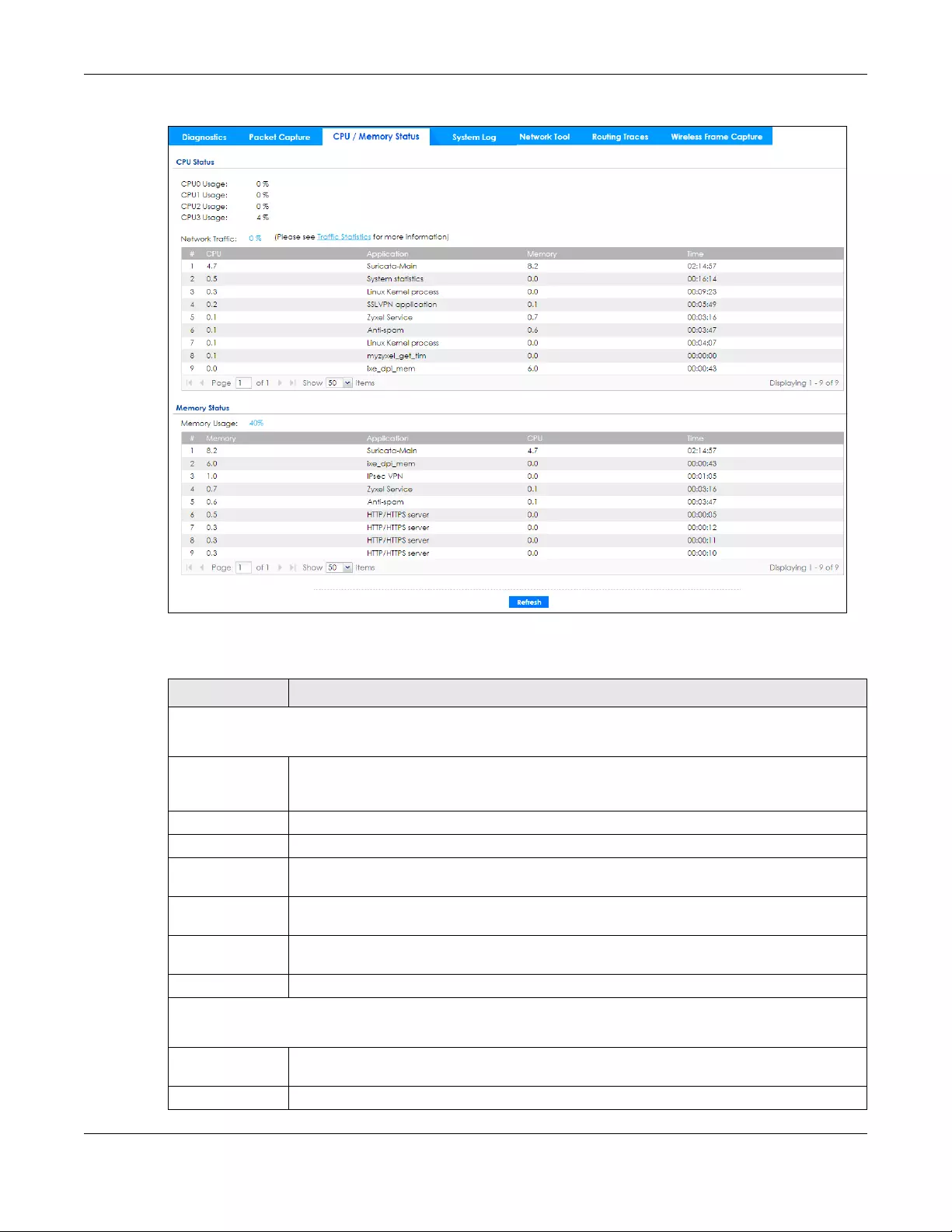
Chapter 45 Diagnostics
ZyWALL USG FLEX Series User’s Guide
945
Figure 645 Maintenance > Diagnostics > CPU / Memory Status
The following table describes the labels in this screen.
Table 417 Maintenance > Diagnostics > CPU / Memory Status
LABEL DESCRIPTION
CPU Status
This table displays the applications that use the most Zyxel Device CPU processing.
CPUn Usage CPU usage shows how much processing power the Zyxel Device is using. This field displays the
current percentage usage of a CPU (where n is the number of the CPU) as a percentage of
total processing power.
Network Traffic This field displays the current percentage of network traffic through the Zyxel Device.
#This field is a sequential value, and it is not associated with any entry.
CPU This field displays the current CPU utilization percentage for each application used on the Zyxel
Device.
Application This field displays the name of the application consuming the related processing power on the
Zyxel Device.
Memory This field displays the current DRAM memory utilization percentage for each application used
on the Zyxel Device.
Time This field displays each application’s running time in hours - minutes - seconds.
Memory Status
This table displays the applications that use the most Zyxel Device DRAM memory.
Memory Usage Memory usage shows how much DRAM memory the Zyxel Device is using. This field displays the
current percentage of memory utilization.
#This field is a sequential value, and it is not associated with any entry.
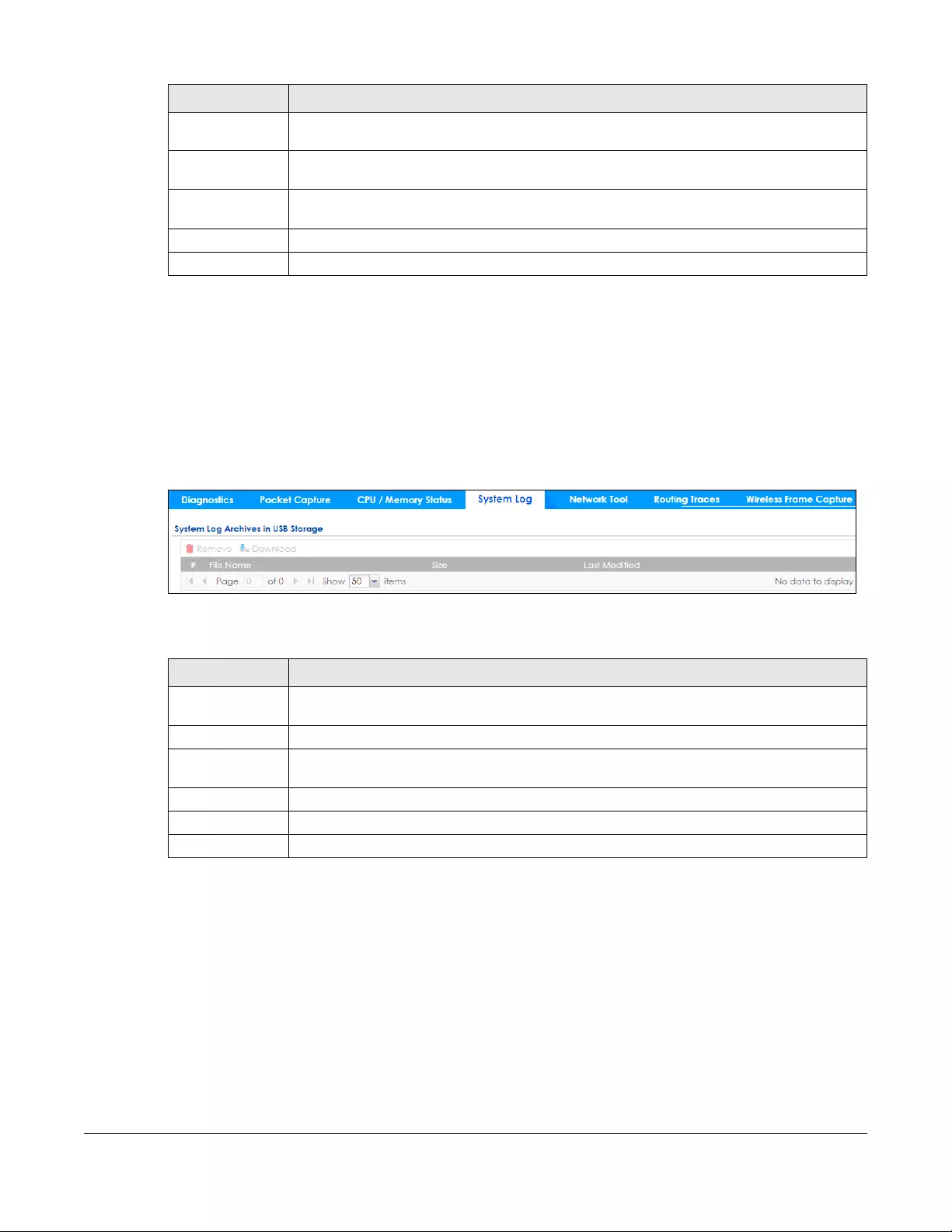
ZyWALL USG FLEX Series User’s Guide
946
45.5 The System Log Screen
Click Maintenance > Diagnosti cs > System Log to open the System Log screen. This screen lists the files of
Zyxel Device system logs stored on a connected USB storage device. The files are in comma separated
value (csv) format. You can download them to your computer and open them in a tool like Microsoft’s
Excel.
Figure 646 Maintenance > Diagnostics > System Log
The following table describes the labels in this screen.
45.6 The Network Tool Screen
Use this screen to perform various network tests.
Click Maintenance > Diagnostics > Network Tool to display this screen.
Memory This field displays the current DRAM memory utilization percentage for each application used
on the Zyxel Device.
Application This field displays the name of the application consuming the related memory on the Zyxel
Device.
CPU This field displays the current CPU utilization percentage for each application used on the Zyxel
Device.
Time This field displays each application’s running time.
Refresh Click this to update the information in this screen.
Table 417 Maintenance > Diagnostics > CPU / Memory Status
LABEL DESCRIPTION
Table 418 Maintenance > Diagnostics > System Log
LABEL DESCRIPTION
Remove Select files and click Remove to delete them from the Zyxel Device. Use the [Shift] and/or [Ctrl]
key to select multiple files. A pop-up window asks you to confirm that you want to delete.
Download Click a file to select it and click Download to save it to your computer.
#This column displays the number for each file entry. The total number of files that you can save
depends on the file sizes and the available storage space.
File Name This column displays the label that identifies the file.
Size This column displays the size (in bytes) of a file.
Last Modified This column displays the date and time that the individual files were saved.
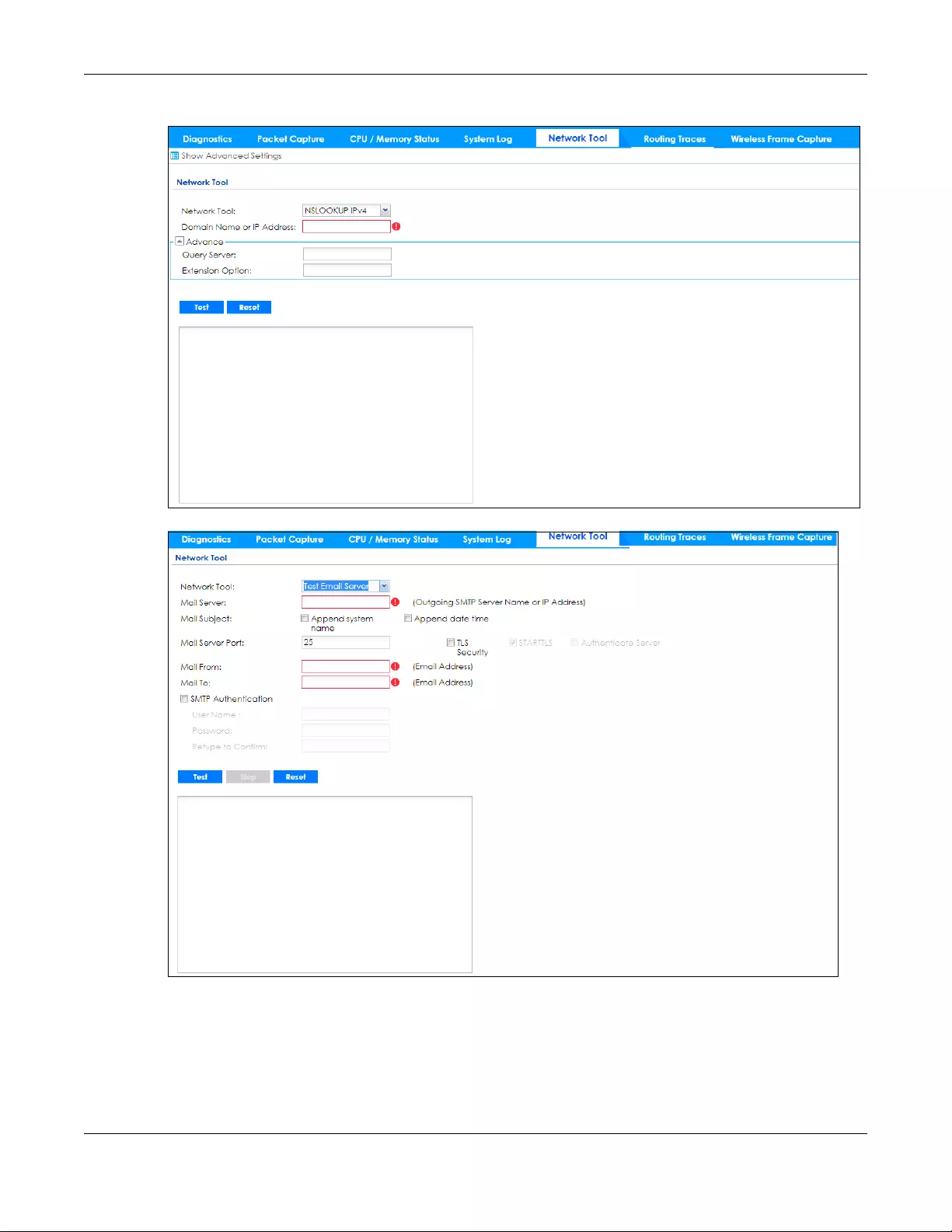
Chapter 45 Diagnostics
ZyWALL USG FLEX Series User’s Guide
947
Figure 647 Maintenance > Diagnostics > Network Tool
Figure 648 Maintenance > Diagnostics > Network Tool - Test Email Server

Chapter 45 Diagnostics
ZyWALL USG FLEX Series User’s Guide
948
The following table describes the labels in this screen.
Table 419 Maintenance > Diagnostics > Network Tool
LABEL DESCRIPTION
Network Tool Select a network tool:
•Select NSLOOKUP IPv4 or NSLOOKUP IPv6 to perform name server lookup for querying
the Domain Name System (DNS) to get the domain name or IP address mapping.
•Select PING IPv4 or PING IPv6 to ping the IP address that you entered.
•Select TRACEROUTE IPv4 or TRACEROUTE IPv6 to run the traceroute function. This
determines the path a packet takes to the specified computer.
•Select Test Email Server to test access to an SMTP email server.
Domain Name or IP
Address
Type the IP address that you want to use to for the selected network tool.
Advance
Click this to display the following fields.
Query Server Enter the IP address of a server to which the Zyxel Device sends queries for NSLOOKUP.
Interface Select the interface through which the Zyxel Device sends queries for PING or
TRACEROUTE.
Extension Option Enter the extended option if you want to use an extended ping or traceroute
command. For example, enter “-c count” (where count is the number of ping
requests) to set how many times the Zyxel Device pings the destination IP address, or
enter “-w waittime” (where waittime is a time period in seconds) to set how long the
Zyxel Device waits for a response to a probe before running another traceroute.
The following fields display when you select Test Email Server in Network Tool.
Mail Server Type the name or IP address of the outgoing SMTP server.
Mail Subject Type the subject line for the outgoing email.
•Select Append system name to add the Zyxel Device system name to the subject.
•Select Append date time to add the Zyxel Device date and time to the subject.
Mail Server Port Enter the same port number here as is on the mail server for mail traffic.
TLS Security Select this option if the mail server uses Transport Layer Security (TLS) for encrypted
communications between the mail server and the Zyxel Device.
STARTTLS Select this option if the mail server uses SSL or TLS for encrypted communications
between the mail server and the Zyxel Device.
Authenticate Server Select this if the Zyxel Device authenticates the mail server in the TLS handshake.
Mail From Type the email address from which the outgoing email is delivered. This address is used in
replies.
Mail To Type the email address to which the outgoing email is delivered.
SMTP Authentication Select this check box if it is necessary to provide a user name and password to the SMTP
server.
User Name This box is effective when you select the SMTP Authentication check box. Type the user
name to provide to the SMTP server when the log is emailed.
Password This box is effective when you select the SMTP Authentication check box. Type a
password of up to 63 characters to provide to the SMTP server when the log is emailed.
Retype to Confirm Retype your new password for confirmation.
Test Click this button to start the test.
Stop Click this button to stop the test.
Reset Click this button to return the screen to its last-saved settings.

Chapter 45 Diagnostics
ZyWALL USG FLEX Series User’s Guide
949
45.7 The Routing Traces Screen
Click Maintenance > Diagnostics > Routing Traces to display this screen. Use this screen to configure a
traceroute to identify where packets are dropped for troubleshooting.
Figure 649 Maintenance > Diagnostics > Routing Traces
The following table describes the labels in this screen.
Table 420 Maintenance > Diagnostics > Routing Traces
LABEL DESCRIPTION
IP Address You can trace traffic through the Zyxel Device from a specific source-to-destination
stream or just from/to a specific host (source or destination).
Source Enter the source IP address of traffic that you want to trace.
Port Enter the source port number of traffic that you want to trace.
Destination Enter the destination IP address of traffic that you want to trace.
Port Enter the destination port number of traffic that you want to trace.
Host Enter the IP address of a specific source or destination host whose traffic you want to
trace.
Port Enter the port number for particular source traffic on the host that you want to trace.
Protocol Select the protocol of traffic that you want to trace. any means any protocol.
Interval Enter a time interval in seconds for renewing a route trace. The default time interval is 5
seconds.
Capture Click this button to have the Zyxel Device capture frames according to the settings
configured in this screen.
You can configure the Zyxel Device while a frame capture is in progress although you
cannot modify the frame capture settings.
Flush Data Click this to clear all data on the screen.
Session This field displays established sessions that passed through the Zyxel Device which
matched the capture criteria.
ID This field displays the packet ID for each active session.
Protocol This field displays the protocol used in each active session.
from VPN ID This field displays the tagged VLAN ID in ingress packets coming into the Zyxel Device.
to VPN ID This field displays the tagged VLAN ID in egress packets going out from the Zyxel Device.
Incoming Interface This is the source interface of packets to which this active session applies.
Message This field displays traceroute information.

Chapter 45 Diagnostics
ZyWALL USG FLEX Series User’s Guide
950
45.8 The Wireless Frame Capture Screen
Use this screen to capture wireless network traffic going through the AP interfaces connected to your
Zyxel Device. Studying these frame captures may help you identify network problems.
Click Maintenance > Diagnostics > Wireless Frame Capture to display this screen.
Note: New capture files overwrite existing files of the same name. Change the File Prefix
field’s setting to avoid this.
Figure 650 Maintenance > Diagnostics > Wireless Frame Capture > Capture
The following table describes the labels in this screen.
Table 421 Maintenance > Diagnostics > Wireless Frame Capture > Capture
LABEL DESCRIPTION
MON Mode APs
Configure AP to
MON Mode Click this to go the Configuration > Wireless > AP Management screen, where you can
set one or more APs to monitor mode.
Available MON
Mode APs This column displays which APs on your wireless network are currently configured for
monitor mode.
Use the arrow buttons to move APs off this list and onto the Captured MON Mode APs
list.
Capture MON Mode
APs This column displays the monitor-mode configured APs selected to for wireless frame
capture.
Misc Setting
File Size Specify a maximum size limit in kilobytes for the total combined size of all the capture
files on the Zyxel Device, including any existing capture files and any new capture files
you generate.
Note: If you have existing capture files you may need to set this size larger or
delete existing capture files.
The valid range is 1 to 50000. The Zyxel Device stops the capture and generates the
capture file when either the file reaches this size.

Chapter 45 Diagnostics
ZyWALL USG FLEX Series User’s Guide
951
45.8.1 The Wireless Frame Capture Files Screen
Click Maintenance > Diagnostics > Wireless Frame Capture > Files to open this screen. This screen lists the
files of wireless frame captures the Zyxel Device has performed. You can download the files to your
computer where you can study them using a packet analyzer (also known as a network or protocol
analyzer) such as Wireshark.
Figure 651 Maintenance > Diagnostics > Wireless Frame Capture > Files
The following table describes the labels in this screen.
File Prefix Specify text to add to the front of the file name in order to help you identify frame
capture files.
You can modify the prefix to also create new frame capture files each time you perform
a frame capture operation. Doing this does no overwrite existing frame capture files.
The file format is: [file prefix].cap. For example, “monitor.cap”.
Capture Click this button to have the Zyxel Device capture frames according to the settings
configured in this screen.
You can configure the Zyxel Device while a frame capture is in progress although you
cannot modify the frame capture settings.
The Zyxel Device’s throughput or performance may be affected while a frame capture
is in progress.
After the Zyxel Device finishes the capture it saves a combined capture file for all APs.
The total number of frame capture files that you can save depends on the file sizes and
the available flash storage space. Once the flash storage space is full, adding more
frame captures will fail.
Stop Click this button to stop a currently running frame capture and generate a combined
capture file for all APs.
Reset Click this button to return the screen to its last-saved settings.
Table 421 Maintenance > Diagnostics > Wireless Frame Capture > Capture (continued)
LABEL DESCRIPTION
Table 422 Maintenance > Diagnostics > Wireless Frame Capture > Files
LABEL DESCRIPTION
Remove Select files and click Remove to delete them from the Zyxel Device. Use the [Shift] and/or [Ctrl] key
to select multiple files. A pop-up window asks you to confirm that you want to delete.
Download Click a file to select it and click Download to save it to your computer.
#This column displays the number for each packet capture file entry. The total number of packet
capture files that you can save depends on the file sizes and the available flash storage space.
File Name This column displays the label that identifies the file. The file name format is interface name-file
suffix.cap.
Size This column displays the size (in bytes) of a configuration file.
Last Modified This column displays the date and time that the individual files were saved.

Chapter 46 Packet Flow Explore
ZyWALL USG FLEX Series User’s Guide
952
CHAPTER 46
Packet Flow Explore
46.1 Overview
Use this to get a clear picture on how the Zyxel Device determines where to forward a packet and how
to change the source IP address of the packet according to your current settings. This function provides
you a summary of all your routing and SNAT settings and helps troubleshoot any related problems.
46.1.1 What You Can Do in this Chapter
• Use the Routing Status screen (see Section 46.2 on page 952) to view the overall routing flow and
each routing function’s settings.
• Use the SNAT Status screen (see Section 46.3 on page 956) to view the overall source IP address
conversion (SNAT) flow and each SNAT function’s settings.
46.2 Routing Status
The Routing Status screen allows you to view the current routing flow and quickly link to specific routing
settings. Click a function box in the Routing Flow section, the related routes (activated) will display in the
Routing Table section. To access this screen, click Maintenance > Packet Flow Explore > Routing Status.
The order of the routing flow may vary depending on whether you:
•Select use policy route to override direct route in the CONFIGURATION > Network > Routing > Policy
Route screen.
• Use policy routes to control 1-1 NAT by using the policy control-virtual-server-rules
activate command.
•Select use policy routes to control dynamic IPSec rules in the CONFIGURATION > VPN > IPSec VPN >
VPN Connection screen.
Note: Once a packet matches the criteria of a routing rule, the Zyxel Device takes the
corresponding action and does not perform any further flow checking.

Chapter 46 Packet Flow Explore
ZyWALL USG FLEX Series User’s Guide
953
Figure 652 Maintenance > Packet Flow Explore > Routing Status (Direct Route)
Figure 653 Maintenance > Packet Flow Explore > Routing Status (Dynamic VPN)
Figure 654 Maintenance > Packet Flow Explore > Routing Status (Policy Route)
Figure 655 Maintenance > Packet Flow Explore > Routing Status (1-1 SNAT)

Chapter 46 Packet Flow Explore
ZyWALL USG FLEX Series User’s Guide
954
Figure 656 Maintenance > Packet Flow Explore > Routing Status (SiteToSite VPN)
Figure 657 Maintenance > Packet Flow Explore > Routing Status (Static-Dynamic Route)
Figure 658 Maintenance > Packet Flow Explore > Routing Status (Default WAN Trunk)
Figure 659 Maintenance > Packet Flow Explore > Routing Status (Main Route)

Chapter 46 Packet Flow Explore
ZyWALL USG FLEX Series User’s Guide
955
The following table describes the labels in this screen.
Table 423 Maintenance > Packet Flow Explore > Routing Status
LABEL DESCRIPTION
Routing Flow This section shows you the flow of how the Zyxel Device determines where to route a packet.
Click a function box to display the related settings in the Routing Table section.
Routing Table This section shows the corresponding settings according to the function box you click in the
Routing Flow section.
The following fields are available if you click Di rect Route, Static-Dynamic Route, or Main Route in the Routing Flow
section.
#This field is a sequential value, and it is not associated with any entry.
Destination This is the destination IP address of a route.
Gateway This is the IP address of the next-hop gateway or the interface through which the traffic is
routed.
Interface This is the name of an interface associated with the route.
Metric This is the route’s priority among the displayed routes.
Flags This indicates additional information for the route. The possible flags are:
•A - this route is currently activated.
•S - this is a static route.
•C - this is a direct connected route.
•O - this is a dynamic route learned through OSPF.
•R - this is a dynamic route learned through RIP.
•B - this is a dynamic route learned through BGP.
•G - the route is to a gateway (router) in the same network.
•! - this is a route which forces a route lookup to fail.
•B - this is a route which discards packets.
•L - this is a recursive route.
Persist This is the remaining time of a dynamically learned route. The Zyxel Device removes the route
after this time period is counted down to zero.
The following fields are available if you click Policy Route in the Routing Flow section.
#This field is a sequential value, and it is not associated with any entry.
Incoming This is the interface on which the packets are received.
Source This is the source IP address(es) from which the packets are sent.
Destination This is the destination IP address(es) to which the packets are transmitted.
Service This is the name of the service object. any means all services.
Source Port This is the source port(s) from which the packets are sent.
DSCP Code This is the DSCP value of incoming packets to which this policy route applies. See Section 10.2
on page 327 for more information.
Next Hop Type This is the type of the next hop to which packets are directed.
Next Hop Info • This is the main route if the next hop type is Auto.
• This is the interface name and gateway IP address if the next hop type is Interface /GW.
• This is the tunnel name if the next hop type is VPN Tunnel.
• This is the trunk name if the next hop type is Trunk.
The following fields are available if you click 1-1 SNAT in the Routing Flow section.
#This field is a sequential value, and it is not associated with any entry.
NAT Rule This is the name of an activated 1:1 or Many 1:1 NAT rule in the NAT table.
Source This is the external source IP address(es).
Protocol This is the transport layer protocol.
Source Port This is the source port number.

Chapter 46 Packet Flow Explore
ZyWALL USG FLEX Series User’s Guide
956
46.3 The SNAT Status Screen
The SNAT Status screen allows you to view and quickly link to specific source NAT (SNAT) settings. Click a
function box in the SNAT Flow section, the related SNAT rules (activated) will display in the SNAT Table
section. To access this screen, click Maintenance > Packet Flow Explore > SNAT Status.
The order of the SNAT flow may vary depending on whether you:
•select use default SNAT in the CONFIGURATION > Network > Interface > Trunk screen.
• use policy routes to control 1-1 NAT by using the policy control-virtual-server-rules
activate command.
Note: Once a packet matches the criteria of an SNAT rule, the Zyxel Device takes the
corresponding action and does not perform any further flow checking.
Figure 660 Maintenance > Packet Flow Explore > SNAT Status (Policy Route SNAT)
Destination This is the external destination IP address(es).
Outgoing This is the outgoing interface that the SNAT rule uses to transmit packets.
Gateway This is the IP address of the gateway in the same network of the outgoing interface.
The following fields are available if you click Dynamic VPN or SiteToSite VPN in the Routing Flow section.
#This field is a sequential value, and it is not associated with any entry.
Source This is the IP address(es) of the local VPN network.
Destination This is the IP address(es) for the remote VPN network.
VPN Tunnel This is the name of the VPN tunnel.
The following fields are available if you click Default WAN Trun k in the Routing Flow section.
#This field is a sequential value, and it is not associated with any entry.
Source This is the source IP address(es) from which the packets are sent. any means any IP address.
Destination This is the destination IP address(es) to which the packets are transmitted. any means any IP
address.
Trunk This is the name of the WAN trunk through which the matched packets are transmitted.
Table 423 Maintenance > Packet Flow Explore > Routing Status (continued)
LABEL DESCRIPTION
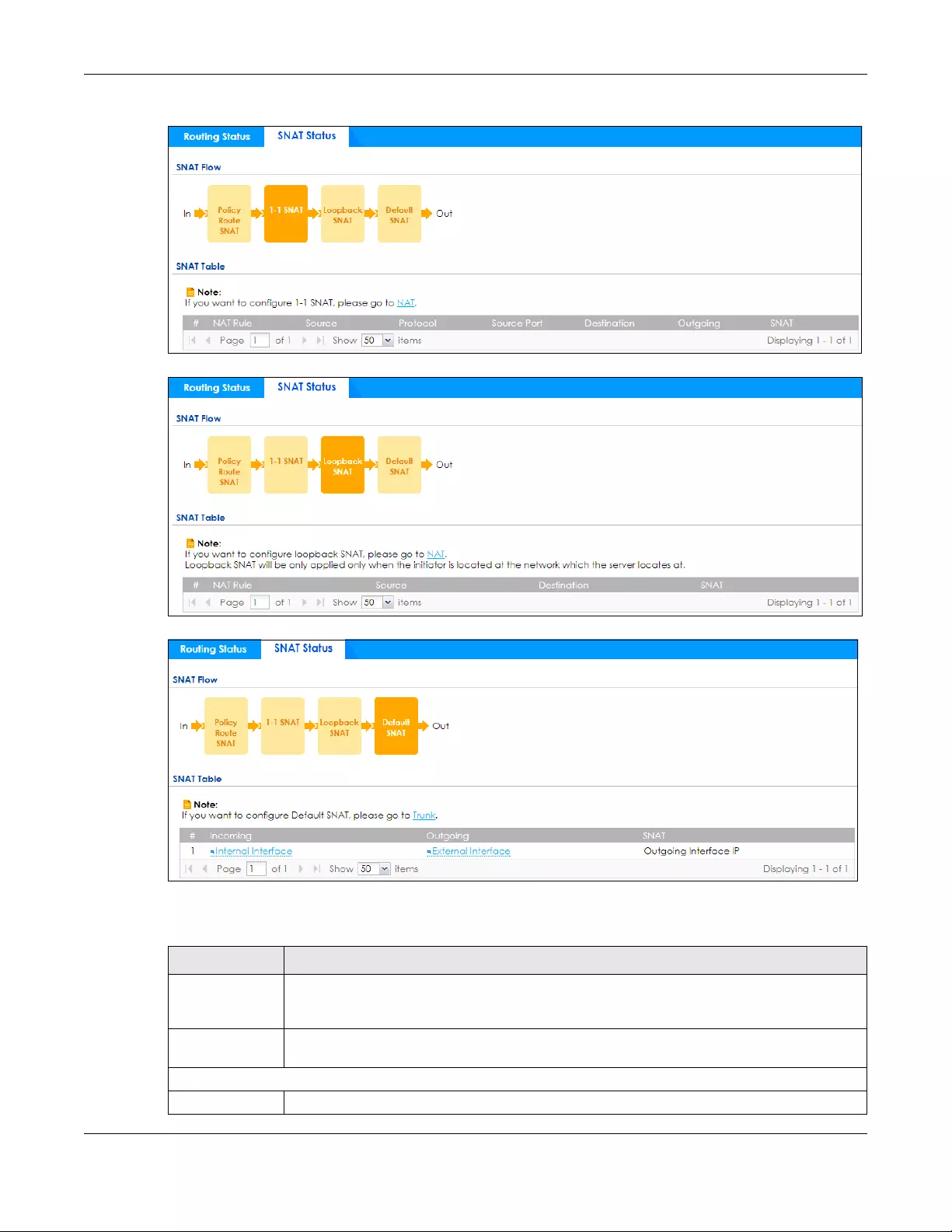
Chapter 46 Packet Flow Explore
ZyWALL USG FLEX Series User’s Guide
957
Figure 661 Maintenance > Packet Flow Explore > SNAT Status (1-1 SNAT)
Figure 662 Maintenance > Packet Flow Explore > SNAT Status (Loopback SNAT)
Figure 663 Maintenance > Packet Flow Explore > SNAT Status (Default SNAT)
The following table describes the labels in this screen.
Table 424 Maintenance > Packet Flow Explore > SNAT Status
LABEL DESCRIPTION
SNAT Flow This section shows you the flow of how the Zyxel Device changes the source IP address for a
packet according to the rules you have configured in the Zyxel Device. Click a function box to
display the related settings in the SNAT Table section.
SNAT Table The table fields in this section vary depending on the function box you select in the SNAT Flow
section.
The following fields are available if you click Policy Route SNAT in the SNAT Flow section.
#This field is a sequential value, and it is not associated with any entry.

Chapter 46 Packet Flow Explore
ZyWALL USG FLEX Series User’s Guide
958
Outgoing This is the outgoing interface that the route uses to transmit packets.
SNAT This is the source IP address(es) that the SNAT rule uses finally.
The following fields are available if you click 1-1 SNAT in the SNAT Flo w section.
#This field is a sequential value, and it is not associated with any entry.
NAT Rule This is the name of an activated NAT rule which uses SNAT.
Source This is the external source IP address(es).
Protocol This is the transport layer protocol.
Source Port This is the source port number.
Destination This is the external destination IP address(es).
Outgoing This is the outgoing interface that the SNAT rule uses to transmit packets.
SNAT This is the source IP address(es) that the SNAT rule uses finally.
The following fields are available if you click Loopback SNAT in the SNAT Flow section.
#This field is a sequential value, and it is not associated with any entry.
NAT Rule This is the name of an activated NAT rule which uses SNAT and enables NAT loopback.
Source This is the original source IP address(es). any means any IP address.
Destination This is the original destination IP address(es). any means any IP address.
SNAT This indicates which source IP address the SNAT rule uses finally. For example, Outgoing
Interface IP means that the Zyxel Device uses the IP address of the outgoing interface as the
source IP address for the matched packets it sends out through this rule.
The following fields are available if you click Default SNAT in the SNAT Flow section.
#This field is a sequential value, and it is not associated with any entry.
Incoming This indicates internal interface(s) on which the packets are received.
Outgoing This indicates external interface(s) from which the packets are transmitted.
SNAT This indicates which source IP address the SNAT rule uses finally. For example, Outgoing
Interface IP means that the Zyxel Device uses the IP address of the outgoing interface as the
source IP address for the matched packets it sends out through this rule.
Table 424 Maintenance > Packet Flow Explore > SNAT Status (continued)
LABEL DESCRIPTION
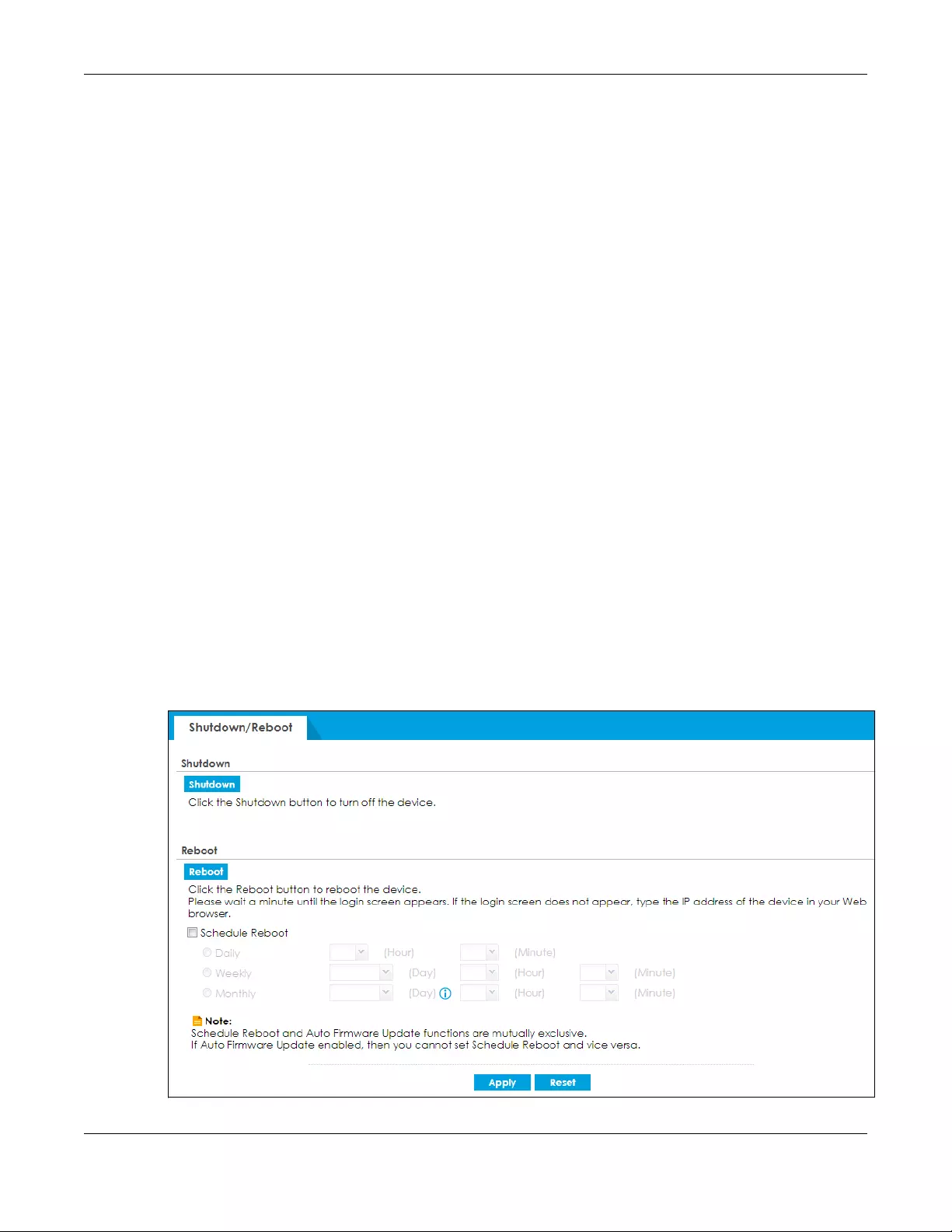
Chapter 47 Shutdown
ZyWALL USG FLEX Series User’s Guide
959
Chapter 47
Shutdown
47.1 Overview
Use this to shutdown the device in preparation for disconnecting the power.
Always use the Maintenance > Shutdown > Shutdown screen or the
“shutdown” command before you turn off the Zyxel Device or remove
the power. Not doing so can cause the firmware to become corrupt.
47.1.1 What You Need To Know
Shutdown writes all cached data to the local storage and stops the system processes.
47.2 The Shutdown / Reboot Screen
To access this screen, click Maintenance > Shutdown/Reboot.
Figure 664 Maintenance > Shutdown/ Reboot

Chapter 47 Shutdown
ZyWALL USG FLEX Series User’s Guide
960
The following table describes the labels in this screen.
You can also use the CLI command shutdown to close down the Zyxel Device.
Table 425 Maintenance > Shutdown / Reboot
LABEL DESCRIPTION
Shutdown Click the Shutdown button to shut down the Zyxel Device. Wait for the device to shut down
before you manually turn off or remove the power. It does not turn off the power.
Reboot Click Reboot to reboot the Zyxel Device immediately without turning the power off.
Schedule
Reboot
Select this check box to schedule a periodic reboot of the Zyxel Device.
You should select a time when your network is not busy for minimal interruption.
Note: You cannot enable Auto Update in File Manager > Firmware Management and
Schedule Reboot in Maintenance > Shutdown-Reboot at the same time.
Daily Set the Zyxel Device to reboot every day at the specified time. The time format is the 24 hour
clock, so ‘0’ means midnight for example.
Weekly Set the Zyxel Device to reboot once a week on the day and at the time specified.
Monthly Set the Zyxel Device to reboot once a month on the specified day, at the a specified hour and
minute.
If the date you select is greater than the number of days in a month, the Zyxel Device
automatically reboots on the last day of the month. For example, if you select 31 and the
month is February, the Zyxel Device reboots on day 28 or 29.
Apply Click Apply to save your changes back to the Zyxel Device.
Reset Click Reset to return the screen to its last-saved settings.

Chapter 47 Shutdown
ZyWALL USG FLEX Series User’s Guide
961

962
PART III
Appendices and
Troubleshooting

ZyWALL USG FLEX Series User’s Guide
963
CHAPTER 48
Troubleshooting
This chapter offers some suggestions to solve problems you might encounter.
• You can also refer to the logs (see Section 6.38 on page 190).
• For the order in which the Zyxel Device applies its features and checks, see Chapter 46 on page 952.
None of the LEDs turn on.
Make sure that you have the power cord connected to the Zyxel Device and plugged in to an
appropriate power source. Make sure you have the Zyxel Device turned on. Check all cable
connections.
If the LEDs still do not turn on, you may have a hardware problem. In this case, you should contact your
local vendor.
Cannot access the Zyxel Device from the LAN.
• Check the cable connection between the Zyxel Device and your computer or switch.
• Ping the Zyxel Device from a LAN computer. Make sure your computer’s Ethernet card is installed and
functioning properly. Also make sure that its IP address is in the same subnet as the Zyxel Device’s.
• In the computer, click Start, (All) Programs, Accessories and then Command Prompt. In the
Command Prompt window, type “ping” followed by the Zyxel Device’s LAN IP address (192.168.1.1 is
the default) and then press [ENTER]. The Zyxel Device should reply.
• If you’ve forgotten the Zyxel Device’s password, use the RESET button. Press the button in for about 5
seconds (or until the SYS LED starts to blink), then release it. It returns the Zyxel Device to the factory
defaults (password is 1234, LAN IP address 192.168.1.1, etc).
• If you’ve forgotten the Zyxel Device’s IP address, you can use the commands through the CONSOLE
port to check it. Connect your computer to the CONSOLE port using a console cable. Your computer
should have a terminal emulation communications program (such as HyperTerminal) set to VT100
terminal emulation, no parity, 8 data bits, 1 stop bit, no flow control and 115200 bps port speed.
I cannot access the Internet.
• Check the Zyxel Device’s connection to the Ethernet jack with Internet access. Make sure the Internet
gateway device (such as a DSL modem) is working properly.
• Check the WAN interface's status in the Dashboard. Use the installation setup wizard again and make
sure that you enter the correct settings. Use the same case as provided by your ISP.

Chapter 48 Troubleshooting
ZyWALL USG FLEX Series User’s Guide
964
I cannot update the anti-malware/IDP/application patrol/URL Threat filter/IP reputation
signatures.
• Make sure your Zyxel Device has the anti-malware/IDP/application patrol service registered and that
the license is not expired. Purchase a new license if the license is expired.
• Make sure your Zyxel Device is connected to the Internet.
I cannot update the threat intelligence machine learning (TIML) signatures.
• Make sure your Zyxel Device has the anti-malware service registered and that the gold security pack
license is not expired. Purchase a new license if the license is expired.
• Make sure your Zyxel Device is connected to the Internet.
I downloaded updated anti-malware/IDP/application patrol/URL Threat filter/IP reputation
signatures. Why has the Zyxel Device not re-booted yet?
The Zyxel Device does not have to reboot when you upload new signatures.
The content filter category service is not working.
• Make sure your Zyxel Device has the content filter category service registered and that the license is
not expired. Purchase a new license if the license is expired.
• Make sure your Zyxel Device is connected to the Internet.
• Make sure you select Enable Content Filter Category Service when you add a filter profile in the
Configuration > Security Service > Content Filter > Profile > Add or Edit screen.
I configured security settings but the Zyxel Device is not applying them for certain interfaces.
Many security settings are usually applied to zones. Make sure you assign the interfaces to the
appropriate zones. When you create an interface, there is no security applied on it until you assign it to
a zone.
The Zyxel Device is not applying the custom policy route I configured.
The Zyxel Device checks the policy routes in the order that they are listed. So make sure that your
custom policy route comes before any other routes that the traffic would also match.

Chapter 48 Troubleshooting
ZyWALL USG FLEX Series User’s Guide
965
The Zyxel Device is not applying the custom security policy I configured.
The Zyxel Device checks the security policies in the order that they are listed. So make sure that your
custom security policy comes before any other rules that the traffic would also match.
I cannot enter the interface name I want.
The format of interface names other than the Ethernet interface names is very strict. Each name consists
of 2-4 letters (interface type), followed by a number (x, limited by the maximum number of each type of
interface). For example, VLAN interfaces are vlan0, vlan1, vlan2,...; and so on.
• The names of virtual interfaces are derived from the interfaces on which they are created. For
example, virtual interfaces created on Ethernet interface wan1 are called wan1:1, wan1:2, and so
on. Virtual interfaces created on VLAN interface vlan2 are called vlan2:1, vlan2:2, and so on. You
cannot specify the number after the colon(:) in the Web Configurator; it is a sequential number. You
can specify the number after the colon if you use the CLI to set up a virtual interface.
I cannot set up a PPP interface, virtual Ethernet interface or virtual VLAN interface on an Ethernet
interface.
You cannot set up a PPP interface, virtual Ethernet interface or virtual VLAN interface if the underlying
interface is a member of a bridge. You also cannot add an Ethernet interface or VLAN interface to a
bridge if the member interface has a virtual interface or PPP interface on top of it.
My rules and settings that apply to a particular interface no longer work.
The interface’s IP address may have changed. To avoid this, create an IP address object based on the
interface. This way the Zyxel Device automatically updates every rule or setting that uses the object
whenever the interface’s IP address settings change. For example, if you change LAN1’s IP address, the
Zyxel Device automatically updates the corresponding interface-based, LAN1 subnet address object.
I cannot set up a PPP interface.
You have to set up an ISP account before you create a PPPoE or PPTP interface.
The data rates through my cellular connection are no-where near the rates I expected.

Chapter 48 Troubleshooting
ZyWALL USG FLEX Series User’s Guide
966
The actual cellular data rate you obtain varies depending on the cellular device you use, the signal
strength to the service provider’s base station, and so on.
I created a cellular interface but cannot connect through it.
• Make sure you have a compatible mobile broadband device installed or connected. See
www.zyxel.com for details.
• Make sure you have the cellular interface enabled.
• Make sure the cellular interface has the correct user name, password, and PIN code configured with
the correct casing.
• If the Zyxel Device has multiple WAN interfaces, make sure their IP addresses are on different subnets.
Hackers have accessed my WEP-encrypted wireless LAN.
WEP is extremely insecure. Its encryption can be broken by an attacker, using widely-available software.
It is strongly recommended that you use a more effective security mechanism. Use the strongest security
mechanism that all the wireless devices in your network support. WPA2 or WPA2-PSK is recommended.
The wireless security is not following the re-authentication timer setting I specified.
If a RADIUS server authenticates wireless stations, the re-authentication timer on the RADIUS server has
priority. Change the RADIUS server’s configuration if you need to use a different re-authentication timer
setting.
I cannot configure a particular VLAN interface on top of an Ethernet interface even though I
have it configured it on top of another Ethernet interface.
Each VLAN interface is created on top of only one Ethernet interface.
The Zyxel Device is not applying an interface’s configured ingress bandwidth limit.
At the time of writing, the Zyxel Device does not support ingress bandwidth management.
The Zyxel Device is not applying my application patrol bandwidth management settings.
Bandwidth management in policy routes has priority over application patrol bandwidth management.

Chapter 48 Troubleshooting
ZyWALL USG FLEX Series User’s Guide
967
The Zyxel Device’s performance slowed down after I configured many new application patrol
entries.
The Zyxel Device checks the ports and conditions configured in application patrol entries in the order
they appear in the list. While this sequence does not affect the functionality, you might improve the
performance of the Zyxel Device by putting more commonly used ports at the top of the list.
The Zyxel Device’s anti-malware scanner cleaned an infected file but now I cannot use the file.
The scanning engine checks the contents of the packets for malware. If a malware pattern is matched,
the Zyxel Device removes a portion of the file, while the rest goes through. Since the Zyxel Device erases
a portion of the file before sending it, you may not be able to open the file.
The Zyxel Device sent an alert that a malware-infected file has been found, but the file was still
forwarded to the user and could still be executed.
Make sure you enable Destroy Infected File in the Configuration > Security Service > Anti-Malware
screen to modify infected files before forwarding the files to the user, preventing them from being
executed.
I added a file pattern in the anti-malware white list, but the Zyxel Device still checks and modifies
files that match this pattern.
Make sure you select the Check White List check box above the white list table. If it is already selected,
make sure that the white list entry corresponding to this file pattern is activated.
The Zyxel Device is not scanning some zipped files.
The Zyxel Device cannot unzip password protected ZIP files or a ZIP file within another ZIP file. There are
also limits to the number of ZIP files that the Zyxel Device can concurrently unzip.
The Zyxel Device is deleting some zipped files.
The anti-malware policy may be set to delete zipped files that the Zyxel Device cannot unzip. The Zyxel
Device cannot unzip password protected ZIP files or a ZIP file within another ZIP file. There are also limits
to the number of ZIP files that the Zyxel Device can concurrently unzip.

Chapter 48 Troubleshooting
ZyWALL USG FLEX Series User’s Guide
968
The threat intelligence machine learning (TIML) feature is not working.
1Make sure you purchase the gold security pack.
• Make sure you’ve registered the Zyxel Device and activated the anti-malware service on
portal.myZyxel.com.
• Go to the screen, and select the Enable check box in the Configuration > Security Service > Anti-
Malware to activate the TIML feature.
2Make sure the gold security pack is not expired. If it is, renew the license.
The Zyxel Device won’t scan the TIML signatures that were downloaded when the gold security pack
expired.
The Zyxel Device’s performance seems slower after configuring IDP.
Depending on your network topology and traffic load, binding every packet direction to an IDP profile
may affect the Zyxel Device’s performance. You may want to focus IDP scanning on certain traffic
directions such as incoming traffic.
IDP is dropping traffic that matches a rule that says no action should be taken.
The Zyxel Device checks all signatures and continues searching even after a match is found. If two or
more rules have conflicting actions for the same packet, then the Zyxel Device applies the more
restrictive action (reject-both, reject-receiver or reject-sender, drop, none in this order). If a packet
matches a rule for reject-receiver and it also matches a rule for reject-sender, then the Zyxel Device will
reject-both.
I uploaded a custom signature file and now all of my earlier custom signatures are gone.
The name of the complete custom signature file on the Zyxel Device is ‘custom.rules’. If you import a file
named ‘custom.rules’, then all custom signatures on the Zyxel Device are overwritten with the new file. If
this is not your intention, make sure that the files you import are not named ‘custom.rules’.
I cannot configure some items in IDP that I can configure in Snort.
Not all Snort functionality is supported in the Zyxel Device.

Chapter 48 Troubleshooting
ZyWALL USG FLEX Series User’s Guide
969
The Zyxel Device’s performance seems slower after configuring ADP.
Depending on your network topology and traffic load, applying an anomaly profile to each and every
packet direction may affect the Zyxel Device’s performance.
The Zyxel Device destroyed/dropped a file/email without notifying me.
Make sure you enable logs for your security features, such as in the following screens:
• Configuration > Security Service > IDP
• Configuration > Security Service > Anti-Malware
•Configuration > Security Service > Email Security
The Zyxel Device routes and applies SNAT for traffic from some interfaces but not from others.
The Zyxel Device automatically uses SNAT for traffic it routes from internal interfaces to external
interfaces. For example LAN to WAN traffic. You must manually configure a policy route to add routing
and SNAT settings for an interface with the Interface Type set to General. You can also configure a
policy route to override the default routing and SNAT behavior for an interface with the Interface Type
set to Internal or External.
I cannot get Dynamic DNS to work.
• You must have a public WAN IP address to use Dynamic DNS.
• Make sure you recorded your DDNS account’s user name, password, and domain name and have
entered them properly in the Zyxel Device.
• You may need to configure the DDNS entry’s IP Address setting to Auto if the interface has a dynamic
IP address or there are one or more NAT routers between the Zyxel Device and the DDNS server.
• The Zyxel Device may not determine the proper IP address if there is an HTTP proxy server between the
Zyxel Device and the DDNS server.
I cannot create a second HTTP redirect rule for an incoming interface.
You can configure up to one HTTP redirect rule for each (incoming) interface.
I cannot get the application patrol to manage SIP traffic.

Chapter 48 Troubleshooting
ZyWALL USG FLEX Series User’s Guide
970
Make sure you have the SIP ALG enabled.
I cannot get the application patrol to manage H.323 traffic.
Make sure you have the H.323 ALG enabled.
I cannot get the application patrol to manage FTP traffic.
Make sure you have the FTP ALG enabled.
The Zyxel Device keeps resetting the connection.
If an alternate gateway on the LAN has an IP address in the same subnet as the Zyxel Device’s LAN IP
address, return traffic may not go through the Zyxel Device. This is called an asymmetrical or “triangle”
route. This causes the Zyxel Device to reset the connection, as the connection has not been
acknowledged.
You can set the Zyxel Device’s security policy to permit the use of asymmetrical route topology on the
network (so it does not reset the connection) although this is not recommended since allowing
asymmetrical routes may let traffic from the WAN go directly to the LAN without passing through the
Zyxel Device. A better solution is to use virtual interfaces to put the Zyxel Device and the backup
gateway on separate subnets. See Asymmetrical Routes on page 566 and the chapter about interfaces
for more information.
I cannot set up an IPSec VPN tunnel to another device.
If the IPSec tunnel does not build properly, the problem is likely a configuration error at one of the IPSec
routers. Log into both Zyxel IPSec routers and check the settings in each field methodically and slowly.
Make sure both the Zyxel Device and remote IPSec router have the same security settings for the VPN
tunnel. It may help to display the settings for both routers side-by-side.
Here are some general suggestions. See also Chapter 19 on page 418.
• The system log can often help to identify a configuration problem.
• If you enable NAT traversal, the remote IPSec device must also have NAT traversal enabled.
• The Zyxel Device and remote IPSec router must use the same authentication method to establish the
IKE SA.
• Both routers must use the same negotiation mode.
• Both routers must use the same encryption algorithm, authentication algorithm, and DH key group.
• When using pre-shared keys, the Zyxel Device and the remote IPSec router must use the same pre-
shared key.

Chapter 48 Troubleshooting
ZyWALL USG FLEX Series User’s Guide
971
• The Zyxel Device’s local and peer ID type and content must match the remote IPSec router’s peer
and local ID type and content, respectively.
• The Zyxel Device and remote IPSec router must use the same active protocol.
• The Zyxel Device and remote IPSec router must use the same encapsulation.
• The Zyxel Device and remote IPSec router must use the same SPI.
• If the sites are/were previously connected using a leased line or ISDN router, physically disconnect
these devices from the network before testing your new VPN connection. The old route may have
been learned by RIP and would take priority over the new VPN connection.
• To test whether or not a tunnel is working, ping from a computer at one site to a computer at the
other.
Before doing so, ensure that both computers have Internet access (via the IPSec routers).
• It is also helpful to have a way to look at the packets that are being sent and received by the Zyxel
Device and remote IPSec router (for example, by using a packet sniffer).
Check the configuration for the following Zyxel Device features.
• The Zyxel Device does not put IPSec SAs in the routing table. You must create a policy route for each
VPN tunnel. See Chapter 10 on page 325.
• Make sure the To-Zyxel Device security policies allow IPSec VPN traffic to the Zyxel Device. IKE uses
UDP port 500, AH uses IP protocol 51, and ESP uses IP protocol 50.
• The Zyxel Device supports UDP port 500 and UDP port 4500 for NAT traversal. If you enable this, make
sure the To-Zyxel Device security policies allow UDP port 4500 too.
• Make sure regular security policies allow traffic between the VPN tunnel and the rest of the network.
Regular security policies check packets the Zyxel Device sends before the Zyxel Device encrypts
them and check packets the Zyxel Device receives after the Zyxel Device decrypts them. This
depends on the zone to which you assign the VPN tunnel and the zone from which and to which
traffic may be routed.
• If you set up a VPN tunnel across the Internet, make sure your ISP supports AH or ESP (whichever you
are using).
• If you have the Zyxel Device and remote IPSec router use certificates to authenticate each other, You
must set up the certificates for the Zyxel Device and remote IPSec router first and make sure they trust
each other’s certificates. If the Zyxel Device’s certificate is self-signed, import it into the remote IPSec
router. If it is signed by a CA, make sure the remote IPSec router trusts that CA. The Zyxel Device uses
one of its Trusted Certificates to authenticate the remote IPSec router’s certificate. The trusted
certificate can be the remote IPSec router’s self-signed certificate or that of a trusted CA that signed
the remote IPSec router’s certificate.
• Multiple SAs connecting through a secure gateway must have the same negotiation mode.
The VPN connection is up but VPN traffic cannot be transmitted through the VPN tunnel.
If you have the Configuration > VPN > IPSec VPN > VPN Connection screen’s Use Policy Route to control
dynamic IPSec rules option enabled, check the routing policies to see if they are sending traffic
elsewhere instead of through the VPN tunnels.
I uploaded a logo to show in the SSL VPN user screens but it does not display properly.

Chapter 48 Troubleshooting
ZyWALL USG FLEX Series User’s Guide
972
The logo graphic must be GIF, JPG, or PNG format. The graphic should use a resolution of 103 x 29 pixels
to avoid distortion when displayed. The Zyxel Device automatically resizes a graphic of a different
resolution to 103 x 29 pixels. The file size must be 100 kilobytes or less. Transparent background is
recommended.
I logged into the SSL VPN but cannot see some of the resource links.
Available resource links vary depending on the SSL application object’s configuration.
I cannot download the Zyxel Device’s firmware package.
The Zyxel Device’s firmware package cannot go through the Zyxel Device when you enable the anti-
malware Destroy compressed files that could not be decompressed option. The Zyxel Device classifies
the firmware package as not being able to be decompressed and deletes it.
You can upload the firmware package to the Zyxel Device with the option enabled, so you only need
to clear the Destroy compressed files that could not be decompressed option while you download the
firmware package. See Section 33.2 on page 625 for more on the anti-malware Destroy compressed
files that could not be decompressed option.
I changed the LAN IP address and can no longer access the Internet.
The Zyxel Device automatically updates address objects based on an interface’s IP address, subnet, or
gateway if the interface’s IP address settings change. However, you need to manually edit any address
objects for your LAN that are not based on the interface.
I configured application patrol to allow and manage access to a specific service but access is
blocked.
• If you want to use a service, make sure the security policy allows Security Service application patrol to
go through the Zyxel Device.
I configured policy routes to manage the bandwidth of TCP and UDP traffic but the bandwidth
management is not being applied properly.
It is recommended to use application patrol instead of policy routes to manage the bandwidth of TCP
and UDP traffic.

Chapter 48 Troubleshooting
ZyWALL USG FLEX Series User’s Guide
973
I cannot get the RADIUS server to authenticate the Zyxel Device‘s default admin account.
The default admin account is always authenticated locally, regardless of the authentication method
setting.
The Zyxel Device fails to authentication the ext-user user accounts I configured.
An external server such as AD, LDAP or RADIUS must authenticate the ext-user accounts. If the Zyxel
Device tries to use the local database to authenticate an ext-user, the authentication attempt will
always fail. (This is related to AAA servers and authentication methods, which are discussed in other
chapters in this guide.)
I cannot add the admin users to a user group with access users.
You cannot put access users and admin users in the same user group.
I cannot add the default admin account to a user group.
You cannot put the default admin account into any user group.
The schedule I configured is not being applied at the configured times.
Make sure the Zyxel Device’s current date and time are correct.
I cannot get a certificate to import into the Zyxel Device.
1For My Certificates, you can import a certificate that matches a corresponding certification request that
was generated by the Zyxel Device. You can also import a certificate in PKCS#12 format, including the
certificate’s public and private keys.
2You must remove any spaces from the certificate’s filename before you can import the certificate.
3Any certificate that you want to import has to be in one of these file formats:
• Binary X.509: This is an ITU-T recommendation that defines the formats for X.509 certificates.
• PEM (Base-64) encoded X.509: This Privacy Enhanced Mail format uses lowercase letters, uppercase
letters and numerals to convert a binary X.509 certificate into a printable form.

Chapter 48 Troubleshooting
ZyWALL USG FLEX Series User’s Guide
974
• Binary PKCS#7: This is a standard that defines the general syntax for data (including digital signatures)
that may be encrypted. A PKCS #7 file is used to transfer a public key certificate. The private key is not
included. The Zyxel Device currently allows the importation of a PKS#7 file that contains a single
certificate.
• PEM (Base-64) encoded PKCS#7: This Privacy Enhanced Mail (PEM) format uses lowercase letters,
uppercase letters and numerals to convert a binary PKCS#7 certificate into a printable form.
• Binary PKCS#12: This is a format for transferring public key and private key certificates.The private key
in a PKCS #12 file is within a password-encrypted envelope. The file’s password is not connected to
your certificate’s public or private passwords. Exporting a PKCS #12 file creates this and you must
provide it to decrypt the contents when you import the file into the Zyxel Device.
Note: Be careful not to convert a binary file to text during the transfer process. It is easy for this
to occur since many programs use text files by default.
I cannot access the Zyxel Device from a computer connected to the Internet.
Check the service control rules and to-Zyxel Device security policies.
I uploaded a logo to display on the upper left corner of the Web Configurator login screen and
access page but it does not display properly.
Make sure the logo file is a GIF, JPG, or PNG of 100 kilobytes or less.
I uploaded a logo to use as the screen or window background but it does not display properly.
Make sure the logo file is a GIF, JPG, or PNG of 100 kilobytes or less.
The Zyxel Device’s traffic throughput rate decreased after I started collecting traffic statistics.
Data collection may decrease the Zyxel Device’s traffic throughput rate.
I can only see newer logs. Older logs are missing.
When a log reaches the maximum number of log messages, new log messages automatically overwrite
existing log messages, starting with the oldest existing log message first.
The commands in my configuration file or shell script are not working properly.

Chapter 48 Troubleshooting
ZyWALL USG FLEX Series User’s Guide
975
• In a configuration file or shell script, use “#” or “!” as the first character of a command line to have the
Zyxel Device treat the line as a comment.
• Your configuration files or shell scripts can use “exit” or a command line consisting of a single “!” to
have the Zyxel Device exit sub command mode.
•Include write commands in your scripts. Otherwise the changes will be lost when the Zyxel Device
restarts. You could use multiple write commands in a long script.
Note: “exit” or “!'” must follow sub commands if it is to make the Zyxel Device exit sub
command mode.
See Chapter 44 on page 915 for more on configuration files and shell scripts.
I cannot get the firmware uploaded using the commands.
The Web Configurator is the recommended method for uploading firmware. You only need to use the
command line interface if you need to recover the firmware. See the CLI Reference Guide for how to
determine if you need to recover the firmware and how to recover it.
My packet capture captured less than I wanted or failed.
The packet capture screen’s File Size sets a maximum size limit for the total combined size of all the
capture files on the Zyxel Device, including any existing capture files and any new capture files you
generate. If you have existing capture files you may need to set this size larger or delete existing capture
files.
The Zyxel Device stops the capture and generates the capture file when either the capture files reach
the File Size or the time period specified in the Duration field expires.
My earlier packet capture files are missing.
New capture files overwrite existing files of the same name. Change the File Suffix field’s setting to avoid
this.
IP reputation doesn’t work on IPv6 addresses.
At the time of writing, IP reputation is only for IPv4 addresses. See Chapter 34 Reputation Filter for more
information.
The SecuReporter banner keeps showing up.

Chapter 48 Troubleshooting
ZyWALL USG FLEX Series User’s Guide
976
See SecuReporter Banner on page 838 for more information.
48.1 Resetting the Zyxel Device
If you cannot access the Zyxel Device by any method, try restarting it by turning the power off and then
on again. If you still cannot access the Zyxel Device by any method or you forget the administrator
password(s), you can reset the Zyxel Device to its factory-default settings. Any configuration files or shell
scripts that you saved on the Zyxel Device should still be available afterwards.
Use the following procedure to reset the Zyxel Device to its factory-default settings. This overwrites the
settings in the startup-config.conf file with the settings in the system-default.conf file.
Note: This procedure removes the current configuration.
1Make sure the SYS LED is on and not blinking.
2Press the RESET button and hold it until the SYS LED begins to blink. (This usually takes about five seconds.)
3Release the RESET button, and wait for the Zyxel Device to restart.
You should be able to access the Zyxel Device using the default settings.
48.2 Getting More Troubleshooting Help
Search for support information for your model at www.zyxel.com for more troubleshooting suggestions.

ZyWALL USG FLEX Series User’s Guide
977
APPENDIX A
Customer Support
In the event of problems that cannot be solved by using this manual, you should contact your vendor. If
you cannot contact your vendor, then contact a Zyxel office for the region in which you bought the
device.
See http://www.zyxel.com/homepage.shtml and also
http://www.zyxel.com/about_zyxel/zyxel_worldwide.shtml for the latest information.
Please have the following information ready when you contact an office.
Required Information
• Product model and serial number.
• Warranty Information.
• Date that you received your device.
• Brief description of the problem and the steps you took to solve it.
Corporate Headquarters (Worldwide)
Taiwan
• Zyxel Communications Corporation
• http://www.zyxel.com
Asia
China
• Zyxel Communications (Shanghai) Corp.
Zyxel Communications (Beijing) Corp.
Zyxel Communications (Tianjin) Corp.
• http://www.zyxel.cn
India
•Zyxel Technology India Pvt Ltd
• http://www.zyxel.in
Kazakhstan
•Zyxel Kazakhstan
• http://www.zyxel.kz

Appendix A Customer Support
ZyWALL USG FLEX Series User’s Guide
978
Korea
• Zyxel Korea Corp.
• http://www.zyxel.kr
Malaysia
• Zyxel Malaysia Sdn Bhd.
• http://www.zyxel.com.my
Pakistan
• Zyxel Pakistan (Pvt.) Ltd.
• http://www.zyxel.com.pk
Philippines
• Zyxel Philippines
• http://www.zyxel.com.ph
Singapore
• Zyxel Singapore Pte Ltd.
• http://www.zyxel.com.sg
Taiwan
• Zyxel Communications Corporation
• https://www.zyxel.com/tw/zh/
Thailand
• Zyxel Thailand Co., Ltd
• http://www.zyxel.co.th
Vietnam
• Zyxel Communications Corporation-Vietnam Office
• http://www.zyxel.com/vn/vi
Europe
Austria
•Zyxel Deutschland GmbH
• http://www.zyxel.de
Belarus
•Zyxel BY
• http://www.zyxel.by

Appendix A Customer Support
ZyWALL USG FLEX Series User’s Guide
979
Belgium
• Zyxel Communications B.V.
• http://www.zyxel.com/be/nl/
• http://www.zyxel.com/be/fr/
Bulgaria
•Zyxel България
• http://www.zyxel.com/bg/bg/
Czech Republic
• Zyxel Communications Czech s.r.o
• http://www.zyxel.cz
Denmark
• Zyxel Communications A/S
• http://www.zyxel.dk
Estonia
• Zyxel Estonia
• http://www.zyxel.com/ee/et/
Finland
• Zyxel Communications
• http://www.zyxel.fi
France
•Zyxel France
• http://www.zyxel.fr
Germany
•Zyxel Deutschland GmbH
• http://www.zyxel.de
Hungary
• Zyxel Hungary & SEE
• http://www.zyxel.hu
Italy
• Zyxel Communications Italy
• http://www.zyxel.it/

Appendix A Customer Support
ZyWALL USG FLEX Series User’s Guide
980
Latvia
•Zyxel Latvia
• http://www.zyxel.com/lv/lv/homepage.shtml
Lithuania
•Zyxel Lithuania
• http://www.zyxel.com/lt/lt/homepage.shtml
Netherlands
• Zyxel Benelux
• http://www.zyxel.nl
Norway
• Zyxel Communications
• http://www.zyxel.no
Poland
• Zyxel Communications Poland
• http://www.zyxel.pl
Romania
• Zyxel Romania
• http://www.zyxel.com/ro/ro
Russia
• Zyxel Russia
• http://www.zyxel.ru
Slovakia
• Zyxel Communications Czech s.r.o. organizacna zlozka
• http://www.zyxel.sk
Spain
• Zyxel Communications ES Ltd
• http://www.zyxel.es
Sweden
• Zyxel Communications
• http://www.zyxel.se
Switzerland
•Studerus AG

Appendix A Customer Support
ZyWALL USG FLEX Series User’s Guide
981
• http://www.zyxel.ch/
Turkey
• Zyxel Turkey A.S.
• http://www.zyxel.com.tr
UK
• Zyxel Communications UK Ltd.
• http://www.zyxel.co.uk
Ukraine
•Zyxel Ukraine
• http://www.ua.zyxel.com
Latin America
Argentina
• Zyxel Communication Corporation
• http://www.zyxel.com/ec/es/
Brazil
• Zyxel Communications Brasil Ltda.
• https://www.zyxel.com/br/pt/
Ecuador
• Zyxel Communication Corporation
• http://www.zyxel.com/ec/es/
Middle East
Israel
• Zyxel Communication Corporation
• http://il.zyxel.com/homepage.shtml
Middle East
• Zyxel Communication Corporation
• http://www.zyxel.com/me/en/

Appendix A Customer Support
ZyWALL USG FLEX Series User’s Guide
982
North America
USA
• Zyxel Communications, Inc. - North America Headquarters
• http://www.zyxel.com/us/en/
Oceania
Australia
• Zyxel Communications Corporation
• http://www.zyxel.com/au/en/
Africa
South Africa
• Nology (Pty) Ltd.
• http://www.zyxel.co.za
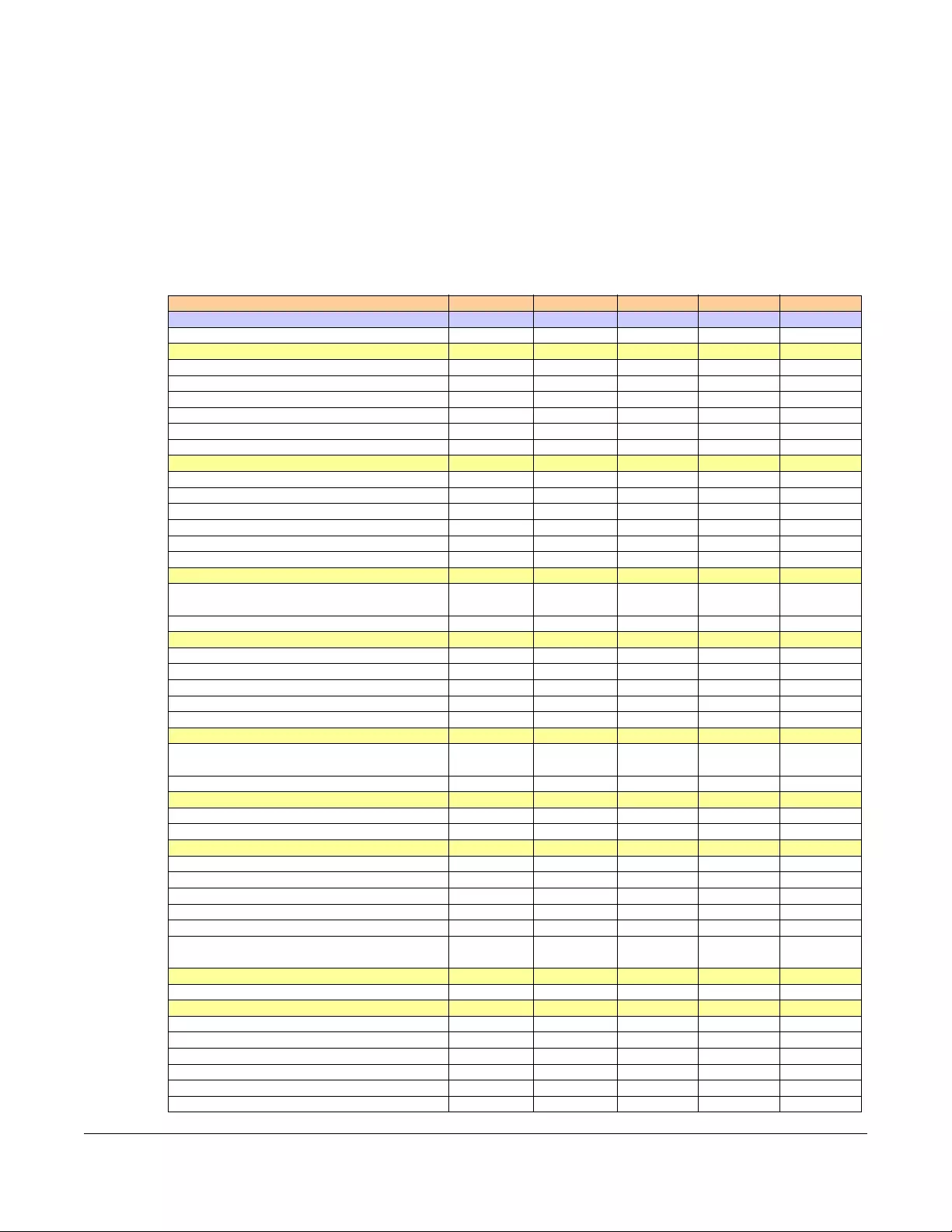
ZyWALL USG FLEX Series User’s Guide
983
APPENDIX B
Product Features
Please refer to the product datasheet for the latest product features.
VERSION 4.60 4.60 4.60 4.60 4.60
MODEL NAME USG FLEX 100 USG FLEX 100W USG FLEX 200 USG FLEX 500 USG FLEX 700
# of MAC 6 6 7 7 14
Interface
VLAN 8 8 16 64 128
Virtual (Alias) 4 per interface 4 per interface 4 per interface 4 per interface 4 per interface
PPP (System Default) 3 3 3 8 14
PPP (User Created) 2 2 4 16 32
Bridge 2 2 8 16 16
Tunnel (GRE/IPv6 Transition) 4 4 4 4 4
Routing
Static Route 64 64 128 256 512
Policy Route 100 100 500 500 1000
Reserved Sessions For Managed Devices 500 500 500 500 500
Maximum OSPF Areas 10 10 10 10 10
Maximum BGP Neighbor 5 5 5 5 5
BGP Maximum Network 16 16 16 16 16
Sessions
Maximum TCP Concurrent Sessions (Forwarding, NAT/
Firewall) 300,000 300,000 600,000 1,000,000 1,600,000
Session Rate 8,000 8,000 12,000 20,000 30,000
NAT
Maximum Virtual Server Number 128 128 256 1024 1024
Maximum Trigger Port Rule Number 8 per PR rule 8 per PR rule 8 per PR rule 8 per PR rule 8 per PR rule
Maximum Redirect Service 20 20 20 20 20
Maximum Virtual Server Load Balancer Rule Number 5 5 10 20 20
Maximum Real Server Number per Rule 4 4 4 4 4
Firewall (Secure Policy)
Maximum Firewall ACL Rule Number = Secure Policy
Number 500 500 500 2000 5000
Maximum Session Limit per Host Rules 1000 1000 1000 1000 1000
ADP
Maximum ADP Profile Number 8 8 32 32 32
Maximum ADP Rule Number 32 32 32 32 32
User Profile
Maximum Local User 64 64 128 128 512
Maximum Admin User 5 5 5 5 10
Maximum User Group 16 16 32 32 128
Maximum User In One User Group 64 64 128 128 512
Default Concurrent Device Login 64 64 200 200 500
Maximum Concurrent Device Upgrade (License) 64 64 200 300 (Extend by
license)
800 (Extend by
license)
HTTPd
Max HTTPd Number 128 128 256 512 512
Objects
Address Object 300 300 300 1000 2000
Address Group 50 50 50 200 400
Maximum Address Object In One Group 128 128 128 128 256
Service Object 200 200 500 1000 1000
Service Group 50 50 100 200 200
Maximum Service Object In One Group 64 64 128 128 256
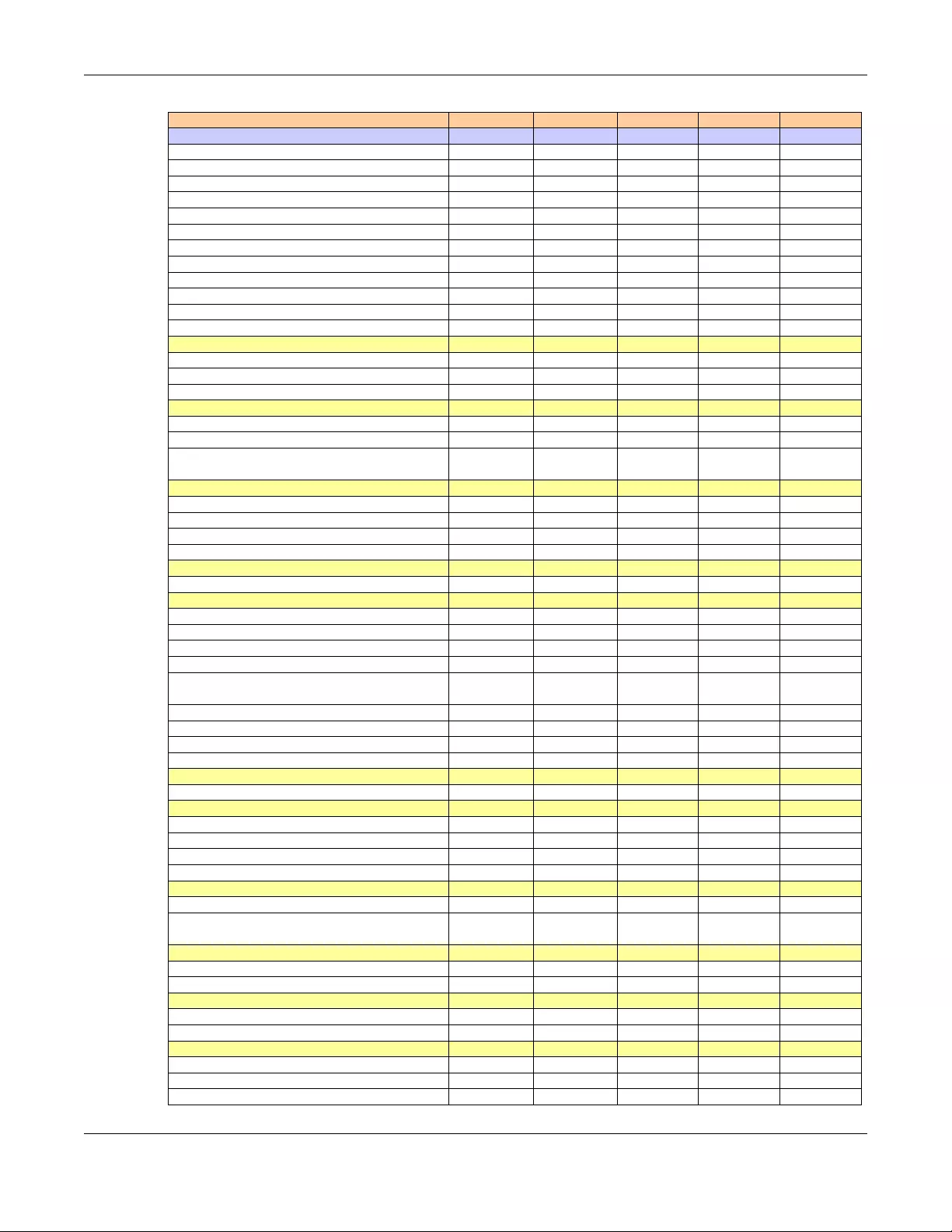
Appendix B Product Features
ZyWALL USG FLEX Series User’s Guide
984
Schedule Object 32 32 32 32 32
Schedule Group 16 16 16 16 16
Maximum Schedule Object In One Group 24 24 24 24 24
Application Object 500 500 500 1000 1000
Application Group 100 100 100 200 200
Maximum Application Object In One Group 128 128 128 128 256
ISP Account 16 (PPP+3G) 16 (PPP+3G) 16 (PPP+3G) 32 (PPP+3G) 32
Maximum LDAP Server Object # 2 2 8 16 16
Maximum RADIUS Server Object # 2 2 8 16 16
Maximum Ad Server Object # 4 4 8 16 16
Maximum Zone Number (System Default) 8 8 8 9 8
Maximum Zone Number (User Defined) 8 8 16 16 32
Trunk
Maximum Trunk Number (System Default) 1 1 1 1 1
Maximum Trunk Number (User Defined) 4 4 8 16 32
Maximum Member Number Per Trunk 4+8 4+8 4+8 16+8 32+8
VPN
Maximum VTI / VPN Tunnels Number 50 50 100 300 500
Maximum VPN Concentrator Number 2 2 2 16 16
Maximum VPN Configuration Provision Rule Number 50 50 100 300 500
SSL VPN
Default SSL VPN Connections 30 30 60 150 150
Maximum SSL VPN Connections 30 30 60 150 150
Maximum SSL VPN Network List 8 8 8 8 8
SSL VPN Max Policy 32 32 32 64 128
Certificate
Certificate Buffer Size 128k 128k 256k 512k 512k
Built-In Service
A Record 64 64 64 128 128
NS Record (DNS Domain Zone Forward) 8 8 16 16 16
MX Record 8 8 8 16 16
Maximum Service Control Entries 16 per service 16 per service 16 per service 32 per service 32 per service
Maximum DHCP Network Pool (VLAN + brg + Ethernet) 15 15 29 88 158
Maximum DHCP Host Pool (Static DHCP) 96 96 256 512 1024
Maximum DHCP Extended Options 10 10 15 30 30
Maximum DDNS Profiles 10 10 10 10 10
DHCP Relay 2 per interface 2 per interface 2 per interface 2 per interface 2 per interface
USB Storage
Device Number 1 1 1 1 1
Centralized Log
Log Entries 512 512 1024 1024 2048
Debug Log Entries 1024 1024 1024 1024 1024
Admin Email Address 2 2 2 2 2
Syslog Server 4 4 4 4 4
Application Patrol
Maximum App Patrol Number 32 32 32 64 96
Maximum Application Object In Each Profile (Object +
Object Group) 32 32 32 64 96
IDP
Maximum IDP Profile Number 8 8 8 16 16
Maximum Custom Signatures 32 32 32 256 512
SSL Inspection
Maximum SSL Inspection Profile 6 6 8 16 16
Maximum Exclude List 128 128 256 256 256
Content Filtering
Maximum Number Of Content Filter Policies 16 16 16 32 64
Forbidden Domain Entry Number 256 per profiles 256 per profiles 256 per profiles 512 per profiles 512 per profiles
Trusted Domain Entry Number 256 per profiles 256 per profiles 256 per profiles 512 per profiles 512 per profiles
VERSION 4.60 4.60 4.60 4.60 4.60
MODEL NAME USG FLEX 100 USG FLEX 100W USG FLEX 200 USG FLEX 500 USG FLEX 700

Appendix B Product Features
ZyWALL USG FLEX Series User’s Guide
985
Keyword Blocking Number 128 per profiles 128 per profiles 128 per profiles 256 per profiles 256 per profiles
Common Forbidden Domain Entry Number 1024 1024 1024 1024 1024
Common Trusted Domain Entry Number 1024 1024 1024 1024 1024
URL Threat Filter
Maximum Statistics Number 1024 1024 1024 1024 1024
Maximum White List Rule 1024 1024 1024 1024 1024
Maximum Black List Rule 1024 1024 1024 1024 1024
IP Reputation
Maximum Statistics Number N/A N/A N/A N/A N/A
Maximum White List Rule N/A N/A N/A N/A N/A
Maximum Black List Rule N/A N/A N/A N/A N/A
Email Security
Maximum AS Rule Number (Profile) 16 16 16 32 32
Maximum White List Rule Support 128 128 128 128 256
Maximum Black List Rule Support 128 128 128 128 256
Maximum DNSBL Domain Support 5 5 5 5 10
Concurrent Mail Session Scanning 200 200 200 200 200
Maximum Statistics Number 500 500 500 500 500
Maximum Statistics Ranking 10 10 10 10 10
Anti-Malware
Maximum AV Rule (Profile) 16 16 16 16 32
Maximum Statistics Number 500 500 500 500 500
Maximum Statistics Ranking 10 10 10 10 10
SandBoxing
Support Protocol N/A N/A N/A N/A N/A
Concurrent File Collect Capability N/A N/A N/A N/A N/A
upload File Size N/A N/A N/A N/A N/A
AP Controller
Default # of Control AP 8 8 8 8 8
Maximum # of Control AP 24 24 40 72 264
AP Group 8 8 8 8 8
Maximum Radio Profile 32 32 32 64 128
Maximum SSID Profile 128 128 128 1024 1024
Maximum Security Profile 128 128 128 1024 1024
Maximum MAC Filter Profile 32 32 32 32 32
Maximum MAC Entry Per MAC Filter Profile 512 512 512 512 512
Zymesh 32 32 32 32 32
BWM
Maximum BWM Rule Number 128 128 256 512 1024
BWM Per Source IP (Maximum) 256 256 1024 1024 2048
SIP
Maximum SIP Concurrent Call 50 50 100 100 200
Custom Web Portal Page
Maximum Internal Web Portal Customize File 4 4 4 4 4
Upload Zip File Size Up to 2 MB Up to 2 MB Up to 2 MB Up to 2 MB Up to 2 MB
Unzip File Size Up to 5 MB Up to 5 MB Up to 5 MB Up to 5 MB Up to 5 MB
Hotspot Management
Max Dynamic Account List N/A N/A 1000 2000 4000
Max Free Time Account Limit N/A N/A 800 1600 3200
Hotspot Support N/A N/A Yes Yes Yes
Walled Garden – URL Base N/A N/A 50 50 50
Walled Garden – Domain/IP Base N/A N/A 50 50 50
Advertisement N/A N/A 20 20 20
Ticket Printer Support N/A N/A
SP350E
(Ethernet)
Up to 10
SP350E
(Ethernet)
Up to 10
SP350E
(Ethernet)
Up to 10
VERSION 4.60 4.60 4.60 4.60 4.60
MODEL NAME USG FLEX 100 USG FLEX 100W USG FLEX 200 USG FLEX 500 USG FLEX 700

ZyWALL USG FLEX Series User’s Guide
986
APPENDIX C
Legal Information
Copyright
Copyright © 2020 by Zyxel Communications Corporation.
The contents of this publication may not be reproduced in any part or as a whole, transcribed, stored in a retrieval system, translated into any
language, or transmitted in any form or by any means, electronic, mechanical, magnetic, optical, chemical, photocopying, manual, or
otherwise, without the prior written permission of Zyxel Communications Corporation. Published by Zyxel Communications Corporation. All rights
reserved.
Disclaimer
Zyxel does not assume any liability arising out of the application or use of any products, or software described herein. Neither does it convey any
license under its patent rights nor the patent rights of others. Zyxel further reserves the right to make changes in any products described herein
without notice. This publication is subject to change without notice.
Regulatory Notice and Statement (Class B)
Model List: USG FLEX 100, USG FLEX 100W, USG FLEX 200
UNITED STATES of AMERICA
The following information applies if you use the product within USA area.
US Importer: Zyxel Communications, Inc, 1130 North Miller Street Anaheim, CA92806-2001, https://www.zyxel.com/us/en/
FCC EMC Statement
• The device complies with Part 15 of FCC rules. Operation is subject to the following two conditions:
(1) This device may not cause harmful interference, and
(2) This device must accept any interference received, including interference that may cause undesired operation.
• Changes or modifications not expressly approved by the party responsible for compliance could void the user’s authority to operate the
device.
• This product has been tested and complies with the specifications for a Class B digital device, pursuant to Part 15 of the FCC Rules. These
limits are designed to provide reasonable protection against harmful interference in a residential installation. This device generates, uses, and
can radiate radio frequency energy and, if not installed and used according to the instructions, may cause harmful interference to radio
communications. However, there is no guarantee that interference will not occur in a particular installation.
• If this device does cause harmful interference to radio or television reception, which is found by turning the device off and on, the user is
encouraged to try to correct the interference by one or more of the following measures:
• Reorient or relocate the receiving antenna
• Increase the separation between the devices
• Connect the equipment to an outlet other than the receiver’s
• Consult a dealer or an experienced radio/TV technician for assistance
FCC Radiation Exposure Statement
• This device complies with FCC RF radiation exposure limits set forth for an uncontrolled environment.
• This transmitter must be at least 22 cm from the user and must not be co-located or operating in conjunction with any other antenna or
transmitter.
• Operation of this device is restricted to indoor use only, except for relevant user's manual mention that this device can be installed into the
external environment.
CANADA
The following information applies if you use the product within Canada area
Innovation, Science and Economic Development Canada ICES Statement
CAN ICES-3 (B)/NMB-3(B)

Appendix C Legal Information
ZyWALL USG FLEX Series User’s Guide
987
Innovation, Science and Economic Development Canada RSS-GEN & RSS-247 Statement
• This device contains licence-exempt transmitter(s)/receiver(s) that comply with Innovation, Science and Economic Development Canada's
licence-exempt RSS(s). Operation is subject to the following two conditions: (1) this device may not cause interference, and (2) this device
must accept any interference, including interference that may cause undesired operation of the device.
• This radio transmitter (2468C-ATP100W) has been approved by Innovation, Science and Economic Development Canada to operate with
the antenna types listed below with the maximum permissible gain indicated. Antenna types not included in this list that have, a gain greater
than the maximum gain indicated for any type listed, are strictly prohibited for use with this device.
Antenna Information
If the product with 5G wireless function operating in 5150 – 5250 MHz and 5725 – 5850 MHz, the following attention must be paid,
• The device for operation in the band 5150 – 5250 MHz is only for indoor use to reduce the potential for harmful interference to co-channel
mobile satellite systems.
• For devices with detachable antenna(s), the maximum antenna gain permitted for devices in the band 5725 – 5850 MHz shall be such that
the equipment still complies with the e.i.r.p. limits as appropriate; and
• Where applicable, antenna type(s), antenna models(s), and the worst-case tilt angle(s) necessary to remain compliant with the e.i.r.p.
elevation mask requirement set forth in Section 6.2.2.3 of RSS 247 shall be clearly indicated.
If the product with 5G wireless function operating in 5250 – 5350 MHz and 5470 – 5725 MHz, the following attention must be paid.
• For devices with detachable antenna(s), the maximum antenna gain permitted for devices in the bands 5250 – 5350 MHz and 5470 – 5725
MHz shall be such that the equipment still complies with the e.i.r.p. limit.
• L'émetteur/récepteur exempt de licence contenu dans le présent appareil est conforme aux CNR d'Innovation, Sciences et
Développement économique Canada applicables aux appareils radio exempts de licence. L'exploitation est autorisée aux deux conditions
suivantes : (1) l'appareil ne doit pas produire de brouillage; (2) L'appareil doit accepter tout brouillage radioélectrique subi, même si le
brouillage est susceptible d'en compromettre le fonctionnement.
• Le présent émetteur radio (2468C-ATP100W) a été approuvé par Innovation, Sciences et Développement économique Canada pour
fonctionner avec les types d'antenne énumérés ci dessous et ayant un gain admissible maximal. Les types d'antenne non inclus dans cette
liste, et dont le gain est supérieur au gain maximal indiqué pour tout type figurant sur la liste, sont strictement interdits pour l'exploitation de
l'émetteur.
informations antenne
Lorsque la fonction sans fil 5G fonctionnant en 5150 – 5250 MHz and 5725 – 5850 MHz est activée pour ce produit , il est nécessaire de porter une
attention particulière aux choses suivantes
• Les dispositifs fonctionnant dans la bande de 5 150 à 5 250 MHz sont réservés uniquement pour une utilisation à l'intérieur afin de réduire les
risques de brouillage préjudiciable aux systèmes de satellites mobiles utilisant les mêmes canaux;
• Pour les dispositifs munis d'antennes amovibles, le gain maximal d'antenne permis (pour les dispositifs utilisant la bande de 5 725 à 5 850 MHz)
doit être conforme à la limite de la p.i.r.e. spécifiée, selon le cas;
• Lorsqu'il y a lieu, les types d'antennes (s'il y en a plusieurs), les numéros de modèle de l'antenne et les pires angles d'inclinaison nécessaires
pour rester conforme à l'exigence de la p.i.r.e. applicable au masque d'élévation, énoncée à la section 6.2.2.3 du CNR-247, doivent être
clairement indiqués.
Lorsque la fonction sans fil 5G fonctionnant en 5250 – 5350 MHz et 5470 – 5725 MHz est activée pour ce produit , il est nécessaire de porter une
attention particulière aux choses suivantes.
• Pour les dispositifs munis d’antennes amovibles, le gain maximal d'antenne permis pour les dispositifs utilisant les bandes de 5 250 à 5 350 MHz
et de 5 470 à 5 725 MHz doit être conforme à la limite de la p.i.r.e.
Industry Canada radiation exposure statement
This equipment complies with ISED radiation exposure limits set forth for an uncontrolled environment. This equipment should be installed and
operated with a minimum distance of 25 cm between the radiator and your body.
Déclaration d’exposition aux radiations:
Cet équipement est conforme aux limites d’exposition aux rayonnements ISED établies pour un environnement non contrôlé. Cet équipement
doit être installé et utilisé avec un minimum de 25 cm de distance entre la source de rayonnement et votre corps.
Type Manufacturer Gain Connector Impedance
Dipole (2412 – 2462MHz) Master Wave 2.7 Reverse SMA 50 Ω
Dipole (5180 – 5240MHz) Master Wave 3.86 Reverse SMA 50 Ω
Dipole (5745 – 5825MHz) Master Wave 4.17 Reverse SMA 50 Ω
Type fabricant Gain Connecteur impédance
Dipole (2412 – 2462MHz) Master Wave 2.7 Reverse SMA 50 Ω
Dipole (5180 – 5240MHz) Master Wave 3.86 Reverse SMA 50 Ω
Dipole (5745 – 5825MHz) Master Wave 4.17 Reverse SMA 50 Ω

Appendix C Legal Information
ZyWALL USG FLEX Series User’s Guide
988
EUROPEA N UNION
The following information applies if you use the product within the European Union.
Declaration of Conformity with Regard to EU Directive 2014/53/EU (Radio Equipment Directive, RED)
Model List: USG FLEX 100W
• Compliance information for 2.4 GHz and/or 5 GHz wireless products relevant to the EU and other Countries following the EU Directive 2014/
53/EU (RED). And this product may be used in all EU countries (and other countries following the EU Directive 2014/53/EU) without any
limitation except for the countries mentioned below table:
• In the majority of the EU and other European countries, the 5 GHz bands have been made available for the use of wireless local area
networks (LANs). Later in this document you will find an overview of countries in which additional restrictions or requirements or both are
applicable. The requirements for any country may evolve. Zyxel recommends that you check with the local authorities for the latest status of
their national regulations for the 5 GHz wireless LANs.
• If this device for operation in the band 5150 – 5350 MHz, it is for indoor use only.
• This equipment should be installed and operated with a minimum distance of 20 cm between the radio equipment and your body.
• The maximum RF power operating for each band as follows:
• the band 2,400 to 2,483.5 MHz is 97.95 mW,
• the bands 5,150 MHz to 5,350 MHz is 191.87 mW,
• the 5,470 MHz to 5,725 MHz is 963.83 mW.
List of national codes
Safety Warnings
• Do not use this product near water, for example, in a wet basement or near a swimming pool.
• Do not expose your device to dampness, dust or corrosive liquids.
• Do not store things on the device.
• Do not obstruct the device ventilation slots as insufficient airflow may harm your device. For example, do not place the device in an
enclosed space such as a box or on a very soft surface such as a bed or sofa.
• Do not install, use, or service this device during a thunderstorm. There is a remote risk of electric shock from lightning.
• Connect ONLY suitable accessories to the device.
• Do not open the device or unit. Opening or removing covers can expose you to dangerous high voltage points or other risks.
• Only qualified service personnel should service or disassemble this device. Please contact your vendor for further information.
• Make sure to connect the cables to the correct ports.
• Place connecting cables carefully so that no one will step on them or stumble over them.
• Always disconnect all cables from this device before servicing or disassembling.
• Do not remove the plug and connect it to a power outlet by itself; always attach the plug to the power adaptor first before connecting it to
a power outlet.
COUNTRY ISO 3166 2 LETTER CODE COUNTRY ISO 3166 2 LETTER CODE
Austria AT Liechtenstein LI
Belgium BE Lithuania LT
Bulgaria BG Luxembourg LU
Croatia HR Malta MT
Cyprus CY Netherlands NL
Czech Republic CZ Norway NO
Denmark DK Poland PL
Estonia EE Portugal PT
Finland FI Romania RO
France FR Serbia RS
Germany DE Slovakia SK
Greece GR Slovenia SI
Hungary HU Spain ES
Iceland IS Switzerland CH
Ireland IE Sweden SE
Italy IT Turkey TR
Latvia LV United Kingdom GB

Appendix C Legal Information
ZyWALL USG FLEX Series User’s Guide
989
• Do not allow anything to rest on the power adaptor or cord and do NOT place the product where anyone can walk on the power adaptor
or cord.
• Please use the provided or designated connection cables/power cables/ adaptors. Connect it to the right supply voltage (for example,
110V AC in North America or 230V AC in Europe). If the power adaptor or cord is damaged, it might cause electrocution. Remove it from the
device and the power source, repairing the power adapter or cord is prohibited. Contact your local vendor to order a new one.
• Do not use the device outside, and make sure all the connections are indoors. There is a remote risk of electric shock from lightning.
• CAUTION: Risk of explosion if battery is replaced by an incorrect type, dispose of used batteries according to the instruction. Dispose them at
the applicable collection point for the recycling of electrical and electronic devices. For detailed information about recycling of this
product, please contact your local city office, your household waste disposal service or the store where you purchased the product.
• The following warning statements apply, where the disconnect device is not incorporated in the device or where the plug on the power
supply cord is intended to serve as the disconnect device,
– For permanently connected devices, a readily accessible disconnect device shall be incorporated external to the device;
– For pluggable devices, the socket-outlet shall be installed near the device and shall be easily accessible.
• CLASS 1 LASER PRODUCT
• APPAREIL À LASER DE CLASS 1
• PRODUCT COMPLIES WITH 21 CFR 1040.10 AND 1040.11.
• PRODUIT CONFORME SELON 21 CFR 1040.10 ET 1040.11.
Environment Statement
ErP (Energy-related Products)
Zyxel products put on the EU market in compliance with the requirement of the European Parliament and the Council published Directive 2009/
125/EC establishing a framework for the setting of ecodesign requirements for energy-related products (recast), so called as "ErP Directive
(Energy-related Products directive) as well as ecodesign requirement laid down in applicable implementing measures, power consumption has
satisfied regulation requirements which are:
• Network standby power consumption < 8W, and/or
• Off mode power consumption < 0.5W, and/or
• Standby mode power consumption < 0.5W.
European Union – Disposal and Recycling Information
The symbol below means that according to local regulations your product and/or its battery shall be disposed of separately from domestic
waste. If this product is end of life, take it to a recycling station designated by local authorities. At the time of disposal, the separate collection of
your product and/or its battery will help save natural resources and ensure that the environment is sustainable development.
Die folgende Symbol bedeutet, dass Ihr Produkt und/oder seine Batterie gemäß den örtlichen Bestimmungen getrennt vom Hausmüll entsorgt
werden muss. Wenden Sie sich an eine Recyclingstation, wenn dieses Produkt das Ende seiner Lebensdauer erreicht hat. Zum Zeitpunkt der
Entsorgung wird die getrennte Sammlung von Produkt und/oder seiner Batterie dazu beitragen, natürliche Ressourcen zu sparen und die Umwelt
und die menschliche Gesundheit zu schützen.
El símbolo de abajo indica que según las regulaciones locales, su producto y/o su batería deberán depositarse como basura separada de la
doméstica. Cuando este producto alcance el final de su vida útil, llévelo a un punto limpio. Cuando llegue el momento de desechar el
producto, la recogida por separado éste y/o su batería ayudará a salvar los recursos naturales y a proteger la salud humana y
medioambiental.
Le symbole ci-dessous signifie que selon les réglementations locales votre produit et/ou sa batterie doivent être éliminés séparément des ordures
ménagères. Lorsque ce produit atteint sa fin de vie, amenez-le à un centre de recyclage. Au moment de la mise au rebut, la collecte séparée
de votre produit et/ou de sa batterie aidera à économiser les ressources naturelles et protéger l'environnement et la santé humaine.
Il simbolo sotto significa che secondo i regolamenti locali il vostro prodotto e/o batteria deve essere smaltito separatamente dai rifiuti domestici.
Quando questo prodotto raggiunge la fine della vita di servizio portarlo a una stazione di riciclaggio. Al momento dello smaltimento, la raccolta
separata del vostro prodotto e/o della sua batteria aiuta a risparmiare risorse naturali e a proteggere l'ambiente e la salute umana.
Symbolen innebär att enligt lokal lagstiftning ska produkten och/eller dess batteri kastas separat från hushållsavfallet. När den här produkten når
slutet av sin livslängd ska du ta den till en återvinningsstation. Vid tiden för kasseringen bidrar du till en bättre miljö och mänsklig hälsa genom att
göra dig av med den på ett återvinningsställe.

Appendix C Legal Information
ZyWALL USG FLEX Series User’s Guide
990
台灣
安全警告 – 為了您的安全,請先閱讀以下警告及指示 :
• 請勿將此產品接近水、火焰或放置在高溫的環境。
• 避免設備接觸
– 任何液體 - 切勿讓設備接觸水、雨水、高濕度、污水腐蝕性的液體或其他水份。
– 灰塵及污物 - 切勿接觸灰塵、污物、沙土、食物或其他不合適的材料。
• 雷雨天氣時,不要安裝,使用或維修此設備。有遭受電擊的風險。
• 切勿重摔或撞擊設備,並勿使用不正確的電源變壓器。
• 若接上不正確的電源變壓器會有爆炸的風險。
• 請勿隨意更換產品內的電池。
• 如果更換不正確之電池型式,會有爆炸的風險,請依製造商說明書處理使用過之電池。
• 請將廢電池丟棄在適當的電器或電子設備回收處。
• 請勿將設備解體。
• 請勿阻礙設備的散熱孔,空氣對流不足將會造成設備損害。
• 請插在正確的電壓供給插座 ( 如 : 北美 / 台灣電壓 110V AC,歐洲是 230V AC)。
• 假若電源變壓器或電源變壓器的纜線損壞,請從插座拔除,若您還繼續插電使用,會有觸電死亡的風險。
• 請勿試圖修理電源變壓器或電源變壓器的纜線,若有毀損,請直接聯絡您購買的店家,購買一個新的電源變壓器。
• 請勿將此設備安裝於室外,此設備僅適合放置於室內。
• 請勿隨一般垃圾丟棄。
• 請參閱產品背貼上的設備額定功率。
• 請參考產品型錄或是彩盒上的作業溫度。
• 產品沒有斷電裝置或者採用電源線的插頭視為斷電裝置的一部分,以下警語將適用 :
– 對永久連接之設備, 在設備外部須安裝可觸及之斷電裝置;
– 對插接式之設備, 插座必須接近安裝之地點而且是易於觸及的。
以下訊息僅適用於產品具有無線功能且銷售至台灣地區 (USG FLEX 100W)
• 第十二條 經型式認證合格之低功率射頻電機,非經許可,公司、商號或使用者均不得擅自變更頻率、加大功率或變更原設計之特性及功能。
• 第十四條 低功率射頻電機之使用不得影響飛航安全及干擾合法通信;經發現有干擾現象時,應立即停用,並改善至無干擾時方得繼續使用。
• 前項合法通信,指依電信法規定作業之無線電通信。低功率射頻電機須忍受合法通信或工業、科學及醫療用電波輻射性電機設備之干擾。
• 無線資訊傳輸設備忍受合法通信之干擾且不得干擾合法通信;如造成干擾,應立即停用,俟無干擾之虞,始得繼續使用。
• 無線資訊傳輸設備的製造廠商應確保頻率穩定性,如依製造廠商使用手冊上所述正常操作,發射的信號應維持於操作頻帶中
• 使用無線產品時,應避免影響附近雷達系統之操作。
• 高增益指向性天線只得應用於固定式點對點系統。
About the Symbols
Various symbols are used in this product to ensure correct usage, to prevent danger to the user and others, and to prevent property damage.
The meaning of these symbols are described below. It is important that you read these descriptions thoroughly and fully understand the
contents.
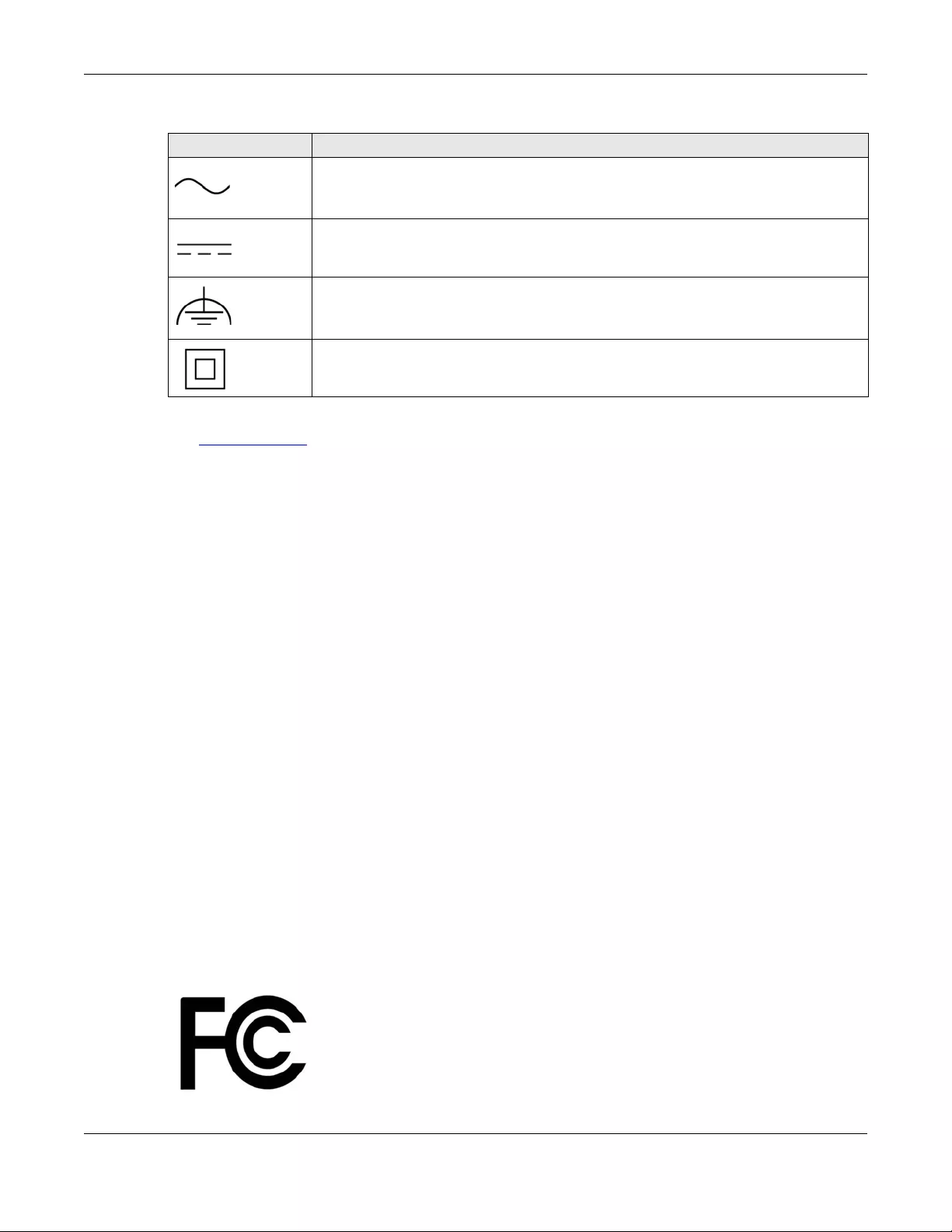
Appendix C Legal Information
ZyWALL USG FLEX Series User’s Guide
991
Explanation of the Symbols
Viewing Certifications
Go to http://www.zyxel.com to view this product’s documentation and certifications.
Zyxel Limited Warranty
Zyxel warrants to the original end user (purchaser) that this product is free from any defects in material or workmanship for a specific period (the
Warranty Period) from the date of purchase. The Warranty Period varies by region. Check with your vendor and/or the authorized Zyxel local
distributor for details about the Warranty Period of this product. During the warranty period, and upon proof of purchase, should the product
have indications of failure due to faulty workmanship and/or materials, Zyxel will, at its discretion, repair or replace the defective products or
components without charge for either parts or labor, and to whatever extent it shall deem necessary to restore the product or components to
proper operating condition. Any replacement will consist of a new or re-manufactured functionally equivalent product of equal or higher value,
and will be solely at the discretion of Zyxel. This warranty shall not apply if the product has been modified, misused, tampered with, damaged by
an act of God, or subjected to abnormal working conditions.
Note
Repair or replacement, as provided under this warranty, is the exclusive remedy of the purchaser. This warranty is in lieu of all other warranties,
express or implied, including any implied warranty of merchantability or fitness for a particular use or purpose. Zyxel shall in no event be held
liable for indirect or consequential damages of any kind to the purchaser.
To obtain the services of this warranty, contact your vendor. You may also refer to the warranty policy for the region in which you bought the
device at http://www.zyxel.com/web/support_warranty_info.php.
Registration
Register your product online at www.zyxel.com to receive email notices of firmware upgrades and related information.
Trademarks
ZyNOS (Zyxel Network Operating System) and ZON (Zyxel One Network) are registered trademarks of Zyxel Communications, Inc. Other
trademarks mentioned in this publication are used for identification purposes only and may be properties of their respective owners.
Open Source Licenses
This product may contain in part some free software distributed under GPL license terms and/or GPL like licenses. Open source licenses are
provided with the firmware package. You can download the latest firmware at www.zyxel.com. If you cannot find it there, contact your vendor
or Zyxel Technical Support at support@zyxel.com.tw.
To obtain the source code covered under those Licenses, please contact your vendor or Zyxel Technical Support at support@zyxel.com.
Regulatory Notice and Statement (Class A)
Model List: USG FLEX 500, USG FLEX 700
United States of America
The following information applies if you use the product within USA area.
SYMBOL EXPLANATION
Alternating current (AC):
AC is an electric current in which the flow of electric charge periodically reverses direction.
Direct current (DC):
DC if the unidirectional flow or movement of electric charge carriers.
Earth; ground:
A wiring terminal intended for connection of a Protective Earthing Conductor.
Class II equipment:
The method of protection against electric shock in the case of class II equipment is either double insulation or
reinforced insulation.

Appendix C Legal Information
ZyWALL USG FLEX Series User’s Guide
992
US Importer: Zyxel Communications, Inc, 1130 North Miller Street Anaheim, CA92806-2001, https://www.zyxel.com/us/en/
FCC EMC Statement
• This device complies with part 15 of the FCC Rules. Operation is subject to the following two conditions:
(1) This device may not cause harmful interference, and
(2) This device must accept any interference received, including interference that may cause undesired operation.
• Changes or modifications not expressly approved by the party responsible for compliance could void the user’s authority to operate the
equipment.
• This device has been tested and found to comply with the limits for a Class A digital device, pursuant to part 15 of the FCC Rules. These limits
are designed to provide reasonable protection against harmful interference when the equipment is operated in a commercial environment.
This equipment generates, uses, and can radiate radio frequency energy and, if not installed and used in accordance with the instruction
manual, may cause harmful interference to radio communications. Operation of this equipment in a residential area is likely to cause harmful
interference in which case the user will be required to correct the interference at his own expense.
Canada The following information applies if you use the product within Canada area
Innovation, Science and Economic Development Canada Industry ICES Statement
CAN ICES-3 (A)/NMB-3(A)
European Union
The following information applies if you use the product within the European Union.
CE EMC statement
WARNING: This equipment is compliant with Class A of EN55032. In a residential environment this equipment may cause radio interference.
List of National Codes
Safety Warnings
• Do not use this product near water, for example, in a wet basement or near a swimming pool.
• Do not expose your device to dampness, dust or corrosive liquids.
• Do not store things on the device.
• Do not obstruct the device ventilation slots as insufficient airflow may harm your device. For example, do not place the device in an
enclosed space such as a box or on a very soft surface such as a bed or sofa.
• Do not install, use, or service this device during a thunderstorm. There is a remote risk of electric shock from lightning.
• Connect ONLY suitable accessories to the device.
COUNTRY ISO 3166 2 LETTER CODE COUNTRY ISO 3166 2 LETTER CODE
Austria AT Liechtenstein LI
Belgium BE Lithuania LT
Bulgaria BG Luxembourg LU
Croatia HR Malta MT
Cyprus CY Netherlands NL
Czech Republic CR Norway NO
Denmark DK Poland PL
Estonia EE Portugal PT
Finland FI Romania RO
France FR Serbia RS
Germany DE Slovakia SK
Greece GR Slovenia SI
Hungary HU Spain ES
Iceland IS Sweden SE
Ireland IE Switzerland CH
Italy IT Turkey TR
Latvia LV United Kingdom GB

Appendix C Legal Information
ZyWALL USG FLEX Series User’s Guide
993
• Do not open the device or unit. Opening or removing covers can expose you to dangerous high voltage points or other risks. Only qualified
service personnel should service or disassemble this device. Please contact your vendor for further information.
• Make sure to connect the cables to the correct ports.
• Place connecting cables carefully so that no one will step on them or stumble over them.
• Always disconnect all cables from this device before servicing or disassembling.
• Do not remove the plug and connect it to a power outlet by itself; always attach the plug to the power adaptor first before connecting it to
a power outlet.
• Do not allow anything to rest on the power adaptor or cord and do NOT place the product where anyone can walk on the power adaptor
or cord.
• Please use the provided or designated connection cables/power cables/ adaptors. Connect it to the right supply voltage (for example,
110V AC in North America or 230V AC in Europe). If the power adaptor or cord is damaged, it might cause electrocution. Remove it from the
device and the power source, repairing the power adapter or cord is prohibited. Contact your local vendor to order a new one.
• Do not use the device outside, and make sure all the connections are indoors. There is a remote risk of electric shock from lightning.
• Caution: Risk of explosion if battery is replaced by an incorrect type, dispose of used batteries according to the instruction. Dispose them at
the applicable collection point for the recycling of electrical and electronic device. For detailed information about recycling of this product,
please contact your local city office, your household waste disposal service or the store where you purchased the product.
• Use ONLY power wires of the appropriate wire gauge for your device. Connect it to a power supply of the correct voltage.
• Fuse Warning! Replace a fuse only with a fuse of the same type and rating.
• The POE (Power over Ethernet) devices that supply or receive power and their connected Ethernet cables must all be completely indoors.
• The following warning statements apply, where the disconnect device is not incorporated in the device or where the plug on the power
supply cord is intended to serve as the disconnect device,
– For permanently connected devices, a readily accessible disconnect device shall be incorporated external to the device;
– For pluggable devices, the socket-outlet shall be installed near the device and shall be easily accessible.
• This device must be grounded by qualified service personnel Never defeat the ground conductor or operate the device in the absence of a
suitably installed ground conductor. Contact the appropriate electrical inspection authority or an electrician if you are uncertain that
suitable grounding is available. If your device has an earthing screw (frame ground), connect the screw to a ground terminal using an
appropriate AWG ground wire. Do this before you make other connections. If your device has no earthing screw, but has a 3-prong power
plug, make sure to connect the plug to a 3-hole earthed socket.
• When connecting or disconnecting power to hot-pluggable power supplies, if offered with your system, observe the following guidelines:
– Install the power supply before connecting the power cable to the power supply.
– Unplug the power cable before removing the power supply.
– If the system has multiple sources of power, disconnect power from the system by unplugging all power cables from the power supply.
• CLASS 1 LASER PRODUCT
• APPAREIL À LASER DE CLASS 1
• PRODUCT COMPLIES WITH 21 CFR 1040.10 AND 1040.11.
• PRODUIT CONFORME SELON 21 CFR 1040.10 ET 1040.11.
Environment Statement
European Union – Disposal and Recycling Information
The symbol below means that according to local regulations your product and/or its battery shall be disposed of separately from domestic
waste. If this product is end of life, take it to a recycling station designated by local authorities. At the time of disposal, the separate collection of
your product and/or its battery will help save natural resources and ensure that the environment is sustainable development.
Die folgende Symbol bedeutet, dass Ihr Produkt und/oder seine Batterie gemäß den örtlichen Bestimmungen getrennt vom Hausmüll entsorgt
werden muss. Wenden Sie sich an eine Recyclingstation, wenn dieses Produkt das Ende seiner Lebensdauer erreicht hat. Zum Zeitpunkt der
Entsorgung wird die getrennte Sammlung von Produkt und/oder seiner Batterie dazu beitragen, natürliche Ressourcen zu sparen und die Umwelt
und die menschliche Gesundheit zu schützen.
El símbolo de abajo indica que según las regulaciones locales, su producto y/o su batería deberán depositarse como basura separada de la
doméstica. Cuando este producto alcance el final de su vida útil, llévelo a un punto limpio. Cuando llegue el momento de desechar el
producto, la recogida por separado éste y/o su batería ayudará a salvar los recursos naturales y a proteger la salud humana y
medioambiental.
Le symbole ci-dessous signifie que selon les réglementations locales votre produit et/ou sa batterie doivent être éliminés séparément des ordures
ménagères. Lorsque ce produit atteint sa fin de vie, amenez-le à un centre de recyclage. Au moment de la mise au rebut, la collecte séparée
de votre produit et/ou de sa batterie aidera à économiser les ressources naturelles et protéger l'environnement et la santé humaine.
Il simbolo sotto significa che secondo i regolamenti locali il vostro prodotto e/o batteria deve essere smaltito separatamente dai rifiuti domestici.
Quando questo prodotto raggiunge la fine della vita di servizio portarlo a una stazione di riciclaggio. Al momento dello smaltimento, la raccolta
separata del vostro prodotto e/o della sua batteria aiuta a risparmiare risorse naturali e a proteggere l'ambiente e la salute umana.
Symbolen innebär att enligt lokal lagstiftning ska produkten och/eller dess batteri kastas separat från hushållsavfallet. När den här produkten når
slutet av sin livslängd ska du ta den till en återvinningsstation. Vid tiden för kasseringen bidrar du till en bättre miljö och mänsklig hälsa genom att
göra dig av med den på ett återvinningsställe.
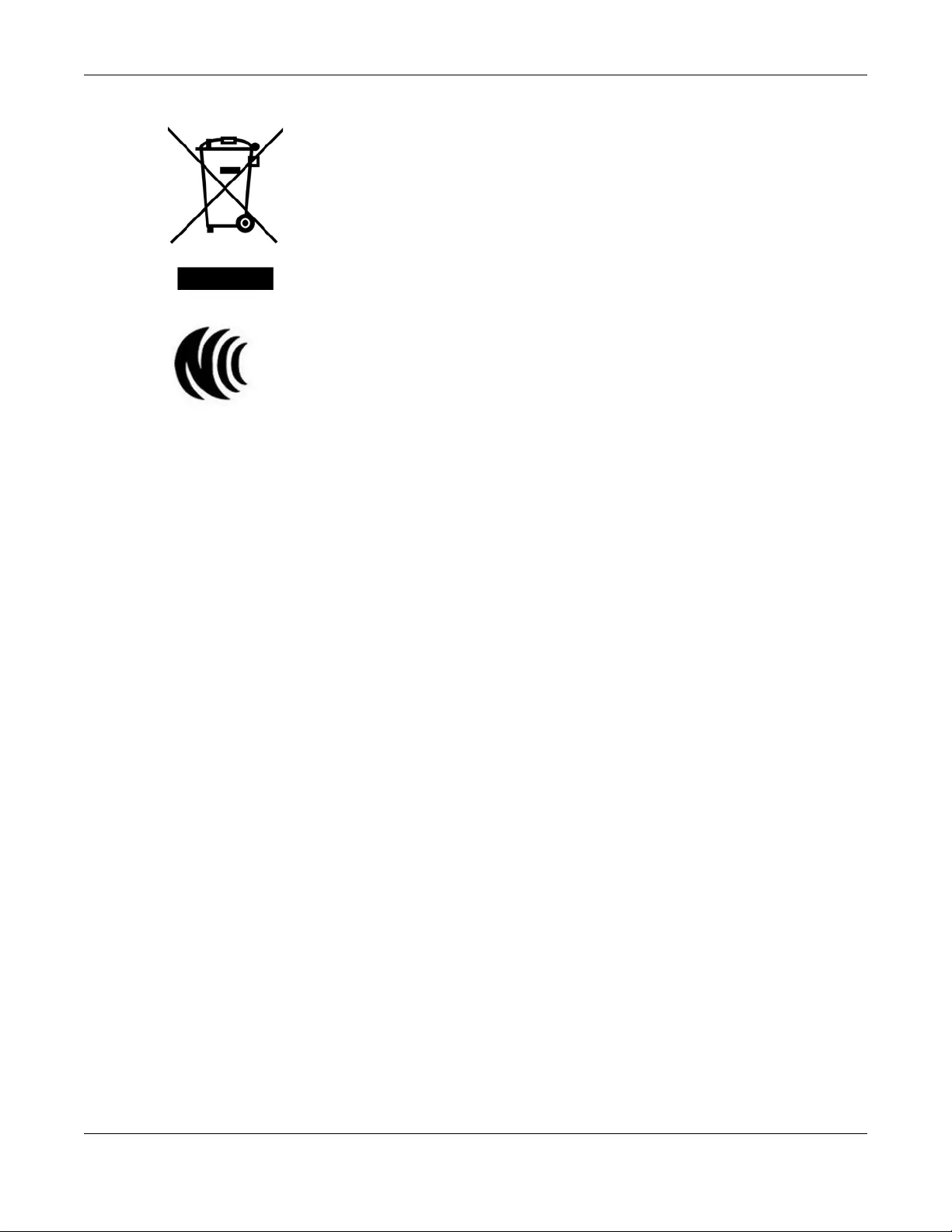
Appendix C Legal Information
ZyWALL USG FLEX Series User’s Guide
994
台灣
警告使用者
• 這是甲類的資訊產品,在居住的環境中使用時,可能會造成射頻干擾,在這種情況下,使用者會被要求採取某些適當的對策。
安全警告 – 為了您的安全,請先閱讀以下警告及指示 :
• 請勿將此產品接近水、火焰或放置在高溫的環境。
• 避免設備接觸 :
– 任何液體 - 切勿讓設備接觸水、雨水、高濕度、污水腐蝕性的液體或其他水份。
– 灰塵及污物 - 切勿接觸灰塵、污物、沙土、食物或其他不合適的材料。
• 雷雨天氣時,不要安裝,使用或維修此設備。有遭受電擊的風險。
• 切勿重摔或撞擊設備,並勿使用不正確的電源變壓器。
• 若接上不正確的電源變壓器會有爆炸的風險。
• 請勿隨意更換產品內的電池。
• 如果更換不正確之電池型式,會有爆炸的風險,請依製造商說明書處理使用過之電池。
• 請將廢電池丟棄在適當的電器或電子設備回收處。
• 請勿將設備解體。
• 請勿阻礙設備的散熱孔,空氣對流不足將會造成設備損害。
• 請插在正確的電壓供給插座 ( 如 : 北美 / 台灣電壓 110V AC,歐洲是 230V AC)。
• 假若電源變壓器或電源變壓器的纜線損壞,請從插座拔除,若您還繼續插電使用,會有觸電死亡的風險。
• 請勿試圖修理電源變壓器或電源變壓器的纜線,若有毀損,請直接聯絡您購買的店家,購買一個新的電源變壓器。
• 請勿將此設備安裝於室外,此設備僅適合放置於室內。
• 請勿隨一般垃圾丟棄。
• 請參閱產品背貼上的設備額定功率。
• 請參考產品型錄或是彩盒上的作業溫度。
• 產品沒有斷電裝置或者採用電源線的插頭視為斷電裝置的一部分,以下警語將適用 :
– 對永久連接之設備, 在設備外部須安裝可觸及之斷電裝置;
– 對插接式之設備, 插座必須接近安裝之地點而且是易於觸及的。
About the Symbols
Various symbols are used in this product to ensure correct usage, to prevent danger to the user and others, and to prevent property damage.
The meaning of these symbols are described below. It is important that you read these descriptions thoroughly and fully understand the
contents.
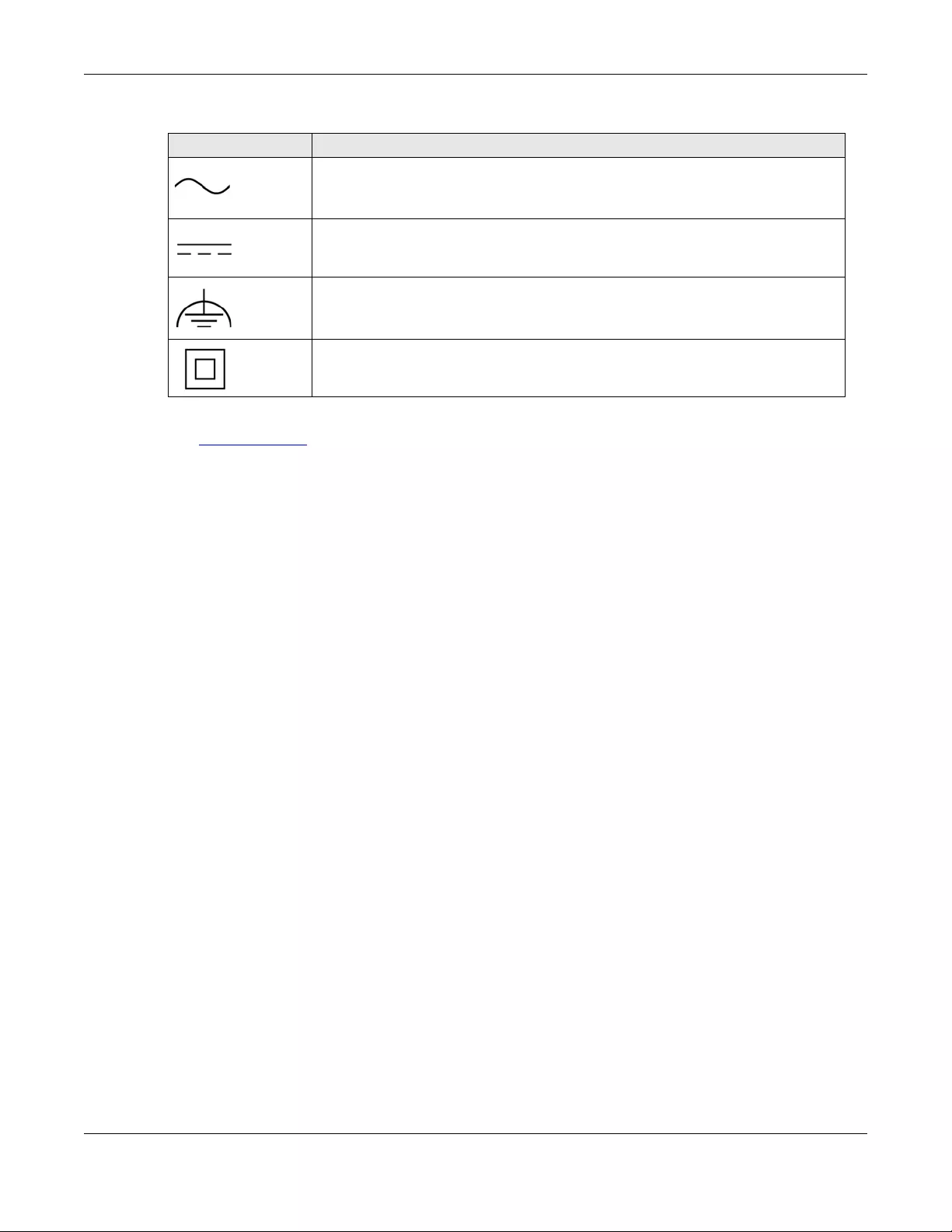
Appendix C Legal Information
ZyWALL USG FLEX Series User’s Guide
995
Explanation of the Symbols
Viewing Certifications
Go to http://www.zyxel.com to view this product’s documentation and certifications.
Zyxel Limited Warranty
Zyxel warrants to the original end user (purchaser) that this product is free from any defects in material or workmanship for a specific period (the
Warranty Period) from the date of purchase. The Warranty Period varies by region. Check with your vendor and/or the authorized Zyxel local
distributor for details about the Warranty Period of this product. During the warranty period, and upon proof of purchase, should the product
have indications of failure due to faulty workmanship and/or materials, Zyxel will, at its discretion, repair or replace the defective products or
components without charge for either parts or labor, and to whatever extent it shall deem necessary to restore the product or components to
proper operating condition. Any replacement will consist of a new or re-manufactured functionally equivalent product of equal or higher value,
and will be solely at the discretion of Zyxel. This warranty shall not apply if the product has been modified, misused, tampered with, damaged by
an act of God, or subjected to abnormal working conditions.
Note
Repair or replacement, as provided under this warranty, is the exclusive remedy of the purchaser. This warranty is in lieu of all other warranties,
express or implied, including any implied warranty of merchantability or fitness for a particular use or purpose. Zyxel shall in no event be held
liable for indirect or consequential damages of any kind to the purchaser.
To obtain the services of this warranty, contact your vendor. You may also refer to the warranty policy for the region in which you bought the
device at http://www.zyxel.com/web/support_warranty_info.php.
Registration
Register your product online at www.zyxel.com to receive email notices of firmware upgrades and related information.
Open Source Licenses
This product may contain in part some free software distributed under GPL license terms and/or GPL like licenses. Open source licenses are
provided with the firmware package. You can download the latest firmware at www.zyxel.com. If you cannot find it there, contact your vendor
or Zyxel Technical Support at support@zyxel.com.tw.
To obtain the source code covered under those Licenses, please contact your vendor or Zyxel Technical Support at support@zyxel.com.
SYMBOL EXPLANATION
Alternating current (AC):
AC is an electric current in which the flow of electric charge periodically reverses direction.
Direct current (DC):
DC if the unidirectional flow or movement of electric charge carriers.
Earth; ground:
A wiring terminal intended for connection of a Protective Earthing Conductor.
Class II equipment:
The method of protection against electric shock in the case of class II equipment is either double insulation
or reinforced insulation.

Index
ZyWALL USG FLEX Series User’s Guide
996
Index
Symbols
Numbers
3322 Dynamic DNS 352
3DES 446
6in4 tunneling 275
6to4 tunneling 275
A
AAA
Base DN 787
Bind DN 787, 790
directory structure 786
Distinguished Name, see DN
DN 787, 788, 790
password 790
port 790, 792
search time limit 790
SSL 790
AAA server 784
AD 786
and users 714
directory service 785
LDAP 785, 786
local user database 786
RADIUS 785, 786, 791
RADIUS group 791
see also RADIUS
access 33
access control attacks 654
Access Point Name, see APN
Access Restricted Web Page
Response Message 894
access users 713, 715
custom page 863
forcing login 482
idle timeout 726
logging in 482
multiple logins 727
see also users 713
Web Configurator 728
access users, see also force user authentication
policies
account
dynamic guest 138
quota (T/U/D) 139
user 713, 822
accounting server 784
Active Directory, see AD
active protocol 450
AH 450
and encapsulation 450
ESP 450
active sessions 118, 135
ActiveX 615
AD 785, 787, 788, 790
directory structure 786
Distinguished Name, see DN
password 790
port 790, 792
search time limit 790
SSL 790
address groups 764
and content filtering 595, 596
and FTP 882
and security policy 486
and SNMP 887
and SSH 877
and Telnet 880
and WWW 863
address objects 764
and content filtering 595, 596
and FTP 882
and NAT 333, 363
and policy routes 332
and security policy 486
and SNMP 887
and SSH 877

Index
ZyWALL USG FLEX Series User’s Guide
997
and Telnet 880
and VPN connections 423
and WWW 863
HOST 765
RANGE 765
SUBNET 765
types of 765, 771
address record 852
admin user
troubleshooting 973
admin users 713
multiple logins 727
see also users 713
ADP 572
false negatives 574
false positives 574
inline profile 574
monitor profile 574
Advanced Encryption Standard, see AES
advertisement
remove 557
URL entries 558
web page 557
AES 446
AF 336
AH 429, 450
and transport mode 451
alerts 907, 908, 910, 911, 912, 913
IDP 700, 701
ALG 381, 387
and NAT 381, 383
and policy routes 383, 387
and security policy 381, 383
and trunks 387
FTP 381, 382
H.323 381, 382, 387
peer-to-peer calls 383
RTP 387
see also VoIP pass through 381
SIP 381, 382
and anti-malware 628
Anomaly Detection and Prevention, see ADP
Anonymizer 642, 646
anti-malware 620
boot sector virus 638
EICAR 627, 636
e-mail
virus 638
encryption 628
file decompression 628, 634
file infector 638
file infector virus 638
firmware package blocking 628, 634
infection and prevention 638
macro virus 638
malware life cycle 638
malware types 638
mutation virus 638
overview 620
packet scan 620
packet types 621
polymorphic virus 638
scanner types 638
signatures 631
statistics 179
virus 620
worm 620
anti-spam 675, 678, 679, 684
action for spam mails 678, 684
black list 675, 678, 679, 684
concurrent e-mail sessions 186
DNSBL 676, 678, 684
e-mail header buffer 676
e-mail headers 676
general settings 677
identifying legitimate e-mail 675
identifying spam 675
POP2 676
POP3 676
regular expressions 682
SMTP 676
white list 675, 678, 680, 684
anti-virus
EICAR 627, 636
e-mail virus 638
polymorphic virus 638
statistics 179
troubleshooting 964, 967
troubleshooting signatures update 964
updating signatures 200
AP
antenna orientation 162
group 159
management icons 152
status 152
status icons 155

Index
ZyWALL USG FLEX Series User’s Guide
998
ZyMesh Profile 162
AP group 208, 212
APN 270
Application Layer Gateway, see ALG
application patrol 586
actions 586
and HTTP redirect 376
and security policy 586
classification 586
exceptions 586
port-less 586
ports 587
service ports 587
troubleshooting 964, 969, 970, 972
ASAS (Authenex Strong Authentication System) 785
asymmetrical routes 566
allowing through the security policy 569
vs virtual interfaces 566
attacks
access control 654
backdoor 655
buffer overflow 655
Denial of Service (DoS) 427
DoS/DDoS 655
IM 655
P2P 655
scan 655
spam 655
trapdoor 655
trojan 655
virus 620, 656
worm 656
Authenex Strong Authentication System (ASAS) 785
authentication
in IPSec 430
LDAP/AD 786
server 784
authentication algorithms 445, 446
and active protocol 445
MD5 446
SHA1 446
Authentication Header, see AH
authentication method objects 794
and users 714
and WWW 862
create 795
example 794
authentication policy
exceptional services 484
Authentication server
RADIUS client 890
authentication server 889, 891
authentication type 84, 821
Authentication, Authorization, Accounting servers,
see AAA server
authorization server 784
Autonomous Systems (AS) 346
auxiliary interfaces 229
B
backdoor attacks 655
backing up configuration files 917
bandwidth
egress 271, 280
ingress 271, 280
bandwidth limit
troubleshooting 966
bandwidth management 586
maximize bandwidth usage 336, 469
see also application patrol 586
troubleshooting 966
Base DN 787
Batch import 834
BGP 351
billing
accumulation accounting method 513
built-in billing 513
credit card service 525
discount pricing plan 523
identity token 526
online payment service 527
printout 520
profile 513, 516
quota (T/U/D) 517
quota type 523
SMS message 519
time-to-finish accounting method 513
user logon settings 515
Bind DN 787, 790
BitTorrent 655
black list 678, 679, 684
anti-spam 675

Index
ZyWALL USG FLEX Series User’s Guide
999
Blaster 673
bridge interfaces 229, 295
and virtual interfaces of members 296
basic characteristics 229
effect on routing table 296
member interfaces 296
virtual 254
bridges 295
buffer overflow 655
buffer overflow attacks 655
C
CA
and certificates 803
CA (Certificate Authority), see certificates
Calling Station ID 746, 748, 750, 753, 756
capturing packets 937, 940
card SIM 271
CEF (Common Event Format) 905, 911
cellular 265
APN 270
interfaces 229
network types 144
signal quality 144, 145
SIM card 271
SIM Card IMSI 145
status 143, 146
system 144, 145
troubleshooting 965, 966
certificate
troubleshooting 973
Certificate Authority (CA)
see certificates
Certificate Revocation List (CRL) 803
vs OCSP 819
certificates 802
advantages of 803
and CA 803
and FTP 882
and HTTPS 859
and IKE SA 450
and SSH 877
and VPN gateways 423
and WWW 861
certification path 803, 811, 817
expired 803
factory-default 804
file formats 804
fingerprints 812, 818
importing 808
in IPSec 436
not used for encryption 803
revoked 803
self-signed 804, 810
serial number 812, 817
storage space 806, 814
thumbprint algorithms 805
thumbprints 805
used for authentication 803
verifying fingerprints 804
certification requests 810
certifications 988
viewing 991, 995
Challenge Handshake Authentication Protocol
(CHAP) 821
CHAP (Challenge Handshake Authentication
Protocol) 821
CHAP/PAP 821
CLI 32, 40
button 40
messages 40
popup window 40
Reference Guide 2
commands 32
sent by Web Configurator 40
Common Event Format (CEF) 905, 911
compression (stac) 822
computer names 250, 292, 305, 323, 463
computer virus 620
see also virus
concurrent e-mail sessions 186
configuration
information 931
configuration file
troubleshooting 974
configuration files 915
at restart 918
backing up 917
downloading 919, 951
downloading with FTP 881
editing 915
how applied 916
lastgood.conf 918, 920

Index
ZyWALL USG FLEX Series User’s Guide
1000
managing 917
startup-config.conf 920
startup-config-bad.conf 918
syntax 916
system-default.conf 920
uploading 921
uploading with FTP 881
use without restart 915
connection
troubleshooting 970
connection monitor (in SSL) 175
connectivity check 249, 264, 271, 280, 291, 307, 311,
430
console port
speed 847
contact information 977, 983
content (pattern) 662
content filter
troubleshooting 964
content filtering 595, 596
and address groups 595, 596
and address objects 595, 596
and schedules 595, 596
and user groups 595
and users 595
by category 595, 596, 603
by keyword (in URL) 596, 616
by URL 596, 615, 617, 618
by web feature 596, 615
cache 619
categories 603
category service 602
default policy 596
external web filtering service 602, 619
filter list 596
managed web pages 602
policies 595, 596
registration status 199
statistics 178
testing 603
uncategorized pages 602
URL for blocked access 598
cookies 33, 615
copyright 986
CPU usage 118
current date/time 116, 843
and schedules 779
daylight savings 845
setting manually 846
time server 847
current user list 175
custom
access user page 863
login page 863
custom signatures 654, 657, 672, 968
applying 664
example 662
verifying 665
custom.rules file 654, 672, 968
customer support 977, 983
D
Data Encryption Standard, see DES
date 843
daylight savings 845
DDNS 352
backup mail exchanger 357
mail exchanger 357
service providers 352
troubleshooting 969
DDoS attacks 655
Dead Peer Detection, see DPD
decompression of files (in anti-malware) 628, 634
default
security policy behavior 565
Default_L2TP_VPN_GW 461
Denial of Service (DoS) attacks 655
Denial of Service (Dos) attacks 427
DES 445
device access
troubleshooting 963
Device HA 826
device HA
virtual router 828
device High Availability see Device HA 826
DHCP 322, 842
and DNS servers 323
and domain name 842
and interfaces 322
pool 323
static DHCP 323

Index
ZyWALL USG FLEX Series User’s Guide
1001
DHCP Unique IDentifier 233
DHCPv6 822
DHCP Unique IDentifier 233
DHCPv6 Request 822
diagnostics 931
Differentiated Services Code Point (DSCP) 658
Diffie-Hellman key group 446
DiffServ 336
Digital Signature Algorithm public-key algorithm, see
DSA
direct routes 328
directory 785
directory service 785
file structure 786
disclaimer 986
Distinguished Name (DN) 787, 788, 790
Distributed Denial of Service (DDoS) attacks 655
DN 787, 788, 790
DNS 848
address records 852
domain name forwarders 854
domain name to IP address 852
IP address to domain name 852
L2TP VPN 463
Mail eXchange (MX) records 855
pointer (PTR) records 852
DNS Blacklist see DNSBL 676
DNS inbound LB 412
DNS servers 85, 848, 854
and interfaces 323
DNSBL 676, 678, 684, 687
see also anti-spam 676
domain name 842
Domain Name System, see DNS
DoS (Denial of Service) attacks 655
DPD 438
DSA 810
DSCP 329, 332, 472, 955
DUID 233
Dynamic Domain Name System, see DDNS
dynamic guest 138
dynamic guest account 138, 714
dynamic guest accounts 517
Dynamic Host Configuration Protocol, see DHCP.
dynamic peers in IPSec 428
DynDNS 352
DynDNS see also DDNS 352
Dynu 352
E
eBGP (exterior Border Gate Protocol) 346
e-Donkey 655
egress bandwidth 271, 280
Ekahau RTLS 224
e-mail 675
daily statistics report 902
header buffer 676
headers 676
Email Security
DNSBL 687
e-Mule 655
Encapsulating Security Payload, see ESP
encapsulation
and active protocol 450
IPSec 429
transport mode 450
tunnel mode 450
VPN 450
encryption
and anti-malware 634
IPSec 430
RSA 812
encryption algorithms 445
3DES 446
AES 446
and active protocol 445
DES 445
encryption method 821
end of IP list 658
enforcing policies in IPSec 428
ESP 429, 450
and transport mode 451
Ethernet interfaces 229
and OSPF 237
and RIP 237
and routing protocols 235
basic characteristics 229
virtual 254
ethernet interfaces

Index
ZyWALL USG FLEX Series User’s Guide
1002
neighboring devices 147
exceptional services 484
extended authentication
and VPN gateways 423
IKE SA 449
Extended Service Set IDentification 732
ext-user
troubleshooting 973
F
false negatives 574
false positives 574, 577
file decompression (in anti-malware) 628, 634
file extensions
configuration files 915
shell scripts 915
file manager 915
Firefox 33
firewall
and SMTP redirect 377
firmware 531
and restart 922
current version 116, 926
getting updated 922
uploading 925
uploading with FTP 881
firmware package
troubleshooting 972
firmware upload
troubleshooting 975
flags 658
flash usage 118
forcing login 482
FQDN 852
fragmentation flag 660
fragmentation offset 660
free time
configuration 543
dynamic guest account 543
enable 543
maximum number of users 544
reset 544
settings 543
FTP 881
additional signaling port 386
ALG 381
and address groups 882
and address objects 882
and certificates 882
and zones 882
signaling port 386
troubleshooting 970
with Transport Layer Security (TLS) 882
full tunnel mode 454, 458
Fully-Qualified Domain Name, see FQDN
G
Generic Routing Encapsulation, see GRE.
global SSL setting 458
Grace Period 29
GRE 324
GSM 271
Guide
CLI Reference 2
Quick Start 2
H
H.323 387
additional signaling port 386
ALG 381, 387
and RTP 387
and security policy 382
signaling port 386
troubleshooting 970
header checksum 658
host-based intrusions 673
Hotspot Service Status 516
HSDPA 271
HTTP
over SSL, see HTTPS
redirect to HTTPS 861
vs HTTPS 859
HTTP redirect
and application patrol 376
and interfaces 380
and policy routes 376, 377

Index
ZyWALL USG FLEX Series User’s Guide
1003
and security policy 376
packet flow 376
troubleshooting 969
HTTPS 859
and certificates 859
authenticating clients 859
avoiding warning messages 869
example 868
vs HTTP 859
with Internet Explorer 868
with Netscape Navigator 868
hub-and-spoke VPN, see VPN concentrator
HyperText Transfer Protocol over Secure Socket Layer,
see HTTPS
I
ICMP 775
code 661
sequence number 661
type 661
icons
dynamic guest 139
identification (IP) 660
identifying
legitimate e-mail 675
spam 675
IDP 651
action 580
alerts 700, 701
applying custom signatures 664
custom signature example 662
custom signatures 657
log options 577, 581, 700, 701
reject sender 580
reject-both 580
reject-receiver 580
service group 656
signatures 651
Snort signatures 673
statistics 183
troubleshooting 964, 968
verifying custom signatures 665
IEEE 802.11ax 732
IEEE 802.1q VLAN
IEEE 802.1q. See VLAN.
IEEE 802.1x 732
IHL (IP Header Length) 658
IKE SA
aggressive mode 444, 448
and certificates 450
and RADIUS 449
and to-ZyWALL security policy 971
authentication algorithms 445, 446
content 447
Dead Peer Detection (DPD) 438
Diffie-Hellman key group 446
encryption algorithms 445
extended authentication 449
ID type 447
IP address, remote IPSec router 445
IP address, Zyxel device 445
local identity 447
main mode 444, 448
NAT traversal 449
negotiation mode 444
password 449
peer identity 447
pre-shared key 447
proposal 445
see also VPN
user name 449
IM (Instant Messenger) 655
IMAP 676
iMesh 655
inbound LB algorithm
least connection 414
least load 414
weighted round robin 414
inbound load balancing 412
time to live 415
incoming bandwidth 271, 280
ingress bandwidth 271, 280
inline profile 574
installation
desktop 74
installation scenarios 74
Instant Messenger (IM) 586, 655
managing 586
interface
status 129
troubleshooting 965
interfaces 228

Index
ZyWALL USG FLEX Series User’s Guide
1004
and DNS servers 323
and HTTP redirect 380
and layer-3 virtualization 229
and NAT 362
and physical ports 229
and policy routes 332
and static routes 335
and VPN gateways 423
and zones 229
as DHCP relays 322
as DHCP servers 322, 842
auxiliary, see also auxiliary interfaces.
backup, see trunks
bandwidth management 319, 320, 322
bridge, see also bridge interfaces.
cellular 229
DHCP clients 321
Ethernet, see also Ethernet interfaces.
gateway 321
general characteristics 228
IP address 321
metric 321
MTU 322
overlapping IP address and subnet mask 321
port groups, see also port groups.
PPPoE/PPTP, see also PPPoE/PPTP interfaces.
prerequisites 230
relationships between 230
static DHCP 323
subnet mask 321
trunks, see also trunks.
Tunnel, see also Tunnel interfaces.
types 229
virtual, see also virtual interfaces.
VLAN, see also VLAN interfaces.
WLAN, see also WLAN interfaces.
Internet access
troubleshooting 963, 972
Internet Control Message Protocol, see ICMP
Internet Explorer 33
Internet Message Access Protocol, see IMAP 676
Internet Protocol (IP) 657
Internet Protocol Security, see IPSec
Internet Protocol version 6, see IPv6
Intrusion, Detection and Prevention see IDP 651
intrusions
host 673
network 673
IP (Internet Protocol) 657
IP options 658, 661
IP Plug and Play (IPnP) 548
internal interface(s) 549
scenario 548
IP policy routing, see policy routes
IP pool 458
IP protocols 774
and service objects 775
ICMP, see ICMP
TCP, see TCP
UDP, see UDP
IP security option 658
IP static routes, see static routes
IP stream identifier 658
IP v4 packet headers 658
IP/MAC binding 403
exempt list 407
monitor 141
static DHCP 406
IPSec 418, 564
active protocol 429
AH 429
and certificates 423
authentication 430
basic troubleshooting 970
certificates 436
connections 423
connectivity check 430
Default_L2TP_VPN_GW 461
encapsulation 429
encryption 430
ESP 429
established in two phases 420
L2TP VPN 460
local network 418
local policy 428
NetBIOS 427
peer 418
Perfect Forward Secrecy 430
PFS 430
phase 2 settings 429
policy enforcement 428
remote access 428
remote IPSec router 418
remote network 418
remote policy 428
replay detection 427

Index
ZyWALL USG FLEX Series User’s Guide
1005
SA life time 429
SA monitor 174
SA see also IPSec SA 450
see also VPN
site-to-site with dynamic peer 428
static site-to-site 428
transport encapsulation 429
tunnel encapsulation 429
VPN gateway 423
IPSec SA
active protocol 450
and security policy 971
and to-ZyWALL security policy 971
authentication algorithms 445, 446
destination NAT for inbound traffic 453
encapsulation 450
encryption algorithms 445
local policy 450
NAT for inbound traffic 452
NAT for outbound traffic 452
Perfect Forward Secrecy (PFS) 451
proposal 451
remote policy 450
search by name 174
search by policy 174
Security Parameter Index (SPI) (manual keys) 451
see also IPSec
see also VPN
source NAT for inbound traffic 452
source NAT for outbound traffic 452
status 174
transport mode 450
tunnel mode 450
when IKE SA is disconnected 450
IPSec VPN
troubleshooting 970
IPv6 231
link-local address 232
prefix 231
prefix delegation 232
prefix length 231
stateless autoconfiguration 232
IPv6 tunnelings
6in4 tunneling 275
6to4 tunneling 275
IPv6-in-IPv4 tunneling 275
ISP account
CHAP 821
CHAP/PAP 821
MPPE 821
MSCHAP 821
MSCHAP-V2 821
PAP 821
ISP accounts 819
and PPPoE/PPTP interfaces 259, 819
authentication type 821
encryption method 821
stac compression 822
J
Java 615
permissions 33
JavaScripts 33
K
key pairs 803
L
L2TP VPN 460
Default_L2TP_VPN_GW 461
DNS 463
IPSec configuration 460
policy routes 461
session monitor 176
WINS 463
lastgood.conf 918, 920
Layer 2 Tunneling Protocol Virtual Private Network, see
L2TP VPN 460
layer-2 isolation 408
example 408
IP 409
LDAP 785
and users 714
Base DN 787
Bind DN 787, 790
directory 785
directory structure 786
Distinguished Name, see DN
DN 787, 788, 790

Index
ZyWALL USG FLEX Series User’s Guide
1006
password 790
port 790, 792
search time limit 790
SSL 790
user attributes 731
least connection algorithm 414
least load algorithm 414
least load first load balancing 314
LED suppression mode 153, 205
LED troubleshooting 963
legitimate e-mail 675
level-4 inspection 587
level-7 inspection 586
licensing 196
Lightweight Directory Access Protocol, see LDAP
Link Layer Discovery Protocol (LLDP ) 147
LLDP (Link Layer Discovery Protocol) 147
load balancing 217, 313
algorithms 314, 318, 320
DNS inbound 412
least load first 314
round robin 314
see also trunks 313
session-oriented 314
spillover 315
weighted round robin 315
local user database 786
log
dynamic guest account 126
troubleshooting 974
log messages
categories 908, 910, 911, 912, 913
debugging 190
regular 190
types of 190
log options
(IDP) 577, 581, 700, 701
login
custom page 863
logo
troubleshooting 974
logout
Web Configurator 37
logs
and security policy 572
e-mail profiles 904
e-mailing log messages 194, 907
formats 905
log consolidation 908
settings 904
syslog servers 904
system 904
types of 904
loose source routing 658
M
MAC address 729
and VLAN 281
Ethernet interface 245
range 116
MAC authentication 745, 747, 750, 753, 756
Calling Station ID 746, 748, 750, 753, 756
case 745, 746, 748, 750, 753, 756
delimiter 745, 746, 747, 748, 750, 753, 756
mac role 729
managed web pages 602
management access
troubleshooting 974
Management Information Base (MIB) 884, 885
managing the device
using SNMP. See SNMP.
MD5 446
memory usage 118
Message Digest 5, see MD5
messages
CLI 40
metrics, see reports
Microsoft
Challenge-Handshake Authentication Protocol
(MSCHAP) 821
Challenge-Handshake Authentication Protocol
Version 2 (MSCHAP-V2) 821
Point-to-Point Encryption (MPPE) 821
mobile broadband see also cellular 265
Monitor 834
monitor 175
SA 174
sessions 135
monitor profile
ADP 574

Index
ZyWALL USG FLEX Series User’s Guide
1007
mounting
rack 32, 74
wall 76
MPPE (Microsoft Point-to-Point Encryption) 821
MSCHAP (Microsoft Challenge-Handshake
Authentication Protocol) 821
MSCHAP-V2 (Microsoft Challenge-Handshake
Authentication Protocol Version 2) 821
MTU 271, 280
multicast 739
multicast rate 739
My Certificates, see also certificates 805
MyDoom 673
myZyXEL 28
accounts, creating 28
N
NAT 336, 358
ALG, see ALG
and address objects 333
and address objects (HOST) 363
and ALG 381, 383
and interfaces 362
and policy routes 326, 333
and security policy 567
and to-ZyWALL security policy 364
and VoIP pass through 383
and VPN 448
loopback 364
port forwarding, see NAT
port translation, see NAT
traversal 449
NAT Port Mapping Protocol 388
NAT Traversal 388
NAT-PMP 388
NBNS 250, 292, 305, 323, 458
NetBIOS
Broadcast over IPSec 427
Name Server, see NBNS.
NetBIOS Name Server, see NBNS
NetMeeting 387
see also H.323
Netscape Navigator 33
network access mode 30
full tunnel 454
Network Address Translation, see NAT
network list, see SSL 458
Network Time Protocol (NTP) 846
network-based intrusions 673
Nimda 673
no IP options 658
No-IP 352
NSSA 339
O
objects 455
AAA server 784
addresses and address groups 764
authentication method 794
certificates 802
schedules 779
services and service groups 774
users, user groups 713, 822
offset (patterns) 662
ommon 638
One-Time Password (OTP) 785
Online Certificate Status Protocol (OCSP) 819
vs CRL 819
Open Shortest Path First, see OSPF
operating mode 215
OSI (Open System Interconnection) 651
OSI level-4 587
OSI level-7 586
OSPF 339
and Ethernet interfaces 237
and RIP 340
and static routes 340
and to-ZyWALL security policy 339
area 0 340
areas, see OSPF areas
authentication method 237
autonomous system (AS) 339
backbone 340
configuration steps 341
direction 237
link cost 237
priority 237
redistribute 340

Index
ZyWALL USG FLEX Series User’s Guide
1008
redistribute type (cost) 342
routers, see OSPF routers
virtual links 341
vs RIP 337, 339
OSPF areas 339
and Ethernet interfaces 237
backbone 339
Not So Stubby Area (NSSA) 339
stub areas 339
types of 339
OSPF routers 340
area border (ABR) 340
autonomous system boundary (ASBR) 340
backbone (BR) 340
backup designated (BDR) 341
designated (DR) 341
internal (IR) 340
link state advertisements
priority 341
types of 340
OTP (One-Time Password) 785
outgoing bandwidth 271, 280
P
P2P (Peer-to-peer) 655
attacks 655
see also Peer-to-peer
packet
inspection signatures 652
scan 620
statistics 126, 127, 155
packet capture 937, 940
files 936, 943, 944, 946
troubleshooting 975
packet captures
downloading files 937, 944, 946
packet statistics 126
padding 658
PAP (Password Authentication Protocol) 821
Password Authentication Protocol (PAP) 821
payload
option 661
size 662
Peanut Hull 352
Peer-to-peer (P2P) 655
calls 383
managing 586
Perfect Forward Secrecy (PFS) 430
Diffie-Hellman key group 451
performance
troubleshooting 967, 968, 969
Personal Identification Number code, see PIN code
PFS (Perfect Forward Secrecy) 430, 451
Phishing 640
physical ports
packet statistics 126, 127, 155
PIN code 271
PIN generator 785
pointer record 852
Point-to-Point Protocol over Ethernet, see PPPoE.
Point-to-Point Tunneling Protocol, see PPTP
policy enforcement in IPSec 428
policy routes 326
actions 327
and address objects 332
and ALG 383, 387
and HTTP redirect 376, 377
and interfaces 332
and NAT 326
and schedules 332, 471, 475
and service objects 775
and SMTP redirect 377
and trunks 313, 332
and user groups 331, 471, 475
and users 331, 471, 475
and VoIP pass through 383
and VPN connections 332, 971
benefits 326
criteria 327
L2TP VPN 461
overriding direct routes 328
troubleshooting 964, 972
POP
POP2 676
POP3 676
pop-up windows 33
port forwarding, see NAT
port groups 229, 234
port roles 233
and Ethernet interfaces 233
and physical ports 233
port translation, see NAT

Index
ZyWALL USG FLEX Series User’s Guide
1009
Post Office Protocol, see POP 676
power off 959
PPP 323
troubleshooting 965
PPP interfaces
subnet mask 321
PPPoE 323
and RADIUS 323
TCP port 1723 324
PPPoE/PPTP interfaces 229, 258
and ISP accounts 259, 819
basic characteristics 229
gateway 259
subnet mask 259
PPTP 323
and GRE 324
as VPN 324
prefix delegation 232
printer
account printout. 538
add 534
edit 534
external statement 531
key combination 539
list 531
management 531
manually configure 535
reports 539
secret key 532
status 173
product registration 991
proxy servers 376
web, see web proxy servers
PTR record 852
Public-Key Infrastructure (PKI) 803
public-private key pairs 802, 803
Q
QoS 326, 466
Quick Start Guide 2
R
rack-mounting 32, 74
RADIUS 785, 786
advantages 785
and IKE SA 449
and PPPoE 323
and users 714
user attributes 731
RADIUS server 889, 891
troubleshooting 973
Real-time Transport Protocol, see RTP
record route 658
Reference Guide, CLI 2
registration 196
product 991
reject (IDP)
both 580
receiver 580
sender 580
Relative Distinguished Name (RDN) 787, 788, 790
remote access IPSec 428
Remote Authentication Dial-In User Service, see
RADIUS
remote management
FTP, see FTP
see also service control 858
Telnet 879
to-Device security policy 565
WWW, see WWW
remote network 418
replay detection 427
reports
anti-virus 179
collecting data 132
content filtering 178
daily 902
daily e-mail 902
IDP 183
specifications 134
traffic statistics 132
reputation filter
anonymizers 640
categories 640
spyware adware keyloggers 640
statistics 182
reset 976

Index
ZyWALL USG FLEX Series User’s Guide
1010
RESET button 976
Response Message 894
RFC
1058 (RIP) 337
1389 (RIP) 337
1587 (OSPF areas) 339
1631 (NAT) 336
1889 (RTP) 387
2131 (DHCP) 322
2132 (DHCP) 322
2328 (OSPF) 339
2402 (AH) 429, 450
2406 (ESP) 429, 450
2516 (PPPoE) 323
2637 (PPTP) 323
2890 (GRE) 324
3261 (SIP) 387
RIP 337
and Ethernet interfaces 237
and OSPF 337
and static routes 337
and to-ZyWALL security policyl 337
authentication 337
direction 237
redistribute 337
RIP-2 broadcasting methods 237
versions 237
vs OSPF 337
Rivest, Shamir and Adleman public-key algorithm
(RSA) 810
round robin 314
routing
troubleshooting 969
Routing Information Protocol, see RIP
routing protocols 336
and Ethernet interfaces 235
RSA 810, 812, 818
RSSI threshold 739
RTLS 224
RTP 387
see also ALG 387
rubber feet 74
S
same IP 661
scan attacks 655
scanner types 638
schedule
troubleshooting 973
schedules 779
and content filtering 595, 596
and current date/time 779
and policy routes 332, 471, 475
and security policy 471, 475, 486, 572
one-time 779
recurring 779
types of 779
screen resolution 33
Secure Hash Algorithm, see SHA1
Secure Socket Layer, see SSL
security associations, see IPSec
security policy 564
actions 572
and address groups 486
and address objects 486
and ALG 381, 383
and application patrol 586
and H.323 (ALG) 382
and HTTP redirect 376
and IPSec VPN 971
and logs 572
and NAT 567
and schedules 471, 475, 486, 572
and service groups 571
and service objects 775
and services 571
and SIP (ALG) 382
and user groups 572, 583
and users 572, 583
and VoIP pass through 383
and zones 564, 570, 590, 600, 699
asymmetrical routes 566, 569
global rules 565
priority 570, 590, 600, 699
rule criteria 565
see also to-Device security policy 564
session limits 566, 581
triangle routes 566, 569
troubleshooting 965
security settings
troubleshooting 964
sensitivity level 577
serial number 115

Index
ZyWALL USG FLEX Series User’s Guide
1011
service control 858
and to-ZyWALL security policy 858
and users 858
limitations 858
timeouts 858
service groups 775
and security policy 571
in IDP 656
service objects 774
and IP protocols 775
and policy routes 775
and security policy 775
Service Set 732
service subscription status 199
services 774
and security policy 571
Session Initiation Protocol, see SIP
session limits 566, 581
session monitor (L2TP VPN) 176
sessions 135
sessions usage 118
SHA1 446
shell script
troubleshooting 974
shell scripts 915
and users 731
downloading 929
editing 928
how applied 916
managing 928
syntax 916
uploading 930
Short Message Service 892
shutdown 959
signal quality 144, 145
signature categories
access control 654
backdoor/Trojan 655
buffer overflow 655
DoS/DDoS 655
IM 655
P2P 655
scan 655
spam 655
virus/worm 656
Web attack 656
signature ID 654, 660, 672
signatures
anti-malware 631
IDP 651
updating 199
SIM card 271
Simple Mail Transfer Protocol, see SMTP 676
Simple Network Management Protocol, see SNMP
Simple Traversal of UDP through NAT, see STUN
SIP 382, 387
ALG 381
and RTP 387
and security policy 382
media inactivity timeout 385
signaling inactivity timeout 386
signaling port 386
troubleshooting 969
SMS 892
Email-to-SMS 892
send account information 892
SMS gateway 892
SMTP 676
SMTP redirect
and firewall 377
and policy routes 377
packet flow 377
SNAT 336
troubleshooting 969
SNMP 32, 883, 884
agents 884
and address groups 887
and address objects 887
and zones 887
authentication 888
Get 884
GetNext 884
Manager 884
managers 884
MIB 884, 885
network components 884
Set 884
Trap 884
traps 885
version 3 and security 884
versions 883
Snort
equivalent terms 674
rule header 673
rule options 673

Index
ZyWALL USG FLEX Series User’s Guide
1012
signatures 673
Source Network Address Translation, see SNAT
spam 655, 675
Spam URLs 640
spillover (for load balancing) 315
SQL slammer 673
SSH 875
and address groups 877
and address objects 877
and certificates 877
and zones 877
client requirements 876
encryption methods 876
for secure Telnet 878
versions 876
SSL 454, 458, 859
access policy 454
and AAA 790
and AD 790
and LDAP 790
computer names 458
connection monitor 175
full tunnel mode 458
global setting 458
IP pool 458
network list 458
see also SSL VPN 454
troubleshooting 971
WINS 458
SSL Inspection
Protocols 694
SSL inspection
Server Signed Certificate Keys 696
SSL policy
add 456
edit 456
objects used 455
SSL VPN 454
access policy 454
full tunnel mode 454
network access mode 30
see also SSL 454
troubleshooting 971
stac compression 822
startup-config.conf 920
if errors 918
missing at restart 918
present at restart 918
startup-config-bad.conf 918
static DHCP 406
static routes 326
and interfaces 335
and OSPF 340
and RIP 337
metric 335
statistics
anti-virus 179
content filtering 178
daily e-mail report 902
IDP 183
traffic 132
status 113
streaming protocols management 586
strict source routing 658
stub area 339
STUN 383
and ALG 383
subscription services
status 199
supported browsers 33
syslog 905, 911
syslog servers, see also logs
system log, see logs
system name 115, 842
system reports, see reports
system uptime 116
system-default.conf 920
T
TCP 775
ACK number 661
attack packet 580
connections 775
flag bits 661
port numbers 775
window size 661
Telnet 879
and address groups 880
and address objects 880
and zones 880
with SSH 878
throughput rate

Index
ZyWALL USG FLEX Series User’s Guide
1013
troubleshooting 974
time 843
time servers (default) 846
time to live 658
timestamp 658
to-Device security policy
and remote management 565
global rules 565
see also security policy 564
token 785
to-ZyWALL security policy
and NAT 364
and NAT traversal (VPN) 971
and OSPF 339
and RIP 337
and service control 858
and VPN 971
TR-069 protocol 833
trademarks 991
traffic statistics 132
Transmission Control Protocol, see TCP
transport encapsulation 429
Transport Layer Security (TLS) 882
trapdoor attacks 655
triangle routes 566
allowing through the security policy 569
vs virtual interfaces 566
Triple Data Encryption Standard, see 3DES
trojan attacks 655
troubleshooting 931, 963
admin user 973
anti-virus 964, 967
anti-virus signatures update 964
application patrol 964, 969, 970, 972
bandwidth limit 966
bandwidth management 966
cellular 965, 966
certificate 973
configuration file 974
connection resets 970
content filter 964
DDNS 969
device access 963
ext-user 973
firmware package 972
firmware upload 975
FTP 970
H.323 970
HTTP redirect 969
IDP 964, 968
interface 965
Internet access 963, 972
IPSec VPN 970
LEDs 963
logo 974
logs 974
management access 974
packet capture 975
performance 967, 968, 969
policy routes 964, 972
PPP 965
problems 963
RADIUS server 973
routing 969
schedules 973
security policy 965
security settings 964
shell scripts 974
SIP 969
SNAT 969
SSL 971
SSL VPN 971
throughput rate 974
VLAN 966
VPN 971
WLAN 966
zipped files 967
trunks 229, 313
and ALG 387
and policy routes 313, 332
member interface mode 318, 320
member interfaces 318, 320
see also load balancing 313
Trusted Certificates, see also certificates 814
tunnel encapsulation 429
Tunnel interfaces 229
TWT (Target Wakeup Time) 732
U
UDP 775
attack packet 580
messages 775
port numbers 775

Index
ZyWALL USG FLEX Series User’s Guide
1014
Universal Plug and Play 388
Application 388
security issues 389
unsolicited commercial e-mail 675
updating
anti-virus signatures 200
signatures 199
upgrading
firmware 925
uploading
configuration files 921
firmware 925
shell scripts 928
UPnP 388
UPnP-enabled Network Device
auto-discover 396
URI (Uniform Resource Identifier) 662
URL Threat Filter 640
usage
CPU 118
flash 118
memory 118
onboard flash 118
sessions 118
user accounts
for WLAN 715
user authentication 713
external 714
local user database 786
user awareness 715
User Datagram Protocol, see UDP
user group objects 713, 822
user groups 713, 715, 822
and content filtering 595
and policy routes 331, 471, 475
and security policy 572, 583
user name
rules 716
user objects 713, 822
user sessions, see sessions
user-aware 487
users 713, 822
access, see also access users
admin (type) 713
admin, see also admin users
and AAA servers 714
and authentication method objects 714
and content filtering 595
and LDAP 714
and policy routes 331, 471, 475
and RADIUS 714
and security policy 572, 583
and service control 858
and shell scripts 731
attributes for Ext-User 714
attributes for LDAP 731
attributes for RADIUS 731
attributes in AAA servers 731
default lease time 726, 728
default reauthentication time 726, 728
default type for Ext-User 714
ext-group-user (type) 714
Ext-User (type) 714
ext-user (type) 713
groups, see user groups
Guest (type) 713
guest-manager (type) 714
lease time 719
limited-admin (type) 713
lockout 727
reauthentication time 719
types of 713
user (type) 713
user names 716
V
Vantage Report (VRPT) 905, 911
ventilation holes 74
virtual interfaces 229, 254
basic characteristics 229
not DHCP clients 321
types of 254
vs asymmetrical routes 566
vs triangle routes 566
virtual load balancing 150
Virtual Local Area Network, see VLAN.
Virtual Local Area Network. See VLAN.
Virtual Private Network, see VPN
virtual router 828
virus 656
attack 620, 656
boot sector 638
e-mail 638

Index
ZyWALL USG FLEX Series User’s Guide
1015
file infector 638
macro 638
mutation 638
polymorphic 638
VLAN 274, 281
advantages 281
and MAC address 281
ID 281
troubleshooting 966
VLAN interfaces 229, 282
and Ethernet interfaces 282, 966
basic characteristics 229
virtual 254
VoIP pass through 387
and NAT 383
and policy routes 383
and security policy 383
see also ALG 381
VPN 418
active protocol 450
and NAT 448
basic troubleshooting 970
hub-and-spoke, see VPN concentrator
IKE SA, see IKE SA
IPSec 418, 564
IPSec SA
proposal 445
security associations (SA) 420
see also IKE SA
see also IPSec 418, 564
see also IPSec SA
troubleshooting 971
VPN concentrator 440
advantages 440
and IPSec SA policy enforcement 442
disadvantages 440
VPN connections
and address objects 423
and policy routes 332, 971
VPN gateways
and certificates 423
and extended authentication 423
and interfaces 423
and to-ZyWALL security policy 971
VRPT (Vantage Report) 905, 911
W
walled garden 551
define 551
domain name 554
site links 551
URLs 552
wall-mounting 76
warranty 991, 995
note 991, 995
Web attack 656
Web Configurator 32
access 33
access users 728
requirements 33
supported browsers 33
web features
ActiveX 615
cookies 615
Java 615
web proxy servers 615
web proxy servers 376, 615
weighted round robin (for load balancing) 315
weighted round robin algorithm 414
WEP (Wired Equivalent Privacy) 732
white list (anti-spam) 675, 678, 680, 684
Wi-Fi Protected Access 732
WiFi standards
comparison table 733
WiFi6 introduction 732
Windows Internet Naming Service, see WINS
Windows Internet Naming Service, see WINS.
WINS 250, 292, 305, 323, 458
in L2TP VPN 463
WINS server 250, 463
Wireshark 663
Wizard Setup 51, 79
WLAN
troubleshooting 966
user accounts 715
WLAN interfaces 229
worm 620, 656
attacks 656
WPA 732
WPA2 732

Index
ZyWALL USG FLEX Series User’s Guide
1016
WWW 859
and address groups 863
and address objects 863
and authentication method objects 862
and certificates 861
and zones 863
see also HTTP, HTTPS 859
Z
zipped files
troubleshooting 967
ZON
utility 147, 896
zones 710
and FTP 882
and interfaces 710
and security policy 564, 570, 590, 600, 699
and SNMP 887
and SSH 877
and Telnet 880
and VPN 710
and WWW 863
extra-zone traffic 711
inter-zone traffic 711
intra-zone traffic 711
types of traffic 710
ZyMesh 761
auto provision 761
bridge loops 762
hop 762
profile 763
Repeater 762
repeater 761
root AP 761, 762
security 764
SSID 764
WDS 761
Zyxel Discovery Protocol (ZDP) 147
Zyxel One Network (ZON) 147
